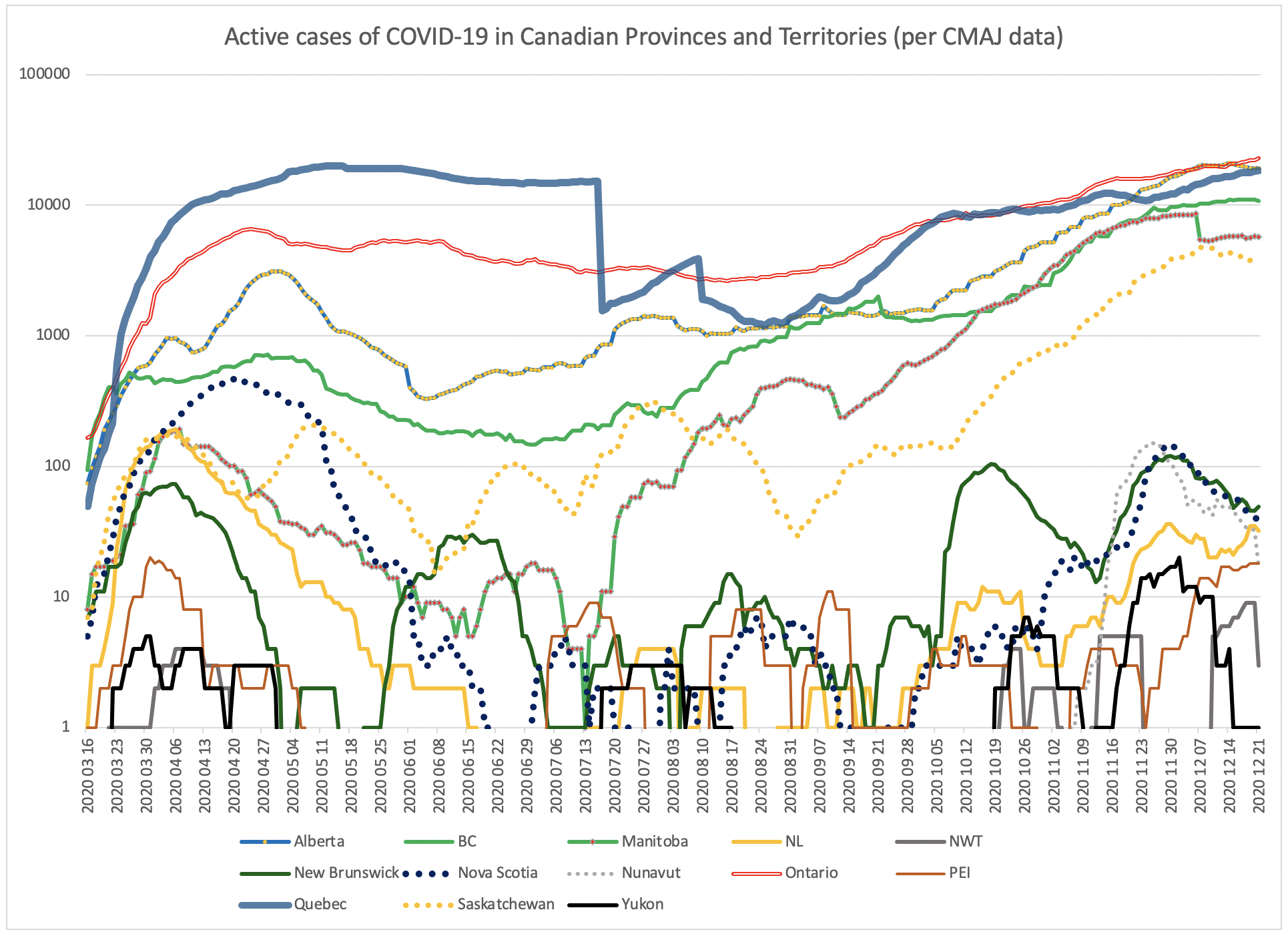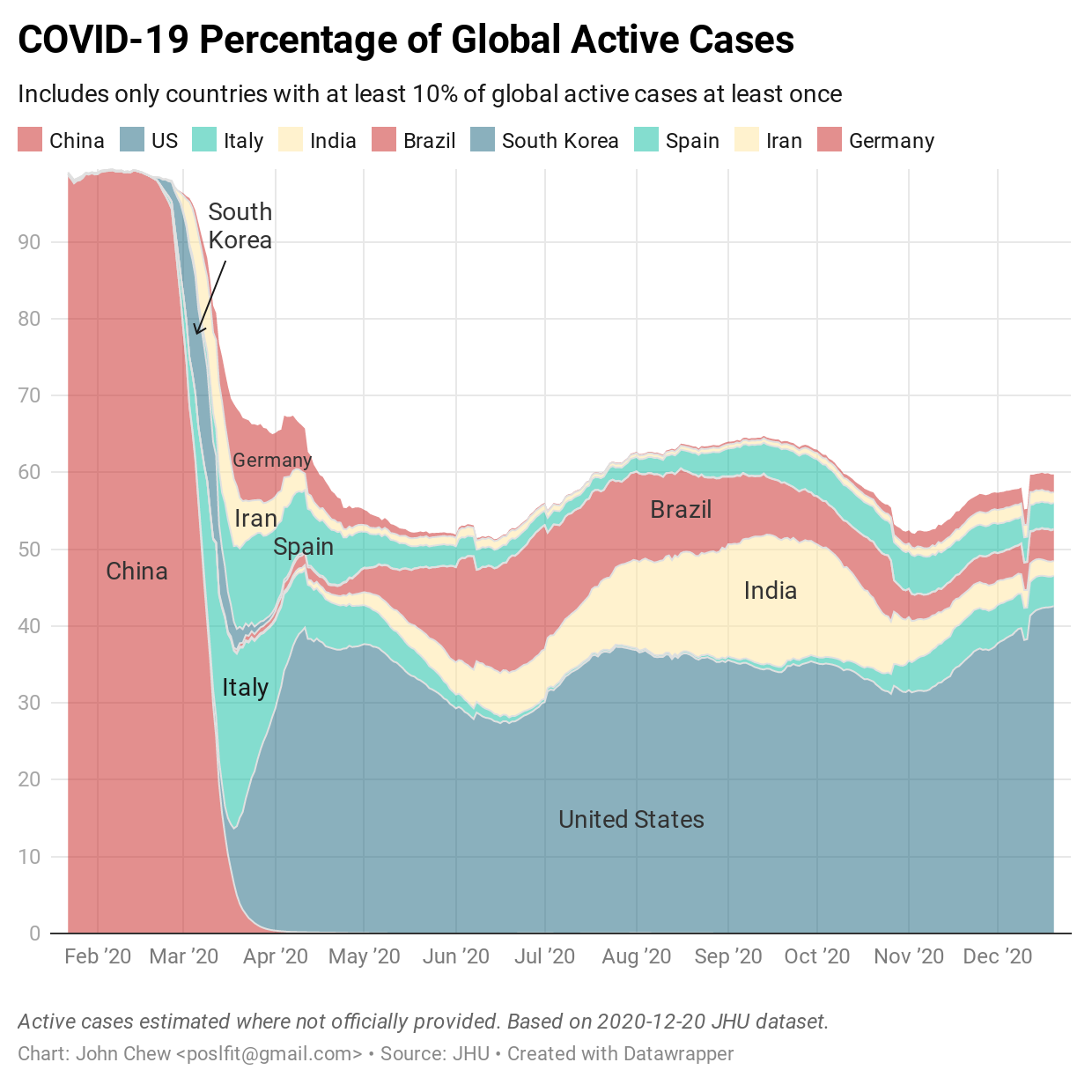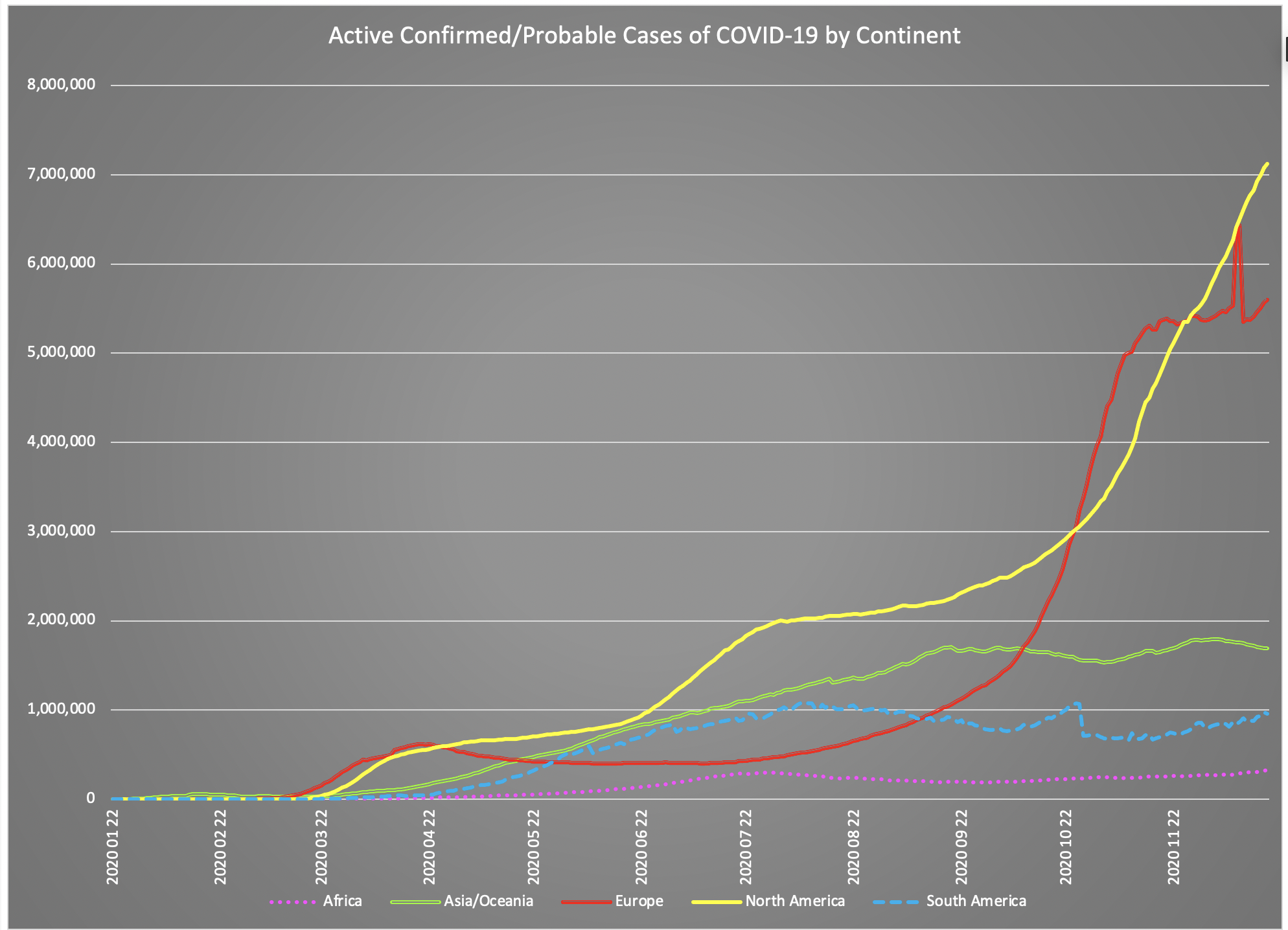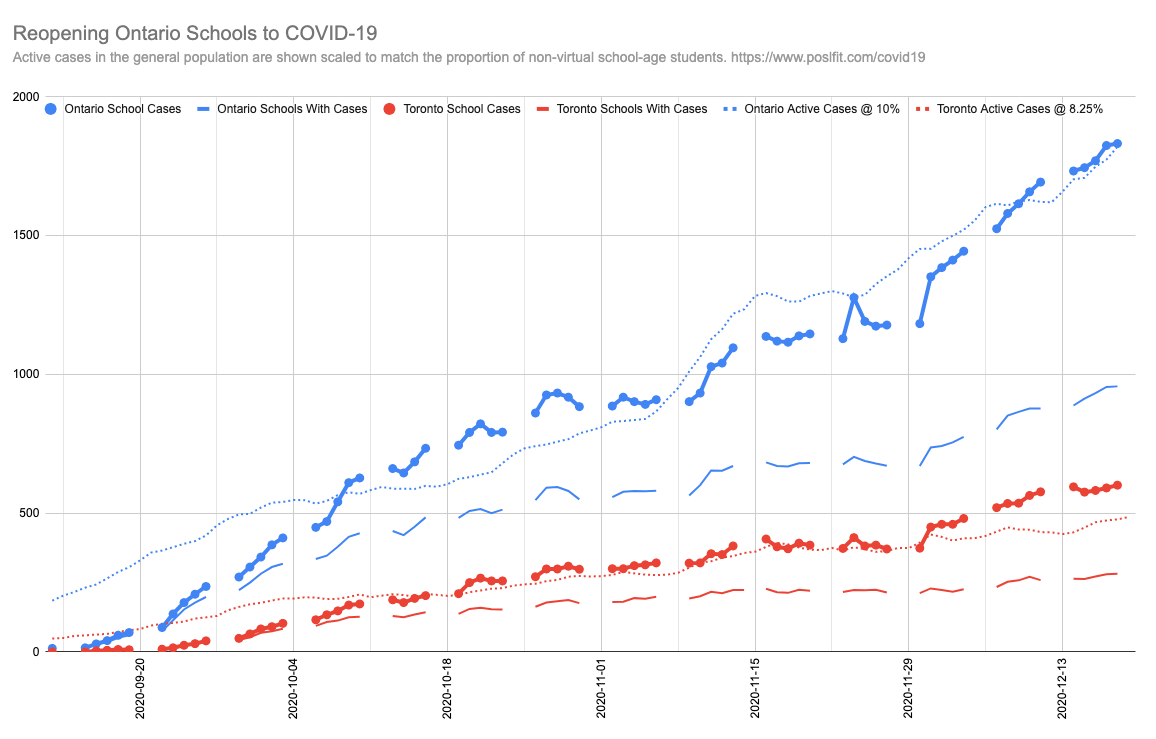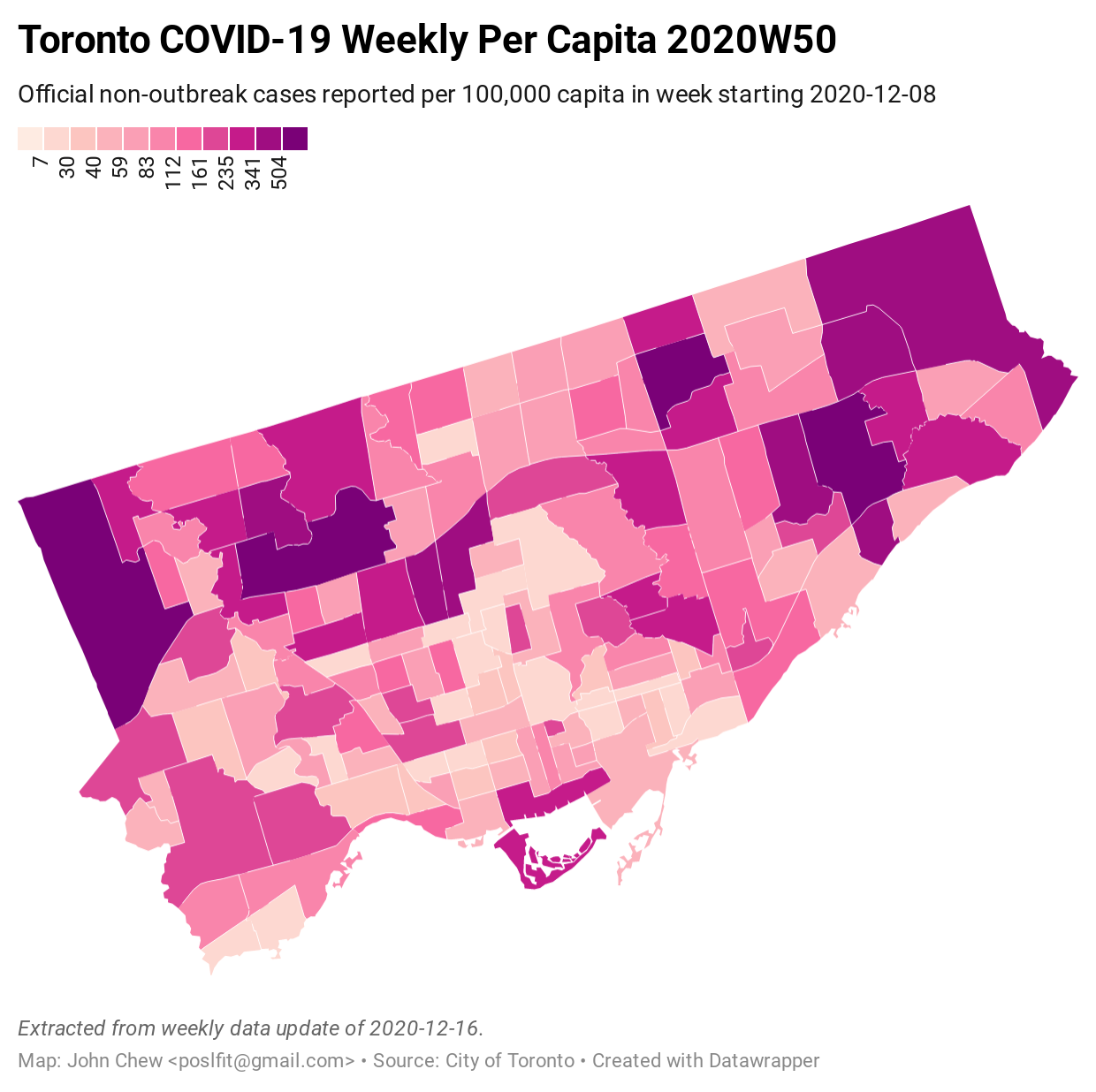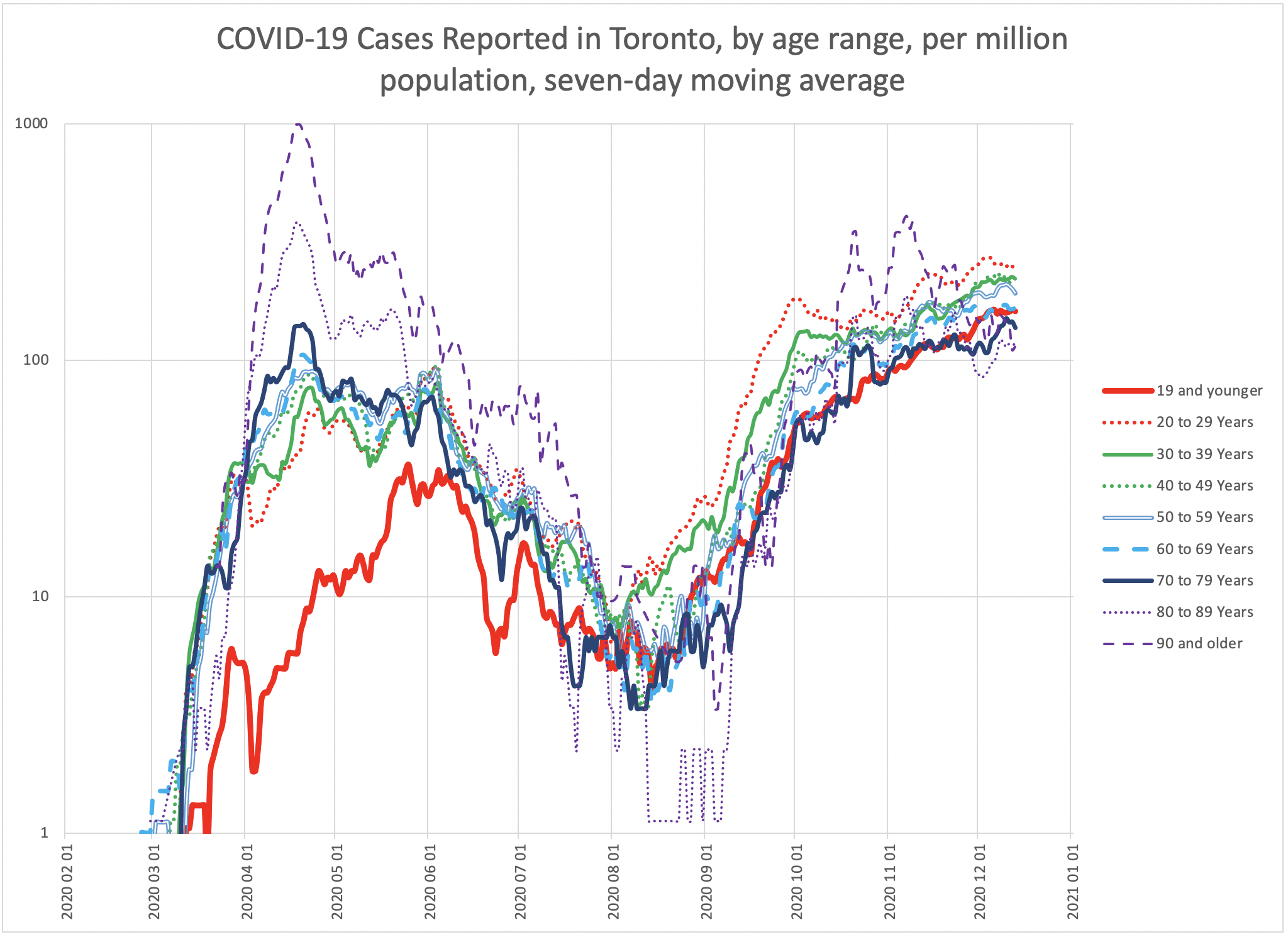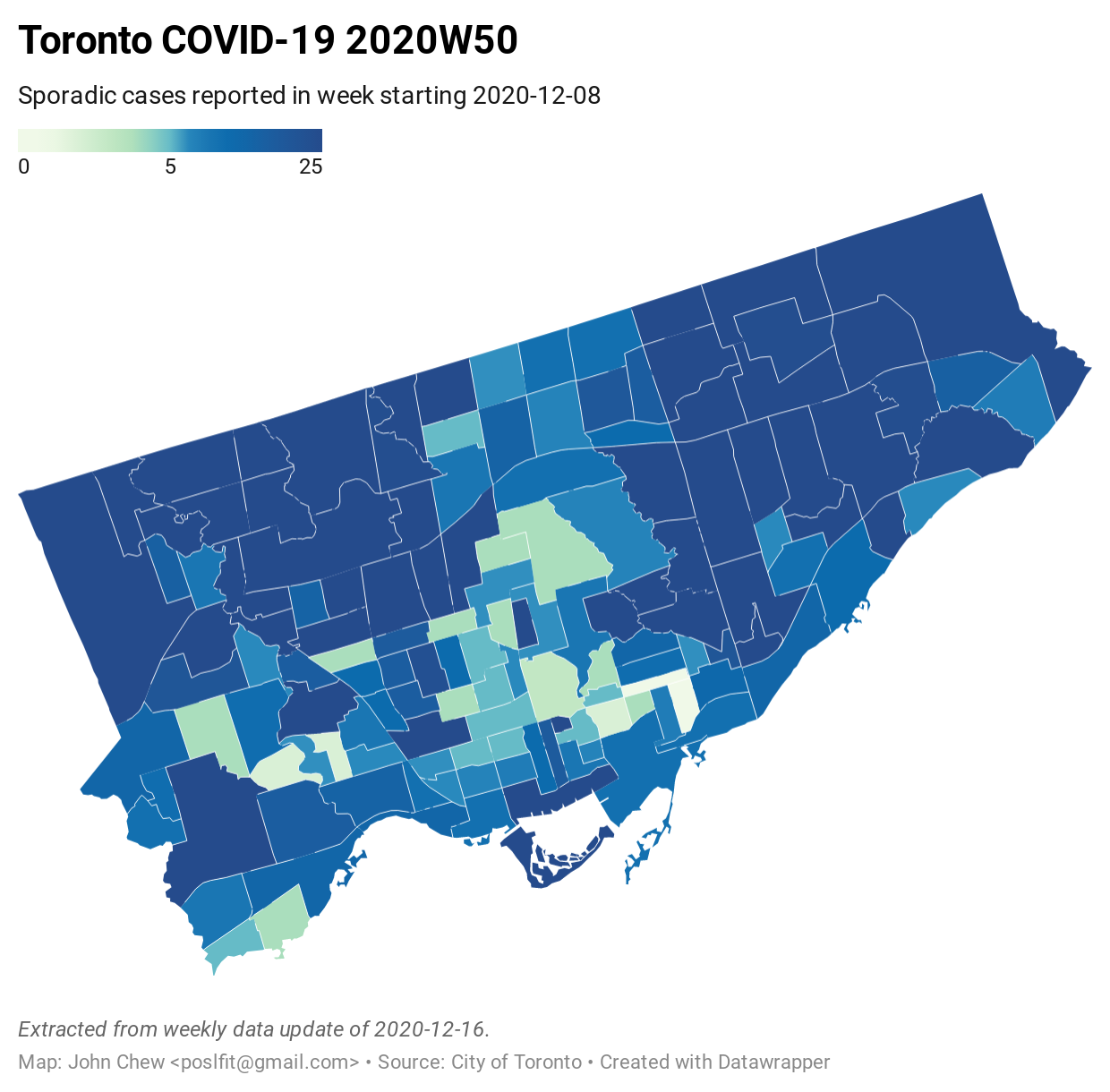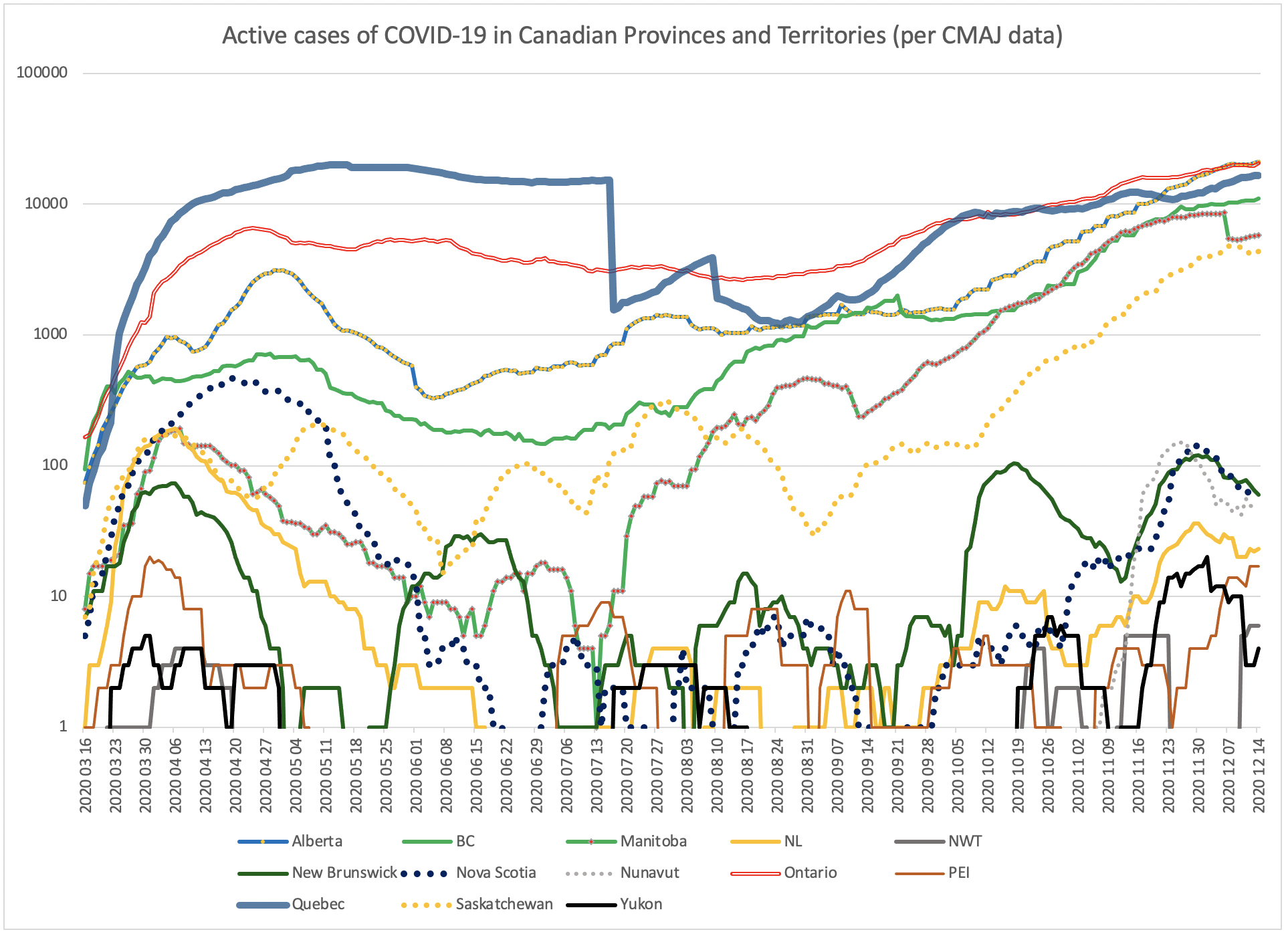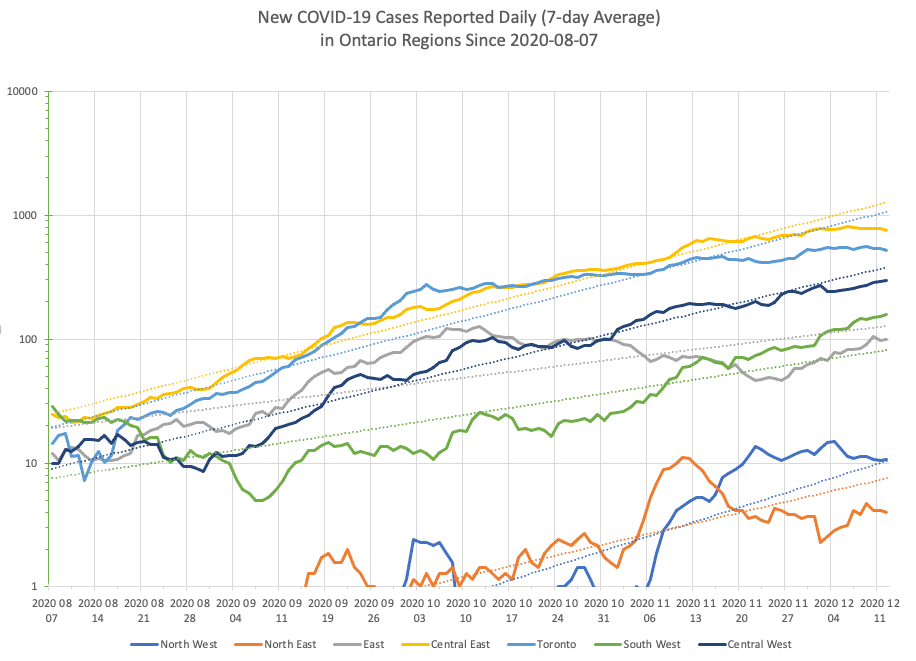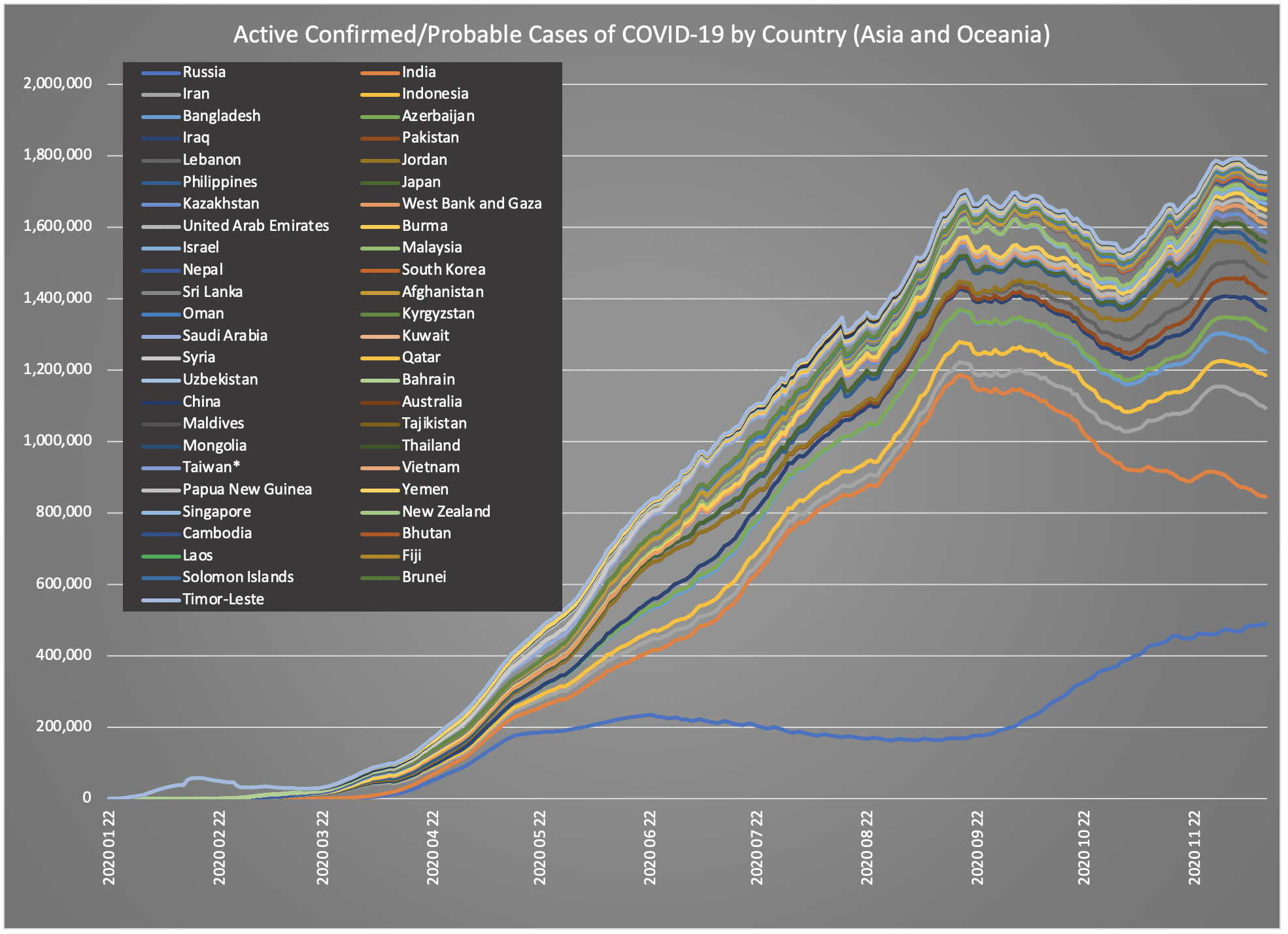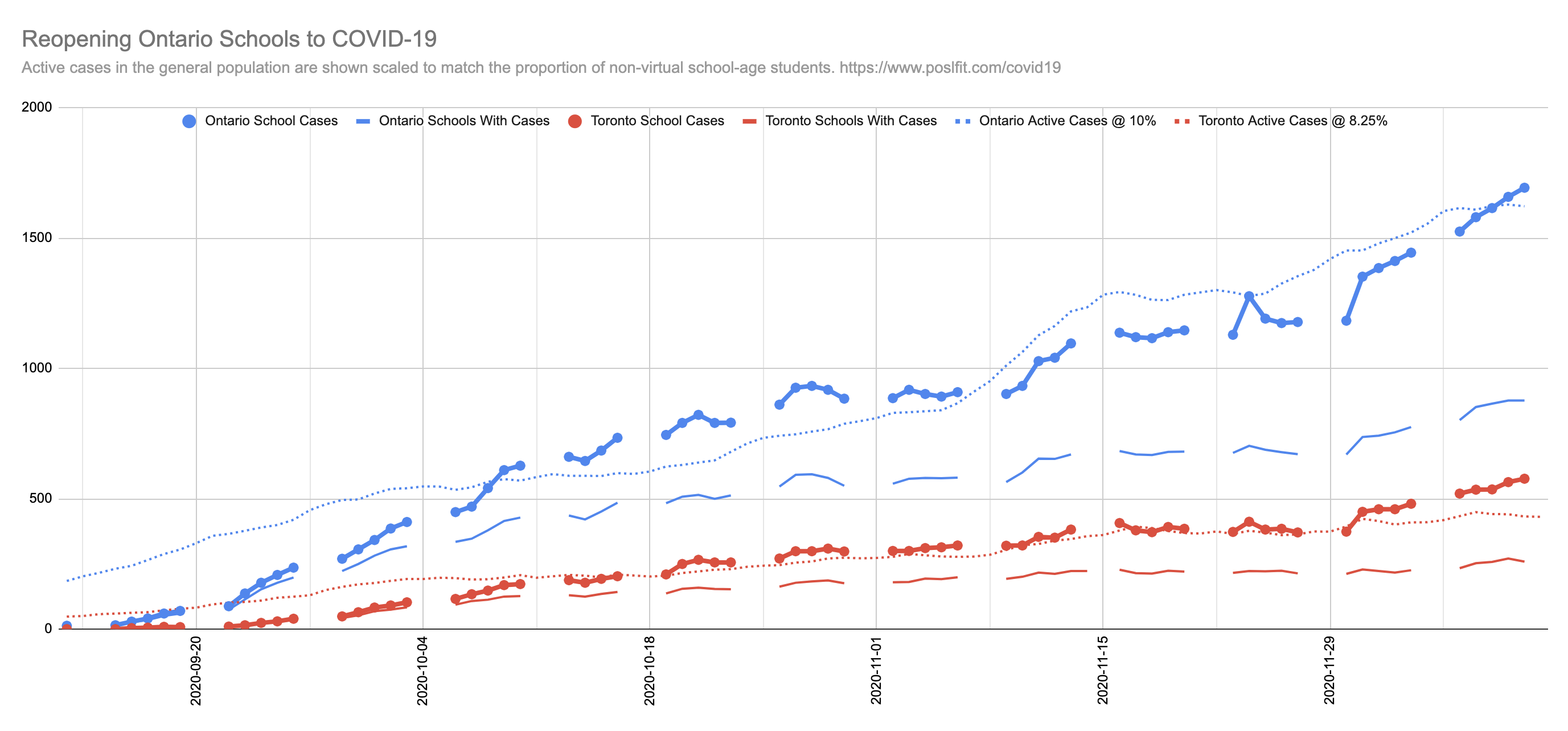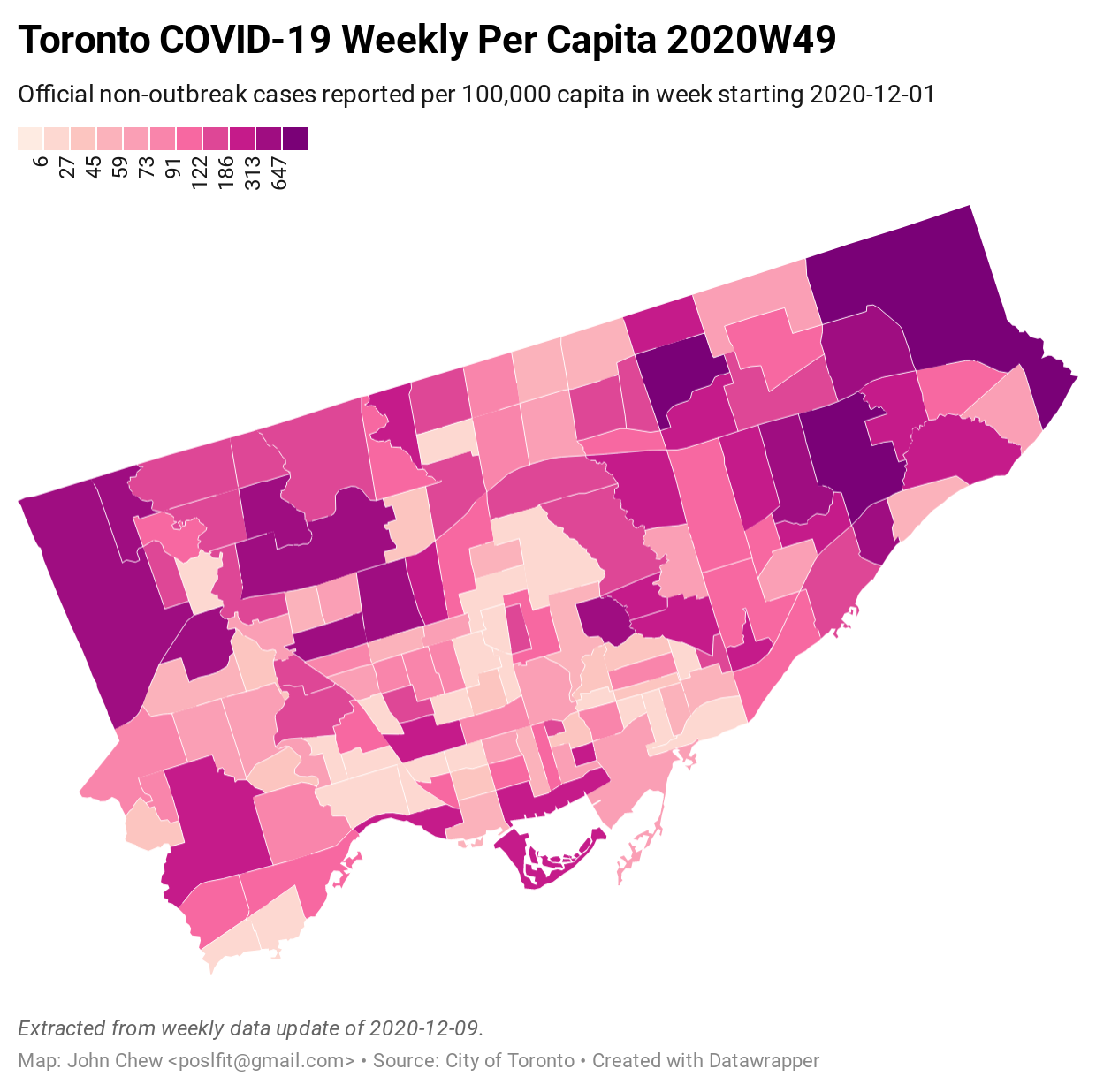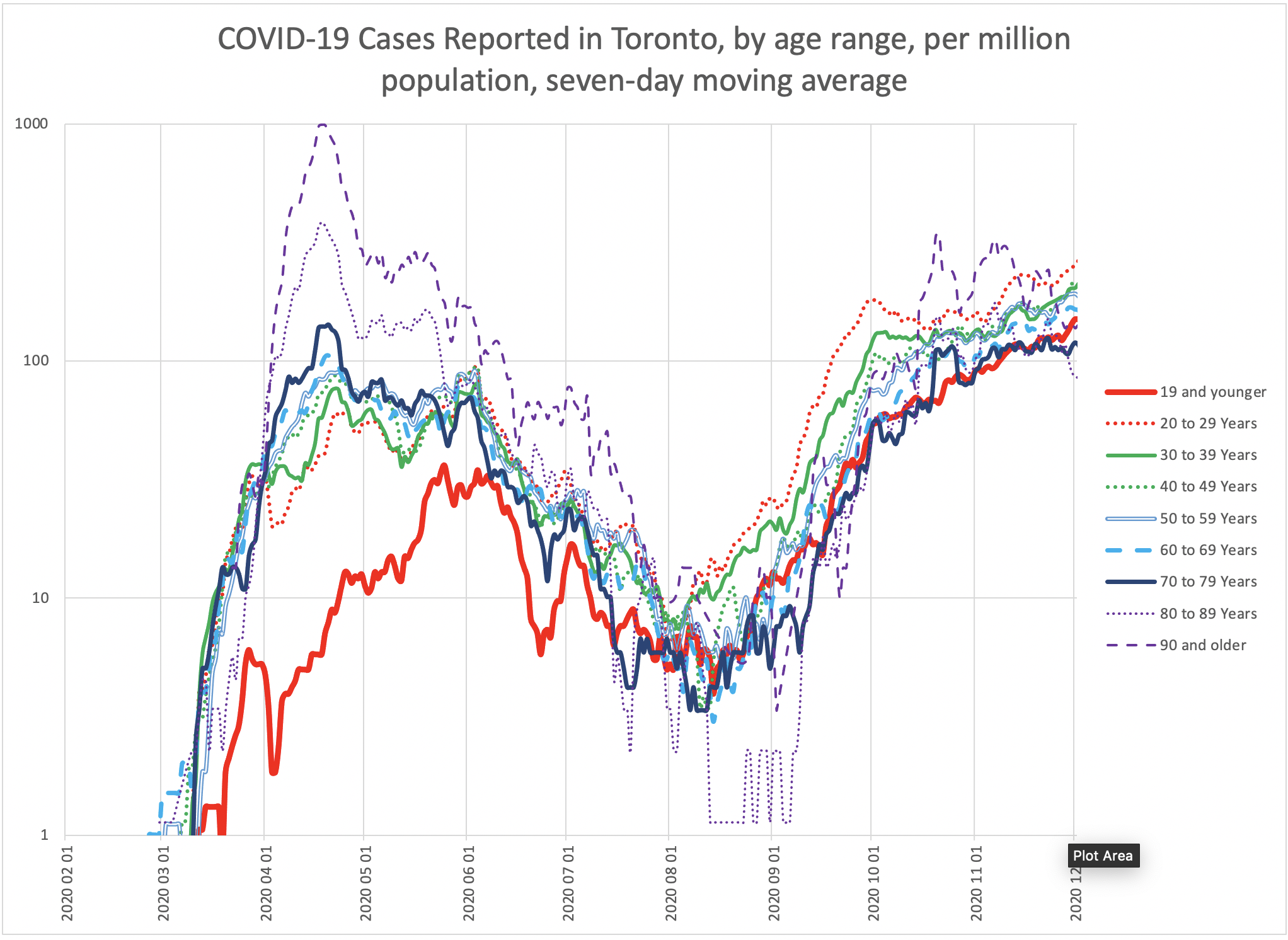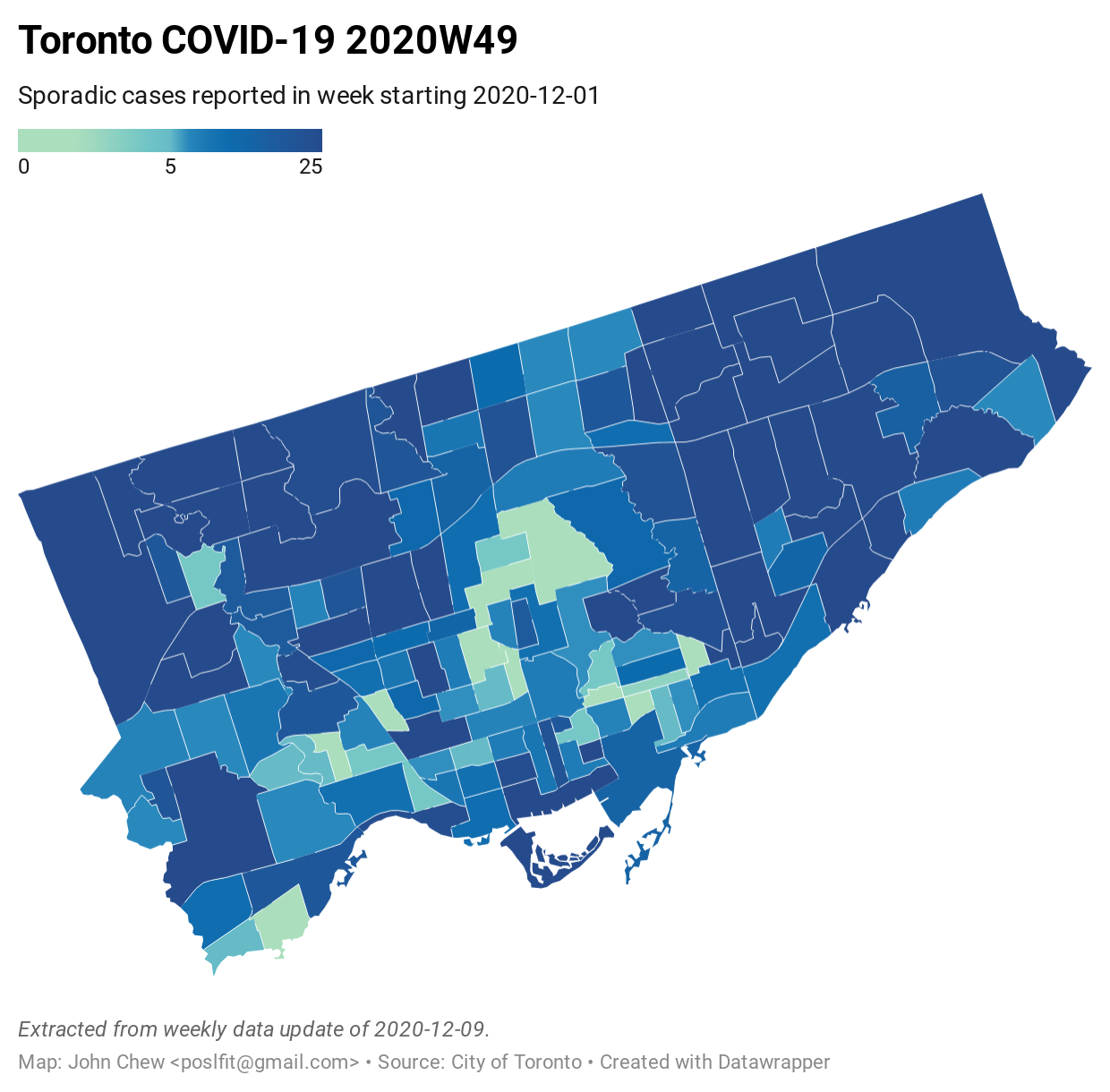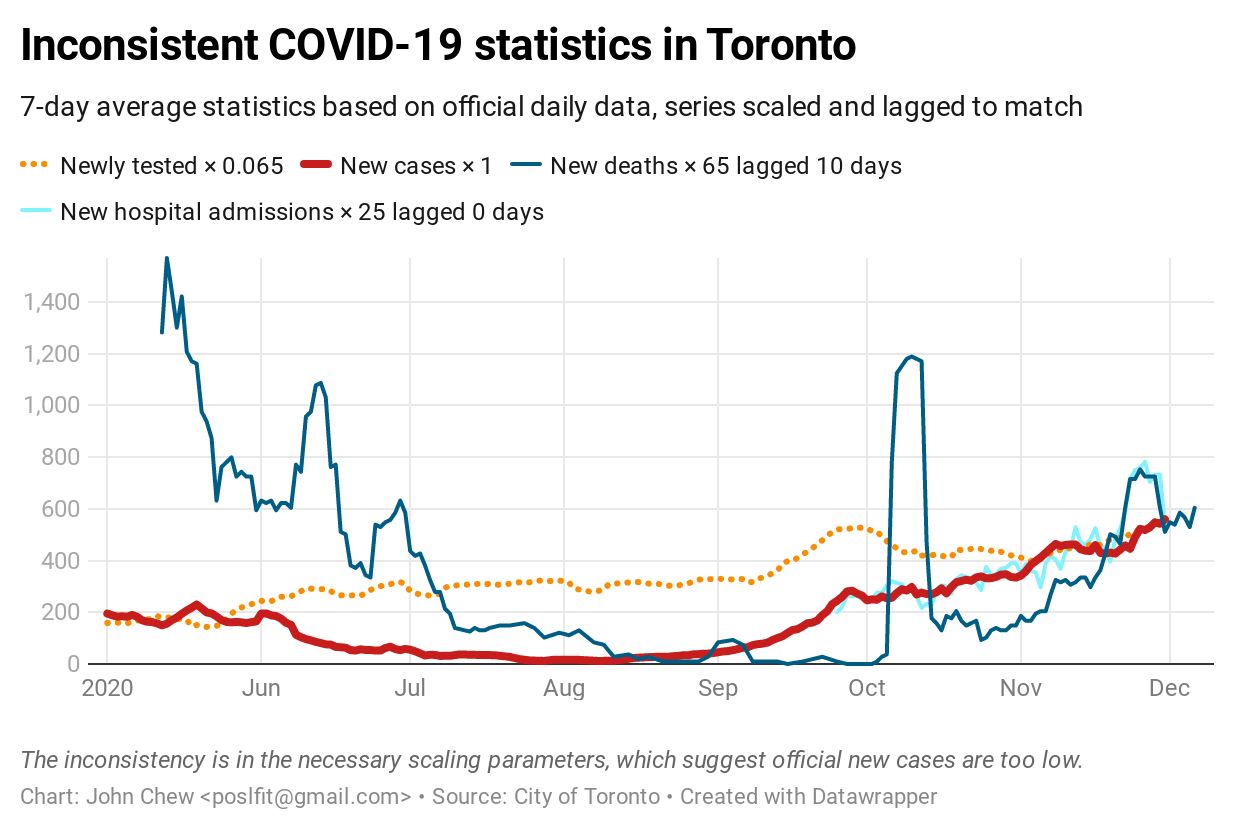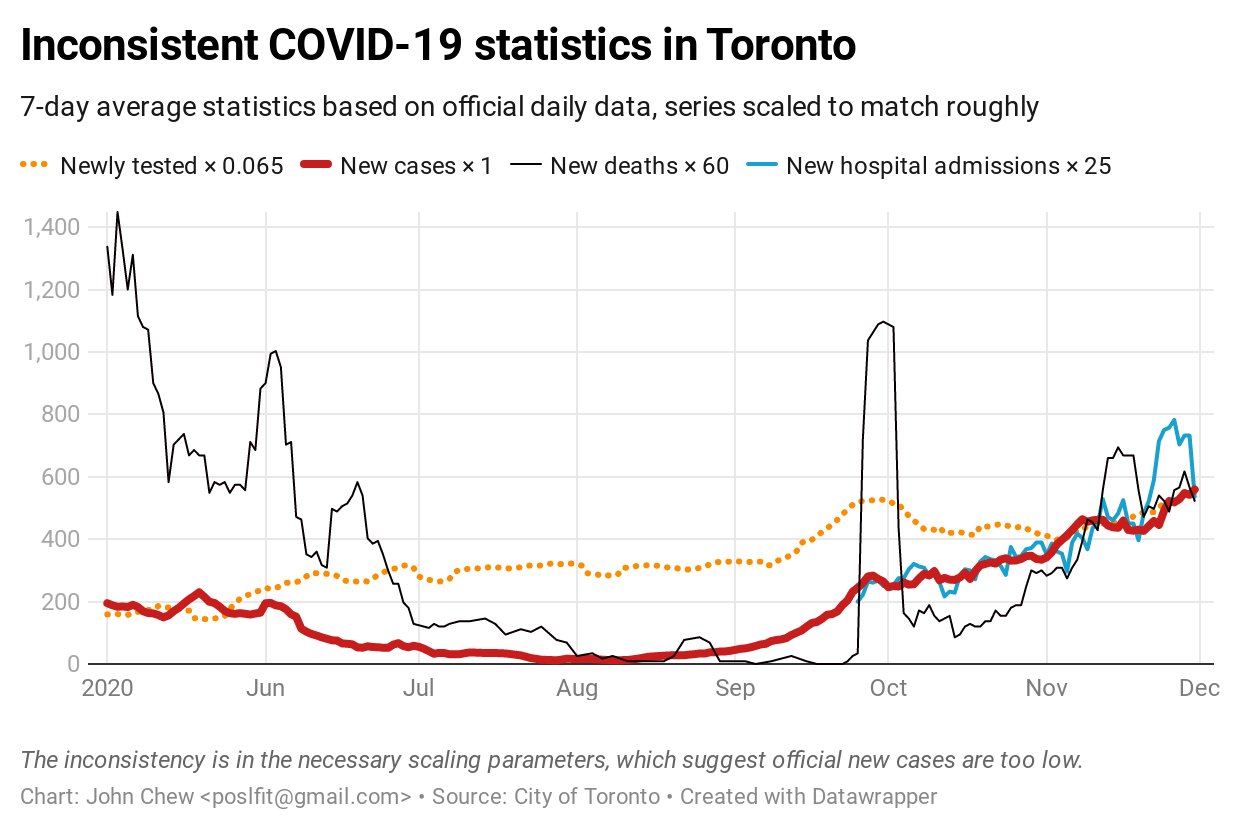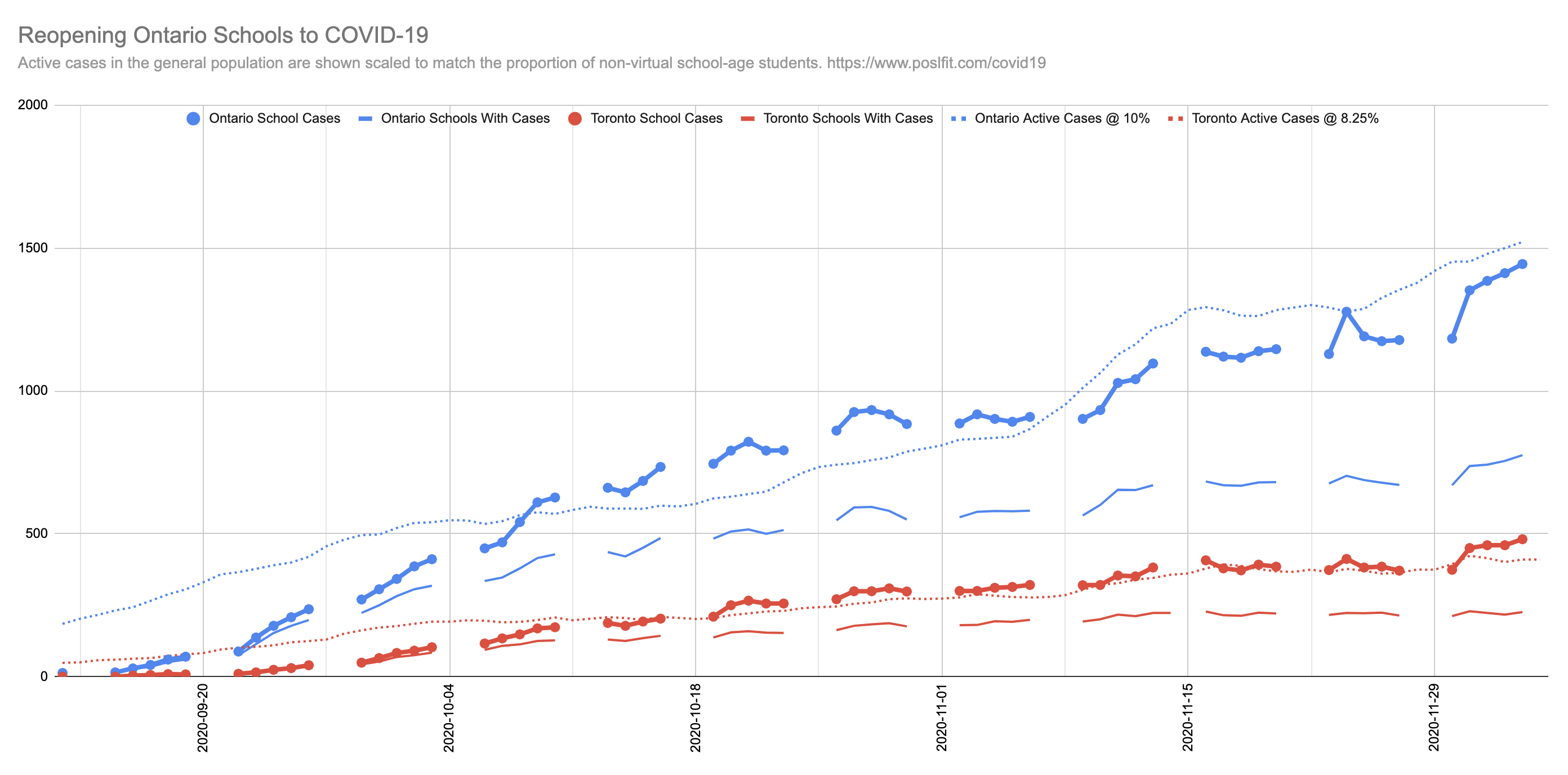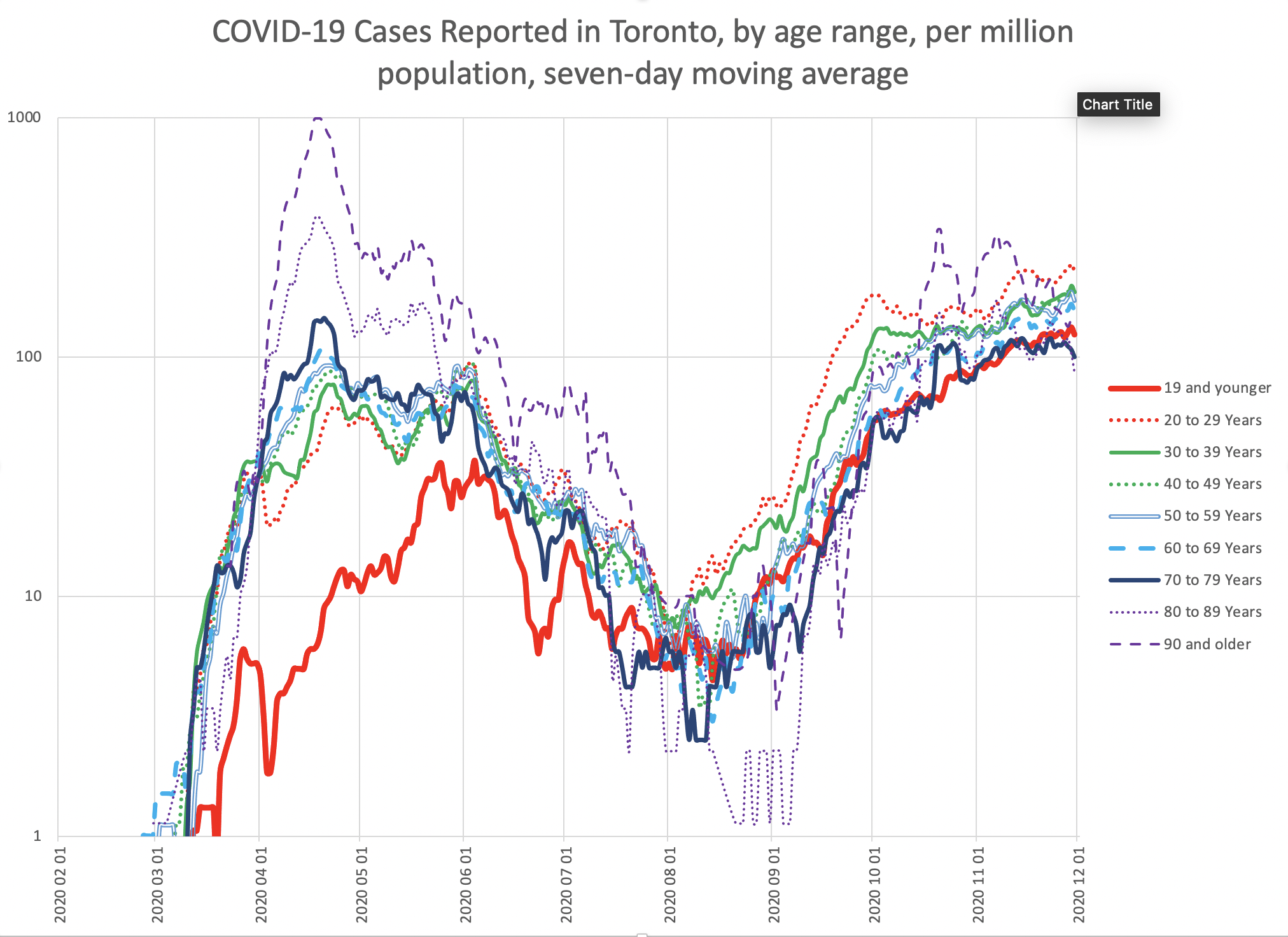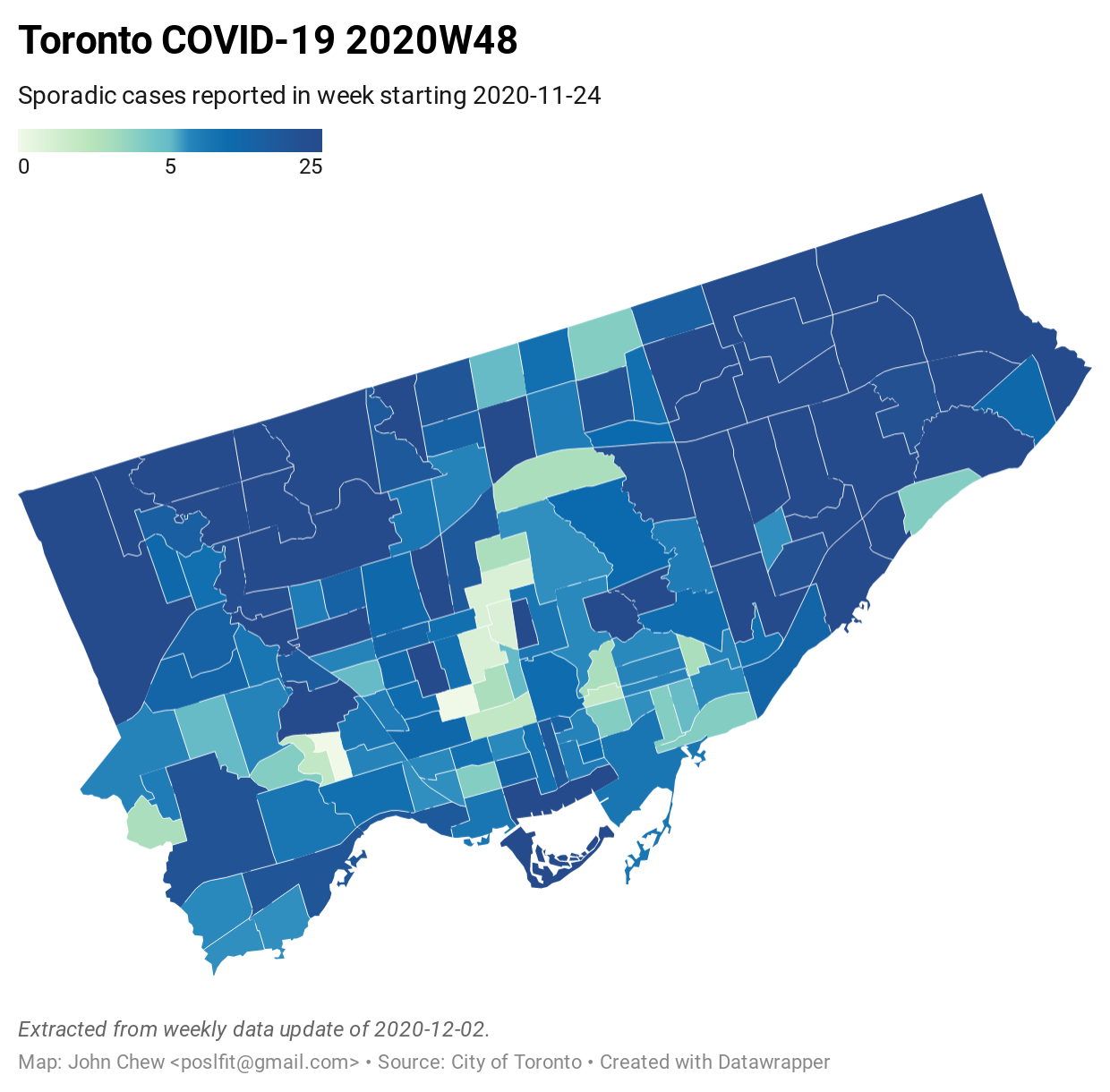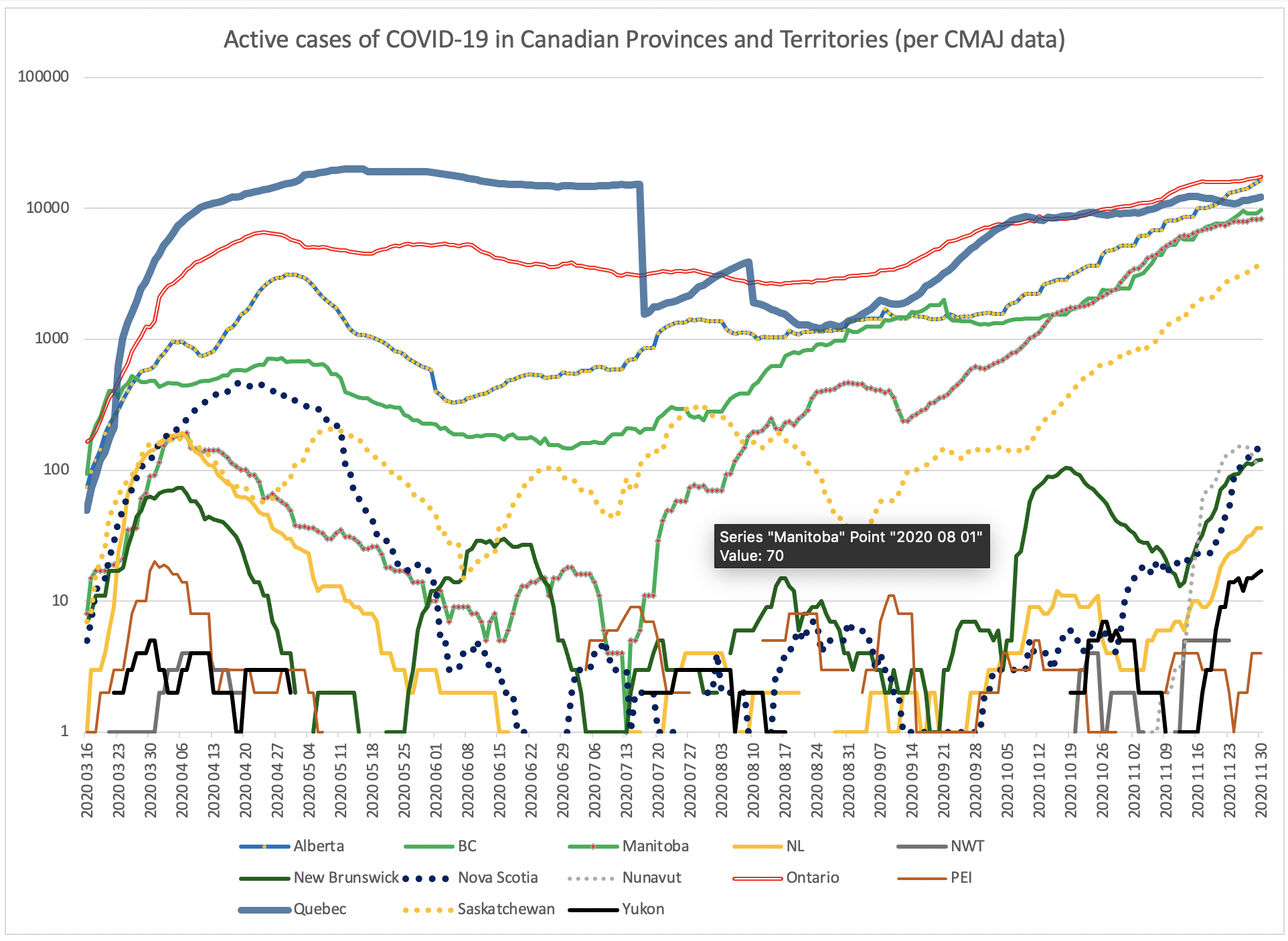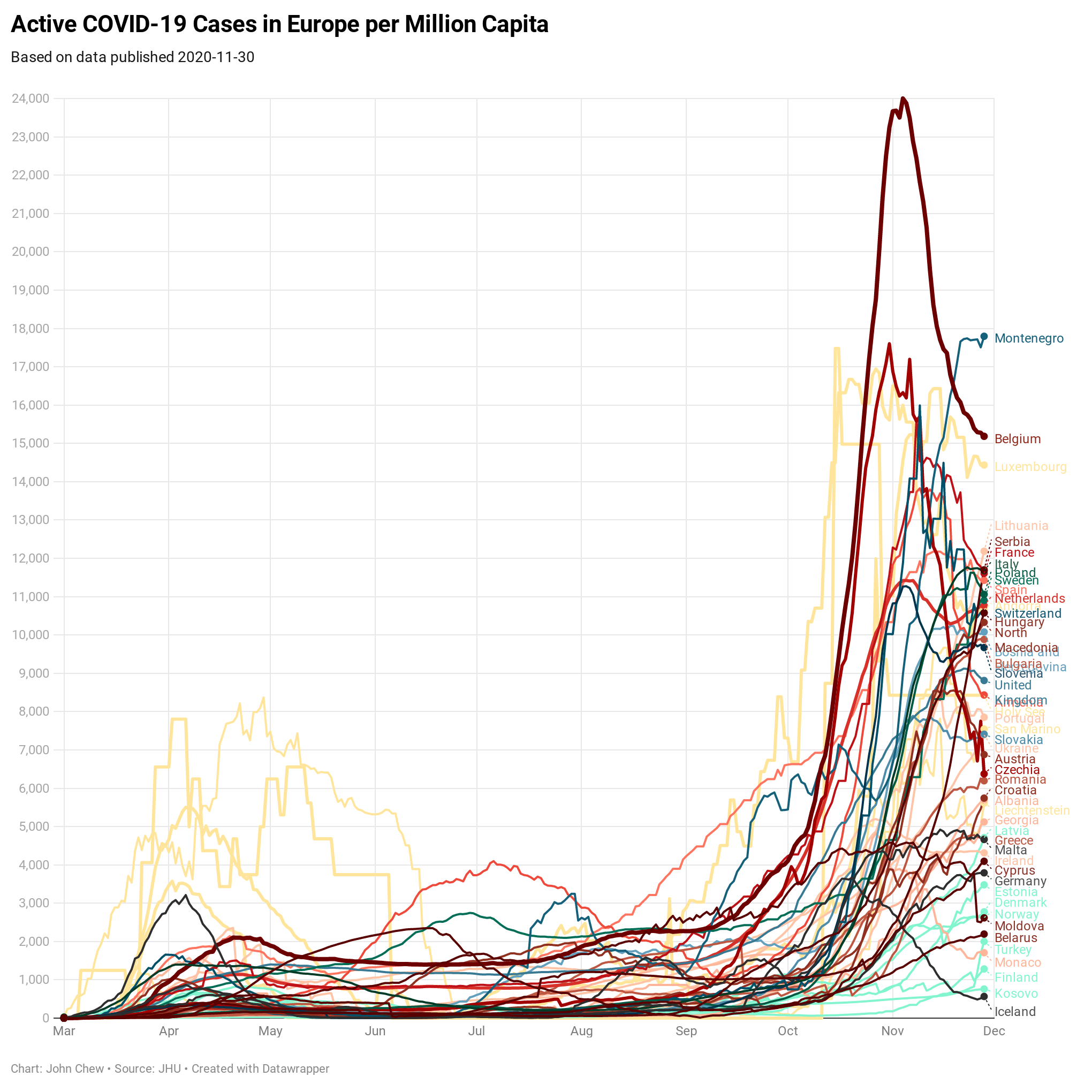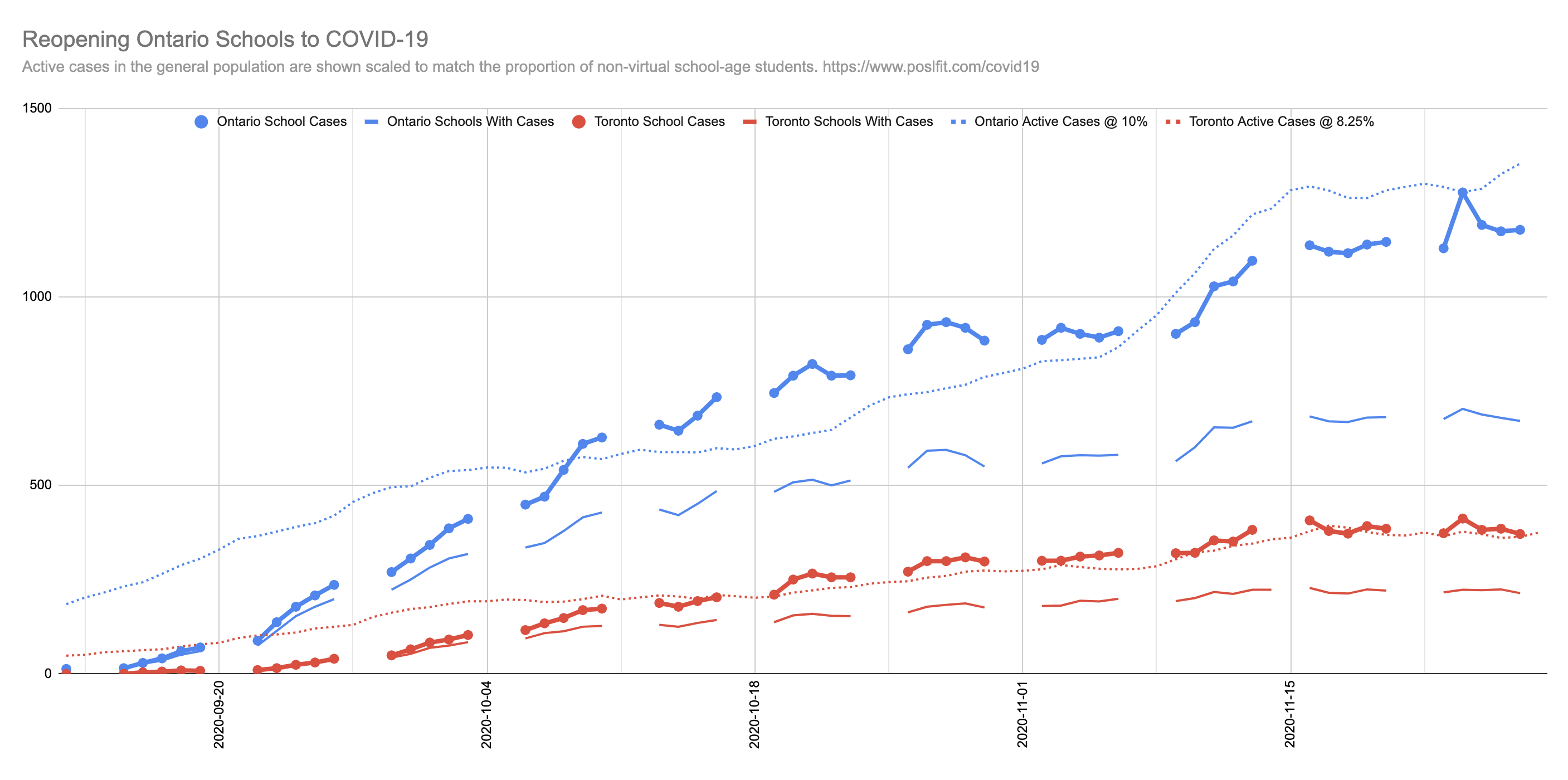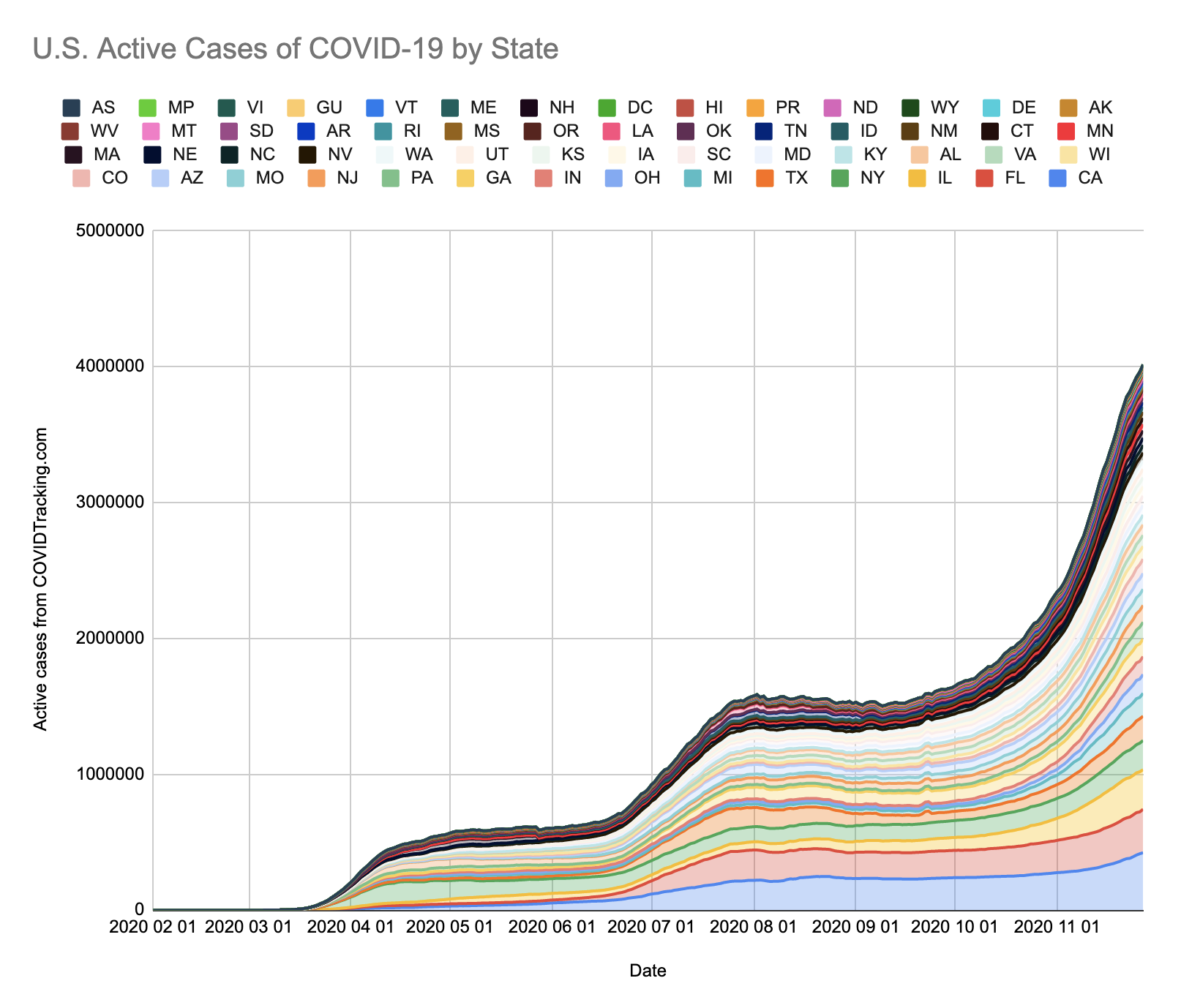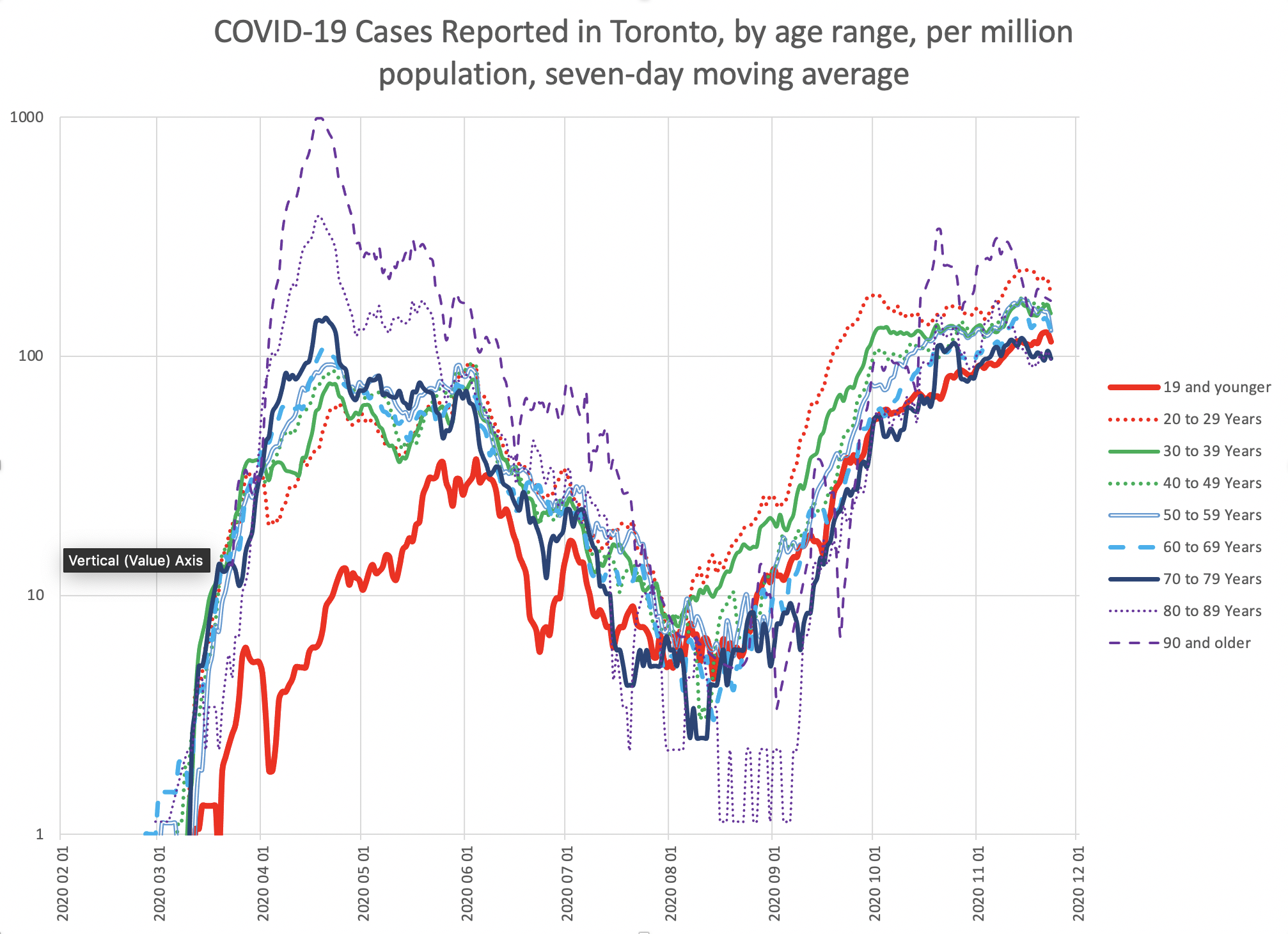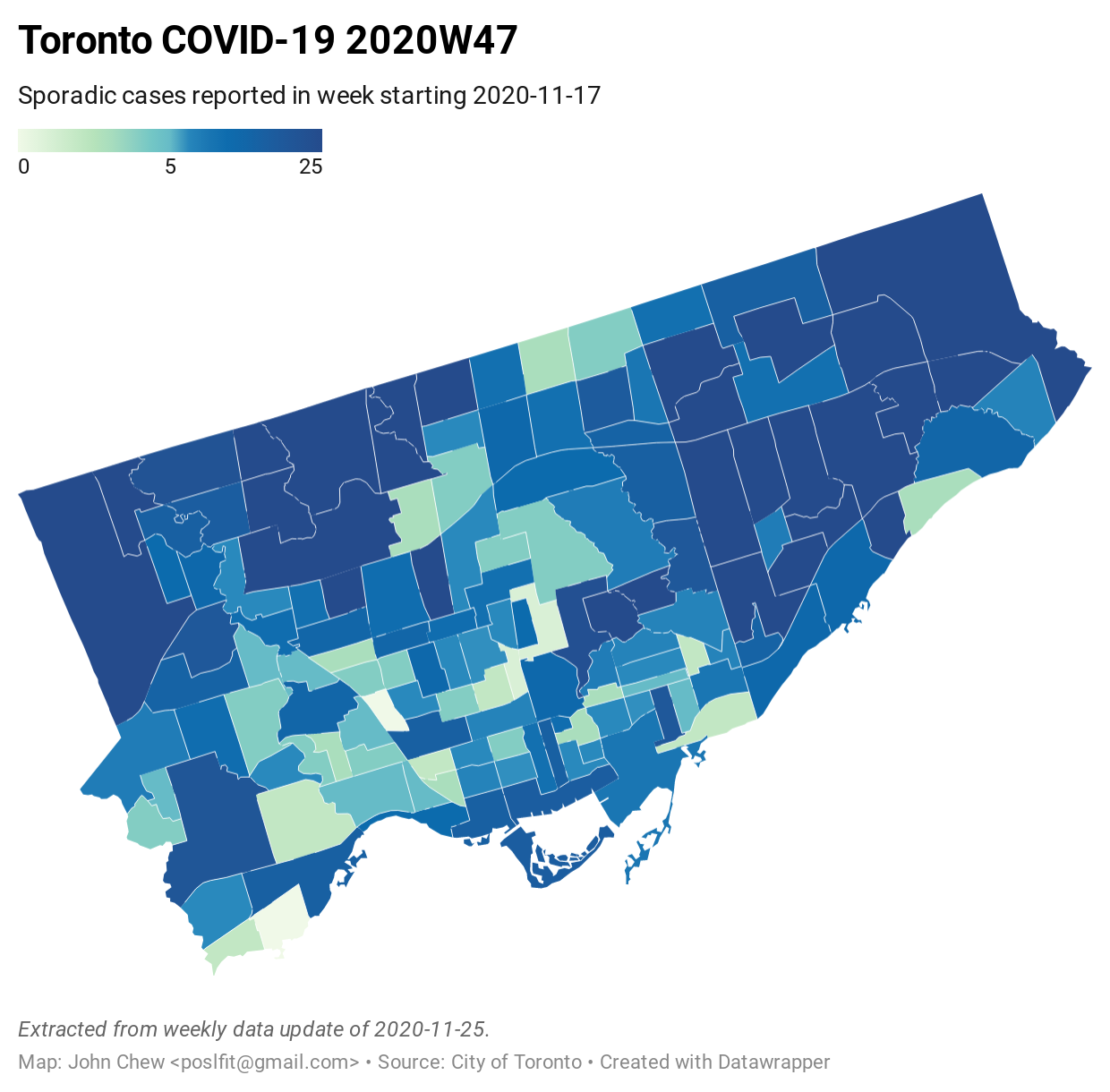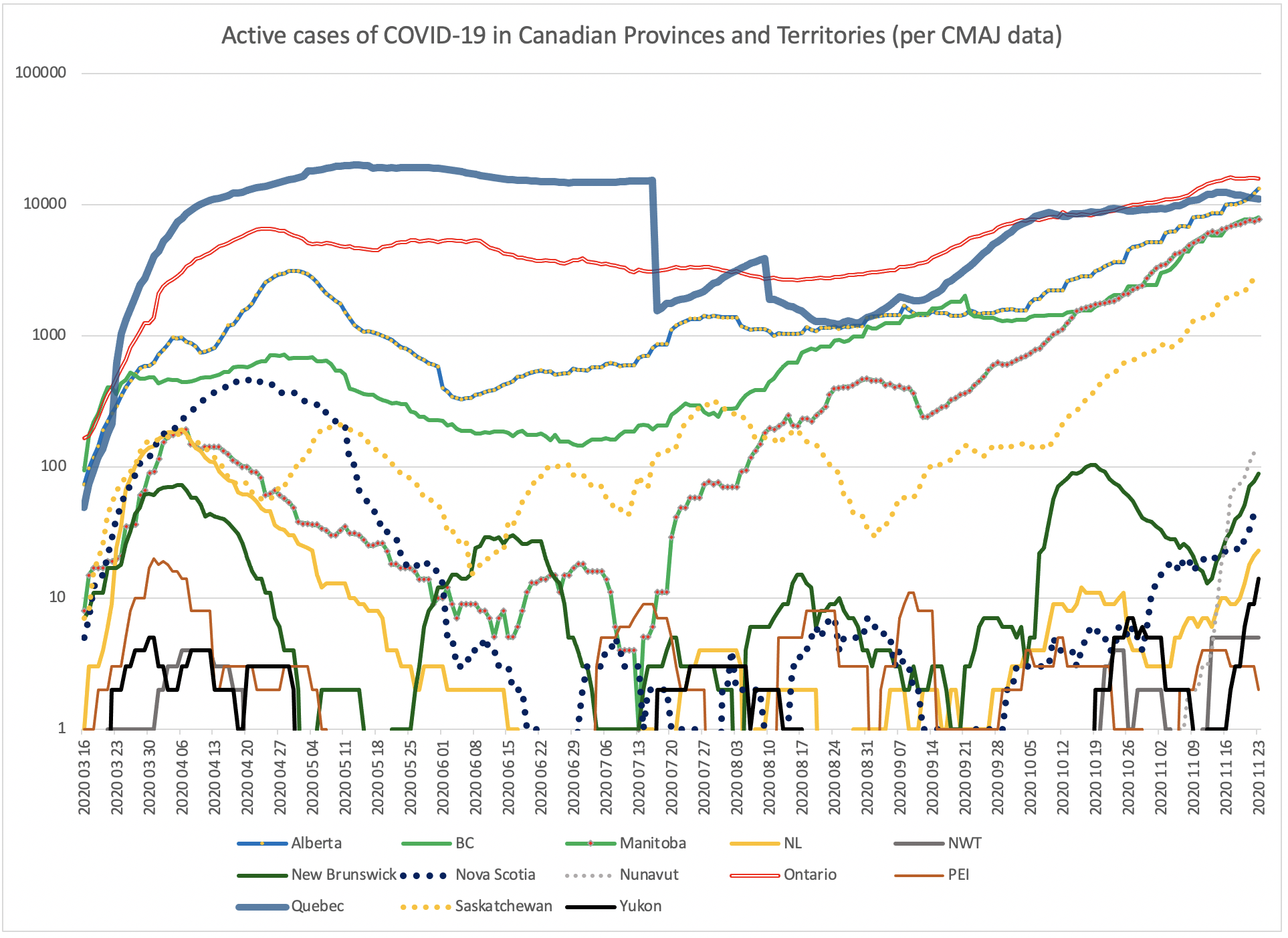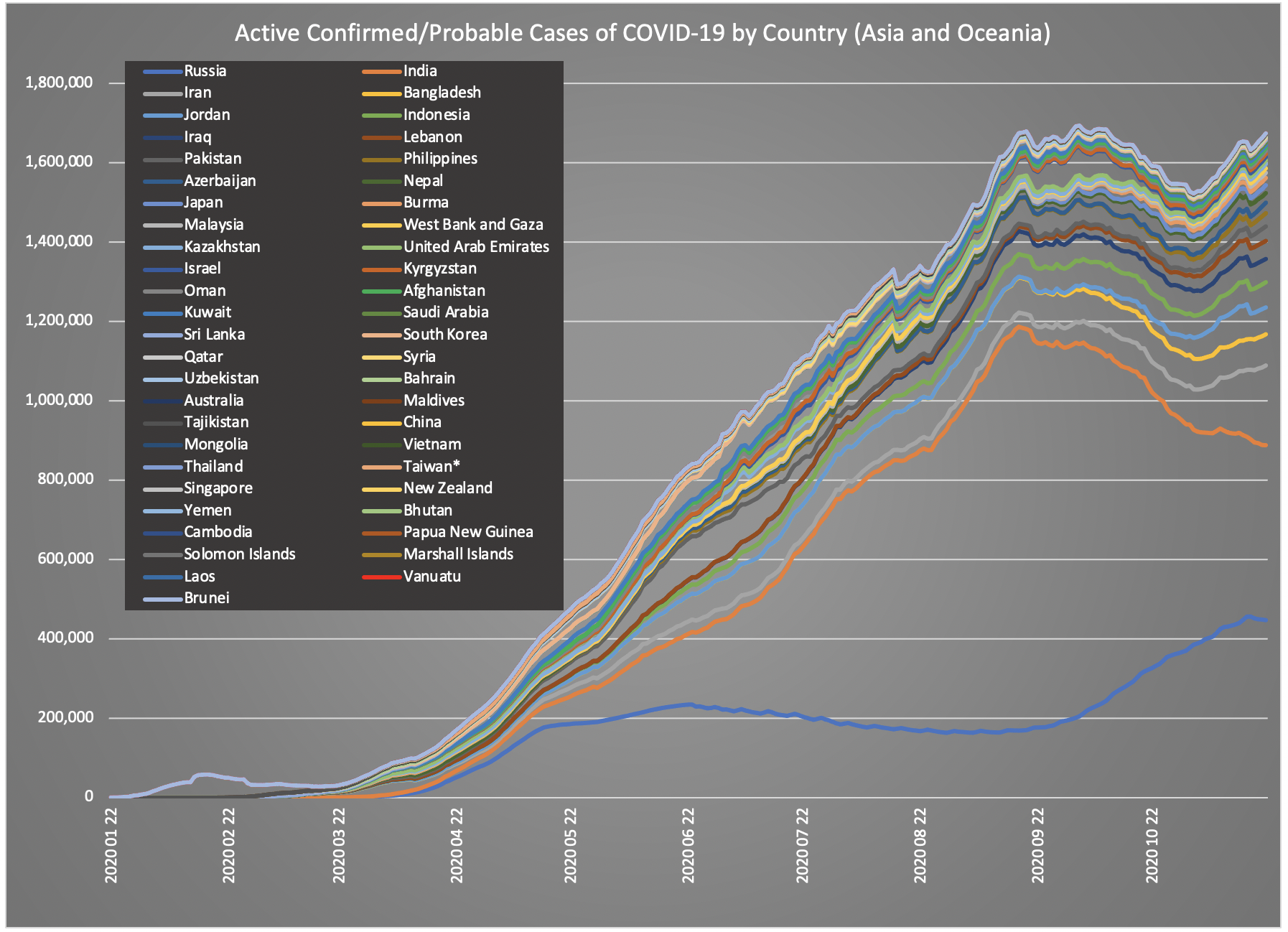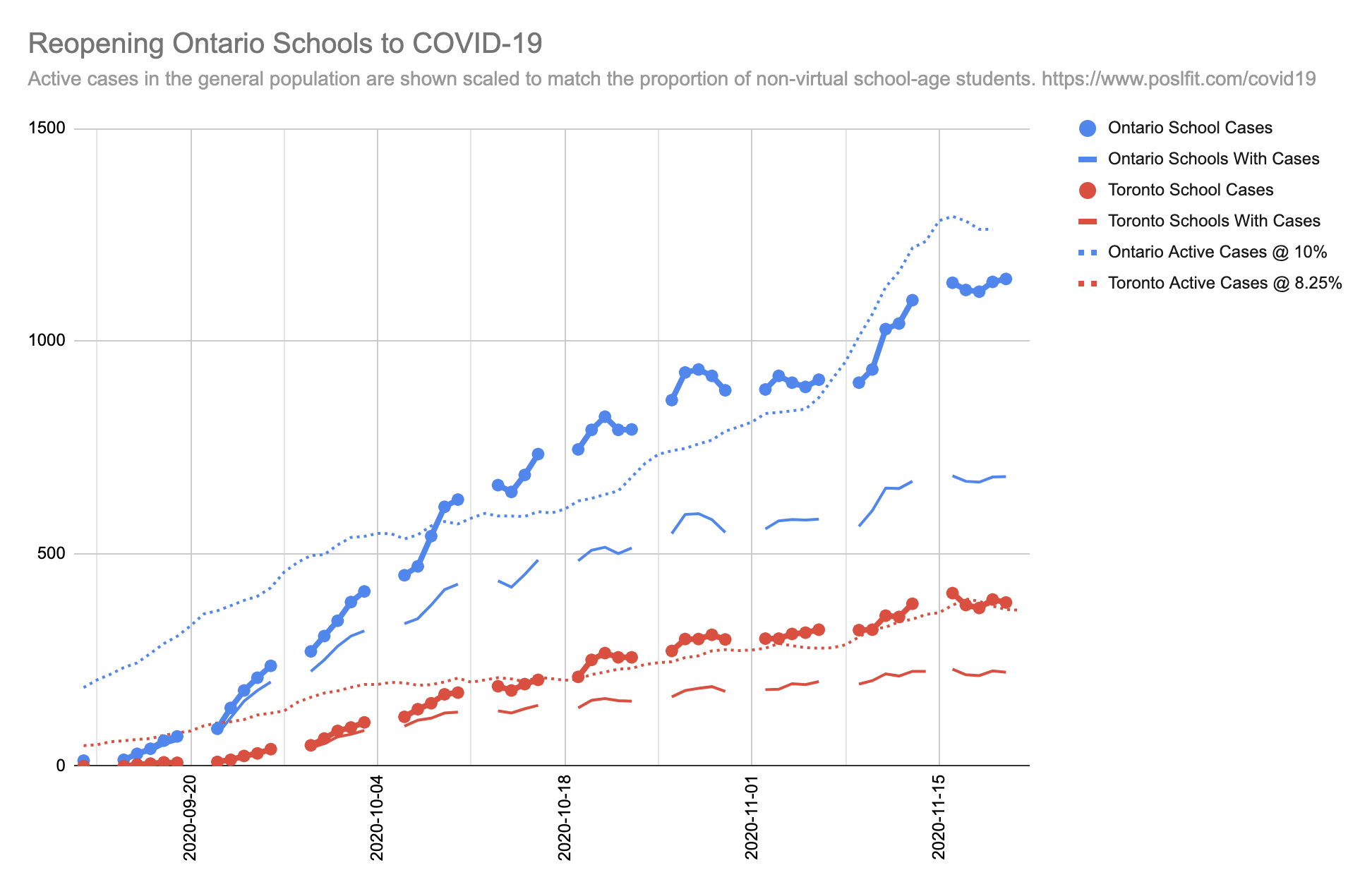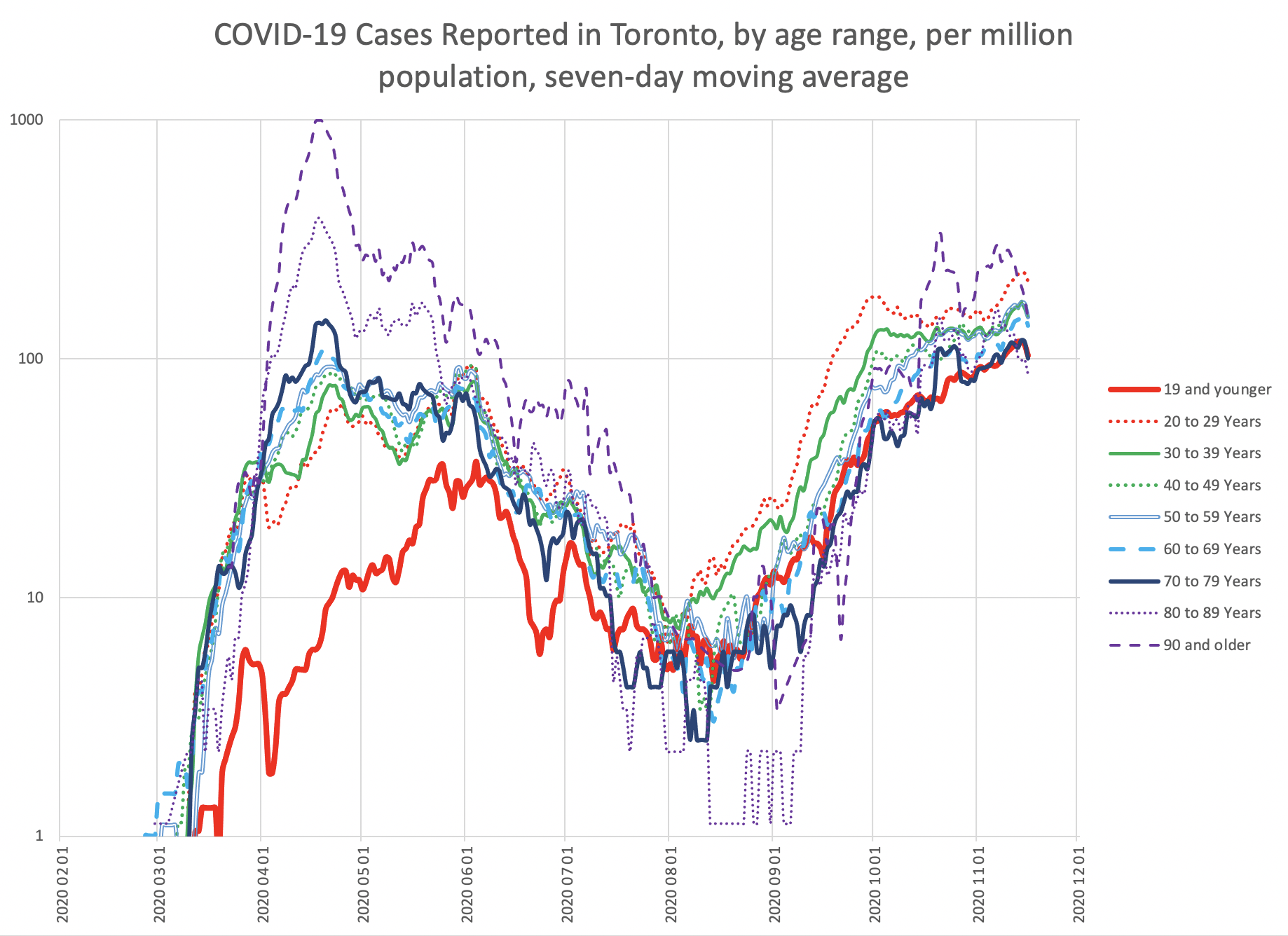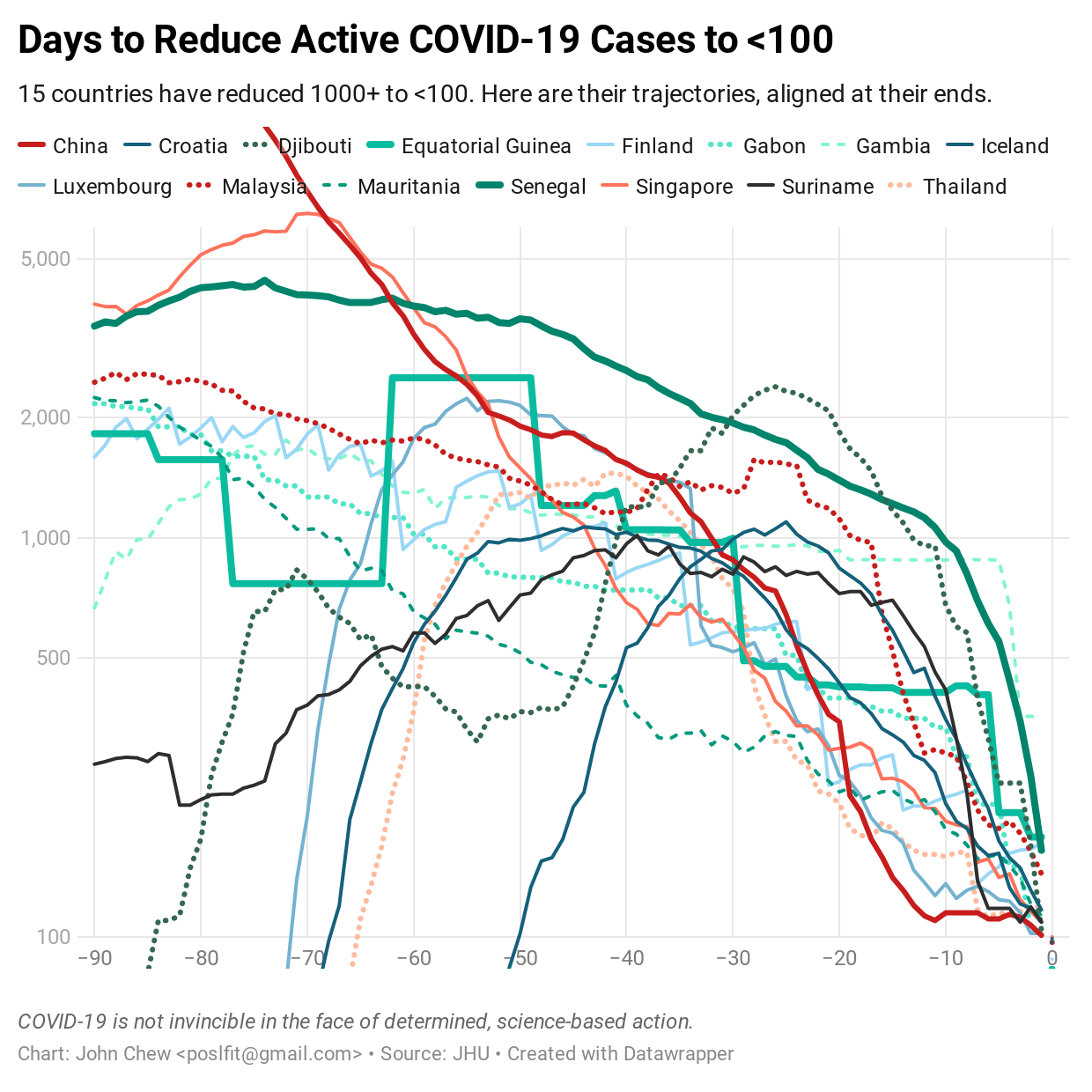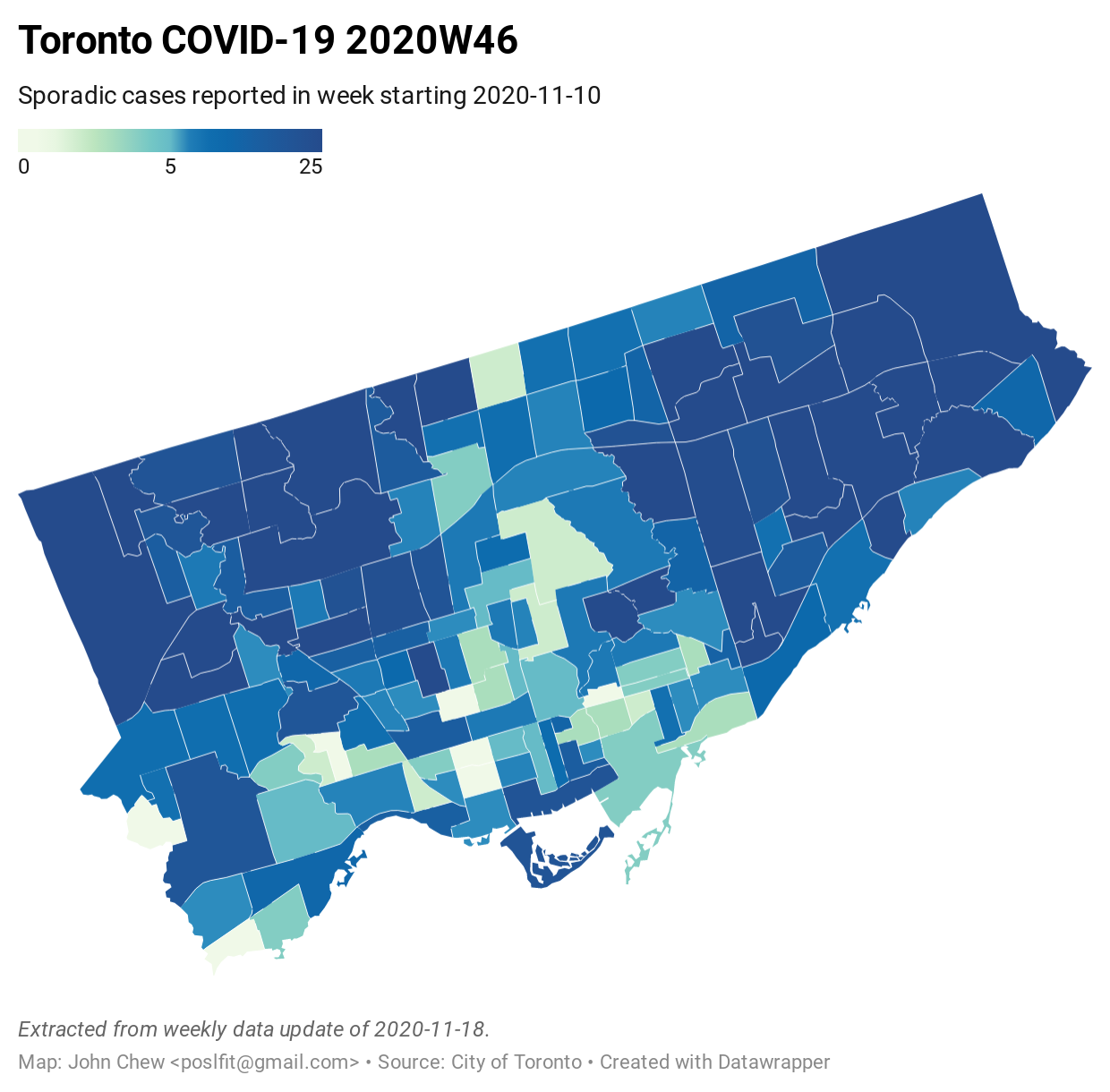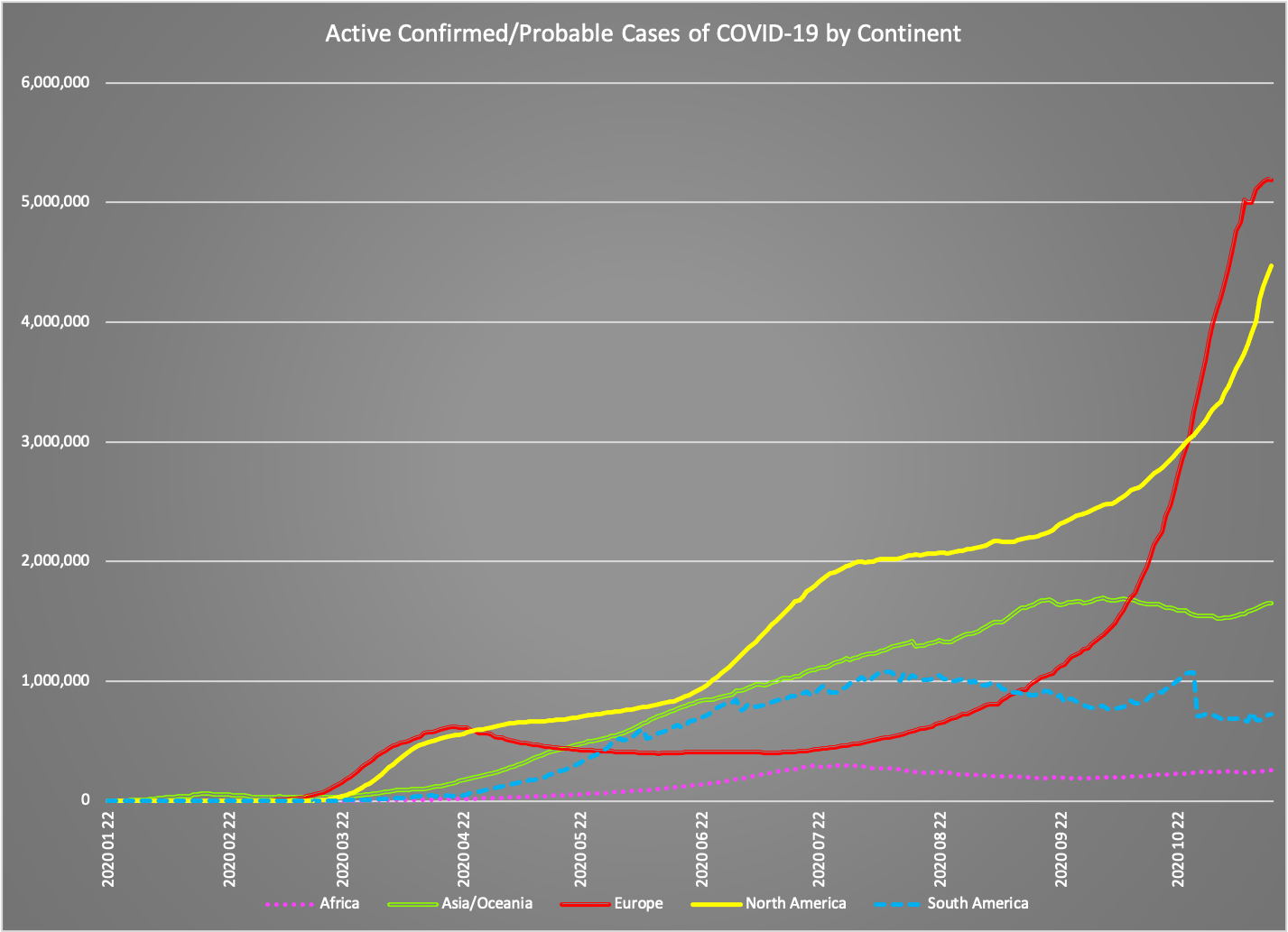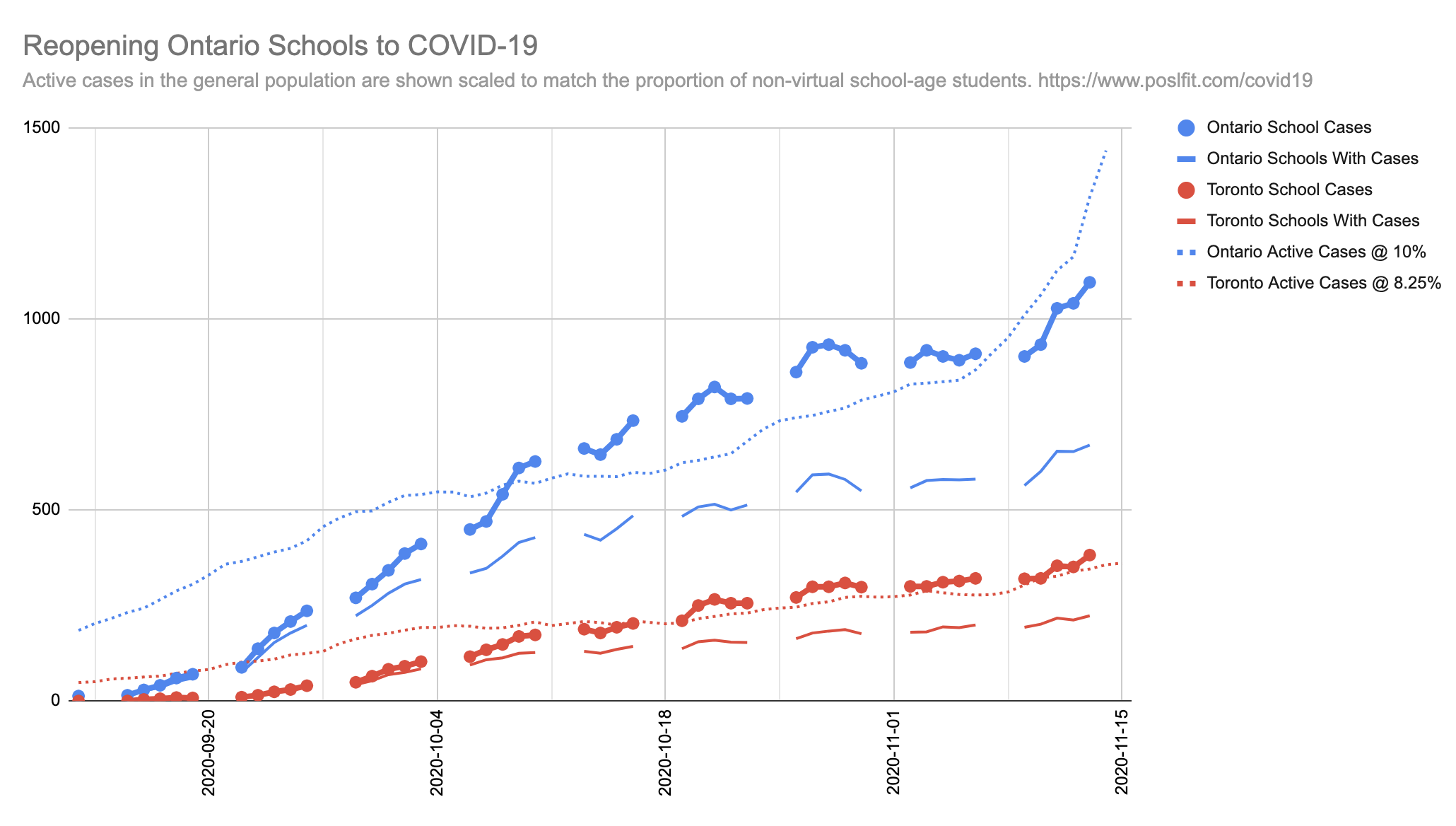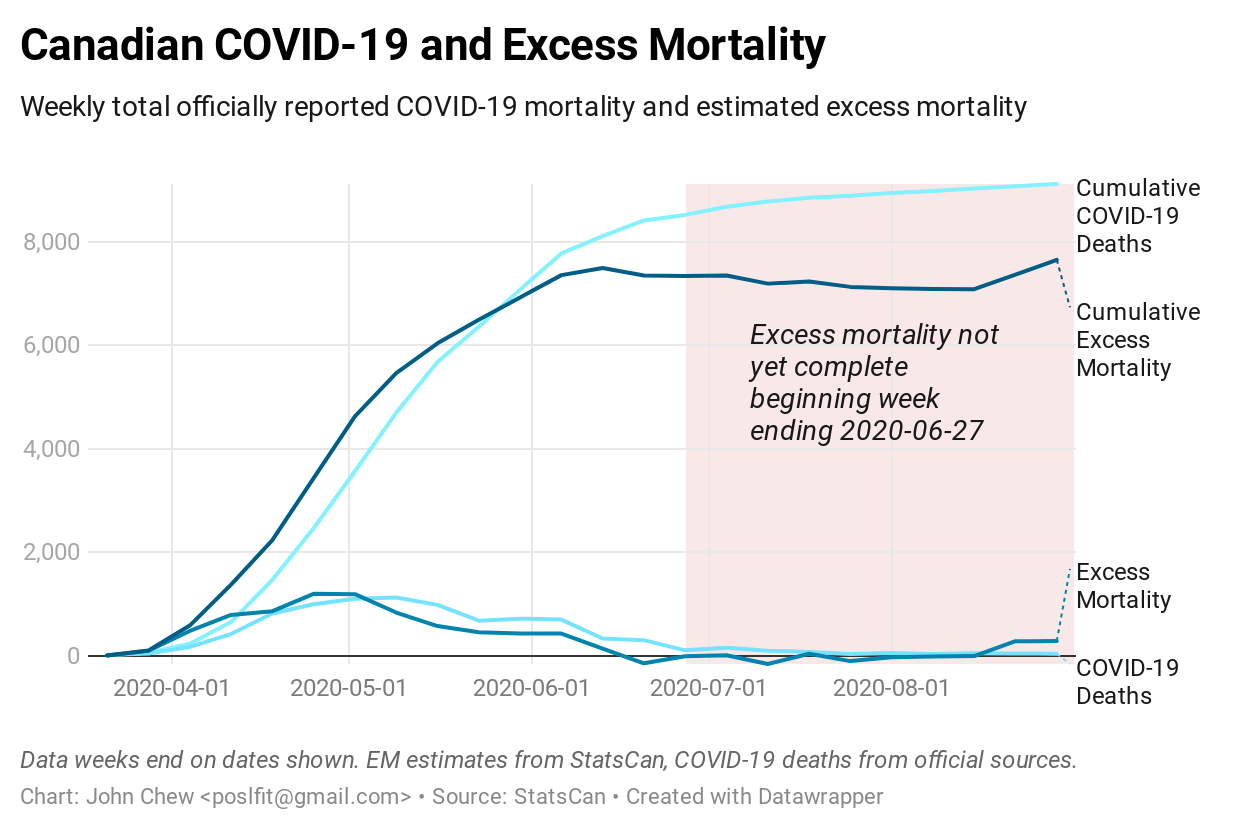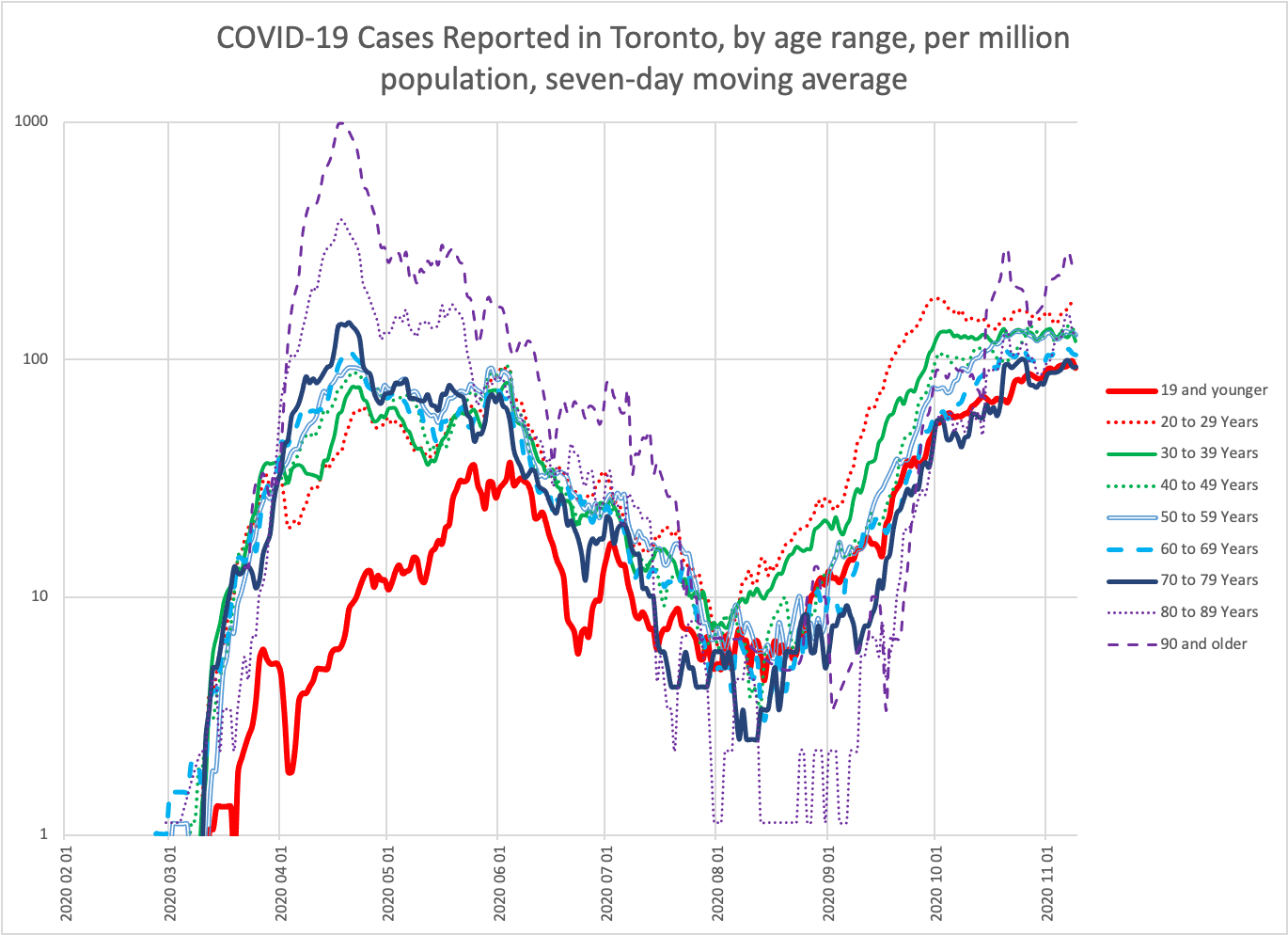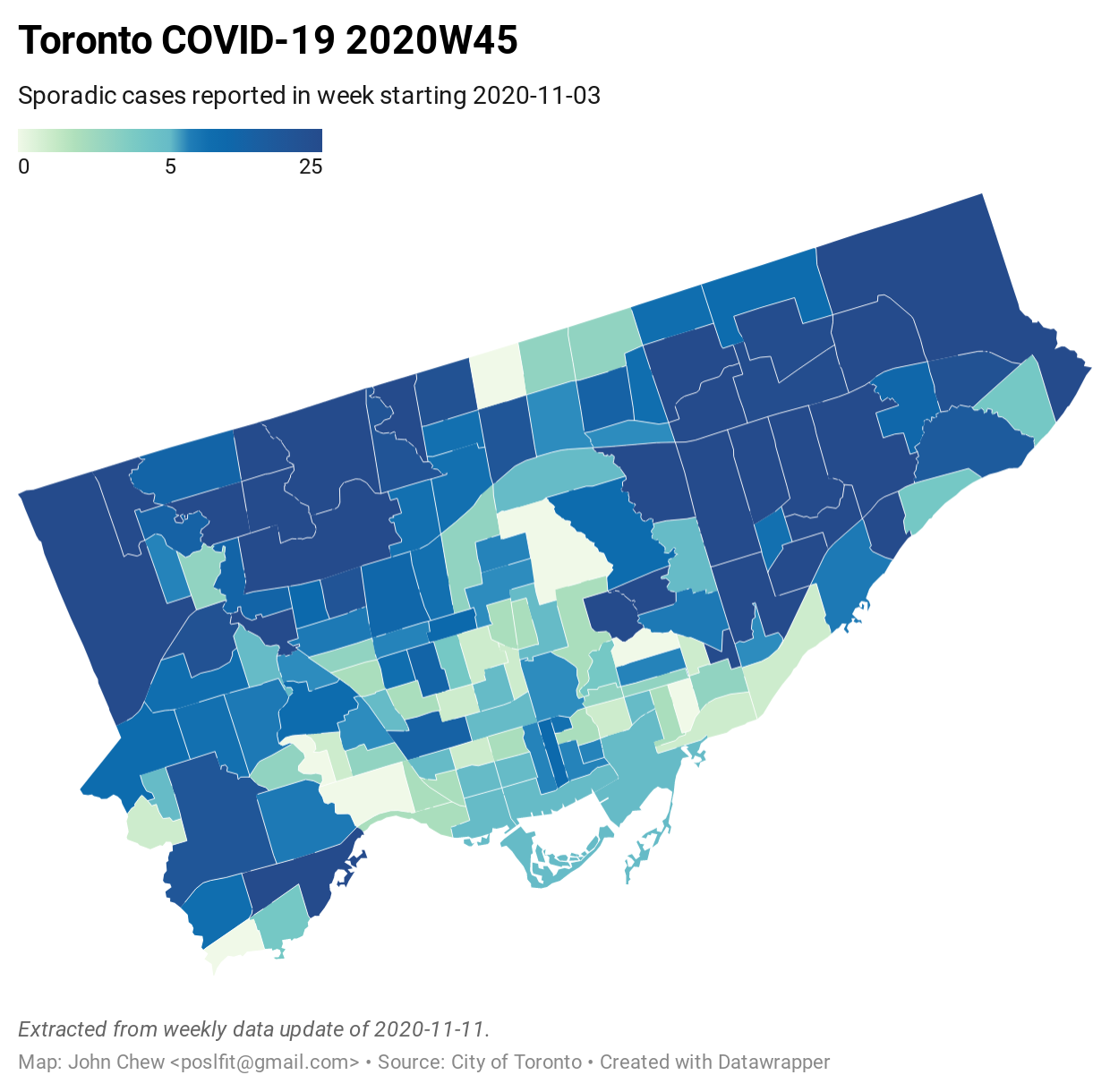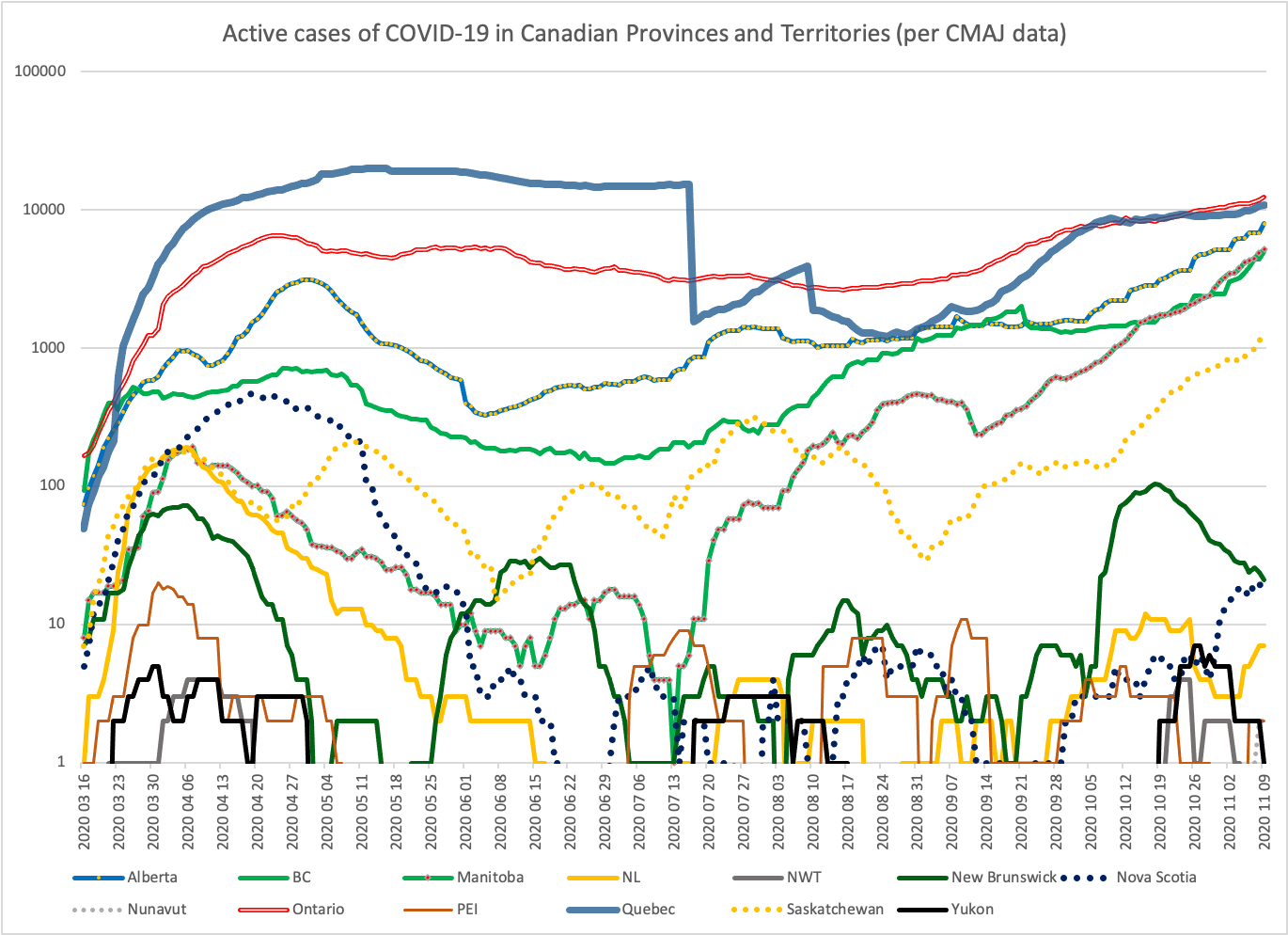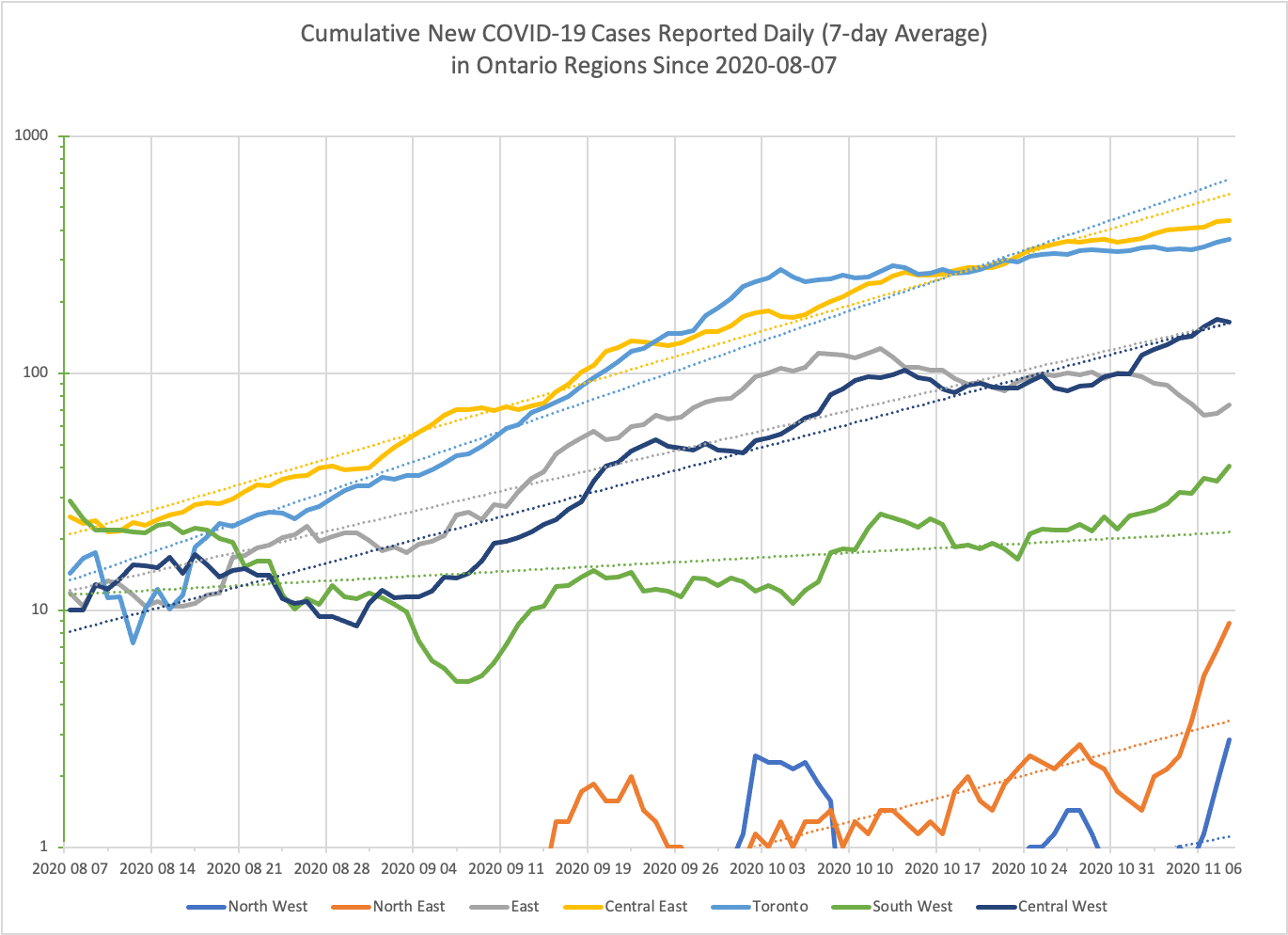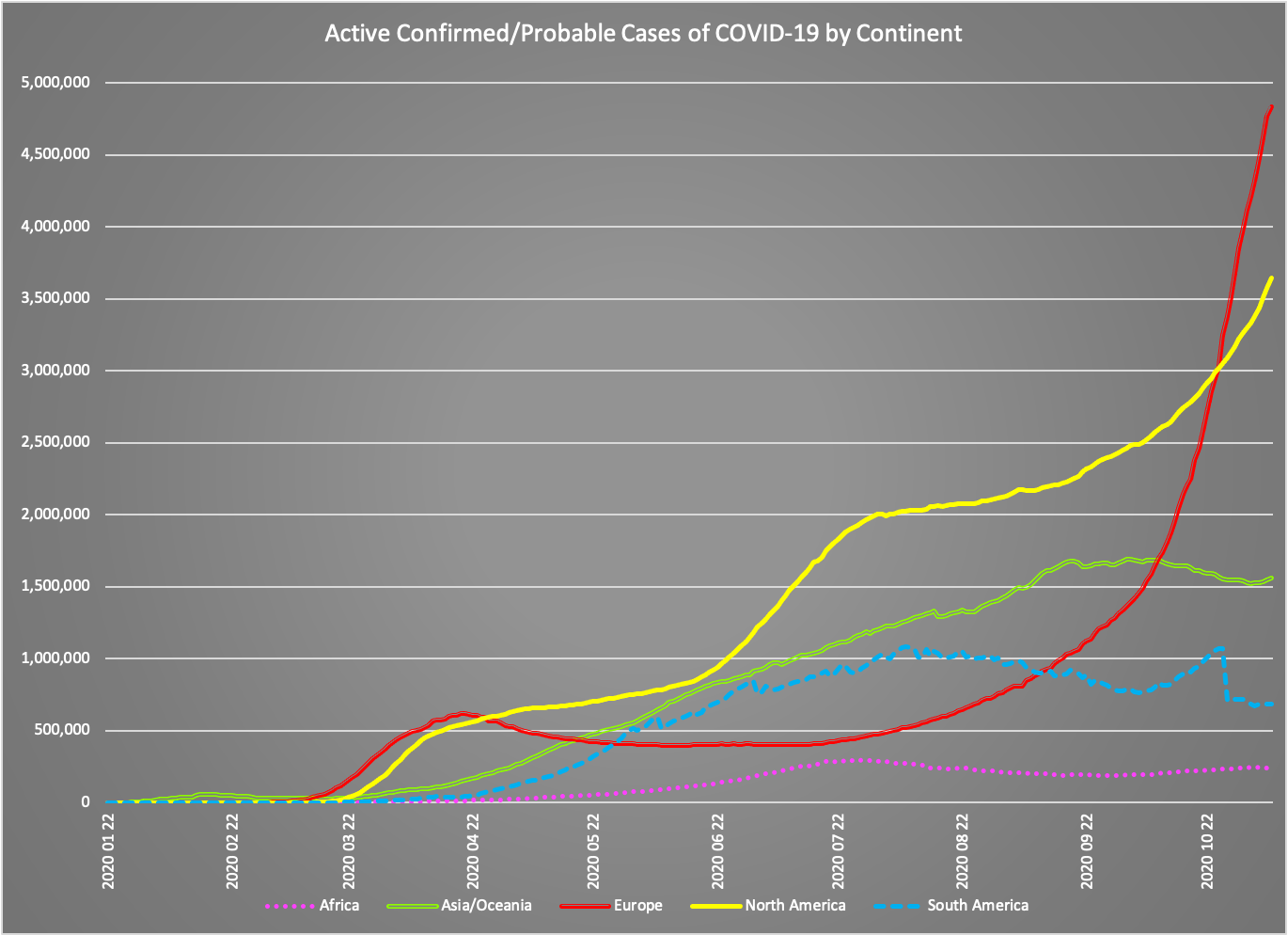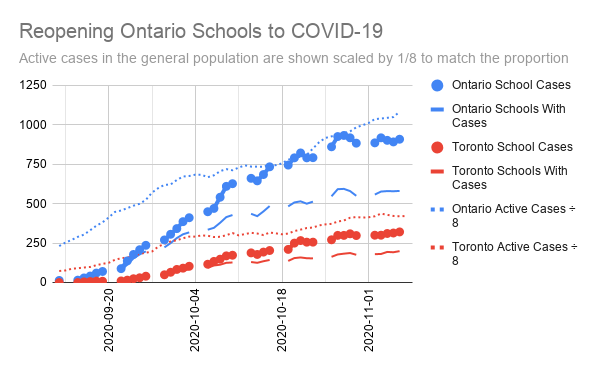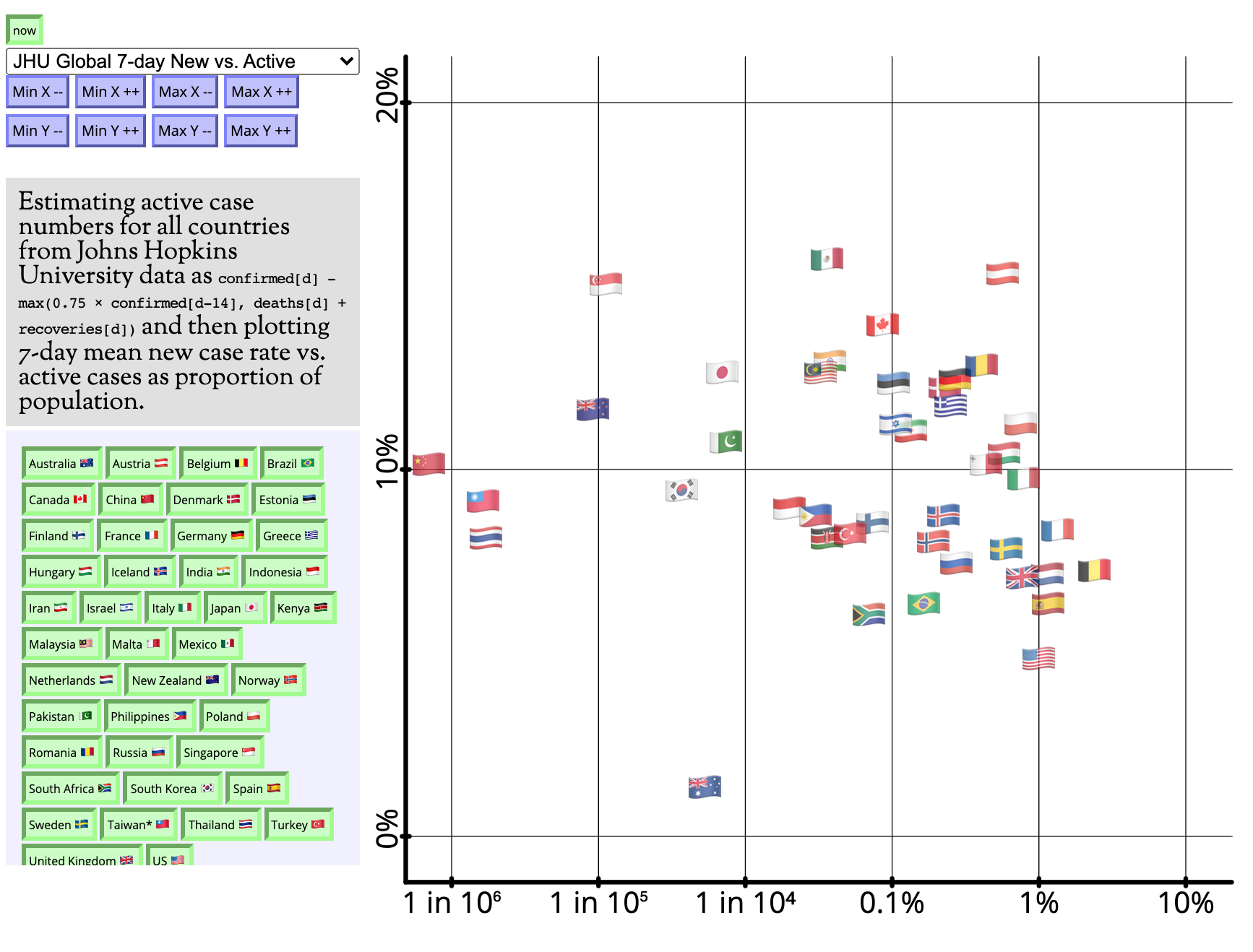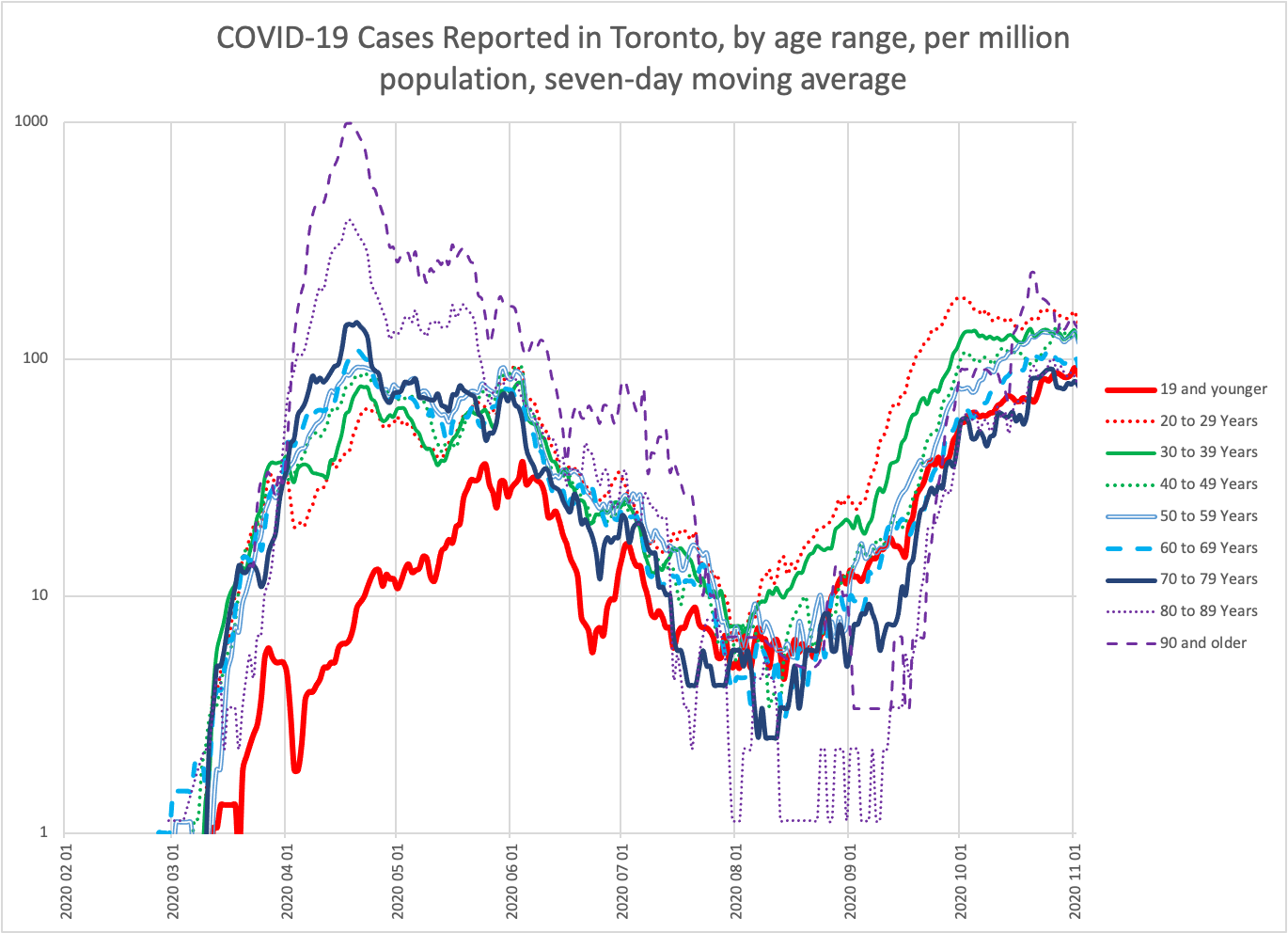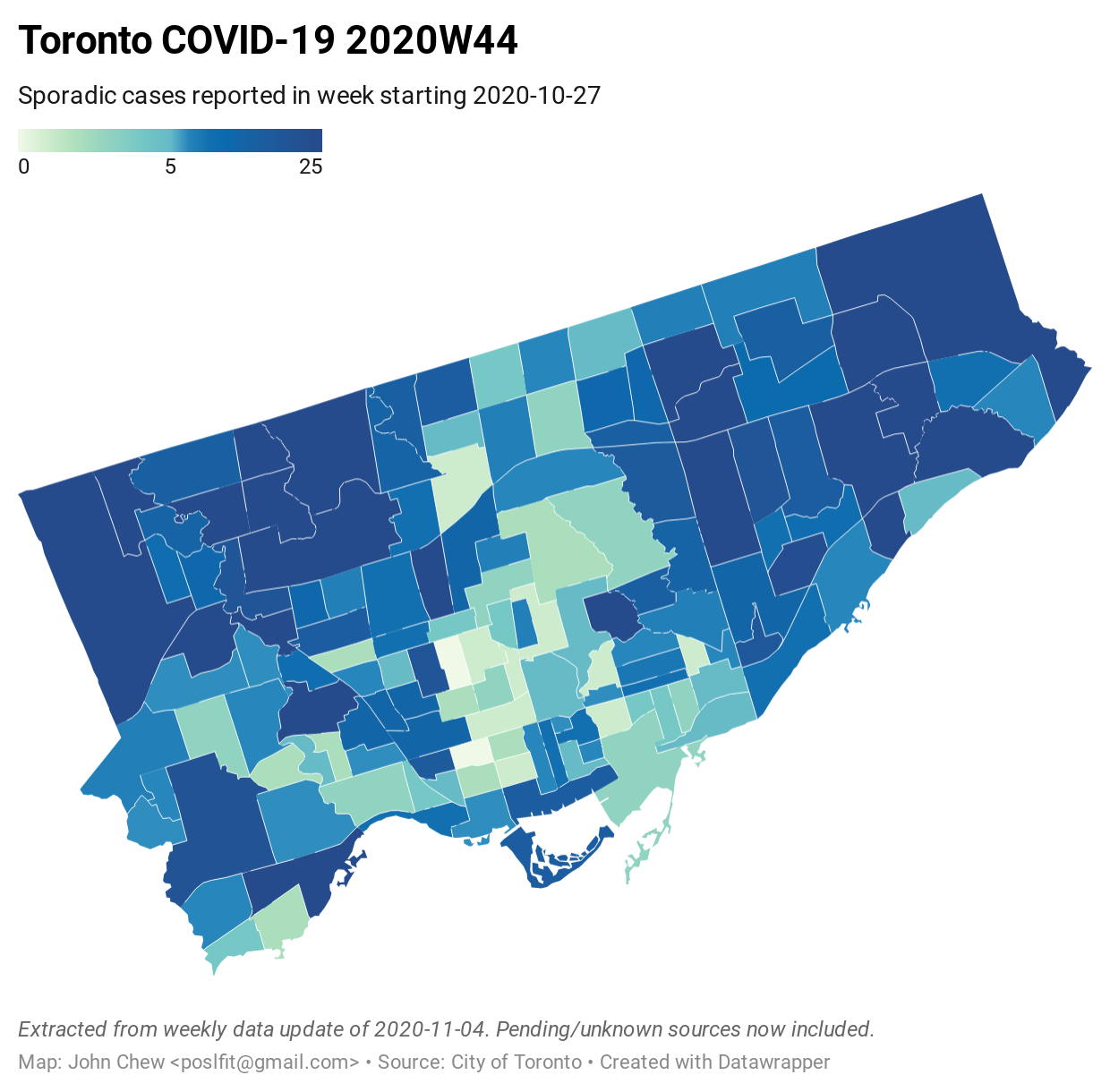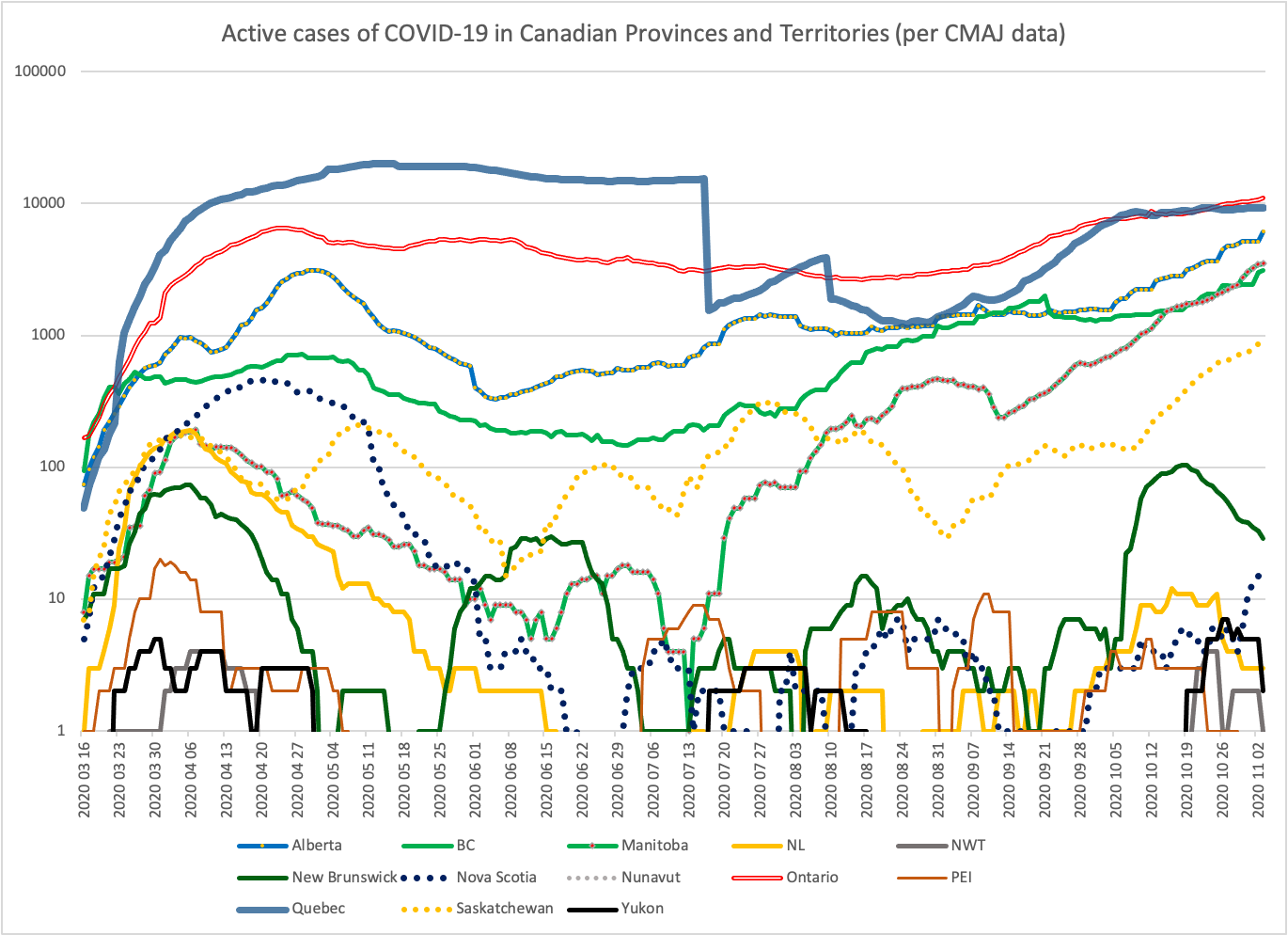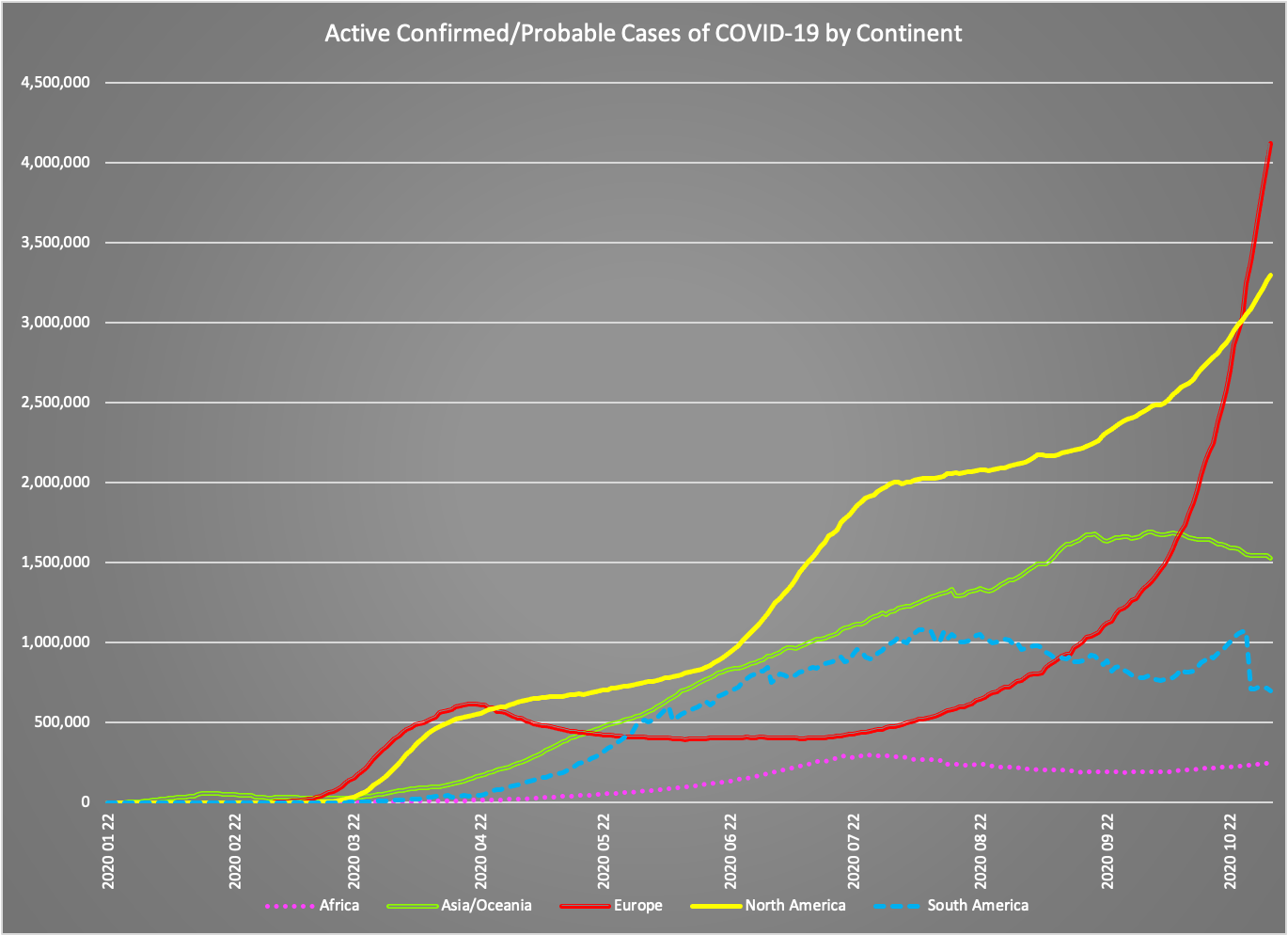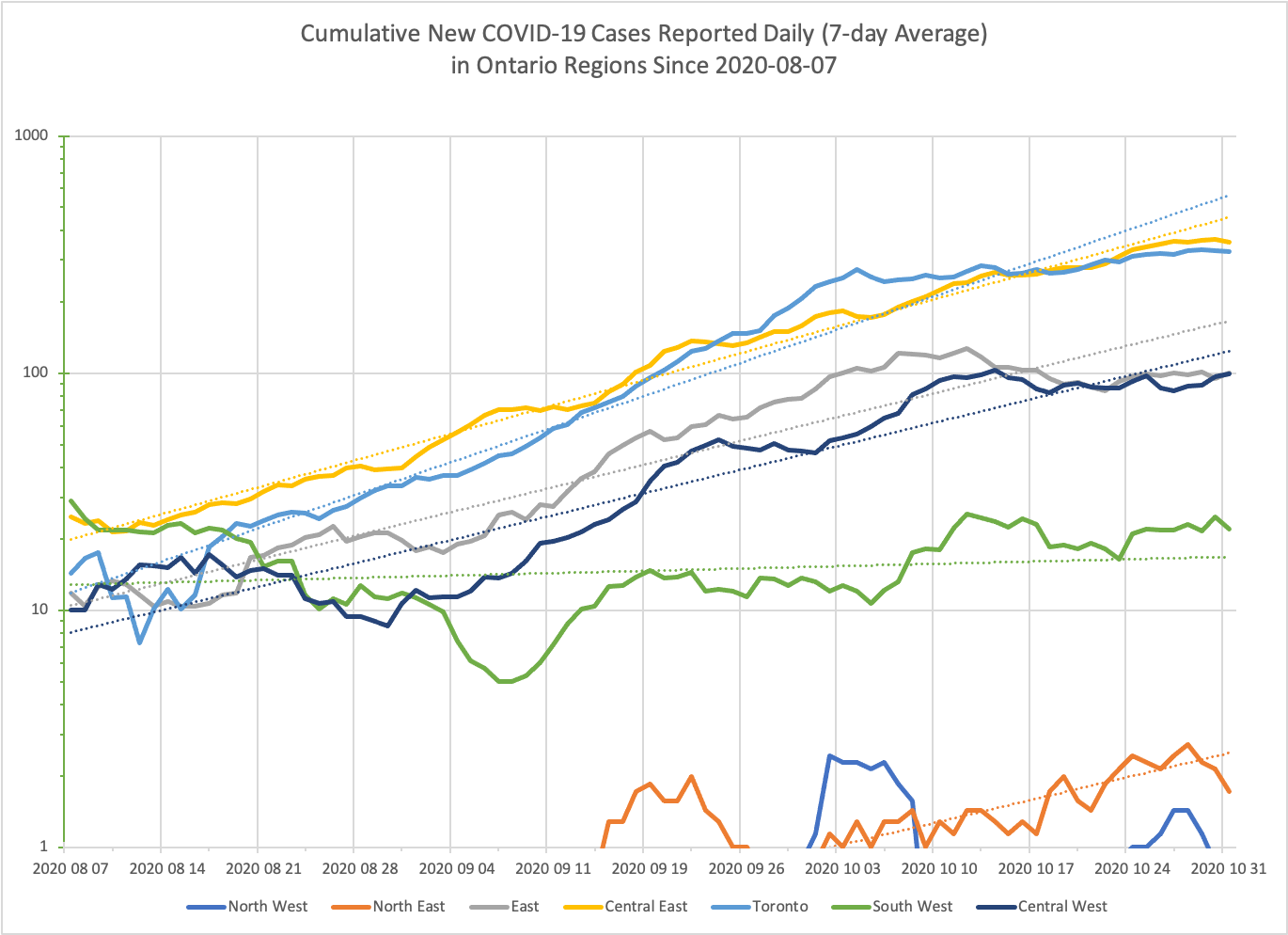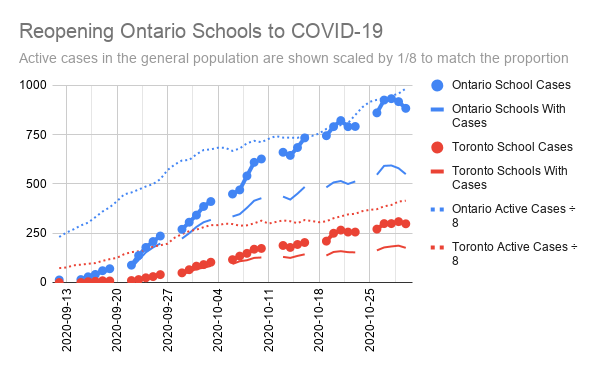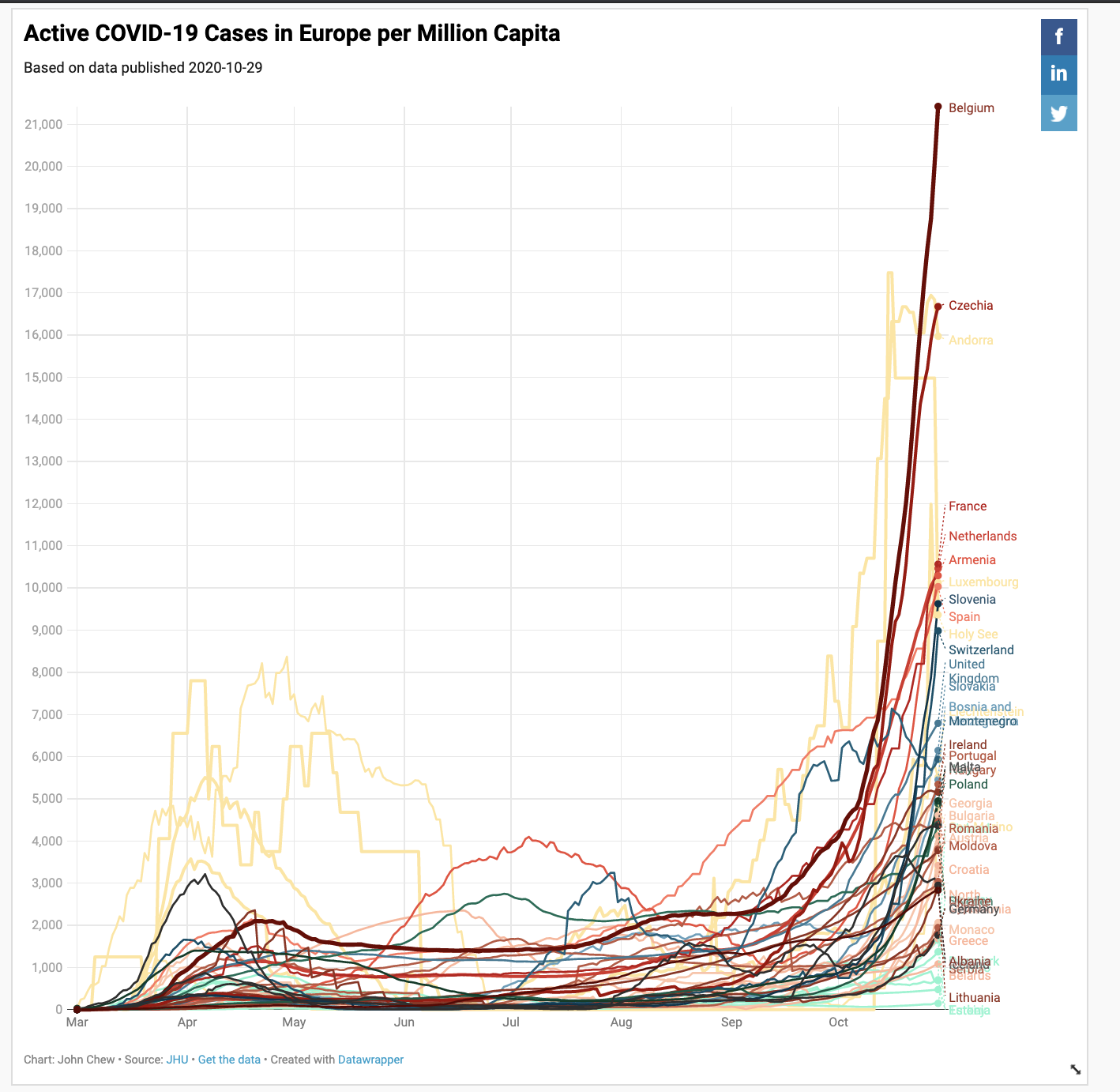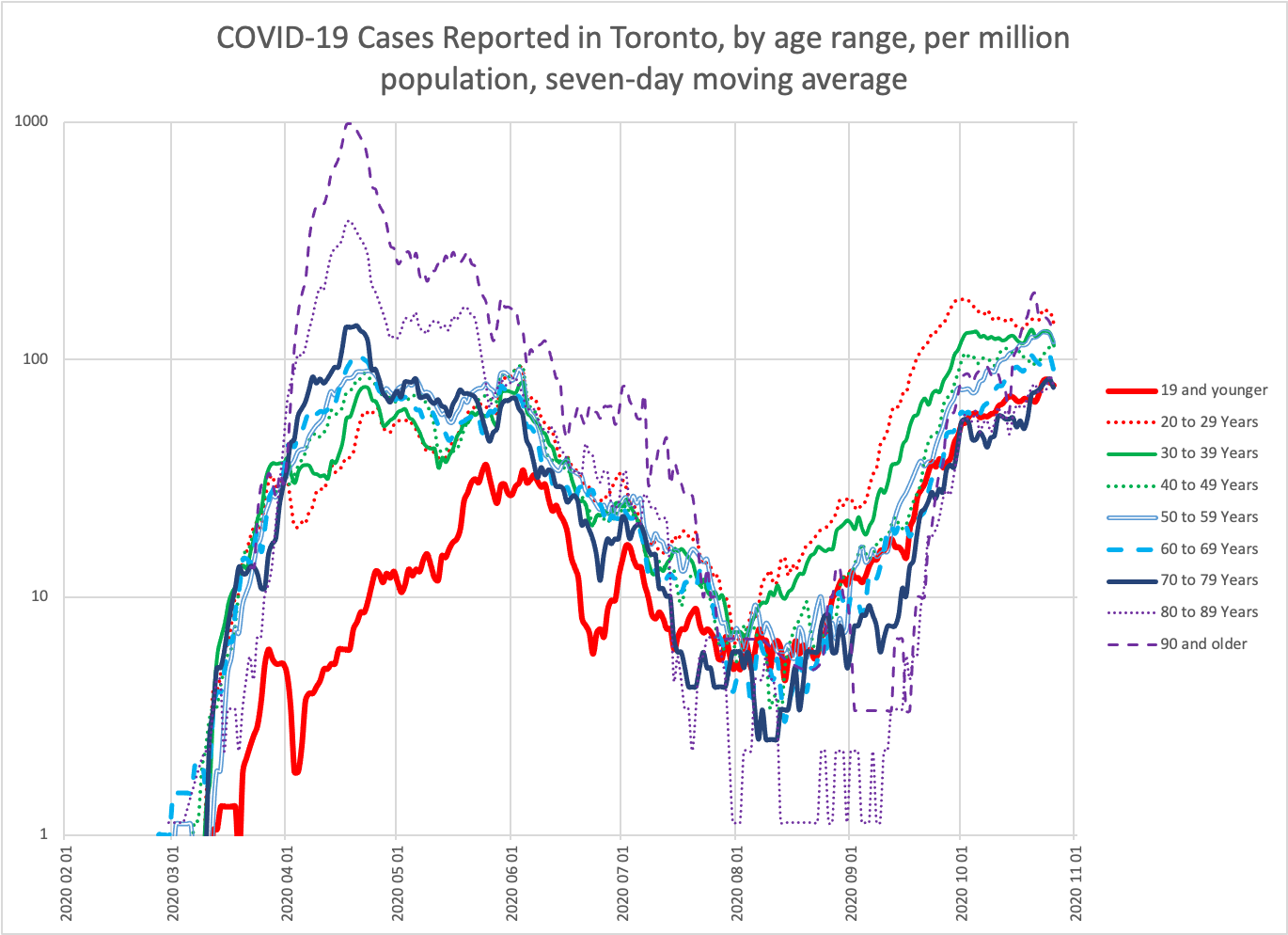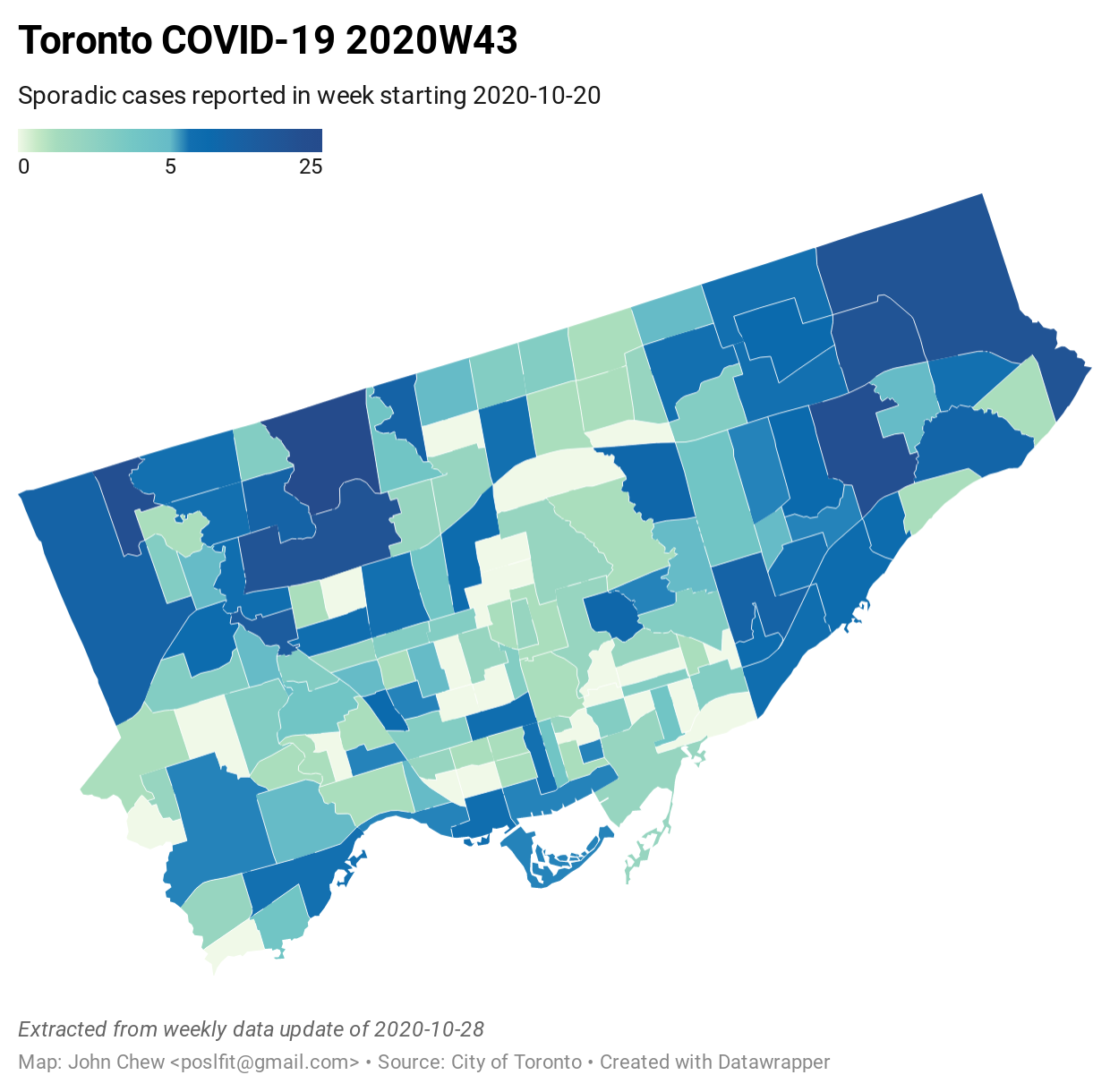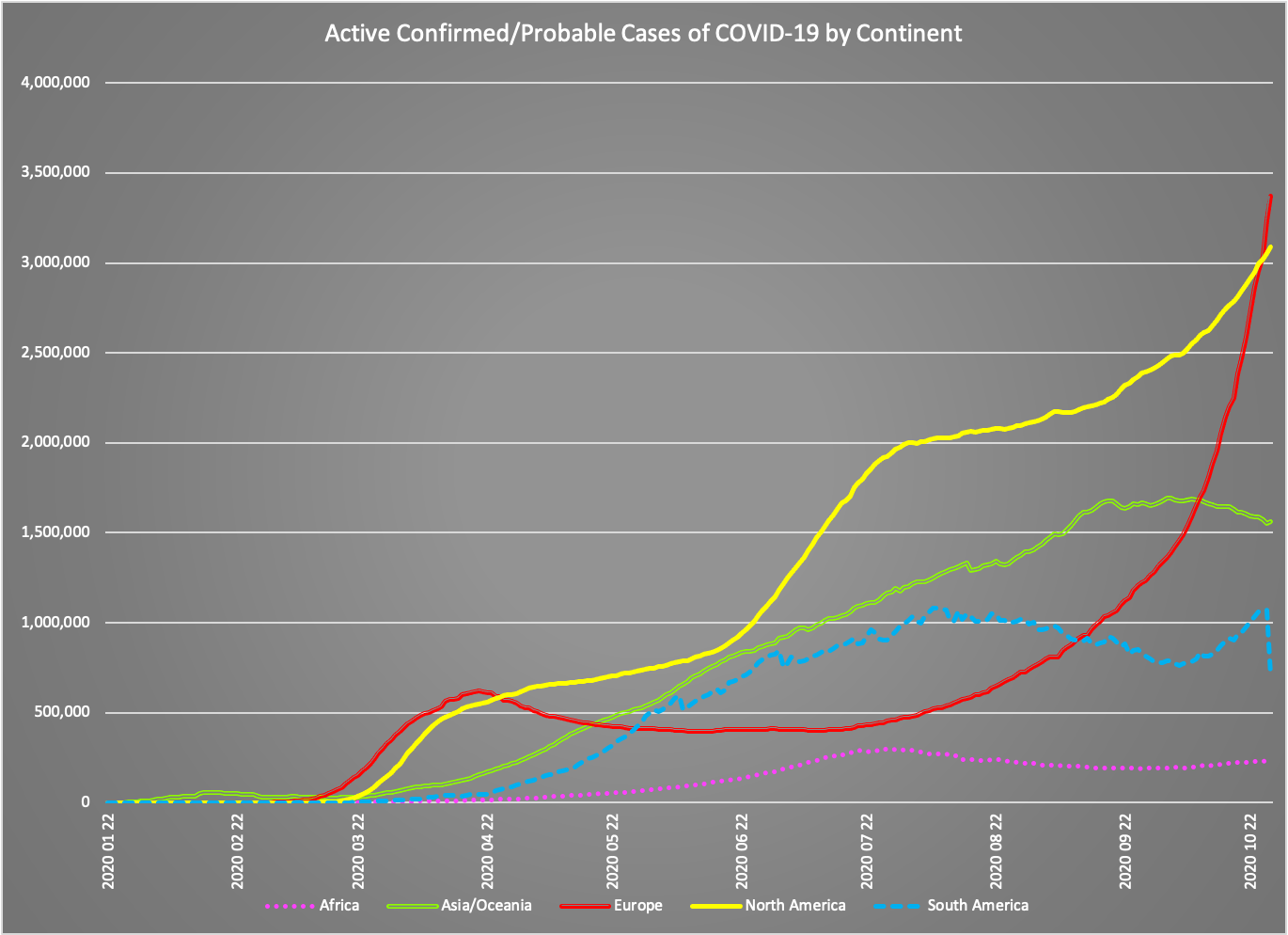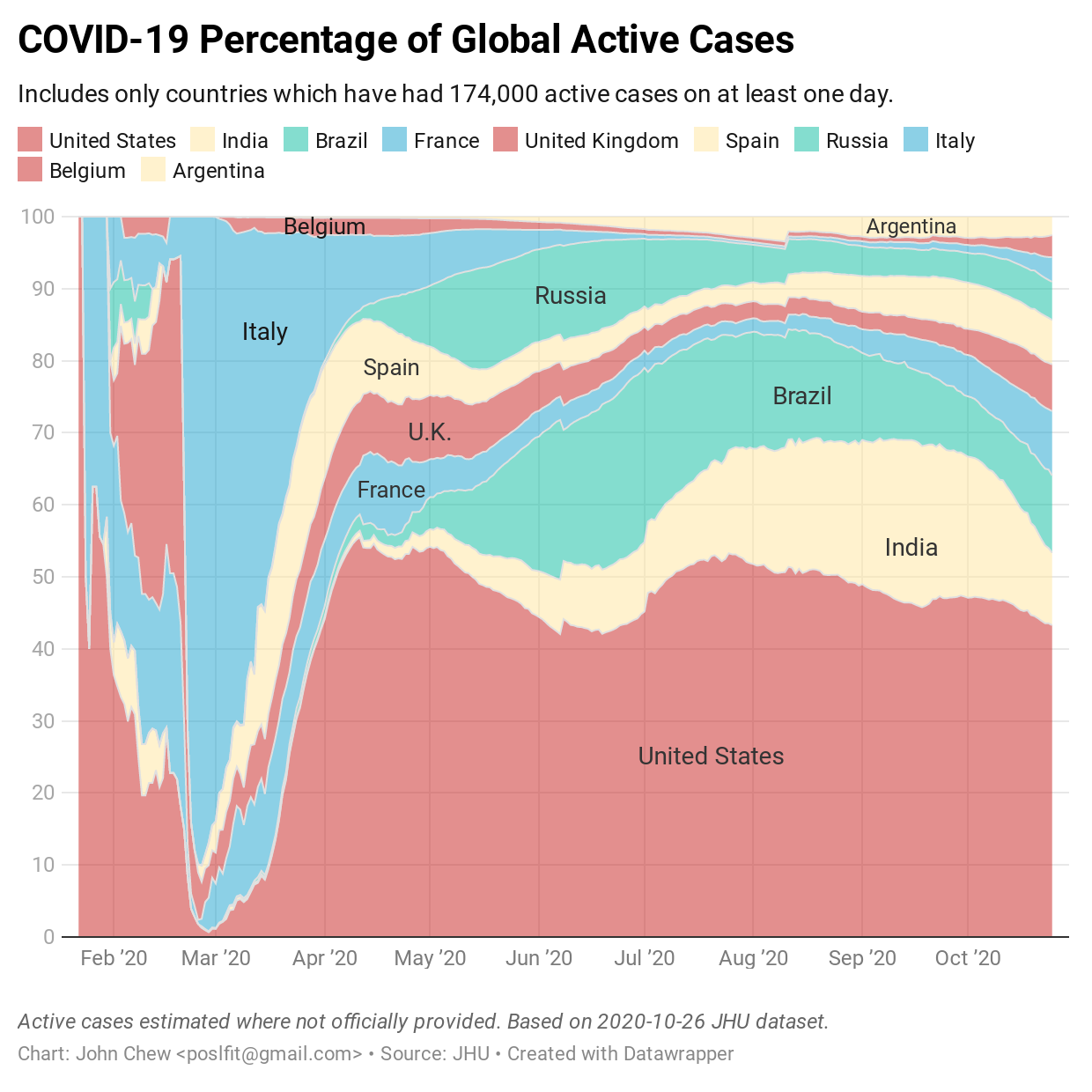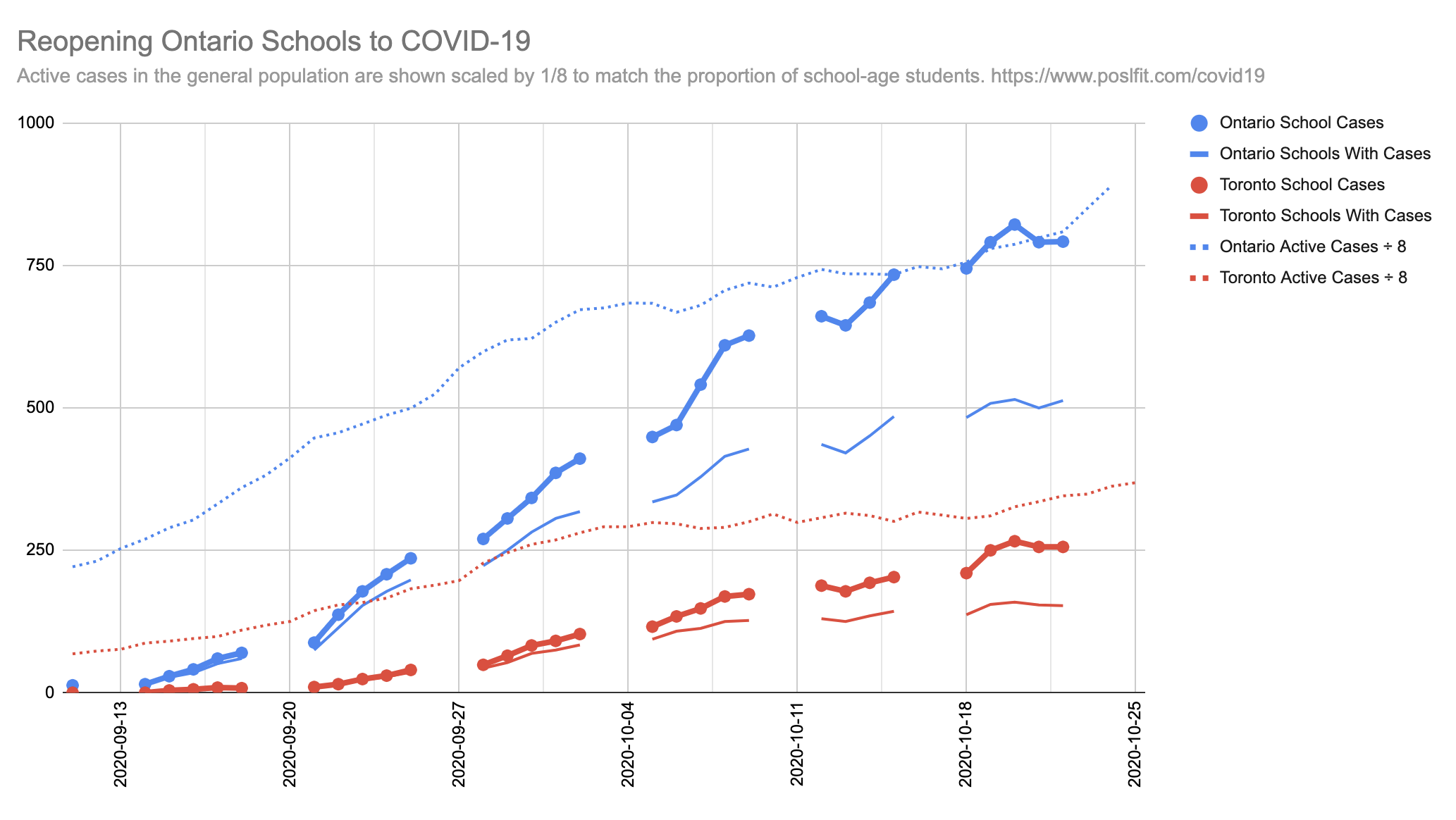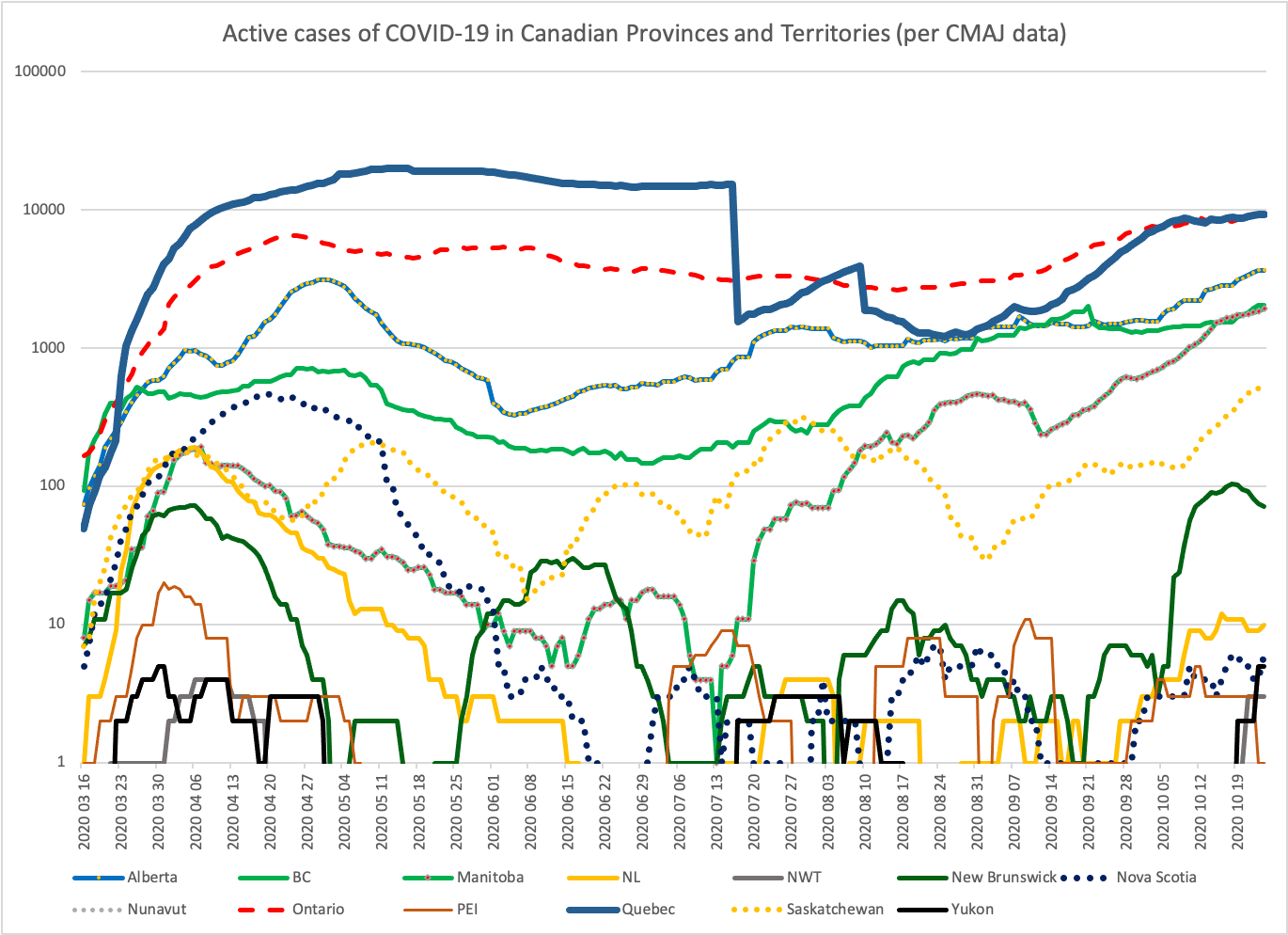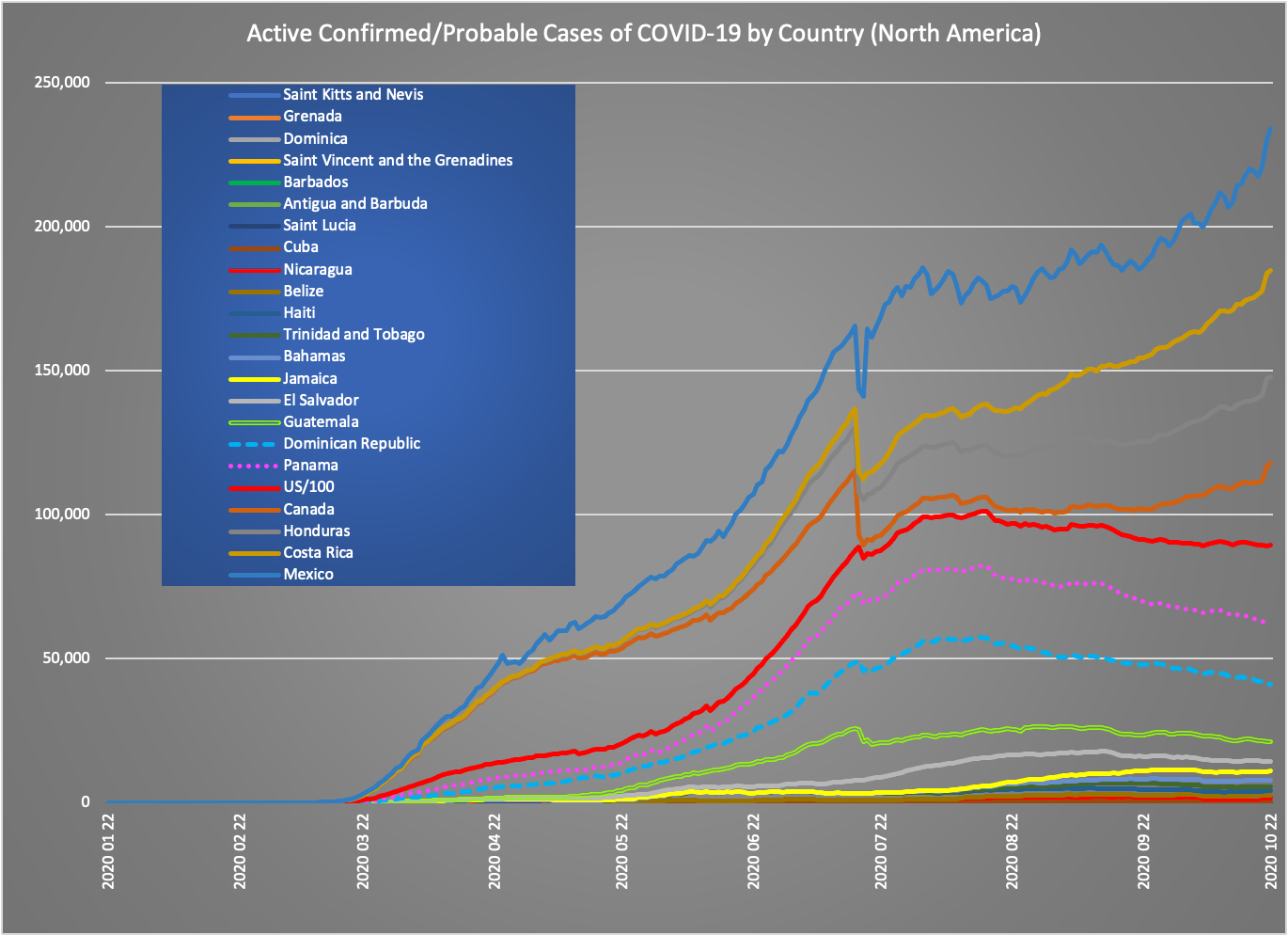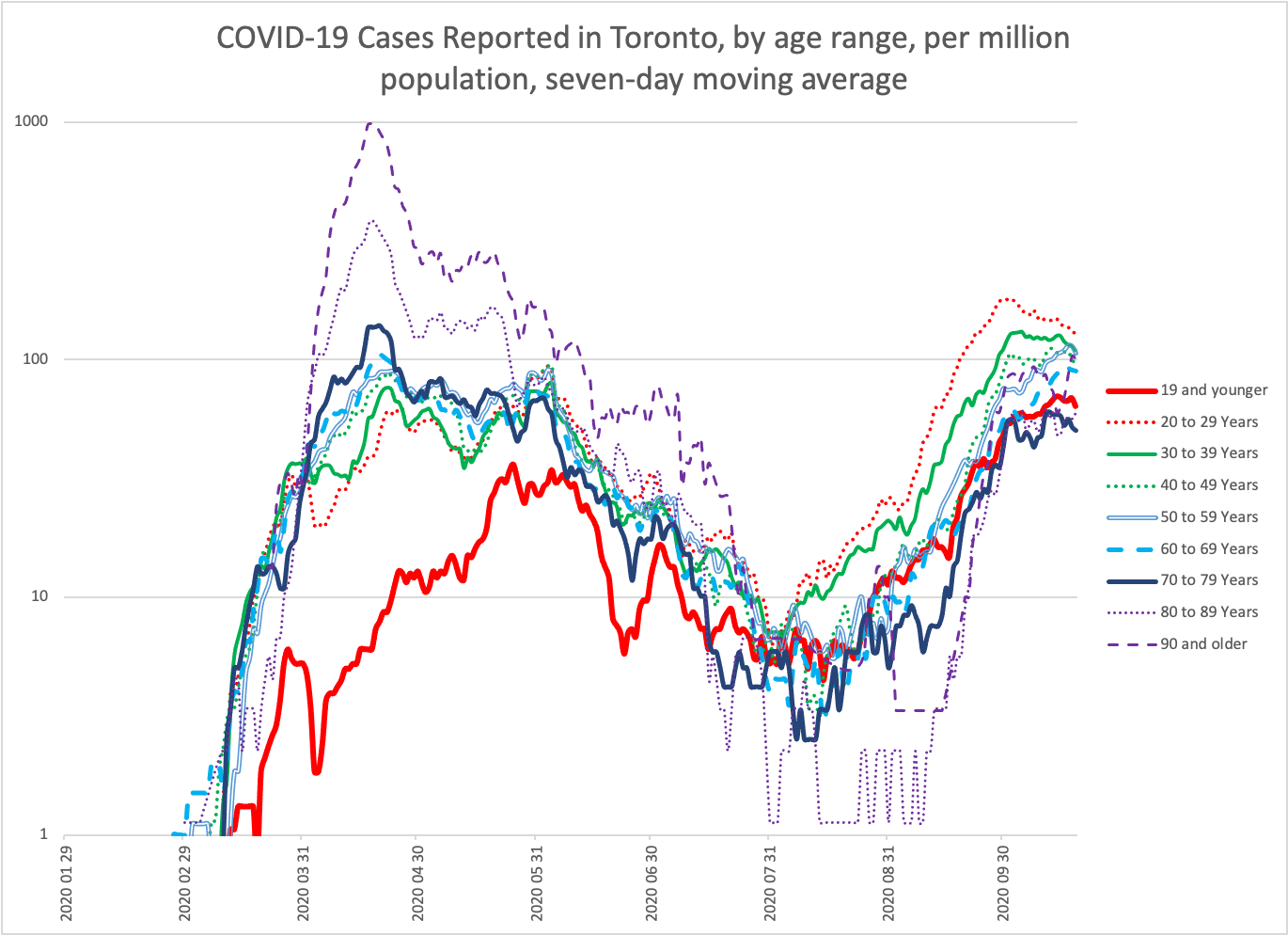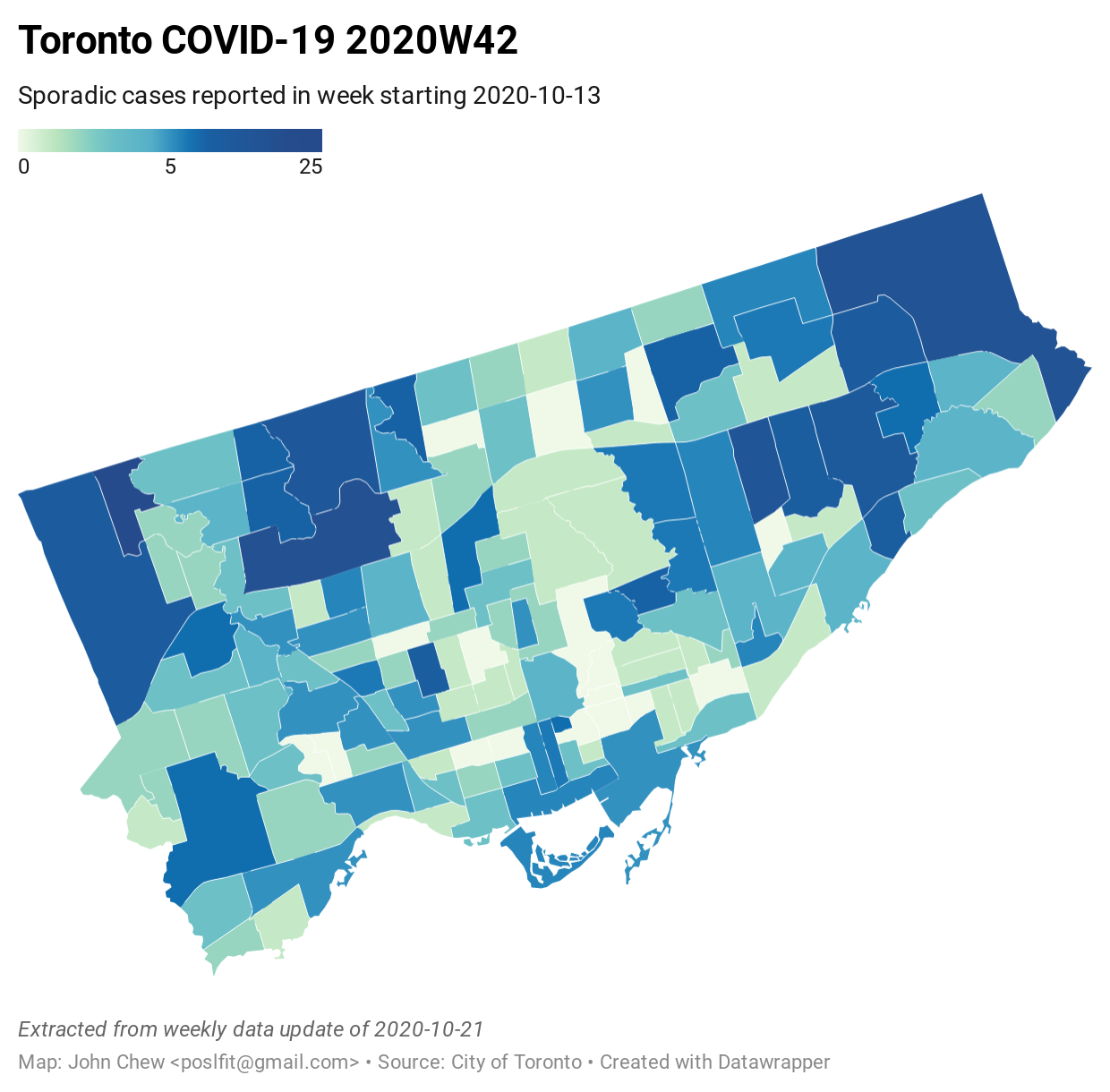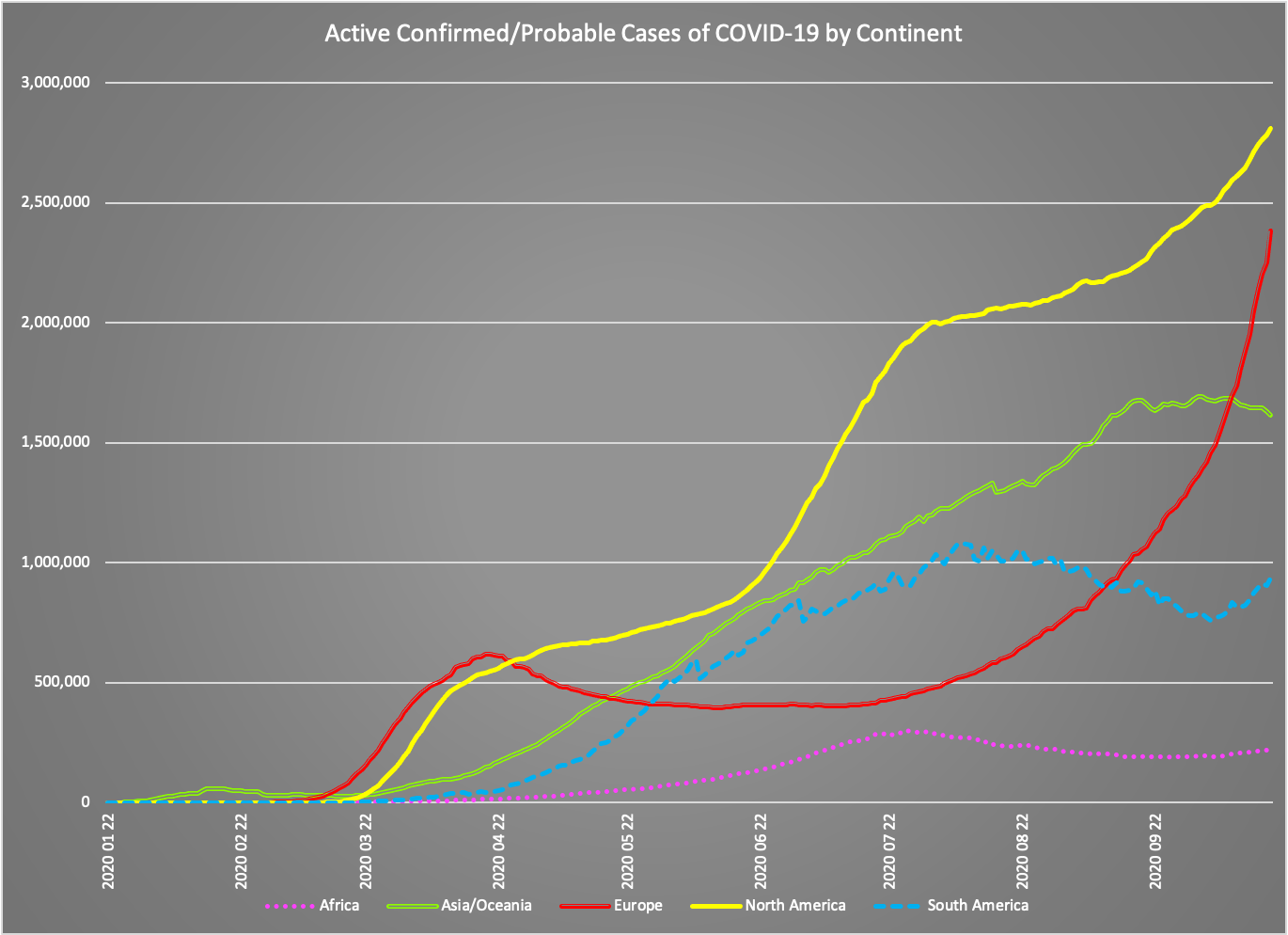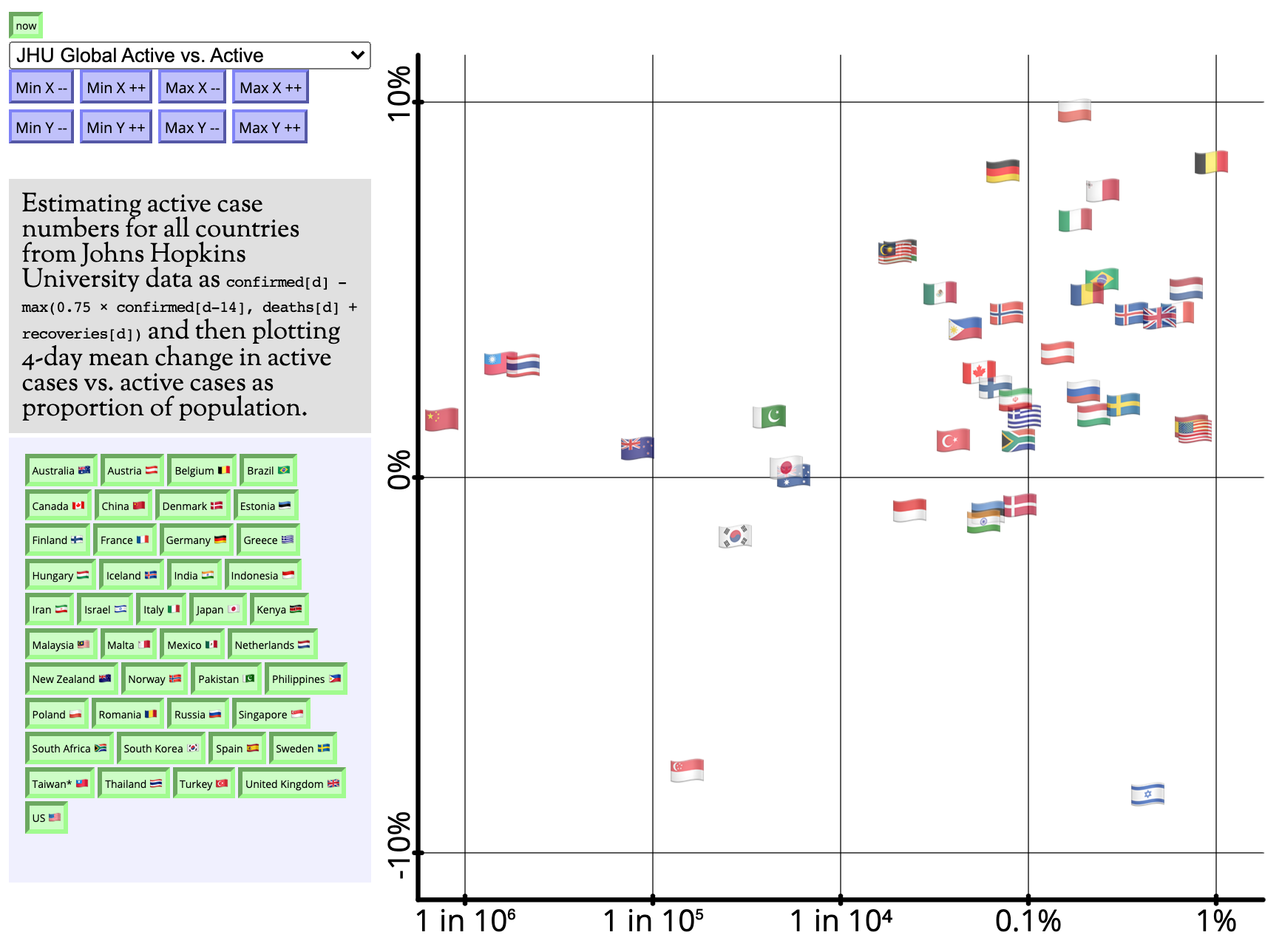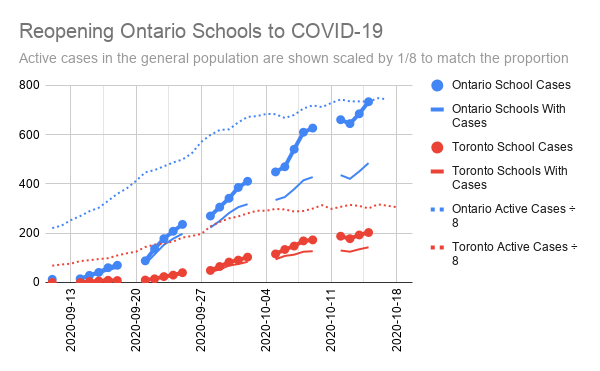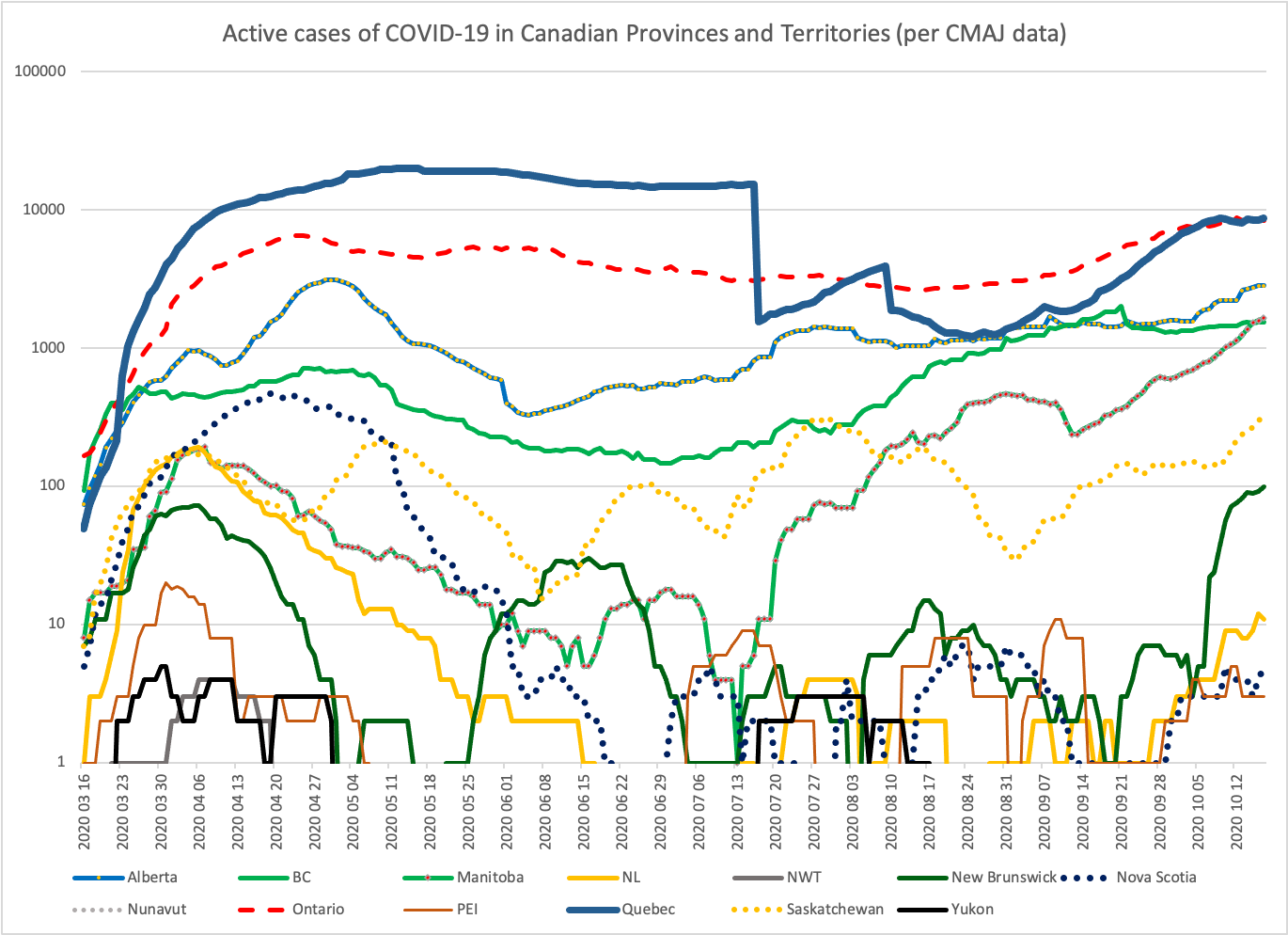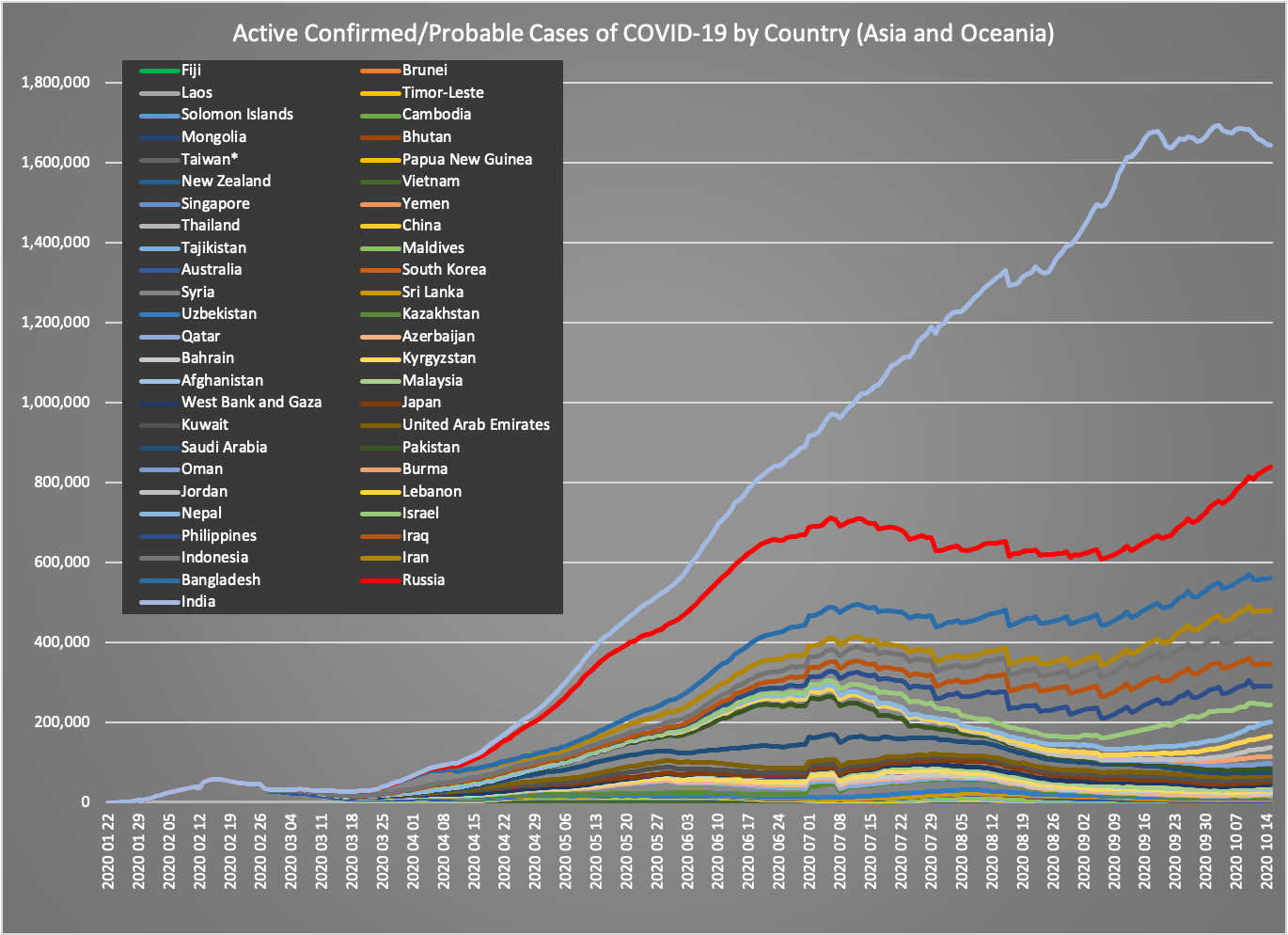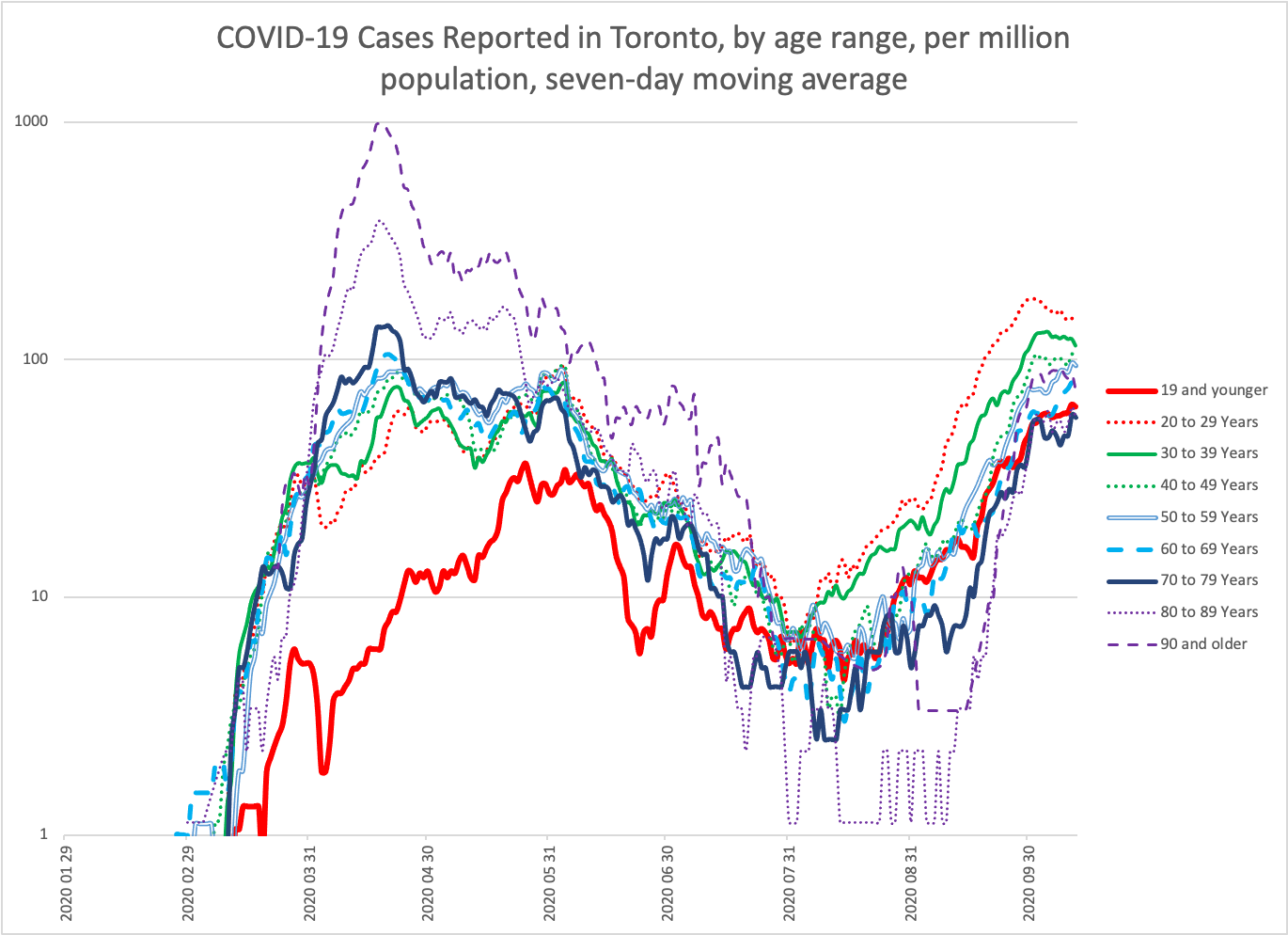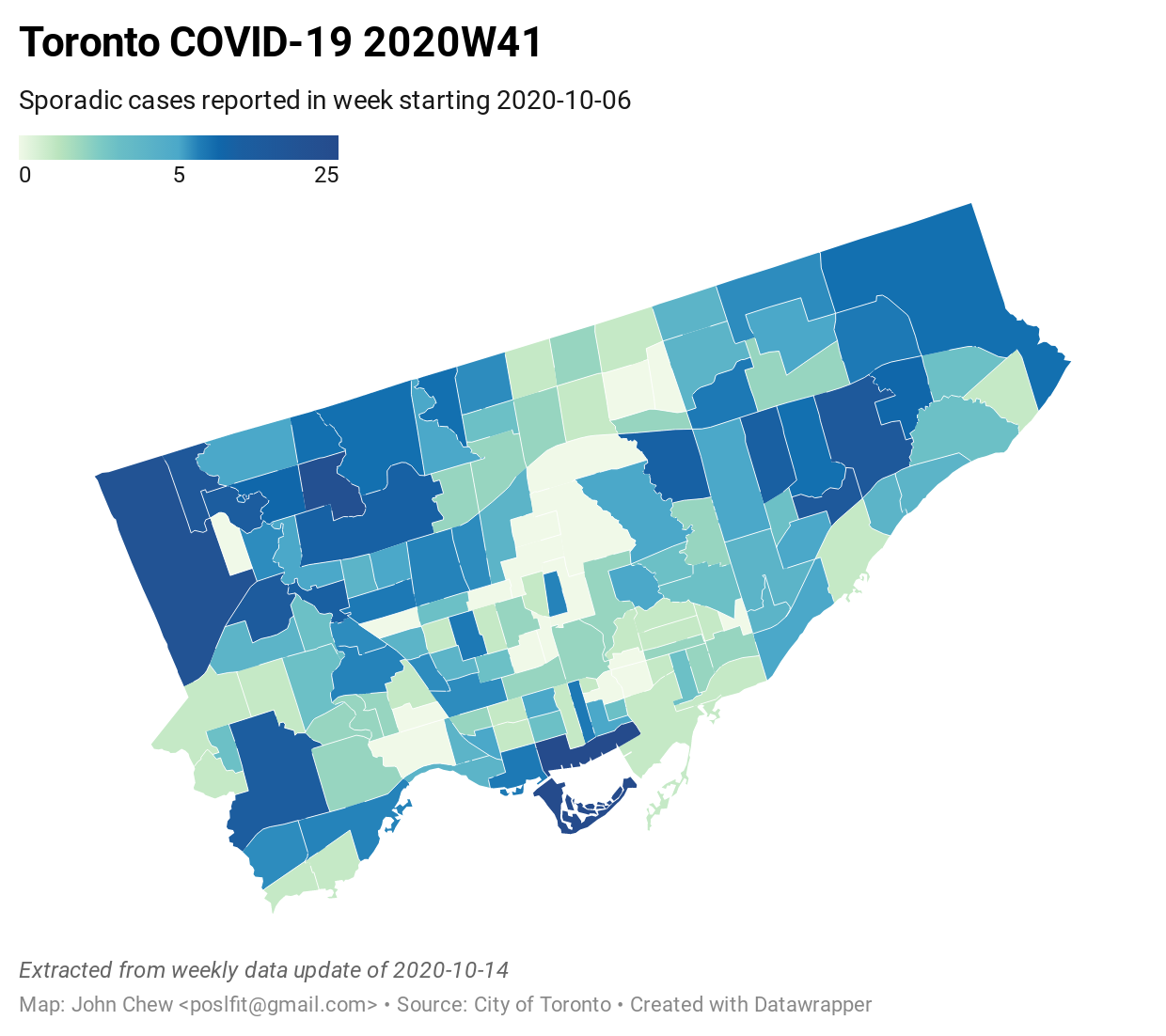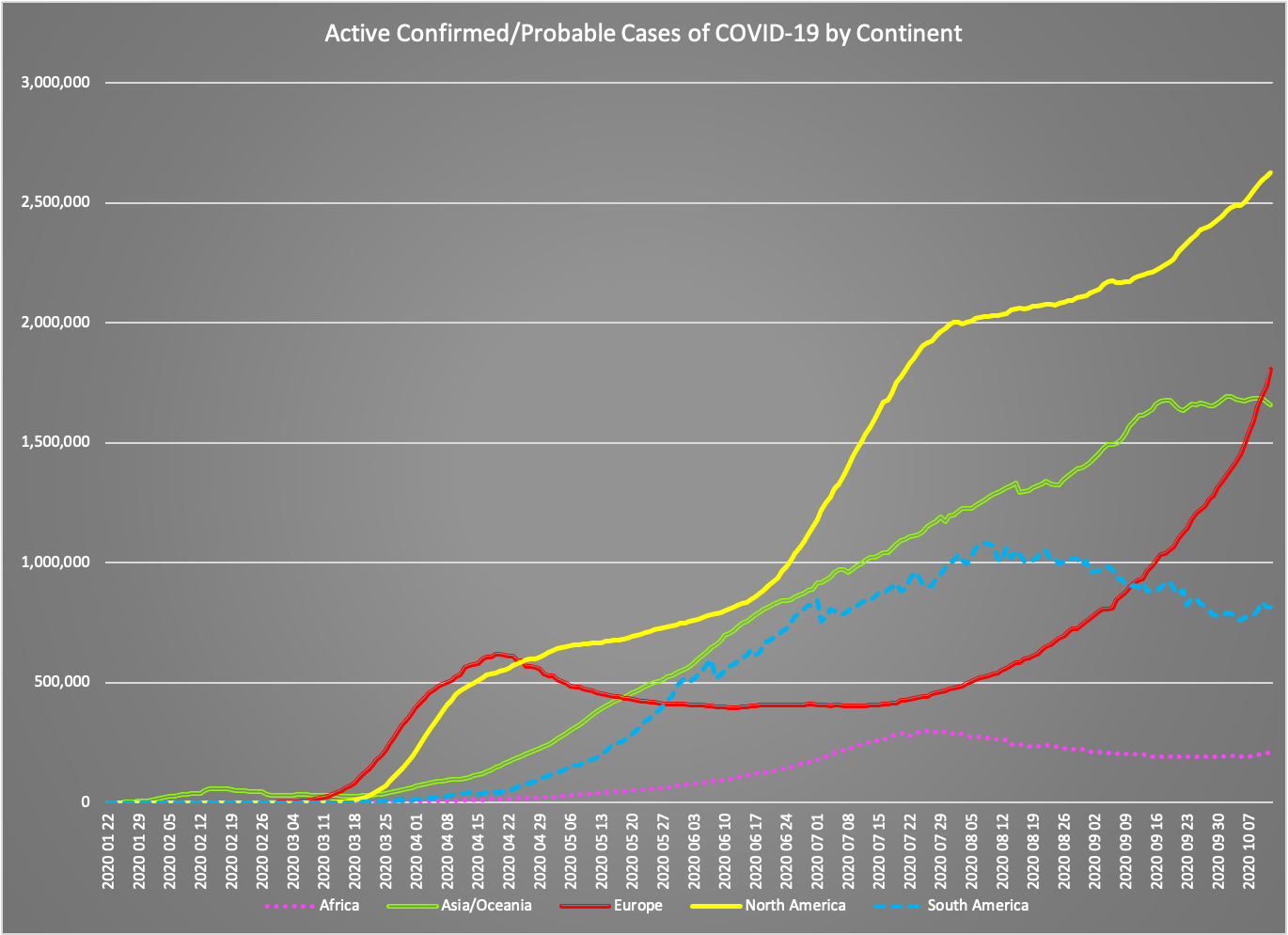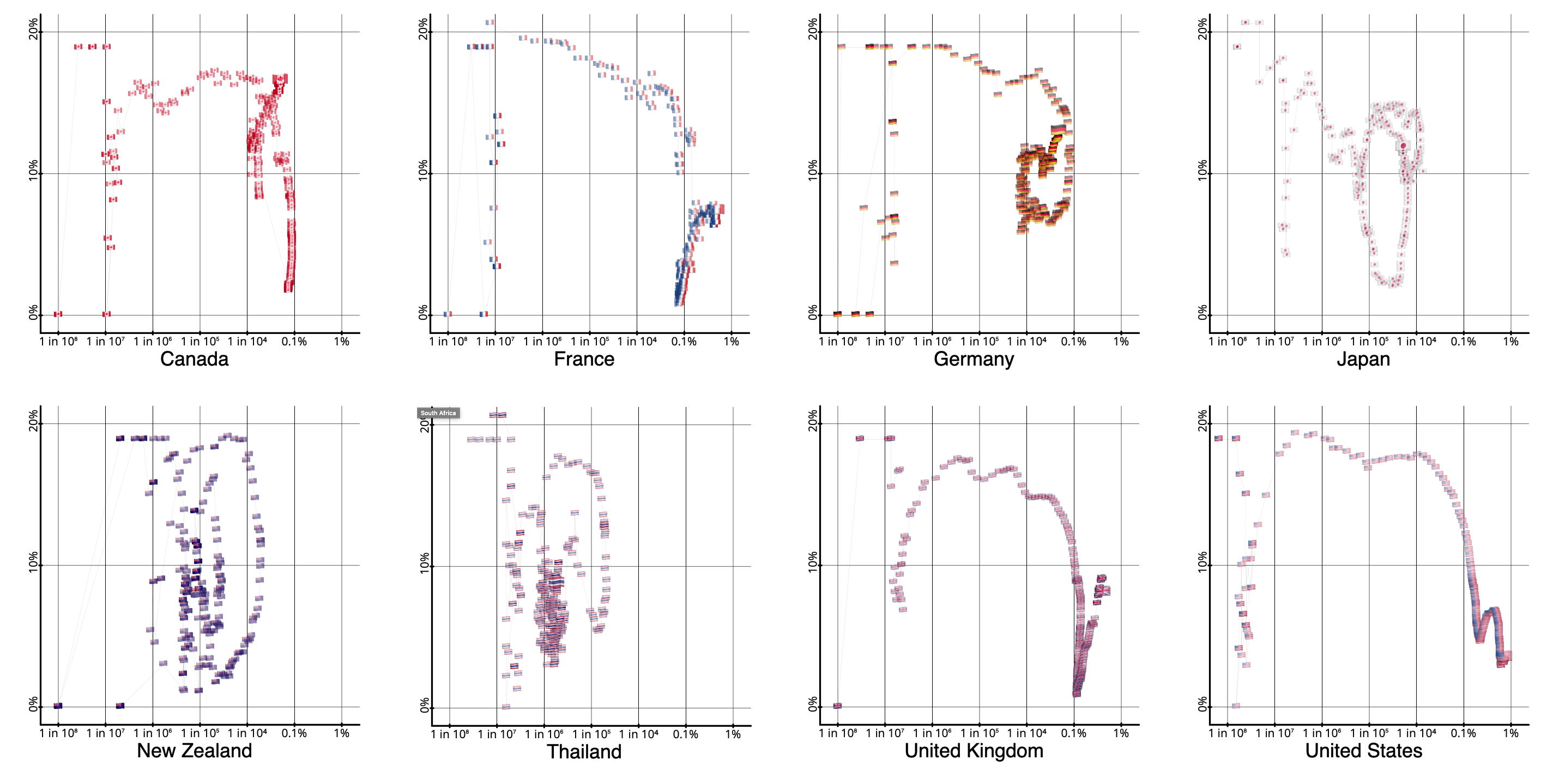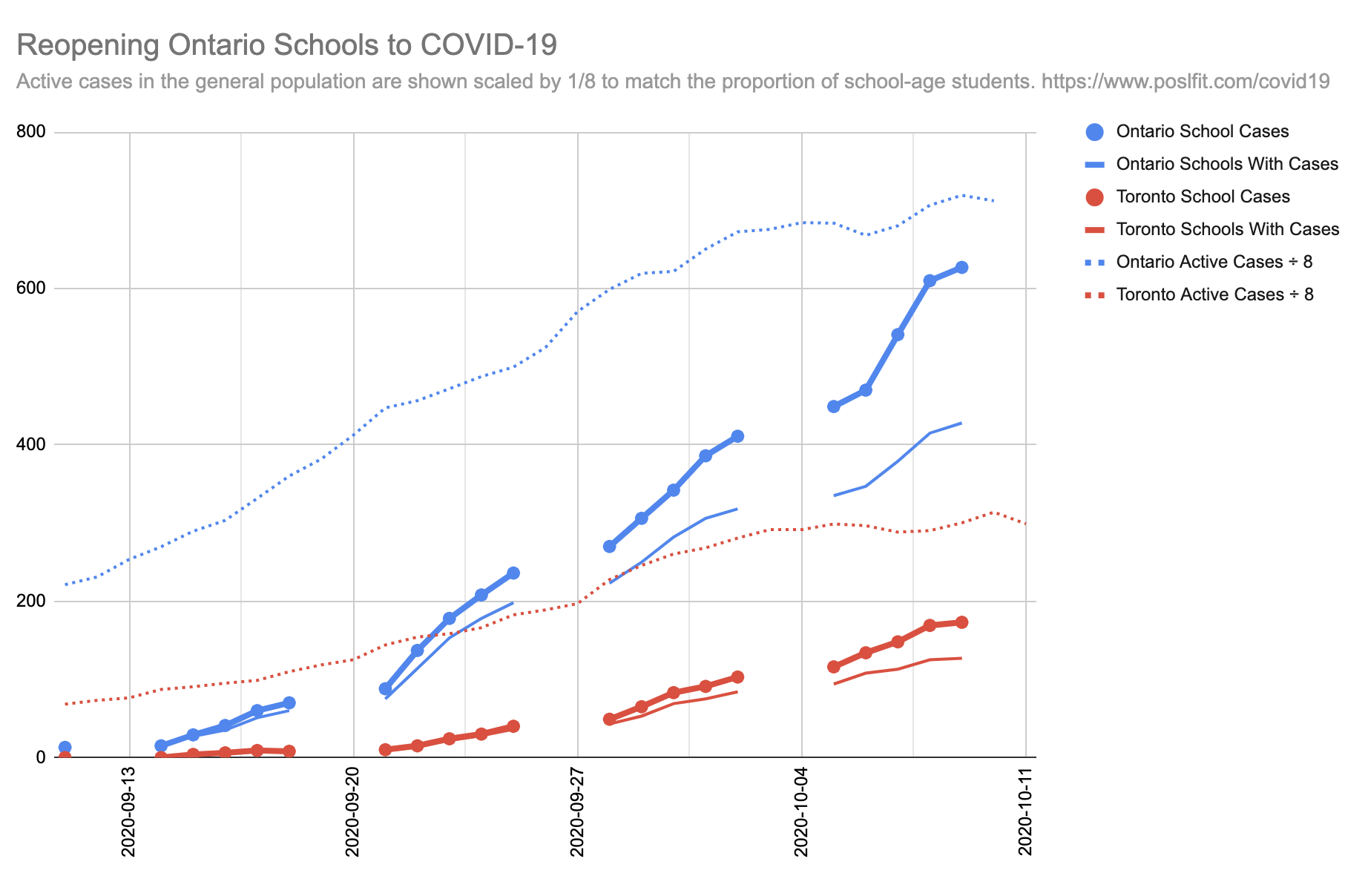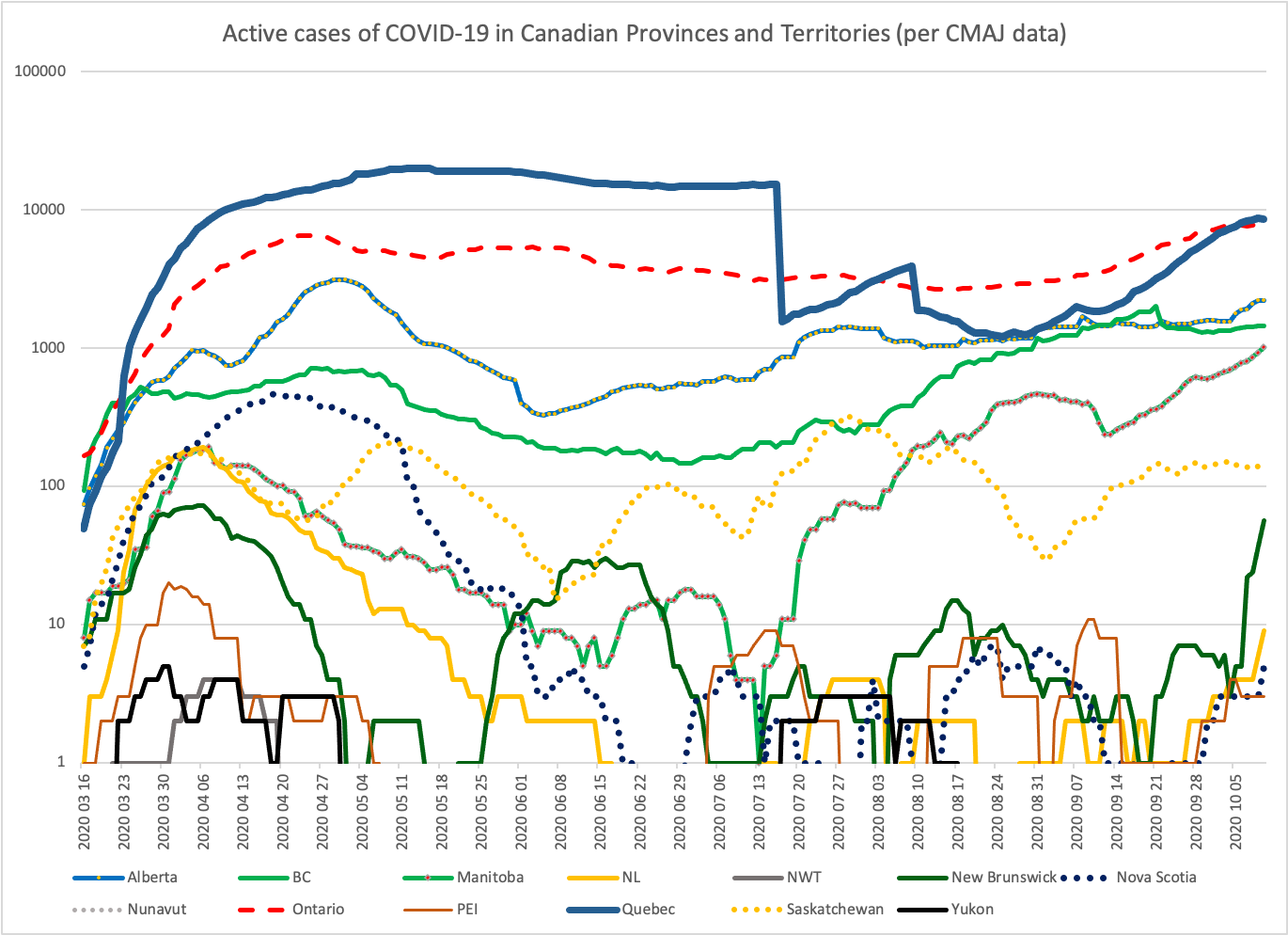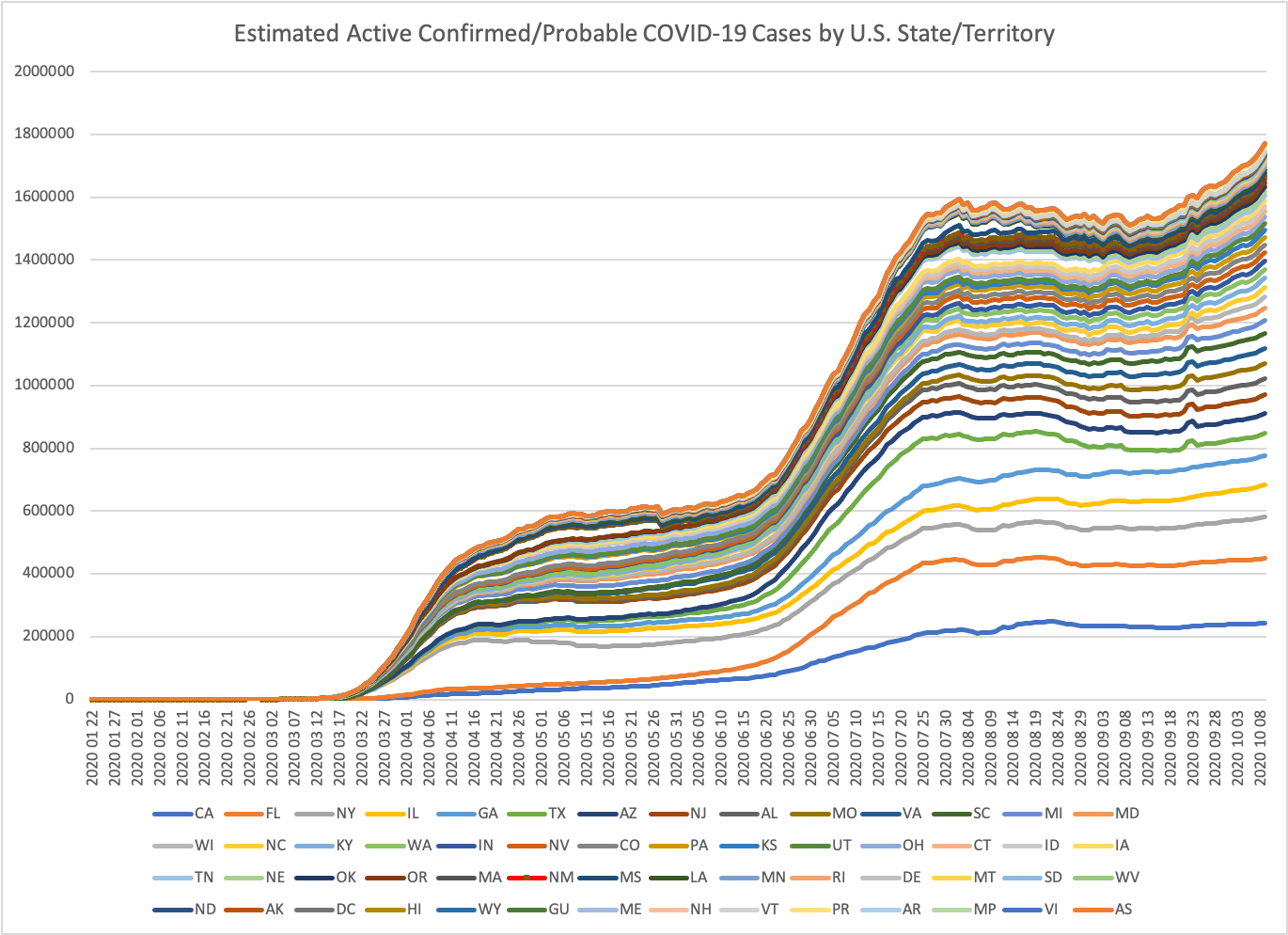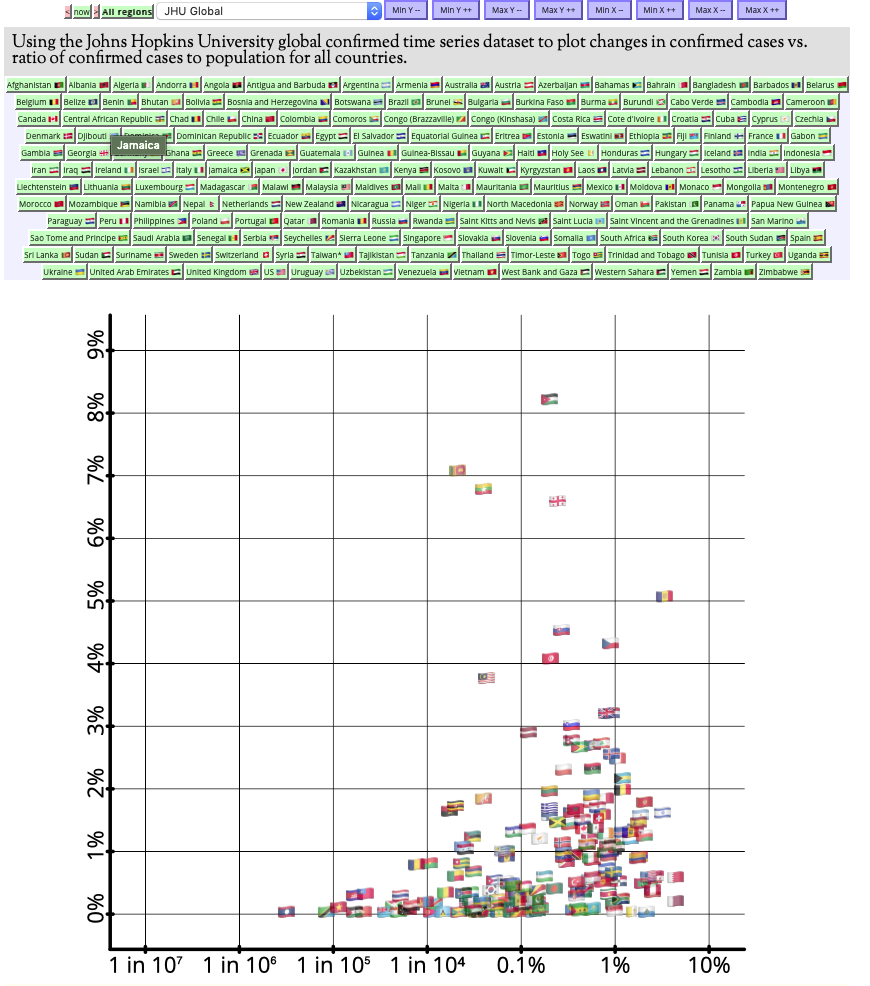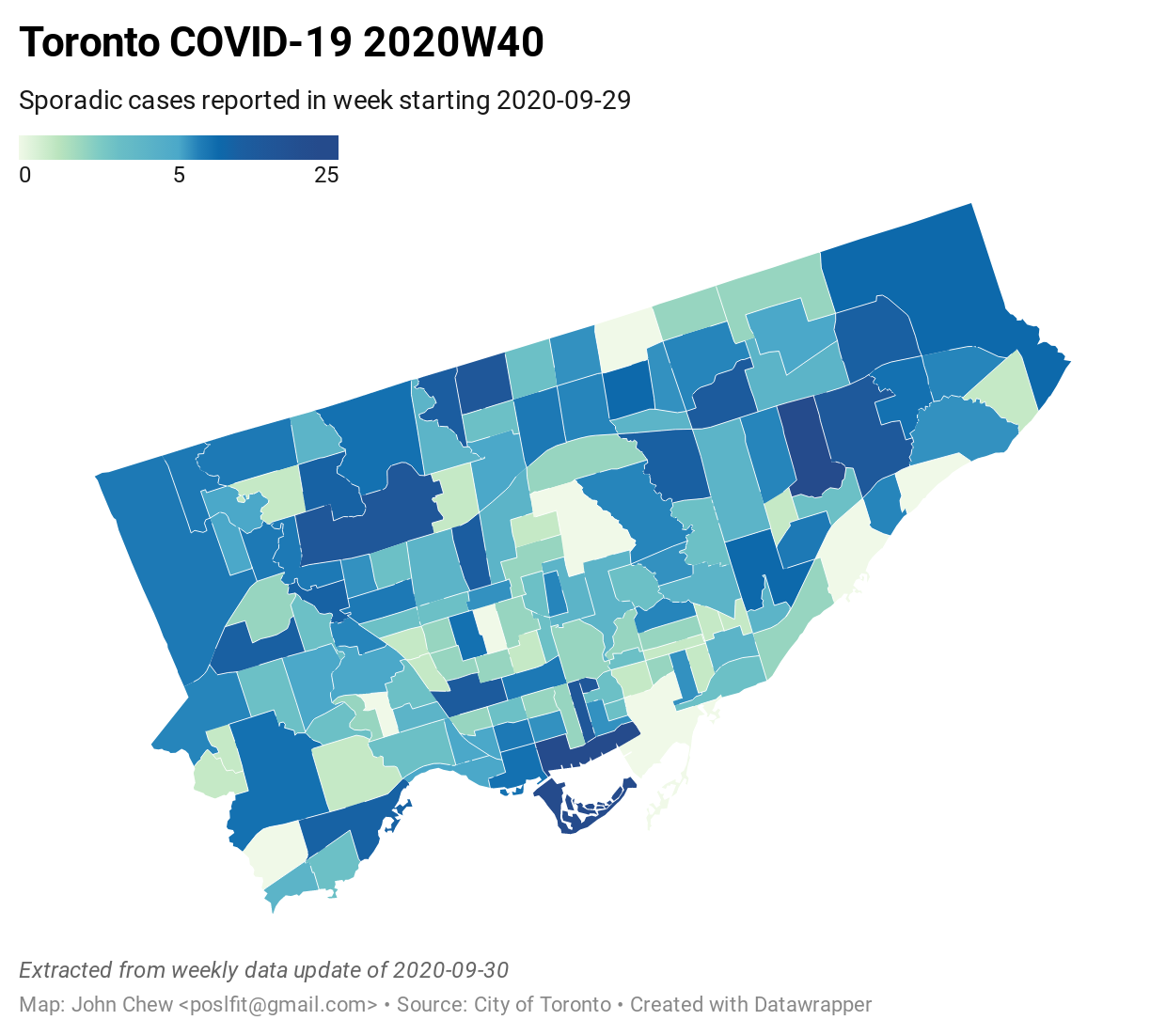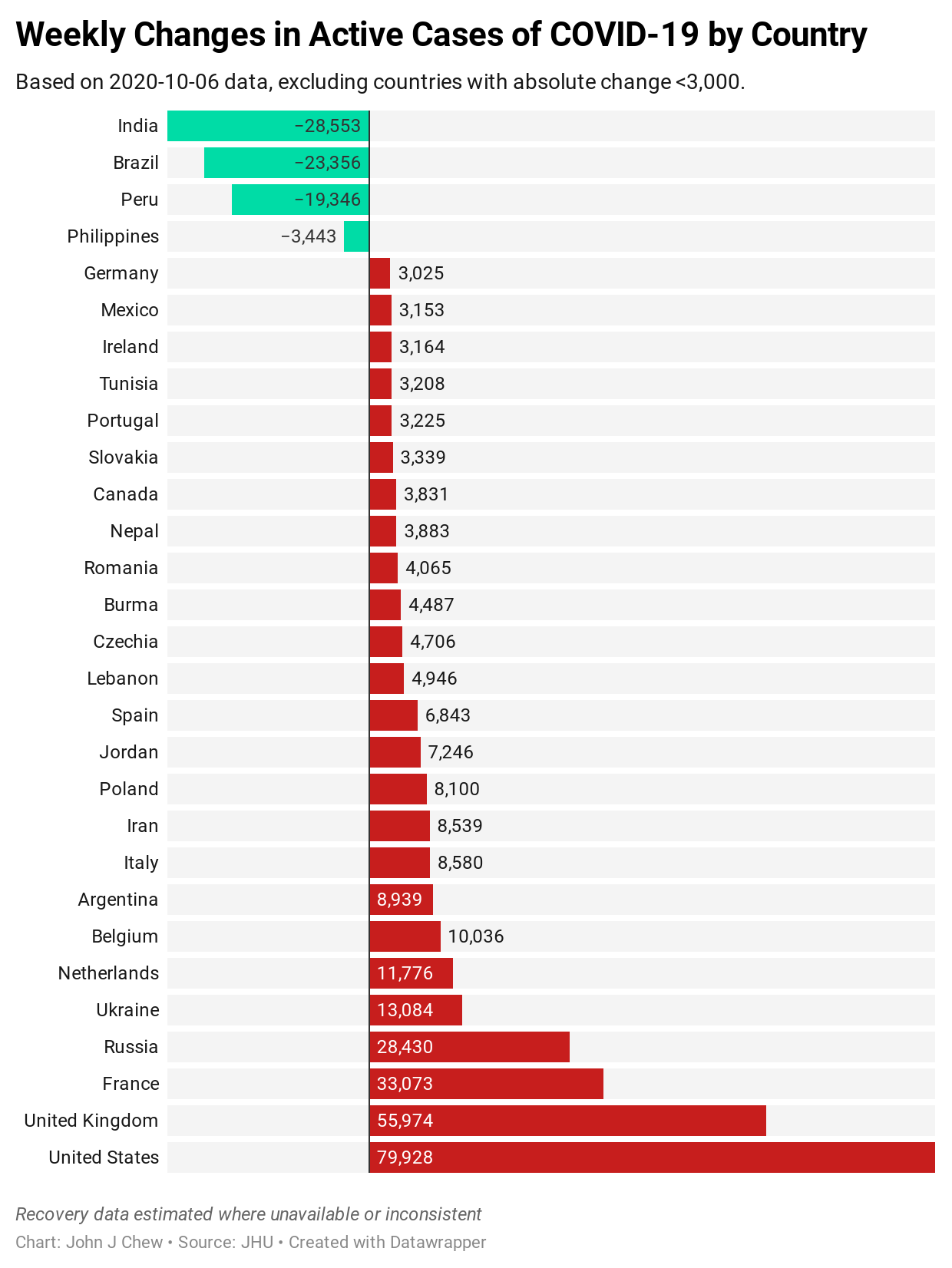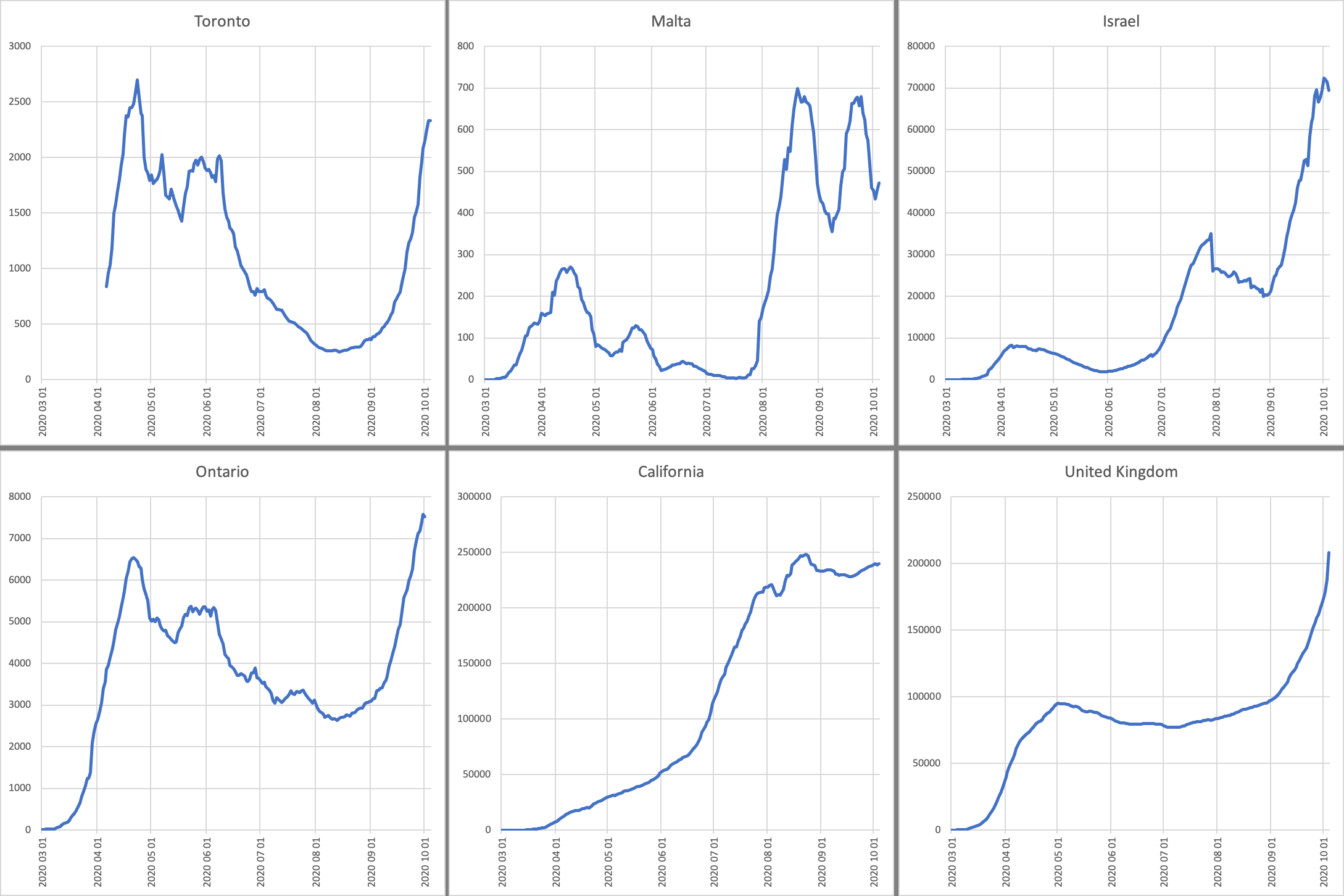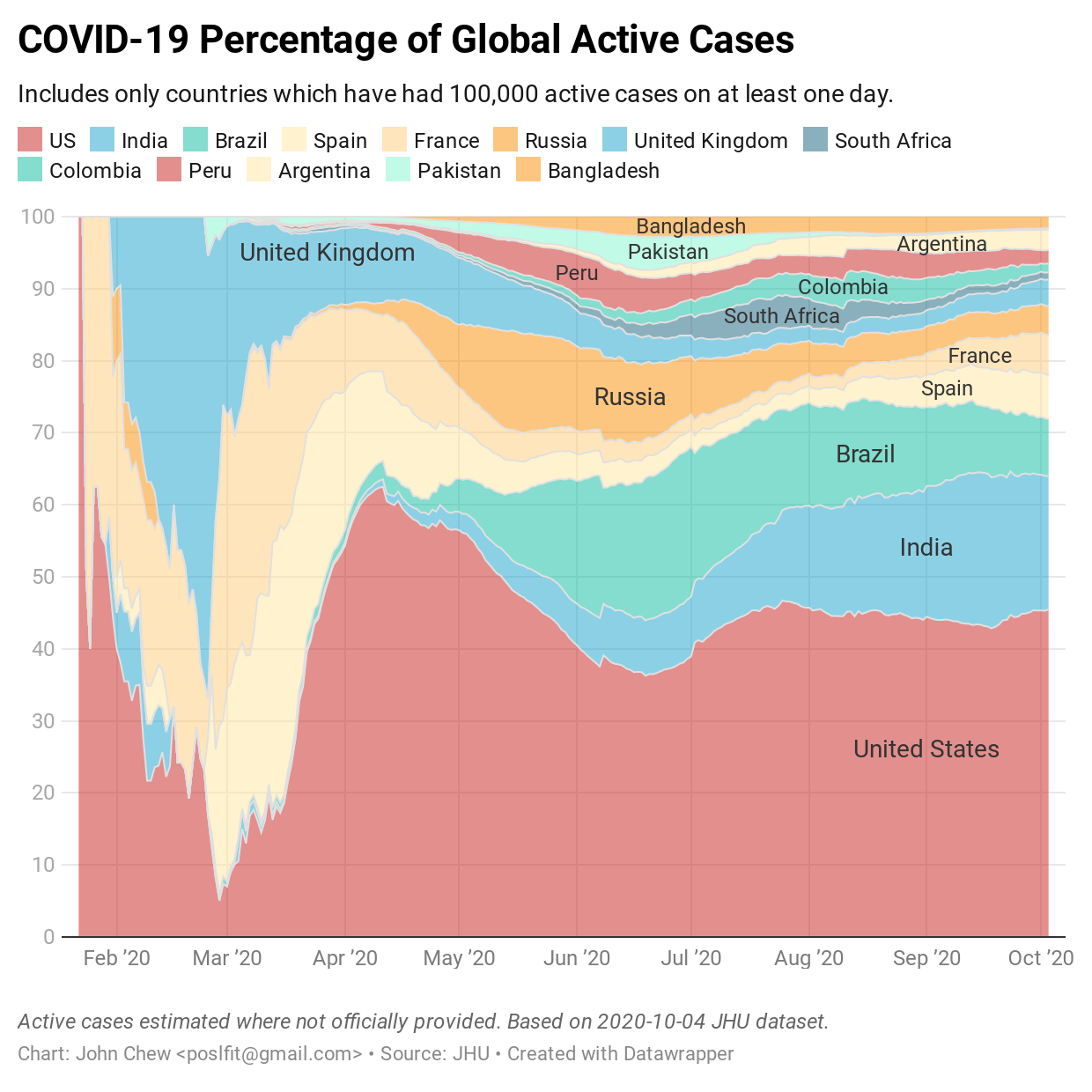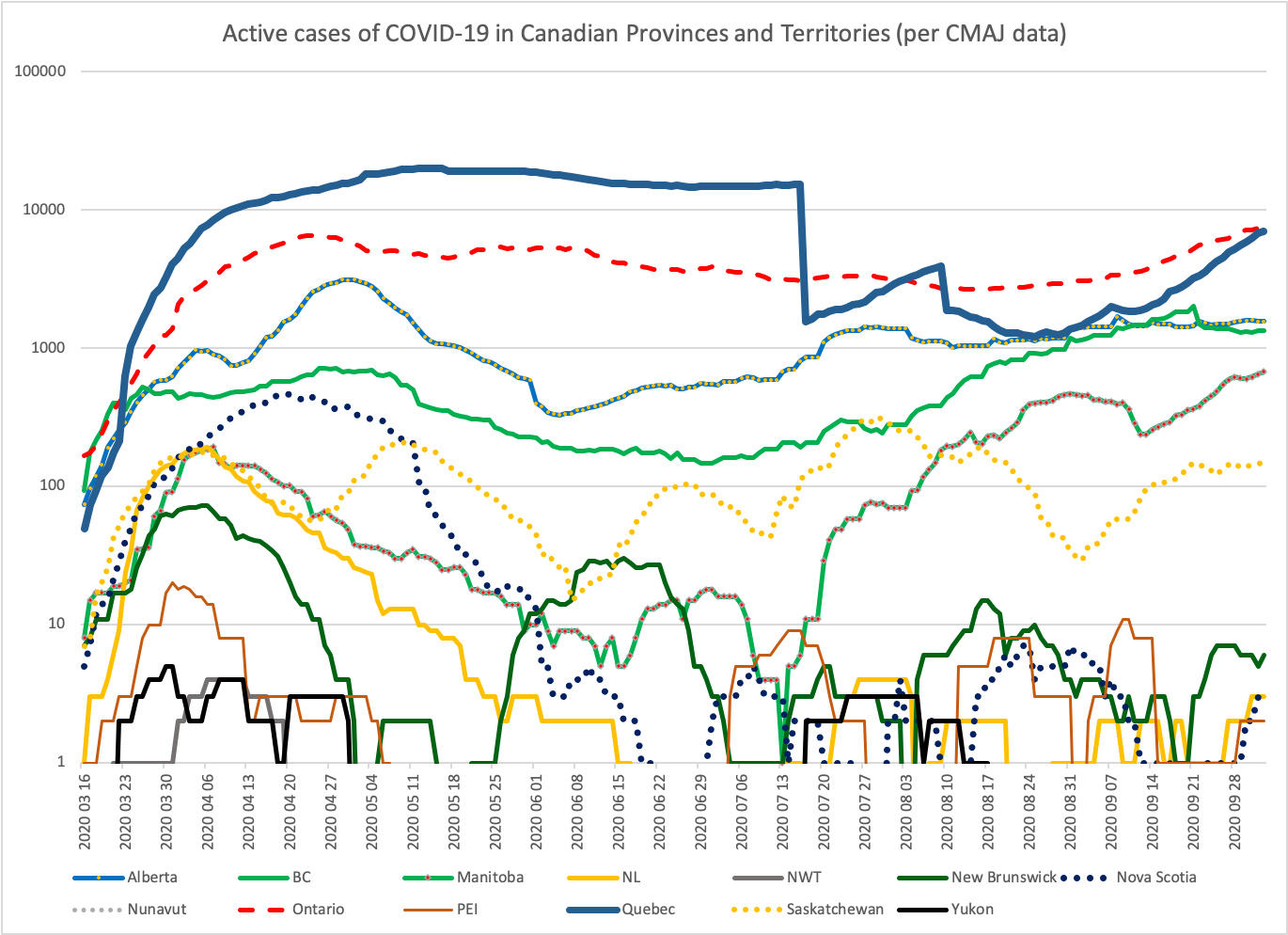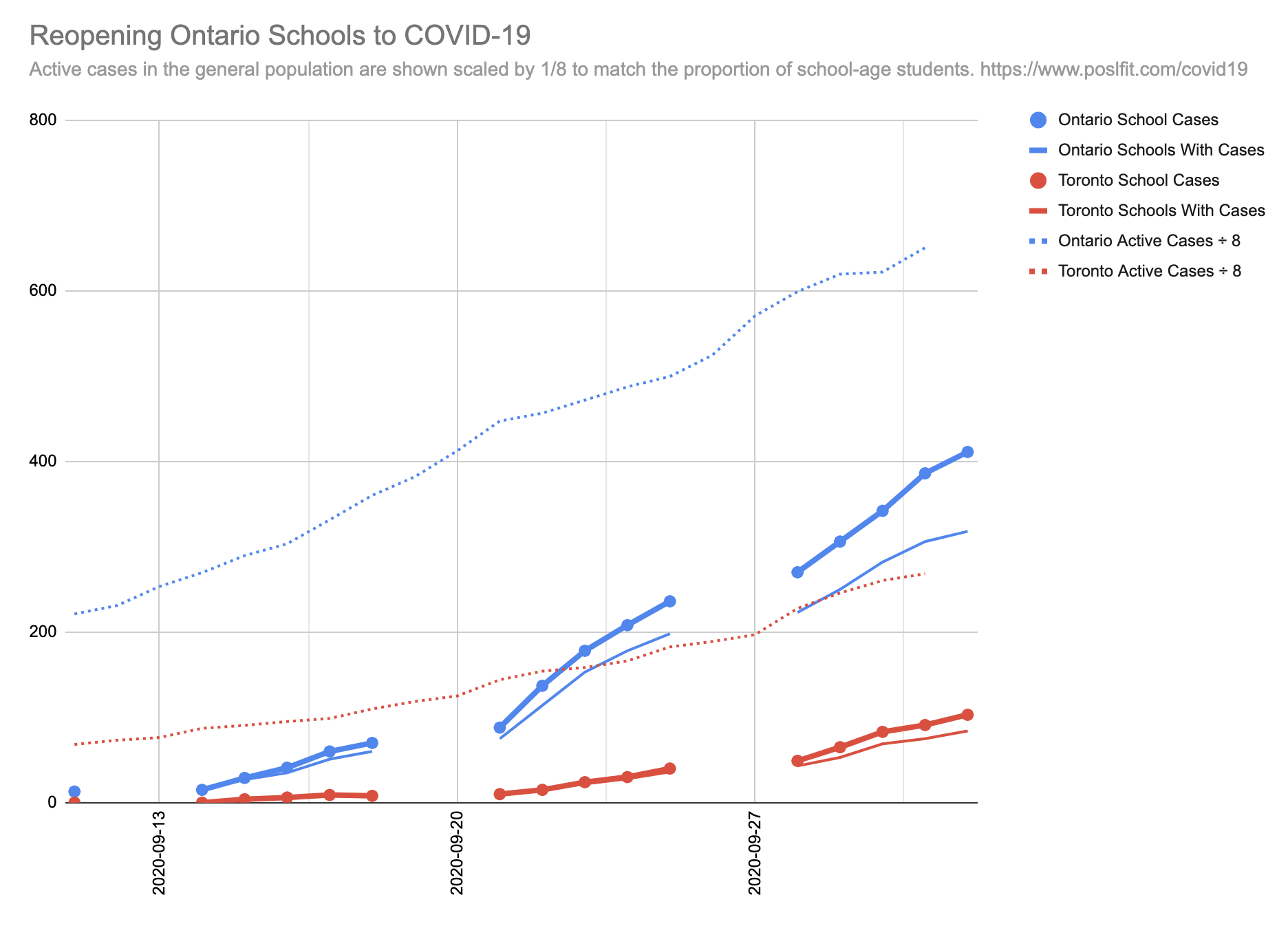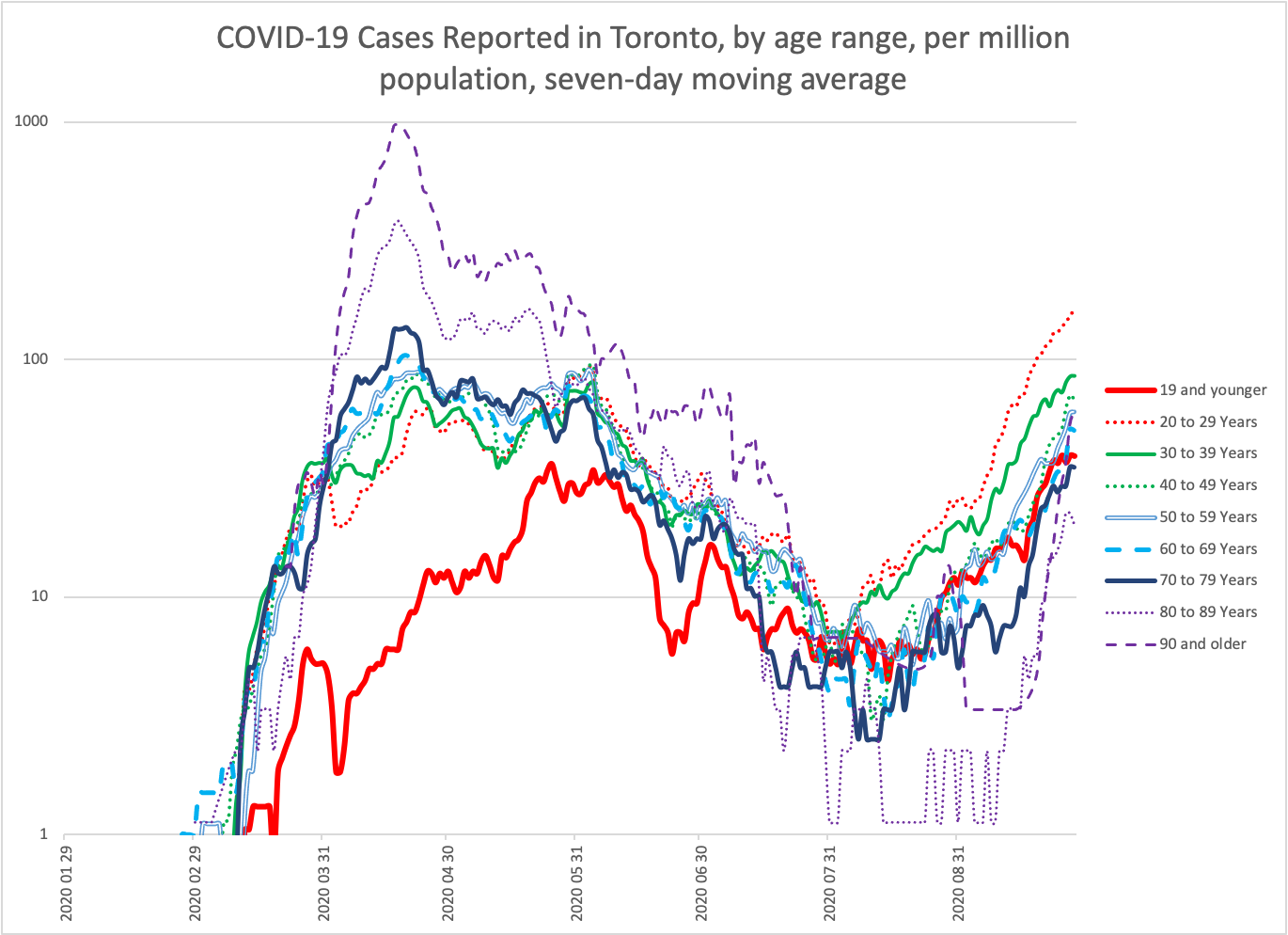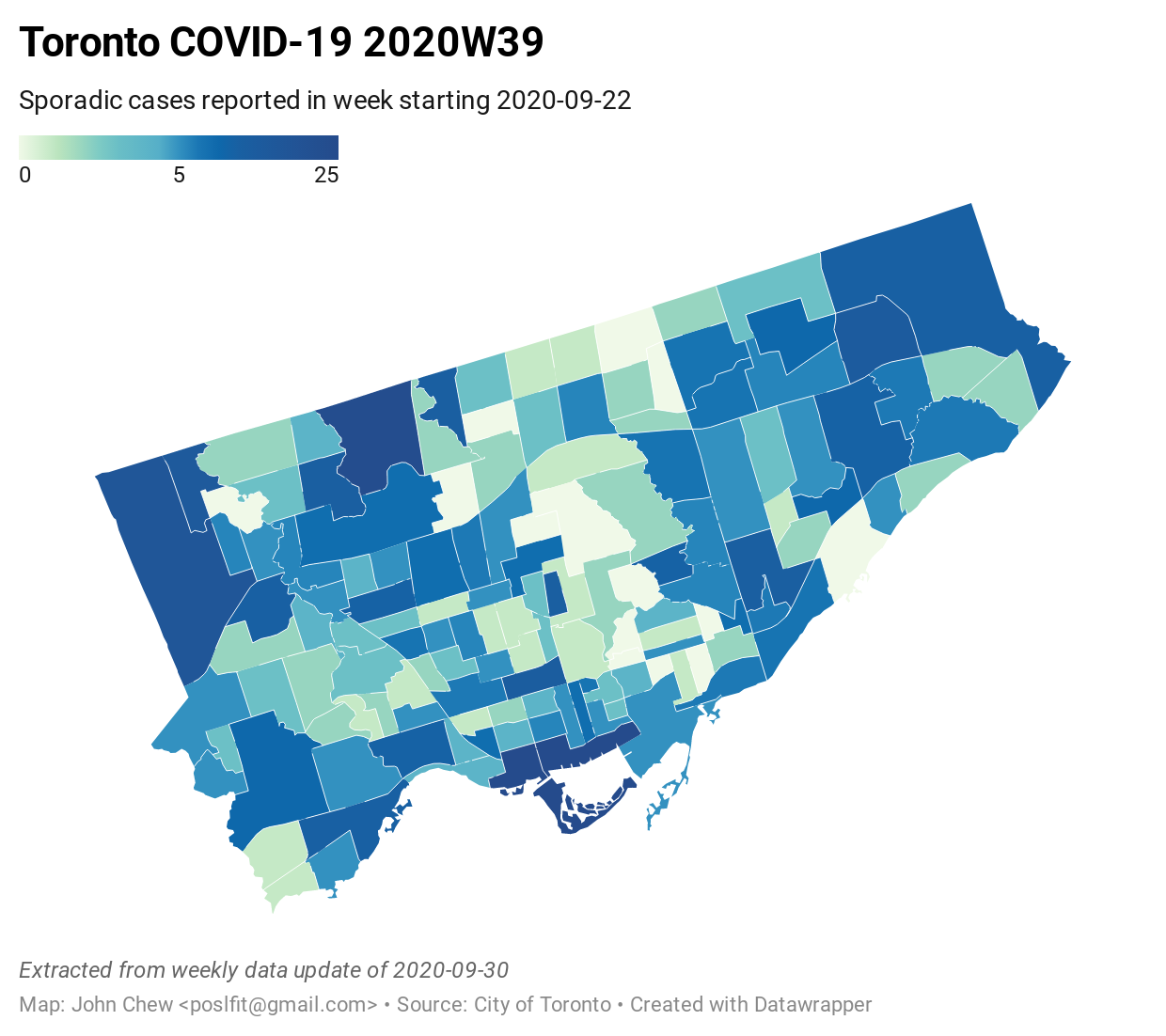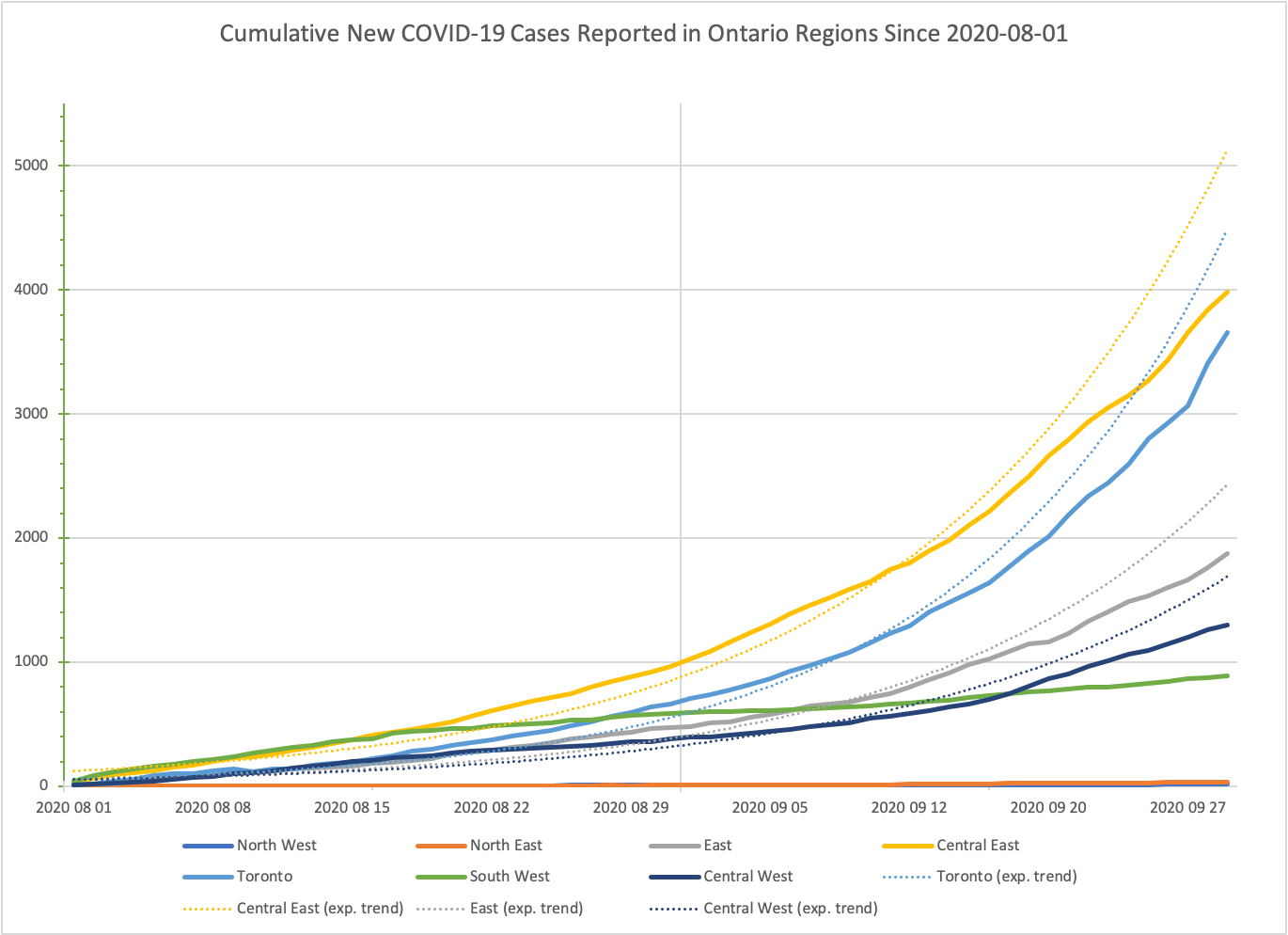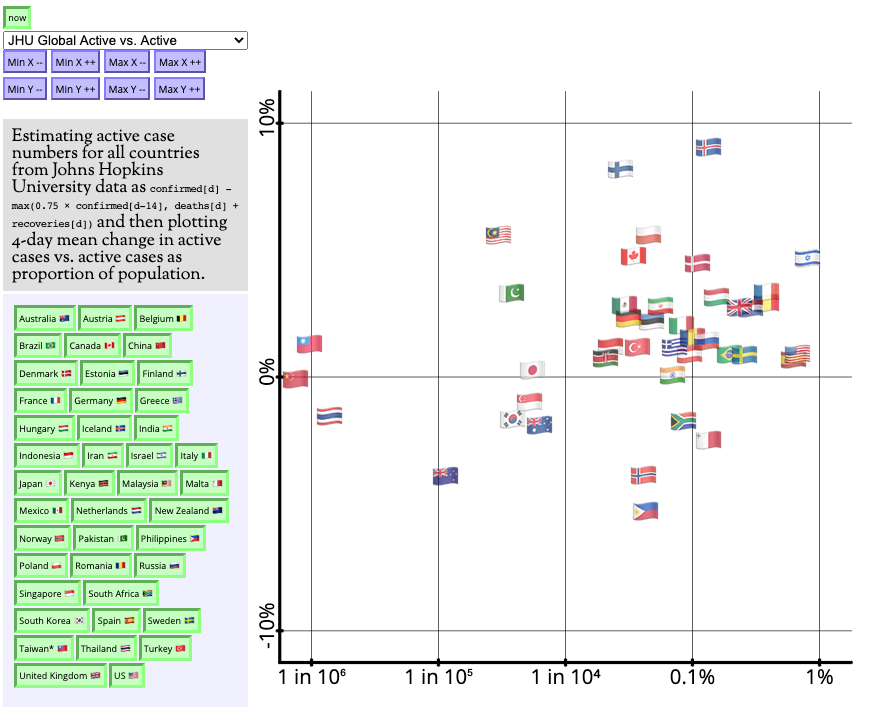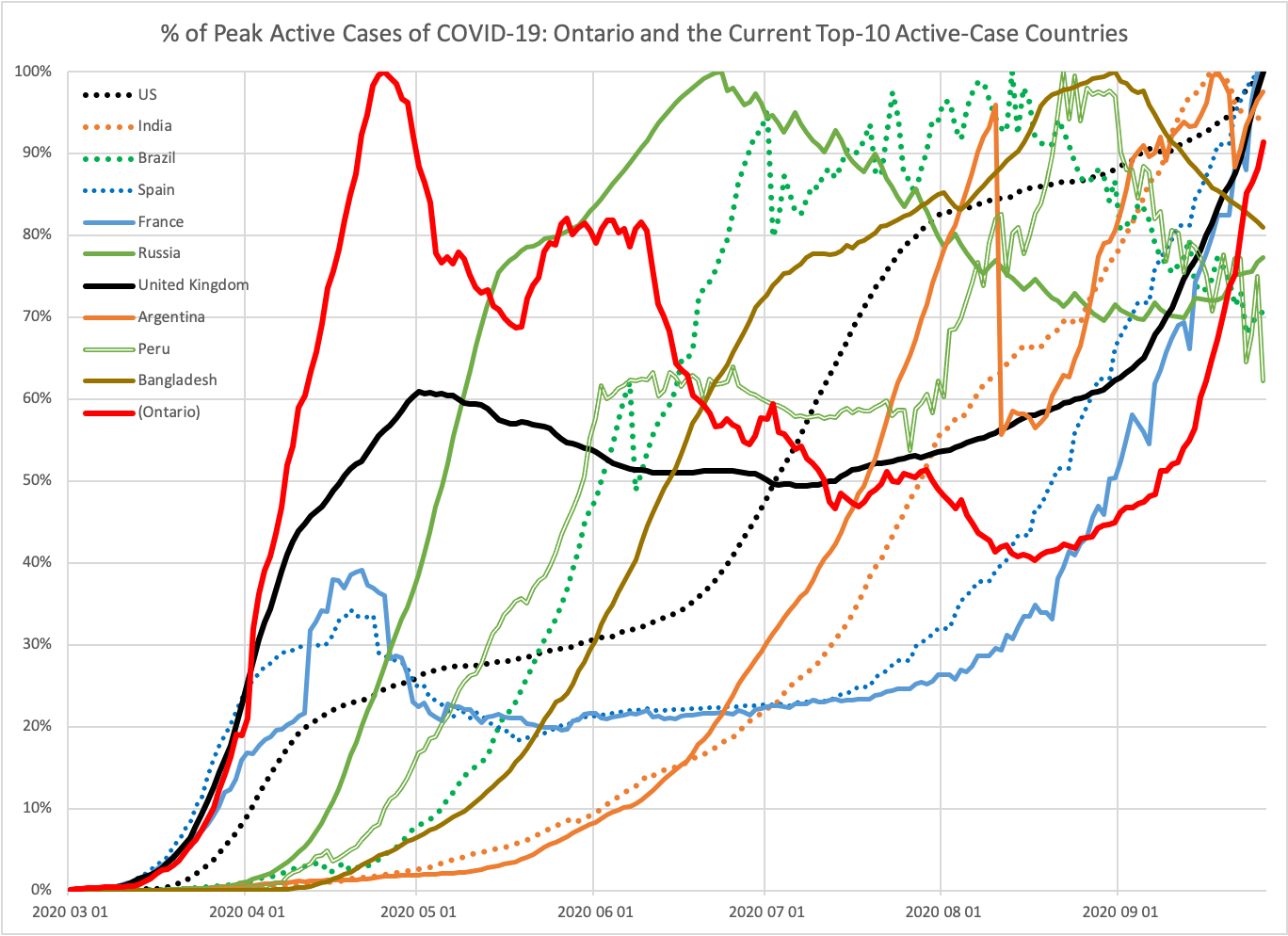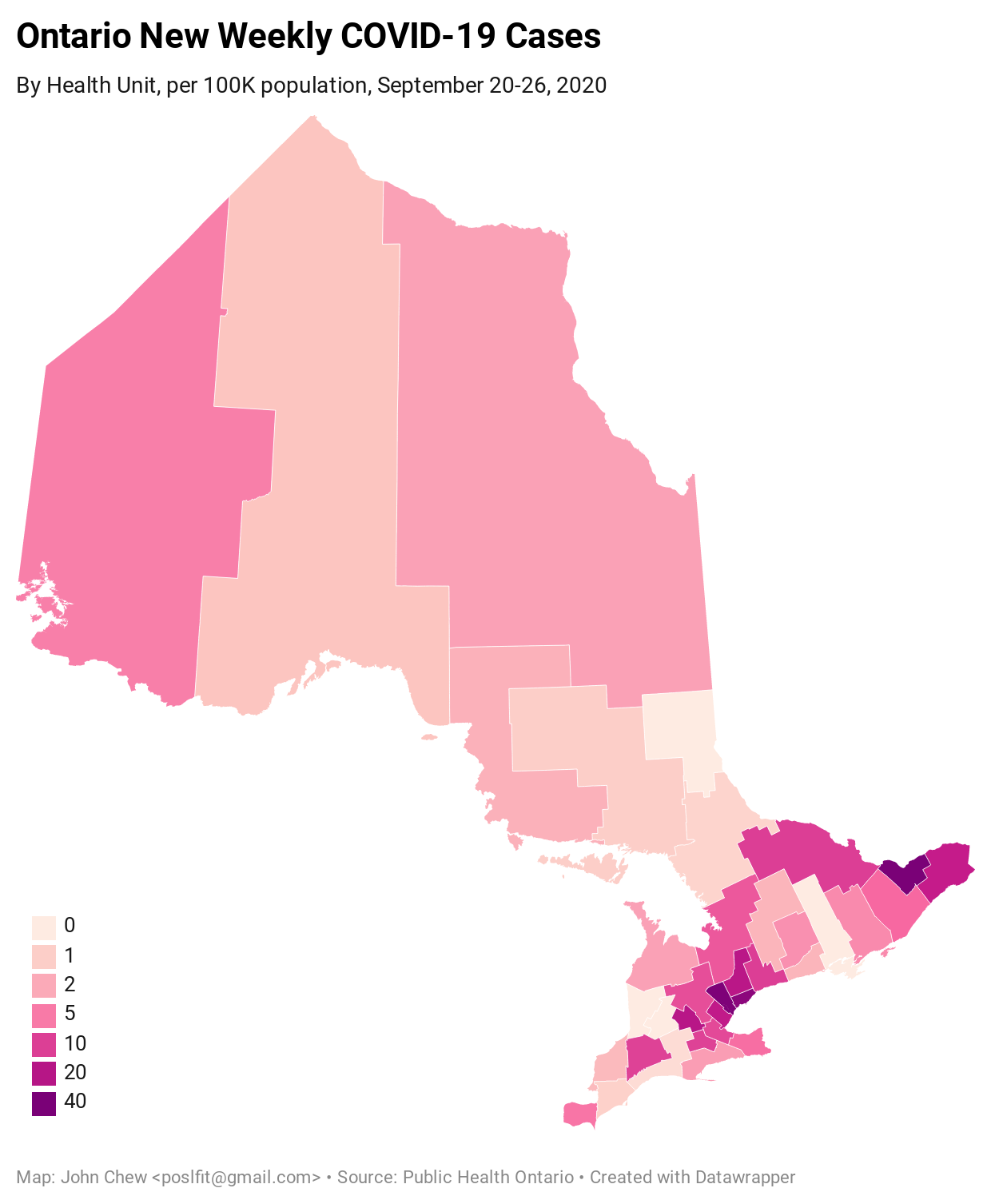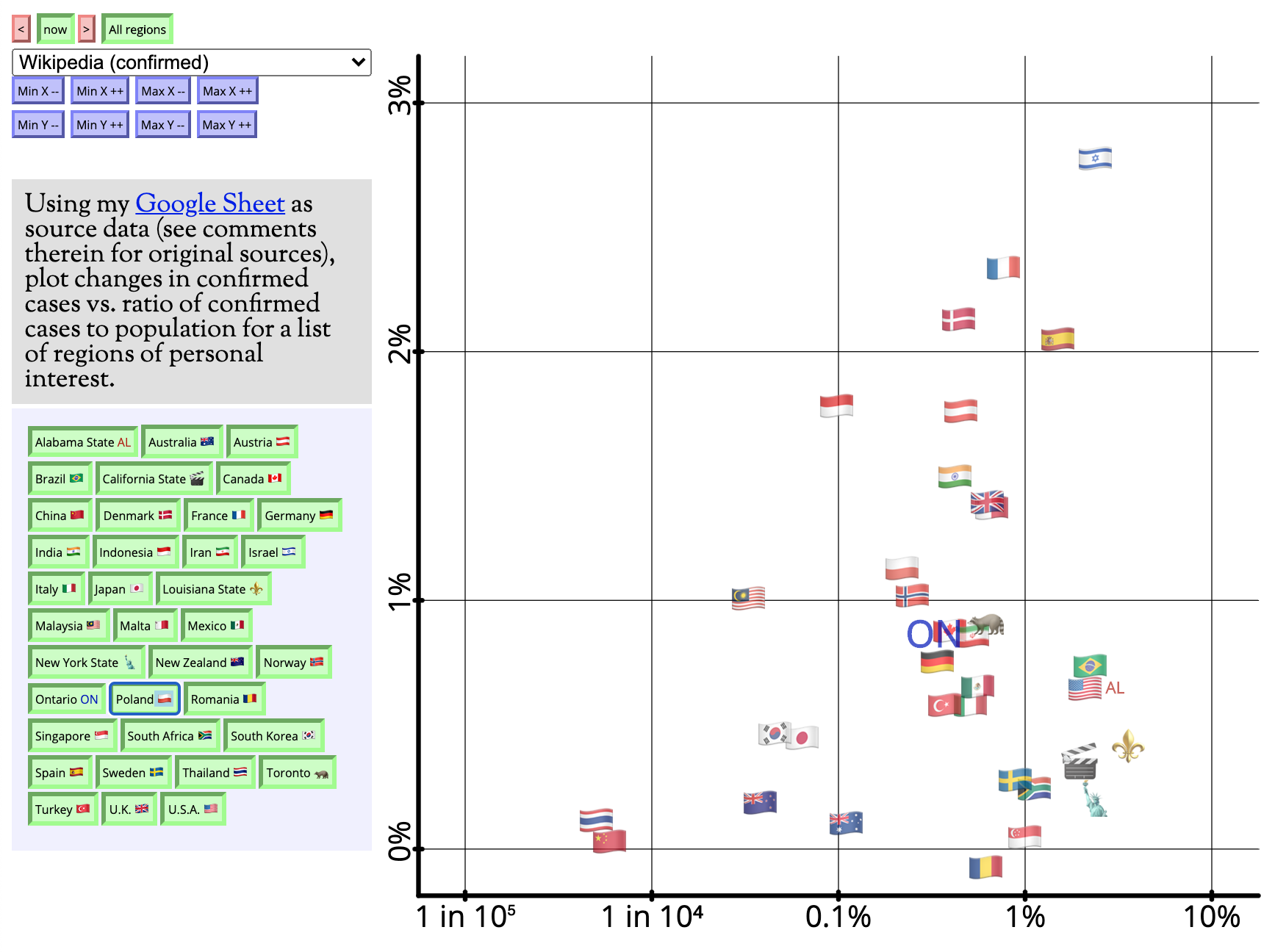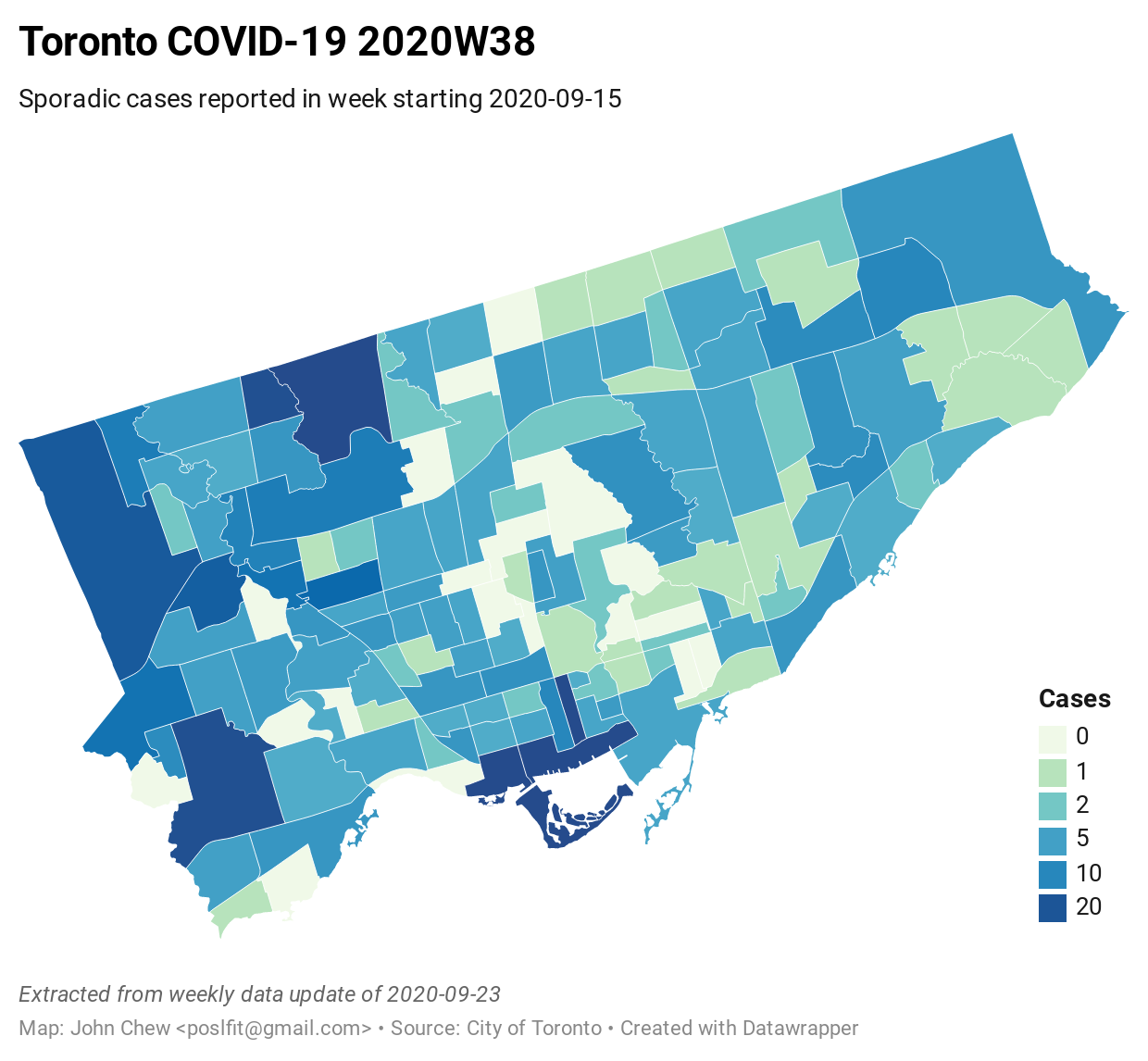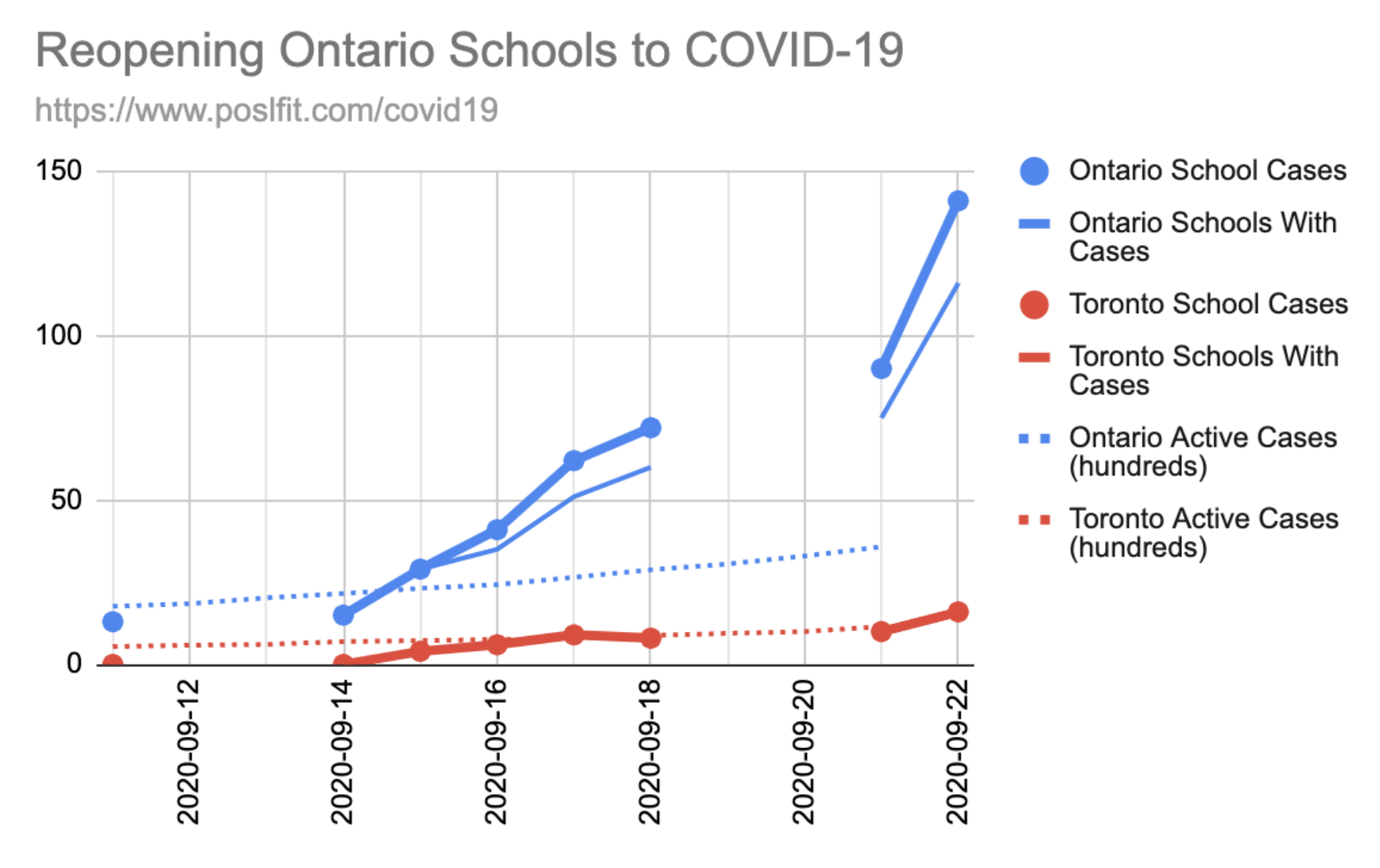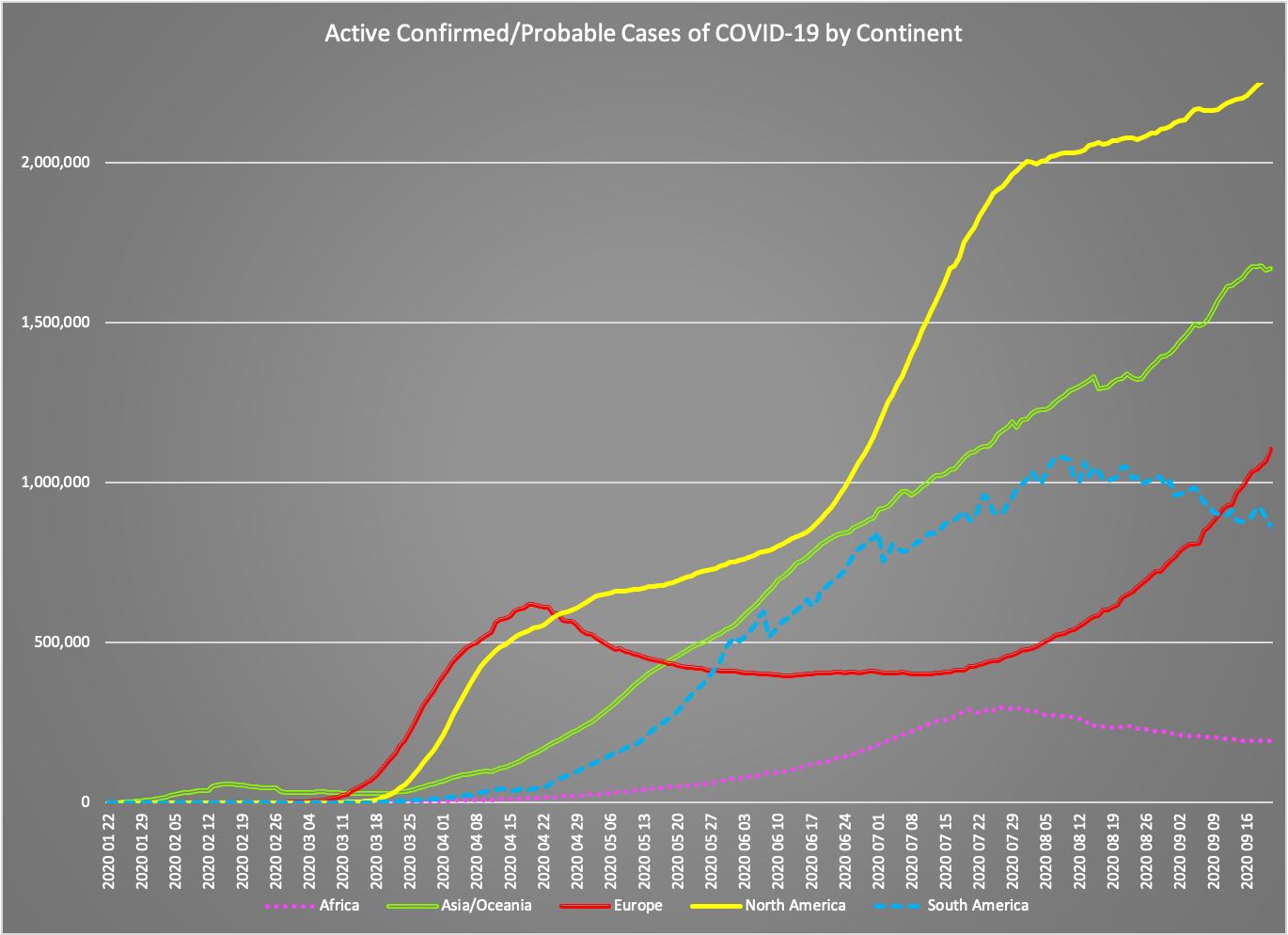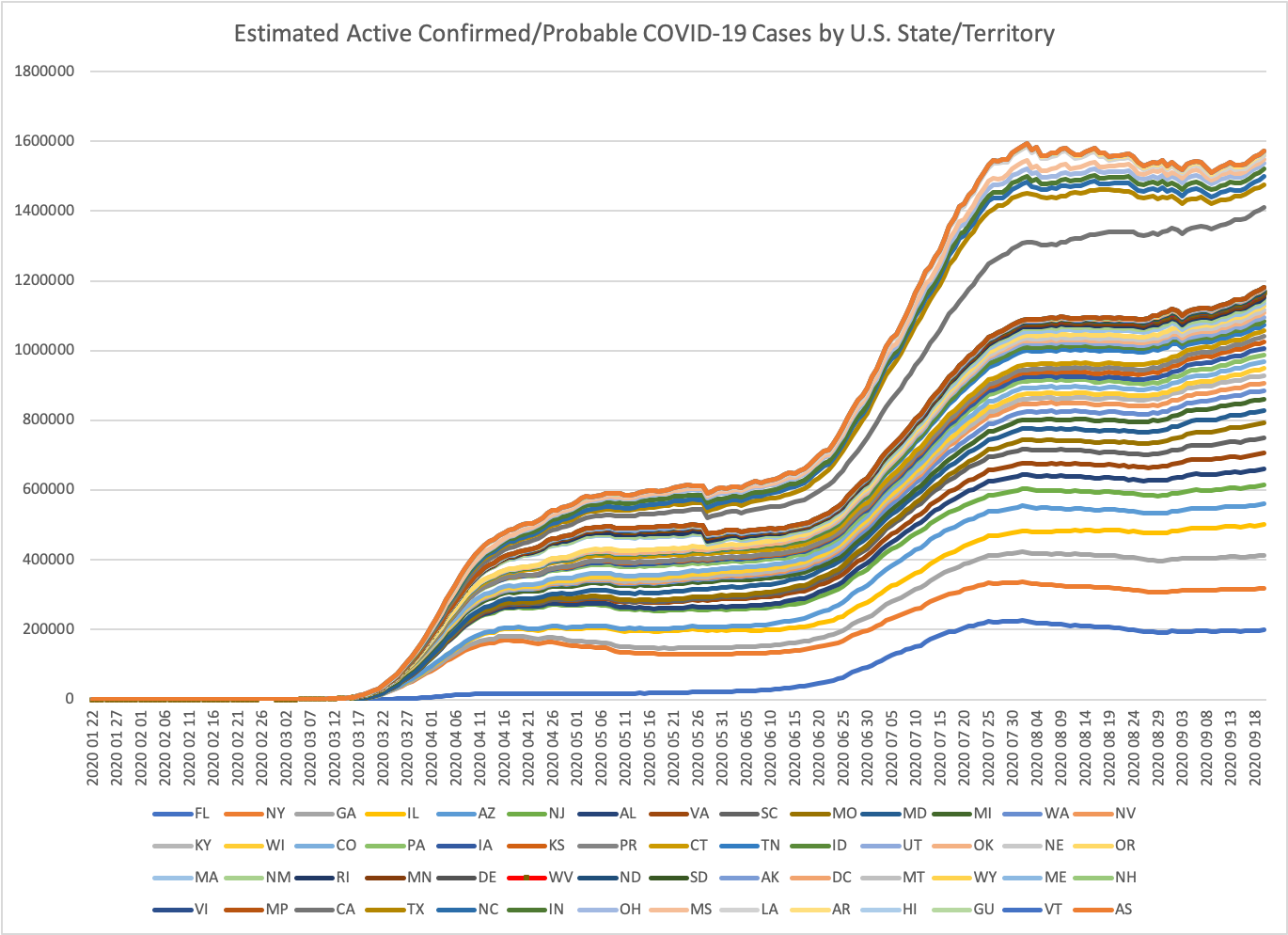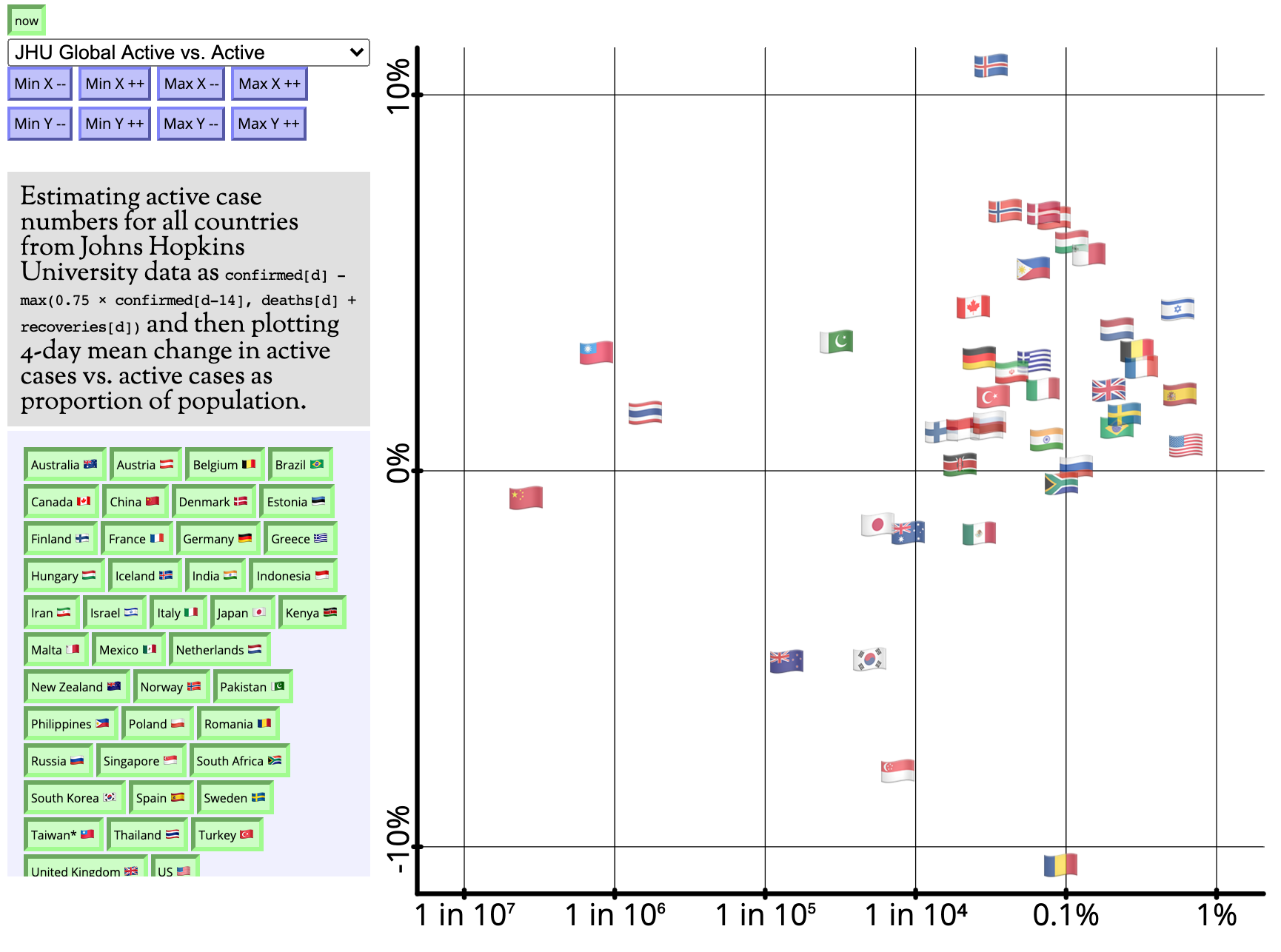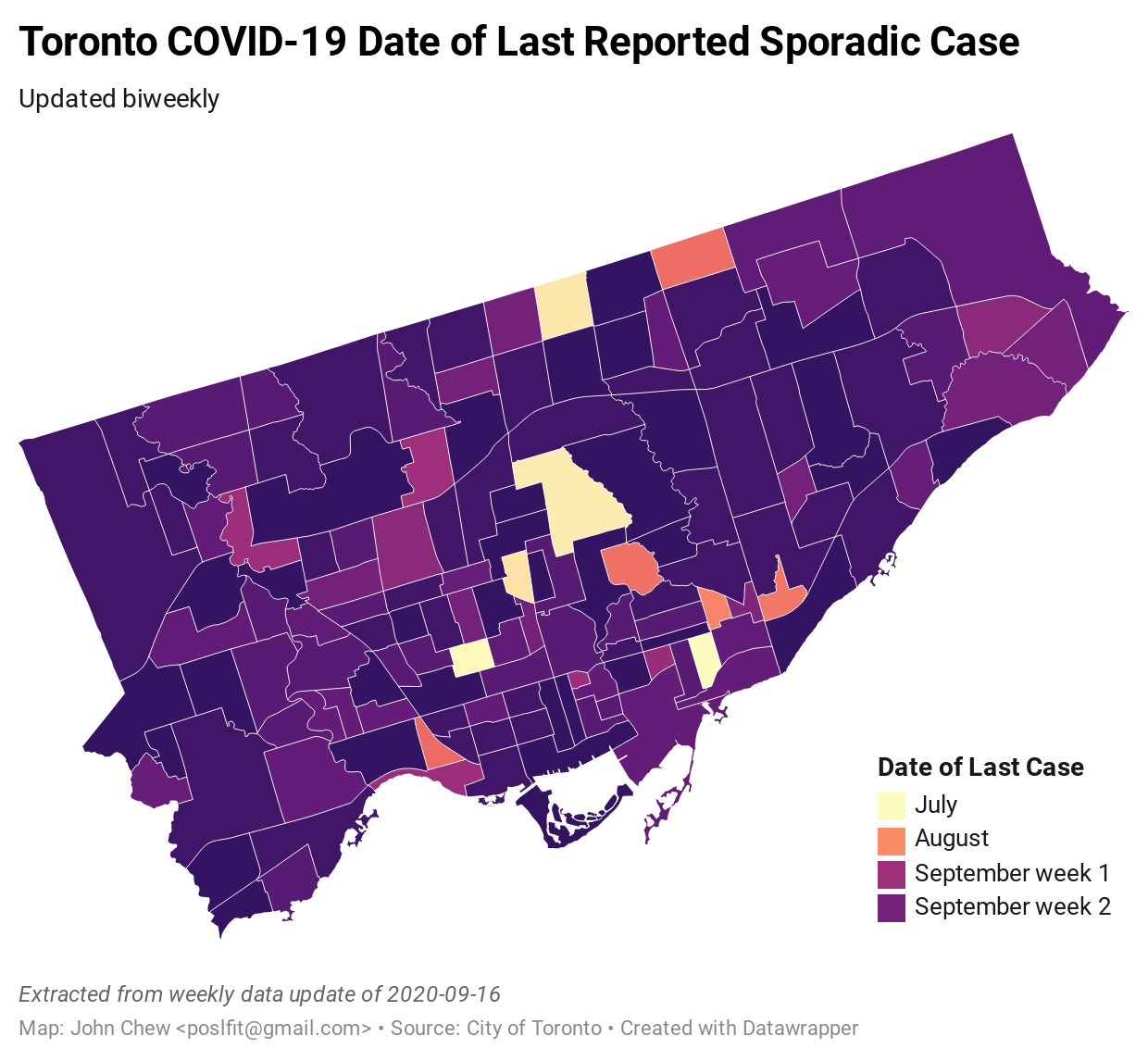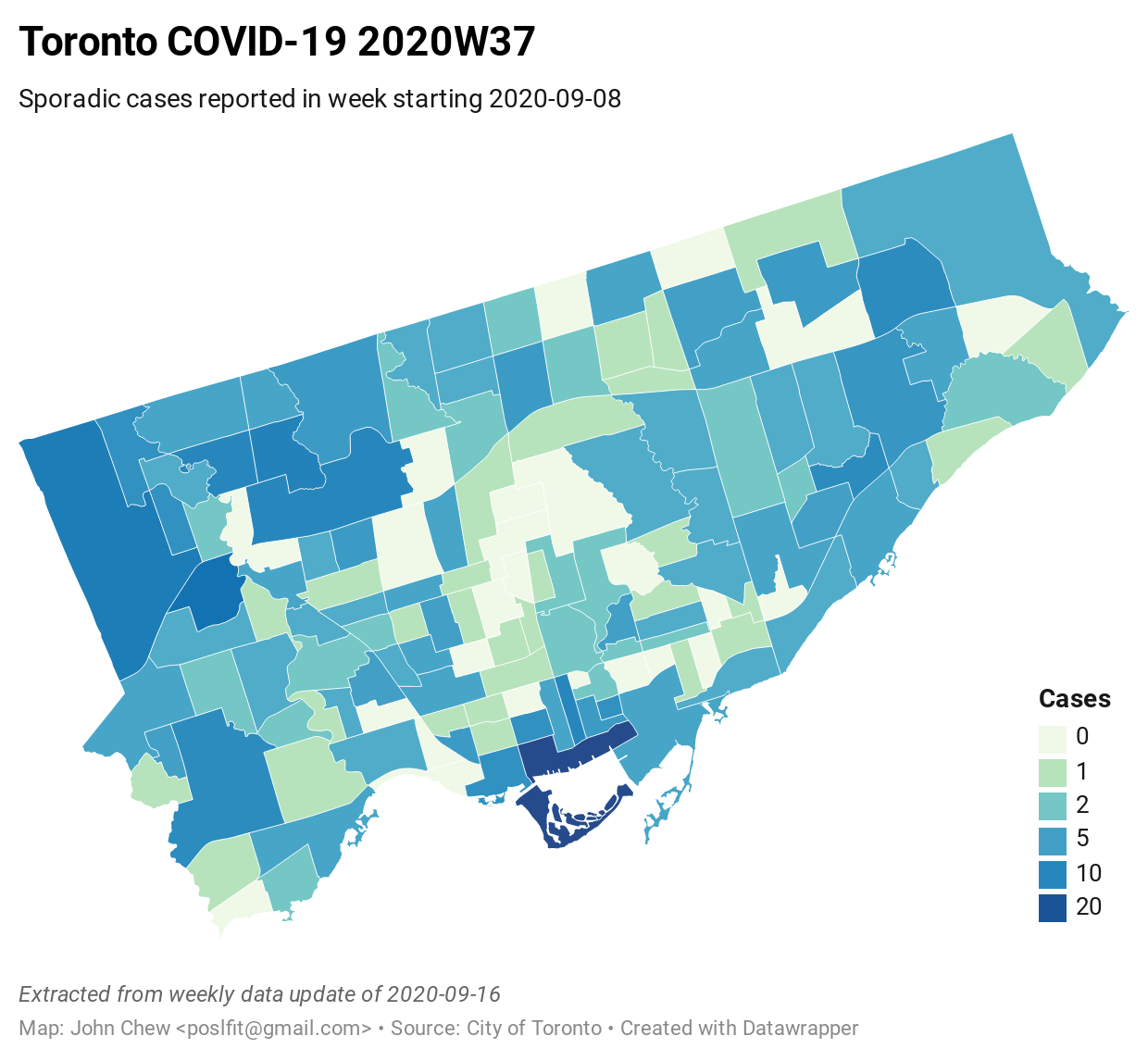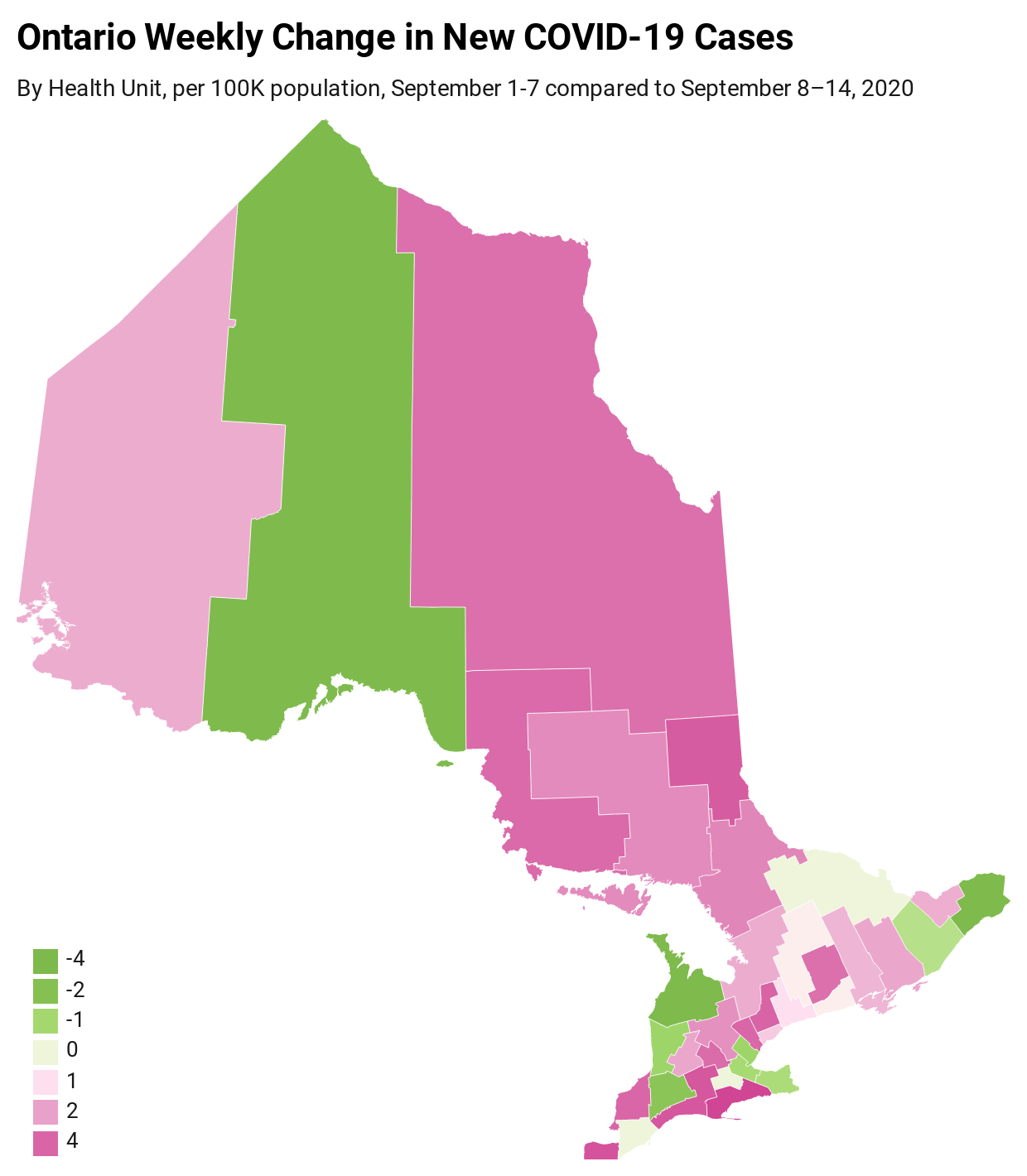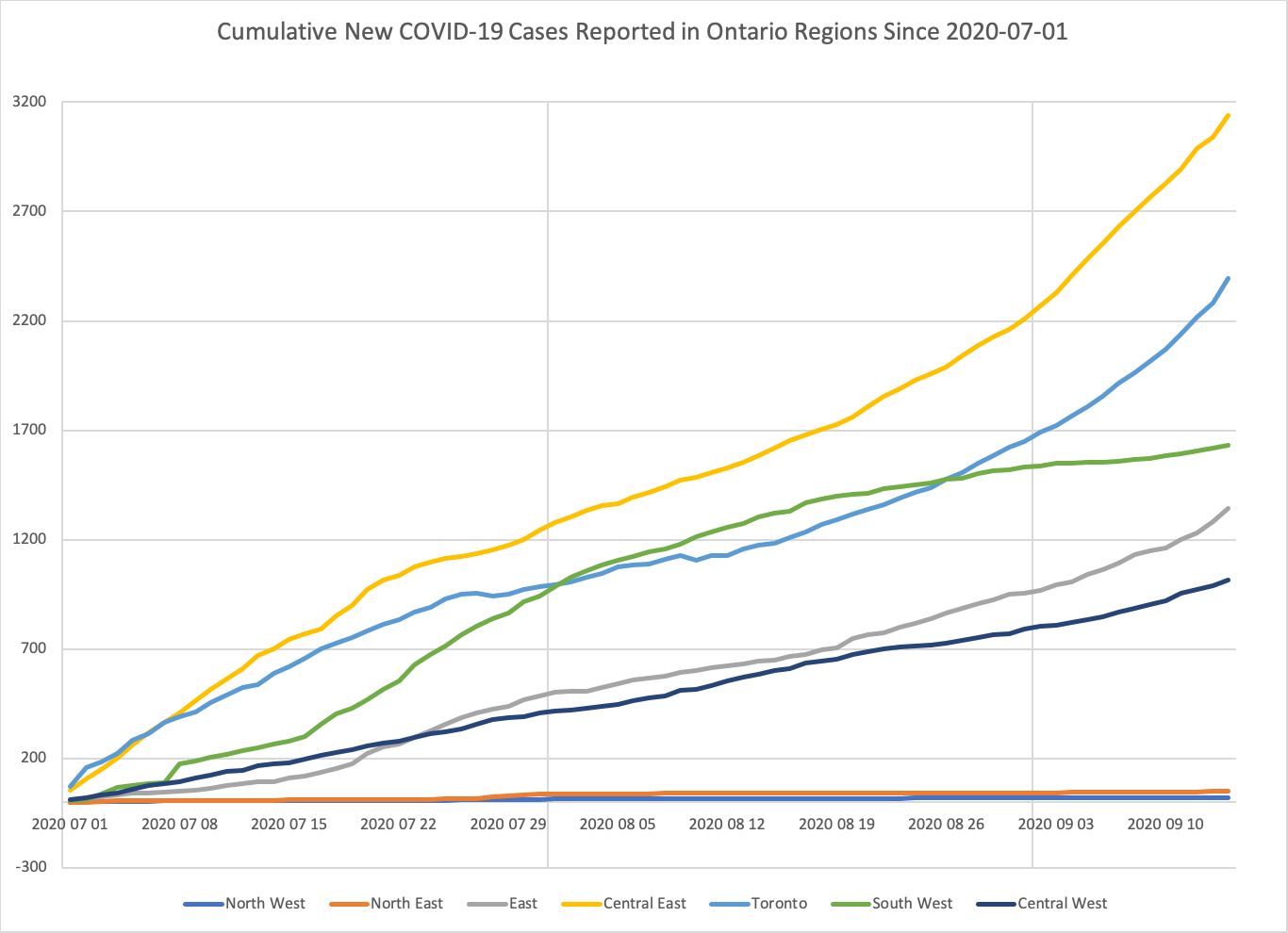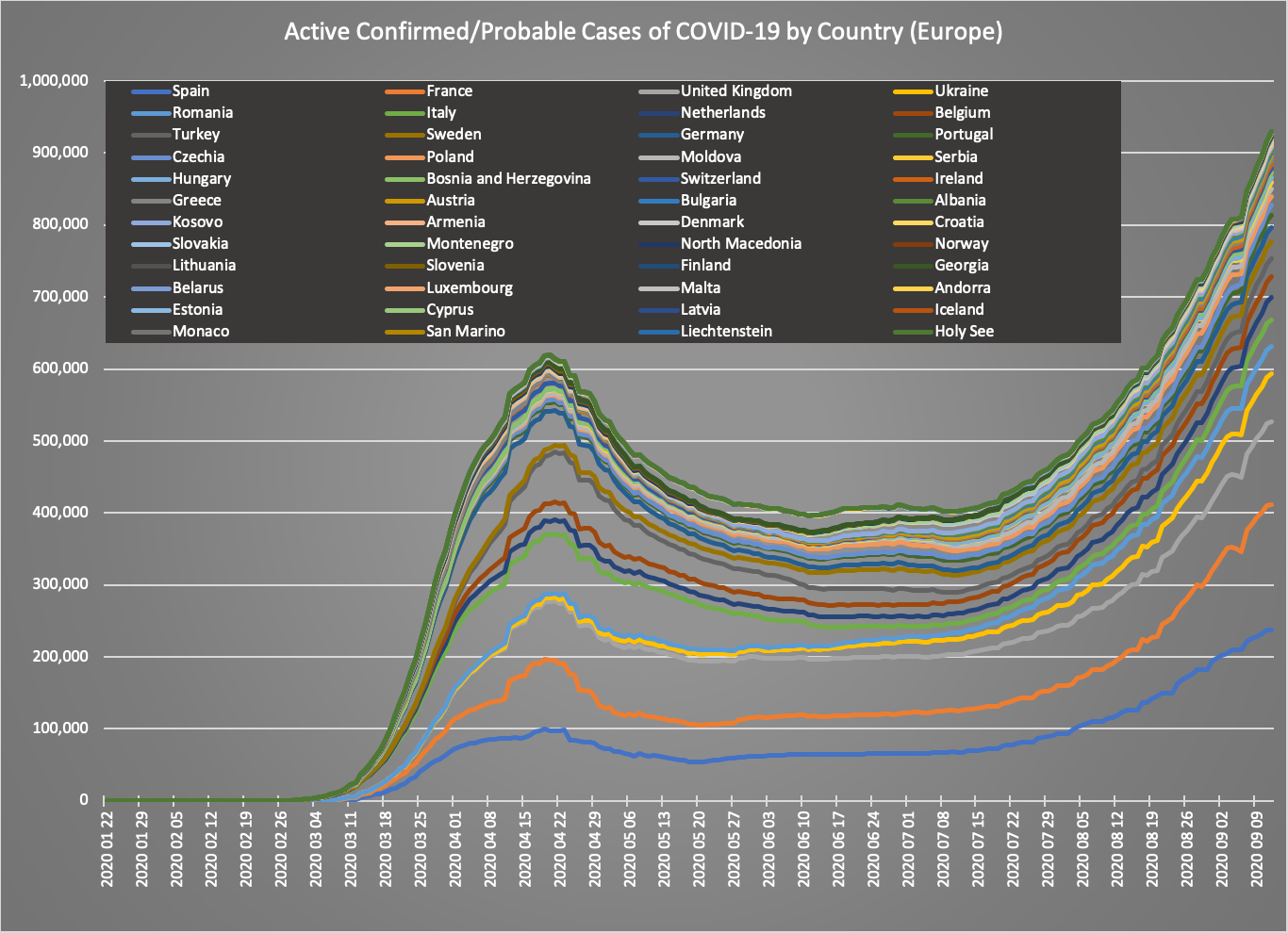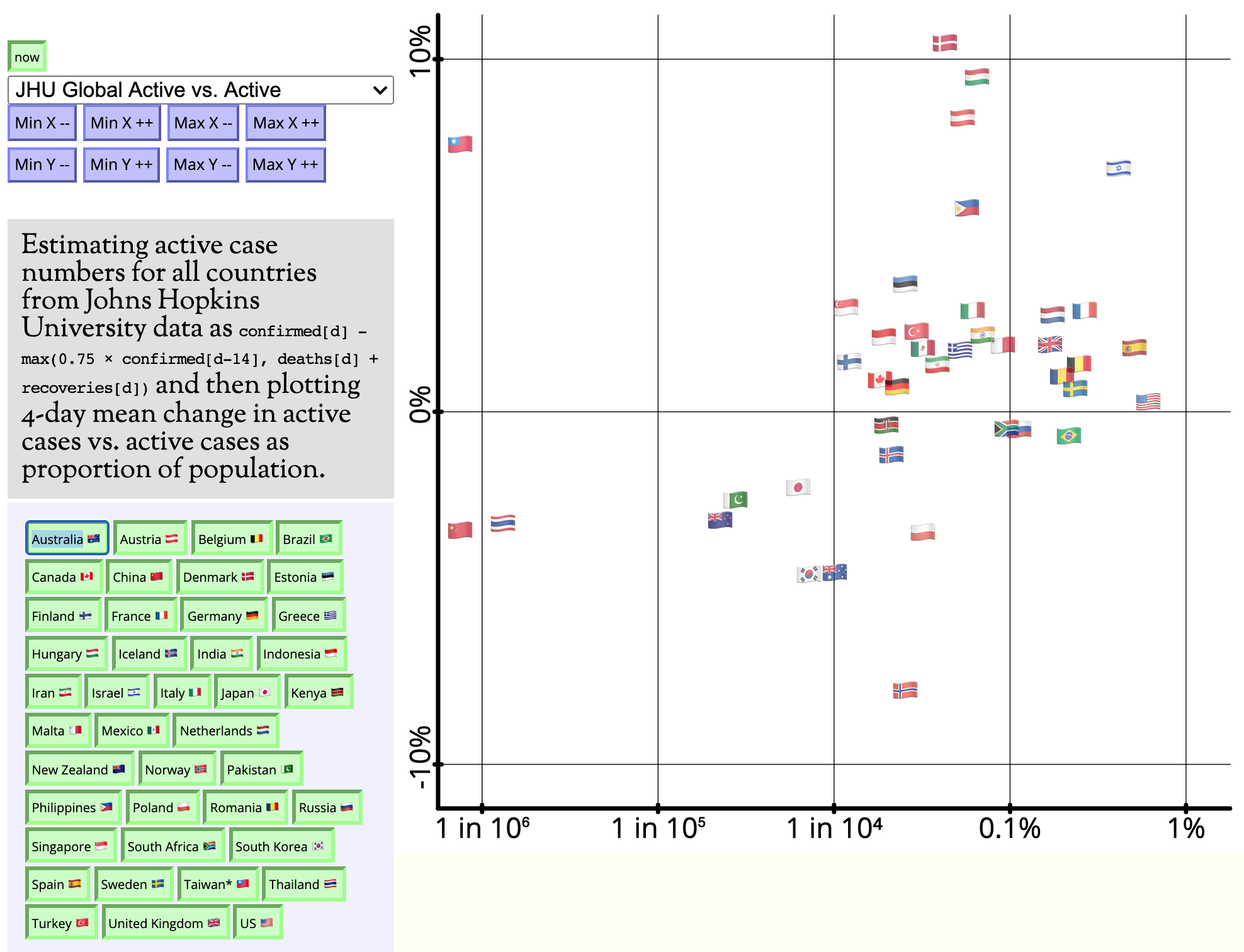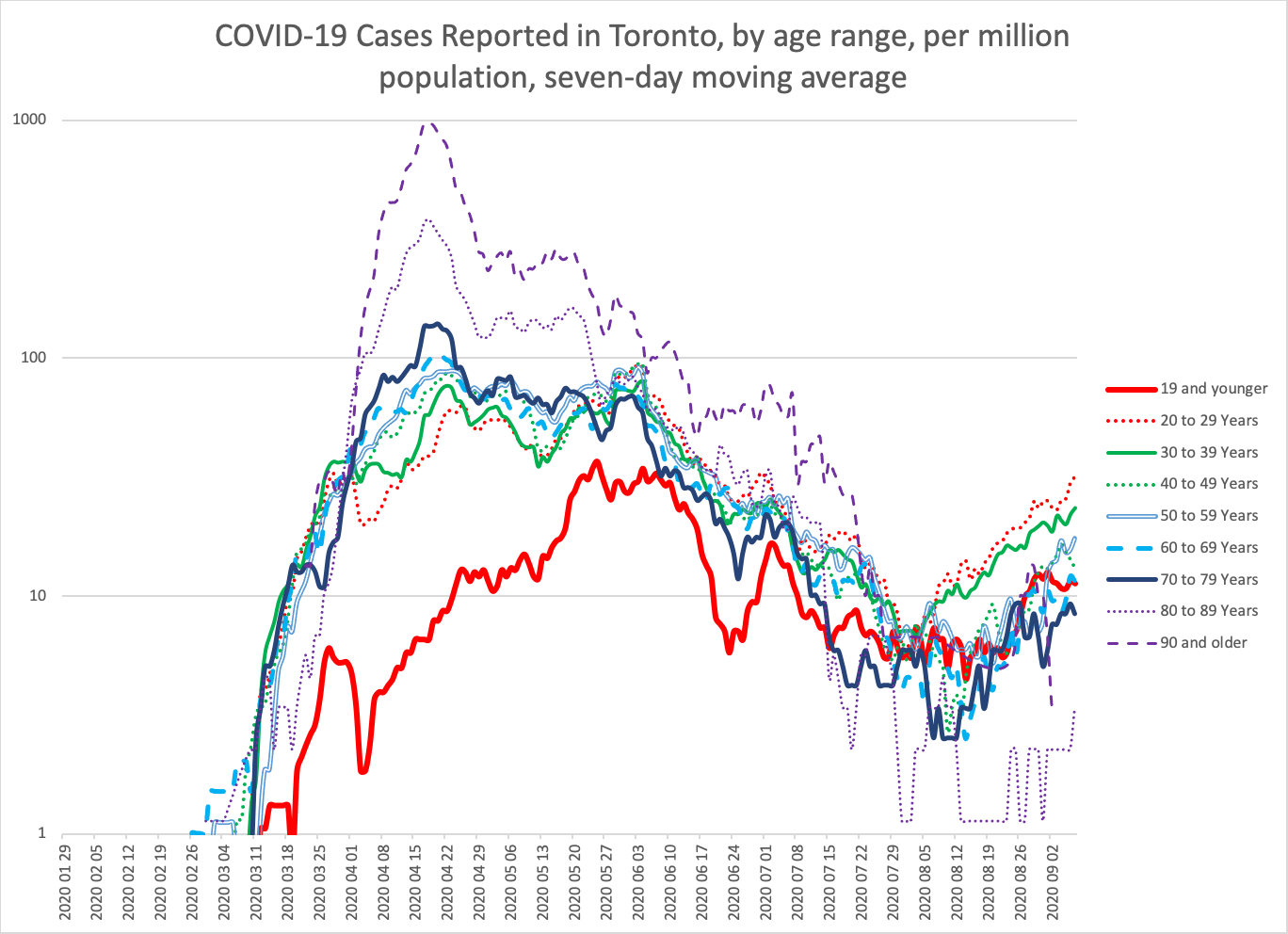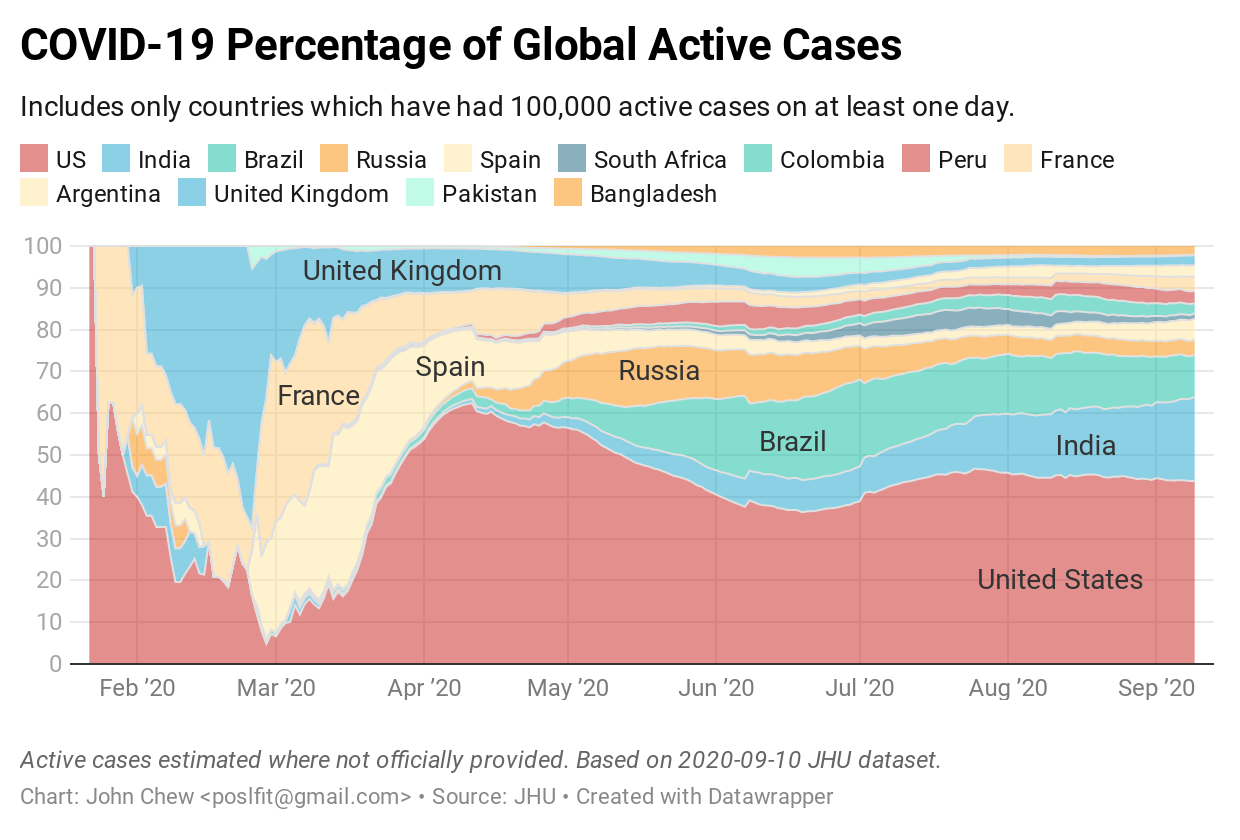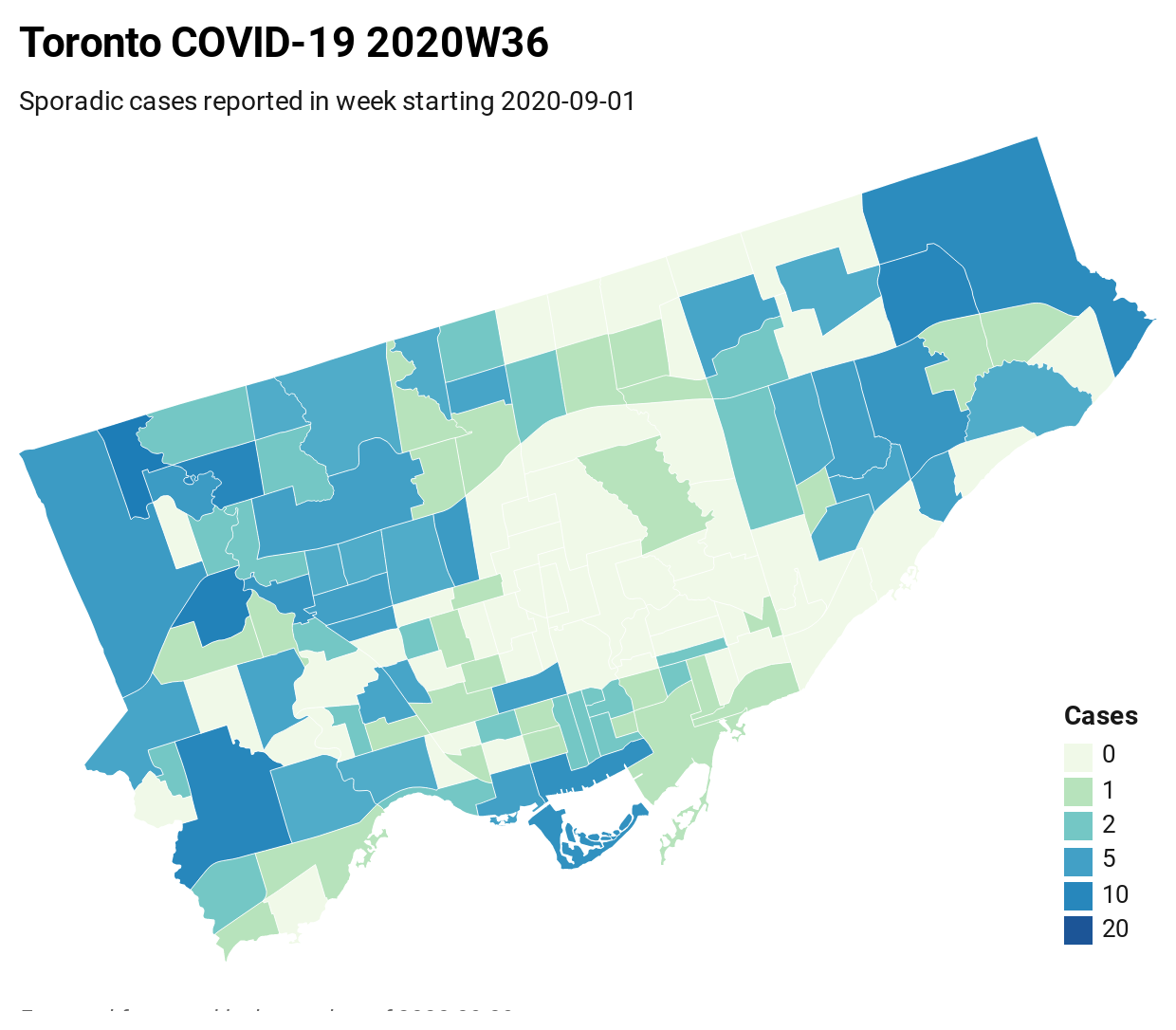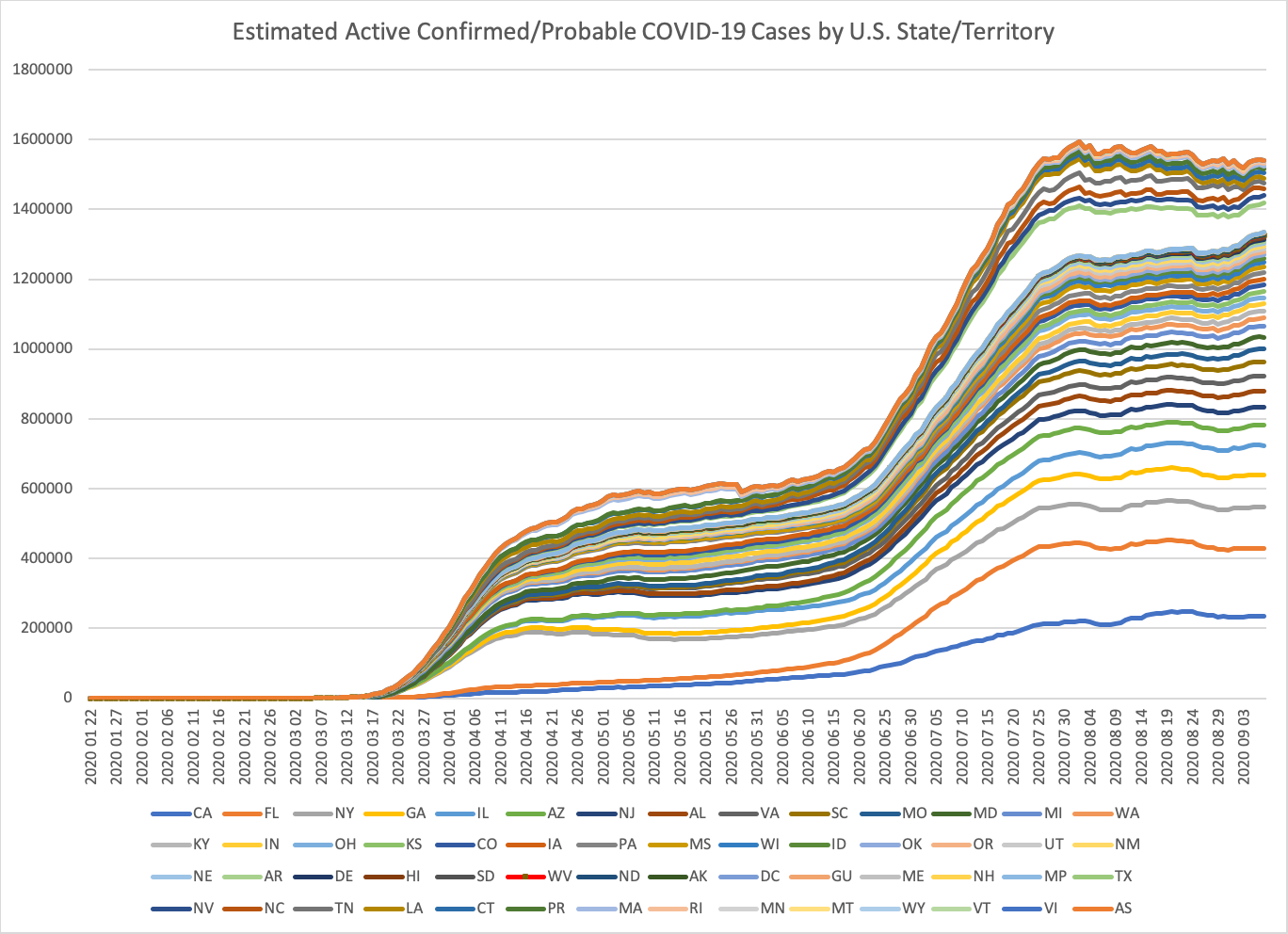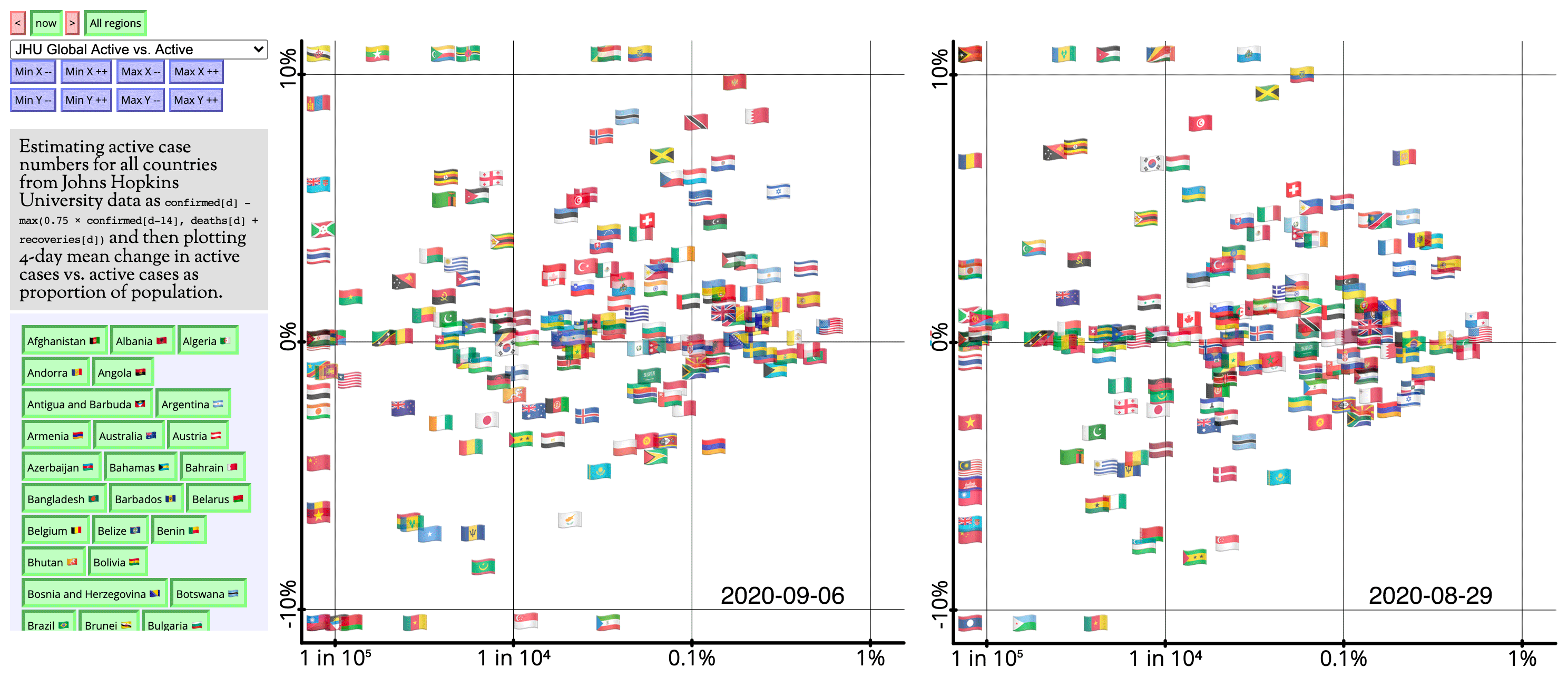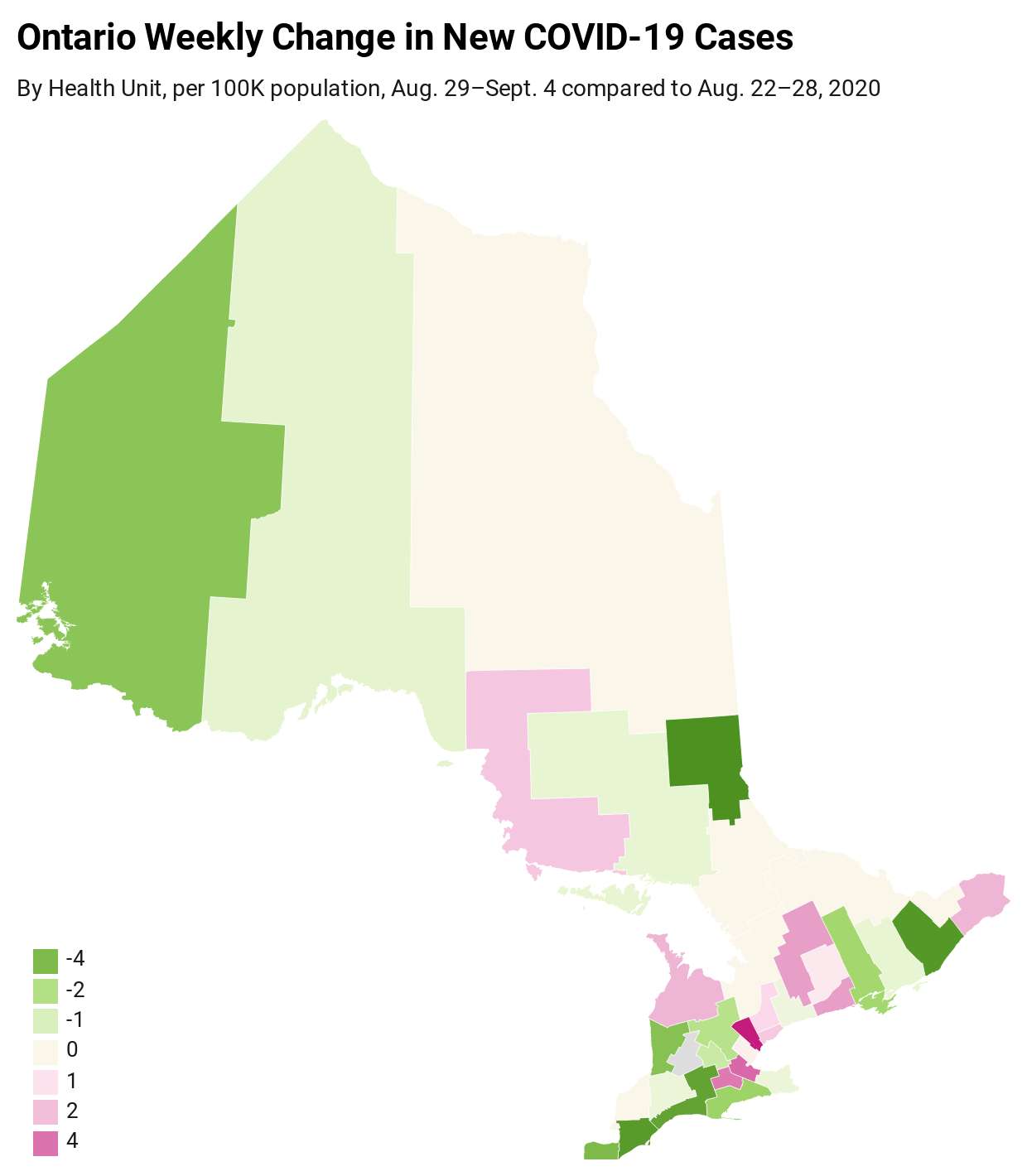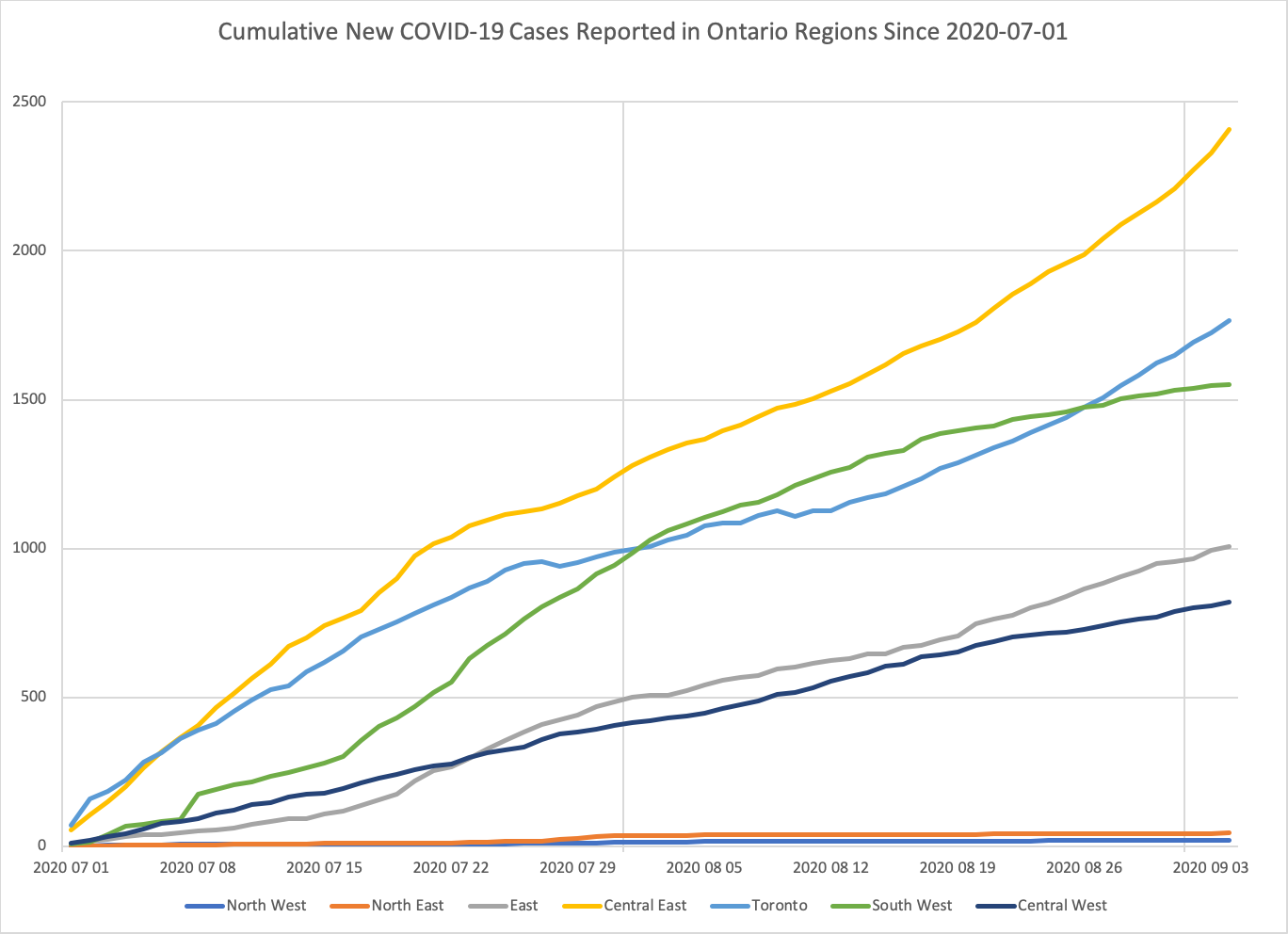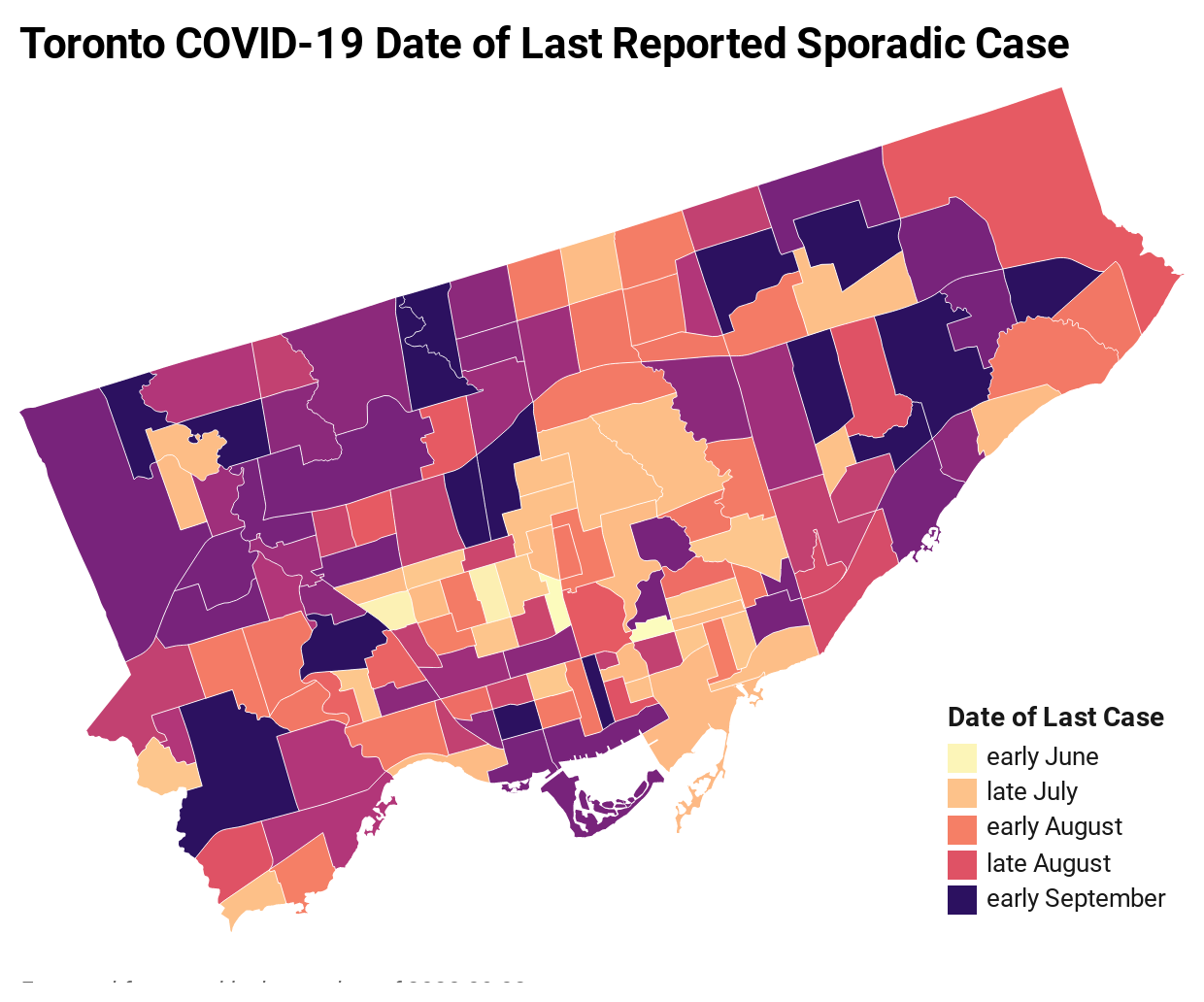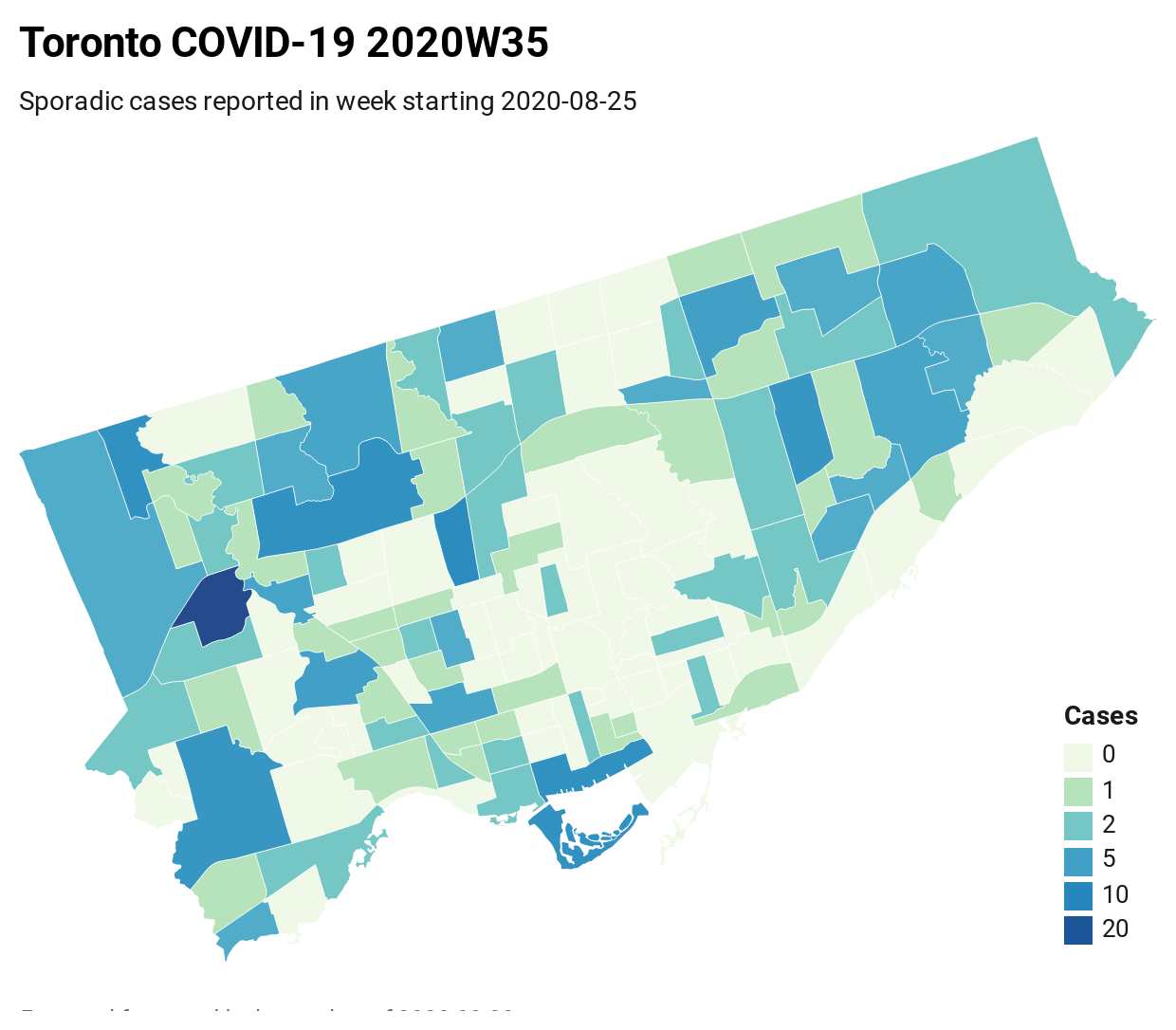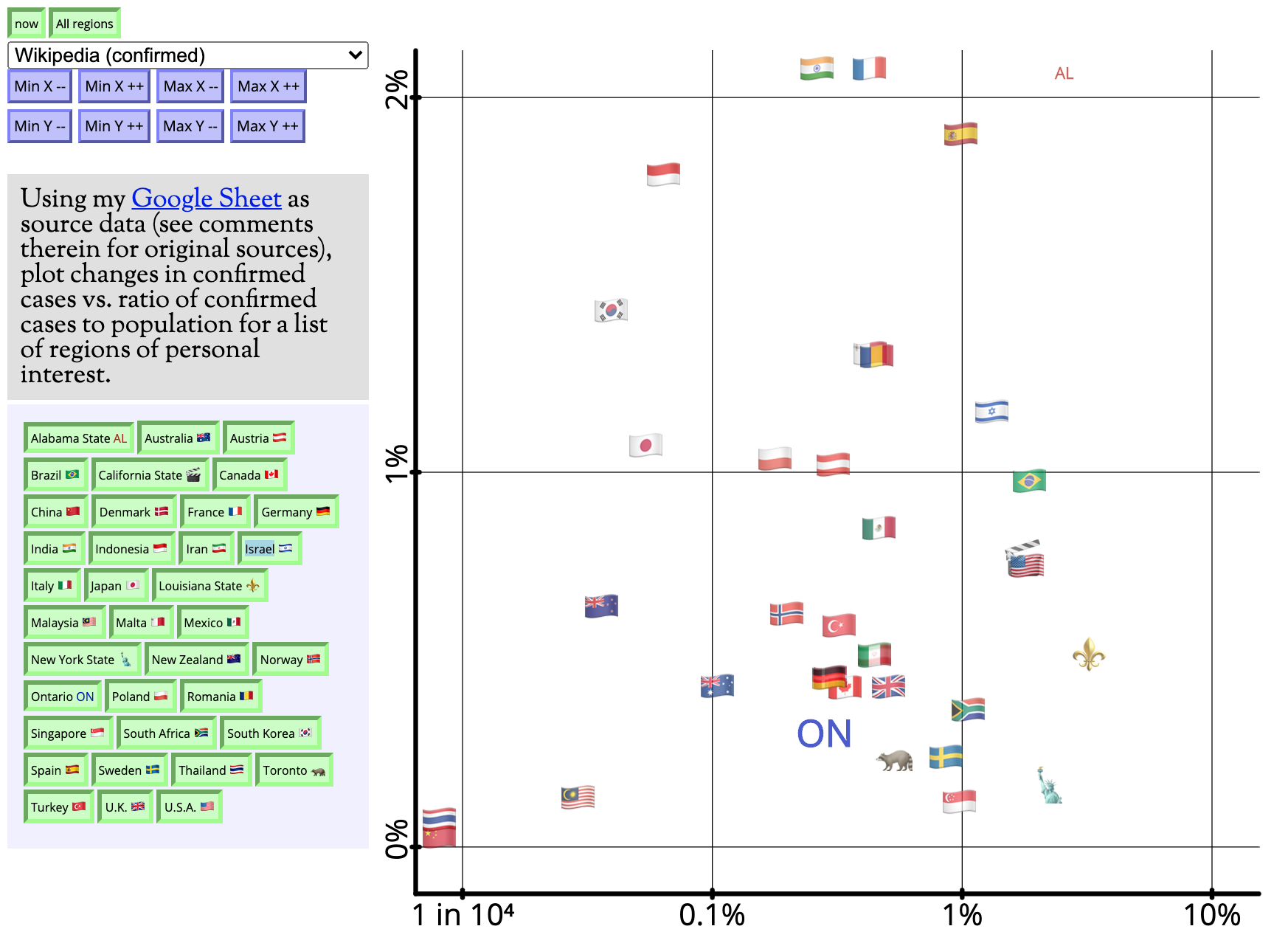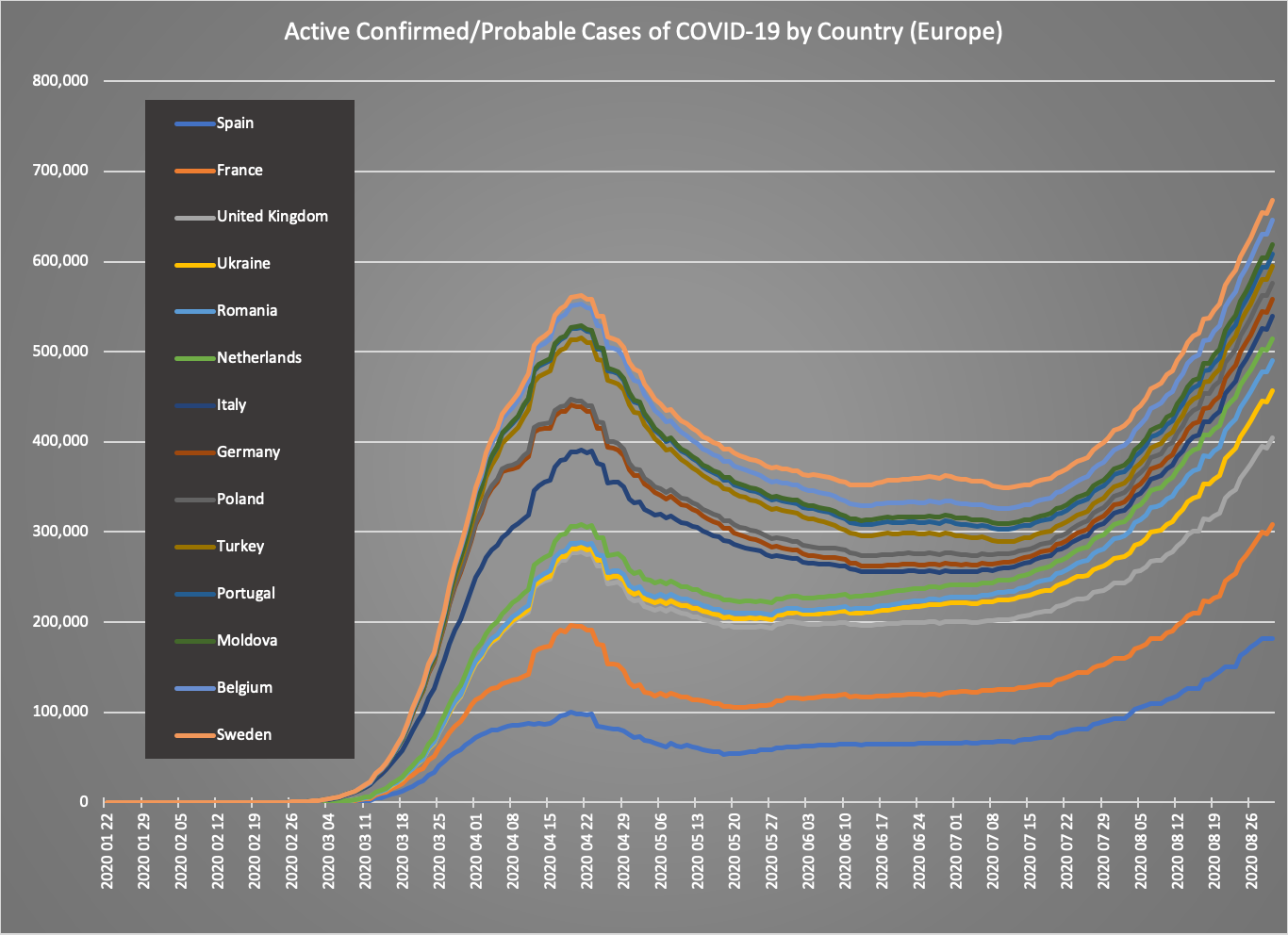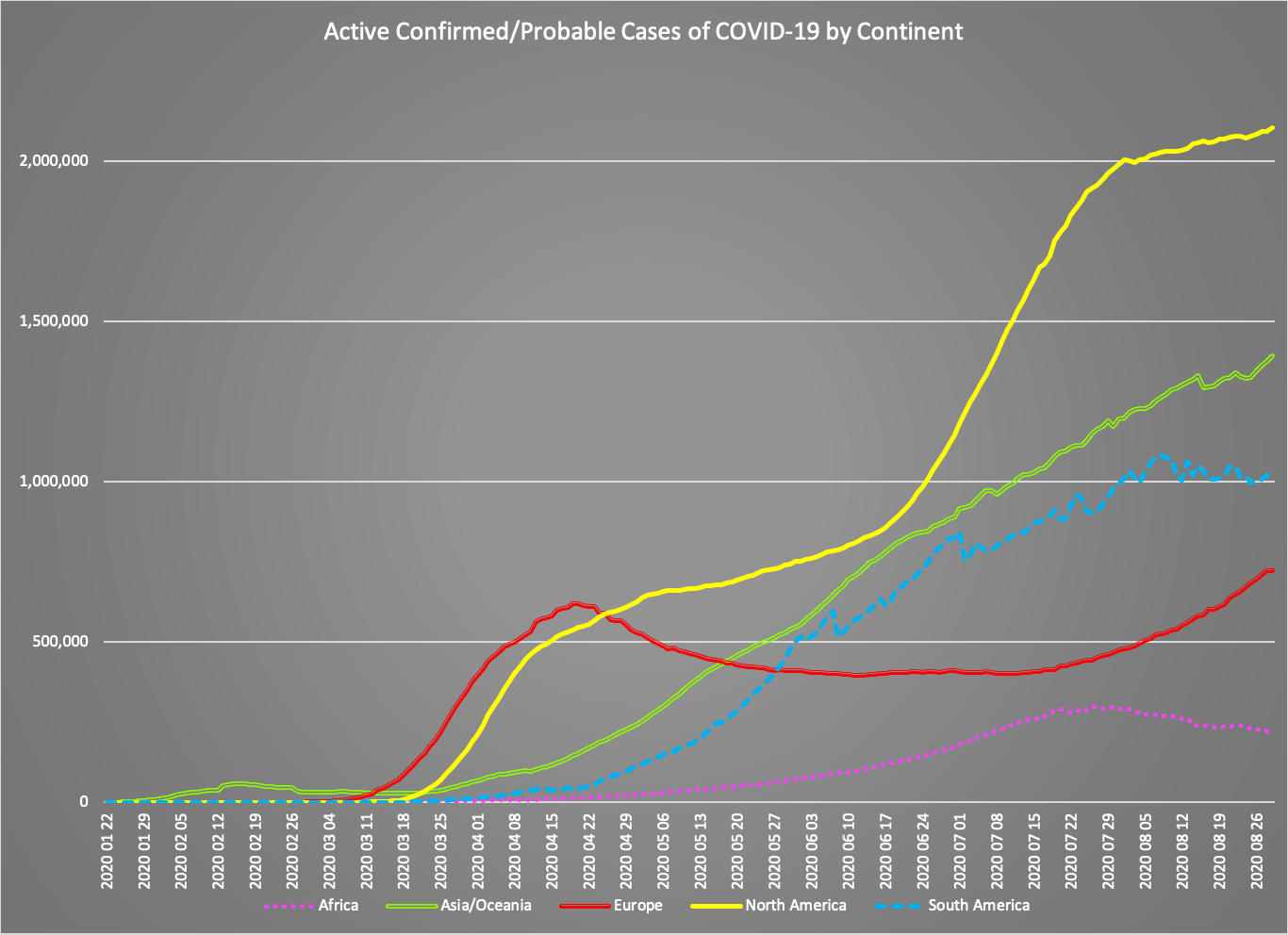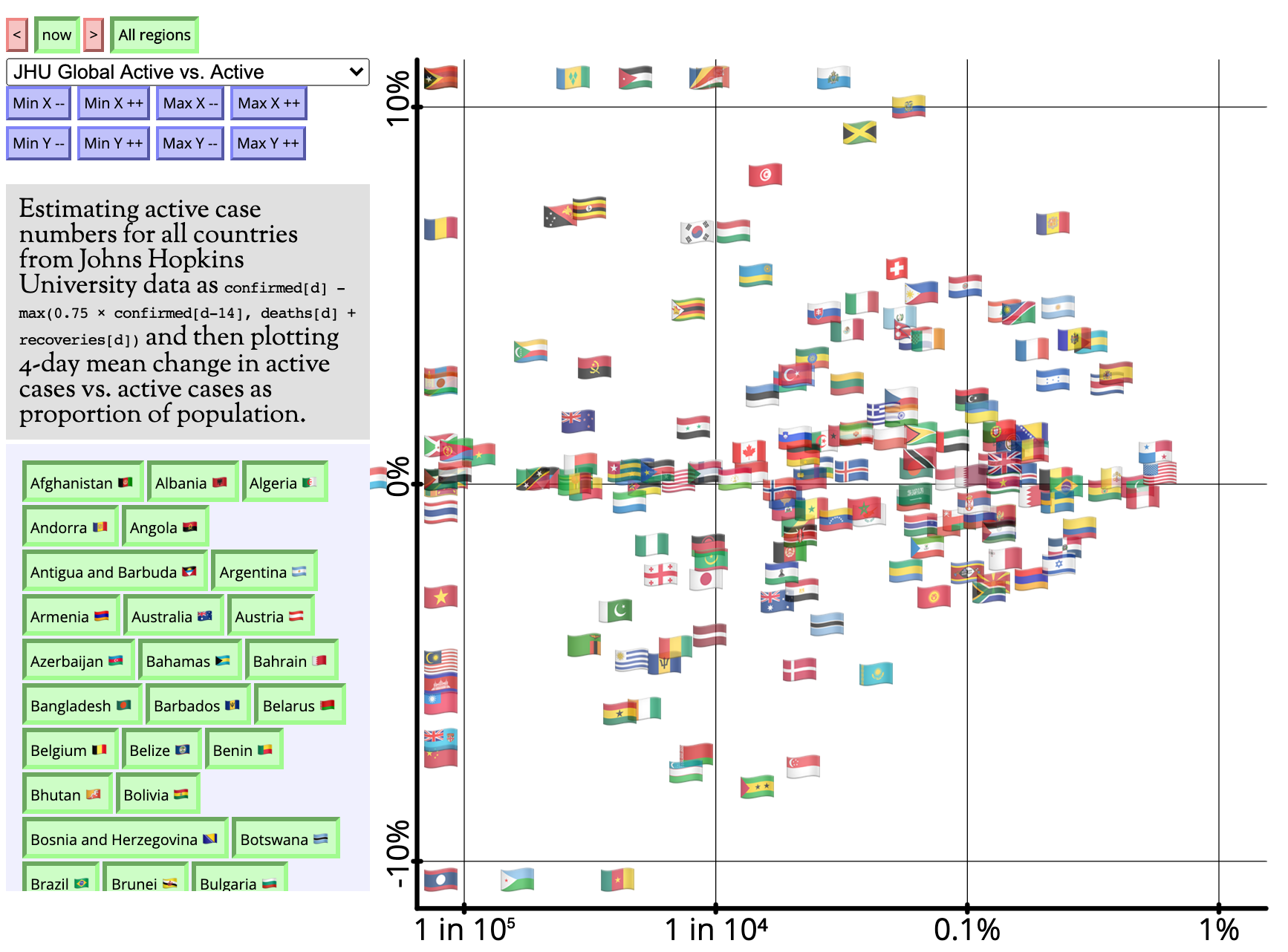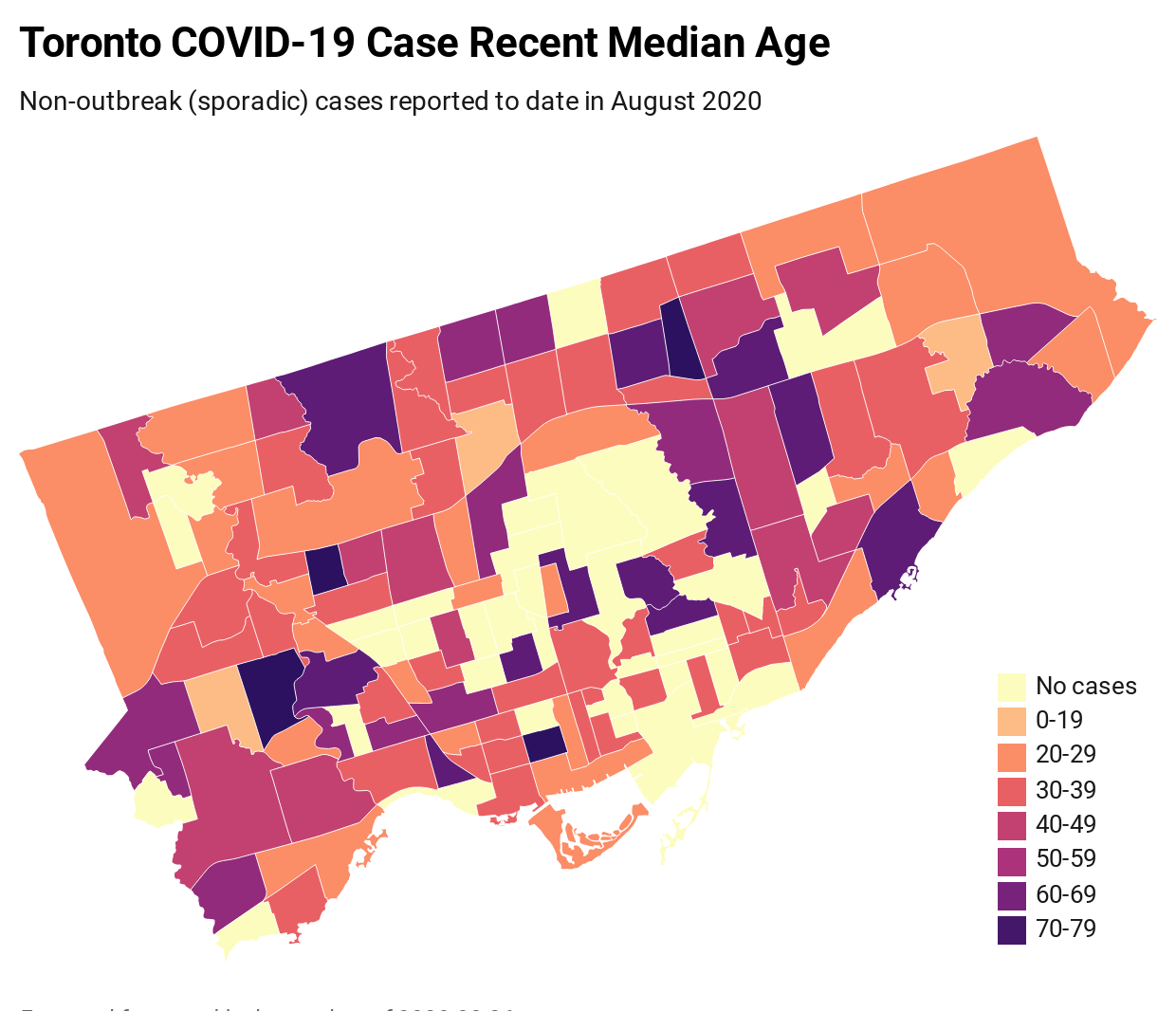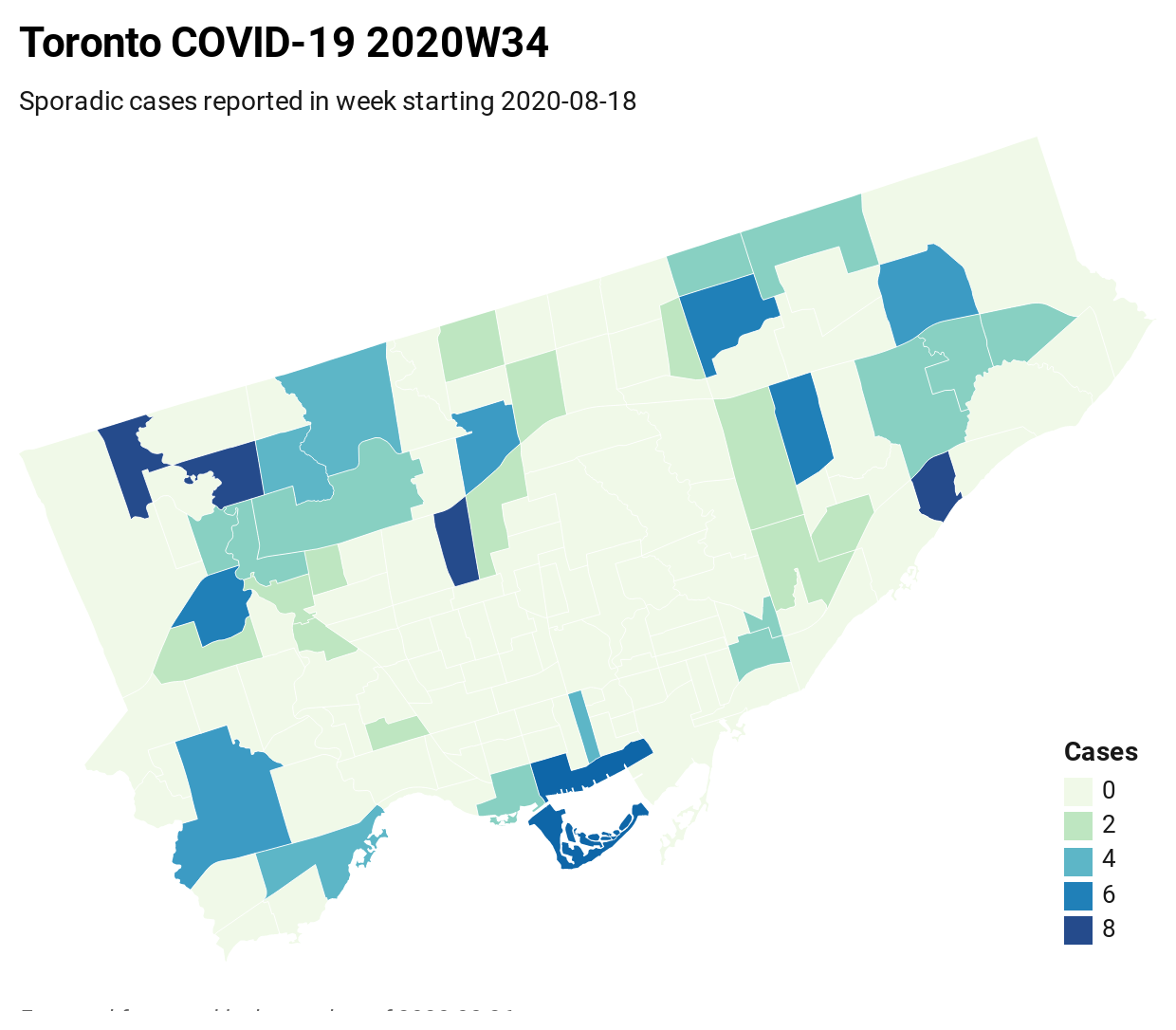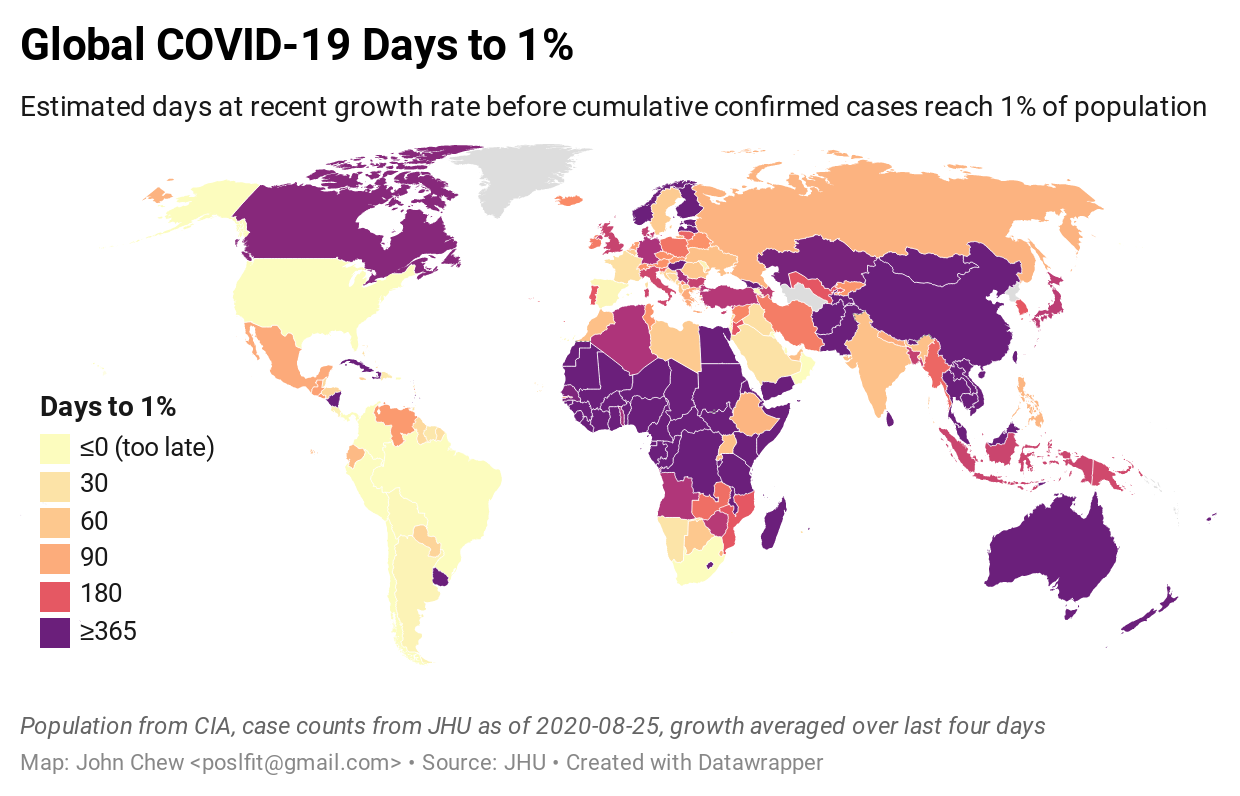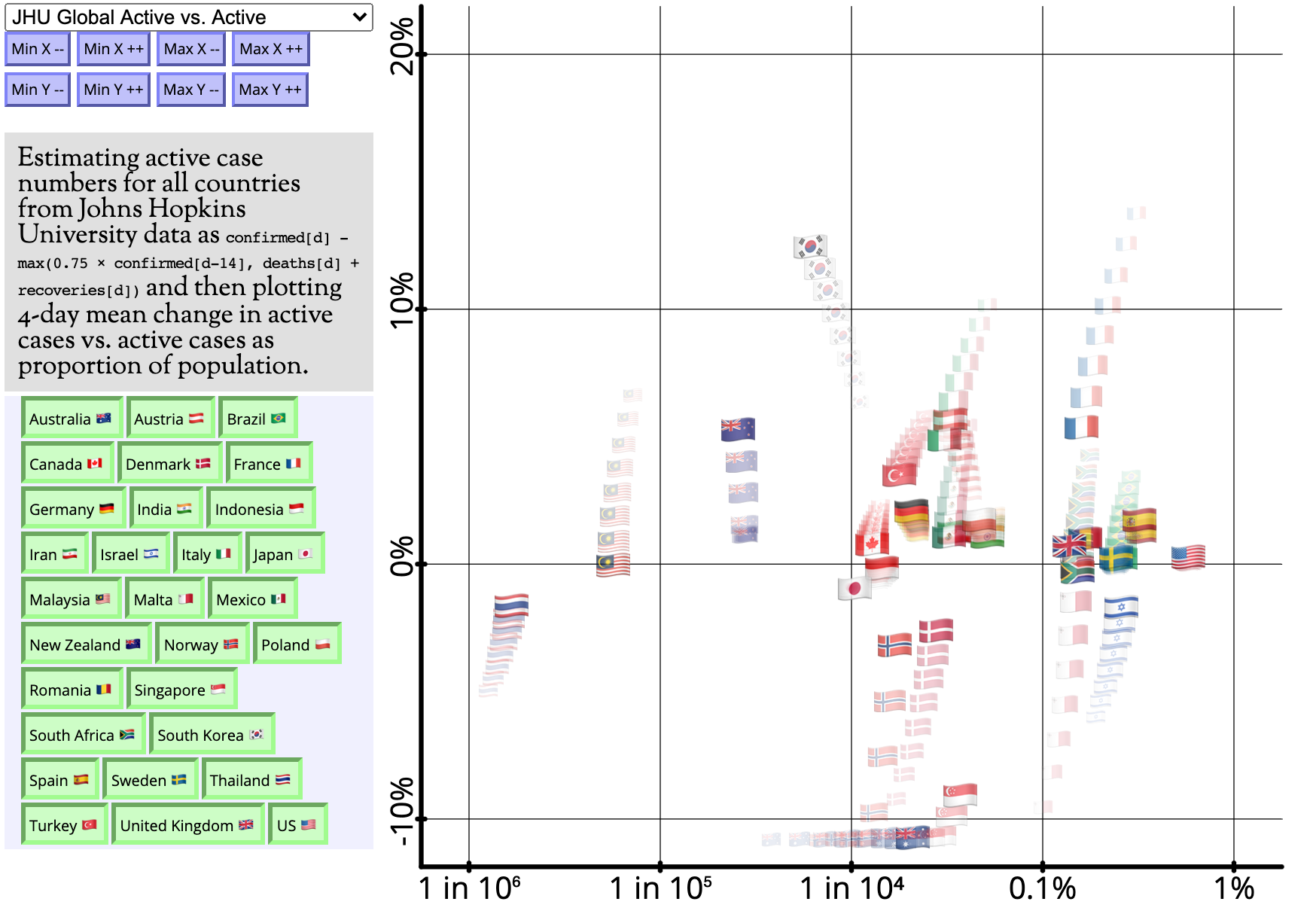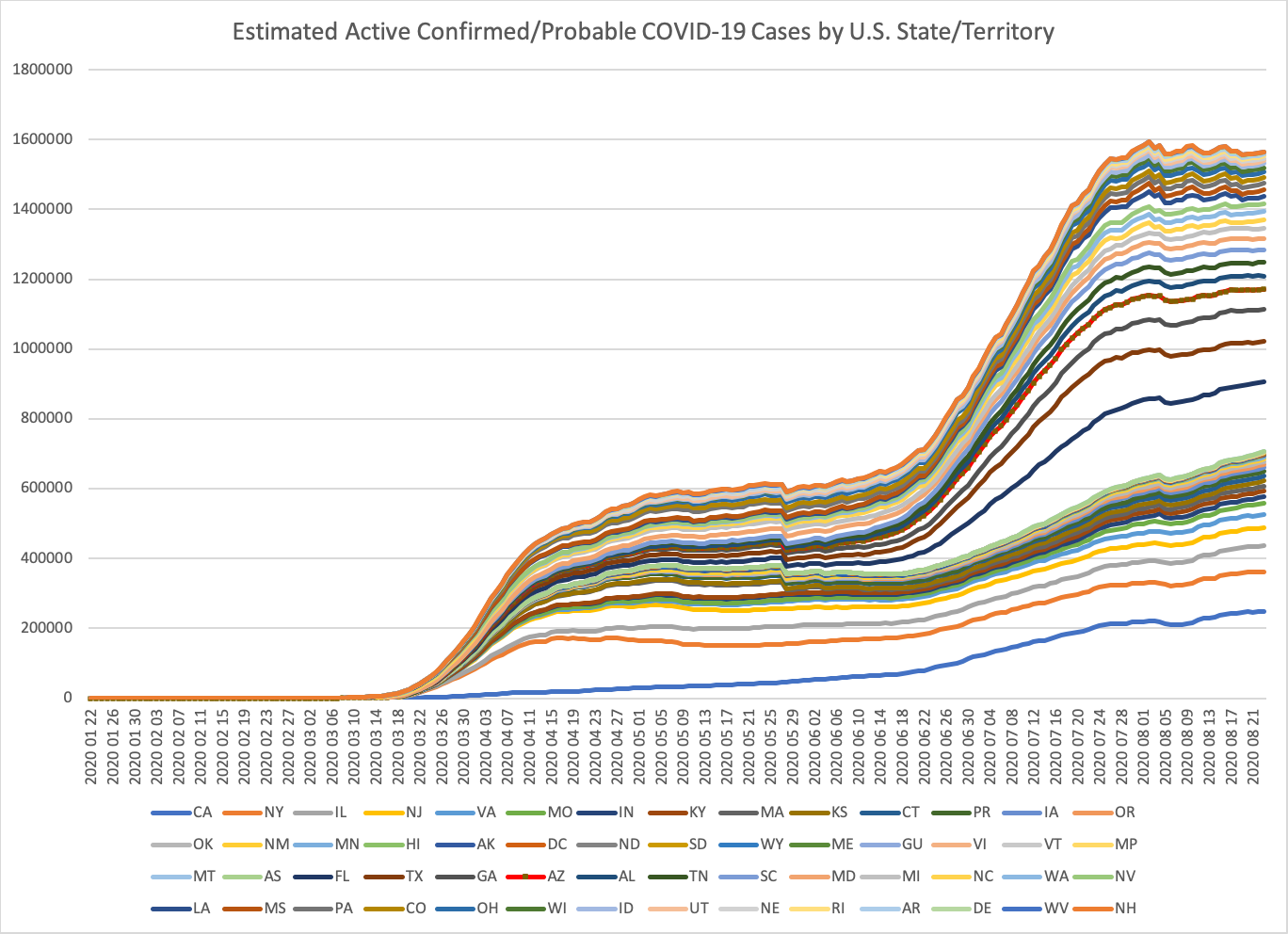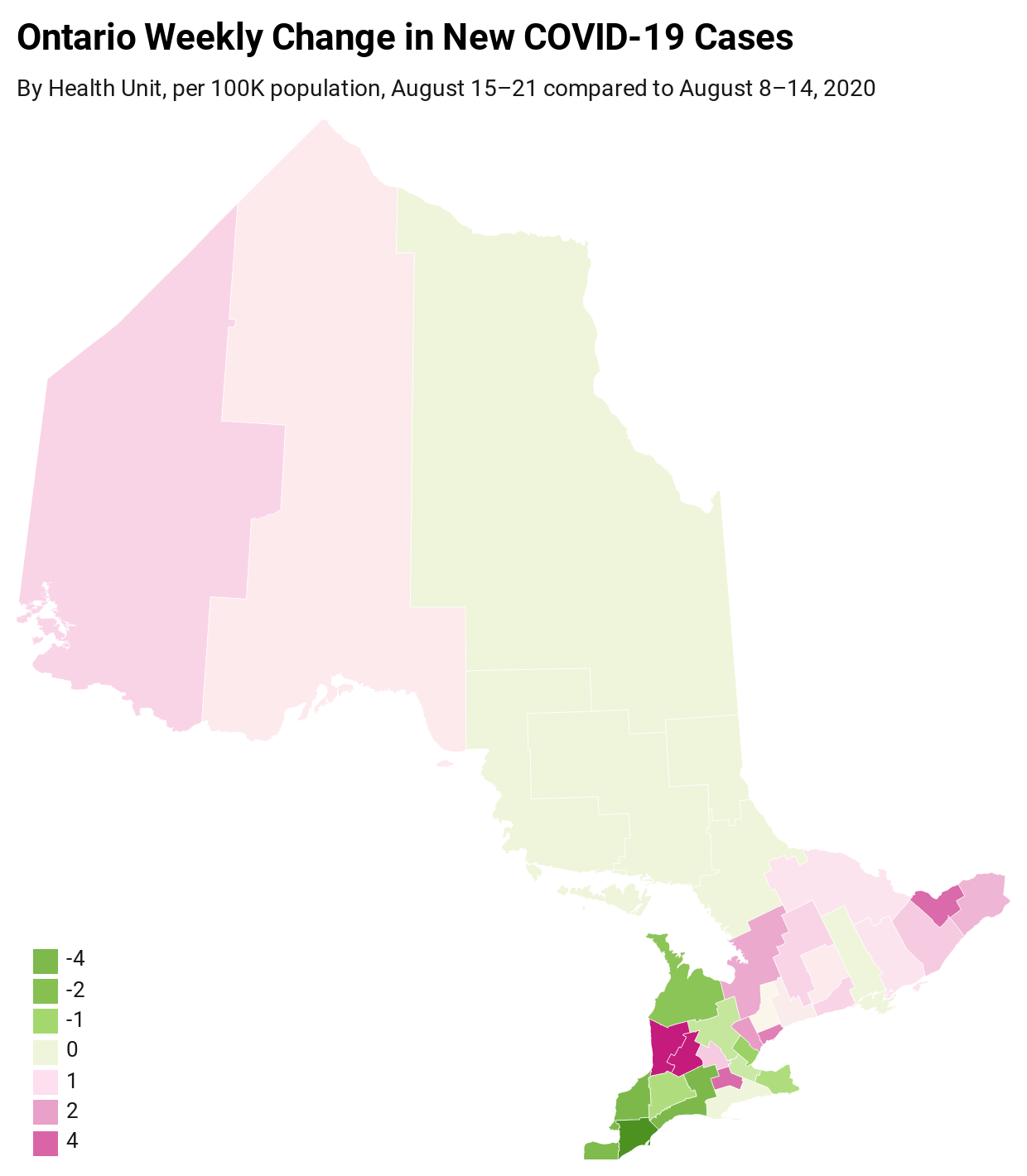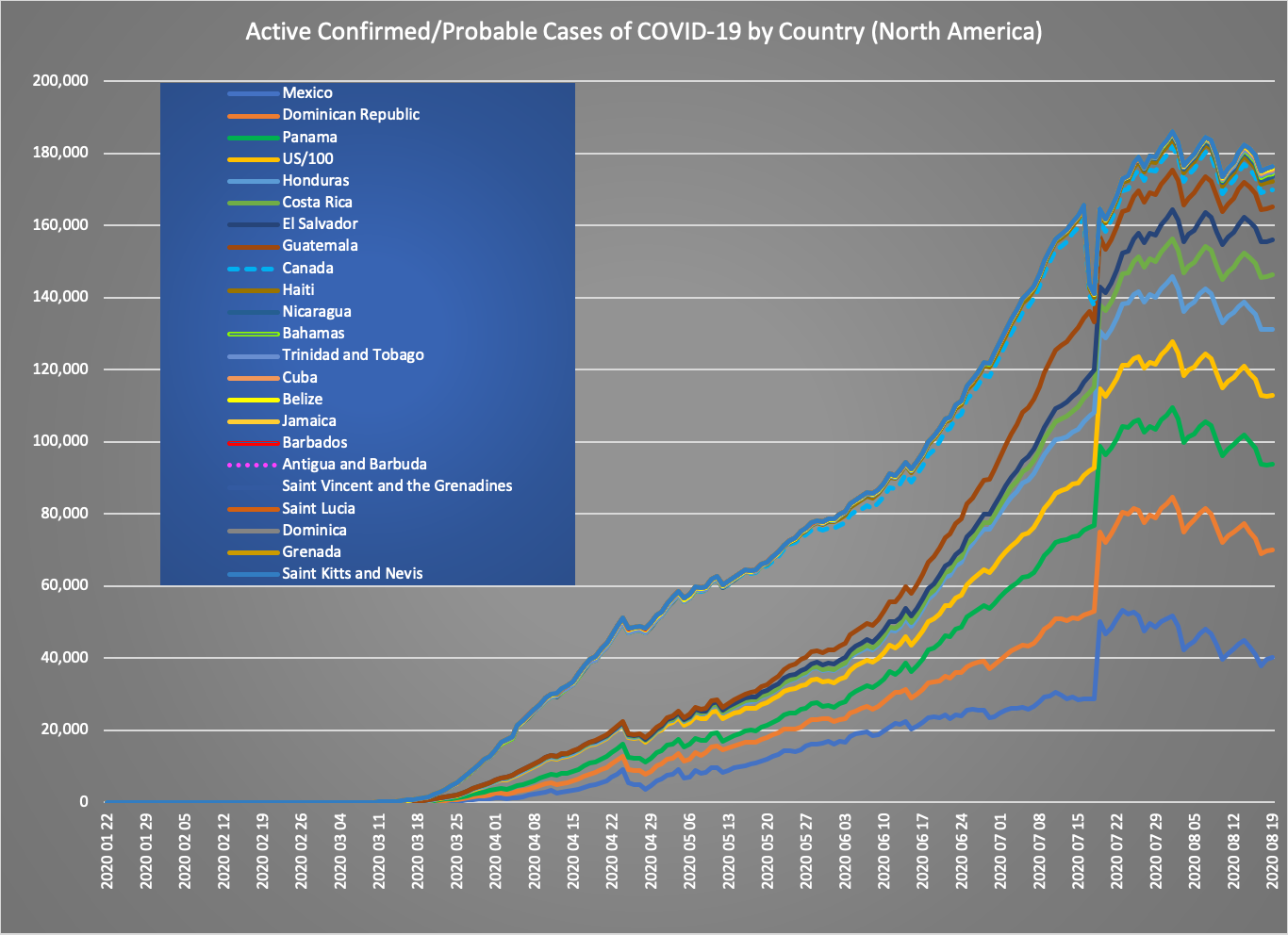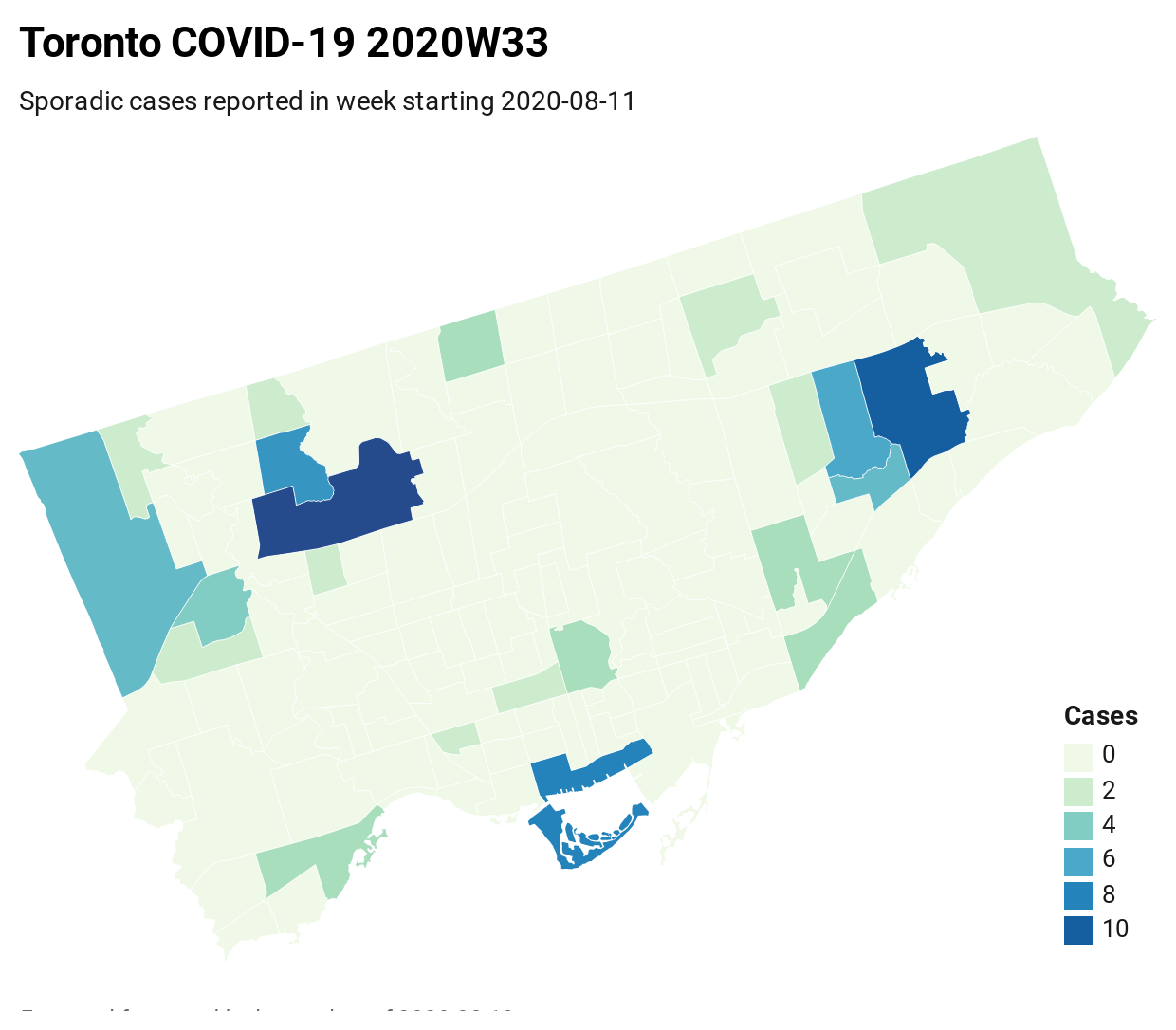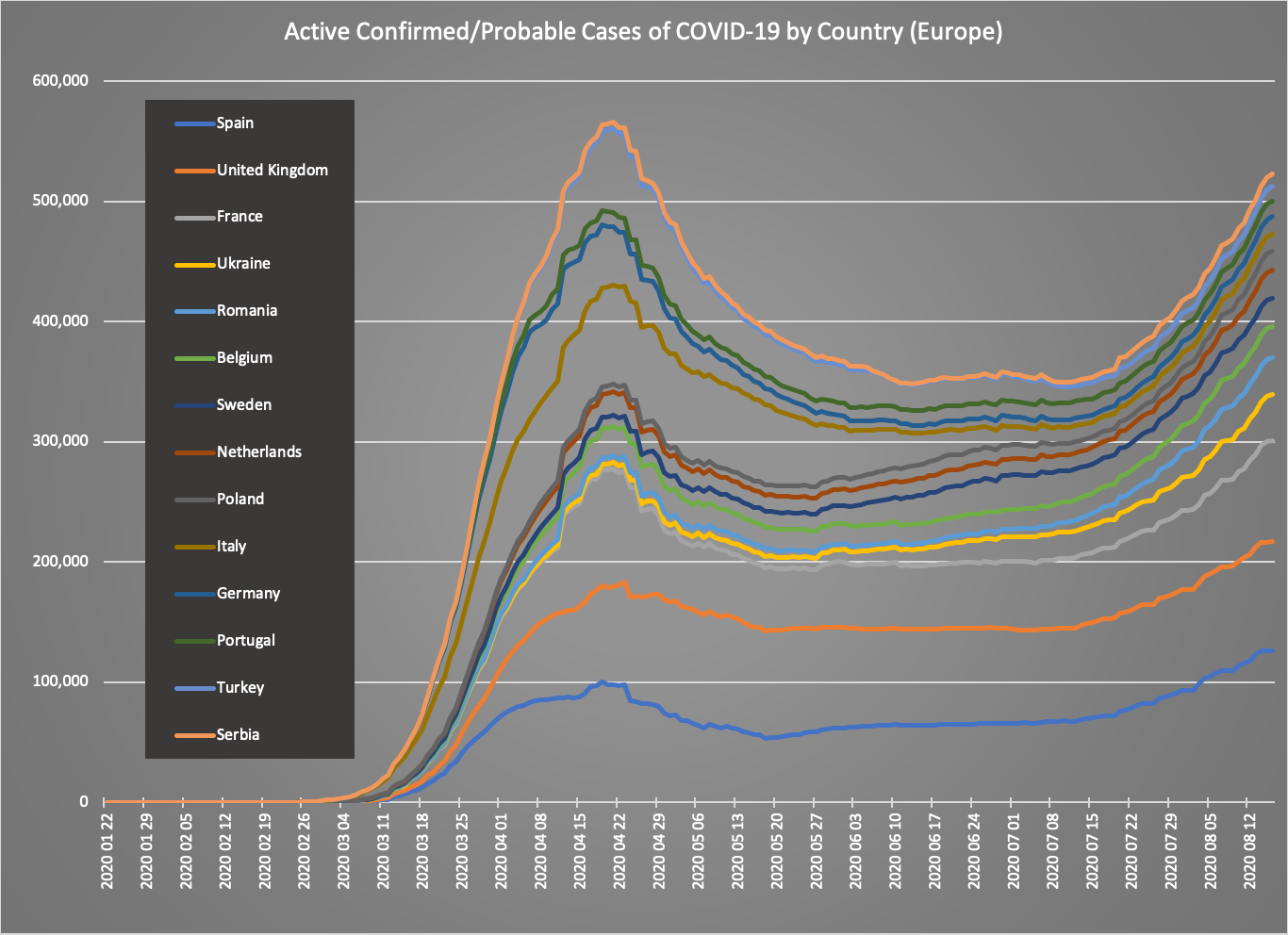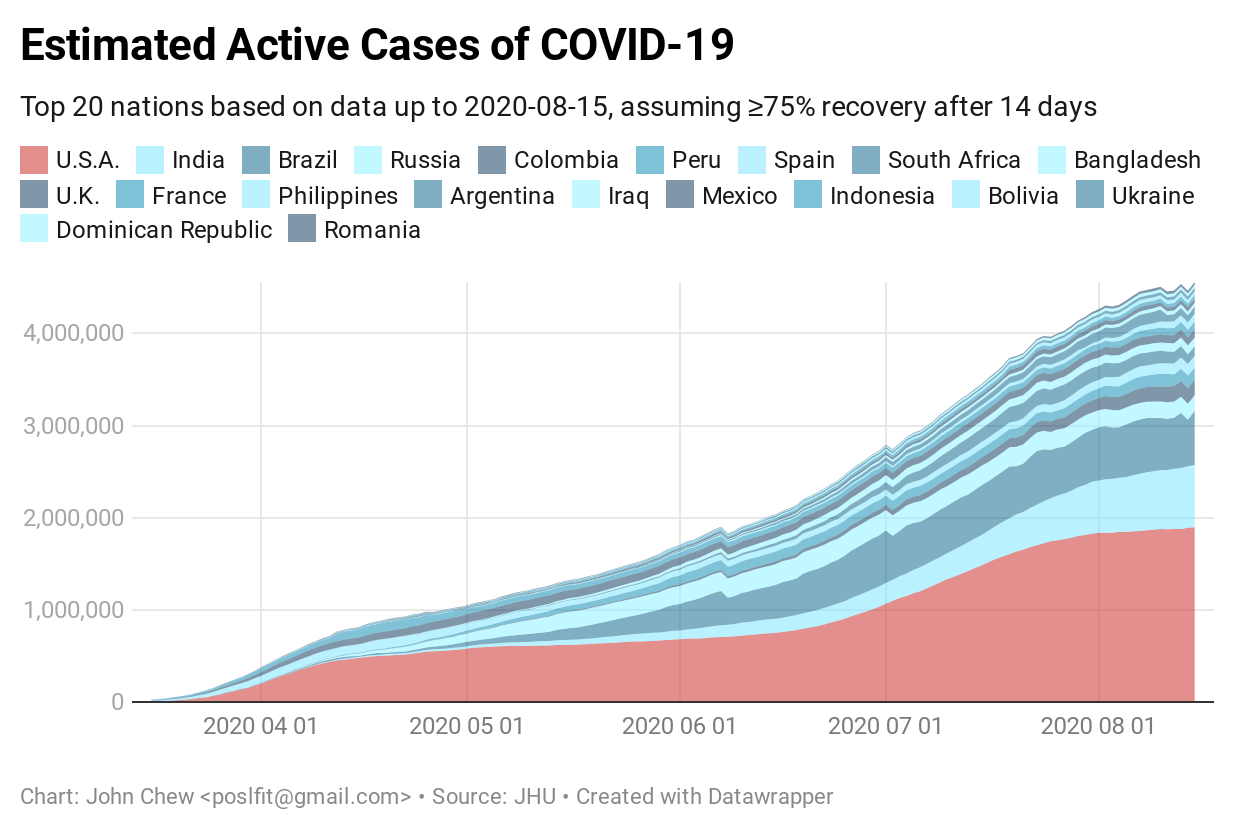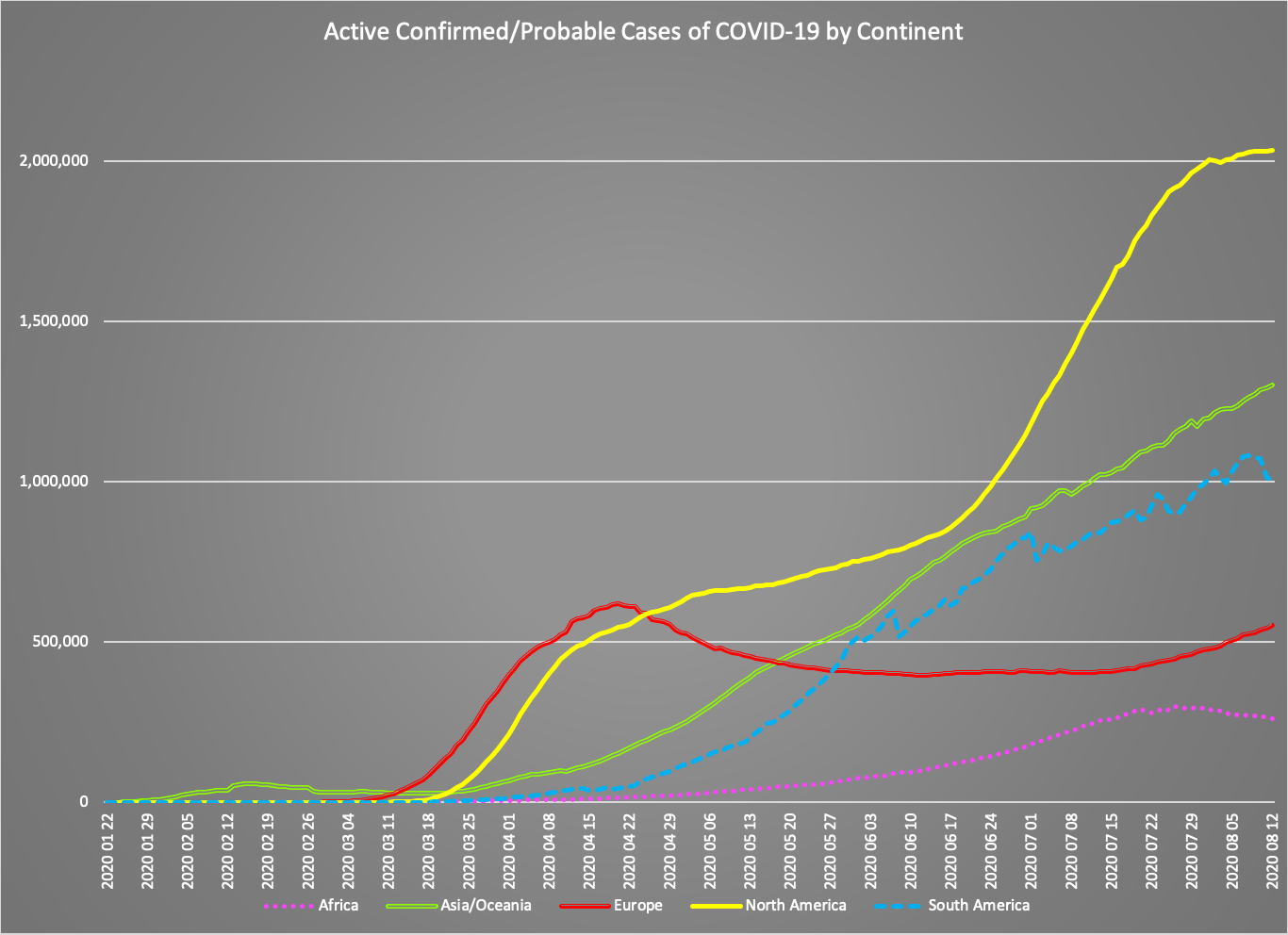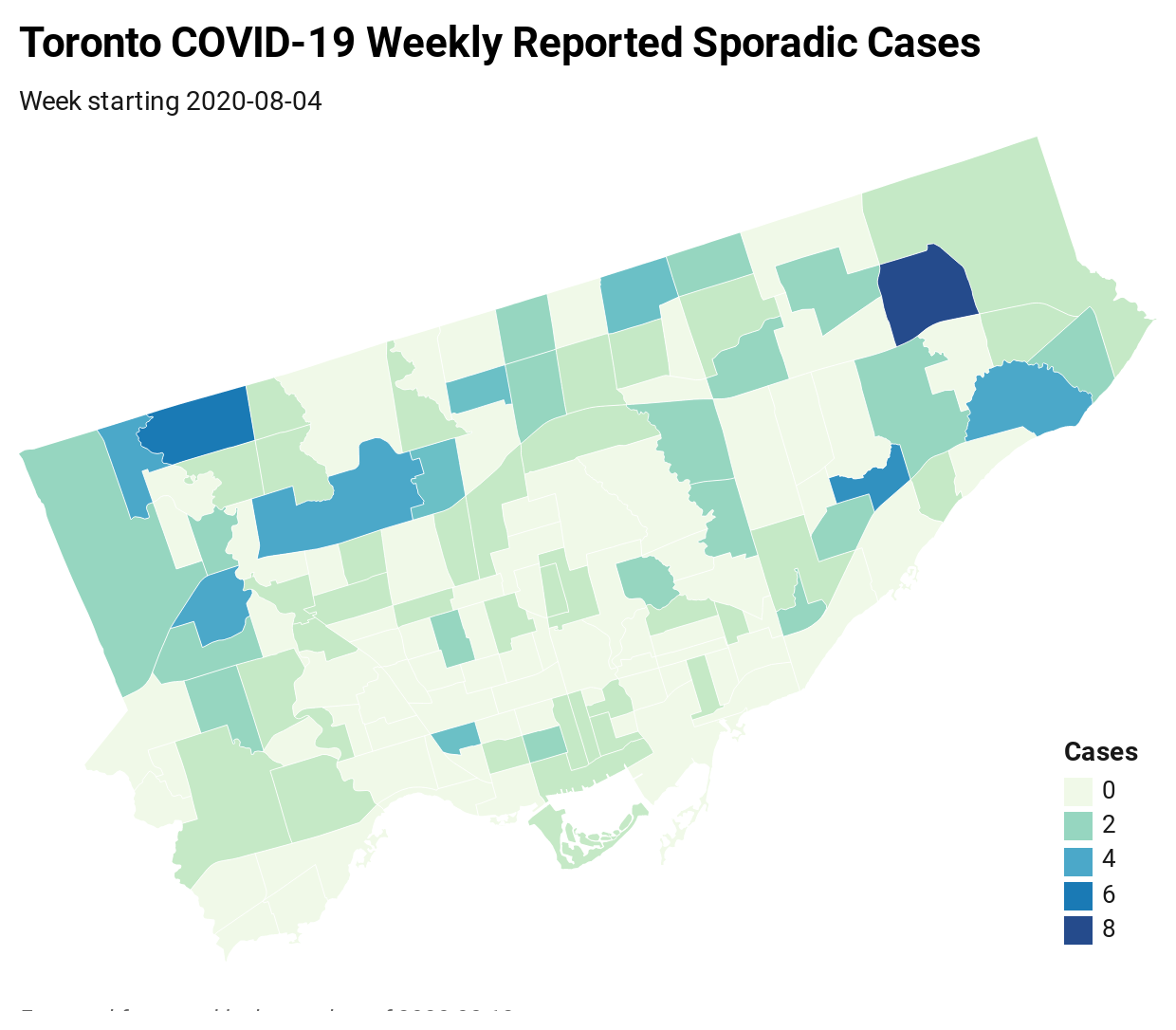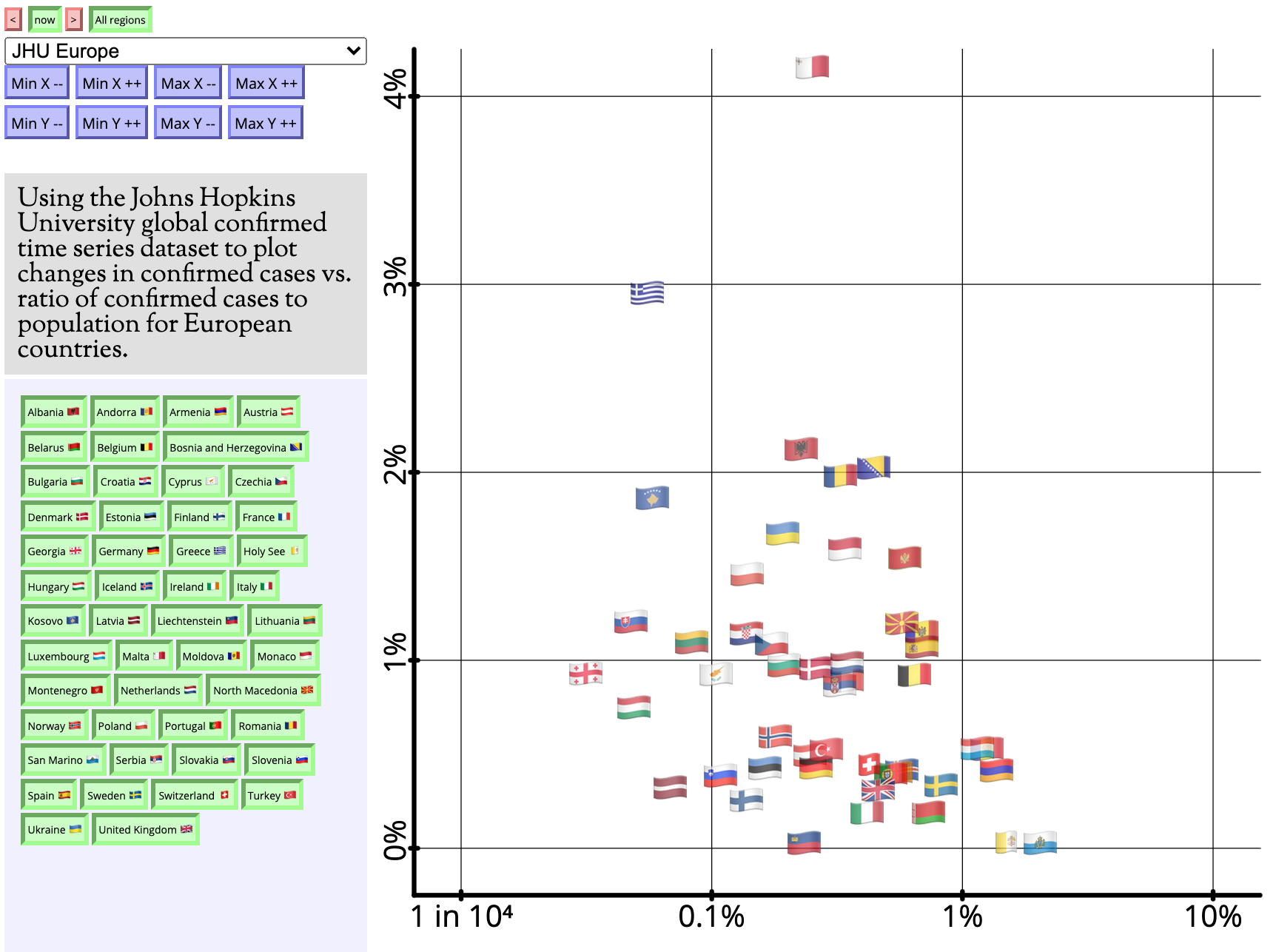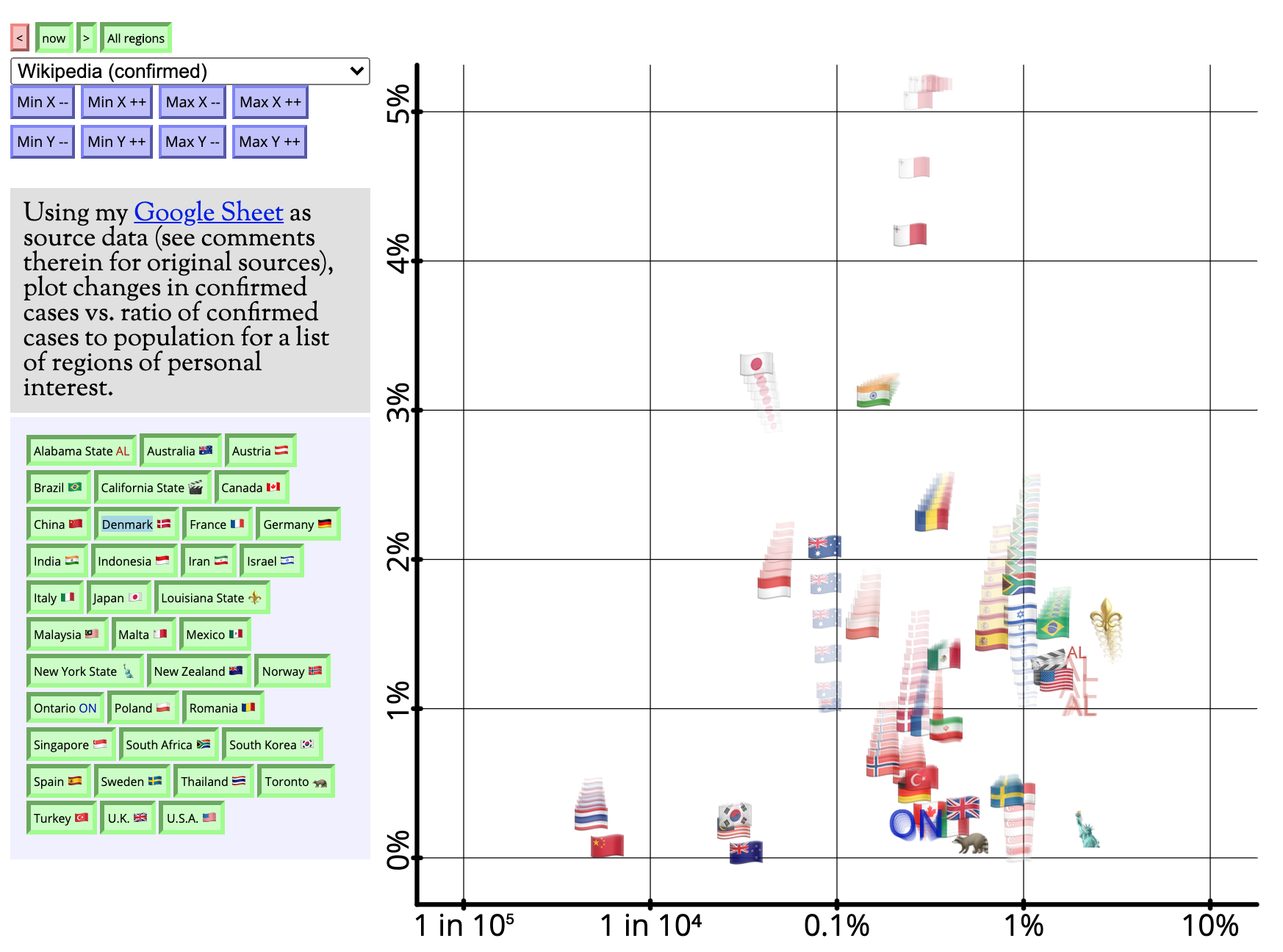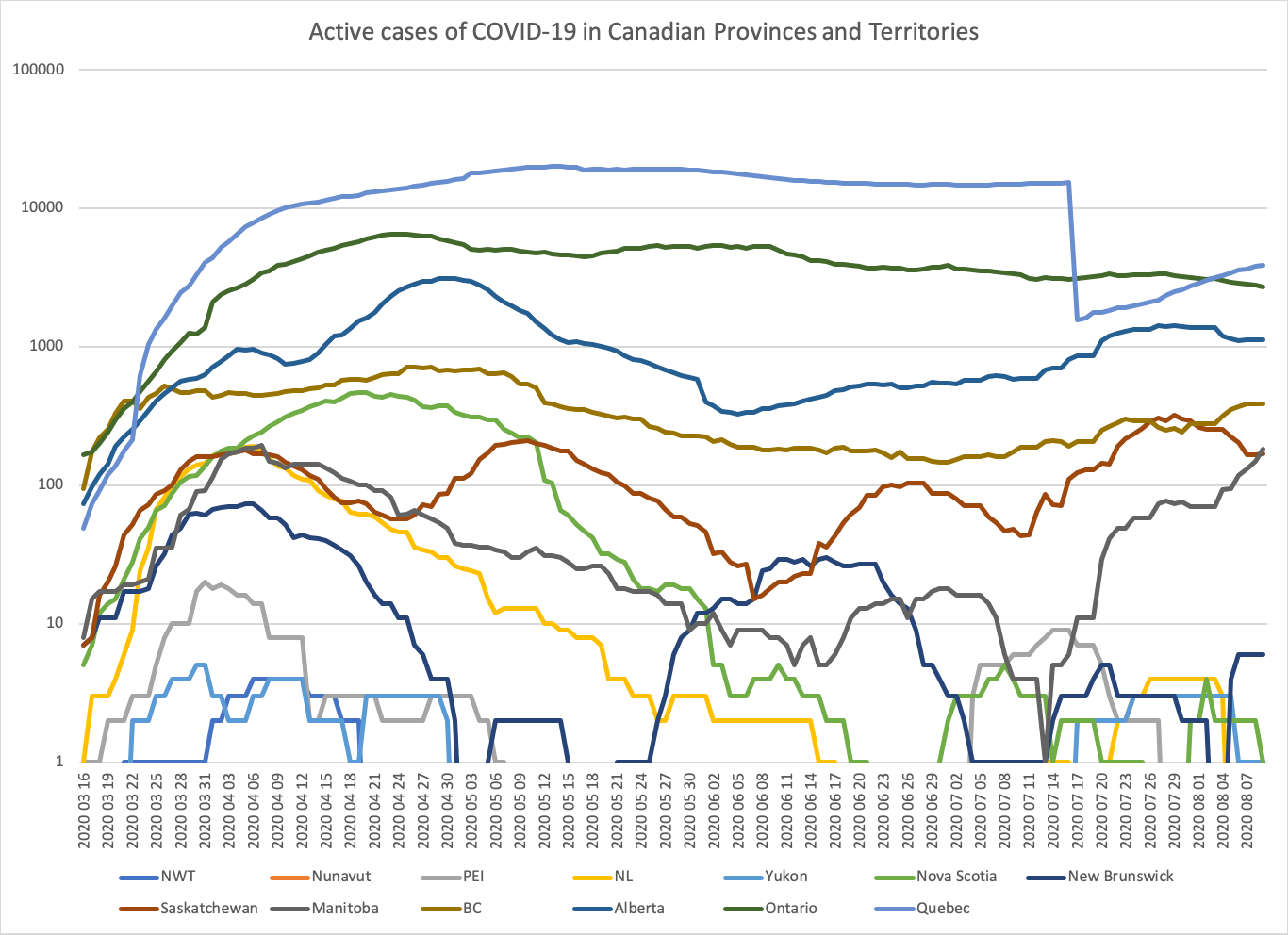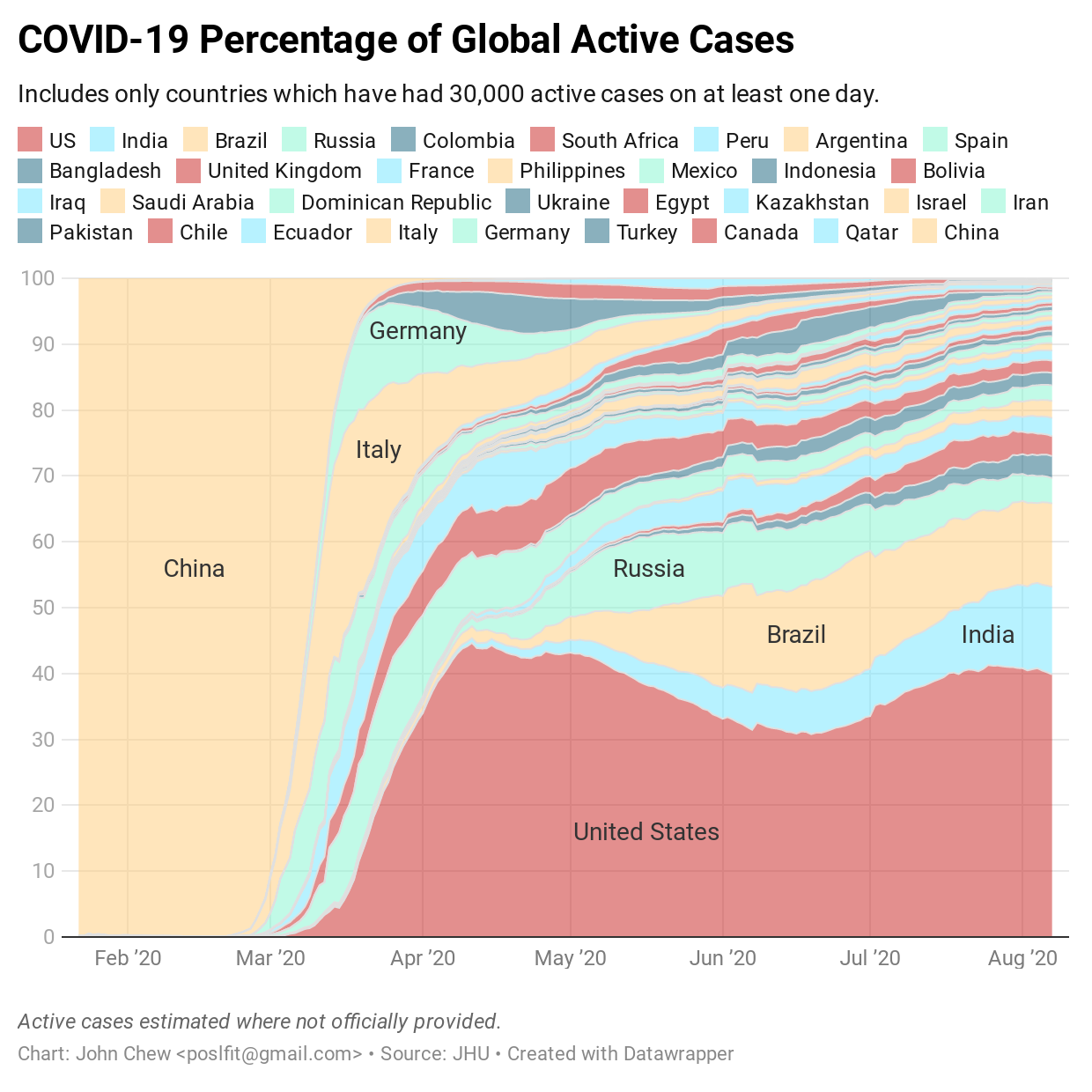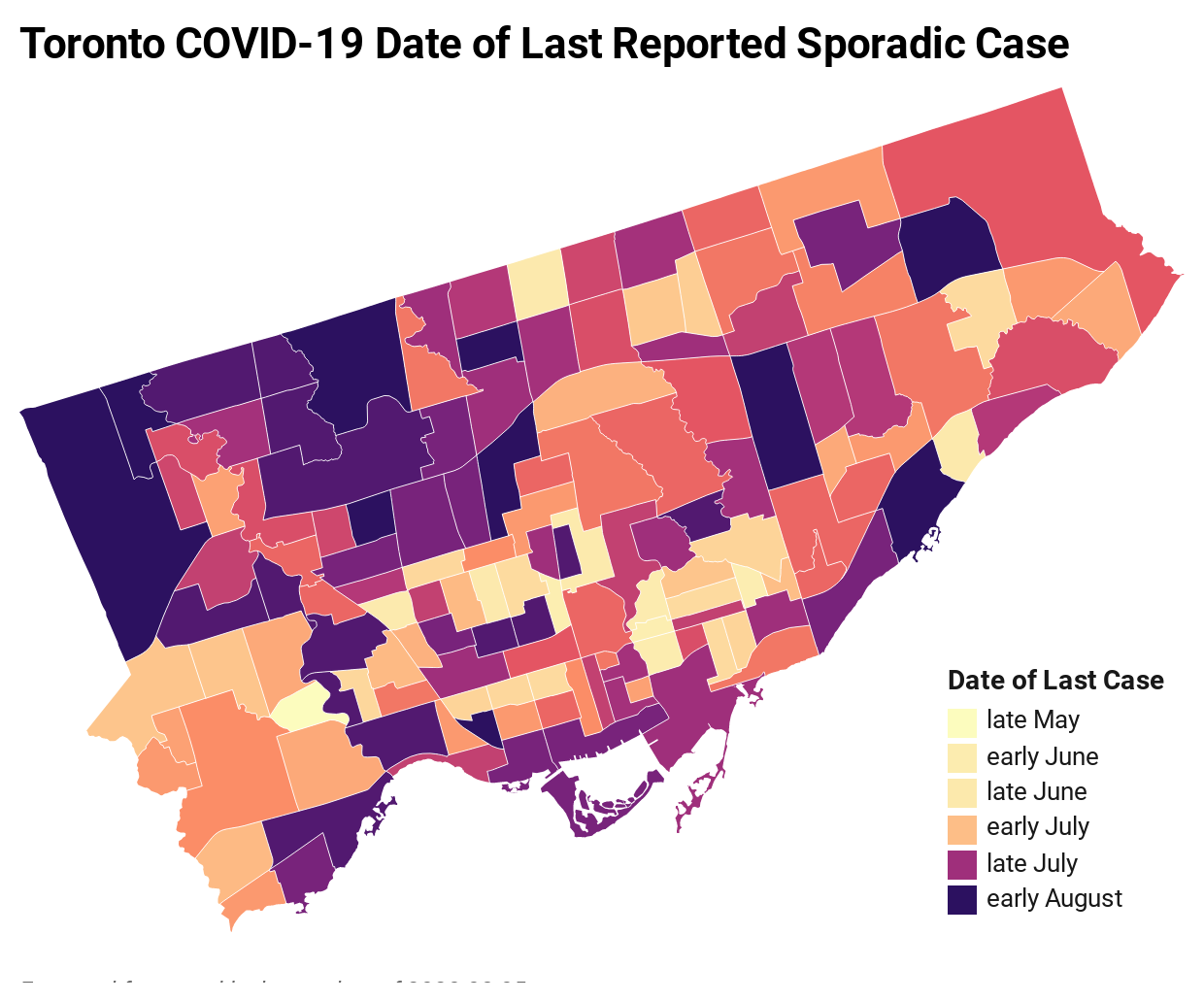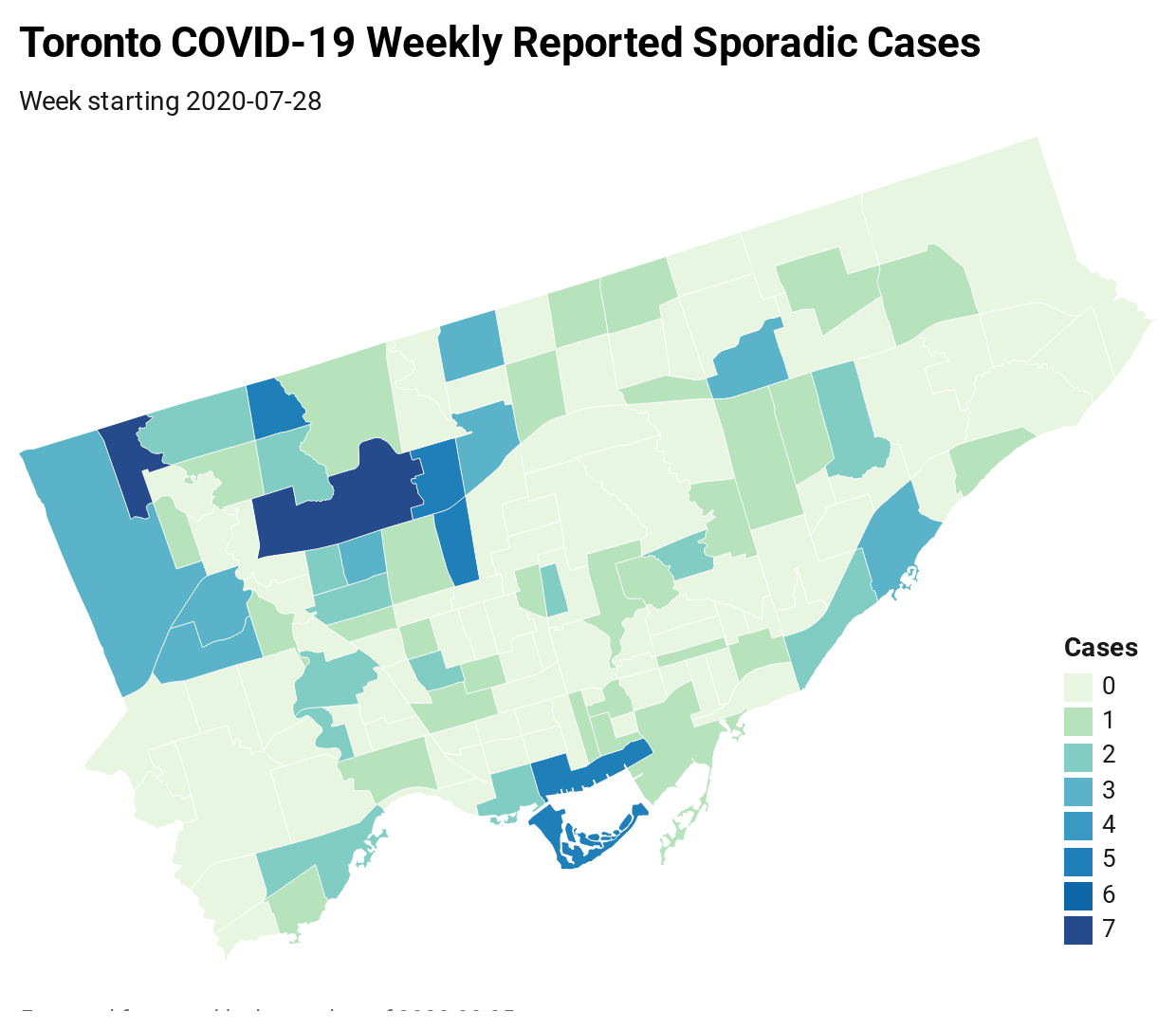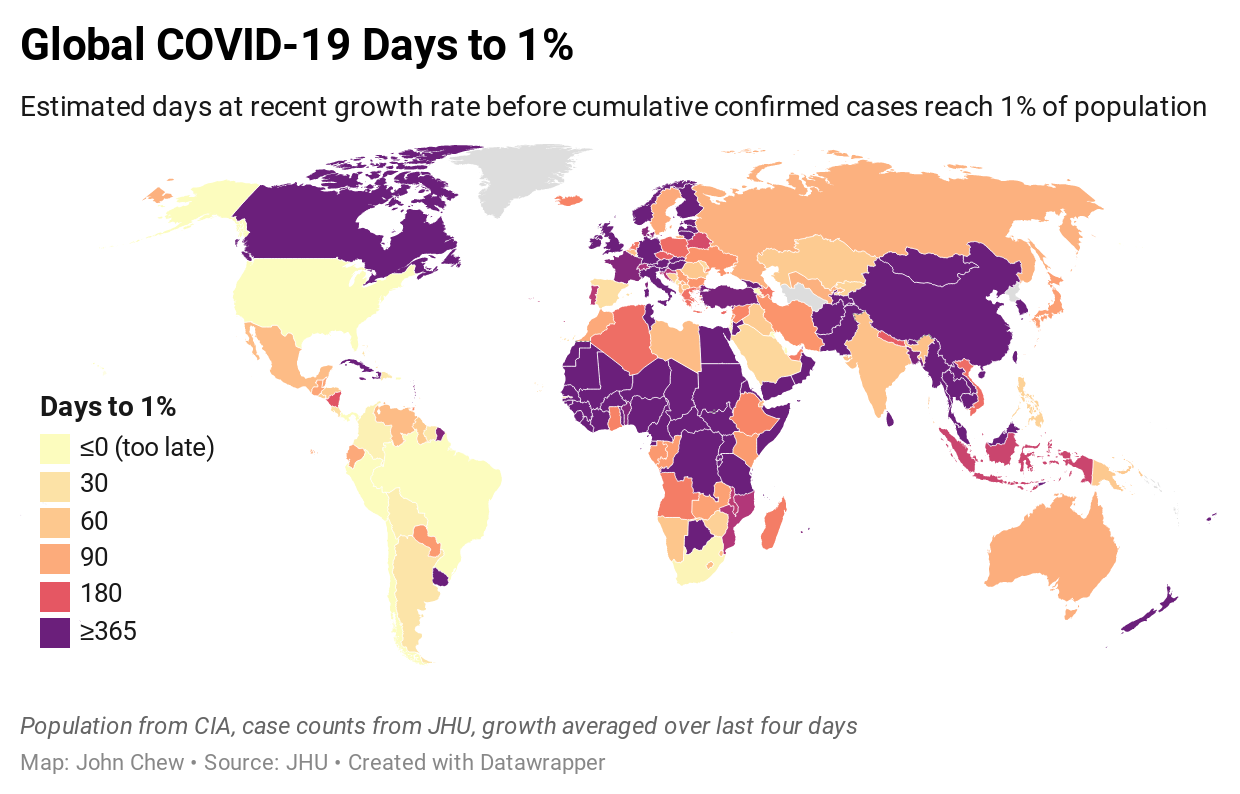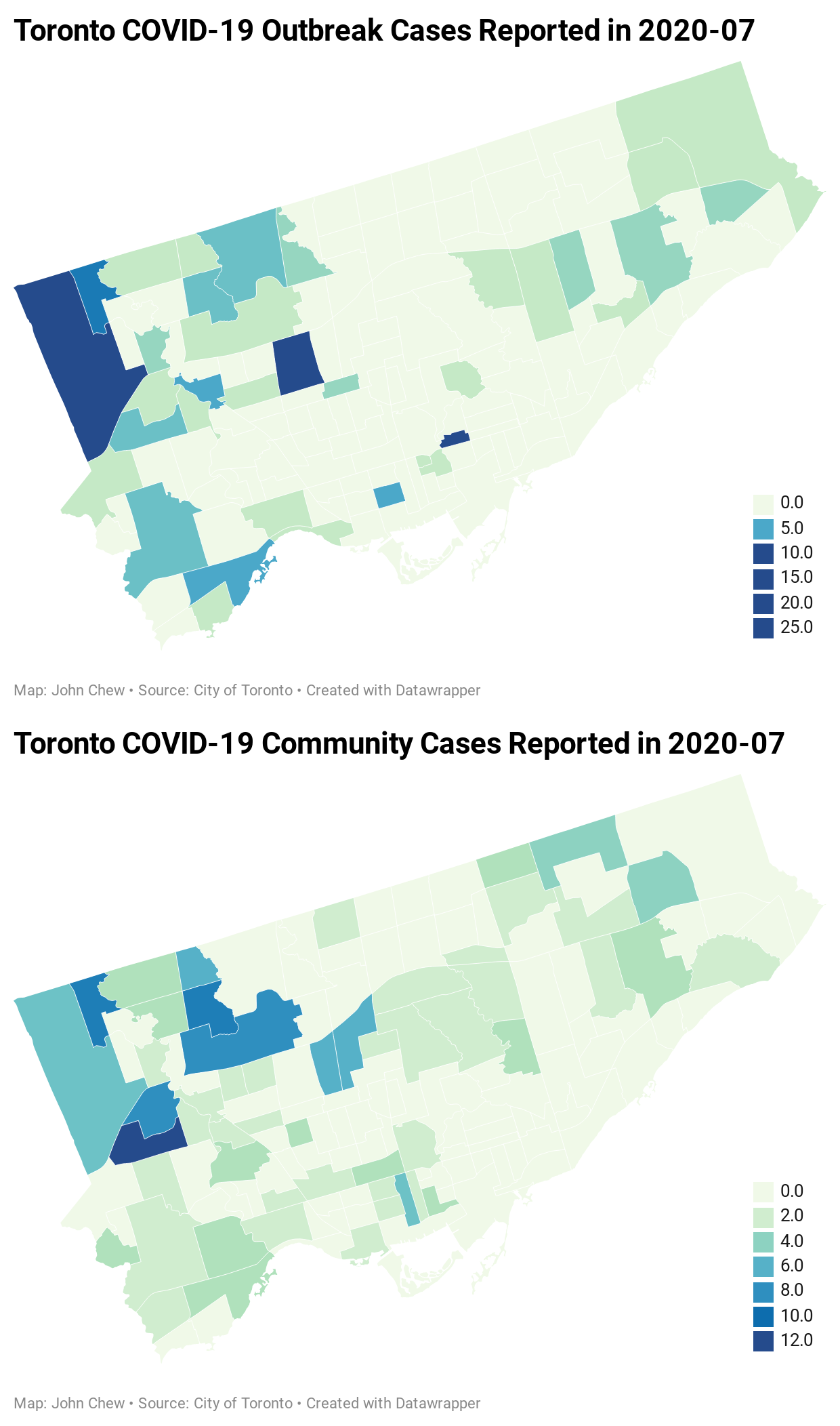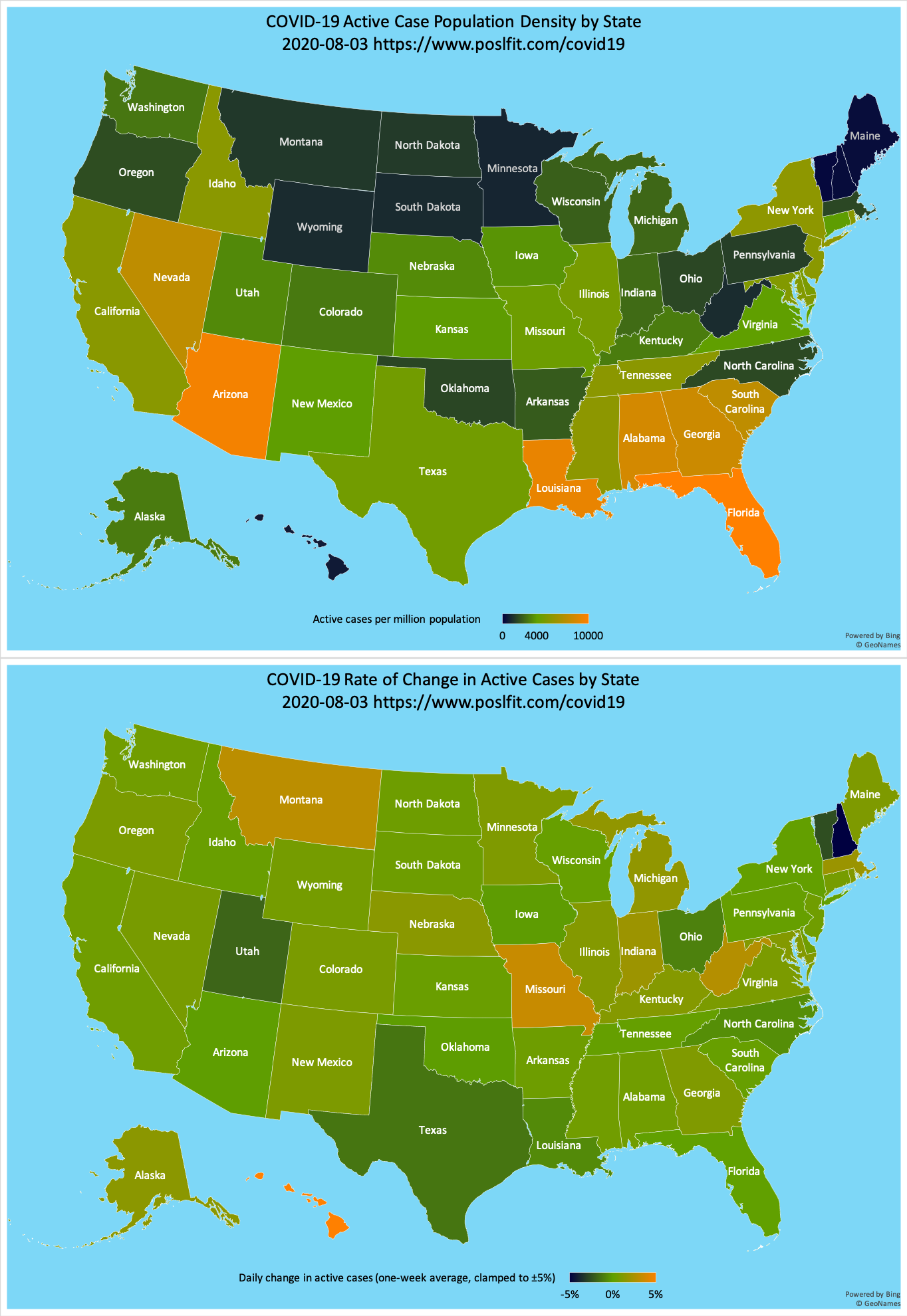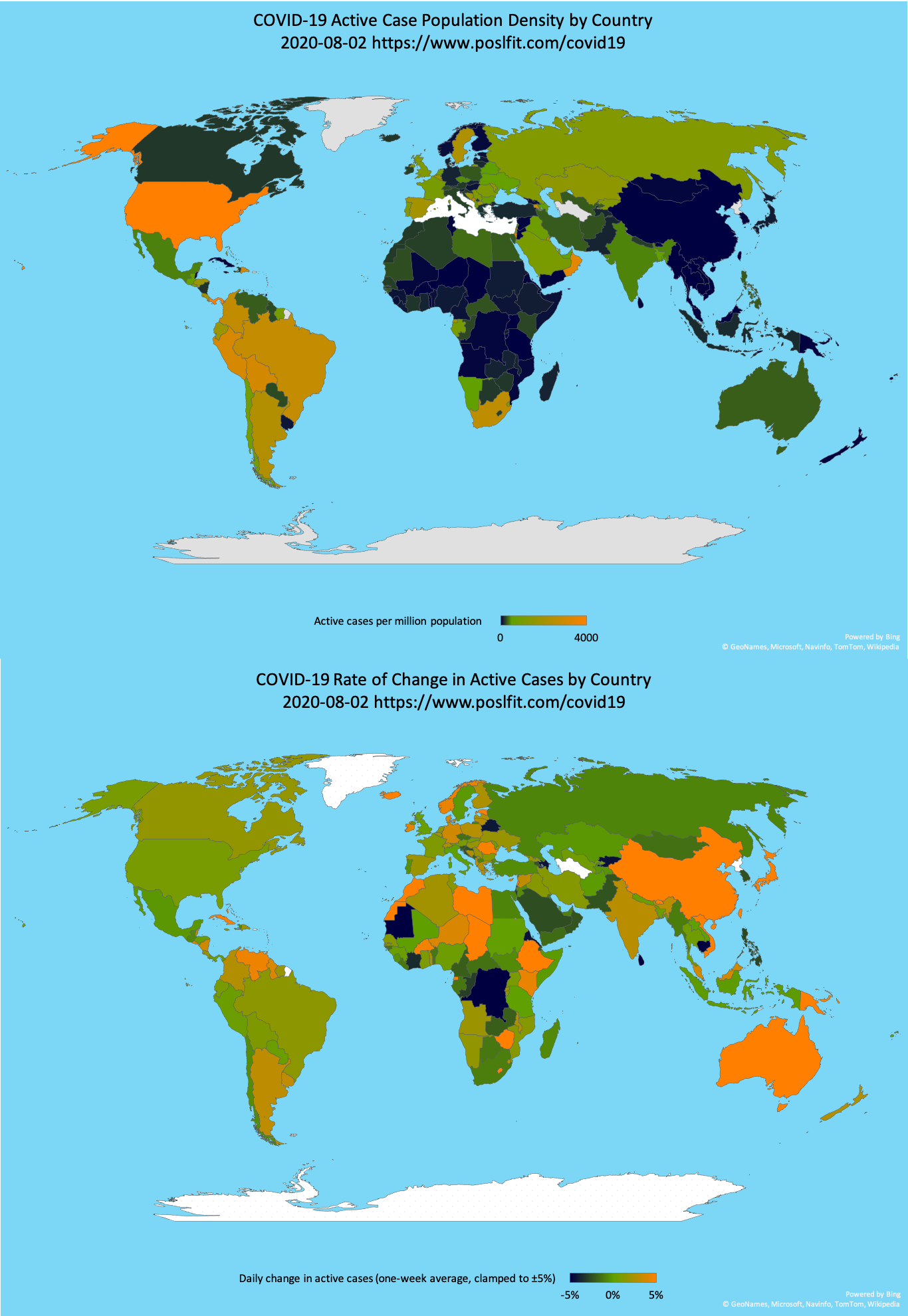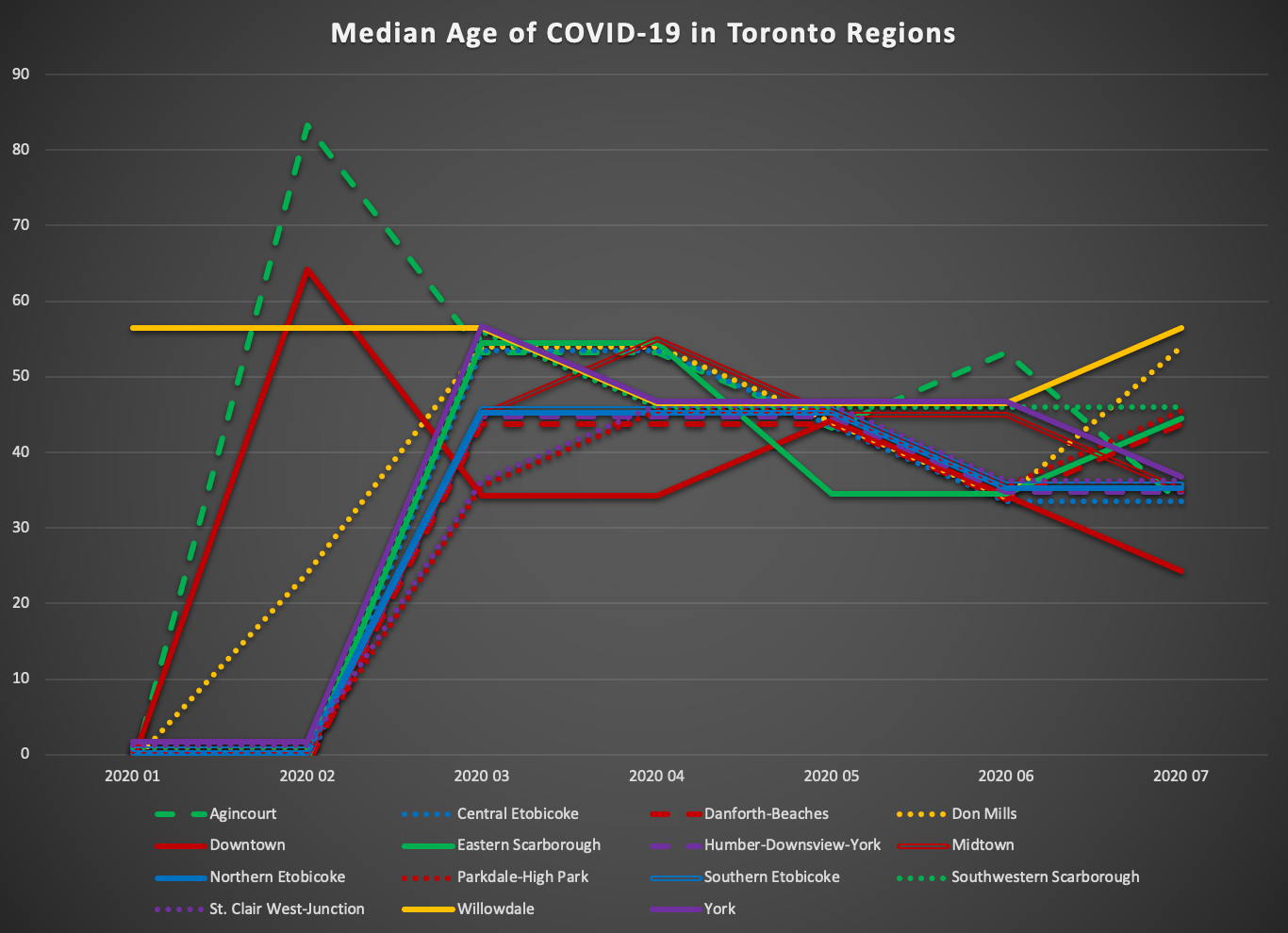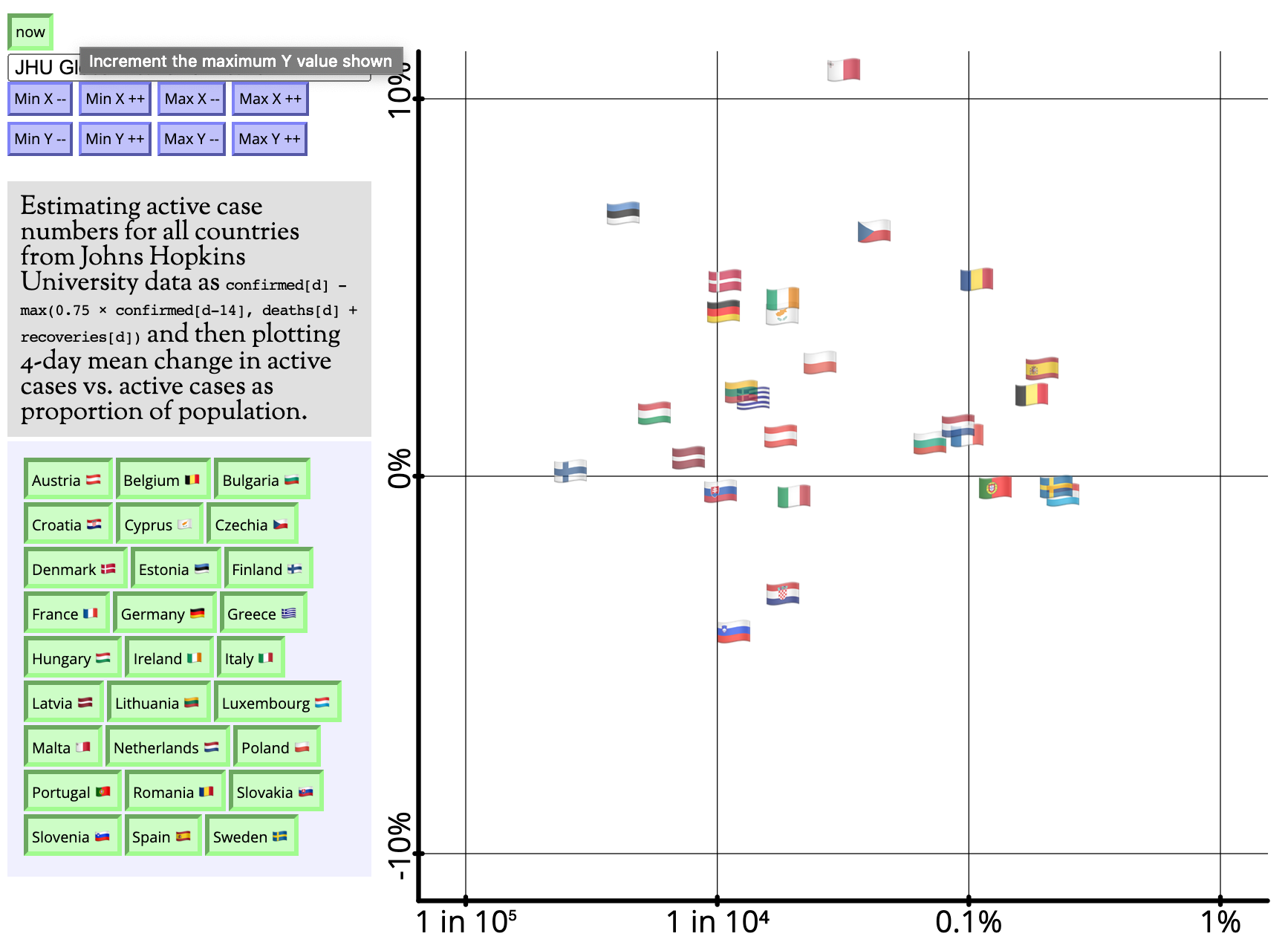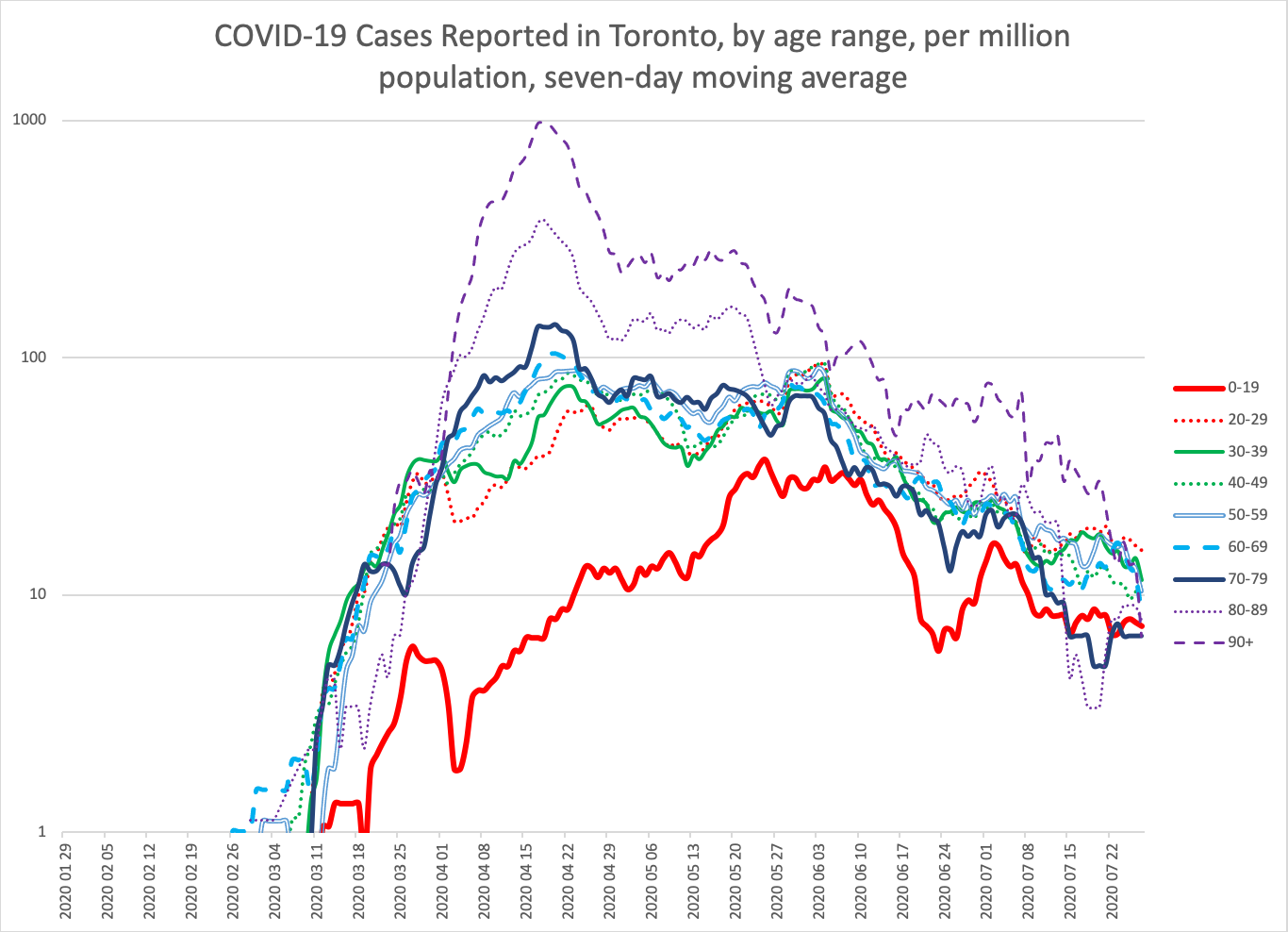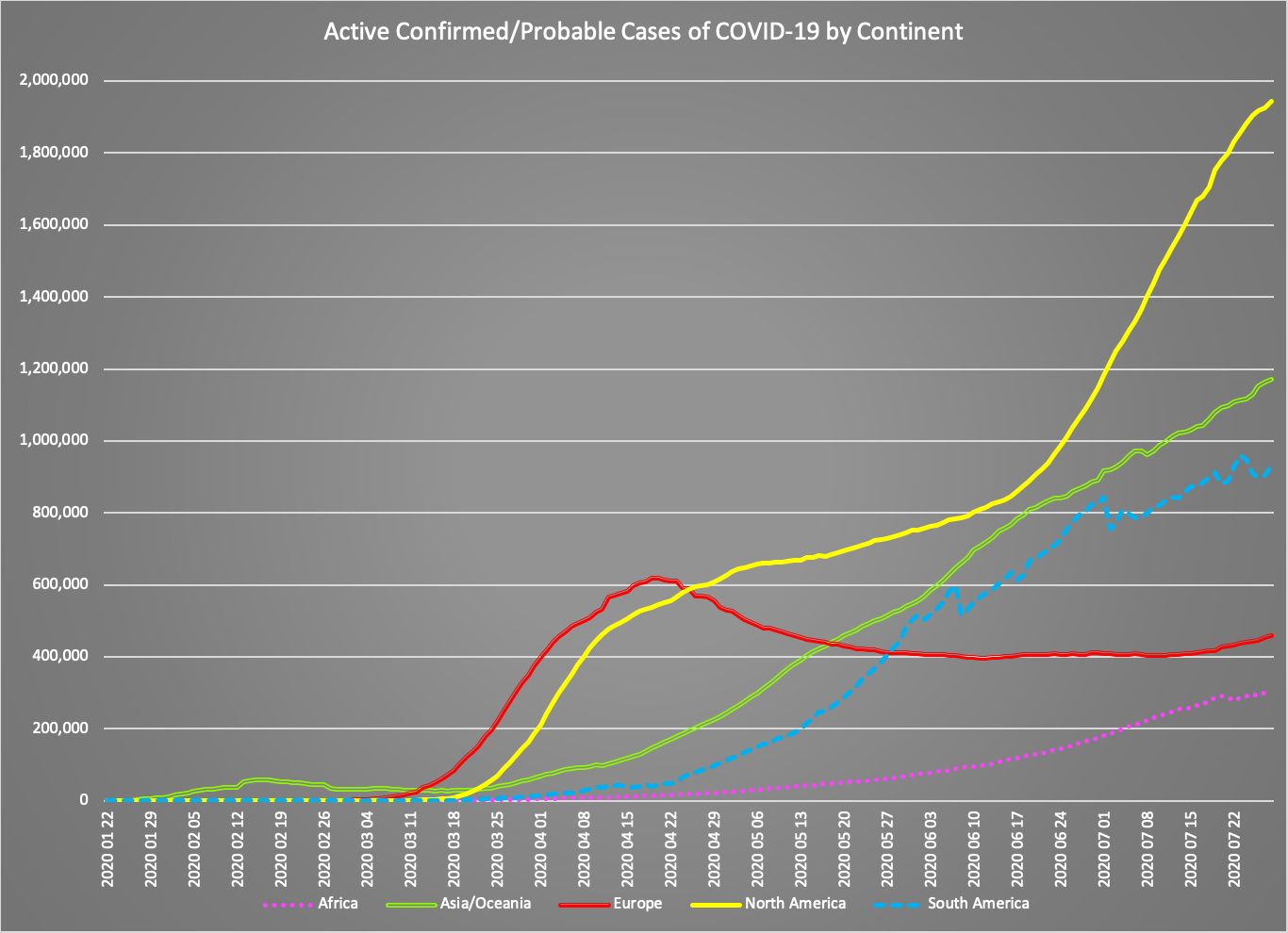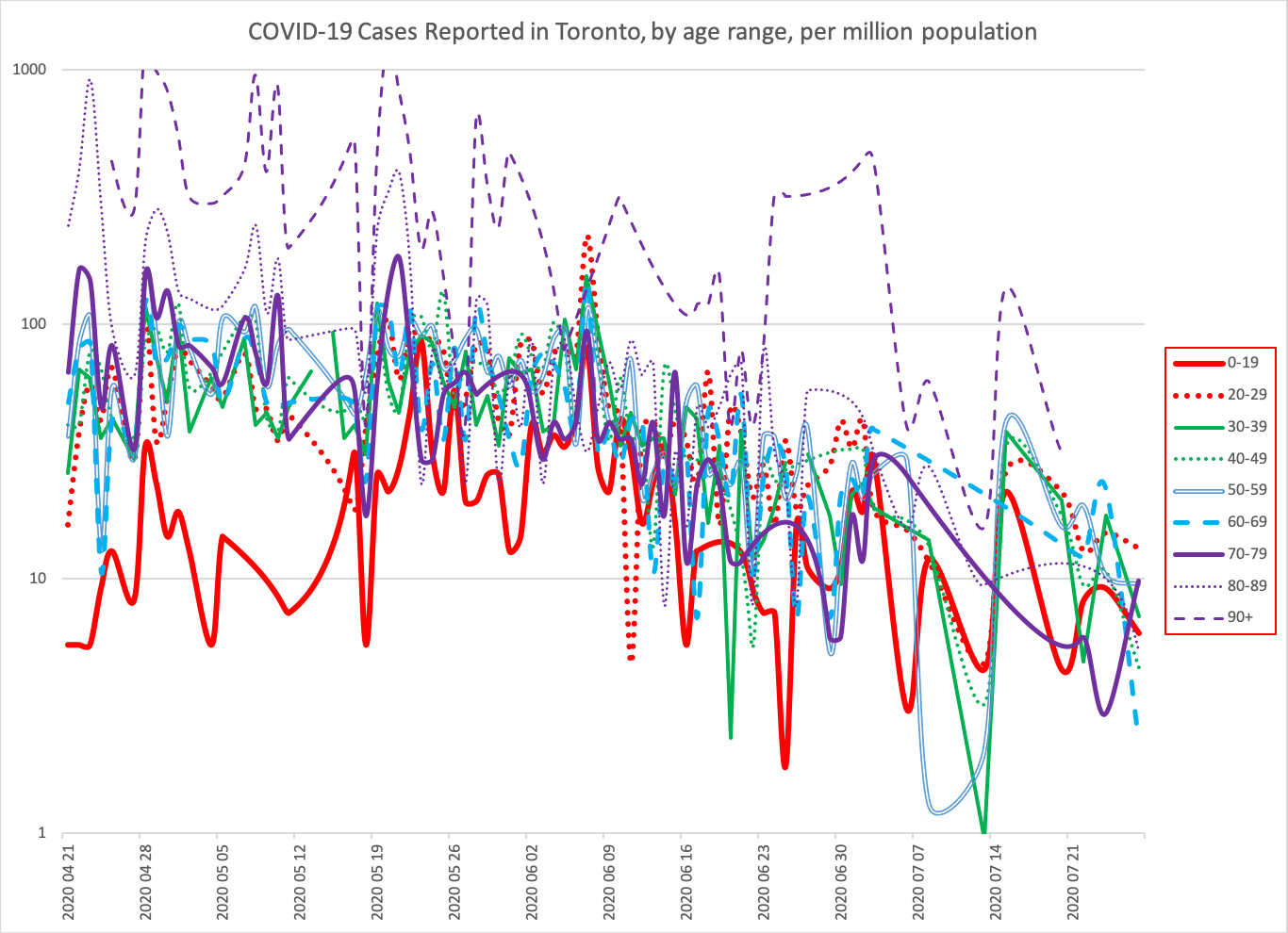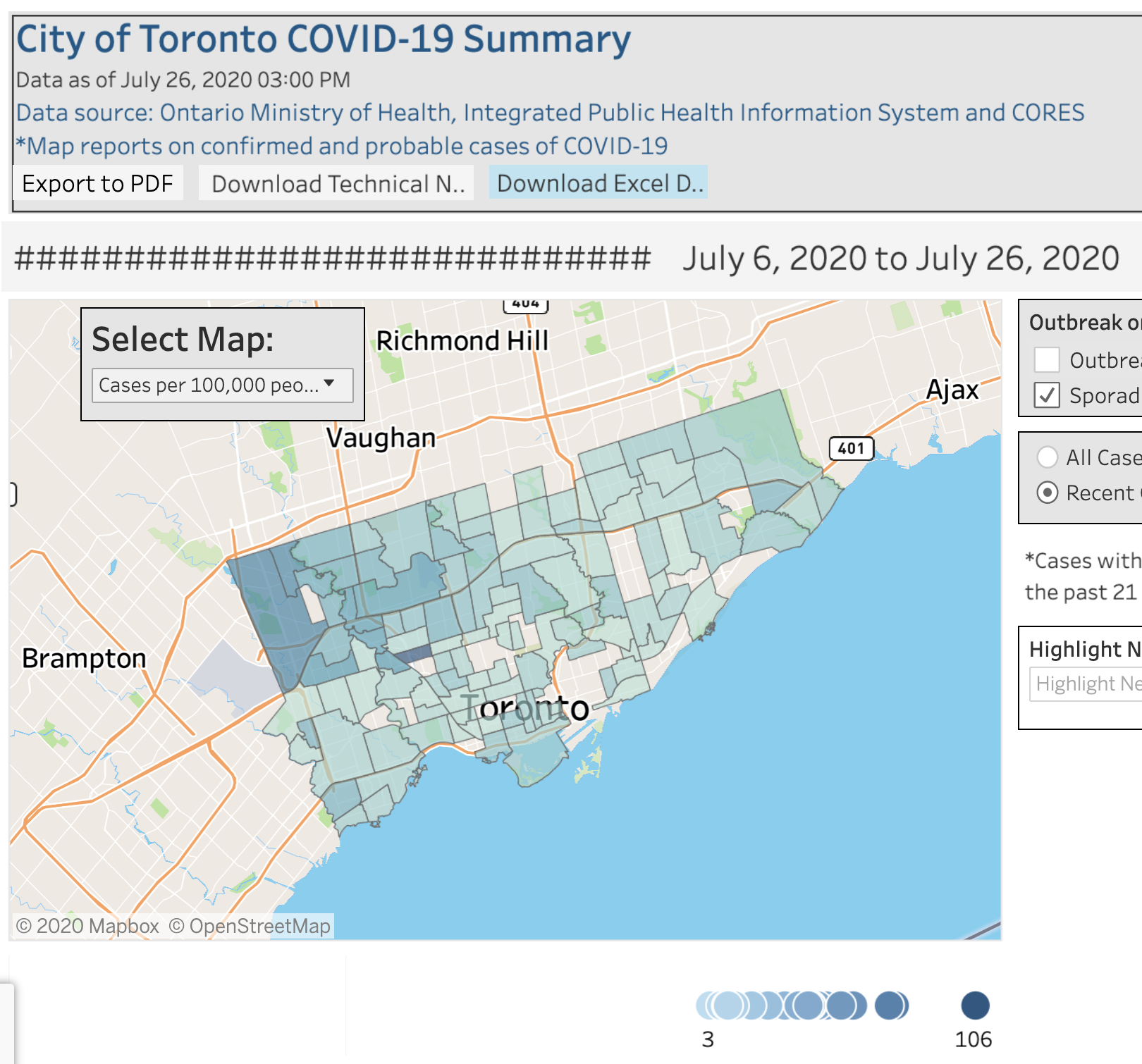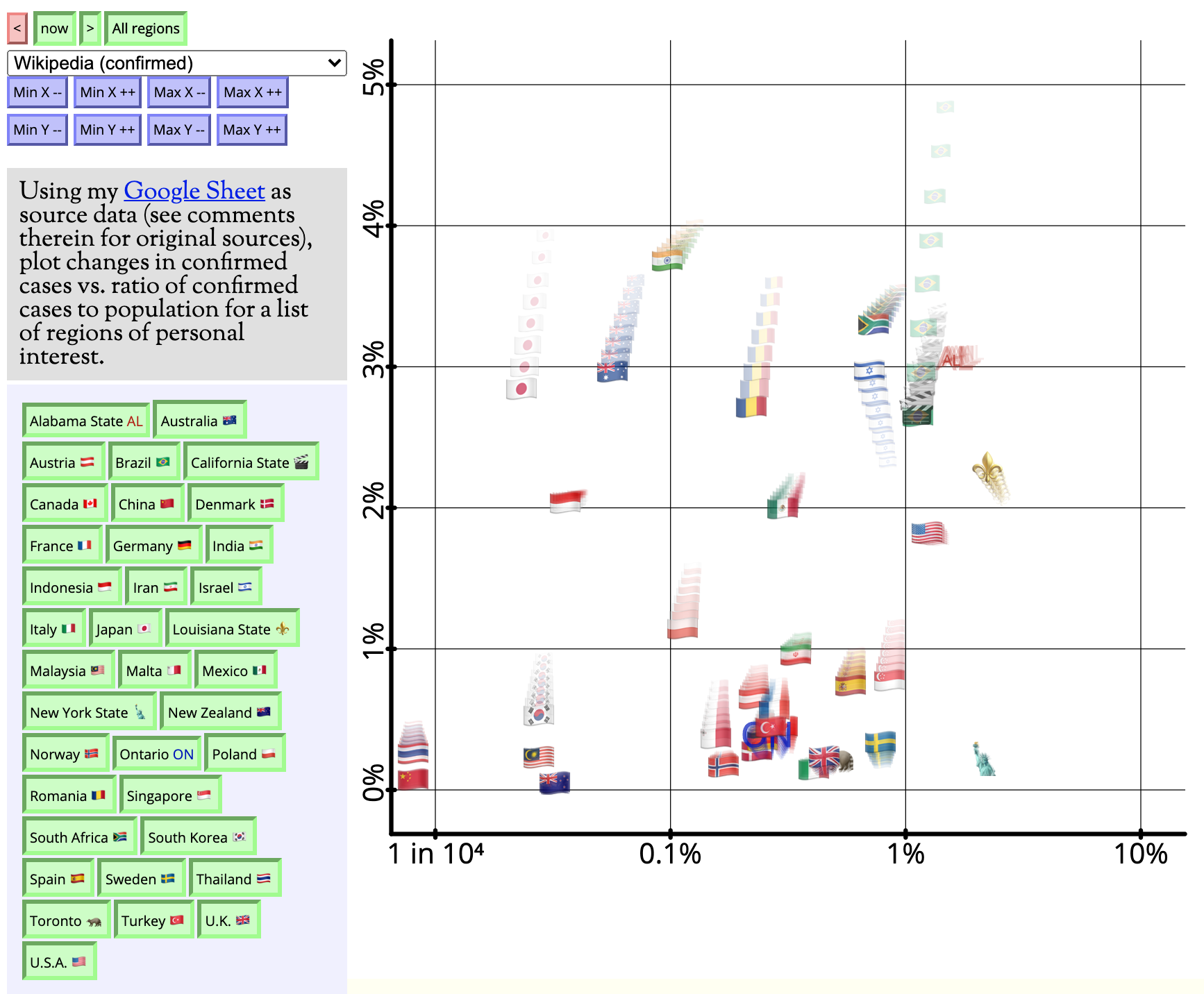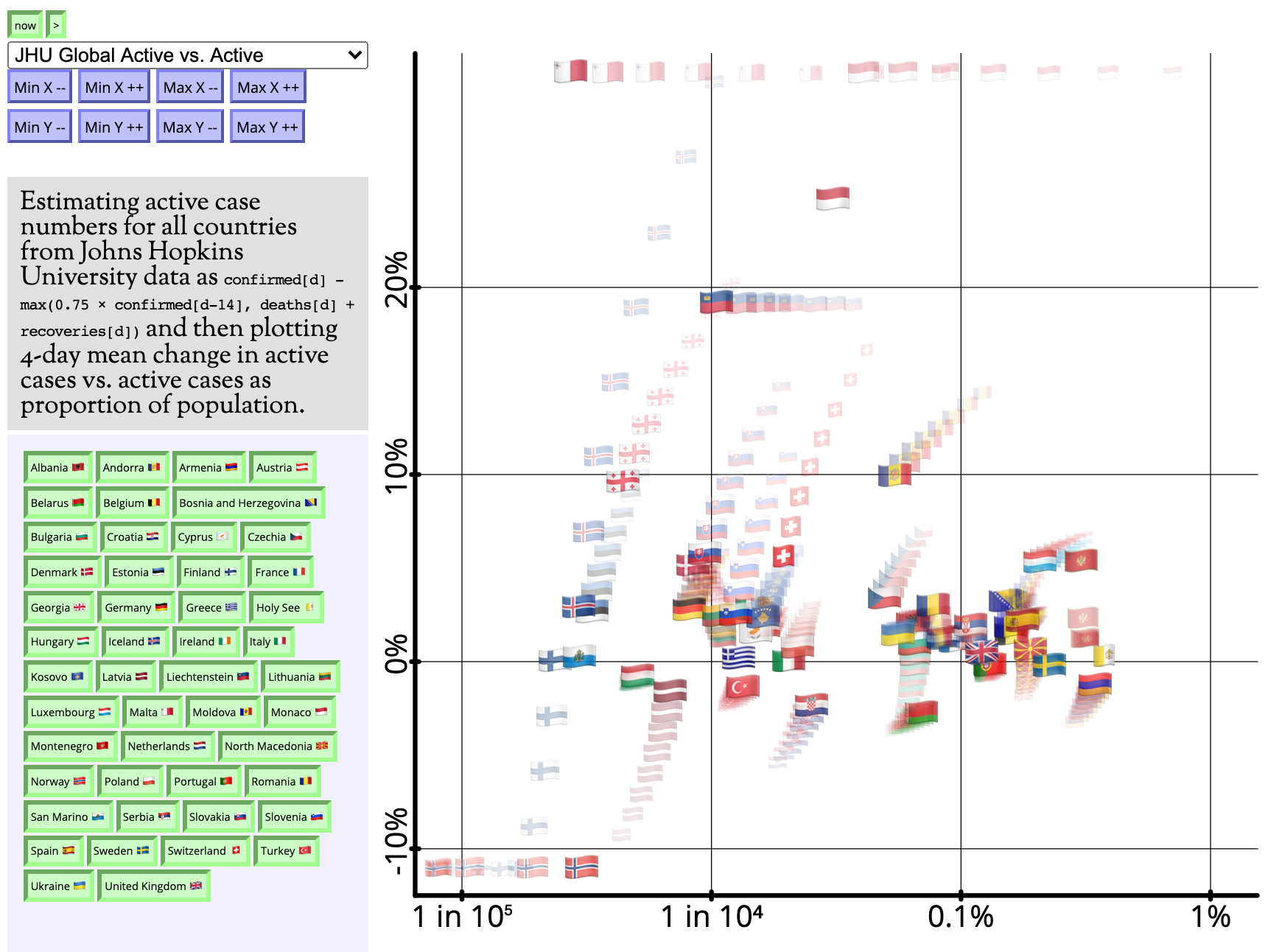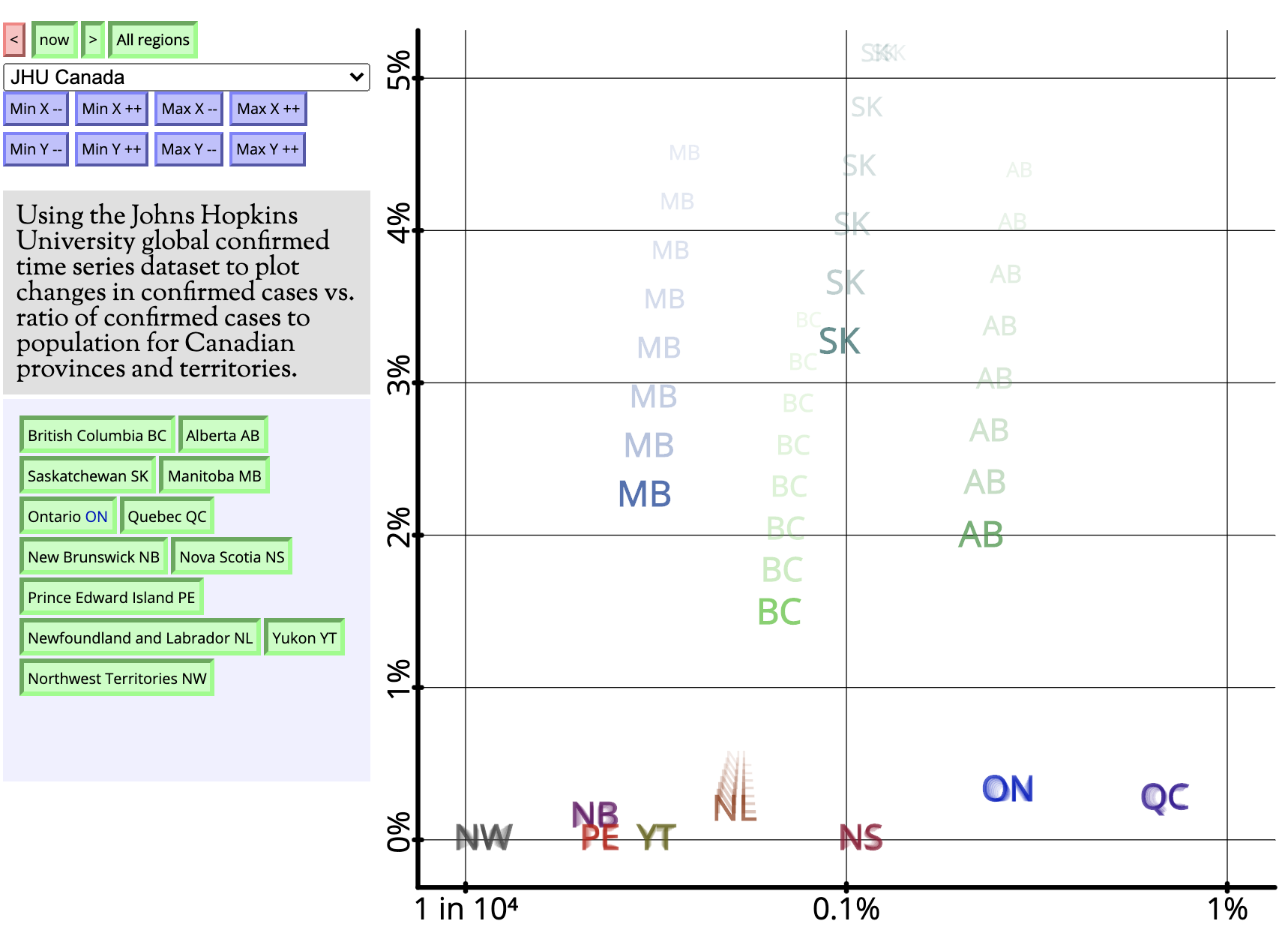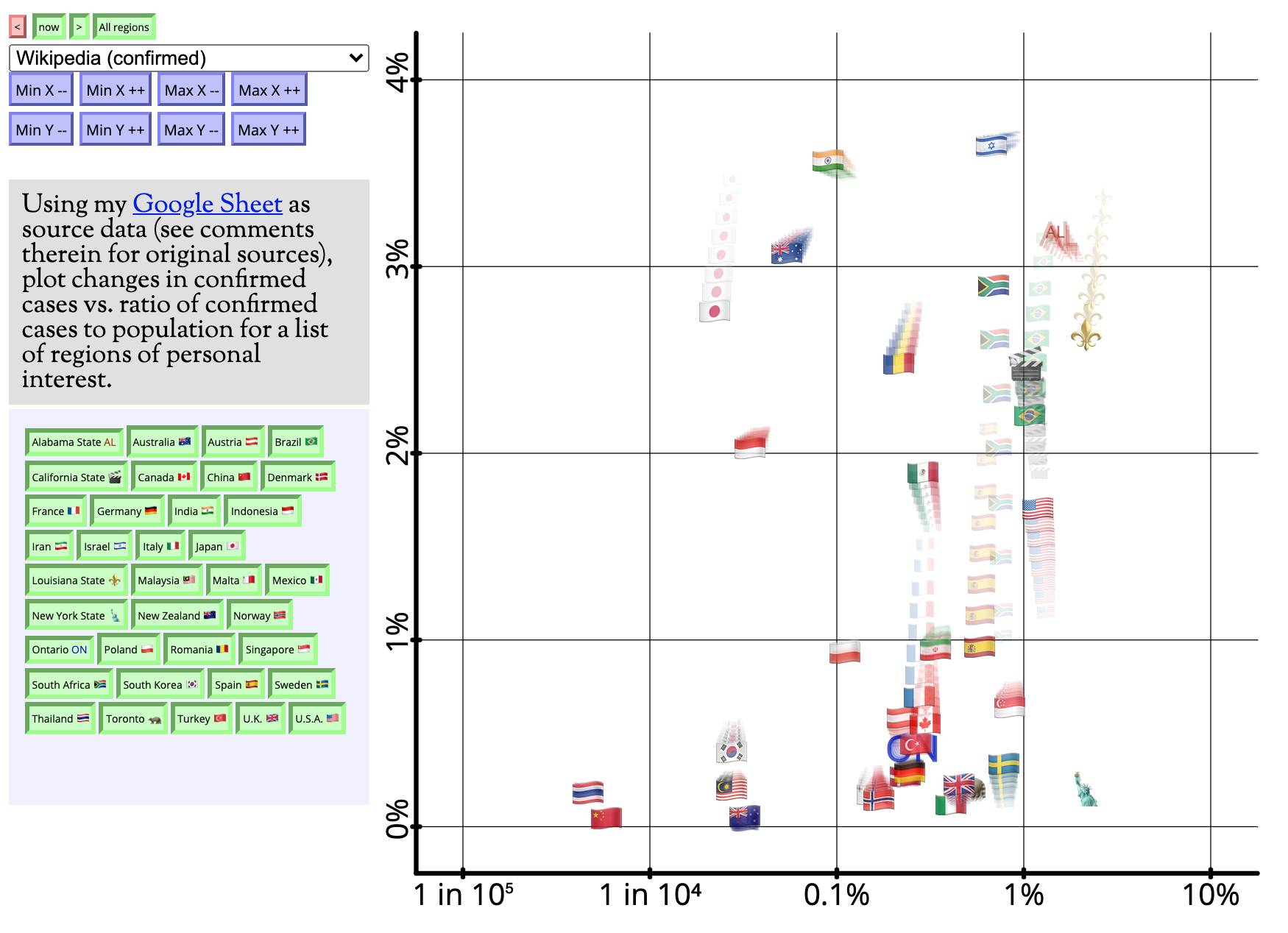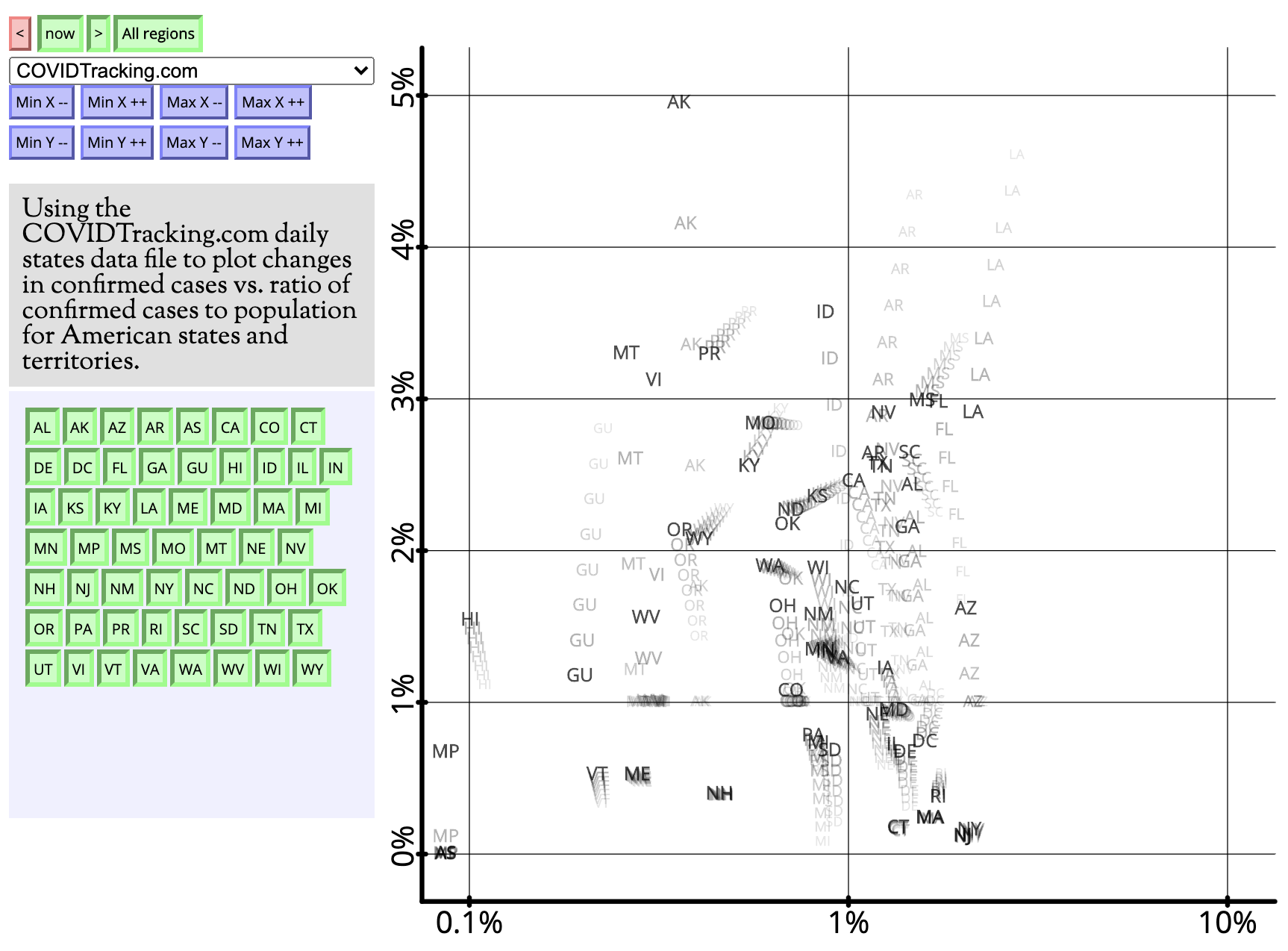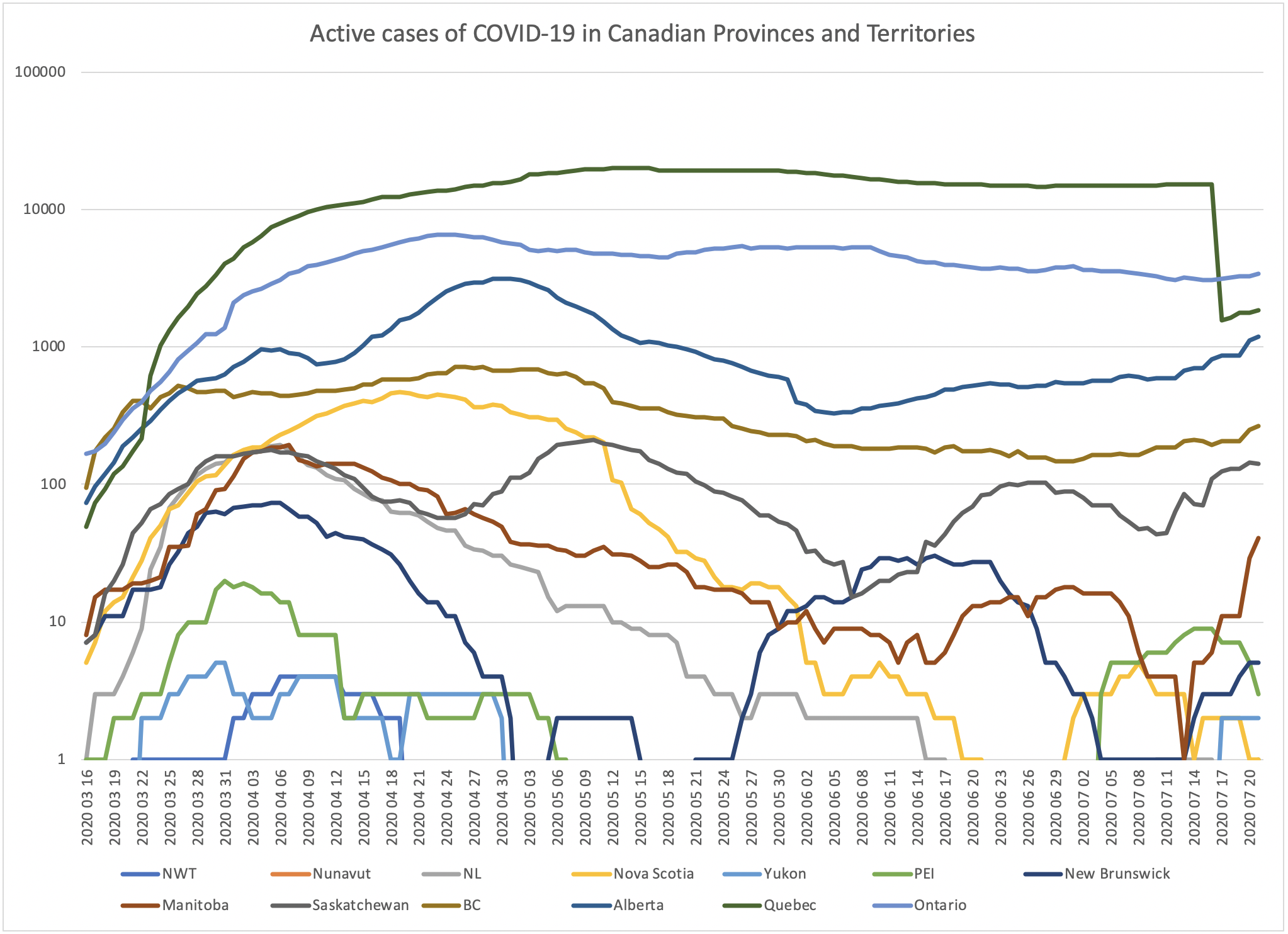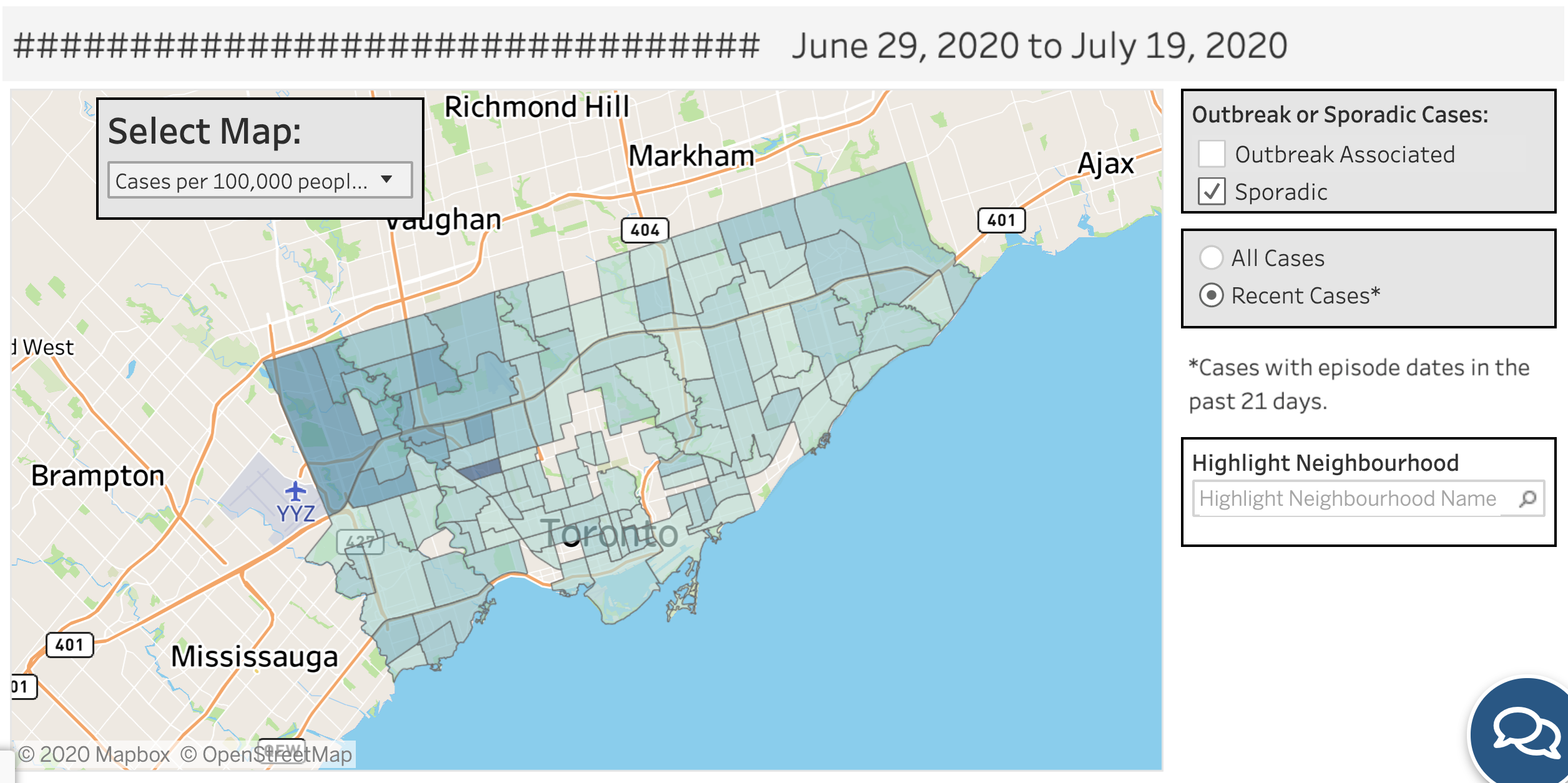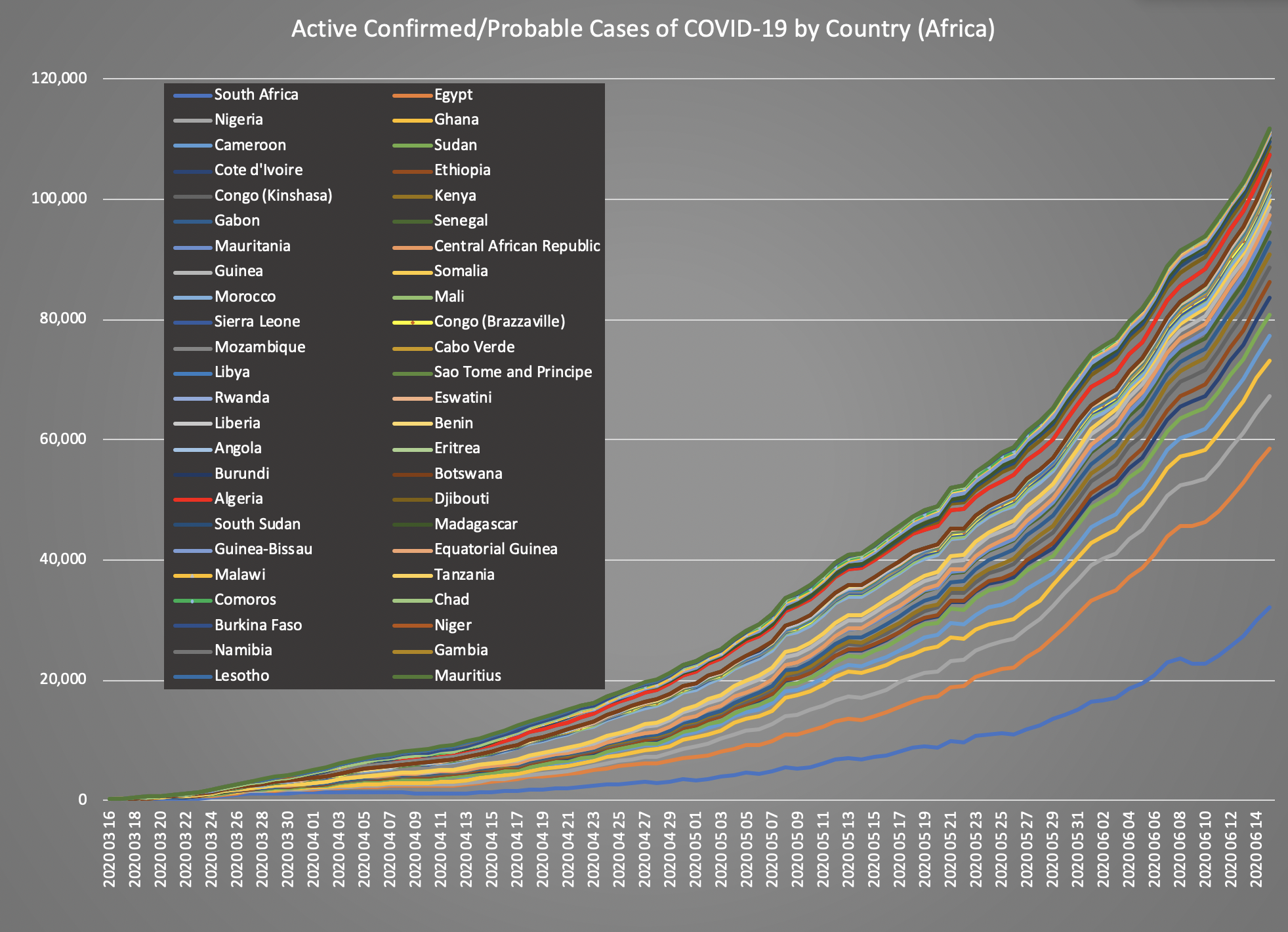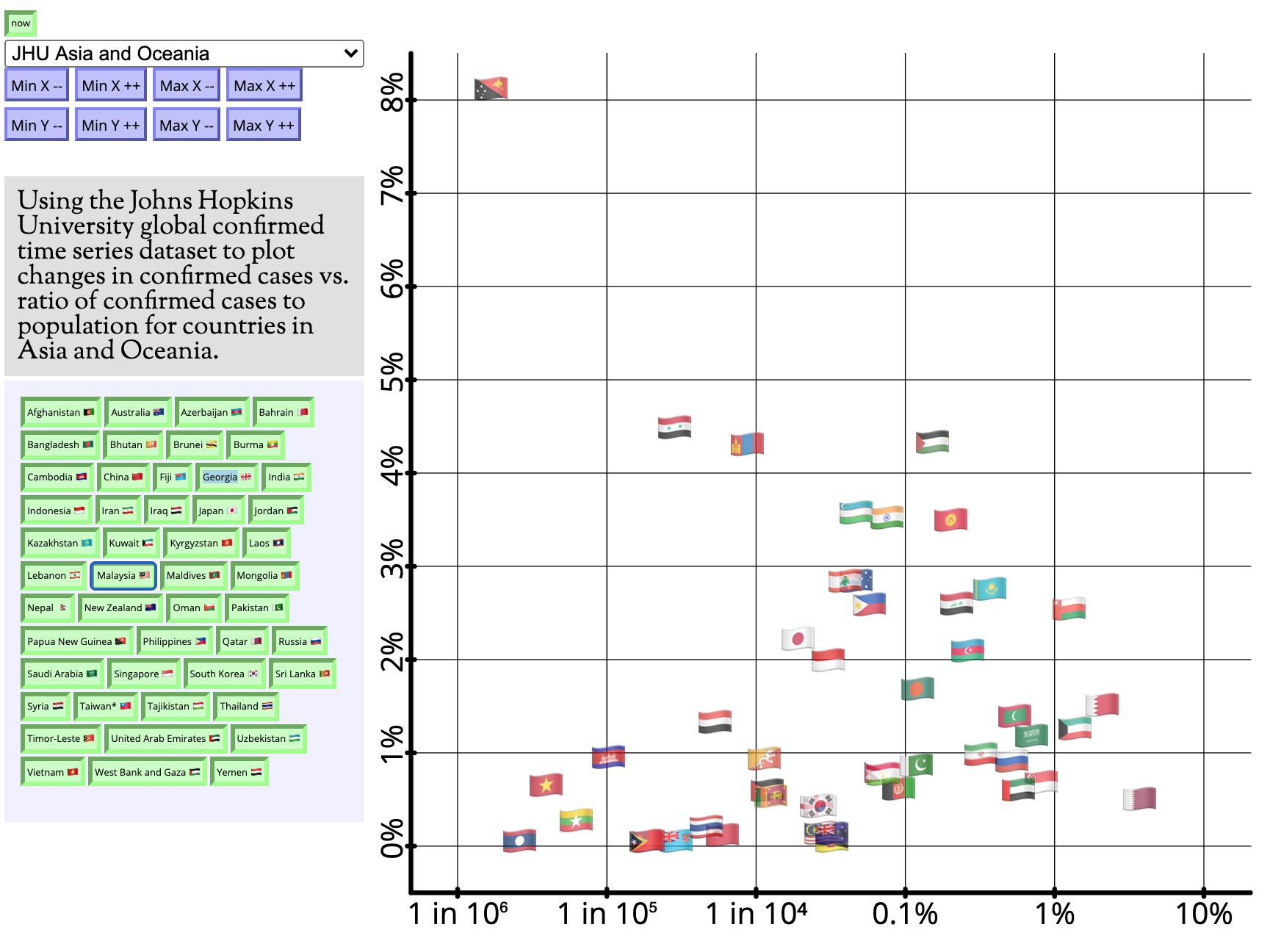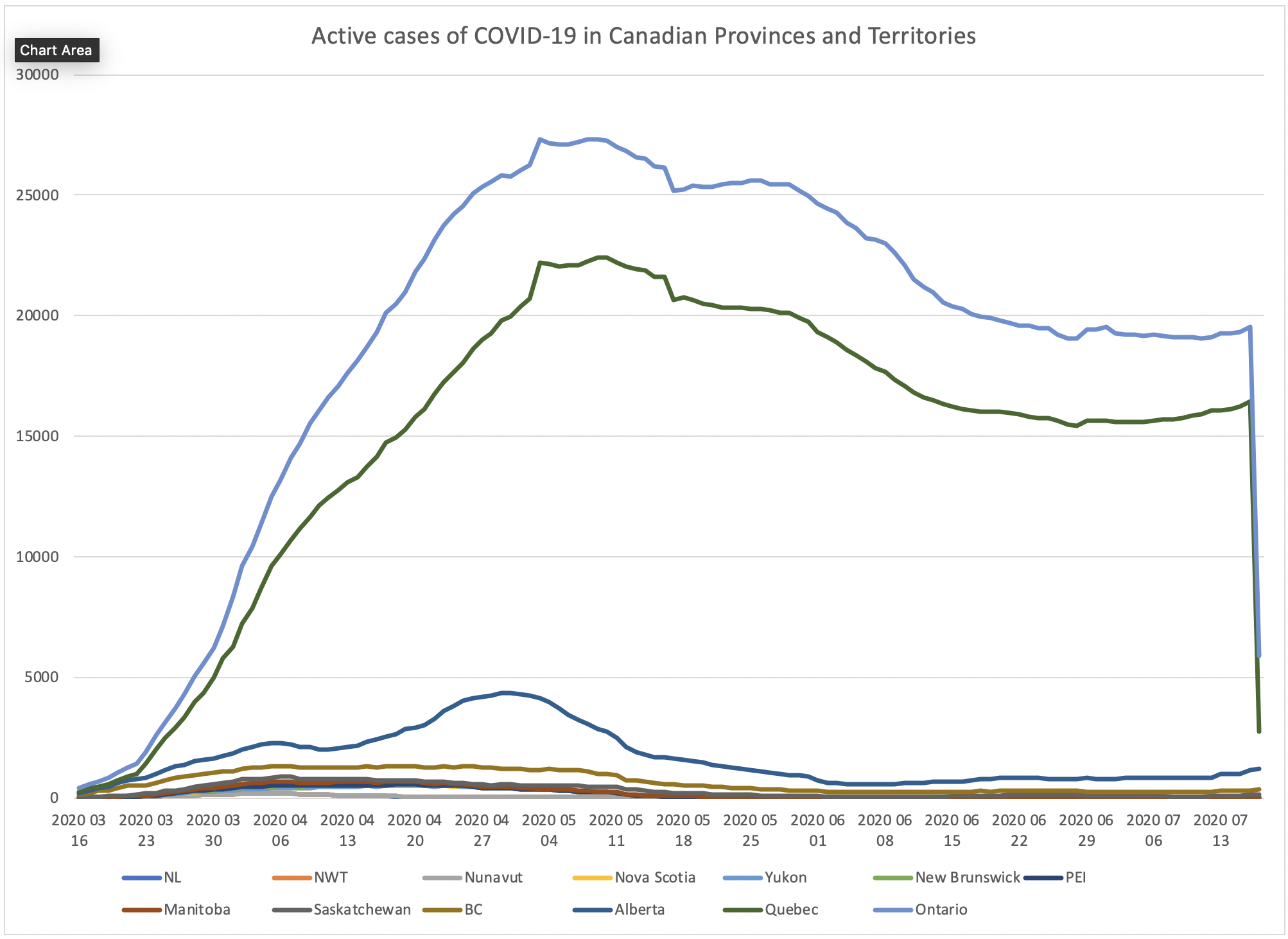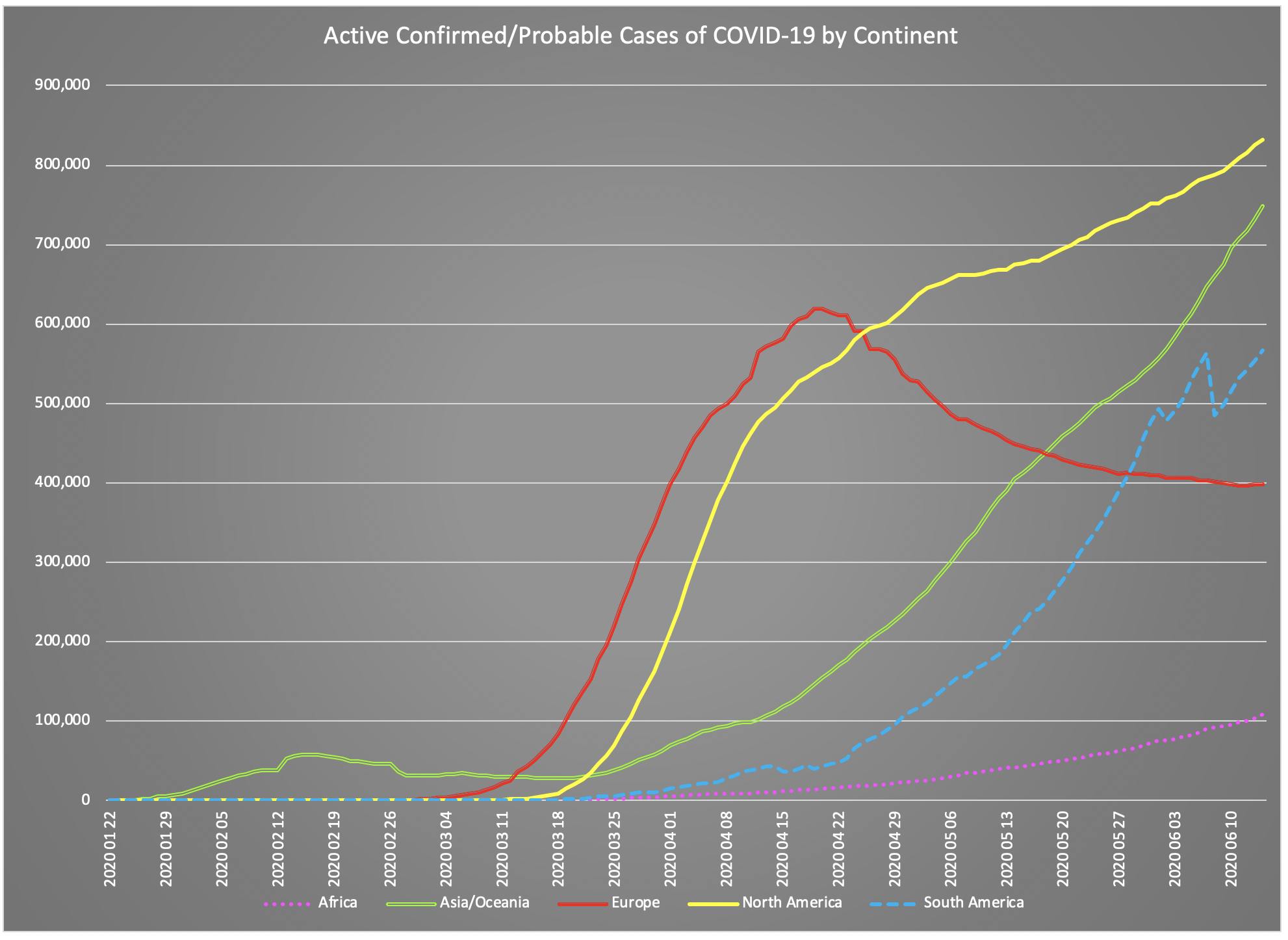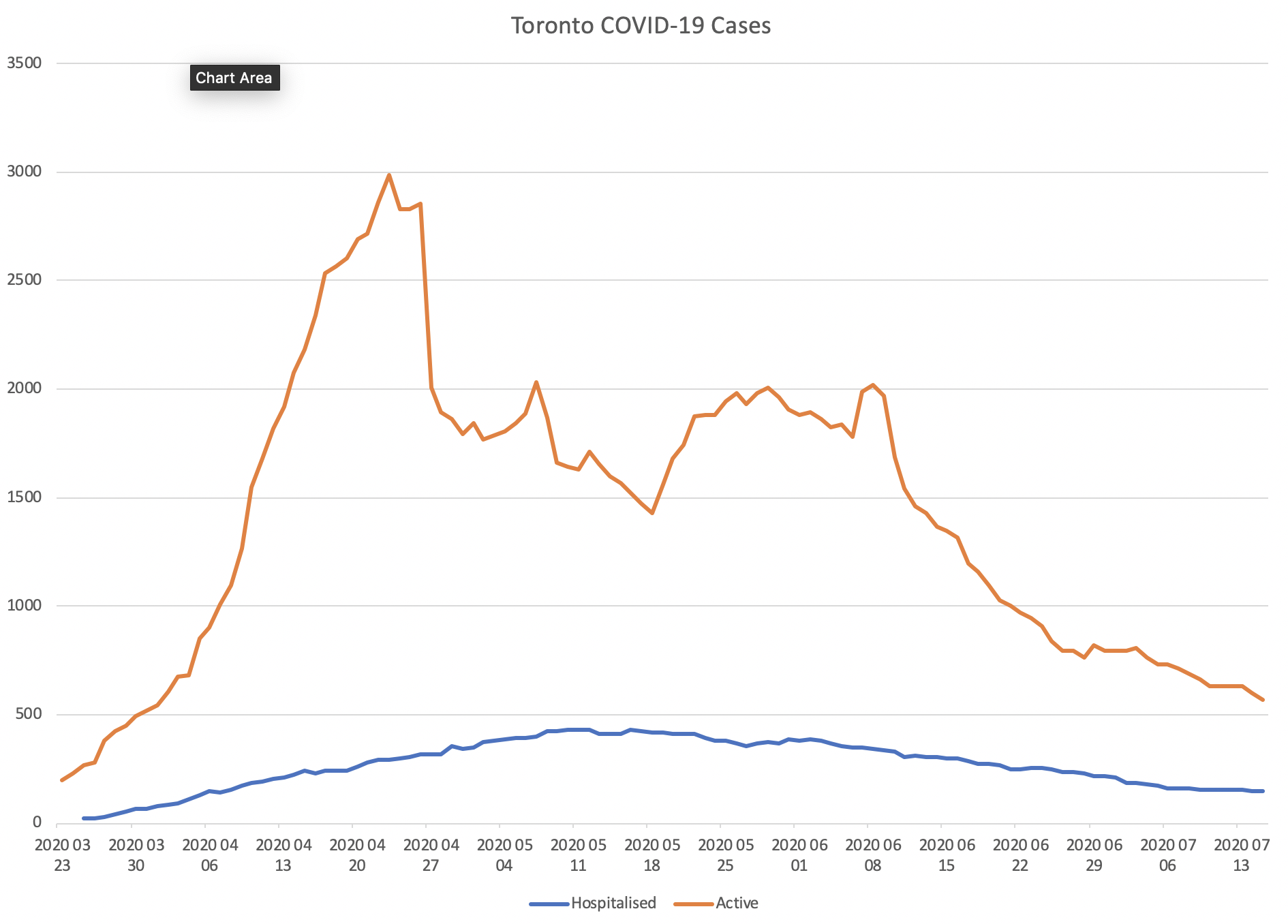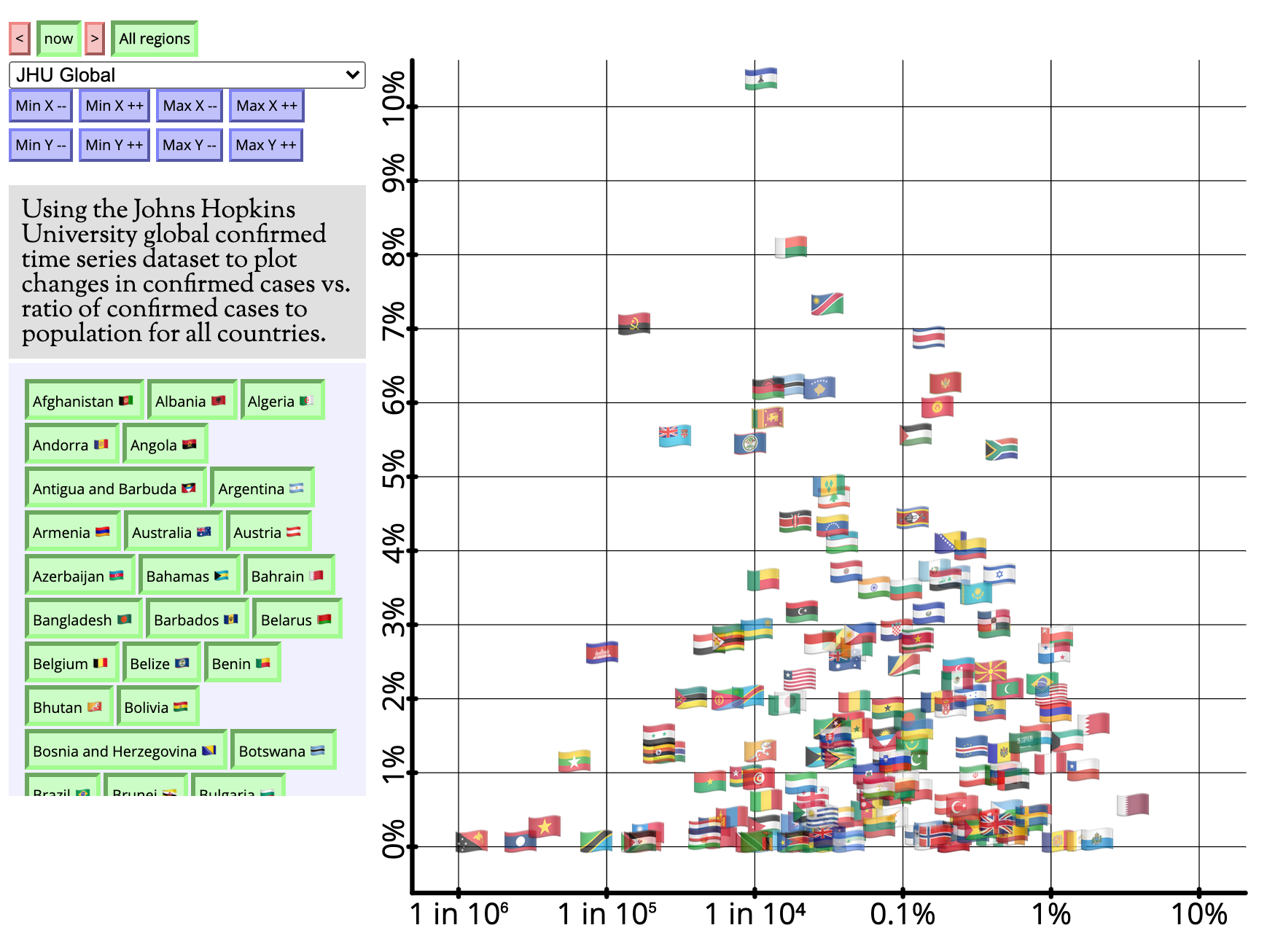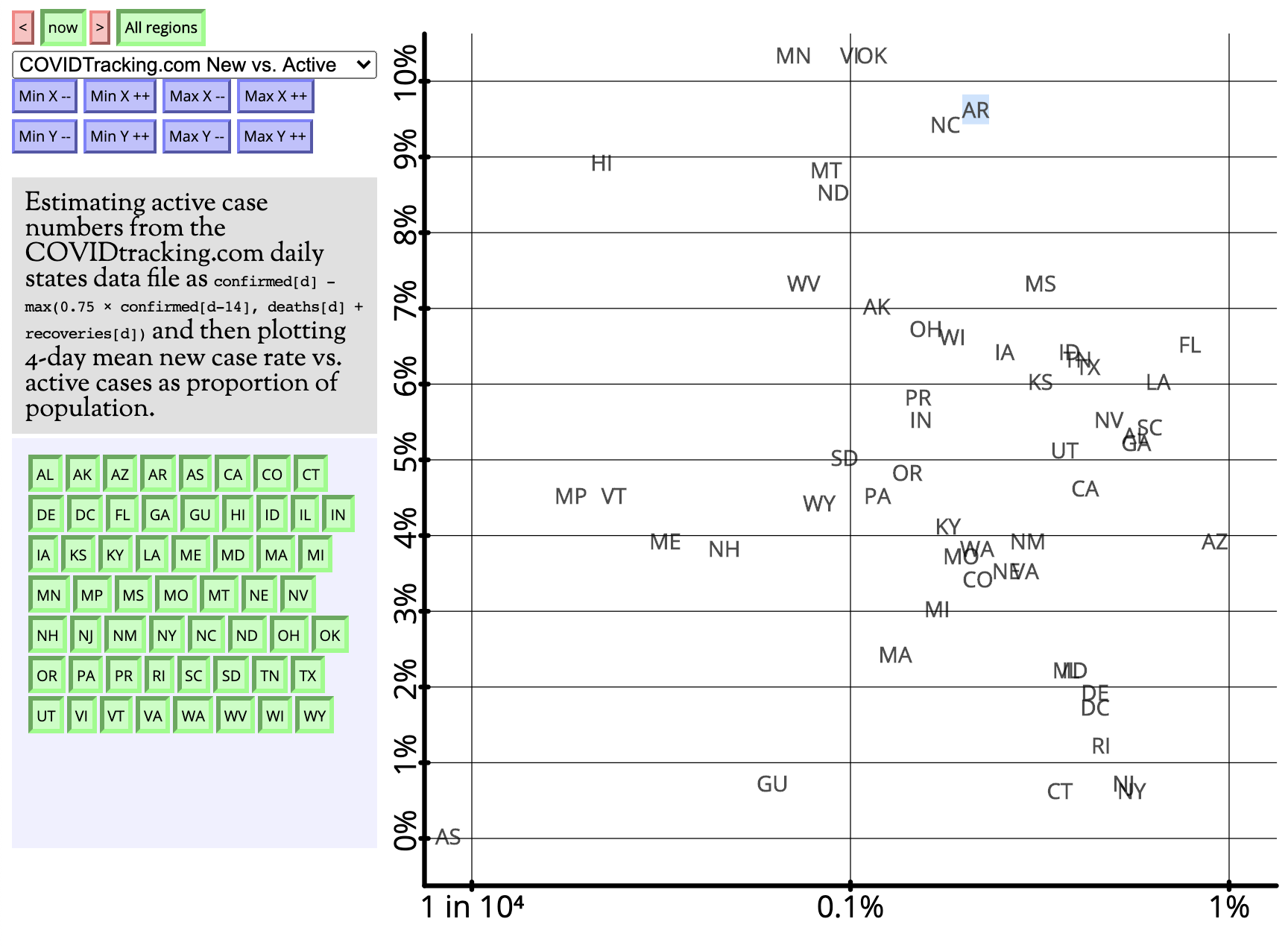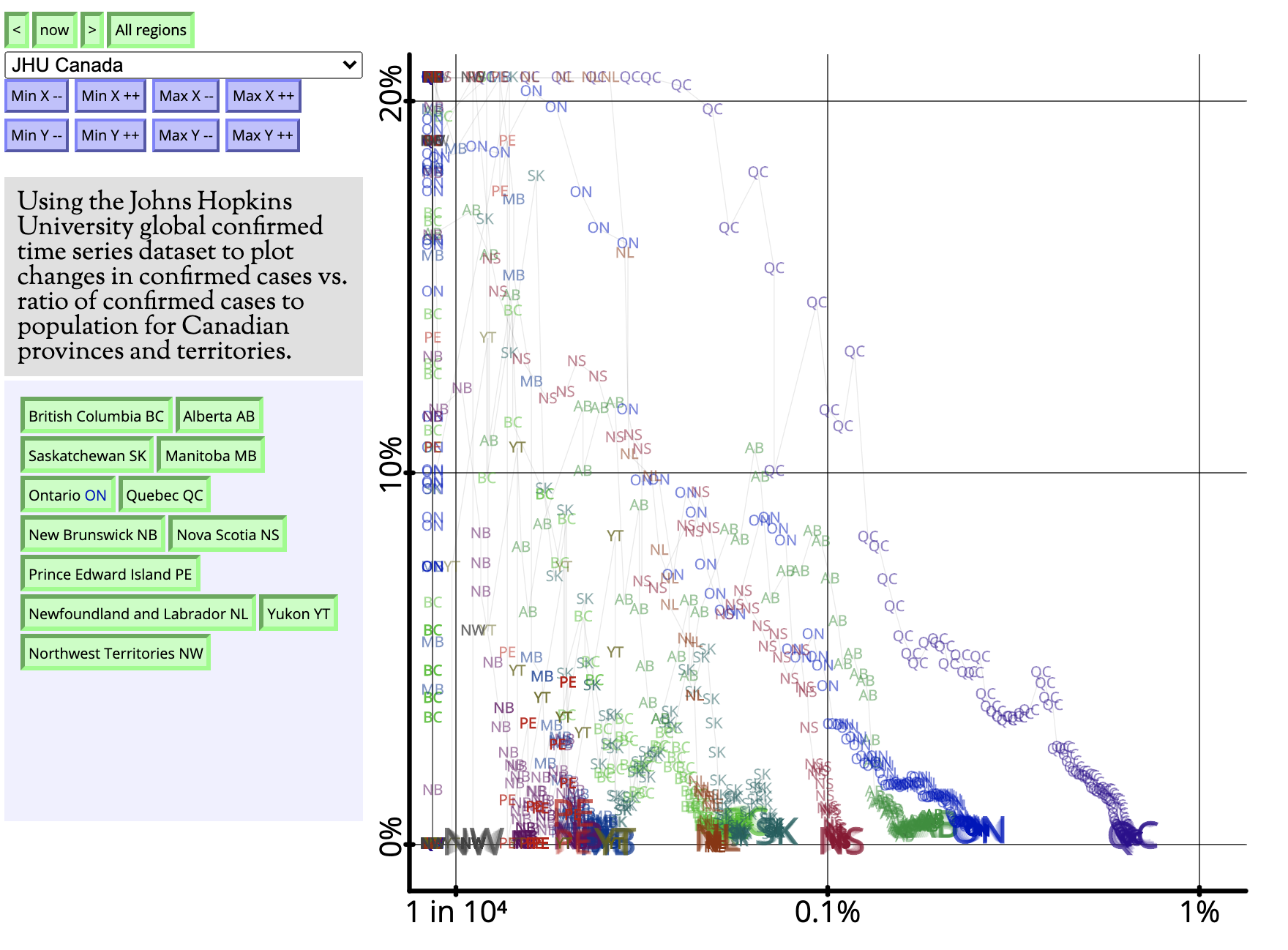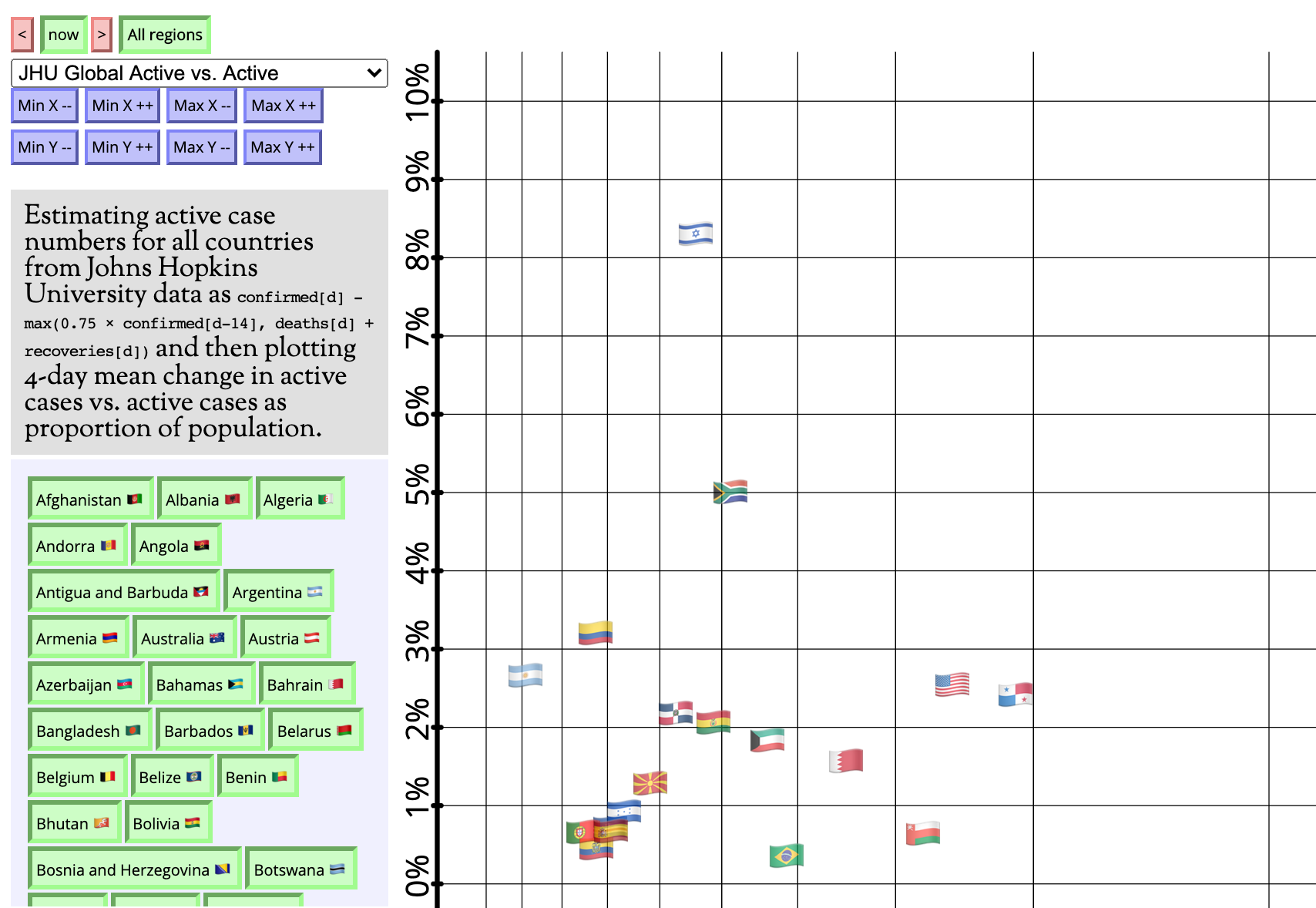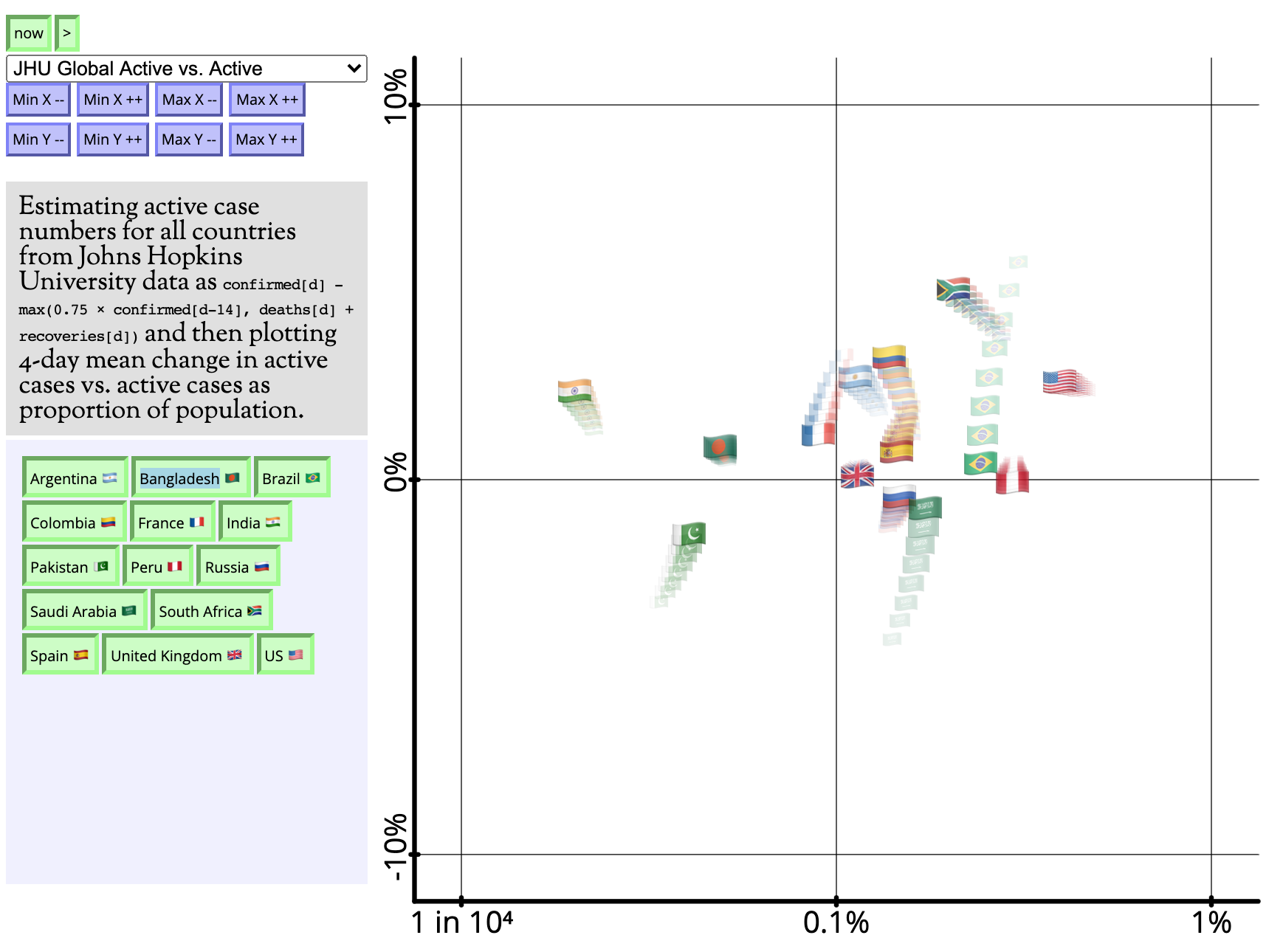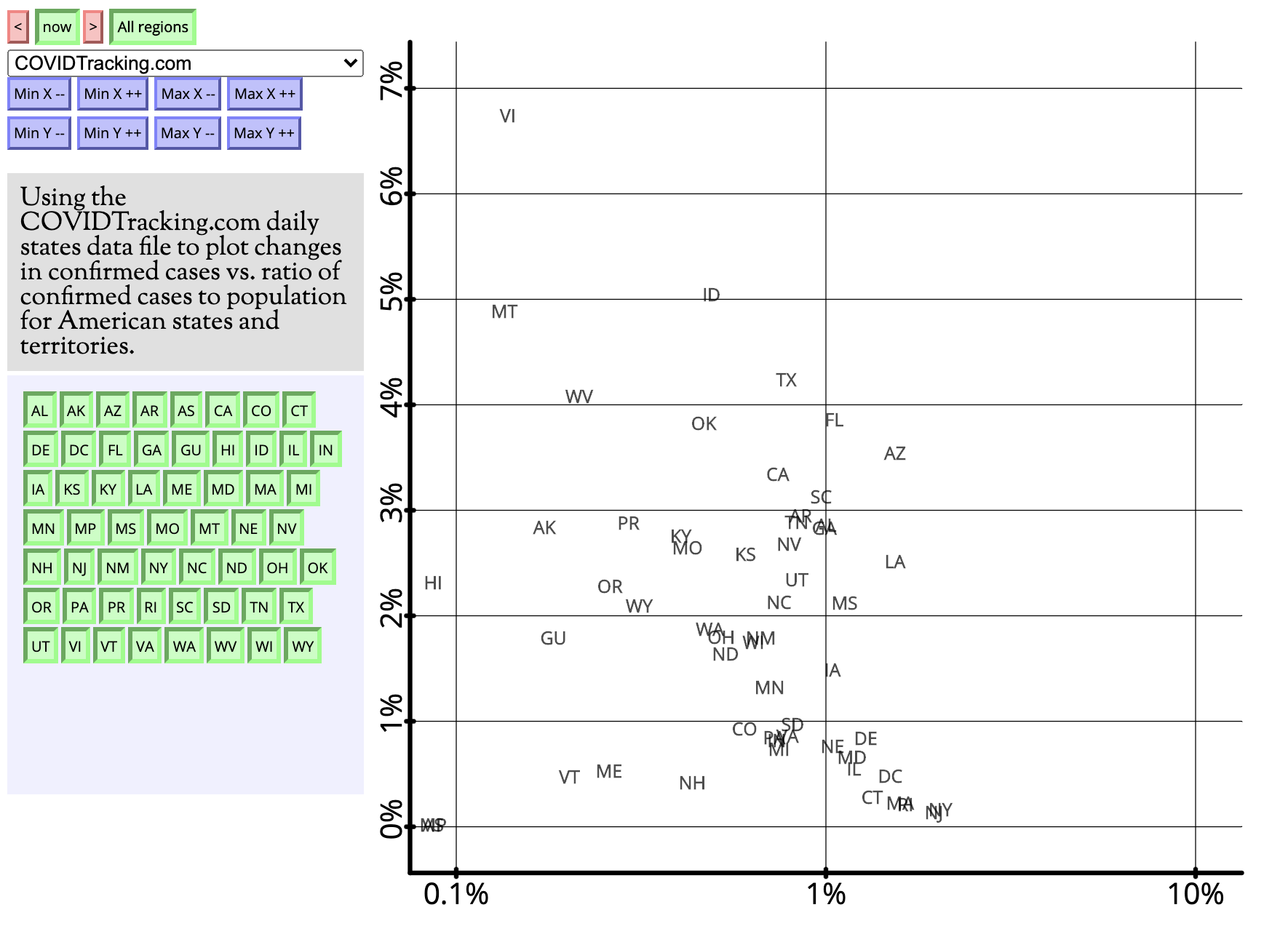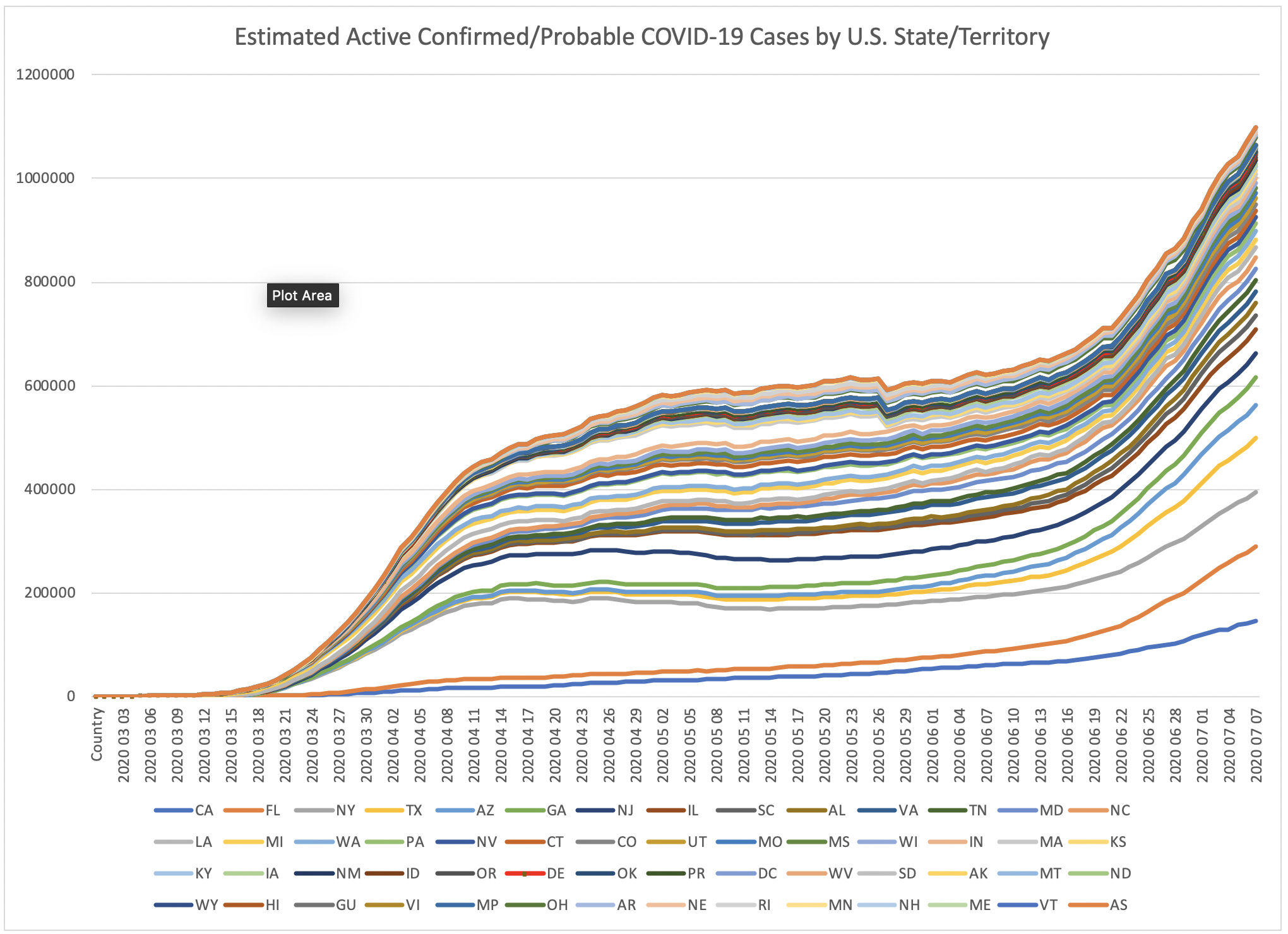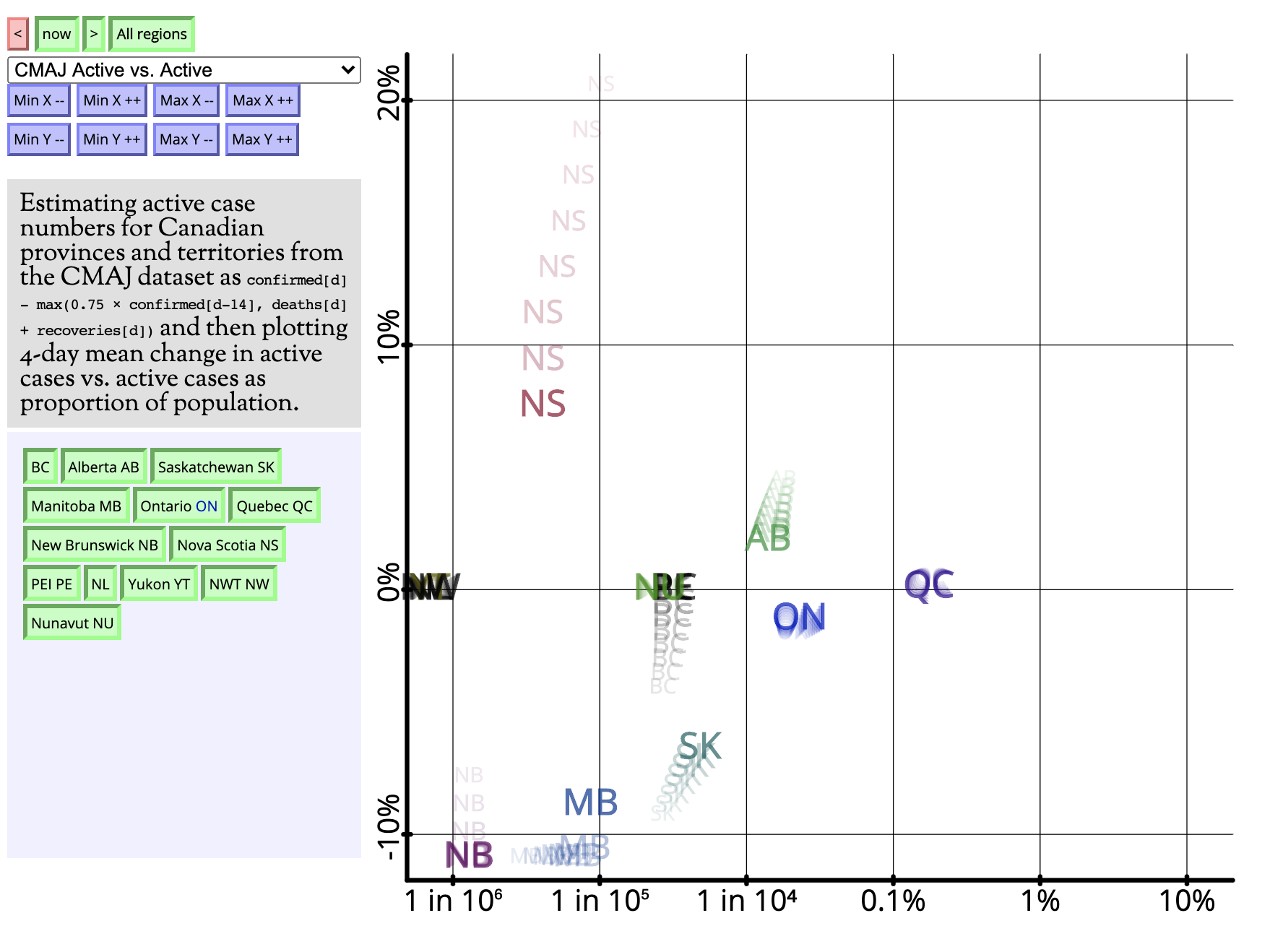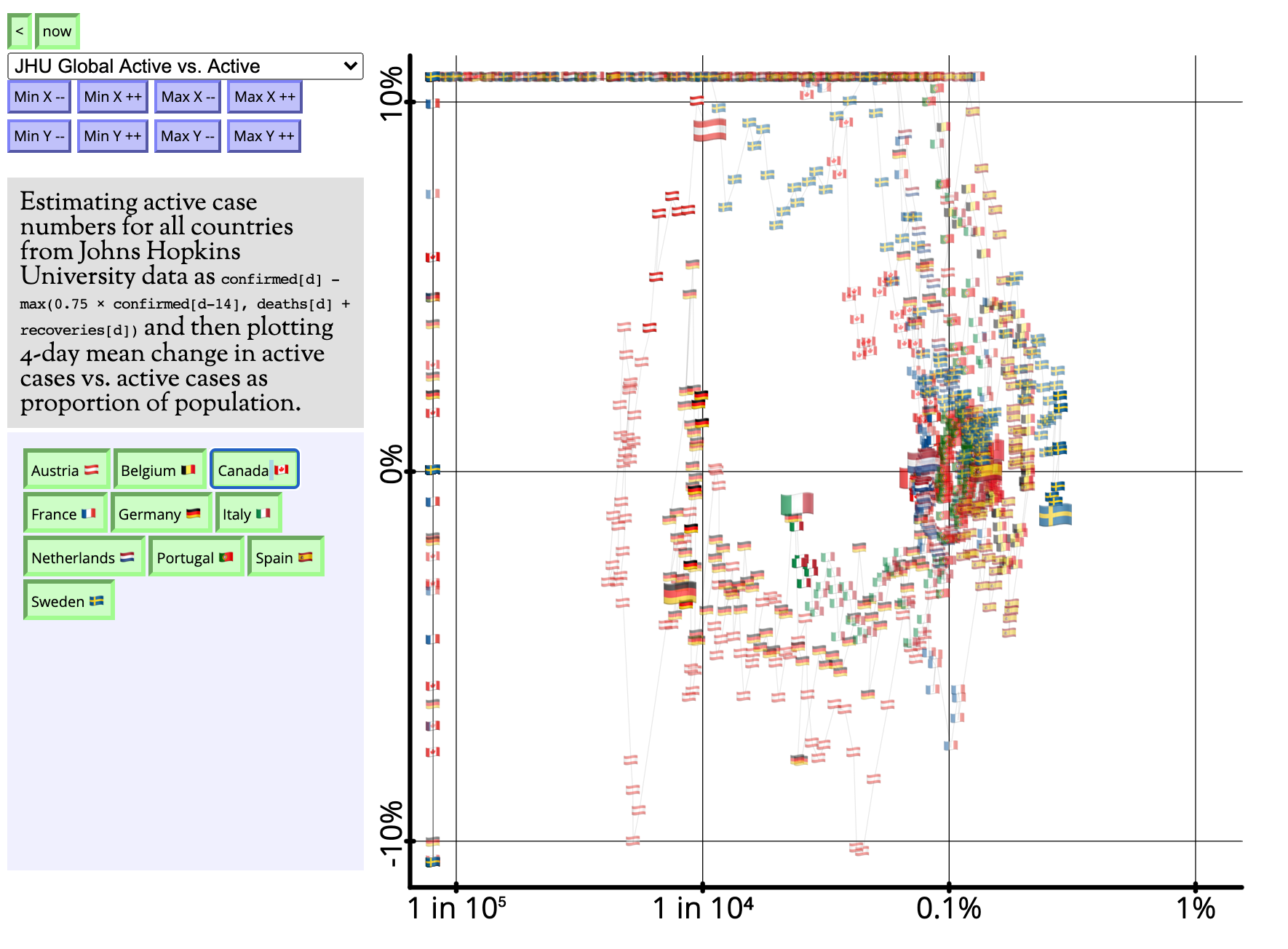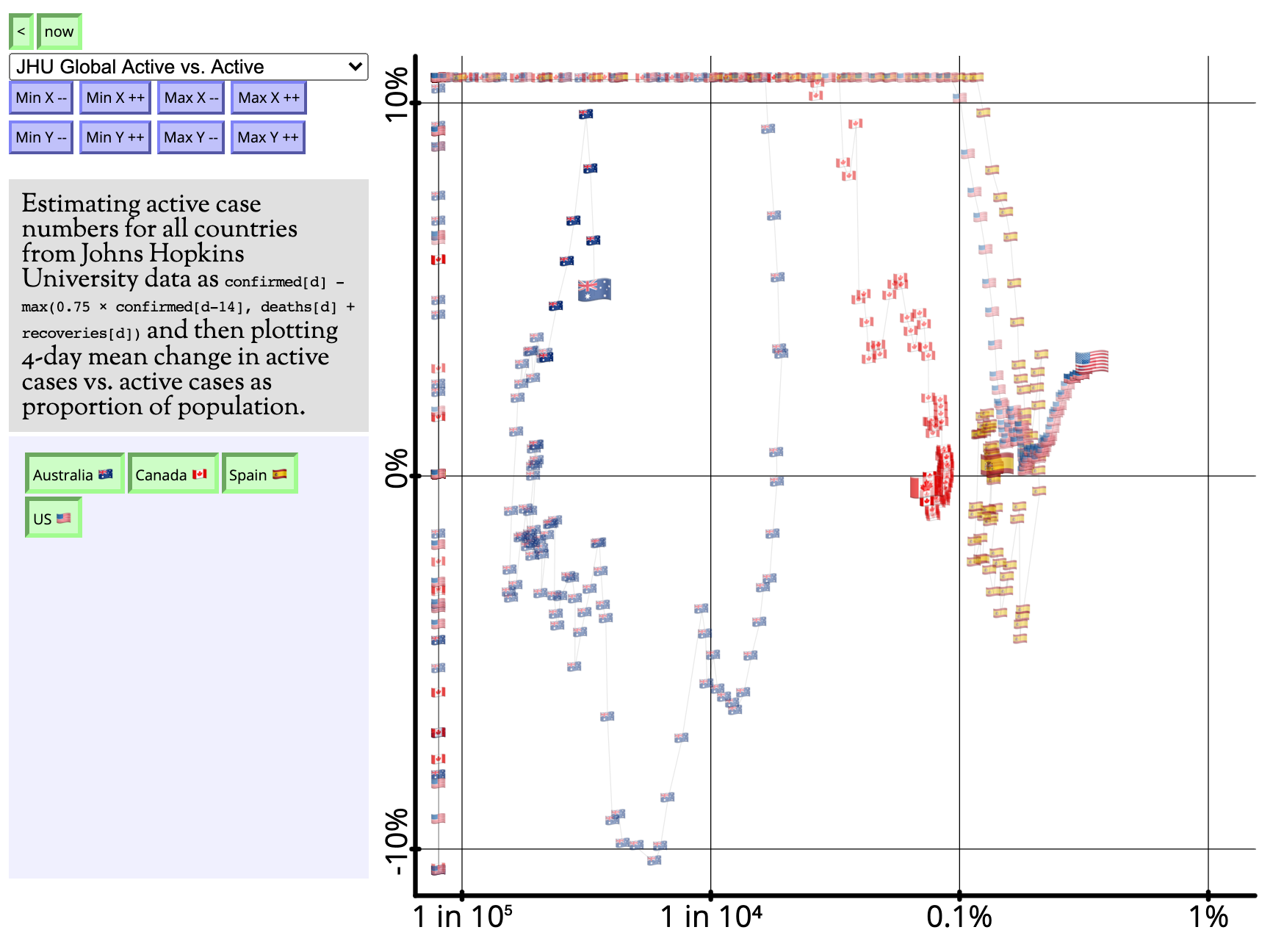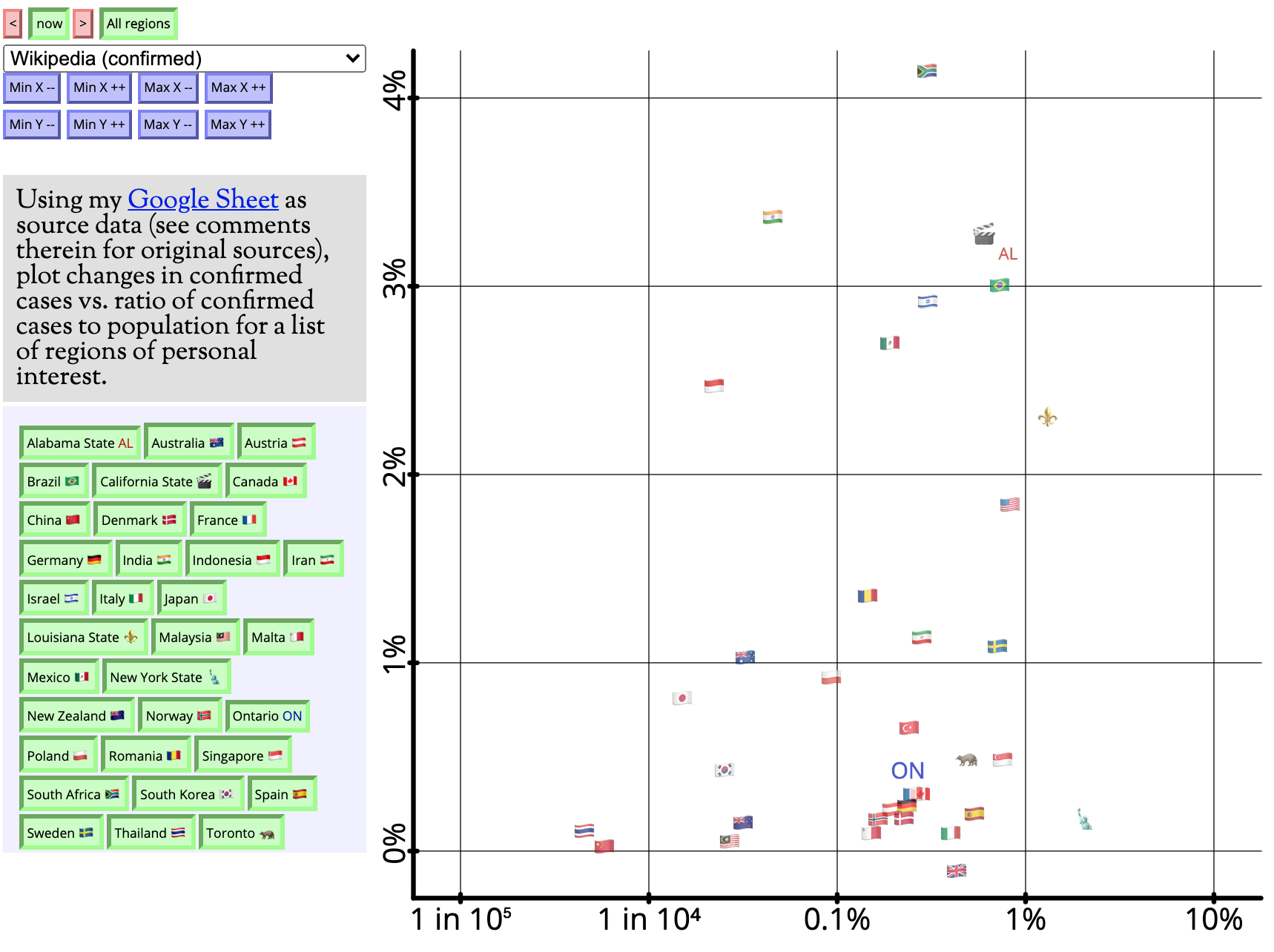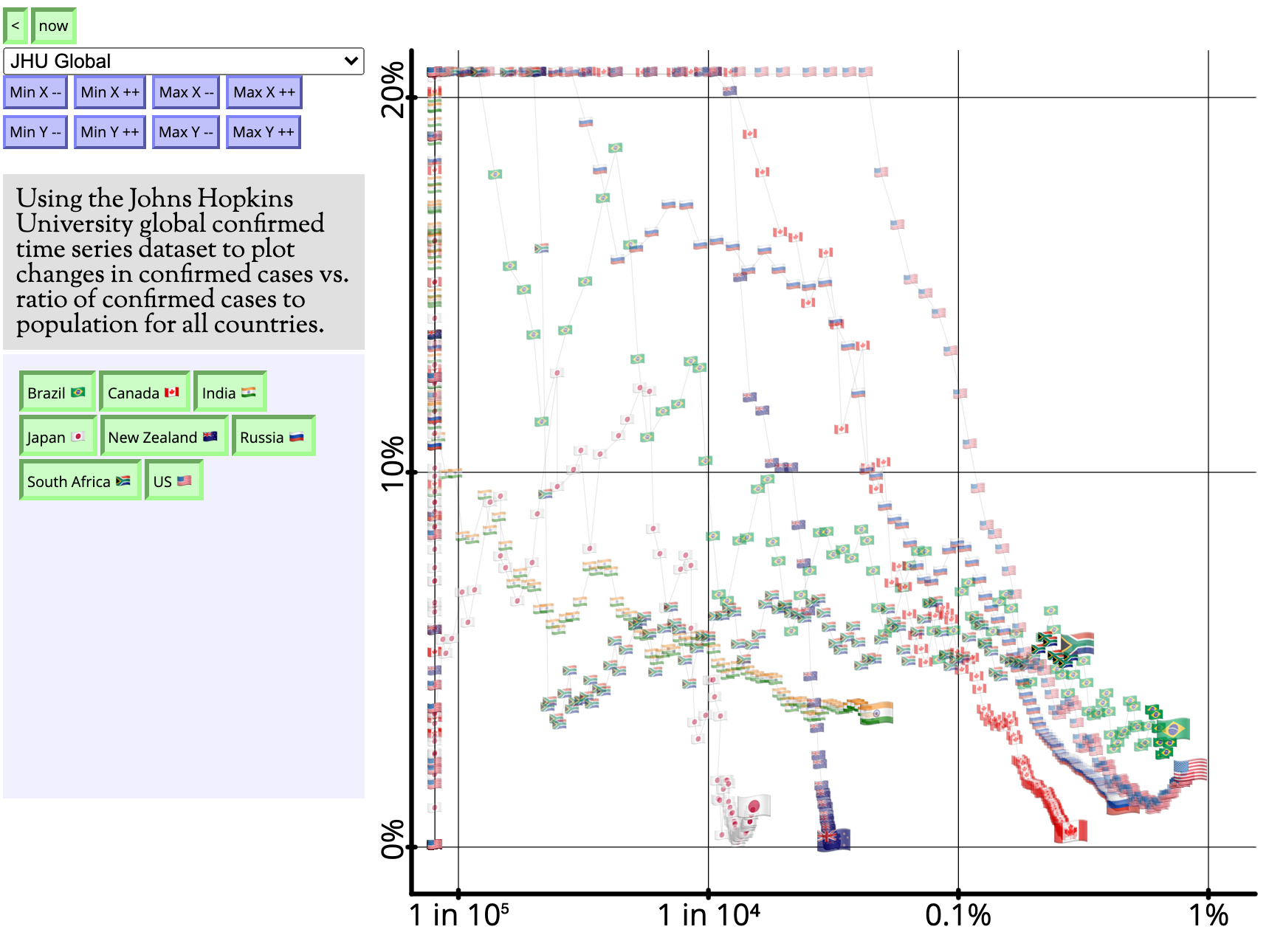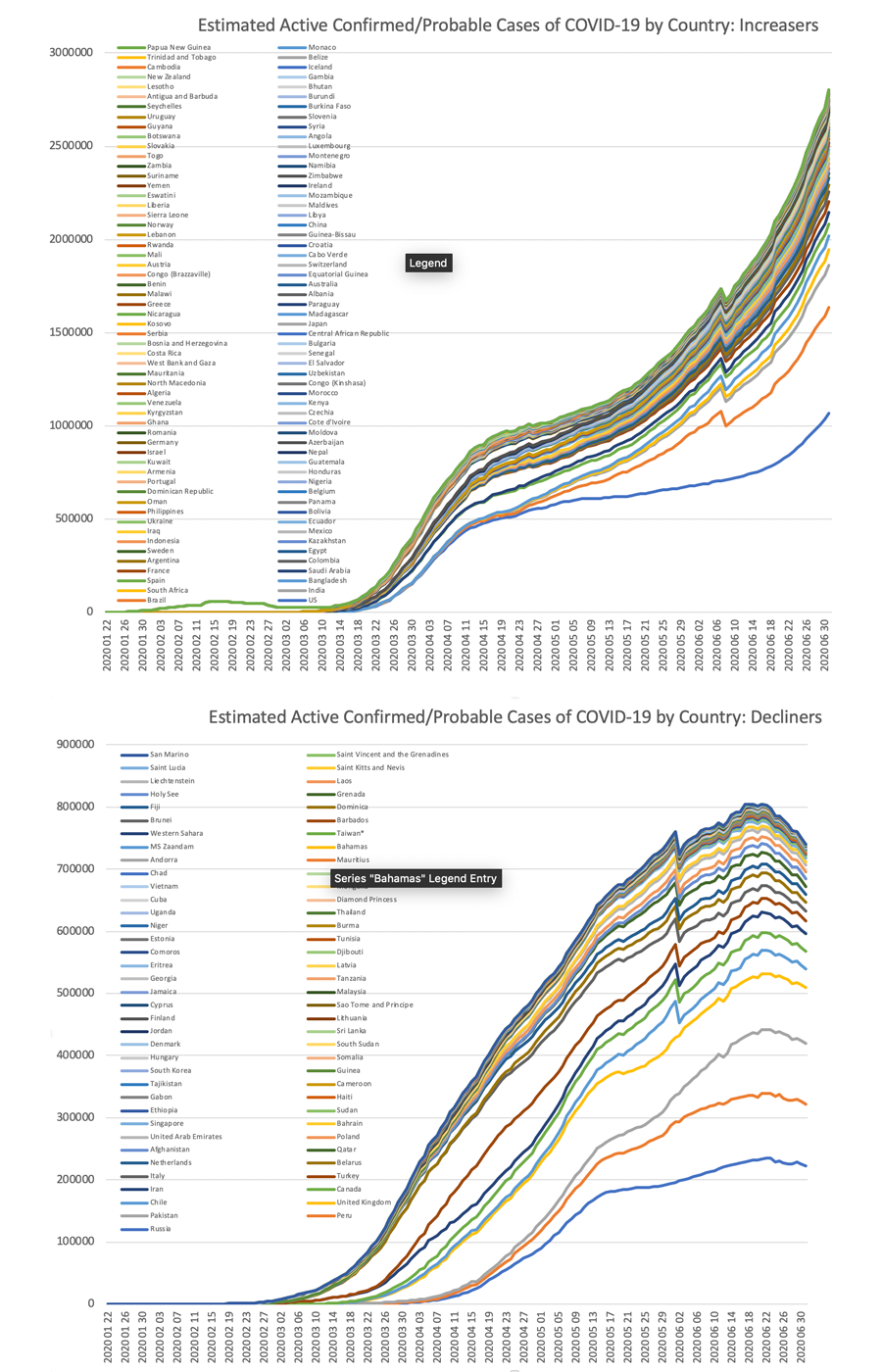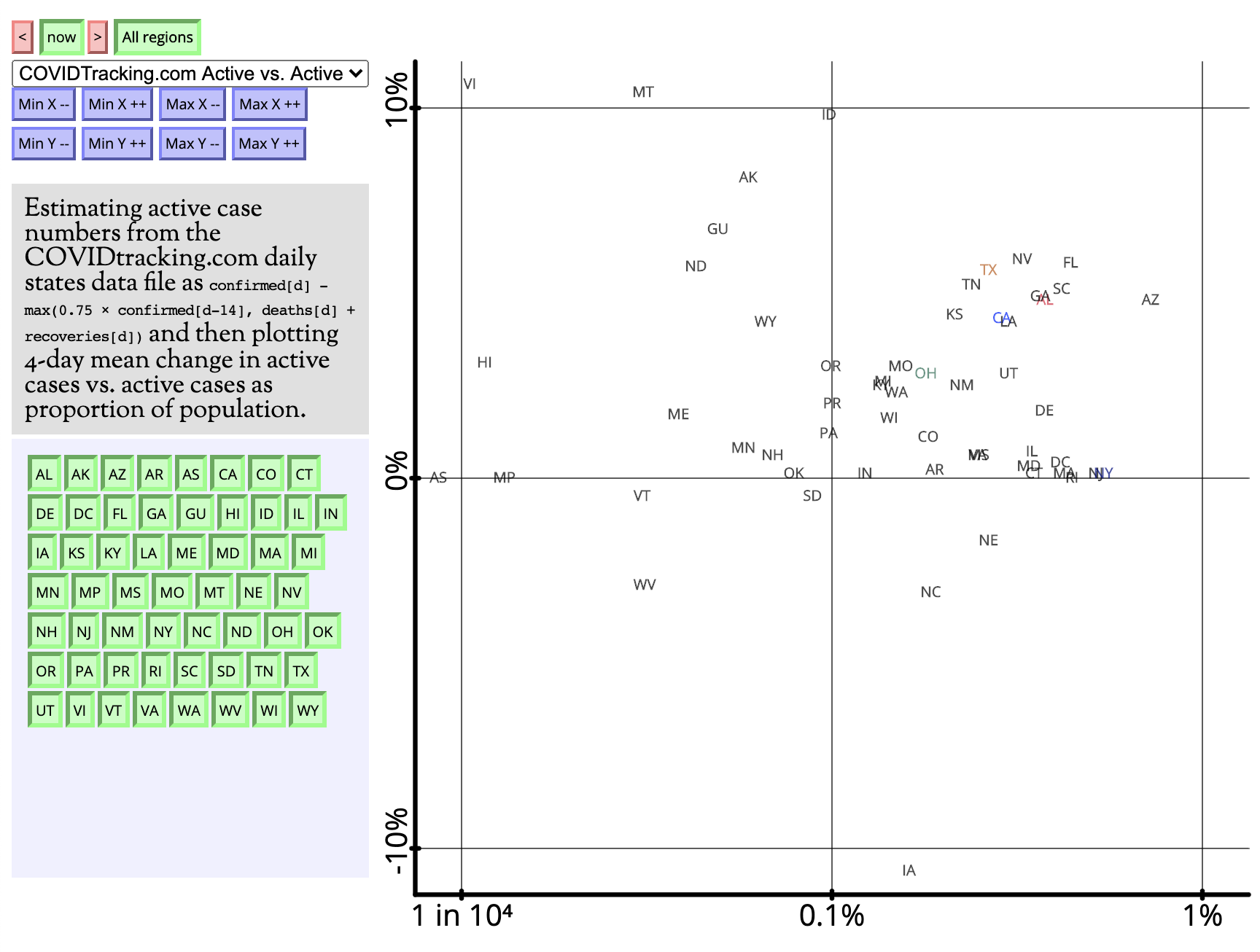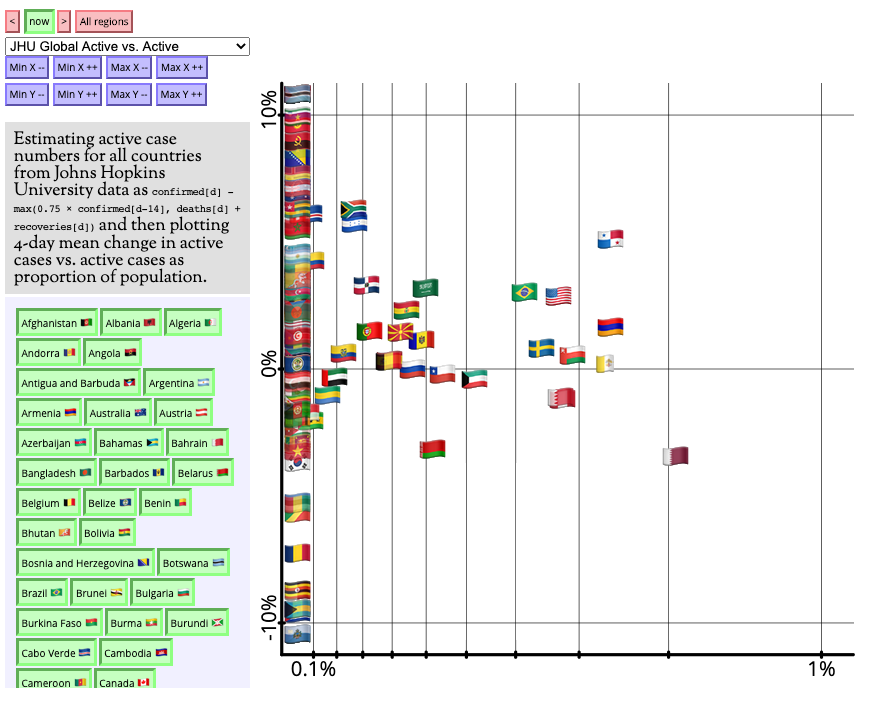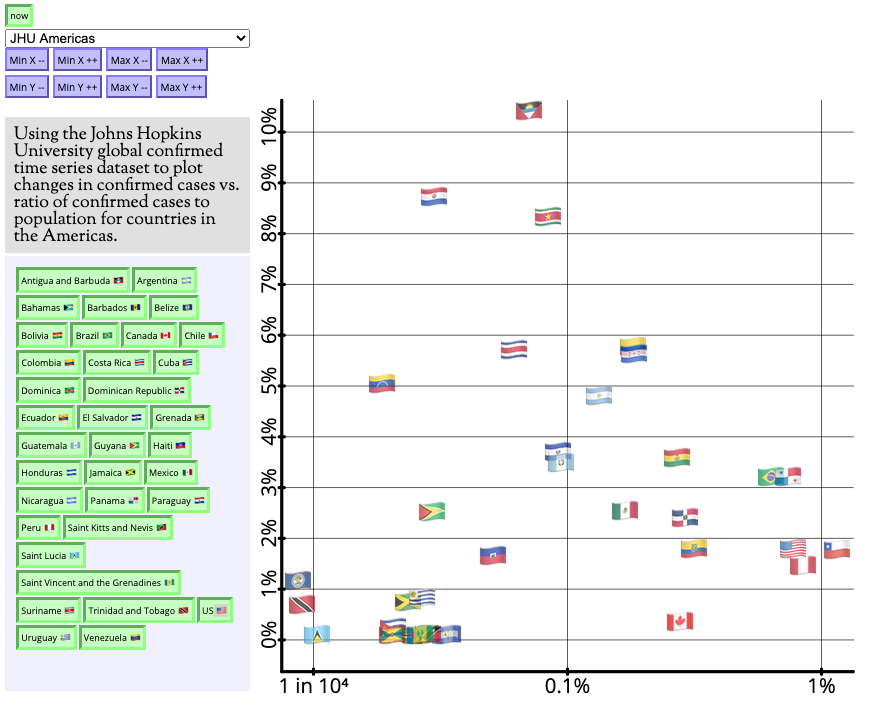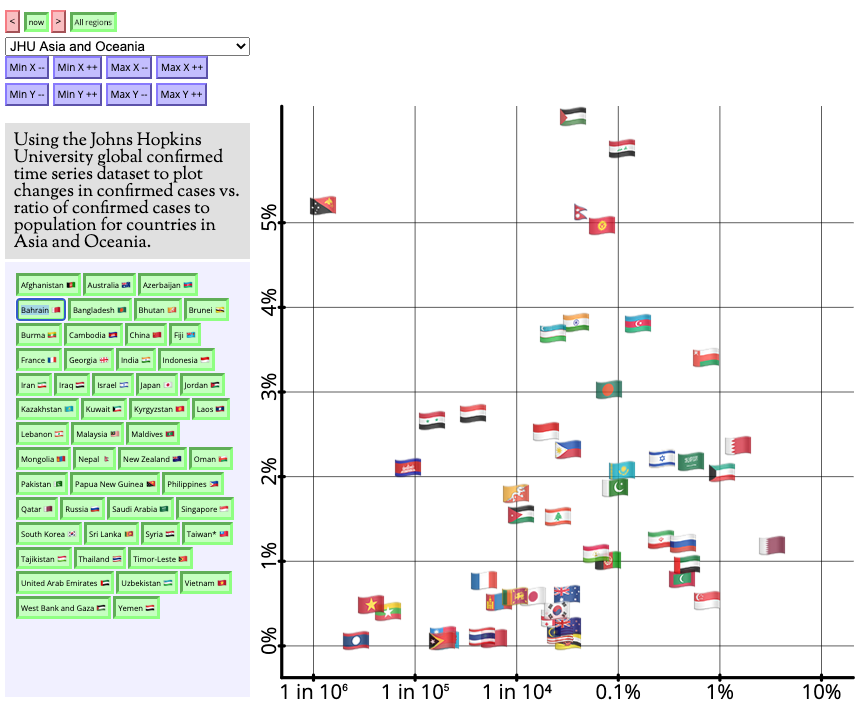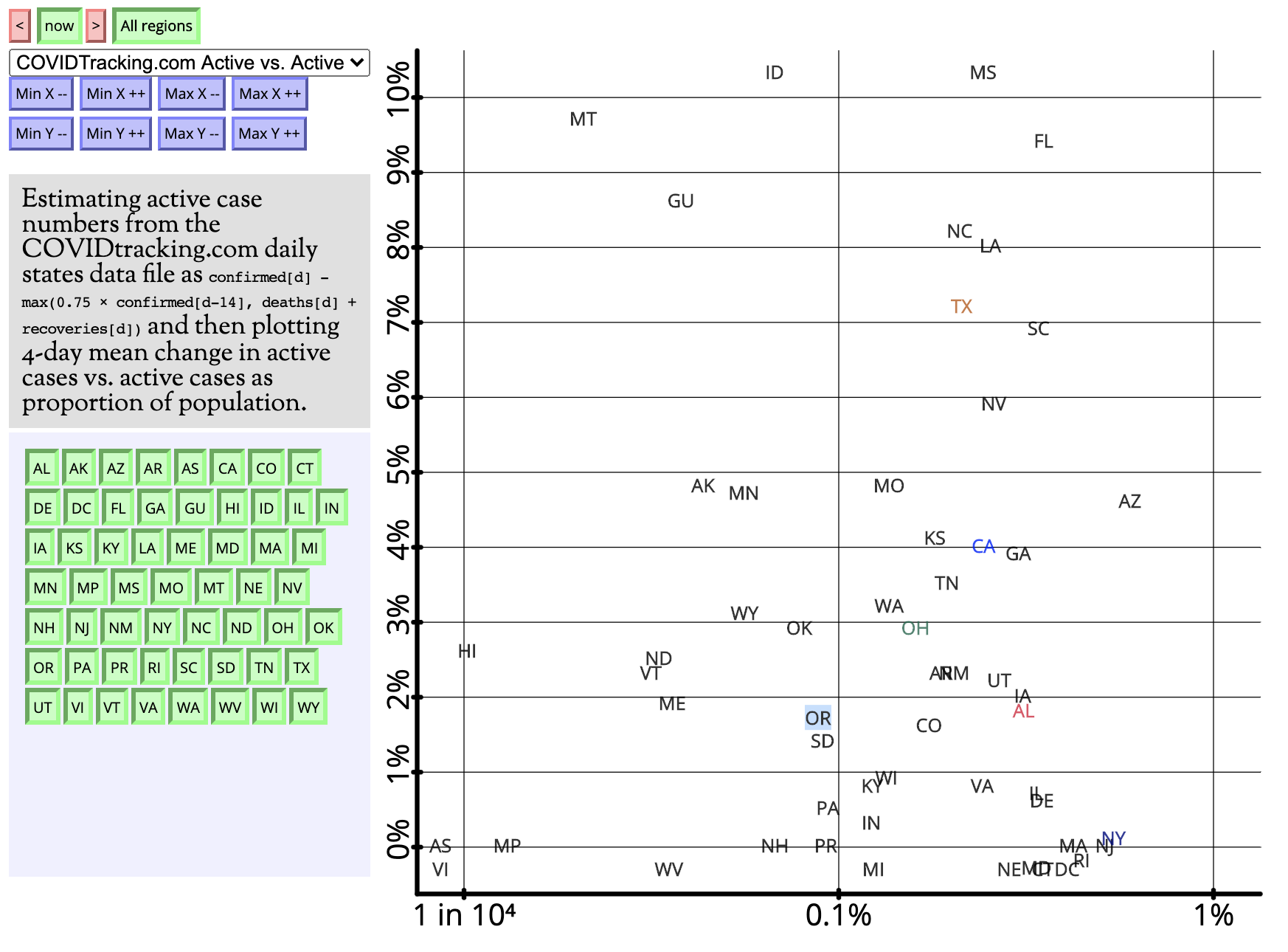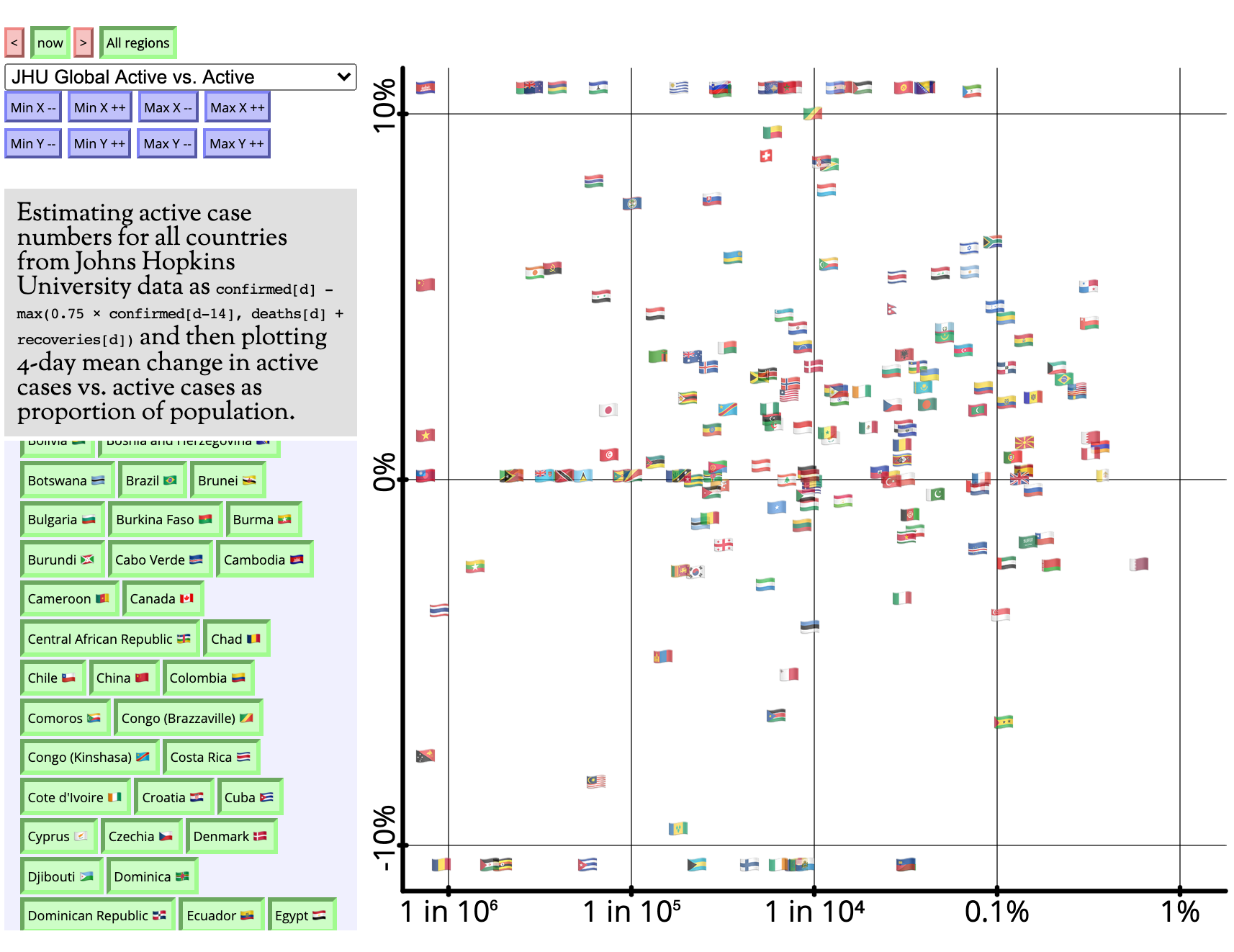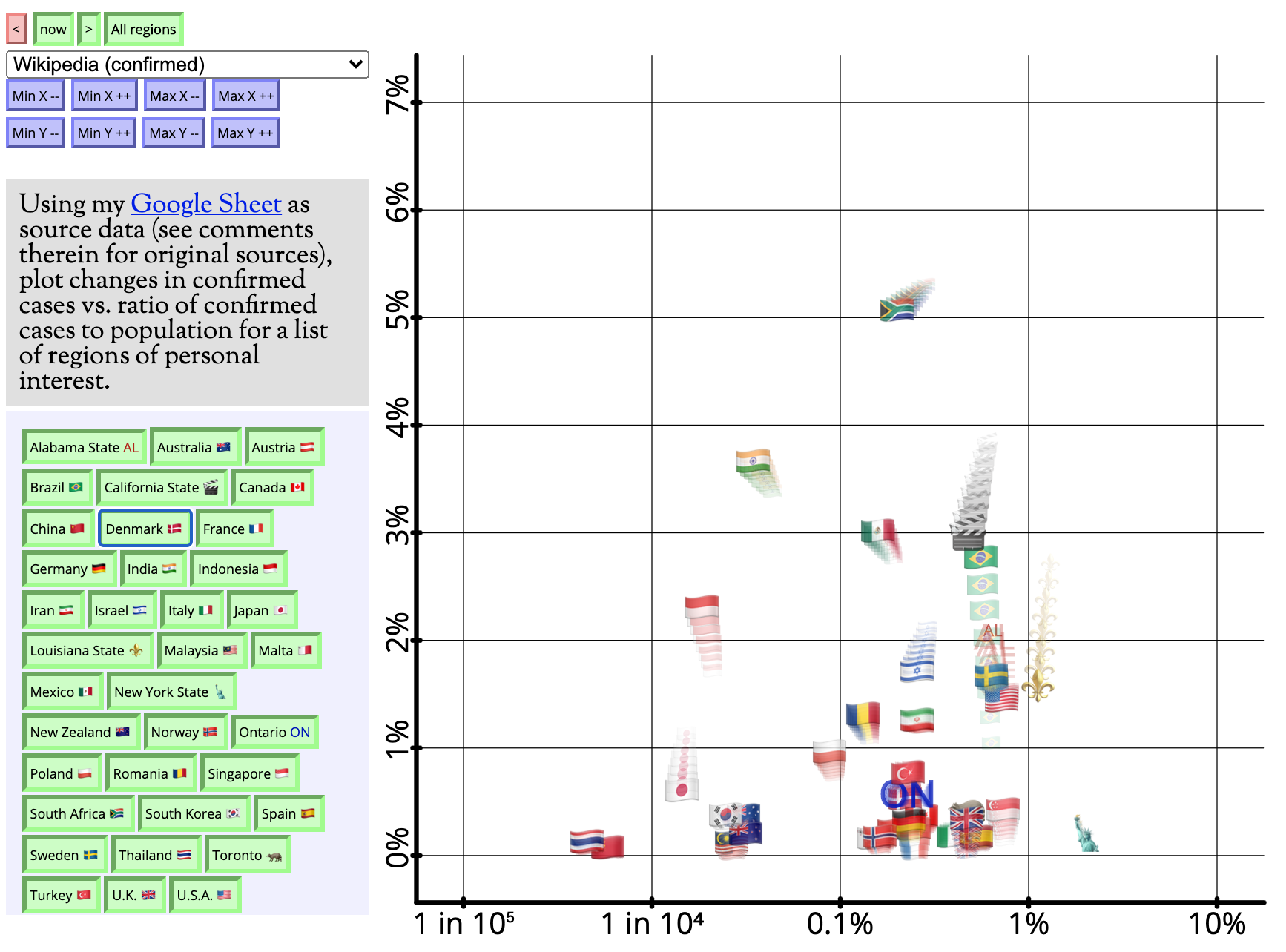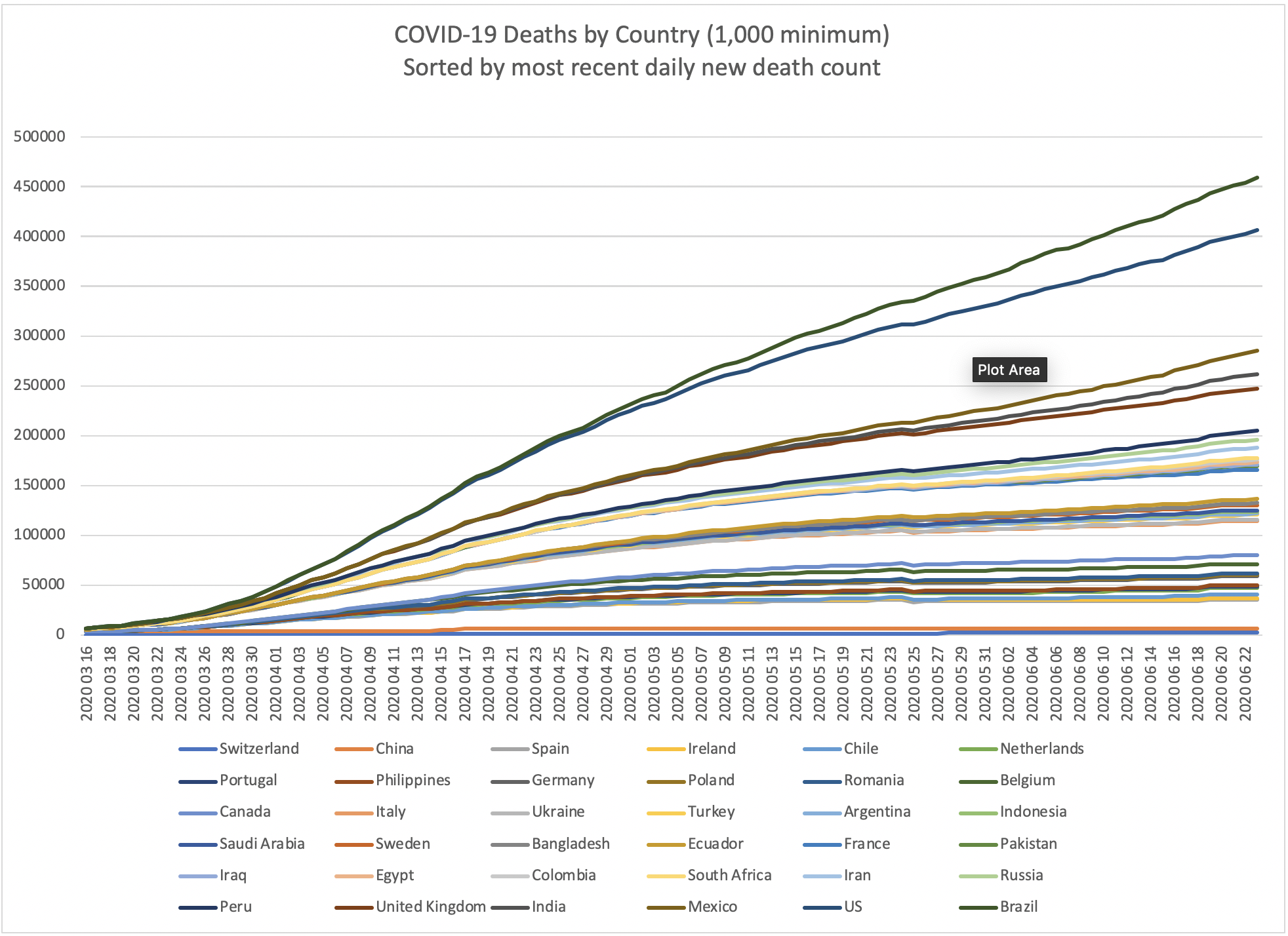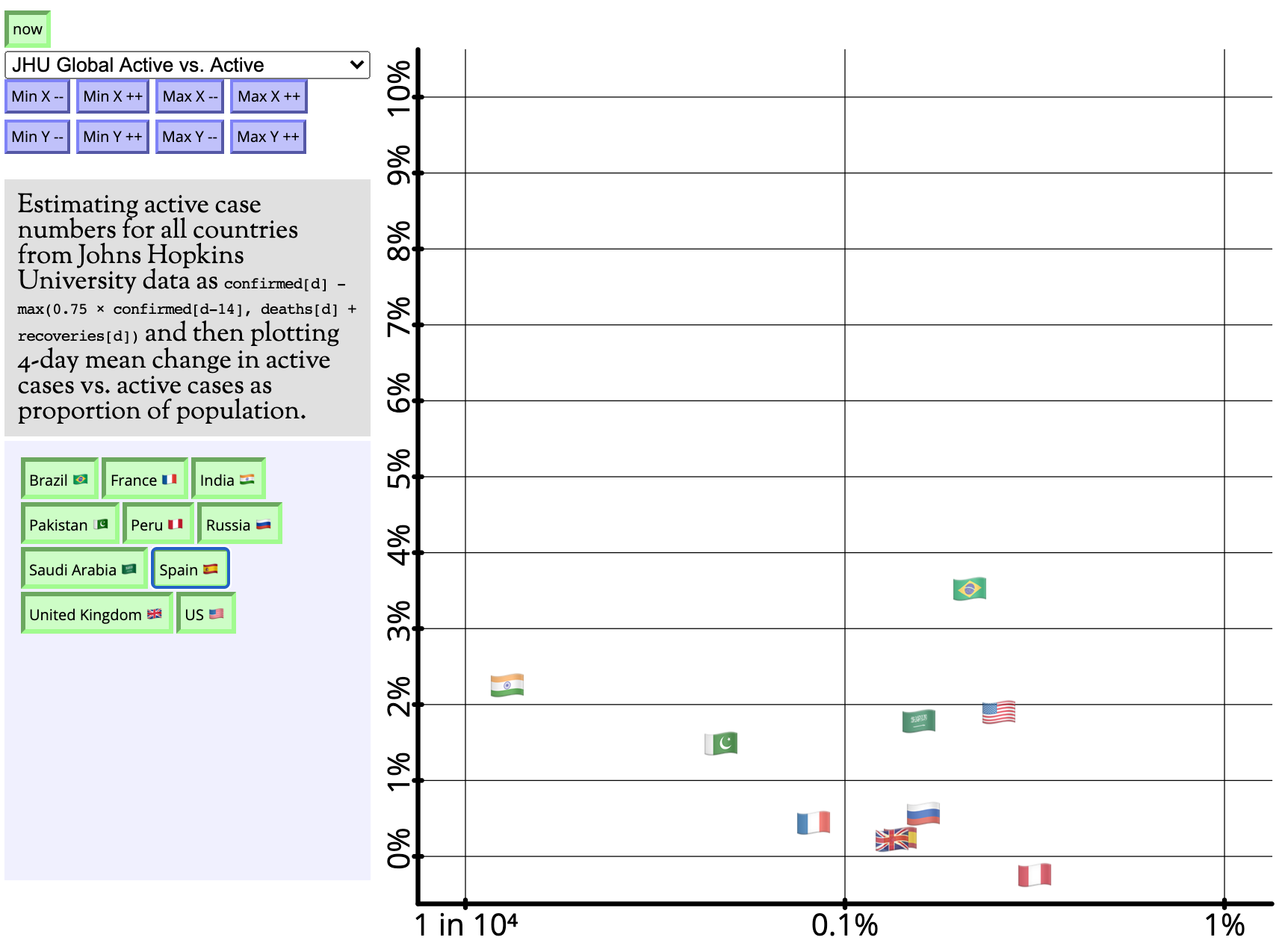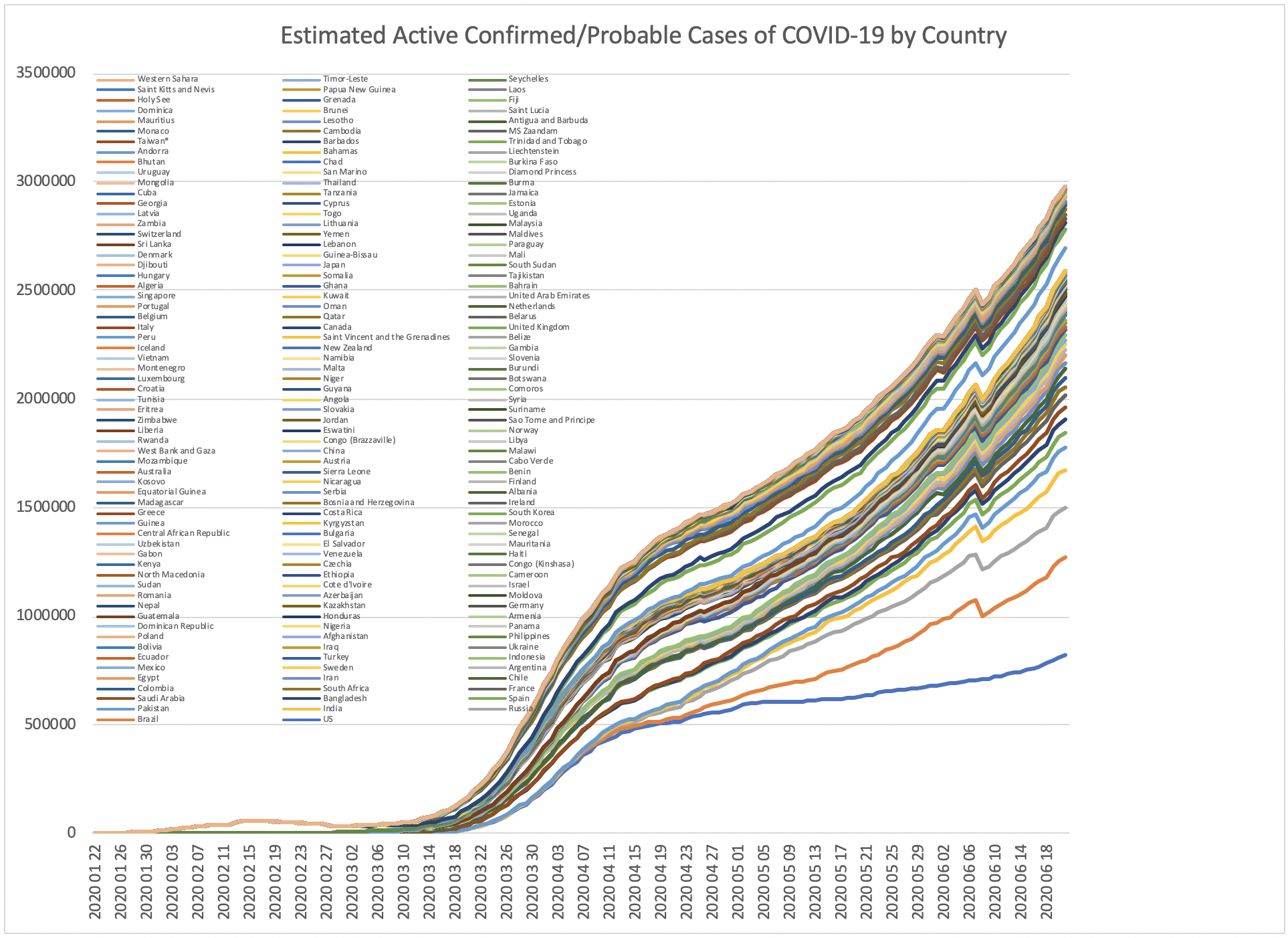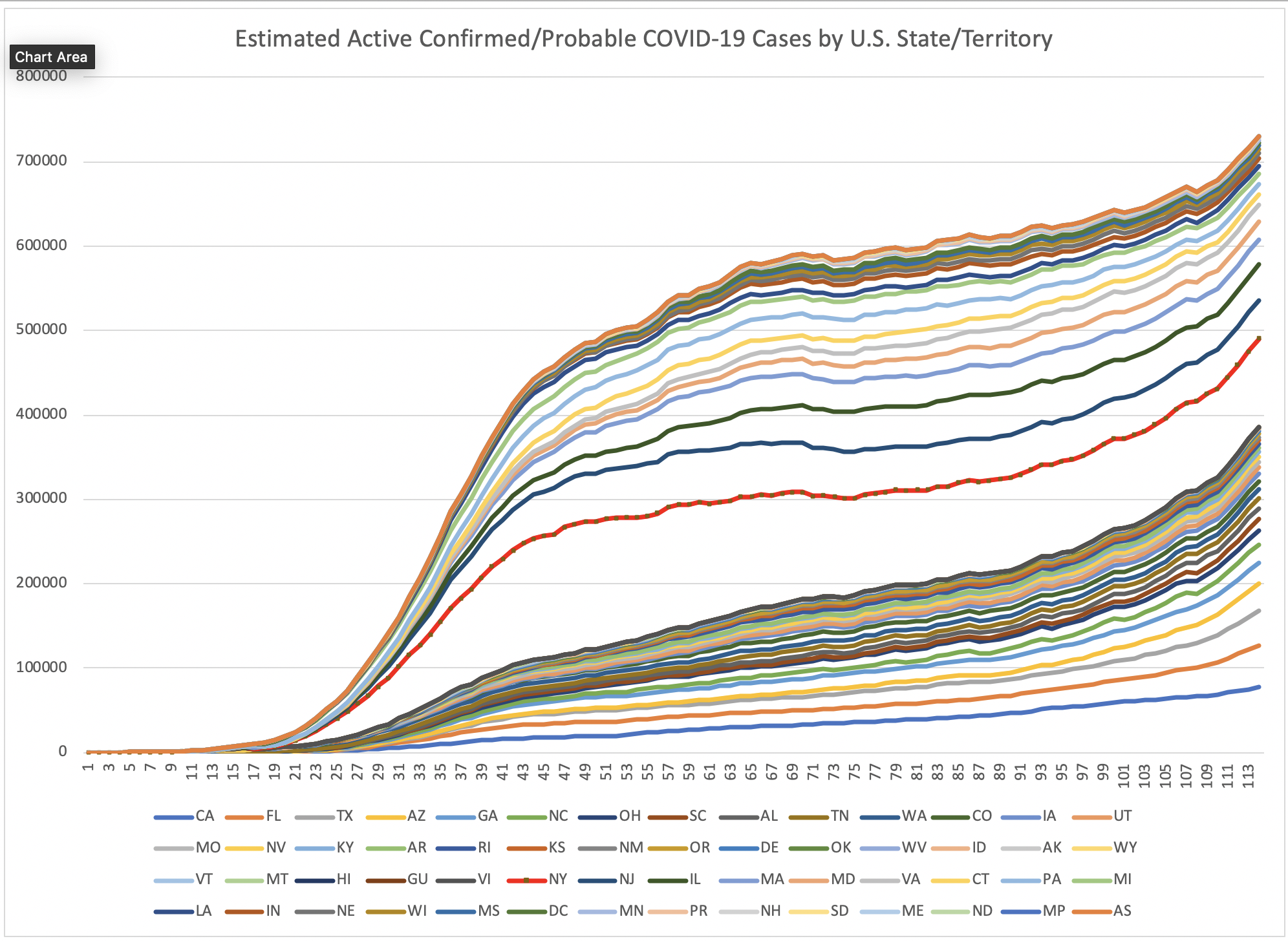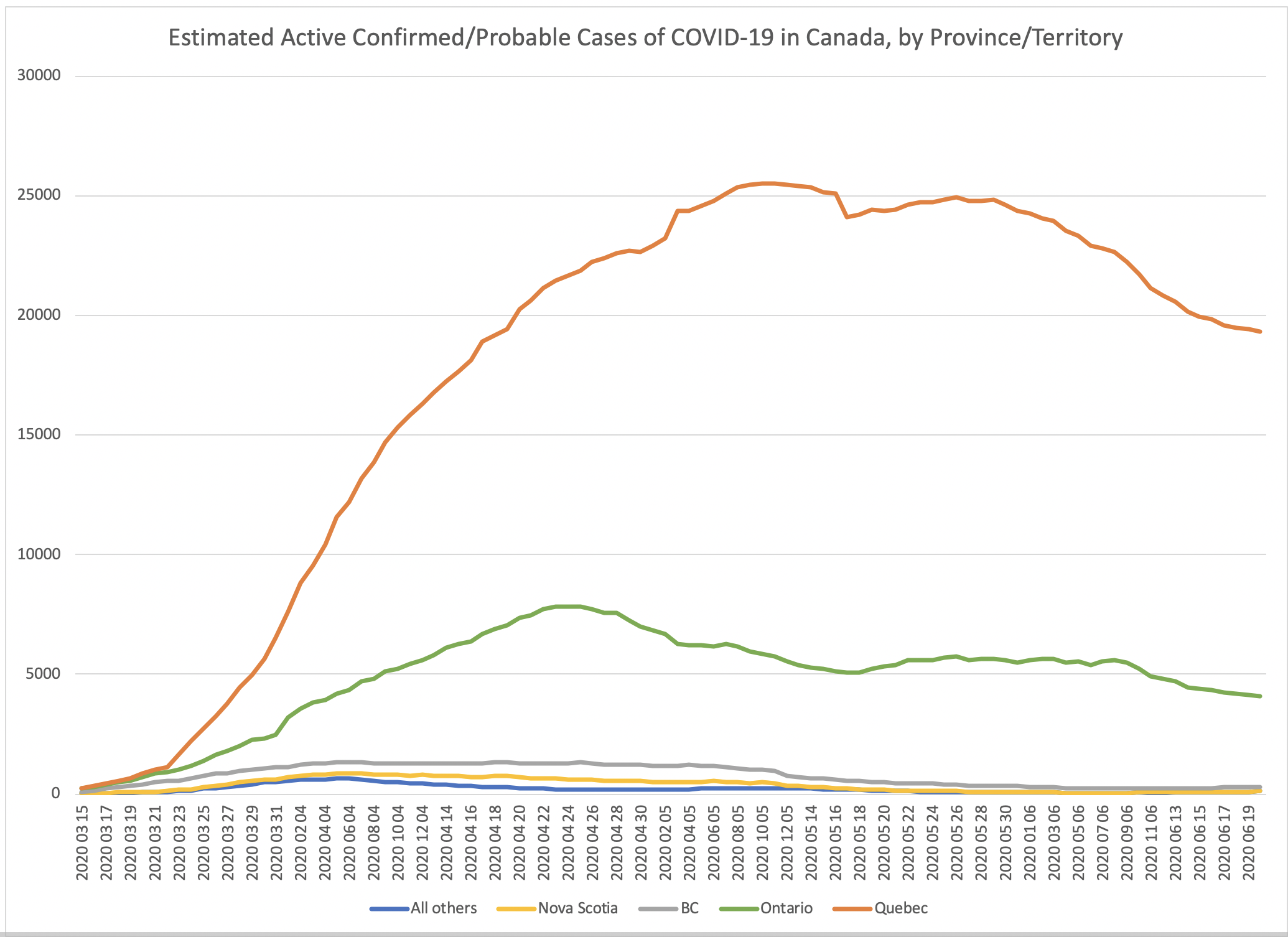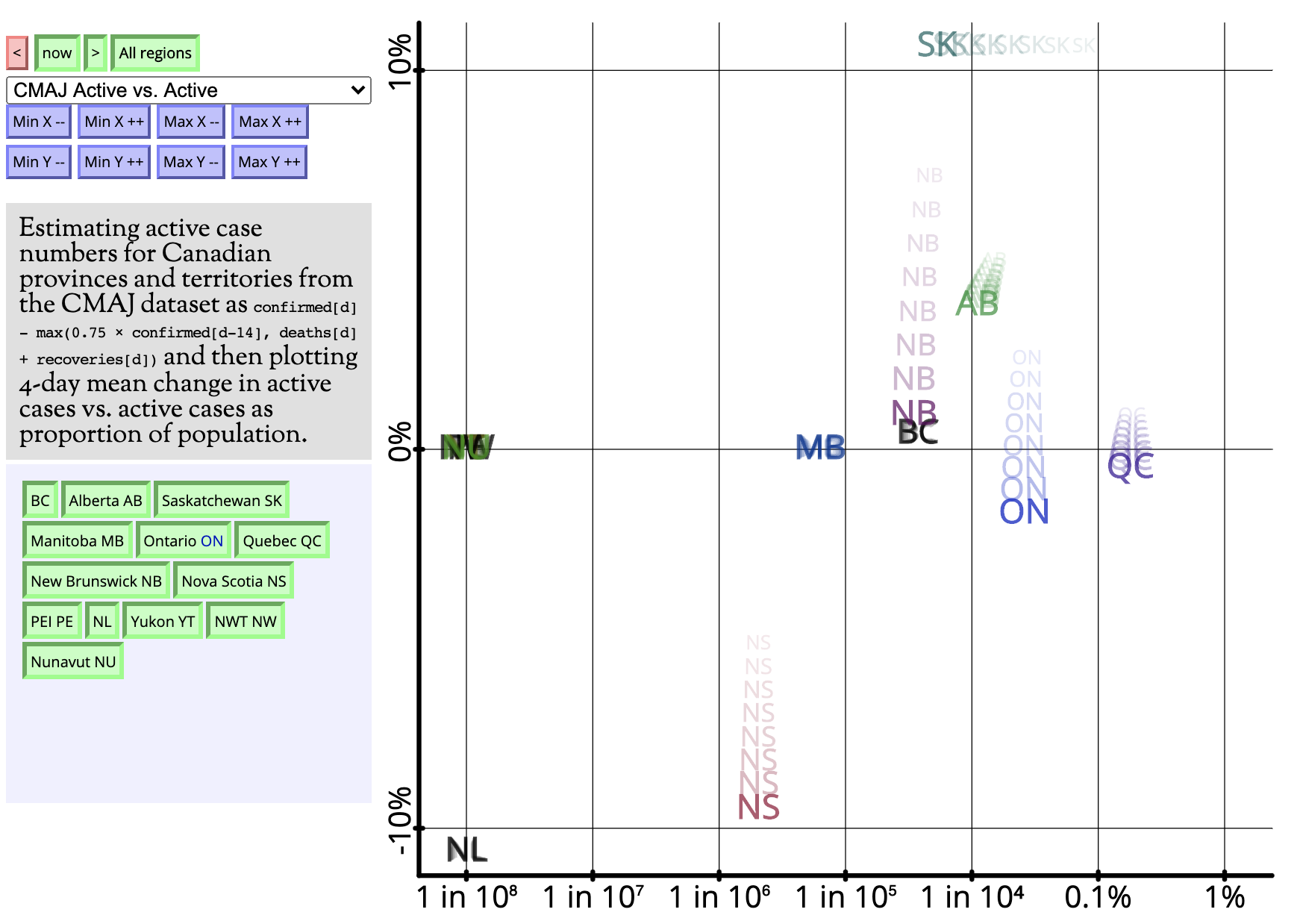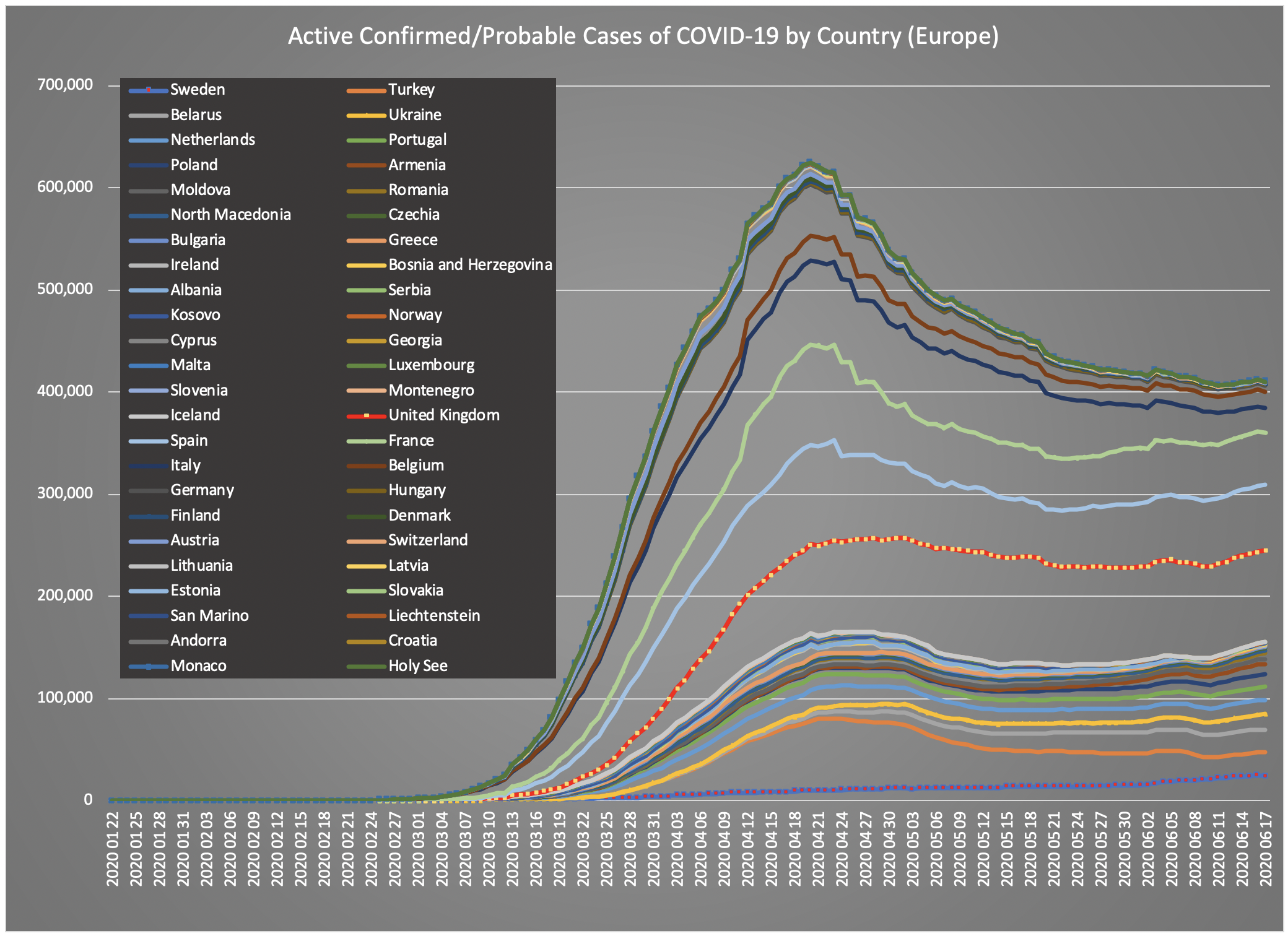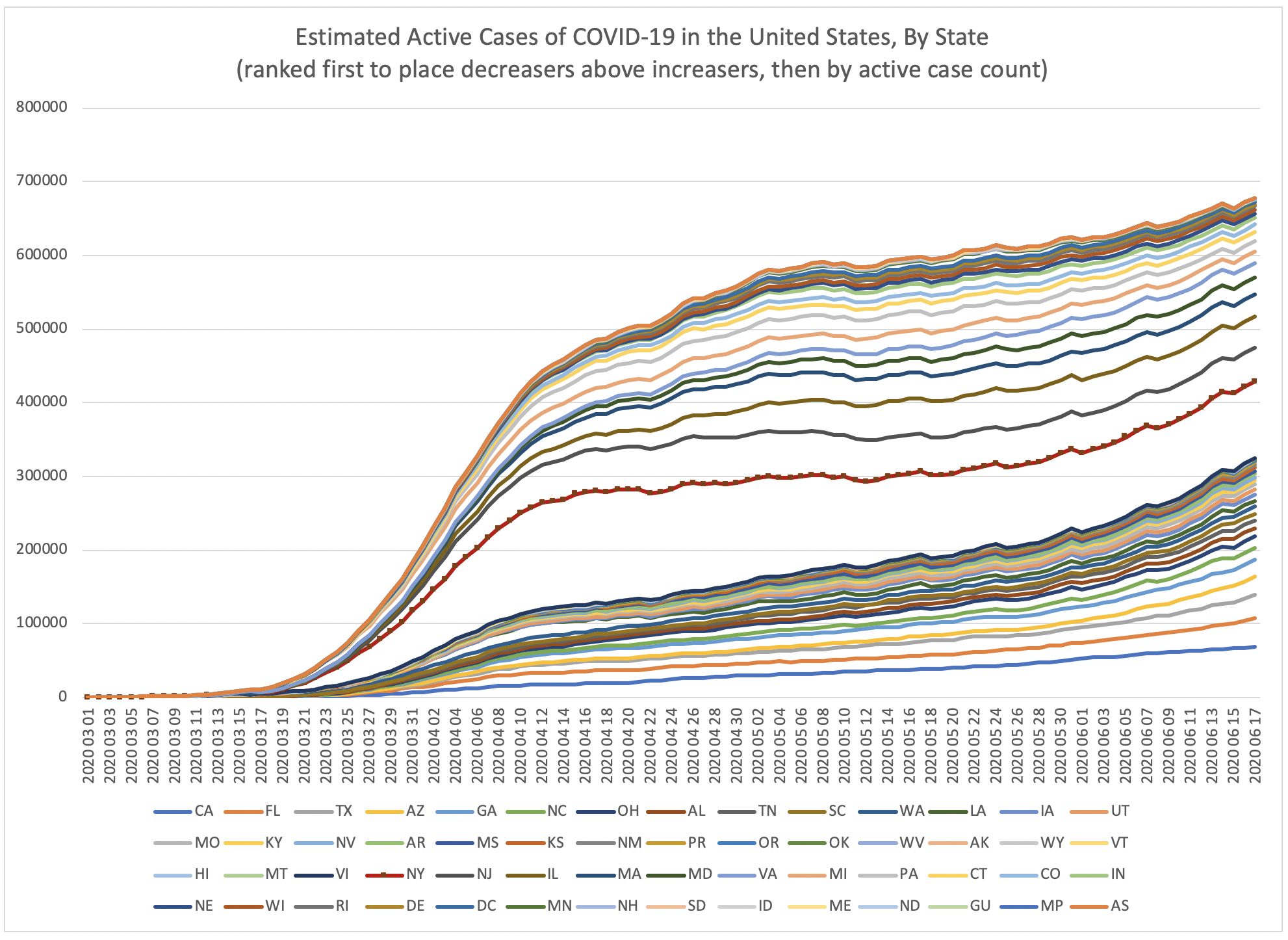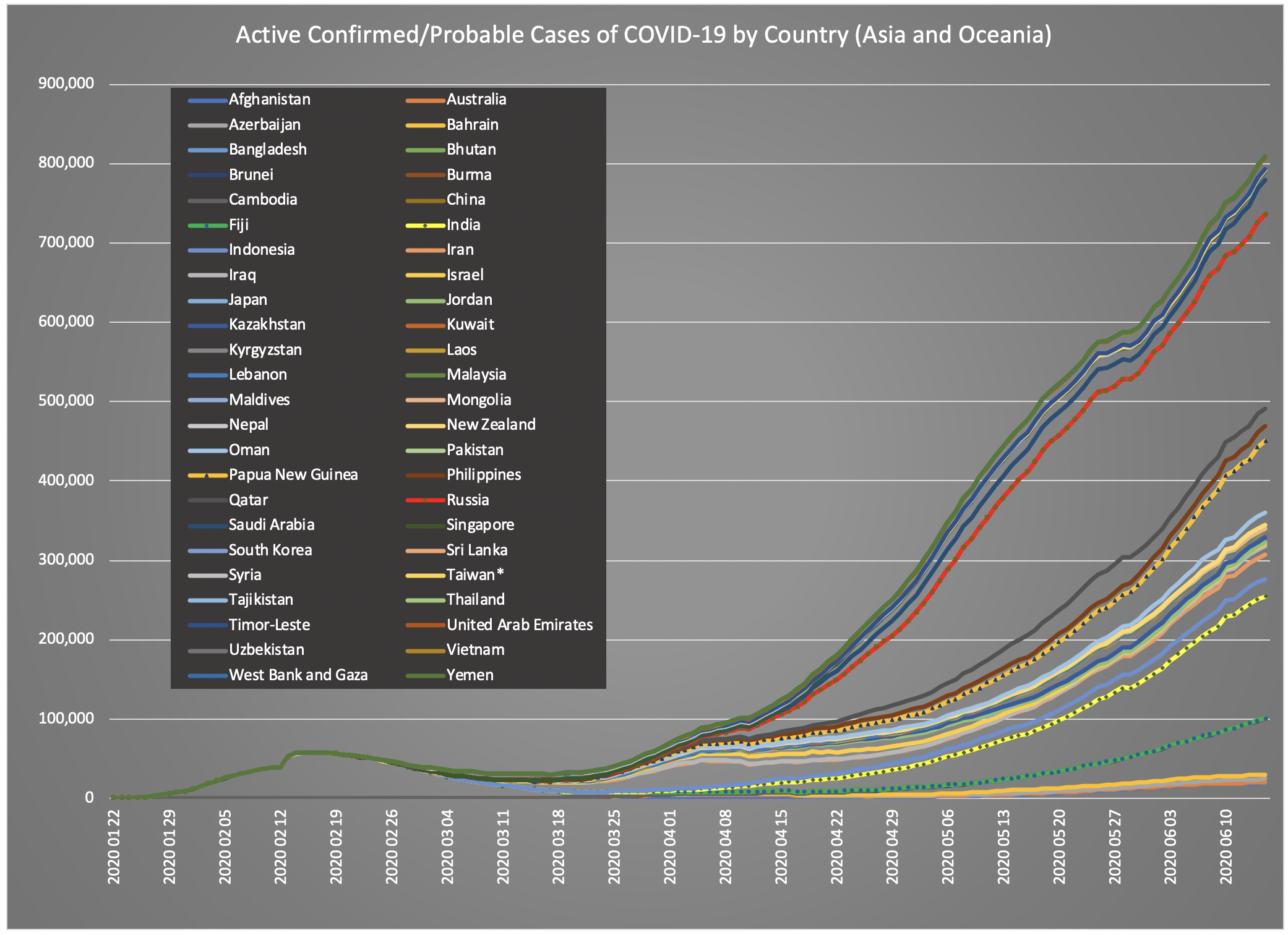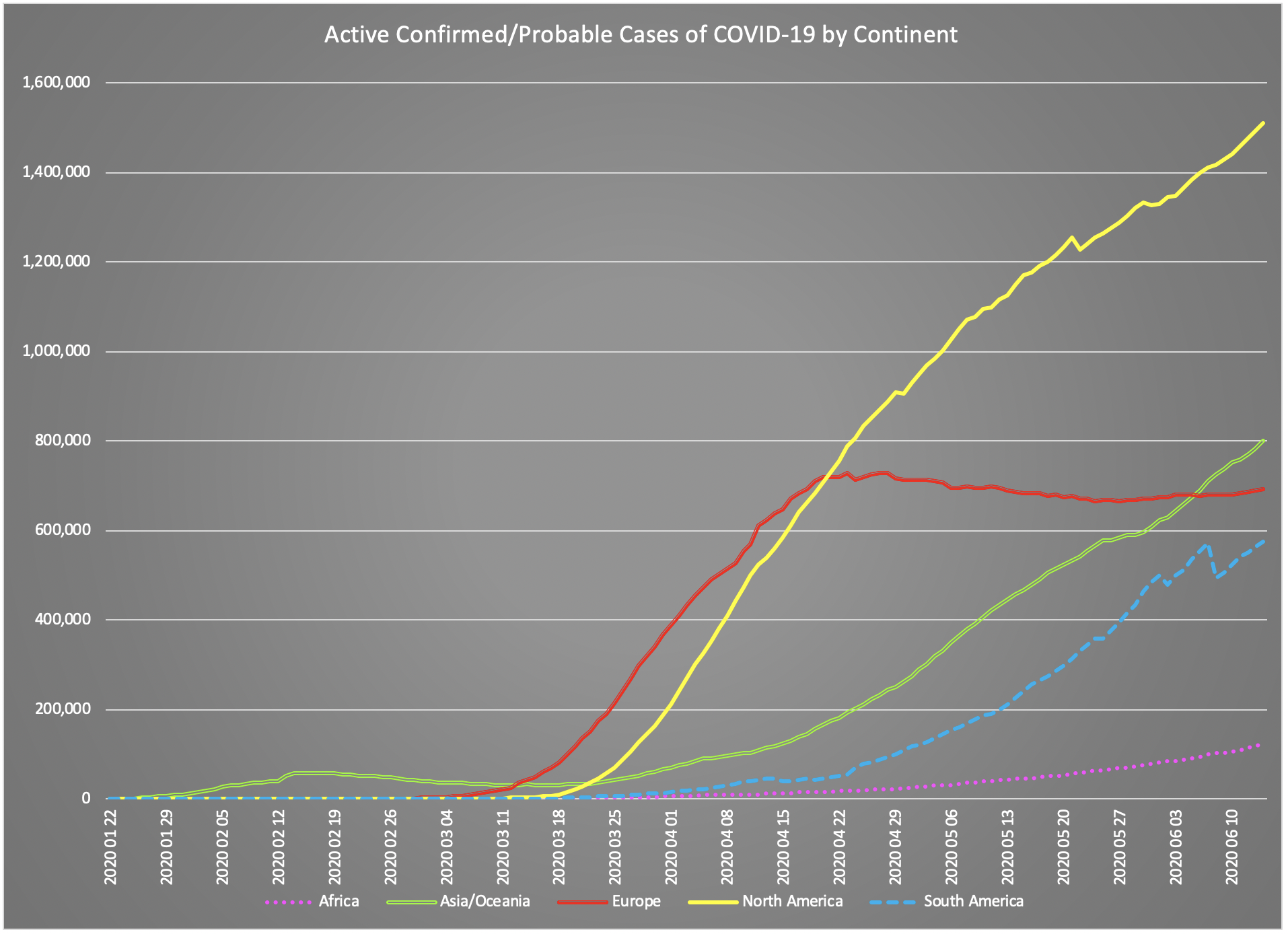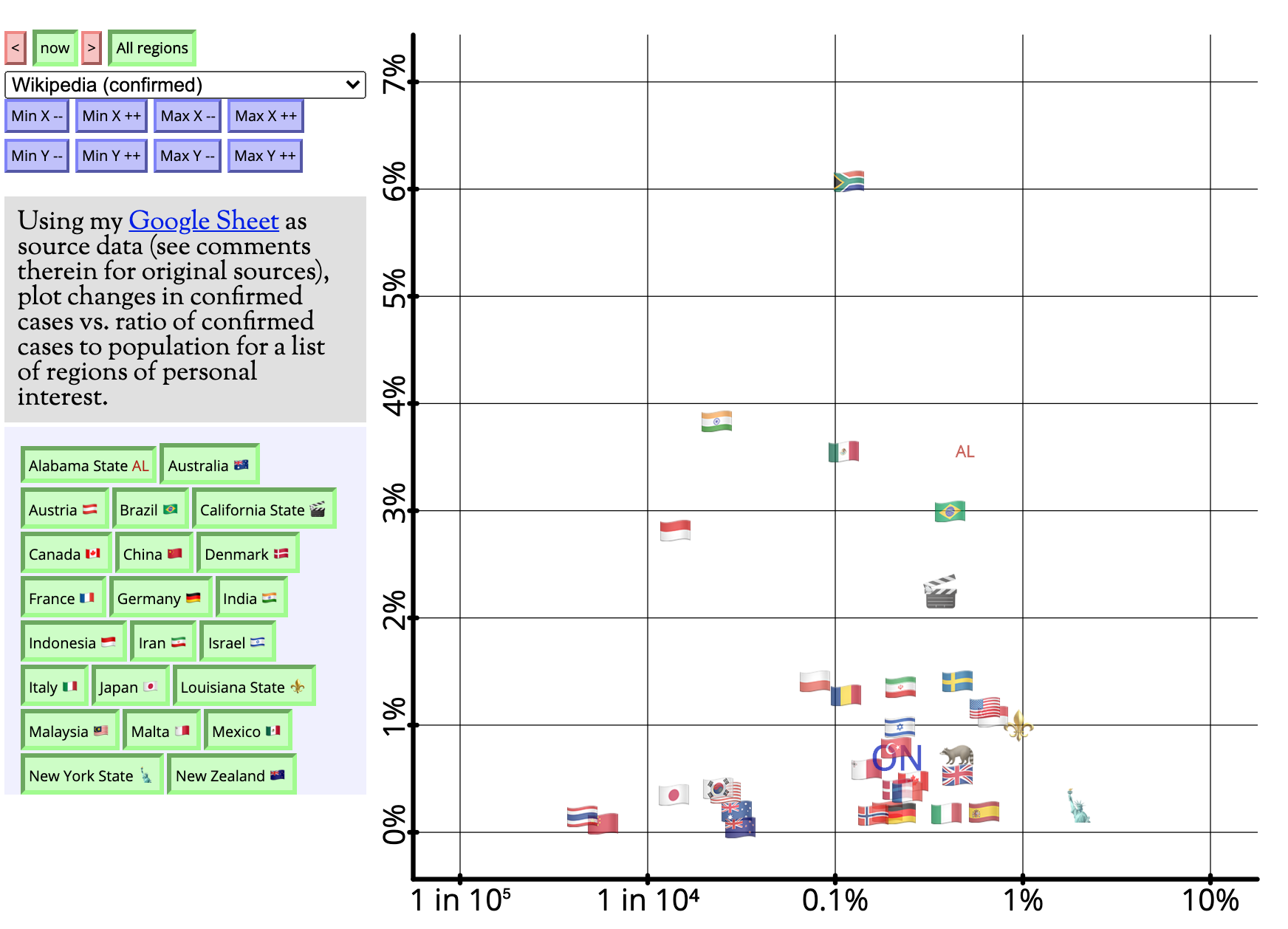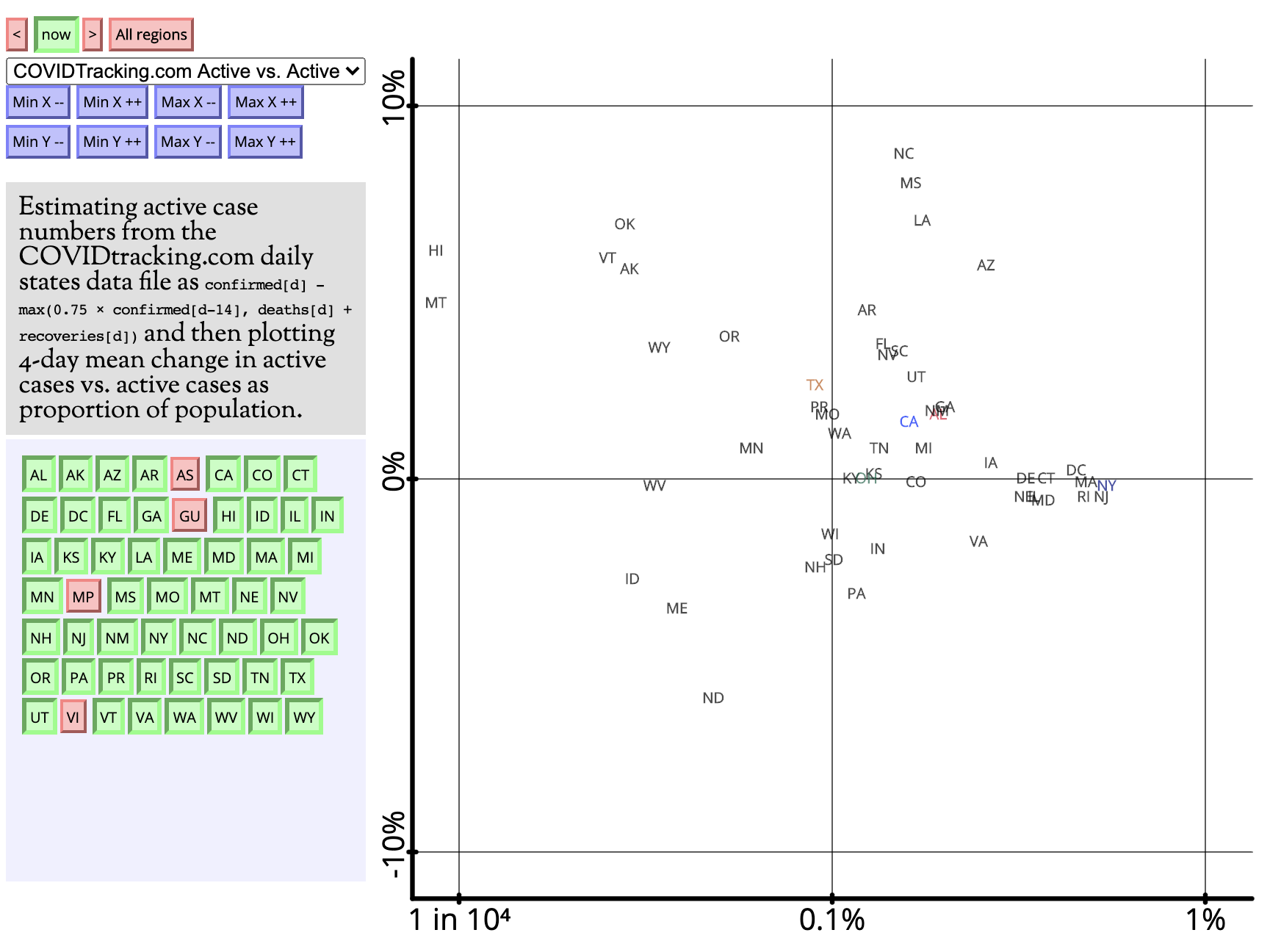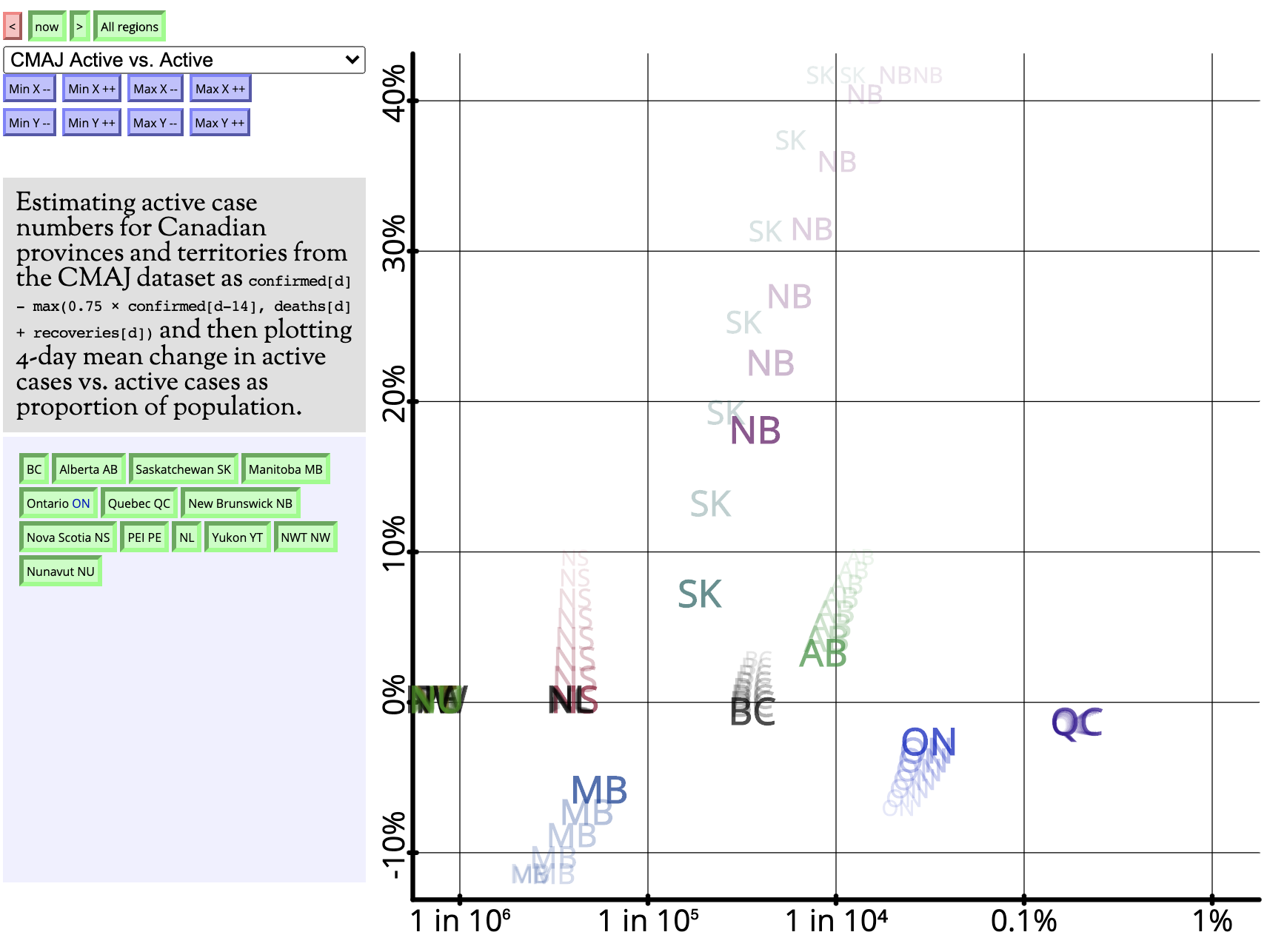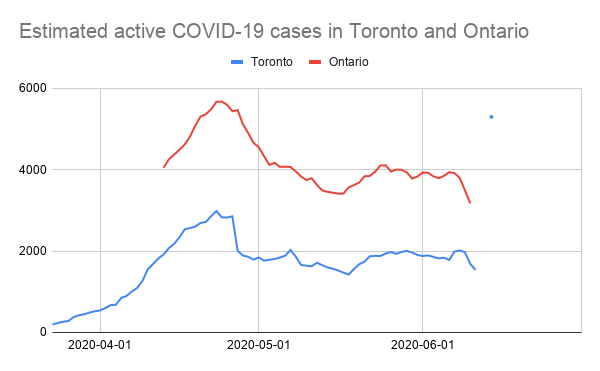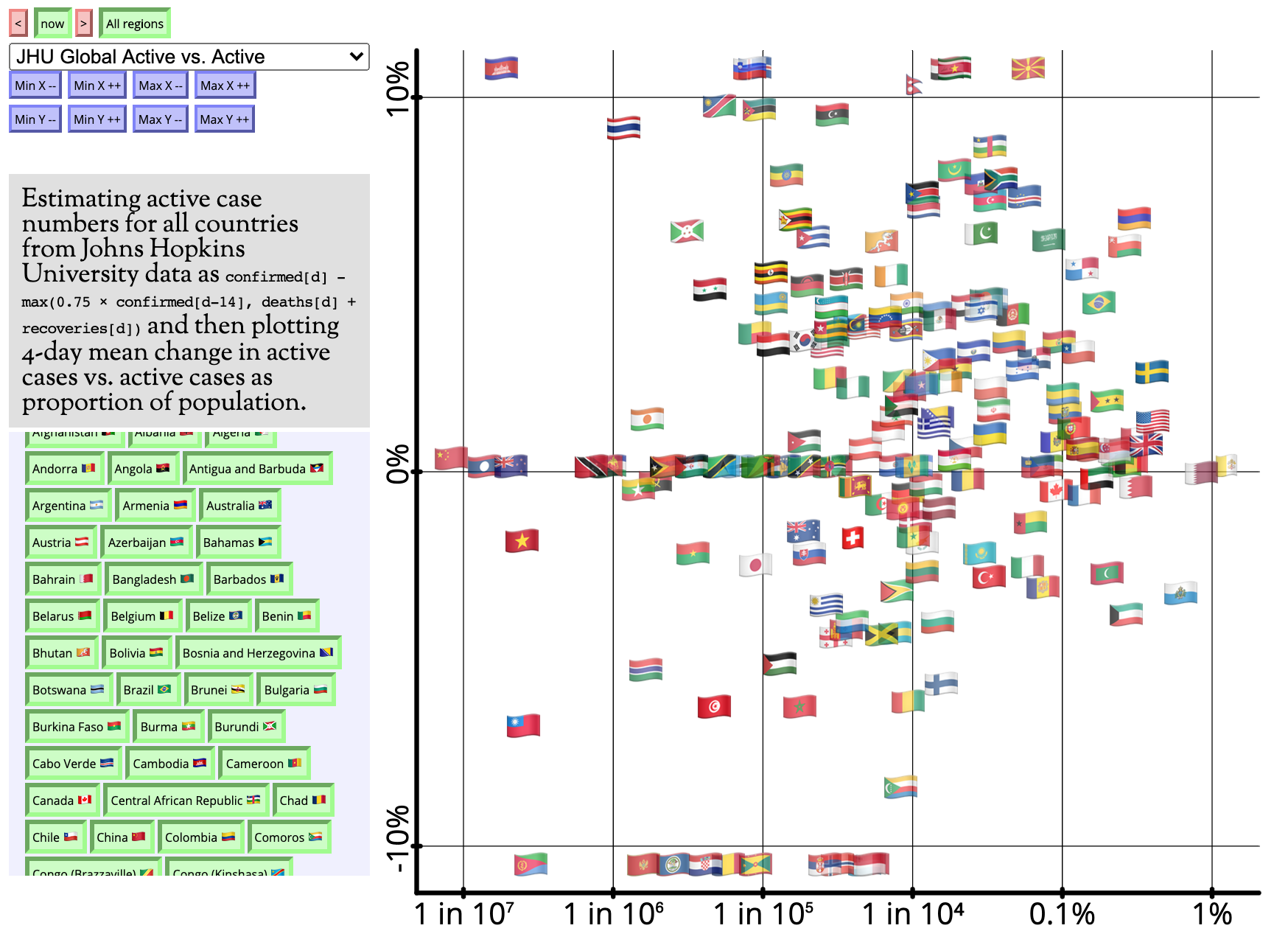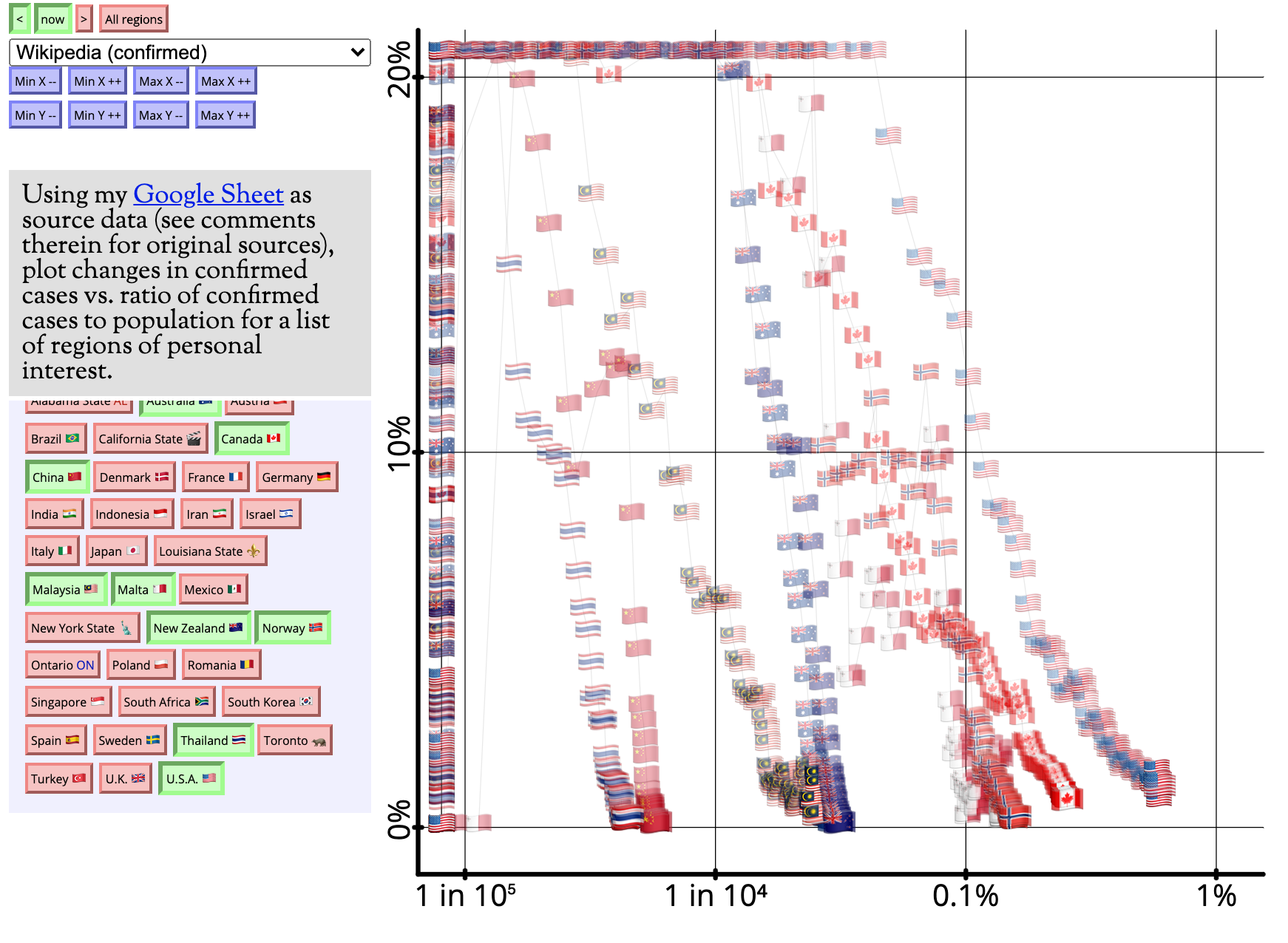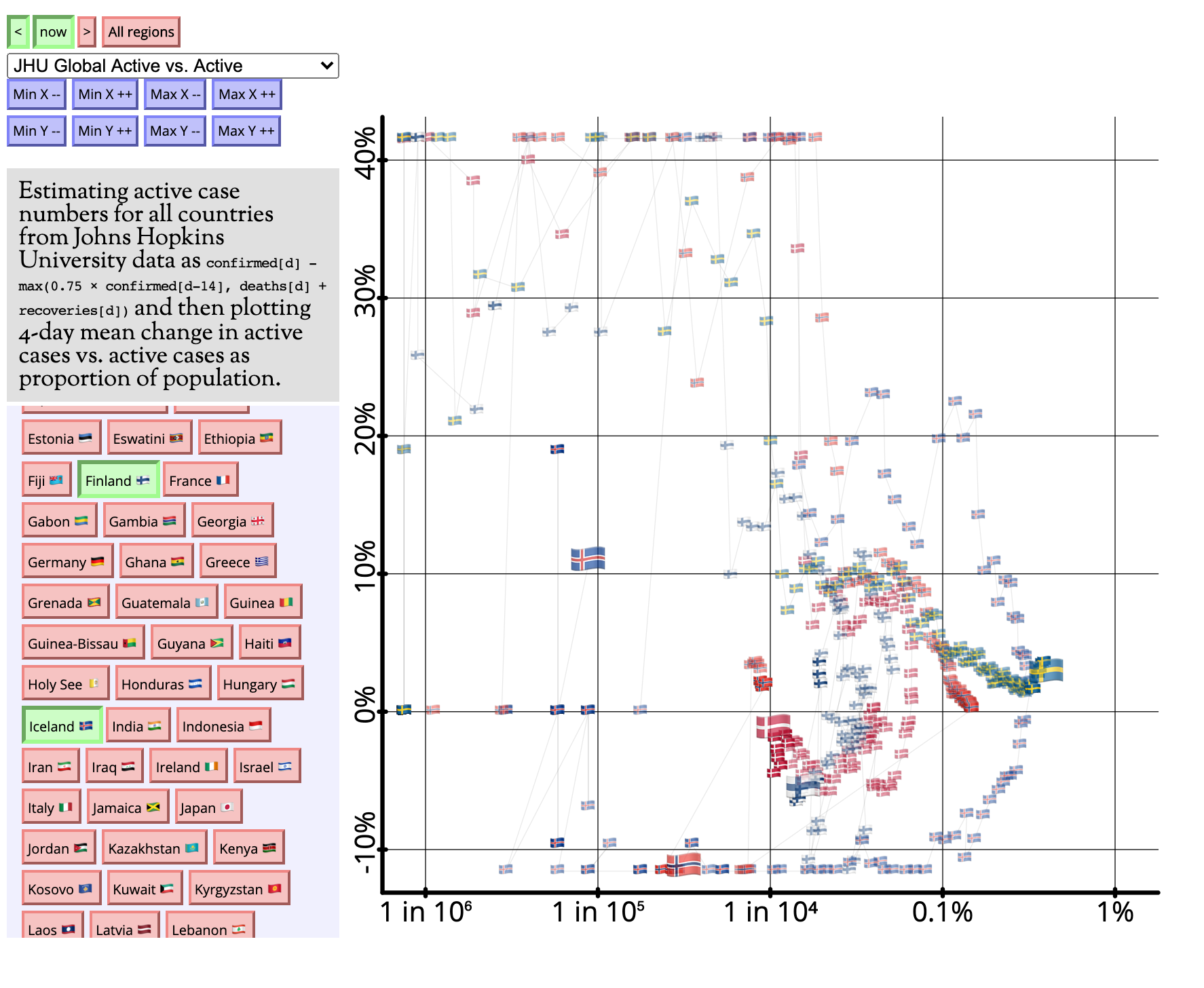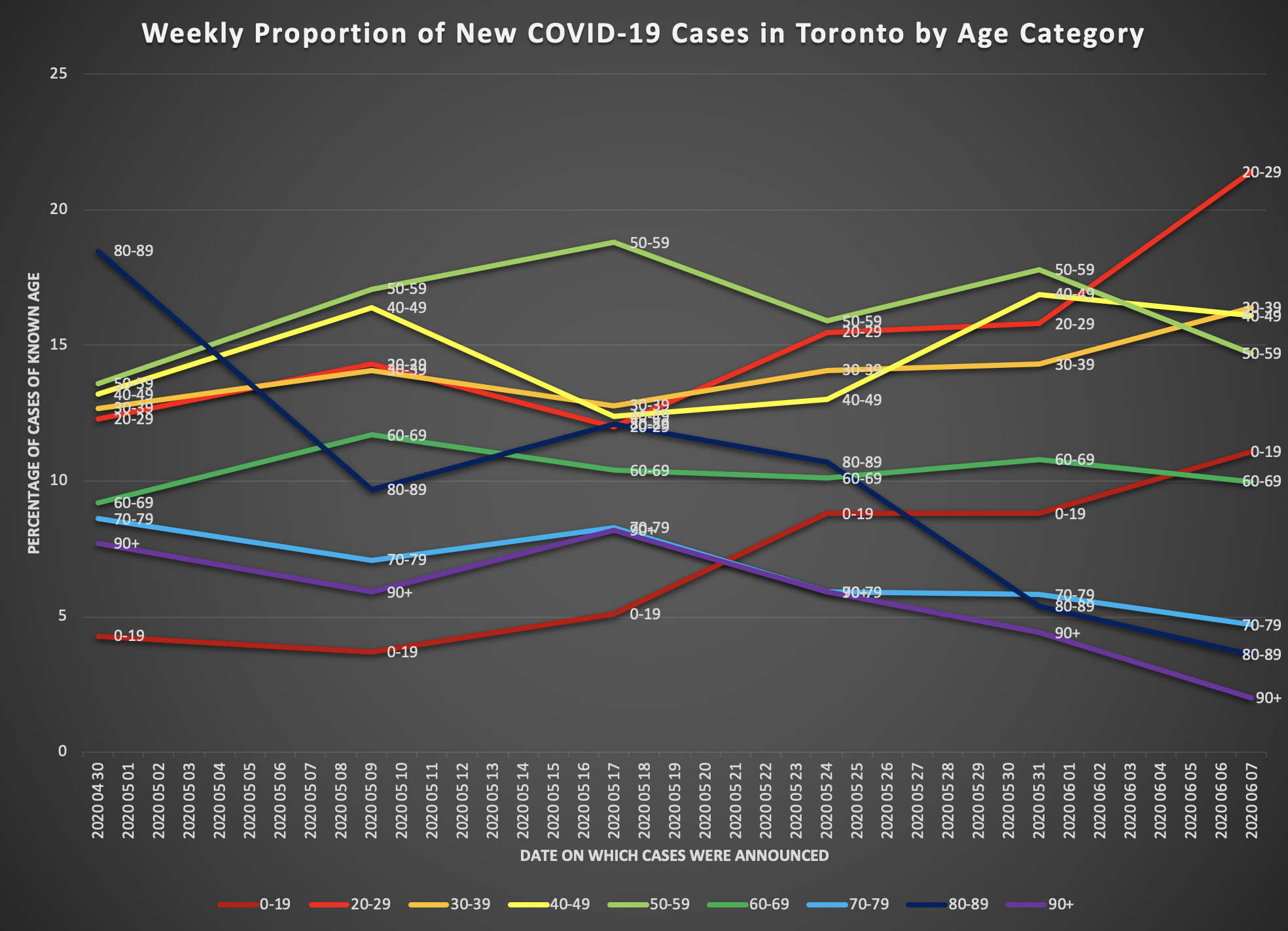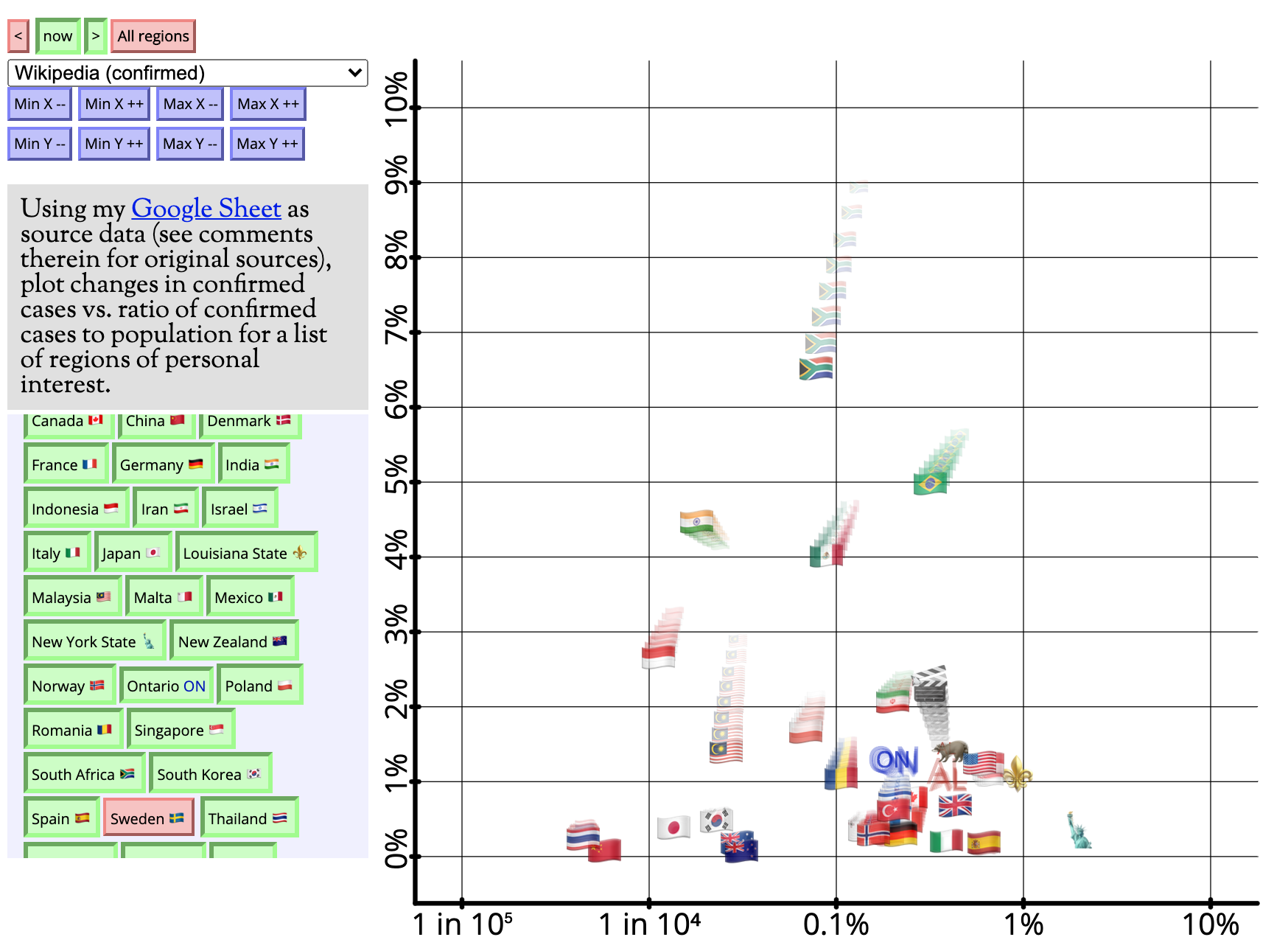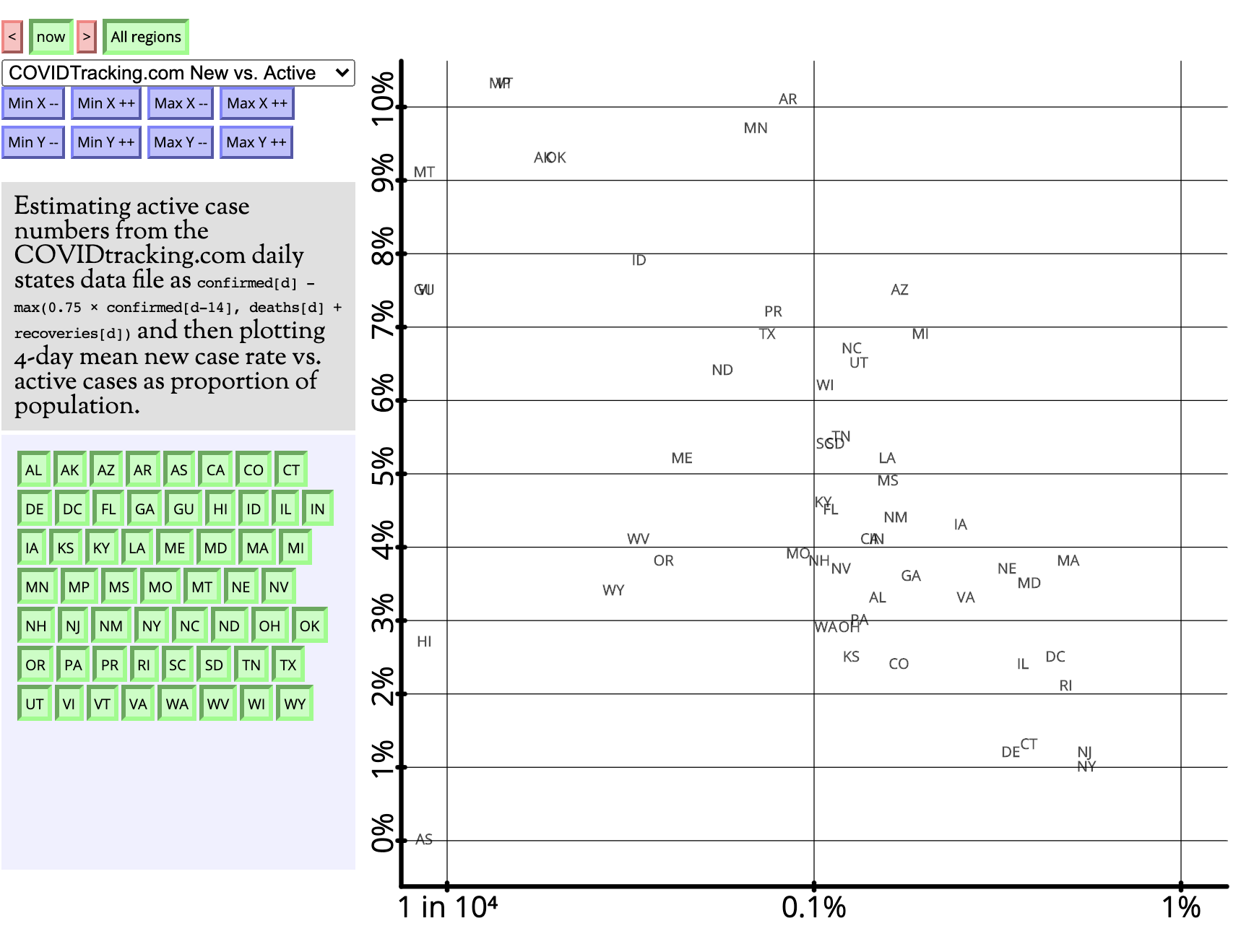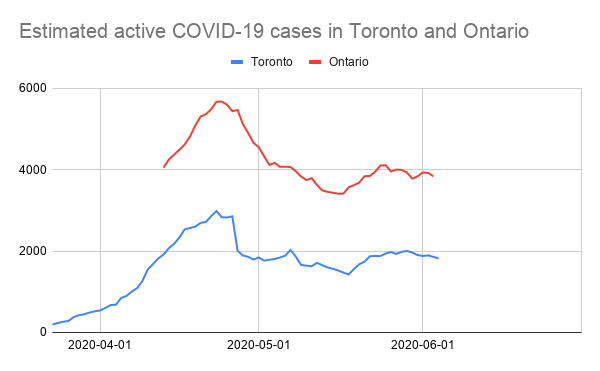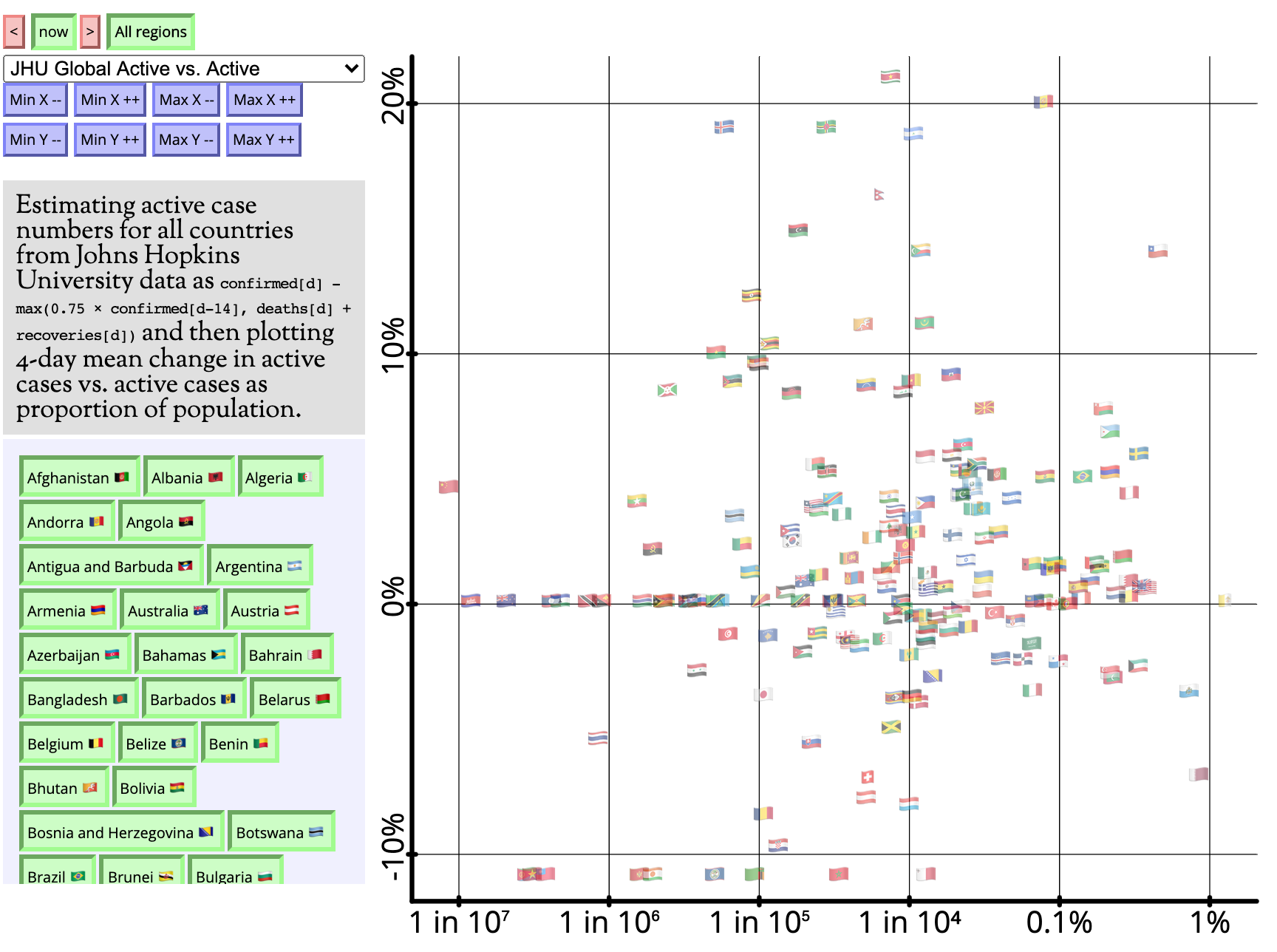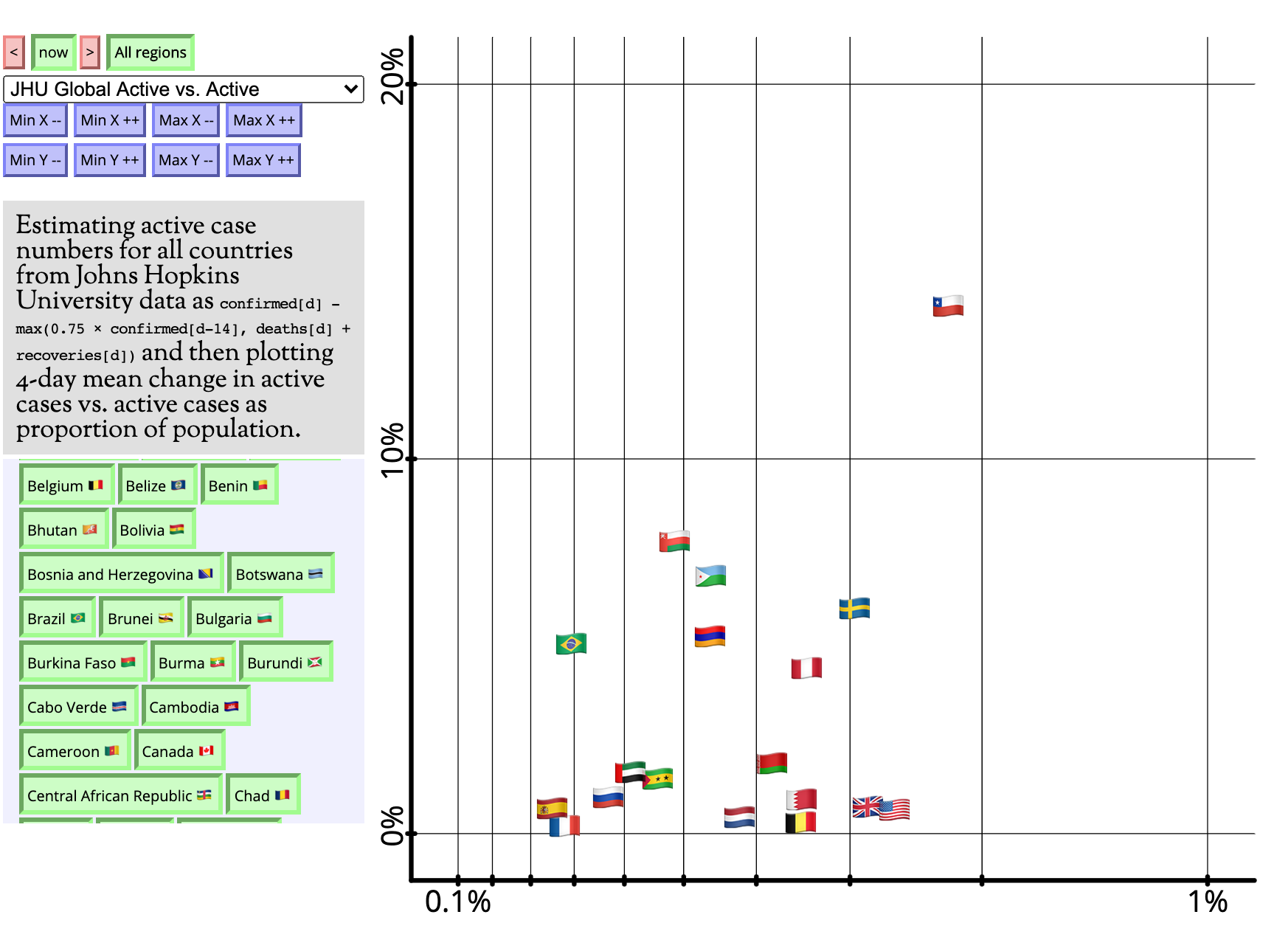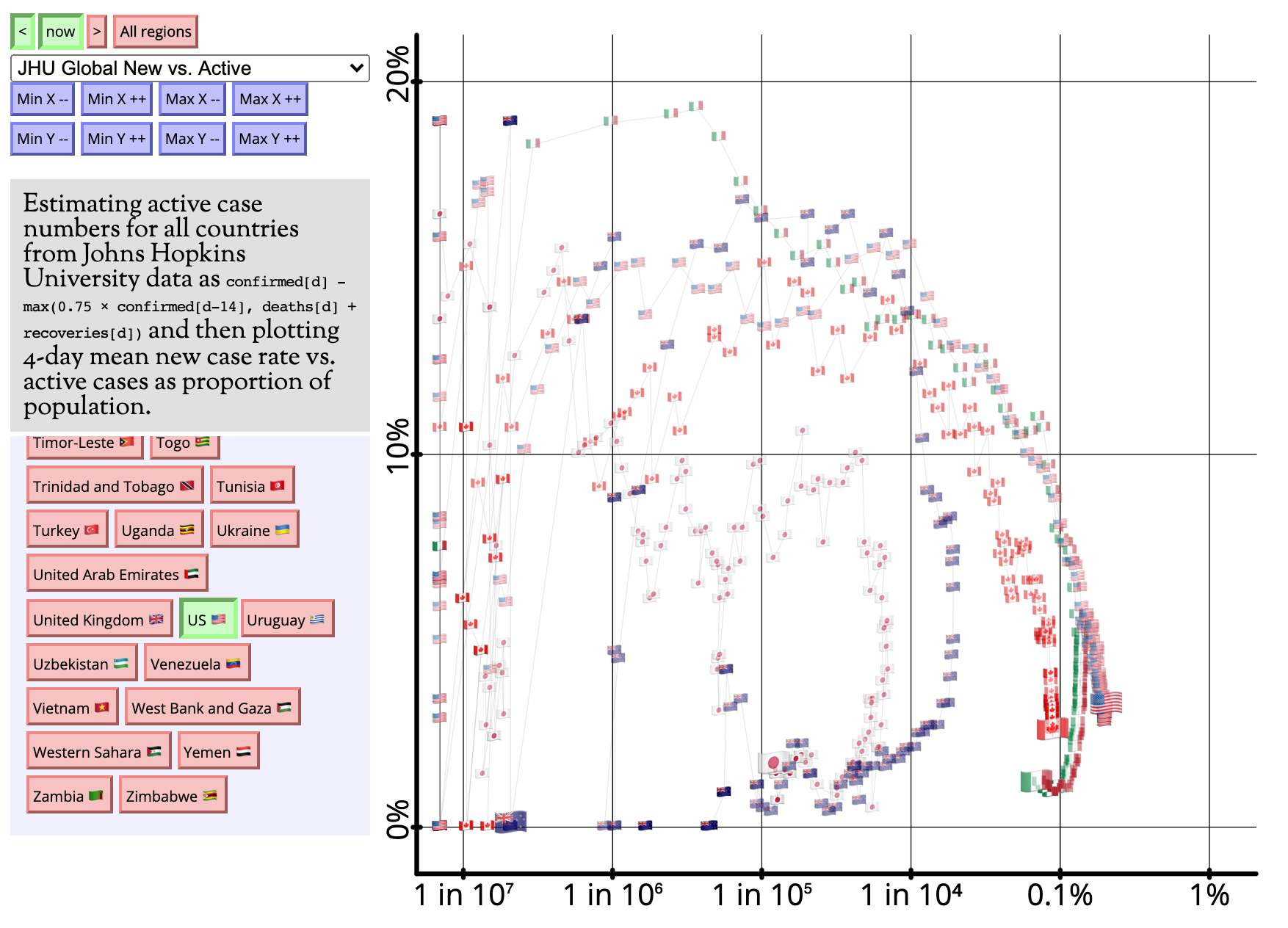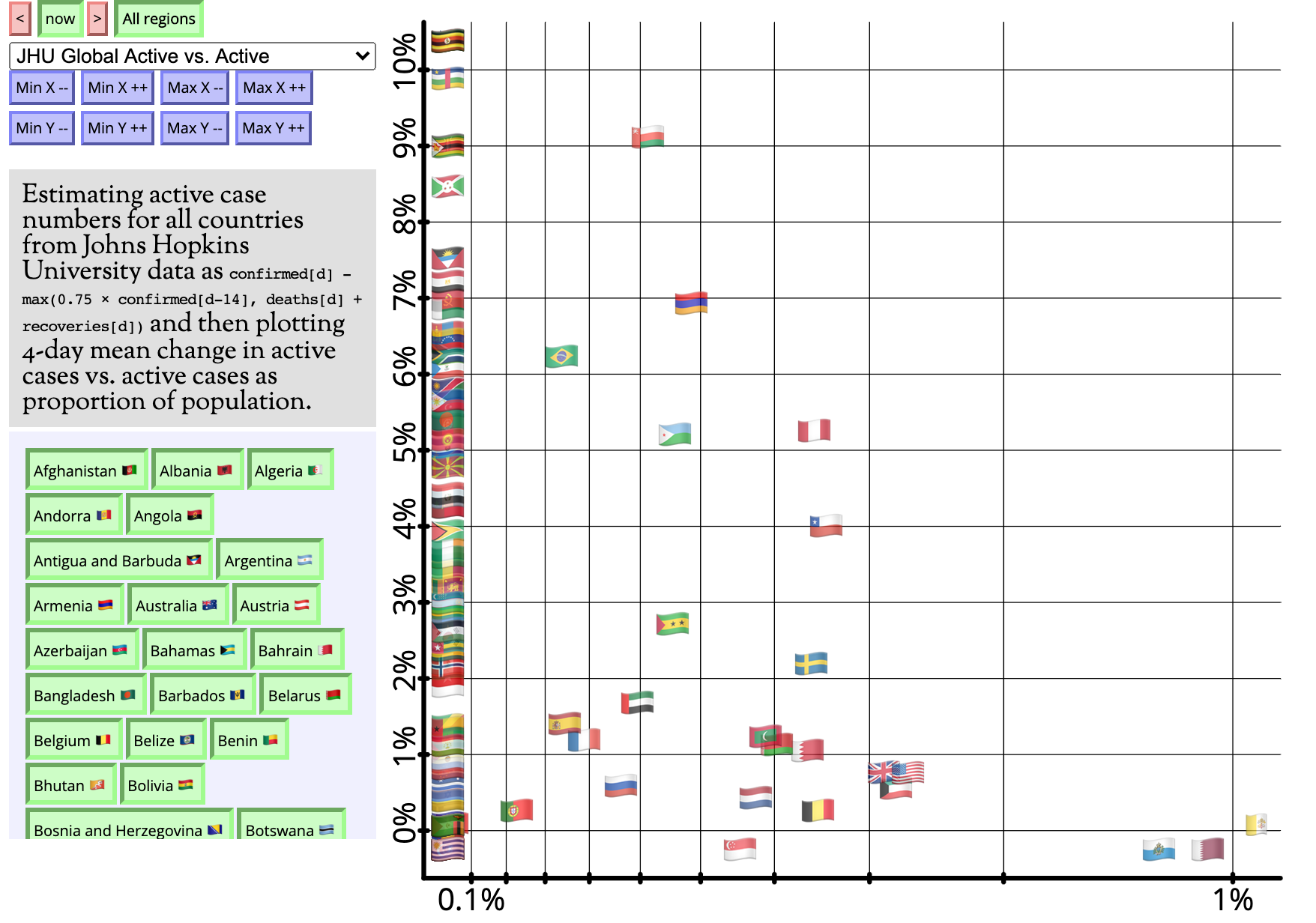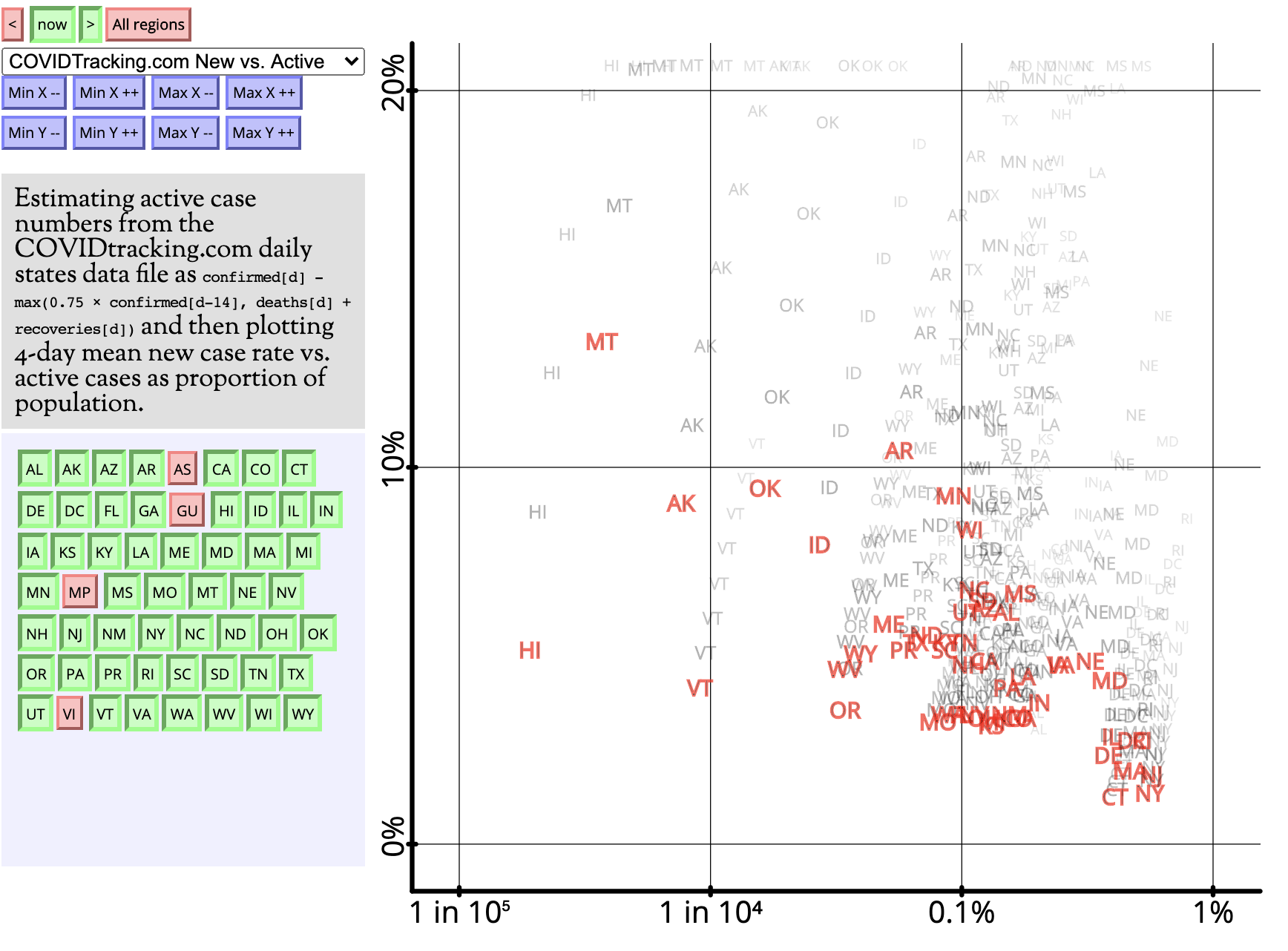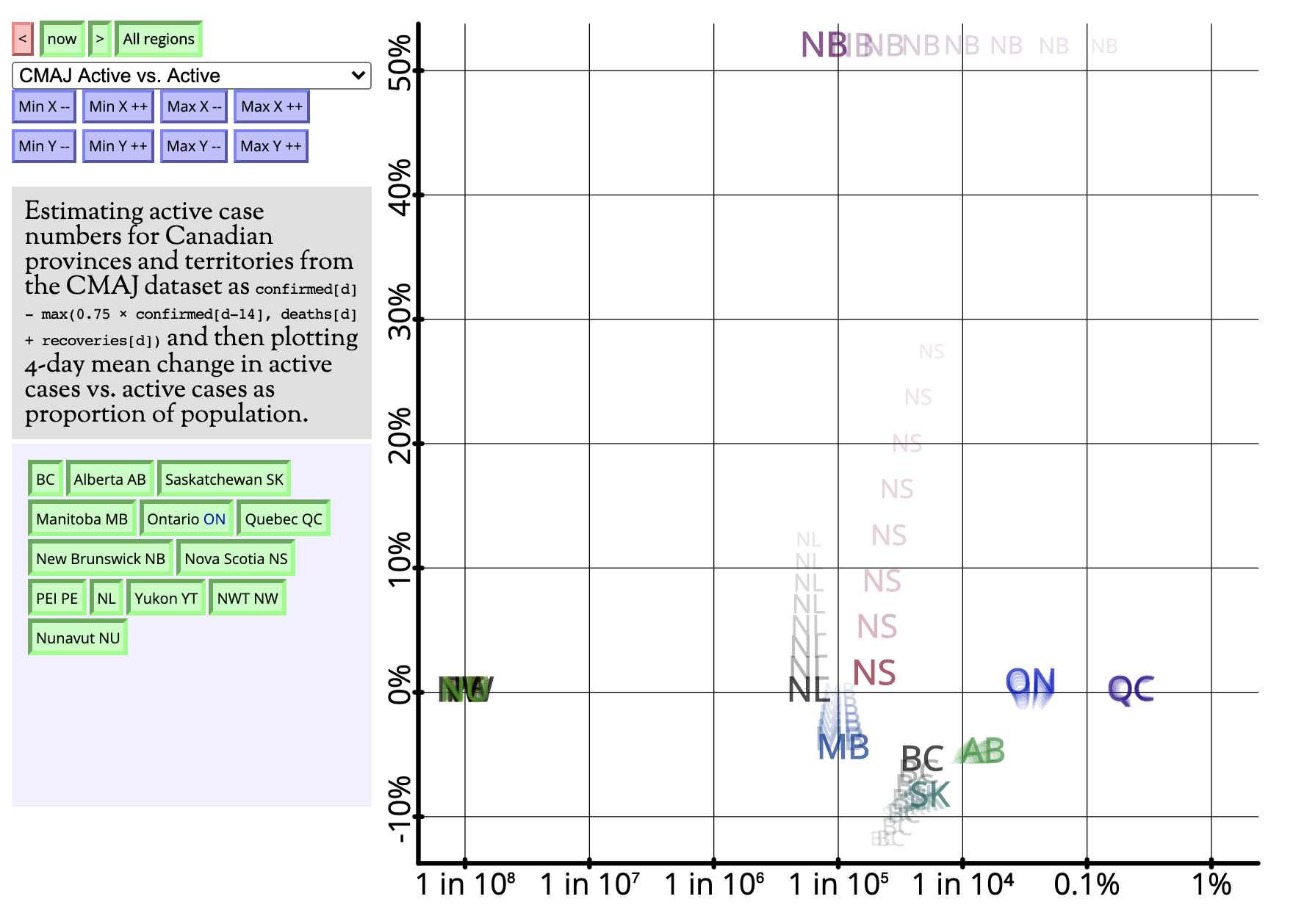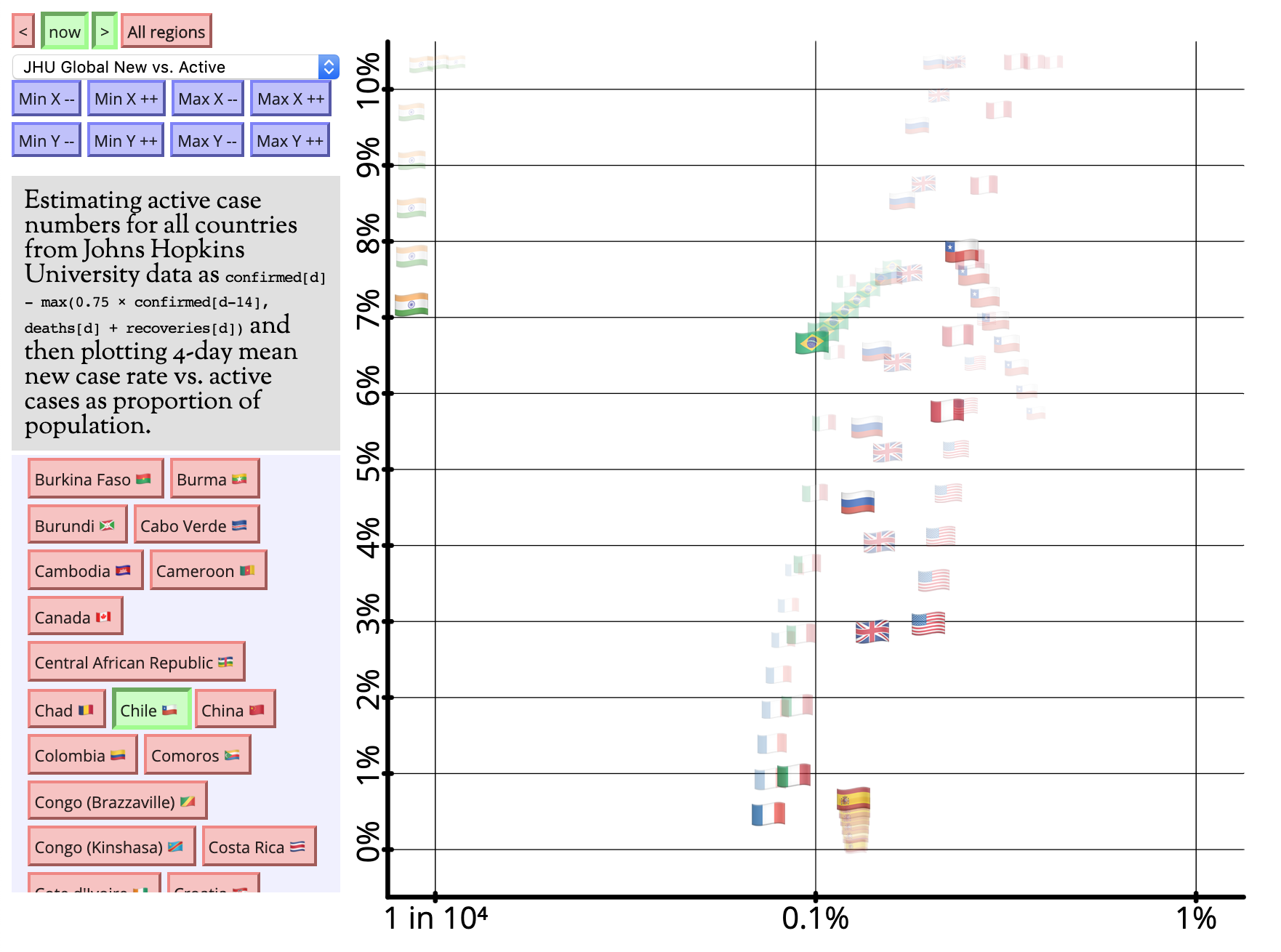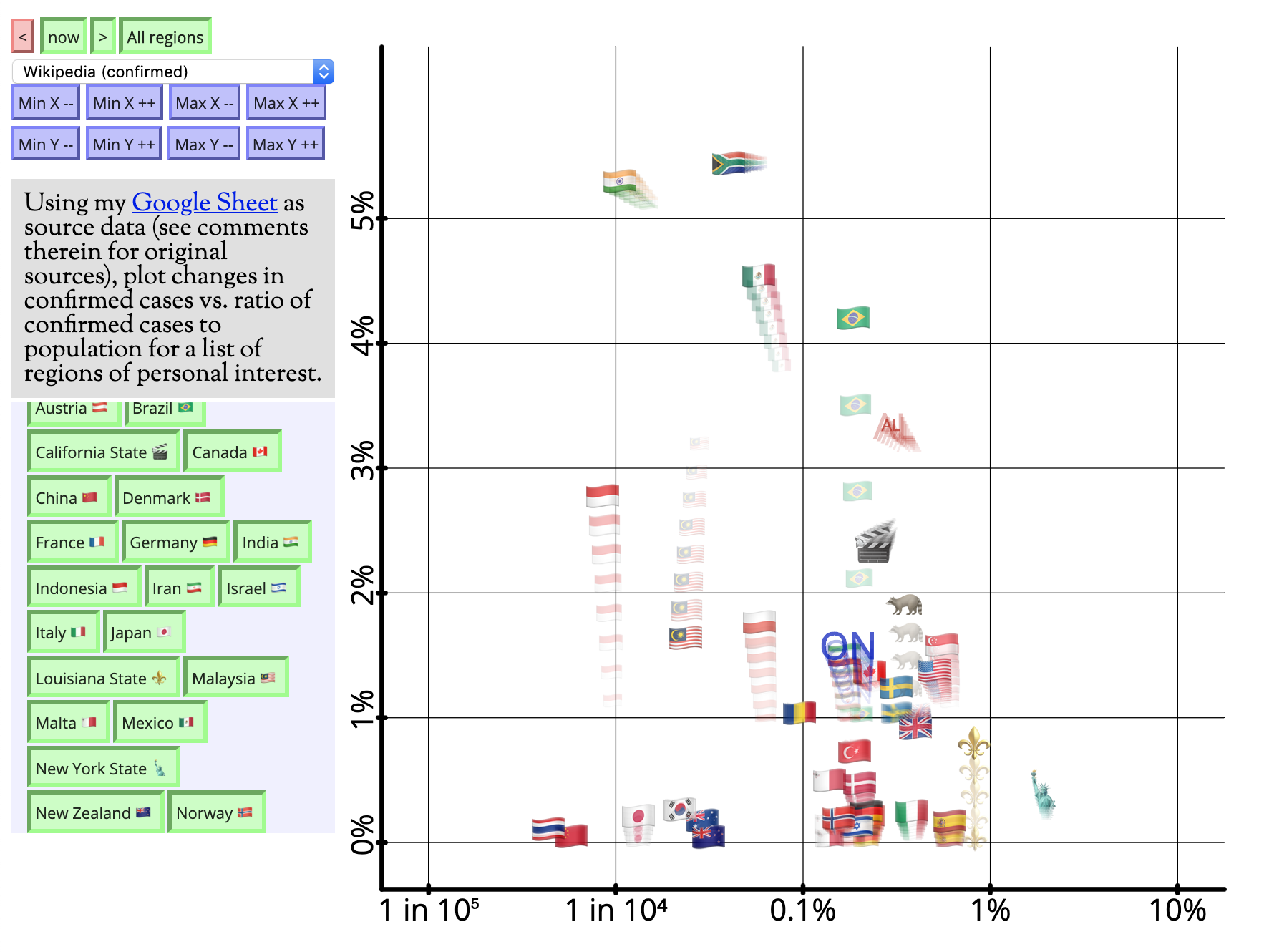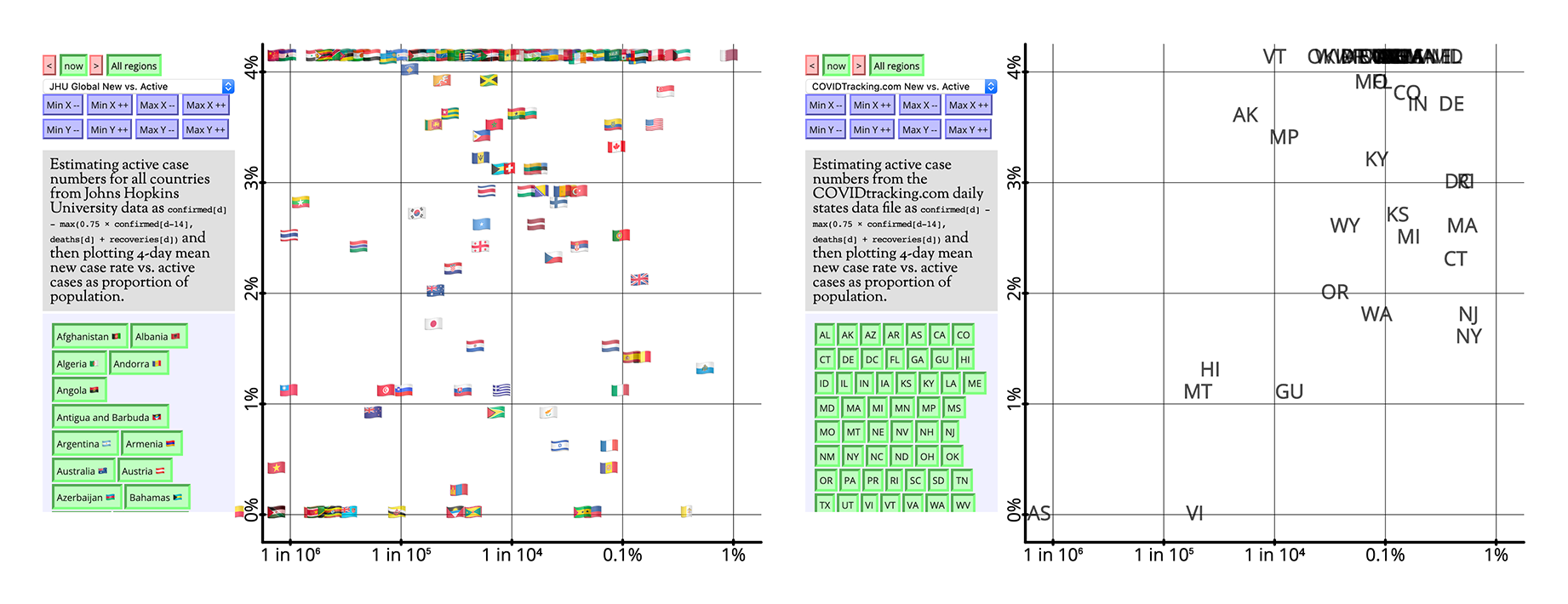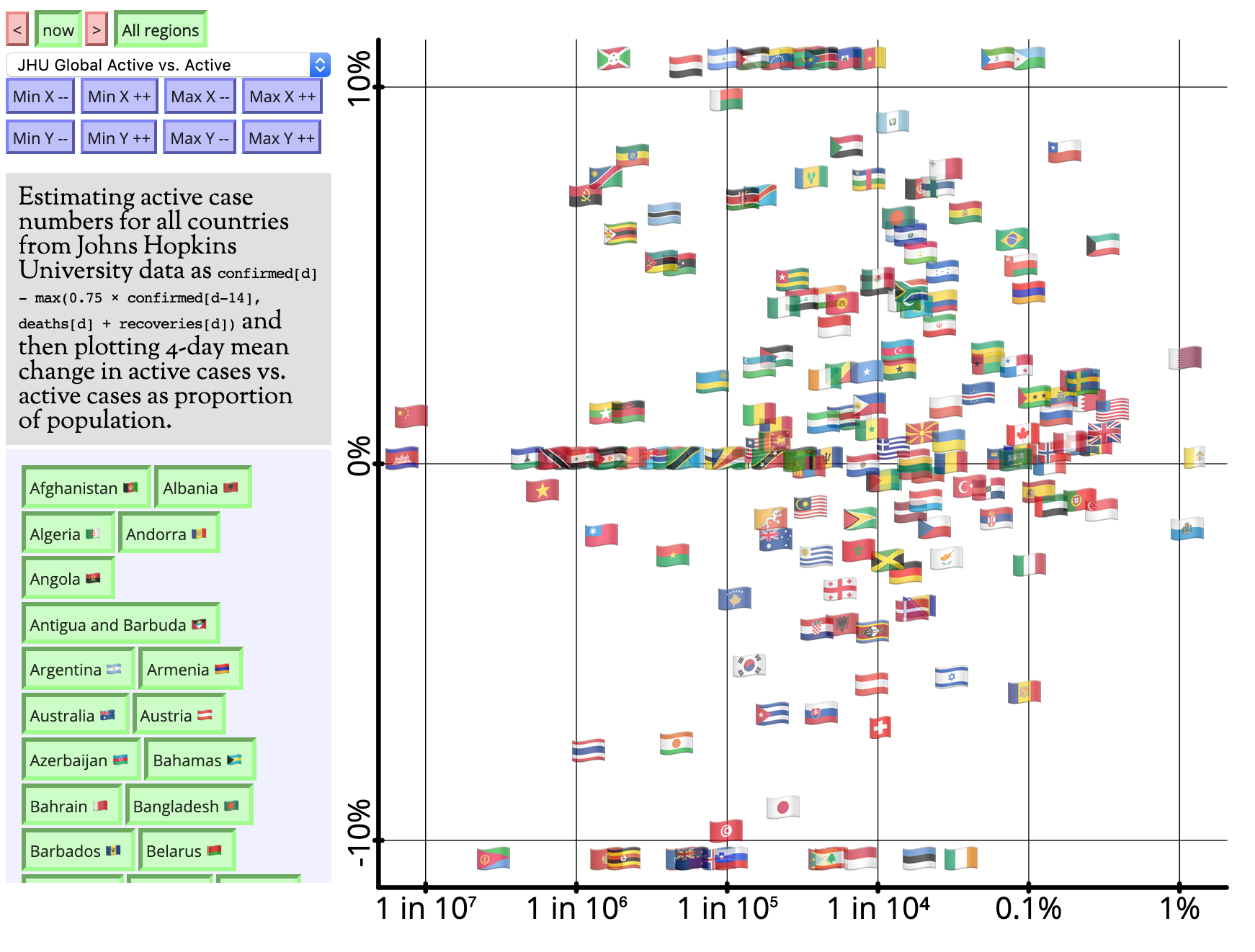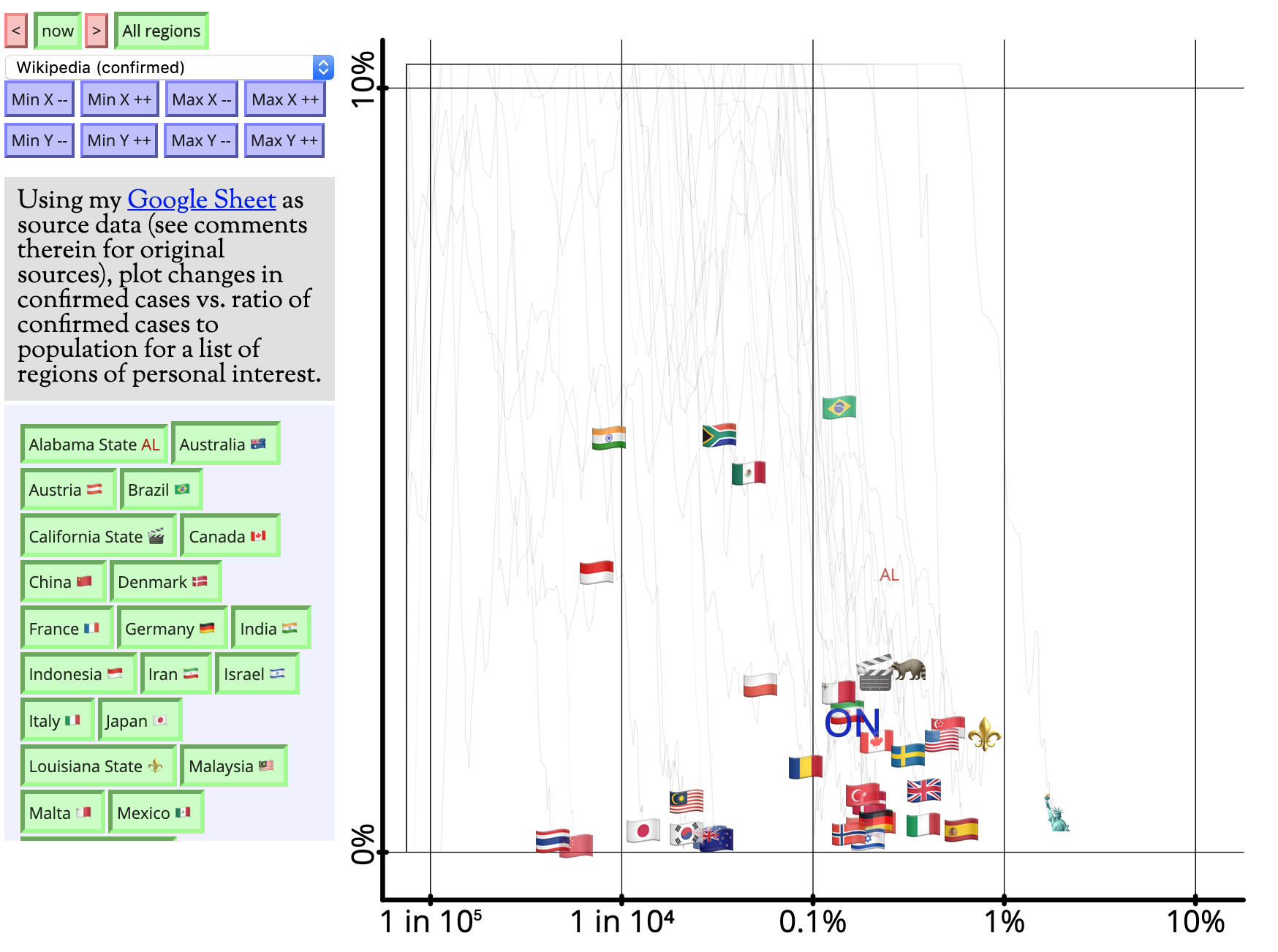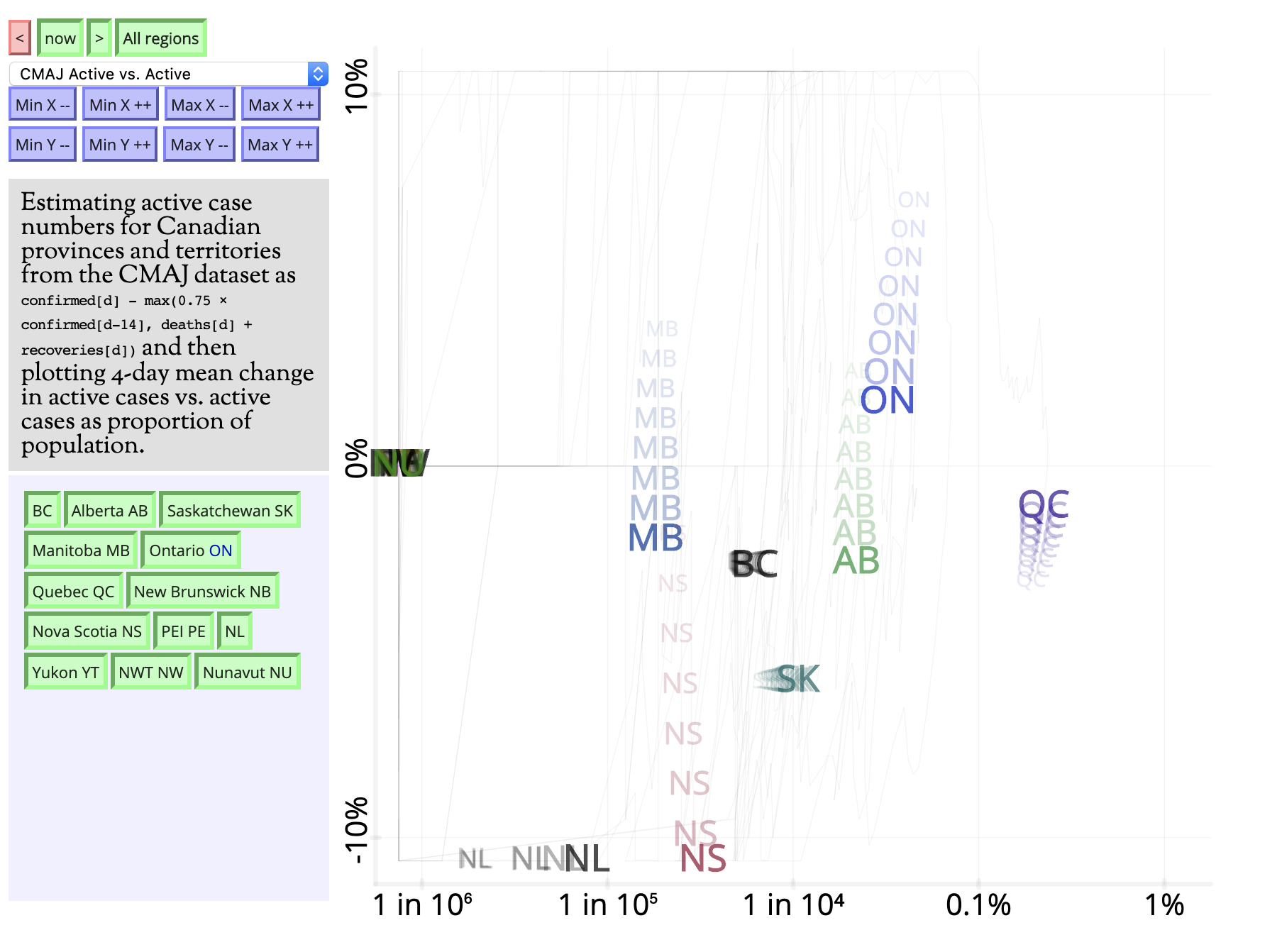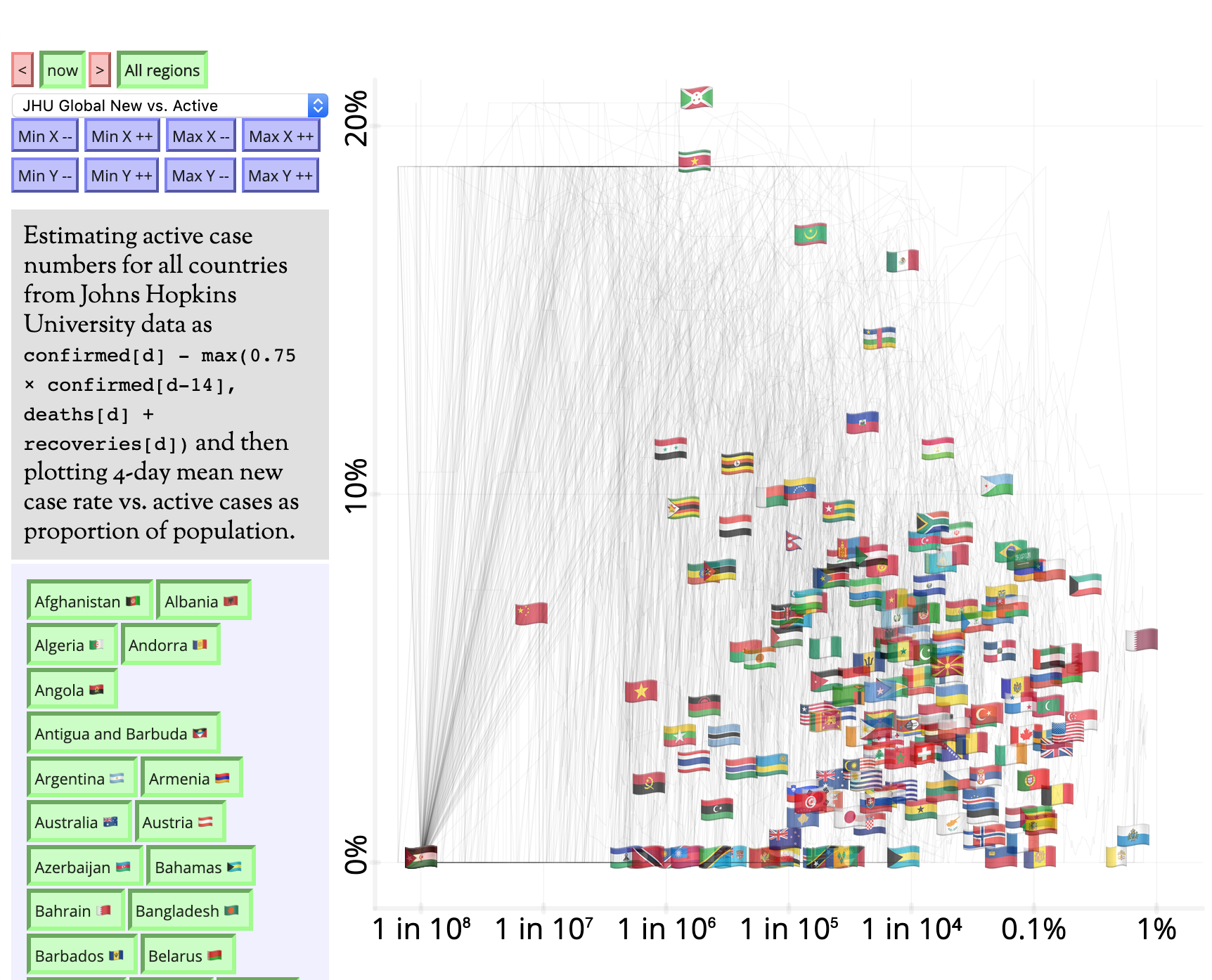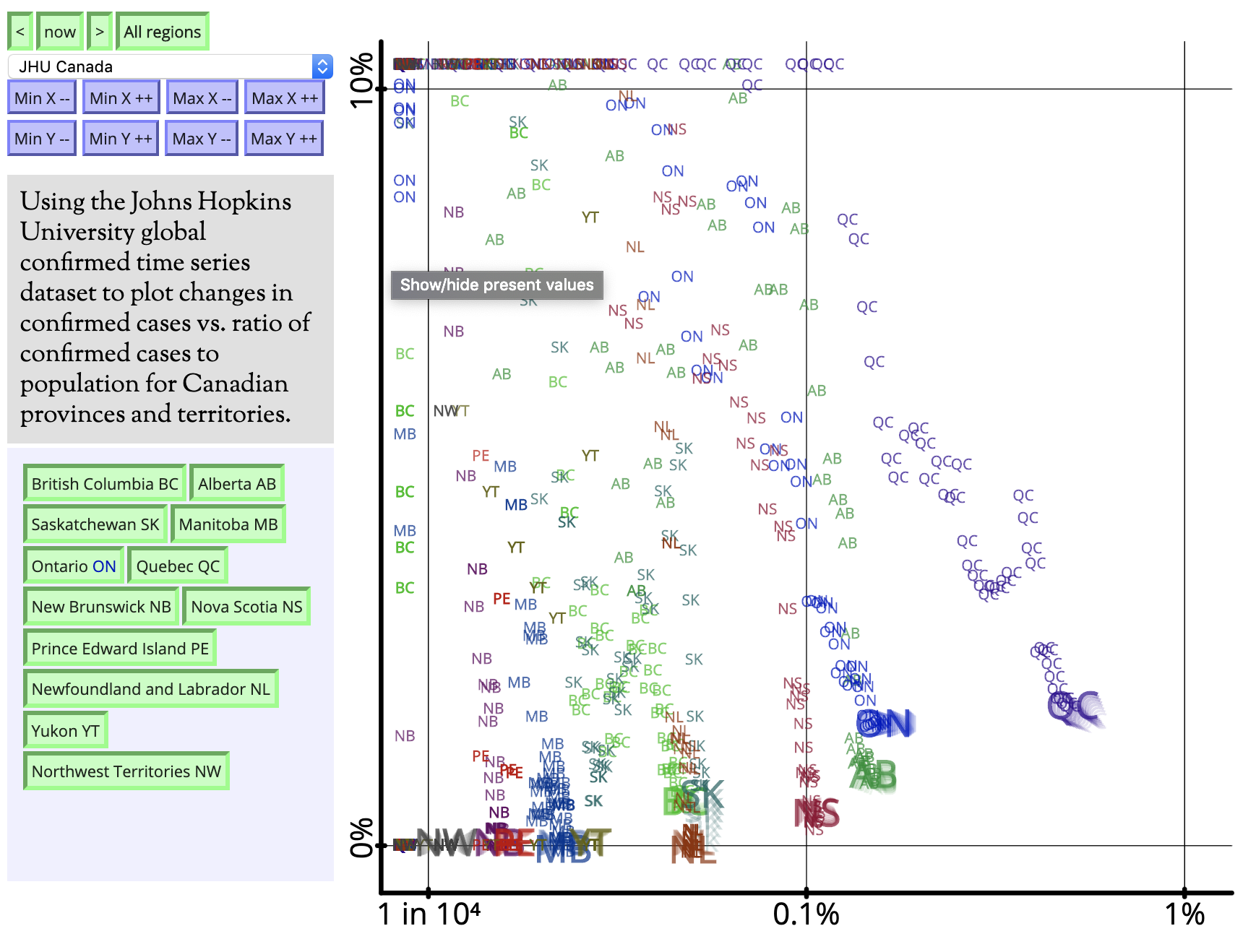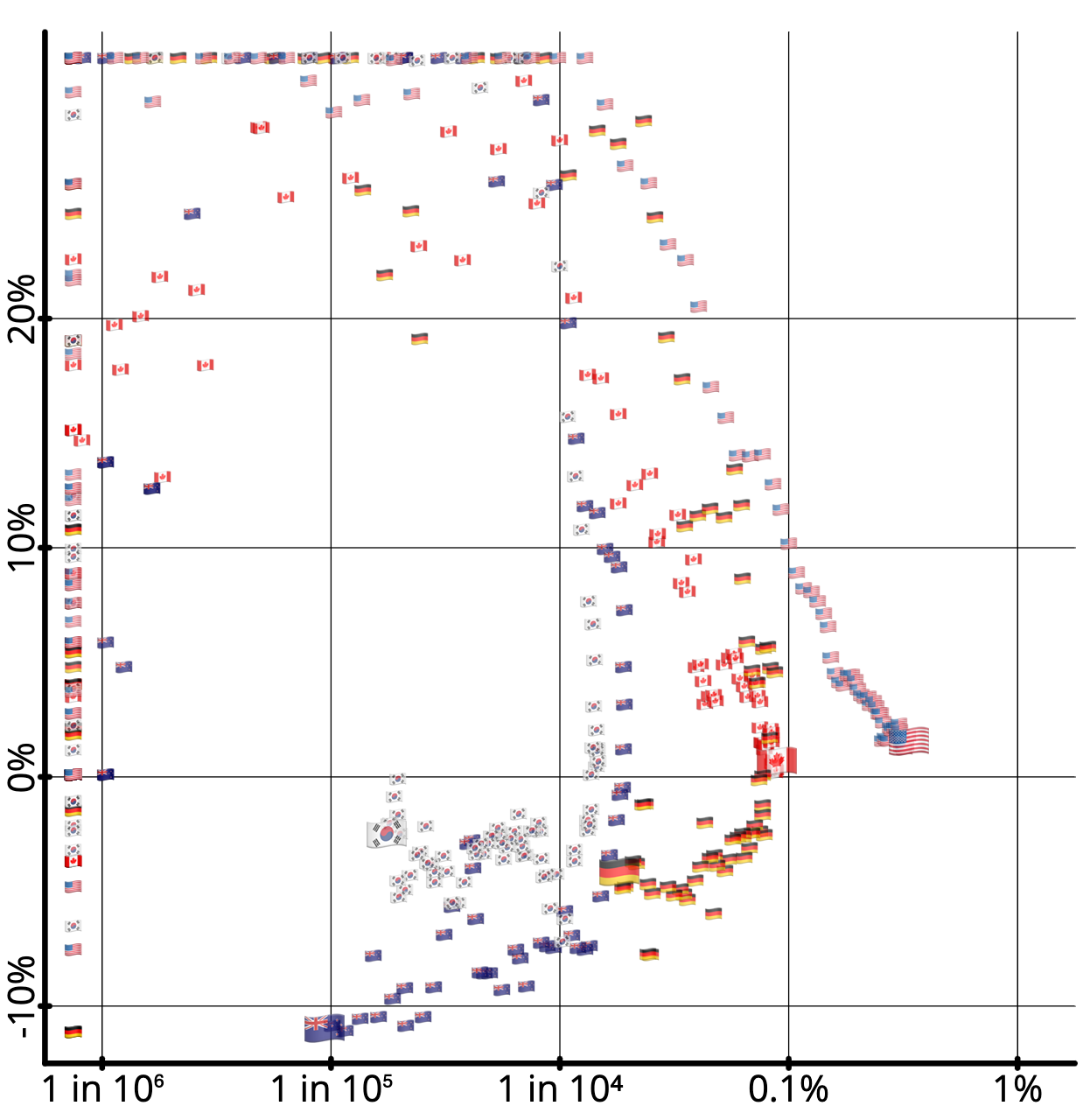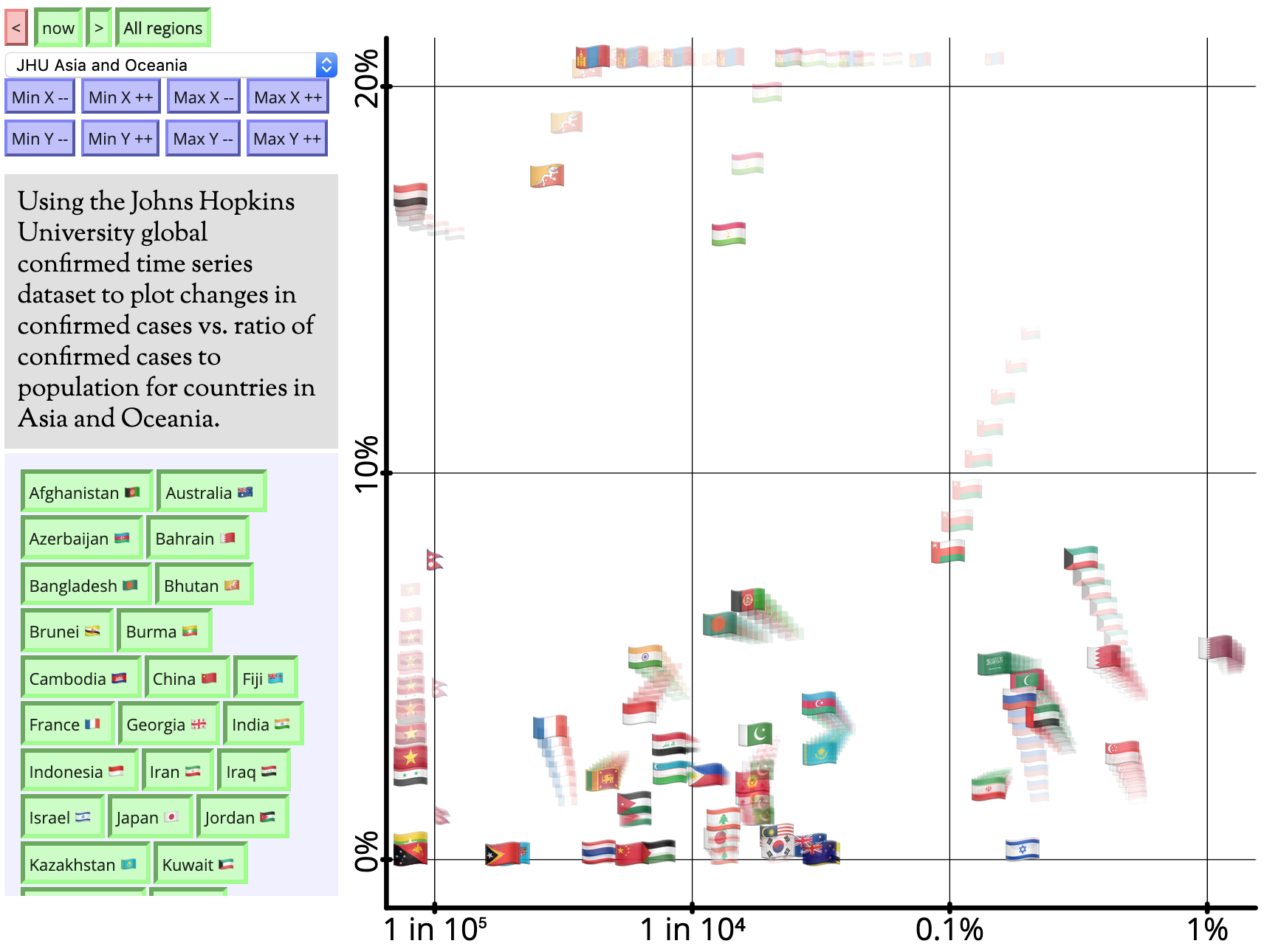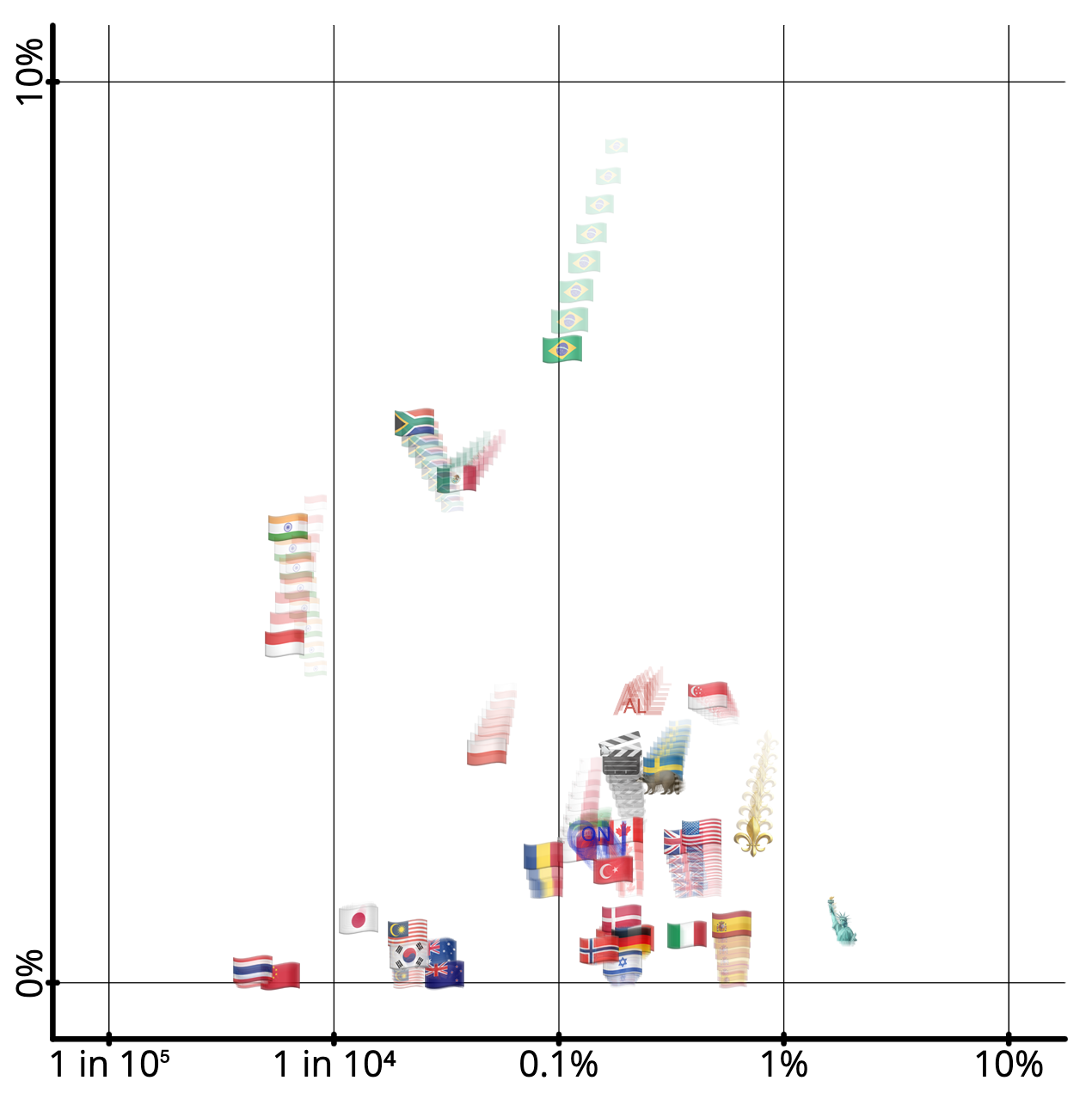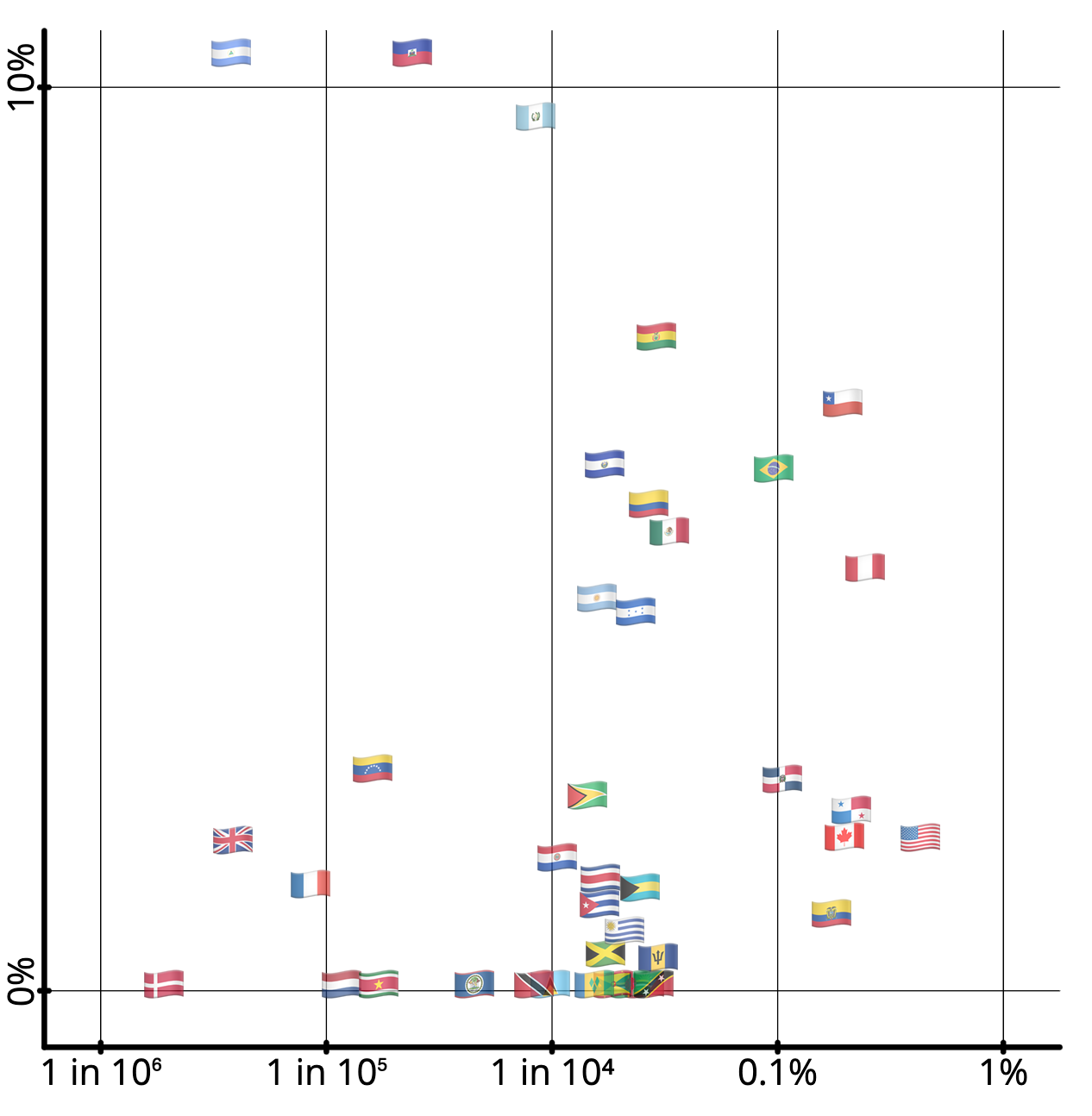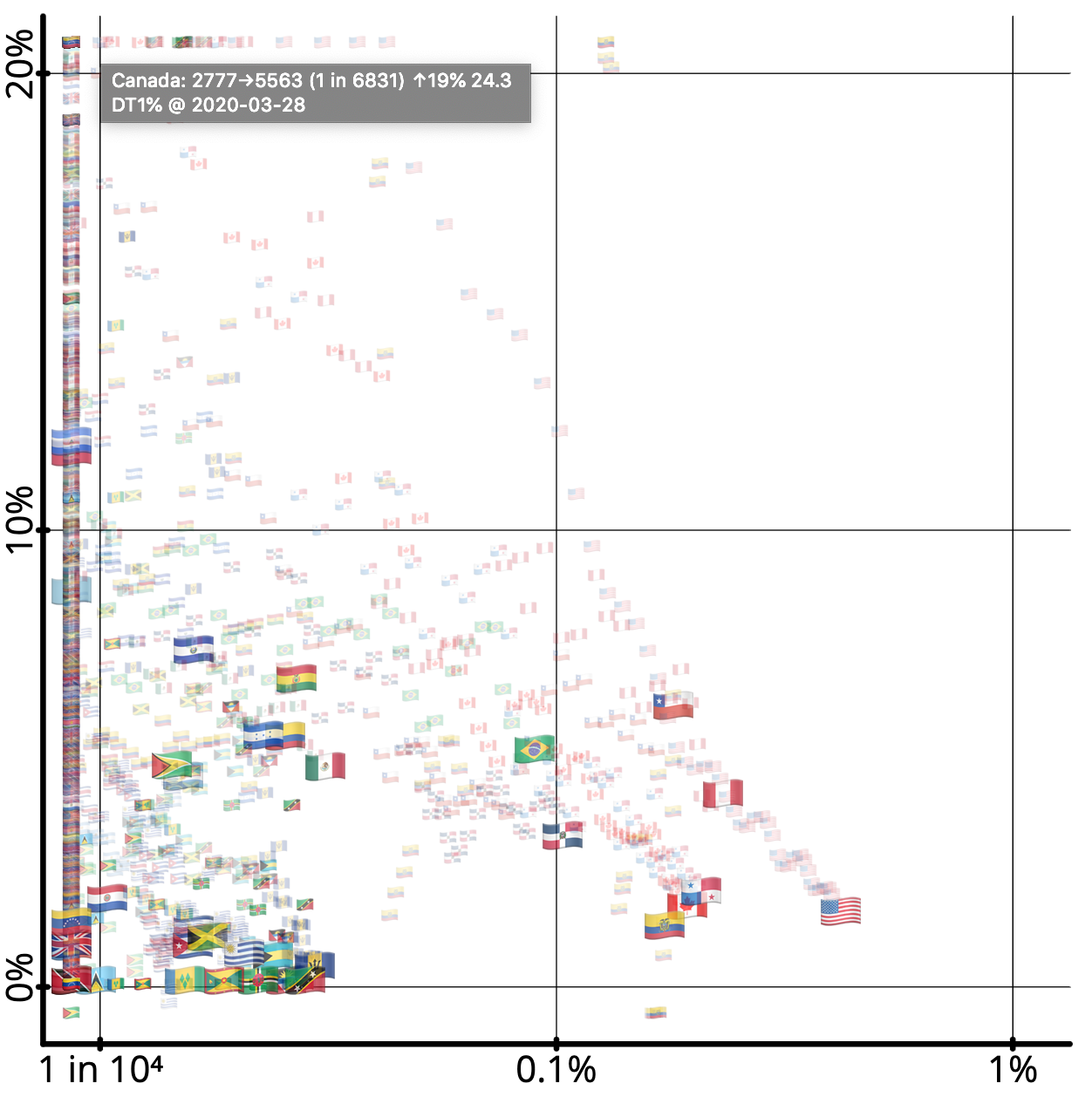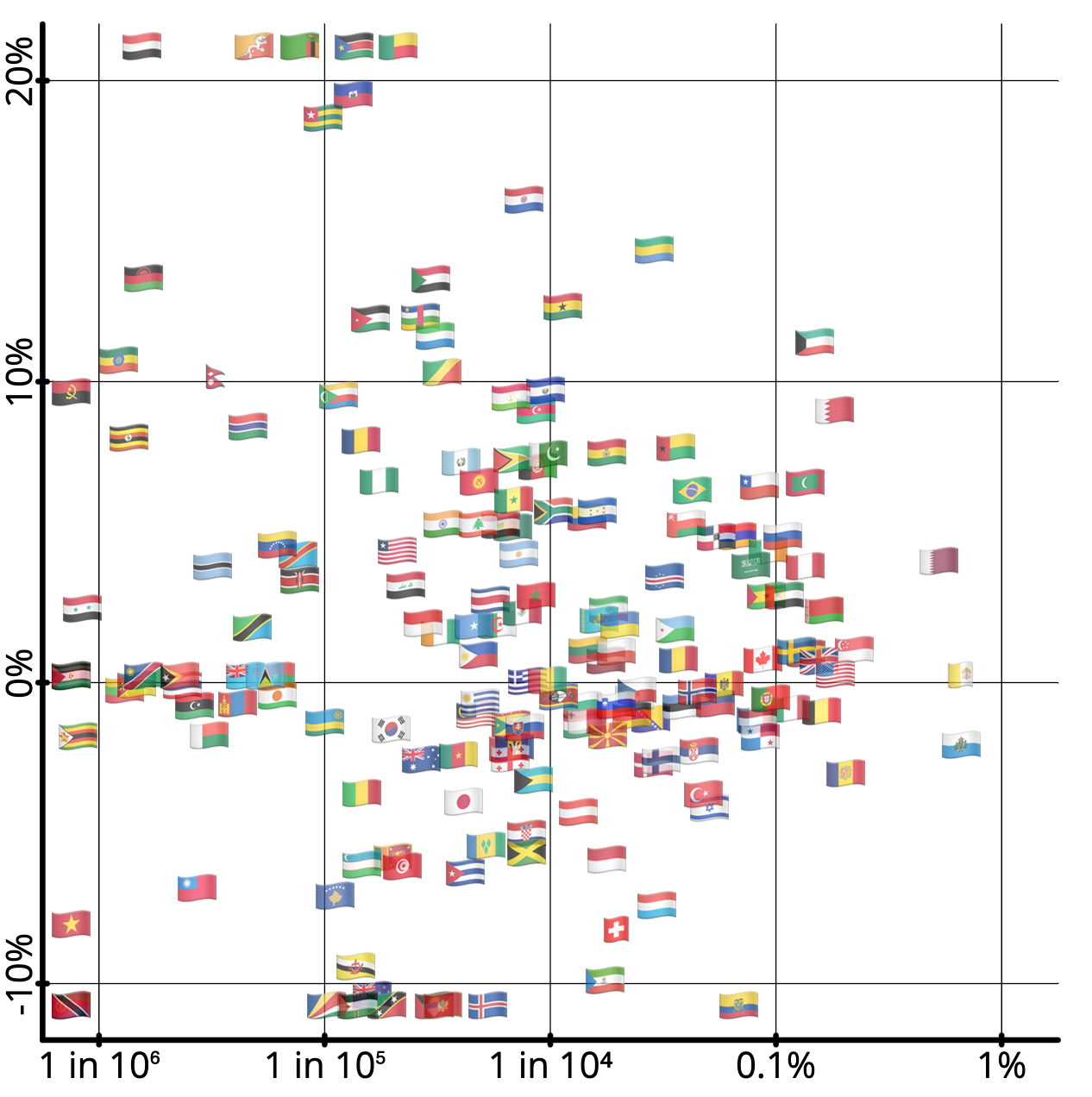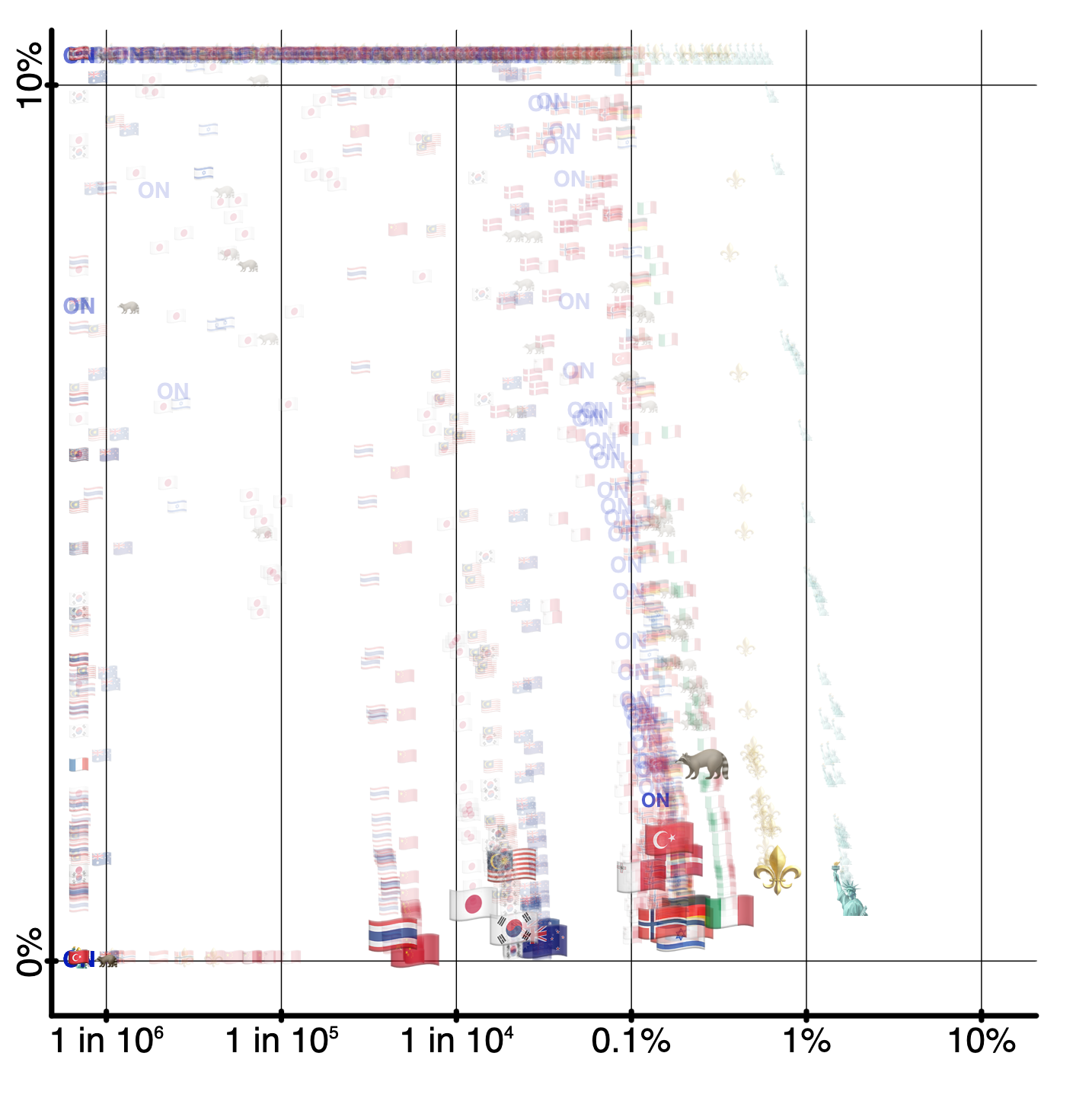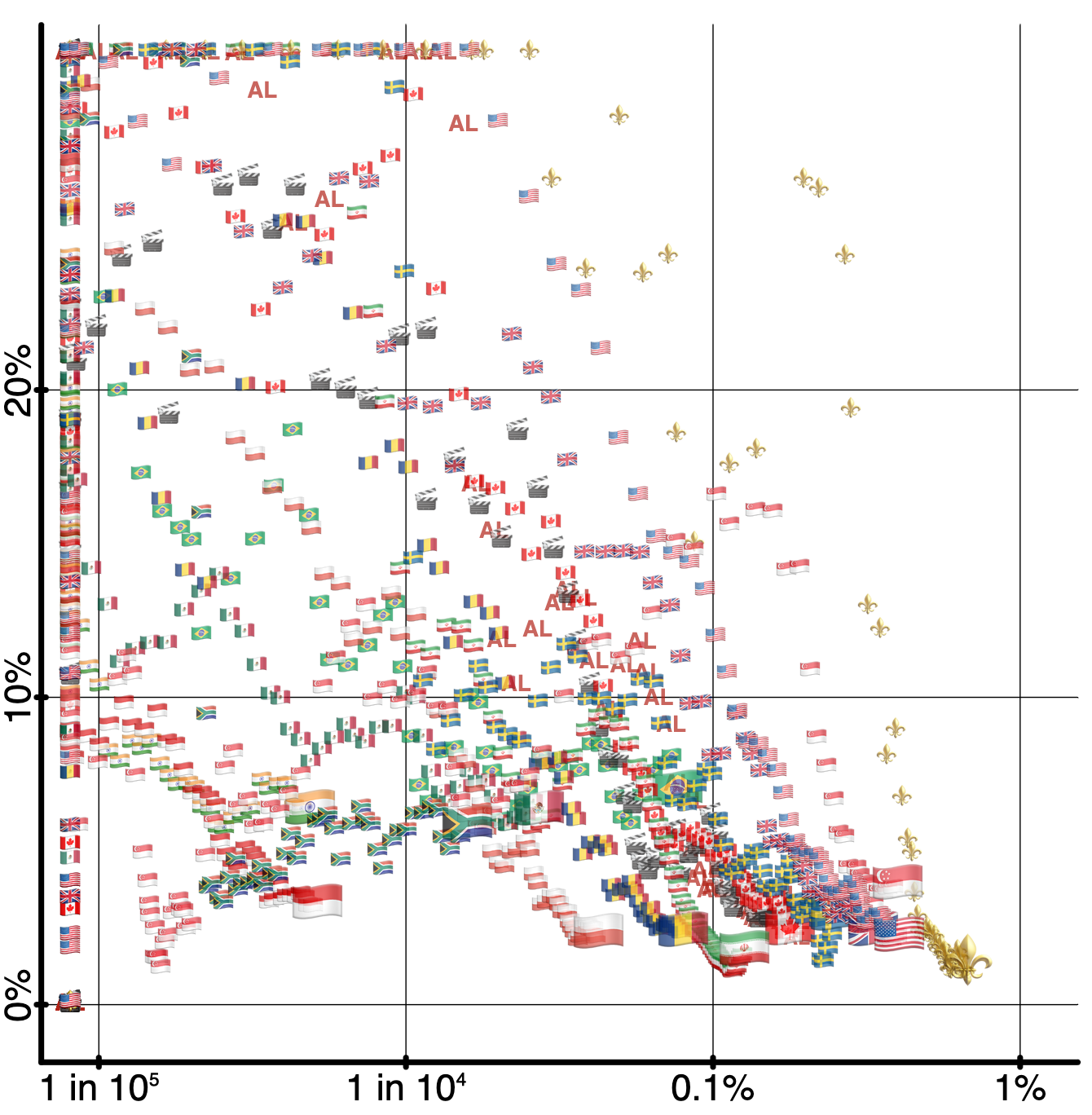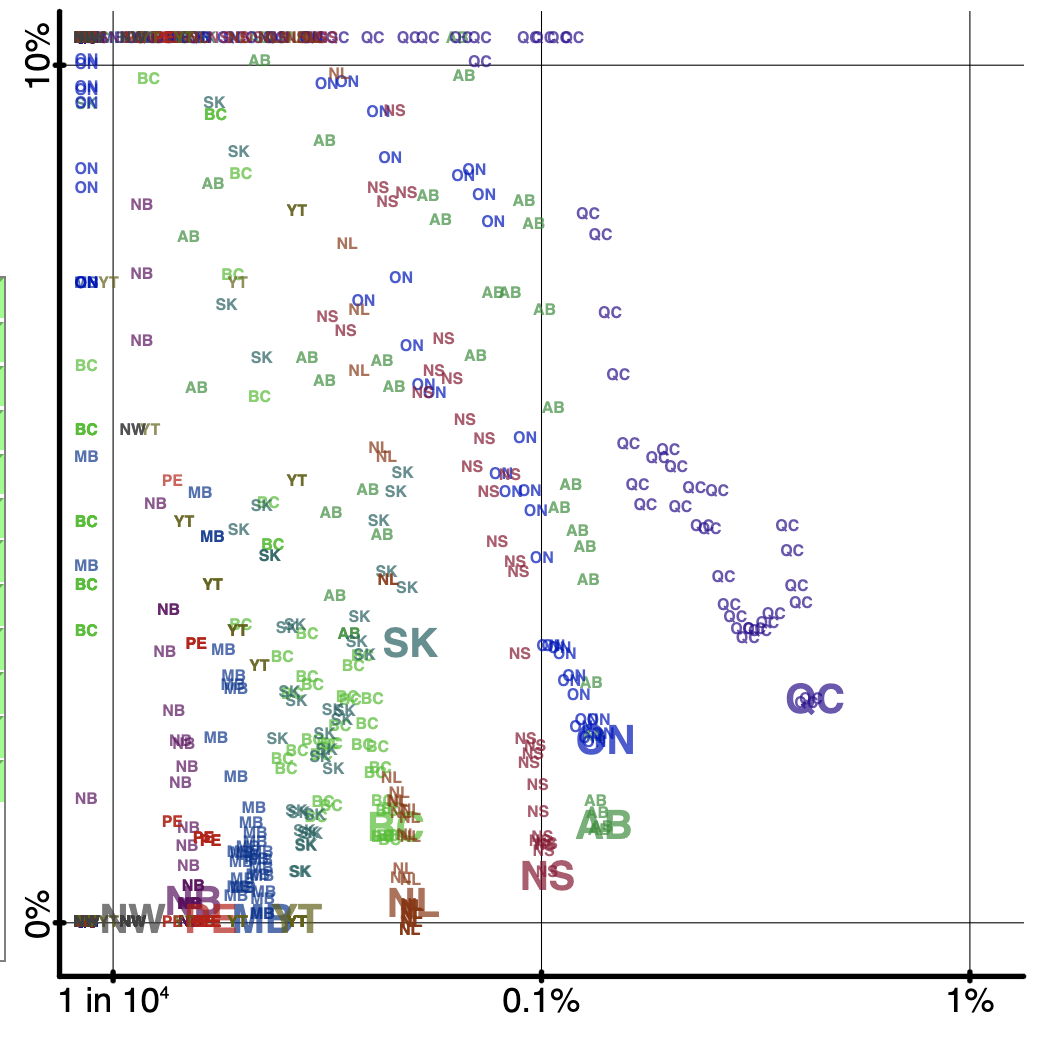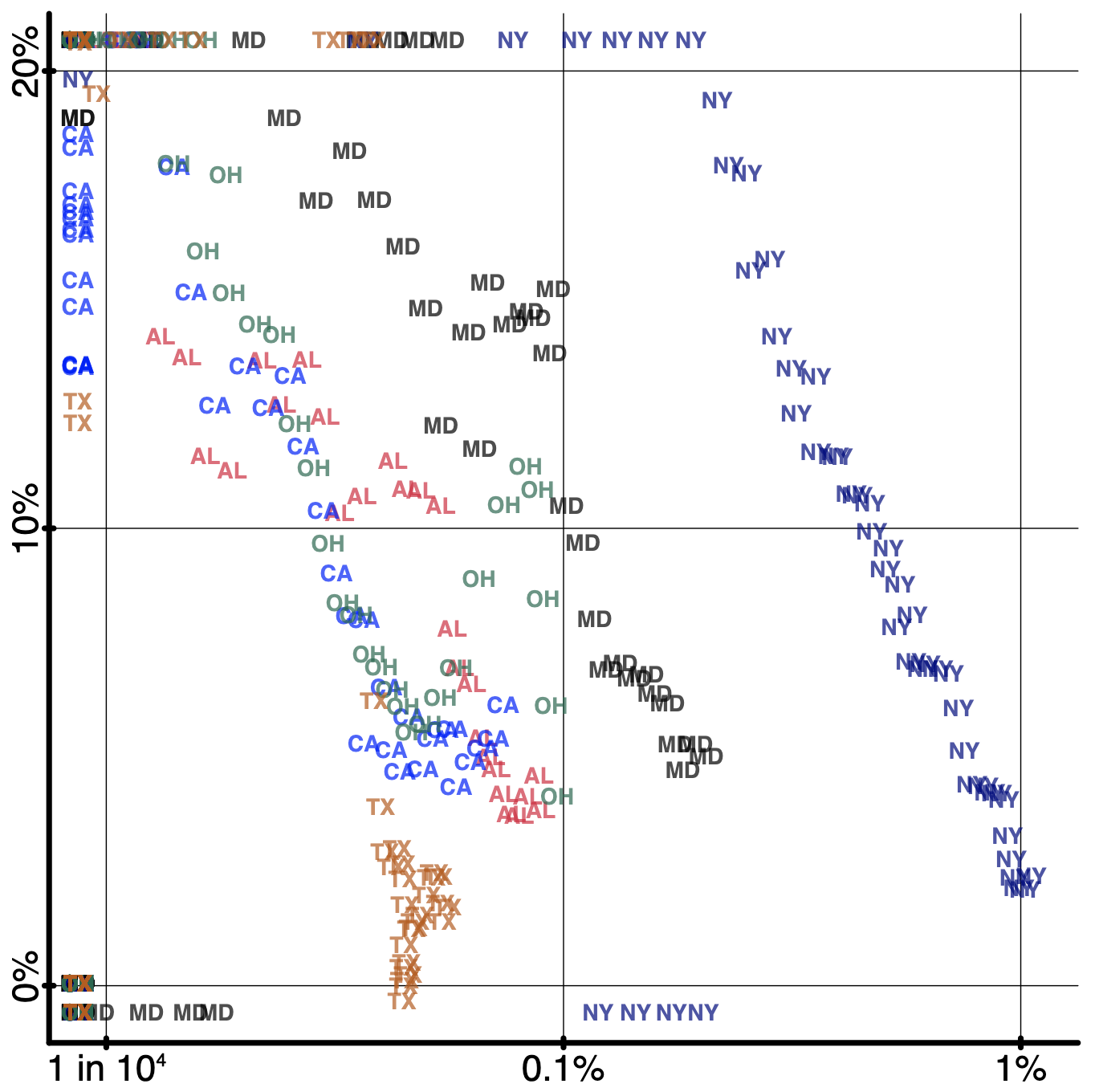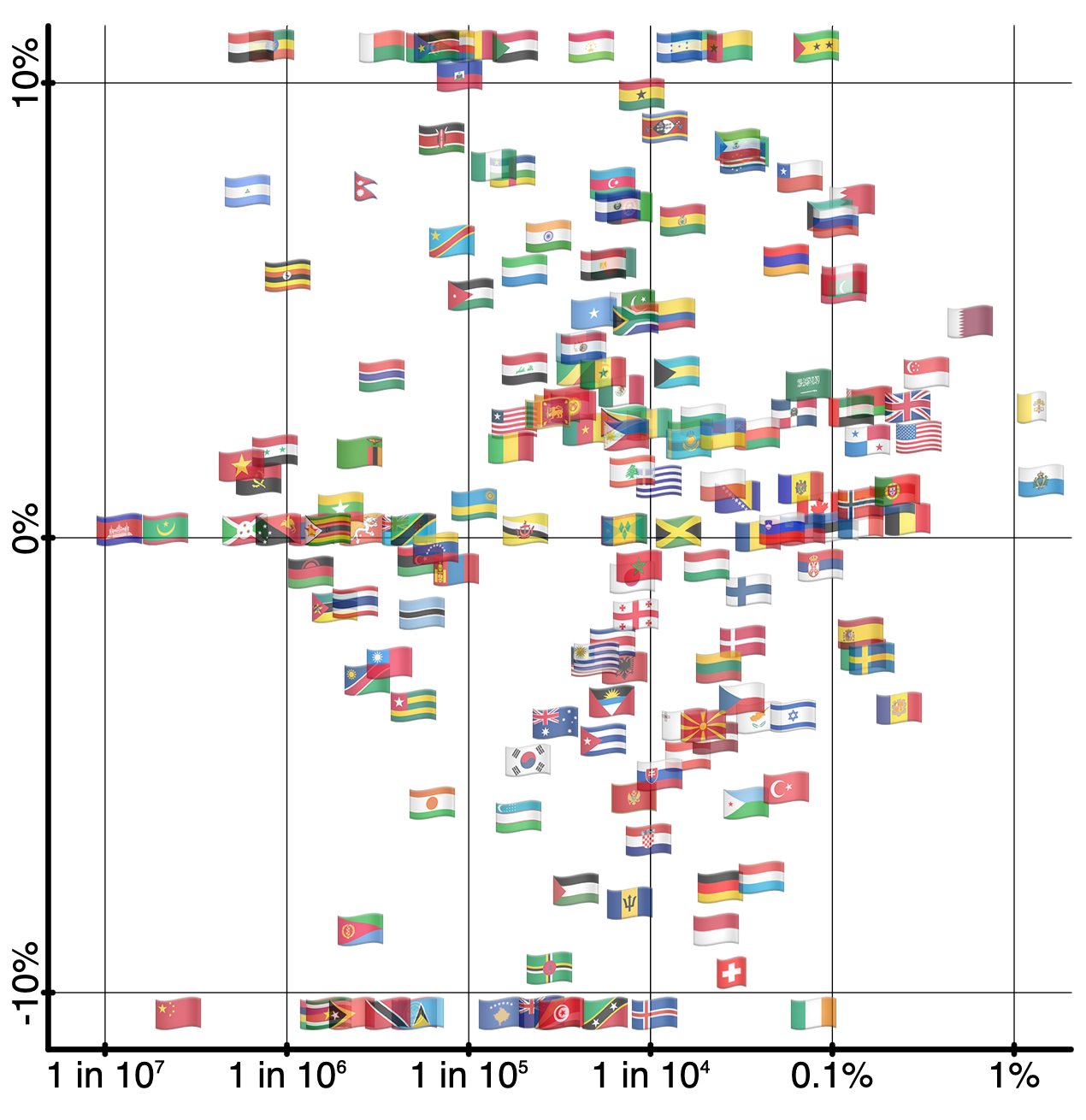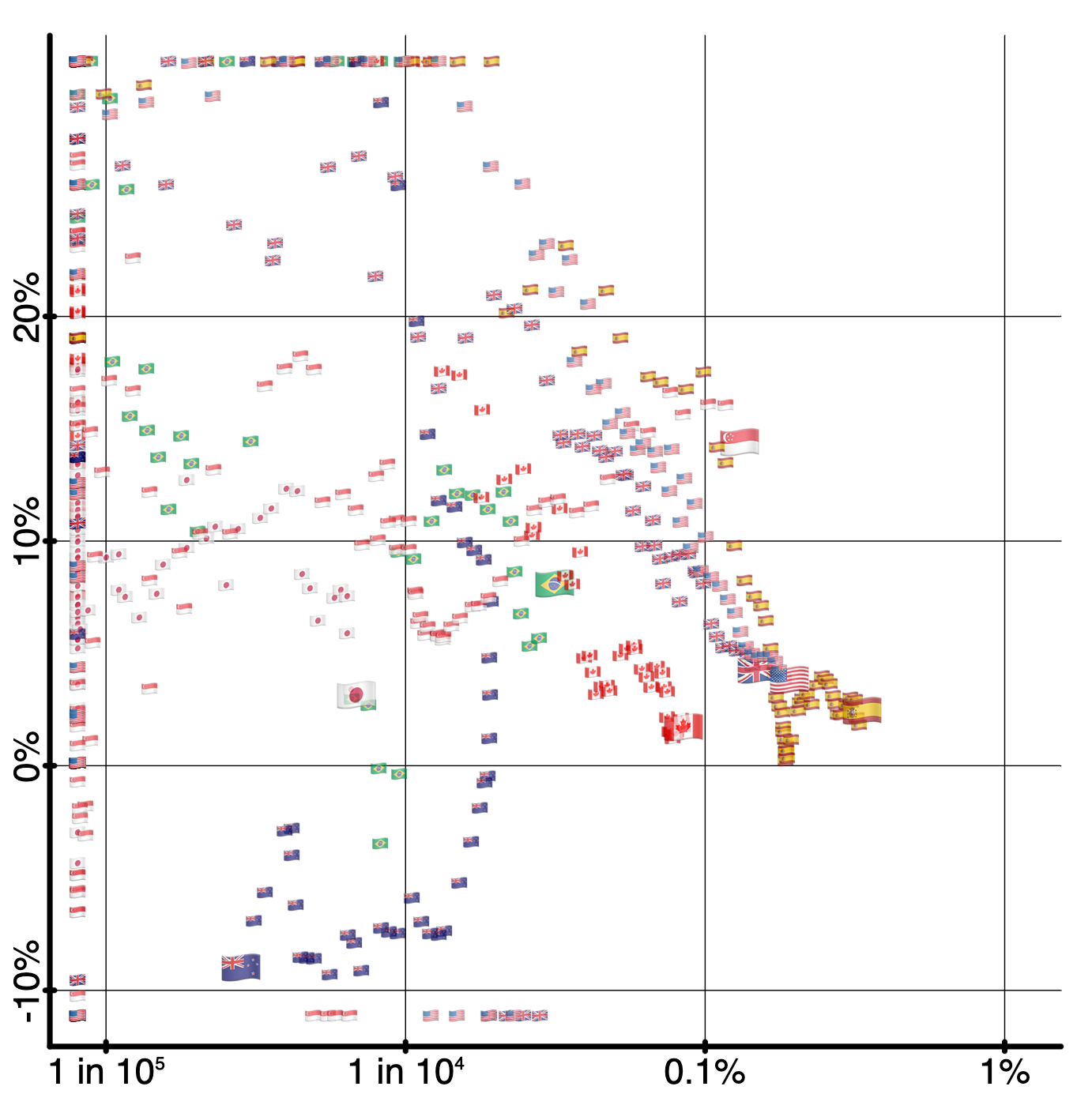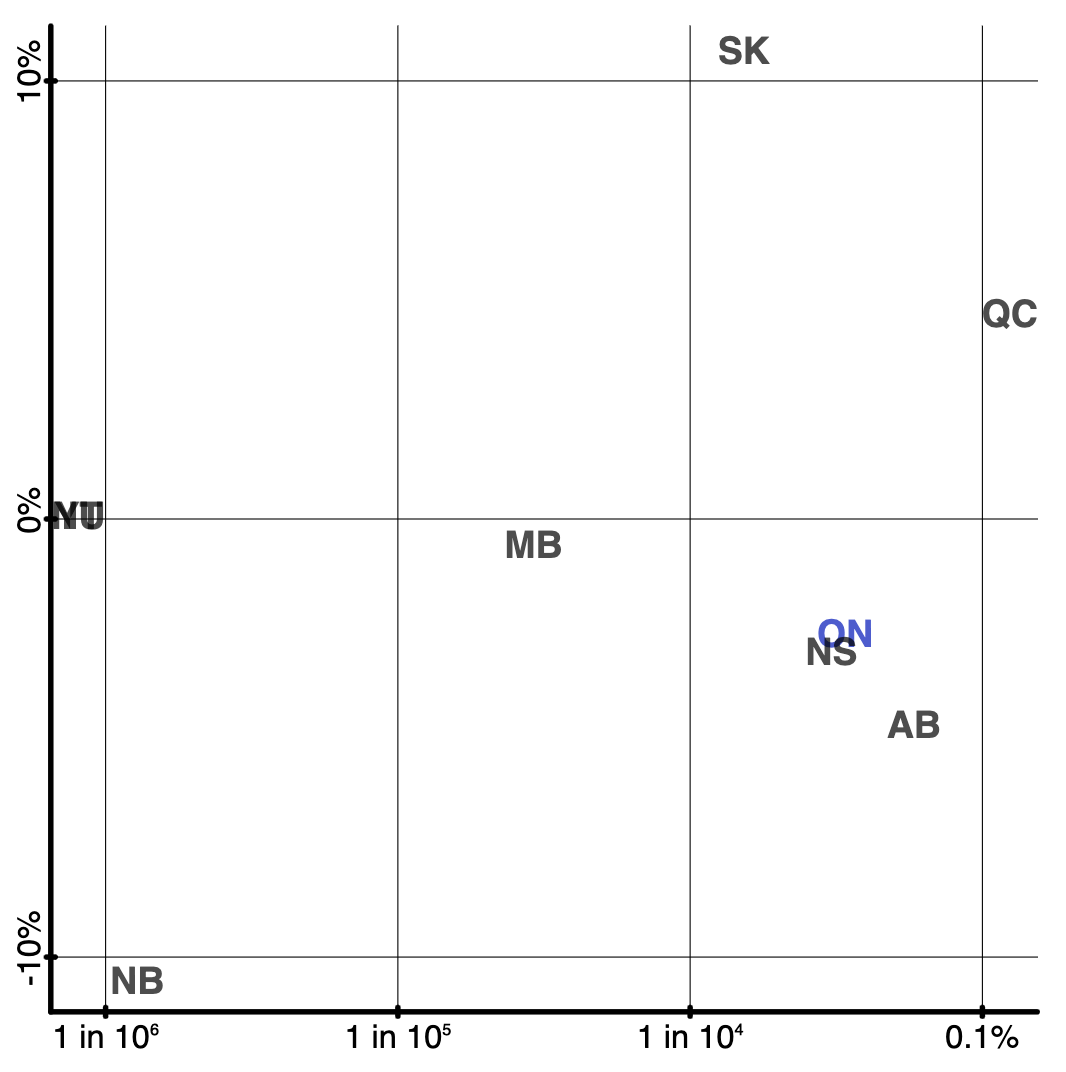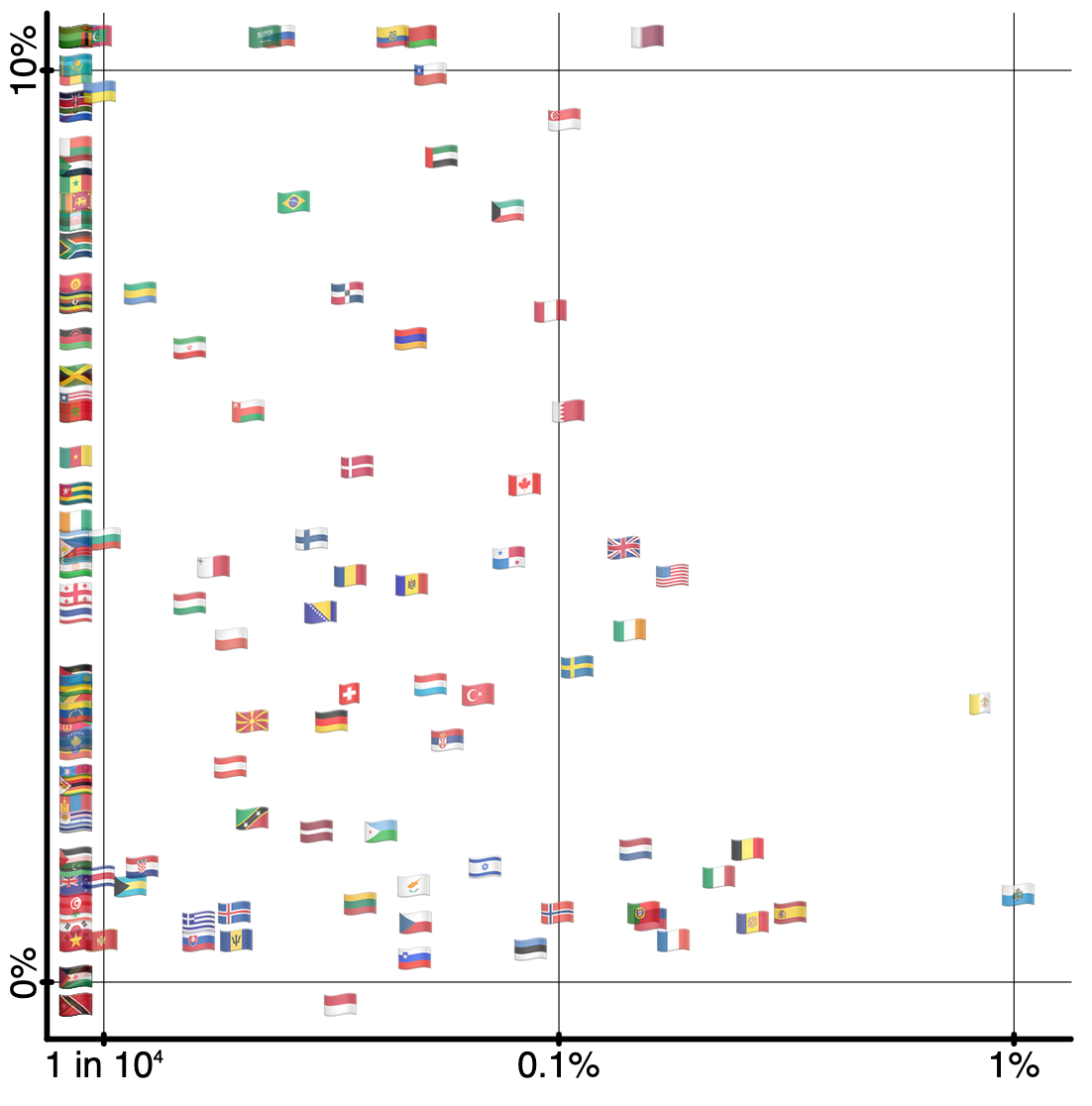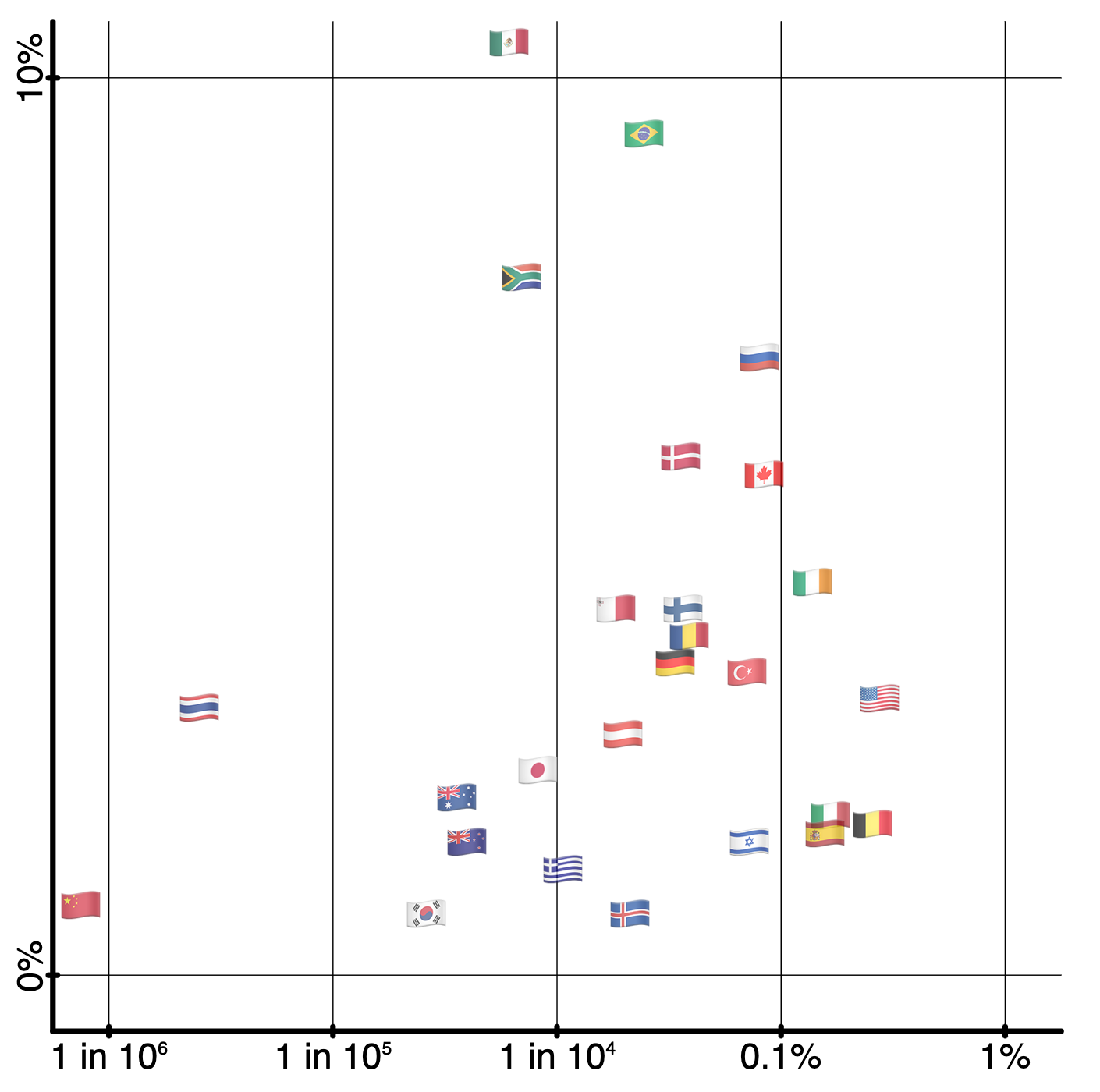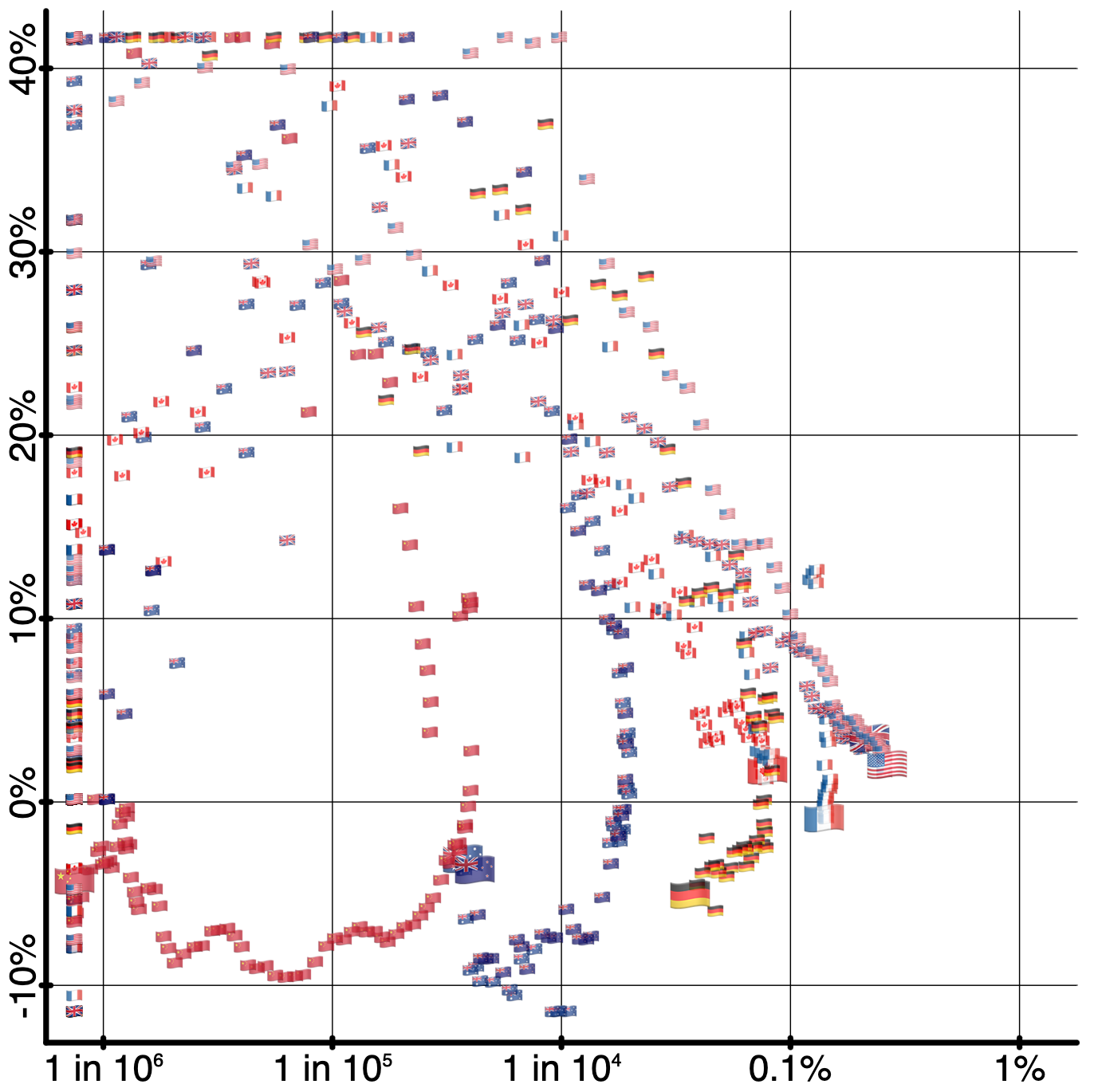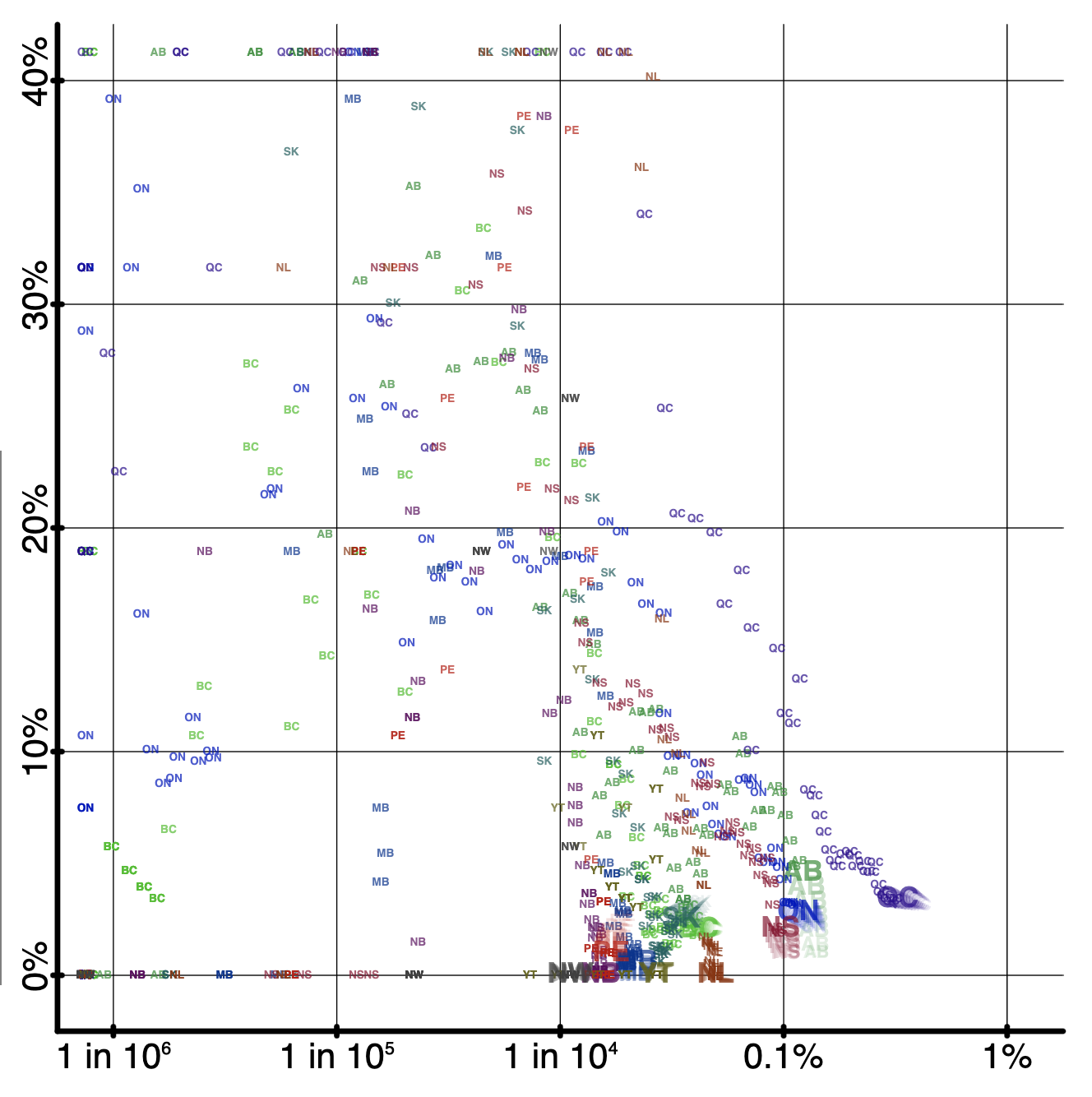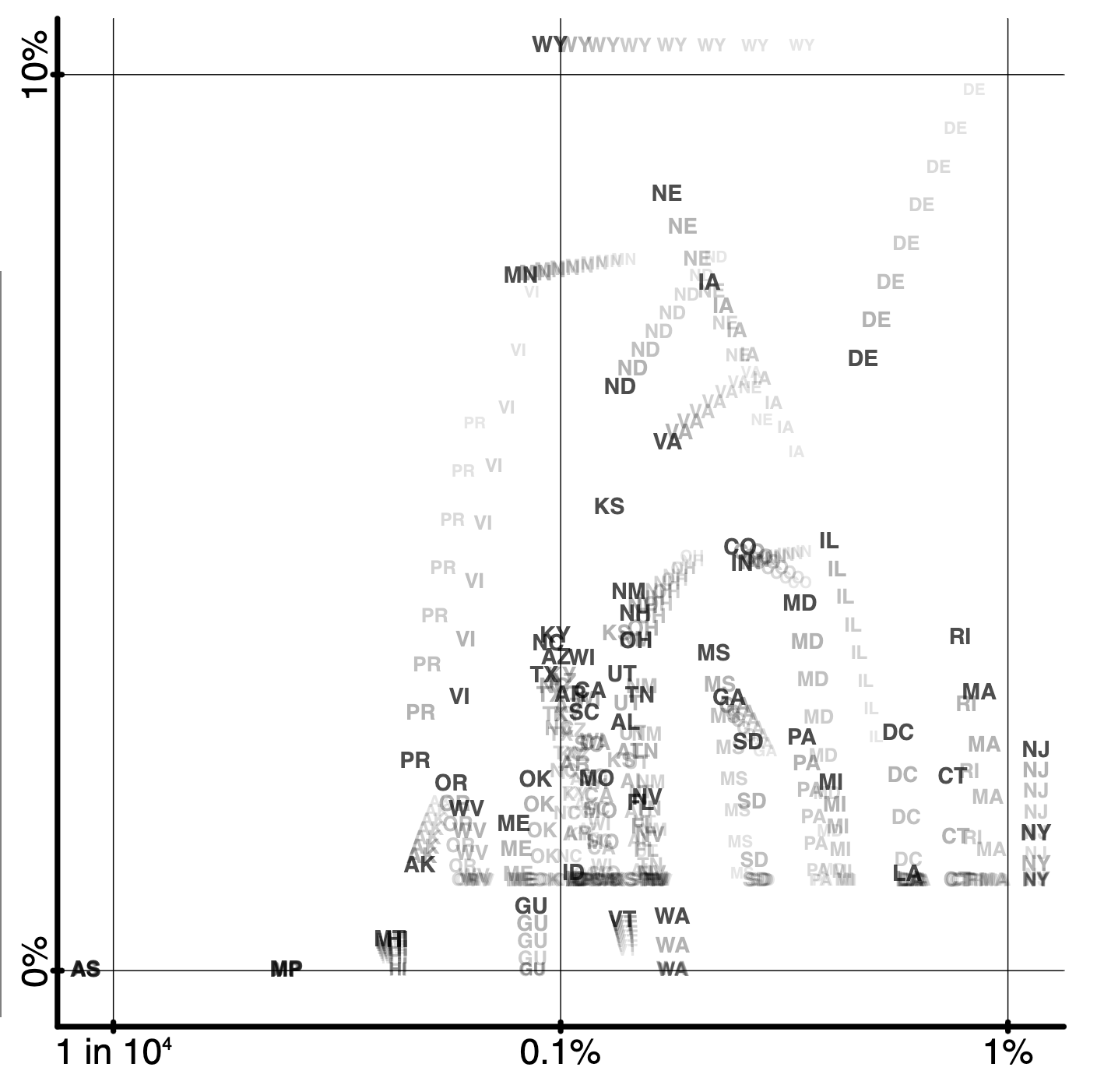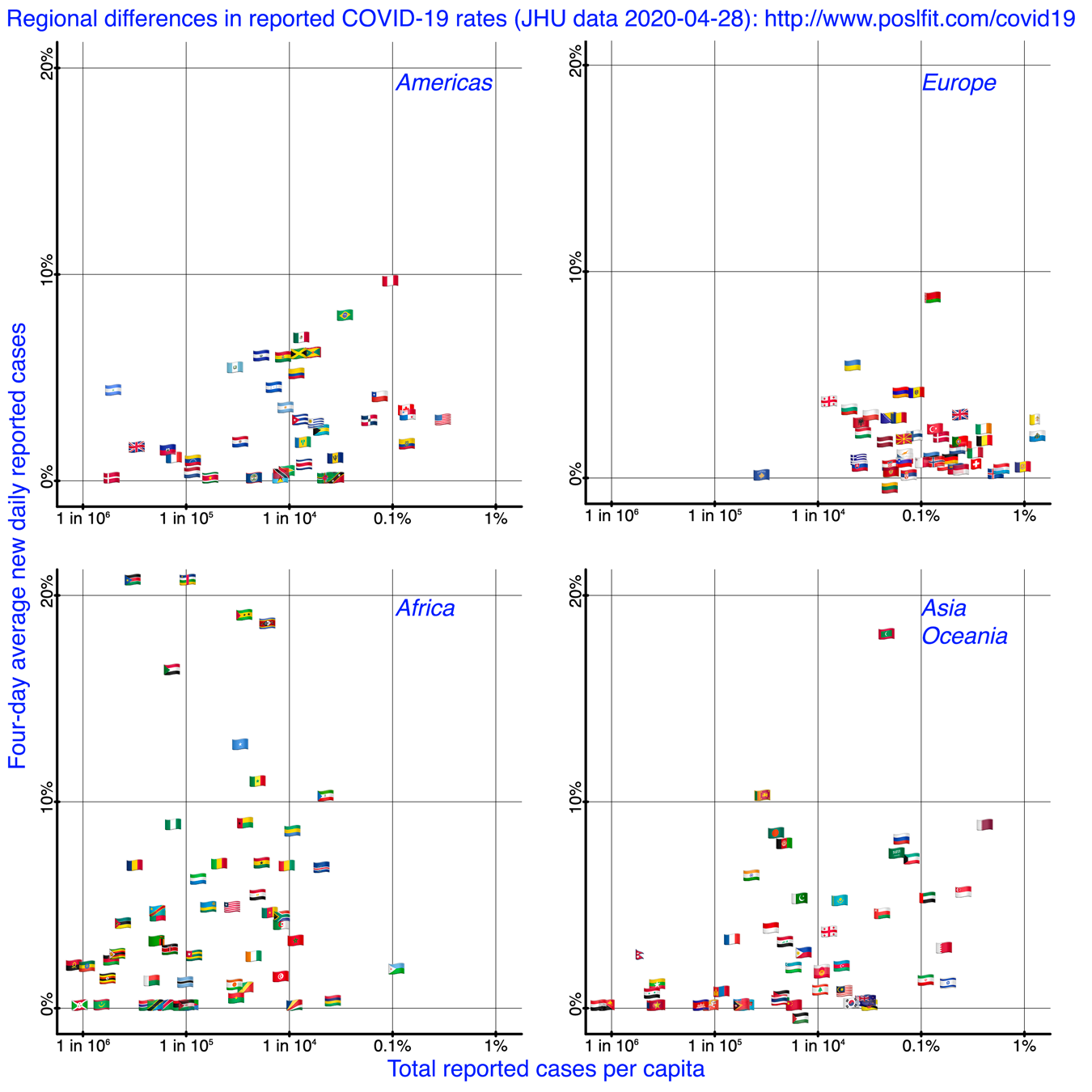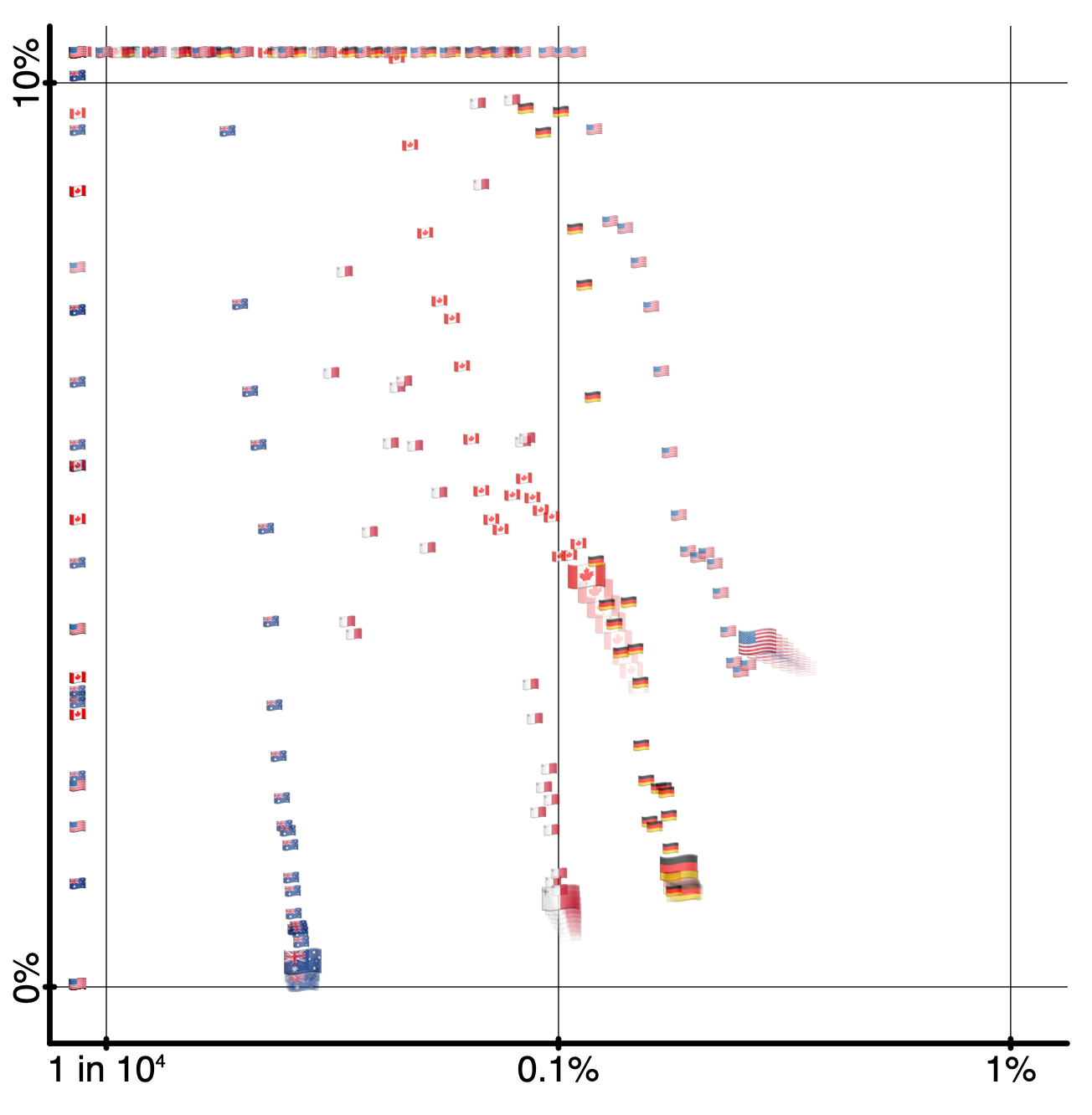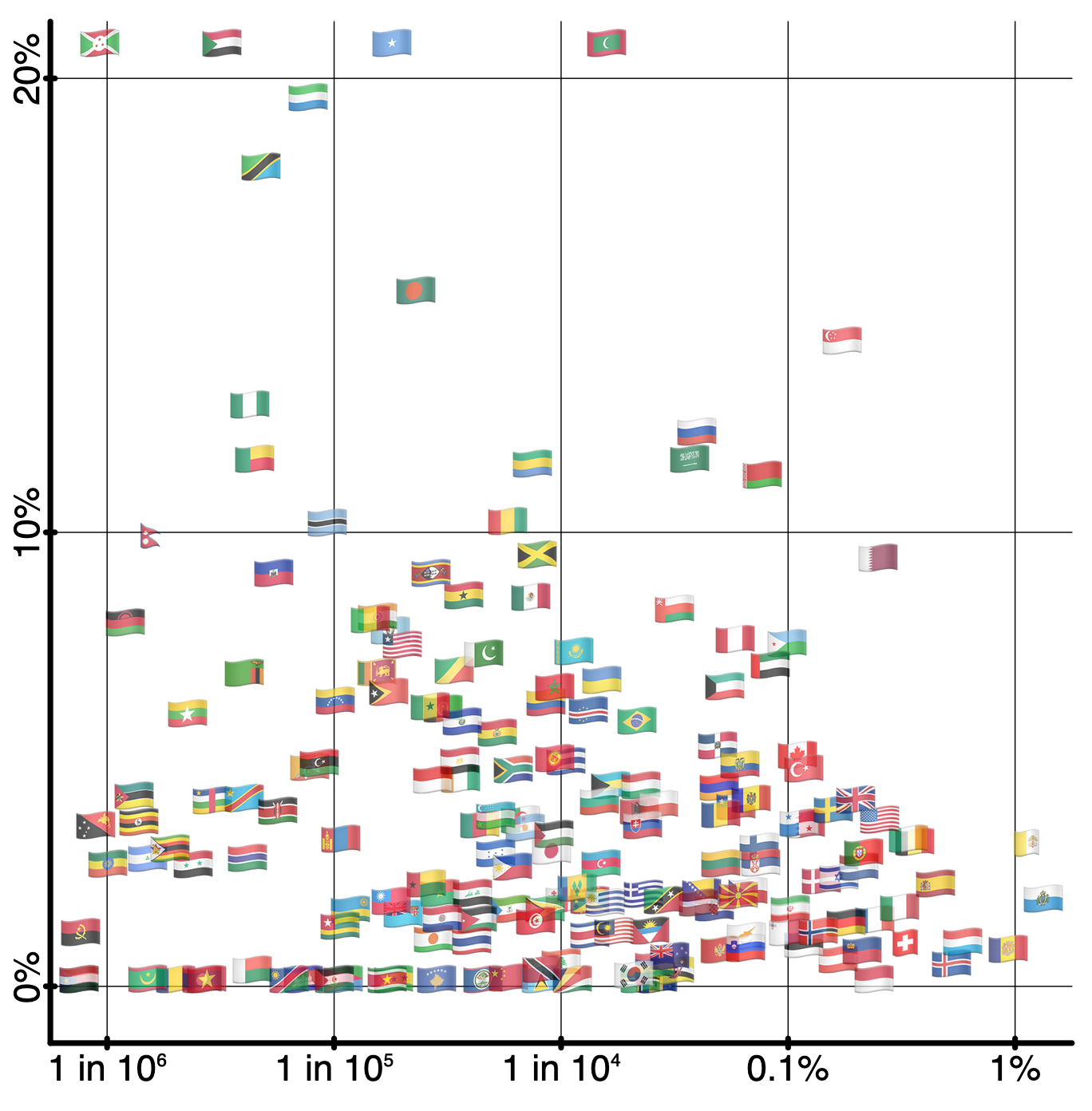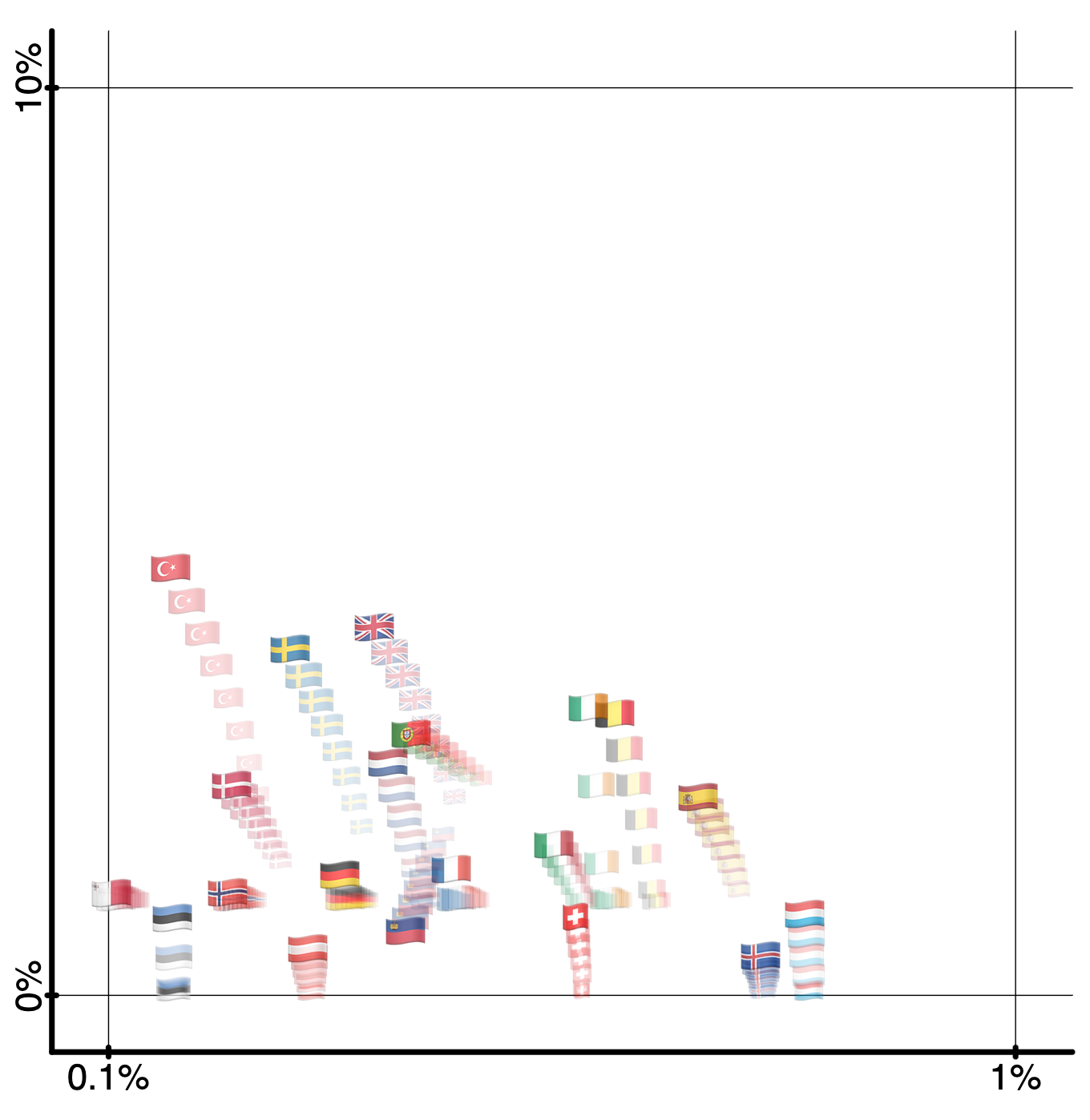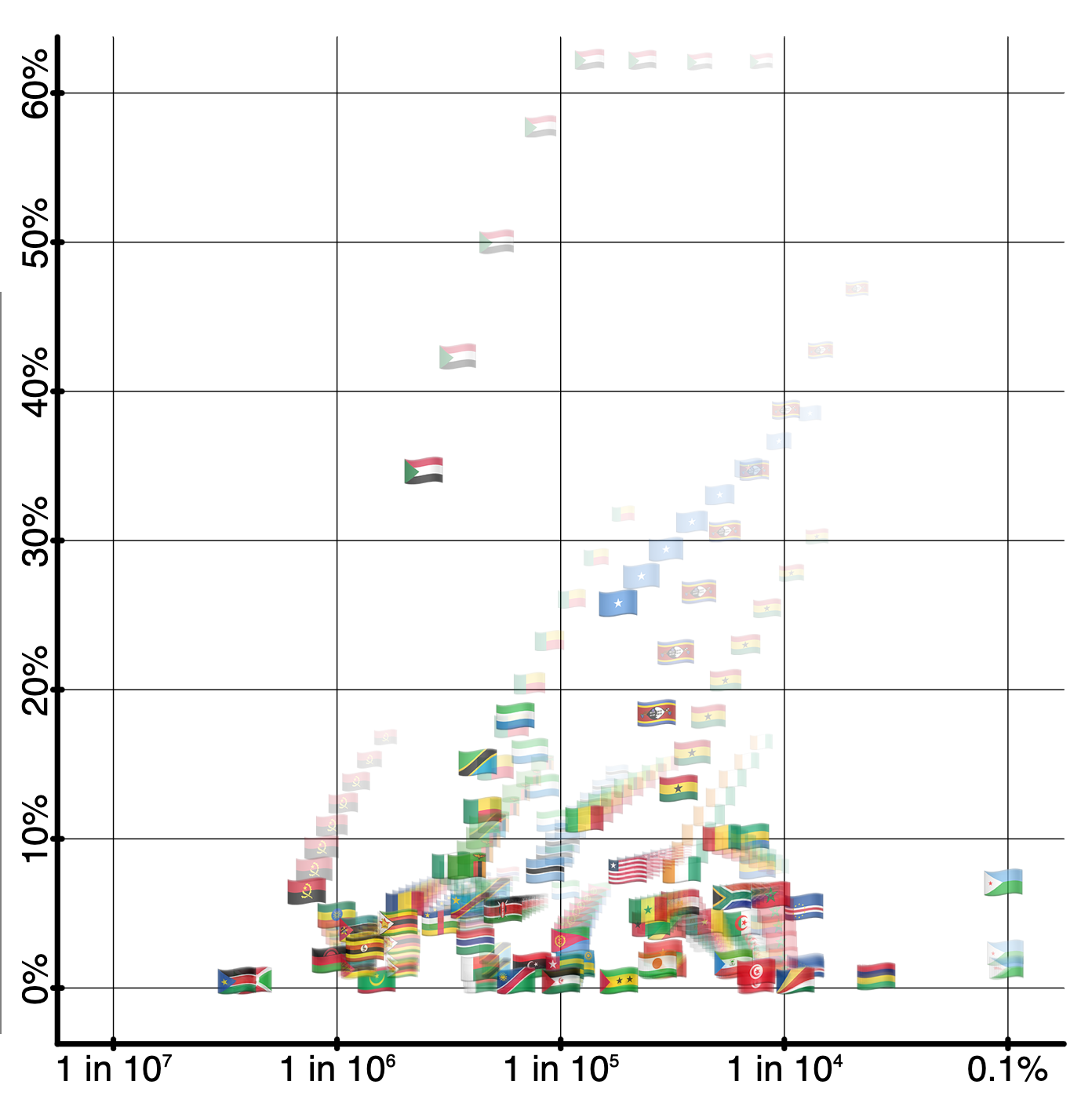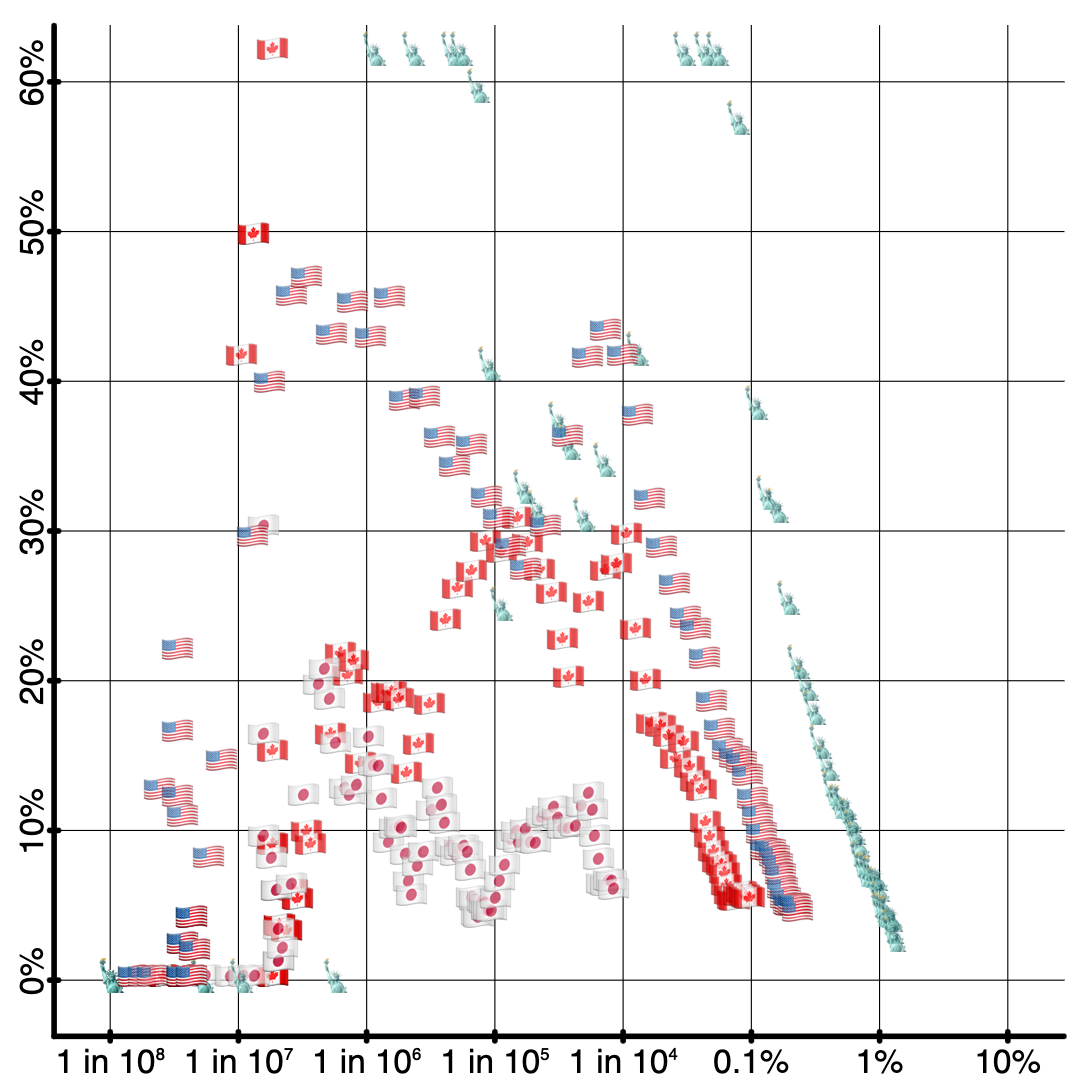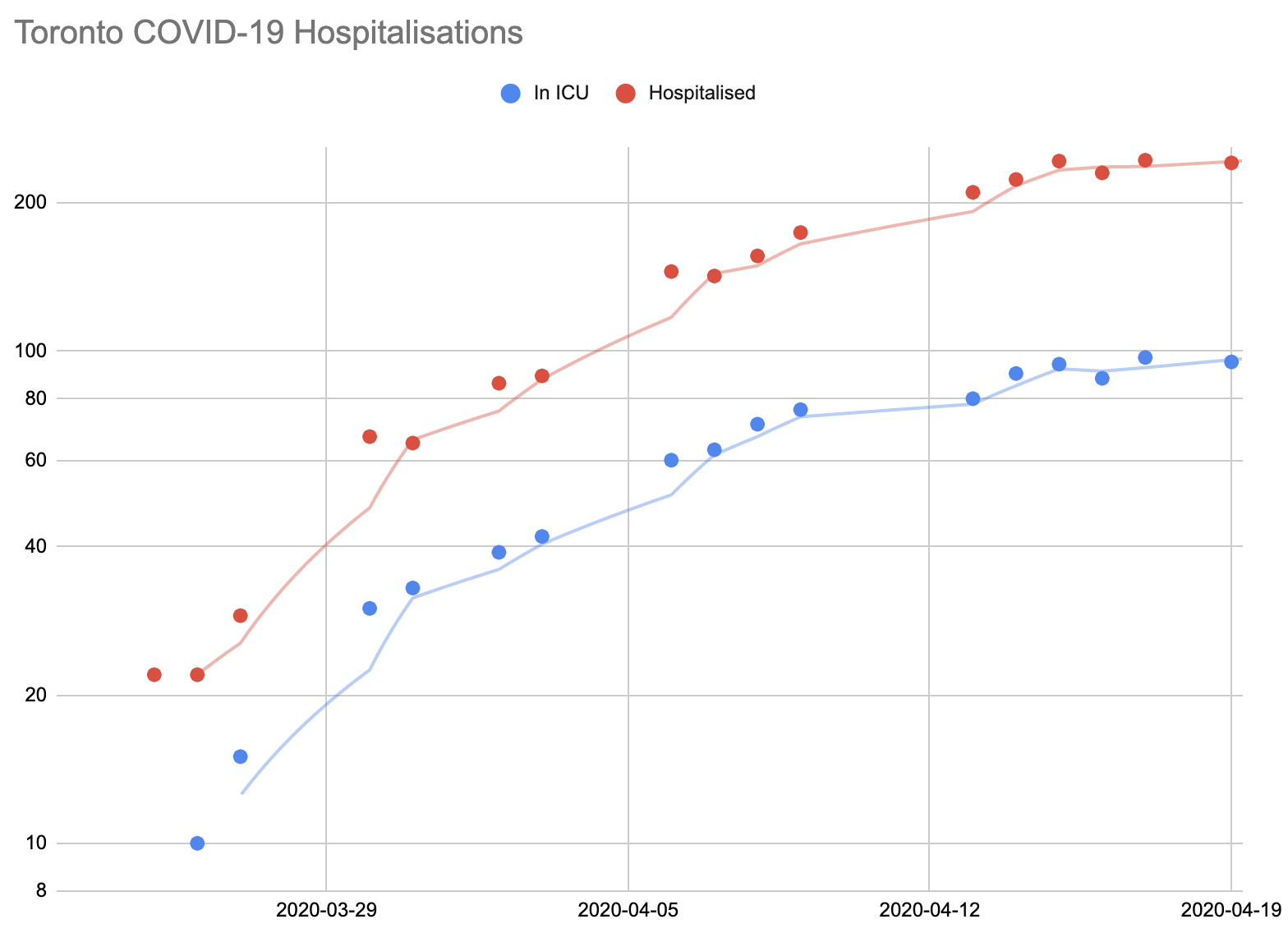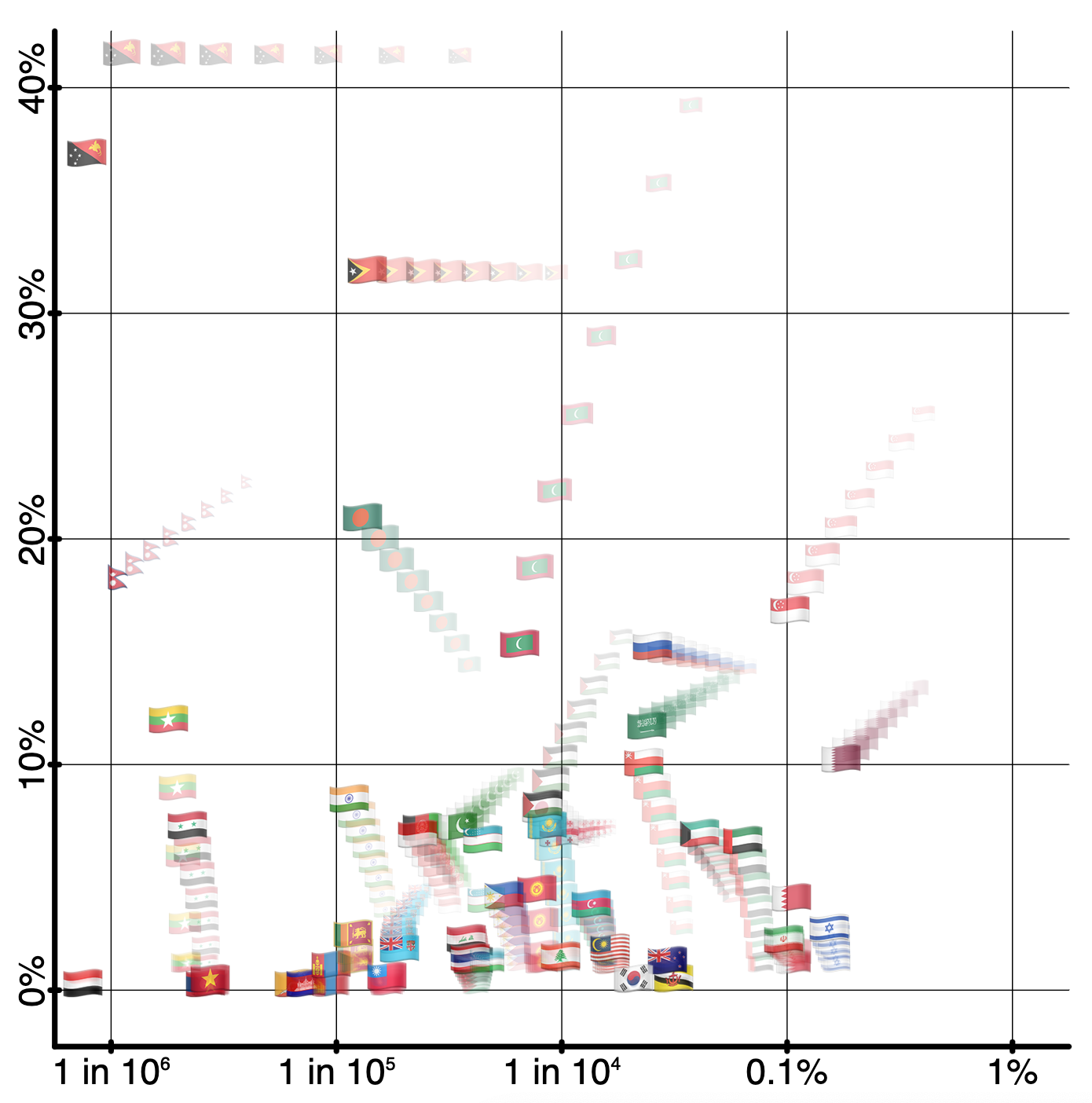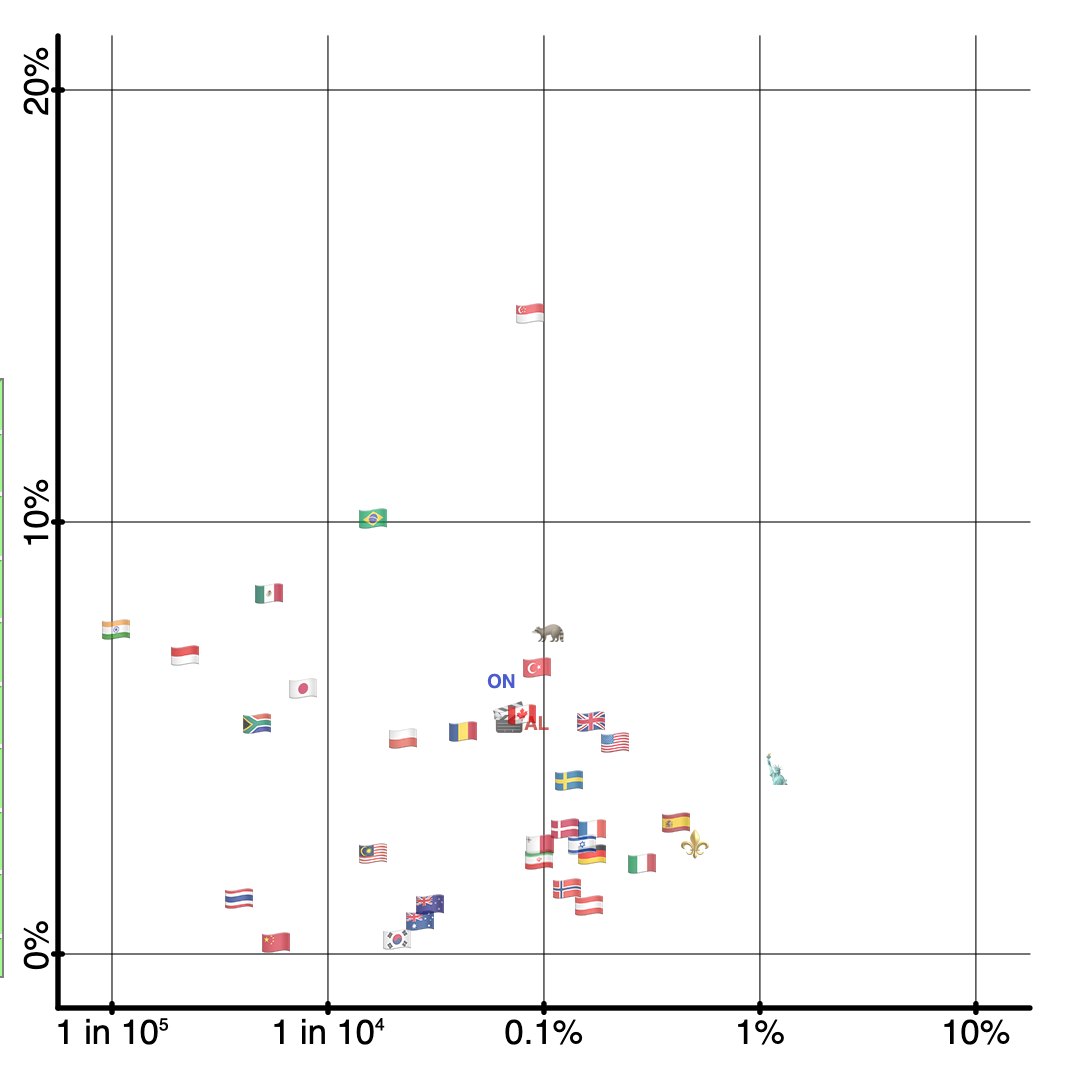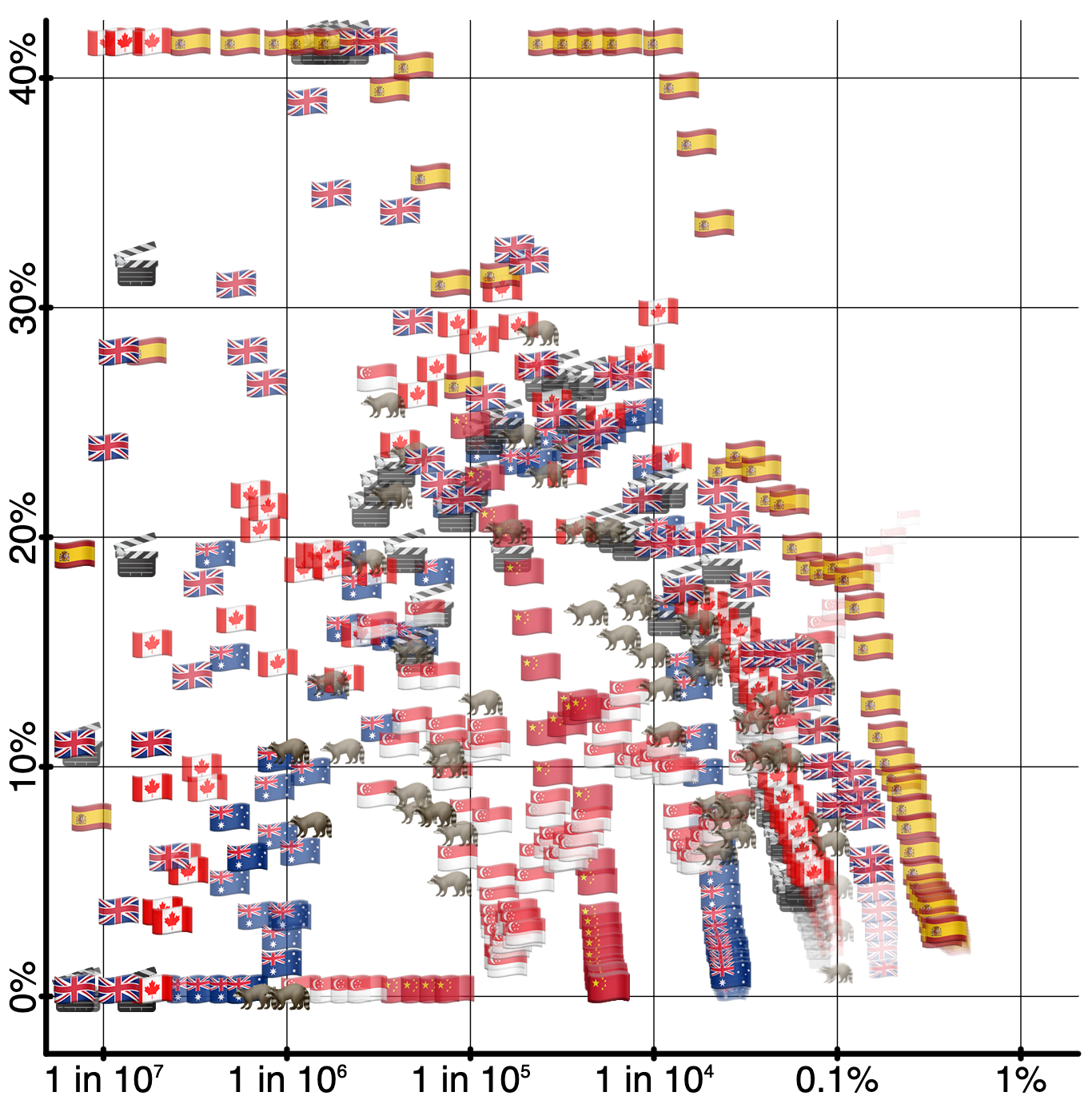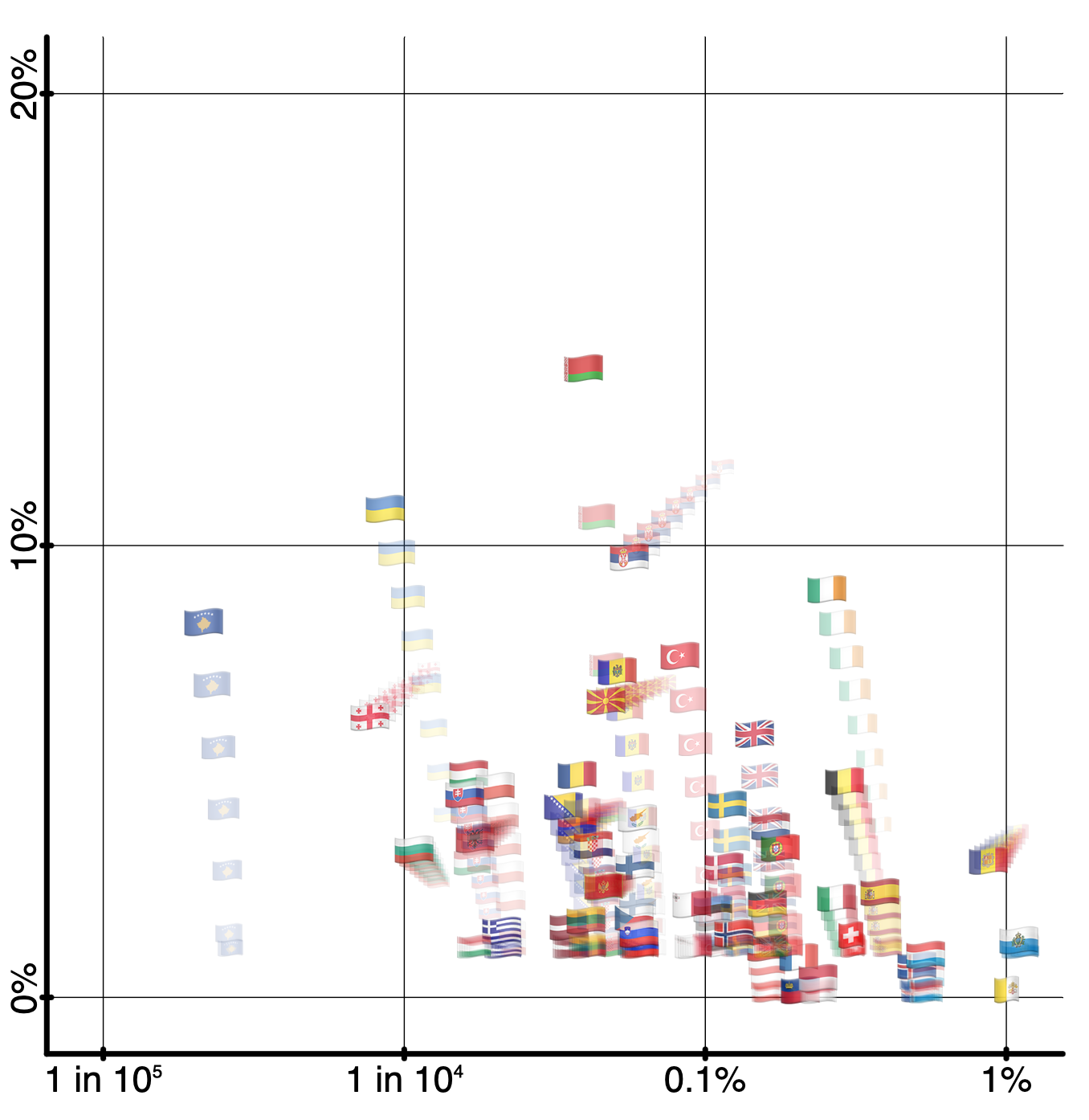Back to COVID-19 Visualisation
COVID-19 Commentary Archive
I’ve been posting commentary on Facebook about the “days to 1%” line in my Google Sheet linked above. Here is a sample of what I’ve written.
Boilerplate explanation paragraph: The number given with each country is my own way of boiling down your region or country's growth/doubling rate and number of people infected with COVID-19 into one number. It represents the number of days you have left at your current rate of infection (averaged over the last seven days (four before 2020-08-29) before you reach 1%. It's not a forecast (your rate of change is likely to change before then, when public health authorities take positive or negative action), just one simple number that tells you how you're doing compared to others. I could have picked a bigger percentage than 1%, but you can't go too far before the exponential growth bends back down logistically, and it seemed as easy a place as any; most people can visualize the idea of 1 in 100. Starting on 2020-05-06, I stopped displaying these numbers for regions whose active case counts were known to be lower than an estimated previous peak value; in these cases, I show separately the number of days it would take the current 4-day average of exponential decay in active case counts to drop below half a person, with a floor of 14 days since the last new confirmed case, as well (starting 2020-05-14) as the current percentage of peak active cases. Starting on 2020-08-02, in regions where active cases are still increasing but more than 1% of the population has been infected, I show an estimate of how many days it will be until 40% of the population is infected, the point at which herd immunity might begin to slow down spread among survivors in the most optimistic scenario.
2021-01-09
Today's pre-peak days-to-one-percent infection numbers: U.K. (101HI→102HI), California (113HI→114HI), Israel (131HI→125HI), Alabama (150HI→144HI), New York (144HI→144HI), Louisiana (149HI→149HI), U.S. (173HI→161HI), South Africa (199HI→191HI), Ontario (194HI→196HI), Sweden (202HI→202HI), Malta (235HI→206HI), Toronto (210HI→210HI), Canada (233HI→233HI), Norway (314HI→314HI), France (400HI→346HI), Brazil (412HI→359HI), Spain (494HI→494HI), Turkey (490HI→501HI), Mexico (536HI→515HI), Singapore (7228HI→7374HI), Malaysia (48→47), Japan (89→78), Thailand (94→96), Indonesia (117→111), New Zealand (1811→1811), Australia (2983→3581), China (13779→13779)
Compared to yesterday, here's how the regions that are within a year of 1% are doing.
Much worse: Israel, Alabama, U.S., South Africa, Malta, France, Brazil, Japan, Indonesia
The same: Malaysia
Better: U.K., California, New York, Louisiana, Ontario, Sweden, Toronto, Canada, Norway, Thailand
Today's post-peak days-to-eradication numbers for regions of interest: Denmark (320→381, 63.8%), Iran (788→729, 61.6%), India (682→758, 22.2%), Austria (4211→1958, 27.1%), Romania (905→2515, 43.5%), South Korea (new→2622, 97.2%), Germany (728→4336, 87.3%), Italy (new→12769, 80.2%), Poland (new→323725, 52.4%)
Days to eradication for other post-peak countries (74): Marshall Islands, Samoa, Vanuatu (eradicated); Cameroon (14, 36.1%); Central African Republic (14, 1.1%); Grenada (14, 35.7%); Holy See (14, 48.2%); Laos (14, 6.2%); Liberia (14, 63.0%); Saint Kitts and Nevis (14, 27.3%); Solomon Islands (14, 38.6%); Tajikistan (14, 1.3%); Tanzania (14, 42.8%); Papua New Guinea (37, 20.1%); Benin (53, 9.1%); Liechtenstein (54, 39.1%); Timor-Leste (70, 40.9%); Mauritius (71, 5.9%); Djibouti (91, 1.3%); Luxembourg (102, 26.6%); Azerbaijan (117, 24.3%); Trinidad and Tobago (135, 12.3%); Mauritania (156, 51.6%); Uzbekistan (185, 10.4%); Croatia (187, 22.9%); Belize (194, 11.8%); Burundi (199, 71.9%); Moldova (260, 44.0%); Armenia (278, 25.7%); Equatorial Guinea (278, 1.9%); Saudi Arabia (285, 3.3%); Jordan (301, 17.9%); Nepal (347, 10.8%); Kosovo (357, 50.4%); Kyrgyzstan (358, 23.7%); Jamaica (369, 50.0%); West Bank and Gaza (382, 61.8%); Iraq (384, 56.2%); Georgia (385, 29.4%); Iceland (423, 10.7%); North Macedonia (423, 72.1%); Taiwan (450, 39.4%); Morocco (478, 41.1%); Niger (484, 89.2%); Madagascar (506, 5.7%); Mali (512, 89.3%); Sudan (517, 70.0%); Yemen (556, 15.3%); Sri Lanka (650, 74.3%); Libya (669, 80.8%); Peru (796, 14.1%); Paraguay (808, 83.8%); Finland (1226, 59.0%); Philippines (1293, 30.3%); Uganda (1309, 84.6%); Burma (1313, 69.5%); Angola (1565, 87.2%); Pakistan (1611, 32.1%); Ukraine (1680, 85.4%); Lithuania (1954, 95.9%); Kenya (2084, 54.8%); Belarus (2165, 72.7%); Serbia (2264, 83.0%); Somalia (3401, 82.9%); Guyana (3537, 27.2%); Bosnia and Herzegovina (3806, 88.6%); Algeria (4077, 97.5%); United Arab Emirates (4538, 93.5%); Netherlands (5116, 97.9%); Ecuador (5669, 46.9%); Bangladesh (6515, 46.0%); Hungary (7480, 83.2%); Venezuela (12230, 40.3%); Syria (15319, 97.6%)
Days to eradication for other post-peak U.S. states and territories (7): GU (257, 6.3%); NC (410, 77.6%); MP (453, 89.9%); MI (461, 70.0%); SD (501, 26.0%); PA (1310, 81.9%); ND (7189, 16.0%)
Days to eradication for other post-peak Canadian provinces and territories (5): NT (2, 0.0%); NS (14, 6.7%); NL (27, 3.6%); BC (362, 67.0%); AB (8832, 68.3%)
JHU new case records in most recent data: Bolivia (2263), Colombia (18221, 2-day record streak), Cuba (344), Indonesia (10617, 3-day record streak), Ireland (8227), Japan (7863, 4-day record streak), Lebanon (5440, 4-day record streak), Malawi (314, 2-day record streak), Mozambique (521), Portugal (10176), Senegal (296), South Africa (21980), United Kingdom (68192), Zambia (1029).
2021-01-08
Today's pre-peak days-to-one-percent infection numbers: U.K. (104HI→101HI), California (113HI→113HI), Israel (131HI→131HI), New York (144HI→144HI), Louisiana (171HI→149HI), Alabama (155HI→150HI), U.S. (176HI→173HI), Ontario (208HI→194HI), South Africa (206HI→199HI), Sweden (164HI→202HI), Toronto (236HI→210HI), Canada (250HI→233HI), Malta (247HI→235HI), Norway (0→314HI), Italy (320HI→335HI), Poland (361HI→376HI), France (322HI→400HI), Brazil (450HI→412HI), Turkey (484HI→490HI), Spain (494HI→494HI), Mexico (536HI→536HI), Singapore (6990HI→7228HI), Malaysia (50→48), Japan (97→89), Thailand (89→94), Indonesia (122→117), South Korea (164→171), New Zealand (1811→1811), Australia (3089→2983)
Compared to yesterday, here's how the regions that are within a year of 1% are doing.
Much worse: Louisiana, Alabama, Ontario, South Africa, Toronto, Canada, Malta, Norway, Japan, Indonesia
Worse: U.K., U.S., Malaysia
Better: California, Israel, New York, Italy, Poland, Thailand, South Korea
Much better: Sweden, France
Today's post-peak days-to-eradication numbers for regions of interest: Denmark (301→320, 63.5%), India (748→682, 22.2%), Germany (569→728, 86.8%), Iran (803→788, 62.4%), Romania (599→905, 42.4%), China (944→1689, 2.1%), Austria (21422→4211, 27.6%)
Days to eradication for other post-peak countries (76): Marshall Islands, Samoa, Vanuatu (eradicated); Central African Republic (14, 1.1%); Grenada (14, 35.7%); Holy See (14, 48.2%); Laos (14, 6.2%); Liberia (14, 63.0%); Solomon Islands (14, 38.6%); Tanzania (14, 42.8%); Tajikistan (19, 3.3%); Saint Kitts and Nevis (24, 18.2%); Papua New Guinea (26, 15.0%); Benin (53, 9.1%); Timor-Leste (70, 40.9%); Mauritius (71, 5.9%); Djibouti (85, 1.3%); Liechtenstein (85, 44.7%); Azerbaijan (112, 26.5%); Luxembourg (113, 28.0%); Uzbekistan (144, 10.9%); Mauritania (150, 52.0%); Belize (161, 11.2%); Equatorial Guinea (177, 1.8%); Georgia (185, 29.3%); Croatia (189, 24.8%); Moldova (236, 45.4%); Burundi (237, 71.9%); Trinidad and Tobago (239, 14.6%); Iceland (251, 10.1%); Nepal (278, 10.8%); Armenia (282, 26.3%); Saudi Arabia (285, 3.4%); Jordan (298, 17.9%); Taiwan (305, 40.5%); Kyrgyzstan (309, 23.7%); Kosovo (317, 52.2%); Jamaica (339, 50.8%); Peru (385, 12.8%); Iraq (404, 58.2%); West Bank and Gaza (404, 64.2%); Guyana (413, 27.2%); Morocco (433, 41.1%); North Macedonia (491, 74.1%); Madagascar (506, 5.7%); Sudan (517, 70.0%); Latvia (518, 84.9%); Yemen (556, 15.3%); Sri Lanka (562, 75.8%); Mali (630, 88.5%); Libya (631, 82.4%); Guatemala (806, 36.9%); Paraguay (888, 83.1%); Belarus (1043, 74.4%); Burma (1081, 70.1%); Uganda (1123, 85.4%); Finland (1173, 56.3%); Niger (1255, 90.8%); Philippines (1360, 28.5%); Ukraine (1587, 85.2%); Pakistan (1599, 31.7%); Serbia (1886, 83.4%); United Arab Emirates (2012, 90.5%); Lithuania (3061, 95.9%); Hungary (3269, 82.4%); Somalia (3401, 82.9%); Kenya (3533, 55.3%); Bulgaria (3849, 82.2%); Algeria (4153, 97.7%); Syria (4557, 97.5%); Netherlands (4798, 98.1%); Bangladesh (5143, 46.1%); Venezuela (7731, 40.1%); Ecuador (10609, 44.5%); Belgium (44743, 65.6%); Kazakhstan (156179, 58.8%)
Days to eradication for other post-peak U.S. states and territories (8): GU (198, 6.1%); NC (486, 70.1%); PA (551, 80.7%); PR (629, 66.6%); SD (778, 27.1%); MT (1807, 24.4%); OH (3395, 77.4%); ID (21528, 97.0%)
Days to eradication for other post-peak Canadian provinces and territories (5): NT (4, 0.0%); YT (14, 45.0%); NL (44, 6.2%); BC (434, 69.1%); AB (790, 63.0%)
JHU new case records in most recent data: Brazil (87843), Colombia (17576), Czechia (17773, 2-day record streak), Eritrea (193), Estonia (1084), Indonesia (9321, 2-day record streak), Japan (7563, 3-day record streak), Lebanon (4774, 3-day record streak), Malawi (274), Malaysia (3027, 2-day record streak), Monaco (40, 3-day record streak), Mongolia (87), United Arab Emirates (2988, 3-day record streak).
2021-01-07
Today's pre-peak days-to-one-percent infection numbers: U.K. (102HI→104HI), California (116HI→113HI), Israel (142HI→131HI), New York (144HI→144HI), Alabama (155HI→155HI), Louisiana (174HI→171HI), U.S. (178HI→176HI), South Africa (210HI→206HI), Ontario (207HI→208HI), Toronto (234HI→236HI), Malta (260HI→247HI), Canada (250HI→250HI), Italy (304HI→320HI), France (399HI→322HI), Brazil (503HI→450HI), Turkey (471HI→484HI), Spain (494HI→494HI), Mexico (545HI→536HI), Singapore (7086HI→6990HI), Norway (4→0), Malaysia (52→50), Thailand (91→89), Japan (105→97), Indonesia (124→122), South Korea (153→164), New Zealand (1342→1811), Australia (2769→3089)
Compared to yesterday, here's how the regions that are within a year of 1% are doing.
Much worse: Israel, South Africa, Malta, France, Norway, Japan
Worse: California, Louisiana, U.S., Malaysia, Thailand, Indonesia
Better: U.K., New York, Alabama, Ontario, Toronto, Canada, Italy, South Korea
Today's post-peak days-to-eradication numbers for regions of interest: Denmark (282→301, 66.3%), Germany (870→569, 80.6%), Romania (541→599, 42.3%), India (642→748, 22.4%), Iran (926→803, 63.8%), China (654→944, 2.1%), Sweden (new→4820, 97.2%), Austria (16014→21422, 26.8%), Poland (4069→38227, 51.6%)
Days to eradication for other post-peak countries (75): Marshall Islands, Samoa, Vanuatu (eradicated); Grenada (14, 35.7%); Holy See (14, 48.2%); Laos (14, 6.2%); Liberia (14, 63.0%); Niger (14, 91.2%); Solomon Islands (14, 38.6%); Tanzania (14, 42.8%); Timor-Leste (14, 54.5%); Saint Kitts and Nevis (24, 18.2%); Papua New Guinea (26, 15.0%); Tajikistan (27, 5.5%); Benin (53, 9.1%); Sao Tome and Principe (67, 6.5%); Mauritius (71, 5.9%); Azerbaijan (110, 28.5%); Belize (125, 11.1%); Georgia (138, 25.6%); Luxembourg (141, 31.1%); Uzbekistan (143, 11.4%); Mauritania (163, 55.9%); Equatorial Guinea (177, 1.8%); Iceland (265, 10.1%); Guyana (268, 25.6%); Moldova (279, 48.0%); Djibouti (284, 1.5%); Kyrgyzstan (288, 24.0%); Saudi Arabia (288, 3.5%); Trinidad and Tobago (300, 15.3%); Jordan (313, 18.3%); Armenia (315, 27.8%); Nepal (316, 11.0%); Jamaica (349, 51.8%); Kosovo (361, 55.5%); West Bank and Gaza (371, 65.8%); Taiwan (372, 42.4%); Croatia (387, 27.6%); Burundi (392, 71.2%); Morocco (421, 41.6%); Iraq (432, 59.8%); Sudan (445, 70.0%); Madagascar (506, 5.7%); North Macedonia (506, 75.3%); Yemen (556, 15.3%); Sri Lanka (569, 77.0%); Mali (576, 89.4%); Libya (582, 83.1%); Belarus (672, 77.0%); Paraguay (816, 82.4%); Liechtenstein (827, 61.1%); Burma (1077, 70.5%); Guatemala (1132, 35.5%); Finland (1226, 54.3%); Uganda (1248, 85.5%); Philippines (1581, 27.3%); Ukraine (1595, 85.9%); Serbia (2042, 84.4%); Eritrea (2167, 97.7%); Bulgaria (2405, 81.8%); Kenya (3112, 55.4%); Syria (3151, 97.6%); Bangladesh (3331, 46.1%); Somalia (3401, 82.9%); Hungary (3419, 82.0%); Netherlands (4153, 97.7%); Lithuania (4392, 96.7%); Algeria (4699, 97.9%); Pakistan (5474, 32.6%); Central African Republic (7648, 63.7%); Ecuador (9103, 41.3%); Belgium (11206, 65.2%); Estonia (20765, 95.1%); Peru (20919, 12.8%)
Days to eradication for other post-peak U.S. states and territories (9): GU (162, 5.5%); NC (313, 63.7%); MT (492, 22.2%); PR (760, 68.3%); PA (902, 82.7%); MS (1272, 82.4%); MP (1477, 98.0%); OH (2261, 76.4%); ID (23159, 96.7%)
Days to eradication for other post-peak Canadian provinces and territories (6): NT (5, 0.0%); YT (14, 30.0%); NL (40, 6.2%); BC (471, 68.1%); AB (904, 63.7%); SK (2610, 60.6%)
JHU new case records in most recent data: Czechia (17332), Dominica (17), Indonesia (8854), Ireland (7832), Japan (5950, 2-day record streak), Lebanon (4166, 2-day record streak), Lesotho (931), Malaysia (2593), Malta (224), Monaco (31, 2-day record streak), Nigeria (1664, 3-day record streak), Panama (5186), Portugal (10027), Saint Vincent and the Grenadines (16, 2-day record streak), Slovenia (3354), South Africa (21832), United Arab Emirates (2067, 2-day record streak), United Kingdom (62556, 3-day record streak), Uruguay (944).
2021-01-06
Today's pre-peak days-to-one-percent infection numbers: U.K. (104HI→102HI), California (116HI→116HI), Israel (146HI→142HI), New York (144HI→144HI), Alabama (151HI→155HI), Sweden (164HI→164HI), Louisiana (173HI→174HI), U.S. (178HI→178HI), Ontario (207HI→207HI), South Africa (215HI→210HI), Toronto (222HI→234HI), Canada (250HI→250HI), Malta (288HI→260HI), Italy (313HI→304HI), France (399HI→399HI), Spain (494HI→494HI), Brazil (517HI→503HI), Mexico (85HI→545HI), Singapore (7221HI→7086HI), Norway (4→4), Malaysia (54→52), Thailand (92→91), Japan (108→105), Indonesia (126→124), South Korea (149→153), New Zealand (1342→1342), Australia (2538→2769)
Compared to yesterday, here's how the regions that are within a year of 1% are doing.
Much worse: Israel, South Africa, Malta, Italy
Worse: U.K., Malaysia, Japan, Indonesia
The same: Thailand
Better: California, New York, Alabama, Sweden, Louisiana, U.S., Ontario, Toronto, Canada, Norway, South Korea
Much better: Mexico
Today's post-peak days-to-eradication numbers for regions of interest: Denmark (287→282, 67.7%), Romania (468→541, 41.8%), India (606→642, 22.4%), China (631→654, 2.1%), Germany (980→870, 80.2%), Iran (918→926, 65.9%), Turkey (458→1190, 7.1%), Poland (4846→4069, 50.5%), Austria (309428→16014, 26.2%)
Days to eradication for other post-peak countries (72): Marshall Islands, Samoa, Vanuatu (eradicated); Brunei (14, 18.9%); Dominica (14, 17.9%); Grenada (14, 35.7%); Holy See (14, 48.2%); Laos (14, 6.2%); Liberia (14, 63.0%); Saint Kitts and Nevis (14, 18.2%); Solomon Islands (14, 38.6%); Tanzania (14, 42.8%); Timor-Leste (14, 54.5%); Mauritius (20, 3.2%); Papua New Guinea (26, 15.0%); Tajikistan (41, 8.2%); Sao Tome and Principe (49, 6.2%); Georgia (102, 21.4%); Belize (108, 11.0%); Azerbaijan (111, 31.1%); Benin (122, 9.1%); Equatorial Guinea (123, 2.0%); Liechtenstein (135, 49.5%); Luxembourg (135, 30.8%); Uzbekistan (141, 11.9%); Finland (144, 51.3%); Iceland (158, 8.9%); Mauritania (162, 57.1%); Trinidad and Tobago (199, 15.3%); Guyana (217, 25.6%); Croatia (251, 23.4%); Saudi Arabia (276, 3.6%); Jamaica (284, 51.6%); Kyrgyzstan (284, 24.6%); Jordan (292, 18.5%); Moldova (303, 49.2%); Nepal (320, 11.2%); Taiwan (325, 42.8%); Morocco (334, 42.5%); Armenia (351, 29.1%); West Bank and Gaza (358, 67.9%); Kosovo (361, 55.5%); Yemen (381, 15.5%); Sudan (383, 70.0%); Iraq (468, 61.5%); Belarus (500, 76.9%); Madagascar (506, 5.7%); Libya (700, 85.8%); Sri Lanka (738, 79.6%); Paraguay (798, 82.7%); Pakistan (825, 32.3%); Burma (856, 70.6%); North Macedonia (905, 80.1%); Philippines (1256, 26.5%); Uganda (1334, 86.0%); Peru (1523, 12.5%); Ukraine (1560, 88.0%); Kenya (1625, 56.6%); Serbia (1924, 84.7%); Mali (2493, 89.1%); Hungary (2627, 81.4%); Syria (2709, 97.5%); Bangladesh (2784, 46.1%); Guatemala (2957, 34.7%); Bulgaria (3114, 82.1%); Ecuador (4389, 37.3%); Netherlands (5503, 97.9%); Algeria (6048, 98.3%); Niger (7363, 90.5%); Belgium (8394, 65.0%); Namibia (9784, 88.3%); Bahamas (13966, 63.7%)
Days to eradication for other post-peak U.S. states and territories (10): GU (88, 5.2%); NC (257, 57.1%); PR (339, 66.0%); VI (504, 35.3%); MT (739, 22.2%); PA (961, 84.8%); OH (1508, 75.1%); TN (1779, 80.8%); MP (4474, 99.3%); ID (32360, 96.3%)
Days to eradication for other post-peak Canadian provinces and territories (8): NT (6, 0.0%); YT (14, 25.0%); PE (36, 20.0%); NL (52, 7.3%); NS (56, 4.1%); BC (512, 69.2%); AB (732, 63.5%); SK (1433, 64.1%)
JHU new case records in most recent data: Colombia (16835), Comoros (131), Japan (4946), Lebanon (3620), Monaco (30), Nigeria (1354, 2-day record streak), Saint Vincent and the Grenadines (9), United Arab Emirates (1967), United Kingdom (61087, 2-day record streak), Zimbabwe (1365).
2021-01-05
Today's pre-peak days-to-one-percent infection numbers: Mexico (540HI→85HI), U.K. (104HI→104HI), California (114HI→116HI), New York (145HI→144HI), Israel (150HI→146HI), Alabama (159HI→151HI), Sweden (157HI→164HI), Louisiana (176HI→173HI), U.S. (180HI→178HI), Ontario (211HI→207HI), South Africa (224HI→215HI), Toronto (215HI→222HI), Canada (290HI→250HI), Malta (302HI→288HI), France (435HI→399HI), Spain (494HI→494HI), Brazil (510HI→517HI), Singapore (7783HI→7221HI), Norway (4→4), Malaysia (55→54), Thailand (105→92), Japan (113→108), Indonesia (125→126), South Korea (143→149), New Zealand (1266→1342), Australia (2568→2538)
Compared to yesterday, here's how the regions that are within a year of 1% are doing.
Much worse: Mexico, Israel, Alabama, Ontario, South Africa, Canada, Malta, Thailand, Japan
Worse: Louisiana, U.S.
The same: New York, Malaysia
Better: U.K., California, Sweden, Toronto, Norway, Indonesia, South Korea
Today's post-peak days-to-eradication numbers for regions of interest: Denmark (237→287, 70.2%), Turkey (387→458, 6.7%), Romania (283→468, 41.8%), India (959→606, 22.7%), China (599→631, 2.1%), Iran (912→918, 66.7%), Germany (526→980, 82.7%), Poland (10226→4846, 51.0%), Italy (new→11742, 80.2%), Austria (5863→309428, 26.9%)
Days to eradication for other post-peak countries (77): Marshall Islands, Samoa, Vanuatu (eradicated); Brunei (14, 18.9%); Dominica (14, 17.9%); Fiji (14, 24.5%); Holy See (14, 48.2%); Laos (14, 6.2%); Liberia (14, 63.0%); Saint Kitts and Nevis (14, 18.2%); Solomon Islands (14, 38.6%); Tanzania (14, 42.8%); Timor-Leste (14, 54.5%); Mauritius (20, 3.2%); Papua New Guinea (26, 15.0%); Grenada (31, 35.7%); Gambia (52, 0.4%); Tajikistan (53, 10.1%); Georgia (61, 15.2%); Guinea-Bissau (77, 1.5%); Sao Tome and Principe (78, 7.4%); Iceland (107, 8.1%); Belize (108, 12.1%); Azerbaijan (113, 33.8%); Guyana (119, 24.2%); Equatorial Guinea (123, 2.0%); Luxembourg (135, 30.3%); Uzbekistan (140, 12.6%); Liechtenstein (152, 51.5%); Mauritania (196, 61.8%); Trinidad and Tobago (196, 15.7%); Croatia (212, 23.3%); Taiwan (231, 42.4%); Yemen (236, 15.5%); Kyrgyzstan (275, 25.4%); Jordan (287, 19.2%); Saudi Arabia (299, 3.6%); Armenia (333, 30.6%); Nepal (333, 11.3%); West Bank and Gaza (339, 70.3%); Jamaica (349, 54.1%); Moldova (356, 50.0%); Morocco (361, 42.8%); Kosovo (387, 58.3%); Togo (395, 23.5%); Djibouti (399, 1.6%); Sudan (422, 73.2%); Finland (432, 66.9%); Belarus (439, 75.4%); Madagascar (506, 5.7%); Sri Lanka (527, 79.2%); Iraq (530, 63.3%); Burma (672, 70.5%); Paraguay (753, 82.9%); Pakistan (756, 34.2%); Libya (785, 87.5%); North Macedonia (839, 80.1%); Philippines (1073, 25.5%); Ecuador (1283, 34.2%); Kenya (1413, 56.2%); Uganda (1429, 86.2%); Ukraine (1553, 90.4%); Serbia (1671, 85.0%); Oman (2154, 24.5%); Bulgaria (2294, 82.1%); Hungary (2313, 81.5%); Bangladesh (2564, 46.1%); Syria (2565, 97.6%); Mongolia (2875, 93.2%); Colombia (2936, 53.0%); Belgium (7673, 65.0%); Algeria (7890, 98.6%); Guatemala (9939, 33.7%); Albania (11663, 92.9%); Mali (14438, 88.8%); Netherlands (16409, 98.2%); Ethiopia (28520, 34.4%)
Days to eradication for other post-peak U.S. states and territories (10): GU (49, 4.8%); VI (104, 31.5%); PR (213, 63.6%); NC (247, 52.6%); MP (477, 94.0%); MT (710, 22.2%); PA (1034, 86.8%); OH (1324, 76.0%); TN (6193, 83.3%); ID (18071, 95.7%)
Days to eradication for other post-peak Canadian provinces and territories (8): NT (7, 0.0%); YT (14, 25.0%); NL (43, 6.8%); NS (139, 5.8%); BC (306, 72.3%); SK (526, 63.5%); AB (636, 65.5%); MB (14840, 51.1%)
JHU new case records in most recent data: Afghanistan (1485), Costa Rica (3115), Cuba (316), Ireland (6110, 4-day record streak), Nigeria (1271), United Kingdom (58923).
2021-01-04
Today's pre-peak days-to-one-percent infection numbers: U.K. (108HI→104HI), California (112HI→114HI), New York (145HI→145HI), Israel (169HI→150HI), Alabama (159HI→159HI), Louisiana (179HI→176HI), U.S. (180HI→180HI), Ontario (223HI→211HI), Toronto (243HI→215HI), South Africa (234HI→224HI), Canada (290HI→290HI), Malta (319HI→302HI), Italy (330HI→324HI), France (456HI→435HI), Spain (494HI→494HI), Brazil (505HI→510HI), Mexico (542HI→540HI), Singapore (8637HI→7783HI), Norway (5→4), Thailand (140→105), Japan (113→113), Indonesia (127→125), South Korea (135→143), New Zealand (1266→1266), Australia (2506→2568)
Compared to yesterday, here's how the regions that are within a year of 1% are doing.
Much worse: U.K., Israel, Ontario, Toronto, South Africa, Malta, Italy, Thailand
Worse: Louisiana, Indonesia
The same: Norway
Better: California, New York, Alabama, U.S., Canada, Japan, South Korea
Today's post-peak days-to-eradication numbers for regions of interest: Denmark (253→237, 71.0%), Romania (304→283, 41.2%), Turkey (286→387, 6.4%), Germany (9925→526, 85.8%), China (328→599, 2.1%), Sweden (792→617, 92.1%), Malaysia (new→782, 90.5%), Iran (897→912, 67.4%), India (887→959, 24.0%), Austria (new→5863, 26.7%), Poland (new→10226, 51.4%)
Days to eradication for other post-peak countries (78): Marshall Islands, Samoa, Vanuatu (eradicated); Benin (14, 17.7%); Central African Republic (14, 64.2%); Djibouti (14, 1.7%); Dominica (14, 17.9%); Equatorial Guinea (14, 2.2%); Eritrea (14, 100.0%); Fiji (14, 24.5%); Gabon (14, 4.6%); Grenada (14, 35.7%); Holy See (14, 48.2%); Iceland (14, 11.7%); Laos (14, 6.2%); Liberia (14, 63.0%); Luxembourg (14, 48.1%); Mauritius (14, 8.3%); Nicaragua (14, 97.7%); Saint Kitts and Nevis (14, 18.2%); Solomon Islands (14, 38.6%); Somalia (14, 84.2%); Tanzania (14, 42.8%); Papua New Guinea (15, 15.0%); Gambia (42, 0.4%); Tajikistan (43, 12.1%); Georgia (50, 19.7%); Sao Tome and Principe (90, 8.0%); Azerbaijan (101, 36.3%); Uzbekistan (115, 12.6%); Croatia (149, 25.5%); Belize (153, 13.6%); Guyana (160, 25.7%); Ecuador (165, 32.7%); Mauritania (186, 66.5%); Saint Vincent and the Grenadines (193, 92.3%); Kyrgyzstan (223, 25.4%); Belarus (228, 71.6%); Moldova (235, 51.9%); Saudi Arabia (258, 3.8%); Jamaica (259, 53.7%); Philippines (267, 24.4%); Nepal (269, 11.8%); Kosovo (282, 58.3%); Madagascar (289, 5.7%); Jordan (309, 20.2%); Taiwan (327, 43.9%); Trinidad and Tobago (354, 16.5%); West Bank and Gaza (393, 72.0%); Morocco (409, 44.7%); Sudan (439, 74.5%); Guatemala (450, 34.6%); Mali (474, 92.1%); Iraq (481, 65.3%); Armenia (487, 31.9%); Sri Lanka (512, 80.3%); Paraguay (561, 83.7%); Yemen (650, 15.9%); Burma (671, 70.8%); Libya (680, 88.7%); North Macedonia (776, 82.4%); Uganda (873, 86.4%); Serbia (1420, 85.0%); Bulgaria (1506, 82.0%); Lesotho (1732, 98.2%); Syria (1894, 97.7%); Bangladesh (2016, 46.1%); Hungary (2106, 82.1%); Lithuania (3106, 97.1%); Botswana (3351, 74.9%); Belgium (3901, 64.9%); Netherlands (4609, 98.8%); Slovenia (6108, 81.8%); Algeria (7294, 98.9%); Ukraine (9000, 90.5%); Kenya (10265, 56.5%); Albania (13142, 93.5%); Afghanistan (73285, 54.4%)
Days to eradication for other post-peak U.S. states and territories (14): NC (90, 49.2%); VI (94, 33.6%); GU (195, 6.2%); MS (254, 73.5%); MP (273, 94.0%); PR (277, 65.0%); MT (359, 22.8%); PA (797, 85.7%); WI (1944, 67.2%); MN (2471, 24.8%); UT (2659, 80.0%); ID (2808, 95.5%); OH (3160, 78.1%); WY (3687, 11.7%)
Days to eradication for other post-peak Canadian provinces and territories (7): NT (7, 0.0%); PE (14, 30.0%); YT (14, 25.0%); NL (30, 6.8%); BC (352, 72.3%); AB (811, 65.5%); MB (2003, 51.1%)
JHU new case records in most recent data: Barbados (161), Canada (16141), Ireland (4961, 3-day record streak), Mozambique (341), Zimbabwe (774).
2021-01-03
Today's pre-peak days-to-one-percent infection numbers: U.K. (114HI→108HI), California (118HI→112HI), New York (150HI→145HI), Alabama (160HI→159HI), Israel (168HI→169HI), Louisiana (202HI→179HI), U.S. (199HI→180HI), Ontario (233HI→223HI), South Africa (239HI→234HI), Toronto (243HI→243HI), Canada (290HI→290HI), Malta (318HI→319HI), Italy (346HI→330HI), Poland (373HI→362HI), Austria (415HI→414HI), France (456HI→456HI), Spain (494HI→494HI), Brazil (505HI→505HI), Mexico (532HI→542HI), Singapore (10447HI→8637HI), Norway (6→5), Malaysia (58→55), Japan (108→113), Indonesia (127→127), South Korea (138→135), Thailand (156→140), New Zealand (1371→1266), Australia (2581→2506)
Compared to yesterday, here's how the regions that are within a year of 1% are doing.
Much worse: U.K., California, New York, Louisiana, U.S., Ontario, South Africa, Italy, Poland, Thailand
Worse: Malaysia, South Korea
The same: Alabama, Norway
Better: Israel, Toronto, Canada, Malta, Japan, Indonesia
Today's post-peak days-to-eradication numbers for regions of interest: Denmark (274→253, 74.6%), Turkey (226→286, 6.5%), Romania (457→304, 41.7%), China (268→328, 2.1%), Sweden (new→792, 92.1%), India (959→887, 24.3%), Iran (924→897, 68.5%), Germany (2704→9925, 88.8%)
Days to eradication for other post-peak countries (74): Marshall Islands, Samoa, Vanuatu (eradicated); Antigua and Barbuda (14, 13.6%); Brunei (14, 4.7%); Dominica (14, 17.9%); Fiji (14, 24.5%); Grenada (14, 35.7%); Guinea-Bissau (14, 1.3%); Holy See (14, 48.2%); Laos (14, 6.2%); Liberia (14, 63.0%); Mauritius (14, 8.3%); Papua New Guinea (14, 47.0%); Saint Kitts and Nevis (14, 18.2%); Saint Vincent and the Grenadines (14, 92.3%); Solomon Islands (14, 38.6%); Tanzania (14, 42.8%); Timor-Leste (14, 54.5%); Gambia (42, 0.4%); Tajikistan (60, 14.3%); Georgia (88, 26.5%); Belize (90, 12.6%); Sao Tome and Principe (102, 8.9%); Azerbaijan (103, 39.8%); Equatorial Guinea (113, 2.2%); Guyana (124, 25.6%); Uzbekistan (136, 13.9%); Finland (166, 64.1%); Belarus (174, 70.2%); Trinidad and Tobago (192, 16.7%); Mauritania (214, 69.7%); Taiwan (219, 43.5%); Jamaica (232, 54.8%); Morocco (267, 45.2%); Kyrgyzstan (286, 27.0%); Madagascar (289, 5.7%); Saudi Arabia (302, 3.9%); Togo (315, 21.3%); West Bank and Gaza (320, 73.0%); Namibia (326, 79.7%); Nepal (330, 12.2%); Croatia (383, 27.5%); Jordan (387, 21.3%); Moldova (398, 55.9%); Kosovo (400, 60.7%); Sudan (441, 76.3%); Armenia (460, 32.5%); Yemen (509, 16.4%); Iraq (576, 67.2%); Sri Lanka (599, 81.8%); Burma (609, 71.7%); Oman (693, 23.5%); Libya (780, 90.4%); Paraguay (789, 86.0%); Kenya (816, 56.2%); Burkina Faso (1030, 92.3%); North Macedonia (1044, 83.4%); Uganda (1116, 87.4%); Pakistan (1147, 34.1%); Nicaragua (1359, 97.7%); Serbia (1398, 85.5%); Bulgaria (1695, 82.0%); Bangladesh (1821, 46.3%); Syria (1964, 98.0%); Ukraine (2002, 91.0%); Bahamas (2162, 63.0%); Hungary (3176, 82.9%); Luxembourg (3729, 48.1%); Belgium (6235, 65.2%); Algeria (11020, 99.2%); Albania (13492, 93.0%); Afghanistan (14672, 54.4%); Netherlands (112651, 99.6%)
Days to eradication for other post-peak U.S. states and territories (15): VI (158, 33.2%); PR (240, 68.6%); WY (283, 11.5%); GU (312, 7.4%); MT (400, 22.1%); MP (416, 96.0%); RI (476, 87.9%); MA (479, 90.2%); MN (1019, 22.9%); PA (1449, 89.8%); MI (1567, 84.7%); OH (2424, 77.9%); WA (9805, 95.2%); WI (10744, 67.3%); ID (18450, 96.3%)
Days to eradication for other post-peak Canadian provinces and territories (5): YT (1, 0.0%); NT (8, 0.0%); PE (14, 30.0%); NL (23, 6.2%); SK (850, 59.6%)
JHU new case records in most recent data: Ireland (3394, 2-day record streak), US (297491), United Arab Emirates (1963, 4-day record streak), United Kingdom (57853).
2021-01-02
Today's pre-peak days-to-one-percent infection numbers: U.K. (121HI→114HI), California (118HI→118HI), New York (172HI→150HI), Sweden (157HI→157HI), Alabama (179HI→160HI), Israel (177HI→168HI), U.S. (207HI→199HI), Ontario (249HI→233HI), South Africa (246HI→239HI), Toronto (243HI→243HI), Canada (276HI→290HI), Malta (300HI→318HI), Poland (386HI→373HI), Austria (413HI→415HI), France (451HI→456HI), Spain (494HI→494HI), Brazil (502HI→505HI), Mexico (542HI→532HI), Singapore (12446HI→10447HI), Norway (7→6), Malaysia (57→58), Japan (108→108), Indonesia (128→127), South Korea (130→138), Thailand (166→156), New Zealand (1371→1371), Australia (2836→2581)
Compared to yesterday, here's how the regions that are within a year of 1% are doing.
Much worse: U.K., New York, Alabama, Israel, U.S., Ontario, South Africa, Thailand
The same: Norway, Indonesia
Better: California, Sweden, Toronto, Canada, Malta, Malaysia, Japan, South Korea
Today's post-peak days-to-eradication numbers for regions of interest: Turkey (189→226, 6.5%), China (479→268, 2.1%), Denmark (304→274, 78.0%), Louisiana (1256→387, 86.3%), Romania (606→457, 44.9%), Iran (748→924, 69.6%), India (716→959, 25.0%), Germany (new→2704, 89.2%), Italy (2707→70696, 80.8%)
Days to eradication for other post-peak countries (75): Marshall Islands, Samoa, Vanuatu (eradicated); Antigua and Barbuda (14, 13.6%); Brunei (14, 4.7%); Dominica (14, 17.9%); Fiji (14, 24.5%); Holy See (14, 48.2%); Laos (14, 6.2%); Liberia (14, 63.0%); Madagascar (14, 6.2%); Mauritius (14, 8.3%); Papua New Guinea (14, 47.0%); Saint Kitts and Nevis (14, 27.3%); Solomon Islands (14, 38.6%); Tanzania (14, 42.8%); Timor-Leste (14, 54.5%); Grenada (18, 35.7%); Guinea-Bissau (25, 1.3%); Gambia (30, 0.4%); Tajikistan (86, 16.5%); Togo (93, 20.4%); Guyana (107, 27.6%); Uzbekistan (107, 13.9%); Equatorial Guinea (113, 2.2%); Azerbaijan (116, 45.0%); Belize (125, 15.2%); Taiwan (140, 42.8%); Finland (167, 62.2%); Trinidad and Tobago (171, 17.0%); Georgia (192, 35.1%); Yemen (210, 16.4%); Belarus (246, 75.2%); Mongolia (246, 85.0%); West Bank and Gaza (271, 74.8%); Sao Tome and Principe (274, 9.9%); Kosovo (288, 60.7%); Kyrgyzstan (290, 28.1%); Armenia (305, 33.1%); Mauritania (311, 74.6%); Pakistan (373, 33.6%); Jamaica (376, 58.4%); Saudi Arabia (410, 4.1%); Sri Lanka (434, 82.3%); Ethiopia (471, 31.7%); Morocco (474, 48.0%); Jordan (486, 22.8%); Sudan (516, 79.5%); Oman (518, 23.5%); Nepal (619, 13.0%); Burma (621, 73.4%); Namibia (637, 82.0%); Guinea (647, 29.9%); Moldova (667, 57.1%); Libya (684, 90.4%); Estonia (698, 94.5%); Iraq (713, 69.0%); Ghana (791, 13.2%); Ukraine (865, 90.3%); Kenya (1012, 56.8%); Serbia (1329, 86.2%); Bulgaria (1521, 82.6%); Syria (1822, 98.0%); North Macedonia (2018, 85.6%); Bangladesh (2206, 46.6%); Albania (2252, 91.8%); Uganda (2782, 89.3%); Mozambique (2816, 56.7%); Colombia (2854, 53.6%); Bahamas (4737, 63.0%); Afghanistan (5161, 54.4%); Hungary (10755, 84.2%); Russia (11353, 99.2%); Algeria (19836, 99.3%); Belgium (29615, 65.6%)
Days to eradication for other post-peak U.S. states and territories (14): GU (69, 7.3%); WY (129, 9.3%); VI (132, 38.0%); PR (171, 69.5%); MP (416, 96.0%); MT (488, 22.5%); MA (629, 87.5%); PA (669, 87.7%); RI (866, 90.3%); OH (1064, 77.4%); MI (2066, 84.7%); WI (2718, 67.1%); ID (4747, 95.2%); SD (42888, 29.6%)
Days to eradication for other post-peak Canadian provinces and territories (6): YT (2, 0.0%); NT (9, 0.0%); NU (14, 1.3%); PE (14, 30.0%); NL (29, 7.3%); SK (211, 56.9%)
JHU new case records in most recent data: Ireland (1753), Senegal (224), United Arab Emirates (1856, 3-day record streak).
2021-01-01
Today's pre-peak days-to-one-percent infection numbers: California (120HI→118HI), U.K. (129HI→121HI), Sweden (157HI→157HI), New York (172HI→172HI), Israel (196HI→177HI), Alabama (185HI→179HI), U.S. (209HI→207HI), Toronto (243HI→243HI), South Africa (249HI→246HI), Ontario (249HI→249HI), Germany (259HI→267HI), France (451HI→451HI), Spain (494HI→494HI), Brazil (501HI→502HI), Mexico (551HI→542HI), Norway (7→7), Malaysia (61→57), Japan (108→108), Indonesia (130→128), South Korea (123→130), Thailand (194→166), New Zealand (1371→1371), Australia (2933→2836)
Compared to yesterday, here's how the regions that are within a year of 1% are doing.
Much worse: U.K., Israel, Alabama, Malaysia, Thailand
Worse: California, U.S., South Africa, Indonesia
Better: Sweden, New York, Toronto, Ontario, Germany, Norway, Japan, South Korea
Today's post-peak days-to-eradication numbers for regions of interest: Turkey (210→189, 6.7%), Denmark (408→304, 80.6%), China (625→479, 2.2%), Romania (698→606, 46.3%), Singapore (new→675, 0.8%), Austria (303→697, 28.1%), India (670→716, 25.3%), Iran (761→748, 69.8%), Louisiana (2371→1256, 86.3%), Canada (508→1277, 95.7%), Italy (1929→2707, 80.1%), Malta (491→3529, 66.0%), Poland (1717→13593, 52.3%)
Days to eradication for other post-peak countries (79): Marshall Islands, Samoa, Vanuatu (eradicated); Brunei (14, 4.7%); Cameroon (14, 22.4%); Dominica (14, 17.9%); Fiji (14, 24.5%); Holy See (14, 48.2%); Laos (14, 6.2%); Liberia (14, 63.0%); Madagascar (14, 6.2%); Mauritius (14, 8.3%); Papua New Guinea (14, 47.0%); Saint Kitts and Nevis (14, 27.3%); Solomon Islands (14, 38.6%); Tanzania (14, 42.8%); Grenada (15, 35.7%); Guinea-Bissau (25, 1.3%); Sao Tome and Principe (59, 8.0%); Liechtenstein (79, 72.5%); Belize (82, 15.2%); Togo (86, 23.2%); Luxembourg (99, 48.1%); Guyana (103, 30.4%); Gambia (110, 0.5%); Equatorial Guinea (113, 2.2%); Azerbaijan (142, 50.7%); Finland (148, 59.5%); Tajikistan (150, 18.7%); Uzbekistan (155, 15.7%); Trinidad and Tobago (170, 17.6%); Djibouti (195, 1.8%); Georgia (235, 42.5%); Mongolia (244, 84.1%); Mauritania (252, 76.2%); Yemen (260, 16.4%); Armenia (280, 33.6%); Jamaica (285, 60.2%); West Bank and Gaza (296, 76.9%); Ethiopia (307, 31.0%); Kyrgyzstan (320, 28.9%); Croatia (326, 35.2%); Pakistan (351, 33.3%); Jordan (353, 22.8%); Mozambique (362, 52.8%); Kosovo (393, 64.5%); Sudan (400, 79.5%); Oman (408, 23.5%); Suriname (421, 35.2%); Morocco (445, 48.8%); Belarus (481, 79.8%); Saudi Arabia (496, 4.2%); Guinea (525, 29.7%); Burma (539, 74.9%); Ghana (559, 13.3%); Taiwan (675, 45.8%); Sri Lanka (776, 85.3%); Ukraine (785, 90.4%); Kenya (863, 56.5%); Colombia (872, 53.8%); Iraq (879, 70.7%); Libya (942, 92.8%); North Macedonia (1251, 86.0%); Bulgaria (1399, 84.0%); Serbia (1499, 87.4%); Iceland (1682, 11.7%); Afghanistan (1694, 54.4%); Bangladesh (1815, 46.8%); Nepal (2116, 13.7%); Hungary (2690, 84.6%); Bahamas (2953, 62.8%); Syria (3410, 98.9%); Paraguay (3679, 90.3%); Namibia (3965, 83.1%); Bosnia and Herzegovina (4222, 88.4%); Montenegro (7061, 80.4%); Albania (7727, 93.8%); Kuwait (10974, 19.8%); Algeria (104510, 99.5%)
Days to eradication for other post-peak U.S. states and territories (18): GU (49, 7.4%); VI (132, 38.0%); SD (276, 29.4%); MA (382, 80.4%); MP (416, 96.0%); OK (516, 89.2%); TN (526, 83.1%); MN (651, 25.2%); OH (908, 79.4%); CT (1458, 95.0%); MI (1477, 83.9%); PR (1588, 74.1%); KY (1725, 93.5%); WY (2240, 11.8%); AK (2286, 84.2%); RI (2857, 92.6%); OR (2880, 97.3%); PA (3431, 94.9%)
Days to eradication for other post-peak Canadian provinces and territories (8): YT (3, 0.0%); NT (10, 0.0%); NU (14, 1.3%); NS (37, 4.7%); NB (51, 20.8%); SK (151, 56.6%); NL (155, 10.4%); BC (351, 80.7%)
JHU new case records in most recent data: Colombia (16314), Comoros (58), Czechia (17039, 2-day record streak), Japan (4540), Latvia (1861, 2-day record streak), Lebanon (3507, 2-day record streak), Malaysia (2525), Slovakia (6315), South Africa (18000, 2-day record streak), United Arab Emirates (1730, 2-day record streak), United Kingdom (56029).
2020-12-31
Today's pre-peak days-to-one-percent infection numbers: U.K. (135HI→129HI), Sweden (157HI→157HI), New York (172HI→172HI), Alabama (185HI→185HI), Israel (189HI→196HI), U.S. (208HI→209HI), Toronto (254HI→243HI), Ontario (260HI→249HI), South Africa (257HI→249HI), France (500HI→451HI), Spain (494HI→494HI), Singapore (17160HI→14358HI), Norway (8→7), Malaysia (66→61), Japan (110→108), South Korea (118→123), Indonesia (132→130), Thailand (217→194), New Zealand (1550→1371), Australia (2993→2933)
Compared to yesterday, here's how the regions that are within a year of 1% are doing.
Much worse: U.K., Toronto, Ontario, South Africa, Malaysia, Thailand
Worse: Japan, Indonesia
The same: Norway
Better: Sweden, New York, Alabama, Israel, U.S., South Korea
Today's post-peak days-to-eradication numbers for regions of interest: Turkey (195→210, 7.3%), Austria (200→303, 26.9%), Denmark (430→408, 85.5%), Malta (new→491, 64.1%), Canada (512→508, 91.1%), China (1143→625, 2.2%), India (738→670, 25.3%), Romania (335→698, 48.5%), Iran (774→761, 71.3%), Poland (1183→1717, 51.7%), Italy (2871→1929, 79.3%), Louisiana (1115→2371, 86.3%), Brazil (296→3602, 82.0%), California (new→9029, 97.8%), Mexico (1601→10934, 98.1%), Germany (701→18847, 95.0%)
Days to eradication for other post-peak countries (92): Marshall Islands, Samoa, Vanuatu (eradicated); Brunei (14, 4.7%); Cameroon (14, 22.4%); Congo (Brazzaville) (14, 55.7%); Dominica (14, 17.9%); Fiji (14, 24.5%); Gambia (14, 0.5%); Holy See (14, 48.2%); Laos (14, 6.2%); Liberia (14, 63.0%); Mauritius (14, 8.3%); Papua New Guinea (14, 47.0%); Solomon Islands (14, 38.6%); Tanzania (14, 42.8%); Grenada (15, 35.7%); Cambodia (20, 5.7%); Guinea-Bissau (25, 1.3%); Saint Kitts and Nevis (25, 27.3%); Comoros (49, 53.8%); Liechtenstein (63, 64.4%); Equatorial Guinea (66, 2.2%); Togo (66, 21.4%); Belize (74, 16.4%); Guyana (83, 30.2%); Luxembourg (99, 48.1%); Croatia (115, 32.8%); Georgia (128, 41.8%); Finland (137, 57.3%); Djibouti (149, 1.7%); Azerbaijan (156, 55.6%); Sao Tome and Principe (179, 9.5%); Trinidad and Tobago (192, 17.8%); Ethiopia (203, 30.5%); Peru (209, 12.9%); Philippines (222, 28.6%); Jamaica (232, 61.0%); Jordan (264, 23.1%); Mauritania (272, 79.7%); Yemen (295, 16.4%); Kyrgyzstan (297, 29.7%); Oman (297, 24.1%); Uzbekistan (298, 16.6%); Pakistan (343, 33.1%); San Marino (348, 88.1%); Colombia (356, 51.0%); Mozambique (362, 50.4%); Armenia (363, 34.7%); Sudan (385, 81.1%); Cabo Verde (395, 13.2%); West Bank and Gaza (400, 80.1%); Mongolia (406, 84.6%); Burma (410, 75.3%); Morocco (443, 49.7%); Kosovo (467, 66.9%); Vietnam (528, 20.0%); Saudi Arabia (531, 4.3%); Nepal (549, 13.5%); Taiwan (558, 46.9%); Tajikistan (619, 21.5%); Montenegro (627, 78.1%); Kenya (639, 56.7%); Ecuador (792, 41.6%); Iraq (862, 71.7%); Ukraine (862, 91.1%); Ghana (878, 13.3%); Afghanistan (879, 54.4%); Congo (Kinshasa) (981, 64.4%); Hungary (1022, 84.0%); Paraguay (1098, 90.3%); Sri Lanka (1182, 86.6%); North Macedonia (1244, 87.0%); Serbia (1463, 88.0%); Libya (1612, 94.6%); Iceland (1682, 11.7%); Slovakia (1758, 96.9%); Bangladesh (1768, 47.2%); Bulgaria (1788, 84.6%); Kazakhstan (1794, 56.9%); Kuwait (1840, 19.5%); Guinea (2033, 30.2%); Portugal (2086, 76.8%); Bosnia and Herzegovina (2302, 88.4%); United Arab Emirates (2364, 92.7%); Burkina Faso (2422, 90.4%); Belgium (3482, 65.8%); Moldova (3812, 61.4%); Uganda (4053, 90.5%); Albania (4217, 93.8%); Madagascar (5511, 6.2%); Syria (15751, 99.5%)
Days to eradication for other post-peak U.S. states and territories (20): MP (14, 100.0%); GU (23, 7.0%); NH (225, 84.6%); SD (231, 29.4%); MN (270, 25.2%); VI (353, 42.0%); MT (417, 25.3%); ND (511, 15.3%); MA (537, 80.4%); TN (553, 83.1%); PA (571, 91.4%); WY (572, 11.8%); MS (617, 92.9%); OH (727, 79.4%); OK (1282, 89.2%); MI (1928, 85.7%); AK (7506, 86.4%); DE (10858, 99.6%); IN (11342, 94.7%); CO (61674, 93.2%)
Days to eradication for other post-peak Canadian provinces and territories (10): YT (4, 0.0%); NT (11, 0.0%); NU (14, 1.3%); NS (19, 4.7%); NL (81, 10.4%); NB (86, 24.2%); SK (151, 56.6%); QC (256, 84.6%); AB (336, 74.6%); BC (351, 80.7%)
JHU new case records in most recent data: Czechia (16420), Estonia (973), Germany (49044), Ireland (1718, 2-day record streak), Latvia (1367), Lebanon (2878), Mali (233), South Africa (17710), United Arab Emirates (1723).
2020-12-30
Today's pre-peak days-to-one-percent infection numbers: California (109HI→114HI), U.K. (139HI→135HI), Sweden (165HI→157HI), New York (172HI→172HI), Alabama (177HI→185HI), Israel (198HI→189HI), U.S. (207HI→208HI), Toronto (289HI→254HI), South Africa (265HI→257HI), Ontario (265HI→260HI), Malta (374HI→352HI), Spain (494HI→494HI), Norway (12→8), Malaysia (69→66), Japan (115→110), South Korea (117→118), Thailand (274→217), Australia (3266→2993)
Compared to yesterday, here's how the regions that are within a year of 1% are doing.
Much worse: U.K., Sweden, Israel, Toronto, South Africa, Ontario, Malta, Norway, Japan, Thailand
Worse: Malaysia
Better: California, New York, Alabama, U.S., South Korea
Today's post-peak days-to-eradication numbers for regions of interest: New Zealand (14, no new data, 5.3%), Singapore (134→174, 0.8%), Turkey (149→195, 7.6%), Austria (208→200, 26.3%), Brazil (306→296, 82.7%), Romania (300→335, 48.5%), Denmark (576→430, 88.9%), Canada (872→512, 89.7%), Germany (568→701, 89.3%), India (1089→738, 25.8%), Iran (758→774, 72.5%), Louisiana (new→1115, 78.4%), China (875→1143, 2.3%), Poland (1367→1183, 51.6%), Mexico (1424→1601, 96.8%), Italy (1772→2871, 79.9%), France (new→12211, 80.9%), Indonesia (11056→17251, 99.5%)
Days to eradication for other post-peak countries (101): Marshall Islands, Samoa, Vanuatu (eradicated); Brunei (3, 0.0%); Benin (14, 12.1%); Botswana (14, 67.2%); Cambodia (14, 3.4%); Cameroon (14, 22.4%); Dominica (14, 17.9%); Fiji (14, 24.5%); Gambia (14, 0.5%); Holy See (14, 48.2%); Laos (14, 6.2%); Liberia (14, 63.0%); Mauritius (14, 8.3%); Papua New Guinea (14, 47.0%); Sao Tome and Principe (14, 10.5%); Solomon Islands (14, 38.6%); Somalia (14, 83.0%); Tanzania (14, 42.8%); Grenada (15, 35.7%); Seychelles (16, 11.2%); Guinea-Bissau (25, 1.3%); Comoros (49, 53.8%); Cabo Verde (56, 11.9%); Guyana (57, 31.4%); Djibouti (59, 1.5%); Togo (59, 22.9%); Croatia (65, 30.4%); Congo (Brazzaville) (71, 55.7%); Belize (85, 17.3%); Liechtenstein (85, 67.4%); Georgia (88, 41.1%); Luxembourg (101, 48.5%); San Marino (150, 80.2%); Uzbekistan (159, 17.5%); Gabon (166, 3.4%); Equatorial Guinea (168, 2.6%); Azerbaijan (171, 60.5%); Peru (224, 13.1%); Jordan (228, 23.8%); Philippines (249, 28.1%); Jamaica (253, 63.1%); Ethiopia (279, 32.5%); Kyrgyzstan (281, 30.5%); Trinidad and Tobago (300, 19.2%); Mauritania (306, 81.6%); Colombia (352, 52.7%); Ecuador (358, 37.9%); Sudan (364, 83.1%); Mozambique (365, 51.6%); Nepal (366, 13.7%); Burma (367, 76.7%); Kosovo (372, 66.9%); Zimbabwe (380, 66.5%); Armenia (381, 35.5%); Oman (393, 24.8%); Guatemala (397, 35.5%); Mali (404, 91.2%); Iceland (409, 11.3%); Paraguay (448, 90.8%); Morocco (454, 53.1%); Taiwan (480, 48.1%); Afghanistan (510, 54.5%); Ghana (554, 14.0%); West Bank and Gaza (583, 83.3%); Tajikistan (596, 21.7%); Cote d'Ivoire (608, 3.9%); Moldova (630, 61.8%); Saudi Arabia (663, 4.4%); Portugal (677, 73.7%); Hungary (697, 84.1%); Yemen (709, 17.1%); Burkina Faso (721, 95.2%); Argentina (747, 79.3%); Pakistan (815, 35.5%); Chile (885, 16.7%); Iraq (907, 72.7%); Kuwait (952, 19.6%); Sri Lanka (976, 87.2%); Montenegro (1017, 79.0%); Kazakhstan (1033, 56.7%); North Macedonia (1138, 86.8%); United Arab Emirates (1158, 92.3%); Slovakia (1224, 96.3%); Bulgaria (1225, 84.3%); Bangladesh (1229, 47.5%); Uganda (1271, 90.7%); Serbia (1383, 88.6%); Albania (1438, 93.3%); Kenya (1636, 59.2%); Ukraine (1788, 93.5%); Bosnia and Herzegovina (1896, 88.2%); Haiti (1974, 38.6%); Vietnam (2130, 20.4%); Slovenia (2185, 81.0%); Belgium (2308, 65.7%); Libya (2660, 95.6%); Madagascar (5511, 6.2%); Mongolia (9791, 81.5%); Belarus (13081, 89.0%)
Days to eradication for other post-peak U.S. states and territories (31): MP (14, 100.0%); GU (27, 7.9%); WY (75, 12.9%); MN (94, 23.8%); VI (132, 38.0%); ND (133, 14.7%); SD (176, 29.6%); MT (253, 24.3%); OK (411, 88.6%); MS (414, 87.1%); NH (622, 82.4%); TN (655, 84.7%); OH (685, 79.5%); PA (1048, 93.1%); AK (1235, 85.1%); UT (1318, 79.4%); AR (2166, 93.5%); IN (2166, 92.9%); WI (2742, 67.6%); NM (4100, 97.4%); CO (4993, 92.8%); DE (5286, 98.5%); WV (5405, 99.2%); NV (5523, 98.3%); NE (6349, 93.2%); MI (8969, 87.5%); NJ (14319, 99.2%); AZ (18703, 99.7%); HI (24188, 99.4%); IL (36136, 97.1%); ID (132002, 96.5%)
Days to eradication for other post-peak Canadian provinces and territories (10): YT (5, 0.0%); NT (12, 0.0%); NU (14, 1.3%); NS (27, 5.4%); NB (49, 23.3%); NL (112, 10.9%); AB (203, 68.9%); SK (276, 61.8%); BC (283, 78.6%); MB (3866, 51.4%)
JHU new case records in most recent data: Comoros (50), Cyprus (907), Eritrea (181), Eswatini (247, 2-day record streak), Ireland (1545), Panama (4574), Sweden (32485), United Kingdom (53275, 2-day record streak).
There were eight new cases reported in our neighbourhood this week: a man and a woman in their 20s via close contact; two men in their 30s and four in their 40s via an unknown route; one man in his 60s through community transmission. One of our regular grocery stores (PAT Central at Bloor and Christie) is closed indefinitely due to a staff case of COVID-19; we had not been there in a few weeks.
2020-12-29
Today's pre-peak days-to-one-percent infection numbers: California (107HI→109HI), U.K. (146HI→139HI), New York (172HI→172HI), Israel (218HI→198HI), U.S. (204HI→207HI), South Africa (264HI→265HI), Louisiana (276HI→276HI), Toronto (289HI→289HI), Spain (494HI→494HI), France (479HI→496HI), Norway (12→12), Malaysia (68→69), Japan (118→115), South Korea (115→117), Thailand (191→274), Australia (3077→3266)
Compared to yesterday, here's how the regions that are within a year of 1% are doing.
Much worse: U.K., Israel
Worse: Japan
Better: California, New York, U.S., South Africa, Louisiana, Toronto, Norway, Malaysia, South Korea
Much better: Thailand
Today's post-peak days-to-eradication numbers for regions of interest: New Zealand (new→14, 5.3%), Singapore (471→134, 0.8%), Turkey (134→149, 8.1%), Austria (377→208, 26.9%), Romania (240→300, 49.7%), Brazil (752→306, 80.6%), Germany (923→568, 91.0%), Denmark (659→576, 91.8%), Iran (702→758, 73.5%), Canada (new→872, 92.0%), China (521→875, 2.3%), India (2267→1089, 26.4%), Poland (2779→1367, 51.9%), Mexico (5101→1424, 96.3%), Sweden (713→1453, 93.1%), Italy (1933→1772, 80.8%), Malta (920→2839, 65.4%), Ontario (new→8201, 99.5%), Indonesia (new→11056, 98.8%), Alabama (9786→32832, 99.8%)
Days to eradication for other post-peak countries (102): Marshall Islands, Samoa, Vanuatu (eradicated); Brunei (4, 0.0%); Fiji (7, 0.0%); Benin (14, 12.1%); Botswana (14, 67.2%); Cambodia (14, 4.5%); Cameroon (14, 22.4%); Comoros (14, 78.8%); Dominica (14, 17.9%); Guinea-Bissau (14, 2.0%); Holy See (14, 48.2%); Laos (14, 6.2%); Liberia (14, 63.0%); Mauritius (14, 8.3%); Nicaragua (14, 100.0%); Papua New Guinea (14, 47.0%); Solomon Islands (14, 38.6%); Somalia (14, 83.0%); Tanzania (14, 42.8%); Seychelles (16, 11.2%); Cabo Verde (34, 9.8%); Croatia (60, 31.8%); Guyana (60, 35.1%); Congo (Brazzaville) (71, 55.7%); Togo (74, 26.0%); Grenada (92, 82.1%); Luxembourg (97, 47.7%); Djibouti (99, 1.7%); Georgia (104, 43.2%); Belize (124, 19.2%); San Marino (147, 79.9%); Cote d'Ivoire (155, 4.3%); Equatorial Guinea (168, 2.6%); Azerbaijan (192, 65.6%); Uzbekistan (199, 18.6%); Burkina Faso (211, 85.9%); Jamaica (221, 63.9%); Guatemala (223, 33.9%); Liechtenstein (238, 67.9%); Mauritania (240, 83.2%); Nepal (273, 13.8%); Kosovo (276, 69.5%); Monaco (280, 74.7%); Jordan (281, 24.8%); Mali (289, 89.1%); Trinidad and Tobago (289, 19.8%); Philippines (305, 27.4%); Kyrgyzstan (312, 31.8%); Morocco (319, 52.6%); Moldova (327, 60.6%); Saint Vincent and the Grenadines (341, 95.7%); Sudan (342, 85.6%); Ethiopia (375, 34.5%); Gabon (384, 3.4%); Burma (385, 78.4%); Ecuador (409, 36.1%); Ghana (420, 13.7%); Oman (486, 25.3%); Colombia (545, 54.6%); Iceland (550, 11.4%); Peru (552, 13.5%); Armenia (571, 37.8%); Sao Tome and Principe (582, 10.5%); Hungary (587, 84.6%); Saudi Arabia (590, 4.4%); Afghanistan (604, 54.8%); Paraguay (643, 91.5%); Tajikistan (644, 22.2%); Bulgaria (780, 85.1%); Vietnam (827, 23.0%); Bangladesh (847, 47.6%); Kazakhstan (879, 57.5%); United Arab Emirates (946, 92.2%); North Macedonia (947, 87.4%); Iraq (948, 73.5%); Sri Lanka (1115, 90.0%); Uganda (1164, 90.6%); Chile (1204, 16.8%); Cyprus (1353, 96.6%); Albania (1403, 93.5%); Kuwait (1451, 19.7%); Serbia (1461, 89.5%); Taiwan (1483, 50.0%); Belarus (1557, 89.1%); Argentina (1567, 76.3%); Zimbabwe (1600, 73.1%); West Bank and Gaza (1727, 87.3%); Uruguay (1897, 98.1%); Bosnia and Herzegovina (1964, 88.8%); Haiti (1974, 38.6%); Kenya (2801, 59.1%); Libya (2891, 96.3%); Latvia (3099, 85.0%); Ukraine (3421, 96.1%); Belgium (5287, 65.7%); Madagascar (5511, 6.2%); Central African Republic (5790, 63.4%); Portugal (8459, 76.9%); Lebanon (23519, 98.5%); Czechia (46871, 51.5%)
Days to eradication for other post-peak U.S. states and territories (31): VI (14, 44.7%); GU (39, 10.2%); WY (84, 11.8%); MT (99, 24.3%); ND (104, 13.7%); MN (107, 24.3%); SD (176, 29.6%); MS (270, 80.8%); AR (432, 90.6%); OH (432, 81.2%); UT (481, 79.3%); OK (572, 89.3%); TN (678, 84.5%); PA (1287, 94.7%); AK (1354, 85.5%); ID (1540, 96.1%); WI (1740, 68.2%); NM (1796, 97.5%); NV (2098, 97.5%); CO (2103, 92.9%); IN (2173, 92.3%); OR (2580, 96.8%); RI (2659, 95.0%); IL (2813, 96.5%); MO (3822, 98.0%); HI (4048, 99.1%); AZ (4613, 98.9%); NJ (4965, 99.0%); NE (12663, 93.6%); MD (16627, 99.7%); NH (44132, 84.1%)
Days to eradication for other post-peak Canadian provinces and territories (10): YT (6, 0.0%); NT (13, 0.0%); NU (20, 3.3%); NB (52, 26.7%); NS (90, 6.4%); NL (174, 11.5%); AB (220, 70.0%); BC (291, 78.9%); SK (739, 66.9%); MB (2612, 51.1%)
JHU new case records in most recent data: Cuba (229), Eswatini (203), Lesotho (231), Saint Lucia (26), United Kingdom (41460).
2020-12-28
Today's pre-peak days-to-one-percent infection numbers: California (105HI→107HI), U.K. (149HI→146HI), New York (172HI→172HI), U.S. (197HI→204HI), Israel (234HI→218HI), Canada (257HI→257HI), Ontario (263HI→263HI), South Africa (258HI→264HI), Louisiana (215HI→276HI), Toronto (259HI→289HI), France (479HI→479HI), Norway (13→12), Malaysia (66→68), South Korea (117→115), Japan (119→118), Indonesia (134→137), Thailand (147→191), New Zealand (1657→1657), Australia (3031→3077)
Compared to yesterday, here's how the regions that are within a year of 1% are doing.
Much worse: Israel
Worse: U.K., South Korea
The same: Norway, Japan
Better: California, New York, U.S., Canada, Ontario, South Africa, Malaysia, Indonesia
Much better: Louisiana, Toronto, Thailand
Today's post-peak days-to-eradication numbers for regions of interest: Turkey (126→134, 8.6%), Romania (250→240, 50.0%), Austria (343→377, 29.8%), Singapore (14→471, 0.9%), China (298→521, 2.3%), Denmark (1064→659, 93.3%), Iran (710→702, 74.7%), Sweden (801→713, 93.1%), Brazil (4177→752, 82.6%), Malta (714→920, 66.6%), Germany (2532→923, 93.5%), Italy (1325→1933, 81.8%), India (1424→2267, 27.2%), Poland (new→2779, 52.5%), Mexico (new→5101, 98.1%), Alabama (11773→9786, 98.9%), Spain (new→26021, 97.8%)
Days to eradication for other post-peak countries (98): Marshall Islands, Samoa, Vanuatu (eradicated); Brunei (5, 0.0%); Fiji (8, 0.0%); Benin (14, 12.1%); Cambodia (14, 4.5%); Dominica (14, 17.9%); Guinea-Bissau (14, 2.0%); Holy See (14, 48.2%); Iceland (14, 11.9%); Laos (14, 25.0%); Liberia (14, 63.0%); Luxembourg (14, 69.8%); Mauritius (14, 8.3%); Nicaragua (14, 100.0%); Saint Kitts and Nevis (14, 45.5%); Seychelles (14, 23.6%); Solomon Islands (14, 38.6%); Somalia (14, 83.0%); Tanzania (14, 42.8%); Cabo Verde (50, 13.6%); Cameroon (60, 22.4%); Papua New Guinea (68, 47.0%); Congo (Brazzaville) (71, 55.7%); Guyana (74, 39.2%); Croatia (85, 39.7%); Togo (92, 30.5%); Georgia (150, 50.5%); Equatorial Guinea (168, 2.6%); Saint Lucia (193, 24.4%); Azerbaijan (201, 69.3%); Belize (210, 21.7%); Uzbekistan (243, 19.3%); Nepal (259, 13.9%); Moldova (278, 59.8%); Jamaica (282, 67.7%); Mali (290, 87.4%); Kyrgyzstan (291, 32.3%); Jordan (299, 25.7%); Sudan (304, 87.4%); Ethiopia (307, 35.3%); Mauritania (308, 87.3%); Guatemala (313, 35.1%); Taiwan (318, 47.3%); Kosovo (333, 71.2%); Saint Vincent and the Grenadines (341, 95.7%); Philippines (349, 26.6%); Morocco (359, 53.8%); Afghanistan (376, 55.6%); Andorra (408, 34.4%); Oman (417, 25.8%); Peru (501, 14.6%); Lesotho (507, 94.1%); Tajikistan (509, 22.3%); Cote d'Ivoire (524, 4.3%); Cyprus (571, 91.3%); Sao Tome and Principe (582, 10.5%); Belarus (587, 87.1%); Armenia (592, 38.9%); Ghana (605, 14.0%); Paraguay (634, 91.4%); Kazakhstan (651, 57.9%); Hungary (688, 86.2%); Ecuador (689, 34.8%); Bangladesh (690, 48.0%); Burma (704, 80.9%); Bulgaria (740, 86.8%); Burkina Faso (773, 85.9%); Sri Lanka (790, 89.7%); Trinidad and Tobago (801, 20.6%); Djibouti (841, 1.9%); Saudi Arabia (884, 4.5%); United Arab Emirates (998, 93.1%); Kuwait (999, 19.9%); Botswana (1027, 67.2%); Iraq (1032, 74.4%); Grenada (1043, 98.2%); Vietnam (1108, 21.0%); West Bank and Gaza (1220, 88.7%); Uganda (1231, 90.7%); North Macedonia (1284, 88.9%); Serbia (1377, 90.3%); Argentina (1481, 76.1%); Albania (1498, 94.3%); Colombia (1521, 56.9%); Bosnia and Herzegovina (2373, 89.3%); Ukraine (2543, 96.8%); Kenya (3586, 59.3%); Switzerland (3684, 74.7%); Haiti (3968, 38.9%); Libya (5073, 97.2%); Madagascar (5511, 6.2%); Central African Republic (5790, 63.4%); Belgium (7150, 65.7%); Latvia (11252, 82.7%); Portugal (12383, 76.8%); Honduras (12983, 98.2%)
Days to eradication for other post-peak U.S. states and territories (33): IA (52, 3.9%); GU (53, 11.8%); WY (89, 12.0%); MT (110, 25.2%); MN (148, 26.9%); ND (157, 15.2%); MS (246, 76.8%); AR (369, 89.1%); PR (412, 75.9%); UT (440, 78.6%); SD (449, 33.7%); NH (558, 78.8%); OH (604, 83.9%); AK (693, 85.7%); WI (853, 67.9%); RI (1194, 94.0%); ID (1401, 96.1%); NM (1549, 96.9%); CO (1571, 92.9%); NE (1690, 92.6%); NV (1848, 97.4%); MO (2152, 97.7%); IL (2251, 96.4%); KS (2741, 98.3%); IN (3557, 93.1%); MI (3993, 86.8%); HI (6041, 98.6%); DE (9484, 98.5%); OR (11451, 98.8%); KY (12702, 96.2%); TX (15796, 89.2%); AZ (22363, 99.0%); NJ (953681, 98.6%)
Days to eradication for other post-peak Canadian provinces and territories (10): YT (7, 0.0%); BC (14, 90.2%); NT (14, 11.1%); NU (14, 5.2%); PE (14, 25.0%); NB (60, 28.3%); NL (184, 12.0%); NS (193, 7.1%); AB (295, 73.3%); MB (3690, 51.4%)
JHU new case records in most recent data: Canada (10141).
2020-12-27
Today's pre-peak days-to-one-percent infection numbers: California (105HI→105HI), U.K. (145HI→149HI), New York (172HI→172HI), U.S. (194HI→197HI), Louisiana (215HI→215HI), Israel (227HI→234HI), Canada (257HI→257HI), South Africa (256HI→258HI), Toronto (259HI→259HI), Poland (357HI→389HI), Spain (432HI→432HI), France (457HI→479HI), Mexico (480HI→545HI), Norway (13→13), Malaysia (65→66), South Korea (114→117), Japan (124→119), Indonesia (132→134), Thailand (101→147), New Zealand (1649→1657), Australia (2542→3031)
Compared to yesterday, here's how the regions that are within a year of 1% are doing.
Much worse: Japan
Better: California, U.K., New York, U.S., Louisiana, Israel, Canada, South Africa, Toronto, Poland, Norway, Malaysia, South Korea, Indonesia
Much better: Thailand
Today's post-peak days-to-eradication numbers for regions of interest: Singapore (new→14, 0.9%), Turkey (125→126, 9.2%), Romania (329→250, 51.8%), China (278→298, 2.3%), Austria (282→343, 31.0%), Ontario (new→521, 89.5%), Iran (703→710, 76.3%), Malta (345→714, 68.4%), Sweden (4049→801, 93.1%), Denmark (3389→1064, 95.4%), Italy (989→1325, 81.6%), India (1401→1424, 27.4%), Germany (new→2532, 95.3%), Brazil (new→4177, 83.3%), Alabama (new→11773, 98.5%)
Days to eradication for other post-peak countries (80): Marshall Islands, Samoa, Vanuatu (eradicated); Brunei (6, 0.0%); Fiji (9, 0.0%); Antigua and Barbuda (14, 9.1%); Dominica (14, 17.9%); Gambia (14, 0.5%); Guinea-Bissau (14, 2.0%); Holy See (14, 48.2%); Laos (14, 25.0%); Liberia (14, 63.0%); Madagascar (14, 6.2%); Saint Vincent and the Grenadines (14, 95.7%); Seychelles (14, 23.6%); Solomon Islands (14, 38.6%); Somalia (14, 83.0%); Tanzania (14, 42.8%); Timor-Leste (14, 40.9%); Cambodia (20, 9.1%); Saint Kitts and Nevis (37, 36.4%); Cabo Verde (52, 14.0%); Cameroon (60, 22.4%); Papua New Guinea (68, 47.0%); Congo (Brazzaville) (71, 55.7%); Togo (77, 30.5%); Guyana (79, 41.4%); Finland (152, 75.5%); Croatia (154, 46.1%); Uzbekistan (183, 18.5%); Sao Tome and Principe (200, 10.5%); Georgia (202, 57.4%); Djibouti (211, 1.9%); Azerbaijan (231, 74.1%); Nepal (281, 14.5%); Saint Lucia (285, 24.4%); Cote d'Ivoire (296, 4.1%); Ethiopia (309, 37.1%); Jamaica (311, 70.5%); Sudan (349, 89.6%); Kosovo (357, 72.8%); Mauritania (359, 90.5%); Ghana (361, 13.8%); Jordan (362, 27.2%); Morocco (368, 54.7%); Kyrgyzstan (383, 33.5%); Moldova (384, 62.0%); Belarus (399, 85.6%); Uganda (452, 91.4%); Kazakhstan (459, 58.2%); Armenia (487, 38.9%); Tajikistan (491, 22.4%); Afghanistan (573, 56.8%); Guatemala (590, 36.4%); Bangladesh (592, 48.4%); Bulgaria (620, 86.9%); Burma (644, 83.3%); Oman (705, 27.3%); Sri Lanka (747, 89.5%); Belize (780, 24.4%); Venezuela (910, 39.5%); Hungary (923, 88.2%); Paraguay (948, 93.9%); Botswana (1027, 67.2%); United Arab Emirates (1047, 94.4%); Vietnam (1095, 20.8%); Mali (1178, 94.8%); Saudi Arabia (1193, 4.6%); Kuwait (1266, 19.8%); Serbia (1288, 91.1%); Iraq (1323, 75.6%); Taiwan (1444, 48.8%); Albania (1591, 94.8%); Ukraine (1729, 96.9%); North Macedonia (1841, 90.0%); Andorra (1857, 36.0%); West Bank and Gaza (2174, 89.1%); Libya (4150, 97.2%); Bosnia and Herzegovina (4270, 90.1%); Honduras (6163, 98.9%)
Days to eradication for other post-peak U.S. states and territories (30): IA (42, 4.3%); WY (101, 12.5%); MT (138, 27.6%); PR (173, 72.3%); ND (200, 16.3%); MN (223, 29.3%); RI (321, 84.3%); UT (407, 79.3%); SD (430, 34.6%); GU (486, 19.1%); OH (627, 85.0%); AK (698, 86.9%); KS (838, 94.5%); MA (858, 94.4%); AR (885, 91.8%); OK (895, 92.4%); WI (1006, 68.5%); ID (1140, 96.1%); CT (1146, 93.5%); KY (1200, 96.0%); CO (1614, 93.3%); MI (1847, 88.0%); TN (1936, 90.6%); IL (2160, 96.7%); MO (2897, 98.0%); NE (2934, 93.1%); OR (4251, 98.9%); TX (4452, 87.9%); NM (5390, 97.8%); NV (11327, 98.8%)
Days to eradication for other post-peak Canadian provinces and territories (7): YT (8, 0.0%); NT (14, 11.1%); PE (27, 25.0%); NB (58, 29.2%); NL (203, 13.0%); SK (283, 71.3%); BC (1535, 90.2%)
JHU new case records in most recent data: Eswatini (197), Japan (3892, 4-day record streak), Malaysia (2335).
2020-12-26
Today's pre-peak days-to-one-percent infection numbers: California (98HI→105HI), U.K. (149HI→145HI), Alabama (150HI→172HI), New York (172HI→172HI), U.S. (194HI→194HI), Germany (187HI→210HI), Israel (240HI→227HI), Ontario (244HI→255HI), South Africa (256HI→256HI), Toronto (259HI→259HI), Poland (321HI→357HI), Spain (432HI→432HI), France (409HI→457HI), Mexico (480HI→480HI), Brazil (393HI→491HI), Singapore (12124HI→12858HI), Norway (14→13), Malaysia (72→65), Thailand (105→101), South Korea (110→114), Japan (127→124), Indonesia (129→132), Australia (2245→2542)
Compared to yesterday, here's how the regions that are within a year of 1% are doing.
Much worse: U.K., Israel, Malaysia, Thailand
Worse: Japan
The same: Norway
Better: California, New York, U.S., Ontario, South Africa, Toronto, South Korea, Indonesia
Much better: Alabama, Germany, Poland
Today's post-peak days-to-eradication numbers for regions of interest: New Zealand (99, no new data, 5.3%), Turkey (125, no new data, 9.8%), Louisiana (354→224, 81.7%), China (278, no new data, 2.3%), Austria (282, no new data, 32.6%), Romania (329, no new data, 55.7%), Malta (345, no new data, 62.7%), Iran (703, no new data, 77.5%), Italy (989, no new data, 81.5%), India (1401, no new data, 27.7%), Denmark (3389, no new data, 98.7%), Sweden (4049, no new data, 93.1%), Canada (8151, no new data, 99.4%)
Days to eradication for other post-peak countries (80): Marshall Islands, Samoa, Vanuatu (eradicated); Brunei (7, 0.0%); Fiji (10, 0.0%); Dominica (14, 17.9%); Holy See (14, 48.2%); Laos (14, 25.0%); Liberia (14, 63.0%); Madagascar (14, 6.2%); Seychelles (14, 23.6%); Solomon Islands (14, 38.6%); Tanzania (14, 42.8%); Timor-Leste (14, 40.9%); Cambodia (16, 9.1%); Guinea-Bissau (31, 2.0%); Antigua and Barbuda (37, 9.1%); Saint Kitts and Nevis (37, 36.4%); Cameroon (60, 22.4%); Papua New Guinea (68, 47.0%); Mauritius (86, 8.3%); Togo (112, 34.1%); Belize (135, 24.4%); Djibouti (155, 2.0%); Finland (157, 73.9%); Sao Tome and Principe (200, 10.5%); Cote d'Ivoire (214, 4.1%); Ethiopia (227, 37.5%); Guyana (241, 49.9%); Vietnam (249, 20.6%); Azerbaijan (262, 78.7%); Croatia (273, 54.9%); Jamaica (287, 72.1%); Tunisia (310, 80.7%); Cabo Verde (317, 17.8%); Nepal (326, 15.2%); Armenia (354, 39.6%); Georgia (369, 65.1%); Kyrgyzstan (418, 34.7%); Kosovo (443, 74.4%); Kazakhstan (478, 59.1%); Jordan (479, 28.7%); Tajikistan (520, 22.7%); Moldova (537, 65.8%); Mauritania (547, 91.4%); Bulgaria (551, 87.6%); Andorra (573, 35.9%); Bangladesh (596, 49.3%); Belarus (644, 89.2%); Sri Lanka (647, 90.7%); Sudan (650, 92.3%); Oman (728, 27.3%); Morocco (745, 58.4%); Peru (797, 15.8%); Burma (936, 85.9%); Maldives (954, 18.4%); United Arab Emirates (991, 95.8%); Botswana (1027, 67.2%); Serbia (1138, 91.8%); Uzbekistan (1325, 21.4%); Iraq (1342, 76.5%); North Macedonia (1344, 90.1%); Uganda (1405, 93.6%); Slovenia (1426, 82.6%); Hungary (1477, 90.3%); Ukraine (1505, 96.3%); Qatar (1588, 6.3%); West Bank and Gaza (1614, 89.6%); Afghanistan (1649, 58.8%); Pakistan (1652, 37.5%); Albania (2018, 96.1%); Somalia (2084, 83.0%); Bosnia and Herzegovina (2093, 90.2%); Ghana (2177, 14.7%); Bahamas (2223, 62.0%); Saudi Arabia (2683, 4.6%); Honduras (2745, 98.4%); Libya (3513, 97.2%); San Marino (8045, 94.8%); Portugal (13439, 79.0%)
Days to eradication for other post-peak U.S. states and territories (28): IA (42, 5.2%); PR (143, 72.6%); MT (155, 28.1%); GU (260, 19.0%); RI (386, 86.3%); UT (449, 82.2%); OH (503, 85.6%); SD (523, 36.6%); NH (648, 88.3%); ND (723, 18.8%); MN (789, 36.6%); AK (806, 88.0%); WI (958, 68.8%); KS (1021, 94.5%); MA (1116, 91.8%); CT (1158, 93.5%); KY (1465, 96.4%); ID (1475, 96.5%); WA (1643, 93.7%); OR (1659, 97.3%); MI (1777, 88.0%); TN (1878, 91.0%); CO (2005, 93.8%); IL (3069, 97.3%); NE (9305, 93.9%); NM (10326, 98.5%); IN (12175, 95.1%); MO (15344, 98.5%)
Days to eradication for other post-peak Canadian provinces and territories (9): YT (9, 0.0%); NT (14, 11.1%); NU (14, 5.2%); PE (27, 25.0%); NL (56, 13.0%); NB (93, 32.5%); NS (162, 7.7%); SK (214, 70.2%); BC (658, 90.2%)
JHU new case records in most recent data: Bhutan (57), Colombia (14941, 3-day record streak), Japan (3806, 3-day record streak), Namibia (683, 2-day record streak), Slovakia (4046), South Africa (14796, 3-day record streak).
2020-12-25
Today's pre-peak days-to-one-percent infection numbers: California (97HI→98HI), U.K. (150HI→149HI), Alabama (140HI→150HI), New York (176HI→172HI), Germany (176HI→187HI), U.S. (173HI→194HI), Israel (289HI→240HI), Ontario (244HI→244HI), South Africa (275HI→256HI), Toronto (259HI→259HI), Poland (310HI→321HI), Brazil (393HI→393HI), France (421HI→409HI), Spain (432HI→432HI), Mexico (462HI→480HI), Singapore (12637HI→12124HI), Norway (15→14), Malaysia (69→72), Thailand (108→105), South Korea (112→110), Japan (131→127), Indonesia (130→129), Australia (2245→2245)
Compared to yesterday, here's how the regions that are within a year of 1% are doing.
Much worse: New York, Israel, South Africa, Japan
Worse: Thailand, South Korea
The same: U.K., Norway, Indonesia
Better: California, Alabama, Germany, Ontario, Toronto, Poland, Malaysia
Much better: U.S.
Today's post-peak days-to-eradication numbers for regions of interest: New Zealand (159→99, 5.3%), Turkey (208→125, 9.8%), China (484→278, 2.3%), Austria (221→282, 32.6%), Romania (506→329, 55.7%), Malta (888→345, 62.7%), Louisiana (429→354, 81.7%), Iran (796→703, 77.5%), Italy (1598→989, 81.5%), India (726→1401, 27.7%), Denmark (new→3389, 98.7%), Sweden (new→4049, 93.1%), Canada (3738→8151, 99.4%)
Days to eradication for other post-peak countries (80): Marshall Islands, Samoa, Vanuatu (eradicated); Brunei (7, 0.0%); Fiji (10, 0.0%); Dominica (14, 17.9%); Holy See (14, 48.2%); Laos (14, 25.0%); Liberia (14, 63.0%); Madagascar (14, 6.2%); Seychelles (14, 23.6%); Solomon Islands (14, 38.6%); Tanzania (14, 42.8%); Timor-Leste (14, 40.9%); Cambodia (16, 9.1%); Guinea-Bissau (31, 2.0%); Antigua and Barbuda (37, 9.1%); Saint Kitts and Nevis (37, 36.4%); Cameroon (60, 22.4%); Papua New Guinea (68, 47.0%); Mauritius (86, 8.3%); Togo (112, 34.1%); Belize (135, 24.4%); Djibouti (155, 2.0%); Finland (157, 73.9%); Sao Tome and Principe (200, 10.5%); Cote d'Ivoire (214, 4.1%); Ethiopia (227, 37.5%); Guyana (241, 49.9%); Vietnam (249, 20.6%); Azerbaijan (262, 78.7%); Croatia (273, 54.9%); Jamaica (287, 72.1%); Tunisia (310, 80.7%); Cabo Verde (317, 17.8%); Nepal (326, 15.2%); Armenia (354, 39.6%); Georgia (369, 65.1%); Kyrgyzstan (418, 34.7%); Kosovo (443, 74.4%); Kazakhstan (478, 59.1%); Jordan (479, 28.7%); Tajikistan (520, 22.7%); Moldova (537, 65.8%); Mauritania (547, 91.4%); Bulgaria (551, 87.6%); Andorra (573, 35.9%); Bangladesh (596, 49.3%); Belarus (644, 89.2%); Sri Lanka (647, 90.7%); Sudan (650, 92.3%); Oman (728, 27.3%); Morocco (745, 58.4%); Peru (797, 15.8%); Burma (936, 85.9%); Maldives (954, 18.4%); United Arab Emirates (991, 95.8%); Botswana (1027, 67.2%); Serbia (1138, 91.8%); Uzbekistan (1325, 21.4%); Iraq (1342, 76.5%); North Macedonia (1344, 90.1%); Uganda (1405, 93.6%); Slovenia (1426, 82.6%); Hungary (1477, 90.3%); Ukraine (1505, 96.3%); Qatar (1588, 6.3%); West Bank and Gaza (1614, 89.6%); Afghanistan (1649, 58.8%); Pakistan (1652, 37.5%); Albania (2018, 96.1%); Somalia (2084, 83.0%); Bosnia and Herzegovina (2093, 90.2%); Ghana (2177, 14.7%); Bahamas (2223, 62.0%); Saudi Arabia (2683, 4.6%); Honduras (2745, 98.4%); Libya (3513, 97.2%); San Marino (8045, 94.8%); Portugal (13439, 79.0%)
Days to eradication for other post-peak U.S. states and territories (28): IA (50, 8.3%); VI (221, 44.7%); SD (231, 36.7%); ND (250, 18.7%); MN (269, 35.4%); NH (294, 85.0%); PR (387, 78.3%); GU (414, 19.0%); TN (484, 90.6%); MP (567, 93.7%); MA (584, 85.3%); RI (685, 90.6%); OH (709, 91.1%); MI (805, 85.7%); AK (854, 88.1%); KY (883, 93.6%); UT (994, 87.2%); KS (1021, 94.5%); CT (1066, 93.5%); OK (1246, 96.5%); WI (1560, 70.1%); IN (1699, 94.5%); MT (1843, 35.4%); CO (3359, 95.1%); NE (4927, 93.9%); ID (5874, 99.0%); OR (6784, 98.5%); IL (9430, 98.3%)
Days to eradication for other post-peak Canadian provinces and territories (11): YT (10, 0.0%); NT (14, 11.1%); PE (14, 25.0%); NU (15, 5.2%); NL (63, 13.0%); MB (148, 51.9%); NB (166, 36.7%); SK (200, 70.2%); NS (316, 7.7%); BC (498, 90.2%); AB (3291, 89.6%)
JHU new case records in most recent data: Bhutan (57), Colombia (14941, 3-day record streak), Japan (3806, 3-day record streak), Namibia (683, 2-day record streak), Slovakia (4046), South Africa (14796, 3-day record streak).
2020-12-24
Comment on this post on facebook.
Today's pre-peak days-to-one-percent infection numbers: California (91HI→97HI), Denmark (103HI→103HI), Sweden (128HI→128HI), Alabama (137HI→140HI), U.K. (151HI→150HI), U.S. (173HI→173HI), Germany (179HI→176HI), New York (176HI→176HI), Ontario (242HI→244HI), Toronto (250HI→259HI), South Africa (292HI→275HI), Israel (289HI→289HI), Brazil (377HI→393HI), France (408HI→421HI), Spain (432HI→432HI), Singapore (11556HI→12637HI), Norway (15→15), Malaysia (71→69), Thailand (111→108), South Korea (112→112), Indonesia (129→130), Japan (130→131), Australia (2383→2245)
Compared to yesterday, here's how the regions that are within a year of 1% are doing.
Much worse: South Africa
Worse: Germany, Malaysia, Thailand
The same: U.K.
Better: California, Denmark, Sweden, Alabama, U.S., New York, Ontario, Toronto, Israel, Norway, South Korea, Indonesia, Japan
Today's post-peak days-to-eradication numbers for regions of interest: New Zealand (159, no new data, 5.3%), Turkey (208, no new data, 12.4%), Austria (221, no new data, 33.4%), Louisiana (526→429, 81.7%), China (484, no new data, 2.5%), Romania (506, no new data, 60.7%), India (726, no new data, 27.9%), Iran (796, no new data, 80.4%), Malta (888, no new data, 69.0%), Italy (1598, no new data, 84.2%), Poland (2191, no new data, 53.5%), Canada (3738, no new data, 97.5%), Mexico (71297, no new data, 99.9%)
Days to eradication for other post-peak countries (84): Marshall Islands, Samoa, Vanuatu (eradicated); Brunei (9, 0.0%); Fiji (12, 0.0%); Antigua and Barbuda (14, 6.8%); Dominica (14, 17.9%); Holy See (14, 48.2%); Liberia (14, 63.0%); Papua New Guinea (14, 64.5%); Solomon Islands (14, 38.6%); Tanzania (14, 42.8%); Yemen (14, 16.7%); Belize (26, 25.1%); Guinea-Bissau (31, 2.0%); Laos (37, 25.0%); Djibouti (44, 2.0%); Saint Kitts and Nevis (51, 45.5%); Madagascar (62, 6.2%); Benin (69, 12.1%); Cambodia (69, 15.9%); Mauritius (86, 8.3%); Georgia (125, 66.6%); Togo (136, 39.8%); Finland (145, 68.8%); Croatia (179, 63.1%); Ecuador (203, 36.9%); Nepal (237, 16.1%); Liechtenstein (246, 76.7%); Cote d'Ivoire (263, 4.5%); Ethiopia (266, 40.2%); Moldova (270, 69.1%); Slovenia (282, 74.2%); Sao Tome and Principe (306, 10.8%); Jamaica (308, 76.3%); Jordan (309, 29.7%); Tunisia (318, 74.2%); Guinea (330, 29.8%); Luxembourg (331, 69.8%); Maldives (347, 18.2%); Azerbaijan (368, 86.8%); Philippines (374, 30.1%); Andorra (381, 36.7%); Qatar (436, 6.3%); Burma (463, 85.8%); Armenia (492, 41.8%); Kyrgyzstan (499, 36.6%); Ghana (500, 14.7%); Mozambique (504, 51.3%); Morocco (563, 60.7%); North Macedonia (568, 91.9%); San Marino (610, 92.1%); Bangladesh (716, 51.3%); Pakistan (776, 36.6%); Kazakhstan (813, 61.9%); Afghanistan (867, 61.6%); Tajikistan (879, 23.5%); Sri Lanka (921, 94.2%); Montenegro (1003, 80.0%); Iraq (1011, 77.8%); Bulgaria (1039, 92.5%); Vietnam (1134, 21.4%); Uganda (1238, 93.8%); Serbia (1265, 93.6%); Hungary (1513, 92.5%); Guatemala (1548, 39.6%); Mauritania (1568, 97.8%); Albania (1739, 97.0%); Kosovo (1911, 80.2%); Bosnia and Herzegovina (1959, 91.0%); Somalia (2084, 83.0%); Portugal (2271, 77.1%); Paraguay (2331, 98.1%); West Bank and Gaza (2341, 91.9%); Saudi Arabia (2363, 4.7%); Libya (3619, 98.0%); Honduras (4976, 98.6%); Ukraine (5475, 98.8%); Belarus (6242, 93.6%); Bahamas (6637, 62.0%); United Arab Emirates (6946, 97.2%); Algeria (11006, 99.1%); Chile (18082, 15.5%); Botswana (20711, 69.5%)
Days to eradication for other post-peak U.S. states and territories (28): IA (42, 7.5%); VI (159, 43.1%); GU (171, 18.9%); ND (181, 18.7%); MN (190, 35.4%); NC (200, 78.6%); PR (219, 83.5%); NH (235, 85.0%); SD (250, 36.7%); MP (256, 93.7%); MT (312, 35.4%); WY (358, 17.1%); OH (684, 91.1%); IN (879, 94.4%); UT (968, 87.2%); MI (1003, 87.9%); MA (1017, 85.3%); AK (1365, 90.9%); RI (1417, 94.3%); CT (2100, 97.8%); WI (2139, 71.7%); KY (2663, 96.5%); TN (2943, 90.6%); PA (3055, 97.6%); OK (3209, 96.5%); CO (3322, 95.8%); IL (7373, 98.7%); OR (15425, 99.2%)
Days to eradication for other post-peak Canadian provinces and territories (9): YT (12, 0.0%); NT (14, 11.1%); NU (14, 4.6%); PE (14, 35.0%); NL (61, 14.1%); NS (74, 7.5%); MB (147, 51.2%); BC (525, 92.6%); AB (540, 84.4%)
JHU new case records in most recent data: Bhutan (40), Colombia (14233), Cyprus (879), Eswatini (153, 2-day record streak), Japan (3275), Latvia (1145), Lesotho (179), South Africa (14046), United Kingdom (39387, 2-day record streak), Uruguay (709).
South Africa's active case count has increased by 6% daily over the past two weeks, rising from 51,000 to 117,000 during that time, due to the spread of the 501Y.V2 strain.
The BMJ reported that it shares the N501Y mutation found in the more infectious strain found in the U.K. and Australia; there is also concern that some recent mutations may be affecting the ability of existing PCR tests to accurately detect recently mutated strains of the virus.
Thailand is seeing one new case (seven-day average) now for every five active cases (seven-day average). Three countries are doing worse by this measure: South Sudan, Suriname, and Bhutan. Among my areas of interest, the next would be Singapore with 1 for every 6 (although their total case count is much smaller), Israel and Turkey 1/9. South Africa and Malaysia would be at about 1/10; Canada and Japan at 1/11. If the average infectious period is 14 days, then a rate of 1/14 would mean that each case on average was replacing itself, so 1/5 or 1/6 are bad.
New daily case records were set in Ontario today in Peterborough (9), Lambton (20), and across the province overall (2,447). In the past seven days, the most cases that have been reported per 100,000 capita were in Windsor-Essex (293), Peel (200), Toronto (140), York (135), Niagara and Hamilton (121); the rest of the districts were below the provincial rate of 109.
Today's chart plots known active cases per capita by age range in Toronto, according to the weekly full case list published yesterday. Compared to last week, numbers are up slightly among Torontonians in their 50s, 80s and 90s, and down slightly in other age ranges; we are down 9% over a week overall. There's at least a few days' lag to these numbers though, and more recent summary data has shown a significant worsening trend, so I don't think this is cause for optimism, especially with Christmas gatherings starting to take place.
Stay safe.
2020-12-23
Comment on this post on facebook.
Today's pre-peak days-to-one-percent infection numbers: California (85HI→91HI), Denmark (97HI→103HI), Sweden (124HI→128HI), Alabama (139HI→137HI), U.K. (159HI→151HI), U.S. (169HI→173HI), New York (176HI→176HI), Germany (174HI→179HI), Ontario (243HI→242HI), Toronto (235HI→250HI), Israel (293HI→289HI), South Africa (308HI→292HI), Brazil (349HI→377HI), France (408HI→408HI), Spain (432HI→432HI), Singapore (12420HI→11556HI), Norway (16→15), Malaysia (71→71), Thailand (113→111), South Korea (110→112), Indonesia (131→129), Japan (131→130), Australia (2479→2383)
Compared to yesterday, here's how the regions that are within a year of 1% are doing.
Much worse: U.K., Israel, South Africa
Worse: Alabama, Thailand, Indonesia
The same: Ontario, Norway, Japan
Better: California, Denmark, Sweden, U.S., New York, Germany, Toronto, Brazil, Malaysia, South Korea
Today's post-peak days-to-eradication numbers for regions of interest: New Zealand (new→159, 5.3%), Turkey (401→208, 12.4%), Austria (324→221, 33.4%), China (2239→484, 2.5%), Romania (438→506, 60.7%), Louisiana (new→526, 76.8%), India (755→726, 27.9%), Iran (919→796, 80.4%), Malta (383→888, 69.0%), Italy (1609→1598, 84.2%), Poland (1508→2191, 53.5%), Canada (new→3738, 97.5%), Mexico (new→71297, 99.9%)
Days to eradication for other post-peak countries (85): Marshall Islands, Samoa, Vanuatu (eradicated); Brunei (9, 0.0%); Fiji (12, 0.0%); Antigua and Barbuda (14, 6.8%); Dominica (14, 17.9%); Holy See (14, 48.2%); Liberia (14, 63.0%); Papua New Guinea (14, 64.5%); Solomon Islands (14, 38.6%); Tanzania (14, 42.8%); Yemen (14, 16.7%); Belize (26, 25.1%); Guinea-Bissau (31, 2.0%); Laos (37, 25.0%); Djibouti (44, 2.0%); Saint Kitts and Nevis (51, 45.5%); Madagascar (62, 6.2%); Benin (69, 12.1%); Cambodia (69, 15.9%); Mauritius (86, 8.3%); Georgia (125, 66.6%); Togo (136, 39.8%); Finland (145, 68.8%); Croatia (179, 63.1%); Ecuador (203, 36.9%); Nepal (237, 16.1%); Liechtenstein (246, 76.7%); Cote d'Ivoire (263, 4.5%); Ethiopia (266, 40.2%); Moldova (270, 69.1%); Slovenia (282, 74.2%); Sao Tome and Principe (306, 10.8%); Jamaica (308, 76.3%); Jordan (309, 29.7%); Tunisia (318, 74.2%); Guinea (330, 29.8%); Luxembourg (331, 69.8%); Maldives (347, 18.2%); Azerbaijan (368, 86.8%); Philippines (374, 30.1%); Andorra (381, 36.7%); Qatar (436, 6.3%); Burma (463, 85.8%); Armenia (492, 41.8%); Kyrgyzstan (499, 36.6%); Ghana (500, 14.7%); Mozambique (504, 51.3%); Morocco (563, 60.7%); North Macedonia (568, 91.9%); San Marino (610, 92.1%); Bangladesh (716, 51.3%); Pakistan (776, 36.6%); Kazakhstan (813, 61.9%); Afghanistan (867, 61.6%); Tajikistan (879, 23.5%); Sri Lanka (921, 94.2%); Montenegro (1003, 80.0%); Iraq (1011, 77.8%); Bulgaria (1039, 92.5%); Vietnam (1134, 21.4%); Uganda (1238, 93.8%); Serbia (1265, 93.6%); Hungary (1513, 92.5%); Guatemala (1548, 39.6%); Mauritania (1568, 97.8%); Albania (1739, 97.0%); Kosovo (1911, 80.2%); Bosnia and Herzegovina (1959, 91.0%); Greece (2038, 87.5%); Somalia (2084, 83.0%); Portugal (2271, 77.1%); Paraguay (2331, 98.1%); West Bank and Gaza (2341, 91.9%); Saudi Arabia (2363, 4.7%); Libya (3619, 98.0%); Honduras (4976, 98.6%); Ukraine (5475, 98.8%); Belarus (6242, 93.6%); Bahamas (6637, 62.0%); United Arab Emirates (6946, 97.2%); Algeria (11006, 99.1%); Chile (18082, 15.5%); Botswana (20711, 69.5%)
Days to eradication for other post-peak U.S. states and territories (24): IA (60, 9.9%); VI (73, 42.4%); MP (130, 88.0%); MN (142, 35.3%); WY (156, 17.1%); ND (177, 19.3%); SD (256, 37.8%); NC (276, 78.6%); GU (327, 20.2%); MT (743, 36.3%); NH (786, 92.5%); OH (900, 92.1%); AK (985, 92.1%); WI (1172, 71.8%); IN (1463, 94.6%); AR (1778, 97.6%); CT (1831, 97.5%); UT (1879, 88.8%); NE (2122, 94.5%); MI (2226, 90.4%); DE (2344, 98.2%); CO (4131, 96.2%); NM (8646, 99.2%); IL (25826, 99.2%)
Days to eradication for other post-peak Canadian provinces and territories (9): YT (12, 0.0%); NT (14, 11.1%); NU (14, 4.6%); PE (14, 35.0%); NL (61, 14.1%); NS (74, 7.5%); MB (147, 51.2%); BC (525, 92.6%); AB (540, 84.4%)
JHU new case records in most recent data: Bhutan (40), Colombia (14233), Cyprus (879), Eswatini (153, 2-day record streak), Japan (3275), Latvia (1145), Lesotho (179), South Africa (14046), United Kingdom (39387, 2-day record streak), Uruguay (709).
New daily records were set in Ontario in Porcupine (4), the Southwestern district (53), Windsor-Essex (234), the whole of the South West region (395), and Hamilton (150). Week-on-week new case counts are still down in the Eastern region (but up in Ottawa), and up everywhere else. On a percentage basis, Lambton has worsened the most, rising from 21 cases (so, 3 per day) one and two weeks ago to 99 this week. For the last two weeks, all 34 districts have recorded at least one casel this has not happened before.
In Toronto, new daily hospital admissions continue to average about 30 per day, as they have for most of the month - have we reached a plateau?
Across the city, every neighbourhood reported at least one case in the past week; some as few as two, and three with 100 or more. In our neighbourhood, we saw a record eight new cases this week: a young woman under 20, three men and one woman in their 20s, a woman in her 30s, and two men in their 50s and 70s. The woman in her 20s acquired COVID-19 by travel; the rest do not know. None were hospitalized. You can interact with the chart here:
Over the past week, the number of American states whose active cases are trending downward has increased substantially. The country's total active cases are still soaring, because the larger states are still in dire trouble, and even where things are improving they are still pretty bad, but I choose to think of this as reason for optimism.
Stay safe.
2020-12-22
Comment on this post on facebook.
Today's pre-peak days-to-one-percent infection numbers: California (84HI→85HI), Denmark (97HI→97HI), Sweden (123HI→124HI), Alabama (144HI→139HI), U.K. (172HI→159HI), U.S. (166HI→169HI), Germany (178HI→174HI), New York (170HI→176HI), Louisiana (207HI→196HI), Toronto (235HI→235HI), Ontario (240HI→243HI), Canada (243HI→251HI), Israel (306HI→293HI), South Africa (315HI→308HI), France (408HI→408HI), Spain (432HI→432HI), Mexico (473HI→467HI), Singapore (13926HI→12420HI), Norway (18→16), Malaysia (73→71), South Korea (108→110), Thailand (154→113), Indonesia (131→131), Japan (130→131), New Zealand (1844→1844), Australia (2681→2479)
Compared to yesterday, here's how the regions that are within a year of 1% are doing.
Much worse: Alabama, U.K., Germany, Louisiana, Israel, South Africa, Thailand
Worse: Norway, Malaysia
Better: California, Denmark, Sweden, U.S., New York, Toronto, Ontario, Canada, South Korea, Indonesia, Japan
Today's post-peak days-to-eradication numbers for regions of interest: Austria (336→324, 38.0%), Malta (303→383, 68.7%), Turkey (803→401, 14.6%), Romania (387→438, 64.3%), India (890→755, 28.7%), Iran (838→919, 83.4%), Poland (2932→1508, 53.6%), Italy (1552→1609, 86.2%), Brazil (new→2024, 83.6%), China (1285→2239, 2.6%)
Days to eradication for other post-peak countries (87): Marshall Islands, Samoa, Vanuatu (eradicated); Brunei, Timor-Leste (11, 0.0%); Antigua and Barbuda (14, 11.4%); Congo (Brazzaville) (14, 63.9%); Dominica (14, 17.9%); Fiji (14, 16.3%); Guinea-Bissau (14, 3.1%); Holy See (14, 48.2%); Liberia (14, 63.0%); Mauritius (14, 9.9%); Nicaragua (14, 100.0%); Papua New Guinea (14, 64.5%); Solomon Islands (14, 38.6%); Somalia (14, 84.2%); Tanzania (14, 42.8%); Yemen (14, 16.7%); Benin (25, 7.5%); Belize (30, 30.8%); South Sudan (30, 5.4%); Laos (37, 25.0%); Gambia (42, 0.4%); Burundi (49, 60.8%); Cambodia (51, 18.2%); Saint Lucia (52, 15.5%); Djibouti (59, 2.3%); Madagascar (62, 6.2%); Gabon (114, 2.8%); Guinea (115, 29.5%); Croatia (125, 63.7%); Georgia (150, 73.0%); Togo (153, 42.6%); Cabo Verde (160, 19.2%); Nepal (211, 17.1%); Luxembourg (239, 68.3%); Jordan (252, 31.4%); Ecuador (287, 34.5%); Moldova (301, 71.0%); Ethiopia (311, 44.8%); Sao Tome and Principe (327, 11.4%); Kyrgyzstan (366, 37.8%); Jamaica (383, 81.2%); Guyana (433, 56.1%); Philippines (448, 28.1%); Burma (580, 89.8%); Morocco (678, 62.0%); Trinidad and Tobago (713, 19.6%); Andorra (729, 37.7%); Congo (Kinshasa) (733, 49.5%); Azerbaijan (747, 93.8%); Afghanistan (791, 60.2%); Qatar (811, 6.4%); Maldives (824, 18.9%); Pakistan (843, 38.6%); Bangladesh (873, 53.2%); Tajikistan (897, 24.0%); Guatemala (905, 38.3%); Iraq (951, 79.2%); Saudi Arabia (1025, 4.7%); Slovenia (1265, 85.1%); Bulgaria (1306, 95.4%); Armenia (1324, 44.5%); North Macedonia (1399, 93.0%); Montenegro (1462, 81.3%); Mozambique (1466, 52.8%); Taiwan (1483, 50.0%); Serbia (1594, 95.9%); Hungary (1821, 93.3%); Lebanon (1942, 92.0%); Greece (2027, 88.5%); West Bank and Gaza (2150, 92.0%); Albania (2300, 98.2%); Kosovo (2417, 81.3%); Ghana (2870, 15.0%); Libya (3000, 98.4%); Sri Lanka (3253, 96.4%); Peru (3439, 16.7%); Uzbekistan (3699, 22.0%); Kuwait (5257, 19.9%); Kazakhstan (5585, 64.7%); Algeria (7804, 99.1%); Central African Republic (12991, 63.4%); Angola (13767, 87.4%); Bosnia and Herzegovina (18246, 92.2%); Botswana (20711, 69.5%)
Days to eradication for other post-peak U.S. states and territories (28): VI (57, 42.7%); IA (64, 12.1%); WY (121, 15.8%); MN (148, 38.7%); ND (149, 19.7%); MP (207, 92.3%); MT (253, 35.9%); NC (266, 73.5%); SD (275, 39.4%); NH (669, 93.6%); AK (698, 92.6%); GU (1031, 21.1%); OH (1374, 94.6%); WI (1445, 72.2%); CT (1802, 97.4%); CO (1977, 96.1%); MI (2045, 90.5%); NE (2155, 94.3%); OR (2221, 97.2%); AR (2294, 95.3%); IN (3231, 95.5%); RI (4248, 96.7%); MO (6329, 99.2%); NV (8822, 98.8%); IL (15508, 99.0%); NM (17877, 99.5%); ID (27075, 99.7%); KS (28591, 99.8%)
Days to eradication for other post-peak Canadian provinces and territories (8): NT (14, 33.3%); YT (14, 5.0%); NU (18, 11.1%); NS (63, 8.2%); NB (137, 40.8%); AB (1177, 90.7%); BC (1732, 97.7%); MB (2300, 66.3%)
JHU new case records in most recent data: Barbados (14), Bhutan (33), Namibia (585), Russia (28917), Thailand (809).
In Thailand, after months of fewer than 20 cases per day, an outbreak among migrate workers has seen 1,385 new cases identified in the last three days.
For the first time in weeks, there were no new daily case records set today throughout Ontario. On a weekly basis, six of the seven provincial regions saw more new cases in the past seven days than in the preceding seven; Eastern Ontario saw a 20% decrease, with decreases in each of its districts except for Ottawa.
Across Canada in the past seven days, most there have been modest improvements in active cases in the West, with B.C. down 2% to 10,847, Alberta down 9% to 19,165, Saskatchewan down 9% to 3,990, and Manitoba down 1% to 5,735. Ontario and Quebec are still doing poorly, with Ontario rising 12% to 22,956 and Quebec 11% to 18,458. Total cases in the Atlantic provinces remain in the double digits in each province, with New Brunswick down 11 to 49, P.E.I. up 1 to 18, Nova Scotia down 19 to 38, and Newfoundland and Labrador up 9 to 32. In the North, active cases dropped from 6 to 3 in the Northwest Territories, from 4 to 1 in the Yukon, and 49 to 17 in Nunavut. All the remaining cases in Nunavut are in Arviat, which saw its first COVID-19 death on the weekend.
Today's chart plots the active case history of all of the provinces. Note that it's a semilog plot, meaning that the slow gentle upward slope of Ontario and Quebec would look a lot more scarily exponential on a linear scale.
Stay safe.
2020-12-21
Comment on this post on facebook.
Today's pre-peak days-to-one-percent infection numbers: California (85HI→84HI), Denmark (97HI→97HI), Sweden (123HI→123HI), Alabama (144HI→144HI), U.S. (166HI→166HI), New York (170HI→170HI), U.K. (183HI→172HI), Germany (177HI→178HI), Louisiana (207HI→207HI), Toronto (233HI→235HI), Ontario (240HI→240HI), Canada (243HI→243HI), Israel (336HI→306HI), South Africa (332HI→315HI), Brazil (360HI→361HI), France (439HI→408HI), Spain (433HI→432HI), Mexico (468HI→473HI), Singapore (14607HI→13926HI), Norway (21→18), Malaysia (77→73), South Korea (107→108), Japan (131→130), Indonesia (135→131), Thailand (226→154), New Zealand (1844→1844), Australia (3045→2681)
Compared to yesterday, here's how the regions that are within a year of 1% are doing.
Much worse: U.K., Israel, South Africa, Norway, Malaysia, Indonesia, Thailand
The same: California, Japan
Better: Denmark, Sweden, Alabama, U.S., New York, Germany, Louisiana, Toronto, Ontario, Canada, Brazil, South Korea
Today's post-peak days-to-eradication numbers for regions of interest: Malta (342→303, 71.2%), Austria (378→336, 39.3%), Romania (595→387, 64.9%), Turkey (850→803, 15.8%), Iran (806→838, 84.7%), India (637→890, 29.8%), China (1103→1285, 2.6%), Italy (1030→1552, 87.5%), Poland (3903→2932, 54.3%)
Days to eradication for other post-peak countries (82): Marshall Islands, Samoa, Vanuatu (eradicated); Brunei, Timor-Leste (12, 0.0%); Antigua and Barbuda (14, 11.4%); Barbados (14, 38.5%); Congo (Brazzaville) (14, 63.9%); Dominica (14, 17.9%); Fiji (14, 16.3%); Guinea-Bissau (14, 3.1%); Holy See (14, 48.2%); Laos (14, 31.2%); Mauritius (14, 9.9%); Nicaragua (14, 100.0%); Seychelles (14, 20.2%); Solomon Islands (14, 38.6%); Tanzania (14, 42.8%); Cambodia (19, 20.5%); Benin (25, 7.5%); Gambia (30, 0.4%); South Sudan (47, 6.7%); Bhutan (51, 27.1%); Burundi (61, 60.0%); Madagascar (62, 6.2%); Trinidad and Tobago (91, 19.8%); Saint Lucia (100, 17.7%); Guinea (103, 30.2%); Djibouti (140, 2.6%); Togo (148, 44.9%); Nepal (160, 17.8%); Belize (181, 82.0%); Ethiopia (221, 45.8%); Croatia (228, 73.7%); Jordan (243, 32.0%); Cabo Verde (255, 19.3%); Vietnam (271, 22.2%); Andorra (295, 38.1%); Kyrgyzstan (298, 37.8%); Philippines (314, 26.1%); Gabon (345, 3.1%); Jamaica (376, 83.5%); Georgia (389, 84.1%); Moldova (498, 74.8%); Sao Tome and Principe (646, 11.4%); Qatar (699, 6.6%); Luxembourg (718, 78.3%); Guyana (727, 56.5%); Bangladesh (781, 53.9%); Pakistan (798, 38.8%); Tajikistan (847, 24.2%); Maldives (870, 19.8%); Burma (986, 92.2%); Iraq (994, 79.9%); Morocco (1055, 64.3%); Slovenia (1155, 85.4%); Azerbaijan (1231, 96.3%); Hungary (1325, 93.9%); Belarus (1327, 92.7%); Ghana (1520, 15.7%); Bulgaria (1547, 96.5%); Serbia (1825, 96.8%); Kosovo (1875, 80.9%); Uzbekistan (1889, 21.8%); Congo (Kinshasa) (1895, 50.7%); Saudi Arabia (1994, 4.8%); Lebanon (2047, 92.9%); Montenegro (2349, 82.7%); Greece (2416, 89.3%); Armenia (2598, 45.5%); Sri Lanka (3243, 96.9%); Costa Rica (3678, 64.7%); Kuwait (6460, 19.8%); Bosnia and Herzegovina (7036, 93.1%); Kazakhstan (7760, 64.7%); Algeria (7880, 99.0%); Libya (9165, 98.7%); Albania (10320, 98.6%); West Bank and Gaza (12218, 93.1%); Central African Republic (12991, 63.4%); Bahamas (15549, 62.3%); Oman (17926, 28.4%)
Days to eradication for other post-peak U.S. states and territories (22): VI (90, 49.5%); IA (104, 17.4%); WY (204, 16.4%); MN (212, 41.4%); GU (233, 20.3%); MT (269, 36.1%); ND (293, 21.5%); NC (307, 68.7%); AK (637, 92.5%); SD (870, 43.2%); NH (1078, 96.5%); WI (1090, 72.3%); TX (1459, 85.6%); RI (1568, 96.6%); MI (1665, 91.3%); NE (2006, 94.8%); CO (2304, 96.5%); NM (4054, 98.8%); DE (5711, 98.6%); IL (8733, 98.9%); OR (23803, 99.6%); WA (25252, 92.6%)
Days to eradication for other post-peak Canadian provinces and territories (7): YT (14, 5.0%); NS (60, 8.8%); NU (67, 20.9%); NB (148, 38.3%); SK (435, 81.4%); AB (858, 90.9%); MB (4498, 66.5%)
JHU new case records in most recent data: Netherlands (13072), United Kingdom (36084).
The only daily record set in Ontario today was in Haldimand-Norfolk today, where there were 19 new cases. 32 of 34 districts reported new cases, a record that has been attained several times during the second wave; the only districts without new cases were North Bay Parry Sound and Leeds, Grenville & Lanark.
The Ontario government announced new restrictions to take effect on Boxing Day and continue for two weeks in the north and four weeks in the more populated south. Down here, it's no indoor social gatherings except within a household, at most 10 distanced people at indoor religious gatherings, at most 10 distanced people at outdoor gatherings. No in-person post-secondary instruction except for clinical training and trades. No in-person secondary school, no in-person elementary school for the first two weeks. Day care remain open, but are prohibited from taking on kids during school hours. Businesses may remain open if they are part of or support the essential economic supply chain. Event spaces may not open except for provision of designated services (social, child care, court, etc.). Short-term rentals (cottages) are banned to anyone who has a primary residence. Restaurants and bars may offer only take-out and delivery service. Supermarkets, pharmacies, big box retail stores, liquor stores may open at reduced capacity. Shopping malls may offer pickup by appointment at at most one indoor location. Other retail may continue to operate curbside pickup or delivery service.
... The guidance continues at greater length at https://files.ontario.ca/moh-provincewide-shutdown-en-2020-12-21-v2b.pdf
Ontarians are asked but not required to stay home except for essential purposes, and employers are asked but not required to support remote work where possible. Ontarians returning from out-of-province are asked but not required to self-isolate for 14 days. Face coverings are required in indoor spaces.
Today's chart updates one from a few weeks ago to show what's going on with the countries that have at some point accounted for 10% of the active cases in the world. They're stacked in order of the largest proportion that they managed to reach: China (100%), United States (43%), Italy (24%), India (17%), Brazil (16%), South Korea (15%), Spain and Iran (both 12%), Germany (11%). Just failing to make it are Russia (9.8%), France (9%) and Turkey (8%). The little jiggle in mid-December is an artefact of the Turkish data correction. You can interact with it here:
Lastly, I found this
blog post worth the slightly (for a non-specialist) challenging read, explaining what antibody-dependent enhancement (ADE) is about, and how it affects COVID-19 vaccine development. Tl;dr: antibodies are not always beneficial, and they can be harmful say when they trigger cytokine storms or trick white blood cells into swallowing active viruses that know how to proliferate inside them (as in dengue). SARS vaccine testing showed ADE effects in animal models, so a lot of attention has been paid to avoiding them in COVID-19 vaccines, which is one reason why they are thought to be safe.
Stay safe.
2020-12-20
Comment on this post on facebook.
Today's pre-peak days-to-one-percent infection numbers: California (88HI→85HI), Denmark (97HI→97HI), Sweden (123HI→123HI), Alabama (144HI→144HI), U.S. (163HI→166HI), New York (170HI→170HI), Germany (177HI→177HI), U.K. (200HI→183HI), Louisiana (198HI→207HI), Toronto (233HI→233HI), Ontario (248HI→240HI), Canada (243HI→243HI), South Africa (354HI→332HI), Israel (336HI→336HI), Brazil (363HI→360HI), Spain (433HI→433HI), France (439HI→439HI), Mexico (452HI→468HI), Singapore (16553HI→14607HI), Norway (23→21), Malaysia (78→77), South Korea (109→107), Japan (129→131), Indonesia (137→135), Thailand (1088→226), New Zealand (2556→1844), Australia (4138→3045)
Compared to yesterday, here's how the regions that are within a year of 1% are doing.
Much worse: U.K., Ontario, South Africa, Thailand
Worse: California, Brazil, Norway, South Korea, Indonesia
The same: Malaysia
Better: Denmark, Sweden, Alabama, U.S., New York, Germany, Louisiana, Toronto, Canada, Israel, Japan
Today's post-peak days-to-eradication numbers for regions of interest: Malta (351→342, 71.5%), Austria (382→378, 40.7%), Romania (2491→595, 66.7%), India (556→637, 30.0%), Iran (922→806, 85.8%), Turkey (1626→850, 15.9%), Italy (1345→1030, 87.2%), China (1589→1103, 2.6%), Poland (2164→3903, 54.8%)
Days to eradication for other post-peak countries (69): Marshall Islands, Vanuatu (eradicated); Samoa (1, 0.0%); Brunei (13, 0.0%); Congo (Brazzaville) (14, 63.9%); Dominica (14, 17.9%); Fiji (14, 16.3%); Guinea-Bissau (14, 3.1%); Holy See (14, 48.2%); Madagascar (14, 9.3%); Mauritius (14, 9.9%); Seychelles (14, 20.2%); Solomon Islands (14, 38.6%); Tanzania (14, 42.8%); Cambodia (15, 19.3%); Laos (27, 31.2%); Bhutan (34, 23.5%); Gambia (42, 0.4%); Saint Lucia (44, 17.7%); South Sudan (47, 6.7%); Burundi (75, 60.0%); Trinidad and Tobago (90, 20.0%); Guinea (144, 32.4%); Peru (158, 13.2%); Sao Tome and Principe (168, 11.4%); Zambia (178, 22.0%); Ethiopia (183, 46.9%); Iceland (185, 10.1%); Andorra (193, 39.5%); Togo (193, 48.0%); Vietnam (219, 21.8%); Belize (229, 84.6%); Pakistan (257, 38.8%); Jordan (276, 34.1%); Jamaica (320, 85.4%); Nepal (351, 18.9%); Finland (365, 89.7%); Maldives (440, 19.8%); Kyrgyzstan (448, 39.4%); Croatia (510, 79.6%); Guyana (588, 55.9%); Bahrain (710, 22.0%); Bangladesh (750, 54.7%); Tajikistan (752, 24.3%); Gabon (847, 3.1%); Slovenia (915, 86.0%); Luxembourg (1100, 78.3%); Morocco (1135, 65.7%); Oman (1186, 28.0%); Costa Rica (1199, 64.7%); Saudi Arabia (1346, 4.8%); Iraq (1439, 81.4%); Bulgaria (1469, 96.8%); Armenia (1550, 45.5%); Greece (1701, 89.5%); Serbia (1959, 97.4%); Belarus (2120, 94.2%); Hungary (2238, 95.6%); Sri Lanka (2265, 98.3%); Montenegro (2348, 83.2%); Burma (2776, 93.9%); Kosovo (3227, 81.9%); Azerbaijan (3831, 98.5%); Qatar (3898, 6.8%); Uzbekistan (5841, 21.9%); Cote d'Ivoire (7867, 5.0%); Central African Republic (12991, 63.4%); Libya (89329, 99.2%); Honduras (133426, 99.6%)
Days to eradication for other post-peak U.S. states and territories (17): IA (84, 18.2%); SD (137, 42.7%); VI (195, 49.5%); GU (208, 22.1%); WY (272, 18.8%); MN (355, 44.1%); RI (466, 91.0%); ND (611, 22.6%); AK (655, 93.7%); WI (1373, 73.3%); NE (1400, 94.8%); MT (1746, 40.0%); MI (2013, 92.5%); CO (2373, 97.2%); WA (2832, 94.2%); MO (11215, 98.6%); MA (12667, 99.6%)
Days to eradication for other post-peak Canadian provinces and territories (7): YT (14, 5.0%); NS (60, 8.8%); NU (67, 20.9%); NB (148, 38.3%); SK (435, 81.4%); AB (858, 90.9%); MB (4498, 66.5%)
JHU new case records in most recent data: Colombia (13990, 2-day record streak), Cuba (131), Cyprus (829), South Korea (1095), Thailand (576), Uruguay (607).
Thailand faces a serious challenge now, with 576 new cases reported, far surpassing its previous record of 188 cases set back at the beginning of the pandemic. 90% of the new cases are migrant workers from Myanmar, repeating a story seen in too many other countries, including Canada.
New daily case records were reached in Ontario in Timiskaming (7), York (326), the Central East region (952), Lambton (19, same as yesterday), Niagara (128, second consecutive daily record), and the Central West region (467).
In Ontario, we are listening to a steady stream of leaked information about what new measures will go into effect here this week, where the pandemic has been steadily worsening since September. The most densely populated areas are in what is being called a lockdown, but one in which schools and most businesses remain open, with no restrictions on movement and few restrictions on gathering. Most of the province is under much looser restrictions, and therefore worsening faster. Rumour has it that the so-called lockdown will spread to the whole of the province for 14 days starting Christmas Eve, and a further 14 days in the more populated south. It is possible that non-essential businesses may even be required to close as in the first wave.
I'm glad some action is being contemplated, and frustrated that it's taken three months of needless suffering and deaths to get us to this point. I don't think that 28 days will do it for the south, especially if the definition of an essential business is as loose as it was in the spring. It might be enough to ease pressure on hospitals so that the government can tell us to relax until an even larger third wave. A lot depends on how rapidly and effectively the ongoing vaccination proceeds. If we could stay locked down for say three months, and then lift restrictions for the vaccinated, I think that could end the pandemic in this region, but it's not likely to go that way.
Today's chart shows how the continents are doing. The mid-December spike in European active cases are the result of Turkey revealing that they had only been reporting cases serious enough to require medical care, rather than confirmed and probable cases. The United States continues to pull North America to ever greater heights, while everywhere else the pandemic appears to be sitting at relatively high plateaux of activity.
Stay safe.
2020-12-19
Comment on this post on facebook.
Today's pre-peak days-to-one-percent infection numbers: California (97HI→90HI), Denmark (103HI→103HI), Sweden (128HI→127HI), Alabama (150HI→151HI), U.S. (162HI→162HI), New York (170HI→170HI), Turkey (27HI→178HI), Germany (180HI→179HI), U.K. (231HI→212HI), Canada (237HI→239HI), Toronto (261HI→250HI), Romania (253HI→264HI), South Africa (378HI→354HI), Israel (396HI→396HI), Spain (478HI→440HI), France (486HI→448HI), Ontario (2→0), Mexico (1→1), Norway (27→27), Malaysia (64→70), South Korea (114→114), Japan (130→129), Indonesia (145→141), Thailand (1362→1342), Australia (6453→5916), China (28455→28455)
Compared to yesterday, here's how the regions that are within a year of 1% are doing.
Much worse: California, U.K., Toronto, South Africa, Ontario, Indonesia
The same: Sweden, Germany, Japan
Better: Denmark, Alabama, U.S., New York, Canada, Romania, Mexico, Norway, South Korea
Much better: Turkey, Malaysia
Today's post-peak days-to-eradication numbers for regions of interest: New Zealand (63→67, 4.6%), Malta (337→425, 79.1%), Louisiana (467→445, 83.5%), India (666→531, 31.7%), Austria (471→537, 44.8%), Poland (410→659, 55.3%), Iran (838→882, 90.1%), Singapore (330→1781, 0.6%), Italy (new→5477, 90.8%), Brazil (new→11443, 85.1%)
Days to eradication for other post-peak countries (83): Marshall Islands, Vanuatu (eradicated); Samoa (4, 0.0%); Brunei (14, 0.9%); Dominica (14, 17.9%); Eritrea (14, 100.0%); Holy See (14, 48.2%); Madagascar (14, 9.3%); Solomon Islands (14, 38.6%); Somalia (14, 80.5%); Tanzania (14, 42.8%); Timor-Leste (14, 4.5%); Guinea-Bissau (17, 3.1%); Saint Lucia (17, 20.7%); Laos (20, 31.2%); Antigua and Barbuda (51, 11.4%); Malawi (53, 11.7%); Cambodia (55, 43.2%); Fiji (64, 49.0%); Iceland (69, 10.3%); Bhutan (93, 36.5%); Sao Tome and Principe (102, 11.7%); Latvia (114, 71.0%); Gambia (126, 0.6%); Mauritius (203, 9.9%); Zambia (218, 20.2%); Ethiopia (220, 55.1%); Philippines (224, 29.9%); Cabo Verde (226, 21.2%); Maldives (233, 20.5%); Costa Rica (241, 65.5%); Jordan (245, 38.4%); San Marino (254, 84.2%); Ecuador (269, 37.2%); Montenegro (293, 84.1%); Trinidad and Tobago (319, 26.6%); Finland (336, 80.9%); Morocco (350, 67.0%); Croatia (356, 88.7%); Saudi Arabia (370, 4.9%); Peru (411, 15.0%); Nepal (415, 22.7%); Jamaica (429, 91.6%); Andorra (479, 41.9%); Mozambique (494, 51.1%); Pakistan (538, 41.0%); Bangladesh (544, 57.3%); Kyrgyzstan (545, 42.8%); Botswana (572, 67.8%); Armenia (609, 46.3%); Vietnam (656, 24.0%); Qatar (683, 6.9%); Kuwait (710, 19.9%); Georgia (719, 94.1%); Mongolia (787, 68.0%); Togo (829, 53.5%); Kosovo (845, 82.7%); Oman (985, 28.4%); Iraq (997, 83.7%); Senegal (1023, 14.4%); Tajikistan (1094, 25.0%); Guinea (1144, 39.6%); Kenya (1403, 59.2%); Moldova (1423, 81.2%); Kazakhstan (1433, 65.1%); Portugal (1631, 77.4%); Bahrain (1637, 22.4%); Greece (1677, 91.0%); Burma (1762, 96.2%); Luxembourg (1850, 82.7%); Hungary (1965, 97.5%); Slovenia (2274, 88.6%); Guyana (2439, 58.7%); West Bank and Gaza (2506, 93.5%); North Macedonia (3218, 97.2%); Libya (5457, 99.2%); Guatemala (5500, 39.3%); Bosnia and Herzegovina (5747, 93.7%); Cote d'Ivoire (6054, 4.0%); Bulgaria (10422, 99.5%); Central African Republic (10424, 63.5%); Ukraine (21323, 99.7%); Serbia (90894, 99.5%)
Days to eradication for other post-peak U.S. states and territories (23): VT (14, 99.5%); WY (68, 19.3%); IA (84, 25.6%); SD (104, 45.2%); ND (146, 24.1%); GU (160, 22.8%); MN (181, 50.6%); MP (384, 95.7%); OK (445, 90.4%); MS (469, 90.9%); PR (720, 76.9%); MT (799, 41.7%); WI (957, 75.5%); NC (1245, 96.2%); OH (1246, 94.9%); NE (2485, 97.0%); CO (3559, 98.6%); MA (3811, 86.2%); AK (3904, 98.7%); MI (3975, 94.1%); PA (5563, 98.7%); UT (6403, 89.9%); WA (8968, 98.5%)
Days to eradication for other post-peak Canadian provinces and territories (4): NB (57, 43.3%); NU (89, 26.8%); NS (182, 11.8%); PE (229, 80.0%)
JHU new case records in most recent data: Brazil (70574), Denmark (3694), Japan (2999), Latvia (1023), Liberia (97), Namibia (363), Netherlands (11271), Nigeria (930), Panama (2960), Syria (151, 3-day record streak), US (247403).
New daily records were set in Ontario in Peterborough (7), the Southwestern district (35), Windsor-Essex (190), the South West [region] (331), Hamilton (142), Wellington-Dufferin (65), and the Central West (464). In keeping with the provincial government's policy of waiting until it's far too late to take second-wave action, no new restrictions have been announced in the province today.
Today's chart is an update on how each age group is doing in Toronto. The curves have been looking pretty flat for the last two weeks, which could be taken as a good sign that although we don't know how many cases we have because of inadequate testing, that number was likely not rising too quickly or it would have shown up as a perceptible rise in positivity.
On the other hand, the provincial government reports that we have exceeded 700 new cases in Toronto for three consecutive days for the first time, and the last four days' worth of data aren't yet included in this chart.
Stay safe.
2020-12-18
Comment on this post on facebook.
Today's pre-peak days-to-one-percent infection numbers: California (97HI→90HI), Denmark (103HI→103HI), Sweden (128HI→127HI), Alabama (150HI→151HI), U.S. (162HI→162HI), New York (170HI→170HI), Turkey (27HI→178HI), Germany (180HI→179HI), U.K. (231HI→212HI), Canada (237HI→239HI), Toronto (261HI→250HI), Romania (253HI→264HI), South Africa (378HI→354HI), Israel (396HI→396HI), Spain (478HI→440HI), France (486HI→448HI), Ontario (2→0), Mexico (1→1), Norway (27→27), Malaysia (64→70), South Korea (114→114), Japan (130→129), Indonesia (145→141), Thailand (1362→1342), Australia (6453→5916), China (28455→28455)
Compared to yesterday, here's how the regions that are within a year of 1% are doing.
Much worse: California, U.K., Toronto, South Africa, Ontario, Indonesia
The same: Sweden, Germany, Japan
Better: Denmark, Alabama, U.S., New York, Canada, Romania, Mexico, Norway, South Korea
Much better: Turkey, Malaysia
Today's post-peak days-to-eradication numbers for regions of interest: New Zealand (63→67, 4.6%), Malta (337→425, 79.1%), Louisiana (467→445, 83.5%), India (666→531, 31.7%), Austria (471→537, 44.8%), Poland (410→659, 55.3%), Iran (838→882, 90.1%), Singapore (330→1781, 0.6%), Italy (new→5477, 90.8%), Brazil (new→11443, 85.1%)
Days to eradication for other post-peak countries (83): Marshall Islands, Vanuatu (eradicated); Samoa (4, 0.0%); Brunei (14, 0.9%); Dominica (14, 17.9%); Eritrea (14, 100.0%); Holy See (14, 48.2%); Madagascar (14, 9.3%); Solomon Islands (14, 38.6%); Somalia (14, 80.5%); Tanzania (14, 42.8%); Timor-Leste (14, 4.5%); Guinea-Bissau (17, 3.1%); Saint Lucia (17, 20.7%); Laos (20, 31.2%); Antigua and Barbuda (51, 11.4%); Malawi (53, 11.7%); Cambodia (55, 43.2%); Fiji (64, 49.0%); Iceland (69, 10.3%); Bhutan (93, 36.5%); Sao Tome and Principe (102, 11.7%); Latvia (114, 71.0%); Gambia (126, 0.6%); Mauritius (203, 9.9%); Zambia (218, 20.2%); Ethiopia (220, 55.1%); Philippines (224, 29.9%); Cabo Verde (226, 21.2%); Maldives (233, 20.5%); Costa Rica (241, 65.5%); Jordan (245, 38.4%); San Marino (254, 84.2%); Ecuador (269, 37.2%); Montenegro (293, 84.1%); Trinidad and Tobago (319, 26.6%); Finland (336, 80.9%); Morocco (350, 67.0%); Croatia (356, 88.7%); Saudi Arabia (370, 4.9%); Peru (411, 15.0%); Nepal (415, 22.7%); Jamaica (429, 91.6%); Andorra (479, 41.9%); Mozambique (494, 51.1%); Pakistan (538, 41.0%); Bangladesh (544, 57.3%); Kyrgyzstan (545, 42.8%); Botswana (572, 67.8%); Armenia (609, 46.3%); Vietnam (656, 24.0%); Qatar (683, 6.9%); Kuwait (710, 19.9%); Georgia (719, 94.1%); Mongolia (787, 68.0%); Togo (829, 53.5%); Kosovo (845, 82.7%); Oman (985, 28.4%); Iraq (997, 83.7%); Senegal (1023, 14.4%); Tajikistan (1094, 25.0%); Guinea (1144, 39.6%); Kenya (1403, 59.2%); Moldova (1423, 81.2%); Kazakhstan (1433, 65.1%); Portugal (1631, 77.4%); Bahrain (1637, 22.4%); Greece (1677, 91.0%); Burma (1762, 96.2%); Luxembourg (1850, 82.7%); Hungary (1965, 97.5%); Slovenia (2274, 88.6%); Guyana (2439, 58.7%); West Bank and Gaza (2506, 93.5%); North Macedonia (3218, 97.2%); Libya (5457, 99.2%); Guatemala (5500, 39.3%); Bosnia and Herzegovina (5747, 93.7%); Cote d'Ivoire (6054, 4.0%); Bulgaria (10422, 99.5%); Central African Republic (10424, 63.5%); Ukraine (21323, 99.7%); Serbia (90894, 99.5%)
Days to eradication for other post-peak U.S. states and territories (23): VT (14, 99.5%); WY (68, 19.3%); IA (84, 25.6%); SD (104, 45.2%); ND (146, 24.1%); GU (160, 22.8%); MN (181, 50.6%); MP (384, 95.7%); OK (445, 90.4%); MS (469, 90.9%); PR (720, 76.9%); MT (799, 41.7%); WI (957, 75.5%); NC (1245, 96.2%); OH (1246, 94.9%); NE (2485, 97.0%); CO (3559, 98.6%); MA (3811, 86.2%); AK (3904, 98.7%); MI (3975, 94.1%); PA (5563, 98.7%); UT (6403, 89.9%); WA (8968, 98.5%)
Days to eradication for other post-peak Canadian provinces and territories (4): NB (57, 43.3%); NU (89, 26.8%); NS (182, 11.8%); PE (229, 80.0%)
JHU new case records in most recent data: Brazil (70574), Denmark (3694), Japan (2999), Latvia (1023), Liberia (97), Namibia (363), Netherlands (11271), Nigeria (930), Panama (2960), Syria (151, 3-day record streak), US (247403).
New daily records were set in Ontario in Peterborough (7), the Southwestern district (35), Windsor-Essex (190), the South West [region] (331), Hamilton (142), Wellington-Dufferin (65), and the Central West (464). In keeping with the provincial government's policy of waiting until it's far too late to take second-wave action, no new restrictions have been announced in the province today.
Today's chart is an update on how each age group is doing in Toronto. The curves have been looking pretty flat for the last two weeks, which could be taken as a good sign that although we don't know how many cases we have because of inadequate testing, that number was likely not rising too quickly or it would have shown up as a perceptible rise in positivity.
On the other hand, the provincial government reports that we have exceeded 700 new cases in Toronto for three consecutive days for the first time, and the last four days' worth of data aren't yet included in this chart.
Stay safe.
2020-12-17
Comment on this post on facebook.
Today's pre-peak days-to-one-percent infection numbers: California (97HI→90HI), Denmark (103HI→103HI), Sweden (128HI→127HI), Alabama (150HI→151HI), U.S. (162HI→162HI), New York (170HI→170HI), Turkey (27HI→178HI), Germany (180HI→179HI), U.K. (231HI→212HI), Canada (237HI→239HI), Toronto (261HI→250HI), Romania (253HI→264HI), South Africa (378HI→354HI), Israel (396HI→396HI), Spain (478HI→440HI), France (486HI→448HI), Ontario (2→0), Mexico (1→1), Norway (27→27), Malaysia (64→70), South Korea (114→114), Japan (130→129), Indonesia (145→141), Thailand (1362→1342), Australia (6453→5916), China (28455→28455)
Compared to yesterday, here's how the regions that are within a year of 1% are doing.
Much worse: California, U.K., Toronto, South Africa, Ontario, Indonesia
The same: Sweden, Germany, Japan
Better: Denmark, Alabama, U.S., New York, Canada, Romania, Mexico, Norway, South Korea
Much better: Turkey, Malaysia
Today's post-peak days-to-eradication numbers for regions of interest: New Zealand (63→67, 4.6%), Malta (337→425, 79.1%), Louisiana (467→445, 83.5%), India (666→531, 31.7%), Austria (471→537, 44.8%), Poland (410→659, 55.3%), Iran (838→882, 90.1%), Singapore (330→1781, 0.6%), Italy (new→5477, 90.8%), Brazil (new→11443, 85.1%)
Days to eradication for other post-peak countries (83): Marshall Islands, Vanuatu (eradicated); Samoa (4, 0.0%); Brunei (14, 0.9%); Dominica (14, 17.9%); Eritrea (14, 100.0%); Holy See (14, 48.2%); Madagascar (14, 9.3%); Solomon Islands (14, 38.6%); Somalia (14, 80.5%); Tanzania (14, 42.8%); Timor-Leste (14, 4.5%); Guinea-Bissau (17, 3.1%); Saint Lucia (17, 20.7%); Laos (20, 31.2%); Antigua and Barbuda (51, 11.4%); Malawi (53, 11.7%); Cambodia (55, 43.2%); Fiji (64, 49.0%); Iceland (69, 10.3%); Bhutan (93, 36.5%); Sao Tome and Principe (102, 11.7%); Latvia (114, 71.0%); Gambia (126, 0.6%); Mauritius (203, 9.9%); Zambia (218, 20.2%); Ethiopia (220, 55.1%); Philippines (224, 29.9%); Cabo Verde (226, 21.2%); Maldives (233, 20.5%); Costa Rica (241, 65.5%); Jordan (245, 38.4%); San Marino (254, 84.2%); Ecuador (269, 37.2%); Montenegro (293, 84.1%); Trinidad and Tobago (319, 26.6%); Finland (336, 80.9%); Morocco (350, 67.0%); Croatia (356, 88.7%); Saudi Arabia (370, 4.9%); Peru (411, 15.0%); Nepal (415, 22.7%); Jamaica (429, 91.6%); Andorra (479, 41.9%); Mozambique (494, 51.1%); Pakistan (538, 41.0%); Bangladesh (544, 57.3%); Kyrgyzstan (545, 42.8%); Botswana (572, 67.8%); Armenia (609, 46.3%); Vietnam (656, 24.0%); Qatar (683, 6.9%); Kuwait (710, 19.9%); Georgia (719, 94.1%); Mongolia (787, 68.0%); Togo (829, 53.5%); Kosovo (845, 82.7%); Oman (985, 28.4%); Iraq (997, 83.7%); Senegal (1023, 14.4%); Tajikistan (1094, 25.0%); Guinea (1144, 39.6%); Kenya (1403, 59.2%); Moldova (1423, 81.2%); Kazakhstan (1433, 65.1%); Portugal (1631, 77.4%); Bahrain (1637, 22.4%); Greece (1677, 91.0%); Burma (1762, 96.2%); Luxembourg (1850, 82.7%); Hungary (1965, 97.5%); Slovenia (2274, 88.6%); Guyana (2439, 58.7%); West Bank and Gaza (2506, 93.5%); North Macedonia (3218, 97.2%); Libya (5457, 99.2%); Guatemala (5500, 39.3%); Bosnia and Herzegovina (5747, 93.7%); Cote d'Ivoire (6054, 4.0%); Bulgaria (10422, 99.5%); Central African Republic (10424, 63.5%); Ukraine (21323, 99.7%); Serbia (90894, 99.5%)
Days to eradication for other post-peak U.S. states and territories (23): VT (14, 99.5%); WY (68, 19.3%); IA (84, 25.6%); SD (104, 45.2%); ND (146, 24.1%); GU (160, 22.8%); MN (181, 50.6%); MP (384, 95.7%); OK (445, 90.4%); MS (469, 90.9%); PR (720, 76.9%); MT (799, 41.7%); WI (957, 75.5%); NC (1245, 96.2%); OH (1246, 94.9%); NE (2485, 97.0%); CO (3559, 98.6%); MA (3811, 86.2%); AK (3904, 98.7%); MI (3975, 94.1%); PA (5563, 98.7%); UT (6403, 89.9%); WA (8968, 98.5%)
Days to eradication for other post-peak Canadian provinces and territories (4): NB (57, 43.3%); NU (89, 26.8%); NS (182, 11.8%); PE (229, 80.0%)
JHU new case records in most recent data: Brazil (70574), Denmark (3694), Japan (2999), Latvia (1023), Liberia (97), Namibia (363), Netherlands (11271), Nigeria (930), Panama (2960), Syria (151, 3-day record streak), US (247403).
New daily records were set in Ontario in Peterborough (7), the Southwestern district (35), Windsor-Essex (190), the South West [region] (331), Hamilton (142), Wellington-Dufferin (65), and the Central West (464). In keeping with the provincial government's policy of waiting until it's far too late to take second-wave action, no new restrictions have been announced in the province today.
Today's chart is an update on how each age group is doing in Toronto. The curves have been looking pretty flat for the last two weeks, which could be taken as a good sign that although we don't know how many cases we have because of inadequate testing, that number was likely not rising too quickly or it would have shown up as a perceptible rise in positivity.
On the other hand, the provincial government reports that we have exceeded 700 new cases in Toronto for three consecutive days for the first time, and the last four days' worth of data aren't yet included in this chart.
Stay safe.
2020-12-16
Comment on this post on facebook.
Today's pre-peak days-to-one-percent infection numbers: California (106HI→97HI), Denmark (110HI→103HI), Sweden (128HI→128HI), Alabama (152HI→150HI), U.S. (160HI→162HI), New York (169HI→170HI), Germany (186HI→180HI), U.K. (244HI→231HI), Canada (237HI→237HI), Toronto (279HI→261HI), Italy (287HI→277HI), South Africa (378HI→378HI), Brazil (402HI→382HI), Israel (454HI→396HI), Spain (478HI→478HI), France (486HI→486HI), Mexico (3→1), Ontario (3→2), Norway (29→27), Malaysia (65→64), South Korea (127→114), Japan (131→130), Indonesia (147→145), Thailand (1243→1362), Australia (7098→6453), China (27689→28455)
Compared to yesterday, here's how the regions that are within a year of 1% are doing.
Much worse: California, Denmark, Germany, U.K., Toronto, Italy, Mexico, South Korea
Worse: Alabama, Norway, Indonesia
The same: Ontario, Malaysia, Japan
Better: Sweden, U.S., New York, Canada
Today's post-peak days-to-eradication numbers for regions of interest: Turkey (29→29, 16.9%), New Zealand (1066→63, 4.6%), Singapore (new→330, 0.5%), Malta (534→337, 78.5%), Poland (352→410, 55.5%), Louisiana (new→467, 75.6%), Austria (485→471, 45.7%), India (789→666, 32.6%), Iran (973→838, 91.6%), Romania (690→1872, 72.3%)
Days to eradication for other post-peak countries (79): Marshall Islands, Vanuatu (1, 0.0%); Samoa (5, 0.0%); Antigua and Barbuda (14, 11.4%); Bahrain (14, 23.0%); Benin (14, 9.0%); Brunei (14, 1.9%); Dominica (14, 17.9%); Holy See (14, 48.2%); Liberia (14, 51.1%); Nicaragua (14, 100.0%); Solomon Islands (14, 38.6%); Somalia (14, 80.5%); Tanzania (14, 42.8%); Timor-Leste (14, 4.5%); Vietnam (14, 24.0%); Guinea-Bissau (17, 3.1%); Saint Lucia (19, 25.1%); Malawi (51, 11.3%); Gambia (58, 0.5%); Fiji (64, 49.0%); Bhutan (65, 36.5%); Laos (79, 43.8%); Iceland (81, 11.3%); Latvia (105, 68.4%); San Marino (117, 74.5%); Cambodia (118, 48.9%); Sao Tome and Principe (189, 12.6%); Nepal (192, 21.2%); Mauritius (203, 9.9%); Ecuador (209, 33.7%); Cabo Verde (213, 20.2%); Philippines (236, 29.1%); Jordan (244, 40.1%); Ethiopia (265, 58.8%); Costa Rica (280, 67.1%); Guyana (299, 58.7%); Mongolia (307, 68.1%); Trinidad and Tobago (313, 27.0%); Croatia (318, 86.5%); Saudi Arabia (318, 4.9%); Maldives (319, 21.1%); Congo (Kinshasa) (339, 44.3%); Montenegro (370, 84.6%); Morocco (382, 68.3%); Georgia (477, 91.0%); Bangladesh (479, 58.2%); Qatar (543, 6.8%); Kyrgyzstan (545, 42.8%); Botswana (572, 67.8%); Switzerland (655, 51.3%); Armenia (663, 46.7%); Guinea (673, 39.4%); Jamaica (712, 95.2%); Kenya (769, 59.4%); Guatemala (784, 38.1%); Kosovo (810, 82.9%); Iraq (831, 84.1%); Equatorial Guinea (908, 1.9%); West Bank and Gaza (932, 92.7%); Tajikistan (949, 25.2%); Portugal (950, 76.3%); Luxembourg (977, 81.2%); Kuwait (1018, 20.2%); Bosnia and Herzegovina (1054, 92.9%); Moldova (1112, 79.6%); Lebanon (1406, 90.8%); Gabon (1732, 3.2%); Kazakhstan (1786, 65.0%); Oman (1850, 29.0%); Burma (2150, 95.3%); Greece (2313, 91.9%); Hungary (2489, 97.8%); Togo (5484, 55.0%); Libya (6007, 99.3%); Uzbekistan (8809, 22.1%); Central African Republic (10424, 63.5%); North Macedonia (10805, 96.3%); Ukraine (17540, 99.5%)
Days to eradication for other post-peak U.S. states and territories (21): ND (108, 23.9%); WY (112, 21.3%); IA (113, 29.5%); MN (127, 49.8%); PR (247, 66.9%); SD (247, 56.8%); VI (265, 55.6%); MS (365, 85.1%); MP (384, 95.7%); MT (424, 40.9%); GU (637, 25.2%); WI (677, 75.9%); AR (1259, 96.7%); OK (1529, 91.6%); NC (1693, 89.8%); OR (1726, 97.1%); OH (1862, 94.4%); UT (2817, 90.9%); NE (4049, 97.9%); CO (6882, 99.3%); MI (10364, 94.9%)
Days to eradication for other post-peak Canadian provinces and territories (4): NB (57, 43.3%); NU (89, 26.8%); NS (182, 11.8%); PE (229, 80.0%)
JHU new case records in most recent data: Germany (33825), Mauritania (296), South Korea (1078), Sweden (20931), Syria (150, 2-day record streak).
Ontario reported record numbers of new cases in Durham (143) and Toronto (780).
Last week, I wanted to see plateauing in Toronto's data, but I don't see it now. Throughout last week, we were seeing average hospital admissions lower than the previous week, but they've rebounded over the last four days, back to the 30 new admissions per day level that we were at at the beginning of the month.
I don't know what's up with our notification system in Toronto: last week, we were contacting 68% of new cases within 24 hours of diagnosis, and this week we are down to 16%. The tests themselves are taking even longer to process: only 26% done within 24 hours compared to 37% last week.
There were seven new cases reported in our neighbourhood, including two belated reports from the previous week, a new record. Two were identified cases of community transmission (a male youth and a woman in her 50s), one was at a healthcare facility (a man in his 60s). The other four have not had identified means of transmission, and were two women in their 20s and 50s, and two men in their 20s and 30s.
Elsewhere in the city, there was at least one reported case in each neighbourhood, with a median of 14.5 and two neighbourhoods reporting case counts in the 90s. Today's chart is a weekly update on the distribution of these cases. You can interact with it here:
Stay safe.
2020-12-15
Comment on this post on facebook.
Today's pre-peak days-to-one-percent infection numbers: California (109HI→106HI), Denmark (110HI→110HI), Sweden (129HI→128HI), Alabama (147HI→152HI), U.S. (159HI→160HI), New York (169HI→169HI), Germany (185HI→186HI), Louisiana (201HI→200HI), Canada (231HI→237HI), U.K. (254HI→244HI), Toronto (282HI→279HI), South Africa (419HI→378HI), Brazil (389HI→402HI), Israel (471HI→454HI), Spain (577HI→478HI), France (472HI→486HI), Singapore (28631HI→26590HI), Mexico (4→3), Ontario (5→3), Norway (30→29), Malaysia (70→65), South Korea (132→127), Japan (133→131), Indonesia (149→147), Thailand (1144→1243), Australia (6354→7098)
Compared to yesterday, here's how the regions that are within a year of 1% are doing.
Much worse: U.K., Ontario, Malaysia, South Korea
Worse: California, Toronto, Japan, Indonesia
The same: Sweden, Louisiana, Mexico, Norway
Better: Denmark, Alabama, U.S., New York, Germany, Canada
Today's post-peak days-to-eradication numbers for regions of interest: Turkey (68→29, 16.7%), Poland (322→352, 56.5%), Austria (411→485, 47.1%), Malta (733→534, 81.1%), Romania (552→690, 70.9%), India (990→789, 33.4%), Iran (1093→973, 92.5%), New Zealand (new→1066, 6.0%), China (1558→2641, 2.7%), Italy (7937→217920, 92.0%)
Days to eradication for other post-peak countries (81): Marshall Islands, Vanuatu (2, 0.0%); Samoa (6, 0.0%); Benin (14, 9.0%); Brunei (14, 1.9%); Cambodia (14, 56.8%); Cote d'Ivoire (14, 4.1%); Guinea-Bissau (14, 7.9%); Holy See (14, 48.2%); Liberia (14, 51.1%); Monaco (14, 42.0%); Nicaragua (14, 100.0%); Seychelles (14, 5.6%); Solomon Islands (14, 38.6%); Somalia (14, 80.5%); Taiwan (14, 48.1%); Tanzania (14, 42.8%); Timor-Leste (14, 4.5%); Dominica (16, 17.9%); Saint Lucia (17, 25.1%); Fiji (64, 49.0%); Laos (79, 43.8%); Iceland (95, 11.5%); Equatorial Guinea (102, 1.7%); Latvia (111, 68.6%); Cameroon (122, 22.0%); Bhutan (123, 40.0%); Mauritius (131, 9.5%); Cabo Verde (133, 18.9%); Sao Tome and Principe (153, 12.6%); South Sudan (153, 8.9%); Ethiopia (215, 61.2%); Ecuador (226, 33.2%); Philippines (242, 28.0%); Mongolia (244, 69.7%); Trinidad and Tobago (252, 27.4%); Jordan (261, 41.3%); Costa Rica (293, 70.6%); Saudi Arabia (317, 5.0%); Nepal (326, 23.5%); San Marino (360, 83.6%); Morocco (414, 70.5%); Bangladesh (426, 59.2%); Maldives (439, 21.6%); West Bank and Gaza (469, 91.3%); Croatia (490, 90.1%); Luxembourg (518, 79.0%); Botswana (572, 67.8%); Vietnam (675, 24.6%); Guinea (722, 39.4%); Kuwait (780, 20.1%); Switzerland (784, 50.7%); Kyrgyzstan (813, 45.5%); Georgia (868, 88.8%); Montenegro (879, 90.2%); Iraq (895, 85.3%); Qatar (899, 7.0%); Djibouti (930, 2.1%); Guyana (951, 62.0%); Kosovo (967, 84.4%); Eswatini (1021, 17.3%); Guatemala (1021, 37.7%); Lebanon (1042, 90.5%); Jamaica (1057, 96.1%); Bosnia and Herzegovina (1159, 94.0%); Armenia (1198, 49.3%); Moldova (1283, 78.3%); Tajikistan (1335, 25.4%); Kenya (1522, 59.9%); Andorra (1706, 45.6%); Zimbabwe (1725, 52.3%); Burundi (1830, 73.3%); Oman (1934, 29.0%); Burma (2119, 96.1%); Uzbekistan (2156, 22.1%); Greece (3840, 92.8%); Bahrain (3956, 22.8%); Argentina (3965, 70.0%); Peru (7912, 17.8%); Libya (12804, 99.4%); Kazakhstan (27221, 66.0%)
Days to eradication for other post-peak U.S. states and territories (19): WY (96, 20.0%); ND (113, 26.1%); MN (128, 54.5%); IA (130, 33.9%); SD (132, 59.5%); MT (350, 40.2%); MS (363, 79.2%); MP (384, 95.7%); GU (464, 24.4%); NH (726, 94.9%); WI (815, 78.2%); UT (1485, 89.1%); VI (1912, 55.6%); OR (2192, 97.6%); NC (2626, 84.1%); NE (4733, 97.6%); MI (6602, 95.4%); CO (10227, 98.9%); AR (55080, 96.3%)
Days to eradication for other post-peak Canadian provinces and territories (4): YT (14, 20.0%); NB (86, 50.0%); NS (164, 12.2%); SK (538, 91.8%)
JHU new case records in most recent data: Canada (8377), Liechtenstein (52), Syria (136).
This week's chart is a weekly update on how our provinces are doing. British Columbia has 7% more reported active cases than seven days ago, Alberta +5%, Saskatchewan -8%, Manitoba +6%, Ontario +5%, Quebec +14%, New Brunswick -26%, P.E.I. up from 14 to 17, Nova Scotia -37%, Newfoundland and Labrador down from 28 to 23, Northwest Territories up from 0 to 6, Yukon down from 9 to 4, Nunavut down from 51 to 49.
Public Health Ontario changed its data extraction time from 10:30 to 13:00 for some health units, and also put into service new algorithms to improve data quality and reduce duplication, so results going forward may not be directly comparable to past ones.
That said, we tied our record (32 of 34) for districts reporting new cases, and set new daily records in the Central East region (896), Windsor-Essex district (185), Brant County (28), Niagara (65), and for the province as a whole (2,275).
CBC reported that the Ontario hospitals have been asked to prepare to activate their emergency plans, by ceasing elective activity such as cancer and cardiac care and organ transplants, to reserve space for an expected surge of COVID-19 cases.
It's still okay for kids to go to school though.
Stay safe.
2020-12-14
Comment on this post on facebook.
Today's pre-peak days-to-one-percent infection numbers: California (112HI→109HI), Denmark (110HI→110HI), Sweden (129HI→129HI), Alabama (145HI→147HI), U.S. (159HI→159HI), New York (171HI→169HI), Germany (189HI→185HI), Louisiana (201HI→201HI), Canada (231HI→231HI), U.K. (263HI→254HI), Toronto (278HI→282HI), South Africa (455HI→419HI), Israel (471HI→471HI), France (471HI→472HI), Spain (619HI→577HI), Singapore (24810HI→28631HI), Mexico (4→4), Norway (27→30), Malaysia (68→70), South Korea (134→132), Japan (135→133), Indonesia (148→149), Thailand (1204→1144), New Zealand (2545→2695), Australia (6450→6354)
Compared to yesterday, here's how the regions that are within a year of 1% are doing.
Much worse: Germany, U.K.
Worse: California, New York, South Korea, Japan
Better: Denmark, Sweden, Alabama, U.S., Louisiana, Canada, Toronto, Mexico, Malaysia, Indonesia
Much better: Norway
Today's post-peak days-to-eradication numbers for regions of interest: Turkey (72→68, 16.6%), Poland (286→322, 57.7%), Austria (420→411, 47.8%), Romania (546→552, 71.1%), Malta (1372→733, 83.6%), India (886→990, 34.6%), Iran (1434→1093, 94.0%), China (1702→1558, 2.6%), Ontario (4837, no new data, 98.6%), Italy (2700→7937, 92.0%), Brazil (new→28611, 80.2%)
Days to eradication for other post-peak countries (74): Marshall Islands, Vanuatu (3, 0.0%); Samoa (7, 0.0%); Benin (14, 9.0%); Brunei (14, 1.9%); Congo (Brazzaville) (14, 55.3%); Dominica (14, 17.9%); Guinea-Bissau (14, 7.9%); Holy See (14, 48.2%); Liberia (14, 51.1%); Mauritius (14, 10.7%); Nicaragua (14, 100.0%); Sao Tome and Principe (14, 12.9%); Seychelles (14, 5.6%); Solomon Islands (14, 38.6%); Somalia (14, 80.5%); Tanzania (14, 42.8%); Timor-Leste (14, 4.5%); Vietnam (14, 24.6%); Gambia (21, 0.7%); Laos (29, 50.0%); Saint Lucia (61, 50.2%); Fiji (64, 49.0%); Barbados (81, 30.8%); Cameroon (91, 20.3%); Equatorial Guinea (102, 1.7%); Latvia (112, 67.7%); Djibouti (121, 2.1%); Eswatini (143, 16.3%); South Sudan (153, 8.9%); Iceland (175, 13.0%); Mongolia (195, 70.2%); Cabo Verde (203, 25.0%); Bhutan (207, 41.2%); Ethiopia (210, 63.8%); Philippines (227, 26.4%); Jordan (258, 42.8%); Saudi Arabia (341, 5.2%); Bangladesh (364, 60.4%); Nepal (371, 23.5%); Ecuador (453, 33.0%); Trinidad and Tobago (472, 28.9%); Taiwan (553, 46.5%); Morocco (555, 74.2%); Costa Rica (611, 78.6%); West Bank and Gaza (674, 93.6%); Zimbabwe (716, 52.1%); Maldives (808, 22.1%); Iraq (892, 86.5%); Botswana (895, 71.9%); Oman (952, 28.9%); Kyrgyzstan (975, 43.0%); Kosovo (1027, 86.1%); Tajikistan (1120, 25.5%); Kenya (1153, 60.8%); Kuwait (1179, 20.3%); Peru (1199, 16.7%); Belarus (1261, 92.7%); Guinea (1426, 40.6%); Lebanon (1658, 91.9%); Montenegro (1741, 92.6%); Bosnia and Herzegovina (1749, 95.3%); Burundi (1830, 73.3%); Armenia (1887, 50.4%); Haiti (2229, 34.5%); Bahrain (3082, 23.1%); Argentina (4246, 70.0%); Algeria (4832, 99.1%); Greece (5458, 93.1%); Jamaica (6182, 97.9%); Andorra (9009, 48.1%); Portugal (10759, 80.9%); Libya (14055, 99.4%); Qatar (75008, 7.2%)
Days to eradication for other post-peak U.S. states and territories (13): MT (70, 43.8%); WY (113, 25.0%); ND (144, 29.0%); SD (161, 65.2%); IA (179, 41.4%); MN (180, 59.3%); TX (251, 81.1%); MS (347, 73.6%); MP (384, 95.7%); GU (519, 24.7%); WI (643, 78.3%); UT (779, 90.2%); MI (1020, 95.1%)
Days to eradication for other post-peak Canadian provinces and territories (7): NT (14, 100.0%); NU (14, 31.4%); YT (14, 15.0%); PE (82, 60.0%); NS (103, 12.7%); NB (150, 54.2%); SK (306, 87.8%)
JHU new case records in most recent data: Azerbaijan (4451), Grenada (26), Uruguay (528).
New daily records were set in Ontario in the Southwestern district (26) and Hamilton (134), and in the Central West region (394).
Today's chart updates one from a few weeks ago, and shows how each of the seven regions in Ontario are doing with average daily new cases. Rankings are unchanged from three weeks ago, and all that's happened since is that the situation has stayed about the same in the north, and has worsened elsewhere.
Toronto hospital admission trends have flipped back from downward to upward. We are averaging 29 new admissions per day, compared to 23 a week ago. Hospital admissions are a useful proxy for infection in the community at large: it's been months since we ran out of the testing capacity necessary to know how many cases we have in the city or province, but we thankfully still have enough hospital capacity (so far) that we know how many people are sick enough to require care.
Toronto school active cases are trending far above the general population rate now that schools have the ability to test asymptomatic cases. It would be useful if testing statistics were more widely available for this process.
Stay safe.
2020-12-13
Comment on this post on facebook.
Today's pre-peak days-to-one-percent infection numbers: Denmark (110HI→110HI), California (123HI→112HI), Sweden (129HI→129HI), Alabama (148HI→145HI), U.S. (158HI→159HI), New York (171HI→171HI), Germany (190HI→189HI), Louisiana (205HI→201HI), Canada (227HI→231HI), U.K. (264HI→263HI), Toronto (268HI→278HI), Brazil (396HI→395HI), South Africa (490HI→455HI), France (471HI→471HI), Israel (467HI→471HI), Spain (619HI→619HI), Singapore (25664HI→24810HI), Mexico (6→4), Norway (30→27), Malaysia (67→68), South Korea (143→134), Japan (139→135), Indonesia (148→148), Thailand (1230→1204), New Zealand (1986→2545), Australia (6168→6450)
Compared to yesterday, here's how the regions that are within a year of 1% are doing.
Much worse: California, Louisiana, Mexico, South Korea, Japan
Worse: Alabama, Norway
The same: Germany, U.K.
Better: Denmark, Sweden, U.S., New York, Canada, Toronto, Malaysia, Indonesia
Today's post-peak days-to-eradication numbers for regions of interest: Turkey (new→72, 16.2%), Poland (335→286, 59.9%), Austria (304→420, 48.7%), Romania (700→546, 72.4%), India (834→886, 35.0%), Malta (500→1372, 85.5%), Iran (2684→1434, 95.6%), China (new→1702, 2.6%), Italy (2254→2700, 91.7%), Ontario (9648→4837, 98.6%)
Days to eradication for other post-peak countries (69): Marshall Islands, Vanuatu (4, 0.0%); Samoa (8, 0.0%); Brunei (14, 1.9%); Fiji (14, 57.1%); Grenada (14, 16.7%); Guinea-Bissau (14, 7.9%); Holy See (14, 48.2%); Liberia (14, 51.1%); Mauritius (14, 10.7%); Nicaragua (14, 100.0%); Saint Kitts and Nevis (14, 36.4%); Seychelles (14, 5.6%); Solomon Islands (14, 38.6%); Somalia (14, 80.5%); Tanzania (14, 42.8%); Timor-Leste (14, 4.5%); Gambia (18, 0.6%); Laos (29, 50.0%); Antigua and Barbuda (35, 13.6%); Benin (54, 9.0%); Saint Lucia (65, 53.9%); Dominica (74, 39.3%); Barbados (81, 30.8%); Chad (113, 11.5%); Eswatini (151, 15.9%); South Sudan (153, 8.9%); Andorra (176, 44.4%); Mongolia (178, 70.3%); Ethiopia (192, 66.7%); Bhutan (221, 43.5%); Cameroon (232, 20.3%); Djibouti (251, 2.2%); Equatorial Guinea (257, 1.7%); Cabo Verde (264, 23.7%); Maldives (265, 23.1%); Jordan (313, 46.0%); Bangladesh (354, 62.4%); Saudi Arabia (360, 5.3%); Trinidad and Tobago (379, 29.0%); Kyrgyzstan (419, 45.8%); Nepal (483, 25.0%); Costa Rica (493, 78.6%); Iceland (535, 14.2%); Guinea (563, 40.6%); Kosovo (685, 86.7%); Taiwan (701, 47.3%); Armenia (820, 49.6%); Morocco (838, 76.1%); Botswana (895, 71.9%); Oman (983, 29.6%); San Marino (995, 93.0%); West Bank and Gaza (1089, 95.1%); Tajikistan (1126, 25.6%); Iraq (1188, 87.7%); Belarus (1320, 95.3%); Bosnia and Herzegovina (1410, 94.4%); Gabon (1756, 3.3%); Kenya (1970, 61.0%); Kuwait (2173, 20.9%); Venezuela (3466, 32.2%); Bahrain (4686, 22.8%); Qatar (4725, 7.3%); Peru (6657, 16.7%); Colombia (9310, 40.0%); Belgium (9826, 61.9%); Argentina (11225, 71.0%); Greece (16971, 93.5%); Haiti (31004, 34.5%)
Days to eradication for other post-peak U.S. states and territories (14): MP (14, 100.0%); MT (68, 43.8%); WY (127, 31.7%); IA (150, 42.4%); SD (172, 65.8%); ND (193, 30.6%); MN (245, 64.3%); TX (264, 81.2%); WI (591, 79.3%); UT (711, 90.6%); GU (867, 27.0%); MI (3674, 95.4%); NE (3876, 98.8%); RI (4264, 94.8%)
Days to eradication for other post-peak Canadian provinces and territories (7): NT (14, 100.0%); NU (14, 31.4%); YT (14, 15.0%); PE (82, 60.0%); NS (103, 12.7%); NB (150, 54.2%); SK (306, 87.8%)
JHU new case records in most recent data: Albania (879), Belarus (1975, 3-day record streak), Burkina Faso (315), Cyprus (827), Denmark (3557), Eritrea (55), Estonia (757), Mauritania (279, 2-day record streak), Panama (2806), Slovakia (3707), South Korea (1030, 2-day record streak), Syria (130, 3-day record streak).
I heard briefly in the news a few weeks ago that the Japanese government had after an inexplicably long delay finally suspended its "Go to Travel" campaign, which offered 50% subsidies on domestic tourism expenses. I was surprised therefore to read in the Mainichi Shimbun today that the same campaign would be suspended in Tokyo and Nagoya; further research showed that the earlier suspension only applied to travel to Osaka and Sapporo. Japan has almost 30,000 active cases of COVID-19, and is in its third wave, with the first wave cresting at about 8,000 eight months ago and the second at 17,000 four months ago.
New case records were set in Ontario in Haliburton, Kawartha, Pine Ridge for the second straight day with 13, and Niagara (61).
Today's chart is a periodic update on the situation in Asia. Russia still has the most reported active cases, with almost 500,000, followed by India with a little over 350,000 and Iran with almost 250,000. 17 other countries have at least 10,000 active cases. The situation in Russia is gradually worsening (but may improve when their vaccine is widely deployed);
If you're wondering how different the strains of coronavirus are in Asia and in North America, there was an excellent article published last week by Reuters that summarized the situation as of the beginning of November: https://graphics.reuters.com/HEALTH-CORONAVIRUS/EVOLUTION/yxmpjqkdzvr/index.html .
In personal news, I heard that the nursing home where two of my octagenarian aunts live will be one of the first whose staff will be vaccinated on Tuesday at our University Health Network. They've had several cases there brought in by staff, but so far no large outbreaks; I hope the vaccines work in time to prevent any more.
Stay safe.
2020-12-12
Comment on this post on facebook.
Today's pre-peak days-to-one-percent infection numbers: Turkey (24HI→25HI), Denmark (138HI→110HI), California (123HI→123HI), Sweden (129HI→129HI), Alabama (151HI→148HI), U.S. (158HI→158HI), New York (171HI→171HI), Germany (194HI→190HI), Canada (226HI→227HI), U.K. (276HI→264HI), Toronto (267HI→268HI), Brazil (396HI→396HI), Israel (506HI→467HI), France (475HI→471HI), South Africa (490HI→490HI), Singapore (23624HI→25664HI), Mexico (7→6), Norway (33→30), Malaysia (72→67), Japan (140→139), South Korea (153→143), Indonesia (148→148), Thailand (1159→1230), New Zealand (1986→1986), Australia (6755→6168), China (29801→30998)
Compared to yesterday, here's how the regions that are within a year of 1% are doing.
Much worse: Denmark, Germany, U.K., Malaysia, South Korea
Worse: Alabama, Norway
The same: Mexico, Japan
Better: Turkey, California, Sweden, U.S., New York, Canada, Toronto, Indonesia
Today's post-peak days-to-eradication numbers for regions of interest: Austria (280→304, 50.3%), Poland (343→335, 63.1%), Louisiana (589→345, 85.6%), Malta (626→500, 86.5%), Romania (1089→700, 74.2%), India (622→834, 35.4%), Italy (2138→2254, 91.7%), Iran (2216→2684, 97.5%), Spain (2816→4768, 89.5%), Ontario (new→9648, 99.1%)
Days to eradication for other post-peak countries (75): Marshall Islands, Vanuatu (5, 0.0%); Samoa (9, 0.0%); Gambia (14, 0.6%); Grenada (14, 16.7%); Guinea-Bissau (14, 7.9%); Haiti (14, 34.5%); Holy See (14, 48.2%); Liberia (14, 51.1%); Madagascar (14, 8.0%); Saint Kitts and Nevis (14, 36.4%); Sao Tome and Principe (14, 13.9%); Seychelles (14, 5.6%); Somalia (14, 80.5%); Tanzania (14, 42.8%); Timor-Leste (14, 4.5%); Comoros (16, 4.8%); Antigua and Barbuda (20, 11.4%); Laos (29, 50.0%); Yemen (32, 16.0%); Fiji (42, 57.1%); Solomon Islands (53, 38.6%); Benin (54, 9.0%); Barbados (62, 30.8%); Dominica (74, 39.3%); Saint Lucia (102, 62.0%); South Sudan (108, 10.2%); Andorra (116, 42.8%); Cabo Verde (129, 22.6%); Chad (134, 12.0%); Cameroon (150, 19.0%); Ethiopia (173, 69.0%); Mongolia (195, 74.0%); Maldives (215, 23.0%); Eswatini (234, 17.4%); Taiwan (237, 46.5%); Trinidad and Tobago (294, 29.6%); Jordan (319, 48.1%); Kyrgyzstan (321, 45.8%); Costa Rica (329, 78.6%); Bhutan (359, 47.1%); Saudi Arabia (393, 5.5%); Bangladesh (431, 64.2%); Armenia (464, 49.8%); Iceland (507, 15.0%); Colombia (582, 38.9%); Kosovo (584, 87.1%); Nepal (633, 26.0%); Peru (643, 16.7%); San Marino (719, 92.1%); Qatar (723, 7.3%); Morocco (739, 76.7%); Guinea (757, 41.1%); Botswana (895, 71.9%); Malawi (927, 18.2%); Guyana (955, 64.7%); Oman (962, 29.6%); Lebanon (1114, 93.7%); Portugal (1182, 80.2%); Tunisia (1215, 69.3%); Zimbabwe (1216, 53.6%); El Salvador (1298, 24.2%); Tajikistan (1367, 25.9%); Iraq (1582, 88.9%); Gabon (1756, 3.3%); Belarus (1938, 95.4%); Kuwait (2302, 20.9%); Venezuela (2852, 32.3%); Eritrea (2929, 94.9%); West Bank and Gaza (3213, 97.1%); Argentina (3455, 71.1%); Mozambique (4405, 50.9%); Uzbekistan (5903, 22.1%); Greece (7554, 93.7%); Belgium (21286, 61.9%)
Days to eradication for other post-peak U.S. states and territories (13): ND (66, 33.0%); MT (71, 44.9%); WY (95, 28.8%); IA (121, 43.1%); SD (155, 66.7%); GU (163, 26.3%); TX (270, 81.2%); MN (382, 70.0%); WI (559, 81.4%); UT (905, 92.5%); PR (2667, 78.0%); NE (6977, 99.1%); MI (12911, 95.4%)
Days to eradication for other post-peak Canadian provinces and territories (8): NT (14, 100.0%); YT (14, 15.0%); NL (78, 12.0%); NS (78, 13.1%); PE (82, 60.0%); NB (153, 60.0%); SK (276, 85.9%); AB (2714, 98.5%)
JHU new case records in most recent data: Belarus (1967, 2-day record streak), Mauritania (233), Namibia (324), Nigeria (796), South Korea (950), Syria (124, 2-day record streak), Turkey (824907), US (231775).
South Korea is in the news now, partly because it was doing well for a while and now is not. They are imposing increasingly strict controls, and have gone in 30 days from 2,108 active cases to 9,665. If you look at the average number of new cases they have seen each day in the past week, and compare it to the average number of active cases they have had during that time, you find a ratio of about 1:13. If we use the rule of thumb that cases run an average of 14 days, the worst ratio that will keep your numbers from climbing is about 1:14. This is worse than that, but how does it rank in the world?
Discounting Turkey (because of their recent data adjustment), and countries with fewer than 10,000 reported active cases (because at the very low end, this sort of data gets too noisy), Georgia is at a 1:6 ratio; Chile and Croatia 1:7; Malaysia 1:8; Colombia, Denmark, Israel, South Africa and Moldova 1:9; Canada, Japan and Panama 1:11; Nepal, Belarus, India 1:12; and finally countries like Brazil and Morocco at the same 1:13 as South Korea.
New case records were set today in Ontario in: Hastings Prince Edward for the second day in a row (15), Haliburton, Kawartha, Pine Ridge also for the second day in a row (12), the Southwestern District (21), and Hamilton (109). On Monday, York and Windsor-Essex will join Toronto and Peel in partial lockdown.
It would be helpful if there were stronger messaging now from all public authorities and public figures, along the lines of "everyone please stay home for the next few months, or a lot of people are going to die early next year".
Today's chart is a weekly update comparing active cases in schools and the general population in Toronto and Ontario, showing school cases continuing to rise this week above the general average rate in both areas, despite increasing numbers of school closures. Last Wednesday, all the teachers unions in Toronto asked that schools be closed to in-person learning for the first two weeks of January, and for increased asymptomatic. Their requests were supported by the city's Medical Officer of Health, but rejected by the provincial minister of education, who lied in the face of overwhelming recent evidence in saying that schools remained safe; but refrained from suggesting that his decision might be a popular one, saying that the basis for schools staying open was a government belief that they should do so.
Stay safe.
2020-12-11
Comment on this post on facebook.
Today's pre-peak days-to-one-percent infection numbers: Turkey (24HI→24HI), California (123HI→123HI), Sweden (131HI→129HI), Denmark (138HI→138HI), Alabama (150HI→151HI), U.S. (157HI→158HI), New York (168HI→171HI), Germany (200HI→194HI), Toronto (254HI→267HI), U.K. (287HI→276HI), France (486HI→475HI), South Africa (533HI→490HI), Israel (506HI→506HI), Singapore (25659HI→23624HI), Ontario (7→6), Mexico (7→7), Norway (30→33), Malaysia (77→72), Japan (144→140), Indonesia (150→148), South Korea (153→153), Thailand (1129→1159), New Zealand (1628→1986), Australia (6975→6755), China (29801→29801)
Compared to yesterday, here's how the regions that are within a year of 1% are doing.
Much worse: Germany, U.K., Malaysia, Japan
Worse: Sweden, Indonesia
The same: Ontario
Better: Turkey, California, Denmark, Alabama, U.S., New York, Toronto, Mexico, South Korea
Much better: Norway
Today's post-peak days-to-eradication numbers for regions of interest: Austria (315→280, 51.7%), Poland (360→343, 65.5%), Louisiana (352→589, 85.6%), India (677→622, 35.7%), Malta (736→626, 86.2%), Romania (1302→1089, 76.0%), Italy (2490→2138, 92.0%), Iran (3876→2216, 97.7%), Spain (3224→2816, 89.1%), Brazil (new→27650, 77.0%), Canada (new→31838, 99.9%)
Days to eradication for other post-peak countries (78): Marshall Islands, Vanuatu (6, 0.0%); Samoa (10, 0.0%); Gambia (14, 0.5%); Grenada (14, 16.7%); Holy See (14, 48.2%); Liberia (14, 51.1%); Saint Kitts and Nevis (14, 27.3%); Seychelles (14, 18.0%); Tanzania (14, 42.8%); Timor-Leste (14, 4.5%); Antigua and Barbuda (15, 9.1%); Comoros (16, 4.8%); Laos (23, 50.0%); Dominica (31, 32.1%); Fiji (42, 57.1%); Yemen (43, 15.9%); Solomon Islands (53, 38.6%); Benin (59, 9.0%); Liechtenstein (67, 46.1%); Burundi (73, 74.2%); Barbados (75, 28.8%); Cabo Verde (76, 22.6%); Mauritius (80, 10.7%); South Sudan (108, 10.2%); Maldives (110, 23.1%); Chad (111, 12.5%); Andorra (150, 46.4%); Mongolia (179, 77.4%); Guinea-Bissau (184, 7.9%); Guinea (194, 41.0%); Ethiopia (195, 74.5%); Madagascar (198, 8.0%); Pakistan (211, 42.7%); San Marino (234, 89.7%); Bhutan (235, 45.9%); Costa Rica (235, 82.2%); Saint Lucia (235, 67.5%); Colombia (304, 38.4%); Jordan (331, 49.0%); Trinidad and Tobago (342, 30.7%); Gabon (350, 3.2%); Taiwan (363, 48.1%); Saudi Arabia (388, 5.6%); Nepal (439, 26.5%); Kosovo (441, 88.0%); Tunisia (458, 68.5%); Kyrgyzstan (479, 47.6%); Armenia (497, 51.1%); Qatar (520, 7.3%); Bangladesh (546, 66.1%); Morocco (608, 78.5%); Tajikistan (810, 25.9%); Portugal (842, 79.2%); Malawi (848, 18.2%); Switzerland (894, 53.8%); Equatorial Guinea (930, 2.0%); North Macedonia (1006, 95.3%); Kuwait (1018, 21.0%); Guyana (1031, 63.9%); Argentina (1240, 70.9%); Oman (1274, 29.6%); El Salvador (1413, 24.3%); Iceland (1452, 14.6%); Kenya (1676, 61.5%); Iraq (1857, 89.9%); Mozambique (1948, 48.5%); Bahamas (2020, 59.3%); Venezuela (2020, 32.4%); Slovakia (2050, 75.1%); Zimbabwe (2052, 53.3%); Eswatini (2434, 17.8%); Montenegro (2505, 94.3%); Lebanon (4124, 94.6%); Bolivia (4488, 28.0%); Belarus (8408, 94.9%); Kazakhstan (10763, 66.1%); Bosnia and Herzegovina (12359, 97.6%)
Days to eradication for other post-peak U.S. states and territories (12): WY (67, 28.5%); MT (73, 45.0%); ND (93, 35.6%); IA (108, 47.3%); TX (114, 63.7%); GU (158, 25.9%); PR (467, 76.0%); SD (563, 80.7%); UT (657, 91.9%); WI (744, 82.9%); NE (3430, 98.6%); OK (35976, 93.7%)
Days to eradication for other post-peak Canadian provinces and territories (7): NT (eradicated); NL (36, 10.4%); NS (61, 13.7%); YT (66, 50.0%); MB (78, 62.2%); NU (91, 27.5%); NB (225, 62.5%)
JHU new case records in most recent data: Albania (873), Belarus (1939), Croatia (4620), Denmark (3132, 3-day record streak), Finland (840), Germany (32734), Japan (2977, 2-day record streak), Malaysia (2234), Panama (2447), Syria (112), Uruguay (383).
For the first time in 45 days, Canada's active case count is showing a short-term downward trend.
New records were set in Ontario in the Eastern Ontario district (46, double yesterday's 23); Hastings Prince Edward (9); Leeds, Grenville & Lanark (17); Renfrew (19); and Haliburton, Kawartha, Pine Ridge District Health Unit (8).
I was thinking again today about a statistic that I thought a lot about at the beginning of the pandemic, which was what I thought my chance of dying was as a result of COVID-19. I find that there's a sharp increase to my stress levels somewhere around the 1 in 10,000 fatality (100 micromort level), and I wanted to calibrate how worried I should be. I don't mean just living everyday life for a few days as a man in his fifties (which carries that level of baseline risk), but things like scuba diving (20 dives), skydiving (12 jumps), or childbirth (per delivery).
Right now for an average Torontonian, the risk, calculated as the number of new cases today divided by the population of the city, is about 1 in 5,500 per day (so my fatality risk is perhaps 1 in 550,000). Over the course of 30 days, that would be 1 in 150 to get sick or 1 in 15,000 to die. So stress levels remain lowish. Lower still if you look at the neighbourhood that I live in, where the numbers would be 1 in 28,000 (2,800,000) per day and 1 in 900 (90,000) per month.
Among my regions of interest, the ones that are seeing new cases at a rate corresponding to 1% of the population per month are Austria, Germany, Italy, Poland, the U.K. I would find have trouble sleeping with those odds. These regions are doing substantially worse: Denmark, Romania, Sweden, and the U.S. (including the individually tracked states). Areas that are less dangerous than 1/100/month but more dangerous than about 1/200/month are Brazil, Canada, France, Iran, Israel, Malta, Ontario, Spain, Toronto.
One problem with this way of thinking though is that it diminishes the gravity of the situation in places like India, where there are 30,000 new cases a day, but your chances of being one of them are only 1 in 50,000 or so because of the size of the population. It's important to think of epidemic issues both in terms of absolute numbers and numbers per capita.
So with that in mind, we'll take a look at the week's cases per capita in Toronto neighbourhoods in this week's chart. Note that the adaptive (Jenks) colouring is used to indicate relative intensity within the city, and is not directly comparable with last week. You can interact with it here.
Stay safe.
https://www.poslfit.com/covid19
2020-12-10
Comment on this post on facebook.
Today's pre-peak days-to-one-percent infection numbers: Turkey (91HI→24HI), California (129HI→123HI), Sweden (134HI→131HI), Denmark (159HI→138HI), Alabama (157HI→150HI), U.S. (157HI→157HI), New York (168HI→168HI), Canada (225HI→225HI), Toronto (260HI→254HI), U.K. (301HI→287HI), Brazil (398HI→396HI), France (493HI→486HI), Israel (537HI→506HI), South Africa (593HI→533HI), Singapore (24394HI→25659HI), Mexico (8→7), Ontario (8→7), Norway (32→30), Japan (146→144), Indonesia (141→150), South Korea (154→153), Thailand (1171→1129), Australia (6076→6975), China (29234→29801)
Compared to yesterday, here's how the regions that are within a year of 1% are doing.
Much worse: Turkey, California, Denmark, Alabama, Toronto, U.K.
Worse: Sweden, Norway, Japan
The same: Mexico, Ontario, South Korea
Better: U.S., New York, Canada, Indonesia
Today's post-peak days-to-eradication numbers for regions of interest: Austria (257→315, 53.3%), Louisiana (466→352, 79.4%), Poland (457→360, 67.9%), India (693→677, 36.6%), Malta (434→736, 87.4%), New Zealand (268→1043, 5.9%), Romania (1683→1302, 77.6%), Germany (2379→2164, 95.9%), Italy (2814→2490, 92.7%), Spain (2595→3224, 89.3%), Iran (7637→3876, 98.6%), Malaysia (new→15904, 74.9%)
Days to eradication for other post-peak countries (87): Marshall Islands, Vanuatu (7, 0.0%); Samoa (11, 0.0%); Brunei (14, 1.9%); Dominica (14, 46.4%); Georgia (14, 100.0%); Grenada (14, 16.7%); Holy See (14, 48.2%); Liberia (14, 51.1%); Saint Kitts and Nevis (14, 18.2%); Seychelles (14, 18.0%); Suriname (14, -0.1%); Tanzania (14, 42.8%); Timor-Leste (14, 4.5%); Togo (14, 52.2%); Antigua and Barbuda (15, 9.1%); Comoros (16, 4.8%); Gambia (40, 1.3%); Fiji (42, 57.1%); Solomon Islands (53, 38.6%); Benin (59, 9.0%); Yemen (65, 15.5%); Burundi (73, 74.2%); Mauritius (80, 10.7%); Chad (99, 12.2%); Maldives (99, 22.9%); Liechtenstein (103, 47.0%); Laos (125, 73.4%); Cabo Verde (145, 28.3%); Andorra (159, 48.3%); Guinea-Bissau (184, 7.9%); Saint Lucia (185, 69.2%); Ecuador (192, 36.0%); Madagascar (198, 8.0%); Guinea (209, 41.4%); Kyrgyzstan (210, 44.7%); San Marino (220, 89.1%); Ethiopia (221, 78.2%); South Sudan (240, 10.2%); Sao Tome and Principe (257, 12.9%); Nepal (266, 26.2%); Trinidad and Tobago (273, 30.6%); Costa Rica (277, 84.6%); Jordan (312, 51.0%); Qatar (314, 7.2%); Guyana (331, 60.2%); Pakistan (337, 44.4%); Mongolia (344, 80.2%); Kuwait (345, 20.9%); Gabon (350, 3.2%); Philippines (359, 31.9%); Venezuela (361, 32.4%); Saudi Arabia (376, 5.8%); Colombia (383, 39.1%); Slovakia (403, 71.8%); Kosovo (441, 89.5%); Iceland (452, 14.9%); Uzbekistan (501, 21.0%); Armenia (645, 51.6%); Bhutan (667, 44.7%); Morocco (671, 80.5%); Guatemala (752, 38.5%); Bangladesh (798, 68.7%); Argentina (801, 70.8%); Peru (820, 17.3%); Tunisia (882, 68.7%); Equatorial Guinea (930, 2.0%); North Macedonia (982, 95.7%); Switzerland (1008, 54.1%); Malawi (1015, 18.2%); Luxembourg (1034, 80.9%); Lebanon (1061, 94.4%); Tajikistan (1255, 26.1%); Mozambique (1357, 47.1%); Bolivia (1395, 27.8%); Croatia (1395, 97.0%); Belarus (1955, 95.8%); Bahamas (2020, 59.3%); Portugal (2509, 81.2%); Burma (2673, 97.1%); Iraq (2919, 91.1%); Czechia (4106, 30.8%); Angola (4532, 82.8%); Oman (8113, 30.1%); Greece (9611, 93.9%); Kazakhstan (25931, 66.0%); Kenya (39572, 63.0%)
Days to eradication for other post-peak U.S. states and territories (11): GU (69, 26.1%); WY (78, 34.0%); ND (97, 37.2%); IA (140, 52.9%); PR (279, 68.1%); OK (556, 86.4%); WI (781, 84.3%); NC (817, 94.4%); UT (1827, 95.8%); SD (3428, 83.9%); IN (65258, 99.9%)
Days to eradication for other post-peak Canadian provinces and territories (7): NT (eradicated); NL (56, 10.4%); YT (66, 50.0%); NS (68, 15.2%); NB (71, 61.7%); MB (81, 61.8%); NU (118, 31.4%)
JHU new case records in most recent data: Cuba (124), Denmark (2563, 2-day record streak), Japan (2837), Mauritania (229), Moldova (1766), Uganda (1859).
Turkey's cumulative case numbers almost doubled today, when it was revealed that yesterday's 925,312 total represented only those patients who had required medical care for COVID-19. The cumulative number of patients who have tested positive for COVID-19 is in fact 1,748,567. This will take a while to work its way through the statistical series. I went to see how this might distort Turkey's ranking in number of active cases; it would be enough to temporarily move it from 35th in the world up into the top ten. Curiously, the U.S. position at the top of that list is not secure; they had been overtaken for a while by Montenegro and have only this week managed to return to global supremacy.
The New York Times reports that part of the problem is that while Turkish residents are subject to strict curfew regulations, these do not apply to tourists, and the local tourism economy is booming.
The problem in Montenegro appears to be that pandemic restrictions are not being applied uniformly, and are in particular not being enforced at political rallies and large funerals.
In Ontario today, we tied our record for number of district health units reporting new cases, with 32 of 34 doing so. Of them, the ones who reported a record high number were Timiskaming (2), Kingston, Frontenac and Lennox & Addington (17), Windsor-Essex (112), and Wellington-Dufferin-Guelph Public Health (55). The province itself set a new daily record with 1,983 newly reported cases.
It was also announced locally that the first vaccinations in the province will be administered on Tuesday at Toronto's University Health Network and the Ottawa Hospital. Not surprisingly, the vaccine task force has determined that the Pfizer vaccine cannot be given to nursing home patients as originally planned, because its cold storage requirements mean that it can only be given to patients who can travel to the vaccination site. They will therefore be starting with nursing home staff, which should have a significant effect on reducing contagion and the ability of nursing homes to continue to function. The province is expected to get 90,000 doses of the Pfizer vaccine, to be followed by "35,000 to 85,000" doses of the Moderna vaccine, whose storage requirements are not as severe.
Today's chart is a weekly update on age demographics of reported cases in Toronto. Since the start of the pandemic, one in 76 Torontonians aged 90 and older has reportedly died of COVID-19, as have one in 210 in their 80s, one in 570 in their 70s, one in 1,900 in their 60s, and one in 7,6nd00 in their 50s. Reported numbers are up since last week in under-20s (presumably due to more testing in schools) and among octagenarians (presumably because of outbreaks in nursing homes), and down in other age groups.
I have one small piece of optimistic news about Toronto though for the first time in months. While I don't have a lot of confidence in reported case counts at this point, because as I have said repeatedly before, they are inconsistent with the other reported data; this is the first week in this long second wave when average hospital admissions have decreased. I think this is significant, because although the new case counts are suspect because of how limited testing, and death counts are so far thankfully too small not to be statistically noisy and are in any case lagging new case reports by ten days or so, the hospital admissions are pretty well synchronized with new case counts (admittedly because it's only when someone gets sick enough to go to hospital that they qualify for a test). We're also seeing (unfortunately) a significant number of hospital admissions, which makes them more useful as a proxy for new cases than deaths. So assuming (I think safely) that there hasn't been a recent change in the average severity of cases, the number of cases at large should be roughly proportional to the number of hospital admissions, and that number is down 14% since last week.
If we estimate conservatively that there are four times as many cases as we are seeing in testing, and if cases continue to decrease by 14% weekly because the current lockdown is extended indefinitely, then we could be down to a point where we are identifying most cases by mid-February, and down to fewer than 20 cases a day by mid-May.
If we can get enough people vaccinated that that 14% weekly decrease is doubled to a 28% weekly decrease, then those dates shift from mid-February to mid-January, and mid-May to late February.
Stay safe.
2020-12-09
Comment on this post on facebook.
Today's pre-peak days-to-one-percent infection numbers: Turkey (88HI→91HI), California (136HI→129HI), Sweden (138HI→134HI), Alabama (153HI→157HI), U.S. (159HI→157HI), Denmark (159HI→159HI), New York (170HI→168HI), Canada (222HI→225HI), Toronto (266HI→260HI), U.K. (301HI→301HI), France (493HI→493HI), Israel (558HI→537HI), South Africa (641HI→593HI), Singapore (26105HI→24394HI), Mexico (9→8), Ontario (9→8), Norway (29→32), Malaysia (89→88), Indonesia (142→141), Japan (147→146), South Korea (157→154), Thailand (1235→1171), Australia (5670→6076), China (28168→29234)
Compared to yesterday, here's how the regions that are within a year of 1% are doing.
Much worse: California, Sweden, Toronto
Worse: U.S., New York, South Korea
The same: Mexico, Ontario, Malaysia, Indonesia, Japan
Better: Turkey, Alabama, Denmark, Canada, U.K.
Much better: Norway
Today's post-peak days-to-eradication numbers for regions of interest: Austria (325→257, 54.1%), New Zealand (154→268, 5.9%), Malta (2484→434, 87.5%), Poland (485→457, 72.0%), Louisiana (new→466, 74.3%), India (673→693, 37.2%), Romania (1294→1683, 79.1%), Germany (783→2379, 94.5%), Spain (6581→2595, 88.9%), Italy (2591→2814, 93.6%), Iran (new→7637, 99.2%), Brazil (new→32402, 73.2%)
Days to eradication for other post-peak countries (82): Marshall Islands, Vanuatu (8, 0.0%); Samoa (12, 0.0%); Brunei (14, 1.9%); Cameroon (14, 23.1%); Comoros (14, 4.8%); Congo (Brazzaville) (14, 39.8%); Dominica (14, 46.4%); Grenada (14, 16.7%); Holy See (14, 48.2%); Liberia (14, 51.1%); Saint Vincent and the Grenadines (14, 33.3%); Seychelles (14, 18.0%); Suriname (14, -0.8%); Tanzania (14, 42.8%); Timor-Leste (14, 4.5%); Madagascar (35, 8.0%); Gambia (40, 1.3%); Fiji (42, 57.1%); Solomon Islands (53, 38.6%); Burundi (66, 70.8%); Mauritius (80, 10.7%); Cabo Verde (92, 26.1%); Laos (125, 73.4%); Maldives (127, 25.7%); Yemen (127, 15.5%); Chad (136, 13.5%); Equatorial Guinea (144, 1.8%); Iceland (181, 14.9%); Guinea-Bissau (184, 7.9%); Guinea (189, 42.7%); Saint Lucia (205, 73.1%); Nepal (206, 27.2%); Ecuador (214, 34.5%); Kuwait (245, 21.2%); Mongolia (258, 81.2%); Guyana (261, 59.0%); Barbados (284, 36.5%); Qatar (292, 7.3%); Trinidad and Tobago (304, 31.3%); Ethiopia (309, 83.4%); Costa Rica (311, 86.1%); Andorra (313, 52.1%); Saudi Arabia (314, 5.9%); Pakistan (316, 43.4%); Jordan (317, 53.2%); Slovakia (320, 71.4%); Philippines (368, 30.5%); Croatia (391, 88.5%); Guatemala (509, 37.9%); Zambia (519, 14.8%); Kyrgyzstan (557, 50.1%); Colombia (558, 40.2%); Kosovo (576, 92.0%); San Marino (591, 95.4%); Switzerland (652, 52.8%); Morocco (699, 80.3%); Argentina (723, 71.3%); Tunisia (757, 67.9%); Sao Tome and Principe (797, 13.5%); Lesotho (855, 85.3%); Gabon (896, 3.3%); Cote d'Ivoire (905, 3.6%); Lebanon (914, 93.8%); Togo (919, 50.7%); Armenia (920, 52.2%); Luxembourg (1034, 80.9%); Portugal (1040, 79.3%); Czechia (1125, 30.4%); Burma (1291, 95.0%); Venezuela (1380, 32.6%); Bolivia (1418, 27.9%); Angola (1439, 82.5%); Malawi (1467, 18.4%); Bangladesh (1475, 71.3%); Tajikistan (1974, 26.2%); North Macedonia (2630, 97.0%); Uzbekistan (2839, 22.1%); Iraq (3124, 91.2%); Greece (3396, 93.8%); Liechtenstein (3434, 49.3%); Bahamas (3471, 60.3%)
Days to eradication for other post-peak U.S. states and territories (13): GU (92, 27.9%); WY (173, 41.9%); IA (174, 56.8%); ND (373, 38.7%); WI (706, 86.0%); NC (952, 86.9%); OK (1272, 87.2%); MS (1762, 93.1%); MN (1989, 77.0%); UT (2780, 96.7%); AR (5348, 98.5%); NM (5356, 96.2%); SD (12440, 83.4%)
Days to eradication for other post-peak Canadian provinces and territories (7): NT (eradicated); NL (56, 10.4%); YT (66, 50.0%); NS (68, 15.2%); NB (71, 61.7%); MB (81, 61.8%); NU (118, 31.4%)
JHU new case records in most recent data: Cyprus (419, 2-day record streak), Denmark (2155), Niger (93), Sweden (18820).
JHU data have finally cleared the cruise ship MS Zaandam, which according to news reports may have had close to 300 cases and 4 fatalities. These were listed in the database for a long time as 7 active cases and 2 deaths, I can only assume because the remaining cases were assigned to sovereign nations. Then in the last week, the 7 active cases were declared recovered. Kudos to the JHU database editors for trying to keep track of these stateless cases; it appears to be official policy in the European Union (and I would not be surprised to learn elsewhere) not to count stateless or sometimes even documented migrants among national COVID-19 statistics.
In Ontario, new case records were set today in Hastings Prince Edward (9); Haliburton, Kawartha, Pine Ridge (8); Windsor-Essex (94); and Haldimand-Norfolk (14).
In the past week the North West (-4%), North East (+4%), Central West (+1%), Central East (+2%), and Toronto (+5%) have seen a steady level of reported new daily cases. The East is up +28% (although Ottawa itself is stable at +0%), and the South West +65%. The province as a whole was up 7%.
In our neighbourhood this week, one of the cases reported last week was reassigned to Thorncliffe Park, but a woman in her 40s with unknown transmission and unknown location last week was reassigned to our neighbourhood, so we would break even before adding our four new cases. Our new cases are a man and a woman in their thirties (sporadic cases, transmission unknown), and a man in his sixties and a male youth in a declared outbreak in an unspecified healthcare institution or other congregate setting.
There were no neighbourhoods in the city this week that did not report new cases. The fewest was 2, the most was 120, the median 14. This week's chart is the weekly update on Toronto neighbourhoods. You can interact with it here:
Vaccinations should start next week in Toronto, and take about a year to administer to everyone who wants and needs them. In half a year, it might even be safe to go shopping without a mask here.
Stay safe.
2020-12-08
Comment on this post on facebook.
Today's pre-peak days-to-one-percent infection numbers: Turkey (0→88HI), California (144HI→136HI), Sweden (143HI→138HI), Alabama (159HI→153HI), Denmark (180HI→159HI), U.S. (162HI→159HI), New York (205HI→170HI), Louisiana (172HI→204HI), Canada (223HI→222HI), Toronto (254HI→266HI), Iran (273HI→285HI), U.K. (296HI→301HI), Brazil (399HI→401HI), Israel (574HI→558HI), South Africa (679HI→641HI), Singapore (27051HI→26105HI), Mexico (10→9), Ontario (10→9), Norway (34→29), Malaysia (83→89), Indonesia (142→142), Japan (145→147), South Korea (162→157), Thailand (1333→1235), Australia (6253→5670), China (29790→28168)
Compared to yesterday, here's how the regions that are within a year of 1% are doing.
Much worse: Turkey, California, Sweden, Alabama, Denmark, New York, Norway, South Korea
Worse: U.S.
The same: Canada, Mexico, Ontario
Better: Toronto, Iran, U.K., Malaysia, Indonesia, Japan
Much better: Louisiana
Today's post-peak days-to-eradication numbers for regions of interest: New Zealand (96→154, 5.8%), Austria (318→325, 58.3%), Poland (505→485, 73.9%), India (888→673, 37.7%), Germany (new→783, 91.9%), Romania (396→1294, 79.5%), Malta (3429→2484, 92.4%), Italy (2218→2591, 94.0%), Spain (3422→6581, 90.5%), France (963→7466, 68.7%)
Days to eradication for other post-peak countries (76): Marshall Islands, Vanuatu (9, 0.0%); Samoa (13, 0.0%); Brunei (14, 0.9%); Congo (Brazzaville) (14, 39.8%); Grenada (14, 16.7%); Holy See (14, 48.2%); Nicaragua (14, 99.5%); Papua New Guinea (14, 28.6%); Saint Vincent and the Grenadines (14, 33.3%); Solomon Islands (14, 45.5%); Tanzania (14, 42.8%); Timor-Leste (14, 4.5%); Comoros (17, 8.7%); Dominica (25, 46.4%); Burundi (36, 55.8%); Mauritius (42, 9.1%); Madagascar (44, 9.1%); Cameroon (46, 23.1%); Seychelles (51, 18.0%); Kenya (88, 62.1%); Chad (95, 13.8%); Laos (125, 73.4%); Maldives (135, 26.3%); Cabo Verde (138, 27.5%); Guinea (139, 42.7%); Equatorial Guinea (144, 1.8%); Guinea-Bissau (184, 7.9%); Kuwait (198, 21.2%); Ecuador (205, 32.9%); Nepal (206, 27.7%); Vietnam (269, 22.0%); Togo (270, 49.7%); Gambia (274, 1.8%); Saudi Arabia (280, 6.0%); Pakistan (299, 42.3%); Philippines (317, 29.0%); Saint Lucia (323, 75.8%); Slovakia (324, 72.9%); Liechtenstein (335, 47.0%); Mongolia (345, 84.6%); Jordan (395, 55.4%); Trinidad and Tobago (399, 32.6%); Ethiopia (410, 88.3%); Switzerland (410, 49.8%); Costa Rica (434, 90.1%); Andorra (446, 54.5%); Gabon (453, 3.3%); Croatia (542, 90.3%); Cote d'Ivoire (562, 3.7%); Qatar (569, 7.6%); Iceland (601, 15.7%); Guatemala (623, 37.5%); Morocco (639, 81.5%); Kosovo (729, 93.3%); Peru (754, 17.8%); Argentina (804, 72.1%); Luxembourg (809, 80.9%); Bolivia (941, 28.0%); Bahamas (1167, 60.3%); Venezuela (1216, 32.7%); Armenia (1440, 54.5%); Bangladesh (1518, 71.6%); Lesotho (1553, 86.0%); Angola (1960, 82.5%); Montenegro (2285, 92.8%); Colombia (2463, 42.2%); Lebanon (2523, 97.7%); Czechia (3193, 31.7%); Greece (3466, 94.3%); Iraq (3806, 91.6%); Burma (4415, 96.0%); Bosnia and Herzegovina (6194, 96.6%); Tajikistan (6937, 26.4%); North Macedonia (18538, 96.2%); Honduras (48640, 98.2%)
Days to eradication for other post-peak U.S. states and territories (10): WY (106, 41.8%); GU (167, 31.3%); IA (198, 62.0%); ND (335, 40.5%); NC (745, 78.1%); MS (779, 84.7%); MN (1056, 78.7%); NM (1140, 92.8%); WI (1224, 88.7%); UT (2752, 97.3%)
Days to eradication for other post-peak Canadian provinces and territories (6): NT (eradicated); NS (50, 16.7%); YT (66, 50.0%); NB (67, 68.3%); MB (84, 62.2%); NU (121, 28.8%)
JHU new case records in most recent data: Cuba (124), Cyprus (416), Mali (155), Uganda (701).
My CMAJ and JHU feeds were stuck for a few days, owing to a repository issue. When I restarted the feed tonight, I noticed that JHU no longer categorises Western Sahara as a country, but has recently added Samoa to its coverage; Samoa has had two active cases recently for the first time, as the result of repatriated sailor bringing home the disease.
It's also been a few days since I looked at each of the districts and regions in the province. Three days ago, Leeds, Grenville & Lanark set a record with 13 cases; Haliburton, Kawartha, Pine Ridge also set a record with 7 cases; as did York with 249 and the Central East region with 884. Two days ago, Timiskaming saw two cases in a day, and another case today, the first time they had seen cases on consecutive days; Durham also set a record with 133 cases. Simcoe Muskoka set consecutive records over the past two days, with 60 and 62 cases. The province as a whole set records three and two days ago, with 1,924 and then 1,925 cases. Today, it was back down to 1,676.
I read that Premier Ford was getting some pushback about his plan to try vaccinating long-term care residents and staff in Toronto and Peel first before broadening the scope of the programme to the rest of the province. I'm not a huge fan of Premier Ford, but this criticism seems unfair to me. It's going to be difficult to get enough people in one place vaccinated quickly enough before the Pfizer vaccine warms to the point where it loses efficacy, and it seems easier to me to do so where the population is dense.
Today's chart shows how the provinces are doing. Alberta surpassed Ontario in absolute numbers of active cases according to the CMAJ database a few days ago, and is followed by Quebec, B.C., Manitoba and Saskatchewan. Manitoba's active cases dropped steeply on Monday, following the review and closing of older cases that had been considered active.
On a per capita basis, Manitoba had been doing the worst by far, but the data adjustment drops them to a close third place behind Alberta (461 active cases per 100K capita) and Saskatchewan (396, with 390 in Manitoba). Then it's B.C. with 199, Quebec 173, Ontario 135, Yukon 24, New Brunswick 10, P.E.I. 9, Nova Scotia 8, Nunavut 6, Newfoundland and Labrador 5, and Northwest Territories 0.
In terms of weekly change in active cases, P.E.I is up by a factor of 3.5 (from 4 to 14), Alberta +23%, Saskatchewan +22%, Quebec +21%, Ontario +10%, B.C. +6%, Newfoundland and Labrador -15%, New Brunswick -29%, Manitoba -36% thanks to the data adjustment, Yukon -41%, Nova Scotia -45%, Nunavut -53%.
Stay safe.
2020-12-07
Comment on this post on facebook.
Today's pre-peak days-to-one-percent infection numbers: Sweden (143HI→143HI), California (170HI→144HI), Alabama (158HI→159HI), U.S. (167HI→162HI), Louisiana (204HI→172HI), Denmark (180HI→180HI), Germany (202HI→201HI), New York (205HI→205HI), Canada (222HI→223HI), Toronto (252HI→254HI), Iran (263HI→273HI), Israel (608HI→574HI), South Africa (744HI→679HI), Singapore (31652HI→27051HI), Turkey (0→0), Mexico (12→10), Ontario (11→10), Malaysia (87→83), Indonesia (146→142), Japan (143→145), South Korea (175→162), Thailand (1328→1333), Australia (5904→6253), China (28947→29790)
Compared to yesterday, here's how the regions that are within a year of 1% are doing.
Much worse: California, U.S., Louisiana, Malaysia, Indonesia, South Korea
Worse: Mexico
The same: Germany, Ontario
Better: Sweden, Alabama, Denmark, New York, Canada, Toronto, Iran, Turkey, Japan
Today's post-peak days-to-eradication numbers for regions of interest: New Zealand (96, no new data, 6.4%), Austria (318, no new data, 64.6%), Romania (396, no new data, 81.5%), Poland (505, no new data, 80.9%), Norway (566, no new data, 93.0%), India (888, no new data, 40.3%), Brazil (931, no new data, 73.3%), France (963, no new data, 68.7%), Italy (2218, no new data, 95.5%), Spain (3422, no new data, 90.8%), Malta (3429, no new data, 94.4%), U.K. (29341, no new data, 94.8%)
Days to eradication for other post-peak countries (70): Marshall Islands, Vanuatu (12, 0.0%); Suriname (13, 0.0%); Antigua and Barbuda (14, 15.9%); Brunei (14, 1.9%); Chad (14, 15.5%); Comoros (14, 17.3%); Congo (Brazzaville) (14, 39.8%); Gabon (14, 3.4%); Grenada (14, 16.7%); Guinea-Bissau (14, 8.8%); Holy See (14, 48.2%); Laos (14, 81.2%); Saint Kitts and Nevis (14, 27.3%); Solomon Islands (14, 45.5%); Tanzania (14, 42.8%); Timor-Leste (14, 4.5%); Western Sahara (14, 16.7%); Dominica (25, 46.4%); Cameroon (47, 23.1%); Seychelles (51, 18.0%); Benin (87, 12.6%); Vietnam (94, 21.6%); Kenya (100, 62.0%); Mauritius (119, 13.0%); Equatorial Guinea (127, 2.0%); Saint Lucia (156, 81.0%); Guinea (172, 49.8%); Rwanda (181, 15.0%); Kuwait (191, 24.5%); Peru (202, 16.1%); Guyana (219, 65.9%); Maldives (223, 32.3%); Liechtenstein (241, 49.7%); Togo (242, 52.2%); Bolivia (249, 28.7%); Saudi Arabia (316, 6.6%); Botswana (327, 71.8%); Mongolia (331, 90.0%); Nepal (344, 33.1%); Jordan (360, 61.4%); Slovakia (442, 82.0%); Trinidad and Tobago (458, 34.4%); Andorra (470, 57.1%); Armenia (480, 54.7%); Portugal (532, 83.0%); Mozambique (609, 50.8%); Cote d'Ivoire (626, 3.7%); Haiti (641, 33.5%); Bahamas (736, 60.9%); Czechia (773, 31.7%); Morocco (789, 85.7%); Nigeria (874, 18.0%); Kyrgyzstan (1246, 53.6%); Angola (1320, 84.6%); Ethiopia (1367, 96.1%); Venezuela (1730, 33.4%); Tajikistan (2802, 26.6%); Bangladesh (2805, 73.6%); Greece (3397, 95.0%); Montenegro (4052, 94.2%); Belgium (5007, 61.9%); Russia (5298, 98.7%); Ireland (6572, 82.4%); Kosovo (7469, 98.7%); Uzbekistan (7961, 22.4%); Oman (8409, 30.2%); Central African Republic (11887, 62.9%); Bosnia and Herzegovina (21125, 96.4%); Costa Rica (29729, 99.5%)
Days to eradication for other post-peak U.S. states and territories (10): GU (147, 30.9%); WY (234, 48.2%); ND (266, 40.5%); IA (322, 71.3%); NC (815, 71.8%); MN (964, 74.4%); WI (971, 88.4%); MS (1401, 79.5%); UT (4822, 98.7%); NM (4908, 96.1%)
Days to eradication for other post-peak Canadian provinces and territories (6): NT (3, 0.0%); NU (25, 33.4%); YT (36, 60.0%); NL (55, 14.1%); NS (132, 25.1%); NB (277, 92.5%)
JHU new case records in most recent data: Belarus (1774, 2-day record streak), Eritrea (38), Georgia (5068), Niger (86), Panama (2388), US (227885, 2-day record streak), Uruguay (276, 2-day record streak).
Kenya's sudden flip from active cases slowly increasing toward 30,000 cases to fewer than 20,000 now appears to be the result of some sort of onetime adjustment adding 12,000 new recoveries to the JHU database; they will likely resume their upward drift tomorrow.
Turkey is still an extreme outlier on my list; they've reached the 1% mark, but their active cases are still increasing at more than 10% daily. The only country in a comparable situation in the world now is Belize, which has just about 1% of their population currently actively infected and increasing at 12% daily.
With the recent and imminent roll-out of vaccination, I've been thinking a lot about how things are likely to go in the next several months, and we're beginning to hear about updated epidemiological modelling that takes it into account. I think the only thing that we can say for certain is that vaccination will have no effect on the pandemic for at least two months; beyond that, just like they have been all year, the psychology of the mob and access to healthcare will be more important than medical details. In the long term of course, there are also uncertainties about how long immunization lasts.
Thanks to Bruce Macintosh for pointing out that the series in yesterday's chart would align better if they were adjusted for phase as well as amplitude. Today's chart corrects that. The recent bump in hospital admissions and deaths shows pretty clearly that there's a ten-day phase difference between those series; it's a little depressing that hospital admissions seem to fit reported cases best with no lag, because that means that people aren't getting tested until they show up at hospital emergency rooms.
You can interact with the updated chart here:
Stay safe.
2020-12-06
Comment on this post on facebook.
Today's pre-peak days-to-one-percent infection numbers: Sweden (143HI→143HI), Alabama (158HI→158HI), U.S. (173HI→167HI), California (170HI→170HI), Denmark (221HI→180HI), Germany (205HI→202HI), Louisiana (204HI→204HI), New York (205HI→205HI), Canada (222HI→222HI), Toronto (258HI→252HI), Iran (257HI→263HI), Israel (608HI→608HI), South Africa (787HI→744HI), Singapore (29751HI→31652HI), Turkey (1→0), Ontario (12→11), Mexico (13→12), Malaysia (86→87), Japan (140→143), Indonesia (144→146), South Korea (175→175), Thailand (1362→1328), Australia (5986→5904), China (28947→28947)
Compared to yesterday, here's how the regions that are within a year of 1% are doing.
Much worse: U.S., Denmark, Toronto
Worse: Germany
The same: Turkey, Ontario, Mexico
Better: Sweden, Alabama, California, Louisiana, New York, Canada, Iran, Malaysia, Japan, Indonesia, South Korea
Today's post-peak days-to-eradication numbers for regions of interest: New Zealand (96, no new data, 6.4%), Austria (318, no new data, 64.6%), Romania (396, no new data, 81.5%), Poland (505, no new data, 80.9%), Norway (566, no new data, 93.0%), India (888, no new data, 40.3%), Brazil (931, no new data, 73.3%), France (963, no new data, 68.7%), Italy (2218, no new data, 95.5%), Spain (3422, no new data, 90.8%), Malta (3429, no new data, 94.4%), U.K. (29341, no new data, 94.8%)
Days to eradication for other post-peak countries (70): Marshall Islands, Vanuatu (12, 0.0%); Suriname (13, 0.0%); Antigua and Barbuda (14, 15.9%); Brunei (14, 1.9%); Chad (14, 15.5%); Comoros (14, 17.3%); Congo (Brazzaville) (14, 39.8%); Gabon (14, 3.4%); Grenada (14, 16.7%); Guinea-Bissau (14, 8.8%); Holy See (14, 48.2%); Laos (14, 81.2%); Saint Kitts and Nevis (14, 27.3%); Solomon Islands (14, 45.5%); Tanzania (14, 42.8%); Timor-Leste (14, 4.5%); Western Sahara (14, 16.7%); Dominica (25, 46.4%); Cameroon (47, 23.1%); Seychelles (51, 18.0%); Benin (87, 12.6%); Vietnam (94, 21.6%); Kenya (100, 62.0%); Mauritius (119, 13.0%); Equatorial Guinea (127, 2.0%); Saint Lucia (156, 81.0%); Guinea (172, 49.8%); Rwanda (181, 15.0%); Kuwait (191, 24.5%); Peru (202, 16.1%); Guyana (219, 65.9%); Maldives (223, 32.3%); Liechtenstein (241, 49.7%); Togo (242, 52.2%); Bolivia (249, 28.7%); Saudi Arabia (316, 6.6%); Botswana (327, 71.8%); Mongolia (331, 90.0%); Nepal (344, 33.1%); Jordan (360, 61.4%); Slovakia (442, 82.0%); Trinidad and Tobago (458, 34.4%); Andorra (470, 57.1%); Armenia (480, 54.7%); Portugal (532, 83.0%); Mozambique (609, 50.8%); Cote d'Ivoire (626, 3.7%); Haiti (641, 33.5%); Bahamas (736, 60.9%); Czechia (773, 31.7%); Morocco (789, 85.7%); Nigeria (874, 18.0%); Kyrgyzstan (1246, 53.6%); Angola (1320, 84.6%); Ethiopia (1367, 96.1%); Venezuela (1730, 33.4%); Tajikistan (2802, 26.6%); Bangladesh (2805, 73.6%); Greece (3397, 95.0%); Montenegro (4052, 94.2%); Belgium (5007, 61.9%); Russia (5298, 98.7%); Ireland (6572, 82.4%); Kosovo (7469, 98.7%); Uzbekistan (7961, 22.4%); Oman (8409, 30.2%); Central African Republic (11887, 62.9%); Bosnia and Herzegovina (21125, 96.4%); Costa Rica (29729, 99.5%)
Days to eradication for other post-peak U.S. states and territories (10): WY (204, 54.0%); IA (275, 72.9%); MP (609, 81.8%); ND (703, 42.3%); TN (822, 81.3%); WI (1234, 89.7%); NM (1487, 95.7%); UT (3304, 98.2%); NH (4271, 90.5%); RI (24811, 93.9%)
Days to eradication for other post-peak Canadian provinces and territories (6): NT (3, 0.0%); NU (25, 33.4%); YT (36, 60.0%); NL (55, 14.1%); NS (132, 25.1%); NB (277, 92.5%)
JHU new case records in most recent data: Belarus (1774, 2-day record streak), Eritrea (38), Georgia (5068), Niger (86), Panama (2388), US (227885, 2-day record streak), Uruguay (276, 2-day record streak).
As we are seeing daily reports of new records being set at every level of our country, I thought it would be useful to take a look at problems with the consistency of the data that is being discussed. Today's chart shows several scaled data series for COVID-19 in Toronto, to see how their relations have changed over time. You can interact with it here:
A year ago, when all of the numbers were zero, we could have reasonable confidence that they were all accurate. When we started to see a few cases early this year, there was some uncertainty about how many undetected cases there were, but we knew so little about the disease that it was easy to think that things were better or at least different here than elsewhere, and we couldn't tell for sure for example that our death rate and case rate couldn't both be correct.
We know a lot more about the progression of the disease now though, and have a better sense as to what proportion of patients will end up in hospital, and what proportion will end up dying. That sense is not precise, but it seems accurate at least to a factor of two or so, and it's good enough to tell us that when we see one death for every 60 known cases, there are a lot of unknown cases.
The greatest uncertainty now concerns the incidence of COVID-19 among the untested population. The recent school testing at Thorncliffe Park suggests that that may be ten times higher than the published figures about known cases. In Ontario, in the month of September, we saw increased testing rates that closely parallelled a rise in detected cases. Then in October, testing levelled off but cases kept climbing; in November, testing rates started climbing again and cases kept pace. The way I look at this, we lost control of the epidemic in late August, and were able to track how badly we were doing in September; in October, we ran out of testing capacity but cases were rising fast enough that we could tell cases were rising steeply but not how steeply; in November, with more testing, we've gone back to being able to track our rate of increase in cases but don't have a good indication of how many untested cases there are.
Stay safe.
2020-12-05
Comment on this post on facebook.
Today's pre-peak days-to-one-percent infection numbers: Sweden (143HI→143HI), Alabama (167HI→158HI), California (188HI→170HI), U.S. (175HI→173HI), Germany (204HI→205HI), New York (205HI→205HI), Denmark (189HI→221HI), Canada (221HI→222HI), Iran (251HI→257HI), Toronto (253HI→258HI), Israel (705HI→608HI), South Africa (839HI→787HI), Singapore (34590HI→29751HI), Turkey (2→1), Ontario (13→12), Mexico (14→13), Malaysia (84→86), Japan (138→140), Indonesia (146→144), South Korea (183→175), Thailand (1566→1362), Australia (5666→5986), China (34793→28947)
Compared to yesterday, here's how the regions that are within a year of 1% are doing.
Much worse: Alabama, California, South Korea
Worse: U.S., Indonesia
The same: Turkey, Ontario, Mexico
Better: Sweden, Germany, New York, Canada, Iran, Toronto, Malaysia, Japan
Much better: Denmark
Today's post-peak days-to-eradication numbers for regions of interest: New Zealand (116→96, 6.4%), Austria (328→318, 64.6%), Romania (423→396, 81.5%), Poland (458→505, 80.9%), Norway (812→566, 93.0%), India (762→888, 40.3%), Brazil (726→931, 73.3%), France (1042→963, 68.7%), Louisiana (new→1623, 81.7%), Italy (2192→2218, 95.5%), Spain (2008→3422, 90.8%), Malta (2431→3429, 94.4%), U.K. (5550→29341, 94.8%)
Days to eradication for other post-peak countries (70): Marshall Islands, Vanuatu (12, 0.0%); Suriname (13, 0.0%); Antigua and Barbuda (14, 15.9%); Brunei (14, 1.9%); Chad (14, 15.5%); Comoros (14, 17.3%); Congo (Brazzaville) (14, 39.8%); Gabon (14, 3.4%); Grenada (14, 16.7%); Guinea-Bissau (14, 8.8%); Holy See (14, 48.2%); Laos (14, 81.2%); Saint Kitts and Nevis (14, 27.3%); Solomon Islands (14, 45.5%); Tanzania (14, 42.8%); Timor-Leste (14, 4.5%); Western Sahara (14, 16.7%); Dominica (25, 46.4%); Cameroon (47, 23.1%); Seychelles (51, 18.0%); Benin (87, 12.6%); Vietnam (94, 21.6%); Kenya (100, 62.0%); Mauritius (119, 13.0%); Equatorial Guinea (127, 2.0%); Saint Lucia (156, 81.0%); Guinea (172, 49.8%); Rwanda (181, 15.0%); Kuwait (191, 24.5%); Peru (202, 16.1%); Guyana (219, 65.9%); Maldives (223, 32.3%); Liechtenstein (241, 49.7%); Togo (242, 52.2%); Bolivia (249, 28.7%); Saudi Arabia (316, 6.6%); Botswana (327, 71.8%); Mongolia (331, 90.0%); Nepal (344, 33.1%); Jordan (360, 61.4%); Slovakia (442, 82.0%); Trinidad and Tobago (458, 34.4%); Andorra (470, 57.1%); Armenia (480, 54.7%); Portugal (532, 83.0%); Mozambique (609, 50.8%); Cote d'Ivoire (626, 3.7%); Haiti (641, 33.5%); Bahamas (736, 60.9%); Czechia (773, 31.7%); Morocco (789, 85.7%); Nigeria (874, 18.0%); Kyrgyzstan (1246, 53.6%); Angola (1320, 84.6%); Ethiopia (1367, 96.1%); Venezuela (1730, 33.4%); Tajikistan (2802, 26.6%); Bangladesh (2805, 73.6%); Greece (3397, 95.0%); Montenegro (4052, 94.2%); Belgium (5007, 61.9%); Russia (5298, 98.7%); Ireland (6572, 82.4%); Kosovo (7469, 98.7%); Uzbekistan (7961, 22.4%); Oman (8409, 30.2%); Central African Republic (11887, 62.9%); Bosnia and Herzegovina (21125, 96.4%); Costa Rica (29729, 99.5%)
Days to eradication for other post-peak U.S. states and territories (10): MP (14, 83.9%); WY (181, 51.9%); GU (209, 38.0%); PR (227, 67.2%); IA (235, 73.7%); ND (296, 42.7%); NH (365, 88.3%); TN (402, 80.8%); NM (1493, 97.0%); WI (1575, 92.1%)
Days to eradication for other post-peak Canadian provinces and territories (6): NT (3, 0.0%); NU (25, 33.4%); YT (36, 60.0%); NL (55, 14.1%); NS (132, 25.1%); NB (277, 92.5%)
JHU new case records in most recent data: Belarus (1774, 2-day record streak), Eritrea (38), Georgia (5068), Niger (86), Panama (2388), US (227885, 2-day record streak), Uruguay (276, 2-day record streak).
Daily records were set in Ontario in Porcupine (4), Kingston, Frontenac and Lennox & Addington (13), Windsor-Essex (86), Wellington-Dufferin-Guelph (48), and the whole province (1,859).
Today's chart is a weekly update of active school and general cases in Toronto and Ontario. It shows Toronto school cases jumping above the general rate, thanks to the results of the testing at Thorncliffe Park Public School. It will be interesting to see how this chart continues to evolve, if the new TDSB rules lead to more kids getting tested.
Of the regions that I follow most closely, Turkey is the most alarming one right now, and they're a good cautionary tale for places like Canada. Four months ago, Turkey had 11,000 active cases and were not taking the pandemic too seriously. Then month-by-month it rose to 22,000, 31,000, 44,300, and because the rise was gradual, it was like the fable of the frog and the boiling water. At a certain point though, the pandemic breaks loose. People blame large social gatherings, or low-income workplaces and housing, rather than the complacent initial assumption that 11,000 was not a lot of cases. In the last month, their active case count has gone weekly from 49,000 to 58,000 to 169,000; and in the last week it has risen daily by 10% and now stands at 328,000.
This could easily happen to us here in Canada, and there is some reason to think that it might be happening. Official figures suggest we have 68,000 active cases now, compared to 32,000 a month ago. We don't actually know how many people are infected, other than that it's somewhere between say 4 and 10 times more than are being identified. And yet people are out Christmas shopping instead of isolating. People send their kids to school, or risk their lives to earn a living. When enough people do this, eventually everyone will get sick, tens of thousands of people will die, the healthcare system will fail, and the economy will collapse.
Stay safe.
2020-12-04
Comment on this post on facebook.
Today's pre-peak days-to-one-percent infection numbers: Sweden (132HI→143HI), Alabama (193HI→167HI), U.S. (187HI→175HI), California (203HI→188HI), Denmark (206HI→189HI), Germany (202HI→204HI), Louisiana (181HI→204HI), New York (205HI→205HI), Canada (223HI→221HI), Iran (246HI→251HI), Toronto (260HI→253HI), Israel (689HI→705HI), South Africa (890HI→839HI), Singapore (33803HI→34590HI), Turkey (3→2), Ontario (14→13), Mexico (16→14), Japan (138→138), Indonesia (145→146), South Korea (186→183), Thailand (1480→1566), Australia (5901→5666), China (34793→34793)
Compared to yesterday, here's how the regions that are within a year of 1% are doing.
Much worse: Alabama, U.S., California, Denmark, Toronto
Worse: Canada, Mexico, South Korea
The same: Turkey, Ontario
Better: Sweden, Germany, New York, Iran, Japan, Indonesia
Much better: Louisiana
Today's post-peak days-to-eradication numbers for regions of interest: New Zealand (new→116, 6.6%), Austria (275→328, 67.1%), Romania (307→423, 82.6%), Poland (464→458, 82.5%), Malaysia (538→655, 75.3%), Brazil (859→726, 71.5%), India (771→762, 40.9%), Norway (1749→812, 93.0%), France (885→1042, 69.2%), Spain (2342→2008, 91.3%), Italy (2098→2192, 96.1%), Malta (new→2431, 93.6%), U.K. (3236→5550, 94.6%)
Days to eradication for other post-peak countries (77): MS Zaandam, Marshall Islands, Vanuatu (13, 0.0%); Antigua and Barbuda (14, 15.9%); Comoros (14, 17.3%); Congo (Brazzaville) (14, 39.8%); Dominica (14, 78.6%); Grenada (14, 91.7%); Guinea-Bissau (14, 8.8%); Holy See (14, 48.2%); Saint Kitts and Nevis (14, 27.3%); Solomon Islands (14, 45.5%); Suriname (14, 0.2%); Tanzania (14, 42.8%); Timor-Leste (14, 4.5%); Western Sahara (14, 16.7%); Mauritius (45, 13.0%); Liechtenstein (68, 50.3%); Laos (91, 81.2%); Saint Lucia (102, 81.0%); Monaco (107, 38.0%); Equatorial Guinea (127, 2.0%); Kuwait (146, 25.4%); Guyana (198, 66.2%); Maldives (207, 32.6%); Vietnam (223, 23.8%); Barbados (247, 32.7%); Namibia (254, 15.3%); Bolivia (265, 29.3%); Switzerland (283, 55.9%); Benin (288, 12.6%); Andorra (290, 58.1%); Cabo Verde (291, 33.1%); Nigeria (296, 17.1%); Guinea (297, 52.6%); Haiti (299, 33.3%); Saudi Arabia (304, 6.8%); Kyrgyzstan (309, 50.3%); Nepal (325, 33.8%); Djibouti (327, 1.5%); Jordan (338, 62.3%); Slovakia (368, 83.6%); Rwanda (383, 17.1%); Gabon (384, 3.4%); Venezuela (413, 33.7%); Togo (417, 54.9%); Trinidad and Tobago (432, 35.0%); Armenia (463, 56.2%); Czechia (463, 32.2%); Mongolia (514, 91.4%); Portugal (529, 83.1%); Angola (704, 84.0%); Peru (821, 18.9%); Chile (855, 11.4%); Tunisia (895, 69.9%); Morocco (955, 87.5%); Luxembourg (1149, 84.9%); Mozambique (1163, 51.1%); Montenegro (1187, 94.4%); El Salvador (1241, 21.9%); Bahamas (1339, 62.0%); Qatar (1653, 8.1%); Tajikistan (2001, 26.5%); Greece (2245, 95.6%); Bosnia and Herzegovina (2446, 97.2%); Guatemala (2982, 39.8%); Belgium (3557, 61.9%); Oman (3599, 30.2%); Bangladesh (3632, 73.9%); Kosovo (4614, 98.7%); Ireland (4745, 82.4%); Lebanon (8308, 99.4%); Malawi (10279, 18.6%); Uzbekistan (23476, 22.1%); Slovenia (39162, 86.6%); Ethiopia (59990, 98.3%); Central African Republic (154768, 63.0%)
Days to eradication for other post-peak U.S. states and territories (16): ND (186, 45.1%); WY (186, 59.1%); GU (189, 37.1%); PR (212, 67.2%); IA (229, 78.1%); TN (346, 82.9%); NH (425, 91.7%); OK (480, 87.0%); SD (545, 82.3%); MP (629, 83.9%); WI (1826, 92.3%); NM (2440, 96.6%); MN (3277, 82.1%); MO (7310, 98.4%); NE (25645, 98.5%); OH (40667, 99.9%)
Days to eradication for other post-peak Canadian provinces and territories (6): NT (4, 0.0%); YT (33, 55.0%); NU (50, 49.1%); NL (75, 15.1%); NS (107, 25.5%); NB (311, 92.5%)
JHU new case records in most recent data: Belarus (1701), Belize (1382), Croatia (4534), Cyprus (348), Indonesia (8369), Latvia (930), Liberia (68), Lithuania (4551), Moldova (1727, 2-day record streak), Russia (27829), US (217664), Uruguay (230), West Bank and Gaza (2516).
I was both heartened and appalled by the situation in Toronto today. The bad news was that streets and stores were jammed today with people Christmas shopping. I bought our weekly dairy needs from Scheffler's Deli, and several days' worth of groceries from Family Foods, both at the St. Lawrence Market. There were twice as many people as usual, and it felt like many were just wandering around breathing and staring after buying a Christmas tree outside. At least everyone was wearing masks, and doing so properly, and the market is a vast indoor space with plenty of air circulation.
The good news was that the issue I talked about earlier this week at Thorncliffe Park Public School has led to a major update of the Toronto District School Board's COVID-19 policy. Continuing testing at the school, not surprisingly continued to turn up more positive cases. After three brave Thorncliffe Park teachers realized yesterday that Ontario labour law did not require them to risk their lives in the workplace and so formally gave notice that they were walking off the job, the principal reconsidered his position and closed the entire school. Then overnight, the school board saw the writing on the wall. Although Thorncliffe Park is one of the hardest neighbourhoods in the city, there are a lot of other neighbourhoods like it, whose parents, children and teachers would be asking why their schools remained open.
The previous policy, based on provincial guidance, was that students with one symptom of COVID-19 were treated as equivalent to healthy individuals; those with two symptoms were required to stay home for two weeks. The new policy, which would have saved us a lot of new cases if we had had it in place in September, was that if one student has one symptom, then they stay home for 10 days or until they have a negative test; the rest of their family is also not permitted to go to school for the duration.
The other reason why it would have been better to have this policy in place before school started was so that parents could make informed, timely decisions about childcare and in-person vs. virtual schooling. As things stand, every parent in the city who was sending a child to school with a runny nose has just one weekend to figure out how to survive not being able to send any kids to school until runny-nose season ends.
Today's chart shows Toronto neighbourhoods is an edited version of one requested by Bruce Macintosh and Luisa Perrella, showing new non-outbreak cases in the most recent week of data; this version is coloured using Jenks natural breaks. You can interact with it here:
Stay safe.
2020-12-03
Comment on this post on facebook.
Today's pre-peak days-to-one-percent infection numbers: Sweden (133HI→132HI), Louisiana (213HI→181HI), U.S. (187HI→187HI), Alabama (202HI→193HI), California (209HI→203HI), New York (226HI→205HI), Denmark (202HI→206HI), Canada (228HI→223HI), Iran (244HI→246HI), Malta (237HI→257HI), Toronto (263HI→260HI), Israel (737HI→689HI), South Africa (890HI→890HI), Turkey (4→3), Ontario (15→14), Japan (142→138), Indonesia (158→145), South Korea (187→186), Thailand (1432→1480), New Zealand (2154→1561), Australia (6156→5901), China (40212→34793)
Compared to yesterday, here's how the regions that are within a year of 1% are doing.
Much worse: Louisiana, Alabama, California, New York, Canada, Japan, Indonesia
Worse: Toronto
The same: Sweden, Turkey, Ontario, South Korea
Better: U.S., Denmark, Iran, Malta
Today's post-peak days-to-eradication numbers for regions of interest: Singapore (14→14, 0.4%), Austria (272→275, 67.9%), Romania (425→307, 84.5%), Poland (537→464, 84.7%), Malaysia (534→538, 74.5%), India (918→771, 41.6%), Brazil (new→859, 69.3%), France (709→885, 69.6%), Norway (2311→1749, 93.7%), Italy (2572→2098, 96.6%), Spain (2838→2342, 91.6%), Germany (1793→2402, 97.8%), U.K. (2075→3236, 94.9%), Mexico (new→3404, 98.5%)
Days to eradication for other post-peak countries (79): Antigua and Barbuda (14, 15.9%); Congo (Brazzaville) (14, 39.8%); Dominica (14, 78.6%); Eritrea (14, 57.2%); Grenada (14, 91.7%); Guinea-Bissau (14, 8.8%); Holy See (14, 48.2%); Liberia (14, 36.7%); MS Zaandam (14, 32.1%); Madagascar (14, 11.9%); Marshall Islands (14, 33.3%); Saint Kitts and Nevis (14, 27.3%); Solomon Islands (14, 45.5%); Suriname (14, 0.3%); Tanzania (14, 42.8%); Timor-Leste (14, 4.5%); Vanuatu (14, 25.0%); Western Sahara (14, 16.7%); Mauritius (45, 13.0%); Saint Vincent and the Grenadines (51, 23.8%); Liechtenstein (68, 50.3%); Laos (91, 81.2%); Monaco (95, 36.7%); Cabo Verde (106, 29.7%); Zambia (140, 11.5%); Kuwait (147, 26.8%); Djibouti (152, 1.4%); Saint Lucia (195, 87.1%); Namibia (205, 14.3%); Switzerland (210, 52.8%); Guyana (231, 67.0%); Ecuador (249, 36.9%); Bolivia (268, 29.6%); Nigeria (275, 17.7%); Togo (279, 54.7%); Philippines (283, 32.4%); Peru (291, 18.2%); Saudi Arabia (297, 7.0%); Jordan (298, 63.4%); Haiti (315, 33.5%); Maldives (333, 36.9%); Chile (382, 10.8%); Gabon (384, 3.4%); Guinea (418, 54.2%); Slovakia (446, 85.0%); Nepal (469, 35.4%); Andorra (512, 59.4%); Vietnam (547, 24.8%); Trinidad and Tobago (555, 34.9%); Czechia (577, 33.4%); Montenegro (577, 93.3%); Armenia (580, 56.6%); Guatemala (816, 39.6%); Bahamas (825, 61.7%); Portugal (862, 85.3%); Bahrain (899, 21.0%); Mozambique (950, 50.1%); Angola (1019, 86.1%); Qatar (1021, 8.1%); Croatia (1028, 95.9%); Kyrgyzstan (1075, 54.2%); Oman (1200, 30.5%); El Salvador (1265, 22.0%); Morocco (1446, 88.3%); Tajikistan (1566, 26.6%); Venezuela (1793, 33.8%); North Macedonia (2105, 98.0%); Belgium (2893, 62.2%); Bangladesh (3012, 74.2%); Kosovo (3032, 98.7%); Tunisia (3351, 69.9%); Bosnia and Herzegovina (3404, 97.1%); Malawi (3415, 18.5%); Greece (4255, 96.7%); Luxembourg (5427, 87.2%); Lebanon (8042, 98.6%); Ireland (36298, 82.9%); Georgia (144505, 96.8%); Iraq (301049, 92.0%)
Days to eradication for other post-peak U.S. states and territories (16): GU (75, 37.6%); WY (118, 56.6%); ND (165, 46.4%); NH (275, 84.4%); IA (308, 82.3%); OK (343, 82.9%); NC (386, 88.7%); MN (436, 77.9%); SD (460, 79.9%); MT (693, 72.4%); PR (1252, 71.5%); WI (1609, 92.9%); MP (1872, 83.9%); KS (4013, 98.8%); MO (16726, 97.9%); NE (18690, 98.2%)
Days to eradication for other post-peak Canadian provinces and territories (5): NT (5, 0.0%); PE (14, 20.0%); NU (41, 52.4%); NL (254, 15.6%); NS (324, 27.3%)
JHU new case records in most recent data: Estonia (522), Moldova (1717), Panama (2028), Sri Lanka (878).
New daily records were set in Ontario in Hastings Prince Edward (7), Peel (592), Middlesex-London (127, which is partly due to a technical error that combined three days, but the average of those three days would still be a record), and the South West (219).
Today's chart shows Toronto official new cases by age range. In the past week, there has been a significant decrease in the per capita rate of transmission to Torontonians aged 70+, presumably as long-term care facilities take appropriate measures during our lockdown. In the meantime, youths under 20 are staying steady (down 1.6%), and all the age categories in the middle continue to worsen, the worst being people like me in their 50s, who are up 23% over last week.
Stay safe.
2020-12-02
Comment on this post on facebook.
Today's pre-peak days-to-one-percent infection numbers: Sweden (133HI→133HI), U.S. (188HI→187HI), Alabama (219HI→202HI), Denmark (198HI→202HI), California (212HI→209HI), Louisiana (249HI→213HI), New York (226HI→226HI), Canada (0→228HI), Malta (238HI→237HI), Iran (241HI→244HI), Toronto (259HI→263HI), Brazil (420HI→419HI), Israel (778HI→737HI), South Africa (916HI→890HI), Turkey (4→4), Ontario (16→15), Mexico (17→16), Japan (144→142), Indonesia (158→158), South Korea (189→187), Thailand (1661→1432), New Zealand (1612→2154), Australia (6636→6156), China (39687→40212)
Compared to yesterday, here's how the regions that are within a year of 1% are doing.
Much worse: Alabama, Louisiana, Canada
Worse: California, Japan, South Korea
The same: U.S., Malta, Ontario, Mexico
Better: Sweden, Denmark, New York, Iran, Toronto, Turkey, Indonesia
Today's post-peak days-to-eradication numbers for regions of interest: Singapore (138→14, 0.4%), Austria (310→272, 70.9%), Romania (1300→425, 89.1%), Malaysia (567→534, 73.1%), Poland (650→537, 87.4%), France (1420→709, 69.5%), India (1222→918, 42.1%), Germany (1306→1793, 97.0%), U.K. (1661→2075, 94.7%), Norway (new→2311, 94.5%), Italy (3079→2572, 97.3%), Spain (2124→2838, 92.0%)
Days to eradication for other post-peak countries (81): Timor-Leste (eradicated); Congo (Brazzaville) (14, 39.8%); Grenada (14, 91.7%); Guinea-Bissau (14, 8.8%); Holy See (14, 48.2%); Liberia (14, 36.7%); MS Zaandam (14, 32.1%); Madagascar (14, 11.9%); Marshall Islands (14, 33.3%); Saint Kitts and Nevis (14, 27.3%); Solomon Islands (14, 45.5%); Somalia (14, 79.8%); Tanzania (14, 42.8%); Trinidad and Tobago (14, 35.7%); Vanuatu (14, 25.0%); Western Sahara (14, 16.7%); Benin (23, 16.1%); Suriname (27, 0.5%); Gambia (40, 0.7%); Mauritius (41, 12.6%); Saint Vincent and the Grenadines (51, 23.8%); Zambia (64, 11.1%); Djibouti (84, 1.3%); Monaco (89, 36.7%); Laos (91, 81.2%); Cabo Verde (114, 30.2%); Liechtenstein (127, 52.6%); Rwanda (140, 16.7%); Kuwait (152, 28.3%); Eritrea (170, 57.2%); Czechia (191, 34.4%); Vietnam (215, 24.6%); Nepal (221, 32.8%); Ecuador (248, 33.2%); Switzerland (251, 54.7%); Saudi Arabia (264, 7.2%); Gabon (270, 3.4%); Saint Lucia (271, 87.8%); Togo (275, 56.3%); Philippines (279, 31.0%); Maldives (319, 37.3%); Jordan (421, 65.6%); Qatar (466, 8.0%); Andorra (469, 59.1%); Guyana (483, 72.9%); Bolivia (494, 32.1%); Portugal (527, 84.4%); Bahrain (575, 20.6%); Armenia (614, 57.1%); Slovakia (622, 87.0%); Cote d'Ivoire (781, 3.6%); Guatemala (785, 39.3%); Haiti (790, 35.2%); Croatia (803, 90.1%); Bahamas (825, 61.7%); Luxembourg (878, 84.0%); Nigeria (883, 19.5%); Angola (919, 86.3%); Oman (930, 30.2%); Tajikistan (1089, 26.6%); Morocco (1119, 87.8%); Chile (1229, 11.3%); Malawi (1266, 18.2%); Lebanon (1287, 94.8%); El Salvador (1364, 22.1%); Montenegro (1503, 95.8%); Kyrgyzstan (1808, 55.3%); Argentina (1931, 74.8%); Venezuela (1993, 34.0%); Belgium (2703, 62.5%); Iraq (3163, 91.7%); Bangladesh (3196, 74.6%); Greece (3290, 97.1%); North Macedonia (3549, 97.4%); Namibia (3841, 15.1%); Bosnia and Herzegovina (5720, 97.1%); Sierra Leone (6937, 97.7%); Slovenia (9423, 86.1%); Central African Republic (9734, 63.3%); Ireland (9966, 83.0%); Kosovo (14526, 98.7%)
Days to eradication for other post-peak U.S. states and territories (18): VI (49, 14.6%); GU (82, 37.8%); ND (109, 44.5%); WY (265, 65.0%); NC (282, 79.8%); SD (292, 76.7%); MN (331, 73.5%); IA (482, 86.3%); OK (525, 87.5%); PR (1024, 73.7%); NH (1219, 91.2%); AR (1230, 92.3%); WI (1446, 93.3%); MP (1872, 83.9%); KS (4013, 98.8%); MS (4162, 92.1%); NE (4553, 97.8%); MO (8357, 97.3%)
Days to eradication for other post-peak Canadian provinces and territories (5): NT (5, 0.0%); PE (14, 20.0%); NU (41, 52.4%); NL (254, 15.6%); NS (324, 27.3%)
JHU new case records in most recent data: Azerbaijan (4426), Cyprus (318), Serbia (7999), Sweden (17629), Uganda (576), West Bank and Gaza (2357, 2-day record streak).
Toronto set a record yesterday for new daily cases with 727, and the Central East region set a record today with 872. Ontario Chief Medical Officer of Health Dr. David Williams said that he was "seeing evidence of plateauing" in the province. While it is true that the daily number of cases in the province has been stuck in the 1700s for four days now, the number of active cases continue to grow, and there is strong evidence to suggest that the actual number of cases in the province is many times the official count and still growing steadily. So yes, there may be some evidence of plateauing, but it's not clear or convincing.
There were two new cases in our neighbourhood this week, both male, neither hospitalised or with known transmission route, in their 30s and 70s. Until October 2nd, we knew where each case in our neighbourhood came from, and there was some level of confidence that most of the cases were being detected. Of the 17 cases since then, one was healthcare-acquired, another through close contact, and we will likely never know where the others came from or how many more there are out there.
The median Toronto neighbourhood reported 12 new cases this week. Two (Runnymede-Bloor West Village and Wychwood) reported none; five (Malvern, Mount Olive-Silverstone-Jamestown, Rouge, West Humber-Clairville, and Woburn) reported more than 100.
Today's chart shows how each neighbourhood is doing; you can interact with it here:
Stay safe.
2020-12-01
Comment on this post on facebook.
Today's pre-peak days-to-one-percent infection numbers: Sweden (127HI→133HI), U.S. (185HI→188HI), Denmark (198HI→198HI), California (204HI→212HI), Alabama (236HI→219HI), New York (237HI→226HI), Iran (238HI→241HI), Louisiana (293HI→249HI), Toronto (273HI→259HI), Brazil (452HI→420HI), Israel (796HI→778HI), Canada (0→0), Turkey (7→4), Ontario (18→16), Mexico (17→17), Norway (30→33), Indonesia (161→158), South Korea (189→189), New Zealand (1735→1612), Thailand (1830→1661), Australia (6154→6636), China (39687→39687)
Compared to yesterday, here's how the regions that are within a year of 1% are doing.
Much worse: Alabama, New York, Louisiana, Toronto, Turkey
Worse: Ontario, Indonesia
Better: Sweden, U.S., Denmark, California, Iran, Canada, Mexico, South Korea
Much better: Norway
Today's post-peak days-to-eradication numbers for regions of interest: Singapore (114→138, 0.4%), Austria (326→310, 74.7%), Japan (new→365, 79.1%), South Africa (724→485, 21.4%), Malaysia (329→567, 73.7%), Poland (738→650, 90.0%), India (4571→1222, 42.8%), Romania (1265→1300, 92.1%), Germany (2910→1306, 95.7%), France (1121→1420, 72.8%), Malta (9825→1585, 95.3%), U.K. (1402→1661, 94.9%), Spain (3973→2124, 92.3%), Italy (4826→3079, 98.0%)
Days to eradication for other post-peak countries (75): Timor-Leste (eradicated); Antigua and Barbuda (14, 15.9%); Brunei (14, 1.9%); Comoros (14, 17.3%); Grenada (14, 91.7%); Guinea-Bissau (14, 8.8%); Holy See (14, 48.2%); MS Zaandam (14, 32.1%); Madagascar (14, 11.9%); Marshall Islands (14, 100.0%); Nicaragua (14, 95.8%); Saint Kitts and Nevis (14, 27.3%); Saint Vincent and the Grenadines (14, 28.6%); Solomon Islands (14, 45.5%); Somalia (14, 79.8%); Suriname (14, 0.1%); Tanzania (14, 42.8%); Vanuatu (14, 25.0%); Western Sahara (14, 16.7%); Benin (23, 16.1%); Cabo Verde (59, 28.7%); Laos (63, 81.2%); Monaco (63, 33.3%); Zambia (72, 13.1%); Mauritius (74, 15.0%); Rwanda (121, 17.3%); Djibouti (123, 1.4%); Kuwait (156, 29.6%); Eritrea (170, 57.2%); Gabon (192, 3.4%); Togo (199, 58.2%); Switzerland (208, 52.1%); Liechtenstein (226, 54.6%); Saudi Arabia (272, 7.4%); Philippines (273, 29.6%); Ecuador (286, 30.2%); Maldives (328, 37.0%); Czechia (375, 33.6%); Luxembourg (375, 80.4%); Haiti (535, 35.2%); Chad (607, 15.5%); Qatar (700, 8.1%); Lebanon (741, 91.7%); Moldova (828, 52.5%); Bolivia (864, 33.7%); Armenia (883, 59.8%); Montenegro (883, 95.2%); Guatemala (905, 38.8%); Angola (913, 87.0%); Jordan (924, 69.9%); Nigeria (936, 18.7%); Oman (1011, 30.3%); Argentina (1049, 73.8%); Bahamas (1178, 63.6%); Tajikistan (1189, 26.9%); Lesotho (1464, 84.9%); Greece (1642, 96.3%); Venezuela (1730, 34.1%); Kyrgyzstan (1808, 55.3%); Andorra (1820, 60.8%); Slovakia (2024, 90.7%); Bahrain (2157, 21.1%); Guyana (2159, 75.3%); Portugal (2400, 90.7%); Bosnia and Herzegovina (2681, 96.6%); Belgium (2719, 62.5%); Saint Lucia (2798, 93.0%); Croatia (3437, 91.0%); Ireland (3754, 83.0%); Bangladesh (4219, 74.9%); Central African Republic (4315, 63.0%); Iraq (4889, 91.2%); Sierra Leone (6953, 97.9%); Burma (8018, 93.7%); Morocco (35596, 90.8%)
Days to eradication for other post-peak U.S. states and territories (19): VI (25, 11.5%); ND (101, 48.4%); WY (146, 63.8%); GU (152, 43.8%); NC (242, 73.2%); MN (261, 76.6%); SD (272, 72.8%); OK (540, 89.6%); IA (622, 89.7%); MS (831, 82.9%); AR (843, 90.7%); UT (1527, 96.9%); NE (1836, 97.5%); MP (1872, 83.9%); MO (2339, 97.9%); KS (3103, 98.5%); WI (3729, 95.0%); HI (11434, 99.7%); IL (24272, 98.4%)
Days to eradication for other post-peak Canadian provinces and territories (2): NT (7, 0.0%); NU (65, 70.7%)
JHU new case records in most recent data: Canada (7895), West Bank and Gaza (2062).
Canada reached 1% confirmed cases among its population yesterday, and has stayed close to that mark today. In the global order in which we earned this badge of shame, we stand in 74th place, tied with Greece. Countries that are within a week of passing the 1% mark are Estonia, Latvia, Turkey, Morocco and Cyprus.
Today's chart is a weekly update of the CMAJ data on active cases in Canadian provinces.
In the past week, British Columbia's official active cases have risen 21% to 9,686; Alberta is up 25% to 16,454; Saskatchewan up 35% to 3,879; Manitoba up 8% to 8,321; Ontario up 10% to 17,468; Quebec up 10% to 12,138; New Brunswick up 35% to 120; Prince Edward Island up from 2 to 4; Nova Scotia up from 51 to 138; Newfoundland and Labrador up from 23 to 36; Northwest Territories down from 5 to 0; Yukon up from 14 to 17; Nunavut down from 132 to 108.
Ordered according to active cases per thousand population, they are: 6.03 MB, 3.72 AB, 3.29 SK, 2.77 NU, 1.88 BC, 1.42 QC, 1.19 ON, 0.40 YU, 0.15 NB, 0.14 NS, 0.07 NL, 0.02 PE, 0.00 NW. Bear in mind, if you're doing a personal risk assessment, that the actual active cases may be as much as 10 times larger than official figures, based on last week's school sampling.
Stay safe.
2020-11-30
Comment on this post on facebook.
Today's pre-peak days-to-one-percent infection numbers: Sweden (127HI→127HI), U.S. (182HI→185HI), Denmark (206HI→198HI), California (216HI→204HI), Alabama (214HI→236HI), New York (240HI→237HI), Iran (238HI→238HI), Toronto (298HI→273HI), Louisiana (273HI→293HI), Brazil (460HI→452HI), Israel (834HI→796HI), Canada (2→0), Turkey (7→7), Mexico (18→17), Ontario (19→18), Norway (32→30), Japan (144→146), Indonesia (161→161), South Korea (199→189), New Zealand (1878→1735), Thailand (2225→1830), China (35171→39687)
Compared to yesterday, here's how the regions that are within a year of 1% are doing.
Much worse: Denmark, California, Toronto, Canada, South Korea
Worse: New York, Norway
The same: Mexico, Ontario
Better: Sweden, U.S., Iran, Louisiana, Turkey, Japan, Indonesia
Much better: Alabama
Today's post-peak days-to-eradication numbers for regions of interest: Singapore (66→114, 0.4%), Austria (407→326, 77.3%), Malaysia (182→329, 80.0%), South Africa (new→724, 20.5%), Poland (1091→738, 92.9%), France (1116→1121, 73.1%), Romania (new→1265, 92.7%), U.K. (2057→1402, 95.5%), Germany (new→2910, 97.1%), Spain (1230→3973, 93.8%), India (new→4571, 43.9%), Italy (17367→4826, 98.6%), Australia (4450→4963, 14.9%), Malta (2997→9825, 94.9%)
Days to eradication for other post-peak countries (63): Timor-Leste (eradicated); Antigua and Barbuda (14, 15.9%); Bhutan (14, 22.4%); Brunei (14, 1.9%); Fiji (14, 24.5%); Grenada (14, 91.7%); Guinea-Bissau (14, 8.8%); Holy See (14, 48.2%); MS Zaandam (14, 32.1%); Madagascar (14, 11.9%); Marshall Islands (14, 100.0%); Nicaragua (14, 95.8%); Papua New Guinea (14, 21.4%); Saint Kitts and Nevis (14, 27.3%); Saint Vincent and the Grenadines (14, 28.6%); Solomon Islands (14, 45.5%); Tanzania (14, 42.8%); Vanuatu (14, 25.0%); Western Sahara (14, 16.7%); Benin (19, 13.6%); Suriname (25, 0.3%); Zambia (55, 12.0%); Comoros (93, 17.3%); Moldova (98, 54.9%); Cabo Verde (115, 36.2%); Kuwait (179, 32.4%); Togo (179, 58.5%); Laos (211, 93.8%); Philippines (222, 27.5%); Czechia (271, 35.6%); Eritrea (277, 57.2%); Saudi Arabia (304, 7.7%); Ecuador (353, 28.5%); Maldives (410, 37.7%); Rwanda (447, 18.3%); Bahamas (569, 63.5%); Bolivia (642, 34.1%); Gabon (675, 3.6%); Vietnam (727, 26.3%); Qatar (774, 8.3%); Tajikistan (845, 26.9%); Bahrain (1160, 21.0%); Oman (1205, 30.5%); Armenia (1279, 61.7%); Argentina (1354, 74.9%); Greece (1846, 97.5%); Angola (2038, 88.5%); Montenegro (2096, 97.6%); Uzbekistan (2153, 22.1%); Switzerland (2203, 66.1%); Jordan (2206, 71.4%); Belgium (2385, 62.8%); Luxembourg (2446, 87.9%); Morocco (2731, 91.8%); Haiti (3059, 36.9%); Sierra Leone (3476, 97.7%); Iraq (3637, 90.7%); Central African Republic (3885, 63.0%); Bangladesh (4370, 74.9%); Ireland (4856, 83.1%); Jamaica (18567, 97.6%); Slovenia (31952, 86.7%); Costa Rica (111654, 98.2%)
Days to eradication for other post-peak U.S. states and territories (15): GU (50, 43.4%); VI (103, 18.6%); ND (156, 56.4%); WY (203, 72.6%); NC (456, 68.7%); AR (484, 91.0%); MS (718, 78.6%); MN (753, 83.3%); WI (935, 94.8%); IA (1295, 95.7%); OK (1394, 95.4%); UT (1753, 96.8%); IL (2002, 97.4%); KS (6338, 98.5%); MO (6860, 99.1%)
Days to eradication for other post-peak Canadian provinces and territories (2): NT (7, 0.0%); NU (65, 70.7%)
JHU new case records in most recent data: Hungary (6819), Indonesia (6267).
Ontario records were set today in Thunder Bay (21), Durham (108), York (217), Toronto (622), and the North West region (24).
I was jolted awake by the news this morning, and am posting this section of my usual daily report in advance of tonight's statistical update, because of the gravity of the situation. It's not that Toronto set a new daily record - that's just because we started doing more of the kind of testing we should have been doing in September.
The results of last Thursday and Friday’s pilot project testing a voluntary sample of students and staff at Thorncliffe Park Public School (a Grade 1-5 elementary school) were announced today, and showed 19 positive cases out of 433 people tested, or a positivity rate of 4.4%. These 18 new asymptomatic student cases and one staff case were in addition to two previously symptomatic known cases. The school has a nominal student population of 1,400, but as of early September, only 800 had said that they intended to attend in person, and it is unclear how many actually do regularly attend now.
Toronto Public Health downplayed this in a misleading way, saying that 4% was far lower than the 16% positivity rate generally observed in that neighbourhood, and astonishingly recommended that the school stay open, while instructing 14 classes to stay home and isolate.
The mathematical issues are that 4.4% is not a low number, but more importantly you can’t compare random and self-selected samples. The 16% are people who have qualified to be tested because they have good reason to think that they are infected, say because they are symptomatic and have an exposure history. And while 4.4% might sound low if you think of it as 22 chances in 23 that a random neighbourhood resident might be healthy, in terms of epidemiology it only needs to be doubled four times to get to 70%. Back in October, when we had already run out of testing capacity in Toronto, Thorncliffe Park doubled weekly over four weeks, from 3 to 47 active cases. So 4.4% now means that pretty much everyone who can get sick or die in Thorncliffe Park is going to do so by the end of the year.
We can also try to make broader inferences about what this means for underreporting of COVID-19 in Toronto in general. First let's work out what exactly the official number of active cases is in Thorncliffe Park as a proportion of the population. Toronto reported 91 active cases as of last Monday, November 23rd, and 81 as of November 16th; so half a week after the 23rd when testing was taking place, we might expect that there were about 96 active cases. The census population of Thorncliffe Park in 2011 was 19,225, and in 2016 it was estimated at 21,105, so we might estimate it in 2020 at 22,744.
That gives us an estimated active case rate based on official case data of 96/22744 = 0.42%, which indicates that this value is being underestimated by a factor of 10.4. So where the city said that it knew of 4,535 active cases yesterday or 1/662 of the population, it looks like the actual number is likely over 47,000 or 1/64. 1/64 doubled weekly for four weeks will take us to 1/4 of the city by the end of the year.
One last disturbing aspect to the response is that it's hard to see how it conforms to the most recent (October 1st) provincial school guidance, which say that an outbreak should be declared if there are "two or more lab-confirmed COVID-19 cases [...] within 14 days [...] where at least one case could reasonably have acquired their infection in the school [...] Examples of reasonably having acquired infection in school include: [...] Known exposure in the school setting". With 18 students in 14 classrooms, the pigeonhole principle says that there must be at least four such cases of school-acquired infections. The guidance goes on to say that "Whole school dismissal should be considered if [...] many cohorts have been dismissed"; it's hard to see how 14 cohorts is not considered many, or that reasonable consideration of dismissal would not lead to its being put into effect.
Today's chart is a fortnightly update of the continents of the world, showing how Europe has plateaued and ceded the lead to North America.
Stay safe.
2020-11-29
Comment on this post on facebook.
Today's pre-peak days-to-one-percent infection numbers: Sweden (127HI→127HI), Romania (162HI→164HI), U.S. (176HI→182HI), Germany (187HI→187HI), Denmark (206HI→206HI), Alabama (214HI→214HI), California (216HI→216HI), Iran (235HI→238HI), New York (260HI→240HI), Louisiana (204HI→273HI), Toronto (287HI→298HI), Brazil (510HI→460HI), Israel (869HI→834HI), South Africa (961HI→936HI), Canada (4→2), Turkey (10→7), Mexico (19→18), Ontario (20→19), India (83→84), Japan (143→144), Indonesia (169→161), South Korea (205→199), New Zealand (1451→1878), Thailand (2220→2225), China (38206→35171)
Compared to yesterday, here's how the regions that are within a year of 1% are doing.
Much worse: New York, Canada, Turkey, Indonesia, South Korea
The same: Mexico, Ontario
Better: Sweden, Romania, U.S., Germany, Denmark, Alabama, California, Iran, Toronto, India, Japan
Much better: Louisiana
Today's post-peak days-to-eradication numbers for regions of interest: Singapore (201→66, 0.4%), Malaysia (198→182, 80.2%), Austria (431→407, 80.3%), Poland (new→1091, 95.1%), France (1287→1116, 74.2%), Spain (2413→1230, 93.8%), U.K. (2107→2057, 96.6%), Malta (new→2997, 94.8%), Australia (4931→4450, 14.9%), Norway (new→7200, 98.9%), Italy (10648→17367, 99.2%)
Days to eradication for other post-peak countries (61): Timor-Leste (eradicated); Antigua and Barbuda (14, 15.9%); Bhutan (14, 27.1%); Brunei (14, 1.9%); Fiji (14, 24.5%); Gambia (14, 1.0%); Grenada (14, 91.7%); Guinea-Bissau (14, 8.8%); Holy See (14, 48.2%); MS Zaandam (14, 32.1%); Madagascar (14, 11.9%); Malawi (14, 18.6%); Marshall Islands (14, 100.0%); Nicaragua (14, 95.8%); Oman (14, 31.5%); Saint Kitts and Nevis (14, 27.3%); Saint Vincent and the Grenadines (14, 28.6%); Solomon Islands (14, 45.5%); South Sudan (14, 7.8%); Suriname (14, 0.3%); Tanzania (14, 42.8%); Vanuatu (14, 25.0%); Western Sahara (14, 16.7%); Benin (22, 13.6%); Comoros (93, 17.3%); Zambia (95, 13.7%); Moldova (111, 57.1%); Rwanda (111, 17.1%); Togo (197, 60.2%); Kuwait (204, 34.3%); Laos (211, 93.8%); Eritrea (277, 57.2%); Mauritius (301, 19.0%); Ghana (314, 12.0%); Saudi Arabia (326, 8.0%); Czechia (348, 36.2%); Cabo Verde (418, 38.1%); Bahamas (576, 64.1%); Bolivia (598, 34.5%); Djibouti (667, 1.6%); Armenia (705, 61.0%); Qatar (761, 8.4%); Burma (811, 93.2%); Tajikistan (905, 27.1%); Kyrgyzstan (1237, 56.2%); Morocco (1495, 91.1%); Haiti (1537, 36.9%); Belgium (1751, 63.3%); Greece (2136, 97.7%); Venezuela (2477, 34.5%); Angola (2556, 89.3%); Vietnam (2824, 25.9%); Slovenia (3729, 85.8%); Ireland (4230, 83.0%); Argentina (4275, 75.8%); Central African Republic (5559, 63.2%); Uzbekistan (6490, 22.3%); Bangladesh (7340, 75.4%); Portugal (10568, 90.1%); Russia (11081, 99.5%); Sierra Leone (13893, 97.9%)
Days to eradication for other post-peak U.S. states and territories (15): MP (14, 84.7%); GU (96, 55.7%); VI (103, 18.6%); ND (173, 59.5%); WY (327, 78.0%); RI (841, 93.7%); OK (985, 94.1%); WI (1168, 95.8%); IA (1440, 95.7%); MN (1957, 86.4%); UT (2186, 97.3%); AR (5487, 95.2%); IL (5758, 98.2%); MO (6625, 98.2%); PR (12774, 73.7%)
Days to eradication for other post-peak Canadian provinces and territories (3): NT (8, 0.0%); YT (14, 100.0%); NU (70, 73.3%)
JHU new case records in most recent data: Azerbaijan (4212, 3-day record streak), Belarus (1691, 2-day record streak), Denmark (1638), Japan (2679), Mali (92), Moldova (1712), Sudan (540), Ukraine (16585, 3-day record streak), Uruguay (208, 2-day record streak).
Today's chart updates one from a month ago, showing per capita active case rates by country in Europe. You can interact with it here; the static image is over-cluttered:
We set a record for new hospital admissions in Toronto today, with 57. Our four-day average is 42. I'm surprised that hospitals are still scheduling elective surgery, but I guess that we still had such a big backlog from the first wave that we don't have much choice, and perhaps they have a clearer sense now of what precautions are effective. Just a reminder that in medical terms, "elective" is more or less equivalent to "scheduled", not "optional". When my mom almost bled out from her last stomach ulcer and went straight from emergency to surgery, the gastrectomy was emergency surgery; when my dad had a cataract or hernia operation, that was elective.
The continuing high rate of hospital admissions suggests that are actual number of active cases may still be increasing, and that an actual lockdown (closing schools and non-essential stores) might be necessary to stave off disaster. Official statistics continue to show a plateau of about 4500 active cases in Toronto, based on our limited testing strategy, and three consecutive days of new record levels of active cases in Toronto (over 13,000). Certainly stricter controls
Stay safe.
2020-11-28
Comment on this post on facebook.
Today's pre-peak days-to-one-percent infection numbers: Sweden (127HI→127HI), Poland (124HI→134HI), Romania (155HI→162HI), U.S. (176HI→176HI), Germany (182HI→187HI), Denmark (196HI→206HI), California (207HI→216HI), Iran (234HI→235HI), Malta (235HI→248HI), New York (260HI→260HI), Toronto (295HI→287HI), Brazil (499HI→510HI), Israel (898HI→869HI), South Africa (972HI→961HI), Canada (5→4), Turkey (13→10), Mexico (22→19), Ontario (21→20), Norway (34→30), India (83→83), Japan (144→143), Indonesia (171→169), South Korea (211→205), New Zealand (1320→1451), Thailand (2055→2220), China (31896→38206)
Compared to yesterday, here's how the regions that are within a year of 1% are doing.
Much worse: Toronto, Turkey, Norway, South Korea
Worse: Mexico, Indonesia
The same: Canada, Ontario, Japan
Better: Sweden, Poland, Romania, U.S., Germany, Denmark, California, Iran, Malta, New York, India
Today's post-peak days-to-eradication numbers for regions of interest: Malaysia (325→198, 78.8%), Singapore (619→201, 0.4%), Austria (390→431, 84.1%), France (1122→1287, 75.3%), Alabama (1224→1569, 97.0%), U.K. (3086→2107, 97.3%), Spain (1478→2413, 93.8%), Louisiana (new→3556, 68.7%), Australia (11092→4931, 14.9%), Italy (new→10648, 99.5%)
Days to eradication for other post-peak countries (62): Timor-Leste (eradicated); Antigua and Barbuda (14, 15.9%); Bhutan (14, 27.1%); Fiji (14, 24.5%); Grenada (14, 91.7%); Guinea-Bissau (14, 8.8%); Holy See (14, 48.2%); Liechtenstein (14, 63.2%); Madagascar (14, 11.9%); Marshall Islands (14, 100.0%); Saint Vincent and the Grenadines (14, 28.6%); South Sudan (14, 7.8%); Tanzania (14, 42.8%); Vanuatu (14, 25.0%); Western Sahara (14, 16.7%); Djibouti (61, 1.6%); Suriname (79, 0.7%); Gambia (93, 1.0%); Moldova (94, 54.6%); Ghana (107, 12.2%); Cambodia (110, 10.2%); Chad (162, 15.8%); Iceland (199, 14.1%); Laos (211, 93.8%); Rwanda (227, 20.1%); Kuwait (236, 36.0%); Togo (242, 62.1%); Armenia (261, 61.3%); Mauritius (301, 19.0%); Saudi Arabia (308, 8.3%); Guyana (328, 77.6%); Zambia (347, 16.4%); Bahamas (442, 64.1%); Lesotho (516, 84.9%); Bolivia (578, 34.8%); Tajikistan (913, 27.3%); Haiti (1343, 36.6%); Peru (1386, 20.0%); Morocco (1485, 91.5%); Belgium (1687, 63.7%); Qatar (1830, 8.6%); Nepal (1912, 39.6%); Kyrgyzstan (2005, 56.5%); Jordan (2103, 73.3%); Portugal (2113, 92.4%); Belize (2667, 94.4%); Montenegro (3012, 98.7%); Venezuela (3021, 34.6%); Tunisia (3321, 69.5%); Oman (4631, 31.5%); Angola (5093, 89.8%); Bahrain (5438, 21.8%); Greece (6752, 98.5%); Mozambique (8161, 50.9%); Central African Republic (9769, 63.5%); Ireland (9931, 83.3%); Czechia (13106, 44.0%); Sierra Leone (13924, 98.1%); Burma (14164, 94.6%); Bangladesh (15546, 75.7%); Russia (27079, 99.6%)
Days to eradication for other post-peak U.S. states and territories (16): MP (14, 84.7%); GU (94, 54.0%); WY (137, 75.2%); ND (210, 63.8%); TN (611, 81.4%); MN (734, 84.2%); ME (761, 95.1%); WI (1340, 96.4%); OK (1385, 95.2%); IA (1699, 95.1%); RI (2129, 95.9%); UT (3006, 98.5%); AR (4825, 95.3%); MT (5979, 72.5%); MO (30221, 97.8%); IL (3429785, 98.5%)
Days to eradication for other post-peak Canadian provinces and territories (2): NT (9, 0.0%); NU (276, 85.8%)
JHU new case records in most recent data: Azerbaijan (3712, 2-day record streak), Belarus (1621), Croatia (4080, 3-day record streak), Finland (618, 2-day record streak), Georgia (4780), Indonesia (5828), Iran (14051, 4-day record streak), Kenya (1554), Lithuania (2338), Russia (27267, 2-day record streak), Serbia (7780, 4-day record streak), Turkey (44506, 2-day record streak), US (205557), Ukraine (16494, 2-day record streak), Uruguay (186), West Bank and Gaza (1936).
Today's chart of Toronto and Ontario school cases show Ontario general cases continuing to rise slowly, while Toronto cases level off. In Ontario, Hamilton and Waterloo both set new daily records, each breaking 100 cases for the first time. They are not under lockdown.
Toronto's official active cases have ranged between 4,300 and 4,800 since November 14. According to that chart I posted on November 19th, it's not uncommon for areas that lock down successfully to reduce their numbers by a factor of 7 in two weeks. That's clearly not happening yet, and it would be a little soon to expect it to. We shouldn't see those numbers come down first anyway, as they represent our testing capacity and strategy more than the 20,000 or so active cases we would have to have for our daily new hospital admissions to make sense. But eventually, maybe in a week or so, we should first see our hospital admissions drift downward. It will be hard to tell at first, because they are small-ish numbers that vary a lot from day to day. But once we see them coming down, we can estimate how quickly the active cases will come down when they come down, and whether or not we'll have made significant progress before Christmas.
Today, for what it's worth, we saw 38 new hospital admissions, which is a large number. Over three days, we've had a total of 110, which is of course a second-wave record.
We went to the St. Lawrence Market this morning to buy eggs from Sunrise Eggs, who drive all the way in from Wallenstein, north of Kitchener, with their amazing eggs each week; and a selection of local apples, which I think are the best reason to live in southern Ontario; and prepared Indian food from Nupur Gogia, who is the best reason to go to the farmer's market on Saturdays. When we got there, we found that the city had closed the market, due to concerns about compliance with provincial COVID-19 lockdown regulations; despite the fact that the market stayed open for the whole of the first wave, as an essential service, to wit, selling groceries. I found this difficult to understand, given that the market's main building (open five days a week, but retail, not direct-from-farm vendors) was open, as was the Metro supermarket a block away, and for that matter all the Walmarts and Costcos where you can buy your food without having to talk to the person who grew it for you. I learned that the farmer's market vendors had been told only on Thursday that they would not be able to make their weekly trip, unless they were one of a few vendors chosen to try to sell their wares in a small outdoor space, and that they were told that the situation might continue for the foreseeable future.
It brought to my mind a passage from Terry Pratchett's Night Watch, where due to civil unrest, the farmers around a city find themselves blockaded and unable to deliver the perishable produce the city needs. I never saw I would see a scene like that in Toronto.
Thankfully, I suppose, it turned out that it was only this particular market that was being singled out for this treatment, and I was able to get Sunrise Eggs at Fresh from the Farm on Donlands. And we have a reserve of Nupur's food in our freezer. I'm still looking for a good source now of local fruit, though.
Stay safe.
2020-11-27
Comment on this post on facebook.
Today's pre-peak days-to-one-percent infection numbers: Poland (117HI→124HI), Sweden (123HI→127HI), Italy (136HI→144HI), Romania (151HI→155HI), U.S. (166HI→176HI), Germany (178HI→182HI), Denmark (196HI→196HI), Louisiana (204HI→204HI), California (205HI→207HI), Iran (233HI→234HI), New York (260HI→260HI), Toronto (304HI→295HI), Brazil (499HI→499HI), Israel (898HI→898HI), South Africa (998HI→972HI), Canada (5→5), Turkey (18→13), Ontario (23→21), Mexico (22→22), Norway (30→34), India (82→83), Japan (142→144), Indonesia (175→171), South Korea (225→211), New Zealand (1494→1320), Thailand (2621→2055), China (31896→31896)
Compared to yesterday, here's how the regions that are within a year of 1% are doing.
Much worse: Toronto, Turkey, Indonesia, South Korea
Worse: Ontario
Better: Poland, Sweden, Italy, Romania, U.S., Germany, Denmark, Louisiana, California, Iran, New York, Canada, Mexico, India, Japan
Much better: Norway
Today's post-peak days-to-eradication numbers for regions of interest: Malaysia (new→324, 79.1%), Austria (425→390, 86.8%), Singapore (new→619, 0.4%), France (436→1122, 75.8%), Alabama (1129→1224, 94.4%), Spain (1671→1478, 94.7%), Malta (912→1622, 97.4%), U.K. (103438→3086, 98.2%), Australia (new→11092, 14.9%)
Days to eradication for other post-peak countries (71): Timor-Leste (1, 0.0%); Antigua and Barbuda (14, 15.9%); Brunei (14, 1.9%); Fiji (14, 24.5%); Grenada (14, 91.7%); Holy See (14, 48.2%); MS Zaandam (14, 32.1%); Madagascar (14, 11.9%); Marshall Islands (14, 100.0%); Monaco (14, 44.7%); Saint Vincent and the Grenadines (14, 28.6%); South Sudan (14, 7.2%); Suriname (14, 0.5%); Tanzania (14, 42.8%); Vanuatu (14, 25.0%); Vietnam (14, 26.5%); Western Sahara (14, 16.7%); Congo (Brazzaville) (26, 31.7%); Solomon Islands (41, 45.5%); Cambodia (58, 10.2%); Djibouti (61, 1.6%); Gambia (67, 1.0%); Dominica (69, 50.0%); Guinea-Bissau (72, 8.8%); Ghana (75, 12.2%); Equatorial Guinea (85, 2.2%); Moldova (85, 55.1%); Iceland (110, 13.3%); Liechtenstein (129, 60.5%); Chad (165, 16.0%); San Marino (202, 72.9%); Kuwait (223, 37.4%); Nepal (241, 36.0%); Czechia (249, 38.1%); Armenia (273, 62.8%); Saudi Arabia (274, 8.5%); Guyana (287, 76.4%); Mauritius (301, 19.0%); Switzerland (311, 65.4%); Bhutan (321, 24.7%); Yemen (370, 7.1%); Togo (393, 66.7%); Peru (411, 17.7%); Venezuela (458, 34.8%); Morocco (551, 90.9%); Tunisia (590, 68.8%); Bolivia (626, 35.4%); Bahamas (738, 65.3%); Lesotho (799, 86.6%); Tajikistan (919, 27.5%); Qatar (1144, 8.5%); Bahrain (1156, 21.4%); Luxembourg (1171, 89.2%); Haiti (1182, 37.2%); Uzbekistan (1313, 22.3%); Jordan (1344, 73.5%); Chile (1355, 11.1%); Kyrgyzstan (1480, 56.5%); Belgium (1548, 63.7%); Andorra (1854, 61.8%); Argentina (2240, 77.3%); Portugal (2347, 92.6%); Oman (2833, 31.5%); Angola (5006, 90.6%); Libya (6398, 97.7%); Bosnia and Herzegovina (7465, 98.2%); Central African Republic (8229, 63.5%); Burma (22542, 94.2%); Finland (55959, 90.2%); Bangladesh (58691, 75.7%); Montenegro (74269, 99.8%)
Days to eradication for other post-peak U.S. states and territories (13): MP (14, 84.7%); GU (83, 53.4%); TN (171, 77.1%); VI (171, 22.4%); WY (222, 83.1%); ND (228, 71.0%); SD (724, 84.6%); ME (740, 95.1%); MT (1425, 71.5%); IA (1439, 96.8%); OK (1559, 97.2%); PR (2542, 75.8%); WI (2850, 96.2%)
Days to eradication for other post-peak Canadian provinces and territories (2): NT (11, 0.0%); PE (14, 10.0%)
JHU new case records in most recent data: Azerbaijan (3705), Croatia (4009, 2-day record streak), Estonia (414), Finland (496), Iran (13961, 3-day record streak), Latvia (898), Moldova (1691), Panama (1755, 2-day record streak), Russia (25195), Serbia (7606, 3-day record streak), Turkey (36008), Ukraine (15623).
Local Ontario new case records were set in Simcoe Muskoka (38, currently at orange level), Hamilton (82, red), Haldimand-Norfolk (11, orange), Halton (130, red), the Central East (820, ranging from lockdown to green), the Central West (360, orange and red), and the province overall (1855, up from 1589).
It's unfortunate that each Ontario health unit has to learn from its own mistakes rather than those of others.
Today's chart is a Google Sheets version of an old Excel chart showing how each American state is doing. I stopped using Excel for this, because recent versions of Excel (since 2016) don't let you plot line graphs with daily data along the horizontal axis marked off in months (see https://answers.microsoft.com/en-us/msoffice/forum/msoffice_excel-mso_win10-mso_2016/horizontal-date-axis-doesnt-have-a-standard-bounds/44ad9918-4946-4baf-bb23-9c79206b9b4c).
You can interact with it here.
Stay safe.
2020-11-26
Comment on this post on facebook.
Today's pre-peak days-to-one-percent infection numbers: Poland (109HI→117HI), Sweden (126HI→123HI), Italy (129HI→136HI), Romania (145HI→151HI), U.S. (167HI→166HI), Germany (174HI→178HI), Denmark (196HI→196HI), California (210HI→205HI), Iran (232HI→233HI), New York (271HI→260HI), Toronto (299HI→304HI), Brazil (501HI→499HI), Israel (1013HI→898HI), South Africa (1016HI→998HI), Singapore (27023HI→26542HI), Canada (6→5), Turkey (44→18), Mexico (25→22), Ontario (24→23), Norway (29→30), Malaysia (68→72), India (83→82), Japan (137→142), Indonesia (175→175), South Korea (245→225), New Zealand (1445→1494), Thailand (3070→2621), Australia (5508→5111), China (28381→31896)
Compared to yesterday, here's how the regions that are within a year of 1% are doing.
Much worse: California, New York, Turkey, South Korea
Worse: Sweden, Mexico
The same: U.S., Canada, Ontario, India
Better: Poland, Italy, Romania, Germany, Denmark, Iran, Toronto, Norway, Malaysia, Japan, Indonesia
Today's post-peak days-to-eradication numbers for regions of interest: Austria (485→425, 89.2%), France (592→436, 76.9%), Malta (833→912, 95.3%), Louisiana (new→1018, 58.1%), Alabama (726→1129, 93.3%), Spain (26516→1671, 95.2%), U.K. (217899→103438, 99.4%)
Days to eradication for other post-peak countries (83): Timor-Leste (2, 0.0%); Antigua and Barbuda (14, 15.9%); Bhutan (14, 22.4%); Brunei (14, 1.9%); Fiji (14, 24.5%); Grenada (14, 91.7%); Holy See (14, 48.2%); Ireland (14, 83.8%); Laos (14, 15.4%); MS Zaandam (14, 32.1%); Marshall Islands (14, 100.0%); Saint Kitts and Nevis (14, 27.3%); Saint Vincent and the Grenadines (14, 28.6%); South Sudan (14, 6.5%); Suriname (14, 0.4%); Tanzania (14, 42.8%); Vanuatu (14, 25.0%); Western Sahara (14, 16.7%); Congo (Brazzaville) (26, 31.7%); Solomon Islands (41, 45.5%); Equatorial Guinea (46, 1.9%); Djibouti (49, 1.4%); Cambodia (58, 10.2%); Gambia (67, 1.0%); Dominica (69, 50.0%); Guinea-Bissau (72, 8.8%); Ghana (81, 12.2%); Senegal (85, 1.3%); Iceland (97, 14.1%); Nepal (114, 35.6%); Monaco (127, 40.7%); Liechtenstein (139, 60.5%); San Marino (141, 69.2%); Yemen (144, 6.7%); Cote d'Ivoire (190, 3.2%); Mauritius (222, 18.6%); Sao Tome and Principe (235, 12.0%); Saudi Arabia (235, 8.7%); Peru (238, 19.0%); Philippines (242, 33.4%); Kuwait (257, 39.9%); Togo (288, 68.1%); Armenia (309, 63.8%); Guyana (311, 73.9%); Madagascar (348, 11.9%); Ecuador (357, 31.8%); Chad (392, 15.0%); Switzerland (393, 67.6%); Bahrain (400, 21.6%); Lesotho (447, 84.1%); Czechia (455, 42.4%); Chile (474, 10.6%); Moldova (526, 82.3%); Tunisia (665, 68.5%); Andorra (787, 61.9%); Morocco (865, 93.3%); Bolivia (908, 36.3%); Jordan (959, 73.0%); Argentina (1016, 77.7%); Oman (1114, 31.5%); Kyrgyzstan (1143, 56.7%); Belgium (1187, 64.1%); Luxembourg (1198, 89.3%); Haiti (1225, 37.3%); Tajikistan (1237, 27.8%); Sri Lanka (1311, 94.0%); Qatar (1468, 8.6%); Bahamas (1651, 67.1%); Portugal (1749, 90.6%); Bosnia and Herzegovina (2517, 97.3%); Finland (2658, 82.7%); Uzbekistan (2886, 22.5%); Nigeria (3159, 18.9%); Belize (3396, 93.6%); Angola (3416, 90.1%); Guatemala (3647, 39.3%); Iraq (5010, 91.9%); Panama (6947, 63.3%); Colombia (9600, 35.5%); Central African Republic (10429, 63.5%); Burma (13588, 92.6%); Slovakia (20388, 92.7%); Bangladesh (37960, 75.7%)
Days to eradication for other post-peak U.S. states and territories (15): VI (171, 22.4%); GU (180, 79.0%); ND (199, 72.0%); TN (244, 80.1%); NC (304, 86.0%); MP (322, 84.7%); SD (419, 79.1%); WY (571, 88.0%); ME (730, 95.5%); MN (1061, 88.4%); MS (1142, 92.4%); MT (8394, 71.9%); PR (9632, 70.3%); RI (10037, 96.7%); AR (13677, 99.1%)
Days to eradication for other post-peak Canadian provinces and territories (2): NT (11, 0.0%); PE (14, 10.0%)
JHU new case records in most recent data: Croatia (3603), Germany (32687), Indonesia (5534), Iran (13843, 2-day record streak), Panama (1602), Serbia (7579, 2-day record streak), Uganda (484).
Across Ontario today, a new daily record was set in North Bay Parry Sound (5 new cases), Hastings Prince Edward (7), and Haliburton, Kawartha, Pine Ridge (7).
We set a bad record in Toronto today, with 47 new hospital admissions. The most COVID-19 patients we have ever had in hospital at one time is 431, and that was when we had cleared out our hospitals of non-emergency cases to make room for the pandemic, so having 47 new ones come in in one day is a sign of a system that is very close to breaking.
Today's chart is a weekly update on age ranges in Toronto cases. The range between per capita case rates in the most infected ages and least infected ages continues to narrow, dropping over the past week from 131 cases per million to 87. The safest age ranges continue to be 70-90 and 0-19, so we are protecting a lot of old and young people well. The ones at greatest risk are people in their 20s, presumably because we make them risk their lives doing dangerous jobs; followed by people in their 90s, presumably because it's too hard to protect them.
Stay safe.
2020-11-25
Comment on this post on facebook.
Today's pre-peak days-to-one-percent infection numbers: Poland (112HI→104HI), Italy (115HI→122HI), Sweden (129HI→127HI), Romania (138HI→142HI), U.S. (166HI→166HI), Louisiana (202HI→191HI), Denmark (186HI→196HI), Alabama (229HI→227HI), California (246HI→229HI), U.K. (213HI→229HI), Iran (229HI→231HI), New York (271HI→271HI), Toronto (294HI→299HI), Brazil (520HI→532HI), Israel (1030HI→1001HI), South Africa (1094HI→1043HI), Singapore (36243HI→28041HI), Canada (9→7), Ontario (25→25), Norway (27→32), Mexico (43→37), Turkey (53→47), Malaysia (78→70), Japan (139→136), Indonesia (183→182), South Korea (263→251), New Zealand (1541→1721), Thailand (3135→3208), Australia (4987→4608), China (32212→30028)
Compared to yesterday, here's how the regions that are within a year of 1% are doing.
Much worse: Poland, Louisiana, California, Canada, Mexico, Turkey, Malaysia, South Korea
Worse: Sweden, Alabama, Japan
The same: Indonesia
Better: Italy, Romania, U.S., Denmark, U.K., Iran, New York, Toronto, Ontario
Much better: Norway
Today's post-peak days-to-eradication numbers for regions of interest: France (461→505, 78.7%), Malta (new→738, 94.8%), Austria (2681→758, 93.8%), Spain (16206→2037, 96.0%), Germany (new→3298, 96.5%), India (new→4711, 43.1%)
Days to eradication for other post-peak countries (77): Timor-Leste (4, 0.0%); Fiji (11, 0.0%); Benin (14, 35.6%); Brunei (14, 0.9%); Gabon (14, 3.5%); Holy See (14, 48.2%); Laos (14, 15.4%); MS Zaandam (14, 32.1%); Marshall Islands (14, 100.0%); Mauritius (14, 20.1%); Mozambique (14, 51.1%); Nicaragua (14, 91.8%); Saint Kitts and Nevis (14, 9.1%); Saint Vincent and the Grenadines (14, 28.6%); Sao Tome and Principe (14, 11.7%); Tanzania (14, 42.8%); Vanuatu (14, 100.0%); Western Sahara (14, 16.7%); Solomon Islands (19, 36.4%); Dominica (23, 50.0%); Congo (Brazzaville) (26, 31.7%); Cambodia (46, 11.4%); Comoros (55, 16.3%); Equatorial Guinea (70, 1.9%); Yemen (70, 6.7%); Guinea-Bissau (72, 8.8%); Senegal (72, 1.2%); Antigua and Barbuda (79, 15.9%); Nepal (106, 40.4%); San Marino (107, 71.6%); Monaco (118, 41.3%); Iceland (147, 15.8%); Togo (171, 69.5%); Ghana (182, 16.1%); Cote d'Ivoire (187, 3.2%); Saudi Arabia (247, 9.3%); Bahrain (254, 21.9%); Philippines (262, 31.1%); Saint Lucia (305, 93.1%); Kuwait (314, 42.2%); Madagascar (348, 11.9%); Czechia (352, 44.2%); Burkina Faso (386, 19.0%); Luxembourg (393, 85.9%); Switzerland (395, 64.6%); Ecuador (432, 27.9%); Panama (575, 61.4%); Argentina (597, 76.7%); Andorra (624, 62.9%); Armenia (646, 72.3%); Liechtenstein (665, 63.2%); Moldova (673, 83.2%); Haiti (697, 37.5%); El Salvador (701, 22.2%); Guinea (777, 54.2%); Cabo Verde (793, 35.7%); Uzbekistan (889, 22.2%); Bahamas (1002, 69.0%); Bolivia (1084, 37.4%); Belgium (1160, 65.6%); Kyrgyzstan (1176, 57.6%); Bosnia and Herzegovina (1304, 96.6%); Iraq (1310, 91.5%); Morocco (1459, 94.3%); Oman (1468, 31.8%); Nigeria (1504, 18.3%); Zambia (1524, 17.7%); Tunisia (1896, 70.4%); Vietnam (2798, 25.7%); Slovakia (2939, 91.5%); Qatar (3102, 8.7%); Jordan (3244, 74.9%); Tajikistan (3738, 28.2%); Libya (5010, 98.2%); Cuba (5223, 46.1%); Central African Republic (6040, 63.7%); Malawi (10126, 18.3%)
Days to eradication for other post-peak U.S. states and territories (11): VI (129, 19.3%); MT (132, 73.0%); GU (175, 75.0%); ND (396, 76.6%); MN (413, 89.5%); SD (417, 86.0%); NC (511, 78.5%); MS (895, 80.7%); MP (950, 84.7%); TN (1485, 87.6%); AR (2397, 96.1%)
Days to eradication for other post-peak Canadian provinces and territories (3): NT (14, 100.0%); PE (14, 10.0%); QC (509, 54.8%)
JHU new case records in most recent data: Canada (6795), Costa Rica (2877), Malaysia (1884), Russia (24891), Turkey (6713, 3-day record streak), West Bank and Gaza (1552).
There were a lot of problems with provincial COVID-19 data today here in Ontario.
First, the total number of reported new cases was 1,009, which would have been the lowest since November 5th; but the government says that it was actually low because they forgot to stop counting yesterday at the right time, and included some cases that should have gone into today's count. So the two-day total of 2,598 is correct, but we are not sure how many there were no which day.
Still, it's a lot less than our recent 7-day average of 2,829 every two days, so should we be happy? No, because we haven't been able to identify even a quarter of our cases since September, because the government let infections outstrip testing capacity. It turns out that although we have a nominal daily testing capacity of 50,000 tests, we only manage to proces a little over 27,000 tests today, for reasons that the government didn't publish. So we found fewer cases because we tested even fewer people than usual.
The government currently estimate a test positivity rate of 5.8% province-wide. This helps put an upper limit on how many cases there are of 5.8% of the population, or 870,000 people, if the sampling weren't biased toward people who were likely to be sick. The government's official estimate is about 13,000, and I'd guess that the actual figure is 50~60,000.
The province reports intensive care admissions at 159, which exceeds a previously reported threshold of 150 at which elective surgeries would have to be cancelled, but is still far from the 350-case level at which patients who need intensive care cannot receive it.
The province downplayed today's record number of new school cases (270), saying that it was in part due to catching up from a professional activity day in some school systems on Friday. The province continues to claim, its own data notwithstanding, that schools are not a significant venue for transmission of COVID-19. Its numbers show that kids are as likely to catch COVID-19 as anyone else who goes out in public.
One small piece of good news announced locally is that the province has finally begun deploying rapid test kits to long-term care facilities, and has announced that it will eventually start making them available to hospitals and essential businesses.
Alberta looks like it is likely to overtake Ontario to take the lead soon in official active cases, but other than an indication that both are in a difficult and avoidable situation, they aren't directly comparable. Alberta has 30% of the population of Ontario, and about the same proportion of testing capacity; its new hospitalisation rate is about 40% higher in absolute numbers than Ontario, which suggests that its cases are that much higher. So maybe instead of Alberta having a few thousand less than Ontario, Alberta has 70-80,000 to Ontario's 50-60,000.
See today's chart for a closer look at how each Canadian province and territory is doing.
Stay safe.
2020-11-24
Comment on this post on facebook.
Today's pre-peak days-to-one-percent infection numbers: Poland (112HI→104HI), Italy (115HI→122HI), Sweden (129HI→127HI), Romania (138HI→142HI), U.S. (166HI→166HI), Louisiana (202HI→191HI), Denmark (186HI→196HI), Alabama (229HI→227HI), California (246HI→229HI), U.K. (213HI→229HI), Iran (229HI→231HI), New York (271HI→271HI), Toronto (294HI→299HI), Brazil (520HI→532HI), Israel (1030HI→1001HI), South Africa (1094HI→1043HI), Singapore (36243HI→28041HI), Canada (9→7), Ontario (25→25), Norway (27→32), Mexico (43→37), Turkey (53→47), Malaysia (78→70), Japan (139→136), Indonesia (183→182), South Korea (263→251), New Zealand (1541→1721), Thailand (3135→3208), Australia (4987→4608), China (32212→30028)
Compared to yesterday, here's how the regions that are within a year of 1% are doing.
Much worse: Poland, Louisiana, California, Canada, Mexico, Turkey, Malaysia, South Korea
Worse: Sweden, Alabama, Japan
The same: Indonesia
Better: Italy, Romania, U.S., Denmark, U.K., Iran, New York, Toronto, Ontario
Much better: Norway
Today's post-peak days-to-eradication numbers for regions of interest: France (461→505, 78.7%), Malta (new→738, 94.8%), Austria (2681→758, 93.8%), Spain (16206→2037, 96.0%), Germany (new→3298, 96.5%), India (new→4711, 43.1%)
Days to eradication for other post-peak countries (77): Timor-Leste (4, 0.0%); Fiji (11, 0.0%); Benin (14, 35.6%); Brunei (14, 0.9%); Gabon (14, 3.5%); Holy See (14, 48.2%); Laos (14, 15.4%); MS Zaandam (14, 32.1%); Marshall Islands (14, 100.0%); Mauritius (14, 20.1%); Mozambique (14, 51.1%); Nicaragua (14, 91.8%); Saint Kitts and Nevis (14, 9.1%); Saint Vincent and the Grenadines (14, 28.6%); Sao Tome and Principe (14, 11.7%); Tanzania (14, 42.8%); Vanuatu (14, 100.0%); Western Sahara (14, 16.7%); Solomon Islands (19, 36.4%); Dominica (23, 50.0%); Congo (Brazzaville) (26, 31.7%); Cambodia (46, 11.4%); Comoros (55, 16.3%); Equatorial Guinea (70, 1.9%); Yemen (70, 6.7%); Guinea-Bissau (72, 8.8%); Senegal (72, 1.2%); Antigua and Barbuda (79, 15.9%); Nepal (106, 40.4%); San Marino (107, 71.6%); Monaco (118, 41.3%); Iceland (147, 15.8%); Togo (171, 69.5%); Ghana (182, 16.1%); Cote d'Ivoire (187, 3.2%); Saudi Arabia (247, 9.3%); Bahrain (254, 21.9%); Philippines (262, 31.1%); Saint Lucia (305, 93.1%); Kuwait (314, 42.2%); Madagascar (348, 11.9%); Czechia (352, 44.2%); Burkina Faso (386, 19.0%); Luxembourg (393, 85.9%); Switzerland (395, 64.6%); Ecuador (432, 27.9%); Panama (575, 61.4%); Argentina (597, 76.7%); Andorra (624, 62.9%); Armenia (646, 72.3%); Liechtenstein (665, 63.2%); Moldova (673, 83.2%); Haiti (697, 37.5%); El Salvador (701, 22.2%); Guinea (777, 54.2%); Cabo Verde (793, 35.7%); Uzbekistan (889, 22.2%); Bahamas (1002, 69.0%); Bolivia (1084, 37.4%); Belgium (1160, 65.6%); Kyrgyzstan (1176, 57.6%); Bosnia and Herzegovina (1304, 96.6%); Iraq (1310, 91.5%); Morocco (1459, 94.3%); Oman (1468, 31.8%); Nigeria (1504, 18.3%); Zambia (1524, 17.7%); Tunisia (1896, 70.4%); Vietnam (2798, 25.7%); Slovakia (2939, 91.5%); Qatar (3102, 8.7%); Jordan (3244, 74.9%); Tajikistan (3738, 28.2%); Libya (5010, 98.2%); Cuba (5223, 46.1%); Central African Republic (6040, 63.7%); Malawi (10126, 18.3%)
Days to eradication for other post-peak U.S. states and territories (11): VI (129, 19.3%); MT (132, 73.0%); GU (175, 75.0%); ND (396, 76.6%); MN (413, 89.5%); SD (417, 86.0%); NC (511, 78.5%); MS (895, 80.7%); MP (950, 84.7%); TN (1485, 87.6%); AR (2397, 96.1%)
Days to eradication for other post-peak Canadian provinces and territories (3): NT (14, 100.0%); PE (14, 10.0%); QC (509, 54.8%)
JHU new case records in most recent data: Canada (6795), Costa Rica (2877), Malaysia (1884), Russia (24891), Turkey (6713, 3-day record streak), West Bank and Gaza (1552).
There were a lot of problems with provincial COVID-19 data today here in Ontario.
First, the total number of reported new cases was 1,009, which would have been the lowest since November 5th; but the government says that it was actually low because they forgot to stop counting yesterday at the right time, and included some cases that should have gone into today's count. So the two-day total of 2,598 is correct, but we are not sure how many there were no which day.
Still, it's a lot less than our recent 7-day average of 2,829 every two days, so should we be happy? No, because we haven't been able to identify even a quarter of our cases since September, because the government let infections outstrip testing capacity. It turns out that although we have a nominal daily testing capacity of 50,000 tests, we only manage to proces a little over 27,000 tests today, for reasons that the government didn't publish. So we found fewer cases because we tested even fewer people than usual.
The government currently estimate a test positivity rate of 5.8% province-wide. This helps put an upper limit on how many cases there are of 5.8% of the population, or 870,000 people, if the sampling weren't biased toward people who were likely to be sick. The government's official estimate is about 13,000, and I'd guess that the actual figure is 50~60,000.
The province reports intensive care admissions at 159, which exceeds a previously reported threshold of 150 at which elective surgeries would have to be cancelled, but is still far from the 350-case level at which patients who need intensive care cannot receive it.
The province downplayed today's record number of new school cases (270), saying that it was in part due to catching up from a professional activity day in some school systems on Friday. The province continues to claim, its own data notwithstanding, that schools are not a significant venue for transmission of COVID-19. Its numbers show that kids are as likely to catch COVID-19 as anyone else who goes out in public.
One small piece of good news announced locally is that the province has finally begun deploying rapid test kits to long-term care facilities, and has announced that it will eventually start making them available to hospitals and essential businesses.
Alberta looks like it is likely to overtake Ontario to take the lead soon in official active cases, but other than an indication that both are in a difficult and avoidable situation, they aren't directly comparable. Alberta has 30% of the population of Ontario, and about the same proportion of testing capacity; its new hospitalisation rate is about 40% higher in absolute numbers than Ontario, which suggests that its cases are that much higher. So maybe instead of Alberta having a few thousand less than Ontario, Alberta has 70-80,000 to Ontario's 50-60,000.
See today's chart for a closer look at how each Canadian province and territory is doing.
Stay safe.
2020-11-23
Comment on this post on facebook.
Today's pre-peak days-to-one-percent infection numbers: Poland (106HI→112HI), Italy (112HI→115HI), Sweden (129HI→129HI), Romania (136HI→138HI), U.S. (166HI→166HI), Germany (168HI→170HI), Denmark (186HI→186HI), Louisiana (202HI→202HI), Malta (206HI→213HI), U.K. (202HI→213HI), Alabama (225HI→229HI), Iran (225HI→229HI), California (240HI→246HI), New York (288HI→271HI), Toronto (272HI→294HI), Brazil (526HI→520HI), South Africa (1094HI→1094HI), Singapore (36241HI→36243HI), Canada (10→9), Ontario (26→25), Norway (24→27), Mexico (43→43), Turkey (59→53), Malaysia (86→78), India (93→88), Japan (146→139), Indonesia (188→183), South Korea (263→263), New Zealand (1655→1541), Thailand (3615→3135), Australia (4414→4987), China (32212→32212)
Compared to yesterday, here's how the regions that are within a year of 1% are doing.
Much worse: New York, Turkey, Malaysia, India, Japan, Indonesia
The same: Canada, Ontario
Better: Poland, Italy, Sweden, Romania, U.S., Germany, Denmark, Louisiana, Malta, U.K., Alabama, Iran, California, Toronto, Mexico, South Korea
Much better: Norway
Today's post-peak days-to-eradication numbers for regions of interest: France (1771→461, 79.8%), Austria (new→2681, 97.9%), Israel (new→7631, 11.4%), Spain (5815→16206, 98.4%)
Days to eradication for other post-peak countries (62): Brunei (1, 0.0%); Timor-Leste (5, 0.0%); Fiji (12, 0.0%); Benin (14, 35.6%); Guinea-Bissau (14, 11.5%); Holy See (14, 48.2%); Laos (14, 15.4%); MS Zaandam (14, 32.1%); Mauritius (14, 20.1%); Nicaragua (14, 91.8%); Papua New Guinea (14, 4.7%); Saint Kitts and Nevis (14, 9.1%); Solomon Islands (14, 56.8%); Tanzania (14, 42.8%); Vanuatu (14, 100.0%); Western Sahara (14, 16.7%); Dominica (30, 60.7%); Comoros (33, 16.3%); Yemen (56, 7.4%); Cambodia (74, 12.5%); Antigua and Barbuda (79, 15.9%); Iceland (91, 16.4%); Nepal (115, 42.8%); Ghana (142, 18.1%); Togo (162, 71.6%); Zambia (166, 16.4%); Monaco (174, 44.7%); Armenia (180, 73.7%); Philippines (219, 29.1%); Bahrain (240, 22.0%); San Marino (274, 82.3%); Vietnam (274, 26.5%); Saudi Arabia (281, 9.7%); Czechia (323, 46.1%); Madagascar (348, 11.9%); Peru (370, 19.7%); El Salvador (380, 22.3%); Andorra (389, 62.8%); Kuwait (445, 44.3%); Cuba (493, 44.8%); Panama (524, 62.1%); Bahamas (669, 68.2%); Cameroon (759, 21.9%); Guinea (777, 54.2%); Argentina (824, 79.1%); Belgium (846, 65.9%); Oman (903, 31.9%); Kyrgyzstan (996, 58.0%); Bolivia (1058, 37.8%); Luxembourg (1142, 92.3%); Iraq (1394, 91.7%); Ecuador (2625, 27.0%); Switzerland (2703, 76.5%); Haiti (3183, 38.2%); Malawi (3344, 18.1%); Bosnia and Herzegovina (3589, 98.8%); Libya (4043, 98.4%); Qatar (4255, 8.8%); Tajikistan (5011, 28.3%); Slovakia (8366, 92.0%); Botswana (15286, 64.6%); Ireland (30223, 83.5%)
Days to eradication for other post-peak U.S. states and territories (8): MT (172, 73.6%); GU (237, 77.6%); MP (244, 84.7%); NC (548, 73.0%); MN (851, 89.8%); SD (1379, 89.6%); ND (1608, 84.2%); AR (2615, 94.3%)
Days to eradication for other post-peak Canadian provinces and territories (3): NT (14, 100.0%); PE (14, 15.0%); QC (598, 55.4%)
JHU new case records in most recent data: Azerbaijan (3196), Georgia (4048, 4-day record streak), Lithuania (2307), Turkey (6017, 2-day record streak), Uruguay (135).
Across Canada, according to the CMAJ numbers, B.C. active cases were up 32% in 7 days to 7,666, Alberta up 42% to 12,195, Saskatchewan up 48% to 2,683, Manitoba up 16% to 7,447, Ontario up 4% to 15,947 (including a 30-case decrease today), Quebec down 10% to 11,128, New Brunswick up from 22 to 77, PEI down from 4 to 3, Nova Scotia up from 21 to 44, Newfoundland and Labrador up from 10 to 21, Northwest Territories steady at 5, Yukon up from 1 to 9, Nunavut up from 18 to 128.
In Ontario today, new daily case records were set in Peel (535), the Central East (811), Waterloo (83), Wellington-Dufferin-Guelph (30), and the Central West (273), as well as in the province as a whole (1,589). Today's chart shows how each region has been doing in our second wave.
Toronto saw only 311 new cases reported today (the lowest in more than two weeks), but that could just mean we were allocating our limited tests to the wrong people. Inferring from hospital admissions, we should still be seeing about 2,000 new cases a day, and our case fatality rate of 3% means we're missing somewhere between 2/3 and 5/6 of cases. We are still averaging three-day turnaround on testing, and our 6.2% positivity says we aren't testing widely enough across the community to know the full current extent of the pandemic in Toronto. Compared to where we were exactly a month ago, our ICU bed occupancy is up from 63% to 81%, ICU ventilator bed occupancy from 23% to 42%, and acute bed occupancy from 85% to 88%.
Stay safe.
2020-11-22
Comment on this post on facebook.
Today's pre-peak days-to-one-percent infection numbers: Austria (95HI→98HI), Poland (101HI→106HI), Italy (107HI→112HI), Sweden (129HI→129HI), Romania (131HI→136HI), U.S. (166HI→166HI), Germany (164HI→168HI), Denmark (188HI→186HI), Louisiana (214HI→202HI), U.K. (191HI→202HI), Malta (201HI→206HI), Alabama (225HI→225HI), Iran (0→225HI), California (248HI→240HI), Toronto (284HI→272HI), New York (304HI→288HI), Brazil (520HI→526HI), Israel (1065HI→1077HI), Canada (11→10), Norway (28→24), Ontario (27→26), Mexico (57→43), Turkey (63→59), Malaysia (83→86), Japan (154→146), Indonesia (189→188), South Korea (281→263), Thailand (3908→3615), Australia (4413→4414), China (34738→32212)
Compared to yesterday, here's how the regions that are within a year of 1% are doing.
Much worse: Louisiana, Iran, California, Toronto, New York, Norway, Mexico, Turkey, Japan, South Korea
Worse: Denmark
The same: Canada, Ontario, Indonesia
Better: Austria, Poland, Italy, Sweden, Romania, U.S., Germany, U.K., Malta, Alabama, Malaysia
Today's post-peak days-to-eradication numbers for regions of interest: New Zealand (47→75, 5.4%), Singapore (189→160, 0.4%), France (1780→1771, 87.7%), India (1790→4160, 43.3%), Spain (5033→5815, 98.4%), South Africa (1066→7382, 21.2%)
Days to eradication for other post-peak countries (63): Saint Kitts and Nevis (eradicated); Brunei (2, 0.0%); Timor-Leste (6, 0.0%); Fiji (13, 0.0%); Holy See (14, 48.2%); Laos (14, 15.4%); MS Zaandam (14, 32.1%); Madagascar (14, 12.9%); Nicaragua (14, 91.8%); Saint Vincent and the Grenadines (14, 28.6%); Solomon Islands (14, 56.8%); Somalia (14, 77.1%); Tanzania (14, 42.8%); Vanuatu (14, 100.0%); Vietnam (14, 26.3%); Western Sahara (14, 16.7%); Dominica (30, 60.7%); Comoros (33, 16.3%); Yemen (48, 7.6%); Cambodia (74, 12.5%); Guinea-Bissau (76, 11.5%); Iceland (82, 17.9%); Monaco (98, 47.3%); Bhutan (99, 22.4%); Guinea (107, 53.5%); Ghana (124, 17.6%); San Marino (129, 82.3%); Cuba (160, 42.3%); Burkina Faso (165, 16.2%); Nepal (169, 51.4%); Togo (173, 74.9%); Armenia (174, 73.4%); El Salvador (223, 22.3%); Czechia (232, 47.1%); Rwanda (276, 19.3%); Zambia (278, 16.9%); Saudi Arabia (349, 10.1%); Andorra (377, 64.2%); Bahrain (408, 23.4%); Kuwait (428, 46.2%); Bahamas (444, 68.5%); Panama (535, 63.7%); Mozambique (601, 49.7%); Belgium (666, 67.0%); Bolivia (690, 38.0%); Cameroon (759, 21.9%); Oman (897, 32.6%); Kyrgyzstan (940, 58.7%); Taiwan (1112, 21.9%); Malawi (1441, 18.1%); Burundi (1634, 66.7%); Libya (1822, 97.6%); Slovakia (1969, 92.9%); Qatar (2200, 8.8%); Iraq (2431, 92.8%); Russia (2746, 98.0%); Belize (2805, 94.5%); Haiti (3183, 38.2%); Tajikistan (3778, 28.4%); Argentina (3910, 81.6%); Botswana (15286, 64.6%); Honduras (19087, 92.2%); Morocco (27159, 98.4%)
Days to eradication for other post-peak U.S. states and territories (4): MT (205, 72.3%); SD (321, 87.3%); MP (1011, 89.1%); WY (2482, 98.4%)
Days to eradication for other post-peak Canadian provinces and territories (3): NT (14, 100.0%); PE (14, 15.0%); QC (598, 55.4%)
JHU new case records in most recent data: Belarus (1588, 3-day record streak), Croatia (3573), Finland (469, 2-day record streak), Georgia (3824, 3-day record streak), Japan (2586, 4-day record streak), Latvia (642), Russia (24538, 3-day record streak), Turkey (5532), Ukraine (14864, 3-day record streak), West Bank and Gaza (1486, 2-day record streak).
Questions are being asked in the Japanese media as to why the government didn't shut down a domestic tourism incentive programme sooner; a much better question (which I think I first asked on July 23rd) was why the government was paying tourists to travel around the country spreading COVID-19 while simultaneously telling people to avoid traditional annual holiday trips home to family.
What's going on now in Japan though is still a relatively small part of the Asian situation, as illustrated in today's chart. There, you can see that Russia, after remaining suspiciously stable at 200,000 active cases from June to September (I would guess that was their testing capacity), has increased recently to almost 500,000; this increase was more than offset by an improvement in the situation in India; but if you then add in third-place Iran and fifth-place Jordan, the continental situation hasn't changed much in three months.
In Ontario, new daily records were set in the following health units: Hastings Prince Edward (4); Haliburton, Kawartha, Pine Ridge (4); Haldimand-Norfolk (10); Wellington-Dufferin-Guelph (30). The Central West Region also set a record with 242 cases. Toronto reported a record on its own 24-hour cycle, but not in provincial data.
In Toronto, our active case count increased for the first time in five days, rising from 4,448 to 4,543, on the strength of today's record-setting 547 new cases. We are still seeing 12 new confirmed cases each day for every 100 known active cases, but our so-called lockdown doesn't take effect until tomorrow. Back in August when we were able to bring that rate of transmission down from 12% to 5%, we managed to decrease our number of active cases by 5% daily. It looks like we are still underestimating (through preventing testing) active cases by a factor of four (based on daily hospitalization numbers), so if we have about 18,000 active cases now and the partial lockdown somehow manages to be effective in returning us to August levels of transmission, we should leave the 30-day lockdown with only 3,900 cases going into Christmas. That doesn't seem like a big drop from the current official 4,500, but a sub-4,000 number that was consistent with other published figures would certainly be reason for hope. If we continued for another 30 days (but we won't, because of Christmas), we could be down to 800, and then after another 30 days to less than 200.
Stay safe.
2020-11-21
Comment on this post on facebook.
Today's pre-peak days-to-one-percent infection numbers: Poland (98HI→101HI), Italy (104HI→107HI), Sweden (129HI→129HI), Romania (129HI→131HI), Germany (161HI→164HI), U.S. (168HI→166HI), Denmark (200HI→188HI), U.K. (180HI→191HI), Malta (203HI→201HI), Alabama (221HI→225HI), California (265HI→248HI), Toronto (281HI→284HI), New York (304HI→304HI), Brazil (520HI→520HI), Israel (1099HI→1065HI), Iran (1→0), Canada (12→11), Norway (24→28), Turkey (71→63), Malaysia (82→83), Japan (161→154), Indonesia (187→189), South Korea (307→281), Australia (4925→4413)
Compared to yesterday, here's how the regions that are within a year of 1% are doing.
Much worse: Denmark, California, Turkey, Japan, South Korea
Worse: U.S., Malta
The same: Iran, Canada
Better: Poland, Italy, Sweden, Romania, Germany, U.K., Alabama, Toronto, New York, Malaysia, Indonesia
Much better: Norway
Today's post-peak days-to-eradication numbers for regions of interest: New Zealand (47→47, 4.5%), Singapore (385→189, 0.4%), Thailand (267→231, 5.9%), China (195→457, 0.8%), South Africa (1892→1066, 20.1%), Louisiana (new→1190, 53.1%), France (1436→1780, 85.9%), India (1148→1790, 43.2%), Mexico (1667→4098, 96.7%), Spain (4205→5033, 98.4%), Ontario (new→5410, 99.2%), Austria (new→8930, 99.4%)
Days to eradication for other post-peak countries (70): Saint Kitts and Nevis (eradicated); Brunei (3, 0.0%); Timor-Leste (7, 0.0%); Barbados (14, 9.6%); Fiji (14, 8.2%); Holy See (14, 48.2%); MS Zaandam (14, 32.1%); Madagascar (14, 12.9%); Solomon Islands (14, 56.8%); Tanzania (14, 42.8%); Vanuatu (14, 100.0%); Western Sahara (14, 16.7%); Gambia (19, 0.3%); Suriname (40, 0.9%); Yemen (55, 8.3%); Namibia (63, 8.6%); Iceland (64, 18.5%); Cambodia (66, 11.4%); Guinea-Bissau (76, 11.5%); Guinea (80, 52.1%); Monaco (86, 46.7%); San Marino (129, 82.3%); Nepal (143, 52.8%); Andorra (150, 63.2%); Bhutan (155, 23.5%); Cuba (161, 43.0%); Armenia (169, 75.6%); Rwanda (179, 17.9%); Ghana (184, 19.0%); Czechia (185, 48.1%); Jordan (186, 77.5%); Togo (186, 78.7%); Burundi (218, 60.8%); El Salvador (224, 22.4%); Djibouti (228, 2.0%); Dominica (234, 90.2%); Switzerland (290, 76.5%); Liechtenstein (317, 66.8%); Comoros (341, 21.2%); Bahrain (383, 24.5%); Guyana (412, 76.6%); Kuwait (440, 46.7%); Saudi Arabia (481, 10.6%); Zambia (493, 18.4%); Panama (504, 65.0%); Taiwan (561, 21.9%); Belize (578, 94.1%); Mozambique (593, 49.6%); Bolivia (603, 38.2%); Belgium (680, 67.5%); Bahamas (873, 72.0%); Oman (897, 32.6%); Kyrgyzstan (918, 59.1%); Haiti (1173, 38.1%); Angola (2016, 90.0%); Malawi (2024, 18.2%); Qatar (2161, 8.9%); Slovakia (2219, 93.1%); Honduras (2258, 90.5%); Bosnia and Herzegovina (2381, 97.8%); Kenya (2397, 98.2%); South Sudan (2746, 71.2%); Russia (3334, 98.3%); Iraq (3621, 94.2%); Tajikistan (3794, 28.5%); Netherlands (6131, 90.6%); Libya (6989, 99.3%); Venezuela (12351, 33.6%); Botswana (15286, 64.6%); Chile (20079, 11.6%)
Days to eradication for other post-peak U.S. states and territories (5): MT (159, 68.7%); MP (329, 86.1%); SD (421, 87.1%); WY (2303, 94.2%); TN (4758, 92.5%)
Days to eradication for other post-peak Canadian provinces and territories (3): NT (14, 100.0%); PE (14, 15.0%); QC (666, 56.5%)
JHU new case records in most recent data: Albania (836, 6-day record streak), Algeria (1103), Azerbaijan (3169, 2-day record streak), Belarus (1457, 2-day record streak), Finland (461), Georgia (3768, 2-day record streak), Japan (2426, 3-day record streak), Lithuania (2265), Russia (24059, 2-day record streak), Serbia (6254, 4-day record streak), US (195542, 2-day record streak), Ukraine (14834, 2-day record streak), West Bank and Gaza (1472).
At the St. Lawrence Market today, a vendor friend in the farmer's market building said that everyone she had seen all day was wearing a mask properly, and briskly conducting their transactions without lingering indoors for chit-chat. I went briefly in to the main building to buy a newspaper for my dad, and talk with a vendor there. When I did, I saw the only person all day who wasn't properly masked: an apparently somewhat mentally ill woman, who had her nose exposed, and was ranting at length about the world at a security guard, who listened patiently.
Elsewhere in town, it looked like there were more people downtown than usual, possibly trying to get their in-person Christmas-shopping done before we lock down tomorrow night.
Peterborough Health Unit tied its daily record with 6 new cases reported today, and its surrounding Central East region set a new record with 765 cases.
Today's chart is the weekly update of school and general cases in Toronto and Ontario, showing a definite levelling off in the past week.
Stay safe.
2020-11-20
Comment on this post on facebook.
Today's pre-peak days-to-one-percent infection numbers: Austria (84HI→92HI), Poland (95HI→98HI), Italy (100HI→104HI), Romania (127HI→129HI), Sweden (132HI→129HI), Germany (158HI→161HI), U.S. (170HI→168HI), U.K. (171HI→180HI), Denmark (200HI→200HI), Alabama (221HI→221HI), Louisiana (203HI→232HI), California (288HI→265HI), Toronto (274HI→281HI), New York (304HI→304HI), Israel (1099HI→1099HI), Iran (2→1), Canada (12→12), Norway (26→24), Ontario (28→28), Turkey (78→71), Malaysia (77→82), Indonesia (182→187), South Korea (336→307)
Compared to yesterday, here's how the regions that are within a year of 1% are doing.
Much worse: California, Turkey, South Korea
Worse: Sweden, U.S., Norway
The same: Iran
Better: Poland, Italy, Romania, Germany, U.K., Denmark, Alabama, Toronto, New York, Canada, Ontario, Malaysia, Indonesia
Much better: Austria, Louisiana
Today's post-peak days-to-eradication numbers for regions of interest: Australia (new→14, 14.6%), New Zealand (38→47, 4.3%), Japan (new→128, 72.1%), China (174→195, 0.8%), Thailand (146→267, 6.0%), Singapore (156→385, 0.4%), India (703→1148, 43.6%), France (2409→1436, 88.1%), Mexico (1294→1667, 95.9%), South Africa (2389→1892, 21.0%), Brazil (2454→2202, 56.1%), Spain (4320→4205, 98.7%), Malta (new→4260, 99.2%)
Days to eradication for other post-peak countries (76): Saint Kitts and Nevis (eradicated); Brunei (4, 0.0%); Timor-Leste (8, 0.0%); Barbados (14, 9.6%); Cambodia (14, 14.8%); Fiji (14, 8.2%); Holy See (14, 48.2%); MS Zaandam (14, 32.1%); Madagascar (14, 12.9%); Tanzania (14, 42.8%); Vanuatu (14, 100.0%); Western Sahara (14, 16.7%); Gambia (16, 0.3%); Suriname (20, 0.7%); Solomon Islands (21, 56.8%); Namibia (37, 7.7%); Yemen (49, 8.6%); Liechtenstein (59, 65.5%); Zambia (59, 18.0%); Iceland (60, 18.6%); Djibouti (62, 2.0%); Monaco (73, 48.7%); Guinea-Bissau (76, 11.5%); Guinea (80, 56.3%); Burundi (107, 54.2%); Andorra (153, 65.9%); Ghana (155, 19.0%); Cabo Verde (159, 36.9%); Czechia (173, 50.7%); Armenia (179, 77.4%); Jordan (183, 76.0%); Vietnam (187, 25.9%); Nepal (196, 60.2%); Peru (199, 19.7%); Togo (212, 81.8%); Botswana (222, 64.6%); Dominica (234, 90.2%); El Salvador (272, 23.3%); San Marino (293, 90.2%); Comoros (341, 21.2%); Kuwait (348, 47.6%); Bahrain (361, 24.9%); Rwanda (412, 18.2%); Switzerland (447, 73.0%); Haiti (469, 39.2%); Panama (472, 66.0%); Belize (508, 93.7%); Finland (522, 87.4%); Portugal (547, 91.6%); Taiwan (549, 21.6%); Saudi Arabia (596, 10.9%); Bolivia (640, 38.8%); Chile (651, 11.1%); Guyana (679, 75.7%); Belgium (706, 68.6%); Luxembourg (753, 94.9%); Mozambique (770, 51.1%); Oman (818, 32.6%); Kenya (922, 95.2%); Slovakia (1038, 92.9%); Kyrgyzstan (1074, 59.5%); Tajikistan (1087, 28.4%); Bahamas (1442, 71.2%); Tunisia (1443, 72.0%); Angola (1609, 89.3%); Morocco (1699, 97.3%); Cuba (1760, 46.3%); Colombia (1936, 34.5%); Qatar (2147, 8.8%); Netherlands (2690, 90.3%); Honduras (2754, 90.9%); Iraq (5202, 94.8%); Moldova (6311, 88.4%); Libya (8270, 99.1%); Venezuela (8738, 33.6%); Argentina (12974, 83.4%)
Days to eradication for other post-peak U.S. states and territories (5): GU (321, 90.2%); ND (423, 84.6%); PR (472, 59.1%); TN (505, 91.5%); MP (970, 86.1%)
Days to eradication for other post-peak Canadian provinces and territories (3): NT (14, 100.0%); PE (25, 15.0%); QC (586, 57.8%)
JHU new case records in most recent data: Albania (786), Azerbaijan (2597), Belarus (1382), Estonia (411), Georgia (3697), Japan (2382), Russia (23337), Saint Lucia (20), Serbia (6109), US (187833), Ukraine (13630).
Ontario's 1,418 new cases today brought it to six figures and a cumulative total of 100,790. North Barry Parry Sound Health Unit set its own daily record with four new cases today, as did Grey Bruce (21), and Wellington-Dufferin-Guelph (26). Active cases province-wide were down for a third straight day, by five cases to 12,623, because there were 1,415 recoveries and eight deaths. The last time we had three consecutive decreases was October 15th.
Today's chart shows the age distribution of new cases per capita in Toronto, averaged over seven days. Cases remain fairly tightly clustered (from 85 to 212, the tightest range since October 31), indicating that no age ranges are roughly equally responsible for contagion. The 212 cases per million is among Torontonians in their twenties, and is up from 185 a week ago. A week ago, nonagenarians were worst affected, with 271 new cases per million, but are now down to 147.
The big local news is that the provincial government has announced a partial lockdown in Toronto and Peel: not as hard as the first one, as schools and non-retail workplaces are expected to stay open, but most non-essential retail establishments are expected to close. This is good news, and should eventually bring numbers down, even if not as quickly as a less politically palatable harder lockdown.
Stay safe.
2020-11-19
Comment on this post on facebook.
Today's pre-peak days-to-one-percent infection numbers: Poland (107HI→106HI), Italy (111HI→112HI), Romania (144HI→133HI), U.S. (176HI→179HI), Germany (0→184HI), Sweden (205HI→189HI), Denmark (195HI→195HI), U.K. (188HI→195HI), Malta (205HI→198HI), Alabama (263HI→250HI), Toronto (265HI→273HI), California (284HI→283HI), New York (325HI→308HI), Israel (1028HI→1035HI), Iran (3→2), Canada (13→12), Ontario (30→30), Turkey (73→71), Malaysia (85→85), Japan (190→178), Indonesia (209→201), South Korea (299→299), Australia (3667→4104)
Compared to yesterday, here's how the regions that are within a year of 1% are doing.
Much worse: Romania, Germany, Sweden, Malta, Alabama, New York, Japan, Indonesia
Worse: Turkey
The same: Poland, California, Iran, Canada
Better: Italy, U.S., Denmark, U.K., Toronto, Ontario, Malaysia, South Korea
Today's post-peak days-to-eradication numbers for regions of interest: New Zealand (new→38, 4.0%), Thailand (247→146, 5.9%), Singapore (91→156, 0.4%), China (197→174, 0.8%), Louisiana (396→361, 42.9%), India (749→703, 43.6%), Norway (473→728, 94.6%), Mexico (1858→1294, 96.2%), South Africa (new→2389, 20.2%), France (3889→2409, 90.3%), Brazil (new→2454, 54.4%), Spain (8251→4320, 98.7%), Austria (5418→15723, 99.7%)
Days to eradication for other post-peak countries (85): Saint Kitts and Nevis (eradicated); Brunei (5, 0.0%); Timor-Leste (9, 0.0%); Cambodia (14, 14.8%); Dominica (14, 96.4%); Fiji (14, 8.2%); Gambia (14, 0.3%); Guatemala (14, 37.3%); Holy See (14, 48.2%); MS Zaandam (14, 32.1%); Malawi (14, 18.3%); Sao Tome and Principe (14, 9.5%); Seychelles (14, 3.4%); Tanzania (14, 42.8%); Vanuatu (14, 100.0%); Western Sahara (14, 16.7%); Suriname (15, 0.8%); Solomon Islands (21, 56.8%); Namibia (26, 7.2%); Barbados (35, 11.5%); Djibouti (60, 2.0%); Iceland (65, 21.3%); Guinea (69, 56.3%); Liechtenstein (71, 66.4%); Guinea-Bissau (76, 11.5%); Zambia (77, 19.2%); Monaco (78, 50.0%); Yemen (90, 10.2%); Cabo Verde (107, 36.1%); Burundi (115, 54.2%); Ecuador (126, 27.4%); Jordan (183, 76.0%); Nepal (188, 61.8%); Czechia (195, 53.6%); Guyana (212, 70.7%); Botswana (225, 64.8%); Philippines (237, 35.5%); Togo (258, 85.0%); Burkina Faso (274, 18.4%); San Marino (293, 90.2%); Andorra (316, 67.8%); Bhutan (321, 24.7%); Kuwait (325, 48.3%); Finland (345, 80.8%); Haiti (382, 38.6%); El Salvador (410, 24.3%); Bahrain (451, 25.2%); Chile (477, 10.7%); Ghana (493, 22.5%); Cuba (524, 47.2%); Trinidad and Tobago (540, 26.5%); Kenya (568, 92.4%); Portugal (580, 88.6%); Bolivia (612, 39.3%); Belize (679, 93.4%); Moldova (680, 87.8%); Belgium (706, 70.0%); Saudi Arabia (722, 11.1%); Panama (738, 67.2%); Slovakia (746, 92.5%); Luxembourg (858, 95.5%); Angola (916, 89.4%); Peru (928, 22.2%); Oman (982, 33.3%); Switzerland (1083, 77.9%); Tajikistan (1092, 28.5%); Bahamas (1127, 71.6%); Eswatini (1203, 12.4%); Armenia (1210, 94.1%); Colombia (1401, 34.4%); Congo (Brazzaville) (1522, 86.4%); South Sudan (1557, 71.2%); Honduras (1741, 91.4%); Netherlands (1841, 90.1%); Argentina (2042, 84.0%); Iraq (2387, 94.8%); Slovenia (3070, 83.4%); Tunisia (3314, 72.0%); Georgia (3541, 88.9%); Croatia (3561, 98.8%); Qatar (3636, 8.9%); Uzbekistan (3981, 22.3%); Venezuela (4012, 33.5%); Kyrgyzstan (4111, 60.3%); Sierra Leone (13829, 97.5%)
Days to eradication for other post-peak U.S. states and territories (5): GU (339, 89.0%); ND (419, 86.3%); SD (529, 92.4%); MS (939, 77.8%); NC (1262, 96.5%)
Days to eradication for other post-peak Canadian provinces and territories (4): NL (14, 5.2%); NT (14, 100.0%); PE (25, 15.0%); QC (1013, 59.3%)
My condolences to the nation of Germany, which became the 71st country in the world to let 1% of its population contract COVID-19.
Japan's active case count of 16,732 is rapidly climbing up a third wave (4% daily), and has now exceeded the mid-August peak of the second wave, which was already much larger than the late-April peak of the first.
In Ontario, Grey Bruce Health Unit tied its daily record of 10 new cases today.
On the other hand, across the province, active cases actually declined for a second consecutive day for the first time since October 15th. Likewise, active cases were down in Toronto for the second day running, for the first time since November 6th. Ontario dropped from 12,932 to 12,628, and Toronto dropped from 4,766 to 4,563. One-day declines happen occasionally due to reporting irregularities; two-day declines of course much less often. So, genuine good news, and a likely indication that people are taking the threat seriously, and doing what they can to isolate themselves in the absence of a lockdown or even school closures. If these current two-day rates of decline were to somehow continue steadily, then Toronto would be free of COVID-19 by June 17 next year, and Ontario by January 20, 2022.
Of course, what happens will be determined more by principles of Asimovian psychohistory than standard epidemiological models, because what happens depends on what people do in response to what government does. It could go away faster, it could stop getting better and just keep climbing. And in any case, we don't really need complete eradication to return to some semblance of normal life. Back in August, we were down to 250 active cases in Toronto, and I remember thinking that if we could get it down below 100, I could believe that we could stay vigilant for new cases and keep numbers down without everyone having to hide in their houses for dear life.
So how long does it actually take in practice to get down to that 100-case level? There are 15 countries that at some point in the pandemic have managed to come down from more than 1,000 active cases to fewer than 100, and today's chart plots their trajectories to 100. If you read along the curves that form the right-upper edge ("convex hull") of the chart, you'll see the best-case scenario observed from each starting point. Senegal (recently ranked #2 behind New Zealand in the quality of its COVID-19 response) looks like the sort of country to aspire to, able to bring 1,000 cases to 100 in just 10 days toward the end of the curve, and making it from a Toronto-like peak of 4,400+ down to sub-100 in 70 days. Seventy days wouldn't be soon enough to see your loved ones for Christmas, but it would make Valentine's dates in restaurants possible. Wouldn't that be nice? If only we lived in Senegal.
Stay safe.
2020-11-18
Comment on this post on facebook.
Today's pre-peak days-to-one-percent infection numbers: Poland (88HI→94HI), Italy (92HI→97HI), Romania (123HI→124HI), Sweden (125HI→131HI), U.K. (153HI→158HI), U.S. (175HI→172HI), Denmark (211HI→200HI), Alabama (279HI→229HI), Toronto (259HI→261HI), California (317HI→307HI), New York (319HI→319HI), Brazil (508HI→548HI), Israel (1099HI→1122HI), South Africa (1287HI→1224HI), Germany (1→0), Iran (4→3), Canada (14→13), Ontario (28→28), Malaysia (78→80), Turkey (90→84), Japan (183→178), Indonesia (187→185), South Korea (378→336), New Zealand (2468→2223), Australia (5427→4653)
Compared to yesterday, here's how the regions that are within a year of 1% are doing.
Much worse: Denmark, Alabama, California, Turkey, Japan, South Korea
Worse: U.S., Indonesia
The same: Germany, Iran, Canada
Better: Poland, Italy, Romania, Sweden, U.K., Toronto, New York, Ontario, Malaysia
Today's post-peak days-to-eradication numbers for regions of interest: Singapore (145→91, 0.4%), China (379→197, 0.8%), Thailand (207→247, 6.3%), Louisiana (new→396, 38.5%), Norway (186→473, 89.6%), India (842→749, 43.9%), Mexico (3547→1858, 96.6%), Malta (new→2608, 96.5%), France (1181→3889, 90.6%), Austria (new→5418, 98.7%), Spain (38704→8251, 99.3%)
Days to eradication for other post-peak countries (81): Saint Kitts and Nevis (eradicated); Brunei (6, 0.0%); Timor-Leste (10, 0.0%); Antigua and Barbuda (14, 6.8%); Cambodia (14, 14.8%); Dominica (14, 96.4%); Fiji (14, 8.2%); Gambia (14, 0.4%); Guinea-Bissau (14, 15.2%); Holy See (14, 48.2%); Seychelles (14, 3.4%); Suriname (14, 0.5%); Tanzania (14, 42.8%); Vanuatu (14, 100.0%); Western Sahara (14, 16.7%); Barbados (20, 9.6%); Namibia (20, 6.5%); Solomon Islands (21, 56.8%); Grenada (37, 33.3%); Djibouti (44, 2.0%); Iceland (65, 24.1%); Zambia (71, 18.6%); Monaco (82, 58.0%); Cabo Verde (91, 36.8%); Ecuador (105, 23.8%); Guinea (115, 70.8%); Liechtenstein (122, 65.1%); Yemen (148, 11.0%); Jordan (167, 72.3%); Botswana (225, 64.8%); Philippines (237, 34.1%); Nepal (248, 66.4%); Czechia (265, 58.0%); Benin (286, 31.8%); Bahrain (294, 25.4%); Guyana (326, 71.6%); Togo (344, 88.1%); Congo (Kinshasa) (368, 11.0%); Haiti (382, 38.6%); Andorra (435, 69.5%); Luxembourg (447, 91.6%); Switzerland (474, 73.5%); Croatia (482, 89.9%); Uzbekistan (483, 22.2%); Peru (484, 21.2%); Malawi (499, 18.5%); Ghana (509, 22.6%); Eswatini (523, 12.0%); Cuba (532, 49.8%); Portugal (557, 86.8%); Moldova (574, 85.5%); Kuwait (668, 50.5%); El Salvador (732, 25.9%); Belgium (738, 72.3%); Mozambique (783, 52.5%); Bolivia (790, 40.4%); Chile (881, 11.2%); Georgia (907, 84.4%); Panama (934, 68.8%); Armenia (963, 94.5%); Saudi Arabia (972, 11.3%); Argentina (1092, 82.6%); Angola (1107, 90.6%); Slovakia (1223, 95.1%); Tajikistan (1279, 28.7%); Colombia (1487, 34.2%); Congo (Brazzaville) (1522, 86.4%); Netherlands (1734, 90.6%); Guatemala (1890, 35.9%); Iraq (2117, 94.6%); Oman (2147, 34.0%); Slovenia (2549, 83.4%); Sierra Leone (3428, 96.5%); Venezuela (4021, 33.6%); Belize (5145, 95.6%); Qatar (13661, 9.0%); Bosnia and Herzegovina (17600, 99.3%); Bahamas (56225, 73.6%); Tunisia (56828, 70.5%); Kyrgyzstan (61521, 61.1%)
Days to eradication for other post-peak U.S. states and territories (6): MP (14, 90.5%); ND (317, 85.1%); MS (589, 72.0%); NC (662, 87.1%); GU (2530, 89.6%); MN (2750, 93.1%)
Days to eradication for other post-peak Canadian provinces and territories (3): NT (14, 100.0%); YT (14, 14.3%); PE (25, 15.0%)
New daily records were set for new cases in Iran (13,421, the fourth consecutive daily record) and Romania (10,269). A new record was set in Poland for daily reported deaths, with 603.
New records were set in Ontario today for numbers of cases reported in Thunder Bay (20, more than double yesterday's record of 9), and in the surrounding North West region (23). There were 22 COVID-19 deaths reported in Toronto today. That was more than on any day since one day at the beginning of October, and before that a day early in June.
There were two new cases in our neighbourhood in the past week: a woman in her 40s, and a man in his 90s who has been hospitalized. Officials do not know where either one contracted COVID-19. In addition, the last person reported to have caught COVID-19 in our neighbourhood, a woman in her 50s, has been found to actually be from Thorncliffe Park.
Today's chart is a weekly update showing how many cases there were in each neighbourhood in Toronto. You can interact with it here:
Every one of the 140 neighbourhoods in Toronto reported at least one case in the past week. Three of them had more than 100 new cases. There is no part of the city where you are safe.
Stay safe.
2020-11-17
Comment on this post on facebook.
Today's pre-peak days-to-one-percent infection numbers: Austria (73HI→75HI), Poland (83HI→88HI), Italy (92HI→92HI), Romania (123HI→123HI), Sweden (115HI→125HI), U.K. (151HI→153HI), U.S. (179HI→175HI), Malta (192HI→204HI), Denmark (211HI→211HI), Toronto (257HI→259HI), Louisiana (397HI→263HI), Alabama (279HI→279HI), California (362HI→317HI), New York (319HI→319HI), Brazil (533HI→508HI), South Africa (1307HI→1287HI), Germany (2→1), Iran (5→4), Canada (15→14), Ontario (30→28), Malaysia (81→78), Turkey (96→90), Japan (187→183), Indonesia (187→187), South Korea (467→378), New Zealand (2960→2468), Australia (5162→5427)
Compared to yesterday, here's how the regions that are within a year of 1% are doing.
Much worse: U.S., Louisiana, California, Turkey, Japan
Worse: Ontario, Malaysia
The same: Germany, Iran, Canada
Better: Austria, Poland, Italy, Romania, Sweden, U.K., Malta, Denmark, Toronto, Alabama, New York, Indonesia
Today's post-peak days-to-eradication numbers for regions of interest: Singapore (118→145, 0.4%), Norway (new→186, 76.9%), Thailand (404→207, 6.5%), Israel (769→352, 10.9%), China (664→379, 0.9%), India (1102→842, 44.6%), France (3152→1181, 88.8%), Mexico (new→3547, 97.9%), Spain (new→38704, 99.5%)
Days to eradication for other post-peak countries (80): Saint Kitts and Nevis (eradicated); Brunei (7, 0.0%); Timor-Leste (11, 0.0%); Dominica (14, 96.4%); Equatorial Guinea (14, 1.8%); Fiji (14, 8.2%); Gabon (14, 2.6%); Guinea-Bissau (14, 15.2%); Holy See (14, 48.2%); Laos (14, 7.7%); Marshall Islands (14, 0%); Nicaragua (14, 87.5%); Saint Vincent and the Grenadines (14, 4.8%); Seychelles (14, 3.4%); Somalia (14, 74.9%); Tanzania (14, 42.8%); Vanuatu (14, 100.0%); Western Sahara (14, 16.7%); Barbados (16, 9.6%); Gambia (19, 0.6%); Solomon Islands (21, 56.8%); Suriname (23, 1.2%); Antigua and Barbuda (25, 6.8%); Grenada (37, 33.3%); Namibia (49, 13.0%); Cabo Verde (51, 30.8%); Djibouti (60, 2.2%); Monaco (63, 58.7%); Iceland (80, 27.2%); Zambia (82, 19.4%); Ecuador (122, 22.5%); Guinea (156, 75.9%); Cambodia (159, 13.6%); Bhutan (174, 25.9%); Comoros (184, 22.1%); Liechtenstein (217, 72.0%); Botswana (225, 64.8%); Philippines (246, 32.9%); Yemen (272, 11.6%); Czechia (285, 62.5%); Benin (286, 31.8%); Nepal (314, 71.5%); Togo (407, 91.6%); Ghana (414, 22.6%); Luxembourg (415, 90.3%); Bahrain (428, 26.7%); El Salvador (458, 26.0%); Belgium (464, 72.7%); Peru (511, 21.7%); Haiti (512, 39.1%); Malawi (523, 18.5%); Sao Tome and Principe (541, 9.9%); Kuwait (737, 51.0%); Moldova (785, 86.2%); Bolivia (840, 41.0%); Slovakia (916, 95.0%); Slovenia (1004, 82.5%); Croatia (1022, 91.9%); Argentina (1034, 81.7%); Mozambique (1050, 52.4%); Tajikistan (1103, 28.8%); Guatemala (1192, 35.3%); Saudi Arabia (1225, 11.4%); Angola (1240, 91.7%); Netherlands (1534, 91.4%); Panama (1859, 70.6%); Oman (2147, 34.0%); Bahamas (2304, 74.8%); Vietnam (2746, 25.3%); Armenia (2823, 98.2%); Uzbekistan (2862, 22.3%); Portugal (3525, 90.1%); Iraq (3635, 95.4%); Venezuela (3639, 33.7%); Eswatini (4693, 12.2%); Cuba (5824, 50.6%); Sierra Leone (6843, 96.5%); Georgia (6892, 87.3%); Ireland (7865, 83.0%)
Days to eradication for other post-peak U.S. states and territories (6): MP (14, 90.5%); MS (454, 65.3%); GU (649, 84.4%); NC (739, 79.9%); ND (911, 85.5%); SD (261387, 96.2%)
Days to eradication for other post-peak Canadian provinces and territories (2): PE (14, 20.0%); YT (14, 14.3%)
A record number of cases (9) were reported in the Ontario health units of Thunder Bay, Durham (69), and Toronto (569).
For the second day in a row, we set a record for new COVID-19 hospital admissions in a rolling seven-day period in Toronto, with 125 new cases. There are currently 181 patients in Toronto hospitalised with COVDI-19.
Today's weekly chart of how the provinces and territories are doing sees the central and Western provinces continuing their worsening trends unabated, in response to a lack of effective basic control of public health in a pandemic, with businesses and schools open across the country, leaving it to individual citizens to decide when and where to go to share their infection with others, worsened by the arrival of dry indoor winter air that aerosolizes viral droplets to leave them floating for hours and too small to be caught by cloth masks. The only way in which the Atlantic provinces appear to be doing better is by comparison with the rest of the country, including now sadly Nunavut and the Northwest Territories, both of which are experiencing significant outbreaks.
Ontario Premier Doug Ford commented on the situation, "My heart breaks for all businesses that are struggling".
It can be really hard not to get overwhelmed by numbers. I am told that concrete visualisation can help some people make sense of big numbers. We lost two people to COVID-19 in Toronto in the month of August. They were both in their 90s, so maybe in your mind's eye you think of your grandparents, or your great grandparents. They helped raise you and your family, and maybe they would have lived a few more years, but now they're dead and you can't share your lives with them. Then in September, Premier Ford told everyone to go back to school and to work, to keep the economy alive, but 33 of us died. This time, at least one person died in their 50s, so maybe you imagine that I got sick and died, and a bunch of my friends, and maybe the whole regular weekly attendance at the Toronto Scrabble Club, back when we could play Scrabble in person. I guess it's a small sacrifice to keep the city running, and if you told us that that was all it would take and we would be done with it, some of us might even have agreed. In October, even though things were rapidly getting worse, Premier Ford kept everyone open, because his heart was with business owners. 83 of us died. Can you visualise 83 corpses, and 83 online funerals for 83 grieving families? A large restaurant might have served 83 people at a time, back when it was safe to do so. If they all died in a month, the restaurant would likely close, regardless of the circumstances, or the effect on the livelihood of its owner or its staff. So why is it that 100+ Torontonians are being asked to make the ultimate sacrifice this month, when all the survivors stand to gain from that loss is the chance to lose even more lives next month?
Andy Beaton challenged me to say something positive about the COVID-19 situation today. Here are some of my failed attempts.
Although it looks as though the number of officially recognized new cases we see in each seven-day period is increasing in Toronto (the most recent 3,193 is 420 more than the previous 2,773, which was 393 more than the previous 2,380), if you look at it as a percentage it's actually slowing down a little (our numbers grew by only 15% in the past seven days, compared to 17% in the preceding).
Although it looks like we might be three days away from running out of ICU capacity in Toronto, that's only assuming that ICU admissions are proportional to general hospital admissions, and that the capacity for both are fixed. (Toronto says that we were at 78% ICU capacity on November 8th, when there were 157 hospitalised cases; hospitalised cases are now at 181 and rising 3% daily; if the percentage increases in total hospitalizations and ICU admissions follow the same pattern, then we have three days. In fact, in the first wave we had more than 400 people hospitalized at one point, which shouldn't happen here for almost four weeks.)
Although we have more active cases in Toronto than ever before (officially 4,766, I'd guess about 15,000), we have far fewer cases hospitalized, so you could think that we are dealing with cases more effectively. Unfortunately, this means just letting more patients die in long-term care rather than transferring them to hospitals to be put on ventilators. And estimating our actual first-wave cases on the basis of Chinese fatality age demographics suggests that we identified only half those original cases, so we are probably now just about at the point where as many people in Toronto have COVID-19 as did at the worst of the first wave.
Here is one genuinely good statistic, if the sort of thing that randomly happens at the worst of times: only 25 of 34 Ontario public health units are reporting cases today, the lowest in more than a week, down from 32 yesterday.
Stay safe.
2020-11-16
Comment on this post on facebook.
Today's pre-peak days-to-one-percent infection numbers: Austria (70HI→73HI), Poland (80HI→83HI), Italy (91HI→92HI), Sweden (115HI→115HI), Romania (125HI→123HI), U.K. (149HI→151HI), U.S. (184HI→179HI), Malta (190HI→192HI), Spain (191HI→220HI), Toronto (257HI→257HI), Alabama (279HI→279HI), New York (321HI→319HI), California (362HI→362HI), Louisiana (397HI→397HI), Brazil (548HI→533HI), South Africa (1351HI→1307HI), Germany (3→2), Iran (6→5), Canada (16→15), Norway (32→29), Ontario (30→30), Mexico (44→44), Malaysia (81→81), Turkey (106→96), Indonesia (190→187), Japan (195→187), South Korea (467→467), New Zealand (2334→2960), Australia (6316→5162)
Compared to yesterday, here's how the regions that are within a year of 1% are doing.
Much worse: U.S., Turkey, Japan
Worse: Romania, New York, Norway, Indonesia
The same: Germany, Iran, Canada
Better: Austria, Poland, Italy, Sweden, U.K., Malta, Toronto, Alabama, California, Ontario, Mexico, Malaysia
Much better: Spain
Today's post-peak days-to-eradication numbers for regions of interest: Singapore (new→118, 0.4%), Thailand (709→404, 6.5%), China (1182→664, 0.9%), Israel (2168→769, 10.5%), India (1737→1102, 45.7%), France (752→3152, 91.7%), Denmark (1363→6497, 96.8%)
Days to eradication for other post-peak countries (67): Saint Kitts and Nevis (eradicated); Brunei (8, 0.0%); Timor-Leste (12, 0.0%); Benin (14, 34.7%); Cambodia (14, 14.8%); Dominica (14, 96.4%); Equatorial Guinea (14, 1.8%); Fiji (14, 8.2%); Gambia (14, 0.5%); Grenada (14, 41.7%); Guinea-Bissau (14, 15.2%); Holy See (14, 48.2%); Laos (14, 7.7%); MS Zaandam (14, 32.1%); Marshall Islands (14, -25.0%); Nicaragua (14, 87.5%); Saint Vincent and the Grenadines (14, 4.8%); Sao Tome and Principe (14, 9.9%); Seychelles (14, 3.4%); Solomon Islands (14, 90.9%); Somalia (14, 74.9%); Tanzania (14, 42.8%); Vanuatu (14, 100.0%); Western Sahara (14, 16.7%); Barbados (16, 9.6%); Suriname (20, 1.2%); Antigua and Barbuda (25, 6.8%); Namibia (40, 15.7%); Iceland (60, 28.0%); Monaco (66, 64.0%); Cabo Verde (119, 43.8%); Djibouti (131, 2.6%); Ecuador (138, 21.3%); Cuba (168, 47.0%); Philippines (213, 30.9%); Eritrea (234, 35.5%); Guinea (262, 82.1%); El Salvador (266, 26.4%); Czechia (319, 67.2%); Gabon (326, 2.5%); Belgium (338, 73.8%); Bahrain (428, 27.2%); Togo (433, 93.5%); Nepal (436, 75.2%); Congo (Kinshasa) (437, 10.7%); Malawi (453, 18.3%); Bahamas (572, 72.9%); Mozambique (629, 53.3%); Slovenia (634, 82.7%); Argentina (694, 83.7%); Bolivia (757, 41.4%); Angola (877, 91.3%); Saudi Arabia (1083, 11.6%); Oman (1131, 34.2%); Netherlands (1388, 92.1%); Colombia (1549, 35.3%); Tajikistan (1733, 29.1%); Panama (1914, 72.1%); Slovakia (2867, 97.1%); Ireland (3403, 83.4%); Moldova (3548, 89.0%); Venezuela (3650, 33.8%); Honduras (3981, 92.3%); Uzbekistan (4736, 22.2%); Sierra Leone (6874, 96.9%); Haiti (19311, 41.9%); Kuwait (29804, 53.2%)
Days to eradication for other post-peak U.S. states and territories (5): NC (414, 72.8%); MP (499, 87.6%); MS (595, 61.7%); SD (1328, 93.7%); TX (2270, 86.9%)
Days to eradication for other post-peak Canadian provinces and territories (2): PE (14, 20.0%); YT (14, 14.3%)
I'm getting most of my region-of-interest data from Wikipedia, as most Wikipedia pages about COVID-19 have easy-to-scrape tabular data that is updated earlier in the day than the big JHU update. The only ones that I'm not using Wikipedia for are Norway (for some reason, its English Wikipedia editors are different from everyone else's), and Toronto (because I have to get more detailed information from the city anyway). For Norway (and until relatively recently, a few other countries), I had been using the nice Berliner Morgenpost website, but noticed their number for Norway hadn't been updated now in three days. Looking further, I see that it's the JHU data that has gotten stuck, and I know from past experience that as authoritative as they are, the JHU team does not respond to random inquiries from people pointing out problems in their data feed. So I've temporarily switched back to fetching Norwegian data straight from the Folkehelseinstituttet, which serves pages in English as well as in Norwegian, but does offer you a chance to complete a survey in Norwegian if you feel as though you might not be living up to your polyglot heritage by getting your data from the English pages.
Waterloo District tied its record (67) for new cases today, set two days previously. Overall, the province set a record with new cases reported in 32 of 34 public health units, with the only ones spared being Northwestern and North Bay Parry Sound.
Today's chart is a weekly update on how each continent is doing. Europe is starting to bring its second wave under control through a variety of national measures; North America is still failing to do so. Asia is slowly creeping up again, with increases in Russia offsetting declines in India.
One of my favourite CBC Radio panel quiz shows, Because News, had a thought-provoking moment in this week's episode, when the panel was asked to whom coronavirus vaccines should first be administered. The best answer was that they should be given first to anyone planning on organizing or attending a superspreader event, then to people who refused to wear masks, then to people who were just generally stupid or selfish.
Stay safe.
2020-11-15
Comment on this post on facebook.
Today's pre-peak days-to-one-percent infection numbers: Austria (68HI→70HI), Poland (77HI→80HI), Italy (90HI→91HI), Sweden (115HI→115HI), Romania (124HI→125HI), U.K. (151HI→149HI), U.S. (189HI→184HI), Malta (192HI→190HI), Spain (191HI→191HI), Toronto (250HI→257HI), Alabama (279HI→279HI), New York (322HI→321HI), California (369HI→362HI), Louisiana (397HI→397HI), Brazil (604HI→548HI), Singapore (23948HI→23569HI), Germany (3→3), Iran (7→6), Canada (17→16), Ontario (30→30), Norway (28→32), Mexico (42→44), Malaysia (84→81), Turkey (110→106), Indonesia (191→190), Japan (205→195), South Korea (535→467), New Zealand (2012→2334), Australia (7171→6316)
Compared to yesterday, here's how the regions that are within a year of 1% are doing.
Much worse: U.S., California, Turkey, Japan
Worse: U.K., Malta, Malaysia
The same: New York, Iran, Canada, Indonesia
Better: Austria, Poland, Italy, Sweden, Romania, Spain, Toronto, Alabama, Germany, Ontario, Mexico
Much better: Norway
Today's post-peak days-to-eradication numbers for regions of interest: Thailand (150→709, 6.8%), France (793→752, 83.8%), South Africa (484→1168, 20.6%), China (1290→1182, 0.9%), Denmark (1499→1363, 96.3%), India (1107→1737, 47.1%), Israel (1315→2168, 11.0%)
Days to eradication for other post-peak countries (62): Saint Kitts and Nevis (eradicated); Brunei (9, 0.0%); Timor-Leste (13, 0.0%); Antigua and Barbuda (14, 6.8%); Equatorial Guinea (14, 1.8%); Fiji (14, 8.2%); Grenada (14, 41.7%); Guinea-Bissau (14, 15.2%); Holy See (14, 48.2%); Laos (14, 7.7%); MS Zaandam (14, 32.1%); Madagascar (14, 12.6%); Nicaragua (14, 87.5%); Saint Vincent and the Grenadines (14, 4.8%); Seychelles (14, 3.4%); Solomon Islands (14, 90.9%); Suriname (14, 1.7%); Tanzania (14, 42.8%); Vanuatu (14, 100.0%); Western Sahara (14, 16.7%); Gambia (15, 0.7%); Colombia (55, 35.6%); Namibia (57, 19.2%); Monaco (68, 64.7%); Iceland (73, 31.5%); Cabo Verde (127, 46.5%); Djibouti (136, 2.7%); Cuba (138, 49.7%); Gabon (168, 2.5%); Mozambique (191, 50.2%); Congo (Kinshasa) (230, 10.7%); Eritrea (234, 35.5%); El Salvador (267, 26.4%); Belgium (313, 75.3%); Somalia (325, 74.9%); Bahrain (372, 27.1%); Malawi (387, 18.3%); Czechia (399, 68.9%); Dominica (439, 96.4%); Sao Tome and Principe (520, 9.5%); Finland (575, 93.8%); Guinea (582, 87.2%); Bahamas (596, 73.7%); Togo (634, 95.0%); Bolivia (661, 42.0%); Slovenia (668, 84.5%); Uzbekistan (791, 22.5%); Zambia (977, 27.3%); Tajikistan (985, 29.2%); Nepal (1054, 78.1%); Saudi Arabia (1217, 11.7%); Panama (1278, 71.1%); Venezuela (1316, 33.8%); Andorra (1358, 74.5%); Angola (1389, 93.0%); Netherlands (1489, 92.6%); Oman (1837, 34.7%); Ireland (2429, 83.6%); Nigeria (2500, 16.9%); Jamaica (4440, 87.6%); Slovakia (7353, 98.3%); Armenia (7845, 97.6%)
Days to eradication for other post-peak U.S. states and territories (3): MP (158, 81.8%); ND (869, 94.9%); TX (6140, 87.3%)
Days to eradication for other post-peak Canadian provinces and territories (2): PE (14, 20.0%); YT (14, 14.3%)
A new record was set today in Iran with 12,543 new cases.
In Ontario, Hastings Prince Edward Public Health Unit set a local record with 4 new cases reported today, similarly Wellington-Dufferin with 24.
Today's chart is a weekly update comparing rates of infection in the Ontario and Toronto school communities with the general population. I realized I had made an erroneous assumption in previous editions of this chart, which is corrected today. While people of school age account for about 1/8 of the population across the province, it does not then follow that it is reasonable to compare active case among students with active cases in the general population scaled by a factor of 1/8. That's because in Toronto fewer than 2/3 of students are choosing to attend classes in person, and across the province I believe that at least 20% of students are enrolled in virtual school programmes. This puts Toronto's school infection rate at the same level as the general population, while in Ontario the student rate led the general rate for much of October but has recently been outstripped by the catastrophic rise in the general rate. It is also interesting to note that the point at which Premier Ford became concerned about the second wave was toward the end of this chart, where the infection rate among his supporters outside Toronto started to climb supraexponentially.
In Toronto, the official active case count (which is likely 20-25% of the real total, due to testing issues), has been rising recently at about 2.5% (doubling time of four weeks), down from a recent high of 4.5% (two weeks). In Ontario, that rate has risen from less than 1% eight days ago (doubling time 75 days) to 8% averaged over the last four days (doubling every nine days).
Stay safe.
2020-11-14
Comment on this post on facebook.
Today's pre-peak days-to-one-percent infection numbers: Austria (66HI→68HI), Poland (73HI→77HI), Italy (86HI→90HI), Sweden (115HI→115HI), Romania (121HI→124HI), U.K. (151HI→151HI), U.S. (194HI→189HI), Spain (191HI→191HI), Malta (184HI→192HI), Toronto (257HI→250HI), Alabama (279HI→279HI), New York (367HI→322HI), California (399HI→369HI), Louisiana (397HI→397HI), Brazil (604HI→604HI), Singapore (22160HI→23948HI), Germany (4→3), Iran (8→7), Canada (18→17), Norway (31→28), Ontario (32→30), Mexico (42→42), Malaysia (83→84), Turkey (116→110), Indonesia (197→191), Japan (217→205), South Korea (639→535), New Zealand (2107→2012), Australia (7294→7171)
Compared to yesterday, here's how the regions that are within a year of 1% are doing.
Much worse: U.S., Toronto, New York, Turkey, Indonesia, Japan
Worse: Norway, Ontario
The same: Germany, Iran, Canada
Better: Austria, Poland, Italy, Sweden, Romania, U.K., Spain, Malta, Alabama, Mexico, Malaysia
Today's post-peak days-to-eradication numbers for regions of interest: Thailand (158→150, 6.8%), South Africa (395→484, 19.9%), France (547→793, 86.4%), India (1091→1107, 47.2%), China (7765→1290, 0.9%), Israel (new→1315, 10.8%), Denmark (1009→1499, 96.2%)
Days to eradication for other post-peak countries (70): Saint Kitts and Nevis (eradicated); Brunei (10, 0.0%); Antigua and Barbuda (14, 13.6%); Fiji (14, 8.2%); Grenada (14, 41.7%); Guinea-Bissau (14, 15.2%); Holy See (14, 48.2%); Laos (14, 7.7%); MS Zaandam (14, 32.1%); Madagascar (14, 12.6%); Papua New Guinea (14, 3.0%); Saint Vincent and the Grenadines (14, 9.5%); Seychelles (14, 3.4%); Tanzania (14, 42.8%); Timor-Leste (14, 4.5%); Vanuatu (14, 100.0%); Western Sahara (14, 16.7%); Gambia (30, 1.1%); Namibia (75, 22.5%); Senegal (75, 0.7%); Iceland (82, 35.7%); Solomon Islands (126, 90.9%); Gabon (168, 2.5%); Sao Tome and Principe (179, 9.5%); Czechia (205, 69.9%); Cote d'Ivoire (214, 2.8%); Eritrea (234, 35.5%); Cuba (241, 52.4%); Switzerland (241, 81.5%); Chad (262, 13.5%); Colombia (320, 35.3%); Bhutan (321, 24.7%); Somalia (325, 74.9%); Belgium (327, 77.6%); El Salvador (340, 27.2%); Mozambique (349, 54.7%); Monaco (357, 74.7%); Bahamas (415, 73.7%); Cabo Verde (420, 49.4%); Dominica (439, 96.4%); Djibouti (479, 3.0%); Finland (506, 89.0%); Slovenia (533, 84.8%); Andorra (552, 74.5%); Nigeria (576, 16.8%); Tajikistan (590, 29.3%); Bolivia (667, 42.6%); Bahrain (679, 28.4%); Burkina Faso (721, 18.2%); Sri Lanka (738, 81.0%); Haiti (758, 41.9%); Peru (866, 23.3%); Togo (1101, 95.8%); Ireland (1151, 83.1%); Netherlands (1203, 93.3%); Saudi Arabia (1262, 11.8%); Venezuela (1265, 33.9%); Congo (Kinshasa) (1316, 11.8%); Angola (1450, 93.7%); Trinidad and Tobago (1641, 24.8%); Panama (1862, 72.0%); Honduras (1907, 92.2%); Oman (1985, 34.7%); Maldives (2466, 29.8%); Malawi (2726, 19.5%); Armenia (4541, 99.0%); Moldova (5194, 91.9%); Zambia (8668, 27.2%); Jamaica (9399, 87.9%); Mali (10835, 99.7%)
Days to eradication for other post-peak U.S. states and territories (2): MP (14, 90.5%); ND (1093, 96.4%)
Days to eradication for other post-peak Canadian provinces and territories (4): NL (14, 3.1%); NT (14, 100.0%); YT (14, 14.3%); NB (33, 13.5%)
(Just a reminder that the above two paragraphs mean that all the provinces, states and territories are trending upward in their active case count.)
Record numbers of new cases were seen today in Ontario (1,581), the United States (166,855), and Norway (949). There were record numbers of COVID-19 deaths reported today in Austria (85) and Poland (546).
Across Ontario, there were record new cases reported in Kingston, Frontenac and Lennox & Addington Public Health (10) for the second day in a row, due to outbreaks at a school and a long-term care facility. Also in Peel (497), Simcoe Muskoka (34), and Waterloo (67).
No new action from any level of government.
This week's chart is a new one, and likely a one-off. Statistics Canada has published weekly excess mortality figures through September 5, with a footnote saying that beginning (the week ending in) June 27, numbers for some provinces are not complete, so presumably the excess mortality figures are low. Plotted on a chart with our national COVID-19 deaths, they show that we did reasonably well at identifying most of the deaths due to COVID-19. The unaccounted for excess could easily be deaths due to other causes rather than missing COVID-19 deaths. It will be interesting to see, when the rest of the year's statistics come in, whether we were actually far below our expected mortality for non-COVID-19 causes, or (I think more likely) just had a lot of deaths whose reporting was significantly delayed.
Stay safe.
2020-11-13
Comment on this post on facebook.
Today's pre-peak days-to-one-percent infection numbers: Austria (65HI→66HI), Poland (63HI→70HI), Italy (84HI→85HI), France (98HI→109HI), Romania (114HI→116HI), Sweden (120HI→123HI), U.K. (159HI→152HI), Malta (170HI→186HI), Spain (183HI→188HI), U.S. (209HI→201HI), Toronto (274HI→265HI), Alabama (308HI→279HI), New York (470HI→367HI), Louisiana (546HI→397HI), California (452HI→400HI), Brazil (860HI→629HI), Singapore (26990HI→25162HI), Germany (6→5), Iran (11→10), Canada (21→20), Norway (31→28), Ontario (37→34), Mexico (46→43), Turkey (118→116), Japan (251→233), South Korea (639→639), New Zealand (2599→2456), Australia (6607→6507), China (15665→19791)
Compared to yesterday, here's how the regions that are within a year of 1% are doing.
Much worse: U.K., U.S., Toronto, Alabama, Japan
Worse: Norway, Ontario, Mexico, Turkey
The same: Germany, Iran, Canada
Better: Austria, Italy, Romania, Sweden, Spain
Much better: Poland, France, Malta
Today's post-peak days-to-eradication numbers for regions of interest: Thailand (101→97, 6.8%), Israel (451→412, 11.1%), South Africa (988→1127, 20.7%), India (1270→1183, 48.1%), Denmark (new→2002, 97.5%), Malaysia (5492→2753, 98.4%), Indonesia (4319→4373, 81.6%)
Days to eradication for other post-peak countries (83): Saint Kitts and Nevis (eradicated); Brunei (12, 0.0%); Botswana (14, 64.8%); Congo (Brazzaville) (14, 80.4%); Eritrea (14, 38.4%); Fiji (14, 8.2%); Holy See (14, 48.2%); Laos (14, 7.7%); MS Zaandam (14, 32.1%); Madagascar (14, 12.6%); Mauritius (14, 10.7%); Seychelles (14, 3.4%); Tanzania (14, 42.8%); Timor-Leste (14, 4.5%); Vanuatu (14, 100.0%); Western Sahara (14, 16.7%); Guinea-Bissau (15, 15.2%); Papua New Guinea (19, 2.6%); Senegal (20, 0.5%); Antigua and Barbuda (21, 9.1%); Saint Vincent and the Grenadines (25, 14.3%); Chad (33, 11.5%); Gambia (49, 1.5%); Burundi (55, 58.3%); Gabon (77, 2.6%); Yemen (78, 12.4%); Cameroon (84, 13.1%); Cote d'Ivoire (96, 2.5%); Iceland (104, 43.3%); Comoros (112, 20.2%); Burkina Faso (127, 15.3%); Ecuador (138, 28.1%); Sao Tome and Principe (141, 9.9%); Bhutan (145, 22.4%); Cabo Verde (151, 55.2%); Cuba (161, 55.1%); Trinidad and Tobago (168, 24.0%); Andorra (170, 76.7%); Monaco (174, 88.0%); Colombia (242, 36.4%); Zambia (264, 27.5%); Liechtenstein (280, 84.5%); Tajikistan (295, 29.6%); Philippines (313, 37.9%); Sri Lanka (368, 81.2%); Czechia (383, 78.5%); Moldova (400, 90.1%); Chile (407, 10.5%); Slovenia (412, 88.4%); Finland (435, 78.9%); Dominica (439, 96.4%); Peru (453, 23.7%); Switzerland (496, 79.7%); Belgium (507, 86.0%); Congo (Kinshasa) (539, 11.4%); Bahrain (586, 29.4%); Maldives (653, 29.5%); Bolivia (675, 43.8%); Nigeria (686, 15.8%); Uzbekistan (716, 22.3%); Venezuela (760, 34.1%); Malawi (786, 19.4%); Ireland (861, 84.5%); Haiti (982, 41.9%); Netherlands (1126, 95.5%); Oman (1157, 35.4%); Angola (1212, 95.3%); Bahamas (1304, 77.1%); Saudi Arabia (1626, 12.0%); Honduras (1820, 93.3%); Mali (1876, 95.0%); Guatemala (2231, 35.4%); Somalia (2357, 74.9%); Paraguay (2733, 95.3%); Namibia (3024, 32.2%); Luxembourg (3273, 98.8%); Slovakia (3277, 98.6%); Jamaica (3837, 87.2%); Kuwait (4121, 53.2%); El Salvador (5707, 30.0%); Panama (9576, 73.7%); Croatia (22151, 97.2%); Bangladesh (69873, 73.4%)
Days to eradication for other post-peak U.S. states and territories (5): VI (78, 10.2%); NC (330, 87.3%); MS (407, 66.1%); MP (520, 90.5%); ND (2700, 88.8%)
Days to eradication for other post-peak Canadian provinces and territories (4): NT (14, 25.0%); YT (14, 14.3%); NB (21, 12.5%); NS (284, 4.1%)
Toronto saw 39 new COVID-19 hospital admissions today, a second-wave record, and a key indicator of how things are going to go badly for us when we run out of hospital capacity. Today, for example, I was able to take my father to a downtown teaching hospital for some necessary, extensive, but not emergency oral surgery. A month or two from now, that might not be possible, and he would just have to stay home and suffer. Likewise, I got to do a three-way video call with my aunt and one of her medical specialists; in a couple of months, when the hospitals and nursing homes are full of COVID-19, no one will have the time for non-emergency consultations.
Local records for new daily cases were set today in North Bay Parry Sound (3), Peterborough (4), Grey Bruce (7), Waterloo (58), regionally in the South West (105), and of course in Ontario itself with 1,575.
Among other regions of interest, new daily case records were set in the U.S. (139,234), U.K. (33,470), and Austria (9,262). None of them set records for newly reported deaths.
Ontario active school cases set yet another record today with 1,041 students sick with COVID-19. Today's chart is a weekly update on the age breakdown of cases in Toronto. What strikes me today about the chart is how safe we managed to keep our kids in April and May, and how we treat them now as though they were as expendable as anyone else.
Stay safe.
2020-11-12
Comment on this post on facebook.
Today's pre-peak days-to-one-percent infection numbers: Austria (65HI→66HI), Poland (63HI→70HI), Italy (84HI→85HI), France (98HI→109HI), Romania (114HI→116HI), Sweden (120HI→123HI), U.K. (159HI→152HI), Malta (170HI→186HI), Spain (183HI→188HI), U.S. (209HI→201HI), Toronto (274HI→265HI), Alabama (308HI→279HI), New York (470HI→367HI), Louisiana (546HI→397HI), California (452HI→400HI), Brazil (860HI→629HI), Singapore (26990HI→25162HI), Germany (6→5), Iran (11→10), Canada (21→20), Norway (31→28), Ontario (37→34), Mexico (46→43), Turkey (118→116), Japan (251→233), South Korea (639→639), New Zealand (2599→2456), Australia (6607→6507), China (15665→19791)
Compared to yesterday, here's how the regions that are within a year of 1% are doing.
Much worse: U.K., U.S., Toronto, Alabama, Japan
Worse: Norway, Ontario, Mexico, Turkey
The same: Germany, Iran, Canada
Better: Austria, Italy, Romania, Sweden, Spain
Much better: Poland, France, Malta
Today's post-peak days-to-eradication numbers for regions of interest: Thailand (101→97, 6.8%), Israel (451→412, 11.1%), South Africa (988→1127, 20.7%), India (1270→1183, 48.1%), Denmark (new→2002, 97.5%), Malaysia (5492→2753, 98.4%), Indonesia (4319→4373, 81.6%)
Days to eradication for other post-peak countries (83): Saint Kitts and Nevis (eradicated); Brunei (12, 0.0%); Botswana (14, 64.8%); Congo (Brazzaville) (14, 80.4%); Eritrea (14, 38.4%); Fiji (14, 8.2%); Holy See (14, 48.2%); Laos (14, 7.7%); MS Zaandam (14, 32.1%); Madagascar (14, 12.6%); Mauritius (14, 10.7%); Seychelles (14, 3.4%); Tanzania (14, 42.8%); Timor-Leste (14, 4.5%); Vanuatu (14, 100.0%); Western Sahara (14, 16.7%); Guinea-Bissau (15, 15.2%); Papua New Guinea (19, 2.6%); Senegal (20, 0.5%); Antigua and Barbuda (21, 9.1%); Saint Vincent and the Grenadines (25, 14.3%); Chad (33, 11.5%); Gambia (49, 1.5%); Burundi (55, 58.3%); Gabon (77, 2.6%); Yemen (78, 12.4%); Cameroon (84, 13.1%); Cote d'Ivoire (96, 2.5%); Iceland (104, 43.3%); Comoros (112, 20.2%); Burkina Faso (127, 15.3%); Ecuador (138, 28.1%); Sao Tome and Principe (141, 9.9%); Bhutan (145, 22.4%); Cabo Verde (151, 55.2%); Cuba (161, 55.1%); Trinidad and Tobago (168, 24.0%); Andorra (170, 76.7%); Monaco (174, 88.0%); Colombia (242, 36.4%); Zambia (264, 27.5%); Liechtenstein (280, 84.5%); Tajikistan (295, 29.6%); Philippines (313, 37.9%); Sri Lanka (368, 81.2%); Czechia (383, 78.5%); Moldova (400, 90.1%); Chile (407, 10.5%); Slovenia (412, 88.4%); Finland (435, 78.9%); Dominica (439, 96.4%); Peru (453, 23.7%); Switzerland (496, 79.7%); Belgium (507, 86.0%); Congo (Kinshasa) (539, 11.4%); Bahrain (586, 29.4%); Maldives (653, 29.5%); Bolivia (675, 43.8%); Nigeria (686, 15.8%); Uzbekistan (716, 22.3%); Venezuela (760, 34.1%); Malawi (786, 19.4%); Ireland (861, 84.5%); Haiti (982, 41.9%); Netherlands (1126, 95.5%); Oman (1157, 35.4%); Angola (1212, 95.3%); Bahamas (1304, 77.1%); Saudi Arabia (1626, 12.0%); Honduras (1820, 93.3%); Mali (1876, 95.0%); Guatemala (2231, 35.4%); Somalia (2357, 74.9%); Paraguay (2733, 95.3%); Namibia (3024, 32.2%); Luxembourg (3273, 98.8%); Slovakia (3277, 98.6%); Jamaica (3837, 87.2%); Kuwait (4121, 53.2%); El Salvador (5707, 30.0%); Panama (9576, 73.7%); Croatia (22151, 97.2%); Bangladesh (69873, 73.4%)
Days to eradication for other post-peak U.S. states and territories (5): VI (78, 10.2%); NC (330, 87.3%); MS (407, 66.1%); MP (520, 90.5%); ND (2700, 88.8%)
Days to eradication for other post-peak Canadian provinces and territories (4): NT (14, 25.0%); YT (14, 14.3%); NB (21, 12.5%); NS (284, 4.1%)
Toronto saw 39 new COVID-19 hospital admissions today, a second-wave record, and a key indicator of how things are going to go badly for us when we run out of hospital capacity. Today, for example, I was able to take my father to a downtown teaching hospital for some necessary, extensive, but not emergency oral surgery. A month or two from now, that might not be possible, and he would just have to stay home and suffer. Likewise, I got to do a three-way video call with my aunt and one of her medical specialists; in a couple of months, when the hospitals and nursing homes are full of COVID-19, no one will have the time for non-emergency consultations.
Local records for new daily cases were set today in North Bay Parry Sound (3), Peterborough (4), Grey Bruce (7), Waterloo (58), regionally in the South West (105), and of course in Ontario itself with 1,575.
Among other regions of interest, new daily case records were set in the U.S. (139,234), U.K. (33,470), and Austria (9,262). None of them set records for newly reported deaths.
Ontario active school cases set yet another record today with 1,041 students sick with COVID-19. Today's chart is a weekly update on the age breakdown of cases in Toronto. What strikes me today about the chart is how safe we managed to keep our kids in April and May, and how we treat them now as though they were as expendable as anyone else.
Stay safe.
2020-11-11
Comment on this post on facebook.
Today's pre-peak days-to-one-percent infection numbers: Poland (63HI→63HI), Austria (65HI→65HI), Italy (83HI→84HI), France (95HI→98HI), Romania (114HI→114HI), Sweden (120HI→120HI), U.K. (154HI→159HI), Malta (179HI→170HI), Denmark (0→187HI), U.S. (219HI→209HI), Toronto (282HI→274HI), Alabama (308HI→308HI), California (452HI→452HI), New York (470HI→470HI), Louisiana (546HI→546HI), Brazil (860HI→860HI), Germany (7→6), Iran (12→11), Canada (22→21), Norway (31→31), Ontario (39→37), Mexico (46→46), Turkey (118→118), Japan (271→251), South Korea (639→639), New Zealand (2323→2599), Australia (6217→6607), China (15665→15665)
Compared to yesterday, here's how the regions that are within a year of 1% are doing.
Much worse: Malta, Denmark, U.S., Toronto, Japan
Worse: Ontario
The same: Germany, Iran, Canada
Better: Poland, Austria, Italy, France, Romania, Sweden, U.K., Alabama, Norway, Mexico, Turkey
Today's post-peak days-to-eradication numbers for regions of interest: Singapore (103→14, 0.4%), Thailand (506→101, 7.0%), Israel (323→451, 11.2%), South Africa (555→988, 21.4%), India (1829→1270, 48.6%), Indonesia (3613→4319, 80.9%), Malaysia (new→5492, 97.9%), Spain (new→53196, 97.5%)
Days to eradication for other post-peak countries (83): Saint Kitts and Nevis (eradicated); Brunei (13, 0.0%); Botswana (14, 64.8%); Congo (Brazzaville) (14, 80.4%); Fiji (14, 8.2%); Holy See (14, 48.2%); Laos (14, 7.7%); MS Zaandam (14, 32.1%); Madagascar (14, 12.6%); Mali (14, 94.6%); Marshall Islands (14, 50.0%); Mauritius (14, 10.7%); Seychelles (14, 3.4%); Tanzania (14, 42.8%); Timor-Leste (14, 4.5%); Vanuatu (14, 100.0%); Western Sahara (14, 16.7%); Guinea-Bissau (15, 15.2%); Papua New Guinea (19, 2.6%); Senegal (23, 0.6%); Antigua and Barbuda (25, 13.6%); Barbados (27, 9.6%); Saint Vincent and the Grenadines (37, 19.0%); Chad (41, 12.2%); Burundi (53, 54.2%); Comoros (86, 20.2%); Yemen (89, 12.4%); Gabon (101, 2.8%); Burkina Faso (104, 14.9%); Gambia (110, 1.8%); Iceland (110, 45.4%); Ecuador (128, 25.3%); Andorra (163, 76.2%); Cote d'Ivoire (190, 2.9%); Cabo Verde (202, 57.9%); Tunisia (212, 71.7%); Trinidad and Tobago (219, 25.0%); Czechia (224, 78.0%); Sao Tome and Principe (274, 9.9%); Tajikistan (295, 30.1%); Cameroon (305, 11.4%); Sri Lanka (326, 81.5%); Philippines (337, 36.3%); Cuba (345, 60.4%); Slovenia (424, 90.1%); Benin (431, 27.0%); Switzerland (462, 79.2%); Peru (469, 22.6%); Moldova (470, 91.1%); Bahamas (476, 77.8%); Eritrea (504, 38.4%); Belgium (539, 88.8%); Maldives (544, 29.1%); Croatia (593, 91.0%); Guyana (671, 71.6%); Bahrain (678, 29.6%); Haiti (709, 41.4%); Ireland (750, 85.1%); Vietnam (751, 21.2%); Chile (764, 11.0%); Bolivia (802, 44.8%); Guatemala (1019, 34.4%); Mozambique (1047, 59.5%); Argentina (1071, 84.0%); Angola (1085, 95.5%); Venezuela (1175, 34.8%); Oman (1183, 35.4%); Honduras (1207, 93.6%); Sudan (1239, 86.6%); Netherlands (1249, 95.9%); Liechtenstein (1267, 82.9%); Paraguay (1273, 94.9%); El Salvador (1483, 30.0%); Saudi Arabia (1601, 12.1%); Malawi (2196, 19.6%); Burma (2334, 72.4%); Namibia (3237, 32.2%); Luxembourg (3273, 98.8%); Panama (3585, 73.5%); Afghanistan (4562, 42.4%); Bangladesh (11518, 73.4%); Slovakia (26241, 98.9%); Qatar (92719, 8.7%)
Days to eradication for other post-peak U.S. states and territories (4): NC (268, 80.5%); MS (297, 60.8%); MP (520, 90.5%); PR (3536, 40.5%)
Days to eradication for other post-peak Canadian provinces and territories (4): YT (12, 0.0%); NS (14, 4.3%); NT (14, 25.0%); NB (29, 15.4%)
New daily case records were set today in Ontario (1,426) and Iran (11,780); no new daily death records were set in my regions of interest.
Vanuatu saw its first case of COVID-19 today, a 23-year-old man who tested positive in quarantine after travelling to the United States.
The president of the Canadian Federation of Independent Business was widely quoted in the media today saying, "The impact on these firms of having to remain closed for an extended period of time is, for many, going to be fatal." My gut reaction was that the 10,000 Canadians that have died of COVID-19 were fatalities, but a company ceasing operations is a dissolution. Then the wordie side of my brain regains control, and I am reminded that until perhaps 500 years ago, "fatal" meant "predestined" (i.e., determined by fate), and that it now not only means deadly but more broadly speaking ruinous or resulting in failure. And then I think that most stories about me in the media contain significant inaccuracies, and maybe "fatal" isn't the word that the CFIB head would have used if picking his words carefully. And then I go back to looking at the COVID-19 numbers.
Ontario tied a past record with 29 of its 34 public health units reporting new COVID-19 cases today; the five that didn't were Northwestern, Porcupine, Timiskaming, Hastings Prince Edward, and Renfrew County. Records were also set in individual health units in Thunder Bay (8 new cases), Durham (63), Peel (468) and York (180). Active school cases jumped up from 933 to 1,028 today, following a similar general uptick in the province a week ago. To me, this suggests that it's parents that are infecting their kids and sending them to school, rather than catching COVID-19 from their kids who were infected from other kids at school. Which I suppose is good news for kids, because they tend to have fewer parents than friends, and it means that schools are doing a good job keeping kids safe.
Today's chart is the weekly update on Toronto neighbourhoods. Seven neighbourhoods did not report new cases; ours reported three; and Yorkdale-Glen Park was the worst with 110 new cases. The median neighbourhood had seven new cases.
Stay safe.
2020-11-10
Comment on this post on facebook.
Today's pre-peak days-to-one-percent infection numbers: Poland (63HI→63HI), Austria (66HI→65HI), Italy (83HI→83HI), France (90HI→95HI), Romania (111HI→114HI), Sweden (142HI→120HI), U.K. (153HI→154HI), Spain (162HI→173HI), Malta (187HI→179HI), U.S. (228HI→219HI), Toronto (289HI→282HI), Alabama (308HI→308HI), California (452HI→452HI), New York (470HI→470HI), Louisiana (711HI→546HI), Denmark (0→0), Germany (7→7), Iran (14→12), Canada (23→22), Norway (34→31), Ontario (42→39), Mexico (50→46), Malaysia (68→71), Turkey (120→118), Japan (289→271), South Korea (677→639), New Zealand (1917→2323), China (13770→15665)
Compared to yesterday, here's how the regions that are within a year of 1% are doing.
Much worse: Sweden, Malta, U.S., Toronto, Mexico, Japan
Worse: Iran, Norway, Ontario, Turkey
The same: Austria, Canada
Better: Poland, Italy, France, Romania, U.K., Spain, Alabama, Denmark, Germany, Malaysia
Today's post-peak days-to-eradication numbers for regions of interest: Singapore (67→103, 0.4%), Israel (239→323, 11.2%), Thailand (300→506, 7.9%), South Africa (152→555, 21.9%), India (1570→1829, 49.6%), Indonesia (new→3613, 80.5%), Brazil (new→11930, 48.1%), Australia (new→20602, 13.9%)
Days to eradication for other post-peak countries (84): Saint Kitts and Nevis (eradicated); Botswana (14, 64.8%); Brunei (14, 0.9%); Equatorial Guinea (14, 1.5%); Fiji (14, 8.2%); Holy See (14, 48.2%); Laos (14, 7.7%); MS Zaandam (14, 32.1%); Madagascar (14, 12.6%); Marshall Islands (14, 50.0%); Mauritius (14, 10.7%); Nicaragua (14, 82.8%); Seychelles (14, 3.4%); Tanzania (14, 42.8%); Timor-Leste (14, 4.5%); Western Sahara (14, 16.7%); Guinea-Bissau (15, 15.2%); Barbados (20, 9.6%); Antigua and Barbuda (25, 13.6%); Senegal (26, 0.8%); Papua New Guinea (30, 3.0%); Saint Vincent and the Grenadines (37, 19.0%); Burundi (50, 53.3%); Gambia (50, 1.8%); Gabon (56, 2.8%); Chad (70, 14.5%); Yemen (105, 12.4%); Bhutan (118, 25.9%); Cabo Verde (120, 52.8%); Ecuador (132, 24.0%); Iceland (140, 49.7%); Trinidad and Tobago (157, 25.2%); Tunisia (162, 67.5%); Andorra (198, 78.7%); Vietnam (205, 18.9%); Cuba (264, 58.7%); Tajikistan (288, 30.7%); Cameroon (305, 11.4%); Bahrain (353, 29.8%); Philippines (361, 34.9%); Comoros (379, 23.1%); Sri Lanka (381, 85.2%); Benin (431, 27.0%); Slovenia (500, 91.8%); Eritrea (504, 38.4%); Moldova (546, 92.6%); Belgium (583, 90.9%); Colombia (615, 40.8%); Argentina (672, 82.0%); Bolivia (702, 45.3%); Bahamas (731, 79.7%); Burkina Faso (747, 18.7%); Guatemala (860, 33.9%); El Salvador (881, 30.1%); Ireland (897, 86.2%); Angola (945, 96.1%); Burma (1096, 69.9%); Luxembourg (1104, 95.7%); Oman (1128, 35.3%); Venezuela (1153, 34.9%); Cote d'Ivoire (1161, 3.2%); Malawi (1233, 19.7%); Sudan (1239, 86.6%); Lesotho (1298, 74.9%); Mozambique (1339, 60.1%); Namibia (1456, 33.8%); Paraguay (1494, 95.2%); Croatia (1508, 93.7%); Saudi Arabia (1552, 12.1%); Czechia (1673, 89.2%); Guyana (1797, 73.3%); Liechtenstein (1912, 76.3%); Netherlands (1949, 97.4%); Honduras (2170, 94.4%); Georgia (2874, 78.6%); Maldives (3121, 30.2%); Peru (3849, 24.5%); Nepal (4784, 77.5%); West Bank and Gaza (6518, 63.5%); Bangladesh (10829, 73.4%); Iraq (38759, 92.0%); Haiti (40444, 43.6%); Guinea (49425, 91.2%); Slovakia (62300, 98.0%)
Days to eradication for other post-peak U.S. states and territories (3): NC (229, 73.2%); MS (247, 55.6%); MP (520, 90.5%)
Days to eradication for other post-peak Canadian provinces and territories (6): NT (9, 0.0%); NU (14, 100.0%); PE (14, 10.0%); YT (14, 14.3%); NB (52, 20.2%); NS (118, 3.4%)
New daily records for new cases were set today in Ontario (1,388), Norway (912) and Toronto (522). New daily records for deaths were recorded in Malta (7) and Romania (177).
Today's chart is a weekly update on how Canadian provinces are doing. Ontario and Quebec are continuing steadily poorly; the four Western provinces are still worsening faster and approaching Ontario and Quebec in absolute numbers; New Brunswick is settling down but Nova Scotia is climbing rapidly; and the rest have just a few cases each. On a per capita basis, Manitoba leads with 374 cases per 100K population, then Alberta (180), Quebec (126), Saskatchewan (109), British Columbia (97), Ontario (85), New Brunswick (3), Yukon (2), Nova Scotia (2), Newfoundland and Labrador (1), P.E.I. (1). Toronto is currently reporting abut 130 cases per 100K population.
As has been the case since September, we have to take our current case numbers with a grain of salt. The official reports now are that there is one new confirmed case each day for every seven known active cases, which suggests that our R number is up to about two. At the rate at which we are seeing new hospitalisations, we should be inferring the presence of 1,700 new cases a day when the official count is around 500.
Either way, that's far too many, so I am relieved that the city took some steps to try to bring things under control today. They are parting ways with the provincial government and imposing their own policies (which makes me wonder why they waited so long), and not reopening restaurants, bars; exercise facilities; meeting, event and gaming facilities. They have also asked Torontonians to restrict social gatherings and close contact to household members and what they call essential supports; limit excursions to essential activities including work, school, health care, shopping for household and health needs, and exercise; and work from home wherever possible.
Stay safe.
2020-11-09
Comment on this post on facebook.
Today's pre-peak days-to-one-percent infection numbers: Poland (61HI→67HI), Austria (62HI→69HI), Italy (77HI→85HI), France (74HI→89HI), Romania (100HI→124HI), Sweden (142HI→142HI), Spain (154HI→154HI), U.K. (153HI→160HI), Malta (165HI→193HI), U.S. (207HI→207HI), Toronto (307HI→283HI), California (404HI→393HI), New York (424HI→421HI), Louisiana (964HI→964HI), Brazil (1106HI→1106HI), Denmark (0→0), Germany (7→8), Iran (15→13), Canada (23→23), Norway (34→36), Ontario (42→40), Mexico (45→45), Malaysia (65→67), Turkey (110→118), Indonesia (197→214), Japan (248→246), South Korea (634→635), Australia (6712→6905), China (13565→13565)
Compared to yesterday, here's how the regions that are within a year of 1% are doing.
Much worse: Toronto
Worse: Iran, Ontario, Japan
Better: Sweden, Spain, U.K., U.S., Denmark, Germany, Canada, Norway, Mexico, Malaysia, Turkey, Indonesia
Much better: Poland, Austria, Italy, France, Romania, Malta
Today's post-peak days-to-eradication numbers for regions of interest: Singapore (193→67, 0.4%), New Zealand (44→68, 5.5%), South Africa (154→152, 21.8%), Israel (346→239, 11.1%), Thailand (282→300, 8.2%), India (1371→1570, 50.1%), Alabama (2135→6304, 98.5%)
Days to eradication for other post-peak countries (80): Saint Kitts and Nevis (eradicated); Brunei (14, 0.9%); Cambodia (14, 10.2%); Fiji (14, 8.2%); Guinea-Bissau (14, 64.0%); Holy See (14, 48.2%); Laos (14, 7.7%); MS Zaandam (14, 32.1%); Madagascar (14, 12.6%); Marshall Islands (14, 50.0%); Saint Vincent and the Grenadines (14, 19.0%); Seychelles (14, 3.4%); Solomon Islands (14, 100.0%); Somalia (14, 75.8%); Tanzania (14, 42.8%); Timor-Leste (14, 4.5%); Western Sahara (14, 16.7%); Antigua and Barbuda (25, 13.6%); Gambia (26, 1.7%); Papua New Guinea (30, 3.0%); Senegal (33, 1.0%); Bhutan (46, 24.7%); Burundi (46, 51.7%); Comoros (69, 23.1%); Barbados (79, 13.5%); Burkina Faso (94, 17.2%); Cuba (113, 57.4%); Tunisia (122, 66.2%); Ecuador (125, 22.8%); Iceland (125, 50.7%); Gabon (133, 3.4%); Liberia (193, 10.9%); Andorra (199, 81.0%); Philippines (287, 32.7%); Tajikistan (302, 31.7%); Cameroon (305, 11.4%); Bahrain (311, 30.5%); Sri Lanka (319, 89.0%); Trinidad and Tobago (327, 28.6%); Equatorial Guinea (348, 1.5%); Peru (359, 23.2%); El Salvador (396, 30.1%); Bahamas (454, 79.1%); Namibia (501, 33.4%); Mozambique (504, 60.1%); Benin (541, 28.6%); Sao Tome and Principe (582, 10.5%); Oman (639, 35.0%); Bolivia (671, 46.1%); Cote d'Ivoire (689, 3.2%); Argentina (755, 83.6%); Slovenia (778, 94.6%); Belgium (780, 93.5%); Sudan (795, 85.2%); Burma (943, 71.5%); Eritrea (998, 38.4%); Nepal (1083, 75.9%); Czechia (1089, 88.5%); Georgia (1101, 76.4%); Ireland (1134, 87.9%); Lesotho (1149, 75.2%); Angola (1254, 95.3%); Chad (1299, 16.5%); Guinea (1337, 90.3%); Saudi Arabia (1461, 12.2%); Moldova (1818, 97.1%); Paraguay (1922, 96.7%); Honduras (1958, 94.5%); West Bank and Gaza (2220, 61.7%); South Sudan (2370, 68.7%); Uzbekistan (2715, 22.8%); Kyrgyzstan (2740, 59.1%); Qatar (3211, 8.7%); Colombia (4076, 43.1%); Venezuela (4121, 35.2%); Jamaica (4764, 88.0%); Netherlands (4990, 99.0%); Panama (7035, 74.2%); Bangladesh (8327, 73.4%); Haiti (20053, 43.3%)
Days to eradication for other post-peak U.S. states and territories (2): NC (221, 67.3%); MS (236, 51.9%)
Days to eradication for other post-peak Canadian provinces and territories (5): NT (10, 0.0%); NU (14, 100.0%); PE (14, 10.0%); YT (14, 28.6%); NB (100, 23.1%)
Iran set a record today for most new cases in a day with 10,463. Likewise Toronto with 491.
Looking around the rest of our province, new records were also set in Thunder Bay (7), Algoma (6), the whole of the North East (15), and Middlesex-London (37).
Today's chart is an update from last week showing how each Ontario region is doing on a semilog chart. Although Toronto and the Central East are at the top of the chart, and still steadily climbing and seeing frequent records, they've been doing so steadily for at least six weeks, due to lack of effective government intervention. The situation in the North seems in at least one way more serious, in that there has been essentially no COVID-19 there yet, now there is, and they could easily catch up at their current rate with the South West within a week.
The big good news about COVID-19 today (and when was the last time someone could start a sentence that way here?) was that Pfizer has announced 90% efficacy in its vaccine targeting the Spike protein. If you want a good discussion about the news directed at scientifically literate laypeople, I'm a big fan of Derek Lowe's blog. He says the good news is really that until now we had no idea whether or not a vaccine was possible, but now we do. The bad news is that Pfizer's vaccine will be extremely difficult to distribute: it has to be kept at -80°C, so even once emergency authorisation is obtained for its use and production begins, it's unlikely that you'll be able to get it far away from major population centres for a while. (The question I have about this and other vaccines is how effective they will be for the highest-risk oldest patients.)
And of course, we are still not expecting large-scale vaccination before the middle of 2021, by which point another 300,000 people will have been infected in Toronto, and another 15,000 people will have died unnecessarily. Or we could close down a little more tightly for just long enough to quiet things down, and save those lives.
Stay safe.
2020-11-08
Comment on this post on facebook.
Today's pre-peak days-to-one-percent infection numbers: Poland (65HI→64HI), Austria (66HI→67HI), France (78HI→81HI), Italy (81HI→82HI), Romania (110HI→109HI), Sweden (142HI→142HI), U.K. (149HI→153HI), Malta (153HI→161HI), Spain (162HI→162HI), U.S. (249HI→237HI), Toronto (319HI→306HI), California (530HI→465HI), New York (637HI→506HI), Louisiana (711HI→711HI), Brazil (860HI→860HI), Denmark (4→0), Germany (9→8), Iran (16→15), Canada (28→23), Norway (32→30), Ontario (46→44), Mexico (54→50), Malaysia (66→68), Turkey (126→115), Indonesia (229→219), Japan (325→303), South Korea (715→700), China (14342→13770)
Compared to yesterday, here's how the regions that are within a year of 1% are doing.
Much worse: U.S., Toronto, Denmark, Canada, Mexico, Turkey, Indonesia, Japan
Worse: Norway, Ontario
The same: Poland, Romania, Germany, Iran
Better: Austria, France, Italy, Sweden, U.K., Malta, Spain, Malaysia
Today's post-peak days-to-eradication numbers for regions of interest: New Zealand (32→44, 5.2%), South Africa (170→154, 21.5%), Singapore (153→193, 0.4%), Thailand (409→282, 8.5%), Israel (463→346, 12.2%), India (1183→1371, 50.4%), Alabama (382880→2135, 97.8%), Australia (2949→5127, 13.9%)
Days to eradication for other post-peak countries (68): Saint Kitts and Nevis (eradicated); Brunei (14, 0.9%); Fiji (14, 8.2%); Holy See (14, 48.2%); Laos (14, 7.7%); MS Zaandam (14, 32.1%); Madagascar (14, 12.6%); Marshall Islands (14, 50.0%); Papua New Guinea (14, 4.3%); Saint Vincent and the Grenadines (14, 19.0%); Seychelles (14, 3.4%); Solomon Islands (14, 100.0%); Somalia (14, 75.8%); Tanzania (14, 42.8%); Timor-Leste (14, 4.5%); Western Sahara (14, 16.7%); Senegal (15, 1.1%); Gambia (29, 2.0%); Comoros (30, 23.1%); Antigua and Barbuda (35, 13.6%); Bhutan (38, 24.7%); Gabon (40, 3.4%); Barbados (42, 13.5%); Cambodia (42, 8.0%); Suriname (62, 1.6%); Burkina Faso (87, 18.2%); Liberia (101, 10.9%); Tunisia (111, 63.7%); Mozambique (137, 55.2%); Iceland (152, 56.7%); Trinidad and Tobago (162, 28.3%); Finland (257, 86.3%); Namibia (303, 32.6%); Chad (330, 19.8%); Guinea-Bissau (335, 64.0%); Equatorial Guinea (348, 1.5%); Cote d'Ivoire (350, 3.2%); Haiti (352, 43.3%); Tajikistan (365, 32.6%); El Salvador (395, 30.2%); Bahrain (406, 31.1%); Bahamas (407, 79.1%); Mauritius (439, 10.7%); Sri Lanka (461, 89.8%); Burma (531, 71.9%); Bolivia (679, 46.6%); Georgia (698, 76.0%); Iraq (773, 93.1%); Nepal (798, 75.9%); Ireland (924, 88.8%); Eritrea (998, 38.4%); South Sudan (1155, 69.0%); Eswatini (1179, 9.5%); Lesotho (1366, 75.2%); Panama (1395, 74.0%); Oman (1592, 36.6%); Czechia (1707, 89.5%); Saudi Arabia (1851, 12.3%); Belgium (1938, 95.3%); Argentina (2042, 86.2%); Paraguay (2183, 96.8%); Jamaica (2261, 87.9%); Honduras (2627, 95.6%); Kyrgyzstan (4278, 59.4%); Bangladesh (5003, 73.5%); Andorra (5358, 91.7%); Ethiopia (16892, 96.9%); Qatar (31033, 8.8%)
Days to eradication for other post-peak U.S. states and territories (2): PR (312, 37.9%); RI (12708, 96.0%)
Days to eradication for other post-peak Canadian provinces and territories (5): NT (10, 0.0%); NU (14, 100.0%); PE (14, 10.0%); YT (14, 28.6%); NB (100, 23.1%)
I am amazed with how quickly Israel has been recovering since they closed schools, malls, nonessential stores, hotels, restaurants, fitness clubs, and synagogues. In just thirty days, they brought their active case count down sevenfold, below 9,000, without shutting down the whole country. It gives me hope that other countries might see the benefits of tight restrictions before hospitals run out of space.
The only new daily records in my regions of interest were set today in Ontario (1,328) and Toronto (442). Within Ontario, new records were set in Thunder Bay (5), Peel (385), Central East Region (567), Toronto (434), Hamilton (86), and Wellington-Dufferin-Guelph (18). The provincial government's only response has been to say that it is still planning on increasing testing capacity to meet increased demand. Peel announced today that they were giving up on provincial guidelines, and implementing their own somewhat stricter rules. Toronto just reiterated that we should wash our hands and wear our masks, despite overwhelming evidence that this is insufficient.
Today's chart is a weekly update on active cases by continent: Europe is finally slowing down, but still increasing at 2.8% daily (down from 4.4% a week ago); North America is up to 1.6% from 1.25%; Asia has ended four weeks of gradual recovery and is now increasing 0.15% daily.
Stay safe.
2020-11-07
Comment on this post on facebook.
Today's pre-peak days-to-one-percent infection numbers: Poland (65HI→65HI), Austria (68HI→66HI), France (88HI→78HI), Italy (81HI→81HI), Romania (116HI→110HI), Sweden (142HI→142HI), U.K. (149HI→149HI), Malta (158HI→153HI), Spain (162HI→162HI), U.S. (264HI→249HI), Toronto (318HI→319HI), California (580HI→530HI), New York (637HI→637HI), Denmark (4→4), Germany (10→9), Iran (17→16), Canada (30→28), Norway (33→32), Ontario (48→46), Mexico (55→54), Malaysia (70→66), Turkey (128→126), Japan (346→325), South Korea (680→715), China (14606→14342)
Compared to yesterday, here's how the regions that are within a year of 1% are doing.
Much worse: France, Romania, Malta, U.S., Malaysia, Japan
Worse: Austria, Canada, Ontario, Turkey
The same: Germany, Iran, Norway, Mexico
Better: Poland, Italy, Sweden, U.K., Spain, Toronto, Denmark
Today's post-peak days-to-eradication numbers for regions of interest: New Zealand (29→32, 4.6%), Singapore (1299→153, 0.4%), South Africa (192→170, 22.4%), Thailand (197→409, 8.7%), Israel (648→463, 12.2%), Louisiana (new→533, 29.2%), India (729→1183, 50.8%), Indonesia (994→1873, 81.7%), Australia (1305→2949, 13.9%), Brazil (1533→5419, 48.3%), Alabama (new→382880, 97.2%)
Days to eradication for other post-peak countries (66): Saint Kitts and Nevis (eradicated); Brunei (14, 0.9%); Cameroon (14, 12.5%); Eswatini (14, 9.6%); Fiji (14, 8.2%); Gambia (14, 2.0%); Holy See (14, 48.2%); Laos (14, 7.7%); MS Zaandam (14, 32.1%); Madagascar (14, 12.6%); Marshall Islands (14, 50.0%); Senegal (14, 1.3%); Solomon Islands (14, 100.0%); Tanzania (14, 42.8%); Timor-Leste (14, 4.5%); Western Sahara (14, 16.7%); Cambodia (25, 6.8%); Seychelles (25, 3.4%); Comoros (33, 24.0%); Suriname (34, 1.3%); Bhutan (36, 23.5%); Gabon (40, 3.4%); Barbados (42, 13.5%); Liberia (53, 10.9%); Burkina Faso (82, 18.3%); Iceland (137, 58.7%); Mozambique (161, 61.5%); Trinidad and Tobago (177, 28.4%); Namibia (201, 32.5%); Lesotho (219, 75.8%); Bahrain (241, 31.1%); Cote d'Ivoire (261, 3.2%); Guinea-Bissau (335, 64.0%); Equatorial Guinea (348, 1.5%); Haiti (352, 43.3%); Tajikistan (372, 33.1%); Finland (393, 86.3%); Mauritius (439, 10.7%); Bahamas (468, 83.4%); United Arab Emirates (492, 14.5%); El Salvador (494, 30.7%); Andorra (610, 91.8%); Bolivia (612, 47.2%); Nepal (617, 74.8%); Tunisia (691, 87.8%); Georgia (696, 75.6%); Sri Lanka (711, 91.3%); Ireland (723, 90.0%); Malawi (804, 19.8%); Burma (826, 73.6%); Iraq (858, 92.8%); Guatemala (1112, 35.7%); Kyrgyzstan (1165, 59.4%); Panama (1293, 74.4%); Jamaica (1506, 87.3%); Oman (1784, 36.6%); Saudi Arabia (2092, 12.3%); Honduras (3235, 97.0%); Paraguay (4405, 98.1%); Colombia (4847, 44.3%); South Sudan (4886, 69.2%); Bangladesh (5170, 73.7%); Belgium (6488, 97.9%); Central African Republic (8470, 62.1%); Guinea (49461, 91.3%); Argentina (152073, 88.0%)
Days to eradication for other post-peak U.S. states and territories (2): VI (55, 9.2%); PR (185, 40.9%)
Days to eradication for other post-peak Canadian provinces and territories (5): NT (11, 0.0%); NU (14, 100.0%); PE (14, 10.0%); YT (14, 28.6%); NB (145, 25.0%)
The following regions set new records for new cases in a day: Germany (23,399), Italy (39,809), Ontario (1,132), U.S. (131,086), France (86,852, blowing away yesterday's record of 60,486), Iran (9,450), Austria (8,241), and Poland (27,875).
Today's chart is the weekly one that shows school cases in Toronto and Ontario against the rates in the population at large. Toronto has led the province in cases since taking over from Ottawa on October 20th; Brampton has been in third place since Toronto overtook it on September 22nd. These three cities account for 60% of the province's cases.
The health unit that has seen the best improvement per capita is Ottawa (-21 new weekly cases per 100K population, down to 34), the ones that have seen the severest worsening are Halton (+28 to 57) and Peel (+26 to 116). By comparison, Toronto's official numbers were up +3 to 76.
Sudbury's record 7 cases was surpassed by today's 14, which is also a new record for the whole North East. Hamilton's record 55 new cases, together with Niagara's record 31 and Waterloo's record 36, drove the Central West to a record 217.
All of which adds up to a record 1,132 new cases in the province of Ontario, and no action to head off the disaster that is staring us in the face.
Stay safe.
2020-11-06
Comment on this post on facebook.
Today's pre-peak days-to-one-percent infection numbers: Poland (64HI→65HI), Austria (67HI→68HI), Italy (81HI→81HI), France (89HI→88HI), Romania (123HI→116HI), Sweden (152HI→142HI), U.K. (145HI→149HI), Malta (166HI→158HI), Spain (157HI→162HI), U.S. (273HI→264HI), Toronto (318HI→318HI), Alabama (339HI→339HI), California (580HI→580HI), New York (637HI→637HI), Louisiana (711HI→711HI), Denmark (4→4), Germany (11→10), Iran (19→17), Canada (30→30), Norway (35→33), Ontario (49→48), Malaysia (80→70), Turkey (129→128), Japan (356→346), South Korea (680→680), China (14606→14606)
Compared to yesterday, here's how the regions that are within a year of 1% are doing.
Much worse: Romania, Sweden, Malta, U.S., Malaysia, Japan
Worse: Iran, Norway
The same: France, Germany, Ontario, Turkey
Better: Poland, Austria, Italy, U.K., Spain, Toronto, Alabama, Denmark, Canada
Today's post-peak days-to-eradication numbers for regions of interest: New Zealand (29, no new data, 4.7%), South Africa (192, no new data, 23.7%), Thailand (197, no new data, 8.2%), Mexico (482, no new data, 86.1%), Israel (648, no new data, 12.6%), India (729, no new data, 51.2%), Indonesia (994, no new data, 81.6%), Singapore (1299, no new data, 0.5%), Australia (1305, no new data, 14.0%), Brazil (1533, no new data, 48.3%)
Days to eradication for other post-peak countries (70): Saint Kitts and Nevis (eradicated); Brunei (14, 0.9%); Cameroon (14, 12.5%); Chad (14, 19.0%); Eswatini (14, 9.7%); Fiji (14, 8.2%); Gambia (14, 2.4%); Holy See (14, 48.2%); Laos (14, 7.7%); MS Zaandam (14, 32.1%); Madagascar (14, 12.6%); Marshall Islands (14, 50.0%); Saint Vincent and the Grenadines (14, 23.8%); Senegal (14, 1.6%); Tanzania (14, 42.8%); Timor-Leste (14, 4.5%); Western Sahara (14, 16.7%); Suriname (19, 1.6%); Cambodia (25, 6.8%); Grenada (25, 25.0%); Gabon (29, 4.0%); Comoros (33, 24.0%); Burkina Faso (76, 19.3%); United Arab Emirates (86, 11.7%); Liberia (91, 11.5%); Barbados (94, 15.4%); Bhutan (105, 29.4%); Trinidad and Tobago (108, 30.1%); Iceland (147, 60.9%); Namibia (179, 34.5%); Cote d'Ivoire (180, 3.2%); Burma (186, 72.5%); Yemen (190, 15.0%); Mauritius (223, 10.7%); Mozambique (225, 61.6%); Uruguay (227, 85.8%); Nigeria (228, 15.7%); Bahrain (256, 32.7%); Lesotho (265, 76.5%); Finland (272, 81.0%); Guinea-Bissau (335, 64.0%); Bahamas (348, 83.4%); Haiti (390, 43.6%); Tajikistan (405, 33.9%); Tunisia (479, 87.8%); Andorra (528, 91.8%); Panama (646, 73.3%); El Salvador (649, 31.3%); Chile (688, 10.8%); Equatorial Guinea (688, 1.5%); Bolivia (725, 48.1%); Ireland (764, 90.4%); Iraq (834, 92.1%); Guatemala (873, 35.4%); Sri Lanka (1047, 93.9%); Honduras (1172, 96.3%); Croatia (1200, 96.3%); Czechia (1212, 92.0%); Oman (1226, 36.6%); Nepal (1330, 78.2%); Malawi (1621, 20.1%); Peru (1737, 24.8%); Saudi Arabia (1788, 12.4%); Paraguay (2030, 97.9%); Argentina (2665, 88.4%); Bangladesh (3769, 73.7%); South Sudan (4240, 69.4%); Central African Republic (7262, 62.1%); Ethiopia (11968, 97.2%); Jamaica (40582, 86.6%)
Days to eradication for other post-peak U.S. states and territories (3): VI (51, 9.2%); GU (192, 81.9%); TN (303, 56.9%)
Days to eradication for other post-peak Canadian provinces and territories (4): PE (7, 0.0%); NT (13, 0.0%); YT (14, 28.6%); NB (72, 26.9%)
Today's chart plots average new cases per active case, vs. proportion of population actively infected for selected countries. If COVID-19 patients are infectious for about two weeks, then 1/14 (7%) new cases per active is roughly equivalent to an R value of 1: that is, every patient infects on average one more. If you are well below 7%, then your situation should improve; if you are above 7%, then you are not doing enough to limit the spread of disease.
New records for new daily cases were set in Germany (21,506), Italy (37,802), Malaysia (1,755), France (60,486), and Romania (10,260). More than 400 people died in Italy for the first time since May. A record 6 people died in one day in Malta, and 41 in Austria. (Spain, Romania and Poland set records yesterday.)
Northeastern Ontario set a daily record of 9 new cases, thanks to a record-setting 7 in Sudbury District alone. Haliburton, Kawartha, Pine Ridge District Health Unit saw as many as 3 cases in a day for their first time. Peel Region is now the officially most severely infected part of the province, with 114.3 new cases per 100K population in the past seven days. Toronto is next with 74, then York 51, Halton 49, Brant 48, Eastern Ontario 42, Ottawa 39.
Premier Ford announced today that measures which have proven so far ineffective in bring down Toronto's COVID-19 numbers will stay in effect for at least another week. Other premiers in other provinces hhave started warning citizens about the risk of loss of access to hospital care if current trends continue. New hospitalizations in Toronto in the past seven days were 25% more than the previous week,
Test positivity rates have been published by Toronto neighbourhood since August 30. Back then, the highest rate observed was 6%; it is now up to 16%; this doesn't mean that 1 in 6 of us tests positive, but rather that tests are being reserved for only the people who are most likely to be infected (such as residents in nursing homes with outbreaks), and we're not getting a good sampling of the whole population in the testing process.
Stay safe.
2020-11-05
Comment on this post on facebook.
Today's pre-peak days-to-one-percent infection numbers: Poland (64HI→64HI), Austria (70HI→67HI), Italy (82HI→81HI), France (90HI→89HI), Romania (129HI→123HI), U.K. (145HI→145HI), Sweden (152HI→152HI), Spain (153HI→157HI), Malta (177HI→166HI), U.S. (284HI→273HI), Toronto (0→318HI), Alabama (339HI→339HI), California (586HI→580HI), New York (637HI→637HI), Denmark (6→4), Germany (12→11), Iran (19→19), Canada (32→30), Norway (34→35), Ontario (50→49), Malaysia (83→80), Turkey (129→129), Japan (370→356), South Korea (705→680), China (15405→14606)
Compared to yesterday, here's how the regions that are within a year of 1% are doing.
Much worse: Romania, Malta, U.S., Toronto, Denmark, Japan
Worse: Austria, Canada, Malaysia
The same: Italy, France, Germany, Ontario
Better: Poland, U.K., Sweden, Spain, Alabama, Iran, Norway, Turkey
Today's post-peak days-to-eradication numbers for regions of interest: New Zealand (738→29, 4.7%), South Africa (1715→192, 23.7%), Thailand (new→197, 8.2%), Mexico (212→482, 86.1%), Israel (280→648, 12.6%), India (634→729, 51.2%), Indonesia (637→994, 81.6%), Louisiana (4150→1006, 27.4%), Singapore (631→1299, 0.5%), Australia (856→1305, 14.0%), Brazil (772→1533, 48.3%)
Days to eradication for other post-peak countries (70): Saint Kitts and Nevis (eradicated); Brunei (14, 0.9%); Cameroon (14, 12.5%); Chad (14, 19.0%); Eswatini (14, 9.7%); Fiji (14, 8.2%); Gambia (14, 2.4%); Holy See (14, 48.2%); Laos (14, 7.7%); MS Zaandam (14, 32.1%); Madagascar (14, 12.6%); Marshall Islands (14, 50.0%); Saint Vincent and the Grenadines (14, 23.8%); Senegal (14, 1.6%); Tanzania (14, 42.8%); Timor-Leste (14, 4.5%); Western Sahara (14, 16.7%); Suriname (19, 1.6%); Cambodia (25, 6.8%); Grenada (25, 25.0%); Gabon (29, 4.0%); Comoros (33, 24.0%); Burkina Faso (76, 19.3%); United Arab Emirates (86, 11.7%); Liberia (91, 11.5%); Barbados (94, 15.4%); Bhutan (105, 29.4%); Trinidad and Tobago (108, 30.1%); Iceland (147, 60.9%); Namibia (179, 34.5%); Cote d'Ivoire (180, 3.2%); Burma (186, 72.5%); Yemen (190, 15.0%); Mauritius (223, 10.7%); Mozambique (225, 61.6%); Uruguay (227, 85.8%); Nigeria (228, 15.7%); Bahrain (256, 32.7%); Lesotho (265, 76.5%); Finland (272, 81.0%); Guinea-Bissau (335, 64.0%); Bahamas (348, 83.4%); Haiti (390, 43.6%); Tajikistan (405, 33.9%); Tunisia (479, 87.8%); Andorra (528, 91.8%); Panama (646, 73.3%); El Salvador (649, 31.3%); Chile (688, 10.8%); Equatorial Guinea (688, 1.5%); Bolivia (725, 48.1%); Ireland (764, 90.4%); Iraq (834, 92.1%); Guatemala (873, 35.4%); Sri Lanka (1047, 93.9%); Honduras (1172, 96.3%); Croatia (1200, 96.3%); Czechia (1212, 92.0%); Oman (1226, 36.6%); Nepal (1330, 78.2%); Malawi (1621, 20.1%); Peru (1737, 24.8%); Saudi Arabia (1788, 12.4%); Paraguay (2030, 97.9%); Argentina (2665, 88.4%); Bangladesh (3769, 73.7%); South Sudan (4240, 69.4%); Central African Republic (7262, 62.1%); Ethiopia (11968, 97.2%); Jamaica (40582, 86.6%)
Days to eradication for other post-peak U.S. states and territories (6): GU (153, 80.9%); NC (285, 85.5%); VI (285, 11.2%); MP (336, 87.6%); MS (556, 61.6%); TN (8390, 60.7%)
Days to eradication for other post-peak Canadian provinces and territories (4): PE (7, 0.0%); NT (13, 0.0%); YT (14, 28.6%); NB (72, 26.9%)
Italy set a record for new cases today with 34,502, as did the U.S (100,459), France (58,046), Austria (7,416), Romania (9,714), and Poland (27,143).
Today's chart is a weekly update on how each age range is doing in Toronto. It's been a while since a particular age group was singled out for being too infectious (partying young people, high-risk old people), and all we see now is that we're all converging around the 1% mark, which represents the limit of our ability to test the unknown number of infected and infectious people in our city.
I had to see a lot of people today: a bank teller, a medical receptionist, a pharmacist, and a hardware store clerk. I try to combine my errands into as few days as possible in the week, to minimize the chances of my catching COVID-19 and giving it to someone else a few days later. I'm glad all these people were making my life easier by being at their jobs, but each one of them said that they didn't really feel like they had a choice about it.
I wish we would all stay home for even a couple of weeks, to try to bring the numbers back down before winter.
On Thursday, I'm taking my dad to the hospital for what I suppose is elective surgery. It's elective in the sense that he could easily live for a few years in discomfort without the surgery, and might live long enough to die of something else. But because we have functioning hospitals now, he has this option. In a few months from now, when the hospitals are full, we will look back at this time when things looked so much better, and ask why we didn't do anything.
Stay safe.
2020-11-04
Comment on this post on facebook.
Today's pre-peak days-to-one-percent infection numbers: Poland (64HI→64HI), Austria (76HI→70HI), Italy (82HI→82HI), France (89HI→90HI), Romania (137HI→129HI), U.K. (142HI→145HI), Sweden (159HI→152HI), Spain (157HI→153HI), Malta (177HI→177HI), U.S. (290HI→284HI), Alabama (339HI→339HI), California (599HI→586HI), New York (639HI→637HI), Toronto (1→0), Denmark (6→6), Germany (13→12), Iran (21→19), Canada (33→32), Norway (36→34), Ontario (51→50), Turkey (130→129), Japan (368→370), South Korea (703→705), Thailand (2693→3059), China (14064→15405)
Compared to yesterday, here's how the regions that are within a year of 1% are doing.
Much worse: Austria, Romania, Sweden, Spain, U.S.
Worse: Iran, Norway
The same: Toronto, Germany, Canada, Ontario, Turkey
Better: Poland, Italy, France, U.K., Malta, Alabama, Denmark
Today's post-peak days-to-eradication numbers for regions of interest: Mexico (352→212, 79.4%), Israel (271→280, 13.6%), Singapore (new→631, 0.4%), India (595→634, 52.4%), Indonesia (566→637, 82.2%), New Zealand (new→738, 7.9%), Brazil (1070→772, 47.5%), Australia (380→856, 13.9%), Malaysia (3337→1584, 97.5%), South Africa (1167→1715, 28.8%), Louisiana (new→4150, 25.9%)
Days to eradication for other post-peak countries (76): Saint Kitts and Nevis (eradicated); Antigua and Barbuda (14, 18.2%); Botswana (14, 55.3%); Brunei (14, 1.9%); Fiji (14, 8.2%); Gambia (14, 3.7%); Grenada (14, 16.7%); Haiti (14, 47.3%); Laos (14, 7.7%); Marshall Islands (14, 100.0%); Nicaragua (14, 77.6%); Saint Vincent and the Grenadines (14, 19.0%); Tanzania (14, 42.8%); Timor-Leste (14, 4.5%); Western Sahara (14, 16.7%); Senegal (19, 3.7%); Suriname (29, 2.0%); Cameroon (32, 12.5%); Eswatini (56, 9.7%); Barbados (58, 17.3%); Benin (63, 22.7%); Gabon (63, 5.7%); Trinidad and Tobago (67, 33.7%); Djibouti (70, 2.0%); United Arab Emirates (73, 12.8%); Niger (82, 2.4%); Ecuador (92, 26.8%); Mauritius (98, 11.1%); Holy See (99, 48.2%); Congo (Kinshasa) (113, 9.9%); Nigeria (127, 14.4%); Uruguay (143, 80.6%); Philippines (152, 37.2%); Burkina Faso (153, 23.4%); Yemen (190, 15.0%); Iceland (200, 68.6%); Burma (202, 77.7%); Bahrain (205, 33.8%); Rwanda (208, 9.2%); Liberia (239, 13.0%); Oman (255, 37.5%); Lesotho (274, 76.7%); Peru (297, 22.3%); Bahamas (299, 85.7%); Namibia (300, 36.2%); Guatemala (306, 34.0%); Zimbabwe (399, 7.8%); Georgia (412, 80.6%); Tajikistan (432, 35.2%); Croatia (582, 88.3%); Tunisia (632, 93.3%); Panama (641, 76.3%); Ireland (651, 93.0%); Argentina (711, 88.3%); Cote d'Ivoire (745, 3.5%); Maldives (772, 28.7%); Guyana (798, 69.5%); Bolivia (835, 49.6%); Czechia (998, 92.3%); Venezuela (1427, 35.6%); Honduras (1622, 97.2%); Saudi Arabia (1653, 12.5%); Qatar (1775, 8.8%); Chile (1815, 10.9%); Nepal (1932, 80.3%); Uzbekistan (1975, 22.7%); Kuwait (2131, 51.9%); El Salvador (2387, 32.9%); Paraguay (3800, 98.7%); Bangladesh (4202, 74.2%); Ethiopia (4691, 97.2%); Sierra Leone (6779, 95.7%); Andorra (7544, 92.3%); Central African Republic (16972, 62.2%); Iraq (50585, 98.9%)
Days to eradication for other post-peak U.S. states and territories (5): GU (165, 82.2%); NC (234, 78.6%); MS (241, 54.8%); SD (1245, 96.8%); AR (2302, 98.3%)
Days to eradication for other post-peak Canadian provinces and territories (5): PE (8, 0.0%); NL (14, 1.6%); NT (14, 25.0%); YT (14, 28.6%); NB (53, 26.9%)
Among my regions of interest, the only ones that set new records for daily case counts were Austria (6,901) and Romania (8,651).
I am marking the recording of our 30,000th case this week in Toronto, because that's 1% of our estimated population. We're at 29,960 as of this afternoon, which means at our recent rate of 300-400 new official cases per day, we must be well past the 30,000 mark as I write this. I'm pretty sure the actual number is well over 100,000 based on the inconsistencies among all the different official statistics we see, and the knowledge that testing has not kept up with demand in months. On the other hand, I also know that we do not have exactly 3 million people in the city of Toronto: official estimates range from 2.7 to 3.1 million, and of course the 11 of us that died today bring us up to 1,393 Torontonians dead of COVID-19, which puts a clear lower limit on how accurate population statistics can be. So 30,000 and 3,000,000 are round numbers, and the fact that we've reached this point at this time tells us roughly how we're doing compared to other cities and countries around the world. If we were a country, we would be Honduras, Monaco, or Saudi Arabia, who today joined the 30% of countries who have reached the shameful 1% cumulatively infected level.
There are seven active cases in our neighbourhood now, reported on October 22, 29, 30, 30, 30, November 1, 1. They are (not respectively) in their 20s, 30s, 40s, 40s, 50s, 60s, and 70s. Up until a month ago, every case in our neighbourhood came had a known source of infection. Since then, none have. We no longer have any idea if anywhere is safe; the situation is generally true across the city, and it is worsening. Last month, 53% of cases had no known sources; this month so far, it's 70%.
Today's chart shows Toronto neighbourhood data. It's a little darker than past weeks, because I've had to add in the unknown cases, which were a negligible proportion of the total until September. You can interact with it here.
School case numbers in the province as a whole are steady or even dropping slightly, as is the case in Toronto. In Ottawa, active daily cases are down into the 80s and 90s, where they were in the 90s and 100s last week; in Brampton and Mississauga the numbers continue to rise.
Peel set a new daily record with 299 cases reported today; the Central East region of which it is a part was one case short of tying its record, with 474.
Currently, the Toronto health units with the highest number of new cases per 100K capita in the past seven days are: Peel (102), Toronto (76), York (53), Ottawa (49), Halton (44), Eastern Ontario (38), Durham (36), Brant (35).
Stay safe.
2020-11-03
Comment on this post on facebook.
Today's pre-peak days-to-one-percent infection numbers: Poland (63HI→64HI), Austria (77HI→76HI), Italy (82HI→82HI), France (88HI→89HI), Romania (145HI→137HI), U.K. (138HI→142HI), Spain (156HI→157HI), Sweden (185HI→159HI), Malta (175HI→177HI), U.S. (298HI→290HI), Alabama (339HI→339HI), California (615HI→599HI), New York (652HI→639HI), Louisiana (734HI→711HI), Singapore (31558HI→30272HI), Toronto (2→1), Denmark (8→6), Germany (14→13), Iran (22→21), Canada (37→33), Norway (39→36), Ontario (54→51), Turkey (132→130), Japan (371→368), South Korea (715→703), New Zealand (1901→1621), Thailand (3118→2693), China (12619→14064)
Compared to yesterday, here's how the regions that are within a year of 1% are doing.
Much worse: Romania, Sweden, U.S., Denmark, Canada
Worse: Norway, Ontario, Turkey
The same: Austria, Toronto, Germany, Iran
Better: Poland, Italy, France, U.K., Spain, Malta, Alabama
Today's post-peak days-to-eradication numbers for regions of interest: Israel (183→271, 13.3%), Mexico (5308→352, 84.9%), Australia (514→380, 14.1%), Indonesia (657→566, 83.8%), India (777→595, 53.2%), Brazil (new→1070, 48.8%), South Africa (new→1167, 29.2%), Malaysia (4591→3337, 95.9%)
Days to eradication for other post-peak countries (78): Saint Kitts and Nevis (eradicated); Bhutan (14, 35.3%); Botswana (14, 55.3%); Brunei (14, 1.9%); Congo (Brazzaville) (14, 75.3%); Fiji (14, 8.2%); Grenada (14, 16.7%); Haiti (14, 47.3%); Laos (14, 7.7%); MS Zaandam (14, 32.1%); Marshall Islands (14, 100.0%); Nicaragua (14, 77.6%); Saint Vincent and the Grenadines (14, 19.0%); San Marino (14, 58.1%); Seychelles (14, 4.5%); Somalia (14, 56.5%); Tanzania (14, 42.8%); Timor-Leste (14, 4.5%); Western Sahara (14, 16.7%); Suriname (26, 1.9%); Senegal (28, 5.7%); Gambia (29, 20.3%); Cameroon (32, 12.5%); Gabon (36, 5.7%); Mauritius (45, 11.1%); Eswatini (52, 9.6%); Trinidad and Tobago (52, 33.4%); Niger (57, 2.4%); Benin (63, 22.7%); Djibouti (78, 2.2%); Ecuador (92, 25.1%); Holy See (99, 48.2%); United Arab Emirates (99, 15.5%); Barbados (110, 17.3%); Rwanda (112, 9.3%); Congo (Kinshasa) (118, 9.6%); Mauritania (141, 3.8%); Philippines (142, 35.3%); Zimbabwe (142, 7.2%); Nigeria (170, 15.4%); Burkina Faso (175, 24.0%); Burma (186, 77.4%); Yemen (190, 15.0%); Georgia (236, 80.2%); Oman (251, 37.4%); Bahrain (259, 35.7%); Iceland (296, 72.6%); Uruguay (351, 88.3%); Maldives (380, 28.2%); Tajikistan (390, 35.7%); Mali (423, 91.9%); Peru (505, 22.3%); Eritrea (515, 39.1%); Cabo Verde (572, 59.4%); Argentina (590, 88.0%); Panama (616, 76.8%); Bahamas (619, 89.5%); Venezuela (671, 35.6%); Namibia (743, 38.1%); Guatemala (887, 37.0%); Qatar (889, 8.7%); Bolivia (967, 50.6%); Kuwait (1059, 51.3%); Ireland (1113, 95.5%); Nepal (1202, 80.4%); Saudi Arabia (1668, 12.6%); Uzbekistan (2273, 23.2%); El Salvador (2390, 33.0%); South Sudan (3343, 69.6%); Ethiopia (3464, 96.9%); Malawi (3846, 20.5%); Iraq (4512, 98.0%); Sierra Leone (4514, 95.5%); Czechia (4668, 93.7%); Paraguay (5076, 99.0%); Honduras (6499, 98.4%); Bangladesh (7832, 74.4%); Dominican Republic (29812, 58.6%)
Days to eradication for other post-peak U.S. states and territories (6): GU (146, 78.0%); NC (228, 72.7%); MS (232, 51.7%); MP (254, 87.6%); TN (853, 61.6%); SD (3583, 93.0%)
Days to eradication for other post-peak Canadian provinces and territories (5): PE (9, 0.0%); NL (14, 1.6%); NT (14, 25.0%); YT (14, 28.6%); NB (55, 27.9%)
Canada set a record today with 4,672 new cases, as did Iran (8,932), and Romania (7,733).
Today's chart breaks down Canada's active cases by province and territory. B.C., Alberta aand Sasakatchewan are growing at about 30% weekly, Manitoba at 56%, Ontario at 10%, Quebec 4%. The Atlantic and the North are back in recovery, except for Nova Scotia, which soared in the past week from 6 to 16 active cases.
Closer to home, Halton region set a new daily record with 86 cases reported today, surpassing a previous record of 59. This helped Ontario set a new provincial record of 1,050 new cases, bringing us to 8,295 confirmed active cases, 3,498 of whom are in Toronto.
Stay safe.
2020-11-02
Comment on this post on facebook.
Today's pre-peak days-to-one-percent infection numbers: Poland (0→68HI), Austria (68HI→71HI), Italy (76HI→82HI), France (87HI→87HI), U.K. (138HI→147HI), Romania (134HI→151HI), Spain (144HI→161HI), Sweden (176HI→176HI), U.S. (274HI→278HI), Alabama (301HI→301HI), California (586HI→591HI), New York (607HI→674HI), Louisiana (887HI→887HI), Brazil (772HI→1001HI), South Africa (1417HI→1732HI), Toronto (3→2), Denmark (8→8), Germany (13→13), Iran (23→22), Canada (39→37), Norway (44→38), Ontario (52→52), Turkey (134→134), Japan (333→342), South Korea (679→744), New Zealand (1562→1789), China (16604→13543)
Compared to yesterday, here's how the regions that are within a year of 1% are doing.
Much worse: Poland, Norway
Worse: Canada
The same: Toronto, Iran
Better: Austria, Italy, France, U.K., Sweden, U.S., Alabama, Denmark, Germany, Ontario, Turkey, Japan
Much better: Romania, Spain
Today's post-peak days-to-eradication numbers for regions of interest: Israel (238→183, 13.4%), Australia (585→514, 14.3%), Indonesia (1221→657, 85.5%), Singapore (new→666, 0.5%), Malta (682→741, 95.1%), India (816→777, 55.2%), Thailand (506→2982, 9.2%), Malaysia (new→4591, 96.6%), Mexico (new→5308, 94.7%)
Days to eradication for other post-peak countries (70): Saint Kitts and Nevis (eradicated); Brunei (14, 1.9%); Fiji (14, 8.2%); Grenada (14, 33.3%); Laos (14, 15.4%); MS Zaandam (14, 32.1%); Marshall Islands (14, 100.0%); Nicaragua (14, 77.6%); Papua New Guinea (14, 3.0%); Saint Vincent and the Grenadines (14, 23.8%); Seychelles (14, 4.5%); Solomon Islands (14, 100.0%); Somalia (14, 56.5%); Tanzania (14, 42.8%); Timor-Leste (14, 4.5%); Western Sahara (14, 16.7%); Holy See (18, 48.2%); Niger (28, 2.2%); Gambia (29, 20.3%); Cameroon (32, 12.5%); Senegal (38, 7.9%); Mauritius (51, 11.5%); Eswatini (61, 9.7%); Benin (63, 22.7%); Trinidad and Tobago (74, 39.2%); Djibouti (87, 2.3%); Congo (Kinshasa) (88, 9.0%); Gabon (88, 8.2%); Rwanda (97, 8.9%); Barbados (110, 17.3%); Ecuador (111, 23.9%); United Arab Emirates (118, 17.2%); Philippines (120, 32.6%); Mauritania (121, 3.8%); Burkina Faso (135, 26.0%); Zimbabwe (181, 7.1%); Eritrea (198, 37.0%); Georgia (201, 79.4%); Bahrain (238, 37.3%); Bhutan (244, 34.1%); Liechtenstein (253, 91.0%); Oman (268, 37.8%); Maldives (272, 28.1%); Suriname (285, 3.3%); Taiwan (285, 12.5%); Tajikistan (352, 36.4%); Mali (359, 92.3%); Venezuela (510, 35.7%); Uzbekistan (522, 22.2%); Burma (598, 90.4%); Argentina (675, 90.1%); Panama (729, 78.3%); Qatar (785, 8.8%); Bolivia (868, 51.0%); El Salvador (875, 33.0%); Bahamas (883, 91.7%); Guyana (906, 73.3%); Nepal (926, 80.9%); Guatemala (928, 37.0%); Nigeria (985, 18.2%); Mozambique (1023, 71.5%); Ireland (1113, 95.6%); Andorra (1554, 97.4%); Cabo Verde (1818, 65.0%); Saudi Arabia (2098, 12.7%); Iraq (4596, 97.4%); Ethiopia (4914, 97.5%); Dominican Republic (6371, 58.9%); Kuwait (12253, 51.8%); Bangladesh (32464, 74.7%)
Days to eradication for other post-peak U.S. states and territories (3): MP (198, 92.0%); NC (226, 67.1%); MS (232, 49.1%)
Days to eradication for other post-peak Canadian provinces and territories (5): PE (10, 0.0%); NT (14, 50.0%); NL (25, 1.6%); YT (51, 71.4%); NB (77, 31.7%)
Today's active school case count in Ontario of 886 was a two-case increase over the weekend, the lowest increase we have seen since September. I'll wait until I see the rest of the week's figures before I start feeling optimistic though: we've seen a steady 15% week-on-week increase in the last two weeks.
Malta saw a record 218 new cases today, as did France (53,238), Spain (55,019) and Norway (704).
Today's chart is a weekly update on how each country is doing. In the past week, Europe's supraexponential growth has taken it from 4% daily to 4.5% daily increases in active cases. The odd jog in South America appears to be a matter of someone (unclear if it is the government or JHU) forgetting to update recovery counts for a few weeks, then adding them all back in at once.
Toronto is still on track to hit the 1% mark on Wednesday, when we will have managed to let 1 in 100 of our population get infected by a well studied, well understood respiratory virus with a significant fatality rate and serious risk of complications, by not pressuring our governments or our fellow citizens to take appropriate action. More than 1,300 have died so far, and if we do not act to stop the pandemic, we will lose ten times more within a year. And if it turns out that there is no more long-term immunity to this coronavirus than to the more common ones that we've seen before, then we will keep losing thousands of people every year.
Stay safe.
2020-11-01
Comment on this post on facebook.
Today's pre-peak days-to-one-percent infection numbers: Austria (72HI→68HI), Italy (77HI→76HI), France (90HI→87HI), Romania (131HI→134HI), U.K. (134HI→138HI), Spain (144HI→144HI), Sweden (176HI→176HI), U.S. (291HI→274HI), Alabama (339HI→301HI), California (585HI→586HI), New York (624HI→607HI), Brazil (621HI→772HI), Louisiana (644HI→887HI), South Africa (1451HI→1417HI), Singapore (24217HI→26489HI), Poland (1→0), Toronto (4→3), Denmark (11→8), Germany (14→13), Iran (24→23), Canada (38→39), Norway (41→44), Ontario (55→52), Mexico (51→53), Malaysia (96→92), Turkey (131→134), Japan (347→333), South Korea (665→679), New Zealand (1561→1562), China (13639→16604)
Compared to yesterday, here's how the regions that are within a year of 1% are doing.
Much worse: Austria, U.S., Alabama, Denmark, Malaysia, Japan
Worse: France, Ontario
The same: Italy, Poland, Toronto, Germany, Iran
Better: Romania, U.K., Spain, Sweden, Canada, Norway, Mexico, Turkey
Today's post-peak days-to-eradication numbers for regions of interest: Israel (229→238, 14.7%), Thailand (595→506, 9.2%), Australia (676→585, 14.4%), Malta (15595→682, 94.7%), India (781→816, 56.1%), Indonesia (945→1221, 87.7%)
Days to eradication for other post-peak countries (71): Saint Kitts and Nevis (eradicated); Barbados (14, 17.3%); Brunei (14, 1.9%); Cameroon (14, 29.9%); Fiji (14, 8.2%); Grenada (14, 33.3%); Laos (14, 15.4%); MS Zaandam (14, 32.1%); Marshall Islands (14, 100.0%); Nicaragua (14, 77.6%); Papua New Guinea (14, 3.0%); Seychelles (14, 4.5%); Solomon Islands (14, 100.0%); Somalia (14, 56.5%); Tanzania (14, 42.8%); Timor-Leste (14, 4.5%); Western Sahara (14, 16.7%); Holy See (18, 48.2%); Antigua and Barbuda (23, 18.2%); Gambia (29, 20.3%); Saint Vincent and the Grenadines (37, 19.0%); Senegal (44, 9.9%); Eswatini (54, 9.6%); Gabon (55, 8.2%); Niger (69, 2.7%); Bhutan (73, 29.4%); Taiwan (77, 12.5%); Mauritius (87, 13.0%); United Arab Emirates (95, 19.2%); Trinidad and Tobago (112, 45.9%); Suriname (115, 3.2%); Burkina Faso (135, 26.0%); Mauritania (138, 3.9%); Liechtenstein (139, 82.8%); Mozambique (157, 68.1%); Zimbabwe (157, 8.1%); Oman (184, 43.7%); Eritrea (198, 37.0%); Georgia (219, 82.8%); Bahrain (228, 37.3%); Guyana (249, 70.7%); Finland (310, 88.9%); Tajikistan (314, 37.0%); Maldives (350, 29.1%); Cabo Verde (351, 62.9%); Andorra (380, 92.1%); Djibouti (385, 2.5%); Mali (405, 91.5%); Iceland (452, 78.3%); Luxembourg (455, 92.0%); Chad (479, 17.8%); Uzbekistan (491, 22.3%); Bahamas (569, 91.7%); Venezuela (614, 36.3%); Nigeria (778, 18.3%); Bolivia (817, 51.7%); Nepal (851, 82.6%); Panama (897, 79.6%); Qatar (952, 8.9%); Zambia (994, 18.0%); Peru (1047, 25.9%); El Salvador (1149, 33.4%); Ireland (1563, 97.3%); Burma (1767, 94.1%); Saudi Arabia (2138, 12.8%); Benin (2186, 22.3%); Argentina (2340, 92.9%); Lesotho (7265, 84.9%); Ethiopia (15286, 97.9%); Haiti (44322, 47.3%); Bangladesh (412343, 74.9%)
Days to eradication for other post-peak U.S. states and territories (2): MP (198, 92.0%); TN (877, 61.0%)
Days to eradication for other post-peak Canadian provinces and territories (5): PE (11, 0.0%); NT (14, 50.0%); YT (14, 71.4%); NL (25, 1.6%); NB (58, 33.7%)
Today's chart shows the number of new cases of COVID-19 reported each day in each region of Ontario, smoothed out by averaging over the last seven days. It shows that something happened, especially in Toronto, around the beginning of October; an interesting question is what.
Since that was about two weeks after restrictions were finally placed on the size of private gathering sizes, one might think that it means that those restrictions were working.
Or since it was about the time that restaurants and bars were closed except for takeout service, you might think that those measures had somehow taken premature effect.
The problem is that our reported new cases are neither increasing nor decreasing: the new cases in September were trending upward and moderately correlated to time, while the new cases in October were trending only slightly upward and not correlated at all with time. This is not what accurate epidemic data generally looks like: there might be a small plateau as you reach a peak before coming back down again, and you could hit a long plateau if you reached an eventual "herd immunity" equilibrium; but otherwise if you have a big R-value you get exponential growth, and if you have a small R-value you are bending the curve back down to recovery.
When your curve flatlines, it means that some part of your reporting system has failed. This points another finger at the province's decision in late September to restrict access to testing. It's not as though testing is accurate to begin with: at the best of times, PCR testing has a false negative rate of 20%. But preventing people from even getting tests when they think they may have been exposed, or when they want to avoid infecting someone else, has left us in a situation where we can only guess at how many people are infected (4-5 times more than confirmed) and how long it will take before the spread dies down (if nothing is done, not before next summer).
Toronto reported 344 new cases today, bringing us up to a record 3,312 active cases.
Stay safe.
2020-10-31
Comment on this post on facebook.
Today's pre-peak days-to-one-percent infection numbers: Austria (86HI→84HI), Italy (87HI→84HI), France (85HI→91HI), U.K. (131HI→135HI), Romania (154HI→152HI), Spain (154HI→154HI), Sweden (208HI→185HI), U.S. (313HI→307HI), Alabama (248HI→317HI), California (600HI→621HI), New York (729HI→698HI), South Africa (1554HI→1555HI), Poland (2→1), Toronto (5→4), Denmark (11→11), Germany (16→15), Iran (27→26), Canada (38→37), Norway (53→48), Ontario (55→54), Mexico (56→55), Malaysia (71→80), Turkey (135→134), Japan (387→382), South Korea (787→737), New Zealand (1205→1897), China (15939→14867)
Compared to yesterday, here's how the regions that are within a year of 1% are doing.
Much worse: Sweden, U.S., Norway
Worse: Austria, Italy, Romania
The same: Poland, Toronto, Germany, Iran, Canada, Ontario, Mexico, Turkey
Better: France, U.K., Spain, Denmark
Much better: Alabama, Malaysia
Today's post-peak days-to-eradication numbers for regions of interest: Singapore (87→14, 0.5%), Brazil (84→80, 50.9%), Israel (156→229, 15.7%), Louisiana (877→351, 26.2%), Thailand (193→595, 9.0%), Australia (new→676, 14.5%), India (588→781, 57.2%), Indonesia (1387→945, 88.4%), Malta (new→15595, 98.1%)
Days to eradication for other post-peak countries (71): Saint Kitts and Nevis (eradicated); Brunei (14, 1.9%); Cameroon (14, 29.9%); Fiji (14, 8.2%); Grenada (14, 33.3%); Guinea-Bissau (14, 68.2%); Laos (14, 15.4%); MS Zaandam (14, 32.1%); Madagascar (14, 11.6%); Marshall Islands (14, 100.0%); Papua New Guinea (14, 3.0%); Seychelles (14, 4.5%); Solomon Islands (14, 100.0%); Somalia (14, 56.5%); Suriname (14, 3.3%); Tanzania (14, 42.8%); Timor-Leste (14, 4.5%); Western Sahara (14, 16.7%); Saint Vincent and the Grenadines (15, 19.0%); Antigua and Barbuda (23, 18.2%); Holy See (23, 53.6%); Barbados (33, 21.2%); Senegal (54, 12.4%); Gabon (55, 8.2%); Niger (69, 2.7%); Taiwan (77, 12.5%); Mauritius (87, 13.0%); United Arab Emirates (92, 20.2%); Gambia (106, 38.4%); Cabo Verde (119, 60.2%); Djibouti (127, 2.6%); Burkina Faso (139, 27.2%); Mozambique (149, 65.5%); Liechtenstein (152, 74.2%); Trinidad and Tobago (188, 52.1%); Oman (192, 43.7%); Eritrea (198, 37.0%); Zimbabwe (220, 8.3%); Maldives (248, 29.8%); Finland (291, 84.9%); Tajikistan (294, 37.6%); Bahrain (334, 39.9%); Guyana (360, 72.2%); Colombia (371, 36.8%); Nepal (372, 82.2%); Nigeria (392, 18.8%); Mauritania (454, 4.4%); Venezuela (463, 36.5%); Andorra (471, 92.7%); Bhutan (479, 34.1%); Georgia (483, 89.2%); Mali (503, 91.2%); Yemen (521, 16.7%); Bolivia (720, 52.2%); Chile (816, 11.2%); Bahamas (905, 95.8%); Iceland (933, 79.6%); Qatar (999, 9.0%); El Salvador (1151, 33.4%); Lesotho (1497, 84.9%); Panama (1514, 81.5%); Haiti (1788, 47.3%); Uzbekistan (1961, 23.0%); Saudi Arabia (2259, 12.8%); Eswatini (5796, 14.6%); Burma (6465, 95.4%); South Sudan (9328, 69.5%); Malawi (11202, 20.0%); Ireland (17023, 99.4%); Peru (35376, 25.9%); Bangladesh (48311, 75.0%)
Days to eradication for other post-peak U.S. states and territories (3): MP (73, 80.3%); TN (1422, 62.3%); OK (1820, 94.9%)
Days to eradication for other post-peak Canadian provinces and territories (4): PE (12, 0.0%); NL (25, 1.6%); YT (27, 71.4%); NB (47, 36.5%)
I made some internal housekeeping corrections to my Google Sheet, as noted in comments at the tops of the main sheet columns, to help automate input of daily data from Wikipedia. In a few cases, I needed to adjust the existing data forward or backward by one day.
Hamilton tied its record for new cases in a day with 41, as did Niagara (23), Grey Bruce (6), and Porcupine (2). All regions in Ontario are now either stable (northern regions only) or increasing in new cases seen week on week. The provincial doubling time for new cases was 5 weeks last week, a substantial acceleration from the 10 weeks seen in the previous two weeks.
Today's chart is a weekly update on school cases vs. the general population. School cases did not continue on up past the general population, so hooray for teachers and school staff for keeping the levels of contagion in schools to where they are in the general community. You can interact with the chart here.
Toronto had a second-wave record of 28 new hospital admissions, pushing us up to 146 beds occupied. Let's see, 28/3 (9.3) of those patients are likely to die, and if 60% of COVID-19 fatalities occur in hospital, then those patients represent 28/3/.6 (15.6) fatalities within their daily cohort. If our IFR is 0.5% now, then those fatalities came from a new daily cohort of 28/3/.6/.005 or 3,100 new cases. The city reported an official new case count of 309 today, which is just about an order of magnitude lower than what the hospital admissions would suggest. What could the problem be?
First of all, it usually takes several days for a case to make its way to hospital, so we should be comparing 3,100 not with today's 309, but with one of the smaller numbers from earlier. That doesn't help.
We could have had a bad day for hospital admissions, and a good day for new cases. We should be comparing seven-day averages, and when we do the 3,100 drops down to about 1,400. Better than 3,100, but that's like the number of kids who would come trick-or-treating at my godson's house on Hallowe'en, if Hallowe'en were still a thing. And 16 dead bodies is more than I've seen in the whole of my fairly sheltered life so far, and that's just for today.
So that leaves a factor of four or five of people who aren't getting recorded as having COVID-19, because they don't know to get tested, or they want to get tested but aren't allowed to under current testing rules. While I agree that there's not a lot of point in widespread testing when you have so many people infected that you can't trace the spread, that's also the time when everyone has to stay home from work and school until the numbers drop back down to safer ones again.
Stay safe.
2020-10-30
Comment on this post on facebook.
Today's pre-peak days-to-one-percent infection numbers: France (85HI→85HI), Austria (95HI→86HI), Italy (1→87HI), U.K. (132HI→131HI), Romania (158HI→154HI), Spain (159HI→154HI), Malta (185HI→201HI), Sweden (232HI→208HI), Alabama (226HI→248HI), U.S. (322HI→313HI), California (558HI→600HI), New York (729HI→729HI), South Africa (1554HI→1554HI), Poland (3→2), Toronto (6→5), Denmark (13→11), Germany (17→16), Iran (29→27), Canada (40→38), Norway (58→53), Ontario (56→55), Mexico (56→56), Malaysia (71→71), Turkey (136→135), Japan (387→387), South Korea (787→787), Australia (4093→4303), China (15939→15939)
Compared to yesterday, here's how the regions that are within a year of 1% are doing.
Much worse: Austria, Italy, Romania, Spain, Sweden, U.S., Norway
Worse: Denmark, Iran, Canada
The same: U.K., Poland, Toronto, Germany, Ontario, Turkey
Better: France, Malta, Mexico, Malaysia
Much better: Alabama
Today's post-peak days-to-eradication numbers for regions of interest: Brazil (82→84, 51.3%), Singapore (66→87, 0.5%), Israel (146→156, 15.4%), Thailand (242→193, 9.0%), New Zealand (14→232, 7.3%), India (552→588, 58.4%), Louisiana (621→877, 26.2%), Indonesia (1178→1387, 91.0%)
Days to eradication for other post-peak countries (68): Saint Kitts and Nevis (eradicated); Antigua and Barbuda (14, 13.6%); Brunei (14, 1.9%); Comoros (14, 15.4%); Dominica (14, 64.3%); Eritrea (14, 40.6%); Fiji (14, 8.2%); Gambia (14, 50.1%); Grenada (14, 33.3%); Guinea-Bissau (14, 68.2%); Laos (14, 15.4%); MS Zaandam (14, 32.1%); Madagascar (14, 11.6%); Marshall Islands (14, 100.0%); Mongolia (14, 24.5%); Papua New Guinea (14, 3.0%); Seychelles (14, 4.5%); Somalia (14, 56.5%); Tanzania (14, 42.8%); Timor-Leste (14, 4.5%); Western Sahara (14, 16.7%); Saint Vincent and the Grenadines (15, 19.0%); Holy See (23, 53.6%); Burkina Faso (37, 27.4%); Botswana (56, 55.3%); Senegal (60, 13.8%); Zambia (65, 17.5%); Barbados (66, 19.2%); Niger (75, 2.9%); Taiwan (77, 12.5%); Cabo Verde (81, 62.5%); United Arab Emirates (82, 22.0%); Bhutan (106, 35.3%); Gabon (115, 10.8%); Oman (193, 43.7%); Djibouti (194, 2.8%); Finland (197, 78.1%); Peru (210, 24.3%); Guyana (230, 71.6%); Maldives (271, 30.5%); Nepal (287, 83.4%); Tajikistan (290, 38.5%); Colombia (292, 39.4%); Bahrain (320, 40.7%); Chad (350, 17.2%); Mozambique (403, 70.8%); Nigeria (429, 18.9%); Chile (431, 10.9%); Trinidad and Tobago (470, 58.3%); Yemen (521, 16.7%); Bolivia (637, 52.9%); Bahamas (646, 94.4%); Venezuela (686, 37.6%); Iceland (865, 80.4%); Lesotho (1166, 84.0%); El Salvador (1364, 33.5%); Haiti (1788, 47.3%); Jamaica (2061, 85.2%); Qatar (2114, 9.1%); Saudi Arabia (2350, 12.9%); Panama (2900, 82.3%); Montenegro (4944, 83.2%); Andorra (6442, 94.3%); Ethiopia (6688, 98.2%); South Sudan (9428, 70.2%); Guatemala (9762, 38.6%); Bangladesh (11914, 74.9%); Belize (35029, 99.6%)
Days to eradication for other post-peak U.S. states and territories (5): MP (245, 93.4%); OK (837, 94.3%); TN (1179, 64.9%); HI (2772, 65.3%); WV (4193, 97.3%)
Days to eradication for other post-peak Canadian provinces and territories (6): NL (14, 2.1%); NT (14, 50.0%); PE (14, 5.0%); YT (14, 71.4%); NS (21, 0.9%); NB (38, 39.4%)
51 countries have now reached the 1% cumulative confirmed case level that I thought no one would reach.
The U.S., India and Brazil currently account for just over half of the 43 million active cases in the world. The next eleven countries make up the third quarter: Russia, Argentina, France, Spain, Colombia, Mexico, Peru, United Kingdom, South Africa, Iran, Italy.
Germany set a new national record with 19,366 new cases. Likewise Italy (31,079), the U.S. (86,898), Norway (506) and Austria (5,627).
Across Canada this week according to CMAJ figures, active cases were up in B.C. 22% to 2,399, 40% to 4,921 in Alberta, 39% to 707 in Saskatchewan, 33% to 2,409 in Manitoba, amd 14% to 10,142 in Ontario. Quebec improved by six cases to 9,188, New Brunswick by 40 to 41, P.E.I. by two to 1, Newfoundland and Labrador by five to 4, N.W.T by one to 2. Yukon was up 3 cases to 5, and saw its first fatality. Nunavut is still free of COVID-19.
Here are my thoughts on the https://covid19-sciencetable.ca/wp-content/uploads/2020/10/COVID-19-Updated-Modelling-Oct.-29-2020.pdf document published this week by the provincial government's "Science Table", and used as a basis for optimistic statements by the premier.
"Current projections show slower growth, similar to Michigan" shows a graph that shows our number of new cases per day since September 18, and that it has been similar but slightly greater than the corresponding numbers in the state of Michigan. It then makes three "predictions": that growth could miraculously stop at the lowest recently observed level of about 800 cases/day, or at the highest (1,000 cases/day), or that it could stop for no reason at 1,200 cases/day. It does not appear to take into account any planned changes in government policy, the tendency for respiratory diseases to worsen in winter due to low humidity aerosolizing what would be droplets in the summer, or the tendency for respiratory diseases to worsen in winter due to Vitamin D deficiency.
"Positivity rates continue to increase in older age groups with significant health and health system consequences" has a title which misleadingly suggests that positivity rates are not increasing in all demographic categories, which they are.
"Growth in hospitalizations is slowing, but spillover risk persists": eyeballing this chart, it's really hard to see this as anything other than a straight linear increase since September 12, or to see this decline in growth. If you try to fit a straight line to the last three weeks, you get 5.1 new cases/day with an R-squared of 0.894, and the three weeks before that 6.9 new cases/day and 0.957. 5.1 does look better than 6.9, but it's cherry-picking: you get a better fit over the whole six-week period with a rate of 6.5/day and an R-squared of 0.978.
"Slower growth means that risk to ICUs is lower": the title is either vacuously true or has a false premise. The note "Ontario ICU occupancy predicted to exceed lower threshold of 150 beds within 30 days in only the worst case scenario" misleadingly suggests that the "worst case scenario" is (1) the worst likely case, and (2) not the most likely case.
"Cases in LTC continue to increase with cumulative mortality up substantially (85 deaths since August 15)": no argument here.
"Substantial variation in new cases per 100,000 population by PHU": It's tempting to look at the various events in the timeline (schools opening, social gathering limitations, etc.) to see what effect they had on curves, but I don't think the new case metric is reliable enough for this purpose, given the restrictions that have been placed on access to testing. At best, they serve as an indication of how bad things have to get for certain measures to be put into effect.
"Substantial variation in percent positivity by PHU": It's not clear to me what use the test positivity statistic has. When it's high, you either have too many infected people, or you're not testing broadly enough to detect all the cases, but it's hard to tell when it's which.
"Substantial variation in % 2-day test turnaround by PHU": The chart shows that when they stopped letting just anyone get tested, they were largely able to clear their testing backlog within three weeks. I do not see how we are going to get out of this pandemic though without increasing matching our testing capacity to our testing needs.
"Substantial variation in % of cases with no epidemiological link by PHU" It's scary that we have no idea where 70% of new cases in Toronto are coming from, but further confirmation of my estimate that three quarters of our cases are going unreported.
"Changes in outbreak location suggest impact from shifts to modified Stage 2": I would read this as: in September, we sent the children of LTC workers back to school to catch COVID-19, and in October, the LTC workers brought it into their workplaces. Also, the government's compassionate decision to allow each LTC resident to designate one essential visitor has dramatically increased the number of new cases at the LTCs that I follow.
"Substantial variation in source of outbreak by PHU": We could reduce transmission in Toronto by half by closing schools, restaurants, and bars. Instead, the federal government is asking us individually to reduce our contacts by 25%, and implicitly to trust that everyone else will do so.
"Access to care continues well below 2019 volumes": No kidding. What surgeon would in good conscience perform non-emergency surgery under current conditions?
"Key Findings: pandemic spread continues according to several indicators but is slowing": No. There is no indication that it is slowing away from a worst-case scenario, and no indication that the government's so-called worst-case scenario is the worst likely case. Winter is coming, and people will crowd together in insufficiently ventilated spaces full of droplets that dry indoor air has evaporated down to long-lasting aerosols, and the numbers won't get better until everyone has to stay home for a few weeks.
Today's chart is a new one, and I'm not yet entirely satisfied with the design, but I've taken it as far as I can go. It just shows all the active cases in Europe by country per million capita, not stacked. Some countries that were in the news a lot early on didn't have it anywhere near as bad as what's going on now (or more likely, only reported a small fraction of their active cases). Some seemed to have learned from their mistakes. Some haven't. The problem is that it's too much information, and I'm using a public visualisation tool that isn't quite customizable enough. It seems to work best if you hover over each line to isolate it, but that's hard to do in a static image.
It's better if you interact with it here:
Stay safe.
2020-10-29
Comment on this post on facebook.
Today's pre-peak days-to-one-percent infection numbers: France (85HI→85HI), Austria (0→95HI), U.K. (132HI→132HI), Romania (163HI→158HI), Spain (160HI→159HI), Malta (182HI→185HI), Alabama (229HI→226HI), Sweden (264HI→232HI), U.S. (331HI→322HI), California (580HI→558HI), New York (780HI→729HI), South Africa (1537HI→1554HI), Italy (1→1), Poland (4→3), Toronto (7→6), Denmark (13→13), Germany (19→17), Iran (32→29), Canada (41→40), Mexico (55→56), Ontario (57→56), Norway (67→58), Malaysia (67→71), Turkey (139→136), Japan (411→387), South Korea (744→787), China (20097→15939)
Compared to yesterday, here's how the regions that are within a year of 1% are doing.
Much worse: Austria, Romania, Sweden, U.S., Norway
Worse: Alabama, Germany, Iran, Turkey
The same: Spain, Poland, Toronto, Canada, Ontario
Better: France, U.K., Malta, Italy, Denmark, Mexico, Malaysia
Today's post-peak days-to-eradication numbers for regions of interest: New Zealand (171→14, 7.5%), Singapore (71→66, 0.5%), Brazil (90→82, 49.9%), Israel (154→146, 16.6%), Thailand (793→242, 9.2%), India (518→552, 59.3%), Louisiana (2252→621, 25.3%), Indonesia (958→1178, 91.7%), Australia (new→22724, 15.2%)
Days to eradication for other post-peak countries (74): Saint Kitts and Nevis (eradicated); Fiji (13, 0.0%); Antigua and Barbuda (14, 13.6%); Brunei (14, 1.9%); Comoros (14, 15.4%); Congo (Brazzaville) (14, 73.2%); Dominica (14, 64.3%); Eritrea (14, 40.6%); Grenada (14, 33.3%); Guinea-Bissau (14, 68.2%); Holy See (14, 85.7%); Laos (14, 15.4%); Madagascar (14, 11.6%); Marshall Islands (14, 100.0%); Sao Tome and Principe (14, 7.7%); Seychelles (14, 4.5%); Tanzania (14, 42.8%); Timor-Leste (14, 4.5%); Western Sahara (14, 16.7%); Saint Vincent and the Grenadines (20, 23.8%); Burkina Faso (43, 30.9%); Botswana (50, 52.0%); Zambia (60, 16.9%); Barbados (66, 19.2%); Senegal (68, 15.7%); United Arab Emirates (72, 23.1%); Chad (76, 16.2%); Burundi (94, 39.2%); Cabo Verde (105, 66.1%); Suriname (107, 3.5%); Taiwan (107, 13.2%); Gabon (115, 10.8%); Oman (176, 43.7%); Bhutan (179, 36.5%); Finland (189, 74.3%); Ecuador (198, 33.8%); Philippines (221, 46.9%); Chile (245, 10.4%); Niger (247, 3.3%); Peru (289, 24.7%); Trinidad and Tobago (295, 58.5%); Nepal (301, 84.9%); Nigeria (307, 18.9%); Tajikistan (322, 39.5%); Djibouti (338, 2.8%); Zimbabwe (394, 8.2%); Yemen (414, 16.6%); Eswatini (477, 14.2%); Bolivia (564, 53.6%); Bahrain (596, 43.1%); Maldives (618, 31.3%); Guyana (679, 75.7%); Bahamas (686, 95.2%); Jamaica (716, 84.7%); Venezuela (736, 38.4%); Uzbekistan (901, 23.7%); Lesotho (922, 84.0%); Montenegro (938, 80.8%); Guatemala (1040, 38.5%); Haiti (1440, 47.2%); South Sudan (1496, 69.6%); Uruguay (1525, 95.7%); Iceland (1641, 84.7%); Qatar (2288, 9.2%); Saudi Arabia (2509, 12.9%); Mozambique (3227, 73.9%); Colombia (3232, 40.9%); Argentina (3783, 97.1%); Ethiopia (4594, 98.4%); Bangladesh (5479, 74.8%); Panama (6864, 83.0%); Belize (8769, 99.6%); El Salvador (59652, 34.4%)
Days to eradication for other post-peak U.S. states and territories (7): NC (366, 88.6%); OK (651, 93.9%); AR (1277, 97.0%); WV (2139, 92.7%); MS (2158, 58.4%); TN (26667, 64.5%); WA (57679, 99.9%)
Days to eradication for other post-peak Canadian provinces and territories (6): NL (14, 2.1%); NT (14, 50.0%); PE (14, 5.0%); YT (14, 71.4%); NS (21, 0.9%); NB (38, 39.4%)
My database updates stalled today again as I discovered that my source of static data about countries had omitted Marshall Islands, the latest nation to be touched by COVID-19. Marshall Islands had closed their borders in March, but permitted U.S. troops to visit a leased base on Kwajalein Atoll since June, and now two of those troops are in quarantine with COVID-19.
In his as yet unpublished autobiography, my father recalls stopping briefly at an airstrip on Kwajalein Atoll in 1945 en route from his home in Washington D.C. by train to Chicago and San Francisco, then by plane to Honolulu, Johnston Island, Kwajalein Atoll, Guam, Tacloban, and ultimately to join Gen. MacArthur's staff at Tolosa. At Kwajalein Airfield, as he has often recalled, he was greeted by a sign that read "Welcome to Kwaj! Kwajalein Atoll. No trees atoll. No girls atoll. No nothing atoll. Welcome to Kwaj!" He didn't spend long there.
Germany saw a record number of new cases today (18,733), as did Italy (24,988), Iran (8,293), Toronto (431), Austria (4,453), and Romania (6,481).
The Ontario government has been pushing the idea that we are doing better now, because our growth rate is slowing. We are doing better in the sense that doing badly but not as badly as we were doing before; or to put it in concrete terms our new cases were doubling every two weeks a month ago, and now they're doubling every four weeks. Or, because deaths lag new cases, only 47 people died unnecessarily of COVID-19 in the past week, instead of 56 in a week like a month ago. I can't think of a government policy that kills about 50 people a week as being a positive one, even if it's moved the needle from a little above 50 to a little below 50. Or one that has seen a record number of new cases in Toronto.
Toronto's 431 new cases and 4 deaths pushed us to a new record 3,287 active cases (likely representing 15,000+ actual cases, or a 1 in 200 active case rate). Ontario's 934 new cases and 10 deaths gave us a new record of 7,578 active cases. Confirmed active school cases dipped a bit in the province from 933 to 918, but rose in the city from 299 to 309.
Today's chart shows the age ranges of Toronto cases, which have continued to converge as the disease spreads indiscriminately throughout the entire population.
Stay safe.
2020-10-28
Comment on this post on facebook.
Today's pre-peak days-to-one-percent infection numbers: France (89HI→86HI), U.K. (126HI→127HI), Malta (153HI→161HI), Spain (166HI→161HI), Romania (167HI→162HI), Alabama (248HI→248HI), Sweden (364HI→294HI), U.S. (344HI→339HI), Louisiana (501HI→501HI), California (590HI→593HI), New York (830HI→830HI), South Africa (1512HI→1508HI), Austria (2→1), Italy (3→2), Poland (7→6), Toronto (9→8), Denmark (20→14), Germany (23→21), Iran (36→34), Canada (43→41), Ontario (57→57), Malaysia (65→67), Norway (84→73), Turkey (145→142), Japan (434→427), South Korea (755→755), Australia (3289→3795), China (25198→20097)
Compared to yesterday, here's how the regions that are within a year of 1% are doing.
Much worse: Spain, Romania, Sweden, U.S., Denmark, Norway
Worse: France, Germany, Iran, Canada, Turkey
The same: Austria, Italy, Poland, Toronto
Better: U.K., Malta, Alabama, Ontario, Malaysia
Today's post-peak days-to-eradication numbers for regions of interest: Singapore (14→71, 0.5%), Brazil (new→90, 50.5%), Israel (135→154, 17.4%), New Zealand (new→171, 7.1%), India (621→669, 61.5%), Mexico (new→721, 90.6%), Thailand (new→793, 9.6%), Indonesia (31317→958, 91.2%)
Days to eradication for other post-peak countries (66): Saint Kitts and Nevis (eradicated); Benin (14, 22.6%); Brunei (14, 1.9%); Comoros (14, 15.4%); Eritrea (14, 40.6%); Fiji (14, 8.2%); Guinea-Bissau (14, 68.2%); Holy See (14, 85.7%); Laos (14, 15.4%); MS Zaandam (14, 32.1%); Malawi (14, 20.0%); Mauritania, Seychelles (14, 4.5%); Tanzania (14, 42.8%); Timor-Leste (14, 4.5%); Western Sahara (14, 16.7%); Saint Vincent and the Grenadines (16, 23.8%); Barbados (40, 17.3%); Burkina Faso (45, 30.9%); Botswana (50, 52.0%); Cote d'Ivoire (76, 2.2%); Zambia (84, 18.5%); Chad (87, 18.5%); Senegal (91, 18.4%); Cabo Verde (93, 68.3%); Chile (93, 11.0%); Burundi (101, 38.3%); United Arab Emirates (101, 27.8%); Djibouti (109, 2.6%); Ecuador (146, 28.4%); Congo (Kinshasa) (174, 11.4%); Uruguay (201, 87.5%); Philippines (215, 45.1%); Yemen (215, 16.7%); Niger (247, 3.3%); Taiwan (250, 15.5%); Trinidad and Tobago (263, 60.2%); Nigeria (302, 19.1%); Nepal (328, 87.1%); Rwanda (350, 9.3%); Sao Tome and Principe (379, 7.4%); Tajikistan (379, 40.6%); Jamaica (395, 84.5%); Gabon (497, 12.8%); Venezuela (523, 38.5%); Iceland (532, 83.7%); Montenegro (549, 79.5%); Maldives (561, 31.7%); Peru (569, 27.0%); Bolivia (598, 54.5%); Guatemala (973, 37.5%); Argentina (982, 95.0%); Bahrain (1164, 43.4%); Bahamas (1198, 97.2%); South Sudan (1711, 69.6%); Haiti (1721, 47.3%); Qatar (2414, 9.2%); Saudi Arabia (2463, 13.0%); Belize (2479, 98.3%); Dominican Republic (2928, 57.9%); Guyana (3439, 79.6%); Bangladesh (3882, 74.9%); Oman (4249, 54.2%); Ethiopia (4368, 98.2%); Lesotho (4696, 85.2%); Sierra Leone (13387, 94.7%)
Days to eradication for other post-peak U.S. states and territories (4): NC (267, 75.0%); MS (495, 50.3%); WV (943, 86.4%); ND (7387, 97.1%)
Days to eradication for other post-peak Canadian provinces and territories (5): NL (14, 2.1%); NT (14, 25.0%); PE (14, 5.0%); NB (61, 52.9%); QC (891, 44.5%)
Italy set a record today for most new cases in a day (21,989), as did Denmark (1,056), Iran (6,968), and Poland (16,300).
School cases in Ontario tracked back up to the same rate as the general population, jumping steeply from 861 to 926.
356 new cases in Toronto pushed us up to 3,094 official active cases, a new record for the sixth consecutive day. Hospitalisation rates are creeping up (doubling every 28 days), and continue to suggest underdetection of cases by a factor of four.
Are you taking your Vitamin D? If you live in Canada, you should be taking Vitamin D supplements whenever you aren't spending at least 15 minutes a day exposing your skin to sunlight, and there was a new study reported in Spain today that said that people who suffer serious symptoms from COVID-19 have a strong tendency to Vitamin D deficiency.
Today's chart is a weekly update on where the continents stand. South America is showing a sharp one-day dip, the result of JHU data showing a surprising 388,340 cases being declared recovered in Brazil today. Europe continues on its supraexponential climb, leaaving North America far behind.
Stay safe.
2020-10-27
Comment on this post on facebook.
Today's pre-peak days-to-one-percent infection numbers: France (89HI→86HI), U.K. (126HI→127HI), Malta (153HI→161HI), Spain (166HI→161HI), Romania (167HI→162HI), Alabama (248HI→248HI), Sweden (364HI→294HI), U.S. (344HI→339HI), Louisiana (501HI→501HI), California (590HI→593HI), New York (830HI→830HI), South Africa (1512HI→1508HI), Austria (2→1), Italy (3→2), Poland (7→6), Toronto (9→8), Denmark (20→14), Germany (23→21), Iran (36→34), Canada (43→41), Ontario (57→57), Malaysia (65→67), Norway (84→73), Turkey (145→142), Japan (434→427), South Korea (755→755), Australia (3289→3795), China (25198→20097)
Compared to yesterday, here's how the regions that are within a year of 1% are doing.
Much worse: Spain, Romania, Sweden, U.S., Denmark, Norway
Worse: France, Germany, Iran, Canada, Turkey
The same: Austria, Italy, Poland, Toronto
Better: U.K., Malta, Alabama, Ontario, Malaysia
Today's post-peak days-to-eradication numbers for regions of interest: Singapore (14→71, 0.5%), Brazil (new→90, 50.5%), Israel (135→154, 17.4%), New Zealand (new→171, 7.1%), India (621→669, 61.5%), Mexico (new→721, 90.6%), Thailand (new→793, 9.6%), Indonesia (31317→958, 91.2%)
Days to eradication for other post-peak countries (66): Saint Kitts and Nevis (eradicated); Benin (14, 22.6%); Brunei (14, 1.9%); Comoros (14, 15.4%); Eritrea (14, 40.6%); Fiji (14, 8.2%); Guinea-Bissau (14, 68.2%); Holy See (14, 85.7%); Laos (14, 15.4%); MS Zaandam (14, 32.1%); Malawi (14, 20.0%); Mauritania, Seychelles (14, 4.5%); Tanzania (14, 42.8%); Timor-Leste (14, 4.5%); Western Sahara (14, 16.7%); Saint Vincent and the Grenadines (16, 23.8%); Barbados (40, 17.3%); Burkina Faso (45, 30.9%); Botswana (50, 52.0%); Cote d'Ivoire (76, 2.2%); Zambia (84, 18.5%); Chad (87, 18.5%); Senegal (91, 18.4%); Cabo Verde (93, 68.3%); Chile (93, 11.0%); Burundi (101, 38.3%); United Arab Emirates (101, 27.8%); Djibouti (109, 2.6%); Ecuador (146, 28.4%); Congo (Kinshasa) (174, 11.4%); Uruguay (201, 87.5%); Philippines (215, 45.1%); Yemen (215, 16.7%); Niger (247, 3.3%); Taiwan (250, 15.5%); Trinidad and Tobago (263, 60.2%); Nigeria (302, 19.1%); Nepal (328, 87.1%); Rwanda (350, 9.3%); Sao Tome and Principe (379, 7.4%); Tajikistan (379, 40.6%); Jamaica (395, 84.5%); Gabon (497, 12.8%); Venezuela (523, 38.5%); Iceland (532, 83.7%); Montenegro (549, 79.5%); Maldives (561, 31.7%); Peru (569, 27.0%); Bolivia (598, 54.5%); Guatemala (973, 37.5%); Argentina (982, 95.0%); Bahrain (1164, 43.4%); Bahamas (1198, 97.2%); South Sudan (1711, 69.6%); Haiti (1721, 47.3%); Qatar (2414, 9.2%); Saudi Arabia (2463, 13.0%); Belize (2479, 98.3%); Dominican Republic (2928, 57.9%); Guyana (3439, 79.6%); Bangladesh (3882, 74.9%); Oman (4249, 54.2%); Ethiopia (4368, 98.2%); Lesotho (4696, 85.2%); Sierra Leone (13387, 94.7%)
Days to eradication for other post-peak U.S. states and territories (4): NC (267, 75.0%); MS (495, 50.3%); WV (943, 86.4%); ND (7387, 97.1%)
Days to eradication for other post-peak Canadian provinces and territories (5): NL (14, 2.1%); NT (14, 25.0%); PE (14, 5.0%); NB (61, 52.9%); QC (891, 44.5%)
Italy set a record today for most new cases in a day (21,989), as did Denmark (1,056), Iran (6,968), and Poland (16,300).
School cases in Ontario tracked back up to the same rate as the general population, jumping steeply from 861 to 926.
356 new cases in Toronto pushed us up to 3,094 official active cases, a new record for the sixth consecutive day. Hospitalisation rates are creeping up (doubling every 28 days), and continue to suggest underdetection of cases by a factor of four.
Are you taking your Vitamin D? If you live in Canada, you should be taking Vitamin D supplements whenever you aren't spending at least 15 minutes a day exposing your skin to sunlight, and there was a new study reported in Spain today that said that people who suffer serious symptoms from COVID-19 have a strong tendency to Vitamin D deficiency.
Today's chart is a weekly update on where the continents stand. South America is showing a sharp one-day dip, the result of JHU data showing a surprising 388,340 cases being declared recovered in Brazil today. Europe continues on its supraexponential climb, leaaving North America far behind.
Stay safe.
2020-10-26
Comment on this post on facebook.
Today's pre-peak days-to-one-percent infection numbers: France (93HI→89HI), U.K. (125HI→126HI), Malta (146HI→153HI), Spain (182HI→166HI), Romania (168HI→167HI), Alabama (248HI→248HI), U.S. (352HI→344HI), Sweden (364HI→364HI), Louisiana (600HI→501HI), California (579HI→590HI), Brazil (642HI→642HI), New York (861HI→830HI), South Africa (1439HI→1512HI), Austria (3→2), Italy (4→3), Poland (8→7), Toronto (10→9), Denmark (20→20), Germany (27→23), Iran (39→36), Mexico (57→55), Ontario (59→57), Malaysia (67→65), Norway (93→84), Turkey (147→145), Japan (440→434), South Korea (838→755), New Zealand (877→782), Thailand (2711→2610), Australia (3238→3289), China (26044→25198)
Compared to yesterday, here's how the regions that are within a year of 1% are doing.
Much worse: France, Spain, U.S., Germany, Norway
Worse: Iran, Mexico, Ontario, Malaysia, Turkey
The same: Romania, Austria, Italy, Poland, Toronto
Better: U.K., Malta, Alabama, Sweden, Denmark
Today's post-peak days-to-eradication numbers for regions of interest: Singapore (new→14, 0.6%), Israel (138→135, 19.9%), Canada (new→370, 72.7%), India (552→621, 64.2%), Indonesia (new→31317, 94.1%)
Days to eradication for other post-peak countries (66): Saint Kitts and Nevis (1, 0.0%); Benin (14, 22.6%); Cameroon (14, 24.6%); Eswatini (14, 14.6%); Fiji (14, 8.2%); Gambia (14, 50.1%); Guinea-Bissau (14, 68.2%); Holy See (14, 85.7%); Laos (14, 15.4%); MS Zaandam (14, 32.1%); Mali (14, 99.0%); Nicaragua (14, 72.2%); Solomon Islands (14, 33.3%); Tanzania (14, 42.8%); Timor-Leste (14, 4.5%); Western Sahara (14, 16.7%); Cambodia (21, 4.5%); Suriname (30, 2.9%); Malawi (34, 20.0%); Antigua and Barbuda (40, 29.5%); Burkina Faso (77, 52.1%); Chile (100, 11.9%); Chad (114, 18.2%); Burundi (124, 37.5%); Eritrea (141, 40.6%); Yemen (153, 17.4%); Senegal (154, 22.1%); Ecuador (188, 23.5%); Philippines (196, 42.1%); Equatorial Guinea (200, 1.4%); United Arab Emirates (207, 33.9%); Iceland (209, 83.2%); Venezuela (237, 39.6%); Papua New Guinea (264, 13.2%); Trinidad and Tobago (297, 62.3%); Congo (Kinshasa) (340, 11.2%); Cabo Verde (356, 89.2%); Tunisia (360, 87.8%); Tajikistan (418, 42.5%); Nigeria (470, 20.5%); Uzbekistan (493, 23.6%); Zimbabwe (511, 8.5%); Montenegro (558, 83.8%); Maldives (573, 34.0%); Bolivia (588, 56.5%); Gabon (631, 13.5%); Taiwan (731, 15.5%); Burma (739, 94.5%); Jamaica (821, 86.6%); El Salvador (875, 34.3%); Oman (1031, 53.6%); Andorra (1036, 96.3%); Sierra Leone (1681, 94.5%); Dominican Republic (1725, 58.4%); Saudi Arabia (1861, 13.1%); Haiti (1899, 48.2%); Qatar (1944, 9.2%); Peru (2296, 30.2%); Lesotho (2564, 86.1%); South Sudan (2714, 70.4%); Argentina (3545, 95.7%); Ethiopia (4102, 98.8%); Bangladesh (5686, 75.2%); Honduras (8179, 99.3%); Bahrain (13879, 45.4%); Belize (35064, 99.7%)
Days to eradication for other post-peak U.S. states and territories (2): NC (277, 69.4%); MS (440, 46.7%)
Days to eradication for other post-peak Canadian provinces and territories (5): NT (14, 25.0%); PE (14, 5.0%); NL (16, 2.6%); NB (64, 57.7%); QC (1438, 44.6%)
Toronto reported an official count of 284 new cases today, resulting in a net increase of 27 active cases to 2,977.
Ontario reported an official count of 901 cases today, resulting in an increase of 216 active cases to 7,336. Simcoe Muskoka District set a new daily record of 28 cases, and its cases are increasing weekly by 36%. Hamilton set a record with 41 new cases, and are increasing 23% weekly. All regions in the province are now seeing weekly increases in their new case counts, as are all districts in each region with the exception of Timiskaming.
School figures leapt back upward in both Toronto and Ontario after the weekend, but remain slightly lower than in the general population.
Toronto new hospitalizations remain high (36 over two days), suggesting that official case counts are only about a quarter of what would be detected with thorough testing.
Today's chart updates one from a few weeks ago showing the top ten countries in the world by peak active cases counts, arranged to show what proportion of the global total they accounted for throughout the year. Interact with it here.
Stay safe.
2020-10-25
Comment on this post on facebook.
Today's pre-peak days-to-one-percent infection numbers: France (83HI→73HI), U.K. (121HI→134HI), Romania (145HI→156HI), Malta (147HI→160HI), Spain (162HI→162HI), Alabama (203HI→203HI), U.S. (317HI→317HI), Sweden (371HI→371HI), Louisiana (475HI→475HI), California (544HI→505HI), Brazil (548HI→615HI), New York (735HI→735HI), South Africa (1252HI→1327HI), Singapore (19250HI→22894HI), Austria (4→3), Italy (5→4), Poland (8→7), Toronto (10→10), Denmark (24→17), Germany (22→22), Iran (38→36), Canada (47→49), Mexico (50→50), Ontario (61→56), Malaysia (69→68), Norway (77→87), Turkey (145→144), Indonesia (172→179), Japan (377→377), South Korea (744→744), New Zealand (1076→1076), Australia (3489→3168), China (23421→23421)
Compared to yesterday, here's how the regions that are within a year of 1% are doing.
Much worse: France, Denmark, Ontario
Worse: Iran
The same: Austria, Italy, Poland, Malaysia, Turkey
Better: Romania, Malta, Spain, Alabama, U.S., Toronto, Germany, Canada, Mexico, Indonesia
Much better: U.K., Norway
Today's post-peak days-to-eradication numbers for regions of interest: Israel (138, no new data, 21.9%), Thailand (429, no new data, 10.1%), India (675→552, 65.6%)
Days to eradication for other post-peak countries (54): Saint Kitts and Nevis (2, 0.0%); Cameroon (14, 24.6%); Fiji (14, 8.2%); Guinea-Bissau (14, 68.2%); Holy See (14, 85.7%); MS Zaandam (14, 32.1%); Nicaragua (14, 72.2%); Solomon Islands (14, 33.3%); Taiwan (14, 15.5%); Tanzania (14, 42.8%); Timor-Leste (14, 4.5%); Western Sahara (14, 16.7%); Cambodia (21, 4.5%); Malawi (34, 20.0%); Suriname (57, 4.0%); Chad (85, 21.0%); Burkina Faso (88, 54.2%); Antigua and Barbuda (91, 29.5%); Yemen (112, 17.4%); Chile (117, 12.1%); Venezuela (127, 40.3%); Eritrea (141, 40.6%); Equatorial Guinea (200, 1.4%); Iceland (209, 86.3%); Senegal (223, 24.0%); Papua New Guinea (264, 13.2%); Lesotho (268, 86.6%); Maldives (326, 32.9%); Congo (Kinshasa) (340, 11.2%); Gabon (383, 13.5%); Tajikistan (433, 43.2%); Zimbabwe (452, 8.7%); Montenegro (467, 84.0%); Trinidad and Tobago (467, 65.1%); Tunisia (475, 91.3%); Bolivia (568, 57.8%); El Salvador (586, 34.4%); United Arab Emirates (600, 37.9%); Nigeria (666, 21.2%); Cote d'Ivoire (677, 2.8%); Dominican Republic (802, 57.8%); Andorra (823, 96.3%); Eswatini (859, 14.9%); Cabo Verde (1094, 87.2%); Sierra Leone (1232, 94.9%); Namibia (1523, 38.0%); Saudi Arabia (1588, 13.1%); Uzbekistan (1952, 24.6%); Zambia (2101, 26.4%); Oman (2360, 54.7%); Haiti (2399, 48.2%); Jamaica (2534, 88.9%); Bangladesh (6449, 75.4%); Ethiopia (6642, 99.3%)
Days to eradication for other post-peak U.S. states and territories (2): MP (339, 95.3%); WV (658, 94.3%)
Days to eradication for other post-peak Canadian provinces and territories (3): PE (14, 5.0%); NB (72, 69.2%); NL (126, 5.2%)
Ontario saw more than 1,000 new cases today for the first time, as the government pursues a policy of partial closure that is simultaneously causing economic hardship while resulting in the doubling in 28 days of the new case rate. Durham and York also set records for new cases, as did the Central East region collectively.
Toronto's active cases are up to an official, 2,950, and the hospitalisation rate continues to suggest that the actual number is four times larger.
Today's chart is a weekly update comparing school cases to correspondingly scaled active cases in the general population. School cases had started the week overtaking general cases, but with the rapid worsening of the overall situation, the general population has retaken the lead.
Stay safe.
2020-10-24
Comment on this post on facebook.
Today's pre-peak days-to-one-percent infection numbers: France (110HI→103HI), Malta (121HI→124HI), U.K. (132HI→129HI), Romania (170HI→167HI), Spain (188HI→182HI), Alabama (395HI→320HI), Sweden (408HI→364HI), U.S. (382HI→376HI), Brazil (656HI→662HI), California (790HI→697HI), New York (882HI→882HI), Singapore (30239HI→29638HI), Austria (9→7), Italy (9→7), Poland (11→10), Toronto (13→13), Denmark (31→26), Germany (35→31), Iran (48→45), Canada (48→47), Mexico (59→59), Ontario (68→66), Malaysia (67→67), Norway (123→110), Turkey (157→153), South Korea (802→802), New Zealand (1126→997), Thailand (2500→2330), Australia (4045→3724)
Compared to yesterday, here's how the regions that are within a year of 1% are doing.
Much worse: France, Spain, Alabama, Sweden, Austria, Italy, Denmark, Germany, Norway, Turkey
Worse: U.K., Romania, Iran, Ontario
The same: Poland, Canada
Better: Malta, Toronto, Mexico, Malaysia
Today's post-peak days-to-eradication numbers for regions of interest: Israel (72→67, 24.3%), Japan (1761→460, 37.2%), India (629→542, 68.3%), China (586→1219, 0.7%), South Africa (432→1377, 28.3%), Indonesia (2982→6578, 95.5%), Louisiana (877→42023, 24.9%)
Days to eradication for other post-peak countries (60): Saint Kitts and Nevis (4, 0.0%); Congo (Brazzaville) (14, 67.6%); Cote d'Ivoire (14, 3.0%); Dominica (14, 28.6%); Fiji (14, 8.2%); Grenada (14, 25.0%); Holy See (14, 85.7%); MS Zaandam (14, 32.1%); Madagascar (14, 9.8%); Monaco (14, 74.5%); Solomon Islands (14, 33.3%); Tanzania (14, 42.8%); Timor-Leste (14, 4.5%); Western Sahara (14, 16.7%); Barbados (36, 19.2%); Mauritius (41, 11.5%); Suriname (43, 4.9%); Antigua and Barbuda (57, 27.3%); Chad (145, 22.8%); Equatorial Guinea (172, 1.2%); Papua New Guinea (179, 13.2%); Liberia (203, 5.4%); Burkina Faso (226, 68.1%); Venezuela (258, 43.9%); Uzbekistan (288, 23.5%); Peru (294, 29.3%); Senegal (301, 26.3%); Eswatini (309, 14.3%); Montenegro (315, 87.3%); Vietnam (320, 13.0%); Gabon (348, 14.1%); United Arab Emirates (367, 40.8%); El Salvador (393, 34.8%); Somalia (396, 54.5%); Maldives (413, 33.8%); Guyana (440, 79.1%); Iceland (459, 92.6%); Tajikistan (482, 44.7%); Bahrain (505, 43.9%); Yemen (516, 20.0%); Trinidad and Tobago (587, 69.2%); Bolivia (590, 59.8%); Colombia (610, 39.5%); Cabo Verde (700, 95.7%); Guinea-Bissau (705, 68.2%); Dominican Republic (717, 58.7%); Haiti (866, 49.6%); Guatemala (921, 38.7%); Chile (932, 16.4%); Oman (1082, 54.7%); Sierra Leone (1942, 95.5%); Saudi Arabia (2405, 13.2%); Namibia (2560, 39.0%); Mozambique (2931, 65.6%); West Bank and Gaza (3152, 52.5%); Malawi (4001, 44.6%); Moldova (6178, 98.1%); Bangladesh (9688, 75.8%); Nigeria (11980, 22.3%); Gambia (13168, 50.0%)
Days to eradication for other post-peak U.S. states and territories (5): NH (146, 44.9%); WV (359, 89.8%); MA (2667, 40.7%); IA (4716, 97.4%); MT (379181, 100.0%)
Days to eradication for other post-peak Canadian provinces and territories (6): NT (14, 75.0%); PE (14, 5.0%); YT (14, 40.0%); NS (21, 0.9%); NL (58, 4.7%); NB (63, 72.1%)
Active school cases across the province and in Toronto in particular were stable or reduced for the second day in a row, suggesting we may have reached a plateau, either of actual cases or testing capacity.
Across the country, active cases continue to rise everywhere except the North (which remains free) and the Atlantic provinces (which are recovering fairly quickly from their last wave). Cases in B.C. were up 32% over the past week, Alberta 29%, Saskatchewan 71%, Manitoba 17%, Ontario 7%, and Quebec 10%.
Toronto saw "only" 295 new cases today, the first under-300 in four days. Officially active cases rose to 2,790. Hospital admissions (averaging 12 per day) continue to suggest that the official numbers are low by a factor of four or more.
Today's chart shows active cases over time in North America by country, with the United States scaled down by a factor of 100 so that it fits in fifth place after Mexico, Costa Rica, Honduras and Canada,
Stay safe.
2020-10-23
Comment on this post on facebook.
Today's pre-peak days-to-one-percent infection numbers: France (110HI→103HI), Malta (121HI→124HI), U.K. (132HI→129HI), Romania (170HI→167HI), Spain (188HI→182HI), Alabama (395HI→320HI), Sweden (408HI→364HI), U.S. (382HI→376HI), Brazil (656HI→662HI), California (790HI→697HI), New York (882HI→882HI), Singapore (30239HI→29638HI), Austria (9→7), Italy (9→7), Poland (11→10), Toronto (13→13), Denmark (31→26), Germany (35→31), Iran (48→45), Canada (48→47), Mexico (59→59), Ontario (68→66), Malaysia (67→67), Norway (123→110), Turkey (157→153), South Korea (802→802), New Zealand (1126→997), Thailand (2500→2330), Australia (4045→3724)
Compared to yesterday, here's how the regions that are within a year of 1% are doing.
Much worse: France, Spain, Alabama, Sweden, Austria, Italy, Denmark, Germany, Norway, Turkey
Worse: U.K., Romania, Iran, Ontario
The same: Poland, Canada
Better: Malta, Toronto, Mexico, Malaysia
Today's post-peak days-to-eradication numbers for regions of interest: Israel (72→67, 24.3%), Japan (1761→460, 37.2%), India (629→542, 68.3%), China (586→1219, 0.7%), South Africa (432→1377, 28.3%), Indonesia (2982→6578, 95.5%), Louisiana (877→42023, 24.9%)
Days to eradication for other post-peak countries (60): Saint Kitts and Nevis (4, 0.0%); Congo (Brazzaville) (14, 67.6%); Cote d'Ivoire (14, 3.0%); Dominica (14, 28.6%); Fiji (14, 8.2%); Grenada (14, 25.0%); Holy See (14, 85.7%); MS Zaandam (14, 32.1%); Madagascar (14, 9.8%); Monaco (14, 74.5%); Solomon Islands (14, 33.3%); Tanzania (14, 42.8%); Timor-Leste (14, 4.5%); Western Sahara (14, 16.7%); Barbados (36, 19.2%); Mauritius (41, 11.5%); Suriname (43, 4.9%); Antigua and Barbuda (57, 27.3%); Chad (145, 22.8%); Equatorial Guinea (172, 1.2%); Papua New Guinea (179, 13.2%); Liberia (203, 5.4%); Burkina Faso (226, 68.1%); Venezuela (258, 43.9%); Uzbekistan (288, 23.5%); Peru (294, 29.3%); Senegal (301, 26.3%); Eswatini (309, 14.3%); Montenegro (315, 87.3%); Vietnam (320, 13.0%); Gabon (348, 14.1%); United Arab Emirates (367, 40.8%); El Salvador (393, 34.8%); Somalia (396, 54.5%); Maldives (413, 33.8%); Guyana (440, 79.1%); Iceland (459, 92.6%); Tajikistan (482, 44.7%); Bahrain (505, 43.9%); Yemen (516, 20.0%); Trinidad and Tobago (587, 69.2%); Bolivia (590, 59.8%); Colombia (610, 39.5%); Cabo Verde (700, 95.7%); Guinea-Bissau (705, 68.2%); Dominican Republic (717, 58.7%); Haiti (866, 49.6%); Guatemala (921, 38.7%); Chile (932, 16.4%); Oman (1082, 54.7%); Sierra Leone (1942, 95.5%); Saudi Arabia (2405, 13.2%); Namibia (2560, 39.0%); Mozambique (2931, 65.6%); West Bank and Gaza (3152, 52.5%); Malawi (4001, 44.6%); Moldova (6178, 98.1%); Bangladesh (9688, 75.8%); Nigeria (11980, 22.3%); Gambia (13168, 50.0%)
Days to eradication for other post-peak U.S. states and territories (5): NH (146, 44.9%); WV (359, 89.8%); MA (2667, 40.7%); IA (4716, 97.4%); MT (379181, 100.0%)
Days to eradication for other post-peak Canadian provinces and territories (6): NT (14, 75.0%); PE (14, 5.0%); YT (14, 40.0%); NS (21, 0.9%); NL (58, 4.7%); NB (63, 72.1%)
Active school cases across the province and in Toronto in particular were stable or reduced for the second day in a row, suggesting we may have reached a plateau, either of actual cases or testing capacity.
Across the country, active cases continue to rise everywhere except the North (which remains free) and the Atlantic provinces (which are recovering fairly quickly from their last wave). Cases in B.C. were up 32% over the past week, Alberta 29%, Saskatchewan 71%, Manitoba 17%, Ontario 7%, and Quebec 10%.
Toronto saw "only" 295 new cases today, the first under-300 in four days. Officially active cases rose to 2,790. Hospital admissions (averaging 12 per day) continue to suggest that the official numbers are low by a factor of four or more.
Today's chart shows active cases over time in North America by country, with the United States scaled down by a factor of 100 so that it fits in fifth place after Mexico, Costa Rica, Honduras and Canada,
Stay safe.
2020-10-22
Comment on this post on facebook.
Today's pre-peak days-to-one-percent infection numbers: U.K. (125HI→121HI), France (135HI→122HI), Spain (165HI→127HI), Malta (129HI→140HI), Romania (0→177HI), Alabama (402HI→402HI), U.S. (409HI→405HI), Sweden (368HI→476HI), Brazil (786HI→659HI), California (758HI→756HI), New York (957HI→957HI), Singapore (29198HI→28228HI), Austria (11→9), Italy (11→9), Poland (13→11), Toronto (15→13), Germany (39→30), Denmark (31→31), Canada (49→44), Iran (49→44), Mexico (72→59), Ontario (71→67), Malaysia (67→70), Norway (125→110), Turkey (157→151), New Zealand (876→876), Australia (3942→3165)
Compared to yesterday, here's how the regions that are within a year of 1% are doing.
Much worse: U.K., France, Spain, Romania, Austria, Italy, Germany, Canada, Iran, Mexico, Ontario, Norway, Turkey
Worse: Poland, Toronto
Better: Malta, Denmark, Malaysia
Today's post-peak days-to-eradication numbers for regions of interest: South Korea (2609→14, 21.0%), Thailand (new→14, 10.1%), Israel (77→72, 27.0%), South Africa (514→432, 27.6%), China (799→586, 0.7%), India (793→629, 70.3%), Louisiana (2732→877, 23.4%), Japan (1629→1761, 37.1%), Indonesia (2653→2982, 94.2%)
Days to eradication for other post-peak countries (64): Saint Kitts and Nevis (5, 0.0%); Bhutan (14, 30.6%); Brunei (14, 0.9%); Comoros (14, 2.9%); Congo (Brazzaville) (14, 67.6%); Dominica (14, 28.6%); Eritrea (14, 46.4%); Fiji (14, 8.2%); Grenada (14, 25.0%); Holy See (14, 85.7%); Liberia (14, 5.9%); MS Zaandam (14, 32.1%); Madagascar (14, 9.8%); Solomon Islands (14, 100.0%); Tanzania (14, 42.8%); Timor-Leste (14, 4.5%); Western Sahara (14, 16.7%); Barbados (23, 19.2%); Suriname (41, 4.9%); Mauritius (45, 11.8%); Ecuador (139, 28.8%); Cote d'Ivoire (172, 2.8%); Venezuela (218, 46.3%); Philippines (260, 52.9%); Mozambique (270, 60.8%); Eswatini (276, 14.6%); Senegal (297, 26.9%); Chad (309, 21.8%); Guatemala (332, 37.5%); Guyana (346, 78.1%); Burkina Faso (348, 73.3%); Gabon (348, 14.1%); Somalia (349, 54.0%); Montenegro (357, 89.3%); Trinidad and Tobago (369, 69.3%); Yemen (372, 20.0%); United Arab Emirates (377, 40.6%); Colombia (386, 39.8%); Bahrain (442, 45.5%); Zambia (459, 21.7%); Tajikistan (502, 45.6%); El Salvador (510, 35.7%); Papua New Guinea (561, 14.1%); Maldives (620, 35.9%); Bolivia (665, 60.8%); Uzbekistan (681, 25.2%); Haiti (703, 49.0%); Guinea-Bissau (705, 68.2%); Monaco (710, 64.8%); Dominican Republic (864, 59.9%); Peru (920, 30.8%); Iceland (1059, 96.3%); Estonia (1138, 86.8%); Sierra Leone (1713, 96.1%); Moldova (1875, 97.8%); Namibia (2045, 38.3%); Jamaica (2281, 90.4%); Malawi (2318, 44.2%); Saudi Arabia (3266, 13.4%); Bangladesh (4795, 75.8%); Panama (10128, 82.6%); Central African Republic (16917, 62.1%); Gambia (26354, 50.1%); Oman (33004, 55.8%)
Days to eradication for other post-peak U.S. states and territories (10): NH (192, 44.9%); NC (276, 85.3%); WV (367, 87.3%); MS (1014, 51.2%); MN (1257, 96.8%); MA (1261, 37.9%); AR (1982, 98.0%); IA (2641, 95.8%); MT (8319, 94.6%); DC (8446, 81.9%)
Days to eradication for other post-peak Canadian provinces and territories (6): NT (14, 75.0%); PE (14, 15.0%); YT (14, 40.0%); NS (21, 0.9%); NL (58, 4.7%); NB (81, 77.9%)
Although Europe's active cases are continuing to increase supraexponentially and are collectively past 4% daily growth (averaged over the last seven days) now, there is a wide range among countries within the continent. Some countries are seeing over 10% daily increases (in decreasing order, Switzerland, Slovenia, Croatia), some 7-10% (Georgia, Poland, Malta, Italy, Armenia, Germany, Belgium, Czechia), some 4-7% (Bulgaria, Slovakia, Luxembourg, Bosnia and Herzegovina, North Macedonia, Lithuania, Kosovo, Latvia, Austria, Netherlands), and the three worst-off countries are increasing at less than 4% daily (France, U.K., Spain). Montenegro and Estonia are the only ones that have seen improvements in the past week.
In Ontario, the North West saw only one case in the past week and appears to have settled back to their usual level of safety. The North East is still seeing 10 cases a week, a slight uptick over the previous two weeks' 9 cases. The East has seen two weeks of declines, down now to 612 cases in a week. Central East and Toronto numbers were up for the tenth week in a row, to 1,952 and 2,011 (ten weeks ago, those numbers were 151 and 80). The South and Central West are down from last week to 134 and 611.
School active cases in Toronto and in Ontario took a slight dip today, and in Ontario they have gone back to matching the overall population rate.
Today's chart shows the age distribution of cases in Toronto over time, and updates last week's corresponding chart.
Stay safe.
2020-10-21
Comment on this post on facebook.
Today's pre-peak days-to-one-percent infection numbers: France (113HI→113HI), Malta (0→119HI), U.K. (135HI→131HI), Spain (210HI→201HI), U.S. (395HI→385HI), Alabama (395HI→395HI), Sweden (461HI→399HI), Brazil (627HI→627HI), California (810HI→775HI), New York (935HI→882HI), Romania (1→0), Austria (12→11), Italy (13→11), Poland (13→12), Toronto (16→15), Denmark (36→31), Germany (44→39), Iran (51→49), Canada (51→50), Malaysia (68→69), Ontario (70→69), Norway (140→123), Turkey (167→163), New Zealand (2842→1126), Thailand (2357→2362), Australia (3720→4083)
Compared to yesterday, here's how the regions that are within a year of 1% are doing.
Much worse: Malta, U.K., Spain, Denmark, Germany, Norway, Turkey
Worse: Italy, Iran
The same: Romania, Austria, Poland, Toronto, Canada, Ontario
Better: France, Malaysia
Today's post-peak days-to-eradication numbers for regions of interest: Israel (83→77, 29.5%), Singapore (51→108, 0.5%), South Africa (34487→514, 27.7%), India (788→793, 72.7%), China (new→799, 0.7%), Japan (4209→1629, 36.8%), South Korea (new→2609, 20.3%), Indonesia (new→2653, 93.8%), Louisiana (new→2732, 21.8%), Mexico (1608→4118, 81.0%)
Days to eradication for other post-peak countries (64): Fiji, Saint Kitts and Nevis (6, 0.0%); Benin (14, 15.2%); Brunei (14, 0.9%); Comoros (14, 2.9%); Congo (Brazzaville) (14, 67.6%); Dominica (14, 28.6%); Laos (14, 7.7%); MS Zaandam (14, 32.1%); Seychelles (14, 1.1%); Solomon Islands (14, 100.0%); Tanzania (14, 42.8%); Timor-Leste (14, 4.5%); Western Sahara (14, 16.7%); Barbados (28, 21.2%); Mauritius (45, 11.8%); Nigeria (48, 22.3%); Rwanda (48, 7.7%); Suriname (48, 5.5%); Holy See (82, 85.7%); Ecuador (97, 24.1%); Chad (110, 26.8%); Cote d'Ivoire (185, 2.9%); Liberia (244, 6.3%); Bahrain (249, 45.0%); Maldives (260, 36.1%); Madagascar (274, 9.8%); Peru (284, 28.9%); Colombia (301, 40.2%); Sao Tome and Principe (302, 6.2%); Senegal (307, 27.5%); Philippines (308, 52.3%); Guyana (313, 77.3%); Burkina Faso (348, 73.3%); Somalia (349, 54.0%); Montenegro (366, 90.6%); Trinidad and Tobago (396, 69.6%); Tajikistan (424, 46.3%); United Arab Emirates (424, 40.4%); Mozambique (425, 61.3%); Gabon (541, 14.5%); Papua New Guinea (561, 14.1%); El Salvador (603, 36.5%); Haiti (672, 48.9%); Guinea-Bissau (705, 68.2%); Guatemala (712, 39.5%); Estonia (905, 89.1%); Bolivia (930, 62.4%); Dominican Republic (1014, 61.0%); Yemen (1352, 21.0%); Moldova (1435, 96.7%); Uzbekistan (1436, 25.0%); Venezuela (1599, 53.8%); Panama (1688, 82.7%); Jamaica (1735, 90.1%); Central African Republic (2684, 62.1%); Namibia (3284, 38.8%); Sierra Leone (3452, 97.1%); Bangladesh (3874, 76.0%); Saudi Arabia (4424, 13.5%); Malawi (6948, 44.4%); Gambia (8772, 50.0%); Oman (15518, 55.7%); Afghanistan (46765, 36.2%)
Days to eradication for other post-peak U.S. states and territories (8): VI (176, 4.4%); NH (184, 43.0%); NC (252, 78.7%); MS (331, 47.2%); MN (491, 90.9%); ME (1026, 89.2%); AR (1166, 95.7%); IA (5434, 93.8%)
Days to eradication for other post-peak Canadian provinces and territories (6): NS (14, 1.1%); NT (14, 75.0%); PE (14, 15.0%); YT (14, 40.0%); NL (58, 4.7%); NB (250, 88.5%)
Here are my regions of interest that saw the fewest new cases in the most recently reported day: New Zealand (2), Thailand (9), China (11), Singapore (12), and Australia (14). Well done!
21 new cases were hospitalized in Toronto today, a record since this figure began being published on September 25. We can infer from that the presence of 1,100 to 2,300 new cases in the community today. The city reported officially that there had been only 331 new cases, and a net total of 2,684 currently active cases. If active cases are being underreported by the same amount, then there are likely 9,000 to 18,000 of them. So we have 1 in 150~350 residents infected and not fewer than 1 in 1,000.
School cases continue to rise at a faster rate than in the general population. I am guessing it is because children are getting tested more than others. It's been at least three weeks since we ran out of testing capacity in Toronto, and our active case count appeared to level off while our test positivity rate continues to climb, but new case rates in schools have continued to climb steadily and linearly. In Toronto, they should reach the reported infection rate in the general population in a week or two; in Ontario they are already past it.
Today's chart is a weekly update showing where new non-outbreak cases were reported in Toronto. For the second week in a row, there were no new cases in our neighbourhood. You can interact with it here:
Stay safe.
2020-10-20
Comment on this post on facebook.
Today's pre-peak days-to-one-percent infection numbers: France (117HI→113HI), U.K. (137HI→135HI), Spain (225HI→210HI), Alabama (395HI→395HI), U.S. (408HI→395HI), Sweden (688HI→461HI), Brazil (714HI→627HI), Louisiana (758HI→655HI), California (711HI→810HI), New York (935HI→935HI), Malta (1→0), Romania (2→1), Austria (14→12), Italy (15→13), Poland (15→13), Toronto (17→16), Denmark (36→36), Germany (47→44), Canada (50→51), Iran (54→51), Malaysia (69→68), Ontario (71→70), Norway (139→140), Turkey (171→167), Indonesia (173→176), South Korea (921→1000), Thailand (2685→2357), China (28695→27175)
Compared to yesterday, here's how the regions that are within a year of 1% are doing.
Much worse: France, Spain, Turkey
Worse: U.K., Austria, Italy, Poland, Germany, Iran
The same: Malta, Romania, Toronto, Malaysia, Ontario
Better: Denmark, Canada, Norway, Indonesia
Today's post-peak days-to-eradication numbers for regions of interest: New Zealand (136→50, 3.6%), Singapore (56→51, 0.5%), Israel (144→83, 33.5%), India (1119→788, 73.5%), Mexico (new→1608, 76.5%), Australia (2213→2605, 14.8%), Japan (new→4209, 37.3%), South Africa (4019→34487, 29.7%)
Days to eradication for other post-peak countries (64): Fiji, Saint Kitts and Nevis (7, 0.0%); Benin (14, 15.2%); Brunei (14, 0.9%); Cambodia (14, 5.7%); Congo (Brazzaville) (14, 67.6%); Dominica (14, 28.6%); Laos (14, 7.7%); MS Zaandam (14, 32.1%); Nicaragua (14, 66.7%); Niger (14, 2.7%); Saint Vincent and the Grenadines (14, 14.3%); Seychelles (14, 1.1%); Solomon Islands (14, 100.0%); Tanzania (14, 42.8%); Timor-Leste (14, 4.5%); Vietnam (14, 12.0%); Western Sahara (14, 16.7%); Rwanda (34, 7.6%); Barbados (44, 23.1%); Nigeria (50, 22.5%); Mauritius (52, 11.8%); Liberia (53, 6.1%); Chad (73, 25.8%); Cote d'Ivoire (74, 2.8%); Holy See (82, 85.7%); Ecuador (103, 21.9%); Suriname (107, 6.4%); Burkina Faso (151, 73.8%); Peru (171, 30.3%); Maldives (212, 35.8%); Gabon (252, 14.5%); Madagascar (274, 9.8%); Colombia (276, 40.6%); Senegal (281, 28.2%); Venezuela (292, 50.8%); Bahrain (293, 46.4%); Tajikistan (321, 47.0%); Guyana (331, 79.0%); Philippines (349, 50.8%); Yemen (390, 20.9%); Lesotho (501, 83.8%); Trinidad and Tobago (529, 71.0%); Papua New Guinea (561, 14.1%); Haiti (672, 48.9%); United Arab Emirates (680, 43.0%); Guinea-Bissau (705, 68.2%); Estonia (763, 89.3%); Guatemala (775, 39.3%); Dominican Republic (788, 61.2%); Mozambique (914, 63.1%); Uzbekistan (1016, 25.0%); Bolivia (1192, 63.5%); Jamaica (1221, 90.7%); El Salvador (1326, 38.0%); Panama (1466, 82.4%); Moldova (2220, 96.4%); Sierra Leone (2306, 97.1%); Afghanistan (2745, 36.0%); Saudi Arabia (2752, 13.5%); Central African Republic (3483, 62.2%); Bangladesh (4771, 76.2%); Pakistan (5276, 9.0%); Malawi (5562, 44.4%)
Days to eradication for other post-peak U.S. states and territories (4): NC (248, 73.6%); MS (299, 43.9%); MN (1155, 95.0%); AR (1765, 94.6%)
Days to eradication for other post-peak Canadian provinces and territories (4): NT (14, 25.0%); PE (14, 15.0%); YT (14, 40.0%); NL (142, 5.7%)
Today's chart is a weekly update on global active cases by continent. Europe, which had been increasing active cases exponentially at the high rate of 2% daily throughout the second half of September, has spent October so far climbing supraexponentially to 4% daily now, with no sign of slowing down. At this rate, they should surpass North America's current merely 1% daily exponential growth within a week.
Active Ontario school cases exceed 1/8 of the total known active cases in the province today for the first time, and school cases are growing at a faster rate than non-school cases, indicating that school-age children are catching COVID-19 at a greater rate than the rest of the province. We are still keeping schools open, while the school boards reassess their plans for the school year to see if there is any way to provide an education more safely while complying with provincial requirements of in-person schooling. The province says it's not okay though for kids in Toronto to go out trick-or-treating this Hallowe'en, because reasons.
Toronto reported 339 new confirmed/probable cases today. My estimate of actual new daily cases based on hospitalization rates dropped below 1,000 a little for the first time in more than two weeks, after peaking at over 1,400 a week ago. Official active case totals have risen again over the last two days to 2,611, after dipping down to 2,407. The actual total is likely over 10,000 at this point.
Another downtown hospital declared an outbreak today, when five staff in the emergency department at St. Michael's tested positive.
Stay safe.
2020-10-19
Comment on this post on facebook.
Today's pre-peak days-to-one-percent infection numbers: France (128HI→117HI), U.K. (140HI→137HI), Spain (249HI→225HI), Alabama (408HI→395HI), U.S. (407HI→408HI), Sweden (688HI→688HI), California (673HI→711HI), Brazil (714HI→714HI), Louisiana (758HI→758HI), New York (929HI→935HI), Malta (2→1), Romania (4→2), Austria (17→14), Italy (17→15), Poland (18→15), Toronto (18→17), Denmark (38→36), Germany (49→47), Canada (53→50), Iran (54→54), Malaysia (71→69), Mexico (72→72), Norway (143→139), Turkey (177→171), Japan (441→441), Thailand (2682→2685), China (28695→28695)
Compared to yesterday, here's how the regions that are within a year of 1% are doing.
Much worse: France, Spain, Romania, Austria, Poland, Norway, Turkey
Worse: U.K., Italy, Denmark, Germany, Canada, Malaysia
The same: Malta, Toronto
Better: Iran, Mexico
Today's post-peak days-to-eradication numbers for regions of interest: Singapore (51→56, 0.5%), New Zealand (new→136, 4.0%), Israel (136→144, 45.3%), India (1054→1119, 75.9%), Australia (new→2213, 14.8%), South Africa (new→4019, 29.3%), Indonesia (1945→4266, 96.2%), Ontario (9799, no new data, 95.1%), South Korea (new→11693, 21.3%)
Days to eradication for other post-peak countries (62): Fiji, Saint Kitts and Nevis (8, 0.0%); Brunei (14, 0.9%); Cambodia (14, 3.4%); Cameroon (14, 21.5%); Congo (Brazzaville) (14, 67.6%); Congo (Kinshasa) (14, 10.5%); Dominica (14, 28.6%); Guinea-Bissau (14, 71.0%); Laos (14, 7.7%); MS Zaandam (14, 32.1%); Mali (14, 98.0%); Nicaragua (14, 66.7%); Papua New Guinea (14, 14.5%); Saint Vincent and the Grenadines (14, 14.3%); Seychelles (14, 1.1%); Somalia (14, 58.6%); Tanzania (14, 42.8%); Timor-Leste (14, 4.5%); Western Sahara (14, 16.7%); Rwanda (20, 7.4%); Nigeria (50, 22.3%); Liberia (55, 5.9%); Barbados (100, 26.9%); Cote d'Ivoire (108, 3.0%); Suriname (139, 7.6%); Burkina Faso (141, 76.9%); Venezuela (146, 50.8%); Ecuador (148, 21.5%); Chad (198, 26.2%); Maldives (237, 36.4%); Bahrain (252, 47.0%); Lesotho (257, 83.8%); Tajikistan (261, 47.6%); Senegal (273, 29.1%); Madagascar (274, 9.8%); Colombia (290, 42.7%); Philippines (302, 47.9%); Peru (317, 34.2%); Yemen (390, 20.9%); Gabon (474, 15.2%); Gambia (576, 50.1%); Trinidad and Tobago (846, 73.0%); Dominican Republic (850, 62.3%); Bolivia (910, 64.4%); United Arab Emirates (976, 45.2%); Namibia (1067, 39.5%); Guyana (1191, 84.7%); Estonia (1193, 90.6%); Eswatini (1250, 15.5%); Kazakhstan (1538, 7.9%); Panama (1659, 82.7%); Saudi Arabia (1824, 13.5%); Afghanistan (2911, 36.4%); Central African Republic (3191, 62.2%); Bangladesh (3880, 76.2%); El Salvador (4328, 38.0%); Jamaica (4397, 91.9%); Sierra Leone (6874, 96.9%); Guatemala (9898, 40.4%); Mozambique (12810, 66.3%); Sudan (32622, 84.4%)
Days to eradication for other post-peak U.S. states and territories (1): MI (2960, 88.9%)
Days to eradication for other post-peak Canadian provinces and territories (3): NT, YT (eradicated); PE (14, 15.0%)
Kudos to Michigan and Prince Edward Island for casting a ray of hope on their respective countries, as the only state and province that have seen a 7-day decline in active cases.
The City of Toronto started posting neighbourhood-level testing information in its excellent collection of open data today. It shows the number of individuals tested (not counting duplicates within a week) per 1,000 population, and the percentage positive rate for neighbourhoods with more than 5 cases in a week.
Today's chart shows active cases vs. rate of change for a selection of countries of interest overlapping with the list of regions of interest above. Since the last time I posted this chart three weeks ago, there's been a significant upward movement, where fewer countries are seeing recent decreases in active cases, and those that are increasing are increasing faster.
Toronto has seen an officially reported count of 1,848 new cases in the past seven days, which is within two cases of the average of the past three weeks. If I had to guess optimistically, I'd say that given how careful everyone I see is being, numbers must be starting to come down, and the reason that they appear to be up 4% over last week is a random fluctuation somewhere far above the maximum number of cases that we are set up to detect in a week.
B.C. is up 8% in a week, Alberta +27%, Saskatchewan +91%, Manitoba +58%, Ontario +4%, Quebec +5%, New Brunswick +46%, PEI down 5 to 3, Nova Scotia up from 4 to 6, Newfoundland and Labrador up from 9 to 11; the North is still free of COVID-19.
Stay safe.
2020-10-18
Comment on this post on facebook.
Today's pre-peak days-to-one-percent infection numbers: France (129HI→128HI), U.K. (143HI→140HI), Spain (249HI→249HI), U.S. (407HI→407HI), Alabama (408HI→408HI), California (673HI→673HI), Sweden (688HI→688HI), Brazil (706HI→714HI), Louisiana (758HI→758HI), New York (953HI→929HI), South Africa (1283HI→1517HI), Malta (3→2), Romania (4→4), Austria (17→17), Italy (20→17), Poland (18→18), Toronto (19→18), Denmark (38→38), Germany (53→49), Canada (54→53), Iran (56→54), Malaysia (74→71), Mexico (77→72), Norway (147→143), Turkey (183→177), Japan (432→441), South Korea (936→921), Thailand (2977→2682), New Zealand (3276→2841), Australia (3020→3333), China (24954→28695)
Compared to yesterday, here's how the regions that are within a year of 1% are doing.
Much worse: Italy, Germany, Mexico, Norway, Turkey
Worse: U.K., Iran, Malaysia
The same: France, Malta, Toronto, Canada
Better: Spain, Romania, Austria, Poland, Denmark
Today's post-peak days-to-eradication numbers for regions of interest: Singapore (62→51, 0.5%), Israel (125→136, 48.5%), India (1069→1054, 77.0%), Indonesia (1134→1945, 95.7%), Ontario (new→9799, 95.1%)
Days to eradication for other post-peak countries (60): Fiji, Saint Kitts and Nevis (9, 0.0%); Brunei (14, 0.9%); Cambodia (14, 3.4%); Cuba (14, 34.4%); Dominica (14, 28.6%); Guinea-Bissau (14, 71.0%); Laos (14, 7.7%); MS Zaandam (14, 32.1%); Mongolia (14, 8.2%); Nicaragua (14, 66.7%); Saint Vincent and the Grenadines (14, 14.3%); Seychelles (14, 1.1%); Somalia (14, 58.6%); Tanzania (14, 42.8%); Timor-Leste (14, 4.5%); Western Sahara (14, 16.7%); Rwanda (16, 7.9%); Benin (19, 15.2%); Burundi (45, 31.7%); Liberia (47, 5.9%); Nigeria (49, 21.9%); Suriname (102, 7.7%); Gabon (108, 15.2%); Chad (132, 23.2%); Peru (162, 32.4%); Burkina Faso (169, 79.4%); Tajikistan (239, 48.4%); Lesotho (255, 84.1%); Senegal (267, 29.8%); Madagascar (274, 9.8%); Colombia (299, 44.9%); Bahrain (332, 49.2%); Venezuela (379, 54.9%); Kazakhstan (405, 7.6%); Maldives (415, 37.7%); United Arab Emirates (523, 44.9%); Yemen (553, 21.2%); Estonia (608, 89.1%); Gambia (628, 50.1%); Guyana (631, 85.2%); Cote d'Ivoire (797, 3.2%); Trinidad and Tobago (812, 75.5%); Bolivia (839, 64.9%); Chile (842, 16.5%); Malawi (1053, 44.8%); Dominican Republic (1258, 62.9%); Central African Republic (1364, 62.2%); Namibia (1484, 38.9%); Saudi Arabia (2410, 13.5%); Burma (2424, 95.9%); Uganda (2735, 85.7%); Ghana (3010, 5.4%); Panama (3181, 83.0%); Qatar (3714, 9.0%); Afghanistan (3934, 36.4%); Bangladesh (8043, 76.6%); Haiti (9710, 51.2%); Sudan (12534, 84.2%); Jamaica (20633, 91.8%)
Days to eradication for other post-peak U.S. states and territories (1): MI (2960, 88.9%)
Days to eradication for other post-peak Canadian provinces and territories (3): NT, YT (eradicated); PE (14, 15.0%)
Toronto Western Hospital, where my mother spend part of her last month, has declared its first COVID-19 outbreak in several months, with three patients and six staff in two units testing positive in what is likely a case of hospital-acquired transmission. St. Joseph's Health Centre, where I would normally go for a semiannual specialist checkup, has twenty cases in four units, including seven newly admitted into their COVID-19 unit. CAMH, with which I have no personal connection (it's a place that I know of from riding past to get to a Scrabble event) also declared an outbreak with two patients today.
There was a CBC story today that reported that Alberta is effectively not doing contact-tracing, because patients who have tested positive are not only not obliged to share their contact information, but more and more are refusing to cooperate. In Alberta now, they are only able to identify the cause of transmission of 57% of cases. In Toronto, we have temporarily suspended keeping track of this statistic, presumably until our overall numbers are low enough to make it practical to do anything more than ask everyone to avoid each other unless they are at school, work, or a small necessary gathering.
There were 192 new cases in Toronto today according to city statistics, the second day in a row that we recorded fewer than 200. Two deaths and 237 recoveries brought our official active case count down to 2,448; the real number is probably still a little less than 10,000.
Today's chart updates last week's, plotting school cases against correspondingly scaled active case numbers in Toronto and Ontario. It shows how school cases in the province have apparently reached the same 1 in 2,500 proportion as have officially confirmed cases in the general population. If the school cases continue to rise past this level next week, we might reasonably infer either that children are more infectious than adults, or adults are being tested less intensively than children.
Stay safe.
2020-10-17
Comment on this post on facebook.
Today's pre-peak days-to-one-percent infection numbers: France (129HI→129HI), U.K. (142HI→143HI), Spain (249HI→249HI), U.S. (418HI→407HI), Alabama (408HI→408HI), California (650HI→673HI), Sweden (688HI→688HI), Brazil (690HI→706HI), New York (985HI→953HI), South Africa (1309HI→1283HI), Malta (6→3), Romania (5→4), Austria (19→17), Poland (20→18), Toronto (17→19), Italy (23→20), Germany (56→53), Canada (59→54), Iran (56→56), Ontario (70→70), Malaysia (82→74), Mexico (77→77), Norway (146→147), Turkey (183→183), Japan (432→432), Thailand (3262→2977), New Zealand (3276→3276), China (24954→24954)
Compared to yesterday, here's how the regions that are within a year of 1% are doing.
Much worse: Malta, Canada, Malaysia
Worse: Austria, Poland, Italy, Germany
The same: Romania
Better: France, U.K., Spain, Iran, Ontario, Mexico, Norway, Turkey
Much better: Toronto
Today's post-peak days-to-eradication numbers for regions of interest: Singapore (58→62, 0.6%), Israel (118→125, 51.5%), Louisiana (471→277, 22.1%), South Korea (370→458, 20.5%), Denmark (1295→1042, 78.8%), India (831→1069, 78.1%), Indonesia (911→1134, 95.5%), Australia (new→8741, 14.7%)
Days to eradication for other post-peak countries (65): Fiji, Saint Kitts and Nevis (10, 0.0%); Bhutan (14, 21.2%); Brunei (14, 0.9%); Cambodia (14, 3.4%); Dominica (14, 28.6%); Grenada (14, 8.3%); Guinea-Bissau (14, 71.0%); Laos (14, 7.7%); MS Zaandam (14, 32.1%); Mongolia (14, 8.2%); Saint Vincent and the Grenadines (14, 4.8%); Seychelles (14, 1.1%); Somalia (14, 58.6%); Tanzania (14, 42.8%); Timor-Leste (14, 4.5%); Western Sahara (14, 16.7%); Benin (19, 15.2%); Rwanda (19, 12.5%); Burundi (37, 27.5%); Comoros (46, 9.6%); Antigua and Barbuda (58, 20.5%); Liberia (72, 6.7%); Gabon (108, 15.2%); Zambia (116, 18.5%); Burkina Faso (171, 79.4%); Peru (181, 34.0%); Senegal (193, 30.5%); Tajikistan (222, 49.7%); Namibia (268, 39.2%); Kazakhstan (281, 7.6%); Lesotho (291, 84.1%); Suriname (293, 8.2%); Venezuela (299, 55.1%); Colombia (318, 47.1%); United Arab Emirates (359, 44.2%); Bahrain (365, 51.8%); Uganda (380, 82.7%); Chile (400, 16.3%); Mozambique (423, 66.3%); Trinidad and Tobago (447, 75.5%); Malawi (487, 44.6%); Guyana (594, 85.1%); Gambia (628, 50.1%); Burma (631, 93.5%); Eswatini (668, 14.8%); Estonia (682, 92.1%); Cuba (689, 34.4%); Madagascar (712, 10.8%); Bolivia (755, 65.4%); Yemen (923, 21.4%); Afghanistan (949, 36.3%); Dominican Republic (1226, 63.6%); Jamaica (1348, 91.9%); Haiti (1362, 51.2%); Uzbekistan (1401, 25.6%); Cote d'Ivoire (1619, 3.3%); Tunisia (1820, 95.3%); Saudi Arabia (2214, 13.6%); Central African Republic (2387, 62.8%); El Salvador (2589, 38.7%); Qatar (3091, 9.0%); Sudan (3480, 84.2%); Maldives (34715, 40.5%); Bangladesh (57043, 76.9%)
Days to eradication for other post-peak U.S. states and territories (2): VI (100, 4.7%); MA (5725, 37.3%)
Days to eradication for other post-peak Canadian provinces and territories (3): NT, YT (eradicated); PE (14, 15.0%)
Toronto set a record for largest number of new confirmed or probable cases reported in a single day of 374 (as reported to the province this morning) or 430 (as announced by the city late yesterday afternoon), surpassing the previous record of 358 (383). It's been a week since Thanksgiving, and I wonder if this is an indication that people weren't as socially distant for the holiday as the government recommended.
Active cases in Toronto have stayed between 2,400 and 2,500 for six days. We are averaging ten new hospitalisations daily, with a gradual net increase in hospital beds occupied after subtracting discharges and deaths, creeping up now to 113. Ten new hospitalisations will lead to 3.3 deaths; 60% of deaths have been hospitalised, so those 3.3 deaths will be recorded among 5.5 for this daily cohort. If the infection fatality rate is 0.5%-1.0%, that means that the corresponding number of new cases that should have been confirmed for those 5.5 deaths is 550 ~ 1,100 and not the 300 or so that are currently managing to get tested and confirmed.
This is worse than the last time that I ran this calculation, and is an indication that the statistics available increasingly reflect lack of access and timeliness in testing rather than a reduction in the number of cases or an improvement in our situation. It seems likely that there are at least 10,000 actively infected people in our population of 3 million, and that no one should be leaving their houses except for urgent reasons.
Today's chart updates last week's graph showing CMAJ data on active cases in each Canadian province and territory. In the past week, Ontario and Quebec have drifted slowly upward in lockstep; Manitoba has climbed rapidly to surpass B.C. for the first time; Alberta, New Brunswick and Newfoundland and Labrador have exhibited steady exponential growth; Saskatchewan much more rapid exponential growth; Nova Scotia and P.E.I have at least managed to stay under 10 cases; and no new cases have been reported in the North.
Stay safe.
2020-10-16
Comment on this post on facebook.
Today's pre-peak days-to-one-percent infection numbers: France (131HI→129HI), U.K. (141HI→142HI), Spain (255HI→249HI), Alabama (408HI→408HI), U.S. (424HI→418HI), California (636HI→650HI), Sweden (654HI→688HI), Brazil (705HI→690HI), New York (958HI→985HI), South Africa (1292HI→1309HI), Romania (6→5), Malta (7→6), Toronto (19→17), Austria (19→19), Poland (22→20), Italy (27→23), Germany (61→56), Iran (57→56), Canada (54→59), Mexico (83→77), Malaysia (86→82), Norway (138→146), Turkey (186→183), Australia (2689→2955), Thailand (3107→3262), New Zealand (3541→3276), China (24551→24954)
Compared to yesterday, here's how the regions that are within a year of 1% are doing.
Much worse: Spain, Italy, Germany, Mexico, Malaysia
Worse: France, Toronto, Poland, Turkey
The same: Romania, Malta, Iran
Better: U.K., Austria, Norway
Much better: Canada
Today's post-peak days-to-eradication numbers for regions of interest: Singapore (84→58, 0.7%), Israel (138→118, 56.4%), South Korea (3362→370, 20.6%), Louisiana (251→471, 22.1%), India (872→831, 79.0%), Indonesia (3186→911, 95.0%), Ontario (new→1133, 96.6%), Denmark (1016→1295, 79.0%), Japan (3733→9459, 37.6%)
Days to eradication for other post-peak countries (69): Saint Vincent and the Grenadines (eradicated); Fiji, Saint Kitts and Nevis (11, 0.0%); Brunei (14, 0.9%); Cambodia (14, 5.7%); Comoros (14, 4.8%); Dominica (14, 28.6%); Grenada (14, 8.3%); Holy See (14, 100.0%); Laos (14, 7.7%); MS Zaandam (14, 32.1%); Seychelles (14, 4.5%); Solomon Islands (14, 100.0%); Somalia (14, 58.6%); Tanzania (14, 42.8%); Timor-Leste (14, 4.5%); Western Sahara (14, 16.7%); Yemen (14, 22.1%); Zimbabwe (14, 6.1%); Equatorial Guinea (16, 1.2%); Benin (19, 15.2%); Rwanda (19, 15.0%); Burundi (33, 25.8%); Antigua and Barbuda (58, 20.5%); Sao Tome and Principe (71, 5.5%); Gabon (78, 16.1%); Suriname (85, 7.7%); Zambia (116, 18.5%); Mauritania (129, 3.5%); Cuba (133, 30.7%); Namibia (169, 37.3%); Senegal (184, 31.6%); Kazakhstan (236, 7.6%); Mozambique (238, 65.5%); Madagascar (241, 10.8%); Tajikistan (289, 51.6%); Peru (301, 39.6%); Bhutan (302, 23.5%); Bahrain (314, 52.3%); Guinea-Bissau (326, 71.0%); Colombia (350, 48.2%); Gambia (364, 50.0%); United Arab Emirates (370, 45.4%); Venezuela (396, 57.7%); Uganda (400, 81.6%); Trinidad and Tobago (404, 75.4%); Burkina Faso (429, 88.7%); Malawi (431, 44.6%); Chile (490, 16.3%); Lesotho (537, 88.7%); Guyana (543, 86.5%); Bolivia (705, 65.8%); Guatemala (789, 41.3%); Burma (1018, 91.7%); Saudi Arabia (1194, 13.7%); Estonia (1227, 92.9%); Haiti (1362, 51.2%); Uzbekistan (1544, 25.9%); Afghanistan (1729, 36.4%); Dominican Republic (1896, 64.6%); Eswatini (2017, 15.1%); Jamaica (2041, 93.3%); Central African Republic (2387, 62.8%); Honduras (4384, 99.0%); El Salvador (5306, 39.0%); Sudan (7092, 84.2%); Iraq (7313, 88.6%); Qatar (11999, 9.0%); Bangladesh (23900, 76.9%)
Days to eradication for other post-peak U.S. states and territories (2): VI (100, 4.7%); TN (639, 46.0%)
Days to eradication for other post-peak Canadian provinces and territories (4): NT, YT (eradicated); NS (14, 0.9%); PE (14, 15.0%)
Toronto and Ontario saw their lowest new case numbers in five days, but are still in quite dangerous territory, with 2,538 (up 131) and 5,873 (down 10) confirmed/probable active cases. School cases in both ended up 17% higher than a week ago, 203 and 734.
Today's chart shows the active cases in the countries of Asia and Oceania, stacked with the biggest (India, Russia, Bangladesh, Iran, Indonesia, Iraq, Philippines) on top. As a region, they are plateauing, but only because Russia is adding cases as quickly as India loses them.
Stay safe.
2020-10-15
Comment on this post on facebook.
Today's pre-peak days-to-one-percent infection numbers: France (141HI→131HI), U.K. (0→141HI), Spain (255HI→255HI), Alabama (408HI→408HI), U.S. (432HI→424HI), California (648HI→636HI), Sweden (0→654HI), Brazil (706HI→705HI), New York (958HI→958HI), South Africa (1379HI→1292HI), Romania (8→6), Malta (9→7), Austria (21→19), Toronto (19→19), Poland (25→22), Italy (31→27), Canada (54→54), Iran (60→57), Germany (67→61), Ontario (67→67), Malaysia (90→86), Norway (132→138), Turkey (188→186), Australia (2637→2689), Thailand (3603→3107), China (25150→24551)
Compared to yesterday, here's how the regions that are within a year of 1% are doing.
Much worse: France, U.K., Sweden, Romania, Malta, Italy, Germany, Malaysia
Worse: Austria, Poland, Iran, Turkey
Better: Spain, Toronto, Canada, Ontario, Norway
Today's post-peak days-to-eradication numbers for regions of interest: Singapore (72→84, 0.8%), Israel (210→138, 61.7%), Louisiana (309→251, 20.5%), New Zealand (184→257, 4.5%), India (869→872, 79.8%), Denmark (720→1016, 79.2%), Indonesia (205147→3186, 97.2%), South Korea (635→3362, 21.4%), Japan (5007→3733, 37.5%), Mexico (891→6209, 76.9%)
Days to eradication for other post-peak countries (72): Saint Vincent and the Grenadines (eradicated); Fiji, Saint Kitts and Nevis (12, 0.0%); Barbados (14, 30.8%); Brunei (14, 0.9%); Comoros (14, 4.8%); Dominica (14, 57.1%); Eritrea (14, 30.4%); Grenada (14, 8.3%); Holy See (14, 100.0%); Laos (14, 7.7%); Liberia (14, 7.8%); MS Zaandam (14, 32.1%); San Marino (14, 6.0%); Seychelles (14, 4.5%); Solomon Islands (14, 100.0%); Taiwan (14, 12.1%); Tanzania (14, 42.8%); Timor-Leste (14, 4.5%); Western Sahara (14, 16.7%); Zimbabwe (14, 6.4%); Benin (16, 13.0%); Equatorial Guinea (16, 1.2%); Rwanda (30, 23.9%); Burundi (47, 25.8%); Cambodia (51, 5.7%); Antigua and Barbuda (58, 20.5%); Cuba (63, 30.5%); Gabon (78, 16.1%); Ecuador (80, 27.8%); Mauritania (87, 3.5%); Zambia (111, 18.8%); Senegal (175, 32.7%); Madagascar (188, 10.8%); Cote d'Ivoire (189, 3.7%); Suriname (215, 8.8%); Peru (260, 39.6%); Philippines (275, 55.6%); Mozambique (285, 66.5%); Guinea-Bissau (326, 71.0%); Bahrain (329, 54.1%); Guatemala (333, 40.5%); Namibia (379, 40.7%); Tajikistan (386, 53.4%); Malawi (401, 44.5%); United Arab Emirates (409, 47.0%); Burma (433, 90.8%); Kazakhstan (437, 8.1%); Trinidad and Tobago (439, 75.9%); El Salvador (476, 38.4%); Eswatini (588, 15.8%); Colombia (630, 50.3%); West Bank and Gaza (630, 50.8%); Saudi Arabia (661, 13.7%); Bahamas (695, 95.3%); Gambia (869, 52.8%); Uganda (869, 85.3%); Bolivia (996, 67.5%); Uzbekistan (1012, 26.0%); Iraq (1199, 88.3%); Chile (1496, 16.7%); Haiti (1560, 50.7%); Estonia (1880, 92.9%); Central African Republic (2387, 62.8%); Jamaica (2685, 92.6%); Burkina Faso (2729, 93.8%); Sierra Leone (3460, 97.3%); Dominican Republic (4637, 65.5%); Guyana (10104, 86.9%); Bangladesh (13186, 77.1%); Sudan (27221, 84.5%); Afghanistan (27263, 36.9%)
Days to eradication for other post-peak U.S. states and territories (5): MP (14, 92.5%); VI (211, 5.1%); NC (215, 81.6%); MS (1020, 45.5%); IA (1169, 88.9%)
Days to eradication for other post-peak Canadian provinces and territories (5): NT, YT (eradicated); NL (14, 4.7%); PE (14, 15.0%); NS (25, 0.6%)
I think it's safe to say that we've reached a plateau in Toronto. Our confirmed/probable active cases have hovered around 2,400 for almost two weeks. Our hospitalisation count has been around 100 for a week. School cases are up slightly over the past few days, but are climbing at a much slower rate than before. Since we cut back on the availability of tests, our 24-hour turnaround percentage has increased to 28%, and our positivity count has levelled off at about 3.1%. So we're in serious trouble, but it doesn't seem to be getting worse. I don't think we've finished seeing the effect of the recent restrictions, so I expect that we won't be getting worse as long as they are in place.
Today's chart shows the rates of active infection by age range in Toronto. More people in their 50s and 60s have been getting sick in the last week, while under-20s have been leading the way in reducing their numbers.
Stay safe.
2020-10-14
Comment on this post on facebook.
Today's pre-peak days-to-one-percent infection numbers: France (142HI→141HI), Spain (259HI→255HI), Alabama (408HI→408HI), U.S. (441HI→432HI), California (672HI→648HI), Brazil (682HI→706HI), New York (940HI→958HI), South Africa (1379HI→1379HI), Sweden (1→0), U.K. (2→0), Romania (9→8), Malta (10→9), Toronto (21→19), Austria (23→21), Poland (28→25), Italy (35→31), Canada (65→54), Iran (60→60), Germany (72→67), Ontario (69→67), Malaysia (92→90), Norway (123→132), Turkey (189→188), Australia (2931→2637), Thailand (new→3603), China (25147→25150)
Compared to yesterday, here's how the regions that are within a year of 1% are doing.
Much worse: Spain, U.K., Italy, Canada, Germany
Worse: Toronto, Austria, Poland, Ontario, Malaysia
The same: France, Sweden, Romania, Malta, Turkey
Better: Iran, Norway
Much better: Thailand
Today's post-peak days-to-eradication numbers for regions of interest: Singapore (102→72, 0.8%), New Zealand (348→184, 4.3%), Israel (311→210, 67.4%), Louisiana (new→309, 18.9%), South Korea (new→635, 20.7%), Denmark (1030→720, 78.6%), India (905→869, 81.2%), Mexico (668→891, 70.2%), Japan (new→5007, 37.4%), Indonesia (new→205147, 98.1%)
Days to eradication for other post-peak countries (71): Saint Vincent and the Grenadines (eradicated); Brunei (6, 0.0%); Fiji, Saint Kitts and Nevis (13, 0.0%); Antigua and Barbuda (14, 25.0%); Benin (14, 48.1%); Cameroon (14, 15.8%); Comoros (14, 4.8%); Congo (Brazzaville) (14, 65.6%); Dominica (14, 57.1%); Grenada (14, 8.3%); Holy See (14, 100.0%); Laos (14, 7.7%); Luxembourg (14, 48.8%); MS Zaandam (14, 32.1%); Monaco (14, 35.6%); San Marino (14, 6.0%); Seychelles (14, 4.5%); Solomon Islands (14, 100.0%); Tanzania (14, 42.8%); Timor-Leste (14, 4.5%); Western Sahara (14, 16.7%); Zimbabwe (14, 6.1%); Equatorial Guinea (15, 1.2%); Djibouti (27, 0.2%); Cambodia (51, 5.7%); Rwanda (53, 35.0%); Mauritania (65, 3.7%); Cuba (69, 34.4%); Ecuador (74, 25.0%); Bhutan (81, 23.5%); Zambia (132, 20.5%); Madagascar (161, 10.8%); Gabon (181, 19.5%); Senegal (185, 33.6%); Eswatini (202, 15.2%); Philippines (268, 54.1%); Guatemala (293, 40.4%); Cote d'Ivoire (299, 3.3%); Guinea-Bissau (326, 71.0%); Namibia (346, 39.8%); El Salvador (396, 37.8%); Bahrain (397, 54.8%); Mozambique (411, 67.1%); Trinidad and Tobago (486, 78.6%); Venezuela (516, 60.7%); Haiti (533, 51.4%); Iraq (560, 87.4%); Tajikistan (564, 54.9%); West Bank and Gaza (569, 50.9%); Saudi Arabia (585, 13.7%); Guyana (593, 89.4%); United Arab Emirates (644, 48.4%); Malawi (673, 46.1%); Peru (735, 43.1%); Kazakhstan (742, 8.3%); Uzbekistan (835, 26.4%); Gambia (951, 52.6%); Bolivia (1127, 68.4%); Burkina Faso (1132, 93.8%); Uganda (1366, 86.8%); Suriname (2004, 9.4%); Estonia (2460, 93.5%); Dominican Republic (2717, 65.1%); Yemen (2850, 22.1%); Bangladesh (5855, 77.0%); Sudan (8179, 84.5%); Afghanistan (8276, 36.7%); Argentina (8697, 99.4%); Qatar (9730, 9.1%); Sierra Leone (13798, 97.3%)
Days to eradication for other post-peak U.S. states and territories (6): VI (75, 5.1%); NC (177, 74.4%); MS (277, 40.0%); MP (516, 92.5%); PR (2275, 94.6%); IA (6872, 87.7%)
Days to eradication for other post-peak Canadian provinces and territories (6): NT, YT (eradicated); PE (14, 15.0%); NS (37, 0.9%); NL (94, 4.2%); QC (30261, 42.5%)
Sweden and the U.K. joined the 1% club today, having transmitted COVID-19 to 1 in 100 of their population. There are now 35 countries in that category: Andorra, Argentina, Armenia, Bahamas, Bahrain, Belgium, Bolivia, Brazil, Cabo Verde, Chile, Colombia, Costa Rica, Czechia, Dominican Republic, France, Holy See, Iceland, Iraq, Israel, Kuwait, Maldives, Moldova, Montenegro, Netherlands, North Macedonia, Oman, Panama, Peru, Qatar, South Africa, Spain, Sweden, US, United Arab Emirates, United Kingdom.
School case numbers dropped for the first time in Ontario, as well as in Toronto, Ottawa and Brampton, if slightly. Here's hoping it's the start of a downturn in COVID-19 in the classroom, and not just a levelling off into a plateau. Overall active case numbers in Toronto likewise dropped slightly, although there it's a matter of two or three days of increases followed by one decrease, so not quite at a plateau yet, just losing momentum.
Today's chart is the weekly one showing cases in Toronto neighbourhoods. No new cases in our neighbourhood this week for the first time in a little while. Interact with the chart here.
Stay safe.
2020-10-13
Comment on this post on facebook.
Today's pre-peak days-to-one-percent infection numbers: France (144HI→142HI), Spain (240HI→259HI), Alabama (408HI→408HI), U.S. (445HI→441HI), California (653HI→672HI), Brazil (557HI→682HI), Louisiana (779HI→779HI), New York (948HI→940HI), South Africa (1407HI→1379HI), Sweden (4→1), U.K. (3→2), Romania (10→9), Malta (12→10), Toronto (25→21), Austria (23→23), Poland (31→28), Italy (39→35), Iran (61→60), Canada (65→65), Ontario (75→69), Germany (78→72), Malaysia (89→92), Norway (123→123), Indonesia (159→161), Turkey (192→189), Japan (450→455), South Korea (962→919), Australia (3058→2931), China (28401→25147)
Compared to yesterday, here's how the regions that are within a year of 1% are doing.
Much worse: Sweden, Toronto, Italy, Ontario, Germany
Worse: France, Malta, Poland, Turkey
The same: U.K., Romania, Iran
Better: Spain, Austria, Canada, Malaysia, Norway, Indonesia
Today's post-peak days-to-eradication numbers for regions of interest: Singapore (83→102, 0.9%), Israel (901→311, 73.7%), New Zealand (new→348, 4.2%), Mexico (new→668, 68.0%), India (1249→905, 82.4%), Denmark (472→1030, 81.6%), Thailand (new→2824, 8.8%)
Days to eradication for other post-peak countries (69): Saint Vincent and the Grenadines (eradicated); Brunei (7, 0.0%); Antigua and Barbuda (14, 25.0%); Benin (14, 48.1%); Bhutan (14, 21.2%); Cambodia (14, 5.7%); Cameroon (14, 15.8%); Comoros (14, 12.5%); Fiji (14, 16.3%); Grenada (14, 8.3%); Holy See (14, 100.0%); Laos (14, 7.7%); Luxembourg (14, 48.8%); MS Zaandam (14, 32.1%); Nicaragua (14, 60.7%); Saint Kitts and Nevis (14, 9.1%); San Marino (14, 6.0%); Solomon Islands (14, 100.0%); Tanzania (14, 42.8%); Timor-Leste (14, 4.5%); Western Sahara (14, 16.7%); Zimbabwe (14, 5.7%); Equatorial Guinea (15, 1.2%); Djibouti (27, 0.2%); Seychelles (37, 4.5%); Mauritania (44, 3.4%); Ecuador (66, 22.3%); Cuba (77, 35.7%); Ghana (103, 4.7%); Niger (110, 1.8%); Rwanda (116, 46.7%); Madagascar (121, 11.2%); Suriname (133, 8.8%); Cote d'Ivoire (165, 3.3%); Eswatini (166, 15.4%); Gabon (172, 19.5%); Zambia (197, 23.3%); Bahrain (204, 57.0%); Senegal (246, 35.9%); Philippines (264, 52.1%); Guatemala (312, 41.5%); Guinea-Bissau (326, 71.0%); El Salvador (436, 39.3%); Mozambique (449, 71.8%); United Arab Emirates (467, 49.2%); Uzbekistan (468, 26.2%); Iraq (484, 87.8%); Saudi Arabia (517, 13.8%); Venezuela (617, 62.6%); Guyana (798, 89.5%); Haiti (806, 52.5%); Trinidad and Tobago (869, 81.1%); West Bank and Gaza (954, 51.8%); Kazakhstan (994, 8.6%); Gambia (1009, 52.6%); Bolivia (1190, 69.3%); Estonia (1216, 96.1%); Tajikistan (1241, 56.9%); Burkina Faso (1279, 93.6%); Malawi (1676, 47.4%); Qatar (1804, 9.1%); Yemen (2824, 21.9%); Bangladesh (3758, 77.0%); Argentina (4020, 97.3%); Kuwait (4939, 46.9%); Peru (5963, 43.9%); Sierra Leone (6890, 97.1%); Central African Republic (78221, 63.6%); Dominican Republic (94728, 65.8%)
Days to eradication for other post-peak U.S. states and territories (5): VI (118, 5.4%); NC (173, 69.0%); MS (267, 36.4%); PR (767, 90.8%); WA (1819, 97.6%)
Days to eradication for other post-peak Canadian provinces and territories (4): NT, YT (eradicated); PE (14, 15.0%); QC (555, 40.3%)
I marked an unusual event in the COVID-19 pandemic today: the JHU database started tracking a new country today, Solomon Islands, which saw their first case on October 3rd, and their second on October 11th. The first was reportedly among 400 students stranded in the Philippines, who are beginning to be repatriated. The second sat next to the first on their return flight. The database that I had originally found populations of all the countries in the world had missed Solomon Islands, so data imports temporarily stopped for me until I manually created that record.
Prior to Solomon Islands, the most recent country to experience its first case of COVID-19 was Lesotho on May 13.
The school that my younger son would be going to if we weren't safely attending virtual school from home has notified us that one Grade 9 (his grade) cohort is currently in isolation as a result of a positive test result.
My older son's school has let us know that this week's deadline to switch between virtual and on-site schooling has been indefinitely postponed, as the school board reevaluates its service delivery model.
My late mother's nursing home has an outbreak, with 45 confirmed cases and 5 deaths among 130 patients, and 27 staff sick which I'm guessing is at least half of them. Nursing/medical students are apparently volunteering to help on an emergency basis.
Today's chart is an update of the continental chart, showing Europe's continual exponential surge.
My commentary is going to be a little terser even than usual for the next couple of weeks, as I am swamped with work from two of my clients.
Stay safe.
2020-10-12
Comment on this post on facebook.
Today's pre-peak days-to-one-percent infection numbers: France (147HI→144HI), Spain (249HI→240HI), Alabama (408HI→408HI), U.S. (455HI→445HI), Brazil (545HI→557HI), California (733HI→653HI), Louisiana (779HI→779HI), New York (909HI→948HI), South Africa (1329HI→1407HI), U.K. (3→3), Sweden (4→4), Romania (11→10), Malta (13→12), Austria (25→23), Toronto (25→25), Poland (34→31), Italy (43→39), Mexico (45→45), Iran (62→61), Canada (57→65), Ontario (75→75), Germany (84→78), Malaysia (90→89), Norway (120→123), Indonesia (157→159), Turkey (192→192), Japan (454→450), South Korea (1005→962), Thailand (2600→2602), New Zealand (2492→3029), Australia (3272→3058), China (28660→28401)
Compared to yesterday, here's how the regions that are within a year of 1% are doing.
Much worse: Spain, Italy, Germany
Worse: France, Austria, Poland
The same: Romania, Malta, Iran, Malaysia
Better: U.K., Sweden, Toronto, Mexico, Ontario, Norway, Indonesia, Turkey
Much better: Canada
Today's post-peak days-to-eradication numbers for regions of interest: Singapore (74→83, 1.0%), Denmark (336→472, 81.3%), Israel (1822→901, 82.7%), India (1263→1249, 84.7%)
Days to eradication for other post-peak countries (65): Grenada, Holy See, Saint Vincent and the Grenadines, Timor-Leste (eradicated); Brunei (8, 0.0%); Benin (14, 48.1%); Cambodia (14, 5.7%); Fiji (14, 16.3%); Guinea-Bissau (14, 77.4%); Laos (14, 7.7%); Luxembourg (14, 48.8%); MS Zaandam (14, 32.1%); Mauritius (14, 10.7%); Monaco (14, 37.2%); Nicaragua (14, 60.7%); Niger (14, 1.8%); Saint Kitts and Nevis (14, 9.1%); Saint Lucia (14, 15.7%); Tanzania (14, 42.8%); Western Sahara (14, 16.7%); Yemen (14, 22.1%); Bhutan (16, 24.7%); Seychelles (37, 4.5%); Djibouti (42, 0.3%); Ghana (59, 4.8%); Mauritania (61, 4.1%); Comoros (63, 12.5%); Cuba (71, 37.1%); Ecuador (73, 21.5%); Madagascar (92, 12.1%); Eswatini (110, 15.3%); Botswana (158, 77.6%); Philippines (201, 48.1%); Cote d'Ivoire (212, 3.9%); Uzbekistan (232, 26.4%); Cameroon (262, 15.8%); Senegal (277, 37.5%); United Arab Emirates (296, 50.4%); El Salvador (410, 39.3%); West Bank and Gaza (422, 51.0%); Guyana (508, 91.4%); Iraq (514, 89.2%); Guatemala (531, 43.3%); Saudi Arabia (545, 14.1%); Malawi (574, 47.8%); Zambia (594, 23.3%); Venezuela (724, 63.6%); Bahrain (890, 58.6%); Rwanda (1008, 59.1%); Haiti (1053, 52.5%); Trinidad and Tobago (1082, 81.7%); Burkina Faso (1146, 94.8%); Bolivia (1204, 70.0%); Qatar (1431, 9.0%); Kazakhstan (1786, 8.8%); Kuwait (2014, 45.4%); Tajikistan (2099, 57.3%); Bangladesh (3220, 77.1%); Gabon (3366, 22.7%); Mozambique (4048, 75.5%); Sudan (7687, 84.6%); Sierra Leone (13766, 97.1%); Gambia (23110, 54.3%); Central African Republic (39118, 63.6%); Lesotho (72821, 93.5%)
Days to eradication for other post-peak U.S. states and territories (5): VI (14, 5.4%); NC (168, 64.2%); MS (274, 33.5%); PR (1076, 93.1%); WA (12647, 98.6%)
Days to eradication for other post-peak Canadian provinces and territories (3): NT, YT (eradicated); QC (955, 40.6%)
No new stats from Toronto, Ontario, or much of the rest of Canada this Thanksgiving Monday, so the better ratings are spurious. Enjoy the time off - in small, safe, groups, and if you're lucky, with a reasonable amount of turkey.
Today's charts demonstrate a new type of chart on my webpage: phase diagrams of rated of new cases per active case (both averaged over seven days) plotted against proportion of infected population. This is probably what I should have been doing from the start, as the old ones that plotted new cases per cumulative case become less relevant with each new recovery. Here, we can see that in the best-case scenarios in countries like New Zealand and Thailand, whenever there's an outbreak you still get transmission of up to almost 20% (1 new case daily per 5 active), that you can bring it down quickly through strict measures, but until there's a change in the situation (like reliable mass vaccination) you're going to be circling around a point somewhere around 5~10% transmission and 1 in 100,000~1,000,000 actively infected. We can also see that countries like Canada, France, Germany, and the U.K. don't really take action until we reach about 0.1% (1 in 1,000 actively infected), and that when we do take action, it's not for long enough to bring our levels down to manageable ones.
Stay safe.
2020-10-11
Comment on this post on facebook.
Today's pre-peak days-to-one-percent infection numbers: France (116HI→122HI), Spain (216HI→216HI), Alabama (399HI→399HI), U.S. (434HI→402HI), Brazil (496HI→599HI), California (830HI→687HI), New York (849HI→849HI), Louisiana (987HI→987HI), South Africa (1580HI→1053HI), U.K. (4→3), Sweden (4→4), Romania (11→10), Malta (13→12), Austria (23→23), Toronto (22→23), Poland (30→28), Italy (39→35), Canada (75→60), Iran (62→62), Ontario (69→67), Mexico (75→75), Germany (73→79), Malaysia (110→107), Norway (96→124), Indonesia (153→154), Turkey (188→191), Japan (394→394), New Zealand (2425→2425), Australia (3421→2921), China (25776→25776)
Compared to yesterday, here's how the regions that are within a year of 1% are doing.
Much worse: Italy, Canada
Worse: Poland, Ontario, Malaysia
The same: U.K., Romania, Malta
Better: France, Spain, Sweden, Austria, Toronto, Iran, Mexico, Germany, Indonesia, Turkey
Much better: Norway
Today's post-peak days-to-eradication numbers for regions of interest: Singapore (74, no new data, 1.0%), Thailand (82, no new data, 8.7%), Denmark (336, no new data, 82.1%), South Korea (435, no new data, 21.6%), India (2086→1263, 85.2%), Israel (1822, no new data, 85.9%)
Days to eradication for other post-peak countries (59): Grenada, Holy See, Saint Vincent and the Grenadines, Timor-Leste (eradicated); Brunei (9, 0.0%); Fiji (14, 16.3%); Guinea-Bissau (14, 77.4%); Kosovo (14, 29.9%); Laos (14, 7.7%); MS Zaandam (14, 32.1%); Saint Kitts and Nevis (14, 9.1%); Saint Lucia (14, 15.7%); Tanzania (14, 42.8%); Western Sahara (14, 16.7%); Yemen (14, 21.9%); Bhutan (15, 22.4%); Niger (20, 1.8%); Mongolia (27, 4.5%); Seychelles (37, 4.5%); Djibouti (42, 0.3%); Ghana (59, 4.8%); Comoros (63, 12.5%); Madagascar (70, 12.5%); Mauritania (80, 4.4%); Cuba (118, 45.3%); Kenya (130, 62.8%); Eswatini (140, 16.4%); Botswana (158, 77.6%); Monaco (174, 35.6%); Mozambique (235, 74.8%); Cameroon (262, 15.8%); United Arab Emirates (333, 51.7%); Senegal (367, 39.2%); Guyana (395, 87.2%); Bahrain (396, 60.3%); Uzbekistan (406, 26.9%); Mauritius (439, 10.7%); Malawi (448, 48.0%); Venezuela (552, 64.2%); Gabon (635, 22.7%); Burkina Faso (677, 94.8%); Saudi Arabia (715, 14.6%); Haiti (716, 51.7%); Trinidad and Tobago (722, 81.7%); Iraq (865, 91.8%); El Salvador (875, 41.4%); Peru (891, 47.5%); Kazakhstan (897, 8.8%); Bolivia (954, 70.6%); Kuwait (1054, 45.4%); Chile (1087, 17.2%); Rwanda (1143, 60.2%); West Bank and Gaza (1541, 54.0%); Qatar (2311, 9.1%); Bangladesh (3269, 77.4%); Tajikistan (8438, 57.8%); Nicaragua (13269, 60.7%); Sudan (30666, 84.6%); Central African Republic (39118, 63.6%)
Days to eradication for other post-peak U.S. states and territories (2): PR (983, 94.5%); MI (4011, 92.4%)
Days to eradication for other post-peak Canadian provinces and territories (2): NT, YT (eradicated)
There are now no Canadian provinces in which the number of active cases has declined over the past week. P.E.I. was the last holdout, but when they jumped from 3 to 5 cases today, as a result of two unrelated men testing positive after returning from travel outside the Atlantic bubble, the island joined the rest of the country.
In Toronto and in Ontario, while numbers are up since a week ago, they have not been increasing steadily day by day. I am concerned that this may be an artifact of how we have changed our testing practices recently. Two months ago, anyone who wanted a test got it, most had their results back within 24 hours, and only 0.3% were testing positive. Now, it's difficult to get a test, you have only an 11% chance of getting your results back within 24 hours, and those that do get their results are returning 3.0% positive.
In the past week, we have seen 85 new hospitalisations, of whom we expect on average 28 to die. If the infection fatality rate if 0.5%-1.0%, then those 28 would represent 2800-5600 newly infected patients per week. In recent data, fatalities are first hospitalized an average of five days after their (infectious) episode dates, and instead during the seven-day period ending five days ago only 1,850 new confirmed or probable cases were reported. So lack of testing is resulting in underreporting of cases by a factor of 1.5 to 3.0.
Doing the same calculations two months ago, for the week ending August 11th, we saw 3 new hospitalisations and expected one death, corresponding to 100-200 new cases in the week ending August 6th. The actual number was 115, so if we missed any it was relatively much fewer.
So bearing that in mind, Toronto reported only 140 new cases today (it's a holiday weekend, so testing might have been reduced), from which I infer that the actual number is in the range of 200-400. We had one death, and 258 reported recoveries, and our official active case count dropped to 2,392 (and I'd estimate 3,500-7,000).
Today's chart plots the growth in school cases in Toronto and Ontario since schools reopened, and compares them to the active case counts in the general population. You can see Toronto and Ontario's active numbers apparently starting to level off.
Stay safe.
2020-10-10
Comment on this post on facebook.
Today's pre-peak days-to-one-percent infection numbers: France (160HI→149HI), Spain (249HI→249HI), Alabama (408HI→408HI), U.S. (471HI→462HI), Brazil (536HI→557HI), California (807HI→801HI), New York (906HI→909HI), South Africa (1558HI→1608HI), Sweden (4→4), U.K. (5→4), Romania (15→13), Malta (17→14), Toronto (27→24), Austria (27→26), Poland (42→37), Mexico (45→45), Italy (55→48), Canada (55→57), Iran (64→63), Ontario (79→76), Germany (94→88), Malaysia (96→96), Norway (129→119), Indonesia (159→158), Turkey (196→192), Japan (466→454), New Zealand (2014→2492), Australia (3609→3404), China (31606→28660)
Compared to yesterday, here's how the regions that are within a year of 1% are doing.
Much worse: France, Malta, Poland, Italy, Germany, Norway, Turkey
Worse: Romania, Toronto, Ontario
The same: U.K., Austria, Iran, Indonesia
Better: Spain, Sweden, Mexico, Canada, Malaysia
Today's post-peak days-to-eradication numbers for regions of interest: Singapore (74→74, 1.0%), Thailand (229→82, 8.7%), Denmark (305→336, 82.1%), South Korea (141→435, 21.6%), Louisiana (1370→500, 21.4%), Israel (409→1822, 85.9%), India (1289→2086, 86.8%)
Days to eradication for other post-peak countries (59): Grenada, Holy See, Saint Vincent and the Grenadines, Timor-Leste (eradicated); Brunei (9, 0.0%); Fiji (14, 16.3%); Guinea-Bissau (14, 77.4%); Kosovo (14, 29.9%); Laos (14, 7.7%); MS Zaandam (14, 32.1%); Saint Kitts and Nevis (14, 9.1%); Saint Lucia (14, 15.7%); Tanzania (14, 42.8%); Western Sahara (14, 16.7%); Yemen (14, 21.9%); Bhutan (15, 22.4%); Niger (20, 1.8%); Mongolia (27, 4.5%); Seychelles (37, 4.5%); Djibouti (42, 0.3%); Ghana (59, 4.8%); Comoros (63, 12.5%); Madagascar (70, 12.5%); Mauritania (80, 4.4%); Cuba (118, 45.3%); Kenya (130, 62.8%); Eswatini (140, 16.4%); Botswana (158, 77.6%); Monaco (174, 35.6%); Mozambique (235, 74.8%); Cameroon (262, 15.8%); United Arab Emirates (333, 51.7%); Senegal (367, 39.2%); Guyana (395, 87.2%); Bahrain (396, 60.3%); Uzbekistan (406, 26.9%); Mauritius (439, 10.7%); Malawi (448, 48.0%); Venezuela (552, 64.2%); Gabon (635, 22.7%); Burkina Faso (677, 94.8%); Saudi Arabia (715, 14.6%); Haiti (716, 51.7%); Trinidad and Tobago (722, 81.7%); Iraq (865, 91.8%); El Salvador (875, 41.4%); Peru (891, 47.5%); Kazakhstan (897, 8.8%); Bolivia (954, 70.6%); Kuwait (1054, 45.4%); Chile (1087, 17.2%); Rwanda (1143, 60.2%); West Bank and Gaza (1541, 54.0%); Qatar (2311, 9.1%); Bangladesh (3269, 77.4%); Tajikistan (8438, 57.8%); Nicaragua (13269, 60.7%); Sudan (30666, 84.6%); Central African Republic (39118, 63.6%)
Days to eradication for other post-peak U.S. states and territories (3): VI (265, 6.1%); PR (1700, 96.3%); MA (1934, 32.3%)
Days to eradication for other post-peak Canadian provinces and territories (3): NT, YT (eradicated); PE (14, 15.0%)
There were more than 50,000 new cases for a second day in a row in the United States, for the first time since mid-August. Active cases are on the rise in every state except for Massachusetts.
17 new hospitalizations in Toronto brought us up to 102, the first time we've been over 100 since July 25th. To be clear, there were 95 COVID-19 patients in hospital yesterday, so 10 must have either been discharged or died. With apologies to the five Torontonians reported to have died today, I think the hospitalization figures are the most important ones to watch, as the next tipping point we are heading toward is when we run out of hospital beds and go back to being unable to provide the best medical care to those who need it.
383 new cases in Toronto, five deaths, and 269 recoveries bring us to 2,511 active cases. That's close enough to where we peaked in April to be well within the margin of actual vs confirmed cases. If we followed the same curve as the first wave, we would be back down to our low August numbers by February; it's unlikely though, with schools and workplaces open, and colder weather on its way.
809 new cases in Ontario, seven deaths, and 700 recoveries give us a record 5,754 active cases.
Today's chart is an update of the Canadian provinces and territories chart based on CMAJ data, showing the continuing recent spike in New Brunswick, possible levelling in Quebec, slowing down in Ontario, and steady increases in Alberta and Manitoba. Active cases have increased over the past seven days in every province except for P.E.I.
Stay safe.
2020-10-09
Comment on this post on facebook.
Today's pre-peak days-to-one-percent infection numbers: France (0→160HI), Spain (252HI→249HI), Alabama (408HI→408HI), U.S. (485HI→471HI), California (807HI→807HI), New York (906HI→906HI), South Africa (1558HI→1558HI), Sweden (6→4), U.K. (6→5), Romania (17→15), Malta (19→17), Austria (29→27), Toronto (27→27), Poland (48→42), Mexico (46→45), Canada (60→55), Italy (64→55), Iran (66→64), Ontario (82→79), Germany (104→94), Malaysia (97→96), Norway (128→129), Indonesia (156→159), Turkey (199→196), Japan (470→466), New Zealand (2348→2014), China (35644→31606)
Compared to yesterday, here's how the regions that are within a year of 1% are doing.
Much worse: France, Sweden, Poland, Canada, Italy, Germany
Worse: Spain, Romania, Malta, Austria, Iran, Ontario, Turkey
The same: U.K., Mexico, Malaysia
Better: Toronto, Norway, Indonesia
Today's post-peak days-to-eradication numbers for regions of interest: Singapore (216→74, 1.1%), South Korea (183→141, 21.6%), Thailand (206→229, 8.8%), Denmark (409→305, 84.7%), Israel (373→409, 85.5%), India (1506→1289, 87.8%), Louisiana (1243→1370, 21.4%), Australia (8706→7174, 14.5%), Brazil (4859→9737, 65.4%)
Days to eradication for other post-peak countries (68): Grenada, Holy See, Saint Vincent and the Grenadines, Timor-Leste (eradicated); Brunei (11, 0.0%); Congo (Brazzaville) (14, 63.9%); Dominica (14, 50.0%); Fiji (14, 16.3%); Laos (14, 7.7%); MS Zaandam (14, 32.1%); Mongolia (14, 6.4%); Saint Kitts and Nevis (14, 9.1%); Saint Lucia (14, 7.8%); Somalia (14, 55.1%); Tanzania (14, 42.8%); Western Sahara (14, 16.7%); Niger (25, 2.0%); Monaco (34, 32.4%); Djibouti (42, 0.3%); Madagascar (55, 14.0%); Nicaragua (61, 60.7%); Bhutan (84, 57.6%); Cote d'Ivoire (87, 3.9%); Kenya (93, 56.9%); Cuba (109, 49.8%); Ghana (134, 6.0%); Botswana (158, 77.6%); Mozambique (164, 77.4%); Comoros (176, 12.5%); Eswatini (183, 17.9%); Mauritania (193, 5.5%); Kosovo (225, 28.8%); Gabon (228, 22.9%); Cameroon (262, 15.8%); Peru (283, 44.3%); United Arab Emirates (304, 53.5%); Uganda (323, 88.6%); Namibia (365, 43.0%); Senegal (369, 40.9%); Montenegro (405, 91.6%); Pakistan (424, 8.0%); Venezuela (459, 66.6%); Cabo Verde (467, 81.0%); Malawi (499, 48.3%); Luxembourg (531, 48.8%); Saudi Arabia (601, 14.9%); Uzbekistan (603, 28.2%); Chile (605, 17.0%); Kazakhstan (620, 8.9%); Nigeria (976, 43.3%); Bahrain (984, 68.0%); Guinea-Bissau (1004, 77.4%); Bolivia (1042, 71.9%); Rwanda (1045, 60.7%); Trinidad and Tobago (1174, 84.2%); Burkina Faso (1404, 95.7%); Yemen (1431, 22.1%); Jamaica (1512, 91.3%); West Bank and Gaza (1538, 53.8%); El Salvador (1597, 42.6%); Zimbabwe (1617, 44.7%); Guyana (1649, 93.0%); Iraq (2424, 96.7%); Maldives (2671, 40.4%); Bangladesh (4480, 78.0%); Central African Republic (7128, 63.6%); Tajikistan (11361, 58.3%); Sudan (11460, 84.8%)
Days to eradication for other post-peak U.S. states and territories (6): MP (14, 87.7%); VI (265, 6.1%); MA (1192, 30.7%); SC (2705, 98.3%); ME (2796, 82.6%); PR (3477, 95.9%)
Days to eradication for other post-peak Canadian provinces and territories (5): NT, YT (eradicated); NS (14, 0.6%); PE (25, 15.0%); SK (793, 43.3%)
The list of U.S. states and territories whose active case numbers are decreasing (and so whose situation is improving) is down to 6. It wasn't that long ago that a small majority were improving, and the last time it was 6 was on July 26th. MP is the Northern Mariana Islands, VI are the Virgin Islands, and PR is Puerto Rico, so it's only 3 of the 50 states (Massachusetts, South Carolina and Maine) that have improved over the past week. And since SC is at 98.3% of its peak, it looks like it's not actually on the road to recovery.
Today's chart updates the one that shows the active cases in every U.S. state and territory, stacked by current active numbers.
Canada of course also has only three provinces that have been improving over the past week - Saskatchewan, Nova Scotia, P.E.I. - after New Brunswick leapt from 5 to 37 cases in three days as a result of outbreaks in a nursing home and in a restaurant in what had been one of the safest provinces in the country. The recent new cases in Newfoundland and Labrador appear to be imported by travel, and then communicated through close contact.
Some people in Ontario have been asking why we are seeing so many cases up here too. Most people understand that it's because we pretended that we were done with the pandemic at the end of the summer, but it wasn't done with us. So we sent our kids back to school so that we could go back to work, and the economy could go back to normal. Except that now our hospitals are filling up (even the official numbers say they will be full in 30 days), and our schools are closing because our kids are sick, and people can't go to work because they're sick or someone they're close to is sick.
So as of tonight, indoor restaurant seating, sports activities, and performances must close for 28 days in affected areas such as Toronto; those who wish to infect others should go to schools, places of worship, daycares, after-school programmes, or small social gatherings.
333 new cases in Toronto, 5 more deaths, and 248 recoveries, so we are back up to 2,402 known active cases. Only 4 more cases in 2 schools, bringing us to 173 cases in 127 schools (of which 7 are in outbreak status).
Elsewhere in the province, Halton, Hamilton, Middlesex-London, Peel, Simcoe Muskoka, and Wellington-Dufferin-Guelph districts all had their worst days (most new cases) since spring (possibly ever), as did the province itself with its record-setting 939 cases.
Stay safe.
2020-10-08
Comment on this post on facebook.
Today's pre-peak days-to-one-percent infection numbers: Spain (263HI→252HI), Alabama (408HI→408HI), U.S. (489HI→485HI), California (825HI→807HI), New York (947HI→906HI), France (1→0), Sweden (8→6), U.K. (7→6), Romania (19→17), Malta (21→19), Toronto (28→27), Austria (32→29), Poland (55→48), Canada (64→60), Italy (71→64), Iran (69→66), Ontario (88→82), Malaysia (99→97), Germany (115→104), Indonesia (159→156), Turkey (204→199), China (35644→35644)
Compared to yesterday, here's how the regions that are within a year of 1% are doing.
Much worse: Spain, Sweden, Poland, Canada, Italy, Ontario, Germany, Turkey
Worse: Romania, Malta, Austria, Iran, Malaysia, Indonesia
The same: France, U.K., Toronto
Today's post-peak days-to-eradication numbers for regions of interest: South Korea (243→183, 22.3%), Thailand (new→206, 8.5%), Singapore (120→216, 1.3%), Japan (3639→336, 36.6%), New Zealand (168→348, 4.2%), Israel (383→373, 87.1%), Mexico (311→404, 68.9%), Denmark (574→409, 87.9%), Louisiana (new→1243, 20.9%), India (1439→1506, 88.7%), Norway (new→4543, 72.6%), Brazil (1883→4859, 66.1%), Australia (3956→8706, 14.6%), South Africa (3813→9774, 28.7%)
Days to eradication for other post-peak countries (81): Grenada, Holy See, Saint Vincent and the Grenadines, Timor-Leste (eradicated); Saint Lucia (1, 0.0%); Brunei (12, 0.0%); Antigua and Barbuda (14, 18.2%); Botswana (14, 94.1%); Cameroon (14, 17.7%); Congo (Brazzaville) (14, 63.9%); Dominica (14, 50.0%); Eritrea (14, 29.0%); Fiji (14, 16.3%); Laos (14, 7.7%); MS Zaandam (14, 32.1%); Saint Kitts and Nevis (14, 18.2%); San Marino (14, 3.5%); Tanzania (14, 42.8%); Vietnam (14, 8.4%); Western Sahara (14, 16.7%); Zambia (14, 24.5%); Niger (20, 1.8%); Liberia (36, 6.1%); Monaco (46, 37.2%); Nicaragua (61, 60.7%); Madagascar (87, 16.2%); Kenya (89, 55.3%); Ecuador (106, 36.1%); Djibouti (110, 0.4%); Sao Tome and Principe (142, 3.4%); Cuba (157, 53.5%); Mozambique (157, 76.1%); Cote d'Ivoire (167, 4.3%); Bahrain (175, 61.0%); Mauritania (197, 5.9%); Equatorial Guinea (198, 3.0%); Kosovo (210, 28.8%); Gabon (228, 22.9%); Eswatini (239, 19.1%); Peru (239, 45.5%); Philippines (290, 60.1%); Pakistan (296, 7.7%); Uganda (300, 88.9%); West Bank and Gaza (338, 55.7%); Senegal (448, 42.2%); Ghana (469, 7.4%); Venezuela (476, 67.1%); Bosnia and Herzegovina (485, 79.7%); Zimbabwe (498, 43.7%); Montenegro (524, 92.5%); Luxembourg (531, 48.8%); Namibia (566, 43.5%); Saudi Arabia (630, 15.2%); Suriname (650, 9.1%); Yemen (721, 22.1%); Maldives (733, 38.8%); United Arab Emirates (759, 57.5%); Kazakhstan (776, 9.0%); Bhutan (975, 61.2%); Guinea-Bissau (1004, 77.4%); Morocco (1042, 96.0%); Rwanda (1135, 60.9%); Bolivia (1185, 72.6%); Nigeria (1201, 43.5%); Jamaica (1363, 93.1%); Haiti (1408, 54.1%); Trinidad and Tobago (1467, 84.2%); El Salvador (1472, 42.9%); Burkina Faso (1537, 97.2%); Chile (1589, 17.2%); Malawi (1901, 50.4%); Iraq (2312, 97.6%); Dominican Republic (2840, 64.9%); Tajikistan (3405, 58.1%); Bangladesh (3590, 78.2%); Guatemala (3620, 46.6%); Kuwait (3768, 46.3%); Gambia (5272, 54.4%); Sudan (7168, 85.0%); Central African Republic (7843, 63.7%); Lesotho (24294, 93.5%)
Days to eradication for other post-peak U.S. states and territories (7): VI (14, 5.4%); MA (685, 28.7%); AR (1811, 86.0%); NC (3136, 90.1%); SC (3821, 98.3%); WV (4832, 98.3%); MN (8980, 96.4%)
Days to eradication for other post-peak Canadian provinces and territories (6): NT, YT (eradicated); NL (14, 2.1%); NS (14, 0.6%); PE (25, 15.0%); SK (335, 44.5%)
France reached the 1% cumulative confirmed/probable mark today. I thought we would be done with this pandemic before any country reached the 1% mark, because so many things would have to go wrong for that to happen, and now I'm not even sure we'll avoid it in Canada.
Today's chart shows the whole world, plotting the original cumulative case proportion against rate of increase, to illustrate how many countries have made it past 1% and are heading quickly to 10% and beyond.
In Toronto, we had 271 new confirmed cases, no deaths (for the first time in a week and a half), and 256 recoveries, inching us back up to 2,322 active cases. However, our recent case fatality rate is still above 10%, hospitalization numbers are steadily increasing (89 now compared to 65 at the end of last month), and we are seeing one new case for every nine cases we know about, so it seems improbable that the cases that are confirmed represent the majority of the actual cases. Of those 271 new cases, 21 were reported in publicly funded schools in Toronto, which now have a total of 169 cases in 125 schools.
In Ontario, a record 797 new cases (including a record 182 in Ottawa), 4 deaths and 695 recoveries increased our active case count again, to 5,442. School cases were up 69 to 610 in 415 schools.
Stay safe.
2020-10-07
Comment on this post on facebook.
Today's pre-peak days-to-one-percent infection numbers: Spain (263HI→263HI), Alabama (400HI→408HI), U.S. (495HI→489HI), Louisiana (687HI→779HI), California (786HI→825HI), New York (1012HI→947HI), France (4→1), U.K. (11→7), Sweden (18→8), Romania (23→19), Malta (27→21), Toronto (27→28), Austria (36→32), Poland (65→55), Canada (67→64), Iran (71→69), Italy (85→71), Ontario (87→88), Malaysia (151→99), Germany (131→115), Norway (164→139), Indonesia (158→159), Turkey (209→204), Thailand (2918→2587), China (31272→35644)
Compared to yesterday, here's how the regions that are within a year of 1% are doing.
Much worse: France, U.K., Sweden, Romania, Malta, Austria, Poland, Italy, Malaysia, Germany, Norway, Turkey
Worse: Canada, Iran
Better: Spain, Toronto, Ontario, Indonesia
Today's post-peak days-to-eradication numbers for regions of interest: Singapore (105→120, 1.3%), New Zealand (14→168, 4.0%), South Korea (836→243, 23.2%), Mexico (644→311, 66.2%), Israel (527→383, 88.2%), Denmark (1429→574, 91.7%), India (2315→1439, 89.2%), Brazil (1060→1883, 65.4%), Japan (1068→3639, 37.2%), South Africa (19169→3813, 28.4%), Australia (994→3956, 14.6%)
Days to eradication for other post-peak countries (81): Grenada, Holy See, Saint Vincent and the Grenadines, Timor-Leste (eradicated); Saint Lucia (2, 0.0%); Brunei (13, 0.0%); Benin (14, 41.6%); Botswana (14, 94.1%); Cameroon (14, 17.7%); Congo (Brazzaville) (14, 63.9%); Dominica (14, 50.0%); Fiji (14, 16.3%); Kosovo (14, 77.6%); Laos (14, 7.7%); MS Zaandam (14, 32.1%); Saint Kitts and Nevis (14, 18.2%); San Marino (14, 3.5%); Tanzania (14, 42.8%); Western Sahara (14, 16.7%); Papua New Guinea (17, 3.0%); Liberia (56, 7.0%); Monaco (61, 38.9%); Nicaragua (61, 60.8%); Cuba (82, 56.8%); Ecuador (84, 31.6%); Antigua and Barbuda (94, 18.2%); Cote d'Ivoire (96, 4.0%); Djibouti (110, 0.4%); Mauritania (147, 5.8%); Mauritius (158, 11.1%); Madagascar (167, 18.4%); Yemen (176, 21.9%); Equatorial Guinea (198, 3.0%); Bhutan (239, 58.8%); Bahrain (240, 66.0%); West Bank and Gaza (260, 55.3%); Eswatini (268, 19.7%); Philippines (271, 57.3%); Mozambique (315, 86.6%); Gabon (323, 23.7%); Uganda (331, 87.7%); Luxembourg (346, 47.3%); Peru (394, 50.1%); Senegal (427, 42.8%); Uzbekistan (435, 29.3%); Bosnia and Herzegovina (463, 79.4%); Saudi Arabia (568, 15.4%); Venezuela (616, 68.8%); Zimbabwe (644, 43.6%); Vietnam (710, 8.1%); Lesotho (792, 90.3%); Kazakhstan (936, 9.1%); Jamaica (944, 93.5%); Namibia (944, 44.0%); Pakistan (953, 8.2%); Czechia (995, 95.6%); Guinea-Bissau (1004, 77.4%); El Salvador (1027, 43.1%); Nigeria (1073, 43.2%); Morocco (1085, 96.2%); South Sudan (1135, 65.0%); Guatemala (1150, 45.2%); Maldives (1169, 40.4%); Guyana (1199, 94.2%); Dominican Republic (1271, 64.4%); Iraq (1504, 96.9%); United Arab Emirates (1697, 58.2%); Rwanda (1730, 61.9%); Bolivia (1832, 73.9%); Azerbaijan (2196, 18.7%); Gambia (2201, 54.5%); Montenegro (2270, 96.1%); Tajikistan (2271, 58.0%); Kuwait (2469, 47.1%); Haiti (2878, 54.1%); Argentina (3267, 98.5%); Bangladesh (3717, 78.5%); Sudan (3824, 84.7%); Trinidad and Tobago (4966, 85.4%); Qatar (14013, 9.2%); Malawi (16374, 51.3%)
Days to eradication for other post-peak U.S. states and territories (9): VI (14, 5.1%); MP (117, 87.7%); MN (344, 89.3%); AR (410, 81.3%); NC (548, 82.7%); MA (941, 27.6%); ND (1708, 97.9%); SC (4201, 97.7%); TX (5762, 45.3%)
Days to eradication for other post-peak Canadian provinces and territories (4): NT, YT (eradicated); NS (14, 0.6%); SK (321, 43.0%)
The 24-hour COVID-19 test turnaround rate in Toronto is down to 10%, despite our tests being restricted to those who are either very likely to be positive, or who have to be very sure that they aren't. The positivity rate is up to 3%, fewer than 30% of positive cases are being contacted within 24 hours of results being available, and the city has temporarily given up on tracking statistics on contact tracing.
The known number of active cases has dropped from 2,373 to 2,307, so either cases are actually decreasing, or the proportion of cases that are going undetected is increasing. People are still dying - now for the ninth consecutive day, which only tells us that numbers weren't going down quickly a couple of weeks ago.
Across the province, there were new cases in three of seven northern districts, 60% more cases than yesterday in the east, 5% more in the central east, 18 instead of 5 new cases in the southwest, and a drop from 90 to 76 cases in the central west.
School cases in Toronto are up to 148 in 113 schools now, 159 in 86 in Ottawa, 541 in 379 across the province.
There are four active cases currently reported in our neighbourhood, with the last transmission taking place on September 30th: a man in his 40s who contracted it via an unknown route, another two in their 30s and 40s confirmed to be community transmission, and a woman in her 50s through close contact.
Today's chart is the weekly choropleth showing where this week's sporadic cases have been reported. It's looking more randomly mottled than in past weeks. You can interact with it here:
Stay safe.
2020-10-06
Comment on this post on facebook.
Today's pre-peak days-to-one-percent infection numbers: Spain (263HI→263HI), Alabama (400HI→400HI), U.S. (495HI→495HI), Louisiana (687HI→687HI), California (786HI→786HI), New York (1012HI→1012HI), France (4→4), U.K. (11→11), Sweden (18→18), Romania (23→23), Malta (27→27), Toronto (26→27), Austria (36→36), Poland (65→65), Canada (67→67), Iran (71→71), Italy (85→85), Ontario (87→87), Germany (131→131), Malaysia (151→151), Indonesia (158→158), Norway (164→164), Turkey (209→209), Thailand (2918→2918), China (31272→31272)
Compared to yesterday, here's how the regions that are within a year of 1% are doing.
Better: Spain, France, U.K., Sweden, Romania, Malta, Toronto, Austria, Poland, Canada, Iran, Italy, Ontario, Germany, Malaysia, Indonesia, Norway, Turkey
Today's post-peak days-to-eradication numbers for regions of interest: New Zealand (62→14, 4.6%), Singapore (139→105, 1.4%), Israel (new→527, 91.4%), Mexico (15449→644, 71.0%), South Korea (new→836, 25.3%), Australia (736→994, 14.8%), Brazil (new→1060, 64.0%), Japan (1226→1068, 36.9%), Denmark (854→1429, 95.1%), India (8626→2315, 90.3%), South Africa (new→19169, 28.5%)
Days to eradication for other post-peak countries (82): Grenada, Holy See, Saint Vincent and the Grenadines, Timor-Leste (eradicated); Saint Lucia (3, 0.0%); Benin (14, 41.6%); Botswana (14, 94.1%); Brunei (14, 0.9%); Congo (Brazzaville) (14, 63.9%); Dominica (14, 50.0%); Equatorial Guinea (14, 3.3%); Fiji (14, 16.3%); Kosovo (14, 77.6%); Laos (14, 7.7%); MS Zaandam (14, 32.1%); Nicaragua (14, 99.3%); Papua New Guinea (14, 2.6%); Saint Kitts and Nevis (14, 18.2%); San Marino (14, 3.5%); Sao Tome and Principe (14, 3.1%); Tanzania (14, 42.8%); Western Sahara (14, 16.7%); Mauritius (49, 7.9%); Djibouti (50, 0.3%); Vietnam (79, 8.1%); Ecuador (81, 29.3%); Mauritania (85, 5.7%); Egypt (98, 1.2%); Cameroon (104, 17.7%); Yemen (107, 21.7%); Cuba (112, 57.7%); Eswatini (147, 20.2%); Liberia (162, 7.8%); Bhutan (166, 60.0%); Luxembourg (180, 45.0%); Cote d'Ivoire (186, 4.5%); Gabon (214, 23.7%); Zambia (220, 20.1%); Monaco (233, 45.3%); West Bank and Gaza (264, 54.9%); Philippines (269, 55.1%); Senegal (295, 43.9%); Bahrain (297, 70.5%); Madagascar (398, 20.3%); Bosnia and Herzegovina (518, 79.3%); Saudi Arabia (541, 15.6%); Lesotho (623, 90.3%); Zimbabwe (625, 43.6%); Kuwait (649, 46.8%); Venezuela (664, 70.6%); Namibia (795, 47.2%); Mozambique (878, 91.0%); Guinea (909, 33.9%); Trinidad and Tobago (938, 84.9%); Jamaica (939, 93.4%); Gambia (979, 54.0%); Guatemala (1073, 45.0%); Azerbaijan (1166, 18.5%); Pakistan (1178, 8.2%); Morocco (1183, 93.7%); El Salvador (1216, 43.4%); Maldives (1277, 39.9%); Kazakhstan (1309, 9.3%); Haiti (1346, 54.4%); South Sudan (1407, 65.0%); Czechia (1431, 90.2%); Rwanda (1522, 62.2%); Peru (1662, 53.1%); Costa Rica (1752, 96.9%); Uzbekistan (1763, 29.6%); Dominican Republic (2123, 65.3%); Tajikistan (2278, 58.2%); Bolivia (2383, 74.4%); Malawi (2548, 51.6%); Iraq (2803, 97.1%); Argentina (3021, 96.3%); United Arab Emirates (3031, 58.7%); Bangladesh (3712, 78.7%); Qatar (4432, 9.1%); Nigeria (7916, 44.6%); Sudan (8246, 85.1%); Guinea-Bissau (23437, 77.4%)
Days to eradication for other post-peak U.S. states and territories (10): VI (15, 6.4%); MP (117, 87.7%); MN (417, 90.5%); AR (482, 92.0%); NC (653, 77.4%); ND (2369, 97.2%); MI (2634, 98.3%); PR (4341, 98.7%); ME (16513, 81.8%); GA (46819, 98.9%)
Days to eradication for other post-peak Canadian provinces and territories (5): NT, YT (eradicated); NB (14, 6.8%); NS (14, 0.6%); SK (402, 43.3%)
We had 217 new confirmed cases in Toronto, 2 deaths, and 219 recoveries, so our active case count dropped for the first time since September 1st, to 2,373. I took my father to a medical clinic today, my son to get his eyeglasses replaced, and then went to buy groceries for dinner. The only people I saw who was not fully masked while I were my father whenever the mask fell off his nose (apologies to his doctor), and two out of maybe 100 pedestrians on the Danforth. People are being careful, because our numbers are high and uncertain, and testing is no longer generally available. I suspect our numbers will look good this week, partly because of inadequate testing, partly because of people actually being careful, but there will be a lot of transmission at Thanksgiving dinners, and that deaths and hospital bed counts will eventually indicate the continuing severity of the situation.
However, an "essential visitor" at my aunts' nursing home ward tested positive for COVID-19 today, which under current protocols means that everyone in the ward needs to be retested.
We could avoid this by having everyone stay home for four weeks. Instead, we have a premier who was planning on getting a group of ten people together for Thanksgiving at his house this weekend, until reporters (and his wife) pointed out that this was against current government recommendations. Premier Ford is also responding to our critical lack of testing capacity by shipping our test samples to a California lab for processing. I was wondering how it was that California had excess testing capacity; a CTV News article pointed out that the lab in question (Quest Diagnostics) likely had excess capacity due to government contracts that had been cancelled in Florida due to an "egregious failure" in their ability to process tests in a timely manner.
Overall active numbers in Ontario were down slightly on the strength of Toronto figures, with 548 new cases, 7 deaths and 546 recoveries bringing us to 5,469 active cases. Ottawa numbers are down in the last few days, while numbers are up in much of the Central West, including Hamilton, Halton, Niagara and Waterloo.
Today's chart lists countries whose active cases have changed by more than 3,000 in the past week. It's inspirational to see countries like India, Brazil and Peru making significant progress against the pandemic.
Stay safe.
2020-10-05
Comment on this post on facebook.
Today's pre-peak days-to-one-percent infection numbers: Israel (130HI→115HI), Spain (227HI→263HI), Alabama (302HI→400HI), U.S. (497HI→495HI), Brazil (523HI→527HI), Louisiana (687HI→687HI), California (793HI→786HI), New York (1012HI→1012HI), South Africa (1640HI→1593HI), France (4→4), U.K. (13→11), Sweden (18→18), Romania (24→23), Toronto (26→26), Malta (31→27), Austria (38→36), Poland (68→65), Canada (71→67), Iran (73→71), Italy (89→85), Ontario (85→87), Germany (138→131), Malaysia (181→151), Indonesia (157→158), Norway (170→164), Turkey (213→209), South Korea (1017→1017), Thailand (2111→2918), China (31269→31272)
Compared to yesterday, here's how the regions that are within a year of 1% are doing.
Much worse: Israel, Malta, Canada, Italy, Germany, Malaysia, Norway, Turkey
Worse: U.K., Austria, Poland, Iran
The same: Romania
Better: France, Sweden, Toronto, Ontario, Indonesia
Much better: Spain, Alabama
Today's post-peak days-to-eradication numbers for regions of interest: New Zealand (250→62, 4.3%), Singapore (146→139, 1.5%), Australia (687→736, 14.6%), Denmark (1784→854, 95.7%), Japan (new→1226, 36.5%), India (19267→8626, 91.8%), Mexico (new→15449, 70.2%)
Days to eradication for other post-peak countries (77): Grenada, Holy See, Saint Vincent and the Grenadines, Timor-Leste (eradicated); Saint Lucia (4, 0.0%); Benin (14, 41.6%); Brunei (14, 0.9%); Congo (Brazzaville) (14, 63.9%); Cote d'Ivoire (14, 5.1%); Fiji (14, 16.3%); Guinea (14, 35.0%); Kosovo (14, 77.6%); Laos (14, 7.7%); MS Zaandam (14, 32.1%); Nicaragua (14, 99.3%); Saint Kitts and Nevis (14, 18.2%); San Marino (14, 3.5%); Tanzania (14, 42.8%); Western Sahara (14, 16.7%); Papua New Guinea (16, 2.6%); Seychelles (25, 3.4%); Equatorial Guinea (27, 3.3%); Chad (29, 14.0%); Egypt (33, 1.0%); Mauritius (35, 7.1%); Liberia (57, 6.5%); Djibouti (58, 0.4%); Eswatini (78, 20.5%); Mauritania (89, 6.2%); Ecuador (95, 28.5%); Vietnam (99, 8.4%); Cameroon (104, 17.7%); Yemen (104, 22.4%); Monaco (136, 50.2%); Ghana (138, 7.4%); Malawi (138, 51.3%); Switzerland (141, 45.3%); West Bank and Gaza (197, 55.2%); Bahrain (232, 70.6%); Philippines (241, 52.5%); Senegal (271, 44.7%); Andorra (313, 79.8%); Peru (320, 52.4%); Cuba (393, 63.8%); Haiti (485, 54.2%); Sri Lanka (497, 13.8%); Botswana (516, 94.1%); Jamaica (556, 93.4%); Kuwait (559, 46.5%); Bosnia and Herzegovina (568, 80.6%); Gambia (594, 54.0%); Azerbaijan (623, 18.5%); Saudi Arabia (625, 15.9%); Gabon (643, 25.9%); Luxembourg (667, 51.7%); Madagascar (689, 23.1%); Guyana (711, 94.8%); Mozambique (751, 95.4%); Venezuela (876, 72.5%); Trinidad and Tobago (1061, 86.6%); El Salvador (1214, 43.6%); Namibia (1251, 47.1%); Rwanda (1340, 62.5%); Kazakhstan (1385, 9.4%); South Sudan (1569, 65.5%); Dominican Republic (1920, 65.4%); Maldives (2073, 40.8%); Bolivia (2332, 75.0%); Qatar (2441, 9.1%); Tajikistan (2642, 58.5%); Uzbekistan (3305, 29.9%); Bangladesh (3742, 78.8%); Congo (Kinshasa) (6141, 7.5%); Zimbabwe (6836, 45.6%); Panama (8324, 82.4%); Guatemala (11413, 45.9%); Sudan (61732, 85.1%)
Days to eradication for other post-peak U.S. states and territories (9): VI (115, 14.2%); NC (725, 72.9%); AR (845, 84.2%); MP (1436, 87.7%); PR (1775, 97.0%); MI (2057, 95.3%); OK (6583, 95.5%); GA (10147, 98.7%); AZ (33176, 85.0%)
Days to eradication for other post-peak Canadian provinces and territories (5): NT, YT (eradicated); NB (14, 4.1%); PE (14, 10.0%); AB (2105, 49.9%)
Israel looks like its massive third wave might be peaking: it has had between 66,000 and 73,000 active cases daily for the past nine days, without a clear upward or downward trend.
California's active numbers are climbing extremely slowly, but still climbing at about 1% per week.
The U.K.'s active case curve looks terrifyingly vertical, but is apparently the result of missing cases being added to the database, which is only mildly alarming.
Malta appears to be flattening its curve the wrong way, slowing the descent from its fourth wave, and might soon start a fifth one.
In Ontario, there were 48 new cases of COVID-19 in schools, for a new total of 449, spread across 335 schools. Of those, 13 were in Toronto, which now has 116 cases in 94 schools. We had 615 new cases, 5 deaths and 541 recoveries, raising our active case count to 5,474. Premier Ford, when asked to comment on desperate pleas by medical and public health officials to close down cities to stop transmission, replied "Show me the evidence, hard, hard evidence". I have often thought that Toronto would be better off not being a part of Ontario (typical Torontonian point-of-view), but I never thought I would see the day when the provincial government was deliberately killing Torontonians with policy.
In Toronto, 279 new cases, 3 deaths, and 218 recoveries pushed our active cases up to 2,390. The 1,916 new cases we've had in the past seven days are 82% more than the previous seven days. On average, there is one new case each day now for every 8 confirmed, active cases. Either transmission is completely out of control because our contact tracing system has failed (27.7% of recent cases were contacted within 24 hours), and our R number is approaching 2 (14 days of infectiousness times 1/8 transmissions per day = 14/8 = 1.75), or our failed testing system (12% of tests completed within 24 hours) has left a large, number of unreported active cases causing the transmission. Or both.
Today's chart graphs active cases in all six of these regions.
Stay safe.
2020-10-04
Comment on this post on facebook.
Today's pre-peak days-to-one-percent infection numbers: Israel (119HI→130HI), Spain (227HI→227HI), Alabama (302HI→302HI), U.S. (499HI→497HI), Brazil (506HI→523HI), Louisiana (687HI→687HI), California (793HI→793HI), New York (1334HI→1012HI), South Africa (1640HI→1640HI), France (5→4), U.K. (21→13), Sweden (18→18), Romania (25→24), Toronto (27→26), Austria (30→38), Poland (71→68), Canada (72→71), Iran (74→73), Ontario (86→85), Mexico (86→88), Italy (95→89), Germany (140→138), Indonesia (157→157), Norway (167→170), Malaysia (198→181), Turkey (212→213), Japan (433→439), South Korea (997→1017), Thailand (2144→2111)
Compared to yesterday, here's how the regions that are within a year of 1% are doing.
Much worse: U.K., Italy, Malaysia
Worse: Poland, Germany
The same: France, Romania, Toronto, Canada, Iran, Ontario
Better: Spain, Alabama, Sweden, Mexico, Indonesia, Norway, Turkey
Much better: Israel, Austria
Today's post-peak days-to-eradication numbers for regions of interest: Singapore (104→146, 1.5%), Malta (96→213, 65.1%), New Zealand (60→250, 4.4%), Australia (399→687, 14.7%), China (554→787, 0.6%), Denmark (11206→1784, 96.4%), India (21203→19267, 92.1%)
Days to eradication for other post-peak countries (75): Grenada, Holy See, Saint Vincent and the Grenadines (eradicated); Timor-Leste (1, 0.0%); Saint Lucia (5, 0.0%); Brunei (14, 0.9%); Cote d'Ivoire (14, 5.0%); Fiji (14, 16.3%); Kosovo (14, 77.6%); Laos (14, 7.7%); MS Zaandam (14, 32.1%); Nicaragua (14, 99.3%); Oman (14, 39.2%); Saint Kitts and Nevis (14, 18.2%); Seychelles (14, 3.4%); Tanzania (14, 42.8%); Western Sahara (14, 16.7%); Papua New Guinea (16, 2.6%); Egypt (22, 1.0%); Equatorial Guinea (27, 3.3%); Chad (30, 13.5%); Mongolia (35, 5.5%); Eswatini (71, 21.3%); Vietnam (74, 8.4%); Yemen (90, 22.8%); Cameroon (104, 17.7%); Bhutan (119, 62.4%); Andorra (123, 79.8%); Djibouti (126, 0.4%); Malawi (130, 51.2%); Mauritania (133, 6.6%); Madagascar (140, 22.5%); Switzerland (173, 45.4%); Niger (229, 3.1%); Senegal (242, 45.4%); Monaco (274, 51.8%); Zimbabwe (283, 46.6%); Somalia (285, 42.7%); Gabon (305, 25.9%); Bahrain (308, 75.1%); West Bank and Gaza (337, 62.3%); Ghana (392, 7.8%); Peru (398, 55.5%); Haiti (446, 55.3%); Botswana (516, 94.1%); Venezuela (561, 72.8%); Trinidad and Tobago (562, 86.1%); Saudi Arabia (570, 16.1%); Kuwait (578, 46.8%); Azerbaijan (595, 18.6%); Gambia (648, 54.7%); Jamaica (772, 95.6%); Sri Lanka (957, 13.5%); South Sudan (965, 64.5%); El Salvador (1216, 44.0%); Rwanda (1302, 62.6%); Namibia (1314, 46.1%); Dominican Republic (1508, 65.9%); Kazakhstan (1856, 9.4%); Qatar (1967, 9.1%); Guyana (2022, 96.6%); Nigeria (2023, 44.9%); Luxembourg (2403, 51.7%); Mozambique (2671, 94.6%); Afghanistan (3245, 35.7%); Bolivia (3294, 75.4%); Guinea (3437, 35.8%); Bosnia and Herzegovina (3484, 86.0%); Panama (3710, 82.4%); Tajikistan (3821, 58.6%); Bangladesh (4157, 79.3%); Cuba (5043, 63.6%); Uzbekistan (9180, 30.4%); Colombia (11134, 37.7%); Maldives (17313, 40.4%)
Days to eradication for other post-peak U.S. states and territories (9): MP (155, 83.0%); VI (381, 14.2%); PR (1114, 96.3%); MI (1253, 91.5%); OK (1275, 94.6%); AZ (3394, 84.8%); RI (4339, 97.4%); TN (4377, 34.9%); GA (10677, 98.8%)
Days to eradication for other post-peak Canadian provinces and territories (5): NT, YT (eradicated); NB (14, 4.1%); PE (14, 10.0%); AB (2105, 49.9%)
There were 189 new cases reported today in Toronto, or 1 for about every 12 of the 2,332 active cases. Miraculously, this was the first day since September 1st didn't increase. Instead, with three tragic deaths and 186 recoveries, we stayed even.
Ontario also saw a relatively small increase in new cases by recent standards, with 566 new cases, 7 deaths, and 534 recoveries, raising us to 5,405 active cases.
Today's chart updates one from September 10th, showing the 14 countries that have hit the 100,000 active case mark, and their daily proportion of the collective total. You can interact with it here:
Stay safe.
2020-10-03
Comment on this post on facebook.
Today's pre-peak days-to-one-percent infection numbers: Israel (122HI→119HI), Spain (227HI→227HI), Alabama (302HI→302HI), U.S. (496HI→499HI), California (725HI→793HI), New York (1334HI→1334HI), France (6→5), Sweden (18→18), U.K. (21→21), Romania (23→25), Toronto (29→27), Poland (66→71), Canada (76→72), Iran (75→74), Mexico (85→86), Ontario (91→86), Italy (102→95), Germany (143→140), Indonesia (153→157), Norway (160→167), Malaysia (239→198), Japan (421→433), Thailand (2333→2144)
Compared to yesterday, here's how the regions that are within a year of 1% are doing.
Much worse: Canada, Ontario, Italy, Malaysia
Worse: Israel, Toronto, Germany
The same: France, Iran
Better: Spain, Alabama, Sweden, U.K., Poland, Mexico, Indonesia, Norway
Much better: Romania
Today's post-peak days-to-eradication numbers for regions of interest: New Zealand (72→60, 4.4%), Malta (105→96, 62.1%), Singapore (111→104, 1.6%), Louisiana (191→156, 19.8%), Australia (450→399, 14.7%), China (666→554, 0.6%), Austria (3576→1611, 89.8%), South Africa (2278→3191, 28.7%), Brazil (1478→6705, 67.3%), Turkey (9095→6717, 43.6%), Denmark (new→11206, 97.9%), India (2695→21203, 92.9%), South Korea (385→29863, 26.5%)
Days to eradication for other post-peak countries (72): Grenada, Holy See, Saint Vincent and the Grenadines (eradicated); Timor-Leste (2, 0.0%); Saint Lucia (6, 0.0%); Brunei (14, 0.9%); Fiji (14, 16.3%); Kosovo (14, 77.6%); Laos (14, 7.7%); Liechtenstein (14, 6.5%); MS Zaandam (14, 32.1%); Saint Kitts and Nevis (14, 18.2%); Seychelles (14, 2.2%); Tanzania (14, 42.8%); Western Sahara (14, 16.7%); Egypt (19, 1.1%); Equatorial Guinea (23, 3.3%); Mongolia (35, 5.5%); Chad (36, 14.0%); Niger (69, 2.7%); Bhutan (72, 63.5%); Eswatini (73, 21.7%); Comoros (74, 10.6%); Madagascar (76, 21.9%); Eritrea (83, 20.3%); Cameroon (104, 17.7%); Yemen (107, 24.8%); Monaco (110, 50.2%); Andorra (123, 79.8%); Sao Tome and Principe (126, 3.1%); Malawi (132, 51.4%); Mauritania (134, 6.8%); Switzerland (198, 45.4%); Senegal (220, 46.3%); Ghana (252, 7.1%); Zimbabwe (260, 45.8%); West Bank and Gaza (281, 64.0%); Somalia (285, 42.7%); Sri Lanka (300, 13.7%); Trinidad and Tobago (306, 86.0%); Bahrain (307, 76.9%); Gabon (319, 25.9%); Namibia (338, 45.6%); Colombia (347, 36.1%); Vietnam (370, 8.4%); Peru (372, 56.7%); Haiti (383, 54.7%); Botswana (516, 94.1%); Azerbaijan (518, 19.0%); Venezuela (598, 73.3%); El Salvador (611, 44.6%); Saudi Arabia (626, 16.5%); Gambia (684, 55.2%); Georgia (900, 95.1%); Kuwait (1021, 47.8%); Rwanda (1171, 63.0%); Afghanistan (1277, 35.7%); Dominican Republic (1295, 66.6%); Bosnia and Herzegovina (1336, 86.0%); Burkina Faso (1522, 98.1%); Mozambique (1619, 96.7%); Maldives (1636, 41.5%); Panama (1986, 81.3%); Kazakhstan (2000, 9.5%); Qatar (2108, 9.2%); United Arab Emirates (2158, 59.5%); Tajikistan (2658, 58.8%); Cote d'Ivoire (2730, 5.2%); Bolivia (2931, 75.7%); Nicaragua (4525, 99.3%); Bangladesh (4752, 79.6%); Nigeria (8931, 44.7%)
Days to eradication for other post-peak U.S. states and territories (8): VI (193, 16.9%); TN (761, 33.1%); PA (883, 80.9%); OK (955, 94.9%); AZ (2730, 84.8%); PR (4019, 97.9%); GA (12301, 98.8%); MI (21764, 91.5%)
Days to eradication for other post-peak Canadian provinces and territories (5): NT, YT (eradicated); NB (14, 8.2%); PE (14, 10.0%); AB (3872, 49.9%)
The nine cases reported in Ontario's North West District (all in the Northwestern Health Unit) surpassed the previous record of six set on June 21. This brings that health unit to about 1 case in every 5,000 people, which is about where Toronto was two weeks ago.
The North East district has seen a slow, steady, worsening, but its overall numbers are low enough due to low population density that it would only take one outbreak to catch up. East, Central East, and Toronto increased by 40-60% over the past week; the South West and Central West did not see a significant increase.
Across the country, B.C.'s active numbers have come down to 1,330 from 2,009 two weeks ago, but have been creeping up this week. Alberta has spent a month hovering around 1,500. Saskatchewan might have crested its fifth (!) wave, and has had about 140 cases for a week. Manitoba is climbing quickly and may overtake Alberta and B.C. in a week or two. Ontario might be slowing down a little but is still worsening; Quebec is pure exponential and about to overtake Ontario for the third time. The Atlantic bubble has single-digit nonzero numbers in each province, and there are no cases in the far north.
Today's chart shows active cases in Canada's provinces and territories on a semilog scale.
When I went to the farmer's market today, in the hardest-hit part of Toronto, the mood was quiet and tense. Merchants reported that sales were about half of normal; everyone I saw indoors was wearing a mask properly.
Stay safe.
2020-10-02
Comment on this post on facebook.
Today's pre-peak days-to-one-percent infection numbers: Israel (110HI→122HI), Spain (221HI→227HI), Alabama (302HI→302HI), U.S. (496HI→496HI), California (725HI→725HI), New York (1334HI→1334HI), France (7→6), Sweden (19→18), U.K. (22→21), Romania (26→23), Toronto (32→29), Denmark (30→30), Poland (73→66), Iran (76→75), Canada (82→76), Mexico (85→85), Ontario (99→91), Italy (107→102), Germany (148→143), Indonesia (149→153), Norway (174→160), Malaysia (283→239), Thailand (2463→2333)
Compared to yesterday, here's how the regions that are within a year of 1% are doing.
Much worse: Poland, Canada, Ontario, Italy, Germany, Norway, Malaysia
Worse: Romania, Toronto
The same: France, Sweden, U.K., Iran
Better: Spain, Alabama, Denmark, Mexico, Indonesia
Much better: Israel
Today's post-peak days-to-eradication numbers for regions of interest: New Zealand (72, no new data, 4.6%), Malta (105, no new data, 65.1%), Singapore (111, no new data, 1.7%), Louisiana (141→191, 19.8%), South Korea (385, no new data, 26.3%), Australia (450, no new data, 15.3%), China (666, no new data, 0.6%), Japan (681, no new data, 38.2%), Brazil (1478, no new data, 67.3%), South Africa (2278, no new data, 28.6%), India (2507→2695, 92.6%), Austria (3576, no new data, 90.1%), Turkey (9095, no new data, 43.7%)
Days to eradication for other post-peak countries (76): Grenada, Holy See, Saint Vincent and the Grenadines (eradicated); Timor-Leste (3, 0.0%); Saint Lucia (7, 0.0%); Antigua and Barbuda (14, 13.6%); Brunei (14, 0.9%); Congo (Kinshasa) (14, 7.5%); Fiji (14, 16.3%); Guinea-Bissau (14, 77.5%); Kosovo (14, 77.6%); Laos (14, 7.7%); MS Zaandam (14, 32.1%); Saint Kitts and Nevis (14, 18.2%); Seychelles (14, 1.1%); Tanzania (14, 42.8%); Western Sahara (14, 16.7%); Egypt (21, 1.5%); Liechtenstein (21, 8.7%); Equatorial Guinea (23, 3.3%); Chad (33, 12.8%); Mongolia (35, 5.5%); Niger (37, 2.7%); Sao Tome and Principe (46, 3.1%); Monaco (62, 48.6%); Comoros (74, 10.6%); Madagascar (82, 21.8%); Eritrea (83, 20.3%); Eswatini (104, 24.1%); Malawi (127, 52.2%); Colombia (166, 33.9%); West Bank and Gaza (167, 63.3%); Yemen (173, 26.7%); Uruguay (181, 67.3%); Bhutan (189, 67.1%); Mauritania (196, 7.5%); Ghana (208, 6.5%); Senegal (245, 49.1%); Zimbabwe (259, 45.9%); Peru (266, 54.6%); Cote d'Ivoire (275, 5.1%); Somalia (285, 42.7%); Haiti (312, 55.7%); El Salvador (320, 44.7%); Bahrain (332, 79.8%); Trinidad and Tobago (336, 87.9%); Switzerland (400, 45.0%); Azerbaijan (414, 19.0%); Maldives (432, 40.9%); Montenegro (450, 92.5%); Saudi Arabia (463, 16.8%); Guinea (536, 35.0%); Bosnia and Herzegovina (561, 85.2%); Gabon (636, 27.1%); Uzbekistan (688, 30.2%); Venezuela (725, 74.8%); Guyana (758, 94.9%); Georgia (813, 90.7%); United Arab Emirates (832, 59.5%); Gambia (840, 55.7%); Zambia (841, 22.7%); Sri Lanka (1028, 14.4%); Dominican Republic (1075, 66.7%); Afghanistan (1267, 35.6%); Tajikistan (1451, 58.9%); Rwanda (1836, 63.5%); Bolivia (2009, 75.8%); Kuwait (2088, 49.7%); Burkina Faso (2148, 96.4%); Kazakhstan (2380, 9.5%); Qatar (2407, 9.2%); Morocco (2428, 98.3%); Nicaragua (4525, 99.3%); Bangladesh (4648, 79.7%); Uganda (4843, 96.8%); Central African Republic (22219, 63.3%)
Days to eradication for other post-peak U.S. states and territories (8): VI (38, 16.9%); TN (386, 33.7%); OK (860, 95.4%); IA (992, 82.0%); DC (1945, 71.4%); AZ (3112, 84.5%); GA (23091, 99.0%); VA (490884, 99.3%)
Days to eradication for other post-peak Canadian provinces and territories (4): NT, YT (eradicated); NB (27, 6.8%); SK (1682, 45.8%)
Toronto's death count jumped by 80 cases today, but 78 of them were substantially delayed reports recently added.
Twelve new school cases brought us to 103 cases in 84 schools today.
Toronto's Medical Officer of Health asked provincial officials for a month-long suspension of all indoor dining and physical activity, and a ban on leaving one's home except for work, school, exercise and grocery shopping.
There were two more cases in the last two days for a total of six recent cases in our local neighbourhood.
The city's COVID-19 monitoring dashboard now places us in its most severe status (red), based on the following indicators individually being red: new cases averaging 236/day (target 30), new hospitalisations averaging 6.6/day (target 6), Rt = 1.2 (target <1), 14% of test results available within 24 hours (target 60%) and 32% within 48 hours (80%), 26.5% of newly confirmed cases then reached within 24 hours (90%).
Given that we no longer have a functioning testing system, it would be prudent for everyone who does not want to see COVID-19 transmitted to stay home.
The province responded by further limiting indoor group sizes, and now also requires masks in most workplace settings. It has also scrapped the idea of 10-person social circles, and says that everyone should where masks when near people with whom they do not live. Concern is rising that the healthcare system will be overwhelmed with COVID-19 cases very soon.
Ontario set a record with 732 new cases confirmed today. That's about one new case for every seven active cases.
Today's chart plots school cases in Toronto and Ontario together with correspondingly scaled active cases in the general population. The near-linear growth of a large number of active cases here indicates that what is being observed is only the small proportion that manage to get have their tests processed, and the actual number is probably growing at a faster, exponential rate.
Stay safe.
2020-10-01
Comment on this post on facebook.
Today's pre-peak days-to-one-percent infection numbers: Israel (102HI→110HI), Spain (216HI→221HI), Alabama (302HI→302HI), U.S. (504HI→496HI), California (720HI→725HI), New York (1402HI→1334HI), France (8→7), Sweden (18→19), U.K. (24→22), Romania (27→26), Denmark (30→30), Toronto (35→32), Poland (79→73), Iran (77→76), Canada (85→82), Mexico (85→85), Ontario (103→99), Italy (114→107), Germany (153→148), Indonesia (145→149), Norway (170→174), Malaysia (354→283), Thailand (2609→2463)
Compared to yesterday, here's how the regions that are within a year of 1% are doing.
Much worse: Poland, Ontario, Italy, Germany, Malaysia
Worse: U.K., Toronto, Canada
The same: France, Romania, Iran
Better: Israel, Spain, Alabama, Sweden, Denmark, Mexico, Indonesia, Norway
Today's post-peak days-to-eradication numbers for regions of interest: New Zealand (174→72, 4.6%), Malta (91→105, 65.1%), Singapore (139→111, 1.7%), Louisiana (150→141, 18.0%), South Korea (401→385, 26.3%), Australia (281→450, 15.3%), China (836→666, 0.6%), Japan (new→681, 38.2%), Brazil (712→1478, 67.3%), South Africa (1280→2278, 28.6%), India (3434→2507, 92.4%), Austria (new→3576, 90.1%), Turkey (new→9095, 43.7%)
Days to eradication for other post-peak countries (76): Grenada, Holy See, Saint Vincent and the Grenadines (eradicated); Timor-Leste (3, 0.0%); Saint Lucia (7, 0.0%); Antigua and Barbuda (14, 13.6%); Brunei (14, 0.9%); Congo (Kinshasa) (14, 7.5%); Fiji (14, 16.3%); Guinea-Bissau (14, 77.5%); Kosovo (14, 77.6%); Laos (14, 7.7%); MS Zaandam (14, 32.1%); Saint Kitts and Nevis (14, 18.2%); Seychelles (14, 1.1%); Tanzania (14, 42.8%); Western Sahara (14, 16.7%); Egypt (21, 1.5%); Liechtenstein (21, 8.7%); Equatorial Guinea (23, 3.3%); Chad (33, 12.8%); Mongolia (35, 5.5%); Niger (37, 2.7%); Sao Tome and Principe (46, 3.1%); Monaco (62, 48.6%); Comoros (74, 10.6%); Madagascar (82, 21.8%); Eritrea (83, 20.3%); Eswatini (104, 24.1%); Malawi (127, 52.2%); Colombia (166, 33.9%); West Bank and Gaza (167, 63.3%); Yemen (173, 26.7%); Uruguay (181, 67.3%); Bhutan (189, 67.1%); Mauritania (196, 7.5%); Ghana (208, 6.5%); Senegal (245, 49.1%); Zimbabwe (259, 45.9%); Peru (266, 54.6%); Cote d'Ivoire (275, 5.1%); Somalia (285, 42.7%); Haiti (312, 55.7%); El Salvador (320, 44.7%); Bahrain (332, 79.8%); Trinidad and Tobago (336, 87.9%); Switzerland (400, 45.0%); Azerbaijan (414, 19.0%); Maldives (432, 40.9%); Montenegro (450, 92.5%); Saudi Arabia (463, 16.8%); Guinea (536, 35.0%); Bosnia and Herzegovina (561, 85.2%); Gabon (636, 27.1%); Uzbekistan (688, 30.2%); Venezuela (725, 74.8%); Guyana (758, 94.9%); Georgia (813, 90.7%); United Arab Emirates (832, 59.5%); Gambia (840, 55.7%); Zambia (841, 22.7%); Sri Lanka (1028, 14.4%); Dominican Republic (1075, 66.7%); Afghanistan (1267, 35.6%); Tajikistan (1451, 58.9%); Rwanda (1836, 63.5%); Bolivia (2009, 75.8%); Kuwait (2088, 49.7%); Burkina Faso (2148, 96.4%); Kazakhstan (2380, 9.5%); Qatar (2407, 9.2%); Morocco (2428, 98.3%); Nicaragua (4525, 99.3%); Bangladesh (4648, 79.7%); Uganda (4843, 96.8%); Central African Republic (22219, 63.3%)
Days to eradication for other post-peak U.S. states and territories (18): VI (36, 16.6%); MS (113, 25.9%); VT (162, 15.7%); MP (249, 92.2%); NC (434, 77.3%); TN (458, 34.7%); IA (802, 81.9%); MN (1055, 92.0%); DC (1431, 71.0%); ND (1576, 97.8%); GU (2283, 69.6%); MA (2791, 25.1%); AR (3450, 88.1%); AZ (7356, 85.1%); SC (8565, 97.8%); PA (9675, 80.3%); VA (13257, 99.2%); GA (15560, 99.1%)
Days to eradication for other post-peak Canadian provinces and territories (5): NT, YT (eradicated); SK (14, 44.9%); NB (64, 8.2%); BC (492, 64.2%)
We had our fourth fatality in three days in Toronto. 280 new cases pushes us up to 2,146 active cases.
There are declared outbreaks in three schools. The province has instructed schools to stop testing students who have mild symptoms, and just to send them home to isolate until they are asymptomatic. Given that as many as 2.5% of our tests are eventually (after ~3 days) coming back positive now, this "maybe it's just a cold" approach seems negligent. If it relieves pressure on our testing system and gets it working within desired parameters again though, that would be helpful, even if it comes at the terrible cost of significant further spread of COVID-19 throughout the 1/8 of our population that is in school, and thence to everyone else.
Today's chart shows how the disease is progressing per capita by age. People in their 20s, who took the lead in early August, have widened the gap significantly over people in their 30s
The provincial government is however warning that we might need to lock all the way back down again in the most affected areas (Toronto, York, Ottawa). It hasn't said when yet, but every day that passes makes the situation 7% worse (doubling every 10 days).
We had 515 new cases in Ontario today, and now have 4,975 active confirmed cases. The 39,646 tests processed today reversed a five-day decreasing trend, but we are up to 82,473 tests waiting to be processed. I think it's reasonable to assume that the situation is actually about three days (23%) worse than the tests processed so far indicate.
Stay safe.
2020-09-30
Comment on this post on facebook.
Today's pre-peak days-to-one-percent infection numbers: Israel (93HI→102HI), Spain (208HI→216HI), Alabama (302HI→302HI), U.S. (482HI→504HI), California (704HI→720HI), New York (1402HI→1402HI), France (8→8), Sweden (20→18), U.K. (24→24), Romania (30→27), Denmark (30→30), Austria (35→33), Toronto (44→35), Iran (77→77), Poland (86→79), Canada (91→85), Ontario (112→103), Italy (117→114), Germany (161→153), Norway (162→170), Turkey (194→201), Malaysia (325→354), Japan (479→446), Thailand (2715→2609)
Compared to yesterday, here's how the regions that are within a year of 1% are doing.
Much worse: Toronto, Poland, Canada, Ontario, Germany
Worse: Sweden, Romania, Austria, Italy
Better: Spain, Alabama, France, U.K., Denmark, Iran, Norway, Turkey, Malaysia
Much better: Israel
Today's post-peak days-to-eradication numbers for regions of interest: Malta (168→91, 66.0%), Singapore (new→139, 1.7%), Louisiana (new→150, 16.9%), New Zealand (216→174, 5.7%), Australia (428→281, 15.2%), South Korea (246→401, 26.3%), Brazil (2509→712, 65.6%), China (new→836, 0.6%), South Africa (572→1280, 28.5%), India (2460→3434, 92.4%), Mexico (new→6412, 70.4%), Indonesia (new→9385, 99.2%)
Days to eradication for other post-peak countries (77): Grenada, Holy See, Saint Vincent and the Grenadines (eradicated); Timor-Leste (4, 0.0%); Saint Lucia (8, 0.0%); Brunei (14, 0.9%); Cambodia (14, 2.3%); Dominica (14, 42.9%); Eritrea (14, 24.6%); Fiji (14, 16.3%); Guinea-Bissau (14, 77.5%); Kosovo (14, 77.6%); Laos (14, 7.7%); Saint Kitts and Nevis (14, 18.2%); Tanzania (14, 42.8%); Western Sahara (14, 16.7%); Mongolia (19, 5.5%); Liechtenstein (21, 8.7%); Comoros (23, 7.7%); Egypt (25, 2.3%); Barbados (37, 7.7%); Sao Tome and Principe (46, 3.1%); Niger (53, 2.7%); Suriname (60, 7.7%); Ecuador (104, 42.9%); Madagascar (129, 24.2%); West Bank and Gaza (144, 66.9%); Monaco (157, 56.7%); Colombia (159, 35.5%); Zambia (164, 20.9%); Equatorial Guinea (166, 7.1%); Yemen (180, 27.8%); Uruguay (190, 68.3%); Cote d'Ivoire (192, 5.1%); Bhutan (201, 70.6%); Zimbabwe (219, 45.8%); Sri Lanka (248, 14.5%); Haiti (250, 57.9%); Philippines (258, 63.4%); Senegal (266, 50.6%); Eswatini (276, 28.6%); El Salvador (324, 44.9%); Maldives (345, 41.4%); Trinidad and Tobago (402, 89.3%); Saudi Arabia (427, 17.0%); Bahrain (443, 82.7%); Montenegro (481, 92.2%); Croatia (526, 45.3%); Azerbaijan (547, 19.5%); Mauritania (551, 8.0%); Malawi (607, 64.0%); Kuwait (620, 49.8%); Uzbekistan (626, 30.2%); Gabon (636, 27.1%); Venezuela (690, 75.8%); Lesotho (708, 88.1%); Guinea (809, 35.0%); United Arab Emirates (842, 59.6%); Dominican Republic (845, 66.8%); Bosnia and Herzegovina (981, 86.0%); Gambia (1281, 56.8%); Georgia (1338, 86.5%); Tajikistan (1457, 59.2%); Rwanda (1914, 64.0%); Qatar (1948, 9.2%); Peru (2238, 60.9%); Afghanistan (2248, 35.9%); Mali (2497, 78.1%); Morocco (2601, 93.6%); Bolivia (2624, 76.4%); Kazakhstan (2865, 9.6%); Bangladesh (3268, 79.8%); Nicaragua (4525, 99.3%); Somalia (5075, 47.1%); Sudan (8391, 85.1%); Central African Republic (22219, 63.3%)
Days to eradication for other post-peak U.S. states and territories (19): TX (14, 44.7%); VI (41, 14.9%); HI (44, 38.6%); MS (86, 23.1%); VT (150, 15.7%); NC (295, 70.4%); MN (446, 86.7%); AR (684, 85.2%); GU (690, 67.7%); MA (1228, 23.2%); SD (1568, 95.6%); ME (1625, 80.1%); IA (1907, 82.6%); DC (4842, 71.4%); SC (4967, 99.1%); ND (5115, 96.8%); TN (5382, 35.2%); GA (9915, 99.2%); MD (122711, 99.8%)
Days to eradication for other post-peak Canadian provinces and territories (4): NT, YT (eradicated); NB (64, 8.2%); BC (683, 65.4%)
India appears to have crested its first wave: they reached their peak of over a million active cases two weeks ago, and have gradually come down to 940,000.
Two more COVID-19 patients were reported to have died today in Toronto. We managed to get through all of September without losing two people in one day, and now we've lost three in two days. Hospitalizations have more than tripled in three weeks, and are up to 65 now. We are at 60% of total ICU bed capacity, and 89% of acute bed occupancy.
Test delays are worsening, and are down to 18% turnaround within 24 hours and 37% within 48 hours. Even once test results are available, only 37% are then reached within a further 24 hours. The positivity rate has climbed to 2.5%, thanks to the large number of people who are getting infected, and increased restrictions now on who is allowed to get tested.
There are 83 cases in 69 publicly funded schools now, narrowly edging out Ottawa for the first time to be the city in the province that has put COVID-19 into the most schools.
There is an increasing amount of sarcasm in the media, belatedly asking why anyone thought that it would be a good idea to open restaurants, bars and schools during a pandemic, along with some naive opposition from restaurant owners asking why they should have to close before transmission is confirmed on their premises.
There appears to have been a fourth case in our neighbourhood this afternoon, after the weekly data dump. If so, that brings the number of active cases in the neighbourhood to two, as two cases from two weeks ago have been declared resolved. There are no longer any neighbourhoods in Toronto that have been COVID-free in the last three weeks.
Today's chart is a weekly update of how many sporadic cases there were in each neighbourhood in the past week. You can interact with it here.
Stay safe.
2020-09-29
Comment on this post on facebook.
Today's pre-peak days-to-one-percent infection numbers: Israel (94HI→93HI), Spain (208HI→208HI), Alabama (302HI→302HI), U.S. (472HI→482HI), Louisiana (687HI→687HI), California (692HI→704HI), New York (1571HI→1402HI), Singapore (13674HI→12845HI), France (9→8), Sweden (27→20), U.K. (27→24), Denmark (30→30), Romania (32→30), Austria (35→35), Toronto (44→44), Iran (78→77), Mexico (85→85), Poland (91→86), Canada (95→91), Ontario (114→112), Italy (120→117), Indonesia (141→143), Germany (161→161), Turkey (190→194), Malaysia (331→325), Thailand (3335→2715), China (37800→35196)
Compared to yesterday, here's how the regions that are within a year of 1% are doing.
Much worse: Sweden, Poland, Canada, Malaysia
Worse: U.K., Romania, Ontario, Italy
The same: Israel, France, Iran
Better: Spain, Alabama, Denmark, Austria, Toronto, Mexico, Indonesia, Germany, Turkey
Today's post-peak days-to-eradication numbers for regions of interest: Malta (259→168, 82.3%), Norway (204→194, 58.7%), New Zealand (113→216, 5.9%), South Korea (441→246, 26.6%), Australia (382→428, 15.9%), Japan (new→552, 37.3%), South Africa (591→572, 29.2%), India (14919→2460, 93.1%), Brazil (new→2509, 67.9%)
Days to eradication for other post-peak countries (79): Grenada, Holy See (eradicated); Saint Vincent and the Grenadines (2, 0.0%); Timor-Leste (6, 0.0%); Saint Lucia (10, 0.0%); Brunei (14, 0.9%); Dominica (14, 42.9%); Fiji (14, 16.3%); Guinea-Bissau (14, 77.5%); Kosovo (14, 77.6%); Laos (14, 7.7%); Luxembourg (14, 50.3%); MS Zaandam (14, 32.1%); Mauritius (14, 5.5%); Nicaragua (14, 100.0%); Saint Kitts and Nevis (14, 18.2%); San Marino (14, 3.2%); Seychelles (14, 3.4%); Tanzania (14, 42.8%); Vietnam (14, 8.8%); Western Sahara (14, 16.7%); Barbados (20, 9.6%); Egypt (32, 4.3%); Equatorial Guinea (35, 8.1%); Suriname (40, 6.6%); Mongolia (50, 7.3%); Sao Tome and Principe (51, 3.4%); Sri Lanka (94, 14.8%); Ecuador (99, 36.5%); Colombia (120, 41.4%); Eritrea (123, 24.6%); Cote d'Ivoire (152, 5.2%); Comoros (176, 12.5%); West Bank and Gaza (207, 73.4%); Uruguay (213, 68.6%); Philippines (239, 59.2%); Niger (247, 3.3%); Senegal (272, 53.8%); Maldives (285, 42.3%); Yemen (290, 30.7%); Monaco (316, 58.3%); Eswatini (335, 31.0%); Saudi Arabia (342, 17.6%); Lesotho (377, 92.7%); Bahrain (423, 86.7%); Haiti (444, 59.5%); El Salvador (454, 47.4%); Azerbaijan (575, 20.2%); Kazakhstan (598, 9.7%); Uzbekistan (644, 31.3%); Kuwait (721, 49.7%); Bahamas (755, 94.2%); Venezuela (757, 78.3%); Trinidad and Tobago (760, 95.7%); Malawi (763, 64.9%); Gambia (803, 57.7%); Rwanda (904, 64.8%); Peru (947, 64.6%); Dominican Republic (1149, 68.8%); Bosnia and Herzegovina (1152, 88.5%); Uganda (1337, 96.3%); Gabon (1365, 28.3%); Montenegro (1452, 96.2%); Nigeria (1488, 44.9%); Tajikistan (1529, 59.5%); Zambia (1573, 22.7%); Qatar (1631, 9.4%); Croatia (1848, 42.6%); Bolivia (1903, 76.8%); Ghana (1983, 7.9%); Sudan (2071, 84.3%); Bangladesh (2098, 80.4%); Central African Republic (2303, 62.5%); Belize (3170, 81.0%); Cuba (3249, 67.6%); Albania (6981, 99.4%); Zimbabwe (7878, 51.7%); Kyrgyzstan (8378, 20.6%); South Sudan (22012, 66.1%)
Days to eradication for other post-peak U.S. states and territories (14): HI (42, 37.7%); MS (80, 20.8%); VI (89, 18.6%); VT (277, 16.0%); IA (288, 81.9%); NC (297, 65.9%); MP (761, 95.1%); ME (774, 79.4%); AR (939, 84.6%); MI (1099, 96.0%); TN (2476, 34.9%); DE (4086, 99.1%); GA (6115, 99.2%); MO (9830, 98.0%)
Days to eradication for other post-peak Canadian provinces and territories (5): NT, YT (eradicated); NS (14, 0.2%); NB (64, 8.2%); BC (518, 64.4%)
A news story today mentioned the incongruity that local casinos were reopening, even as strip clubs stayed closed. this doesn't seem a terrible idea to me. Very few places have better surveillance than casinos, so if you have to have to have people leaving their houses, then having them do so to go play slot machines while wearing masks sounds like the safest choice.
We saw our first death in Toronto in two weeks. According to Public Health Ontario, if you contract a fatal case of COVID-19, regardless of your age, your median survival duration is two weeks, and you will almost certainly be dead within 60 days. In the past week, we've had 1,427 new cases or an average of 204 a day. The daily average going back in previous weeks was 131, 77, 48, 33, 27, 15, 15, 14, .... This tells us that even if we don't eradicate COVID-19 from the city, if we can just get it down to 15~30 new cases a day, as we were in those halcyon midsummer days, very few people will die. (Those numbers would also make it possible for our testing and tracing system to start working again.) In the meantime, we should be prepared for a new, rising wave of death that mirrors that pattern of increasing cases. Please try to avoid death - yours and your friends' and family's - by avoiding contact with people until the numbers go down again.
Today's chart shows the rapid but sub-exponential growth of cases across the province. Sub-exponential is good - it means that people are paying attention and beginning to change their behaviour.
Stay safe.
2020-09-28
Comment on this post on facebook.
Today's pre-peak days-to-one-percent infection numbers: Israel (108HI→90HI), Spain (190HI→202HI), Alabama (405HI→302HI), U.S. (472HI→470HI), California (684HI→684HI), Louisiana (687HI→687HI), New York (1571HI→1571HI), France (10→9), Sweden (27→27), U.K. (34→27), Denmark (37→30), Austria (43→33), Romania (41→33), Toronto (54→51), Iran (80→79), Mexico (90→88), Poland (136→94), Canada (106→100), Italy (124→122), Ontario (131→125), Indonesia (135→137), Germany (174→170), Turkey (183→184), Malaysia (413→357)
Compared to yesterday, here's how the regions that are within a year of 1% are doing.
Much worse: Israel, Alabama, U.K., Denmark, Austria, Romania, Poland, Canada, Ontario, Germany, Malaysia
Worse: Toronto, Mexico, Italy
The same: France, Iran
Better: Spain, Sweden, Indonesia, Turkey
Today's post-peak days-to-eradication numbers for regions of interest: Thailand (279→168, 6.7%), Singapore (198→209, 2.1%), Norway (new→225, 54.7%), Australia (186→291, 17.0%), South Korea (214→317, 28.6%), China (350→326, 0.6%), Malta (537→337, 89.1%), New Zealand (14→385, 6.4%), Japan (531→456, 37.6%), South Africa (1496→824, 29.6%), Brazil (3427→1785, 70.7%), India (9808→4650, 94.0%)
Days to eradication for other post-peak countries (79): Grenada, Holy See (eradicated); Saint Vincent and the Grenadines (4, 0.0%); Timor-Leste (8, 0.0%); Saint Lucia (12, 0.0%); Bhutan (14, 77.6%); Brunei (14, 0.9%); Djibouti (14, 0.3%); Dominica (14, 42.9%); Fiji (14, 16.3%); Kosovo (14, 77.6%); Laos (14, 7.7%); MS Zaandam (14, 32.1%); Mauritania (14, 8.4%); Nicaragua (14, 100.0%); Papua New Guinea (14, 3.8%); Saint Kitts and Nevis (14, 18.2%); Sao Tome and Principe (14, 4.0%); Seychelles (14, 3.4%); Taiwan (14, 8.7%); Tanzania (14, 42.8%); Western Sahara (14, 16.7%); Barbados (16, 9.6%); Vietnam (22, 7.1%); Equatorial Guinea (33, 8.1%); Eritrea (35, 24.6%); San Marino (40, 3.2%); Egypt (45, 7.4%); Mauritius (53, 5.5%); Cote d'Ivoire (64, 5.8%); Croatia (90, 48.1%); Chad (113, 22.2%); Sri Lanka (118, 15.8%); Mongolia (126, 9.1%); Niger (136, 3.5%); Colombia (145, 47.6%); Cameroon (159, 21.0%); Peru (229, 62.3%); Yemen (239, 31.6%); Suriname (271, 10.7%); Saudi Arabia (276, 18.6%); Senegal (304, 57.4%); Kazakhstan (377, 9.7%); Cuba (417, 66.0%); Maldives (458, 45.3%); Bahrain (471, 90.0%); Congo (Kinshasa) (480, 6.9%); Malawi (494, 67.5%); Gambia (529, 58.2%); Madagascar (574, 30.5%); Liberia (603, 7.6%); Gabon (632, 28.3%); Bosnia and Herzegovina (656, 89.4%); Eswatini (719, 31.6%); West Bank and Gaza (725, 87.5%); Uruguay (735, 77.6%); Guinea-Bissau (796, 77.5%); Uzbekistan (828, 31.9%); Namibia (838, 46.5%); Azerbaijan (930, 20.7%); Uganda (938, 95.9%); Nigeria (941, 44.4%); Dominican Republic (1263, 70.3%); Venezuela (1300, 80.3%); Panama (1313, 82.2%); Mozambique (1452, 93.7%); Bangladesh (1698, 81.0%); Rwanda (2062, 65.1%); Trinidad and Tobago (2092, 97.0%); El Salvador (2265, 50.3%); Tajikistan (2378, 60.4%); Qatar (2409, 9.4%); Bolivia (2634, 77.7%); Kuwait (3568, 53.0%); Central African Republic (6003, 63.3%); South Sudan (6212, 65.3%); Ghana (14019, 8.0%); Ethiopia (21457, 85.9%); Syria (25589, 90.7%)
Days to eradication for other post-peak U.S. states and territories (12): HI (40, 35.7%); TX (188, 44.0%); IA (403, 86.2%); MI (838, 89.3%); RI (855, 94.9%); GU (1549, 70.5%); ME (3295, 81.4%); OH (3939, 70.8%); PA (5276, 80.6%); CT (9504, 95.2%); GA (17360, 99.4%); SC (57801, 98.3%)
Days to eradication for other post-peak Canadian provinces and territories (8): NT, YT (eradicated); NL (14, 0.5%); NS (14, 0.2%); PE (14, 5.0%); SK (261, 41.7%); BC (401, 68.4%); AB (721, 47.9%)
Malaysia is building up to a second wave; after three quiet months, the last three weeks have seen its active case count rise from 154 to 851, with this week being the first since May in which there were three triple-digit days of new cases. Malaysia is not particularly unusual in having a second wave, but is noteworthy mainly because of how few active cases they fell down to (~60) between waves.
There were 170 new cases reported in Toronto today, bringing us to 1,575 active cases. Five more cases were admitted to hospital, for a total of 49.
In Ontario, we are nearing the point where our active case count in this second wave matches the first wave, meaning that all the effort that we put into locking down earlier in the year will have been completely wasted. According to CMAJ stats, we are at 6,111/6,548; the province's official numbers (extended back by my own estimates) put us at 4,196/5,675. That includes the 491 new cases today and two needless deaths. We have now had 400+ new cases on 8 of the last 10 days, which last happened in April. The government asks us to be patient, leave bars by 11:00 P.M., and not to worry if we were in any of the growing list of restaurants and bars that have had to close due to COVID-19 outbreaks, because public health authorities will contact people individually as needed.
Today's chart is a new one. It shows how the ten countries with the most active cases of COVID-19 (plus the province of Ontario) have had their active numbers grow and shrink, scaled for comparison so that their peak to date is at the top of the graph. For example, the U.S. is still looking for its first peak, so it just has a wavily increasing line; the U.K. had a little peak in May, a little dip in July, and has soared since; Ontario never quite cleared up its first wave, and is almost back to that first peak.
Stay safe.
2020-09-27
Comment on this post on facebook.
Today's pre-peak days-to-one-percent infection numbers: Israel (108HI→90HI), Spain (190HI→202HI), Alabama (405HI→302HI), U.S. (472HI→470HI), California (684HI→684HI), Louisiana (687HI→687HI), New York (1571HI→1571HI), France (10→9), Sweden (27→27), U.K. (34→27), Denmark (37→30), Austria (43→33), Romania (41→33), Toronto (54→51), Iran (80→79), Mexico (90→88), Poland (136→94), Canada (106→100), Italy (124→122), Ontario (131→125), Indonesia (135→137), Germany (174→170), Turkey (183→184), Malaysia (413→357)
Compared to yesterday, here's how the regions that are within a year of 1% are doing.
Much worse: Israel, Alabama, U.K., Denmark, Austria, Romania, Poland, Canada, Ontario, Germany, Malaysia
Worse: Toronto, Mexico, Italy
The same: France, Iran
Better: Spain, Sweden, Indonesia, Turkey
Today's post-peak days-to-eradication numbers for regions of interest: Thailand (279→168, 6.7%), Singapore (198→209, 2.1%), Norway (new→225, 54.7%), Australia (186→291, 17.0%), South Korea (214→317, 28.6%), China (350→326, 0.6%), Malta (537→337, 89.1%), New Zealand (14→385, 6.4%), Japan (531→456, 37.6%), South Africa (1496→824, 29.6%), Brazil (3427→1785, 70.7%), India (9808→4650, 94.0%)
Days to eradication for other post-peak countries (79): Grenada, Holy See (eradicated); Saint Vincent and the Grenadines (4, 0.0%); Timor-Leste (8, 0.0%); Saint Lucia (12, 0.0%); Bhutan (14, 77.6%); Brunei (14, 0.9%); Djibouti (14, 0.3%); Dominica (14, 42.9%); Fiji (14, 16.3%); Kosovo (14, 77.6%); Laos (14, 7.7%); MS Zaandam (14, 32.1%); Mauritania (14, 8.4%); Nicaragua (14, 100.0%); Papua New Guinea (14, 3.8%); Saint Kitts and Nevis (14, 18.2%); Sao Tome and Principe (14, 4.0%); Seychelles (14, 3.4%); Taiwan (14, 8.7%); Tanzania (14, 42.8%); Western Sahara (14, 16.7%); Barbados (16, 9.6%); Vietnam (22, 7.1%); Equatorial Guinea (33, 8.1%); Eritrea (35, 24.6%); San Marino (40, 3.2%); Egypt (45, 7.4%); Mauritius (53, 5.5%); Cote d'Ivoire (64, 5.8%); Croatia (90, 48.1%); Chad (113, 22.2%); Sri Lanka (118, 15.8%); Mongolia (126, 9.1%); Niger (136, 3.5%); Colombia (145, 47.6%); Cameroon (159, 21.0%); Peru (229, 62.3%); Yemen (239, 31.6%); Suriname (271, 10.7%); Saudi Arabia (276, 18.6%); Senegal (304, 57.4%); Kazakhstan (377, 9.7%); Cuba (417, 66.0%); Maldives (458, 45.3%); Bahrain (471, 90.0%); Congo (Kinshasa) (480, 6.9%); Malawi (494, 67.5%); Gambia (529, 58.2%); Madagascar (574, 30.5%); Liberia (603, 7.6%); Gabon (632, 28.3%); Bosnia and Herzegovina (656, 89.4%); Eswatini (719, 31.6%); West Bank and Gaza (725, 87.5%); Uruguay (735, 77.6%); Guinea-Bissau (796, 77.5%); Uzbekistan (828, 31.9%); Namibia (838, 46.5%); Azerbaijan (930, 20.7%); Uganda (938, 95.9%); Nigeria (941, 44.4%); Dominican Republic (1263, 70.3%); Venezuela (1300, 80.3%); Panama (1313, 82.2%); Mozambique (1452, 93.7%); Bangladesh (1698, 81.0%); Rwanda (2062, 65.1%); Trinidad and Tobago (2092, 97.0%); El Salvador (2265, 50.3%); Tajikistan (2378, 60.4%); Qatar (2409, 9.4%); Bolivia (2634, 77.7%); Kuwait (3568, 53.0%); Central African Republic (6003, 63.3%); South Sudan (6212, 65.3%); Ghana (14019, 8.0%); Ethiopia (21457, 85.9%); Syria (25589, 90.7%)
Days to eradication for other post-peak U.S. states and territories (12): HI (40, 35.7%); TX (188, 44.0%); IA (403, 86.2%); MI (838, 89.3%); RI (855, 94.9%); GU (1549, 70.5%); ME (3295, 81.4%); OH (3939, 70.8%); PA (5276, 80.6%); CT (9504, 95.2%); GA (17360, 99.4%); SC (57801, 98.3%)
Days to eradication for other post-peak Canadian provinces and territories (8): NT, YT (eradicated); NL (14, 0.5%); NS (14, 0.2%); PE (14, 5.0%); SK (261, 41.7%); BC (401, 68.4%); AB (721, 47.9%)
Malaysia is building up to a second wave; after three quiet months, the last three weeks have seen its active case count rise from 154 to 851, with this week being the first since May in which there were three triple-digit days of new cases. Malaysia is not particularly unusual in having a second wave, but is noteworthy mainly because of how few active cases they fell down to (~60) between waves.
There were 170 new cases reported in Toronto today, bringing us to 1,575 active cases. Five more cases were admitted to hospital, for a total of 49.
In Ontario, we are nearing the point where our active case count in this second wave matches the first wave, meaning that all the effort that we put into locking down earlier in the year will have been completely wasted. According to CMAJ stats, we are at 6,111/6,548; the province's official numbers (extended back by my own estimates) put us at 4,196/5,675. That includes the 491 new cases today and two needless deaths. We have now had 400+ new cases on 8 of the last 10 days, which last happened in April. The government asks us to be patient, leave bars by 11:00 P.M., and not to worry if we were in any of the growing list of restaurants and bars that have had to close due to COVID-19 outbreaks, because public health authorities will contact people individually as needed.
Today's chart is a new one. It shows how the ten countries with the most active cases of COVID-19 (plus the province of Ontario) have had their active numbers grow and shrink, scaled for comparison so that their peak to date is at the top of the graph. For example, the U.S. is still looking for its first peak, so it just has a wavily increasing line; the U.K. had a little peak in May, a little dip in July, and has soared since; Ontario never quite cleared up its first wave, and is almost back to that first peak.
Stay safe.
2020-09-26
Comment on this post on facebook.
Today's pre-peak days-to-one-percent infection numbers: Israel (108HI→108HI), Spain (190HI→190HI), Alabama (405HI→405HI), U.S. (472HI→472HI), California (759HI→684HI), New York (1571HI→1571HI), France (10→10), Sweden (37→27), U.K. (37→34), Denmark (37→37), Romania (41→41), Austria (43→43), Toronto (55→54), Iran (81→80), Mexico (92→90), Canada (111→106), Italy (127→124), Ontario (132→131), Indonesia (135→135), Poland (136→136), Norway (164→165), Germany (169→174), Turkey (183→183), Malaysia (459→413)
Compared to yesterday, here's how the regions that are within a year of 1% are doing.
Much worse: Sweden, Canada
Worse: U.K., Mexico, Italy
The same: Toronto, Iran, Ontario
Better: Israel, Spain, France, Denmark, Romania, Austria, Indonesia, Poland, Norway, Germany, Turkey
Today's post-peak days-to-eradication numbers for regions of interest: New Zealand (584→14, 6.6%), Australia (149→186, 17.3%), Louisiana (288→198, 21.8%), Singapore (114→198, 2.1%), South Korea (227→214, 28.4%), Thailand (313→279, 7.0%), China (332→350, 0.6%), Japan (1816→531, 37.7%), Malta (new→537, 91.4%), South Africa (7579→1496, 30.6%), Brazil (798→3427, 70.3%), India (1544→9808, 95.3%)
Days to eradication for other post-peak countries (78): Grenada, Holy See (eradicated); Saint Vincent and the Grenadines (5, 0.0%); Timor-Leste (9, 0.0%); Saint Lucia (13, 0.0%); Brunei (14, 0.9%); Cambodia (14, 1.1%); Dominica (14, 42.9%); Fiji (14, 16.3%); Kosovo (14, 77.6%); Laos (14, 7.7%); MS Zaandam (14, 32.1%); Papua New Guinea (14, 3.8%); Saint Kitts and Nevis (14, 18.2%); Seychelles (14, 3.4%); Somalia (14, 42.5%); Taiwan (14, 8.7%); Tanzania (14, 42.8%); Western Sahara (14, 16.7%); Vietnam (19, 7.1%); San Marino (40, 3.2%); Eritrea (42, 28.3%); Mauritius (53, 5.5%); Egypt (57, 9.6%); Cote d'Ivoire (60, 6.1%); Croatia (64, 44.2%); Barbados (94, 15.4%); Congo (Kinshasa) (111, 7.2%); Chad (117, 22.0%); Mongolia (126, 9.1%); Cameroon (139, 20.4%); Uruguay (149, 69.3%); Yemen (233, 32.2%); Colombia (236, 50.6%); Saudi Arabia (244, 19.1%); Senegal (272, 59.4%); Mauritania (288, 8.2%); Gambia (348, 58.8%); Sri Lanka (351, 18.4%); Chile (419, 15.4%); Bhutan (424, 75.3%); Mozambique (429, 92.2%); West Bank and Gaza (457, 89.6%); Switzerland (458, 50.2%); Namibia (483, 48.8%); Malawi (491, 67.7%); Uzbekistan (552, 32.1%); Kazakhstan (597, 9.9%); Bahrain (599, 92.8%); Liberia (603, 7.6%); Bosnia and Herzegovina (619, 89.7%); Gabon (632, 28.3%); El Salvador (724, 50.3%); Panama (732, 82.0%); Madagascar (885, 31.0%); Nigeria (930, 44.3%); Maldives (1070, 47.1%); Azerbaijan (1077, 20.9%); Uganda (1271, 93.0%); Zimbabwe (1569, 52.6%); Peru (1752, 75.0%); Bangladesh (1816, 81.7%); Dominican Republic (1877, 71.1%); Kuwait (1970, 52.3%); Eswatini (2096, 32.5%); Venezuela (2109, 81.6%); Equatorial Guinea (2183, 16.1%); Tajikistan (2234, 60.5%); Burkina Faso (2316, 98.8%); Rwanda (2515, 65.5%); Syria (2580, 89.7%); Bolivia (2705, 78.2%); Ethiopia (3297, 85.4%); Haiti (4208, 64.6%); Guinea-Bissau (11742, 77.5%); Ghana (14019, 8.0%); Kyrgyzstan (23433, 20.9%); Nicaragua (93179, 100.0%)
Days to eradication for other post-peak U.S. states and territories (14): TX (193, 44.7%); IA (319, 84.4%); VT (439, 18.0%); MP (503, 94.1%); PA (905, 77.1%); TN (956, 35.4%); ME (981, 81.5%); OH (996, 70.3%); RI (1591, 95.9%); MI (1673, 89.3%); MA (5653, 23.9%); GU (6152, 70.5%); GA (321177, 99.7%); VA (1193322, 100.0%)
Days to eradication for other post-peak Canadian provinces and territories (8): NT, YT (eradicated); NL (14, 0.5%); NS (14, 0.2%); PE (14, 5.0%); SK (261, 41.7%); BC (401, 68.4%); AB (721, 47.9%)
There were 146 new cases in Toronto today, bringing us to 1,511 active cases. We have 44 hospitalized cases, up from 27 a week ago. There were no school cases reported today because of the weekend, but the TDSB did announce that the first two classes have been asked to stay home in isolation due to a school outbreak. I can't imagine how parents with kids attending school in person must be feeling at this point.
Toronto has started temporarily closing individual clubs and restaurants whose noncompliance with COVID-19 public health requirements has resulted in identifiable outbreaks. Small steps toward a safer city.
There were 435 new cases in Ontario, the third consecutive 400+ day, something that last happened on May 23-25. Numbers have been increasing 50% weekly for the last three weeks. In the past week, Ottawa has seen the most new cases per capita, followed by Peel and Toronto, all more than 30 per 100K; Waterloo, York, Halton, Eastern Ontario, Renfrew and Durham also had more than 10 per 100K. At the beginning of the month, it was only Ottawa and Peel that were over 10 per 100K.
Today's chart shows the distribution of recent cases per capita across the province. You can interact with it here.
Stay safe.
2020-09-25
Comment on this post on facebook.
Today's pre-peak days-to-one-percent infection numbers: Israel (108HI→108HI), Spain (190HI→190HI), Alabama (405HI→405HI), U.S. (470HI→472HI), California (759HI→759HI), New York (1615HI→1571HI), France (10→10), Malta (34→34), Denmark (37→37), Sweden (37→37), U.K. (42→37), Romania (41→41), Austria (43→43), Toronto (62→55), Iran (84→81), Mexico (100→92), Canada (115→111), Italy (127→127), Ontario (132→132), Indonesia (138→135), Poland (136→136), Norway (163→164), Germany (171→169), Turkey (181→183), Malaysia (470→459)
Compared to yesterday, here's how the regions that are within a year of 1% are doing.
Much worse: U.K., Toronto, Mexico, Canada
Worse: Iran, Indonesia, Germany
Better: Israel, Spain, France, Malta, Denmark, Sweden, Romania, Austria, Italy, Ontario, Poland, Norway, Turkey
Today's post-peak days-to-eradication numbers for regions of interest: Singapore (135→114, 2.0%), Australia (148→149, 17.2%), South Korea (239→227, 30.3%), Louisiana (210→288, 21.8%), Thailand (751→313, 6.9%), China (2435→332, 0.6%), New Zealand (221→584, 6.5%), Brazil (484→798, 69.4%), India (1350→1544, 95.0%), Japan (1576→1816, 39.9%), South Africa (new→7579, 31.6%)
Days to eradication for other post-peak countries (84): Grenada, Holy See (eradicated); Saint Vincent and the Grenadines (6, 0.0%); Timor-Leste (10, 0.0%); Brunei (14, 0.9%); Cambodia (14, 1.1%); Djibouti (14, 0.3%); Dominica (14, 42.9%); Fiji (14, 16.3%); Kosovo (14, 77.6%); Laos (14, 7.7%); MS Zaandam (14, 32.1%); Mongolia (14, 9.1%); Papua New Guinea (14, 3.4%); Saint Kitts and Nevis (14, 18.2%); Saint Lucia (14, 7.8%); Seychelles (14, 3.4%); Tanzania (14, 42.8%); Togo (14, 95.4%); Western Sahara (14, 16.7%); Vietnam (24, 8.8%); Cote d'Ivoire (39, 6.2%); San Marino (40, 3.2%); Eritrea (42, 28.3%); Mauritius (53, 5.5%); Croatia (54, 43.3%); Egypt (71, 11.9%); Congo (Kinshasa) (82, 7.0%); Suriname (91, 10.7%); Barbados (94, 15.4%); Chad (114, 21.5%); Cabo Verde (154, 49.8%); Mauritania (161, 8.0%); Sao Tome and Principe (193, 4.3%); Senegal (219, 61.0%); Saudi Arabia (233, 19.8%); Yemen (242, 33.3%); Chile (274, 14.8%); Cyprus (298, 52.7%); Ghana (305, 8.0%); Liberia (306, 7.6%); Mozambique (322, 89.1%); Bhutan (326, 76.5%); West Bank and Gaza (327, 88.6%); Uruguay (349, 76.9%); Maldives (353, 47.2%); Malawi (433, 67.6%); Haiti (446, 64.0%); Gambia (453, 60.0%); Sri Lanka (535, 18.8%); Panama (562, 81.9%); Gabon (582, 28.9%); Bosnia and Herzegovina (599, 91.4%); Peru (630, 68.0%); Morocco (636, 93.6%); Monaco (667, 61.5%); Madagascar (675, 31.1%); Cameroon (702, 20.4%); Kazakhstan (781, 10.2%); Namibia (786, 48.6%); Belize (846, 81.7%); Kuwait (859, 52.4%); Zimbabwe (927, 51.9%); Kyrgyzstan (950, 20.7%); Uzbekistan (962, 33.1%); Bahrain (1020, 94.8%); Colombia (1338, 61.3%); El Salvador (1463, 51.3%); Bangladesh (1896, 82.2%); Dominican Republic (1919, 71.5%); Argentina (2018, 94.9%); Bolivia (2128, 78.6%); Equatorial Guinea (2183, 16.1%); Tajikistan (2389, 60.7%); Syria (2528, 90.4%); Moldova (4490, 95.0%); Azerbaijan (7616, 21.4%); United Arab Emirates (7948, 60.4%); Guinea-Bissau (11742, 77.5%); Guinea (15998, 33.7%); Ethiopia (17147, 85.8%); North Macedonia (24325, 52.9%); Rwanda (60701, 67.1%); Nicaragua (93179, 100.0%)
Days to eradication for other post-peak U.S. states and territories (14): VT (302, 17.3%); AR (303, 88.1%); OH (513, 70.4%); MP (523, 97.1%); GU (556, 63.3%); TN (605, 35.5%); TX (716, 43.9%); IA (756, 94.6%); MA (763, 22.5%); NH (1029, 15.2%); IN (2328, 87.9%); CT (4184, 95.2%); GA (82704, 99.9%); RI (356560, 96.9%)
Days to eradication for other post-peak Canadian provinces and territories (7): NT, YT (eradicated); NL (14, 0.5%); NS (14, 0.2%); PE (14, 5.0%); BC (84, 68.4%); SK (134, 38.3%)
The second wave got real in Ontario, as Premier Ford announced the closure of strip clubs (presumably because they weren't compatible with social distancing or contact tracing), and an earlier closing time for bars and restaurants (last call at 23:00, closing at midnight). We had one more death and 409 new cases, leaving us with 2,837 cumulative deaths, and 3,899 currently active cases including 236 cases in 198 schools.
In Quebec, the government called for people to stop socializing at home for the next 28 days, but confirmed that restaurants and bars would remain open during that time.
In Toronto, we saw 236 new cases (the 11th worst day in our history), bringing us to 1,460 active cases. 25 of our 140 neighbourhoods now have a recent sporadic case rate greater than 1 per 1,000 population (including York University Heights with 2.3/K), one week ago it was 8 neighbourhoods. No new cases in our neighbourhood since Saturday.
Today's chart is the original confirmed case ratio vs. rate of change phase diagram, with the latest data.
Stay safe.
2020-09-24
Comment on this post on facebook.
Today's pre-peak days-to-one-percent infection numbers: Israel (108HI→108HI), Spain (189HI→190HI), Alabama (405HI→405HI), U.S. (466HI→470HI), California (670HI→759HI), South Africa (1398HI→1403HI), New York (1615HI→1615HI), France (13→10), Denmark (41→37), Sweden (37→37), Romania (42→41), U.K. (42→42), Austria (43→43), Toronto (67→62), Iran (87→84), Canada (119→115), Italy (130→127), Ontario (138→132), Poland (142→136), Indonesia (142→138), Norway (177→163), Germany (170→171), Turkey (182→181), Malaysia (518→470)
Compared to yesterday, here's how the regions that are within a year of 1% are doing.
Much worse: France, Denmark, Toronto, Canada, Ontario, Poland, Indonesia, Norway
Worse: Iran, Italy
The same: Romania, Turkey
Better: Israel, Spain, Sweden, U.K., Austria, Germany
Today's post-peak days-to-eradication numbers for regions of interest: Singapore (95→135, 2.2%), Australia (162→148, 17.8%), Louisiana (236→210, 20.3%), New Zealand (249→221, 7.0%), South Korea (215→239, 30.8%), Brazil (966→484, 67.9%), Thailand (2384→751, 7.2%), Mexico (702→1242, 62.8%), India (1513→1350, 95.1%), Japan (5095→1576, 40.2%), China (new→2435, 0.6%), Malta (new→3795, 94.1%)
Days to eradication for other post-peak countries (82): Grenada, Holy See (eradicated); Saint Vincent and the Grenadines (7, 0.0%); Brunei (9, 0.0%); Timor-Leste (11, 0.0%); Burundi (14, 10.8%); Cambodia (14, 1.1%); Dominica (14, 42.9%); Fiji (14, 16.3%); Kosovo (14, 77.6%); Laos (14, 7.7%); MS Zaandam (14, 32.1%); Mauritius (14, 7.1%); Saint Kitts and Nevis (14, 18.2%); Saint Lucia (14, 7.8%); San Marino (14, 4.2%); Tanzania (14, 42.8%); Western Sahara (14, 16.7%); Vietnam (24, 8.8%); Suriname (33, 11.6%); Comoros (46, 9.6%); Cote d'Ivoire (49, 7.1%); Sao Tome and Principe (49, 4.0%); Croatia (61, 45.8%); Congo (Kinshasa) (64, 6.8%); Egypt (79, 13.9%); Djibouti (94, 0.3%); Monaco (100, 53.4%); Chad (113, 21.2%); Mauritania (154, 8.6%); Cuba (196, 67.1%); Senegal (225, 62.8%); Yemen (227, 34.1%); Saudi Arabia (242, 20.6%); Sri Lanka (250, 19.2%); Peru (265, 64.5%); Eritrea (268, 39.9%); Chile (280, 14.9%); Philippines (281, 69.9%); Cyprus (299, 50.9%); Bhutan (326, 76.5%); Botswana (332, 76.3%); Maldives (405, 47.6%); Ecuador (431, 50.9%); Haiti (438, 63.4%); Belize (439, 81.7%); Cabo Verde (440, 51.1%); Gambia (490, 61.0%); Panama (498, 83.2%); Colombia (526, 57.4%); Morocco (535, 91.7%); El Salvador (546, 51.0%); Eswatini (555, 33.6%); West Bank and Gaza (556, 89.8%); Kuwait (560, 52.9%); Malawi (570, 68.7%); Gabon (582, 28.9%); Kazakhstan (618, 10.2%); Liberia (624, 7.8%); Namibia (745, 48.0%); Uruguay (746, 78.5%); Kyrgyzstan (748, 20.5%); Bosnia and Herzegovina (827, 95.5%); Bahrain (828, 95.5%); Argentina (897, 93.4%); Uzbekistan (1013, 33.3%); Zimbabwe (1152, 52.2%); Bolivia (1284, 78.5%); Azerbaijan (1345, 21.1%); Syria (1724, 90.8%); Dominican Republic (1744, 72.1%); Bangladesh (1883, 82.8%); Madagascar (1999, 31.8%); United Arab Emirates (2059, 60.1%); Mali (2087, 76.3%); Venezuela (2709, 82.7%); Papua New Guinea (3407, 63.7%); Ethiopia (4822, 85.9%); Tajikistan (5137, 61.1%); Mozambique (7640, 91.5%); Somalia (13513, 42.5%); Nicaragua (93179, 100.0%)
Days to eradication for other post-peak U.S. states and territories (13): MS (78, 29.9%); NC (186, 57.1%); VT (246, 17.8%); AR (269, 85.8%); NH (276, 15.2%); TN (441, 34.5%); MA (484, 21.3%); OH (551, 70.4%); IN (716, 86.7%); VI (1228, 21.4%); IA (1239, 95.5%); PA (4324, 75.9%); AK (4705, 96.7%)
Days to eradication for other post-peak Canadian provinces and territories (6): NT, YT (eradicated); NL (14, 0.5%); NS (14, 0.2%); PE (14, 5.0%); BC (120, 69.6%)
Malta has doubled its total death toll in two weeks, now 28, due to a spread of the disease throughout nursing homes similar to what we saw in Toronto in April.
Ontario has started publishing its school COVID-19 data in CSV format, with one record per affected school per day; it means that if you don't check their website daily, you can find older results. The database data appears to be missing two cases that appear in counts in the summary page.
With the new numbers, we are now at 208 cases in 178 schools in Ontario doubling every 2.8 school days, and 31 cases in 28 Toronto schools doubling every 2.3 days. Toronto had been in third place behind Brampton until yesterday, but now is solidly in second place.
Ontario reported 409 new confirmed cases today, bringing our active case count to 3,774. For the first time in four days, only one person died needlessly, rather than three. Our recent case fatality rate hovers around 1%, suggesting at least that we are detecting most contagious cases, even if we aren't doing much to stop them.
Toronto saw another 151 new cases today, extending our triple digit run to a full week for the first time since early June.
Normally on a Thursday I would run a map showing how long it had been since the last case in each Toronto neighbourhood. I won't this week, because it would be almost monochromatic. If you live in Thorncliffe Park (August 23) or Bridle Path-Sunnybrook-York Mills (July 23), give yourself a pat on the back, and breathe freely when outdoors in your neighbourhood.
Instead, I'll run the one that shows active cases in each Canadian province and territory, as reported by CMAJ.
Government officials at all levels are asking Canadians to cut back on seeing each other privately, while encouraging them to socialize in restaurants and bars. Canadians, while generally good at obeying the law, seem less respectful than most of nonsensical official advice.
Stay safe.
2020-09-23
Comment on this post on facebook.
Today's pre-peak days-to-one-percent infection numbers: Israel (137HI→108HI), Spain (189HI→189HI), Alabama (395HI→405HI), U.S. (487HI→466HI), California (680HI→670HI), New York (1615HI→1615HI), France (13→13), Malta (29→35), Sweden (38→37), Denmark (41→41), Romania (42→42), U.K. (46→42), Austria (43→43), Toronto (69→67), Iran (90→87), Canada (121→119), Italy (132→130), Ontario (139→138), Indonesia (143→142), Poland (151→142), Germany (169→170), Norway (185→177), Turkey (182→182), China (32204→32900)
Compared to yesterday, here's how the regions that are within a year of 1% are doing.
Much worse: Israel, U.K., Poland, Norway
Worse: Toronto, Iran, Canada, Italy
The same: Sweden, Ontario, Indonesia
Better: Spain, France, Denmark, Romania, Austria, Germany, Turkey
Much better: Malta
Today's post-peak days-to-eradication numbers for regions of interest: Singapore (81→95, 2.3%), Australia (283→162, 19.0%), South Korea (231→215, 31.7%), Malaysia (new→229, 25.6%), Louisiana (new→236, 19.1%), New Zealand (140→249, 6.7%), Mexico (628→702, 59.9%), Brazil (1244→966, 72.9%), India (1378→1513, 95.9%), Thailand (1185→2384, 7.6%), South Africa (new→3802, 31.3%), Japan (1370→5095, 40.8%)
Days to eradication for other post-peak countries (82): Grenada, Holy See (eradicated); Saint Vincent and the Grenadines (8, 0.0%); Brunei (10, 0.0%); Timor-Leste (12, 0.0%); Antigua and Barbuda (14, 2.3%); Burundi (14, 9.2%); Cabo Verde (14, 53.3%); Cambodia (14, 1.1%); Dominica (14, 42.9%); Fiji (14, 16.3%); Kosovo (14, 77.6%); Laos (14, 7.7%); MS Zaandam, Madagascar (14, 32.1%); Mauritius (14, 7.1%); Saint Kitts and Nevis (14, 18.2%); Saint Lucia (14, 7.8%); San Marino (14, 4.2%); Tajikistan (14, 61.2%); Tanzania (14, 42.8%); Western Sahara (14, 16.7%); Suriname (22, 11.6%); Sao Tome and Principe (30, 4.0%); Comoros (36, 9.6%); Mauritania (77, 8.4%); Congo (Kinshasa) (83, 7.3%); Egypt (88, 15.7%); Djibouti (94, 0.3%); Vietnam (105, 15.5%); Cote d'Ivoire (116, 8.8%); Monaco (119, 53.4%); Eswatini (154, 32.8%); Belize (170, 75.5%); Cyprus (175, 44.0%); Sri Lanka (177, 19.2%); Zambia (217, 19.2%); Senegal (231, 64.2%); Saudi Arabia (254, 21.5%); Ecuador (257, 43.8%); Eritrea (268, 39.9%); El Salvador (287, 51.1%); Philippines (289, 67.5%); Yemen (315, 34.8%); Liberia (316, 7.8%); Croatia (319, 68.4%); Bhutan (332, 77.6%); Botswana (332, 76.3%); Chile (347, 15.7%); Cuba (391, 70.6%); Maldives (395, 48.5%); Argentina (496, 90.5%); Kuwait (499, 53.6%); Papua New Guinea (499, 64.0%); Panama (515, 84.9%); Gambia (559, 61.6%); Morocco (612, 91.6%); Haiti (740, 65.3%); Uzbekistan (867, 33.3%); Sudan (884, 85.4%); Switzerland (1101, 45.4%); Kyrgyzstan (1128, 20.6%); Syria (1136, 90.8%); Gabon (1153, 29.7%); Bolivia (1306, 79.0%); Venezuela (1310, 82.7%); Azerbaijan (1311, 21.4%); Rwanda (1323, 66.1%); Bosnia and Herzegovina (1410, 94.7%); Zimbabwe (1435, 52.7%); Mali (1462, 76.2%); Bahrain (1736, 97.5%); United Arab Emirates (1799, 59.4%); Bangladesh (1911, 83.3%); Iraq (3207, 98.6%); Malawi (3207, 71.9%); Namibia (3581, 48.4%); Ethiopia (3675, 86.0%); Kazakhstan (6931, 10.7%); Moldova (7902, 91.7%); Dominican Republic (19234, 72.7%); Nicaragua (93179, 100.0%)
Days to eradication for other post-peak U.S. states and territories (10): MS (66, 26.8%); NH (141, 14.3%); NC (160, 52.0%); VT (185, 17.6%); AR (233, 82.4%); MT (363, 86.0%); IN (685, 86.9%); OH (699, 71.6%); HI (1338, 81.3%); IA (3144, 95.6%)
Days to eradication for other post-peak Canadian provinces and territories (6): NT, YT (eradicated); NL (14, 0.5%); NS (14, 0.2%); PE (14, 5.0%); BC (120, 69.6%)
The City of Toronto has redone their COVID-19 page, and it's worth a look if you like pandemic data (and who doesn't?).
https://www.toronto.ca/home/covid-19/covid-19-latest-city-of-toronto-news/covid-19-status-of-cases-in-toronto/
They've kept most of the old data (although I currently don't see where they've moved the current hospital occupancy counts, not %, to), and added some interesting new figures. We are for instance at 89% occupancy in acute care hospital beds, which is probably a good thing - every time I've been with someone who needed hospital care, beds were always far over capacity. We are dropping day by day on our ability to process tests in a timely manner, and are down to 22% within 24 hours with a target of 60%. It's not just the nervous uninfected who are using up all those tests either - our positive rate is up to 1.9%, which as with most statistics is a figure we last saw back at the beginning of June.
Today being Wednesday, Toronto has also updated its extract of iPHIS case information. It describes the third case recently reported in our neighbourhood as a man in his 30s who was exposed to COVID-19 on Tuesday of last week in a healthcare setting (such as a medical or dental office, but not a hospital), and tested positive on Saturday.
Today's chart is a weekly one that shows how many new sporadic cases there were in each Toronto neighbourhood. The northwestern neighbourhoods have caught up with the waterfront, and neighbourhoods adjacent to the waterfront are starting to see high numbers of cases. You can interact with it here:
Nine more cases were reported in seven Toronto schools, bringing us up to 25 cases in 23 schools. Across the province, it's 180 and 153. Those numbers are doubling every two school days, which if sustained would see every school infected two weeks from now. I'm trying to remember whether we're trying to make the students sick, or the staff, or was it their extended families?
Stay safe.
2020-09-22
Comment on this post on facebook.
Today's pre-peak days-to-one-percent infection numbers: Israel (116HI→137HI), Spain (189HI→189HI), Alabama (395HI→395HI), U.S. (496HI→487HI), California (691HI→680HI), Louisiana (485HI→758HI), South Africa (1468HI→1468HI), New York (1610HI→1615HI), France (14→13), Malta (28→29), Denmark (41→41), Austria (42→43), U.K. (49→46), Toronto (76→69), Iran (94→90), Canada (123→121), Italy (135→132), Ontario (151→139), Indonesia (144→143), Poland (154→151), Germany (170→169), Turkey (181→182), Norway (170→185), Malaysia (737→627), China (32204→32204)
Compared to yesterday, here's how the regions that are within a year of 1% are doing.
Much worse: Toronto, Iran, Ontario
Worse: U.K., Canada, Italy, Poland
The same: France, Indonesia, Germany
Better: Spain, Malta, Denmark, Austria, Turkey, Norway
Much better: Israel
Today's post-peak days-to-eradication numbers for regions of interest: Romania (54, no new data, 45.9%), Singapore (81, no new data, 2.3%), New Zealand (140, no new data, 6.6%), South Korea (231, no new data, 33.2%), Australia (283, no new data, 20.6%), Mexico (628, no new data, 57.3%), Thailand (1185, no new data, 7.5%), Brazil (1244, no new data, 71.4%), Japan (1370, no new data, 40.5%), India (4058→1378, 95.9%), Sweden (3870, no new data, 86.8%)
Days to eradication for other post-peak countries (79): Grenada, Holy See (eradicated); Saint Vincent and the Grenadines (9, 0.0%); Brunei (11, 0.0%); Timor-Leste (13, 0.0%); Antigua and Barbuda (14, 2.3%); Burundi (14, 9.2%); Cambodia (14, 1.1%); Dominica (14, 42.9%); Equatorial Guinea (14, 16.3%); Eritrea (14, 42.8%); Fiji (14, 32.7%); Kosovo (14, 77.6%); Laos (14, 7.7%); Liechtenstein (14, 6.5%); MS Zaandam (14, 32.1%); Mauritius (14, 7.1%); Nicaragua (14, 100.0%); Saint Kitts and Nevis (14, 18.2%); Saint Lucia (14, 7.8%); Tanzania (14, 42.8%); Western Sahara (14, 16.7%); Suriname (17, 11.6%); Zambia (25, 9.6%); San Marino (31, 4.2%); Sao Tome and Principe (34, 4.0%); Mauritania (94, 8.9%); Egypt (100, 17.8%); Botswana (112, 76.3%); Cyprus (134, 41.1%); Cote d'Ivoire (138, 9.4%); Eswatini (139, 33.0%); Sri Lanka (141, 19.6%); Comoros (176, 12.5%); Papua New Guinea (188, 61.6%); Congo (Kinshasa) (206, 8.9%); Monaco (207, 56.7%); Belize (211, 79.5%); El Salvador (244, 52.9%); Jordan (249, 78.0%); Senegal (265, 67.4%); Saudi Arabia (274, 22.6%); Philippines (325, 66.1%); Bhutan (338, 78.8%); Vietnam (364, 17.5%); Kuwait (389, 53.4%); Ecuador (390, 40.9%); Venezuela (408, 83.1%); Argentina (419, 88.3%); Cuba (524, 66.3%); Maldives (534, 48.5%); Panama (542, 87.0%); Yemen (566, 35.7%); Chile (584, 16.9%); Kazakhstan (622, 10.5%); Liberia (624, 7.8%); Croatia (643, 72.2%); Haiti (651, 65.1%); Sudan (759, 84.9%); Ghana (839, 8.0%); Syria (913, 90.8%); Morocco (968, 89.2%); Rwanda (983, 66.4%); Gabon (1005, 29.7%); Azerbaijan (1271, 21.6%); Bolivia (1358, 79.5%); Zimbabwe (1465, 53.7%); Iraq (1477, 96.9%); Mali (1816, 75.9%); Gambia (1849, 64.2%); Kyrgyzstan (2013, 21.0%); Bangladesh (2053, 83.9%); Ethiopia (2060, 86.5%); Malawi (3168, 72.2%); Dominican Republic (3590, 72.7%); Qatar (5212, 9.3%); Uruguay (6141, 81.5%); Guinea-Bissau (8834, 77.7%); Moldova (60153, 90.8%)
Days to eradication for other post-peak U.S. states and territories (12): MS (68, 24.6%); NC (159, 49.2%); AR (340, 80.0%); VT (389, 18.9%); NH (587, 15.8%); HI (689, 81.0%); MI (801, 94.6%); OH (1013, 73.3%); DE (10322, 99.2%); WA (12079, 99.6%); IA (38675, 96.1%); TN (56700, 37.0%)
Days to eradication for other post-peak Canadian provinces and territories (6): NT, YT (eradicated); NL (14, 0.5%); NS (14, 0.2%); PE (14, 5.0%); BC (158, 74.1%)
Active cases in British Columbia took a steep drop today from 2,009 to 1,488, as the government declared a record 617 cases recovered in one day. The other three western provinces continued to see steady increases in active cases, and Atlantic and Northern cases remained in single digits per province and territory. Quebec now has 3,362 active cases, currently doubling every 16 days.
In Ontario, we now have 3,578 active cases. As our second wave picks up speed, we passed a landmark on September 18th, when the number of active cases (2,881) exceeded the number of fatalities (then 2,826, now 2,832). Today, we saw 51 new cases in schools, bringing the school case count up to 141. So far, only two of the 116 schools reporting cases have closed. We saw 478 new cases altogether province-wide, making today the 16th worst day this year, and the worst day in 96 days.
Today's chart shows the start of our school COVID-19 statistics. The most recent jump in Ontario is alarming, but could just be a random blip - it feels a little early for these curves to be shifting from linear to more clearly exponential growth. You can interact with the chart
here.
Media and government officials are gradually sounding more concerned. Canada's Chief Public Health Officer, Dr. Theresa Tam, was widely quoted today saying "Canada is at a crossroads", and "We don't want it to go up a giant ski hill", while still calling for more individual action that is clearly not coming, rather than the government controls that worked the first time. I have trouble visualising the crossroads at the foot of a ski hill; the analogy that comes to my mind is that we've skidded our nation off an icy road and into a frozen lake, had a lockdown winch us barely back above the surface, and then had the tow truck driver fall asleep at the wheel, leaving us sinking back into the water while being told that we should take individual action to save the car.
In Toronto, we had 153 new cases today, a fifth straight 100+ day, which last happened in early June. On the bright side, both our sons are more or less safely enrolled in the TDSB's online virtual school programme that started only two weeks late today, and their first day of classes went smoothly. One teacher, who to be fair was not assigned his class until last night, took until 45 minutes before the afternoon session to launch his virtual classroom, but when he did, it was fine. News reports said that opening virtual classrooms continues to be limited by the school board's ability to recruit the right teachers, but that they are nearing the end of the process.
Stay safe.
2020-09-21
Comment on this post on facebook.
Today's pre-peak days-to-one-percent infection numbers: Israel (108HI→116HI), Spain (193HI→189HI), Alabama (395HI→395HI), Louisiana (485HI→485HI), U.S. (496HI→496HI), California (678HI→691HI), South Africa (1436HI→1468HI), New York (1610HI→1610HI), France (15→14), Malta (28→28), Denmark (41→41), Austria (43→42), U.K. (53→49), Toronto (86→76), Iran (98→94), Canada (137→123), Italy (139→135), Indonesia (149→144), Ontario (159→151), Poland (165→154), Germany (171→170), Norway (164→170), Turkey (182→181), Malaysia (798→737), China (32198→32204)
Compared to yesterday, here's how the regions that are within a year of 1% are doing.
Much worse: Spain, U.K., Toronto, Iran, Canada, Italy, Indonesia, Ontario, Poland
The same: France, Austria, Germany, Turkey
Better: Israel, Malta, Denmark, Norway
Today's post-peak days-to-eradication numbers for regions of interest: Romania (55→54, 45.9%), Singapore (68→81, 2.3%), New Zealand (186→140, 6.6%), South Korea (227→231, 33.2%), Australia (331→283, 20.6%), Mexico (2816→628, 57.3%), Thailand (266→1185, 7.5%), Brazil (new→1244, 71.4%), Japan (298→1370, 40.5%), Sweden (new→3870, 86.8%), India (new→4058, 98.6%)
Days to eradication for other post-peak countries (79): Grenada, Holy See (eradicated); Saint Vincent and the Grenadines (9, 0.0%); Brunei (11, 0.0%); Timor-Leste (13, 0.0%); Antigua and Barbuda (14, 2.3%); Burundi (14, 9.2%); Cambodia (14, 1.1%); Dominica (14, 42.9%); Equatorial Guinea (14, 16.3%); Eritrea (14, 42.8%); Fiji (14, 32.7%); Kosovo (14, 77.6%); Laos (14, 7.7%); Liechtenstein (14, 6.5%); MS Zaandam (14, 32.1%); Mauritius (14, 7.1%); Nicaragua (14, 100.0%); Saint Kitts and Nevis (14, 18.2%); Saint Lucia (14, 7.8%); Tanzania (14, 42.8%); Western Sahara (14, 16.7%); Suriname (17, 11.6%); Zambia (25, 9.6%); San Marino (31, 4.2%); Sao Tome and Principe (34, 4.0%); Mauritania (94, 8.9%); Egypt (100, 17.8%); Botswana (112, 76.3%); Cyprus (134, 41.1%); Cote d'Ivoire (138, 9.4%); Eswatini (139, 33.0%); Sri Lanka (141, 19.6%); Comoros (176, 12.5%); Papua New Guinea (188, 61.6%); Congo (Kinshasa) (206, 8.9%); Monaco (207, 56.7%); Belize (211, 79.5%); El Salvador (244, 52.9%); Jordan (249, 78.0%); Senegal (265, 67.4%); Saudi Arabia (274, 22.6%); Philippines (325, 66.1%); Bhutan (338, 78.8%); Vietnam (364, 17.5%); Kuwait (389, 53.4%); Ecuador (390, 40.9%); Venezuela (408, 83.1%); Argentina (419, 88.3%); Cuba (524, 66.3%); Maldives (534, 48.5%); Panama (542, 87.0%); Yemen (566, 35.7%); Chile (584, 16.9%); Kazakhstan (622, 10.5%); Liberia (624, 7.8%); Croatia (643, 72.2%); Haiti (651, 65.1%); Sudan (759, 84.9%); Ghana (839, 8.0%); Syria (913, 90.8%); Morocco (968, 89.2%); Rwanda (983, 66.4%); Gabon (1005, 29.7%); Azerbaijan (1271, 21.6%); Bolivia (1358, 79.5%); Zimbabwe (1465, 53.7%); Iraq (1477, 96.9%); Mali (1816, 75.9%); Gambia (1849, 64.2%); Kyrgyzstan (2013, 21.0%); Bangladesh (2053, 83.9%); Ethiopia (2060, 86.5%); Malawi (3168, 72.2%); Dominican Republic (3590, 72.7%); Qatar (5212, 9.3%); Uruguay (6141, 81.5%); Guinea-Bissau (8834, 77.7%); Moldova (60153, 90.8%)
Days to eradication for other post-peak U.S. states and territories (11): MS (59, 22.8%); NC (156, 45.7%); VT (233, 18.5%); HI (773, 81.4%); MI (826, 92.7%); DE (2311, 98.4%); OH (3669, 76.4%); IL (5659, 99.1%); SC (7857, 99.4%); MD (15427, 99.6%); WA (24484, 99.6%)
Days to eradication for other post-peak Canadian provinces and territories (6): NT, YT (eradicated); NS (10, 0.0%); NL (14, 0.5%); PE (14, 5.0%); AB (1956, 46.7%)
In Toronto, hospitalizations are up dramatically, from 24 to 33 over the weekend, back to last month's level. Two more schools have COVID-19 cases, now ten. Active cases are up 151 to 1,152 and confirmed cumulative cases 175 to 17,712, the worse single-day increases since early June. In our own neighbourhood, there was a third case over the weekend.
There are no plans to take any further measures to reduce transmission. Bars, restaurants, strip clubs, and sports venues all remain open; unenforced, ineffective restrictions on private gatherings continue to be flouted as the numbers indicate.
Ontario's fourth day above 350 new cases reaches a mark we last set in May, and brings us up to 3,299 active cases.
Today's chart updates one from two weeks ago, showing how active cases in each continent continue on their recent trends: North America starting its third wave, Europe searching for the crest of its second, Asia and South America wondering if they've finally reached the top of their first wave, and Africa mired in a plateau not that much lower than its peak.
Stay safe.
2020-09-20
Comment on this post on facebook.
Today's pre-peak days-to-one-percent infection numbers: Israel (112HI→108HI), Spain (193HI→193HI), Alabama (395HI→395HI), Brazil (425HI→422HI), Louisiana (485HI→485HI), U.S. (498HI→496HI), California (681HI→678HI), South Africa (1456HI→1436HI), New York (1649HI→1610HI), France (16→15), Malta (25→28), Denmark (48→41), Austria (45→43), Sweden (51→51), India (51→52), U.K. (55→53), Toronto (93→86), Iran (104→98), Canada (144→137), Italy (142→139), Indonesia (149→149), Ontario (170→159), Norway (162→164), Poland (179→165), Germany (173→171), Turkey (182→182), Malaysia (809→798), China (32195→32198)
Compared to yesterday, here's how the regions that are within a year of 1% are doing.
Much worse: Israel, Denmark, Toronto, Iran, Canada, Ontario, Poland
Worse: Austria, U.K., Italy, Germany
The same: France
Better: Spain, Sweden, India, Indonesia, Norway, Turkey
Much better: Malta
Today's post-peak days-to-eradication numbers for regions of interest: Romania (54→55, 44.8%), Singapore (80→68, 2.7%), New Zealand (91→186, 7.6%), South Korea (161→227, 35.5%), Thailand (new→266, 7.4%), Japan (602→298, 41.2%), Australia (463→331, 22.2%), Mexico (611→2816, 65.1%)
Days to eradication for other post-peak countries (72): Grenada, Holy See, Saint Kitts and Nevis (eradicated); Saint Vincent and the Grenadines (11, 0.0%); Brunei (13, 0.0%); Antigua and Barbuda (14, 2.3%); Cambodia (14, 1.1%); Dominica (14, 42.9%); Kosovo (14, 77.6%); Laos (14, 7.7%); Liechtenstein (14, 6.5%); MS Zaandam (14, 32.1%); Mongolia (14, 9.1%); Nicaragua (14, 100.0%); Saint Lucia (14, 7.8%); Tanzania (14, 42.8%); Timor-Leste (14, 4.5%); Western Sahara (14, 16.7%); Fiji (21, 32.7%); Suriname (29, 22.6%); Zambia (30, 16.8%); San Marino (31, 4.2%); Barbados (35, 11.5%); Sao Tome and Principe (67, 5.2%); Nigeria (106, 45.9%); Andorra (110, 78.9%); Sri Lanka (126, 21.1%); Egypt (137, 22.1%); Monaco (144, 63.2%); El Salvador (153, 54.6%); Comoros (176, 12.5%); Mauritania (179, 10.1%); Cameroon (223, 21.3%); Papua New Guinea (225, 64.1%); Ghana (226, 7.9%); Guinea (258, 32.1%); Venezuela (284, 83.9%); Eswatini (300, 35.4%); Saudi Arabia (311, 24.4%); Vietnam (326, 18.5%); Botswana (328, 83.6%); Maldives (345, 51.5%); Namibia (347, 50.2%); Chile (370, 17.3%); Senegal (388, 73.2%); Kazakhstan (416, 10.8%); Afghanistan (487, 35.1%); Rwanda (519, 66.9%); Panama (548, 90.7%); Haiti (609, 68.3%); Kuwait (665, 56.7%); Belize (690, 87.3%); Bhutan (690, 81.2%); Azerbaijan (731, 21.6%); Sudan (771, 84.9%); Syria (856, 92.5%); Equatorial Guinea (1014, 16.3%); Gabon (1131, 30.4%); Eritrea (1135, 42.8%); Zimbabwe (1383, 53.7%); Bangladesh (1669, 85.0%); Cabo Verde (1744, 54.5%); Guatemala (1759, 42.2%); Bolivia (1976, 81.3%); Kyrgyzstan (2155, 21.4%); Ethiopia (2295, 86.7%); Gambia (2409, 64.9%); Malawi (4852, 72.6%); Qatar (7054, 9.2%); Finland (8817, 41.0%); Guinea-Bissau (8834, 77.7%); Kenya (561087, 77.8%)
Days to eradication for other post-peak U.S. states and territories (10): VT (480, 19.4%); HI (508, 82.3%); MI (594, 88.2%); TX (627, 42.1%); AR (1134, 76.3%); OH (1450, 75.9%); RI (3742, 97.0%); DE (5910, 99.3%); IL (26171, 98.7%); WA (29721, 99.4%)
Days to eradication for other post-peak Canadian provinces and territories (7): NT, YT (eradicated); NS (11, 0.0%); NB (14, 1.4%); NL (14, 0.5%); PE (14, 5.0%); AB (654, 45.6%)
Toronto had 113 new cases, the third consecutive day of 100+, which last happened on June 11th.
Ontario had 365 new cases, the third consecutive day of 350+, which last happened on May 25th. That pushes us up to 3,055 active cases. The Northwestern health unit saw its first new case since August 26th yesterday, and has seen another one today. Ottawa had its lowest count (14) in 10 days, possibly because more people are getting tested on weekdays for work and school. An Ottawa elementary school however yesterday became the second publicly funded school in the province to have to close due to COVID-19. Peel had 108 cases, its first 100+ day since the spring.
Quebec is following Ontario in bringing back some restrictions on social gatherings, and asking people to refrain from getting tested unless they have sound reasons for believing that they may be infected. Ontario is also seeing increasing delays in test processing, with Toronto's 24-hour percentage down to 25%.
Two cases were reported in Nunavut last week, at Hope Bay Mine. The territory is not counting the cases as local, because the mine is isolated, and no Nunavut residents work or live there.
Today's chart shows U.S. active cases by state and territory, updating a chart from two weeks ago. Starting at the bottom are the states which have worsened in the past week, beginning with the currently worst (Florida) and continuing with New York, Georgia, Illinois, Arizona. Above them all are the dozen that have improved: California, Texas, North Carolina, Indiana, Ohio, etc.
Stay safe.
2020-09-19
Comment on this post on facebook.
Today's pre-peak days-to-one-percent infection numbers: Israel (111HI→112HI), Spain (193HI→193HI), Alabama (395HI→395HI), Brazil (421HI→425HI), U.S. (502HI→498HI), New York (1702HI→1649HI), France (16→16), Malta (28→25), Austria (45→45), Denmark (48→48), India (51→51), Sweden (57→51), U.K. (60→55), Toronto (101→93), Iran (108→104), Italy (144→142), Canada (152→144), Indonesia (150→149), Norway (161→162), Ontario (185→170), Germany (182→173), Poland (195→179), Turkey (182→182), Malaysia (715→809), Thailand (3575→3789)
Compared to yesterday, here's how the regions that are within a year of 1% are doing.
Much worse: Sweden, U.K., Toronto, Iran, Canada, Ontario, Germany, Poland
Worse: Malta, Italy
The same: Indonesia
Better: Israel, Spain, France, Austria, Denmark, India, Norway, Turkey
Today's post-peak days-to-eradication numbers for regions of interest: Romania (54, no new data, 43.8%), Singapore (80, no new data, 3.1%), New Zealand (91, no new data, 7.2%), Louisiana (168→152, 22.6%), South Korea (161, no new data, 37.1%), Australia (463, no new data, 23.3%), Japan (602, no new data, 41.1%), Mexico (611, no new data, 63.8%), China (765, no new data, 0.6%), South Africa (2487, no new data, 31.6%), California (7478→25974, 92.2%)
Days to eradication for other post-peak countries (72): Grenada, Holy See, Saint Kitts and Nevis (eradicated); Saint Vincent and the Grenadines (12, 0.0%); Antigua and Barbuda (13, 0.0%); Brunei (14, 0.9%); Cambodia (14, 1.1%); Dominica (14, 42.9%); Kosovo (14, 77.6%); Laos (14, 7.7%); Liechtenstein (14, 6.5%); Saint Lucia (14, 7.8%); Sudan (14, 88.9%); Tanzania (14, 42.8%); Timor-Leste (14, 4.5%); Western Sahara (14, 16.7%); Barbados (16, 11.5%); Fiji (21, 32.7%); Comoros (27, 13.5%); San Marino (31, 4.2%); Zambia (37, 21.7%); Suriname (42, 31.1%); Namibia (99, 48.9%); Nigeria (103, 45.5%); Andorra (110, 78.9%); Mongolia (110, 8.2%); Ghana (113, 7.8%); Guinea (115, 30.1%); Monaco (118, 61.5%); Egypt (146, 23.9%); Sri Lanka (151, 22.0%); El Salvador (153, 58.1%); Kazakhstan (156, 10.7%); Cameroon (184, 19.9%); Vietnam (202, 18.7%); Botswana (204, 83.6%); Bhutan (231, 82.4%); Maldives (231, 52.6%); Cote d'Ivoire (251, 11.2%); Sao Tome and Principe (302, 6.2%); Chile (314, 17.7%); Saudi Arabia (337, 25.3%); Venezuela (344, 85.3%); Papua New Guinea (372, 67.0%); Rwanda (427, 67.7%); Afghanistan (461, 34.8%); Haiti (481, 68.3%); Moldova (488, 92.2%); Croatia (601, 75.8%); Panama (621, 92.2%); Zimbabwe (659, 53.9%); Senegal (774, 74.5%); Azerbaijan (789, 21.9%); Peru (831, 74.0%); Guatemala (901, 42.0%); Syria (905, 93.3%); Gambia (954, 65.1%); Equatorial Guinea (1014, 16.3%); Belize (1085, 89.2%); Gabon (1131, 30.4%); Kyrgyzstan (1272, 21.3%); Cabo Verde (1394, 53.3%); Bangladesh (1538, 85.5%); Kuwait (1546, 57.9%); Bolivia (1564, 81.7%); Somalia (1662, 41.6%); Ethiopia (1965, 87.1%); Malawi (3888, 72.6%); Guinea-Bissau (8834, 77.7%); Honduras (10090, 95.3%); Tajikistan (12001, 61.2%); Russia (28223, 72.2%)
Days to eradication for other post-peak U.S. states and territories (10): VT (277, 19.8%); HI (492, 83.5%); MI (863, 88.2%); OH (882, 75.9%); TX (1132, 43.0%); MA (1877, 22.1%); TN (2899, 35.2%); WA (7640, 98.5%); AR (10148, 78.8%); IL (25318, 98.3%)
Days to eradication for other post-peak Canadian provinces and territories (7): NT, YT (eradicated); NS (12, 0.0%); NB (14, 1.4%); NL (14, 1.0%); PE (14, 5.0%); AB (692, 45.6%)
All the European countries I am following are well into their second waves, with no sign of abating. The only anomaly is Romania, which reported that the number of their recovered cases increased from 43,244 to 88,235 yesterday. It's hard to imagine that it's a typo, so it likely represents a methodological change.
There were 407 new cases in Ontario again today, pushing our active case count up to 2,881. One more person died in a nursing home; no new school numbers, because it's the weekend. The last time we had consecutive 400+ days was June 6-7; the last time we had as many active cases at once was June 12th. This means that all the effort that we put into carefully isolating and distancing ourselves over the summer, and all of the economic burden of locking down the province since then has been wasted, all because we came out of lockdown while there were still far too many cases. The sooner we lock back down again, the sooner we can eliminate COVID-19 from Ontario, and have Canada join the 90+ countries in the world that are winning against the virus.
The Ontario government announced today that in light of the seriousness of the second wave, yesterday's announced ban on indoor residential gatherings of more than 10 people in major cities would be extended province-wide. If you want to get together with ten of your un-bubbled friends, you must do so at a restaurant, bar, strip club, or sports venue and not in your own home.
Today's chart updates one from September 12th, and plots active cases vs. rate of change for my regular countries of interest, plus a few additional ones.
Stay safe.
2020-09-18
Comment on this post on facebook.
Today's pre-peak days-to-one-percent infection numbers: Israel (112HI→111HI), Spain (196HI→193HI), Alabama (395HI→395HI), Brazil (411HI→421HI), U.S. (512HI→502HI), New York (1702HI→1702HI), France (22→16), Malta (28→28), Austria (47→45), Denmark (48→48), India (51→51), Sweden (58→57), U.K. (60→60), Toronto (121→101), Iran (113→108), Italy (148→144), Indonesia (149→150), Canada (161→152), Norway (161→161), Germany (192→182), Turkey (184→182), Ontario (205→185), Poland (202→195), Malaysia (562→715), Thailand (3569→3575)
Compared to yesterday, here's how the regions that are within a year of 1% are doing.
Much worse: France, Toronto, Iran, Italy, Canada, Germany, Ontario, Poland
Worse: Spain, Austria, Turkey
The same: Israel, Sweden
Better: Malta, Denmark, India, U.K., Indonesia, Norway
Today's post-peak days-to-eradication numbers for regions of interest: Romania (new→54, 43.8%), Singapore (163→80, 3.1%), New Zealand (87→91, 7.2%), South Korea (128→161, 37.1%), Louisiana (133→168, 22.6%), Australia (252→463, 23.3%), Japan (688→602, 41.1%), Mexico (228→611, 63.8%), China (543→765, 0.6%), South Africa (903→2487, 31.6%), California (7140→7478, 92.0%)
Days to eradication for other post-peak countries (73): Grenada, Holy See, Saint Kitts and Nevis (eradicated); Saint Vincent and the Grenadines (12, 0.0%); Antigua and Barbuda (13, 0.0%); Brunei (14, 0.9%); Cambodia (14, 1.1%); Dominica (14, 42.9%); Kosovo (14, 77.6%); Laos (14, 7.7%); Liechtenstein (14, 6.5%); MS Zaandam (14, 32.1%); Saint Lucia (14, 7.8%); Sudan (14, 88.9%); Tanzania (14, 42.8%); Timor-Leste (14, 4.5%); Western Sahara (14, 16.7%); Barbados (16, 11.5%); Fiji (21, 32.7%); Comoros (27, 13.5%); San Marino (31, 4.2%); Zambia (37, 21.7%); Suriname (42, 31.1%); Namibia (99, 48.9%); Nigeria (103, 45.5%); Andorra (110, 78.9%); Mongolia (110, 8.2%); Ghana (113, 7.8%); Guinea (115, 30.1%); Monaco (118, 61.5%); Egypt (146, 23.9%); Sri Lanka (151, 22.0%); El Salvador (153, 58.1%); Kazakhstan (156, 10.7%); Cameroon (184, 19.9%); Vietnam (202, 18.7%); Botswana (204, 83.6%); Bhutan (231, 82.4%); Maldives (231, 52.6%); Cote d'Ivoire (251, 11.2%); Sao Tome and Principe (302, 6.2%); Chile (314, 17.7%); Saudi Arabia (337, 25.3%); Venezuela (344, 85.3%); Papua New Guinea (372, 67.0%); Rwanda (427, 67.7%); Afghanistan (461, 34.8%); Haiti (481, 68.3%); Moldova (488, 92.2%); Croatia (601, 75.8%); Panama (621, 92.2%); Zimbabwe (659, 53.9%); Senegal (774, 74.5%); Azerbaijan (789, 21.9%); Peru (831, 74.0%); Guatemala (901, 42.0%); Syria (905, 93.3%); Gambia (954, 65.1%); Equatorial Guinea (1014, 16.3%); Belize (1085, 89.2%); Gabon (1131, 30.4%); Kyrgyzstan (1272, 21.3%); Cabo Verde (1394, 53.3%); Bangladesh (1538, 85.5%); Kuwait (1546, 57.9%); Bolivia (1564, 81.7%); Somalia (1662, 41.6%); Ethiopia (1965, 87.1%); Malawi (3888, 72.6%); Guinea-Bissau (8834, 77.7%); Honduras (10090, 95.3%); Tajikistan (12001, 61.2%); Russia (28223, 72.2%)
Days to eradication for other post-peak U.S. states and territories (11): VI (109, 16.6%); VT (153, 19.9%); GU (479, 64.8%); OH (604, 76.4%); HI (645, 85.3%); MA (709, 20.6%); IN (1001, 87.7%); TN (2526, 37.3%); TX (2736, 43.7%); FL (16315, 87.1%); IL (17210, 97.8%)
Days to eradication for other post-peak Canadian provinces and territories (7): NT, YT (eradicated); NS (13, 0.0%); NB (14, 1.4%); NL (14, 1.0%); PE (14, 5.0%); AB (413, 45.6%)
We had 146 new cases in Toronto today. We hadn't had more than 100 since June 15th, and our 879 new cases are at the level we only previously exceeded from April 6 to June 24.
Today's chart shows the median age of Toronto cases by neighbourhood this month, which has definitely skewed younger. You can interact with it here:
I published a similar chart last month at https://datawrapper.dwcdn.net/Adah0/1/
After 18 days without losing a patient in long-term care to COVID-19, there have been eight fatalities in Ontario in the last four days.
After 21 days without a single case, northwestern Ontario had two new cases in Thunder Bay.
There were 401 new cases in the province. There hadn't been more than 400 cases in a day since June 7th. We now have 2,652 known active cases, a level not seen since June 13th.
COVID-19 is now in 60 publicly funded schools in the province, 18 in Ottawa and 8 in Toronto.
The province of Ontario responded yesterday to the dramatic upsurge in new cases by banning private indoor gatherings of more than 10 people, while permitting the continued operation (with distancing and capacity restrictions) of restaurants, bars, strip clubs, and sporting events.
Stay safe.
2020-09-17
Comment on this post on facebook.
Today's pre-peak days-to-one-percent infection numbers: Israel (112HI→112HI), Spain (198HI→196HI), U.S. (529HI→512HI), New York (1702HI→1702HI), France (22→22), Malta (27→28), Romania (48→46), Austria (48→47), Denmark (55→48), India (51→51), U.K. (66→60), Iran (119→113), Toronto (121→121), Italy (149→148), Indonesia (146→149), Canada (176→161), Norway (164→161), Turkey (186→184), Germany (201→192), Ontario (219→205), Malaysia (531→562), Thailand (2985→3569), Sweden (63→16693)
Compared to yesterday, here's how the regions that are within a year of 1% are doing.
Much worse: Denmark, U.K., Iran, Canada, Germany, Ontario
Worse: Spain, Romania, Norway, Turkey
The same: Austria, Italy
Better: Israel, France, Malta, India, Toronto, Indonesia
Much better: Sweden
Today's post-peak days-to-eradication numbers for regions of interest: New Zealand (65→87, 8.3%), South Korea (132→128, 40.0%), Louisiana (162→133, 20.5%), Singapore (170→163, 3.7%), Mexico (295→228, 65.1%), Australia (466→252, 23.4%), China (588→543, 0.6%), Japan (new→688, 43.0%), South Africa (686→903, 30.8%), Brazil (1290→1133, 73.5%), Poland (699→1304, 60.5%), California (12024→7140, 92.0%), Alabama (new→57575, 97.3%)
Days to eradication for other post-peak countries (83): Grenada, Holy See, Saint Kitts and Nevis (eradicated); Antigua and Barbuda (14, 2.3%); Barbados (14, 13.5%); Brunei (14, 2.8%); Cambodia (14, 1.1%); Dominica (14, 42.9%); Fiji (14, 49.0%); Guinea-Bissau (14, 77.9%); Kosovo (14, 77.6%); Laos (14, 7.7%); Liechtenstein (14, 10.9%); MS Zaandam (14, 32.1%); Niger (14, 1.8%); Saint Lucia (14, 7.8%); Saint Vincent and the Grenadines (14, 9.5%); San Marino (14, 6.3%); Taiwan (14, 6.1%); Tanzania (14, 42.8%); Timor-Leste (14, 4.5%); Western Sahara (14, 16.7%); Comoros (15, 13.5%); Mongolia (46, 9.1%); Djibouti (51, 0.2%); Zambia (57, 30.9%); Chad (65, 12.2%); Suriname (66, 45.5%); Guinea (71, 28.4%); Namibia (75, 53.5%); Ghana (79, 8.9%); Benin (81, 36.1%); Sao Tome and Principe (86, 6.5%); Vietnam (93, 18.7%); Nigeria (105, 46.1%); Bhutan (110, 83.5%); Congo (Kinshasa) (111, 9.7%); Maldives (116, 53.8%); Egypt (153, 27.4%); Eswatini (156, 39.5%); Afghanistan (187, 35.1%); Cote d'Ivoire (199, 11.8%); El Salvador (206, 65.1%); Croatia (232, 75.9%); Cabo Verde (237, 49.2%); Rwanda (237, 69.0%); Kazakhstan (243, 11.4%); Gabon (288, 30.6%); Guatemala (315, 41.1%); Monaco (392, 69.6%); Saudi Arabia (420, 27.3%); Philippines (485, 72.6%); Kyrgyzstan (534, 21.5%); Gambia (558, 64.8%); Cuba (601, 74.9%); Moldova (624, 89.9%); Ecuador (645, 43.2%); Papua New Guinea (696, 69.6%); Belize (848, 87.3%); Zimbabwe (876, 54.3%); Syria (884, 95.3%); Ethiopia (917, 88.1%); Haiti (920, 69.9%); Azerbaijan (988, 22.4%); Bolivia (1025, 82.5%); Panama (1160, 95.8%); North Macedonia (1247, 45.4%); Chile (1356, 18.5%); Bangladesh (1387, 86.7%); Somalia (1897, 41.6%); Kenya (2178, 76.9%); Senegal (2240, 79.5%); Finland (2309, 33.0%); Malawi (3996, 73.1%); Yemen (5227, 37.1%); Equatorial Guinea (5685, 16.7%); Bosnia and Herzegovina (6011, 95.9%); Madagascar (9127, 32.3%); Peru (11688, 75.2%); Tajikistan (11966, 61.1%); Bulgaria (26727, 84.7%); Kuwait (45414, 58.4%); Qatar (49139, 9.2%)
Days to eradication for other post-peak U.S. states and territories (15): VI (94, 15.9%); GU (117, 64.4%); NC (153, 59.4%); MS (159, 42.8%); NH (208, 14.7%); VT (364, 20.3%); MA (465, 19.5%); HI (559, 85.3%); IN (766, 87.3%); OH (962, 77.2%); ND (2652, 98.5%); IA (4250, 98.4%); OR (5024, 97.9%); MN (6159, 54.9%); FL (9172, 86.7%)
Days to eradication for other post-peak Canadian provinces and territories (6): NT, YT (eradicated); NB (14, 2.7%); NL (14, 0.5%); NS (14, 0.2%); PE (14, 5.0%)
There were 85 new cases reported in Toronto today (per Ontario statistics). That's a few cases below the weeks's average, which was 62% above the previous week's average.
Ontario saw 293 new cases today, about 30 cases above the one-week average, which was up 56% over the previous week. All regions of the province are seeing steady increases, except for the Northwest, which has been free of new cases since August 26th. There are now 2,427 active cases in Ontario, which we last exceeded on June 15.
In CMAJ numbers, active cases in British Columbia are up 17% in a week to 1,724; Alberta is up 3% to 1,483; Saskatchewan is up 65% to 109; Manitoba 2% to 293; Quebec up 38% to 2,553; New Brunswick is steady at 3; P.E.I is down from 8 to 1; Nova Scotia down from 2 to 1; Newfoundland and Labrador went up from 1 to 2 and back down to 1. The territories remain free of COVID-19.
This week's chart shows how long it has been since there was a new sporadic case in each of Toronto's neighbourhoods. Here is where you can interact with this week's chart.
It looks very different from the version I published two weeks ago at https://datawrapper.dwcdn.net/uuXOK/1/ .
Stay safe.
2020-09-16
Comment on this post on facebook.
Today's pre-peak days-to-one-percent infection numbers: Israel (120HI→112HI), Spain (198HI→198HI), Alabama (395HI→395HI), U.S. (554HI→529HI), New York (1797HI→1702HI), France (23→22), Malta (31→27), Austria (55→48), Romania (52→48), India (52→51), Denmark (55→55), Sweden (63→63), U.K. (66→66), Iran (124→119), Toronto (124→121), Indonesia (150→146), Italy (149→149), Norway (147→164), Canada (190→176), Turkey (187→186), Germany (208→201), Ontario (243→219), Japan (392→389), Malaysia (578→531), Thailand (3771→2985)
Compared to yesterday, here's how the regions that are within a year of 1% are doing.
Much worse: Israel, Malta, Austria, Romania, Iran, Indonesia, Canada, Germany, Ontario
Worse: Toronto
The same: France, India, Turkey
Better: Spain, Denmark, Sweden, U.K., Italy
Much better: Norway
Today's post-peak days-to-eradication numbers for regions of interest: New Zealand (64→65, 8.5%), South Korea (153→132, 41.2%), Louisiana (new→162, 19.5%), Singapore (952→170, 4.0%), Mexico (404→295, 66.1%), Australia (223→466, 24.6%), China (1709→588, 0.6%), South Africa (12474→686, 30.4%), Poland (472→699, 60.3%), Brazil (3159→1290, 73.1%), California (31286→12024, 92.3%)
Days to eradication for other post-peak countries (86): Grenada, Holy See, Saint Kitts and Nevis (eradicated); Antigua and Barbuda (14, 2.3%); Brunei (14, 2.8%); Cambodia (14, 1.1%); Dominica (14, 42.9%); Fiji (14, 49.0%); Guinea-Bissau (14, 77.9%); Kosovo (14, 77.6%); Laos (14, 7.7%); MS Zaandam (14, 32.1%); Mauritania (14, 11.6%); Monaco (14, 71.3%); Niger (14, 1.8%); Saint Lucia (14, 7.8%); Saint Vincent and the Grenadines (14, 9.5%); San Marino (14, 6.3%); Taiwan (14, 6.1%); Tanzania (14, 42.8%); Timor-Leste (14, 4.5%); Western Sahara (14, 16.7%); Yemen (14, 36.9%); Comoros (15, 13.5%); Barbados (18, 15.4%); Djibouti (21, 0.2%); Mongolia (46, 9.1%); Namibia (61, 55.4%); Congo (Kinshasa) (63, 9.6%); Benin (70, 34.6%); Ghana (71, 8.9%); Sao Tome and Principe (86, 6.5%); Vietnam (89, 19.8%); Maldives (107, 56.5%); Suriname (109, 52.7%); Bhutan (127, 83.5%); Iceland (129, 5.7%); Zambia (142, 40.5%); Eswatini (145, 38.9%); Guinea (153, 35.8%); Egypt (164, 29.3%); Liberia (179, 6.7%); Chad (209, 15.5%); Croatia (234, 76.0%); Libya (236, 84.5%); Cyprus (245, 45.7%); Kazakhstan (245, 11.7%); Rwanda (247, 71.2%); Cuba (256, 67.8%); Cote d'Ivoire (273, 12.3%); Afghanistan (283, 37.8%); El Salvador (320, 69.6%); Gambia (347, 65.7%); Gabon (370, 31.2%); Ecuador (431, 37.0%); Kyrgyzstan (436, 21.8%); Saudi Arabia (456, 27.9%); Guatemala (470, 43.1%); Belize (529, 91.0%); Philippines (574, 69.1%); Ethiopia (652, 88.4%); Switzerland (755, 40.6%); Azerbaijan (759, 22.6%); Bolivia (772, 83.1%); Syria (783, 96.0%); North Macedonia (847, 44.8%); Togo (985, 90.1%); Moldova (1245, 88.5%); Peru (1246, 77.2%); Bangladesh (1312, 87.5%); Papua New Guinea (1725, 70.9%); Somalia (1897, 41.6%); Zimbabwe (1960, 54.9%); Pakistan (2044, 5.7%); Panama (3909, 98.1%); Mali (4725, 74.6%); Qatar (4734, 9.3%); Equatorial Guinea (5685, 16.7%); Uruguay (5853, 78.2%); Malawi (6303, 73.1%); Dominican Republic (8391, 72.6%); Sudan (8517, 88.9%); Senegal (11426, 80.1%); Madagascar (11733, 31.3%); Iraq (13021, 99.3%); Kenya (73208, 77.8%)
Days to eradication for other post-peak U.S. states and territories (17): GU (109, 63.4%); MS (131, 40.0%); NC (135, 54.7%); VI (136, 14.6%); NH (183, 14.0%); MN (227, 48.1%); VT (286, 20.3%); MA (362, 18.4%); AR (474, 91.6%); HI (698, 88.4%); SD (1153, 79.9%); OH (1305, 78.1%); FL (8451, 86.5%); TX (10337, 45.4%); ND (21920, 91.8%); IN (24956, 88.0%); NV (30884, 90.6%)
Days to eradication for other post-peak Canadian provinces and territories (5): NT, YT (eradicated); NL (14, 0.5%); NS (14, 0.2%); PE (14, 5.0%)
Malta saw its first ever day with 100+ new cases. About half their new cases seem to be from close contact at home or work, and half at nursing homes. It is not clear to me why they are having trouble containing transmission.
Toronto's municipal COVID-19 indicators are showing two out of nine in the red (7-day moving average of new cases moving upward, only 31% of test results available within 24 hours), and another two out of nine in the yellow (related to hospitalizations and institutional outbreaks).
There were 82 new cases in Toronto, the second highest count since June. We now have 761 active cases, a level that we previously exceeded from April 5 to July 4. Total hospital cases were down over two days from 25 to 20, but of those the ICU cases were up from 5 to 7 and intubations from 2 to 4.
Two more public schools in Toronto reported cases (Brookhaven P.S. and York Mills C.I.), bringing us to a total of six in this first week of classes for most students.
The two new sporadic cases in our neighbourhood (the first since June 2nd), were announced today as a woman in her twenties who acquired COVID-19 in the community on the weekend, and a woman in her thirties who acquired it through close contact.
Today's chart shows how many cases there were in each neighbourhood in the last week, a significant change from the previous week. You can interact with it here
Here's last week's for comparison: https://datawrapper.dwcdn.net/KinG3/1/
There were 315 new cases in the province of Ontario today, the largest number since June 7th. The media are reporting on a recent uptick in cases and deaths in long-term care (where maintaining adequate staffing is reportedly a serious problem). Premier Ford is actively discussing how to reinstitute social gathering limits in Toronto, Peel and Ottawa. He also tried unsuccessfully in today's news conference to shift blame to municipal governments (for not acting unilaterally to lock down) and the federal government (for not enforcing its quarantine rules more strictly). The media was quick to respond with hard-to-answer questions about strip clubs and Conservative political weddings. The Premier appears to be having difficulty reconciling conflicting desires to keep his business supporters staffed at a profitable level, and his constituents alive and healthy.
Seven of ten provinces have seen increasing numbers of active cases over the last few days. As indicated above, the only ones whose situations are improving are P.E.I., Nova Scotia, and Newfoundland and Labrador.
Stay safe.
2020-09-15
Comment on this post on facebook.
Today's pre-peak days-to-one-percent infection numbers: Israel (120HI→120HI), Spain (139HI→198HI), Louisiana (485HI→485HI), U.S. (636HI→554HI), New York (1816HI→1797HI), France (25→23), Malta (34→31), India (52→52), Romania (52→52), Austria (55→55), Denmark (63→55), U.K. (69→66), Iran (132→124), Toronto (131→124), Italy (147→149), Indonesia (150→150), Turkey (187→187), Canada (173→190), Germany (218→208), Ontario (254→243), Malaysia (484→578), Thailand (4272→3771)
Compared to yesterday, here's how the regions that are within a year of 1% are doing.
Much worse: Denmark, Iran, Toronto, Germany, Ontario
Worse: France, Malta, U.K.
Better: Israel, India, Romania, Austria, Italy, Indonesia, Turkey
Much better: Spain, Canada
Today's post-peak days-to-eradication numbers for regions of interest: New Zealand (94→64, 8.9%), Norway (94→102, 41.4%), South Korea (218→153, 45.8%), Australia (194→223, 25.0%), Mexico (new→404, 68.6%), Poland (353→472, 59.6%), Japan (685→661, 43.8%), Singapore (561→952, 4.3%), China (316→1709, 0.7%), Brazil (new→3159, 74.1%), Alabama (13863→3310, 96.6%), South Africa (2981→12474, 32.2%), California (56742→31286, 92.4%), Sweden (new→210151, 83.7%)
Days to eradication for other post-peak countries (82): Grenada, Holy See, Saint Kitts and Nevis (eradicated); Antigua and Barbuda (14, 2.3%); Brunei (14, 2.8%); Cambodia (14, 1.1%); Dominica (14, 42.9%); Eritrea (14, 41.3%); Fiji (14, 49.0%); Guinea-Bissau (14, 77.9%); Kosovo (14, 77.6%); Laos (14, 7.7%); MS Zaandam (14, 32.1%); Mauritius (14, 6.3%); Nicaragua (14, 100.0%); Saint Lucia (14, 7.8%); San Marino (14, 6.3%); Seychelles (14, 4.5%); Tanzania (14, 42.8%); Timor-Leste (14, 4.5%); Western Sahara (14, 16.7%); Djibouti (21, 0.2%); Saint Vincent and the Grenadines (25, 14.3%); Niger (30, 1.4%); Barbados (33, 21.2%); Comoros (39, 22.1%); Liberia (39, 5.6%); Mongolia (46, 9.1%); Congo (Kinshasa) (48, 9.6%); Benin (70, 34.6%); Vietnam (85, 20.8%); Ghana (97, 9.9%); Maldives (101, 60.4%); Namibia (104, 68.6%); Iceland (111, 5.7%); Eswatini (123, 39.0%); Guinea (149, 38.3%); Monaco (152, 71.3%); Egypt (168, 31.2%); Suriname (183, 57.3%); Papua New Guinea (186, 71.3%); Gabon (195, 31.2%); Cuba (199, 68.1%); Cyprus (213, 44.6%); Croatia (231, 80.1%); Bhutan (237, 89.7%); Cote d'Ivoire (256, 12.6%); Afghanistan (279, 37.7%); Somalia (293, 42.3%); Rwanda (310, 72.9%); Libya (326, 83.5%); Guyana (330, 91.8%); Kyrgyzstan (351, 21.9%); Gambia (424, 67.2%); Colombia (426, 54.2%); Togo (427, 89.5%); Luxembourg (510, 25.3%); Guatemala (514, 43.9%); Philippines (514, 64.7%); Saudi Arabia (522, 28.6%); Ethiopia (556, 89.0%); Senegal (615, 78.0%); Bolivia (647, 84.1%); El Salvador (673, 74.2%); Azerbaijan (953, 22.9%); Haiti (1165, 73.2%); Bangladesh (1340, 88.2%); Syria (1362, 96.7%); Ecuador (1531, 35.0%); Equatorial Guinea (1634, 16.7%); Mauritania (1924, 10.9%); Peru (1927, 78.6%); Dominican Republic (2523, 72.4%); North Macedonia (2929, 45.2%); Qatar (3083, 9.2%); Jamaica (3544, 99.1%); Belize (3806, 91.7%); Malawi (4668, 73.2%); Panama (8064, 98.8%); Pakistan (10307, 5.5%); Sudan (12979, 88.9%); Kenya (60073, 77.8%)
Days to eradication for other post-peak U.S. states and territories (16): VI (80, 15.9%); MS (115, 37.1%); NC (133, 51.3%); GU (200, 68.6%); NH (274, 15.5%); MN (290, 50.1%); WY (426, 72.2%); SD (643, 78.1%); MI (693, 93.8%); TN (849, 35.7%); HI (854, 89.8%); MP (1058, 93.6%); TX (1180, 44.8%); NV (9184, 90.5%); FL (10513, 86.2%); OH (35661, 79.6%)
Days to eradication for other post-peak Canadian provinces and territories (5): NT, YT (eradicated); NS (14, 0.2%); PE (14, 5.0%); MB (388, 57.5%)
Ontario's 251 new cases kept us above 200 for the fifth day in a row, as last happened at the beginning of June. Four long-term care residents died, the most in a day since August 27th. Active cases climbed 130 to 2,157.
The number of schools in Ontario with confirmed cases of COVID-19 nearly doubled today, from 15 to 29. The Toronto District School Board, which started reopening for the new school year today, reported four staff cases at four different schools across the city. (Our sons have been told that their online schooling, originally scheduled to start today too, won't start before Thursday of next week.) Ottawa has the most affected schools, with nine. The rest, except for one in Pembroke, are in the greater Toronto area.
This week's chart shows which parts of Ontario (in pink) are doing worse per capita in the past week than in the week before that, and which are doing better (in green). You can interact with it here.
Stay safe.
2020-09-14
Comment on this post on facebook.
Today's pre-peak days-to-one-percent infection numbers: Israel (124HI→120HI), Spain (193HI→139HI), Brazil (455HI→455HI), Louisiana (485HI→485HI), U.S. (566HI→636HI), New York (1816HI→1816HI), France (25→25), Malta (36→34), India (52→52), Romania (51→52), Austria (56→55), Denmark (63→63), Sweden (63→63), U.K. (68→69), Mexico (87→87), Toronto (149→131), Iran (132→132), Italy (145→147), Indonesia (150→150), Canada (202→173), Turkey (187→187), Germany (209→218), Ontario (278→254), Malaysia (453→484), Thailand (4418→4272)
Compared to yesterday, here's how the regions that are within a year of 1% are doing.
Much worse: Israel, Spain, Toronto, Canada, Ontario
Worse: Malta
The same: Austria
Better: France, India, Romania, Denmark, Sweden, U.K., Mexico, Iran, Italy, Indonesia, Turkey, Germany
Today's post-peak days-to-eradication numbers for regions of interest: New Zealand (83→94, 10.3%), Norway (96→94, 38.3%), Australia (203→194, 25.7%), South Korea (220→218, 50.0%), China (253→316, 0.7%), Poland (292→353, 60.0%), Singapore (new→561, 4.3%), Japan (560→685, 44.5%), South Africa (2101→2981, 32.5%), Alabama (13863, no new data, 97.4%), California (56742, no new data, 92.7%)
Days to eradication for other post-peak countries (79): Grenada, Holy See, Saint Kitts and Nevis (eradicated); Antigua and Barbuda (14, 2.3%); Brunei (14, 2.8%); Cambodia (14, 1.1%); Comoros (14, 32.7%); Fiji (14, 49.0%); Kosovo (14, 77.6%); MS Zaandam (14, 32.1%); Mauritius (14, 6.3%); Nicaragua (14, 100.0%); Saint Lucia (14, 7.8%); San Marino (14, 6.3%); Sao Tome and Principe (14, 6.5%); Seychelles (14, 3.4%); Tanzania (14, 42.8%); Timor-Leste (14, 9.1%); Western Sahara (14, 16.7%); Barbados (23, 19.2%); Saint Vincent and the Grenadines (25, 14.3%); Niger (30, 1.4%); Liberia (51, 5.9%); Benin (70, 34.6%); Congo (Kinshasa) (70, 11.2%); Maldives (101, 65.5%); Iceland (103, 5.7%); Namibia (105, 69.8%); Vietnam (109, 22.4%); Mongolia (142, 10.0%); Egypt (172, 33.1%); Papua New Guinea (172, 70.8%); Cote d'Ivoire (173, 12.7%); Cyprus (182, 43.2%); Mauritania (202, 10.5%); Suriname (208, 63.0%); Monaco (221, 68.0%); Colombia (279, 55.5%); Somalia (293, 42.3%); Libya (320, 82.3%); Rwanda (323, 73.9%); Guinea (326, 40.9%); Kyrgyzstan (331, 22.3%); Belize (373, 90.4%); Philippines (380, 59.3%); Cameroon (408, 21.9%); Gabon (415, 33.8%); Bolivia (433, 84.4%); Croatia (479, 87.0%); Gambia (479, 67.2%); Afghanistan (524, 40.4%); Saudi Arabia (590, 29.4%); Guyana (601, 94.9%); Ethiopia (639, 89.9%); Ghana (676, 12.7%); Senegal (738, 78.4%); Bhutan (786, 90.6%); Guatemala (812, 44.9%); Jamaica (840, 95.0%); Pakistan (1260, 5.6%); Bangladesh (1288, 88.9%); Zimbabwe (1297, 56.9%); Azerbaijan (1377, 23.2%); Kazakhstan (1571, 13.3%); Eswatini (1577, 46.4%); Sudan (1584, 88.4%); Honduras (2172, 94.9%); Equatorial Guinea (2294, 16.8%); Qatar (2367, 9.3%); Haiti (2901, 73.0%); Togo (3020, 92.5%); Kuwait (3674, 58.2%); Zambia (4894, 43.2%); Kenya (5071, 78.2%); Dominican Republic (5112, 72.9%); Malawi (5217, 74.0%); Syria (5895, 97.4%); El Salvador (6584, 78.3%); Panama (31573, 99.7%)
Days to eradication for other post-peak U.S. states and territories (12): VI (32, 19.3%); WY (182, 82.8%); VT (306, 21.5%); MP (523, 92.3%); TN (548, 34.3%); HI (556, 91.0%); TX (573, 44.1%); MI (834, 88.4%); NV (2342, 90.7%); WA (7223, 98.3%); MN (13808, 55.3%); NM (133476, 93.8%)
Days to eradication for other post-peak Canadian provinces and territories (7): NT, YT (eradicated); NB (14, 2.7%); NS (14, 0.2%); PE (35, 40.0%); MB (47, 51.1%); AB (342, 46.2%)
Ontario's active case count increased by 180 to 2,030 today. That's the first time since June that we have had more than 2,000, and the first time since April 23rd that our active cases have increased so much in a day.
Two new schools reported cases in Mississauga and Pembroke, bringing the provincial total to 15. No schools in Toronto proper have reported cases, presumably because they haven't been open long enough.
Today's chart shows the cumulative cases reported in each region in the province, illustrating the recent exponential growth in our area.
Toronto saw 124 new cases, including two new sporadic cases in our Playter Estates neighbourhood, which hadn't seen any cases since June 2nd. June 8th was the last time we saw as many as 124 new cases in a day.
I am glad that I stocked up on toilet paper yesterday, and surprised that Loblaws had it on sale.
Stay safe.
2020-09-13
Comment on this post on facebook.
Today's pre-peak days-to-one-percent infection numbers: Israel (129HI→124HI), Spain (193HI→193HI), Louisiana (485HI→485HI), U.S. (558HI→566HI), New York (1816HI→1816HI), Singapore (3911HI→3821HI), France (25→25), Malta (45→36), Romania (51→51), India (52→52), Austria (61→56), Denmark (82→63), Sweden (63→63), U.K. (70→68), Mexico (87→87), Iran (135→132), Italy (148→145), Toronto (154→149), Indonesia (150→150), Turkey (186→187), Germany (214→209), Ontario (287→278), Malaysia (492→453)
Compared to yesterday, here's how the regions that are within a year of 1% are doing.
Much worse: Israel, Malta, Austria, Denmark, Toronto, Germany, Ontario
Worse: U.K., Iran, Italy
Better: Spain, France, Romania, India, Sweden, Mexico, Indonesia, Turkey
Today's post-peak days-to-eradication numbers for regions of interest: Thailand (156→14, 7.1%), New Zealand (165→83, 10.4%), Norway (95→96, 36.4%), Australia (177→203, 26.7%), South Korea (184→220, 52.3%), China (188→253, 0.7%), Poland (281→292, 62.4%), Japan (420→560, 45.4%), Canada (new→2014, 20.6%), South Africa (1940→2101, 32.5%), Alabama (2181→13863, 97.4%), Brazil (1696→27663, 77.1%), California (3808→56742, 92.7%)
Days to eradication for other post-peak countries (76): Grenada, Holy See, Saint Kitts and Nevis (eradicated); Antigua and Barbuda (14, 2.3%); Brunei (14, 2.8%); Cambodia (14, 1.1%); Comoros (14, 32.7%); Djibouti (14, 0.3%); Kosovo (14, 77.6%); MS Zaandam (14, 32.1%); Mauritius (14, 6.3%); Nicaragua (14, 100.0%); Saint Lucia (14, 7.8%); Seychelles (14, 3.4%); Tanzania (14, 42.8%); Timor-Leste (14, 9.1%); Western Sahara (14, 16.7%); Liechtenstein (16, 10.9%); Saint Vincent and the Grenadines (25, 14.3%); Liberia (41, 5.2%); Vietnam (80, 23.4%); Congo (Kinshasa) (98, 12.2%); Barbados (109, 28.8%); Iceland (110, 6.1%); Niger (110, 1.8%); Cameroon (111, 18.1%); Maldives (126, 70.9%); Latvia (159, 42.2%); Mongolia (176, 11.8%); Cyprus (179, 42.6%); Colombia (188, 55.2%); Egypt (191, 35.4%); Cote d'Ivoire (200, 13.7%); Papua New Guinea (202, 71.9%); Gabon (206, 33.8%); Pakistan (207, 5.4%); Namibia (232, 83.9%); Belize (287, 90.4%); Somalia (287, 42.2%); Guinea (307, 41.9%); Kyrgyzstan (315, 23.0%); Libya (338, 79.6%); Togo (384, 88.2%); Armenia (387, 26.0%); Kazakhstan (416, 13.2%); Equatorial Guinea (470, 16.8%); Bolivia (528, 86.2%); Peru (531, 75.5%); Mauritania (542, 11.2%); Rwanda (544, 78.9%); Afghanistan (581, 42.8%); Suriname (592, 68.8%); Zimbabwe (635, 56.3%); Gambia (689, 68.5%); Croatia (842, 87.7%); Ethiopia (868, 92.3%); Senegal (885, 80.8%); Saudi Arabia (930, 30.1%); Ghana (967, 12.7%); Sudan (1008, 87.3%); Honduras (1078, 93.8%); Bangladesh (1207, 89.8%); Guinea-Bissau (1490, 77.9%); Malawi (1616, 73.7%); Azerbaijan (1975, 23.2%); Haiti (2252, 72.5%); Chile (2393, 19.1%); Qatar (2909, 9.2%); Kenya (3271, 78.3%); Russia (3457, 70.0%); El Salvador (4073, 78.2%); Guatemala (5144, 46.4%); Panama (7945, 99.5%); Serbia (8557, 82.4%); Nigeria (10030, 66.4%); Morocco (17776, 99.8%)
Days to eradication for other post-peak U.S. states and territories (14): VI (32, 19.3%); WY (182, 82.8%); AR (304, 75.0%); VT (306, 21.5%); MP (523, 92.3%); TN (548, 34.3%); HI (556, 91.0%); TX (573, 44.1%); MI (834, 88.4%); RI (2296, 97.5%); NV (2342, 90.7%); WA (7223, 98.4%); MN (13808, 55.3%); NM (133476, 93.8%)
Days to eradication for other post-peak Canadian provinces and territories (7): NT, YT (eradicated); NB (14, 2.7%); NS (14, 0.2%); PE (35, 40.0%); MB (47, 51.1%); AB (342, 46.2%)
Malta is doing poorly, and its 78 new cases were the most since July. Malta had a slight virtual improvement when they stopped counting migrants in their official numbers, but they have significant community and workplace transmission now, and a third of today's cases were from one nursing home.
Israel is doing worse. For the first time, it's had a week of more than 2,000 new cases each day, and its second wave now has more active cases than the first one did, a feat also recently achieved by France, Spain and the U.K.
Today's chart shows how European countries are faring with their active case counts.
Ontario's active case count increased by 80 today to 1,850 (about where we were at the beginning of July), after 204 new cases were offset by only 124 recoveries. It was the third straight day of 200+ new cases, something that hasn't happened since June 11th. June was a relatively happy time. We were getting the hang of COVID-19, kept our masks on and stayed distant. We could tell that things were getting better, and there was a faint hope that we would mostly be over it by fall. Instead we threw it all away so that we could send people to unnecessarily dangerous jobs to catch COVID-19 and share it with their family members, and celebrated the warm weather by gathering in large numbers and breathing at each other. Right now is not a happy time. Now is the time when we see that we wasted the summer months, and are putting our children and their educators at risk sending them back to school in the middle of a global pandemic.
Stay safe.
2020-09-12
Comment on this post on facebook.
Today's pre-peak days-to-one-percent infection numbers: Israel (137HI→129HI), Spain (193HI→193HI), U.S. (541HI→558HI), New York (1831HI→1816HI), Singapore (3994HI→3911HI), France (27→25), Malta (44→45), Romania (51→51), India (53→52), Austria (71→61), Sweden (63→63), U.K. (77→70), Denmark (98→82), Mexico (85→87), Iran (135→135), Italy (145→148), Indonesia (153→150), Toronto (168→154), Turkey (183→186), Canada (214→207), Germany (221→214), Ontario (302→287), Malaysia (551→492)
Compared to yesterday, here's how the regions that are within a year of 1% are doing.
Much worse: Israel, Austria, U.K., Denmark, Toronto, Canada, Germany, Ontario
Worse: France, Indonesia
The same: India
Better: Spain, Malta, Romania, Sweden, Mexico, Iran, Italy, Turkey
Today's post-peak days-to-eradication numbers for regions of interest: Norway (new→95, 34.5%), Thailand (136→156, 6.3%), Louisiana (169→158, 24.8%), New Zealand (630→165, 11.6%), Australia (275→177, 26.4%), South Korea (217→184, 53.5%), China (170→188, 0.7%), Poland (242→281, 63.9%), Japan (402→420, 45.7%), Brazil (687→1696, 76.3%), South Africa (756→1940, 32.5%), Alabama (5489→2181, 97.2%), California (2858→3808, 92.7%)
Days to eradication for other post-peak countries (71): Grenada, Holy See, Saint Kitts and Nevis (eradicated); Cambodia (12, 0.0%); Antigua and Barbuda (14, 2.3%); Brunei (14, 2.8%); Djibouti (14, 0.3%); Liechtenstein (14, 6.5%); MS Zaandam (14, 32.1%); Saint Lucia (14, 7.8%); Seychelles (14, 2.2%); Tanzania (14, 42.8%); Timor-Leste (14, 9.1%); Western Sahara (14, 16.7%); Niger (18, 1.8%); Saint Vincent and the Grenadines (25, 14.3%); Barbados (75, 28.8%); Vietnam (82, 25.1%); Liberia (123, 7.4%); Latvia (145, 41.0%); Papua New Guinea (151, 71.9%); Luxembourg (163, 26.7%); Maldives (165, 76.2%); Mongolia (176, 11.8%); Somalia (177, 42.2%); Armenia (184, 26.0%); Cote d'Ivoire (185, 13.7%); Egypt (198, 37.3%); Gabon (206, 33.8%); Colombia (219, 57.2%); Rwanda (295, 81.0%); Congo (Kinshasa) (304, 14.4%); Kyrgyzstan (306, 23.6%); Guinea (313, 43.1%); Pakistan (353, 5.8%); Iceland (368, 6.6%); Croatia (465, 87.7%); Equatorial Guinea (470, 16.8%); Afghanistan (481, 43.1%); Nepal (481, 81.1%); Chile (524, 18.8%); Suriname (568, 67.9%); Comoros (582, 32.7%); Kosovo (647, 77.6%); North Macedonia (656, 46.6%); Kazakhstan (683, 13.6%); Bolivia (733, 88.1%); Honduras (764, 91.9%); Moldova (790, 91.4%); Senegal (944, 80.3%); Bangladesh (1112, 90.8%); Sudan (1304, 89.3%); Zimbabwe (1371, 55.8%); Haiti (1434, 71.9%); Guinea-Bissau (1490, 77.9%); Ethiopia (1549, 94.4%); Malawi (1649, 73.5%); Mauritania (1661, 11.6%); Saudi Arabia (1771, 30.6%); Kenya (1963, 77.9%); Russia (2005, 70.0%); Peru (2345, 80.3%); El Salvador (3218, 78.4%); Dominican Republic (4069, 73.0%); Serbia (4190, 82.3%); Namibia (5155, 96.7%); Yemen (5199, 36.9%); Qatar (5273, 9.3%); West Bank and Gaza (5989, 96.0%); Togo (9034, 92.5%); Guatemala (65202, 46.8%)
Days to eradication for other post-peak U.S. states and territories (21): VI (25, 16.6%); WY (164, 79.6%); TN (333, 34.3%); VT (349, 21.9%); MN (401, 56.4%); AR (518, 81.0%); MP (523, 92.3%); SD (540, 82.3%); PA (934, 70.1%); TX (980, 46.6%); HI (1263, 93.1%); OK (1309, 96.8%); KS (1457, 97.2%); MA (1469, 20.5%); MI (1756, 88.4%); NV (2248, 90.7%); ME (2701, 68.3%); MT (2732, 94.4%); RI (4882, 98.0%); CO (10910, 99.6%); NM (27968, 93.9%)
Days to eradication for other post-peak Canadian provinces and territories (9): NT, YT (eradicated); NB (14, 2.7%); NL (14, 1.0%); NS (14, 0.2%); MB (49, 50.9%); PE (94, 40.0%); AB (201, 46.2%); QC (873, 9.3%)
Ontario had more than 200 new cases today for the second day in a row, something that hadn't happened since early June. 86% of the cases were in Toronto (77), Peel (62) and the rest of the Central East (33), and Ottawa (27). It was the first time in over a month that Toronto had two consecutive 70+ days. In Ontario today, we had one new case for every seven active cases, meaning that each active cases is infecting on average two new cases during its 14-day term.
Today's chart plots estimated active cases vs. rate of change.
Stay safe.
2020-09-11
Comment on this post on Facebook.
Today's pre-peak days-to-one-percent infection numbers: Israel (150HI→137HI), Spain (195HI→193HI), U.S. (523HI→541HI), New York (1784HI→1831HI), France (30→27), Romania (52→51), India (54→53), Sweden (69→63), Austria (77→71), U.K. (84→77), Denmark (98→98), Iran (138→135), Italy (144→145), Indonesia (154→153), Norway (152→159), Toronto (182→168), Turkey (184→183), Canada (217→214), Germany (224→221), Ontario (319→302), Malaysia (917→551)
Compared to yesterday, here's how the regions that are within a year of 1% are doing.
Much worse: Israel, Sweden, Austria, U.K., Toronto, Ontario
Worse: Spain, France, Iran, Canada, Germany
The same: Romania, India, Indonesia, Turkey
Better: Denmark, Italy, Norway
Today's post-peak days-to-eradication numbers for regions of interest: Thailand (103→136, 6.3%), Louisiana (142→169, 24.8%), China (233→170, 0.7%), South Korea (238→217, 57.6%), Poland (177→242, 64.9%), Australia (326→275, 29.1%), Japan (373→402, 46.5%), New Zealand (new→630, 12.3%), Brazil (654→687, 75.4%), South Africa (771→756, 32.4%), Malta (952→949, 55.4%), Singapore (466→1039, 4.5%), Mexico (538→2114, 76.7%), California (2903→2858, 92.5%), Alabama (1696→5489, 97.9%)
Days to eradication for other post-peak countries (73): Grenada, Holy See, Saint Kitts and Nevis (eradicated); Cambodia (13, 0.0%); Antigua and Barbuda (14, 2.3%); Brunei (14, 2.8%); Djibouti (14, 0.3%); Laos (14, 7.7%); Liechtenstein (14, 6.5%); MS Zaandam (14, 32.1%); Saint Lucia (14, 7.8%); Tanzania (14, 42.8%); Timor-Leste (14, 9.1%); Western Sahara (14, 16.7%); Niger (23, 2.0%); Congo (Brazzaville) (47, 52.9%); Vietnam (53, 26.7%); Sao Tome and Principe (81, 6.2%); Latvia (105, 38.5%); Cabo Verde (118, 51.1%); Mongolia (176, 11.8%); Liberia (178, 8.5%); Luxembourg (178, 26.7%); Gabon (180, 36.4%); Rwanda (185, 80.9%); North Macedonia (189, 45.7%); Armenia (200, 26.2%); Burundi (207, 78.3%); Egypt (211, 39.5%); Cote d'Ivoire (212, 14.1%); Barbados (229, 30.8%); Colombia (234, 60.8%); Suriname (234, 66.9%); Nepal (250, 78.5%); Equatorial Guinea (254, 17.0%); Iceland (260, 6.8%); Maldives (269, 83.3%); Kyrgyzstan (305, 24.1%); Pakistan (309, 5.5%); Kazakhstan (355, 13.4%); Chad (359, 10.0%); Somalia (467, 46.5%); Croatia (476, 92.6%); Afghanistan (550, 43.0%); Comoros (582, 32.7%); Peru (589, 80.7%); Papua New Guinea (631, 80.8%); Kosovo (647, 77.6%); Chile (672, 18.7%); Honduras (748, 94.4%); Mauritania (789, 11.0%); Sudan (847, 89.2%); Guinea (901, 46.4%); Lesotho (918, 79.5%); Bangladesh (1022, 91.5%); Senegal (1057, 82.6%); Bolivia (1245, 90.1%); Guatemala (1398, 47.3%); Guinea-Bissau (1490, 77.9%); Eswatini (1573, 49.2%); Kenya (1585, 77.8%); Yemen (1722, 36.6%); Namibia (2124, 95.9%); Malawi (2417, 73.8%); Saudi Arabia (2472, 31.0%); Azerbaijan (2542, 23.7%); El Salvador (2578, 78.5%); Ethiopia (3087, 96.2%); Serbia (3448, 82.2%); Qatar (3990, 9.3%); Dominican Republic (6509, 73.6%); Russia (7551, 70.2%); South Sudan (77137, 58.9%)
Days to eradication for other post-peak U.S. states and territories (24): VI (34, 20.0%); GU (126, 79.2%); MS (138, 52.2%); WY (194, 77.0%); MN (223, 56.8%); VT (243, 20.8%); SD (244, 82.3%); TX (301, 46.6%); TN (355, 37.4%); ND (385, 88.6%); MA (499, 19.1%); ME (546, 65.4%); HI (605, 93.7%); OK (653, 94.2%); MT (674, 89.2%); OH (1245, 79.7%); IN (1252, 85.1%); KS (1457, 97.2%); NV (1748, 90.9%); NM (4225, 93.4%); IA (9206, 99.5%); AZ (21445, 80.3%); US (24939, 99.8%); ID (258352, 96.5%)
Days to eradication for other post-peak Canadian provinces and territories (7): NT, YT (eradicated); NB (14, 2.7%); NL (14, 0.5%); NS (14, 0.4%); MB (71, 61.3%); QC (456, 9.2%)
There were more than 70 new cases in Toronto today, taking us back to the beginning of July by this measure of intensity, and mid-July according to the 546 known active cases in the city. Mayor Tory announced today the opening of our first COVID-19 hotel: a hotel leased to the city for a year to provide isolation for those whose living circumstances would make it difficult for them to avoid transmitting the disease to their families. Toronto Public Health will provide food, accommodation and laundry services to qualifying individuals for up to 14 days of quarantine. They have already been doing this successfully with homeless people, and the idea has apparently been effective in major American cities.
Today's chart plots the age rates per capita of Toronto's cases by time, and shows how those in their 20s and 30s are still leading the way.
Ontario had 213 new cases today, a level which was last matched in late June; the last time we had 1,657 active cases was July 8th. After two days below 20, Ottawa jumped back up to its recent high of 37 new cases; Waterloo had 15 new cases (the most since June 1st). These, together with Toronto and the 64 cases in the Central East, made up 88% of the new cases today.
Ontario has started reported daily on COVID-19 in schools. Today, there are 13 schools with active COVID-19 cases, 6 in Ottawa, 2 each in Brampton and Oshawa, and 1 each in Mississauga, Pickering, and Waterloo.
Stay safe.
2020-09-10
Comment on this post on Facebook.
Today's pre-peak days-to-one-percent infection numbers: Israel (152HI→150HI), Spain (197HI→197HI), U.S. (469HI→506HI), New York (1736HI→1784HI), France (32→30), Romania (52→52), India (55→54), Sweden (77→76), Austria (91→85), U.K. (99→91), Denmark (123→123), Iran (144→139), Italy (149→147), Indonesia (154→154), Norway (167→167), Turkey (183→182), Toronto (202→195), Canada (222→220), Germany (233→231), Ontario (303→329), Malaysia (1134→1043), New Zealand (1360→1318), Thailand (4389→5793)
Compared to yesterday, here's how the regions that are within a year of 1% are doing.
Much worse: Austria, U.K., Iran, Toronto
Worse: Israel, France, Italy, Canada, Germany
The same: India, Sweden, Turkey
Better: Spain, Romania, Denmark, Indonesia, Norway, Ontario
Today's post-peak days-to-eradication numbers for regions of interest: Singapore (84→133, 4.2%), Poland (144→144, 71.6%), China (175→163, 0.7%), Louisiana (new→177, 22.3%), Malta (202→200, 50.9%), Australia (232→331, 31.6%), Japan (180→336, 48.7%), South Korea (612→359, 61.5%), South Africa (491→565, 33.2%), Brazil (1654→665, 77.2%), Mexico (1141→778, 73.5%), Alabama (14823→2235, 97.7%), California (8470→2775, 92.8%)
Days to eradication for other post-peak countries (79): Grenada, Holy See, Saint Kitts and Nevis (eradicated); Djibouti, Saint Lucia (6, 0.0%); Antigua and Barbuda (14, 2.3%); Brunei (14, 2.8%); Cambodia (14, 1.1%); Guinea-Bissau (14, 79.4%); Laos (14, 7.7%); Liechtenstein (14, 19.6%); MS Zaandam (14, 32.1%); Mongolia (14, 12.7%); Saint Vincent and the Grenadines (14, 19.0%); Tajikistan (14, 60.2%); Tanzania (14, 42.8%); Timor-Leste (14, 9.1%); Western Sahara (14, 16.7%); San Marino (16, 4.9%); Niger (23, 2.0%); Liberia (31, 7.6%); Congo (Brazzaville) (45, 51.1%); Vietnam (48, 30.8%); Cyprus (82, 48.8%); Iceland (111, 7.3%); Pakistan (129, 6.5%); Armenia (160, 28.5%); Cuba (166, 67.5%); Cabo Verde (169, 49.8%); Kazakhstan (187, 14.4%); Philippines (187, 63.6%); Nepal (193, 80.7%); Rwanda (205, 83.8%); North Macedonia (216, 46.0%); Egypt (223, 43.7%); United Arab Emirates (224, 46.1%); Papua New Guinea (241, 80.7%); Barbados (247, 32.7%); Eswatini (250, 46.5%); Suriname (288, 72.3%); Benin (293, 46.1%); Kyrgyzstan (300, 25.6%); Gabon (321, 39.1%); Afghanistan (322, 45.6%); Lesotho (386, 76.4%); Guatemala (418, 46.8%); Botswana (449, 93.5%); Equatorial Guinea (449, 17.8%); Mauritania (454, 11.8%); Kosovo (487, 77.6%); Croatia (513, 91.3%); Colombia (621, 71.4%); Maldives (663, 92.1%); Luxembourg (839, 26.1%); Senegal (878, 84.1%); Guyana (892, 90.7%); Malawi (952, 75.2%); Burundi (957, 75.8%); Haiti (1013, 73.6%); Bangladesh (1169, 93.5%); Gambia (1259, 71.7%); Kenya (1413, 79.2%); Sri Lanka (1545, 20.4%); Namibia (1666, 97.8%); El Salvador (1709, 79.0%); Cote d'Ivoire (1745, 15.8%); Honduras (2239, 97.6%); Azerbaijan (2356, 23.6%); Peru (2461, 82.9%); Yemen (2620, 37.1%); Serbia (3193, 82.8%); Saudi Arabia (4045, 31.5%); Qatar (4762, 9.3%); Ethiopia (4938, 97.1%); Somalia (5000, 46.5%); Sudan (8681, 90.5%); Angola (9810, 98.8%); Central African Republic (12665, 61.9%); Greece (39588, 99.8%)
Days to eradication for other post-peak U.S. states and territories (29): GU (107, 76.2%); MS (109, 46.6%); MN (131, 55.4%); NC (139, 61.8%); SD (149, 79.6%); ND (252, 83.7%); MA (321, 16.9%); TX (358, 47.9%); VT (372, 23.1%); ME (424, 65.1%); NH (427, 12.7%); TN (552, 36.9%); PA (797, 68.5%); IN (1091, 84.3%); NE (1196, 96.6%); KY (1217, 96.6%); HI (1348, 97.2%); NM (5909, 93.9%); KS (6070, 96.4%); OH (6257, 77.8%); GA (8317, 98.5%); ID (10030, 95.2%); SC (10556, 98.7%); OR (11902, 99.5%); RI (14504, 99.7%); AZ (17943, 80.1%); NV (22847, 92.3%); CT (30666, 88.4%); FL (160588, 86.2%)
Days to eradication for other post-peak Canadian provinces and territories (6): NT, YT (eradicated); NB (14, 2.7%); NL (14, 0.5%); NS (14, 0.6%); MB (505, 86.3%)
When I started tracking these numbers, it was harder to find good COVID-19 data than it is today. Johns Hopkins University had their global data and American data, but it came out only nightly, inconveniently late, didn't include Canadian provinces, and lacked explanation of its frequent anomalies. For many regions of interest, I was able to find standardized Wikipedia pages that were updated often more than daily, and had interesting discussions about what was going on with shifting data criteria. The COVIDTracking.com project had better coverage of U.S. state. The CMAJ dataset had its own idiosyncrasies, but was in an easy to fetch and parse format, and of course had complete Canadian coverage. And for Ontario and Toronto of course, I have good open data. So I had been patching together the regions of interest stats from non-JHU sources, and supplementing them with JHU for global figures.
Across Ontario, numbers were down somewhat from 185 to 149 new cases. (Yesterday's 375 cases turned out to be a two-day total of 190 and 185.) Ottawa was down substantially, from 37 to 16, the lowest in four days, perhaps suggesting that they had finished counting all the people infected at a recent party; Peel, York and Toronto were relatively steady (at a level roughly twice that of two weeks ago), and there were no major flareups.
In Toronto, hospitalisations, which had declined daily since June 23rd (except for one single-case blip last month), soared back up from 22 to 26 in the last two days. Unresolved cases climbed from 465 to 507 in those two days. With one new case for every seven active cases, our R value is running close to 2.0.
Today's chart is one that I make weekly showing where the past week's cases were across the city. You can interact with it here.
The Toronto District School Board has delayed the start of school, already delayed a week, by an additional two days to September 17th, citing staffing complexities.
Stay safe.
2020-09-09
Comment on this post on Facebook.
Today's pre-peak days-to-one-percent infection numbers: Israel (152HI→150HI), Spain (197HI→197HI), U.S. (469HI→506HI), New York (1736HI→1784HI), France (32→30), Romania (52→52), India (55→54), Sweden (77→76), Austria (91→85), U.K. (99→91), Denmark (123→123), Iran (144→139), Italy (149→147), Indonesia (154→154), Norway (167→167), Turkey (183→182), Toronto (202→195), Canada (222→220), Germany (233→231), Ontario (303→329), Malaysia (1134→1043), New Zealand (1360→1318), Thailand (4389→5793)
Compared to yesterday, here's how the regions that are within a year of 1% are doing.
Much worse: Austria, U.K., Iran, Toronto
Worse: Israel, France, Italy, Canada, Germany
The same: India, Sweden, Turkey
Better: Spain, Romania, Denmark, Indonesia, Norway, Ontario
Today's post-peak days-to-eradication numbers for regions of interest: Singapore (84→133, 4.2%), Poland (144→144, 71.6%), China (175→163, 0.7%), Louisiana (new→177, 22.3%), Malta (202→200, 50.9%), Australia (232→331, 31.6%), Japan (180→336, 48.7%), South Korea (612→359, 61.5%), South Africa (491→565, 33.2%), Brazil (1654→665, 77.2%), Mexico (1141→778, 73.5%), Alabama (14823→2235, 97.7%), California (8470→2775, 92.8%)
Days to eradication for other post-peak countries (79): Grenada, Holy See, Saint Kitts and Nevis (eradicated); Djibouti, Saint Lucia (6, 0.0%); Antigua and Barbuda (14, 2.3%); Brunei (14, 2.8%); Cambodia (14, 1.1%); Guinea-Bissau (14, 79.4%); Laos (14, 7.7%); Liechtenstein (14, 19.6%); MS Zaandam (14, 32.1%); Mongolia (14, 12.7%); Saint Vincent and the Grenadines (14, 19.0%); Tajikistan (14, 60.2%); Tanzania (14, 42.8%); Timor-Leste (14, 9.1%); Western Sahara (14, 16.7%); San Marino (16, 4.9%); Niger (23, 2.0%); Liberia (31, 7.6%); Congo (Brazzaville) (45, 51.1%); Vietnam (48, 30.8%); Cyprus (82, 48.8%); Iceland (111, 7.3%); Pakistan (129, 6.5%); Armenia (160, 28.5%); Cuba (166, 67.5%); Cabo Verde (169, 49.8%); Kazakhstan (187, 14.4%); Philippines (187, 63.6%); Nepal (193, 80.7%); Rwanda (205, 83.8%); North Macedonia (216, 46.0%); Egypt (223, 43.7%); United Arab Emirates (224, 46.1%); Papua New Guinea (241, 80.7%); Barbados (247, 32.7%); Eswatini (250, 46.5%); Suriname (288, 72.3%); Benin (293, 46.1%); Kyrgyzstan (300, 25.6%); Gabon (321, 39.1%); Afghanistan (322, 45.6%); Lesotho (386, 76.4%); Guatemala (418, 46.8%); Botswana (449, 93.5%); Equatorial Guinea (449, 17.8%); Mauritania (454, 11.8%); Kosovo (487, 77.6%); Croatia (513, 91.3%); Colombia (621, 71.4%); Maldives (663, 92.1%); Luxembourg (839, 26.1%); Senegal (878, 84.1%); Guyana (892, 90.7%); Malawi (952, 75.2%); Burundi (957, 75.8%); Haiti (1013, 73.6%); Bangladesh (1169, 93.5%); Gambia (1259, 71.7%); Kenya (1413, 79.2%); Sri Lanka (1545, 20.4%); Namibia (1666, 97.8%); El Salvador (1709, 79.0%); Cote d'Ivoire (1745, 15.8%); Honduras (2239, 97.6%); Azerbaijan (2356, 23.6%); Peru (2461, 82.9%); Yemen (2620, 37.1%); Serbia (3193, 82.8%); Saudi Arabia (4045, 31.5%); Qatar (4762, 9.3%); Ethiopia (4938, 97.1%); Somalia (5000, 46.5%); Sudan (8681, 90.5%); Angola (9810, 98.8%); Central African Republic (12665, 61.9%); Greece (39588, 99.8%)
Days to eradication for other post-peak U.S. states and territories (29): GU (107, 76.2%); MS (109, 46.6%); MN (131, 55.4%); NC (139, 61.8%); SD (149, 79.6%); ND (252, 83.7%); MA (321, 16.9%); TX (358, 47.9%); VT (372, 23.1%); ME (424, 65.1%); NH (427, 12.7%); TN (552, 36.9%); PA (797, 68.5%); IN (1091, 84.3%); NE (1196, 96.6%); KY (1217, 96.6%); HI (1348, 97.2%); NM (5909, 93.9%); KS (6070, 96.4%); OH (6257, 77.8%); GA (8317, 98.5%); ID (10030, 95.2%); SC (10556, 98.7%); OR (11902, 99.5%); RI (14504, 99.7%); AZ (17943, 80.1%); NV (22847, 92.3%); CT (30666, 88.4%); FL (160588, 86.2%)
Days to eradication for other post-peak Canadian provinces and territories (6): NT, YT (eradicated); NB (14, 2.7%); NL (14, 0.5%); NS (14, 0.6%); MB (505, 86.3%)
When I started tracking these numbers, it was harder to find good COVID-19 data than it is today. Johns Hopkins University had their global data and American data, but it came out only nightly, inconveniently late, didn't include Canadian provinces, and lacked explanation of its frequent anomalies. For many regions of interest, I was able to find standardized Wikipedia pages that were updated often more than daily, and had interesting discussions about what was going on with shifting data criteria. The COVIDTracking.com project had better coverage of U.S. state. The CMAJ dataset had its own idiosyncrasies, but was in an easy to fetch and parse format, and of course had complete Canadian coverage. And for Ontario and Toronto of course, I have good open data. So I had been patching together the regions of interest stats from non-JHU sources, and supplementing them with JHU for global figures.
Across Ontario, numbers were down somewhat from 185 to 149 new cases. (Yesterday's 375 cases turned out to be a two-day total of 190 and 185.) Ottawa was down substantially, from 37 to 16, the lowest in four days, perhaps suggesting that they had finished counting all the people infected at a recent party; Peel, York and Toronto were relatively steady (at a level roughly twice that of two weeks ago), and there were no major flareups.
In Toronto, hospitalisations, which had declined daily since June 23rd (except for one single-case blip last month), soared back up from 22 to 26 in the last two days. Unresolved cases climbed from 465 to 507 in those two days. With one new case for every seven active cases, our R value is running close to 2.0.
Today's chart is one that I make weekly showing where the past week's cases were across the city. You can interact with it here.
The Toronto District School Board has delayed the start of school, already delayed a week, by an additional two days to September 17th, citing staffing complexities.
Stay safe.
2020-09-07
Comment on this post on Facebook.
Today's pre-peak days-to-one-percent infection numbers: Alabama (126HI→126HI), Israel (163HI→167HI), Spain (199HI→197HI), Brazil (306HI→353HI), U.S. (451HI→459HI), California (460HI→479HI), Louisiana (543HI→543HI), New York (1625HI→1625HI), Romania (54→53), India (57→56), Mexico (81→80), Austria (105→105), U.K. (121→107), Denmark (164→123), Iran (160→151), Indonesia (154→154), Italy (158→155), Norway (182→162), Turkey (188→186), Toronto (246→234), Canada (243→302), Ontario (385→385), New Zealand (941→1068), Malaysia (3671→1947), Thailand (3853→3854)
Compared to yesterday, here's how the regions that are within a year of 1% are doing.
Much worse: U.K., Denmark, Iran, Norway, Toronto
Worse: Spain, Italy, Turkey
The same: Romania, India, Mexico
Better: Alabama, Israel, Austria, Indonesia
Much better: Brazil, Canada
Today's post-peak days-to-eradication numbers for regions of interest: Singapore (65→82, 4.6%), Poland (247→164, 76.7%), China (143→176, 0.8%), Australia (315→201, 33.0%), Japan (313→272, 51.2%), Malta (250→368, 56.9%), South Africa (943→950, 34.4%), South Korea (2474→1404, 67.9%), France (new→3976, 93.9%), Sweden (2496→5318, 81.5%), Germany (5245→381915, 25.0%)
Days to eradication for other post-peak countries (83): Grenada, Holy See, Saint Kitts and Nevis (eradicated); Djibouti, Saint Lucia (8, 0.0%); Antigua and Barbuda, Cambodia (14, 2.3%); Congo (Brazzaville) (14, 100.0%); Eritrea (14, 25.4%); Laos (14, 7.7%); Liechtenstein (14, 19.6%); MS Zaandam (14, 32.1%); Mauritius (14, 4.3%); Nicaragua (14, 100.0%); Seychelles (14, 10.1%); Tanzania (14, 42.8%); Timor-Leste (14, 9.1%); Western Sahara (14, 16.7%); San Marino (16, 4.9%); Saint Vincent and the Grenadines (25, 14.3%); Belarus (38, 1.3%); Cameroon (46, 17.7%); Liberia (51, 9.3%); Vietnam (83, 40.5%); Cyprus (86, 48.6%); Barbados (87, 32.7%); Somalia (112, 49.3%); Kazakhstan (114, 14.8%); Niger (127, 3.3%); Iceland (128, 7.4%); Pakistan (130, 6.3%); Mauritania (131, 11.4%); Eswatini (146, 50.2%); Guyana (150, 79.3%); Philippines (168, 58.7%); Uzbekistan (171, 21.1%); Sao Tome and Principe (193, 7.4%); Armenia (195, 31.3%); United Arab Emirates (196, 44.5%); Sri Lanka (232, 19.6%); Gambia (234, 67.3%); Kyrgyzstan (238, 27.0%); Ghana (244, 12.7%); Afghanistan (247, 46.1%); Egypt (247, 48.0%); Cote d'Ivoire (281, 16.3%); Benin (293, 46.1%); Guinea (299, 48.0%); Bhutan (325, 91.8%); Papua New Guinea (335, 83.9%); Yemen (360, 37.1%); Oman (528, 16.9%); Malawi (539, 74.7%); Maldives (600, 94.4%); Suriname (607, 75.6%); Nepal (678, 92.5%); Guatemala (749, 48.6%); Saudi Arabia (753, 31.5%); Senegal (788, 85.4%); Equatorial Guinea (830, 18.9%); Mali (949, 69.7%); Rwanda (958, 96.5%); Colombia (992, 74.9%); Kenya (1096, 79.8%); El Salvador (1122, 79.7%); Gabon (1350, 43.0%); Bahamas (1762, 95.7%); Bangladesh (1783, 95.9%); Ethiopia (1791, 97.6%); Mozambique (1905, 98.3%); Andorra (1931, 55.0%); Kosovo (1983, 81.9%); Serbia (2648, 83.1%); Belize (2919, 97.9%); Bosnia and Herzegovina (3454, 98.9%); North Macedonia (5034, 54.4%); Nigeria (7070, 65.9%); Bolivia (7537, 93.4%); Albania (8085, 98.6%); Namibia (11544, 97.5%); Peru (25578, 87.8%); Azerbaijan (34608, 24.0%); Qatar (50162, 9.4%)
Days to eradication for other post-peak U.S. states and territories (18): VI (158, 35.3%); NC (170, 57.0%); VT (200, 22.8%); WY (490, 88.7%); PR (760, 91.9%); MT (814, 93.7%); SD (845, 94.6%); NE (857, 93.6%); PA (868, 67.6%); MI (1007, 92.7%); RI (1078, 96.0%); MN (1506, 67.0%); CT (2139, 86.3%); ME (2720, 68.8%); TX (2830, 54.6%); NH (2947, 12.8%); GA (7245, 98.3%); NV (12768, 93.2%)
Days to eradication for other post-peak Canadian provinces and territories (5): NT, YT (eradicated); NS (21, 0.9%); NB (25, 4.1%); MB (259, 88.0%)
Japan had two days under 500 new cases for the first time since mid-July.
Ontario will be reporting today's numbers tomorrow, as their offices are closed for Labour Day.
Toronto however was open, continuing its Monday Wednesday Friday schedule, the holiday notwithstanding. One good piece of news about the city is that because it's younger people that are getting sick, our hospital beds have emptied back out to only 22 occupied with COVID-19 patients in the whole city, a number we haven't seen since late March. I think we're not likely to see the hospital numbers in our second wave that we did in our first, not only because it will be younger patients being affected more, but because the hospitals and nursing homes have better protocols worked out between them. Catching up on paperwork here earlier today, I filed an ambulance receipt for my mom's last ride back to her nursing home, on December 18th. Whenever I miss her, I remind myself to be grateful that she missed the pandemic by a couple of months.
Toronto says that we now have a palindromic 16,361 cases, which together with Ontario's weekend numbers for us mean that we had 65 cases today. That's more than we've seen in a day since July 6th, and is in keeping with media reports of large numbers of cases spreading at various types of unsafe private social gatherings and at most major shopping malls. We can still bring this under control now, but it would involve closing restaurants, bars, a lot of stores, and banning large gatherings again. Or we can wait for more people to get sick and die, and then lock down. We have 465 active cases now in Toronto, up from 371 a week ago. Our R value is somewhere in the 1.5~2.0 range, and will get worse, so now would be a good time to stock up on supplies.
Today's chart is the one that shows active cases by time in each American state and territory. Starting at the bottom with California, Florida, New York, Georgia and Illinois are the three quarters that are worse off this week than last; toward the top starting with Texas, Nevada, North Carolina, Tennessee and Louisiana are the ones that are doing a little better. If Ontario were a state, it would rank between D.C. and Guam. If Canada were a state, it would rank between Arizona and Delaware.
Stay safe.
2020-09-06
Comment on this post on Facebook.
Today's pre-peak days-to-one-percent infection numbers: Alabama (126HI→126HI), Israel (171HI→163HI), Spain (199HI→199HI), Brazil (303HI→306HI), U.S. (448HI→451HI), California (460HI→460HI), Louisiana (543HI→543HI), New York (1633HI→1625HI), France (37→33), Romania (56→54), India (58→57), Mexico (81→81), Austria (106→105), U.K. (135→121), Indonesia (156→154), Italy (157→158), Iran (160→160), Denmark (164→164), Norway (182→182), Turkey (189→188), Canada (252→243), Toronto (246→246), Ontario (404→385), Thailand (4707→3853)
Compared to yesterday, here's how the regions that are within a year of 1% are doing.
Much worse: Israel, France, U.K., Canada
Worse: Romania, Indonesia
The same: India, Austria, Turkey
Better: Alabama, Spain, Brazil, Mexico, Italy, Iran, Denmark, Norway, Toronto
Today's post-peak days-to-eradication numbers for regions of interest: Singapore (71→65, 4.8%), China (152→143, 0.8%), New Zealand (132→205, 12.5%), Poland (965→247, 84.6%), Malta (180→250, 57.1%), Japan (296→313, 52.2%), Australia (237→315, 34.1%), South Africa (336→943, 35.1%), South Korea (new→2474, 68.4%), Sweden (2691→2496, 81.7%), Malaysia (new→3434, 5.8%), Germany (1407→5245, 24.9%)
Days to eradication for other post-peak countries (81): Grenada, Holy See, Saint Kitts and Nevis (eradicated); Djibouti, Saint Lucia (9, 0.0%); Antigua and Barbuda (14, 2.3%); Belarus (14, 0.5%); Cambodia (14, 2.3%); Eritrea (14, 25.4%); Kosovo (14, 83.4%); Laos (14, 7.7%); Liechtenstein (14, 19.6%); MS Zaandam (14, 32.1%); Mauritius (14, 4.3%); Nicaragua (14, 100.0%); Seychelles (14, 10.1%); Tajikistan (14, 60.1%); Tanzania (14, 42.8%); Timor-Leste (14, 9.1%); Western Sahara (14, 16.7%); Saint Vincent and the Grenadines (25, 14.3%); Taiwan (28, 4.5%); Equatorial Guinea (37, 18.9%); Barbados (47, 32.7%); Cameroon (49, 17.7%); Chad (67, 10.8%); Mauritania (72, 11.5%); Cyprus (88, 48.2%); Vietnam (88, 42.6%); Somalia (92, 46.7%); Sao Tome and Principe (100, 7.4%); Ghana (104, 12.7%); Niger (127, 3.3%); Guyana (152, 83.4%); Guinea (176, 44.8%); Iceland (176, 8.0%); Kazakhstan (183, 16.5%); Eswatini (188, 51.0%); Armenia (216, 32.4%); Monaco (217, 51.0%); Kyrgyzstan (227, 27.9%); Bhutan (235, 91.8%); Cote d'Ivoire (236, 16.8%); Egypt (269, 50.2%); Yemen (300, 36.9%); Liberia (303, 13.3%); Gambia (364, 75.2%); Afghanistan (377, 48.8%); Gabon (392, 43.0%); Oman (392, 16.5%); Sri Lanka (466, 20.2%); Malawi (491, 75.8%); Finland (537, 26.7%); Congo (Kinshasa) (588, 15.1%); Bahamas (655, 94.4%); Saudi Arabia (737, 31.8%); Uzbekistan (827, 22.8%); North Macedonia (842, 54.3%); Suriname (879, 80.7%); El Salvador (937, 80.2%); Mozambique (964, 94.7%); Kenya (1095, 80.6%); Maldives (1238, 95.0%); Nigeria (1553, 65.9%); Bolivia (1643, 93.4%); Senegal (1719, 86.2%); Colombia (1906, 77.3%); Ethiopia (2181, 97.7%); Guatemala (2570, 50.6%); Albania (2666, 98.1%); Peru (2779, 88.5%); Serbia (2787, 83.3%); Nepal (3118, 97.1%); Russia (3126, 69.7%); Bangladesh (4194, 97.7%); Togo (4614, 94.1%); Qatar (5271, 9.3%); Chile (5615, 19.2%); Bosnia and Herzegovina (8602, 98.2%); Haiti (9203, 74.2%); Belize (26752, 99.9%)
Days to eradication for other post-peak U.S. states and territories (11): TN (57, 41.7%); VI (67, 32.2%); VT (261, 23.8%); WY (358, 88.7%); PR (539, 89.7%); MA (631, 20.0%); MT (684, 91.4%); MI (736, 89.1%); TX (763, 53.3%); RI (1297, 96.4%); NV (5028, 93.0%)
Days to eradication for other post-peak Canadian provinces and territories (6): NT, YT (eradicated); NS (14, 0.6%); PE (14, 15.0%); NB (25, 4.1%); MB (257, 87.4%)
The United Kingdom reported 2,988 new cases today, the largest single-day number since May, and the first time it exceeded 2,000 since June. The U.K. Health Secretary blamed young people and asked for more social distancing, but said that reopened schools have nothing to do with the uptick, and that workplaces are secure. It seems likely that the number of cases is substantially underreported, as screening is running at capacity. Although the increase was reportedly due to broad increases across the country and not in any specific locations, a leaked governmental public health analysis suggested that expectations of the success of current measures were unrealistic given the possibility that "in some areas the infection is now endemic".
India set a new record for new daily cases at 90,632, and shows no signs of slowing exponential growth. By way of comparison, the highest number the Americans have had so far was about 75,000. India should easily overtake Brazil tomorrow in cumulative cases to date.
Ontario reported that there were 49 new cases in Toronto today, the most since early July. The province itself had 158 new cases, the second-highest number since late July. The distribution was nearly identical to yesterday, with 21 cases in Ottawa, 44 in Peel and 16 in York making up most of the rest of the cases. Looking week-on-week regionally, the North West has had another week free of COVID-19; the North East continues to have a few cases a week; the East has run about 20 cases a day for the last three weeks; the Central East has risen weekly from 25 to 32, 39, and now 63 new cases daily; Toronto had 25 new cases per day two weeks ago, 32 last week and now 39 (so it looks like we're running a week behind our surroundings); the South and Central West combined continue to drop 30, 20, 18.
Today's chart shows active cases as a proportion of population and its rate of change, and shows the same chart from last week for comparison.
Stay safe.
2020-09-05
Comment on this post on Facebook.
Today's pre-peak days-to-one-percent infection numbers: Alabama (113HI→113HI), Israel (169HI→157HI), Spain (193HI→193HI), U.S. (477HI→428HI), California (509HI→456HI), New York (1561HI→1540HI), France (32→32), Romania (52→50), India (60→57), Mexico (85→76), Austria (99→89), U.K. (150→127), Italy (158→139), Denmark (143→143), Indonesia (152→150), Iran (166→152), Norway (158→167), Turkey (190→187), Toronto (247→224), Canada (254→268), South Korea (292→318), Ontario (407→367), Thailand (3820→3461), Malaysia (2937→3575)
Compared to yesterday, here's how the regions that are within a year of 1% are doing.
Much worse: Israel, Mexico, Austria, U.K., Italy, Iran, Toronto
Worse: Romania, India, Indonesia, Turkey
Better: Alabama, Spain, France, Denmark, Norway, Canada, South Korea
Today's post-peak days-to-eradication numbers for regions of interest: Singapore (71, no new data, 5.2%), New Zealand (132, no new data, 12.1%), China (152, no new data, 0.9%), Louisiana (187→158, 27.9%), Malta (180, no new data, 58.1%), Australia (237, no new data, 35.1%), Japan (296, no new data, 54.6%), South Africa (336, no new data, 36.1%), Poland (965, no new data, 95.0%), Germany (1407, no new data, 24.9%), Brazil (1732, no new data, 83.9%), Sweden (2691, no new data, 82.1%)
Days to eradication for other post-peak countries (79): Grenada, Holy See, Saint Kitts and Nevis (eradicated); Djibouti, Saint Lucia (10, 0.0%); Antigua and Barbuda (14, 2.3%); Burkina Faso (14, 79.4%); Cambodia (14, 2.3%); Dominica (14, 14.3%); Eritrea (14, 25.4%); Kosovo (14, 83.4%); Laos (14, 7.7%); Liberia (14, 13.3%); Liechtenstein (14, 19.6%); MS Zaandam (14, 32.1%); Mauritius (14, 4.3%); Seychelles (14, 10.1%); Tanzania (14, 42.8%); Timor-Leste (14, 9.1%); Western Sahara (14, 16.7%); Belarus (27, 1.2%); Taiwan (28, 4.5%); Chad (30, 8.0%); Equatorial Guinea (38, 18.9%); Sao Tome and Principe (58, 7.1%); Cabo Verde (64, 58.6%); Cameroon (78, 17.7%); Somalia (92, 46.7%); Barbados (93, 34.6%); Congo (Kinshasa) (93, 15.8%); Ghana (106, 12.7%); Vietnam (110, 49.3%); Mauritania (122, 12.5%); Niger (127, 3.3%); Cote d'Ivoire (129, 16.1%); Kazakhstan (132, 17.5%); Yemen (132, 37.4%); Guinea (165, 44.8%); Gambia (167, 73.5%); Armenia (198, 35.5%); North Macedonia (215, 53.6%); Monaco (217, 51.0%); Kyrgyzstan (229, 28.8%); Eswatini (232, 52.3%); Egypt (286, 52.6%); Bahamas (322, 90.9%); Bhutan (325, 91.8%); Peru (370, 84.6%); Oman (380, 16.5%); Gabon (392, 43.0%); Togo (467, 93.0%); Malawi (510, 77.8%); Iceland (515, 8.8%); Afghanistan (578, 51.3%); Chile (805, 19.0%); El Salvador (818, 80.8%); Sudan (848, 90.8%); Saudi Arabia (858, 31.8%); Nigeria (923, 65.5%); Latvia (937, 45.2%); Bosnia and Herzegovina (991, 96.2%); Mali (999, 68.4%); Bolivia (1070, 93.6%); Dominican Republic (1091, 71.2%); Kenya (1231, 81.5%); Albania (1248, 97.2%); Finland (1383, 25.0%); Colombia (1604, 77.8%); Bangladesh (1904, 97.5%); Suriname (2013, 80.0%); Russia (2066, 69.8%); Uzbekistan (2563, 23.8%); Ethiopia (3442, 97.9%); Serbia (4368, 83.8%); Papua New Guinea (5037, 89.0%); Guatemala (6033, 51.4%); Qatar (6295, 9.4%); Senegal (7311, 87.6%); Panama (67028, 98.5%)
Days to eradication for other post-peak U.S. states and territories (12): VI (32, 30.5%); MA (49, 19.1%); TN (52, 39.8%); WY (280, 86.6%); VT (454, 24.6%); MT (534, 87.8%); TX (676, 54.7%); MI (1115, 89.1%); PR (1543, 91.1%); RI (2002, 97.5%); NV (2723, 92.5%); FL (23923, 86.3%)
Days to eradication for other post-peak Canadian provinces and territories (5): NT, YT (eradicated); PE (14, 15.0%); NS (51, 1.1%); MB (373, 91.0%)
No new data on Alabama, Louisiana or Sweden's COVID-19 Wikipedia pages, from whence I get most of the region-of-interest data. Also apparently no JHU data yet for the day, because I'm posting a little early tonight.
India broke four million cumulative confirmed or probable cases today, and will overtake Brazil on Tuesday and climb into second place worldwide behind the United States.
Ontario reported 169 new cases today, and its active cases rose 63 to 1,345 according to provincial statistics, a level last seen on July 30th. Continuing recent trends, the most cases in the province were in Peel (46), followed by Toronto (42), and Ottawa (30, highest since August 20th). York was the only other region in the double digits at 19 (highest since August 1st).
Today's chart updates one from two weeks ago, showing which regions in Ontario are changing week-on-week per capita. That is, it shows what the number of new cases was in the past week per capita, and the difference compared to the previous week, with the latter being used to colour the choropleth. You can interact with it here:
Stay safe.
2020-09-04
Comment on this post on Facebook.
Today's pre-peak days-to-one-percent infection numbers: Alabama (113HI→113HI), Israel (144HI→169HI), Spain (137HI→193HI), U.S. (495HI→477HI), California (509HI→509HI), New York (1778HI→1561HI), France (46→32), Romania (59→52), India (61→60), Mexico (85→85), Austria (106→99), Denmark (194→143), U.K. (150→150), Indonesia (157→152), Italy (184→158), Norway (158→158), Iran (166→166), Turkey (190→190), Toronto (253→247), Canada (216→254), South Korea (274→292), Ontario (435→407), Malaysia (3302→2937), Thailand (4534→3820)
Compared to yesterday, here's how the regions that are within a year of 1% are doing.
Much worse: France, Romania, Austria, Denmark, Indonesia, Italy, Toronto
The same: India
Better: Alabama, Mexico, U.K., Norway, Iran, Turkey, South Korea
Much better: Israel, Spain, Canada
Today's post-peak days-to-eradication numbers for regions of interest: Singapore (109→71, 5.2%), New Zealand (124→132, 12.1%), China (130→152, 0.9%), Malta (83→180, 58.1%), Louisiana (154→187, 27.9%), Australia (270→237, 35.1%), Japan (418→296, 54.6%), South Africa (346→336, 36.1%), Poland (8081→965, 95.0%), Germany (1383→1407, 24.9%), Brazil (754→1732, 83.9%), Sweden (9562→2691, 82.1%)
Days to eradication for other post-peak countries (79): Grenada, Holy See, Saint Kitts and Nevis (eradicated); Djibouti, Saint Lucia (10, 0.0%); Antigua and Barbuda (14, 2.3%); Burkina Faso (14, 79.4%); Cambodia (14, 2.3%); Dominica (14, 14.3%); Eritrea (14, 25.4%); Kosovo (14, 83.4%); Laos (14, 7.7%); Liberia (14, 13.3%); Liechtenstein (14, 19.6%); MS Zaandam (14, 32.1%); Mauritius (14, 4.3%); Seychelles (14, 10.1%); Tanzania (14, 42.8%); Timor-Leste (14, 9.1%); Western Sahara (14, 16.7%); Belarus (27, 1.2%); Taiwan (28, 4.5%); Chad (30, 8.0%); Equatorial Guinea (38, 18.9%); Sao Tome and Principe (58, 7.1%); Cabo Verde (64, 58.6%); Cameroon (78, 17.7%); Somalia (92, 46.7%); Barbados (93, 34.6%); Congo (Kinshasa) (93, 15.8%); Ghana (106, 12.7%); Vietnam (110, 49.3%); Mauritania (122, 12.5%); Niger (127, 3.3%); Cote d'Ivoire (129, 16.1%); Kazakhstan (132, 17.5%); Yemen (132, 37.4%); Guinea (165, 44.8%); Gambia (167, 73.5%); Armenia (198, 35.5%); North Macedonia (215, 53.6%); Monaco (217, 51.0%); Kyrgyzstan (229, 28.8%); Eswatini (232, 52.3%); Egypt (286, 52.6%); Bahamas (322, 90.9%); Bhutan (325, 91.8%); Peru (370, 84.6%); Oman (380, 16.5%); Gabon (392, 43.0%); Togo (467, 93.0%); Malawi (510, 77.8%); Iceland (515, 8.8%); Afghanistan (578, 51.3%); Chile (805, 19.0%); El Salvador (818, 80.8%); Sudan (848, 90.8%); Saudi Arabia (858, 31.8%); Nigeria (923, 65.5%); Latvia (937, 45.2%); Bosnia and Herzegovina (991, 96.2%); Mali (999, 68.4%); Bolivia (1070, 93.6%); Dominican Republic (1091, 71.2%); Kenya (1231, 81.5%); Albania (1248, 97.2%); Finland (1383, 25.0%); Colombia (1604, 77.8%); Bangladesh (1904, 97.5%); Suriname (2013, 80.0%); Russia (2066, 69.8%); Uzbekistan (2563, 23.8%); Ethiopia (3442, 97.9%); Serbia (4368, 83.8%); Papua New Guinea (5037, 89.0%); Guatemala (6033, 51.4%); Qatar (6295, 9.4%); Senegal (7311, 87.6%); Panama (67028, 98.5%)
Days to eradication for other post-peak U.S. states and territories (11): VI (21, 28.5%); MA (47, 18.0%); TN (49, 38.5%); WY (236, 85.6%); NH (277, 11.3%); TX (568, 55.8%); PR (998, 93.3%); NV (2645, 92.9%); RI (5658, 99.2%); ID (12699, 94.9%); DC (38398, 64.0%)
Days to eradication for other post-peak Canadian provinces and territories (7): NT, YT (eradicated); NB (14, 5.5%); NL (14, 0.5%); PE (14, 15.0%); NS (27, 1.1%); MB (261, 90.2%)
There were 72 new cases today in Peel, and 79 in Central Eastern Ontario (the area just outside Toronto), the worst it has been since the beginning of June. I am astounded that plans for reopening schools are continuing without regard to this rapidly building second wave. The situation is worse than the overall numbers for the province suggest, because so far this time, the pandemic is spreading rapidly in major cities: with 13 new cases in Ottawa and 41 in Toronto, we have 133 of the 148 cases province-wide today. If we look at the same areas exactly a month ago, they were 55 of 86 cases; a month before that 91 of 138 cases. COVID-19 is spreading quickly in densely populated areas, which will inevitably lead it to flare up in rural areas once we reach a critical mass.
Active cases in Toronto were up ten to 411, the first time we have been above 400 since July 27th.
Today's chart shows how new cases have accumulated in each of the major regions of Ontario since July 1st.
Stay safe.
2020-09-03
Comment on this post on Facebook.
Today's pre-peak days-to-one-percent infection numbers: Alabama (126HI→126HI), Israel (206HI→195HI), Spain (194HI→198HI), U.S. (440HI→450HI), New York (1844HI→1792HI), France (42→40), Romania (55→56), India (59→59), Austria (114→110), Indonesia (158→153), U.K. (169→154), Italy (167→167), Turkey (196→193), Norway (256→221), South Korea (200→228), Canada (275→264), Toronto (266→264), Ontario (432→426)
Compared to yesterday, here's how the regions that are within a year of 1% are doing.
Much worse: Israel, Austria, Indonesia, U.K., Norway, Canada
Worse: France, Turkey, Toronto
Better: Alabama, Spain, Romania, India, Italy
Much better: South Korea
Today's post-peak days-to-eradication numbers for regions of interest: Malta (80→83, 61.2%), Singapore (161→109, 6.5%), Thailand (118→111, 6.3%), New Zealand (369→124, 12.4%), China (124→130, 0.9%), Louisiana (156→154, 26.2%), Australia (188→270, 39.2%), South Africa (379→346, 36.1%), Japan (320→418, 59.1%), Mexico (492→632, 76.1%), Brazil (640→754, 81.4%), Germany (2251→1383, 25.0%), Denmark (718→1702, 31.1%), Iran (4529→2933, 86.4%), Malaysia (14→3514, 5.9%), Poland (new→8081, 98.6%), Sweden (50134→9562, 82.2%), California (18923→98603, 94.2%)
Days to eradication for other post-peak countries (83): Grenada, Holy See, Saint Kitts and Nevis (eradicated); Antigua and Barbuda (10, 0.0%); Djibouti, Saint Lucia (12, 0.0%); Brunei (14, 1.9%); Cambodia (14, 3.4%); Dominica (14, 14.3%); Guinea-Bissau (14, 77.4%); Kosovo (14, 83.4%); Laos (14, 7.7%); Liberia (14, 13.3%); Liechtenstein (14, 19.6%); MS Zaandam (14, 32.1%); Seychelles (14, 10.1%); Sierra Leone (14, 69.8%); Tanzania (14, 42.8%); Timor-Leste (14, 9.1%); Western Sahara (14, 16.7%); Comoros (23, 9.6%); Taiwan (23, 4.2%); Equatorial Guinea (40, 19.5%); Chad (44, 9.0%); Cabo Verde (58, 53.7%); Cyprus (71, 64.9%); Sao Tome and Principe (76, 8.0%); Ecuador (85, 22.3%); Ghana (89, 14.3%); Congo (Kinshasa) (94, 15.3%); Vietnam (122, 54.2%); Iceland (135, 8.7%); Niger (145, 3.7%); Yemen (153, 39.7%); Barbados (155, 38.5%); Cote d'Ivoire (166, 18.1%); Mauritania (166, 13.9%); Gambia (169, 76.8%); Belarus (176, 2.5%); Monaco (179, 50.2%); North Macedonia (193, 54.7%); Kyrgyzstan (263, 31.4%); Uruguay (272, 49.2%); Suriname (276, 79.4%); Armenia (281, 37.6%); Kazakhstan (302, 20.5%); Oman (304, 18.1%); Philippines (313, 77.3%); Gabon (325, 44.0%); Egypt (329, 56.7%); Finland (348, 22.1%); Togo (394, 93.6%); Eswatini (438, 61.4%); Peru (503, 88.0%); Malawi (504, 79.3%); Sudan (555, 92.2%); Guatemala (598, 51.2%); Switzerland (599, 29.6%); Slovakia (705, 95.0%); El Salvador (709, 82.5%); Mali (726, 71.8%); Dominican Republic (774, 72.4%); Bolivia (974, 94.0%); Papua New Guinea (983, 90.1%); Colombia (998, 78.8%); Croatia (1013, 94.1%); Nigeria (1106, 66.3%); Morocco (1204, 90.8%); Uzbekistan (1316, 25.6%); Saudi Arabia (1489, 33.4%); Haiti (1541, 73.9%); Qatar (1585, 9.4%); Bulgaria (1587, 80.9%); Guinea (1588, 53.0%); Afghanistan (1839, 53.7%); Kenya (2585, 82.8%); Serbia (2671, 84.3%); Iraq (3595, 98.0%); Central African Republic (4556, 61.2%); Bahamas (5114, 97.4%); Bangladesh (5766, 98.6%); Somalia (21323, 63.4%); Tajikistan (35203, 60.1%)
Days to eradication for other post-peak U.S. states and territories (18): VI (35, 40.3%); MA (46, 17.5%); TN (51, 39.9%); MP (122, 84.6%); MS (230, 61.7%); TX (328, 55.5%); NC (329, 73.0%); WY (457, 94.0%); AR (612, 70.6%); MN (672, 68.6%); GU (1384, 96.0%); WA (1535, 95.0%); ND (1653, 98.0%); PR (2128, 96.9%); NV (2471, 93.5%); IN (3219, 84.6%); RI (8879, 99.4%); WI (252496, 88.6%)
Days to eradication for other post-peak Canadian provinces and territories (7): NT, YT (eradicated); NB (14, 5.5%); NL (14, 0.5%); PE (14, 10.0%); SK (111, 11.2%); MB (3129, 97.6%)
The United States exceeded its 6,000,000th confirmed or probable case today. India set a new daily record with over 80,000 new confirmed/probable cases.
Norway is building rapidly up to a second wave; its 1400+ active cases are double what they were two weeks ago. Austria's 3400+ are double what they were three weeks ago. Spain's 200K+ are double what they were five weeks ago.
Overheard at the hospital nursing station this morning: "All those people out there lined up to get tested so that they can hang out with their buddies. That's not how it works! You might not test positive now, but you could be positive tonight." On the bright side, there were a lot of people getting tested, and given how many cases there are in town it seems likely that at least some of them would test positive. Certainly, when I tried to take my dad into the hospital (for an ongoing issue; he's resting back home now), staff asked/herded/escorted us in a jaywalk down the middle of the road rather than go anywhere near or downwind of the queued testees.
Israel has finally decided to take action against its second wave. Its first wave had about 8,000 active cases at its peak, and its second wave is back down to about 23,000 from over 30,000, but better late than never.
Ontario saw another 132 new cases today, almost double what we were seeing only a month ago. It doesn't have to be this way, and the sooner we dial things back a bit, the fewer people will die in this second wave, and the better the chance that we will survive it as well as we survived the first. Ottawa was up to 22 cases, the Eastern Ontario Health Unit (also a part of the Eastern region) saw a recent record (since the end of July, when I started tracking every Ontario health unit) of 5 cases, bringing the Eastern region up to the most new cases it has had in two weeks. Peel set a recent record with 45 new cases, on its fourth day of increasing numbers. Toronto had 31 new cases, a little below average for the past week, but three times what we had only three weeks ago. Thankfully, the Central and South West are continuing on their gradual decline, and the North is on its third straight day without new cases.
Today's map is a weekly update showing how long it's been since there's been a sporadic case in each Toronto neighbourhood. You can interact with it here:
Stay safe.
2020-09-02
Comment on this post on Facebook.
Today's pre-peak days-to-one-percent infection numbers: Alabama (126HI→126HI), Spain (194HI→194HI), Israel (220HI→206HI), U.S. (447HI→440HI), New York (1892HI→1844HI), France (42→42), Romania (56→55), India (60→59), Austria (114→114), Indonesia (163→158), Italy (166→167), Poland (162→168), U.K. (169→169), Turkey (201→196), South Korea (193→200), Norway (288→256), Toronto (299→266), Canada (279→275), Ontario (456→432)
Compared to yesterday, here's how the regions that are within a year of 1% are doing.
Much worse: Israel, Indonesia, Turkey, Norway, Toronto, Canada
The same: Romania, India
Better: Alabama, Spain, France, Austria, Italy, Poland, U.K., South Korea
Today's post-peak days-to-eradication numbers for regions of interest: Malaysia (215→14, 5.8%), Malta (82→80, 63.5%), Thailand (68→118, 6.4%), China (115→124, 1.0%), Louisiana (new→156, 22.5%), Singapore (140→161, 7.5%), Australia (216→188, 38.1%), Japan (406→320, 59.2%), New Zealand (new→369, 13.9%), South Africa (2555→379, 36.9%), Mexico (635→492, 73.2%), Brazil (18021→640, 80.7%), Denmark (386→718, 31.2%), Germany (new→2251, 25.1%), Iran (new→4529, 86.3%), California (2588→18923, 93.9%), Sweden (5417→50134, 83.1%)
Days to eradication for other post-peak countries (87): Grenada, Holy See, Saint Kitts and Nevis (eradicated); Antigua and Barbuda (11, 0.0%); Djibouti, Saint Lucia (13, 0.0%); Benin (14, 44.5%); Brunei (14, 1.9%); Burundi (14, 72.5%); Cambodia (14, 9.1%); Dominica (14, 14.3%); Kosovo (14, 83.4%); Laos (14, 7.7%); Liberia (14, 14.1%); Liechtenstein (14, 19.6%); MS Zaandam (14, 32.1%); Monaco (14, 55.1%); Mongolia (14, 9.1%); Seychelles (14, 10.1%); Tanzania (14, 42.8%); Timor-Leste (14, 9.1%); Western Sahara (14, 16.7%); Comoros (25, 9.6%); Cabo Verde (48, 49.8%); Cyprus (65, 63.9%); Ecuador (70, 19.3%); Congo (Kinshasa) (94, 15.8%); Vietnam (118, 56.0%); Iceland (120, 9.0%); Sao Tome and Principe (121, 8.6%); Niger (145, 3.7%); Yemen (151, 40.0%); Ghana (160, 16.8%); Eswatini (162, 59.7%); Mali (171, 69.2%); Belarus (172, 3.0%); Cote d'Ivoire (202, 19.1%); Kazakhstan (248, 20.2%); North Macedonia (267, 56.5%); Armenia (268, 38.2%); Uruguay (270, 48.8%); Montenegro (282, 37.1%); Uzbekistan (290, 23.7%); Kyrgyzstan (295, 32.7%); Oman (304, 18.1%); Papua New Guinea (306, 85.4%); Bahrain (337, 49.9%); Egypt (337, 58.7%); Switzerland (337, 28.4%); Philippines (347, 75.4%); Gambia (349, 82.0%); Luxembourg (407, 22.9%); Congo (Brazzaville) (543, 65.7%); Malawi (558, 80.9%); Dominican Republic (564, 72.9%); Peru (634, 90.1%); El Salvador (720, 83.6%); Guatemala (743, 51.3%); Gabon (789, 46.6%); Morocco (804, 89.5%); Lesotho (809, 79.4%); Guinea-Bissau (822, 77.4%); Colombia (898, 79.4%); Moldova (955, 95.9%); Zimbabwe (998, 39.0%); Sudan (1029, 93.4%); Senegal (1115, 88.0%); Qatar (1244, 9.4%); Croatia (1265, 91.4%); Kenya (1580, 83.5%); Guinea (1588, 53.0%); Venezuela (1617, 68.2%); Serbia (1652, 84.5%); Saudi Arabia (1902, 33.7%); Nigeria (1932, 67.6%); Bolivia (1937, 96.0%); Iraq (2002, 97.7%); Togo (2329, 94.6%); Afghanistan (2444, 54.0%); Kuwait (2617, 48.1%); Georgia (2947, 79.9%); Somalia (3566, 63.4%); Bahamas (3876, 99.0%); Central African Republic (4061, 61.2%); Haiti (4116, 74.5%); Bulgaria (4479, 80.6%); Bangladesh (11674, 98.9%)
Days to eradication for other post-peak U.S. states and territories (21): VI (45, 44.1%); MA (63, 21.3%); MP (122, 84.6%); MS (211, 58.5%); NC (262, 67.9%); TX (312, 56.7%); MN (369, 64.4%); AR (417, 66.4%); NH (485, 12.5%); GU (1184, 95.6%); TN (1462, 87.3%); WY (1784, 96.0%); ND (2125, 92.3%); PR (2367, 96.6%); NV (2420, 93.8%); AK (3580, 99.1%); WI (3681, 88.1%); AZ (4356, 79.1%); DC (4767, 63.4%); RI (5356, 99.3%); ME (6229, 63.9%)
Days to eradication for other post-peak Canadian provinces and territories (6): NT, YT (eradicated); PE (12, 0.0%); NL (14, 0.5%); NB (21, 5.5%); SK (41, 9.0%)
One source reported that Singapore had had its lowest new daily count in six months, with only eight new cases. Impressive if true.
Ontario saw 133 new cases today, the largest number in more than a month, as we continue riding up the early stages of our second wave. There were no cases in the North for second consecutive day. The only new cases in the East were 12 in Ottawa. The 62 new cases in the Central East were more than we have seen there in more than a month as well, and the 43 new cases the province reported for Toronto were the most in almost two months. The 18 cases in the Central and South West were in line with a slow decrease in those areas.
Toronto's active cases have risen to 387, which is where we were on July 28th. I took a close look at today's published open data, which includes 247 new cases reported August 25-31, of which 168 were cases thought to have been acquired during that time.
I took a look at the 247 new cases in today's data dump (those reported August 25-31), narrowed down to the 143 that are actually thought to have acquired COVID-19 during that time. 61% of cases were female. The median age was 35, with quartiles at 25 and 47. 60% of transmission was through close contact, 20% in the community, 6% each through working in healthcare or living in institutions, 5% in ongoing outbreaks, and 4% while travelling. Today's chart shows where the 247 newly reported cases are across the city, not including the outbreak cases. You can see an interactive version of it here:
Stay safe.
2020-09-01
Comment on this post on Facebook.
Today's pre-peak days-to-one-percent infection numbers: Alabama (113HI→113HI), Spain (0→211HI), U.S. (422HI→457HI), Louisiana (509HI→509HI), New York (1903HI→1903HI), France (38→50), India (60→61), Romania (61→65), Austria (119→122), Indonesia (156→161), Iran (161→161), U.K. (164→164), Italy (164→181), Poland (170→188), Turkey (198→197), South Korea (230→230), Norway (265→249), Canada (263→268), Toronto (269→275), Germany (282→307), Ontario (429→438), New Zealand (531→605)
Compared to yesterday, here's how the regions that are within a year of 1% are doing.
Much worse: Spain, Norway
The same: Turkey
Better: Alabama, India, Romania, Austria, Indonesia, Iran, U.K., South Korea, Canada, Toronto, Germany
Much better: France, Italy, Poland
Today's post-peak days-to-eradication numbers for regions of interest: Thailand (279→68, 5.9%), Malta (132→82, 67.4%), China (106→115, 1.0%), Singapore (121→140, 7.8%), Malaysia (143→215, 6.1%), Australia (231→216, 40.7%), Denmark (242→386, 31.1%), Japan (395→406, 62.4%), Mexico (new→635, 73.0%), Israel (1160→788, 58.9%), South Africa (783→2555, 41.5%), California (2194→2588, 94.1%), Sweden (1623→5417, 83.4%), Brazil (2142→18021, 86.6%)
Days to eradication for other post-peak countries (86): Grenada, Holy See, Saint Kitts and Nevis (eradicated); Antigua and Barbuda (12, 0.0%); Benin (14, 44.5%); Brunei (14, 1.9%); Cambodia (14, 9.1%); Cameroon (14, 25.8%); Djibouti (14, 0.2%); Dominica (14, 14.3%); Fiji (14, 24.5%); Kosovo (14, 83.4%); Laos (14, 7.7%); MS Zaandam (14, 32.1%); Monaco (14, 55.1%); Nicaragua (14, 100.0%); Saint Lucia (14, 7.8%); Saint Vincent and the Grenadines (14, 14.3%); Seychelles (14, 10.1%); Tanzania (14, 42.8%); Timor-Leste (14, 9.1%); Western Sahara (14, 16.7%); Cyprus (66, 63.7%); Ecuador (69, 17.8%); Zambia (76, 15.2%); Uruguay (108, 46.9%); Mongolia (110, 8.2%); Eswatini (121, 59.4%); Uzbekistan (135, 24.1%); Ghana (137, 16.7%); Belarus (140, 3.1%); Montenegro (153, 35.0%); Vietnam (169, 61.7%); Sao Tome and Principe (172, 9.2%); Iceland (173, 9.1%); Mali (205, 70.3%); Cote d'Ivoire (214, 20.4%); Bahrain (220, 47.8%); Niger (284, 3.7%); Gabon (300, 46.6%); Oman (312, 18.2%); Kyrgyzstan (319, 33.7%); Philippines (345, 71.8%); Egypt (368, 60.9%); Guinea (391, 53.6%); Mauritania (409, 15.5%); Equatorial Guinea (419, 38.7%); Trinidad and Tobago (515, 91.0%); Kuwait (535, 46.5%); Congo (Brazzaville) (543, 65.7%); Dominican Republic (544, 74.1%); Kazakhstan (557, 23.3%); Yemen (557, 45.0%); Georgia (571, 76.5%); Malawi (641, 82.9%); Colombia (721, 80.3%); Liberia (723, 75.2%); El Salvador (732, 84.7%); North Macedonia (778, 62.7%); Lesotho (809, 79.4%); Guinea-Bissau (822, 77.4%); Armenia (823, 42.7%); Senegal (917, 88.0%); Moldova (1127, 93.4%); Switzerland (1129, 28.4%); Kenya (1178, 84.2%); Saudi Arabia (1241, 33.4%); Qatar (1250, 9.4%); Serbia (1285, 84.6%); Guatemala (1299, 51.7%); Bulgaria (1311, 79.8%); Zimbabwe (1750, 37.6%); Morocco (1797, 90.7%); Sudan (1818, 94.7%); Venezuela (1980, 67.3%); Nigeria (2063, 68.4%); Suriname (2231, 81.2%); Sierra Leone (2367, 69.8%); Gambia (2967, 88.6%); Somalia (3566, 63.4%); Haiti (5681, 74.4%); Iraq (6001, 98.8%); Bolivia (17714, 97.7%); Peru (18167, 96.9%); Afghanistan (37003, 54.8%); Belgium (53916, 99.7%)
Days to eradication for other post-peak U.S. states and territories (16): MP (14, 84.6%); VI (189, 59.0%); MS (198, 55.4%); TX (317, 58.7%); NC (388, 64.6%); AR (422, 66.7%); WY (854, 95.7%); PR (1033, 93.5%); MN (1256, 67.9%); MI (1470, 97.0%); NV (2535, 94.0%); NH (2804, 12.3%); AZ (3675, 79.0%); TN (11574, 88.1%); ID (25860, 95.3%); GA (385391, 98.1%)
Days to eradication for other post-peak Canadian provinces and territories (6): NT, YT (eradicated); PE (13, 0.0%); NB (14, 4.1%); NL (14, 0.5%); SK (47, 9.7%)
Ontario numbers were remarkably steady overall for a third day, back down to 112 new cases from yesterday's 114, matching Sunday's number. Locally, this was due to Ottawa dropping from 21 to 8, Peel rising from 16 to 28, Toronto dropping from 41 to 26, and the Central and South West rising back up from 12 to a more recently typical 33.
The CMAJ reported 142 (10 per million population) new cases in Ontario today (they have always counted differently), putting it between first-place Alberta (164, or 38/MP) and third-place Quebec (122, or 15/MP). B.C. had 58 (11/MP), Manitoba 18 (14/MP), Saskatchewan 3 (3/MP), and there were no new cases in the North or in the Atlantic provinces.
Today's chart shows my regions of interest, plotted in the traditional phase diagram showing percentage of population cumulatively confirmed vs. rate of change.
Stay safe.
2020-08-31
Comment on this post on Facebook.
Today's pre-peak days-to-one-percent infection numbers: Alabama (283HI→126HI), U.S. (441HI→442HI), Louisiana (443HI→522HI), New York (2056HI→1892HI), Spain (2→0), France (46→46), Romania (55→56), India (63→61), Mexico (88→87), Austria (115→113), Iran (138→147), Poland (153→155), Indonesia (170→164), Italy (169→168), U.K. (178→169), South Korea (184→193), Turkey (205→202), Germany (234→238), Canada (316→292), Toronto (319→296), Ontario (468→463), New Zealand (620→620)
Compared to yesterday, here's how the regions that are within a year of 1% are doing.
Much worse: Alabama, Spain, Indonesia, U.K., Canada, Toronto
Worse: India, Austria, Turkey
The same: Mexico, Italy
Better: France, Romania, Iran, Poland, South Korea, Germany
Today's post-peak days-to-eradication numbers for regions of interest: China (102→106, 1.1%), Singapore (126→121, 8.1%), Malta (244→132, 76.8%), Malaysia (112→143, 6.2%), Australia (444→231, 42.4%), Denmark (170→242, 31.3%), Thailand (610→279, 7.0%), Japan (345→395, 63.6%), Norway (756→549, 26.0%), South Africa (482→783, 41.7%), Israel (677→1160, 57.9%), Sweden (1529→1623, 82.4%), Brazil (new→2142, 84.2%), California (2123→2194, 94.0%)
Days to eradication for other post-peak countries (83): Grenada, Holy See, Saint Kitts and Nevis (eradicated); Antigua and Barbuda (13, 0.0%); Benin (14, 44.5%); Brunei (14, 1.9%); Djibouti (14, 0.3%); Dominica (14, 14.3%); Kosovo (14, 83.4%); Laos (14, 7.7%); MS Zaandam (14, 32.1%); Monaco (14, 55.1%); Nicaragua (14, 100.0%); Saint Lucia (14, 7.8%); San Marino (14, 3.5%); Seychelles (14, 10.1%); South Sudan (14, 57.4%); Tanzania (14, 42.8%); Western Sahara (14, 16.7%); Mongolia (19, 5.5%); Fiji (25, 24.5%); Cameroon (49, 25.8%); Belarus (54, 2.5%); Ecuador (74, 17.5%); Zambia (74, 12.7%); Cambodia (94, 9.1%); Sao Tome and Principe (106, 9.2%); Uzbekistan (119, 25.7%); Eritrea (123, 24.6%); Ghana (134, 18.2%); Eswatini (146, 61.6%); Vietnam (150, 63.7%); Georgia (160, 76.8%); Cote d'Ivoire (165, 20.9%); Montenegro (185, 35.8%); Trinidad and Tobago (185, 84.9%); Mali (229, 69.9%); Iceland (235, 9.6%); Bahrain (237, 47.7%); Sri Lanka (254, 14.8%); Lesotho (258, 86.3%); Uruguay (263, 53.8%); Philippines (306, 68.0%); Kazakhstan (318, 23.1%); Malawi (333, 83.3%); Mauritania (334, 15.5%); Kyrgyzstan (338, 35.1%); Egypt (370, 62.7%); Cyprus (416, 93.5%); Equatorial Guinea (419, 38.7%); Oman (469, 18.9%); Gabon (488, 48.4%); Botswana (540, 94.8%); Congo (Brazzaville) (543, 65.7%); North Macedonia (586, 64.8%); Dominican Republic (687, 76.7%); El Salvador (741, 85.9%); Kuwait (758, 47.1%); Armenia (771, 43.0%); Colombia (792, 81.5%); Guinea (810, 54.9%); Senegal (813, 87.9%); Guinea-Bissau (822, 77.4%); Guyana (847, 96.8%); Yemen (967, 45.9%); Kenya (998, 84.5%); Liberia (1032, 76.0%); Bulgaria (1040, 81.9%); Saudi Arabia (1086, 33.8%); Haiti (1091, 73.9%); Venezuela (1158, 68.7%); Serbia (1182, 84.9%); Nigeria (1183, 68.3%); Gambia (1232, 88.6%); Morocco (1601, 91.2%); Pakistan (1870, 8.4%); Qatar (2455, 9.6%); Maldives (2717, 98.7%); Somalia (3566, 63.4%); Iraq (4232, 98.9%); Russia (4458, 70.5%); Peru (12837, 97.7%); Bolivia (22825, 97.7%)
Days to eradication for other post-peak U.S. states and territories (13): MS (188, 52.8%); MP (233, 83.3%); NC (276, 58.1%); TX (346, 60.8%); PA (842, 63.9%); MI (1439, 94.6%); NV (2056, 94.4%); WI (2474, 86.7%); FL (3621, 84.4%); AZ (3703, 79.3%); ID (7665, 95.2%); WY (17809, 96.4%); GA (17888, 98.0%)
Days to eradication for other post-peak Canadian provinces and territories (6): NT, YT (eradicated); NL (14, 0.5%); PE (14, 15.0%); NB (15, 5.5%); SK (32, 10.6%)
Spain will reach the 1% cumulative case count mark tomorrow, and is close enough that they may have done so already, depending on how their population has changed during the pandemic. Their new case numbers are up 9% from last week, and their active cases are over 180,000, almost twice their first peak.
Today's chart shows all European countries with at least 10,000 active cases. The two that are improving (Sweden and Belgium) are at the top; the rest are at the bottom, starting with the one with the largest number of active cases, Spain.
Toronto saw 119 new cases over the three days of the weekend, raising its official active case count from 350 to 371. Sustained levels of about 40 new cases a day is similar to where we were in mid-July. One big difference though is that our case fatality rate is running around 12% now compared to 4% back then, meaning that there are a lot more silent cases out in the community that aren't in the official numbers now than there were before. We likely have about 4,000 active cases in total, which is where we were at the beginning of July, and the number is rapidly rising.
We did finally see some public warnings about what is going to happen in the next few months, pointing out that the situation this week has been bad, but that it will get much worse before it gets better, even with better public compliance with safety recommendations. I had to go shopping in two stores today. At the Costco in Thorncliffe Park, there was no longer any control of customers coming into the store, there were too many customers in the store to maintain safe distances, and the area in front of the cashiers was overcrowded. Everyone was wearing masks though, and properly. At the Chinese supermarket on Gerrard, everyone was wearing masks properly and distancing themselves except for the usual one old white man who was yelling at everyone and not understanding why we were all trying to get as far away from him as possible. I think I'm going to have to be even more careful about shopping in off-peak times, and perhaps go back to ordering more things online.
Overall numbers in Ontario were roughly stable, up 2 new cases to 114. That's six more cases than yesterday in Toronto, five more in Ottawa, two fewer in the Central East, and about half yesterday's count in the South and Central West.
Stay safe.
2020-08-30
Comment on this post on Facebook.
Today's pre-peak days-to-one-percent infection numbers: Alabama (283HI→283HI), Brazil (303HI→313HI), U.S. (435HI→441HI), Louisiana (443HI→443HI), New York (2056HI→2056HI), Spain (2→2), France (46→46), Romania (57→55), India (64→63), Mexico (88→88), Austria (120→115), Iran (138→138), Poland (148→153), Italy (173→169), Indonesia (176→170), U.K. (195→178), South Korea (174→184), Turkey (210→205), Germany (231→234), Canada (316→316), Toronto (332→319), Ontario (466→468), New Zealand (683→620)
Compared to yesterday, here's how the regions that are within a year of 1% are doing.
Much worse: Austria, Italy, Indonesia, U.K., Turkey, Toronto
Worse: Romania
The same: India
Better: Alabama, Brazil, Spain, France, Mexico, Iran, Poland, South Korea, Germany, Canada
Today's post-peak days-to-eradication numbers for regions of interest: China (95→102, 1.1%), Malaysia (116→112, 5.9%), Singapore (99→126, 8.6%), Denmark (151→170, 31.7%), Malta (332→244, 84.8%), Japan (374→345, 65.0%), Australia (274→444, 44.8%), South Africa (392→482, 41.4%), Thailand (610, no new data, 7.6%), Israel (462→677, 58.3%), Norway (2685→756, 25.2%), Sweden (1759→1529, 82.5%), California (1426→2123, 94.2%)
Days to eradication for other post-peak countries (82): Holy See, Saint Kitts and Nevis (eradicated); Grenada (1, 0.0%); Antigua and Barbuda (14, 4.5%); Brunei (14, 1.9%); Congo (Brazzaville) (14, 69.5%); Djibouti (14, 0.5%); Dominica (14, 14.3%); Kosovo (14, 83.4%); Laos (14, 7.7%); MS Zaandam (14, 32.1%); Monaco (14, 55.1%); Nicaragua (14, 100.0%); Saint Lucia (14, 7.8%); San Marino (14, 3.5%); Seychelles (14, 10.1%); South Sudan (14, 57.5%); Tanzania (14, 42.8%); Western Sahara (14, 16.7%); Mongolia (16, 5.5%); Fiji (25, 24.5%); Cameroon (49, 25.8%); Sao Tome and Principe (52, 9.9%); Belarus (69, 2.9%); Taiwan (76, 7.2%); Trinidad and Tobago (86, 62.8%); Cambodia (94, 9.1%); Uzbekistan (104, 26.3%); Barbados (118, 42.3%); Eritrea (123, 24.6%); Lesotho (123, 79.1%); Ghana (133, 20.0%); Eswatini (161, 65.8%); Vietnam (173, 66.5%); Botswana (182, 85.4%); Uruguay (182, 53.5%); Zambia (204, 23.5%); Kazakhstan (221, 23.3%); Cote d'Ivoire (225, 21.8%); Guinea (241, 54.0%); North Macedonia (294, 65.2%); Montenegro (300, 39.0%); Kyrgyzstan (313, 36.0%); Gabon (316, 48.4%); Sri Lanka (344, 14.1%); Egypt (356, 64.5%); Bahrain (367, 51.1%); Mauritania (371, 16.3%); Mali (396, 74.6%); Equatorial Guinea (414, 38.7%); Cyprus (426, 93.8%); Finland (459, 23.9%); Malawi (461, 84.6%); Dominican Republic (480, 76.5%); Armenia (484, 42.7%); Georgia (484, 82.9%); Afghanistan (552, 54.9%); Kenya (574, 84.1%); Morocco (661, 94.0%); El Salvador (744, 87.1%); Iceland (810, 10.1%); Venezuela (828, 68.7%); Colombia (853, 82.8%); Nigeria (1092, 68.7%); Gambia (1108, 92.6%); Senegal (1140, 89.2%); Yemen (1145, 46.6%); Haiti (1226, 75.6%); Pakistan (1227, 8.4%); Liberia (1236, 76.0%); Serbia (1362, 85.6%); Russia (1421, 69.6%); Bulgaria (1437, 82.7%); Oman (1517, 20.4%); Sierra Leone (1896, 69.8%); Saudi Arabia (1930, 34.3%); Benin (2435, 44.5%); Qatar (3973, 9.6%); Somalia (4283, 63.4%); Netherlands (5874, 99.3%); Iraq (43287, 99.3%); Bolivia (218294, 98.4%)
Days to eradication for other post-peak U.S. states and territories (10): TX (524, 64.3%); PA (850, 63.6%); DE (909, 95.3%); ID (2134, 94.7%); MI (2256, 93.0%); FL (2474, 84.4%); UT (2656, 59.5%); AZ (3051, 79.5%); RI (3999, 97.9%); NV (4925, 95.1%)
Days to eradication for other post-peak Canadian provinces and territories (7): NT (eradicated); YT (1, 0.0%); NB (14, 5.5%); NL (14, 0.5%); NS (14, 1.1%); PE (14, 15.0%); SK (50, 13.1%)
Here's how things look across Canada. Tl;dr: poorly wherever there are a lot of people, and not so badly wherever there aren't.
British Columbia is doing very poorly: its second wave now has 982 active cases, well above its first peak of 717 four months ago, rising this past week at 2.5% daily.
Alberta continues its four-week plateau between 1,000 and 1,200 active cases, although it's spent the last ten days in the upper half of that range so it may be getting ready to drift further up.
Saskatchewan has brought its third wave under control, its active cases down to 42 today from its most recent peak of 321.
Manitoba's second wave has more than doubled it second first wave, with 462 active cases today, compared to the last wave maximum 193.
Ontario continues a very slow build-up to its second wave, with a week's worth of consecutive increases bringing us to 2,940 active cases from 2,736. The first wave maximum was 6,548, so we're not yet halfway back, but school hasn't reopened yet in most areas. Note that these are CMAJ numbers, which are significantly larger than the official provincial numbers; those have risen from 1,010 to 1,181 during that time.
Quebec, unless they change their statistical methodology again, is continuing an 11-day plateau in the 1,200s. Plateaux are bad things; almost as bad as new waves. They mean that transmission is not being effectively controlled, and new cases are steadily arising.
All three Maritime provinces have seen at least several days of active cases in the single digits. Newfoundland and Labrador got down to no active cases a few days ago, but has one now.
The North has no active cases; Nunavut continues to be the only region not to have seen any cases since the pandemic began.
This week's chart updates one from a couple of weeks ago, and shows how active cases compare in each continent. The steep rise at the end of the Asia curve is due to India's continuing exponential growth.
Stay safe.
2020-08-29
Comment on this post on Facebook.
Today's pre-peak days-to-one-percent infection numbers: Alabama (317HI→283HI), U.S. (425HI→435HI), New York (1762HI→2056HI), Spain (3→2), France (54→46), Romania (57→57), India (65→64), Mexico (87→88), Austria (113→120), Iran (136→138), Poland (144→148), Italy (193→173), South Korea (172→174), Indonesia (195→176), U.K. (205→195), Turkey (222→210), Germany (222→231), Canada (324→316), Toronto (355→332), Norway (354→380), Ontario (484→466), New Zealand (655→683)
Compared to yesterday, here's how the regions that are within a year of 1% are doing.
Much worse: Alabama, France, Italy, Indonesia, U.K., Turkey, Canada, Toronto
The same: Spain, India
Better: Romania, Mexico, Austria, Iran, Poland, South Korea, Germany
Today's post-peak days-to-eradication numbers for regions of interest: Louisiana (208→208, 29.1%), China (115→109, 1.2%), Singapore (75→82, 9.1%), Malaysia (1232→235, 5.8%), Denmark (174→198, 32.5%), Australia (211→234, 46.0%), Malta (811→561, 89.3%), Japan (509→450, 67.0%), South Africa (403→376, 41.7%), Israel (707→756, 57.2%), Thailand (new→2118, 7.6%), California (2617→1572, 94.2%), Sweden (5946→3090, 83.1%), Brazil (2029→1433, 88.0%)
Days to eradication for other post-peak countries (77): Holy See, Saint Kitts and Nevis (eradicated); Grenada (2, 0.0%); Antigua and Barbuda (14, 4.5%); Djibouti (14, 0.7%); Dominica (14, 14.3%); Laos (14, 7.7%); Liechtenstein (14, 19.6%); MS Zaandam (14, 32.1%); Monaco (14, 55.1%); Saint Lucia (14, 7.8%); Tajikistan (14, 60.0%); Tanzania (14, 42.8%); Western Sahara (14, 16.7%); Fiji (25, 24.5%); Sao Tome and Principe (49, 9.9%); Cambodia (50, 9.1%); Taiwan (58, 6.8%); Cameroon (59, 25.8%); Barbados (71, 34.6%); Belarus (97, 3.6%); Uzbekistan (106, 26.7%); Uruguay (117, 53.1%); Ghana (122, 20.3%); Cote d'Ivoire (126, 22.3%); Latvia (138, 41.5%); Zambia (155, 24.6%); Guinea (164, 54.0%); Botswana (182, 85.4%); Kazakhstan (182, 23.6%); Vietnam (205, 69.3%); Georgia (240, 80.5%); Lesotho (263, 82.1%); Pakistan (274, 8.5%); Kyrgyzstan (289, 36.9%); North Macedonia (304, 64.1%); Eswatini (308, 72.0%); Mauritania (310, 16.3%); Gabon (316, 48.4%); Armenia (345, 43.8%); Egypt (356, 66.5%); Equatorial Guinea (414, 38.7%); Malawi (459, 85.7%); Afghanistan (492, 54.9%); Nigeria (568, 69.0%); Dominican Republic (591, 78.7%); Congo (Brazzaville) (613, 69.5%); Kenya (659, 85.7%); Gambia (661, 89.8%); West Bank and Gaza (676, 93.9%); Cyprus (710, 95.4%); El Salvador (729, 88.2%); Montenegro (749, 41.2%); Chile (816, 18.5%); Oman (835, 20.4%); Venezuela (896, 69.9%); Colombia (941, 83.9%); Haiti (1037, 75.1%); Sierra Leone (1073, 70.6%); Senegal (1111, 90.8%); Russia (1238, 70.0%); Morocco (1288, 94.2%); Serbia (1571, 86.6%); Bulgaria (1629, 81.3%); Kosovo (1761, 83.4%); Bahrain (1895, 55.2%); Benin (2435, 44.5%); Saudi Arabia (2548, 34.4%); Peru (2591, 97.6%); Sri Lanka (3034, 14.3%); Bolivia (3921, 98.3%); Maldives (4405, 97.4%); Mozambique (4892, 95.7%); Mali (5203, 81.1%); Suriname (8007, 80.0%); Liberia (9457, 78.0%); Belgium (116422, 98.9%)
Days to eradication for other post-peak U.S. states and territories (16): VI (283, 72.2%); TX (691, 66.2%); PA (803, 63.1%); MI (1147, 88.8%); DE (1391, 96.2%); FL (1513, 84.5%); UT (1623, 59.0%); ID (1848, 94.2%); AZ (2886, 79.9%); MA (3456, 39.3%); NV (3708, 95.5%); OR (11439, 99.3%); NJ (13297, 80.5%); WY (18037, 97.7%); WA (83102, 93.8%); GA (142886, 98.0%)
Days to eradication for other post-peak Canadian provinces and territories (6): NT (eradicated); YT (2, 0.0%); NL (14, 0.5%); PE (14, 15.0%); NB (19, 8.2%); SK (25, 13.4%)
Starting today, I'm using seven-day (linear) smoothing instead of four-day smoothing, to help reduce day-of-week fluctuations in the days-to-N% numbers. The days-to-eradication have had the interval on which the rate is calculated extended, but are still susceptible to daily fluctuations and I should think more about whether and how to address that.
Active cases in Ontario leapt upward by 45 today to 1,148, the largest single-day increase since July 23rd. Cases are rising significantly in the Toronto area and Ottawa, but dropping quickly in the agricultural West. The North is occasionally seeing a case; today, there was one in Temiskaming; if you add them up though, they saw 7 this week across the whole of the North, 3 the week before, and 1 the week before that. Eastern Ontario is up from 76 two weeks ago to 119 and now 143, with most of it in Ottawa. Central East is up from 169 to 221 and now 283, of which 60% is Peel and 20% is York. Toronto is up 86 to 167 and now 208, including 41 today, the most since July 16th. The South and Central West are both down, from 266 to 212 and now 155.
I've heard two interrelated statistics that caused me some concern today, amid the growing public messaging trying to lull us into a false sense of security about the safety of sending our kids back to school even as our second wave is building up. They were that if a family member has COVID-19, you have about a 10% chance of catching it from them, but if someone riding your bus or subway car is sick, it's only a 1% chance. The concern that I have is that I am as certain as I can be that no one in my family has COVID-19 (no new cases in the neighbourhood in almost three months, and we are still all extremely cautious about transmission and going beyond government recommendations, so let's say I'm 95% sure), while I suspect that people who take public transit are infected in slightly higher numbers than average. Let's say that there are about 2,000 active cases in Toronto, including the ones that aren't in the official list. That's 1 in 1,500 of our three million population, and I'm guessing maybe 1 in 1,000 public transit riders. If my kid takes three public transit vehicles during rush hour twice every weekday for two weeks, and each subway car is at 1/4 capacity because ridership is down, that's 60 passengers * 30 rides * (1/1000 cases per passenger) = 1.8 exposures per fortnight, and a 1.8% chance of contracting COVID-19. If he stays at home, it's 3 family members * (1/1500 cases per population) * (1/20 chance that I wasn't as careful as I thought I was being) * (10% transmission) = 0.001% or 1 chance in 100,000 of contracting COVID-19.
And that's just getting to school and back. I've watched my aunts' nursing home, which is run by the City of Toronto by staff who are sticklers for regulations, go through three outbreaks as a result of staff contracting COVID-19 outside the nursing home, bringing it in with them, and being missed by screening. I am sure that my sons' high schools will be equally careful, but equally successful.
Ultimately though, I am grateful that we haven't been affected more directly by the pandemic, that we have the option of keeping our kids home from school to work alongside us, and appreciate the efforts of all those in the school system who are trying to do their best with limited resources.
Today's chart shows all the countries of the world, plotting their current estimated active cases against the rate of change. If the country is toward the right (like the United States at 1 in 172 infected and stable), a large portion of its population is actively infected. If it is above the horizontal 0% line (like Spain at 1 in 257 infected rising at 3%), its active cases are rising. If it is below that line (like South Africa at 1 in 819 decreasing at 3%), its active cases are decreasing.
Stay safe.
2020-08-28
Comment on this post on Facebook.
Today's pre-peak days-to-one-percent infection numbers: Alabama (361HI→361HI), U.S. (476HI→476HI), New York (2079HI→2079HI), Spain (3→3), France (57→57), Romania (58→58), India (68→68), Mexico (92→92), Austria (114→114), Iran (134→134), Poland (153→153), South Korea (183→183), Italy (189→189), Germany (195→195), Turkey (211→211), U.K. (214→214), Canada (283→283), Norway (330→330), Toronto (364→364), Ontario (517→517), New Zealand (565→565)
Compared to yesterday, here's how the regions that are within a year of 1% are doing.
Better: Alabama, Spain, France, Romania, India, Mexico, Austria, Iran, Poland, South Korea, Italy, Germany, Turkey, U.K., Canada, Norway, Toronto
Today's post-peak days-to-eradication numbers for regions of interest: Singapore (73→74, 9.8%), Louisiana (91→94, 29.1%), China (136→111, 1.3%), Denmark (125→148, 33.7%), South Africa (307→229, 42.2%), Australia (207→264, 48.0%), Japan (437→393, 68.9%), Malaysia (new→704, 6.8%), Indonesia (919→814, 91.5%), Brazil (799→1261, 86.9%), California (1357→1389, 96.0%), Malta (9565→1730, 94.0%), Israel (661→1805, 62.2%), Thailand (793→2512, 7.9%), Sweden (new→3638, 84.1%)
Days to eradication for other post-peak countries (82): Holy See, Saint Kitts and Nevis (eradicated); Grenada (3, 0.0%); Antigua and Barbuda (14, 4.5%); Djibouti (14, 0.7%); Laos (14, 7.7%); MS Zaandam (14, 32.1%); Monaco (14, 55.1%); Niger (14, 3.9%); Saint Lucia (14, 7.8%); Tanzania (14, 42.8%); Western Sahara (14, 16.7%); Fiji (25, 24.5%); Zambia (47, 21.4%); Cambodia (50, 9.1%); Liechtenstein (50, 17.4%); Sao Tome and Principe (50, 10.2%); Taiwan (58, 6.8%); Cameroon (59, 25.8%); Barbados (71, 34.6%); Cote d'Ivoire (91, 23.6%); Latvia (105, 39.4%); Ghana (123, 20.9%); Uruguay (132, 57.8%); Guinea (143, 57.8%); Uzbekistan (156, 30.9%); Lesotho (159, 82.1%); Kazakhstan (181, 25.0%); Gabon (185, 51.7%); Belarus (204, 3.8%); Bahamas (215, 86.9%); Mauritania (216, 16.5%); Burundi (228, 70.8%); Georgia (257, 79.9%); Pakistan (268, 8.4%); Kyrgyzstan (292, 37.8%); Gambia (294, 89.6%); Vietnam (298, 71.8%); Madagascar (306, 19.9%); Botswana (364, 85.4%); Venezuela (392, 68.6%); Armenia (397, 44.6%); Egypt (401, 68.3%); Afghanistan (414, 54.9%); North Macedonia (431, 65.5%); West Bank and Gaza (509, 87.4%); Somalia (515, 63.9%); Saudi Arabia (519, 34.6%); Cuba (529, 61.1%); Malawi (564, 87.2%); Dominican Republic (629, 80.3%); Morocco (635, 92.8%); Slovenia (647, 60.2%); Montenegro (658, 42.3%); Nigeria (685, 69.8%); El Salvador (686, 89.3%); Kenya (687, 87.1%); Senegal (817, 91.5%); Sierra Leone (880, 70.6%); Suriname (931, 82.2%); Luxembourg (1075, 29.7%); Bulgaria (1172, 82.0%); Chile (1206, 18.2%); Iceland (1236, 10.3%); Mali (1298, 80.4%); Cabo Verde (1385, 89.5%); Haiti (1389, 74.8%); Serbia (1604, 87.2%); Mozambique (1741, 98.2%); Kosovo (1761, 83.4%); Colombia (1835, 86.1%); Bolivia (2155, 97.9%); Russia (2433, 70.6%); Benin (2435, 44.5%); Eswatini (2968, 76.3%); Congo (Kinshasa) (3677, 19.3%); Oman (6459, 20.4%); Finland (6669, 22.5%); Qatar (9494, 9.7%); Cyprus (10769, 94.6%); Tajikistan (17557, 59.9%); Equatorial Guinea (32040, 41.6%)
Days to eradication for other post-peak U.S. states and territories (22): VI (85, 66.8%); MS (217, 68.0%); NH (238, 12.4%); ME (257, 58.4%); MP (315, 84.6%); IN (421, 80.6%); DE (474, 92.0%); OK (727, 94.8%); TX (738, 68.4%); WA (1086, 92.4%); UT (1300, 58.4%); TN (1386, 88.4%); FL (1496, 85.2%); PR (1505, 97.3%); ID (2241, 95.4%); MA (2662, 38.2%); AZ (2951, 80.0%); OH (3030, 70.9%); NV (4132, 95.6%); NJ (6731, 80.3%); GA (8332, 98.1%); AR (15754, 72.8%)
Days to eradication for other post-peak Canadian provinces and territories (7): NT (eradicated); YT (3, 0.0%); NL (14, 0.5%); PE (14, 15.0%); SK (23, 13.7%); NS (27, 1.1%); NB (42, 9.6%)
The following regions of interest saw the most new cases in more than a month today: Italy, U.K., Turkey, India, and Indonesia.
Ontario saw an increase of 33 active cases, with numbers increasing similarly to yesterday, and with generally similar regional numbers across the province.
Toronto saw 60 new cases in two days, and 196 in the past seven days. Two weeks ago, the week of the Brass Rail strip club incident, saw our lowest weekly total of 82 cases. Active cases rose from 298 to 350 in the last two days, from a post-peak low of 252. We are well on our way to an early second wave.
There's been a lot of talk locally about how young people are to blame again. The per capita rates of new infections have risen significantly in the last three weeks in the 20-39 age range (where they are highest), but also in the 60-79 range (where they are about half as high, but increasing as quickly).
Today's chart shows the seven-day smoothed ages of newly reported cases in Toronto, illustrating these effects.
Stay safe.
2020-08-27
Comment on this post on Facebook.
Today's pre-peak days-to-one-percent infection numbers: Alabama (361HI→361HI), U.S. (462HI→476HI), New York (2287HI→2079HI), Spain (3→3), France (70→57), Romania (66→58), India (70→68), Sweden (68→68), Austria (131→114), Iran (139→134), Poland (170→153), South Korea (186→183), Italy (197→189), Germany (230→195), Turkey (221→211), U.K. (214→214), Canada (309→283), Norway (321→330), Ontario (521→517), New Zealand (939→565), Malaysia (3862→4530)
Compared to yesterday, here's how the regions that are within a year of 1% are doing.
Much worse: France, Romania, Austria, Iran, Poland, Italy, Germany, Turkey, Canada
Worse: India, South Korea
Better: Alabama, Spain, Sweden, U.K., Norway
Today's post-peak days-to-eradication numbers for regions of interest: Singapore (69→73, 10.4%), Louisiana (92→91, 27.8%), Denmark (265→125, 35.6%), China (122→136, 1.4%), Australia (168→207, 49.6%), South Africa (367→307, 44.3%), Japan (566→437, 70.4%), Mexico (469→573, 74.3%), Israel (2734→661, 60.1%), Thailand (new→793, 7.5%), Brazil (706→799, 86.4%), Indonesia (984→919, 92.9%), California (1594→1357, 96.2%), Malta (1212→9565, 95.0%)
Days to eradication for other post-peak countries (85): Holy See, Saint Kitts and Nevis (eradicated); Grenada (4, 0.0%); Antigua and Barbuda (14, 4.5%); Djibouti (14, 1.1%); Fiji (14, 32.7%); Laos (14, 7.7%); MS Zaandam (14, 32.1%); Monaco (14, 55.1%); Mongolia (14, 9.1%); Niger (14, 3.9%); Saint Lucia (14, 7.8%); Saint Vincent and the Grenadines (14, 4.8%); Tanzania (14, 42.8%); Timor-Leste (14, 4.5%); Western Sahara (14, 16.7%); Liechtenstein (30, 15.2%); Comoros (51, 10.6%); Barbados (53, 36.5%); Taiwan (58, 6.8%); Sao Tome and Principe (62, 10.8%); Zambia (64, 17.9%); Cote d'Ivoire (97, 25.3%); Cambodia (110, 10.2%); Ecuador (110, 29.0%); Guinea (122, 56.9%); Uruguay (124, 58.7%); Kazakhstan (135, 26.1%); Suriname (167, 78.8%); Gabon (185, 51.7%); Mauritania (194, 16.8%); West Bank and Gaza (216, 83.9%); Burundi (225, 70.0%); Belarus (229, 4.2%); Pakistan (234, 8.6%); Ghana (241, 22.9%); Venezuela (245, 71.0%); Kyrgyzstan (288, 39.1%); Uzbekistan (292, 34.3%); Vietnam (309, 75.7%); Latvia (316, 44.8%); Eswatini (325, 75.8%); Yemen (325, 47.1%); Afghanistan (354, 54.8%); Senegal (424, 91.9%); Saudi Arabia (457, 35.1%); Somalia (515, 63.9%); Egypt (545, 70.3%); Bahamas (546, 90.5%); Armenia (556, 45.1%); Montenegro (605, 41.9%); Mali (616, 78.8%); Kenya (620, 88.0%); El Salvador (678, 90.5%); Kosovo (751, 83.4%); Dominican Republic (775, 81.7%); Colombia (789, 86.8%); Haiti (823, 76.2%); Zimbabwe (837, 37.5%); Philippines (885, 79.1%); Morocco (967, 93.5%); Cuba (1019, 59.8%); Bahrain (1041, 55.1%); Sierra Leone (1056, 69.6%); Nigeria (1169, 70.7%); Bosnia and Herzegovina (1420, 95.5%); Serbia (1563, 87.8%); Qatar (2057, 9.7%); Lesotho (2067, 95.7%); Bolivia (2206, 97.9%); Benin (2435, 44.5%); Finland (2569, 21.7%); Peru (2573, 98.0%); Gambia (2700, 91.0%); Luxembourg (3834, 29.7%); Tajikistan (5012, 59.7%); Liberia (6309, 78.0%); North Macedonia (7002, 68.7%); Chile (7911, 18.2%); Belgium (9355, 99.5%); Malawi (15770, 91.9%); Oman (15887, 20.5%); Cabo Verde (26286, 86.3%); Equatorial Guinea (32040, 41.6%); Russia (67090, 71.3%)
Days to eradication for other post-peak U.S. states and territories (29): VI (76, 72.5%); NH (198, 11.9%); MS (205, 65.6%); NC (330, 67.7%); MP (333, 88.5%); ME (350, 60.9%); WA (624, 92.0%); OK (677, 93.3%); AR (690, 70.7%); TX (726, 69.9%); WV (734, 83.1%); TN (748, 89.1%); PA (784, 67.2%); WY (863, 96.7%); DE (883, 95.3%); UT (1165, 58.9%); FL (1489, 85.6%); PR (2088, 96.6%); OH (2329, 70.1%); NM (3085, 91.9%); AZ (3087, 80.3%); ID (4073, 95.7%); MO (4484, 99.0%); NV (5117, 96.4%); NJ (9490, 80.4%); VA (10620, 97.9%); MA (15758, 37.0%); IN (43426, 81.7%); MD (45311, 99.0%)
Days to eradication for other post-peak Canadian provinces and territories (7): NT (eradicated); YT (4, 0.0%); NL (7, 0.0%); PE (14, 15.0%); NS (27, 1.1%); SK (33, 18.1%); NB (42, 9.6%)
South Korea's active cases have risen to 3,932 with 441 new cases today. Their second wave has not yet reached the proportions of their first wave, but two weeks ago they had only 648 active cases, and that number has risen steadily day by day.
India's active cases have risen less steadily up to their current 725,991, and the country is still setting records weekly for new daily cases.
Indonesia and Romania also set new national records for new cases today.
Ontario's active cases rebounded back by 50 up to a recent high of 1,080 cases, after yesterday's unusually low new cases returned to a more typical recent range, and yesterday's unusually high recoveries dropped back down to normal levels. The Northwestern Health Unit saw two new cases in a day for the first time in several weeks; Toronto climbed from 23 to 36 cases (the most it's seen in more than a month), Windsor-Essex jumped from the two or three recent daily cases to 12; and Halton saw 6, also the most in over a month. The rest of the province was stable. A single-day naive estimate for the province's R value would be > 1.5.
I've been thinking that we would be okay-ish in Canada until school starts next month, but there are signs all over of pandemic fatigue. Although you see almost everyone wearing masks and distancing in public, and I felt reasonably safe going to the dentist today, the number of cases suggests that people are gathering in unsafe groups.
Today's chart is a new one, and shows what the median age of sporadic cases has been this month in each Toronto neighbourhood. Here is a link to the interactive version.
Stay safe.
2020-08-26
Comment on this post on Facebook.
Today's pre-peak days-to-one-percent infection numbers: U.S. (421HI→462HI), New York (2197HI→2287HI), Spain (5→3), Romania (68→66), Sweden (65→68), France (70→70), India (68→70), Austria (134→131), Iran (139→139), Poland (158→170), South Korea (182→186), Italy (212→197), U.K. (201→214), Turkey (221→221), Germany (260→230), Canada (399→309), Norway (330→321), Toronto (369→364), Ontario (496→521), New Zealand (939→939), Malaysia (5046→3862), Thailand (6014→5551)
Compared to yesterday, here's how the regions that are within a year of 1% are doing.
Much worse: Spain, Italy, Germany, Canada, Norway, Toronto
Worse: Romania, Austria
Better: Sweden, France, India, Iran, Poland, South Korea, U.K., Turkey
Today's post-peak days-to-eradication numbers for regions of interest: Singapore (65→69, 11.1%), Louisiana (new→92, 26.4%), China (131→122, 1.5%), Australia (175→168, 48.6%), Denmark (223→265, 38.0%), South Africa (494→367, 45.7%), Mexico (337→469, 71.2%), Japan (703→566, 73.0%), Brazil (2125→706, 87.1%), Indonesia (691→984, 93.7%), Malta (1047→1212, 95.3%), California (3020→1594, 96.6%), Israel (440→2734, 62.1%), Alabama (new→23829, 96.4%)
Days to eradication for other post-peak countries (78): Holy See, Saint Kitts and Nevis (eradicated); Grenada (5, 0.0%); Antigua and Barbuda (14, 4.5%); Dominica (14, 14.3%); Laos (14, 7.7%); MS Zaandam (14, 32.1%); Monaco (14, 55.1%); Niger (14, 3.9%); Saint Lucia (14, 7.8%); Saint Vincent and the Grenadines (14, 4.8%); Taiwan (14, 8.7%); Tanzania (14, 42.8%); Timor-Leste (14, 4.5%); Western Sahara (14, 16.7%); Fiji (15, 32.7%); Djibouti (23, 1.7%); Liechtenstein (30, 15.2%); Zambia (40, 27.0%); Comoros (51, 10.6%); Cote d'Ivoire (74, 25.1%); Ecuador (78, 24.5%); Cambodia (110, 10.2%); Uruguay (117, 60.7%); Kazakhstan (123, 27.7%); Belarus (136, 4.4%); Equatorial Guinea (137, 41.6%); Latvia (147, 40.6%); Pakistan (147, 8.6%); Guinea (172, 61.2%); Venezuela (211, 72.0%); Gabon (233, 53.5%); Mauritania (234, 17.5%); Yemen (245, 47.6%); Vietnam (280, 77.3%); Suriname (293, 80.8%); Burundi (354, 70.0%); West Bank and Gaza (360, 88.0%); Kyrgyzstan (370, 40.5%); Uzbekistan (384, 36.5%); Barbados (399, 48.1%); Sao Tome and Principe (403, 13.5%); Guinea-Bissau (406, 73.1%); Saudi Arabia (411, 35.1%); Iceland (423, 10.4%); Eswatini (500, 79.6%); Bahamas (560, 93.7%); Somalia (566, 63.9%); Armenia (635, 46.1%); El Salvador (717, 91.8%); Montenegro (723, 43.0%); Kosovo (751, 83.4%); Kenya (752, 90.1%); Senegal (769, 92.0%); Nigeria (822, 71.3%); Madagascar (835, 22.2%); Egypt (920, 72.7%); Philippines (935, 74.3%); Colombia (978, 87.9%); Ghana (1012, 25.4%); Bahrain (1181, 56.2%); Dominican Republic (1219, 83.8%); Qatar (1225, 9.7%); Afghanistan (1249, 58.8%); Cabo Verde (1360, 84.2%); Luxembourg (1561, 26.8%); Serbia (1675, 88.1%); Mali (1715, 80.0%); Liberia (1893, 77.7%); South Sudan (2897, 57.5%); Haiti (3140, 77.7%); Bolivia (3635, 98.4%); Zimbabwe (4699, 37.4%); Peru (6445, 94.0%); Bosnia and Herzegovina (7603, 95.2%); Belgium (9921, 99.1%); Tajikistan (17522, 59.8%); Malawi (19150, 90.8%)
Days to eradication for other post-peak U.S. states and territories (30): VI (77, 72.9%); NH (148, 11.8%); MS (201, 63.2%); NC (251, 61.3%); MP (333, 88.5%); ME (410, 61.5%); AR (558, 71.4%); MN (559, 56.9%); WA (592, 92.0%); PR (647, 93.9%); TX (693, 70.6%); PA (791, 66.7%); WI (1121, 87.1%); OH (1185, 70.1%); UT (1276, 60.4%); TN (1415, 88.8%); FL (1441, 86.2%); NE (1442, 94.9%); MA (1492, 36.1%); OK (1678, 94.2%); SD (1813, 96.4%); WY (2218, 95.8%); NV (2673, 96.0%); AZ (2874, 80.8%); ID (3060, 96.5%); GA (3770, 97.6%); NM (4263, 91.1%); MD (10350, 99.0%); MO (23649, 97.3%); NJ (38003, 80.7%)
Days to eradication for other post-peak Canadian provinces and territories (8): NT (eradicated); YT (5, 0.0%); NL (8, 0.0%); NB (14, 11.0%); PE (14, 15.0%); SK (29, 18.7%); NS (51, 1.1%); QC (5021, 6.4%)
We had our first double-digit's worth of new cases (88) in the province of Ontario today in six days, which with a randomly high 115 recoveries gave us our first active case decline in as many days, down 29 to 1030. No cases in the North, the East was up from 18 to 23 (but Ottawa stayed at 16), the Southwest was up from 7 to 8, and all other regions saw significant declines. I think it's a little premature to think of this as anything other than a little random good luck, but it's nice not to have to report on a lengthened streak of bad news.
Toronto's active cases were up 5 to 298 over two days, the result of 58 new cases, 51 recoveries and 2 deaths.
Today's graphic shows how many cases there have been in each Toronto neighbourhood over the past week. The Facebook version shows an animation of the past couple of months of the same graphic, and there's an interactive version below.
Stay safe.
2020-08-25
Comment on this post on Facebook.
Today's pre-peak days-to-one-percent infection numbers: Malaysia (3856→-264HI), Alabama (361HI→361HI), U.S. (397HI→421HI), Louisiana (452HI→452HI), New York (1565HI→2197HI), Spain (5→5), Sweden (60→65), India (66→68), Romania (62→68), France (53→70), Austria (118→134), Iran (140→139), Poland (150→158), South Korea (182→182), U.K. (201→201), Italy (208→212), Turkey (234→221), Germany (245→260), Norway (330→330), Canada (311→399), Ontario (462→496), New Zealand (899→939), Thailand (9015→6014)
Compared to yesterday, here's how the regions that are within a year of 1% are doing.
Much worse: Malaysia, Turkey
The same: Iran
Better: Alabama, Spain, India, Poland, South Korea, U.K., Italy, Germany, Norway
Much better: Sweden, Romania, France, Austria, Canada
Today's post-peak days-to-eradication numbers for regions of interest: Singapore (86→65, 12.4%), China (131→131, 1.6%), Australia (74→175, 52.5%), Denmark (281→223, 40.0%), Mexico (new→337, 68.8%), Israel (558→440, 62.7%), South Africa (2262→494, 47.1%), Indonesia (3046→691, 92.4%), Japan (853→703, 74.6%), Malta (2151→1047, 97.3%), Brazil (82546→2125, 88.8%), California (153892→3020, 97.7%)
Days to eradication for other post-peak countries (83): Holy See, Saint Kitts and Nevis (eradicated); Grenada (6, 0.0%); Antigua and Barbuda (14, 4.5%); Brunei (14, 0.9%); Cameroon (14, 43.4%); Comoros (14, 13.5%); Dominica (14, 14.3%); Eritrea (14, 23.2%); Iceland (14, 10.7%); Laos (14, 15.4%); MS Zaandam (14, 32.1%); Mauritius (14, 0.8%); Nicaragua (14, 100.0%); Saint Lucia (14, 7.8%); Saint Vincent and the Grenadines (14, 9.5%); San Marino (14, 1.8%); Seychelles (14, 6.7%); Tanzania (14, 42.8%); Timor-Leste (14, 4.5%); Western Sahara (14, 16.7%); Fiji (15, 32.7%); Cambodia (17, 11.4%); Mongolia (23, 8.2%); Djibouti (27, 2.1%); Zambia (74, 29.5%); Ecuador (77, 22.7%); Cote d'Ivoire (90, 28.7%); Barbados (91, 42.3%); Kazakhstan (104, 29.2%); Liechtenstein (110, 19.6%); Belarus (118, 4.8%); Bhutan (122, 86.7%); Equatorial Guinea (155, 41.6%); Madagascar (168, 21.7%); Mauritania (184, 17.7%); Uruguay (185, 64.7%); Gabon (189, 53.5%); Venezuela (193, 73.0%); Vietnam (206, 78.8%); Suriname (226, 80.3%); Yemen (248, 46.7%); Pakistan (249, 9.8%); Uzbekistan (258, 36.8%); Zimbabwe (296, 33.8%); Montenegro (311, 42.9%); Guinea (345, 64.8%); Saudi Arabia (350, 35.0%); Guatemala (357, 45.8%); Luxembourg (359, 25.2%); Kosovo (384, 85.1%); Eswatini (407, 79.6%); Bahrain (432, 56.3%); Cuba (439, 64.4%); Somalia (512, 63.5%); Sri Lanka (519, 14.4%); Afghanistan (685, 59.4%); Kenya (740, 91.1%); Qatar (789, 9.6%); El Salvador (797, 93.1%); Colombia (915, 88.5%); Ghana (931, 26.3%); Dominican Republic (986, 84.7%); Lesotho (1145, 90.8%); Guinea-Bissau (1170, 76.5%); Gambia (1328, 94.3%); Senegal (1485, 93.8%); Philippines (1539, 71.2%); Liberia (1592, 78.2%); Burundi (1732, 70.0%); Serbia (1968, 88.7%); Central African Republic (2384, 61.0%); Armenia (2633, 48.8%); Egypt (2846, 75.0%); Kuwait (2940, 47.5%); Kyrgyzstan (2958, 41.9%); South Sudan (3753, 57.3%); Haiti (3783, 77.6%); Nigeria (4303, 74.1%); Bulgaria (9246, 83.1%); Bosnia and Herzegovina (17495, 94.2%); Belgium (29134, 98.9%); Malawi (252593, 92.1%)
Days to eradication for other post-peak U.S. states and territories (26): VI (151, 78.6%); MP (170, 88.5%); MS (194, 59.6%); NC (270, 57.5%); NH (337, 12.8%); AR (382, 70.4%); TX (611, 71.0%); MN (760, 58.4%); NE (835, 93.6%); PA (844, 66.4%); UT (875, 60.4%); OH (1140, 70.3%); WI (1218, 86.8%); ID (1404, 96.2%); MI (1571, 96.2%); FL (1644, 87.5%); WV (1666, 86.1%); TN (1892, 88.3%); ME (2481, 63.4%); GA (3050, 98.1%); PR (3294, 97.5%); NV (3866, 96.6%); AZ (6942, 81.2%); CO (7827, 96.3%); MD (11009, 98.9%); WA (15558, 97.3%)
Days to eradication for other post-peak Canadian provinces and territories (8): NT (eradicated); YT (6, 0.0%); NL (9, 0.0%); PE (14, 15.0%); NS (37, 0.9%); SK (50, 27.4%); QC (468, 6.0%); AB (3520, 36.3%)
As most of my regions of interest have settled into fairly predictable states, I will be switching this week from the 4-day averaging that I initially chose as a reasonable compromise between noise and responsiveness to change, to 7-day averaging that should lead to less fake improvement on weekends and less fake regression on Mondays and Tuesdays. I've saved today's data in both 4- and 7-day format, so that tomorrow's comparisons can be based on 7-day, if I have time to make the code change tomorrow.
Ontario continues to drift upward, with what I think is an R value of somewhere around 1.4. Every day, about 10% of our active cases give rise on average to one new case, and given that they stay active for 14 days, that means each active case is spreading COVID-19 to an average of 1.4 new cases. As everyone knows by now, R values of 1 are bad, because they lead to the epidemic worsening rather than improving. And of course, next month when school resumes, things should get much worse, so now's a good time to get ready for the next lockdown.
We had 100 new cases, which is the fifth three-digit day in a row, which hasn't happened since we ended a four-month run of triple digits at the end of July.
In the North, we continue to see only the occasional sporadic case, and the only major population centre where R appears to be significantly higher than the provincial average is York Region, where it looks like it's a little over 2.
Today's chart updates one from three weeks ago, showing estimated days to one percent for the countries around the world, based on JHU Data. You can see it interactively here:
Stay safe.
2020-08-24
Comment on this post on Facebook.
Today's pre-peak days-to-one-percent infection numbers: U.S. (379HI→397HI), Louisiana (452HI→452HI), New York (1565HI→1565HI), Spain (10→5), France (53→53), Sweden (55→60), Romania (56→62), India (63→66), Mexico (73→92), Austria (107→118), Iran (129→140), Poland (139→150), South Korea (169→182), U.K. (201→201), Italy (214→208), Turkey (235→234), Germany (247→245), Canada (393→311), Toronto (378→369), Ontario (493→462), New Zealand (893→899)
Compared to yesterday, here's how the regions that are within a year of 1% are doing.
Much worse: Spain, Italy, Canada
Worse: Germany
The same: Turkey
Better: France, India, Iran, Poland, South Korea, U.K.
Much better: Sweden, Romania, Mexico, Austria
Today's post-peak days-to-eradication numbers for regions of interest: Australia (74, no new data, 55.1%), Singapore (86, no new data, 15.0%), China (131, no new data, 1.7%), Norway (218, no new data, 22.9%), Denmark (281, no new data, 41.7%), Thailand (292, no new data, 8.0%), Israel (558, no new data, 63.6%), Japan (853, no new data, 76.3%), Malta (2151, no new data, 95.6%), Malaysia (2172, no new data, 7.0%), South Africa (2262, no new data, 52.0%), Indonesia (3046, no new data, 96.7%), Alabama (1255→3199, 93.5%), Brazil (82546, no new data, 90.8%), California (new→153892, 99.7%)
Days to eradication for other post-peak countries (74): Holy See, Saint Kitts and Nevis (eradicated); Grenada (7, 0.0%); Antigua and Barbuda (14, 4.5%); Botswana (14, 100.0%); Brunei (14, 0.9%); Dominica (14, 7.1%); Laos (14, 15.4%); MS Zaandam (14, 32.1%); Malawi (14, 92.4%); Mauritius (14, 0.4%); Nicaragua (14, 100.0%); Saint Lucia (14, 7.8%); Saint Vincent and the Grenadines (14, 9.5%); San Marino (14, 1.8%); Seychelles (14, 6.7%); Tanzania (14, 42.8%); Timor-Leste (14, 4.5%); Western Sahara (14, 16.7%); Fiji (15, 32.7%); Cambodia (17, 11.4%); Mongolia (18, 8.2%); Djibouti (52, 2.8%); Eritrea (56, 23.2%); Papua New Guinea (68, 70.5%); Belarus (69, 4.4%); Ecuador (75, 21.3%); Kazakhstan (100, 31.0%); Barbados (118, 42.3%); Cote d'Ivoire (123, 33.6%); Madagascar (140, 21.9%); Equatorial Guinea (155, 41.6%); Suriname (182, 84.9%); Zimbabwe (198, 31.6%); Venezuela (213, 75.8%); Vietnam (215, 78.5%); Pakistan (229, 9.8%); Mauritania (244, 18.7%); Yemen (276, 46.9%); Eswatini (324, 77.1%); Uruguay (327, 69.0%); Bahrain (354, 55.3%); Ghana (358, 27.1%); Iceland (368, 10.5%); Kosovo (384, 85.1%); Congo (Brazzaville) (399, 65.5%); Montenegro (438, 44.3%); Afghanistan (544, 60.3%); Angola (547, 91.1%); Uzbekistan (579, 38.6%); Saudi Arabia (749, 37.6%); Colombia (773, 88.5%); Bhutan (775, 95.6%); West Bank and Gaza (775, 94.2%); South Sudan (952, 56.9%); El Salvador (966, 94.6%); Gabon (1030, 61.3%); Qatar (1085, 9.8%); Philippines (1157, 66.5%); Liberia (1191, 77.8%); Dominican Republic (1369, 86.0%); Kenya (1431, 92.4%); Guatemala (1480, 49.3%); Senegal (1795, 95.6%); Kuwait (1865, 48.7%); Serbia (2004, 89.4%); Central African Republic (2178, 61.0%); Haiti (2643, 76.7%); Kyrgyzstan (3479, 42.8%); Russia (3883, 72.0%); Oman (4287, 20.5%); Armenia (4671, 49.0%); Panama (15643, 93.7%); Egypt (30392, 76.0%)
Days to eradication for other post-peak U.S. states and territories (19): NH (14, 13.8%); MP (170, 88.5%); NC (313, 53.5%); TX (713, 73.1%); UT (726, 60.2%); MI (728, 93.2%); NE (778, 93.9%); PA (879, 66.1%); WI (947, 86.8%); WV (1000, 87.4%); AR (1325, 73.0%); ID (1461, 97.1%); FL (1837, 88.2%); OH (2200, 71.9%); AZ (3508, 81.3%); GA (4133, 98.7%); NV (7422, 96.6%); SC (40610, 92.0%); CO (59712, 96.8%)
Days to eradication for other post-peak Canadian provinces and territories (6): NT (eradicated); YT (7, 0.0%); NL (10, 0.0%); PE (14, 40.0%); SK (51, 30.5%); QC (744, 6.2%)
We had a fourth straight day of at least 100 new cases a day in Ontario, for the first time since July 28th. The 105 today was the lowest though in the last four days, and was down from yesterday's 115. Our new cases per active case were at 11.5%, or more than half above the equilibrium level. There were no cases in the North; all 24 Eastern cases were in Ottawa; Central East cases were down to 34 from 48; Toronto up to 30 from 20; Southwest down to 9 from 20; Central West down to 8 from 14.
Toronto's active cases rose by three over the weekend to 293, continuing a very slow but constant upward creep that started on August 14th at 252.
British Columbia's active cases are on a 25-day increasing streak, from 251 to 913 (up from 824 yesterday). Alberta's 1172 is up 28 from yesterday, but within the 1000-1200 band where their numbers have been plateauing for the last 20 days. Saskatchewan continues its 8-day downward trend from 192 back into double digits with today's 98. Quebec has been in the 1200s for the past five days, drifting mostly downward. The Atlantic provinces are all in the single digits, with Newfoundland and Labrador on its fourth day with no active cases. No active cases in the North now for a week.
Today's chart shows all of my countries of interest, plotting their current estimates active changes vs. their rate of change.
Stay safe.
2020-08-23
Comment on this post on Facebook.
Today's pre-peak days-to-one-percent infection numbers: California (367HI→231HI), Brazil (252HI→298HI), U.S. (390HI→379HI), Louisiana (452HI→452HI), New York (1647HI→1565HI), Spain (10→10), France (57→53), Romania (51→56), India (64→63), Mexico (73→73), Austria (101→107), Iran (129→129), Poland (131→139), South Korea (180→169), Malta (145→193), U.K. (212→201), Italy (250→214), Turkey (231→235), Germany (205→247), Toronto (378→378), Ontario (508→493), New Zealand (893→893)
Compared to yesterday, here's how the regions that are within a year of 1% are doing.
Much worse: California, France, South Korea, U.K., Italy
The same: India
Better: Spain, Mexico, Austria, Iran, Poland, Turkey
Much better: Brazil, Romania, Malta, Germany
Today's post-peak days-to-eradication numbers for regions of interest: Australia (85→85, 59.2%), Singapore (110→90, 16.1%), China (115→100, 1.8%), Thailand (199→197, 7.7%), Norway (331→262, 22.3%), Malaysia (143→492, 7.0%), Denmark (283→654, 45.8%), Israel (596→793, 64.1%), South Africa (469→995, 51.8%), Alabama (new→1255, 92.6%), Canada (new→2230, 14.2%), Indonesia (2310→2399, 97.5%), Japan (1114→2522, 77.3%), Sweden (new→140040, 84.3%)
Days to eradication for other post-peak countries (75): Holy See (eradicated); Saint Kitts and Nevis (1, 0.0%); Grenada (8, 0.0%); Antigua and Barbuda (14, 4.5%); Botswana (14, 100.0%); Brunei (14, 0.9%); Dominica (14, 7.1%); Laos (14, 15.4%); MS Zaandam (14, 32.1%); Mauritius (14, 0.8%); Nicaragua (14, 100.0%); Saint Lucia (14, 7.8%); Saint Vincent and the Grenadines (14, 9.5%); Tanzania (14, 42.8%); Timor-Leste (14, 4.5%); Western Sahara (14, 16.7%); Cambodia (15, 11.4%); Fiji (15, 32.7%); Mongolia (23, 9.1%); Eritrea (56, 23.2%); Papua New Guinea (60, 67.9%); Belarus (65, 4.8%); Taiwan (66, 8.7%); Zambia (66, 27.3%); Madagascar (88, 21.1%); Cote d'Ivoire (119, 35.2%); Kazakhstan (146, 34.9%); Pakistan (159, 10.2%); Djibouti (195, 3.7%); Ghana (199, 26.2%); Equatorial Guinea (219, 41.6%); Montenegro (237, 44.0%); Iceland (253, 10.2%); Gabon (260, 61.3%); Sao Tome and Principe (286, 14.2%); Mauritania (323, 19.4%); Vietnam (352, 82.5%); Uzbekistan (384, 38.6%); Uruguay (486, 71.0%); Congo (Brazzaville) (503, 65.5%); Bahrain (541, 57.0%); Kosovo (543, 87.4%); Venezuela (634, 83.3%); Afghanistan (678, 61.1%); Bhutan (775, 95.6%); Guinea-Bissau (830, 76.5%); Chile (938, 18.3%); Liberia (1012, 78.3%); Bulgaria (1126, 82.8%); El Salvador (1149, 95.9%); Dominican Republic (1211, 86.4%); Armenia (1288, 48.3%); Panama (1406, 91.7%); Russia (1474, 71.4%); Qatar (1489, 9.9%); South Sudan (1505, 57.2%); Yemen (1518, 50.9%); North Macedonia (1530, 69.1%); Zimbabwe (1646, 38.9%); Saudi Arabia (1682, 38.6%); Colombia (1768, 92.5%); Serbia (2070, 90.0%); Central African Republic (2178, 61.0%); Suriname (2230, 94.0%); Somalia (2309, 67.6%); Oman (2518, 20.5%); Azerbaijan (3582, 20.2%); Cuba (3642, 61.5%); Guatemala (5997, 50.3%); Kuwait (6183, 48.5%); Malawi (7673, 92.1%); Angola (9635, 94.9%); Kenya (12708, 93.9%); Kyrgyzstan (14433, 44.4%); West Bank and Gaza (46318, 99.9%)
Days to eradication for other post-peak U.S. states and territories (19): MP (179, 92.3%); NH (530, 13.5%); MI (588, 90.3%); AR (762, 74.6%); TX (765, 74.8%); UT (863, 60.9%); PA (1060, 70.8%); WI (1195, 88.1%); OH (1252, 71.4%); ID (1278, 96.6%); FL (1747, 88.6%); NE (2196, 96.0%); RI (2518, 97.5%); AZ (2740, 81.5%); CO (3683, 96.8%); GA (3735, 98.2%); SC (11333, 91.9%); WA (37828, 97.6%); NJ (134216, 80.8%)
Days to eradication for other post-peak Canadian provinces and territories (7): NT (eradicated); YT (8, 0.0%); NL (11, 0.0%); PE (14, 40.0%); NB (40, 12.3%); SK (58, 33.0%); QC (415, 6.2%)
115 new cases in Ontario today, up from 108 yesterday, raising our active case count by 7 to 1,010. That's one new case in the North (in Sudbury); only 7 in Ottawa today (lowest in six days) but 5 more cases across the East; 48 new cases (up from 45) in the Central East; 20 in Toronto (the lowest all week); 20 in the Southwest (up from 6 due to 10 cases in Windsor-Essex); 14 in the Central West, same as yesterday. Our provincial new cases per activie case has been running a little over 10% for more than a week, well above the 7% equilibrium level.
Today's graph was going to be the CMAJ data for active cases in each province, but I'm dissatisfied with the significant differences between their confirmed case numbers and the Ontario government's numbers, dating back as far as April 1st, and changing significantly from day to day. Instead, it's an update on the active cases in the United States by state and territory, stacking from the bottom the regions that have worsened in the past week (starting with California), then above them the ones that have improved (starting with Florida). Within each tranche, the ones that have the most active cases (California, New York, Illinois, ...) are listed below the ones with the fewest.
Stay safe.
2020-08-22
Comment on this post on Facebook.
Today's pre-peak days-to-one-percent infection numbers: Israel (220HI→232HI), California (321HI→367HI), U.S. (418HI→470HI), New York (2147HI→1647HI), Spain (12→12), Romania (61→53), Sweden (56→55), India (69→67), Mexico (85→85), Austria (118→102), Malta (29→106), Iran (131→129), Poland (160→144), Germany (187→183), South Korea (212→191), U.K. (242→223), Turkey (232→233), Italy (398→309), Toronto (487→378), Ontario (527→488), New Zealand (690→652)
Boilerplate explanation paragraph: The number given with each country is my own way of boiling down your region or country's growth/doubling rate and number of people infected with COVID-19 into one number. It represents the number of days you have left at your current rate of infection (averaged over the last four days) before you reach 1%. It's not a forecast (your rate of change is likely to change before then, when public health authorities take positive or negative action), just one simple number that tells you how you're doing compared to others. I could have picked a bigger percentage than 1%, but you can't go too far before the exponential growth bends back down logistically, and it seemed as easy a place as any; most people can visualize the idea of 1 in 100. Starting on 2020-05-06, I stopped displaying these numbers for regions whose active case counts were known to be lower than an estimated previous peak value; in these cases, I show separately the number of days it would take the current 4-day average of exponential decay in active case counts to drop below half a person, with a floor of 14 days since the last new confirmed case, as well (starting 2020-05-14) as the current percentage of peak active cases. Starting on 2020-08-02, in regions where active cases are still increasing but more than 1% of the population has been infected, I show an estimate of how many days it will be until 40% of the population is infected, the point at which herd immunity might begin to slow down spread among survivors in the most optimistic scenario.
Compared to yesterday, here's how the regions that are within a year of 1% are doing.
Much worse: Romania, Austria, Poland, Germany, South Korea, U.K., Italy
Worse: India, Iran
The same: Sweden
Better: Israel, Spain, Mexico, Turkey
Much better: California, Malta
Today's post-peak days-to-eradication numbers for regions of interest: Louisiana (83→89, 41.0%), Australia (473→95, 64.9%), Malaysia (140→142, 7.0%), Singapore (139→143, 20.5%), China (200→149, 2.1%), Thailand (14→199, 7.8%), Norway (new→236, 19.8%), South Africa (372→360, 51.9%), Japan (798→736, 79.1%), Brazil (724→976, 91.1%), Denmark (new→2089, 46.2%), Alabama (new→3814, 92.6%), France (new→3958, 84.6%), Indonesia (13482→10261, 98.6%), Canada (2657→15717, 13.9%)
Days to eradication for other post-peak countries (73): Dominica, Holy See (eradicated); Saint Kitts and Nevis (3, 0.0%); Grenada (10, 0.0%); Timor-Leste (12, 0.0%); Antigua and Barbuda (14, 4.5%); Brunei (14, 0.9%); Fiji (14, 57.1%); Laos (14, 23.1%); MS Zaandam (14, 32.1%); Mauritius (14, 0.8%); Saint Lucia (14, 7.8%); Saint Vincent and the Grenadines (14, 9.5%); San Marino (14, 1.8%); Tanzania (14, 42.8%); Western Sahara (14, 16.7%); Cambodia (26, 22.7%); Mongolia (36, 13.6%); Zimbabwe (40, 37.4%); Comoros (44, 13.5%); Sri Lanka (56, 15.0%); Taiwan (74, 8.3%); Papua New Guinea (83, 67.9%); Luxembourg (91, 27.3%); Sao Tome and Principe (107, 13.5%); Madagascar (111, 25.9%); Eritrea (115, 23.2%); Belarus (116, 6.3%); Niger (136, 3.5%); Burundi (156, 70.8%); Kazakhstan (162, 42.7%); Congo (Kinshasa) (165, 18.6%); Congo (Brazzaville) (169, 70.7%); Czechia (182, 81.7%); Cote d'Ivoire (211, 41.2%); Gabon (234, 63.3%); Djibouti (243, 4.1%); Pakistan (260, 11.4%); Ghana (276, 27.2%); Vietnam (285, 89.6%); Yemen (308, 51.7%); Montenegro (353, 47.2%); Saudi Arabia (355, 39.6%); Kyrgyzstan (384, 42.5%); Angola (389, 92.6%); Eswatini (398, 86.0%); Chile (422, 18.2%); Panama (441, 90.7%); Latvia (450, 46.9%); Bulgaria (484, 83.4%); Sierra Leone (578, 71.0%); Azerbaijan (583, 20.1%); Dominican Republic (622, 88.5%); Iceland (649, 10.7%); Cuba (673, 68.7%); North Macedonia (770, 70.1%); Armenia (907, 49.5%); Guatemala (1001, 51.0%); Colombia (1112, 93.6%); Serbia (1192, 90.5%); Kosovo (1235, 93.3%); Afghanistan (1316, 62.8%); Uzbekistan (1631, 42.2%); South Sudan (1768, 57.8%); Somalia (1769, 67.3%); El Salvador (1858, 97.8%); Tajikistan (2345, 59.7%); Russia (2355, 72.4%); Bosnia and Herzegovina (2714, 94.4%); Guinea-Bissau (2867, 78.4%); Oman (2935, 20.5%); Bahrain (3037, 61.0%); Suriname (5602, 91.5%)
Days to eradication for other post-peak U.S. states and territories (24): MT (207, 79.8%); NH (277, 13.8%); WV (326, 87.8%); AR (469, 77.5%); OH (633, 72.9%); TX (644, 77.0%); TN (869, 90.4%); PA (986, 69.8%); WI (1168, 89.7%); DC (1181, 58.8%); UT (1586, 63.2%); AZ (2153, 81.8%); VT (2772, 22.2%); CO (3057, 96.8%); SC (3150, 92.0%); DE (3298, 98.8%); IN (3301, 74.7%); FL (4343, 90.2%); ID (5745, 99.0%); WA (7873, 97.6%); VA (11780, 98.6%); NM (11883, 92.0%); NV (29378, 97.7%); NJ (66440, 80.6%)
Days to eradication for other post-peak Canadian provinces and territories (6): NT (eradicated); YT (10, 0.0%); NL (13, 0.0%); NB (18, 11.0%); SK (92, 41.7%); QC (168, 6.4%)
Australia saw its first day with fewer than 200 new cases since mid-July.
Malta's numbers have dropped artificially because the European Centre for Disease Control have reportedly directed it not to count the bulk of its cases, who are migrants who have arrived by boat. I have been unable to find any sources for information about how many cases of COVID-19 there are in migrant populations around the world. Ignoring the vast majority of the cases in a country seems like an ineffective way to try to controll a pandemic, and I wonder where else this is taking place. It also pains me to have to call them migrants, because I have learned that they are not technically refugees until they successfully go through an application process.
The U.S. has begun construction of a fence along the U.S.-Canadian border near Vancouver. I'm grateful, but hope that it doesn't keep my Canadian expat friends from finding their way home.
There have been no new cases in Northeastern Ontario since August 8. In the Northwest, there was one new case in Thunder Bay on August 18th, and they are currently running about one new case per week. Ottawa had 37 new cases today, it's highest number in at least three weeks; Kingston had a new case for two days in a row, after going for weeks without any. There were a total of 34 new cases in the Central East district around Toronto, a little more than its seven-day average of 29. Toronto saw 25 new cases in provincial data, averaging now more than twice as many new cases a day this week as last week. In the South and Central West, total new cases declined slightly week-on-week from a daily average of 37 cases to 34.
Ontario active cases, not including yesterday's partial data, increased for the eighth day, rising from 891 to 986 over that period.
The Toronto District School Board announced today that they are postponing the start of the school year by a week, to September 15th, and redoing the aborted registration process for in-school vs. virtual learning next week.
The number of hospitalized COVID-19 cases in Toronto today rose for the first time since June 27th, from 49 to 50. Active cases increased for a second day, up 8 to 290.
Today's chart shows the date of the last sporadic case in each Toronto neighbourhood. I was wondering why real estate was moving so quickly where we live in Playter Estates-Danforth; I see today (touch wood) that we have now gone the longest in the city without a new case, since June 2nd. You can see an interactive version of the chart here:
Stay safe.
2020-08-21
Comment on this post on Facebook.
Today's pre-peak days-to-one-percent infection numbers: Israel (220HI→232HI), California (321HI→367HI), U.S. (418HI→470HI), New York (2147HI→1647HI), Spain (12→12), Romania (61→53), Sweden (56→55), India (69→67), Mexico (85→85), Austria (118→102), Malta (29→106), Iran (131→129), Poland (160→144), Germany (187→183), South Korea (212→191), U.K. (242→223), Turkey (232→233), Italy (398→309), Toronto (487→378), Ontario (527→488), New Zealand (690→652)
Boilerplate explanation paragraph: The number given with each country is my own way of boiling down your region or country's growth/doubling rate and number of people infected with COVID-19 into one number. It represents the number of days you have left at your current rate of infection (averaged over the last four days) before you reach 1%. It's not a forecast (your rate of change is likely to change before then, when public health authorities take positive or negative action), just one simple number that tells you how you're doing compared to others. I could have picked a bigger percentage than 1%, but you can't go too far before the exponential growth bends back down logistically, and it seemed as easy a place as any; most people can visualize the idea of 1 in 100. Starting on 2020-05-06, I stopped displaying these numbers for regions whose active case counts were known to be lower than an estimated previous peak value; in these cases, I show separately the number of days it would take the current 4-day average of exponential decay in active case counts to drop below half a person, with a floor of 14 days since the last new confirmed case, as well (starting 2020-05-14) as the current percentage of peak active cases. Starting on 2020-08-02, in regions where active cases are still increasing but more than 1% of the population has been infected, I show an estimate of how many days it will be until 40% of the population is infected, the point at which herd immunity might begin to slow down spread among survivors in the most optimistic scenario.
Compared to yesterday, here's how the regions that are within a year of 1% are doing.
Much worse: Romania, Austria, Poland, Germany, South Korea, U.K., Italy
Worse: India, Iran
The same: Sweden
Better: Israel, Spain, Mexico, Turkey
Much better: California, Malta
Today's post-peak days-to-eradication numbers for regions of interest: Louisiana (83→89, 41.0%), Australia (473→95, 64.9%), Malaysia (140→142, 7.0%), Singapore (139→143, 20.5%), China (200→149, 2.1%), Thailand (14→199, 7.8%), Norway (new→236, 19.8%), South Africa (372→360, 51.9%), Japan (798→736, 79.1%), Brazil (724→976, 91.1%), Denmark (new→2089, 46.2%), Alabama (new→3814, 92.6%), France (new→3958, 84.6%), Indonesia (13482→10261, 98.6%), Canada (2657→15717, 13.9%)
Days to eradication for other post-peak countries (73): Dominica, Holy See (eradicated); Saint Kitts and Nevis (3, 0.0%); Grenada (10, 0.0%); Timor-Leste (12, 0.0%); Antigua and Barbuda (14, 4.5%); Brunei (14, 0.9%); Fiji (14, 57.1%); Laos (14, 23.1%); MS Zaandam (14, 32.1%); Mauritius (14, 0.8%); Saint Lucia (14, 7.8%); Saint Vincent and the Grenadines (14, 9.5%); San Marino (14, 1.8%); Tanzania (14, 42.8%); Western Sahara (14, 16.7%); Cambodia (26, 22.7%); Mongolia (36, 13.6%); Zimbabwe (40, 37.4%); Comoros (44, 13.5%); Sri Lanka (56, 15.0%); Taiwan (74, 8.3%); Papua New Guinea (83, 67.9%); Luxembourg (91, 27.3%); Sao Tome and Principe (107, 13.5%); Madagascar (111, 25.9%); Eritrea (115, 23.2%); Belarus (116, 6.3%); Niger (136, 3.5%); Burundi (156, 70.8%); Kazakhstan (162, 42.7%); Congo (Kinshasa) (165, 18.6%); Congo (Brazzaville) (169, 70.7%); Czechia (182, 81.7%); Cote d'Ivoire (211, 41.2%); Gabon (234, 63.3%); Djibouti (243, 4.1%); Pakistan (260, 11.4%); Ghana (276, 27.2%); Vietnam (285, 89.6%); Yemen (308, 51.7%); Montenegro (353, 47.2%); Saudi Arabia (355, 39.6%); Kyrgyzstan (384, 42.5%); Angola (389, 92.6%); Eswatini (398, 86.0%); Chile (422, 18.2%); Panama (441, 90.7%); Latvia (450, 46.9%); Bulgaria (484, 83.4%); Sierra Leone (578, 71.0%); Azerbaijan (583, 20.1%); Dominican Republic (622, 88.5%); Iceland (649, 10.7%); Cuba (673, 68.7%); North Macedonia (770, 70.1%); Armenia (907, 49.5%); Guatemala (1001, 51.0%); Colombia (1112, 93.6%); Serbia (1192, 90.5%); Kosovo (1235, 93.3%); Afghanistan (1316, 62.8%); Uzbekistan (1631, 42.2%); South Sudan (1768, 57.8%); Somalia (1769, 67.3%); El Salvador (1858, 97.8%); Tajikistan (2345, 59.7%); Russia (2355, 72.4%); Bosnia and Herzegovina (2714, 94.4%); Guinea-Bissau (2867, 78.4%); Oman (2935, 20.5%); Bahrain (3037, 61.0%); Suriname (5602, 91.5%)
Days to eradication for other post-peak U.S. states and territories (24): MT (207, 79.8%); NH (277, 13.8%); WV (326, 87.8%); AR (469, 77.5%); OH (633, 72.9%); TX (644, 77.0%); TN (869, 90.4%); PA (986, 69.8%); WI (1168, 89.7%); DC (1181, 58.8%); UT (1586, 63.2%); AZ (2153, 81.8%); VT (2772, 22.2%); CO (3057, 96.8%); SC (3150, 92.0%); DE (3298, 98.8%); IN (3301, 74.7%); FL (4343, 90.2%); ID (5745, 99.0%); WA (7873, 97.6%); VA (11780, 98.6%); NM (11883, 92.0%); NV (29378, 97.7%); NJ (66440, 80.6%)
Days to eradication for other post-peak Canadian provinces and territories (6): NT (eradicated); YT (10, 0.0%); NL (13, 0.0%); NB (18, 11.0%); SK (92, 41.7%); QC (168, 6.4%)
Australia saw its first day with fewer than 200 new cases since mid-July.
Malta's numbers have dropped artificially because the European Centre for Disease Control have reportedly directed it not to count the bulk of its cases, who are migrants who have arrived by boat. I have been unable to find any sources for information about how many cases of COVID-19 there are in migrant populations around the world. Ignoring the vast majority of the cases in a country seems like an ineffective way to try to controll a pandemic, and I wonder where else this is taking place. It also pains me to have to call them migrants, because I have learned that they are not technically refugees until they successfully go through an application process.
The U.S. has begun construction of a fence along the U.S.-Canadian border near Vancouver. I'm grateful, but hope that it doesn't keep my Canadian expat friends from finding their way home.
There have been no new cases in Northeastern Ontario since August 8. In the Northwest, there was one new case in Thunder Bay on August 18th, and they are currently running about one new case per week. Ottawa had 37 new cases today, it's highest number in at least three weeks; Kingston had a new case for two days in a row, after going for weeks without any. There were a total of 34 new cases in the Central East district around Toronto, a little more than its seven-day average of 29. Toronto saw 25 new cases in provincial data, averaging now more than twice as many new cases a day this week as last week. In the South and Central West, total new cases declined slightly week-on-week from a daily average of 37 cases to 34.
Ontario active cases, not including yesterday's partial data, increased for the eighth day, rising from 891 to 986 over that period.
The Toronto District School Board announced today that they are postponing the start of the school year by a week, to September 15th, and redoing the aborted registration process for in-school vs. virtual learning next week.
The number of hospitalized COVID-19 cases in Toronto today rose for the first time since June 27th, from 49 to 50. Active cases increased for a second day, up 8 to 290.
Today's chart shows the date of the last sporadic case in each Toronto neighbourhood. I was wondering why real estate was moving so quickly where we live in Playter Estates-Danforth; I see today (touch wood) that we have now gone the longest in the city without a new case, since June 2nd. You can see an interactive version of the chart here:
Stay safe.
2020-08-20
Comment on this post on Facebook.
Today's pre-peak days-to-one-percent infection numbers: Israel (276HI→237HI), California (252HI→321HI), U.S. (354HI→388HI), New York (1991HI→2147HI), Spain (17→12), Malta (26→29), Romania (66→65), Sweden (64→68), India (70→71), France (99→99), Iran (134→131), Denmark (120→137), Austria (130→138), Poland (166→170), South Korea (211→211), Indonesia (207→222), Germany (271→225), Turkey (244→242), U.K. (235→247), Norway (298→298), Canada (367→350), Italy (481→477), Toronto (626→487), Ontario (515→520), New Zealand (550→690)
Compared to yesterday, here's how the regions that are within a year of 1% are doing.
Much worse: Israel, Spain, Germany, Canada
Worse: Iran, Turkey
The same: Romania
Better: U.S., Sweden, India, France, Austria, Poland, South Korea, Indonesia, U.K., Norway
Much better: California, Malta, Denmark
Today's post-peak days-to-eradication numbers for regions of interest: Louisiana (new→81, 37.2%), Singapore (113→123, 23.5%), Thailand (475→149, 8.6%), Japan (501→169, 78.5%), China (267→264, 2.4%), Mexico (305→358, 74.3%), South Africa (230→425, 54.4%), Australia (626→835, 91.8%), Malaysia (new→1154, 7.4%), Brazil (690→5269, 91.3%), Alabama (4211→22689, 96.0%)
Days to eradication for other post-peak countries (79): Dominica, Holy See (eradicated); Saint Kitts and Nevis (5, 0.0%); Brunei, Grenada (12, 0.0%); Antigua and Barbuda (14, 4.5%); Comoros (14, 5.8%); Equatorial Guinea (14, 47.9%); Fiji (14, 57.1%); Laos (14, 23.1%); MS Zaandam (14, 32.1%); Saint Lucia (14, 7.8%); San Marino, Seychelles (14, 1.1%); Tanzania (14, 42.8%); Timor-Leste (14, 4.5%); Western Sahara (14, 16.7%); Cambodia (19, 25.0%); Mongolia (33, 15.5%); Zimbabwe (36, 39.6%); Sri Lanka (48, 14.4%); Cameroon (64, 39.5%); Congo (Kinshasa) (79, 18.0%); Sao Tome and Principe (84, 15.1%); Djibouti (85, 4.1%); Madagascar (97, 29.4%); Uzbekistan (101, 42.4%); Ecuador (102, 30.9%); Burundi (104, 65.8%); Burma (106, 31.5%); Philippines (117, 64.6%); Belarus (120, 7.7%); Luxembourg (124, 27.8%); Zambia (134, 42.1%); Eswatini (162, 82.3%); Kazakhstan (168, 46.0%); Congo (Brazzaville) (225, 69.6%); Cuba (229, 62.0%); Azerbaijan (238, 20.4%); Saudi Arabia (252, 39.6%); South Sudan (257, 58.3%); Pakistan (265, 13.1%); Czechia (305, 84.9%); Mauritania (349, 21.1%); Vietnam (362, 89.0%); Montenegro (367, 49.9%); Lesotho (377, 84.9%); Yemen (378, 51.7%); Cote d'Ivoire (414, 46.6%); Kyrgyzstan (455, 44.6%); Somalia (471, 68.5%); Togo (515, 88.8%); Guatemala (546, 50.6%); Maldives (631, 94.3%); Namibia (631, 94.9%); Dominican Republic (647, 89.6%); Sierra Leone (647, 70.4%); Kenya (677, 94.2%); Gabon (724, 69.4%); Chile (781, 19.1%); Armenia (803, 49.7%); Bulgaria (889, 85.5%); Angola (893, 95.2%); Colombia (1029, 95.2%); Panama (1055, 94.5%); Cabo Verde (1129, 81.2%); Kosovo (1154, 93.3%); Afghanistan (1220, 64.7%); Kuwait (1320, 48.8%); Bosnia and Herzegovina (1452, 93.4%); Serbia (1693, 91.7%); Tajikistan (1957, 59.7%); North Macedonia (2418, 70.6%); Argentina (2426, 59.5%); Latvia (4721, 45.9%); El Salvador (5200, 99.2%); Moldova (6607, 96.9%); Malawi (8771, 92.5%); Russia (19998, 73.9%)
Days to eradication for other post-peak U.S. states and territories (24): NC (132, 55.1%); MS (183, 66.5%); WV (222, 86.3%); NH (224, 14.1%); MN (289, 52.0%); AR (409, 78.4%); OH (553, 73.8%); UT (934, 63.7%); PA (1018, 73.7%); WI (1047, 91.1%); SC (1488, 92.3%); TN (1632, 92.0%); TX (1652, 79.8%); IN (1816, 73.4%); WA (1856, 97.7%); MA (2119, 34.8%); NV (2567, 97.1%); AZ (2781, 82.9%); DE (2862, 98.5%); FL (4108, 91.2%); MD (4238, 98.6%); OK (4840, 95.5%); CO (7591, 97.9%); OR (17855, 99.4%)
Days to eradication for other post-peak Canadian provinces and territories (6): NT (eradicated); YT (12, 0.0%); NL (14, 1.0%); SK (115, 48.0%); QC (154, 6.7%); NB (159, 16.4%)
Toronto saw 46 new cases in two days, the first time it had reached that level since July 24. Active cases rose ten to 274, returning to where we were two weeks ago. According to provincial statistics, our new cases over the past week (143) are up almost 80% from the previous week (80).
Other areas in Ontario that saw steep increases week-on-week on at least ten cases were Middlesex-London (243%), Waterloo (150%), Huron Perth (90%) and Peel (55%). Overall, Ontario saw 102 new cases today, raising its active cases by 14 to 965, the sixth consecutive daily increase starting from 891.
Toronto released an updated version of its full case data today, so today's chart is my weekly update of how many new sporadic cases there have been each week. There is a slideshow of the past several weeks in the Facebook edition of today's post, and an interactive version of this week's graphic here:
Stay safe.
2020-08-19
Comment on this post on Facebook.
Today's pre-peak days-to-one-percent infection numbers: Israel (276HI→237HI), California (252HI→321HI), U.S. (354HI→388HI), New York (1991HI→2147HI), Spain (17→12), Malta (26→29), Romania (66→65), Sweden (64→68), India (70→71), France (99→99), Iran (134→131), Denmark (120→137), Austria (130→138), Poland (166→170), South Korea (211→211), Indonesia (207→222), Germany (271→225), Turkey (244→242), U.K. (235→247), Norway (298→298), Canada (367→350), Italy (481→477), Toronto (626→487), Ontario (515→520), New Zealand (550→690)
Compared to yesterday, here's how the regions that are within a year of 1% are doing.
Much worse: Israel, Spain, Germany, Canada
Worse: Iran, Turkey
The same: Romania
Better: U.S., Sweden, India, France, Austria, Poland, South Korea, Indonesia, U.K., Norway
Much better: California, Malta, Denmark
Today's post-peak days-to-eradication numbers for regions of interest: Louisiana (new→81, 37.2%), Singapore (113→123, 23.5%), Thailand (475→149, 8.6%), Japan (501→169, 78.5%), China (267→264, 2.4%), Mexico (305→358, 74.3%), South Africa (230→425, 54.4%), Australia (626→835, 91.8%), Malaysia (new→1154, 7.4%), Brazil (690→5269, 91.3%), Alabama (4211→22689, 96.0%)
Days to eradication for other post-peak countries (79): Dominica, Holy See (eradicated); Saint Kitts and Nevis (5, 0.0%); Brunei, Grenada (12, 0.0%); Antigua and Barbuda (14, 4.5%); Comoros (14, 5.8%); Equatorial Guinea (14, 47.9%); Fiji (14, 57.1%); Laos (14, 23.1%); MS Zaandam (14, 32.1%); Saint Lucia (14, 7.8%); San Marino, Seychelles (14, 1.1%); Tanzania (14, 42.8%); Timor-Leste (14, 4.5%); Western Sahara (14, 16.7%); Cambodia (19, 25.0%); Mongolia (33, 15.5%); Zimbabwe (36, 39.6%); Sri Lanka (48, 14.4%); Cameroon (64, 39.5%); Congo (Kinshasa) (79, 18.0%); Sao Tome and Principe (84, 15.1%); Djibouti (85, 4.1%); Madagascar (97, 29.4%); Uzbekistan (101, 42.4%); Ecuador (102, 30.9%); Burundi (104, 65.8%); Burma (106, 31.5%); Philippines (117, 64.6%); Belarus (120, 7.7%); Luxembourg (124, 27.8%); Zambia (134, 42.1%); Eswatini (162, 82.3%); Kazakhstan (168, 46.0%); Congo (Brazzaville) (225, 69.6%); Cuba (229, 62.0%); Azerbaijan (238, 20.4%); Saudi Arabia (252, 39.6%); South Sudan (257, 58.3%); Pakistan (265, 13.1%); Czechia (305, 84.9%); Mauritania (349, 21.1%); Vietnam (362, 89.0%); Montenegro (367, 49.9%); Lesotho (377, 84.9%); Yemen (378, 51.7%); Cote d'Ivoire (414, 46.6%); Kyrgyzstan (455, 44.6%); Somalia (471, 68.5%); Togo (515, 88.8%); Guatemala (546, 50.6%); Maldives (631, 94.3%); Namibia (631, 94.9%); Dominican Republic (647, 89.6%); Sierra Leone (647, 70.4%); Kenya (677, 94.2%); Gabon (724, 69.4%); Chile (781, 19.1%); Armenia (803, 49.7%); Bulgaria (889, 85.5%); Angola (893, 95.2%); Colombia (1029, 95.2%); Panama (1055, 94.5%); Cabo Verde (1129, 81.2%); Kosovo (1154, 93.3%); Afghanistan (1220, 64.7%); Kuwait (1320, 48.8%); Bosnia and Herzegovina (1452, 93.4%); Serbia (1693, 91.7%); Tajikistan (1957, 59.7%); North Macedonia (2418, 70.6%); Argentina (2426, 59.5%); Latvia (4721, 45.9%); El Salvador (5200, 99.2%); Moldova (6607, 96.9%); Malawi (8771, 92.5%); Russia (19998, 73.9%)
Days to eradication for other post-peak U.S. states and territories (24): NC (132, 55.1%); MS (183, 66.5%); WV (222, 86.3%); NH (224, 14.1%); MN (289, 52.0%); AR (409, 78.4%); OH (553, 73.8%); UT (934, 63.7%); PA (1018, 73.7%); WI (1047, 91.1%); SC (1488, 92.3%); TN (1632, 92.0%); TX (1652, 79.8%); IN (1816, 73.4%); WA (1856, 97.7%); MA (2119, 34.8%); NV (2567, 97.1%); AZ (2781, 82.9%); DE (2862, 98.5%); FL (4108, 91.2%); MD (4238, 98.6%); OK (4840, 95.5%); CO (7591, 97.9%); OR (17855, 99.4%)
Days to eradication for other post-peak Canadian provinces and territories (6): NT (eradicated); YT (12, 0.0%); NL (14, 1.0%); SK (115, 48.0%); QC (154, 6.7%); NB (159, 16.4%)
Toronto saw 46 new cases in two days, the first time it had reached that level since July 24. Active cases rose ten to 274, returning to where we were two weeks ago. According to provincial statistics, our new cases over the past week (143) are up almost 80% from the previous week (80).
Other areas in Ontario that saw steep increases week-on-week on at least ten cases were Middlesex-London (243%), Waterloo (150%), Huron Perth (90%) and Peel (55%). Overall, Ontario saw 102 new cases today, raising its active cases by 14 to 965, the sixth consecutive daily increase starting from 891.
Toronto released an updated version of its full case data today, so today's chart is my weekly update of how many new sporadic cases there have been each week. There is a slideshow of the past several weeks in the Facebook edition of today's post, and an interactive version of this week's graphic here:
Stay safe.
2020-08-18
Comment on this post on Facebook.
Today's pre-peak days-to-one-percent infection numbers: California (226HI→252HI), U.S. (327HI→354HI), Louisiana (467HI→467HI), New York (1533HI→1991HI), Spain (17→17), Malta (28→26), Sweden (50→64), Romania (60→66), India (66→70), France (99→99), Denmark (187→120), Austria (132→130), Iran (132→134), Poland (151→166), Indonesia (190→207), South Korea (284→211), U.K. (216→235), Turkey (245→244), Germany (270→271), Norway (323→298), Italy (439→481), Ontario (559→515), New Zealand (535→550), Toronto (626→626), Malaysia (1568→1861)
Compared to yesterday, here's how the regions that are within a year of 1% are doing.
Much worse: Denmark, South Korea, Norway
Worse: Malta, Austria
The same: Turkey
Better: U.S., Spain, India, France, Iran, Indonesia, U.K., Germany
Much better: California, Sweden, Romania, Poland
Today's post-peak days-to-eradication numbers for regions of interest: Singapore (142→113, 24.1%), South Africa (246→230, 57.7%), China (209→267, 2.5%), Mexico (1328→305, 71.0%), Thailand (940→475, 8.7%), Japan (723→501, 81.3%), Australia (2185→626, 93.8%), Brazil (new→690, 92.3%), Canada (1860→1191, 13.9%), Israel (548→1580, 67.8%), Alabama (1054→4211, 95.0%)
Days to eradication for other post-peak countries (78): Dominica, Holy See, San Marino (eradicated); Saint Kitts and Nevis (6, 0.0%); Saint Lucia (7, 0.0%); Brunei, Grenada (13, 0.0%); Antigua and Barbuda (14, 4.5%); Chile (14, 20.0%); Eritrea (14, 26.8%); Fiji (14, 57.1%); MS Zaandam (14, 32.1%); Mauritius (14, 0.8%); Nicaragua (14, 93.2%); Seychelles (14, 1.1%); Suriname (14, 95.5%); Tanzania (14, 42.8%); Timor-Leste (14, 4.5%); Western Sahara (14, 16.7%); Equatorial Guinea (42, 47.9%); Mongolia (44, 18.2%); Zimbabwe (45, 46.4%); Cambodia (54, 39.8%); Cameroon (71, 39.2%); Djibouti (83, 4.3%); Ecuador (87, 27.4%); Madagascar (88, 30.6%); Luxembourg (90, 27.1%); Sao Tome and Principe (91, 15.1%); Burundi (95, 63.3%); Philippines (109, 59.0%); Belarus (116, 8.2%); Yemen (126, 52.1%); Uzbekistan (134, 47.1%); Kazakhstan (138, 51.0%); Azerbaijan (182, 20.7%); Congo (Kinshasa) (204, 22.9%); Gabon (219, 69.4%); Congo (Brazzaville) (225, 69.6%); Burma (235, 31.5%); Pakistan (246, 13.4%); Mauritania (265, 21.3%); South Sudan (296, 58.8%); Montenegro (380, 50.0%); Togo (388, 85.9%); Ghana (396, 29.2%); Nigeria (422, 70.4%); Cote d'Ivoire (431, 49.1%); Sri Lanka (442, 22.5%); Bulgaria (447, 87.3%); Saudi Arabia (472, 44.6%); Lesotho (478, 86.2%); Eswatini (513, 90.0%); Maldives (541, 93.9%); Guatemala (557, 50.5%); Malawi (667, 92.4%); Kyrgyzstan (684, 45.8%); Czechia (770, 89.1%); Somalia (846, 68.5%); Namibia (855, 90.6%); Colombia (887, 94.4%); Kenya (1116, 93.8%); Afghanistan (1249, 64.7%); Argentina (1303, 58.8%); Dominican Republic (1332, 92.6%); Kuwait (1459, 48.6%); Kosovo (1500, 96.0%); Zambia (1915, 44.7%); Qatar (2310, 10.0%); Armenia (2489, 51.2%); North Macedonia (2495, 75.8%); Serbia (2744, 92.7%); Angola (3596, 96.8%); Tajikistan (4414, 60.1%); Egypt (6184, 75.7%); Bolivia (9245, 98.7%); El Salvador (39804, 99.7%); Russia (45464, 74.7%)
Days to eradication for other post-peak U.S. states and territories (24): NC (130, 51.6%); NH (145, 14.0%); MS (151, 61.0%); MN (307, 53.5%); WV (436, 91.5%); UT (473, 63.5%); AR (498, 78.1%); OH (822, 75.8%); MI (868, 95.1%); NE (1047, 96.4%); PA (1109, 73.3%); WI (1109, 92.3%); SC (1605, 92.8%); AZ (1688, 83.8%); TX (1954, 81.2%); AK (2497, 91.5%); FL (3032, 91.2%); CO (4251, 98.2%); TN (4786, 92.5%); MD (5311, 98.7%); NV (5696, 97.5%); NM (6800, 92.3%); DE (22195, 99.8%); NJ (48398, 80.8%)
Days to eradication for other post-peak Canadian provinces and territories (6): NT (eradicated); YT (13, 0.0%); NL (14, 1.0%); QC (202, 7.2%); SK (237, 48.9%); MB (538, 95.5%)
Ontario reported its largest number of new cases (125) this month, resulting in the largest daily increase in active cases (31) to 951 since mid-July. According to provincial stats, Toronto had 27 new cases today, which would be the first time we've had two consecutive days over twenty this month. The hardest-hit part of the province though was Windsor-Essex with 28 new cases: I presume they have discovered another migrant farmworker outbreak, the first major one in several weeks.
Today's chart is just the standard phase diagram of cumulative cases and rate of change among regions of interest.
Stay safe.
2020-08-17
Comment on this post on Facebook.
Today's pre-peak days-to-one-percent infection numbers: California (195HI→197HI), Brazil (200HI→200HI), Louisiana (294HI→294HI), U.S. (305HI→306HI), New York (1698HI→1756HI), Spain (18→18), Malta (31→29), Sweden (47→47), Romania (48→48), India (63→63), Mexico (73→73), France (101→101), Iran (121→127), Austria (132→133), Poland (133→139), Denmark (170→178), Indonesia (183→182), U.K. (201→197), Turkey (243→245), Germany (236→282), Norway (268→323), South Korea (553→349), Italy (399→399), New Zealand (618→505), Malaysia (1803→1512)
Compared to yesterday, here's how the regions that are within a year of 1% are doing.
Much worse: U.K., South Korea
Worse: Malta
The same: Indonesia
Better: California, Brazil, Louisiana, U.S., Spain, Sweden, Romania, India, Mexico, France, Iran, Austria, Poland, Denmark, Turkey
Much better: Germany, Norway
Today's post-peak days-to-eradication numbers for regions of interest: China (137→147, 2.5%), Singapore (160→154, 28.6%), South Africa (197→236, 60.5%), Israel (629→467, 67.3%), Thailand (new→563, 8.6%), Alabama (1239→879, 94.5%), Japan (new→1034, 84.2%), Ontario (1047→1524, 40.3%), Canada (2033→2698, 14.2%), Australia (1673→3002, 98.7%)
Days to eradication for other post-peak countries (73): Dominica, Holy See, San Marino (eradicated); Saint Kitts and Nevis (8, 0.0%); Saint Lucia (9, 0.0%); Brunei (14, 0.9%); Congo (Brazzaville) (14, 79.9%); Eritrea (14, 26.8%); Grenada (14, 8.3%); MS Zaandam (14, 32.1%); Mauritius (14, 0.8%); Nicaragua (14, 93.2%); Saint Vincent and the Grenadines (14, 9.5%); Seychelles (14, 1.1%); Tanzania (14, 42.8%); Timor-Leste (14, 4.5%); Western Sahara (14, 16.7%); Antigua and Barbuda (17, 15.9%); Equatorial Guinea (42, 47.9%); Cambodia (54, 39.8%); Niger (62, 3.7%); Cameroon (65, 36.5%); Uzbekistan (81, 52.1%); Taiwan (86, 9.5%); Madagascar (89, 36.5%); Belarus (96, 10.2%); Djibouti (108, 5.3%); Yemen (120, 54.7%); Azerbaijan (148, 22.0%); Mauritania (148, 22.1%); Sao Tome and Principe (157, 16.9%); Sri Lanka (164, 22.5%); Zambia (166, 38.5%); Barbados (174, 42.3%); Mongolia (174, 20.0%); Kazakhstan (187, 57.6%); Namibia (195, 71.4%); Ghana (215, 29.0%); Eswatini (240, 87.4%); Congo (Kinshasa) (259, 24.2%); Togo (281, 85.3%); Gabon (282, 72.6%); Luxembourg (309, 36.5%); Zimbabwe (319, 85.1%); North Macedonia (347, 72.6%); Saudi Arabia (375, 46.7%); Cote d'Ivoire (388, 51.0%); Nigeria (399, 69.3%); Lesotho (401, 79.6%); Bulgaria (425, 89.9%); Pakistan (450, 15.6%); Montenegro (520, 51.8%); Armenia (551, 51.0%); Afghanistan (733, 64.4%); Peru (828, 94.2%); South Sudan (1109, 63.7%); Malawi (1375, 90.8%); Russia (1385, 73.4%); Kosovo (1484, 96.0%); Bosnia and Herzegovina (1554, 95.7%); Sierra Leone (2030, 74.1%); Chile (2042, 20.0%); Kuwait (2090, 48.5%); Egypt (2138, 75.7%); Dominican Republic (2411, 95.1%); Liberia (4830, 79.4%); Qatar (4961, 10.1%); Kyrgyzstan (5585, 47.7%); Tajikistan (7137, 60.7%); Honduras (8148, 96.4%); Serbia (8414, 93.8%); Central African Republic (8736, 60.7%); Sudan (34392, 83.2%)
Days to eradication for other post-peak U.S. states and territories (20): MP (136, 87.8%); AR (251, 86.0%); NH (273, 15.0%); UT (418, 66.2%); MT (745, 91.4%); AZ (809, 84.0%); OH (1118, 78.2%); PA (1342, 72.5%); TX (1448, 82.4%); SC (1834, 94.4%); MI (1973, 91.4%); FL (2550, 91.7%); NM (3156, 93.0%); WI (7938, 93.9%); MD (8822, 99.2%); CO (10756, 98.2%); GA (16984, 99.4%); NV (24125, 98.1%); AK (46039, 91.0%); CT (48087, 81.4%)
Days to eradication for other post-peak Canadian provinces and territories (7): NT (eradicated); YT (10, 0.0%); NL (14, 1.0%); NS (14, 0.6%); PE (14, 25.0%); QC (220, 7.9%); AB (3971, 33.2%)
South Korea had its largest new daily case figure since early March today, with 279, of which 253 reportedly were in Seoul. There is justified concern that the outbreak will rapidly worsen from here.
There were 81 (down from 106) new cases reported in Ontario today: 27 (23) in Peel, 10 (16) in Toronto, 8 (7) in Hamilton, 5 (7) in Middlesex-London, 5 (3) in Region of Waterloo, 5 (2) in Niagara Region, 3 (20) in Chatham-Kent, 3 (12) in Ottawa, 2 (7) in York Region, and fewer than five in each of the last two days elsewhere. There were correspondingly fewer recoveries too though, so our active case count increased by one to 904.
Today's chart shows the twenty countries in the world with the largest number of estimated active confirmed cases of COVID-19. You should be able to view it interactively here:
Stay safe.
2020-08-16
Comment on this post on Facebook.
Today's pre-peak days-to-one-percent infection numbers: California (195HI→197HI), Brazil (200HI→200HI), Louisiana (294HI→294HI), U.S. (305HI→306HI), New York (1698HI→1756HI), Spain (18→18), Malta (31→29), Sweden (47→47), Romania (48→48), India (63→63), Mexico (73→73), France (101→101), Iran (121→127), Austria (132→133), Poland (133→139), Denmark (170→178), Indonesia (183→182), U.K. (201→197), Turkey (243→245), Germany (236→282), Norway (268→323), South Korea (553→349), Italy (399→399), New Zealand (618→505), Malaysia (1803→1512)
Compared to yesterday, here's how the regions that are within a year of 1% are doing.
Much worse: U.K., South Korea
Worse: Malta
The same: Indonesia
Better: California, Brazil, Louisiana, U.S., Spain, Sweden, Romania, India, Mexico, France, Iran, Austria, Poland, Denmark, Turkey
Much better: Germany, Norway
Today's post-peak days-to-eradication numbers for regions of interest: China (137→147, 2.5%), Singapore (160→154, 28.6%), South Africa (197→236, 60.5%), Israel (629→467, 67.3%), Thailand (new→563, 8.6%), Alabama (1239→879, 94.5%), Japan (new→1034, 84.2%), Ontario (1047→1524, 40.3%), Canada (2033→2698, 14.2%), Australia (1673→3002, 98.7%)
Days to eradication for other post-peak countries (73): Dominica, Holy See, San Marino (eradicated); Saint Kitts and Nevis (8, 0.0%); Saint Lucia (9, 0.0%); Brunei (14, 0.9%); Congo (Brazzaville) (14, 79.9%); Eritrea (14, 26.8%); Grenada (14, 8.3%); MS Zaandam (14, 32.1%); Mauritius (14, 0.8%); Nicaragua (14, 93.2%); Saint Vincent and the Grenadines (14, 9.5%); Seychelles (14, 1.1%); Tanzania (14, 42.8%); Timor-Leste (14, 4.5%); Western Sahara (14, 16.7%); Antigua and Barbuda (17, 15.9%); Equatorial Guinea (42, 47.9%); Cambodia (54, 39.8%); Niger (62, 3.7%); Cameroon (65, 36.5%); Uzbekistan (81, 52.1%); Taiwan (86, 9.5%); Madagascar (89, 36.5%); Belarus (96, 10.2%); Djibouti (108, 5.3%); Yemen (120, 54.7%); Azerbaijan (148, 22.0%); Mauritania (148, 22.1%); Sao Tome and Principe (157, 16.9%); Sri Lanka (164, 22.5%); Zambia (166, 38.5%); Barbados (174, 42.3%); Mongolia (174, 20.0%); Kazakhstan (187, 57.6%); Namibia (195, 71.4%); Ghana (215, 29.0%); Eswatini (240, 87.4%); Congo (Kinshasa) (259, 24.2%); Togo (281, 85.3%); Gabon (282, 72.6%); Luxembourg (309, 36.5%); Zimbabwe (319, 85.1%); North Macedonia (347, 72.6%); Saudi Arabia (375, 46.7%); Cote d'Ivoire (388, 51.0%); Nigeria (399, 69.3%); Lesotho (401, 79.6%); Bulgaria (425, 89.9%); Pakistan (450, 15.6%); Montenegro (520, 51.8%); Armenia (551, 51.0%); Afghanistan (733, 64.4%); Peru (828, 94.2%); South Sudan (1109, 63.7%); Malawi (1375, 90.8%); Russia (1385, 73.4%); Kosovo (1484, 96.0%); Bosnia and Herzegovina (1554, 95.7%); Sierra Leone (2030, 74.1%); Chile (2042, 20.0%); Kuwait (2090, 48.5%); Egypt (2138, 75.7%); Dominican Republic (2411, 95.1%); Liberia (4830, 79.4%); Qatar (4961, 10.1%); Kyrgyzstan (5585, 47.7%); Tajikistan (7137, 60.7%); Honduras (8148, 96.4%); Serbia (8414, 93.8%); Central African Republic (8736, 60.7%); Sudan (34392, 83.2%)
Days to eradication for other post-peak U.S. states and territories (20): MP (136, 87.8%); AR (251, 86.0%); NH (273, 15.0%); UT (418, 66.2%); MT (745, 91.4%); AZ (809, 84.0%); OH (1118, 78.2%); PA (1342, 72.5%); TX (1448, 82.4%); SC (1834, 94.4%); MI (1973, 91.4%); FL (2550, 91.7%); NM (3156, 93.0%); WI (7938, 93.9%); MD (8822, 99.2%); CO (10756, 98.2%); GA (16984, 99.4%); NV (24125, 98.1%); AK (46039, 91.0%); CT (48087, 81.4%)
Days to eradication for other post-peak Canadian provinces and territories (7): NT (eradicated); YT (10, 0.0%); NL (14, 1.0%); NS (14, 0.6%); PE (14, 25.0%); QC (220, 7.9%); AB (3971, 33.2%)
South Korea had its largest new daily case figure since early March today, with 279, of which 253 reportedly were in Seoul. There is justified concern that the outbreak will rapidly worsen from here.
There were 81 (down from 106) new cases reported in Ontario today: 27 (23) in Peel, 10 (16) in Toronto, 8 (7) in Hamilton, 5 (7) in Middlesex-London, 5 (3) in Region of Waterloo, 5 (2) in Niagara Region, 3 (20) in Chatham-Kent, 3 (12) in Ottawa, 2 (7) in York Region, and fewer than five in each of the last two days elsewhere. There were correspondingly fewer recoveries too though, so our active case count increased by one to 904.
Today's chart shows the twenty countries in the world with the largest number of estimated active confirmed cases of COVID-19. You should be able to view it interactively here:
Stay safe.
2020-08-15
Comment on this post on Facebook.
Today's pre-peak days-to-one-percent infection numbers: California (195HI→195HI), U.S. (325HI→305HI), New York (1736HI→1698HI), Spain (18→18), Malta (39→31), Sweden (47→47), Romania (56→48), India (65→63), Mexico (72→73), France (101→101), Iran (121→121), Austria (160→132), Poland (142→133), Japan (140→140), Denmark (94→170), Indonesia (196→183), U.K. (230→201), Germany (221→236), Turkey (247→243), Norway (268→268), Italy (527→399), South Korea (846→553), New Zealand (618→618), Malaysia (2358→1803), Thailand (2863→2863)
Compared to yesterday, here's how the regions that are within a year of 1% are doing.
Much worse: U.S., Malta, Romania, Austria, Poland, Indonesia, U.K., Turkey
Worse: India
Better: California, Spain, Sweden, Mexico, France, Iran, Japan, Germany, Norway
Much better: Denmark
Today's post-peak days-to-eradication numbers for regions of interest: Louisiana (150→136, 62.4%), China (171→137, 2.7%), Singapore (139→160, 31.3%), South Africa (464→197, 61.0%), Brazil (new→485, 84.2%), Israel (2397→629, 66.9%), Ontario (1728→1047, 40.8%), Alabama (1121→1239, 96.2%), Australia (new→1673, 96.2%), Canada (104→2033, 14.4%)
Days to eradication for other post-peak countries (71): Dominica, Holy See, San Marino (eradicated); Saint Kitts and Nevis (9, 0.0%); Saint Lucia (10, 0.0%); Brunei (14, 0.9%); Eritrea (14, 26.8%); Grenada (14, 8.3%); Liechtenstein (14, 6.5%); MS Zaandam (14, 32.1%); Mauritius (14, 0.4%); Saint Vincent and the Grenadines (14, 9.5%); Seychelles (14, 1.1%); Tanzania (14, 42.8%); Timor-Leste (14, 4.5%); Western Sahara (14, 16.7%); Antigua and Barbuda (17, 15.9%); Chad (19, 3.2%); Niger (30, 3.3%); Equatorial Guinea (42, 47.9%); Comoros (47, 16.3%); Djibouti (79, 5.3%); Taiwan (82, 9.1%); Belarus (84, 10.2%); Argentina (96, 60.7%); Madagascar (97, 40.4%); Mauritania (104, 22.9%); Mongolia (110, 23.6%); Uzbekistan (110, 60.5%); Sri Lanka (117, 22.9%); Yemen (119, 55.3%); Azerbaijan (154, 23.4%); Luxembourg (177, 35.0%); Ghana (189, 30.1%); Kazakhstan (189, 58.9%); Cote d'Ivoire (220, 50.7%); Georgia (270, 68.5%); Gabon (282, 72.6%); North Macedonia (289, 71.7%); Rwanda (333, 75.0%); Barbados (341, 42.3%); Armenia (360, 52.1%); Togo (367, 93.3%); Pakistan (374, 15.3%); Saudi Arabia (377, 47.0%); Bulgaria (407, 89.1%); Sierra Leone (412, 73.3%); Nigeria (440, 69.2%); Oman (473, 20.4%); Congo (Kinshasa) (556, 25.8%); Sao Tome and Principe (596, 18.8%); Chile (862, 20.2%); Bosnia and Herzegovina (1133, 95.8%); Iceland (1223, 10.2%); Kyrgyzstan (1237, 48.4%); Russia (1355, 74.1%); Afghanistan (1480, 66.9%); Kosovo (1621, 96.2%); Egypt (1753, 75.9%); Benin (2522, 35.8%); Venezuela (3566, 78.0%); Zimbabwe (3760, 94.4%); Peru (4211, 98.2%); Liberia (4258, 78.8%); Serbia (4595, 93.9%); Honduras (6885, 96.4%); Dominican Republic (10949, 95.9%); West Bank and Gaza (12642, 94.6%); Montenegro (17034, 54.2%); Tajikistan (17802, 60.6%); South Sudan (28847, 65.2%)
Days to eradication for other post-peak U.S. states and territories (20): VT (14, 21.2%); NH (337, 15.8%); UT (346, 66.4%); AZ (662, 84.3%); AR (701, 85.9%); TX (820, 82.2%); MT (1512, 87.3%); SC (1551, 95.1%); PA (1566, 76.8%); MA (1644, 35.5%); CT (1662, 81.4%); WI (1697, 94.7%); OH (1885, 79.5%); MI (1933, 89.8%); NM (2786, 93.0%); CO (3984, 98.4%); FL (6437, 92.4%); MD (47140, 99.7%); TN (59438, 94.6%); NV (66181, 98.8%)
Days to eradication for other post-peak Canadian provinces and territories (6): NT (eradicated); YT (11, 0.0%); NL (14, 1.0%); NS (14, 0.6%); PE (14, 25.0%); QC (249, 8.3%)
The U.S. worsening is a weekly reporting cycle issue.
Malta had 72 new cases today, the highest so far this month, and continues exponential growth that began late last month.
Austria's 282 new cases yesterday were the most in a day since April; today it saw 303.
Thailand saw 31 new cases in total in the past week, down a little from 35 the previous week. In local Ontario terms, Thailand has 60 times as many people as York Region, and about as many cases of COVID-19.
Ontario reported 106 new cases today, breaking a hundred for the first time in five days. Active cases rose by four, breaking 900 after two days in the 890s. New cases per active case are running at 10-12%, well above replacement level, so I would expect an increase in active cases at least in the short term. There were no cases again in the North, 23 (up from 17) in Peel, 20 (-1?) in Chatham-Kent, 16 (30) in Toronto, 12 (7) in Ottawa, 7 (6) in Hamilton, 7 (4) in York, 7 (2) in Middlesex-London, 3 (6) in Windsor-Essex, and fewer than 5 cases on either of the last two days.
Over the past seven days, Chatham-Kent has had by far the largest number of new active cases per 100K capita (37), followed by Southwestern (13) and Windsor-Essex (12). Then come Lambton (9.5), Peel and Ottawa (7), Hamilton (5), Niagara (4, which is the average for the province), Middlesex-London and Waterloo (3.9), Huron Perth (3.6), Grey Bruce and Wellington-Dufferin-Guelph (2.9), and Toronto (2.8). Six regions recorded no new cases during the past week, including Kingston.
Today's chart updates one from about a week ago, showing semilogarithmically the estimated number of active cases in each Canadian province. New in the past week: Ontario has taken the lead from Quebec after Quebec found another counting error; British Columbia is rapidly heading up to Alberta levels while Alberta holds steady; Manitoba barely overtakes Saskatchewan; and New Brunswick inches back up into the double digits.
Stay safe.
2020-08-14
Comment on this post on Facebook.
Today's pre-peak days-to-one-percent infection numbers: Brazil (215HI→188HI), California (186HI→195HI), U.S. (327HI→325HI), New York (2081HI→1736HI), Spain (18→18), Malta (41→39), Sweden (53→47), Romania (56→56), India (65→65), Mexico (82→72), Denmark (116→94), France (83→101), Iran (126→121), Japan (144→140), Poland (153→142), Australia (164→156), Austria (220→160), Indonesia (210→196), Germany (233→221), U.K. (230→230), Turkey (248→247), Norway (327→268), Italy (527→527), New Zealand (1078→618), South Korea (1211→846), Malaysia (2816→2358)
Compared to yesterday, here's how the regions that are within a year of 1% are doing.
Much worse: Brazil, Sweden, Mexico, Denmark, Iran, Japan, Poland, Australia, Austria, Indonesia, Germany, Norway
Worse: U.S., Malta
The same: Turkey
Better: California, Spain, Romania, India, U.K.
Much better: France
Today's post-peak days-to-eradication numbers for regions of interest: Canada (104→104, 14.3%), Singapore (139→139, 32.9%), Louisiana (135→150, 62.4%), China (198→171, 2.8%), Thailand (271→305, 9.1%), South Africa (524→464, 71.4%), Toronto (9,768→709, 8.4%), Alabama (2996→1121, 96.0%), Ontario (936→1728, 41.1%), Israel (new→2397, 69.7%)
Days to eradication for other post-peak countries (73): Dominica, Holy See, San Marino (eradicated); Mauritius (3, 0.0%); Saint Kitts and Nevis (10, 0.0%); Saint Lucia (11, 0.0%); Antigua and Barbuda (14, 29.5%); Brunei (14, 0.9%); Burma (14, 33.9%); Equatorial Guinea (14, 100.0%); Grenada (14, 8.3%); Iceland (14, 10.4%); Laos (14, 7.7%); Liechtenstein (14, 4.3%); MS Zaandam (14, 32.1%); Saint Vincent and the Grenadines (14, 9.5%); Seychelles (14, 1.1%); Tanzania (14, 42.8%); Timor-Leste (14, 4.5%); Western Sahara (14, 16.7%); Chad (16, 3.2%); Niger (22, 3.3%); Comoros (23, 12.5%); Djibouti (73, 5.5%); Luxembourg (75, 37.2%); Barbados (76, 36.5%); Taiwan (82, 9.1%); Argentina (103, 61.0%); Belarus (107, 10.9%); Uzbekistan (107, 61.7%); Madagascar (109, 43.5%); Mauritania (115, 23.7%); Venezuela (116, 71.4%); Oman (120, 20.2%); Azerbaijan (142, 24.8%); Rwanda (143, 69.8%); Ghana (164, 31.7%); Sri Lanka (202, 23.8%); Eritrea (221, 26.8%); Mongolia (233, 25.5%); Zambia (243, 45.4%); North Macedonia (245, 76.8%); Cote d'Ivoire (287, 53.2%); Armenia (324, 52.0%); Togo (360, 91.7%); Sierra Leone (368, 73.1%); Sao Tome and Principe (392, 18.5%); Georgia (486, 66.4%); Kazakhstan (525, 69.1%); Saudi Arabia (533, 48.9%); Pakistan (541, 15.8%); South Sudan (595, 64.8%); Bosnia and Herzegovina (612, 93.3%); Tajikistan (685, 60.5%); Kyrgyzstan (728, 48.4%); Bulgaria (759, 94.8%); Congo (Kinshasa) (858, 26.4%); Afghanistan (865, 66.8%); Somalia (964, 70.9%); Zimbabwe (993, 93.5%); Congo (Brazzaville) (1065, 79.9%); Gabon (1151, 80.6%); Chile (1280, 20.0%); Yemen (1643, 63.8%); Egypt (1730, 76.2%); Eswatini (1787, 96.0%); Serbia (1895, 94.1%); Kosovo (2175, 98.4%); Benin (2522, 35.8%); Russia (2757, 74.8%); Guatemala (3403, 54.1%); Dominican Republic (4059, 95.7%); Honduras (30801, 96.5%)
Days to eradication for other post-peak U.S. states and territories (30): VT (14, 21.7%); NC (167, 71.0%); MS (208, 80.1%); AR (263, 84.2%); UT (463, 68.9%); NH (480, 16.7%); IN (498, 72.4%); IA (564, 85.1%); MT (593, 87.0%); WY (761, 84.1%); SD (769, 79.0%); AZ (857, 86.2%); OH (884, 79.7%); NM (899, 92.9%); TN (1020, 93.4%); TX (1239, 83.2%); ND (1335, 97.7%); SC (1373, 95.5%); PA (1518, 76.2%); MN (1586, 60.3%); MA (1749, 34.5%); CT (1925, 81.4%); NV (2475, 98.3%); WI (2507, 95.7%); AK (3049, 92.8%); ME (5131, 53.9%); FL (5749, 92.8%); MO (8685, 97.4%); WA (9293, 99.3%); OK (29584, 99.9%)
Days to eradication for other post-peak Canadian provinces and territories (7): NT (eradicated); YT (12, 0.0%); NL (14, 1.0%); NS (14, 0.2%); PE (14, 25.0%); QC (288, 8.4%); AB (601, 33.2%)
We were back up to 92 cases reported across Ontario, after a brief dip yesterday due to unavailable data in Toronto. One death and 83 recoveries meant an increase of 8 active cases to 899, ending a three-day run of declining numbers. There were no new cases reported again in the North, 30 (up from an uncertain 1? yesterday) in Toronto, 17 (19) in Peel, 7 (10) in Ottawa, 6 (9) in Windsor-Essex, 6 (4) in Hamilton, 2 (6) in Middlesex-London, 0 (8) in Waterloo, 0 (7) in Wellington-Duffering-Guelph, and fewer than five in each of the past two days everywhere else.
Toronto reported 4 new cases today, and 9 new cases yesterday, but it's hard to make 4+9 = 1+30, at least without anagramming. The usual explanation for apparent discrepancies between Ontario and Toronto is that they end their reporting days at different times of the day, but it's hard to imagine that accounting for such a large gap here. We'll see how the numbers look next on Monday.
There were two COVID-19 news items today that vied for my mentally awarded title of most outrageous story. Here in Toronto, it was reported that an employee of a popular strip club had tested positive for COVID-19, and that according to entrance records there were more than 500 patrons who were likely exposed, but that there was some concern as to the accuracy and completeness of the records. Joking aside, this could potentially be as bad as the Seoul night club outbreak of May.
The other news story was that of concerned British travellers cramming into all types of stations and buses, trying to get home ahead of impending new travel quarantine restrictions so as not to miss two weeks of work. That sounds like it could also keep the U.K.'s current trend of 1,000 new cases a day going for a few more weeks.
Germany's new daily case numbers are up significantly, from 1,157 a week ago to 1,510 today, capping three days of steeply increasing numbers. France too is up significantly, 2,846 new cases today compared to 2,288 a week ago, after a week in the 2,000s after a previous week in the 1,000s.
India saw a very slight dip in new cases with 64,553 today (the most of any of my regions of interest), down from a record 66,999 yesterday, but up from 62,538 a week ago.
Today's chart shows how all my regions of interest are doing in terms of cumulative cases, and the trend thereof.
Stay safe.
2020-08-13
Comment on this post on Facebook.
Today's pre-peak days-to-one-percent infection numbers: Israel (219HI→185HI), California (206HI→186HI), U.S. (324HI→327HI), New York (2081HI→2081HI), Spain (37→18), Malta (41→41), Sweden (57→53), Romania (60→56), India (65→65), France (108→83), Denmark (116→116), Iran (134→126), Japan (144→144), Poland (163→153), Australia (144→164), Indonesia (214→210), Austria (237→220), U.K. (230→230), Germany (294→233), Turkey (251→248), Norway (306→327), Italy (547→527), New Zealand (2152→1078), Malaysia (2941→2816)
Compared to yesterday, here's how the regions that are within a year of 1% are doing.
Much worse: Israel, California, Spain, Sweden, Romania, France, Iran, Poland, Indonesia, Austria, Germany
Worse: Turkey
Better: U.S., Malta, India, Denmark, Japan, U.K., Norway
Much better: Australia
Today's post-peak days-to-eradication numbers for regions of interest: Canada (113→104, 14.2%), Louisiana (148→135, 59.6%), Singapore (170→139, 33.7%), China (225→198, 3.0%), Thailand (332→271, 8.9%), Mexico (302→478, 79.7%), South Africa (581→524, 72.5%), Brazil (959→884, 93.9%), Ontario (936, no new data, 41.2%), Alabama (new→2996, 97.8%), South Korea (2975→6207, 9.4%)
Days to eradication for other post-peak countries (82): Dominica, Holy See, San Marino (eradicated); Mauritius (4, 0.0%); Saint Kitts and Nevis (11, 0.0%); Saint Lucia (12, 0.0%); Antigua and Barbuda (14, 29.5%); Brunei (14, 0.9%); Equatorial Guinea (14, 100.0%); Fiji (14, 55.1%); Georgia (14, 68.1%); Grenada (14, 8.3%); Laos (14, 7.7%); Liberia (14, 79.9%); Liechtenstein (14, 4.3%); MS Zaandam (14, 32.1%); Mali (14, 70.2%); Seychelles (14, 1.1%); Sierra Leone (14, 75.0%); Tanzania (14, 42.8%); Timor-Leste (14, 4.5%); Western Sahara (14, 16.7%); Chad (20, 3.5%); Comoros (23, 12.5%); Niger (23, 3.3%); Saint Vincent and the Grenadines (27, 23.8%); Taiwan (61, 9.1%); Oman (81, 20.1%); Djibouti (83, 6.2%); Mongolia (98, 25.5%); Argentina (99, 59.3%); Venezuela (102, 63.8%); Luxembourg (111, 41.0%); Belarus (129, 11.8%); Ghana (129, 32.1%); Rwanda (130, 72.3%); Azerbaijan (131, 26.2%); Madagascar (135, 47.1%); Burma (136, 29.9%); Zambia (141, 45.7%); Ecuador (149, 39.2%); Lesotho (169, 77.4%); Uzbekistan (172, 71.0%); Eritrea (221, 26.8%); Mauritania (221, 26.3%); Sri Lanka (271, 24.5%); North Macedonia (291, 77.7%); Kyrgyzstan (326, 48.3%); Barbados (341, 42.3%); Sao Tome and Principe (392, 18.5%); Togo (413, 90.7%); Armenia (502, 53.5%); Kazakhstan (518, 67.7%); Congo (Kinshasa) (539, 26.9%); Pakistan (589, 15.9%); Cote d'Ivoire (616, 55.8%); Serbia (642, 94.0%); South Sudan (646, 64.7%); Bulgaria (750, 94.8%); Malawi (768, 93.7%); Afghanistan (773, 66.4%); Guatemala (774, 52.7%); Bosnia and Herzegovina (906, 95.2%); Somalia (964, 70.9%); Switzerland (986, 17.3%); Congo (Brazzaville) (1065, 79.9%); Gabon (1151, 80.6%); Saudi Arabia (1230, 51.6%); Egypt (1677, 76.7%); Kenya (1695, 97.6%); Montenegro (2011, 54.1%); Chile (2077, 19.9%); Panama (2180, 96.2%); Kosovo (2209, 98.4%); Benin (2522, 35.8%); Dominican Republic (2809, 96.9%); Honduras (3873, 96.3%); Kuwait (4116, 49.6%); Tajikistan (5117, 60.8%); United Arab Emirates (5581, 33.6%); Zimbabwe (5993, 95.7%); Russia (33954, 75.3%)
Days to eradication for other post-peak U.S. states and territories (31): NC (145, 66.9%); MS (181, 76.3%); WY (208, 80.1%); NH (211, 16.7%); MT (222, 83.4%); MN (270, 55.7%); ME (302, 52.0%); AR (329, 87.2%); VT (432, 20.6%); SD (499, 76.0%); IA (584, 84.9%); UT (603, 71.3%); TN (722, 94.0%); PA (736, 75.6%); RI (969, 96.2%); NM (979, 93.1%); AK (1071, 91.4%); OH (1079, 80.4%); AZ (1107, 88.2%); ND (1159, 94.5%); WI (1247, 94.9%); SC (1339, 95.8%); TX (1438, 84.1%); NV (1812, 97.6%); MA (2222, 34.0%); OK (2586, 97.6%); CT (2669, 81.3%); FL (2895, 93.1%); WA (5857, 99.2%); CO (9963, 98.3%); OR (194231, 99.7%)
Days to eradication for other post-peak Canadian provinces and territories (7): NT (eradicated); NS (11, 0.0%); PE (14, 25.0%); YT (14, 40.0%); QC (45, 9.1%); SK (239, 46.7%); AB (409, 33.4%)
New cases in the double digits in Malta for a 15th straight day, pushing active case numbers up from a little under 50 to a little under 500 over that time.
South Africa has had a fourth day with fewer than 4,000 new cases for the first time since mid-June.
Ontario numbers today include only one case for Toronto, due to an unspecified issue obtaining Toronto data. Provisionally then we saw a drop of 21 active cases to 891, based on 78 new cases, 99 recoveries and no deaths. There were no cases in the North (down from 1 yesterday), 10 (13) in Ottawa, 19 (16) in Peel, 2 (7) in Chatham-Kent, 6 (1) in Middlesex-London, 9 (8) in Windsor-Essex, 4 (6) in Hamilton, 8 (3) in Waterloo, 7 (0) in Wellington-Dufferin-Guelph. For those who aren't familiar with Ontario geography this feels to me like a slight but significant new shift toward toward central southwestern Ontario and away from the U.S. border.
Today's chart updates the chart from July 29 to show estimated active confirmed/probable cases by continent, showing how in the interim Africa has definitely passed its peak, North America appears to be almost at it, and Europe is getting close to its second peak. Asia/Oceania and South America are continuing to trend linearly upward.
Stay safe.
2020-08-12
Comment on this post on Facebook.
Today's pre-peak days-to-one-percent infection numbers: California (206HI→206HI), Israel (0→219HI), Alabama (227HI→249HI), U.S. (312HI→324HI), New York (2076HI→2081HI), Spain (35→37), Malta (43→41), Sweden (55→57), Romania (60→60), India (64→65), France (133→108), Denmark (142→116), Australia (141→144), Japan (129→144), Poland (154→163), Indonesia (202→214), U.K. (265→230), Turkey (253→251), Germany (349→294), Norway (314→306), Italy (595→547), Toronto (633→850)
Compared to yesterday, here's how the regions that are within a year of 1% are doing.
Much worse: Israel, France, Denmark, U.K., Germany, Norway
Worse: Malta, Turkey
Better: California, U.S., Spain, Sweden, Romania, India, Australia, Poland, Indonesia
Much better: Alabama, Japan
Today's post-peak days-to-eradication numbers for regions of interest: Malaysia (125→107, 6.5%), Canada (123→113, 14.4%), Louisiana (new→148, 57.3%), Singapore (269→170, 36.1%), China (316→225, 3.1%), Mexico (271→302, 77.4%), Thailand (new→332, 9.0%), New Zealand (341, no new data, 2.4%), South Africa (1263→581, 74.4%), Ontario (1302→936, 41.2%), Brazil (1750→959, 94.4%), Iran (951→1108, 68.1%), Austria (5451→1602, 15.0%), South Korea (394→2975, 9.1%)
Days to eradication for other post-peak countries (82): Dominica, Holy See, San Marino (eradicated); Mauritius (5, 0.0%); Saint Kitts and Nevis (12, 0.0%); Saint Lucia (13, 0.0%); Antigua and Barbuda (14, 29.5%); Brunei (14, 0.9%); Chad (14, 2.8%); Comoros (14, 12.5%); Equatorial Guinea (14, 100.0%); Fiji (14, 55.1%); Grenada (14, 8.3%); Laos (14, 7.7%); Liechtenstein (14, 2.2%); MS Zaandam (14, 32.1%); Seychelles (14, 1.1%); Tanzania (14, 42.8%); Timor-Leste (14, 4.5%); Western Sahara (14, 16.7%); Saint Vincent and the Grenadines (27, 23.8%); Mongolia (49, 21.8%); Barbados (61, 46.2%); Oman (67, 20.6%); Ghana (79, 33.7%); Argentina (99, 58.1%); Djibouti (101, 6.5%); Venezuela (107, 65.4%); Azerbaijan (115, 27.5%); Luxembourg (123, 40.2%); Niger (131, 4.7%); Ecuador (141, 35.3%); Mauritania (148, 26.8%); Rwanda (156, 75.5%); Lesotho (166, 85.1%); Belarus (193, 14.4%); Eritrea (221, 26.8%); Madagascar (245, 52.0%); Burma (250, 33.1%); Uzbekistan (329, 82.1%); Kyrgyzstan (353, 48.0%); Sri Lanka (373, 26.1%); Congo (Kinshasa) (436, 27.1%); Benin (459, 34.2%); Armenia (463, 54.6%); Montenegro (488, 54.9%); Switzerland (496, 17.5%); Georgia (523, 64.8%); Guatemala (560, 51.9%); Sao Tome and Principe (607, 19.1%); Cote d'Ivoire (631, 55.8%); Burundi (650, 76.7%); Somalia (802, 70.9%); Liberia (856, 79.8%); North Macedonia (971, 80.3%); Serbia (1127, 94.2%); Pakistan (1152, 17.1%); Malawi (1221, 93.0%); Afghanistan (1290, 68.0%); Egypt (1600, 77.2%); South Sudan (1653, 65.4%); Dominican Republic (1773, 96.9%); Togo (1873, 93.3%); Gabon (1997, 81.6%); Kosovo (2209, 98.4%); Uruguay (2283, 63.0%); Saudi Arabia (2338, 52.5%); Kuwait (2953, 49.4%); Bosnia and Herzegovina (3150, 98.0%); Congo (Brazzaville) (3163, 79.9%); Zimbabwe (3934, 94.7%); Bulgaria (3939, 97.9%); Kazakhstan (4281, 72.2%); United Arab Emirates (4921, 33.5%); Portugal (5371, 88.2%); Honduras (5524, 96.9%); Panama (5967, 96.3%); Tajikistan (7172, 60.9%); Haiti (7189, 72.7%); Mali (13167, 70.0%); Sudan (18548, 83.2%); Central African Republic (74436, 60.9%)
Days to eradication for other post-peak U.S. states and territories (26): NC (130, 61.6%); MS (172, 73.8%); NH (186, 16.4%); MN (206, 53.5%); ME (314, 51.1%); WY (320, 78.8%); ND (369, 89.2%); VT (441, 21.0%); UT (445, 72.7%); AK (482, 91.1%); WI (865, 94.4%); NM (994, 94.1%); AZ (1070, 89.0%); RI (1103, 96.2%); OH (1166, 81.2%); PA (1412, 74.8%); TN (1420, 93.4%); DE (1429, 95.9%); IA (1476, 86.1%); TX (1515, 85.3%); SC (2032, 96.7%); NV (2828, 98.3%); CT (2979, 81.5%); FL (3302, 93.6%); CO (3628, 98.5%); NE (4813, 99.2%)
Days to eradication for other post-peak Canadian provinces and territories (7): NT (eradicated); NS (11, 0.0%); PE (14, 25.0%); YT (14, 40.0%); QC (45, 9.1%); SK (239, 46.7%); AB (409, 33.4%)
Toronto's weekly update to the full case log was published today, so today's chart shows where all the sporadic cases were in the neighbourhood in the past week. We had had a report of one in our neighbourhood earlier, but it was removed from the database as part of an ongoing effort to improve the accuracy of the data. We go back to having no new sporadic cases in our neighbourhood since June 2nd.
We had a net 16 new cases (37 less 21 removed duplicates) over two days in our city, no deaths, but only nine recoveries, so our active numbers slide further back up to 268. That's higher than it's been since August 4th, although not by much, so I no longer classify us as post-peak, but rather plateauing. If we continue to see about 18 new cases a day, as we have seen since late July, we will continue to have about 250 cases of COVID-19 in the city, because it takes 14 days to be categorized as recovered and 14 times 18 is 252.
In our household, we think that both of our boys are now registered to study online in the first so-called quadmester in high school in September. There's no confirmation after you've made your choice that it was correctly received though, so we'll keep our fingers crossed.
It would be very helpful if we could get that number down to just a few cases a day before school starts.
There were 95 new cases in Ontario 19 (up from maybe 5) in Toronto, 16 (7) in Peel, 13 (7) in Ottawa, 8 (10) in Windsor-Essex, 7 (6) in Chatham-Kent, 6 (?) in Hamilton, 4 (8) in Southwestern, and fewer than 5 in each of the last two days elsewhere.
The apparent rise over the last three weeks in Quebec was also apparently again due to unusual presentation of data in that province. In particular, the province went for 20 days without updating their count of recovered cases, during which time apparently 2,000 cases recovered. This leaves their actual active cases now at 1,834, not too much more than three weeks ago.
This has led to a rosier than accurate picture of how things are in Canada, but things should even out again in the next few days.
Israel passed the 1% mark of confirmed cases per population today, and continues on ahead with about 1,500 new cases a day as it has for the last forty days.
The United States continues to show signs of plateauing, with three slight daily decreases in its estimated active cases over the past ten days, and only an averaeg 0.2% daily increase over that period.
Singapore had two consecutive days with fewer than 100 new cases for the first time since the beginning of April.
Stay safe.
2020-08-11
Comment on this post on Facebook.
Today's pre-peak days-to-one-percent infection numbers: California (246HI→206HI), Alabama (223HI→227HI), U.S. (291HI→312HI), Louisiana (291HI→315HI), New York (2033HI→2076HI), Spain (35→35), Malta (37→43), Sweden (46→55), Romania (58→60), India (61→64), Japan (118→129), France (143→133), Australia (131→141), Denmark (142→142), Poland (139→154), Indonesia (181→202), Turkey (253→253), U.K. (265→265), Norway (302→314), Germany (336→349), Italy (543→595), Thailand (3094→3390)
Compared to yesterday, here's how the regions that are within a year of 1% are doing.
Much worse: California, France
Better: Alabama, U.S., Louisiana, Spain, Romania, India, Australia, Denmark, Turkey, U.K., Norway, Germany
Much better: Malta, Sweden, Japan, Poland, Indonesia
Today's post-peak days-to-eradication numbers for regions of interest: Canada (new→123, 14.6%), Malaysia (197→125, 6.4%), Singapore (800→269, 39.3%), Mexico (1840→271, 74.4%), China (277→316, 3.4%), New Zealand (164→341, 2.4%), South Korea (592→394, 9.1%), Iran (1256→951, 67.6%), South Africa (1321→1263, 78.2%), Ontario (839→1302, 42.1%), Brazil (new→1750, 95.7%), Israel (1008→2465, 71.6%), Austria (new→5451, 14.7%)
Days to eradication for other post-peak countries (79): Dominica, Holy See, San Marino (eradicated); Mauritius (6, 0.0%); Saint Kitts and Nevis (13, 0.0%); Antigua and Barbuda (14, 29.5%); Benin (14, 36.1%); Brunei (14, 0.9%); Equatorial Guinea (14, 100.0%); Fiji (14, 55.1%); Grenada (14, 8.3%); Laos (14, 7.7%); Liechtenstein (14, 6.5%); MS Zaandam (14, 32.1%); Monaco (14, 25.9%); Nicaragua (14, 75.2%); Niger (14, 5.3%); Saint Lucia (14, 7.8%); Saint Vincent and the Grenadines (14, 23.8%); Seychelles (14, 1.1%); Taiwan (14, 11.0%); Tanzania (14, 42.8%); Timor-Leste (14, 4.5%); Western Sahara (14, 16.7%); Comoros (20, 22.1%); Eritrea (40, 26.8%); Oman (62, 22.1%); Djibouti (96, 7.0%); Azerbaijan (104, 29.0%); Ghana (113, 35.9%); Luxembourg (114, 41.4%); Barbados (125, 44.2%); Ecuador (146, 32.6%); Mauritania (160, 30.1%); Belarus (165, 15.2%); Lesotho (166, 85.1%); Mongolia (172, 27.3%); Slovenia (188, 23.8%); Congo (Kinshasa) (202, 27.2%); Chad (213, 6.5%); Uruguay (215, 59.7%); Rwanda (267, 81.8%); Montenegro (268, 54.3%); Congo (Brazzaville) (291, 75.1%); Sri Lanka (348, 28.2%); Madagascar (349, 56.2%); Guatemala (389, 51.3%); Pakistan (399, 17.0%); Switzerland (405, 16.2%); Kyrgyzstan (410, 49.9%); Venezuela (413, 78.9%); Sao Tome and Principe (416, 19.4%); Uzbekistan (446, 85.0%); Liberia (460, 79.3%); Armenia (590, 57.8%); Cote d'Ivoire (609, 59.4%); Burundi (650, 76.7%); Malawi (735, 92.7%); South Sudan (748, 65.2%); Burma (753, 33.9%); Serbia (1193, 94.7%); United Arab Emirates (1235, 33.1%); Egypt (1304, 77.8%); Haiti (1305, 72.1%); Somalia (1328, 71.9%); Bulgaria (1436, 97.5%); Dominican Republic (1544, 96.3%); North Macedonia (1580, 80.8%); Saudi Arabia (1842, 52.8%); Afghanistan (2513, 68.7%); Zambia (3032, 52.2%); Zimbabwe (3617, 95.2%); Tajikistan (3976, 60.7%); Bosnia and Herzegovina (3980, 99.1%); Kuwait (4033, 49.8%); Portugal (42088, 88.5%); Qatar (53788, 10.0%); Honduras (61933, 97.0%); Russia (308014, 76.9%)
Days to eradication for other post-peak U.S. states and territories (26): NC (135, 58.1%); NH (136, 17.0%); MS (167, 69.4%); ME (217, 51.0%); VT (248, 21.2%); WY (297, 82.6%); MN (333, 56.4%); UT (389, 74.3%); AK (476, 91.2%); MT (610, 89.1%); AR (858, 92.7%); AZ (878, 90.5%); NM (925, 94.3%); OH (961, 81.3%); MI (1416, 97.0%); IA (1522, 87.4%); MO (2200, 96.6%); FL (2202, 93.1%); RI (3736, 95.9%); NE (3980, 97.4%); WI (4215, 97.0%); TX (5772, 87.4%); SC (8188, 97.9%); CO (8674, 99.4%); NV (20045, 98.8%); NJ (47761, 79.8%)
Days to eradication for other post-peak Canadian provinces and territories (7): NT, PE (eradicated); NS (12, 0.0%); YT (14, 40.0%); QC (50, 9.4%); AB (267, 32.1%); SK (3839, 51.4%)
Today's chart shows all the countries of Europe, in the usual phase diagram showing cumulative cases vs. percentage change.
It was widely announced today that there were only 33 new cases of COVID-19 in Ontario today. It would be more correct to say that the number of cumulative cases in the province was 33 greater today than it was yesterday. This is because the city of Toronto, in its ongoing efforts to sanitize its data, eliminated 21 more duplicate cases from its database. We won't know how many new cases there were in Toronto until tomorrow at the earliest, but if we assumed a typical 20 or so cases for the city, we would get a more typical provincial total of 33+21+20=74.
In any case, that brings us down 42 cases to 952 active cases in the province, a new post-peak record.
There were no cases in the North at all, today or yesterday. The Southwestern District saw 8 cases; 7 in Ottawa, and 7 in Peel. It was a beautifully quiet day.
In Toronto, the public school board has started calling families to ask if they would like their children to study online or in a seemingly impractical 15-student half-day in-school cohorts in the first so-called quadmester. Our older son has so far opted for studying from home, and looks forward to learning which of his selected courses will be involved.
Stay safe.
2020-08-10
Comment on this post on Facebook.
Today's pre-peak days-to-one-percent infection numbers: Alabama (223HI→223HI), California (273HI→246HI), Brazil (222HI→272HI), Louisiana (169HI→291HI), U.S. (285HI→291HI), New York (1856HI→2033HI), Spain (28→35), Malta (37→37), Sweden (56→46), Romania (51→58), India (62→61), Japan (103→118), Australia (121→131), Poland (133→139), Denmark (151→142), France (143→143), Indonesia (175→181), Turkey (255→253), U.K. (256→265), Austria (263→300), Norway (297→302), Germany (332→336), Canada (435→350), Italy (499→543), Thailand (2370→3094)
Compared to yesterday, here's how the regions that are within a year of 1% are doing.
Much worse: California, Sweden, Denmark, Canada
Worse: Turkey
The same: India
Better: Alabama, U.S., Malta, Australia, Poland, France, Indonesia, U.K., Norway, Germany
Much better: Brazil, Louisiana, Spain, Romania, Japan, Austria
Today's post-peak days-to-eradication numbers for regions of interest: New Zealand (360→164, 2.3%), Malaysia (184→197, 6.7%), China (261→277, 3.4%), South Korea (207→592, 9.7%), Singapore (new→800, 42.8%), Ontario (443→839, 41.9%), Israel (954→1008, 70.9%), Toronto (468→1018, 8.7%), Iran (3220→1256, 68.5%), South Africa (700→1321, 79.5%), Mexico (new→1840, 81.6%)
Days to eradication for other post-peak countries (78): Dominica, Holy See, San Marino (eradicated); Mauritius (7, 0.0%); Antigua and Barbuda (14, 29.5%); Benin (14, 36.1%); Bosnia and Herzegovina (14, 99.2%); Brunei (14, 0.9%); Chad (14, 7.2%); Equatorial Guinea (14, 100.0%); Fiji (14, 55.1%); Grenada (14, 8.3%); Laos (14, 7.7%); Liechtenstein (14, 6.5%); MS Zaandam (14, 32.1%); Monaco (14, 25.9%); Nicaragua (14, 75.2%); Saint Kitts and Nevis (14, 9.1%); Saint Lucia (14, 7.8%); Saint Vincent and the Grenadines (14, 23.8%); Seychelles (14, 1.1%); Tanzania (14, 42.8%); Timor-Leste (14, 4.5%); Western Sahara (14, 16.7%); Comoros (26, 22.1%); Eritrea (49, 29.0%); Cambodia (67, 36.4%); Botswana (72, 57.4%); Oman (84, 27.4%); Congo (Kinshasa) (102, 27.4%); Azerbaijan (103, 31.4%); Ghana (114, 38.8%); Lesotho (115, 76.8%); Barbados (125, 44.2%); Belarus (129, 15.0%); Djibouti (132, 7.5%); Montenegro (169, 54.1%); Mongolia (172, 27.3%); Mauritania (173, 30.5%); Jordan (178, 18.3%); Sri Lanka (183, 26.8%); Burma (195, 33.9%); Ecuador (231, 32.0%); Sao Tome and Principe (253, 19.4%); Pakistan (265, 17.0%); Uruguay (296, 63.0%); Armenia (332, 58.5%); Croatia (366, 48.6%); Cote d'Ivoire (371, 60.1%); Rwanda (376, 85.2%); Madagascar (422, 58.4%); Kyrgyzstan (494, 51.0%); Liberia (495, 79.4%); Burkina Faso (680, 45.8%); Uzbekistan (718, 87.7%); United Arab Emirates (798, 33.2%); Guatemala (896, 54.8%); Kuwait (908, 48.7%); Slovenia (943, 27.8%); Egypt (1048, 78.2%); Zambia (1337, 51.5%); Luxembourg (1349, 55.3%); Dominican Republic (1362, 96.8%); Saudi Arabia (1502, 53.1%); Somalia (1981, 73.1%); Serbia (1985, 96.1%); Congo (Brazzaville) (1990, 82.3%); Russia (2335, 76.2%); Malawi (2978, 92.8%); Switzerland (3026, 16.1%); Qatar (3149, 9.9%); Haiti (3439, 72.8%); Portugal (3555, 88.0%); Czechia (3565, 97.9%); South Sudan (4343, 68.1%); Kazakhstan (7408, 75.0%); Honduras (30847, 96.6%); Afghanistan (35169, 69.9%)
Days to eradication for other post-peak U.S. states and territories (22): NH (175, 17.6%); UT (329, 75.0%); VT (394, 21.7%); WY (449, 87.2%); AZ (733, 91.0%); ME (949, 54.2%); AK (962, 93.8%); MT (1132, 91.8%); MI (1225, 93.8%); OH (1587, 83.6%); PA (1647, 78.3%); DE (1935, 97.5%); NM (1946, 96.9%); TX (1981, 86.7%); FL (1996, 93.6%); CT (2366, 83.1%); CO (2397, 98.3%); MO (2759, 97.9%); NE (3550, 96.8%); IA (5164, 91.3%); WI (6237, 97.3%); NJ (20341, 79.6%)
Days to eradication for other post-peak Canadian provinces and territories (8): NT, PE (eradicated); NS (13, 0.0%); NB (14, 8.2%); NL (14, 1.0%); QC (52, 9.4%); SK (109, 51.4%); AB (2250, 34.9%)
Canada's worsening numbers today are just the result of Western provinces reporting their weekend cases, and not something to worry about.
The number of post-peak countries dipped back down below 80 for the first time in five days; this past week was the first time it had made it so high. The number of post-peak U.S. states and territories also seems to be gradually on its way upward. Today will mark a week at 18 or above, where the previous week's high was 14.
Ontario saw 115 new cases today, ending a weeklong streak of under-100 days. We were also up 13 active cases to 994, breaking a 12-day streak of declining active cases. 20 (up from 6) in Ottawa, 19 (17) in Peel, 7 (9) in York, 16 (25) in Toronto, 5 (0) in Chatham-Kent, 12 (4) in Windsor-Essex, 5 (2) in Halton, 11 (0) in Niagara, 5 (0) in Waterloo. Just looking at these numbers, it looks like there have been some outbreaks among migrant farmworkers again.
Toronto had 48 new cases over the last three days, 45 recoveries, and two deaths, for a net increase of one active case to 261. That brings to an end a 25-day streak of decreasing active cases in our city. Since the last data three days ago, the sources of 67 cases have been identified: 40 close contact, 10 travel, 9 community and 8 healthcare. 49 cases have been identified as sporadic, and 4 due to outbreaks.
I think we are still doing okay: our new case rate has stayed around 6% of active cases for a while now, which should be low enough for active cases to gradually subside. It would still be very helpful if people were just a little more careful, to reduce all those close contact cases, so that we could get the numbers down to complete contact-tracing levels before school resumes next month.
Today's chart goes back to where this series of posts started, with a phase diagram of my regions of interest, plotting cumulative confirmed/probable cases per capita against rate of growth.
Stay safe.
2020-08-09
Comment on this post on Facebook.
Today's pre-peak days-to-one-percent infection numbers: Louisiana (169HI→169HI), Brazil (184HI→222HI), Alabama (223HI→223HI), U.S. (289HI→285HI), New York (1744HI→1856HI), Singapore (3→4), Spain (32→28), Malta (41→37), Romania (51→51), Sweden (56→56), India (64→62), Mexico (71→77), Japan (103→103), Australia (99→121), Poland (132→133), France (143→143), Denmark (151→151), Indonesia (175→175), Turkey (255→255), U.K. (276→256), Norway (297→297), Germany (286→332), Canada (385→435), Italy (523→499), Thailand (2842→2370)
Compared to yesterday, here's how the regions that are within a year of 1% are doing.
Much worse: U.S., Spain, Malta, U.K.
Worse: India
Better: Louisiana, Alabama, Singapore, Romania, Sweden, Mexico, Japan, Poland, France, Denmark, Indonesia, Turkey, Norway
Much better: Brazil, Australia, Germany
Today's post-peak days-to-eradication numbers for regions of interest: Malaysia (new→184, 6.5%), South Korea (141→207, 9.5%), China (364→261, 3.5%), New Zealand (new→360, 2.5%), Ontario (499→443, 41.4%), South Africa (771→700, 79.7%), Israel (915→954, 70.3%), Austria (272→1115, 14.8%), Iran (new→3220, 69.7%), California (1568→17799, 96.7%)
Days to eradication for other post-peak countries (83): Dominica, Holy See, San Marino (eradicated); Mauritius (8, 0.0%); Bhutan (14, 29.1%); Brunei (14, 0.9%); Equatorial Guinea (14, 100.0%); Fiji (14, 55.1%); Georgia (14, 68.1%); Grenada (14, 8.3%); Laos (14, 7.7%); Liechtenstein (14, 6.5%); MS Zaandam (14, 32.1%); Nicaragua (14, 75.2%); Saint Kitts and Nevis (14, 9.1%); Saint Lucia (14, 7.8%); Seychelles (14, 1.1%); Tanzania (14, 42.8%); Timor-Leste (14, 4.5%); Western Sahara (14, 16.7%); Comoros (26, 22.1%); Chad (27, 6.8%); Benin (29, 36.1%); Saint Vincent and the Grenadines (30, 33.3%); Mongolia (42, 30.0%); Niger (42, 6.1%); Oman (45, 31.7%); Eritrea (49, 29.0%); Cambodia (59, 35.2%); Botswana (72, 57.4%); Barbados (96, 44.2%); Azerbaijan (105, 33.9%); Congo (Kinshasa) (112, 28.5%); Mauritania (123, 30.0%); Montenegro (123, 54.9%); Pakistan (123, 17.1%); Belarus (126, 15.4%); Burma (133, 33.9%); Ghana (148, 41.5%); Sri Lanka (153, 26.8%); Uruguay (163, 61.4%); Antigua and Barbuda (176, 29.5%); Zambia (180, 56.8%); Croatia (219, 47.1%); Cote d'Ivoire (228, 59.1%); Armenia (251, 57.7%); Madagascar (253, 60.0%); Slovenia (255, 27.6%); Lesotho (412, 90.5%); Sao Tome and Principe (416, 19.4%); Liberia (576, 79.9%); Luxembourg (628, 53.7%); Yemen (634, 64.7%); Rwanda (658, 90.3%); Sudan (672, 81.9%); Burkina Faso (680, 45.8%); Kazakhstan (794, 73.5%); Kyrgyzstan (858, 54.2%); Egypt (902, 78.7%); Uzbekistan (905, 88.6%); Zimbabwe (906, 96.3%); Somalia (1008, 73.1%); United Arab Emirates (1023, 33.8%); Jordan (1089, 19.3%); Russia (1112, 75.4%); Qatar (1388, 9.8%); Saudi Arabia (1426, 53.5%); Haiti (1514, 72.5%); Malawi (1589, 97.9%); Sierra Leone (1719, 75.0%); Congo (Brazzaville) (1990, 82.3%); South Sudan (2457, 67.7%); Portugal (2522, 88.2%); Guatemala (3212, 55.5%); Gabon (3839, 83.0%); Kuwait (4805, 50.0%); Tajikistan (6008, 61.2%); Central African Republic (7825, 60.7%); Afghanistan (9011, 69.9%); Dominican Republic (16132, 98.4%); Czechia (20858, 96.1%); Panama (75814, 98.1%); Chile (88019, 20.3%)
Days to eradication for other post-peak U.S. states and territories (18): UT (342, 76.1%); MO (503, 91.7%); OH (799, 83.6%); AZ (827, 92.1%); NH (844, 18.8%); VT (905, 21.7%); WY (991, 91.5%); AK (1011, 94.3%); MI (1429, 91.9%); ME (1563, 56.7%); IA (1647, 90.8%); NM (1763, 96.8%); CT (1777, 82.6%); TX (1832, 87.0%); DE (1906, 98.1%); FL (3611, 94.7%); CO (6247, 98.7%); WI (70588, 98.1%)
Days to eradication for other post-peak Canadian provinces and territories (7): NT (eradicated); PE (1, 0.0%); NL (14, 0.5%); NS (14, 0.2%); YT (14, 20.0%); SK (80, 52.3%); AB (1844, 36.0%)
India's 64,399 new cases set a new national record, as did South Africa's 14,382.
Germany's decrease is a weekly one; Sunday is always their low day of the week. Compared to last week, its new cases over the weekend are up 33%.
Across Canada: British Columbia was up to 386 active cases from 278 a week ago; Alberta down to 1,125 from 1,382; Saskatchewan down to 168 from 254; Manitoba up to 182 from 70; Ontario down to 2,714 from 3,056; Quebec up to 3,890 from 3,032 (continuing a 23-day streak of daily increases starting at 1,556); the Atlantic provinces down to 8 from 10; the North unchanged with no cases.
Today's chart updates one from a few weeks ago to show on a semilog scale how many active cases there are in each Canadian province and territory.
Ontario saw 79 new cases today, a little up from yesterday's 70. A much larger number of recoveries (148 vs. 107), and two deaths, gave us a decline of 71 active cases to 981, the first time we have been below 1,000 since we started tracking active numbers. There were 6 new cases (down from 13 yesterday) in Ottawa, 17 (13) in Peel, 25 (yesterday's 1 single case appears to have been a reporting delay) in Toronto, 0 (9) in Chatham-Kent, 1 (6) in Southwestern, 0 (6) in Niagara, 9 (4) in York, and fewer than 5 in each of the last two days elsewhere.
Here in Toronto, parents are supposed to start deciding tomorrow whether their children will attend school in person or online in the first quarter. No further details have been announced to how this will take place, such as what website or phone number we should go to, or even which school our children will be attending or what courses they will be taking.
Stay safe.
2020-08-08
Comment on this post on Facebook.
Today's pre-peak days-to-one-percent infection numbers: Brazil (180HI→184HI), U.S. (313HI→289HI), New York (1744HI→1744HI), Singapore (3→3), Spain (32→32), Malta (49→41), Romania (61→51), Sweden (56→56), India (66→64), Mexico (72→71), Australia (99→99), Japan (102→103), Iran (115→115), Poland (138→132), France (174→143), Denmark (138→151), Indonesia (180→175), Turkey (259→255), U.K. (276→276), Germany (284→286), Norway (341→297), Canada (281→385), Italy (577→523), Malaysia (2077→1894), Thailand (5454→2842), New Zealand (10741→*)
* New Zealand is in the still unusual situation of having had 20-27 active cases for 34 days, but not having had any new ones for four. It's trending toward neither eradication nor 1%, but stuck in limbo in between.
Compared to yesterday, here's how the regions that are within a year of 1% are doing.
Much worse: U.S., Malta, Romania, Poland, France, Indonesia, Turkey, Norway
Worse: India
The same: Mexico
Better: Brazil, Singapore, Spain, Sweden, Australia, Japan, Iran, U.K., Germany
Much better: Denmark, Canada
Today's post-peak days-to-eradication numbers for regions of interest: South Korea (158→141, 9.2%), Louisiana (244→169, 76.8%), Austria (214→272, 15.3%), China (684→364, 3.6%), Ontario (359→499, 42.8%), South Africa (510→771, 81.1%), Israel (1081→915, 71.6%), California (1203→1568, 95.7%), Alabama (new→1592, 96.3%)
Days to eradication for other post-peak countries (83): Dominica, Holy See, San Marino (eradicated); Mauritius (9, 0.0%); Andorra (14, 15.0%); Brunei (14, 0.9%); Equatorial Guinea (14, 100.0%); Fiji (14, 55.1%); Grenada (14, 8.3%); Laos (14, 7.7%); Liechtenstein (14, 6.5%); MS Zaandam (14, 32.1%); Saint Kitts and Nevis (14, 9.1%); Saint Lucia (14, 7.8%); Seychelles (14, 1.1%); Tajikistan (14, 61.2%); Tanzania (14, 42.8%); Timor-Leste (14, 4.5%); Western Sahara (14, 16.7%); Niger (25, 5.3%); Mongolia (26, 30.0%); Saint Vincent and the Grenadines (30, 33.3%); Chad (31, 7.0%); Benin (36, 36.1%); Jordan (40, 16.3%); Eritrea (49, 29.0%); Cambodia (50, 35.2%); Oman (53, 35.7%); Comoros (55, 34.6%); Zambia (59, 45.7%); Congo (Kinshasa) (69, 29.1%); Botswana (72, 57.4%); Montenegro (94, 58.5%); Ecuador (101, 46.8%); Slovenia (102, 25.8%); Azerbaijan (106, 37.0%); Croatia (117, 45.8%); Uruguay (129, 63.7%); Pakistan (138, 17.7%); Nigeria (139, 73.0%); Nicaragua (145, 75.2%); Madagascar (146, 59.5%); Bhutan (159, 29.1%); Sao Tome and Principe (165, 19.7%); Antigua and Barbuda (176, 29.5%); Belarus (184, 17.3%); Mauritania (191, 32.7%); Sri Lanka (196, 27.9%); Cote d'Ivoire (227, 59.1%); Armenia (234, 59.3%); Burma (272, 35.6%); Kyrgyzstan (336, 53.4%); Luxembourg (363, 51.3%); Paraguay (414, 68.9%); Kazakhstan (420, 72.9%); Burkina Faso (473, 44.5%); Sierra Leone (477, 74.9%); North Macedonia (549, 83.3%); Rwanda (568, 90.9%); Chile (647, 20.1%); Egypt (804, 79.4%); United Arab Emirates (839, 33.8%); Congo (Brazzaville) (888, 80.7%); Russia (967, 76.0%); Somalia (1078, 73.6%); Haiti (1089, 73.0%); Saudi Arabia (1145, 53.6%); Qatar (1319, 9.9%); Uzbekistan (1377, 92.3%); Zimbabwe (1551, 95.6%); Malawi (1556, 95.5%); South Sudan (1569, 66.6%); Sudan (1595, 83.4%); Kuwait (1792, 50.1%); Guatemala (1847, 55.7%); Panama (1855, 97.0%); Liberia (2022, 82.3%); Ghana (2095, 51.4%); Portugal (2531, 88.8%); Gabon (3839, 83.0%); Georgia (4861, 67.8%); Central African Republic (5531, 60.9%); Serbia (9881, 99.4%)
Days to eradication for other post-peak U.S. states and territories (18): IN (122, 71.2%); NH (217, 18.9%); WY (305, 85.9%); ME (355, 55.6%); UT (509, 79.4%); PA (524, 77.1%); OH (621, 84.2%); IA (656, 88.4%); MO (1029, 95.0%); AZ (1092, 93.0%); WV (1475, 94.1%); MI (1770, 90.0%); CT (1893, 82.6%); TX (2382, 88.2%); FL (2653, 95.1%); VT (2746, 22.1%); NM (2878, 97.8%); AK (8087, 97.6%)
Days to eradication for other post-peak Canadian provinces and territories (8): NT (eradicated); PE (2, 0.0%); NB (14, 8.2%); NL (14, 0.5%); NS (14, 0.4%); YT (14, 20.0%); SK (57, 52.3%); AB (542, 36.0%)
The U.S. continues in the bad part of its weekly cycle, but is doing better than last week. Active cases were up 2% nationally in the last week, compared to 6% the previous week, and 11% the week before that.
France, after spending May, June, and most of July trying to cope with about 50,000 active cases on any given day, has climbed steeply over the past two weeks to over 70,000; the government is responding with additional requirements for facial coverings in outdoor public spaces.
New cases in Ontario remained below 100 for the sixth day, and dropped for the second day, down to 70, the lowest since March 22nd. 13 (down from 15 yesterday) in Peel, 13 (15) in Ottawa, 9 (6) in Chatham-Kent, 6 (7) in Southwestern, 6 (6) in Niagara, 4 (6) in York, 1 (10) in Toronto, and no more than five on either of the past two days elsewhere.
Toronto only publishes data now on Mondays, Wednesdays and Fridays, and full data only on Wednesdays, so we won't know anything more about that one sole case in the city today, but the last time we had a single new case reported was on March 10th, so that's very good news.
Today's chart shows how significant a contribution each country has made to the number of active cases in the world on any given day, limited to those countries who have hit 30,000 in a day at least once. You can interact with it here.
Stay safe.
2020-08-07
Comment on this post on Facebook.
Today's pre-peak days-to-one-percent infection numbers: Brazil (212HI→180HI), Alabama (166HI→223HI), U.S. (310HI→313HI), New York (1854HI→1744HI), Singapore (3→3), Spain (32→32), Malta (69→49), Sweden (79→56), Romania (61→61), India (68→66), Australia (98→99), Japan (108→102), Iran (114→115), Denmark (272→138), Poland (150→138), France (190→174), Indonesia (198→180), Turkey (270→259), U.K. (271→276), Canada (327→281), Germany (303→284), Norway (286→341), Italy (778→577), Thailand (5454→5454)
Compared to yesterday, here's how the regions that are within a year of 1% are doing.
Much worse: Brazil, Malta, Sweden, Japan, Denmark, Poland, France, Indonesia, Turkey, Canada, Germany
Worse: India
Better: U.S., Singapore, Spain, Romania, Australia, Iran, U.K.
Much better: Alabama, Norway
Today's post-peak days-to-eradication numbers for regions of interest: New Zealand (184→96, 2.5%), South Korea (197→158, 9.8%), Austria (235→214, 14.8%), Louisiana (224→244, 76.8%), Toronto (new→253, 8.7%), Ontario (531→359, 43.3%), Malaysia (287→491, 7.7%), South Africa (794→510, 81.4%), China (3970→684, 3.8%), Israel (1808→1081, 72.9%), Mexico (304→1146, 87.8%), California (1131→1203, 95.8%)
Days to eradication for other post-peak countries (85): Brunei, Dominica, Holy See, San Marino (eradicated); Mauritius (10, 0.0%); Comoros (14, 47.1%); Equatorial Guinea (14, 100.0%); Fiji (14, 55.1%); Grenada (14, 8.3%); Laos (14, 7.7%); Liechtenstein (14, 6.5%); MS Zaandam (14, 32.1%); Mali (14, 69.3%); Saint Kitts and Nevis (14, 9.1%); Saint Lucia (14, 7.8%); Saint Vincent and the Grenadines (14, 47.6%); Seychelles (14, 2.2%); Tanzania (14, 42.8%); Timor-Leste (14, 4.5%); Western Sahara (14, 16.7%); Jordan (25, 16.9%); Mongolia (26, 30.0%); Antigua and Barbuda (27, 29.5%); Chad (30, 7.0%); Niger (30, 5.3%); Benin (36, 36.1%); Cambodia (39, 33.0%); Ecuador (49, 42.8%); Oman (63, 40.0%); Congo (Kinshasa) (74, 31.6%); Zambia (87, 52.7%); Croatia (102, 46.5%); Azerbaijan (107, 40.4%); Slovenia (111, 26.9%); Montenegro (119, 60.9%); Madagascar (120, 61.8%); Luxembourg (125, 53.9%); Nigeria (126, 71.6%); Burma (136, 34.7%); Uruguay (143, 66.7%); Nicaragua (145, 75.2%); Bhutan (159, 29.1%); Uganda (159, 24.2%); Paraguay (160, 69.9%); Pakistan (176, 18.9%); Botswana (193, 71.3%); Sao Tome and Principe (224, 20.3%); Ghana (279, 48.3%); Kazakhstan (282, 73.0%); Armenia (292, 61.7%); Kyrgyzstan (314, 54.7%); Cote d'Ivoire (347, 63.0%); Belarus (362, 18.8%); Barbados (419, 50.0%); North Macedonia (457, 82.6%); Central African Republic (518, 59.9%); Rwanda (537, 91.2%); Gabon (559, 81.4%); Guatemala (560, 56.8%); Mauritania (565, 36.2%); Sierra Leone (578, 74.7%); Andorra (631, 15.0%); Chile (651, 20.0%); Sri Lanka (676, 30.3%); Uzbekistan (708, 92.7%); Yemen (747, 62.4%); United Arab Emirates (784, 34.1%); Somalia (804, 73.6%); Egypt (837, 80.4%); Sudan (851, 81.8%); Saudi Arabia (887, 54.1%); Hungary (1007, 34.1%); Kuwait (1140, 50.3%); Panama (1398, 96.6%); Qatar (1600, 10.0%); Georgia (1628, 67.8%); Burkina Faso (1629, 44.5%); Russia (1654, 76.9%); Malawi (1862, 96.9%); Portugal (1942, 88.6%); Afghanistan (2460, 69.7%); Suriname (2542, 89.2%); South Sudan (2758, 67.8%); Liberia (4123, 83.9%); Serbia (18393, 99.7%)
Days to eradication for other post-peak U.S. states and territories (22): VT (14, 23.1%); IN (233, 66.7%); WY (295, 90.6%); ME (296, 57.6%); IA (401, 89.7%); WV (430, 92.7%); OH (449, 85.0%); NH (689, 20.6%); UT (754, 82.2%); ND (948, 94.2%); OK (1108, 95.9%); AZ (1176, 95.5%); DE (1456, 96.8%); PA (1651, 76.5%); CT (2007, 82.6%); FL (2166, 95.4%); NM (2327, 98.3%); TX (2419, 88.1%); AK (2841, 97.8%); WI (3480, 98.0%); TN (3868, 95.3%); SC (17126, 98.4%)
Days to eradication for other post-peak Canadian provinces and territories (8): NT (eradicated); PE (3, 0.0%); NB (14, 8.2%); NL (14, 0.5%); NS (14, 0.4%); YT (14, 20.0%); SK (57, 52.3%); AB (148, 36.0%)
Brazil's worsening is weekly cyclical; they are still improving gradually week-on-week.
The situation is still genuinely worsening in Malta, with 49 new cases today, the most in a week and a half. The best that I can say about this is that they are likely catching a large proportion of the cases in the new outbreak, by aggressive testing, and there is a reasonable chance that they may be able to bring it under control.
India broke 60,000 new cases for the first time today. Italy had its first 500+ day since June 24th, reportedly due to residents returning from holidays elsewhere in Europe. Japan has had two consecutive days of more than 1,500 new cases for the first time.
There were 88 new cases in Ontario today. That's 15 (7 yesterday) in Peel, 15 (19) in Ottawa, 10 (30) in Toronto, 7 (7) in Southwestern, 6 (5) in Niagara, 6 (10) in Chatham-Kent, 6 (1) in York, 5 (2) in Durham, 4 (5) in Windsor-Essex, and fewer and 5 both days elsewhere.
Toronto had 33 new cases over two days, which is typical of recent weeks. We had no deaths, which has driven our estimated case fatality rate to 1.3%, very close to the theoretical infection fatality rate of 1%. That leaves us with only 260 confirmed active cases in the city. We are at about 6 new daily cases per 100 active cases, which is a little below replacement rate, and should continue to drive active case numbers down.
For today's chart, I prepared a choropleth showing how long it has been since the most recent sporadic case in each Toronto neighbourhood, using Wednesday's full case data from Open Data Toronto. I may as they say have jinxed things though, as in the interim, there has been a new sporadic case in our neighbourhood, the first since June 2nd. I won't know anything more about it until at least next Wednesday's data release. Here's today's chart.
Stay safe.
2020-08-06
Comment on this post on Facebook.
Today's pre-peak days-to-one-percent infection numbers: U.S. (294HI→310HI), New York (1890HI→1854HI), Singapore (4→3), Spain (35→32), Romania (61→61), India (67→68), Malta (73→69), Sweden (79→79), Australia (86→98), Japan (96→108), Iran (114→114), Poland (160→150), France (190→190), Indonesia (206→198), Turkey (281→270), U.K. (289→271), Denmark (272→272), Norway (468→286), Germany (417→303), Canada (345→327), Italy (909→778), Thailand (4427→5454)
Compared to yesterday, here's how the regions that are within a year of 1% are doing.
Much worse: Malta, Poland, Indonesia, Turkey, U.K., Norway, Germany, Canada
Worse: Spain
The same: Singapore
Better: U.S., Romania, India, Sweden, Iran, France, Denmark
Much better: Australia, Japan
Today's post-peak days-to-eradication numbers for regions of interest: New Zealand (184, no new data, 2.5%), South Korea (197, no new data, 10.1%), Louisiana (295→224, 73.7%), Austria (235, no new data, 14.8%), Malaysia (287, no new data, 7.6%), Mexico (304, no new data, 83.7%), Ontario (628→531, 44.2%), South Africa (794, no new data, 82.6%), California (2762→1131, 95.3%), Israel (1808, no new data, 74.0%), China (3970, no new data, 3.9%), Brazil (6567, no new data, 98.0%), Alabama (new→7351, 99.4%)
Days to eradication for other post-peak countries (85): Brunei, Dominica, Holy See (eradicated); San Marino (1, 0.0%); Mauritius (11, 0.0%); Botswana (14, 81.7%); Burundi (14, 75.0%); Equatorial Guinea (14, 100.0%); Grenada (14, 8.3%); Laos (14, 7.7%); MS Zaandam (14, 32.1%); Saint Kitts and Nevis (14, 9.1%); Saint Lucia (14, 7.8%); Saint Vincent and the Grenadines (14, 47.6%); Seychelles (14, 2.2%); Tanzania (14, 42.8%); Timor-Leste (14, 4.5%); Western Sahara (14, 16.7%); Mongolia (26, 30.0%); Antigua and Barbuda (27, 29.5%); Chad (32, 7.2%); Jordan (35, 20.3%); Benin (36, 36.1%); Niger (39, 5.1%); Ecuador (42, 38.0%); Zambia (63, 52.7%); Oman (72, 42.9%); Congo (Kinshasa) (76, 36.8%); Paraguay (88, 60.7%); Comoros (99, 39.4%); Fiji (99, 55.1%); Azerbaijan (111, 43.8%); Sri Lanka (112, 30.7%); Madagascar (118, 63.3%); Uganda (119, 22.1%); Nigeria (121, 71.1%); Montenegro (145, 64.9%); Nicaragua (145, 75.2%); Sao Tome and Principe (158, 20.9%); Bhutan (159, 29.1%); Slovenia (166, 28.5%); Uruguay (168, 68.3%); Croatia (186, 52.4%); Luxembourg (196, 56.6%); Burma (217, 37.2%); Pakistan (225, 20.0%); Kyrgyzstan (226, 55.1%); Cambodia (250, 46.6%); Mauritania (261, 36.2%); Andorra (308, 14.6%); Sudan (333, 81.8%); Kazakhstan (434, 75.4%); Guatemala (467, 57.2%); Hungary (494, 34.1%); Rwanda (507, 92.2%); Belarus (510, 19.7%); Malawi (516, 93.8%); Gabon (559, 81.4%); Armenia (561, 65.6%); Central African Republic (604, 60.5%); Saudi Arabia (624, 54.7%); Uzbekistan (714, 92.6%); Chile (729, 20.1%); Cote d'Ivoire (741, 66.2%); Yemen (744, 62.2%); Kuwait (764, 50.9%); Ghana (775, 52.4%); United Arab Emirates (788, 34.8%); Egypt (900, 81.5%); North Macedonia (900, 86.4%); Panama (1086, 95.4%); Somalia (1148, 74.2%); Burkina Faso (1170, 47.4%); Qatar (1536, 10.0%); Bahrain (2018, 48.6%); Portugal (2078, 89.0%); Bangladesh (2678, 98.2%); Afghanistan (3117, 70.0%); Togo (3703, 98.0%); Georgia (4973, 69.1%); Russia (5152, 77.9%); Sierra Leone (5238, 76.4%); Mali (6480, 69.0%); Haiti (7664, 73.5%); Honduras (11023, 96.7%)
Days to eradication for other post-peak U.S. states and territories (22): NC (172, 74.7%); ME (226, 55.7%); IN (234, 64.7%); MS (259, 84.9%); WY (375, 92.8%); NH (414, 20.4%); OH (456, 85.8%); MT (561, 94.4%); IA (594, 92.0%); OK (688, 93.5%); TN (704, 93.8%); UT (881, 84.5%); AK (1137, 97.1%); TX (1341, 88.9%); VT (1444, 23.0%); FL (1739, 96.1%); AZ (1827, 97.0%); WI (1950, 97.9%); MN (2305, 60.7%); WV (3534, 94.1%); NM (6511, 98.9%); MA (7819, 31.7%)
Days to eradication for other post-peak Canadian provinces and territories (7): NT (eradicated); PE (4, 0.0%); NL (12, 0.0%); NS (14, 0.4%); YT (14, 20.0%); SK (110, 63.6%); AB (137, 35.4%)
Malta recorded 20 new cases, 8 associated with a known cluster, 10 new sporadic cases, all apparently domestic (not refugee/migrant). The U.S. CDC is now recommending against non-essential travel to Malta; although, to be fair, Americans without ties to Malta have not been welcome there now for some time.
The U.K. has seen steadily increasing active cases over the past month or so, creeping back up to about 85,000 now from a low of 77,000, heading back up to their earlier peak of about 95,000.
Germany had its first day in a month and a half with more than 1,000 new cases. This appears to be part of a general worsening in Europe since the premature relaxing of pandemic precautions.
Ontario was down 64 active cases to 1,125 today, about the same difference as yesterday, because although our 95 new cases was nine more than yesterday, we had 13 more recoveries than yesterday (and no deaths either day). This is somewhat good news, although of course even better would be if we could bring our average new daily cases down from the neighbourhood of 100. Today's new cases included 1 in York (down from 10), 5 in Niagara (5), 5 in Windsor-Essex (5), 7 in Peel (11), 7 in Southwestern (4), 10 in Chatham-Kent (14), 19 cases in Ottawa (up from 16), and 30 in Toronto (18). The rest of the public health units had fewer than five new cases on each of the past two days. I suspect some of the new cases in Toronto may be staff at my aunts' nursing home (Castleview-Wychwood Towers), which is on lockdown again after yet another outbreak. I feel strangely lucky that there have been no cases in my neighbourhood outside of my nursing home since June 2nd, and strangely unlucky that two of the three nursing homes in Toronto that are still on outbreak status are my aunts' and the nearest one to my house.
Today's chart shows how many non-outbreak cases have been reported in each Toronto neighbourhood in the past Toronto data week (Tuesday to Monday).
Stay safe.
2020-08-05
Comment on this post on Facebook.
Today's pre-peak days-to-one-percent infection numbers: Alabama (166HI→166HI), U.S. (272HI→294HI), New York (1890HI→1890HI), Singapore (9→4), Spain (32→35), Romania (61→61), India (65→67), Malta (89→73), Sweden (72→79), Australia (101→86), Japan (100→96), Iran (115→114), Poland (157→160), France (201→190), Indonesia (212→206), Denmark (272→272), Turkey (293→281), Canada (371→345), Germany (477→417), Norway (510→468), Italy (1001→909), Thailand (4419→4427)
Compared to yesterday, here's how the regions that are within a year of 1% are doing.
Much worse: Singapore, Malta, Australia, Japan, France, Indonesia, Turkey, Canada
The same: Iran
Better: Alabama, U.S., Romania, India, Poland, Denmark
Much better: Spain, Sweden
Today's post-peak days-to-eradication numbers for regions of interest: New Zealand (new→184, 2.5%), South Korea (458→197, 10.1%), Toronto (190→213, 9.2%), Austria (10376→235, 14.8%), Malaysia (346→287, 7.6%), Louisiana (new→295, 71.0%), Mexico (271→304, 83.7%), Ontario (734→628, 45.3%), South Africa (549→794, 82.6%), Israel (new→1808, 74.0%), California (99118→2762, 97.0%), China (new→3970, 3.9%), Brazil (5817→6567, 98.0%), U.K. (new→130108, 88.1%)
Days to eradication for other post-peak countries (85): Brunei, Dominica, Holy See (eradicated); San Marino (1, 0.0%); Mauritius (11, 0.0%); Botswana (14, 81.7%); Burundi (14, 75.0%); Equatorial Guinea (14, 100.0%); Grenada (14, 8.3%); Laos (14, 7.7%); MS Zaandam (14, 32.1%); Saint Kitts and Nevis (14, 9.1%); Saint Lucia (14, 7.8%); Saint Vincent and the Grenadines (14, 47.6%); Seychelles (14, 2.2%); Tanzania (14, 42.8%); Timor-Leste (14, 4.5%); Western Sahara (14, 16.7%); Mongolia (26, 30.0%); Antigua and Barbuda (27, 29.5%); Chad (32, 7.2%); Jordan (35, 20.3%); Benin (36, 36.1%); Niger (39, 5.1%); Ecuador (42, 38.0%); Zambia (63, 52.7%); Oman (72, 42.9%); Congo (Kinshasa) (76, 36.8%); Paraguay (88, 60.7%); Comoros (99, 39.4%); Fiji (99, 55.1%); Azerbaijan (111, 43.8%); Sri Lanka (112, 30.7%); Madagascar (118, 63.3%); Uganda (119, 22.1%); Nigeria (121, 71.1%); Montenegro (145, 64.9%); Nicaragua (145, 75.2%); Sao Tome and Principe (158, 20.9%); Bhutan (159, 29.1%); Slovenia (166, 28.5%); Uruguay (168, 68.3%); Croatia (186, 52.4%); Luxembourg (196, 56.6%); Burma (217, 37.2%); Pakistan (225, 20.0%); Kyrgyzstan (226, 55.1%); Cambodia (250, 46.6%); Mauritania (261, 36.2%); Andorra (308, 14.6%); Sudan (333, 81.8%); Kazakhstan (434, 75.4%); Guatemala (467, 57.2%); Hungary (494, 34.1%); Rwanda (507, 92.2%); Belarus (510, 19.7%); Malawi (516, 93.8%); Gabon (559, 81.4%); Armenia (561, 65.6%); Central African Republic (604, 60.5%); Saudi Arabia (624, 54.7%); Uzbekistan (714, 92.6%); Chile (729, 20.1%); Cote d'Ivoire (741, 66.2%); Yemen (744, 62.2%); Kuwait (764, 50.9%); Ghana (775, 52.4%); United Arab Emirates (788, 34.8%); Egypt (900, 81.5%); North Macedonia (900, 86.4%); Panama (1086, 95.4%); Somalia (1148, 74.2%); Burkina Faso (1170, 47.4%); Qatar (1536, 10.0%); Bahrain (2018, 48.6%); Portugal (2078, 89.0%); Bangladesh (2678, 98.2%); Afghanistan (3117, 70.0%); Togo (3703, 98.0%); Georgia (4973, 69.1%); Russia (5152, 77.9%); Sierra Leone (5238, 76.4%); Mali (6480, 69.0%); Haiti (7664, 73.5%); Honduras (11023, 96.7%)
Days to eradication for other post-peak U.S. states and territories (21): NC (147, 68.7%); MS (231, 80.9%); NH (233, 19.4%); IN (346, 67.1%); MN (352, 55.4%); VT (356, 22.2%); ME (456, 57.7%); OH (581, 88.1%); UT (820, 85.5%); TN (837, 93.3%); OK (848, 95.1%); WY (964, 94.1%); FL (1309, 96.1%); TX (1615, 89.4%); IA (1730, 93.1%); AZ (1838, 97.5%); MT (2497, 92.7%); SC (2548, 98.2%); NM (5731, 99.0%); ID (10455, 99.4%); WI (56511, 98.1%)
Days to eradication for other post-peak Canadian provinces and territories (7): NT (eradicated); PE (5, 0.0%); NL (13, 0.0%); NS (14, 0.4%); YT (14, 60.0%); SK (161, 70.1%); AB (163, 36.7%)
In two weeks, Malta has gone from 5 active cases to 249, a new record. A large majority of today's 36 new cases (at least 29) are refugees, but that does leave a nontrivial number of community cases. I am morbidly curious whether the rise in cases among migrants is due to an increase in the number of migrants, or an increase in their rate of infection.
Singapore saw a slightly worse day than usual today, with 908 new cases, of whom 903 were migrant workers, 4 were travellers, and 1 was a case of community transmission. Inside the foreign worker dormitories, approximately one person in six has been confirmed with COVID-19; outside, approximately 1 in 2,400. Impressively, they have had only 27 fatalities, out of 2,185 + 51,340 cases.
86 cases, 146 recoveries and no deaths in Ontario made for 60 fewer active cases, or 1,189. The new cases today were in Toronto (18), Ottawa (16), Chatham-Kent (14), Peel (11), York (10); the remaining 17 were scattered across the Central West and South West, with only 2 in Windsor-Essex.
Toronto saw a very slight drop of 12 active cases to 275 over two days. Our neighbourhood hasn't seen a sporadic case in more than two months now. The worst off over the last three weeks have been West Humber-Clairville (17 cases) in the far northwest, and Waterfront Communities-The Island (16 cases).
I am continuing to experiment with a free data visualisation website called DataWrapper; today's chart was produced using their tool and shows days to 1% for every country in the world, based on JHU data.
You may be able to view it interactively here.
Stay safe.
2020-08-04
Comment on this post on Facebook.
Today's pre-peak days-to-one-percent infection numbers: Louisiana (158HI→110HI), Alabama (166HI→166HI), U.S. (246HI→272HI), New York (1966HI→1890HI), Israel (10→9), Singapore (9→9), Spain (32→32), Romania (59→61), India (63→65), Sweden (72→72), Malta (97→89), Japan (89→100), Australia (89→101), Iran (115→115), Poland (158→157), France (195→201), Indonesia (206→212), Denmark (285→272), U.K. (273→301), Canada (449→371), Germany (449→477), Norway (510→510), Italy (824→1001), New Zealand (2678→3064), China (6586→11262)
Compared to yesterday, here's how the regions that are within a year of 1% are doing.
Much worse: Louisiana, Malta, Denmark
The same: Israel, Poland
Better: Alabama, Singapore, Spain, Romania, India, Sweden, Iran, France, Indonesia
Much better: U.S., Japan, Australia, U.K.
Today's post-peak days-to-eradication numbers for regions of interest: Thailand (223→186, 8.3%), Mexico (new→271, 79.4%), Malaysia (519→346, 8.0%), South Korea (838→458, 11.2%), South Africa (833→549, 86.6%), Ontario (1244→734, 46.5%), Brazil (new→5817, 95.5%), Turkey (5748→5973, 15.1%), Austria (12948→10376, 17.2%), California (new→99118, 98.9%)
Days to eradication for other post-peak countries (76): Brunei, Dominica, Holy See, Timor-Leste (eradicated); San Marino (3, 0.0%); Mauritius (13, 0.0%); Andorra (14, 15.0%); Bhutan (14, 31.5%); Botswana (14, 81.7%); Cameroon (14, 36.9%); Chad (14, 11.8%); Grenada (14, 8.3%); Laos (14, 7.7%); MS Zaandam (14, 32.1%); Nicaragua (14, 92.4%); Oman (14, 74.4%); Saint Kitts and Nevis (14, 9.1%); Saint Lucia (14, 23.5%); Seychelles (14, 1.1%); Tanzania (14, 42.8%); Western Sahara (14, 16.7%); Antigua and Barbuda (33, 31.8%); Cambodia (37, 48.9%); Saint Vincent and the Grenadines (46, 47.6%); Jordan (57, 25.8%); Sri Lanka (57, 31.7%); Congo (Kinshasa) (70, 45.1%); Fiji (99, 55.1%); Paraguay (107, 74.3%); Ecuador (125, 70.3%); Azerbaijan (126, 51.5%); Sao Tome and Principe (129, 22.2%); Zambia (152, 76.4%); Montenegro (158, 81.5%); Kyrgyzstan (162, 59.9%); Bahrain (177, 46.8%); Mauritania (177, 38.2%); Benin (178, 73.2%); Burma (180, 38.0%); Luxembourg (187, 55.8%); Madagascar (218, 74.8%); Belarus (263, 21.0%); North Macedonia (300, 88.8%); Central African Republic (322, 61.2%); Ghana (329, 52.3%); Saudi Arabia (330, 55.7%); Cote d'Ivoire (332, 69.1%); Cabo Verde (358, 63.5%); Guatemala (372, 56.9%); Slovenia (411, 32.5%); Mongolia (416, 57.3%); Guinea-Bissau (423, 65.1%); Gabon (440, 83.7%); Croatia (457, 58.2%); Kuwait (499, 51.2%); Armenia (549, 69.8%); United Arab Emirates (765, 35.3%); Yemen (908, 64.1%); Uzbekistan (946, 95.0%); Georgia (987, 68.1%); Egypt (1160, 83.8%); Sudan (1177, 85.3%); Rwanda (1382, 95.8%); Kazakhstan (1419, 80.9%); West Bank and Gaza (1644, 97.3%); Honduras (1720, 95.7%); Portugal (1857, 90.3%); Hungary (1876, 34.1%); Congo (Brazzaville) (1899, 83.6%); Nigeria (2012, 97.7%); Somalia (2620, 75.6%); Russia (3674, 80.1%); Bangladesh (3703, 98.0%); Pakistan (3869, 24.0%); Qatar (10013, 10.2%); Afghanistan (38719, 70.0%)
Days to eradication for other post-peak U.S. states and territories (19): ME (14, 59.9%); VT (142, 22.2%); NC (151, 65.4%); MS (212, 75.9%); MN (427, 57.5%); OH (530, 90.1%); MT (543, 89.1%); UT (733, 85.8%); NH (892, 21.3%); OK (1398, 94.8%); TX (1980, 90.0%); FL (2312, 97.0%); ID (2397, 98.0%); AZ (2927, 97.1%); TN (3610, 95.0%); WY (4050, 94.1%); NM (4873, 99.2%); SC (6248, 98.2%); IA (74306, 93.9%)
Days to eradication for other post-peak Canadian provinces and territories (8): NT (eradicated); PE (6, 0.0%); NB (12, 0.0%); NS (14, 0.4%); YT (14, 60.0%); NL (25, 1.6%); SK (170, 78.8%); AB (205, 38.1%)
Canada saw a steep rise in cases today, but only because British Columbia and Alberta took a three-day weekend off from reporting numbers. Spreading their numbers out over four days, they are showing moderate improvement, as are all provinces.
The apparent problems in Denmark and Louisiana appear to be similar issues with catching up after gaps in reporting.
On the other hand, the apparent improvement in Japan is also an artifact, in this case of one really bad day falling out of the sliding window, and being replaced by one not quite as bad. They are still seeing a (weekly) average of more than 1,300 new cases a day.
According to my own estimates of active cases in the United States, based on JHU data, yesterday might have seen peak active cases there, with today's number showing a drop of 0.04% for the first time.
Ontario saw a seventh straight day of declining active cases, for the first time in a month. We are down to 1,249 cases, a level that we haven't seen since active cases first started being reported, and likely hasn't been attained since March. No deaths in the last two days brings our estimated recent case fatality ratio to 1.01%, suggesting that there aren't a lot of undetected cases in the province. Our biggest problem is that we are still seeing a little under 100 new cases a day, which all else being equal is enough to keep us at equilibrium.
Toronto is only reporting three days a week, but since they give us full case-level data once a week, it gives us a lot to think about in the meantime. Today's charts show the number of outbreak cases and the number of community cases in Toronto reported from July 1st onward. Our neighbourhood is one of the hardest hit due to the outbreak at the local Christian retirement home, but has had no community cases (or any other cases) in more than two months.
Stay safe.
2020-08-03
Comment on this post on Facebook.
Today's pre-peak days-to-one-percent infection numbers: Louisiana (-43→136HI), Brazil (-12→199HI), California (-12→200HI), Alabama (-30→223HI), U.S. (-21→229HI), New York (-437.3→1795HI), Singapore (10→9), Malta (40→39), Romania (52→52), Spain (56→56), Mexico (58→60), India (63→62), Australia (172→75), Japan (101→101), Iran (114→118), Poland (155→154), France (195→195), Indonesia (173→197), U.K. (288→289), Denmark (304→304), Canada (341→387), Germany (350→432), Norway (604→1098), New Zealand (2675→2675), Malaysia (3050→2982), China (5325→5325)
Compared to yesterday, here's how the regions that are within a year of 1% are doing.
Much worse: Louisiana, Brazil, California, Alabama, U.S., New York, Australia
The same: Singapore, Malta, India, Poland
Better: Romania, Spain, Mexico, Japan, Iran, France, U.K., Denmark
Much better: Indonesia, Canada, Germany
Today's post-peak days-to-eradication numbers for regions of interest: Israel (189→185, 75.8%), Thailand (2824→300, 8.2%), South Korea (266→328, 11.7%), Ontario (444→492, 47.1%), South Africa (724→641, 88.0%), Turkey (1575→3210, 15.2%), Italy (3183→3339, 14.7%), Austria (new→25535, 17.0%), Sweden (15002→30099, 77.8%)
Days to eradication for other post-peak countries (68): Brunei, Dominica, Holy See, Timor-Leste (eradicated); San Marino (5, 0.0%); Bhutan (14, 31.5%); Fiji (14, 61.2%); Grenada (14, 8.3%); Laos (14, 7.7%); Liechtenstein (14, 4.3%); MS Zaandam (14, 32.1%); Mauritius (14, 0.8%); Nicaragua (14, 92.4%); Saint Kitts and Nevis (14, 9.1%); Tanzania (14, 42.8%); Western Sahara (14, 16.7%); Cambodia (31, 50.0%); Saint Vincent and the Grenadines (46, 47.6%); Eritrea (59, 39.1%); Sri Lanka (82, 38.5%); Congo (Kinshasa) (83, 55.5%); Cameroon (85, 36.9%); Jordan (95, 34.9%); Congo (Brazzaville) (99, 72.8%); Seychelles (100, 37.1%); Sao Tome and Principe (101, 23.7%); Mauritania (133, 40.7%); Belarus (135, 21.2%); Philippines (163, 74.8%); Azerbaijan (164, 60.4%); Montenegro (172, 80.7%); Uganda (176, 26.5%); Benin (193, 73.2%); Cabo Verde (196, 60.7%); Cote d'Ivoire (205, 69.5%); Kyrgyzstan (209, 65.2%); Bahrain (252, 49.4%); Guinea-Bissau (285, 65.1%); Liberia (287, 81.0%); Madagascar (330, 84.2%); Saudi Arabia (331, 58.8%); Armenia (346, 70.3%); North Macedonia (378, 89.9%); Gabon (397, 86.5%); Mongolia (416, 57.3%); Botswana (420, 81.7%); Burma (470, 40.4%); Oman (474, 74.4%); Central African Republic (494, 63.7%); Slovenia (528, 32.9%); Kuwait (613, 53.5%); Haiti (643, 73.8%); Pakistan (646, 24.1%); Russia (757, 78.6%); Ghana (835, 54.8%); Somalia (1015, 76.2%); Egypt (1216, 85.5%); Chile (1230, 21.2%); Honduras (1427, 97.1%); United Arab Emirates (1675, 36.5%); Uzbekistan (1752, 97.8%); Portugal (1929, 90.8%); Croatia (1973, 61.1%); Yemen (1993, 64.5%); Mali (4346, 69.3%); Nigeria (5083, 99.2%); Guatemala (15964, 62.3%); Kazakhstan (105047, 83.3%)
Days to eradication for other post-peak U.S. states and territories (10): NH (14, 21.7%); VT (157, 23.3%); VI (169, 44.2%); UT (608, 88.4%); OH (1367, 94.1%); TX (1523, 92.3%); PA (2522, 77.9%); ID (9000, 99.6%); FL (24970, 99.0%); DE (37166, 99.1%)
Days to eradication for other post-peak Canadian provinces and territories (8): NT (eradicated); PE (8, 0.0%); NB (14, 2.7%); NL (14, 2.1%); NS (14, 0.9%); YT (14, 60.0%); SK (106, 79.1%); AB (1015, 44.4%)
As noted above, I have decided to replace the confusing negative days-to-one-percent figures in the first paragraph with days to 40%, that being the lowest threshold as which anyone has suggested that herd immunity could begin to slow transmission, if this coronavirus is different from all other previously known ones and is capable of stimulating a long-term immune response in patients who have been exposed and recovered. Those figures are labelled HI for Herd Immunity.
Australia's active cases have multiplied ninefold in a month. Victoria has declared a state of disaster. Beginning Wednesday, residents will only be allowed to leave their houses to go shopping for essentials, do work or study that cannot be done from home, give or receive care, for exercise, or a fairly small list of other exceptions.
I noticed that recent versions of Excel let you do some types of geographical maps, so today I prepared choropleths showing active cases per million population, and rate of change in active cases. Note that North Korea and Turkmenistan do not officially have COVID-19, and French Guiana and Greenland are apparently considered to be independent countries by Microsoft.
Ontario new cases dropped for a third consecutive day (or as one newspaper put it, surpassed 100 for a third consecutive day), and active cases dropped a scant 7 cases to 1,312. New cases per active case are still running at 9% though, which is above equilibrium, so we were lucky that we lost any cases at all. The busiest health units were: York (20, up from 7), Ottawa (16, down from 17), Chatham-Kent and Peel (14, up from 4 and down from 33), Windsor-Essex (13, down from 16) and Toronto (9, down from 16), Southwestern (8, up from 7). All other regions had fewer than five new cases.
That's the first time that Toronto has logged fewer than 10 new cases in a day since March 18th. Keep up the good work!
Stay safe.
2020-08-02
Comment on this post on Facebook.
Today's pre-peak days-to-one-percent infection numbers: Louisiana (-43→136HI), Brazil (-12→199HI), California (-12→200HI), Alabama (-30→223HI), U.S. (-21→229HI), New York (-437.3→1795HI), Singapore (10→9), Malta (40→39), Romania (52→52), Spain (56→56), Mexico (58→60), India (63→62), Australia (172→75), Japan (101→101), Iran (114→118), Poland (155→154), France (195→195), Indonesia (173→197), U.K. (288→289), Denmark (304→304), Canada (341→387), Germany (350→432), Norway (604→1098), New Zealand (2675→2675), Malaysia (3050→2982), China (5325→5325)
Compared to yesterday, here's how the regions that are within a year of 1% are doing.
Much worse: Louisiana, Brazil, California, Alabama, U.S., New York, Australia
The same: Singapore, Malta, India, Poland
Better: Romania, Spain, Mexico, Japan, Iran, France, U.K., Denmark
Much better: Indonesia, Canada, Germany
Today's post-peak days-to-eradication numbers for regions of interest: Israel (189→185, 75.8%), Thailand (2824→300, 8.2%), South Korea (266→328, 11.7%), Ontario (444→492, 47.1%), South Africa (724→641, 88.0%), Turkey (1575→3210, 15.2%), Italy (3183→3339, 14.7%), Austria (new→25535, 17.0%), Sweden (15002→30099, 77.8%)
Days to eradication for other post-peak countries (68): Brunei, Dominica, Holy See, Timor-Leste (eradicated); San Marino (5, 0.0%); Bhutan (14, 31.5%); Fiji (14, 61.2%); Grenada (14, 8.3%); Laos (14, 7.7%); Liechtenstein (14, 4.3%); MS Zaandam (14, 32.1%); Mauritius (14, 0.8%); Nicaragua (14, 92.4%); Saint Kitts and Nevis (14, 9.1%); Tanzania (14, 42.8%); Western Sahara (14, 16.7%); Cambodia (31, 50.0%); Saint Vincent and the Grenadines (46, 47.6%); Eritrea (59, 39.1%); Sri Lanka (82, 38.5%); Congo (Kinshasa) (83, 55.5%); Cameroon (85, 36.9%); Jordan (95, 34.9%); Congo (Brazzaville) (99, 72.8%); Seychelles (100, 37.1%); Sao Tome and Principe (101, 23.7%); Mauritania (133, 40.7%); Belarus (135, 21.2%); Philippines (163, 74.8%); Azerbaijan (164, 60.4%); Montenegro (172, 80.7%); Uganda (176, 26.5%); Benin (193, 73.2%); Cabo Verde (196, 60.7%); Cote d'Ivoire (205, 69.5%); Kyrgyzstan (209, 65.2%); Bahrain (252, 49.4%); Guinea-Bissau (285, 65.1%); Liberia (287, 81.0%); Madagascar (330, 84.2%); Saudi Arabia (331, 58.8%); Armenia (346, 70.3%); North Macedonia (378, 89.9%); Gabon (397, 86.5%); Mongolia (416, 57.3%); Botswana (420, 81.7%); Burma (470, 40.4%); Oman (474, 74.4%); Central African Republic (494, 63.7%); Slovenia (528, 32.9%); Kuwait (613, 53.5%); Haiti (643, 73.8%); Pakistan (646, 24.1%); Russia (757, 78.6%); Ghana (835, 54.8%); Somalia (1015, 76.2%); Egypt (1216, 85.5%); Chile (1230, 21.2%); Honduras (1427, 97.1%); United Arab Emirates (1675, 36.5%); Uzbekistan (1752, 97.8%); Portugal (1929, 90.8%); Croatia (1973, 61.1%); Yemen (1993, 64.5%); Mali (4346, 69.3%); Nigeria (5083, 99.2%); Guatemala (15964, 62.3%); Kazakhstan (105047, 83.3%)
Days to eradication for other post-peak U.S. states and territories (10): NH (14, 21.7%); VT (157, 23.3%); VI (169, 44.2%); UT (608, 88.4%); OH (1367, 94.1%); TX (1523, 92.3%); PA (2522, 77.9%); ID (9000, 99.6%); FL (24970, 99.0%); DE (37166, 99.1%)
Days to eradication for other post-peak Canadian provinces and territories (8): NT (eradicated); PE (8, 0.0%); NB (14, 2.7%); NL (14, 2.1%); NS (14, 0.9%); YT (14, 60.0%); SK (106, 79.1%); AB (1015, 44.4%)
As noted above, I have decided to replace the confusing negative days-to-one-percent figures in the first paragraph with days to 40%, that being the lowest threshold as which anyone has suggested that herd immunity could begin to slow transmission, if this coronavirus is different from all other previously known ones and is capable of stimulating a long-term immune response in patients who have been exposed and recovered. Those figures are labelled HI for Herd Immunity.
Australia's active cases have multiplied ninefold in a month. Victoria has declared a state of disaster. Beginning Wednesday, residents will only be allowed to leave their houses to go shopping for essentials, do work or study that cannot be done from home, give or receive care, for exercise, or a fairly small list of other exceptions.
I noticed that recent versions of Excel let you do some types of geographical maps, so today I prepared choropleths showing active cases per million population, and rate of change in active cases. Note that North Korea and Turkmenistan do not officially have COVID-19, and French Guiana and Greenland are apparently considered to be independent countries by Microsoft.
Ontario new cases dropped for a third consecutive day (or as one newspaper put it, surpassed 100 for a third consecutive day), and active cases dropped a scant 7 cases to 1,312. New cases per active case are still running at 9% though, which is above equilibrium, so we were lucky that we lost any cases at all. The busiest health units were: York (20, up from 7), Ottawa (16, down from 17), Chatham-Kent and Peel (14, up from 4 and down from 33), Windsor-Essex (13, down from 16) and Toronto (9, down from 16), Southwestern (8, up from 7). All other regions had fewer than five new cases.
That's the first time that Toronto has logged fewer than 10 new cases in a day since March 18th. Keep up the good work!
Stay safe.
2020-08-01
Comment on this post on Facebook.
Today's pre-peak days-to-one-percent infection numbers: New York (-471.3→-437.3), Alabama (-30→-30), U.S. (-21→-21), Brazil (-11→-12), California (-12→-12), Singapore (11→10), Malta (44→40), Romania (52→52), Spain (56→56), Mexico (63→58), India (64→63), Japan (98→101), Iran (114→114), Poland (165→155), Australia (86→172), Indonesia (167→173), France (195→195), Austria (211→211), U.K. (306→288), Denmark (304→304), Canada (318→341), Germany (351→350), Norway (703→604), New Zealand (3564→2675), Malaysia (1775→3050), China (4575→5325)
Compared to yesterday, here's how the regions that are within a year of 1% are doing.
Much worse: Malta, Mexico, Poland, U.K.
The same: Singapore, India, Germany
Better: Romania, Spain, Japan, Iran, Indonesia, France, Austria, Denmark, Canada
Much better: Australia
Today's post-peak days-to-eradication numbers for regions of interest: Israel (185→189, 75.9%), Louisiana (282→245, 83.2%), South Korea (176→266, 11.7%), Ontario (613→444, 47.9%), South Africa (973→724, 91.6%), Turkey (1342→1575, 15.2%), Thailand (new→2824, 8.8%), Italy (1496→3183, 14.7%), Sweden (2544→15002, 77.8%)
Days to eradication for other post-peak countries (71): Brunei, Dominica, Holy See, Timor-Leste (eradicated); San Marino (6, 0.0%); Fiji (14, 61.2%); Grenada (14, 8.3%); Laos (14, 7.7%); Liechtenstein (14, 4.3%); MS Zaandam (14, 32.1%); Mauritius (14, 0.8%); Saint Kitts and Nevis (14, 9.1%); Tanzania (14, 42.8%); Western Sahara (14, 16.7%); Barbados (42, 13.5%); Saint Vincent and the Grenadines (46, 47.6%); Sao Tome and Principe (50, 24.0%); Sri Lanka (55, 43.6%); Eritrea (59, 39.1%); Belize (62, 80.0%); Jordan (90, 33.2%); Cameroon (93, 36.9%); Congo (Brazzaville) (99, 72.8%); Seychelles (100, 37.1%); Congo (Kinshasa) (110, 62.2%); Cabo Verde (126, 59.3%); Belarus (142, 21.6%); Bhutan (159, 29.1%); Uganda (170, 25.7%); Montenegro (173, 78.5%); Azerbaijan (186, 64.1%); Benin (193, 73.2%); Mauritania (193, 43.3%); Mongolia (205, 55.5%); Cote d'Ivoire (259, 73.7%); Ghana (279, 50.9%); Croatia (282, 60.2%); Kyrgyzstan (283, 72.2%); Madagascar (284, 81.4%); Armenia (307, 72.6%); Saudi Arabia (308, 59.3%); Oman (333, 74.4%); Liberia (381, 80.9%); Cambodia (386, 85.2%); North Macedonia (395, 90.2%); Botswana (420, 81.7%); Guinea-Bissau (421, 67.2%); Bahrain (459, 52.3%); Pakistan (507, 24.1%); Russia (723, 79.8%); Haiti (738, 74.3%); Gabon (832, 90.4%); Chile (855, 21.6%); Burkina Faso (871, 36.8%); Burma (953, 41.2%); Central African Republic (1003, 67.0%); Kuwait (1113, 54.2%); Egypt (1294, 86.4%); South Sudan (1299, 59.7%); Kazakhstan (1407, 83.3%); Portugal (1508, 91.2%); Philippines (1660, 92.5%); Sierra Leone (1765, 76.8%); Somalia (2793, 76.5%); Panama (2943, 98.5%); United Arab Emirates (3120, 37.1%); Yemen (4948, 64.3%); Mali (6512, 69.3%); Honduras (7556, 97.7%); Guatemala (10068, 61.8%); Uzbekistan (37041, 98.5%)
Days to eradication for other post-peak U.S. states and territories (11): NH (14, 21.7%); VT (146, 23.7%); VI (368, 44.2%); UT (479, 89.8%); OH (1145, 94.8%); TX (2471, 92.3%); PA (2841, 77.3%); WY (5578, 99.2%); IA (15103, 95.2%); OK (87717, 99.5%); WA (1882061, 96.9%)
Days to eradication for other post-peak Canadian provinces and territories (9): NT (eradicated); PE (9, 0.0%); NB (14, 2.7%); NL (14, 2.1%); NS (14, 0.4%); YT (14, 60.0%); SK (224, 81.6%); MB (296, 37.3%); AB (4011, 44.4%)
Ontario active cases dropped another 41 cases to 1,319 today, the fourth consecutive decline, based on new cases of 124 slightly above the week's average of 113, 2 deaths, and 163 resolved cases (greater than the 142 average). The most cases yesterday were in Peel (33), followed by Ottawa (17), Toronto and Windsor-Essex (16), Southwestern and York (7); all other health units had fewer than 5 new cases.
I don't have new Toronto data today, because it's the weekend, but I was curious if age distributions differed by space as well as with time. Displaying all 140+ neighbourhoods was a little cluttered, so I grouped the neighbourhoods into 15 regions to see how median case ages changed by region over time. Early on, they're dominated by whichever small number of people happened to be diagnosed. In the middle, in May, they all converged in the 40s (except for eastern Scarborough, whose median was in the 30s). In July, they diverged into four decades: median patients in Willowdale and Don Mills are older, in their 50s; downtown, they are thirty years younger, in their 20s; everywhere else, somewhere in between.
Stay safe.
2020-07-31
Comment on this post on Facebook.
Today's pre-peak days-to-one-percent infection numbers: New York (-476.0→-471.3), Alabama (-30→-30), U.S. (-20→-21), California (-11→-12), Brazil (-12→-11), Singapore (11→11), Malta (48→44), Romania (53→52), Spain (94→56), India (65→64), Australia (88→86), Japan (106→98), Iran (120→114), Poland (191→165), France (217→195), Austria (220→211), Denmark (340→304), U.K. (339→306), Canada (287→318), Germany (402→351), Norway (873→703), Toronto (1054→1208), Malaysia (1906→1775), China (4310→4575), Thailand (5420→4703)
Compared to yesterday, here's how the regions that are within a year of 1% are doing.
Much worse: Malta, Spain, Japan, Iran, Poland, France, Austria, Denmark, U.K., Germany
Worse: Australia
The same: Romania, India
Better: Singapore
Much better: Canada
Today's post-peak days-to-eradication numbers for regions of interest: South Korea (213→176, 12.0%), Israel (new→185, 74.3%), Louisiana (291→282, 83.2%), New Zealand (new→302, 2.2%), Ontario (1313→613, 48.8%), South Africa (new→973, 94.9%), Turkey (1109→1342, 15.2%), Italy (new→1496, 14.5%), Mexico (542→1526, 93.9%), Sweden (2361→2544, 77.8%), Indonesia (new→4682, 98.4%)
Days to eradication for other post-peak countries (75): Brunei, Dominica, Holy See, Timor-Leste (eradicated); San Marino (7, 0.0%); Equatorial Guinea (14, 42.1%); Fiji (14, 61.2%); Finland (14, 6.7%); Grenada (14, 8.3%); Laos (14, 7.7%); Liechtenstein (14, 4.3%); MS Zaandam (14, 32.1%); Mauritius (14, 0.8%); Saint Kitts and Nevis (14, 18.2%); Saint Vincent and the Grenadines (14, 61.9%); Tanzania (14, 42.8%); Western Sahara (14, 16.7%); Sao Tome and Principe (34, 25.9%); Barbados (42, 13.5%); Eritrea (59, 39.1%); Sri Lanka (79, 49.6%); Seychelles (100, 37.1%); Cambodia (125, 79.5%); Mauritania (131, 45.4%); Belize (136, 90.0%); Slovenia (142, 34.4%); Cabo Verde (162, 68.8%); Djibouti (193, 1.0%); Uganda (193, 24.4%); Congo (Kinshasa) (194, 71.2%); Croatia (221, 62.1%); Niger (221, 7.3%); Cameroon (222, 36.9%); Azerbaijan (242, 68.8%); Belarus (258, 24.1%); Oman (261, 74.4%); Madagascar (265, 87.6%); Pakistan (265, 24.3%); Jordan (301, 36.6%); Cote d'Ivoire (304, 77.0%); Kyrgyzstan (326, 75.9%); Mongolia (332, 60.0%); Armenia (365, 75.0%); South Sudan (397, 61.0%); Liberia (399, 82.2%); Guinea (418, 45.0%); Yemen (476, 66.0%); Burma (492, 42.0%); Saudi Arabia (512, 63.7%); Congo (Brazzaville) (549, 85.0%); Sierra Leone (704, 75.8%); Chile (718, 21.1%); Gabon (730, 90.4%); Central African Republic (739, 67.5%); Mozambique (757, 96.2%); Guinea-Bissau (878, 69.6%); Papua New Guinea (930, 96.2%); Nepal (1025, 58.0%); Kazakhstan (1075, 83.4%); Haiti (1091, 74.6%); Egypt (1218, 87.0%); Guatemala (1225, 63.3%); Luxembourg (1256, 66.0%); Russia (1264, 81.3%); Slovakia (1330, 68.0%); Sudan (1340, 87.9%); Malawi (1408, 95.8%); Mali (1433, 68.3%); Kuwait (1626, 55.3%); United Arab Emirates (1715, 37.1%); Bahrain (2302, 56.8%); Portugal (2329, 92.3%); Panama (3621, 98.2%); Tajikistan (4488, 60.9%); Somalia (21127, 76.5%)
Days to eradication for other post-peak U.S. states and territories (14): VI (33, 36.8%); NH (73, 21.9%); GU (294, 40.2%); VT (343, 26.0%); UT (473, 90.7%); SD (607, 62.7%); IA (647, 94.0%); TX (740, 92.3%); OK (1456, 97.4%); OH (1760, 97.6%); AZ (3975, 98.8%); WY (5439, 97.0%); WI (7783, 98.9%); AR (8721, 92.6%)
Days to eradication for other post-peak Canadian provinces and territories (9): NT (eradicated); PE (10, 0.0%); NB (14, 2.7%); NL (14, 2.1%); NS (14, 0.4%); YT (14, 60.0%); MB (471, 36.3%); SK (587, 91.3%); AB (992, 44.4%)
Japan had a third consecutive day of record numbers of new cases; today there were 1,464.
Spain saw more than 3,000 cases today for the first time more or less (not counting a few data anomalies) since April.
India saw its first day of more than 50,000 new confirmed cases yesterday, and its second today.
JHU data showed that Mexico has climbed into third place in the world in cumulative death toll, behind the United States and Brazil, ahead now of the United Kingdom.
Thailand and New Zealand continue to be good models for dealing with COVID-19, and a cause for hope in the world. They both have a steady trickle of imported cases in the single digits, but have so far been able to keep them under isolation and control.
There are signs in the Canadian West that the current wave of the pandemic is plateauing. British Columbia and Alberta are within about 5% of the active cases they had a week ago. Saskatchewan is up 25%, but most of that took place six or seven days ago.
Ontario is back to where it was two and three weeks ago, which was much better than where it was four and five weeks ago. Active cases were down for the third straight day, dropping 37 cases to 1,360 today. The lagged/smoothed case fatality ratio was an almost plausible 2.1%, so we're probably seeing at least half of the actual cases.
The provincial associate chief medical officer said today that she expects that in the fall, teachers and school staff will be trained on how to isolate and test consenting classes of children whenever anyone develops symptoms. This plan does not fill be with confidence.
Toronto dropped another 36 active cases in the past two days to 321. Our CFR is around 5.4% though, so some large group of people don't know they're sick or aren't getting tested when they are. Maybe they think they're healthy. Maybe they think they can't take time off work to get tested or to quarantine. Maybe they just don't know they should be tested.
I don't envy public health officials though; that's an awkward number to deal with. There should be around 1,400 undetected cases in our city of three million people, so just randomly testing people isn't a very efficient way to find them. Trying to trace all the contacts of 321 people is also not practical: doing anything for 321 people is a huge logistical effort.
So what can we all do? We can wear our masks, wash our hands, and when we are at particular risk or about to expose someone to significant risk, we can get tested. I got my own negative COVID-19 test back this morning, 18 hours after I lined up for ten minutes for a painless one-minute procedure. I also installed the federal government's COVID Alert tracer app, and I let Google Maps track my location, so that I do contract COVID-19 I can just follow back along my timeline to see where I have been.
Today's chart shows how each of the 27 members of the European Union are doing with their active case counts.
Stay safe.
2020-07-30
Comment on this post on Facebook.
Today's pre-peak days-to-one-percent infection numbers: New York (-512.2→-521.8), U.S. (-17→-19), Alabama (-15→-15), California (-9→-9), Israel (10→8), Singapore (10→10), Romania (54→56), India (63→65), Spain (69→69), Australia (94→100), Iran (124→120), Japan (143→124), Malta (246→159), Canada (305→186), Poland (198→208), Austria (220→220), France (288→288), U.K. (339→339), Denmark (579→340), Germany (553→508), Italy (984→969), Malaysia (1553→1772), Thailand (3904→3904), China (6253→5155), New Zealand (21371→7126)
Compared to yesterday, here's how the regions that are within a year of 1% are doing.
Much worse: Israel, Iran, Japan, Malta, Canada, Denmark
Better: Singapore, Romania, India, Spain, Australia, Poland, Austria, France, U.K.
Today's post-peak days-to-eradication numbers for regions of interest: Toronto (new→118, 12.0%), Norway (100→173, 3.6%), Louisiana (new→416, 75.7%), South Korea (new→588, 12.9%), Brazil (402→775, 90.2%), Turkey (954→844, 15.4%), Mexico (406→909, 92.7%), South Africa (new→1815, 95.2%), Ontario (new→2861, 50.6%), Sweden (2001→2940, 77.9%), Indonesia (new→8349, 97.4%)
Days to eradication for other post-peak countries (68): Brunei, Dominica, Grenada, Holy See, Timor-Leste (eradicated); San Marino (9, 0.0%); Equatorial Guinea (14, 42.1%); Fiji (14, 61.2%); Guinea-Bissau (14, 71.8%); Laos (14, 7.7%); MS Zaandam (14, 32.1%); Mauritius (14, 0.8%); Paraguay (14, 86.4%); Saint Kitts and Nevis (14, 18.2%); Saint Lucia (14, 15.7%); Saint Vincent and the Grenadines (14, 61.9%); Tanzania (14, 42.8%); Western Sahara (14, 16.7%); Sao Tome and Principe (23, 28.9%); Djibouti (25, 0.8%); Monaco (40, 14.6%); Croatia (91, 62.1%); Cabo Verde (92, 70.3%); Sri Lanka (102, 53.1%); Czechia (128, 75.6%); Mauritania (146, 51.3%); Zambia (159, 74.5%); Belize (225, 93.8%); Yemen (227, 65.3%); Kyrgyzstan (247, 78.6%); Antigua and Barbuda (265, 40.9%); Azerbaijan (326, 75.8%); Mongolia (332, 60.0%); Cote d'Ivoire (340, 82.9%); Slovenia (364, 34.4%); South Sudan (431, 61.1%); Pakistan (476, 25.8%); Bahrain (479, 56.7%); Burma (492, 42.0%); Oman (549, 81.3%); Belarus (580, 27.7%); Sierra Leone (580, 74.9%); Armenia (614, 78.7%); Central African Republic (645, 67.8%); United Arab Emirates (649, 37.3%); Benin (662, 84.8%); Nepal (797, 56.8%); Tajikistan (825, 60.7%); Congo (Kinshasa) (929, 82.6%); Malawi (944, 96.4%); Afghanistan (949, 69.6%); Saudi Arabia (1009, 67.3%); Botswana (1123, 97.6%); Switzerland (1163, 11.4%); Kuwait (1386, 57.0%); Egypt (1495, 88.7%); Guatemala (1569, 62.5%); Chile (1664, 22.0%); Portugal (2321, 92.7%); Liberia (2939, 88.9%); West Bank and Gaza (3414, 98.9%); Moldova (5432, 93.0%); Gabon (5987, 94.1%); Tunisia (6227, 46.5%); Mali (6559, 69.7%); Ecuador (7224, 99.4%); Russia (7997, 84.1%); Haiti (30974, 77.8%)
Days to eradication for other post-peak U.S. states and territories (13): GU (31, 41.9%); VI (69, 49.7%); NH (78, 21.7%); NC (168, 73.5%); MN (477, 53.0%); VT (504, 26.9%); AR (598, 92.0%); UT (728, 94.5%); TX (2019, 95.3%); IA (2469, 94.4%); OH (2470, 97.1%); MS (6152, 93.5%); AZ (9861, 98.3%)
Days to eradication for other post-peak Canadian provinces and territories (6): NT (eradicated); NS (10, 0.0%); PE (12, 0.0%); NB (14, 4.1%); YT (14, 60.0%); BC (203, 36.1%)
The big local story is that Toronto is advancing to phase three of reopening on Friday, which seems risky for a large, dense city with 357 active confirmed cases and a testing rate low enough that the total number of cases is likely still a little under 2,000. The decision was made by the provincial government and leaves only Windsor-Essex and its agricutural workers in phase two. What's new in Toronto then is that the limit on gatherings has been raised to 50 indoors and 100 outdoors, and people can eat and drink (but not sing or dance) indoors again in bars and restaurants, as long as they stay two metres away from those outside their social bubble.
Toronto Mayor John Tory responded by asking people to continue to be careful, and getting City Council to pass a new by-law requiring the use of face coverings in common areas in apartments and condominiums.
I do not know how many new cases there were in Toronto. I think this has something to do with a review of the detailed individual case data that they updated today (but not last week, because of the then ongoing review), which I am inferring turned up a percent or so of duplicates (not as bad as what happened earlier in the U.K.). The net result was that the city quietly announced that the cumulative case count decreased by three to 15,334 since it was last reported two days previously.
This had the effect of making our other statistics look deceptively rosy: with no new cases and an average number of recoveries, our active case count plummeted from 415 to 357 in two days, the lowest it's been since late March. It also brought our estimated case fatality rate down from 5.94 to 5.43%, and inferred total number of case from 2,463 to 1,938.
I won't be able to find out how many cases were reported today until the next individual case report comes out, but yesterday's number was either 6 or 10, depending on where you end your day or whose data you look at.
The numbers also reduced the apparent severity of the pandemic in Ontario significantly, but there were other contributions: Ottawa's new cases dropped from 25 to 13 today, Peel from 7 to 4 (but York up from 2 to 9), Windsor-Essex steady at 22 (but Chatham-Kent up from 4 to 10); Niagara steady at 13.
The total active cases in Ontario were down somewhat then, from 1,575 to 1,476; they have been bouncing between 1,400 and 1,600 for 11 days. It's unlikely, but if we should have another similar drop tomorrow, we could conceivably slip to third place among Canadian provinces, behind Alberta, currently at 1,430.
In Quebec, 12 days since the standardization of active cases, every day has seen an increase; we are now up to 2,517 from 1,556.
Looking through my list of regions of interest, it's been a grim day, with areas with more new cases today outnumbering those with fewer by a 2:1 ratio.
Japan saw its first day ever with more than a thousand new cases. Only a quarter were in Tokyo, and news reports indicated that the pandemic was spreading rapidly to less densely populated parts of the country. The government is still promoting domestic tourism, and has not introduced any new measures to try to control the disease.
Indonesia had its second day of more than 2,000 new cases. The situation there looks grim, too, with testing costing the equivalent of a month's basic wage, and no enforcement of social distancing restrictions.
Even New Zealand reported two new cases in a day for the first time in a couple of weeks; as with all their cases in the last two months, they were imported by travel.
Today's chart shows how active cases have fluctuated by continent.
Stay safe.
2020-07-29
Comment on this post on Facebook.
Today's pre-peak days-to-one-percent infection numbers: New York (-512.2→-521.8), U.S. (-17→-19), Alabama (-15→-15), California (-9→-9), Israel (10→8), Singapore (10→10), Romania (54→56), India (63→65), Spain (69→69), Australia (94→100), Iran (124→120), Japan (143→124), Malta (246→159), Canada (305→186), Poland (198→208), Austria (220→220), France (288→288), U.K. (339→339), Denmark (579→340), Germany (553→508), Italy (984→969), Malaysia (1553→1772), Thailand (3904→3904), China (6253→5155), New Zealand (21371→7126)
Compared to yesterday, here's how the regions that are within a year of 1% are doing.
Much worse: Israel, Iran, Japan, Malta, Canada, Denmark
Better: Singapore, Romania, India, Spain, Australia, Poland, Austria, France, U.K.
Today's post-peak days-to-eradication numbers for regions of interest: Toronto (new→118, 12.0%), Norway (100→173, 3.6%), Louisiana (new→416, 75.7%), South Korea (new→588, 12.9%), Brazil (402→775, 90.2%), Turkey (954→844, 15.4%), Mexico (406→909, 92.7%), South Africa (new→1815, 95.2%), Ontario (new→2861, 50.6%), Sweden (2001→2940, 77.9%), Indonesia (new→8349, 97.4%)
Days to eradication for other post-peak countries (68): Brunei, Dominica, Grenada, Holy See, Timor-Leste (eradicated); San Marino (9, 0.0%); Equatorial Guinea (14, 42.1%); Fiji (14, 61.2%); Guinea-Bissau (14, 71.8%); Laos (14, 7.7%); MS Zaandam (14, 32.1%); Mauritius (14, 0.8%); Paraguay (14, 86.4%); Saint Kitts and Nevis (14, 18.2%); Saint Lucia (14, 15.7%); Saint Vincent and the Grenadines (14, 61.9%); Tanzania (14, 42.8%); Western Sahara (14, 16.7%); Sao Tome and Principe (23, 28.9%); Djibouti (25, 0.8%); Monaco (40, 14.6%); Croatia (91, 62.1%); Cabo Verde (92, 70.3%); Sri Lanka (102, 53.1%); Czechia (128, 75.6%); Mauritania (146, 51.3%); Zambia (159, 74.5%); Belize (225, 93.8%); Yemen (227, 65.3%); Kyrgyzstan (247, 78.6%); Antigua and Barbuda (265, 40.9%); Azerbaijan (326, 75.8%); Mongolia (332, 60.0%); Cote d'Ivoire (340, 82.9%); Slovenia (364, 34.4%); South Sudan (431, 61.1%); Pakistan (476, 25.8%); Bahrain (479, 56.7%); Burma (492, 42.0%); Oman (549, 81.3%); Belarus (580, 27.7%); Sierra Leone (580, 74.9%); Armenia (614, 78.7%); Central African Republic (645, 67.8%); United Arab Emirates (649, 37.3%); Benin (662, 84.8%); Nepal (797, 56.8%); Tajikistan (825, 60.7%); Congo (Kinshasa) (929, 82.6%); Malawi (944, 96.4%); Afghanistan (949, 69.6%); Saudi Arabia (1009, 67.3%); Botswana (1123, 97.6%); Switzerland (1163, 11.4%); Kuwait (1386, 57.0%); Egypt (1495, 88.7%); Guatemala (1569, 62.5%); Chile (1664, 22.0%); Portugal (2321, 92.7%); Liberia (2939, 88.9%); West Bank and Gaza (3414, 98.9%); Moldova (5432, 93.0%); Gabon (5987, 94.1%); Tunisia (6227, 46.5%); Mali (6559, 69.7%); Ecuador (7224, 99.4%); Russia (7997, 84.1%); Haiti (30974, 77.8%)
Days to eradication for other post-peak U.S. states and territories (13): GU (31, 41.9%); VI (69, 49.7%); NH (78, 21.7%); NC (168, 73.5%); MN (477, 53.0%); VT (504, 26.9%); AR (598, 92.0%); UT (728, 94.5%); TX (2019, 95.3%); IA (2469, 94.4%); OH (2470, 97.1%); MS (6152, 93.5%); AZ (9861, 98.3%)
Days to eradication for other post-peak Canadian provinces and territories (6): NT (eradicated); NS (10, 0.0%); PE (12, 0.0%); NB (14, 4.1%); YT (14, 60.0%); BC (203, 36.1%)
The big local story is that Toronto is advancing to phase three of reopening on Friday, which seems risky for a large, dense city with 357 active confirmed cases and a testing rate low enough that the total number of cases is likely still a little under 2,000. The decision was made by the provincial government and leaves only Windsor-Essex and its agricutural workers in phase two. What's new in Toronto then is that the limit on gatherings has been raised to 50 indoors and 100 outdoors, and people can eat and drink (but not sing or dance) indoors again in bars and restaurants, as long as they stay two metres away from those outside their social bubble.
Toronto Mayor John Tory responded by asking people to continue to be careful, and getting City Council to pass a new by-law requiring the use of face coverings in common areas in apartments and condominiums.
I do not know how many new cases there were in Toronto. I think this has something to do with a review of the detailed individual case data that they updated today (but not last week, because of the then ongoing review), which I am inferring turned up a percent or so of duplicates (not as bad as what happened earlier in the U.K.). The net result was that the city quietly announced that the cumulative case count decreased by three to 15,334 since it was last reported two days previously.
This had the effect of making our other statistics look deceptively rosy: with no new cases and an average number of recoveries, our active case count plummeted from 415 to 357 in two days, the lowest it's been since late March. It also brought our estimated case fatality rate down from 5.94 to 5.43%, and inferred total number of case from 2,463 to 1,938.
I won't be able to find out how many cases were reported today until the next individual case report comes out, but yesterday's number was either 6 or 10, depending on where you end your day or whose data you look at.
The numbers also reduced the apparent severity of the pandemic in Ontario significantly, but there were other contributions: Ottawa's new cases dropped from 25 to 13 today, Peel from 7 to 4 (but York up from 2 to 9), Windsor-Essex steady at 22 (but Chatham-Kent up from 4 to 10); Niagara steady at 13.
The total active cases in Ontario were down somewhat then, from 1,575 to 1,476; they have been bouncing between 1,400 and 1,600 for 11 days. It's unlikely, but if we should have another similar drop tomorrow, we could conceivably slip to third place among Canadian provinces, behind Alberta, currently at 1,430.
In Quebec, 12 days since the standardization of active cases, every day has seen an increase; we are now up to 2,517 from 1,556.
Looking through my list of regions of interest, it's been a grim day, with areas with more new cases today outnumbering those with fewer by a 2:1 ratio.
Japan saw its first day ever with more than a thousand new cases. Only a quarter were in Tokyo, and news reports indicated that the pandemic was spreading rapidly to less densely populated parts of the country. The government is still promoting domestic tourism, and has not introduced any new measures to try to control the disease.
Indonesia had its second day of more than 2,000 new cases. The situation there looks grim, too, with testing costing the equivalent of a month's basic wage, and no enforcement of social distancing restrictions.
Even New Zealand reported two new cases in a day for the first time in a couple of weeks; as with all their cases in the last two months, they were imported by travel.
Today's chart shows how active cases have fluctuated by continent.
Stay safe.
2020-07-28
Comment on this post on Facebook.
Today's pre-peak days-to-one-percent infection numbers: New York (-468.3→-512.2), Louisiana (-44→-44), U.S. (-15→-17), Alabama (-15→-15), California (-12→-9), Israel (12→10), Singapore (11→10), South Africa (10→12), Romania (57→54), India (61→63), Spain (65→69), Australia (97→94), Iran (124→124), Japan (146→143), Indonesia (193→196), Poland (202→198), Austria (220→220), Malta (257→246), France (255→288), Canada (283→305), U.K. (317→339), Ontario (354→413), Germany (516→553), Denmark (579→579), South Korea (851→903), Italy (932→984), Malaysia (1986→1553), Thailand (2698→3904), China (8253→6253)
Compared to yesterday, here's how the regions that are within a year of 1% are doing.
Much worse: Poland, Malta
Worse: Israel, Romania, Australia, Japan
The same: Singapore
Better: India, Spain, Iran, Indonesia, Austria, Canada, U.K.
Much better: South Africa, France, Ontario
Today's post-peak days-to-eradication numbers for regions of interest: New Zealand (321→14, 2.3%), Norway (14→100, 3.2%), Brazil (884→402, 87.1%), Mexico (new→406, 89.0%), Turkey (704→954, 15.6%), Sweden (3434→2001, 78.0%)
Days to eradication for other post-peak countries (63): Brunei, Dominica, Grenada, Holy See, Timor-Leste (eradicated); San Marino (10, 0.0%); Belize (14, 100.0%); Equatorial Guinea (14, 42.1%); Fiji (14, 61.2%); Laos (14, 7.7%); Liechtenstein (14, 8.7%); MS Zaandam (14, 32.1%); Nicaragua (14, 72.8%); Saint Kitts and Nevis (14, 18.2%); Saint Lucia (14, 15.7%); Tanzania (14, 42.8%); Western Sahara (14, 16.7%); Djibouti (24, 1.0%); Monaco (50, 13.0%); Pakistan (89, 26.3%); Saint Vincent and the Grenadines (91, 61.9%); Croatia (92, 66.8%); Cabo Verde (98, 74.2%); Czechia (112, 70.2%); Mauritania (119, 50.9%); Zambia (151, 71.4%); Yemen (190, 64.7%); Sao Tome and Principe (193, 36.0%); Estonia (195, 4.8%); Burma (202, 42.0%); Slovenia (321, 33.9%); Azerbaijan (328, 78.4%); Cameroon (331, 52.1%); Mongolia (338, 60.9%); Kyrgyzstan (376, 83.0%); Guinea-Bissau (427, 71.8%); Nepal (465, 54.7%); Cote d'Ivoire (468, 84.8%); Belarus (480, 28.0%); United Arab Emirates (520, 37.5%); Bahrain (535, 56.4%); Central African Republic (541, 69.1%); Tajikistan (588, 60.5%); Oman (658, 84.4%); Benin (662, 84.8%); South Sudan (701, 61.1%); Guatemala (747, 62.0%); Afghanistan (1063, 70.0%); Kuwait (1106, 56.1%); West Bank and Gaza (1625, 96.1%); Egypt (1818, 89.4%); Guinea (1851, 44.7%); Armenia (1857, 82.5%); Saudi Arabia (1930, 68.6%); Congo (Kinshasa) (2032, 84.2%); Haiti (2067, 77.8%); Mali (2190, 69.6%); Portugal (5398, 93.7%); Ecuador (7946, 98.5%); Malawi (15138, 96.7%); Russia (22840, 85.7%); Liberia (42672, 86.7%); Somalia (53439, 77.3%)
Days to eradication for other post-peak U.S. states and territories (11): VI (30, 46.6%); GU (37, 45.3%); NH (78, 21.7%); NC (163, 68.2%); MN (542, 53.0%); AR (557, 91.5%); TX (833, 94.1%); UT (1677, 97.6%); SC (3699, 98.8%); MS (3725, 86.3%); KS (20047, 99.8%)
Days to eradication for other post-peak Canadian provinces and territories (6): NT (eradicated); NS (11, 0.0%); PE (13, 0.0%); NB (14, 4.1%); YT (14, 60.0%); BC (166, 35.3%)
Ontario's active cases increased today for the third day in a row, one case to 1,575, or about where we were on July 9th.
I didn't report Ontario yesterday, but to avoid alarm or confusion, I will give two-day averages in what follows. New cases averaged 115 daily vs. recoveries 104; we are very close to but on the wrong side of equilibrium. Ottawa averaged 26 new cases, Peel 6, Toronto an astonishingly low 14 (20 and 6), Chatham-Kent 5, Windsor-Essex 31, Niagara 8, and everywhere else fewer than 5. If it weren't for our inability to keep migrant agricultural workers in Windsor from catching COVID-19, we would be close to but on the right side of equilibrium, but we're not.
People in Toronto do seem to be taking COVID-19 very seriously, at least in the areas where I go. In my neighbourhood, which hasn't had a sporadic case in two months, people are socially distant on the sidewalk, wear masks indoors and often enough on the street.
Ottawa Public Health believes that the actual number of cases in Ottawa is 5~30 times the number that have actually been confirmed; this would help to explain where the new cases are coming from. Almost half of the recent new cases in Ottawa are under the age of 20, and none are 70+: young children have been catching COVID-19 there at the three daycares that are in outbreak status. Ottawa Public Health is calling for a return to phase two; Premier Doug Ford has ruled this out for the time being.
I was curious how younger people were doing in Toronto, so I prepared today's chart, which shows for each age range the number of people per million who were reported as new cases of COVID-19. Data was unavailable for many days; in these cases, I substituted average data over missing days. If say there are 100,000 people in their 80s, and 5 of them are confirmed in a day, then that's plotted as 50 cases per million.
In the beginning, soon after the end of the before times, people under 20 were the least affected, and the impact was roughly proportional to age. Then in May, things got better for those 80+ and worse for everyone else. In June, things got better for everyone. Youths in particular went back down to April levels. Things have continued to improve slightly and unevenly over the course of July, with the amount of improvement roughly proportional to age. That is, the rate of infection among youths didn't change much over July, while the rates among people 60+ came down significantly.
One could therefore look at this situation as a developing problem in which young people are representing a larger and large proportion of cases, and don't seem to be reducing their transmission as much as other ages. A better way to think about it though would be to say that the risks to which young people are exposed have not changed significantly since April, were low to begin with, and older people should be congratulated for minimizing their risks to the point where their transmission is down to a comparable level to that of young people.
Stay safe.
2020-07-27
Comment on this post on Facebook.
Today's pre-peak days-to-one-percent infection numbers: New York (-433.4→-468.3), Louisiana (-36→-44), Alabama (-15→-15), U.S. (-13→-15), California (-6→-12), South Africa (9→10), Singapore (13→11), Israel (14→12), Romania (57→57), India (61→61), Spain (76→65), Mexico (64→73), Australia (103→97), Iran (117→124), Japan (144→146), Indonesia (180→193), Poland (192→202), Austria (220→220), France (248→255), Malta (256→257), Canada (335→283), U.K. (285→317), Ontario (363→354), Germany (481→516), Denmark (579→579), South Korea (851→851), Italy (814→932), Malaysia (1925→1986), Thailand (2335→2698), China (10644→8253)
Compared to yesterday, here's how the regions that are within a year of 1% are doing.
Much worse: Spain, Australia, Canada, Ontario
Worse: Singapore, Israel
Better: South Africa, Romania, India, Iran, Japan, Indonesia, Poland, Austria, France, Malta
Much better: Mexico, U.K.
Today's post-peak days-to-eradication numbers for regions of interest: Norway (18→14, 2.8%), Toronto (265→218, 13.9%), New Zealand (59→321, 2.3%), Turkey (535→704, 15.7%), Brazil (235626→884, 89.0%), Sweden (2950→3434, 79.1%)
Days to eradication for other post-peak countries (64): Brunei, Dominica, Grenada, Holy See, Timor-Leste (eradicated); San Marino (11, 0.0%); Equatorial Guinea (14, 42.1%); Laos (14, 7.7%); Liechtenstein (14, 8.7%); MS Zaandam (14, 32.1%); Monaco (14, 13.0%); Nicaragua (14, 72.8%); Saint Kitts and Nevis (14, 18.2%); Saint Lucia (14, 15.7%); Tanzania (14, 42.8%); Western Sahara (14, 16.7%); Djibouti (16, 1.1%); Burundi (52, 67.5%); Fiji (59, 61.2%); Pakistan (84, 28.6%); Saint Vincent and the Grenadines (91, 61.9%); Czechia (104, 66.6%); Eritrea (104, 53.6%); Cameroon (108, 42.6%); Croatia (108, 70.8%); Cabo Verde (170, 82.2%); Mauritania (181, 57.6%); Benin (235, 84.8%); Oman (313, 87.3%); Belarus (319, 27.8%); Azerbaijan (328, 80.3%); Burma (346, 43.6%); United Arab Emirates (390, 37.9%); Bahrain (391, 57.7%); Kyrgyzstan (396, 85.7%); Congo (Kinshasa) (411, 84.7%); Central African Republic (417, 70.4%); Guinea-Bissau (427, 71.8%); Yemen (431, 69.8%); Peru (449, 84.0%); Mongolia (471, 63.6%); Afghanistan (491, 69.5%); Mali (516, 69.6%); Cote d'Ivoire (630, 86.9%); Tajikistan (696, 61.4%); Liberia (736, 87.9%); Estonia (775, 4.9%); Seychelles (915, 43.8%); Ghana (971, 52.3%); Kuwait (1270, 56.6%); Saudi Arabia (1593, 69.6%); Sri Lanka (1609, 70.2%); Malawi (1677, 98.1%); Russia (1901, 84.6%); Bosnia and Herzegovina (2155, 93.5%); Greece (2159, 98.0%); Haiti (2351, 76.9%); Portugal (2481, 93.9%); Egypt (2672, 90.2%); Armenia (3515, 83.5%); Somalia (4244, 76.6%); Guatemala (4779, 65.5%); Guinea (12037, 48.2%); Ecuador (41290, 98.4%)
Days to eradication for other post-peak U.S. states and territories (8): GU (36, 42.7%); DC (42, 46.0%); VI (68, 65.6%); NC (159, 62.8%); VT (410, 27.8%); AR (776, 93.0%); MT (1096, 87.5%); TX (4579, 98.8%)
Days to eradication for other post-peak Canadian provinces and territories (5): NT (eradicated); NS (12, 0.0%); NB (14, 4.1%); PE (14, 10.0%); BC (178, 36.8%)
Toronto's weekend numbers continue their downward trend, with a drop of 47 active cases to 415. That's the result of only 63 new cases being recorded in three days, along with 104 recoveries and 6 deaths.
I am puzzled by something though, which is the question of whether or not things have actually improved over the course of this month. What started me thinking along these lines was the fact that my crude estimate of the case fatality ratio has risen from about 3% to about 6%. As a rule of thumb, if you think that the actual infection fatality ratio is about 1%, then the CFR gives you the ratio (ignoring the % sign) of actual cases to officially reported ones. So if your death rate is about 6% of your new case rate (I averaged these out over a week and lagged deaths by two weeks), then you may only be counting 1 in 6 of your actual cases. And if you had 710 cases three weeks ago, or 70% more active cases than you have now, but the CFR estimate now is 86% higher, then it might be reasonable to assume that you actually have more cases in your region and just aren't finding them through testing enough.
Since the CFR is hand-wavily deaths per confirmed cases, if you multiply that by confirmed cases to estimate actual cases, all you're doing is taking some time-smeared measure of deaths and multiplying it by 100 to get your actual cases. Which means that what be worrisome would be if our death rate were staying steady, or worse, increasing.
The problem with the death rate though, so to speak, is it that it is too low to be statistically meaningful. Every week this month, we have had between 11 and 13 deaths in Toronto each week. That's much better than June, when we ranged from 22 to 55. So we are obviously doing better this month than last, but it's not at all clear to me that we're doing better now than three weeks ago.
It's possible that part of it is because we're seeing somewhat older cases in Toronto this month than last month. In June, about 2/3 of cases were aged under 50, but in the first half of July it was only about 55%. So you would expect them more of them to be dying even as the number of actual active cases declined, but the effect doesn't seem large enough.
Anyway, it's a mystery to me, but if we keep dropping at the rate we're going, it won't be too long before we can trace contacts, and then figure out whether or not our current active case numbers were accurate or an artifact of insufficient testing.
Today's chart is an updated map from the City of Toronto's fine website, shading neighbourhoods by how many community cases they've had per capita in the past three weeks. If your neighbourhood is blank, then there's a good chance that none of your neighbours have COVID-19.
Stay safe.
2020-07-26
Comment on this post on Facebook.
Today's pre-peak days-to-one-percent infection numbers: New York (-407.8→-433.4), Louisiana (-36→-36), Alabama (-15→-15), U.S. (-12→-13), California (-4→-6), Singapore (16→13), Israel (12→14), Romania (57→57), India (64→61), Mexico (62→64), Spain (76→76), Australia (99→103), Iran (117→117), Japan (136→144), Indonesia (168→180), Poland (198→192), Austria (244→220), France (248→248), Malta (598→256), U.K. (401→285), Canada (293→335), Ontario (346→363), Germany (448→481), Denmark (579→579), Italy (795→814), South Korea (727→851), Malaysia (1839→1925), Thailand (2409→2335), China (14013→10644)
Compared to yesterday, here's how the regions that are within a year of 1% are doing.
Much worse: Singapore, Poland, Austria, Malta, U.K.
Worse: India
Better: Romania, Mexico, Spain, Australia, Iran, Japan, Indonesia, France, Ontario
Much better: Israel, Canada
Today's post-peak days-to-eradication numbers for regions of interest: Norway (17→18, 4.6%), New Zealand (59, no new data, 2.3%), Turkey (613→535, 15.8%), South Africa (2359→2228, 94.8%), Sweden (2306→2950, 79.1%), Brazil (new→235626, 89.6%)
Days to eradication for other post-peak countries (63): Brunei, Dominica, Grenada, Holy See, Timor-Leste (eradicated); San Marino (12, 0.0%); Equatorial Guinea (14, 42.1%); Laos (14, 7.7%); MS Zaandam (14, 32.1%); Nicaragua (14, 72.8%); Saint Kitts and Nevis (14, 18.2%); Saint Lucia (14, 15.7%); Tanzania (14, 42.8%); Western Sahara (14, 16.7%); Djibouti (17, 1.3%); Saint Vincent and the Grenadines (27, 61.9%); Bhutan (42, 17.0%); Burundi (52, 67.5%); Comoros (58, 8.7%); Fiji (59, 61.2%); Barbados (79, 13.5%); Pakistan (81, 28.6%); Seychelles (91, 43.8%); Eritrea (104, 53.6%); Cameroon (108, 42.6%); Croatia (126, 73.0%); Mauritania (195, 61.7%); Cabo Verde (252, 85.7%); Belarus (296, 28.7%); Congo (Brazzaville) (308, 90.1%); Mongolia (356, 63.6%); Central African Republic (364, 70.4%); Oman (366, 87.8%); Azerbaijan (367, 82.6%); Bahrain (385, 59.5%); Guinea-Bissau (427, 71.8%); United Arab Emirates (434, 39.1%); Guinea (452, 46.7%); Benin (464, 80.1%); Ghana (469, 51.4%); Mali (512, 69.2%); Kyrgyzstan (669, 89.8%); Afghanistan (700, 71.4%); Congo (Kinshasa) (728, 85.2%); Finland (793, 6.5%); Liberia (806, 88.3%); Russia (868, 83.6%); Tajikistan (892, 62.5%); Yemen (956, 72.4%); Chile (1004, 22.2%); Burma (1021, 43.6%); Armenia (1216, 82.8%); Sri Lanka (1270, 69.3%); Saudi Arabia (1356, 70.6%); Guatemala (1805, 65.7%); Nepal (2192, 59.5%); Greece (2208, 97.8%); Lesotho (2385, 98.9%); Portugal (2675, 93.9%); Egypt (3373, 90.8%); Cote d'Ivoire (3388, 90.1%); Peru (4536, 91.8%); North Macedonia (5424, 99.0%)
Days to eradication for other post-peak U.S. states and territories (6): VT (14, 28.1%); DC (40, 44.7%); VI (112, 71.2%); AR (926, 92.0%); TX (1697, 96.5%); MT (3466, 85.6%)
Days to eradication for other post-peak Canadian provinces and territories (4): NT (eradicated); NS (13, 0.0%); NB (14, 4.1%); PE (14, 10.0%)
Malta reopened for tourism at the beginning of the month, with no quarantine required for visitors from 22 European countries. It expanded that list mid-month to include 28 other countries (including Canada, thank you!). It has reported a steep increase in active cases in the last few days, rising from 6 cases three days ago to 26 cases now, apparently due to a large gathering at a hotel earlier in the month. Still a small enough number to be traced, isolated and controlled.
Austria continues the steady increase in active cases that it has seen since its low six weeks ago, rising over that time from 389 to 1,502, including 141 new cases this week.
Singapore's 481 additional cases were once again largely confined to (472) foreign workers.
Poland is doing somewhat worse than a few days, but more broadly speaking, their 8,500 active cases is about 70% of where they were a month ago, and one flat week doesn't necessarily mean their recovery is over.
The United Kingdom has been plateauing for at least the seven weeks, at about 80,000 active cases and 100 deaths a day. Their worsening trend over the last four days is likely meaningless in the bigger picture.
Canada's "much better" above is a weekly thing, due to the fact that British Columbia and Alberta do not report on weekends, leaving us likely about 280 cases or 30% short of where we should be on new cases. The remaining provinces are within a few cases of yesterday's numbers. That moves Ontario back up 14 active cases to 1,558, leaving us back where we were 5 or 6 days ago. A friend and I were musing aloud yesterday about how nice it would be if the provincd would just shut down hard for a month and be done with it, rather than dragging this out into months and years. It's hard to imagine that there won't be a large uptick in the fall when people move back indoors into schools and public transit, and if we haven't brought our numbers down at least to the point where we can trace contacts again, where will we be?
Across Ontario: Ottawa was steady, down from 28 to 26 new cases; Peel stayed at 12; Toronto was up from 23 to 39; Windsor-Essex cancelled that out by dropping 33 to 25. No other health unit had more than six cases.
Today's chart shows again how all my regions of interest are doing, and where they are headed.
Stay safe.
2020-07-25
Comment on this post on Facebook.
Today's pre-peak days-to-one-percent infection numbers: New York (-422.4→-407.8), Alabama (-14→-15), U.S. (-12→-12), Brazil (-5→-5), California (-3→-4), Israel (11→12), Singapore (18→16), Romania (57→57), Mexico (62→62), India (67→64), Spain (76→76), Australia (97→99), Iran (118→117), Japan (135→136), Poland (219→198), Austria (254→244), France (248→248), Canada (261→293), U.K. (401→401), Germany (500→448), Denmark (579→579), Malta (598→598), South Korea (961→727), Malaysia (2077→1839), Thailand (2409→2409), China (18937→14013)
Compared to yesterday, here's how the regions that are within a year of 1% are doing.
Much worse: Poland, Austria
Worse: Singapore, India
The same: Iran
Better: Israel, Romania, Mexico, Spain, Australia, Japan, France
Much better: Canada
Today's post-peak days-to-eradication numbers for regions of interest: Norway (16→17, 4.1%), New Zealand (70→59, 2.3%), Turkey (627→613, 16.1%), Louisiana (new→1567, 97.2%), Sweden (1426→2306, 79.1%), South Africa (3346→2359, 97.9%), Italy (13966→4850, 14.5%), Ontario (new→5161, 51.3%), Indonesia (27611→8706, 97.9%)
Days to eradication for other post-peak countries (67): Brunei, Dominica, Grenada, Holy See, Timor-Leste (eradicated); San Marino (13, 0.0%); Bhutan (14, 17.0%); Equatorial Guinea (14, 42.1%); Laos (14, 7.7%); MS Zaandam (14, 32.1%); Saint Kitts and Nevis (14, 18.2%); Saint Lucia (14, 15.7%); Tanzania (14, 42.8%); Western Sahara (14, 16.7%); Djibouti (15, 1.3%); Comoros (26, 8.7%); Saint Vincent and the Grenadines (27, 61.9%); Jordan (35, 33.9%); Burundi (46, 61.7%); Seychelles (47, 37.1%); Fiji (59, 61.2%); Pakistan (76, 28.3%); Barbados (79, 13.5%); Cuba (81, 4.8%); Eritrea (90, 52.2%); Lesotho (97, 77.8%); Guinea (127, 45.2%); Mauritania (166, 63.8%); Cameroon (231, 42.6%); Burkina Faso (252, 31.8%); Croatia (289, 85.5%); Latvia (298, 30.1%); Congo (Brazzaville) (308, 90.1%); Belarus (311, 29.6%); Burma (346, 43.6%); Mongolia (356, 63.6%); Oman (368, 87.8%); Central African Republic (372, 71.2%); Yemen (373, 73.4%); Bahrain (374, 61.0%); Ghana (402, 48.9%); Nepal (428, 59.5%); Azerbaijan (440, 85.1%); Liberia (440, 89.7%); United Arab Emirates (471, 39.6%); Chile (481, 31.6%); Guinea-Bissau (488, 71.8%); Kyrgyzstan (504, 92.3%); Mali (562, 70.0%); Armenia (649, 83.9%); Saudi Arabia (655, 70.4%); Hungary (657, 31.3%); Madagascar (705, 90.0%); Russia (851, 84.7%); Guatemala (882, 64.1%); Afghanistan (923, 72.6%); Tajikistan (945, 63.1%); Sri Lanka (1011, 69.6%); Kazakhstan (1150, 82.3%); Portugal (2277, 94.3%); Qatar (2553, 9.9%); Finland (2929, 6.1%); Congo (Kinshasa) (3209, 85.7%); Egypt (4035, 91.3%); Peru (9263, 91.8%); Greece (9386, 97.7%); Panama (10820, 99.6%)
Days to eradication for other post-peak U.S. states and territories (5): DC (39, 43.0%); VI (77, 66.9%); ME (446, 54.6%); VT (921, 28.1%); TX (4712, 97.7%)
Days to eradication for other post-peak Canadian provinces and territories (4): NT (eradicated); NB (14, 4.1%); NS (14, 0.2%); PE (14, 10.0%)
Today's chart shows active cases in European countries. Armenia appears to be hardest hit among major countries, with 1 in 291 of their people actively sick. Norway is an outlier artifact due to a recent infrequent update of their recovery count; their position on the chart is accurate, but their trend is likely not. Iceland, Finland and Estonia look like they are also doing well. Malta, at the top is a small enough country that if they go from 4 cases to 12, it looks like the whole island is on fire, but they will be able to bring it quickly under control.
In the United States, there is a strong weekly cycle to case reporting: today's numbers end the busy part of the week, and should be followed by three days of decreasing numbers. In the past week, there were 461,828 new cases, a 1.4% increase over last week's 455,230. This is a significant slowdown compared to the previous week's 21% (and earlier 15%, 36%), and I'm hoping it means that they are reaching the top of their curve. Their current daily death rate of 1,000 is a little more than half the usual number of deaths to heart disease or cancer, but much greater than any other cause of death.
It's hard to say whether Singapore is doing a fantastic or terrible job of controlling COVID-19. 513 new cases today, of which 6 were imported, 2 were community transmission, and the remaining 505 were in foreign worker dormitories.
Ontario stayed steady today, dropping three active cases to 1,544, based on 138 new cases, 140 recoveries and 1 death. The new cases were on the low side of this week's range of 103 to 203, and much lower than yesterday's 195.
Ottawa rose slightly from 27 to 28 cases, Kingston had three new cases after none for a little while, Peel was down from 18 to 12, Toronto from 31 to 23, Chatham-Kent from 13 to 3, Windsor-Essex from 57 to 33.
Cases per million population by age range were 8 (age 0-19), 19 (20-39), 8 (40-59), 6 (60-79), 5 (80+). If we estimate the effect of excluding migrant agricultural workers in Windsor-Essex, the numbers become 8, 13, 6, 6 and 5.
British Columbia has seen a failure of its Phase 3 measures in the past week. Over the first three weeks, active cases rose gradually up from about 150 to about 200; in this week, they are now up to about 300. In terms of new daily cases, it went from an average of about a dozen new cases a day at the beginning of Phase 3 to an average of 30 a day now.
Alberta, which ended its state of emergency in mid-June, when it was seeing 40 new cases a day, and now averages 120 a day, and there has been at least one day (June 22) where it had more new cases than Ontario. There has been some suspicion that the bulk of the cases are among large family gatherings within Hutterite communities.
Saskatchewan has had a more nuanced reopening schedule than many places, and is currently in its stage 4.2. It is now averaging 26 new cases a day, compared to 8 a month ago, with most new cases in Hutterite communities.
Manitoba entered its Phase 4 today, marking the reopening at reduced capacity of casinos, cinemas, theatres, and religious services. After bringing their active case numbers down to the single digits for ten days twice, they climbed in the last ten days from 6 cases to 62 cases, again driven mainly by contagion among the Hutterites.
In Quebec, we have had nine days of standard active case data, and the count has risen each day, from 1,556 to 2,045.
Finally, on the bright side, the Atlantic provinces have only nine active cases among them, and there are only three in the North.
Stay safe.
2020-07-24
Comment on this post on Facebook.
Today's pre-peak days-to-one-percent infection numbers: New York (-422.4→-422.4), Louisiana (-30→-36), Alabama (-13→-14), U.S. (-11→-12), Brazil (-4→-5), California (-1→-3), Israel (11→11), Singapore (22→18), Romania (63→57), Mexico (67→62), India (69→67), Spain (58→76), Australia (97→97), Japan (141→135), Poland (244→219), France (198→248), Austria (269→254), Canada (232→261), Ontario (342→312), U.K. (401→401), Germany (535→500), Denmark (579→579), Malaysia (2073→2077), Thailand (3489→2409), China (25337→18937)
Compared to yesterday, here's how the regions that are within a year of 1% are doing.
Much worse: Singapore, Romania, Mexico, Japan, Poland, Austria, Ontario
Worse: India
Better: Israel, Australia
Much better: Spain, France, Canada
Today's post-peak days-to-eradication numbers for regions of interest: Malta (new→14, 2.2%), Norway (new→16, 3.9%), New Zealand (118→70, 2.3%), Toronto (296→282, 15.5%), Turkey (819→627, 16.2%), South Korea (2416→675, 12.6%), Sweden (1659→1426, 79.7%), South Africa (2120→3346, 95.5%), Iran (1550→11342, 62.3%), Italy (10855→13966, 14.7%), Indonesia (2983→27611, 98.2%)
Days to eradication for other post-peak countries (75): Brunei, Dominica, Grenada, Holy See, Laos, Timor-Leste (eradicated); Burkina Faso (14, 30.5%); Equatorial Guinea (14, 42.1%); MS Zaandam (14, 32.1%); Mauritius (14, 0.4%); Saint Kitts and Nevis (14, 18.2%); Saint Lucia (14, 15.7%); Saint Vincent and the Grenadines (14, 71.4%); San Marino (14, 0.4%); Tanzania (14, 42.8%); Trinidad and Tobago (14, 5.5%); Western Sahara (14, 16.7%); Djibouti (19, 1.9%); Iceland (20, 0.7%); Comoros (26, 8.7%); Barbados (27, 9.6%); Jordan (27, 28.8%); Sao Tome and Principe (49, 40.3%); Fiji (59, 61.2%); Burundi (62, 61.7%); Cuba (72, 4.7%); Seychelles (75, 42.1%); Eritrea (90, 52.2%); Guinea (112, 45.4%); Ghana (161, 54.2%); Mauritania (170, 66.4%); Antigua and Barbuda (211, 34.1%); Guatemala (241, 65.4%); Latvia (245, 29.6%); Pakistan (257, 42.9%); Lesotho (266, 91.0%); Bahrain (275, 60.2%); Venezuela (292, 88.0%); Paraguay (298, 86.4%); Liberia (308, 86.7%); Mali (315, 70.5%); Saudi Arabia (336, 70.2%); Madagascar (341, 90.2%); Croatia (376, 92.1%); Chile (384, 31.3%); Belarus (405, 30.3%); Nepal (449, 59.2%); Hungary (457, 30.9%); Mongolia (479, 64.5%); Kyrgyzstan (504, 92.3%); Azerbaijan (520, 88.0%); United Arab Emirates (520, 40.3%); Burma (549, 46.1%); Armenia (590, 84.2%); Oman (659, 90.0%); Yemen (661, 74.3%); Central African Republic (688, 73.3%); Sierra Leone (714, 76.8%); Slovenia (725, 36.6%); Afghanistan (838, 72.7%); Finland (923, 5.8%); Tajikistan (1124, 63.8%); Guinea-Bissau (1279, 76.7%); Sri Lanka (1486, 70.2%); Russia (1502, 85.9%); Portugal (2007, 94.4%); Qatar (2071, 9.9%); Sudan (2684, 88.3%); Greece (3665, 99.1%); Egypt (3790, 91.6%); Peru (5019, 90.7%); Cote d'Ivoire (6016, 91.8%); Panama (9334, 98.5%); Congo (Kinshasa) (10615, 85.6%); Kazakhstan (59271, 82.4%)
Days to eradication for other post-peak U.S. states and territories (9): DC (38, 41.7%); ME (196, 53.2%); VI (220, 90.2%); VT (279, 27.0%); MT (538, 82.9%); MA (1524, 25.3%); AR (1871, 98.0%); SD (2030, 58.7%); AZ (6930, 97.6%)
Days to eradication for other post-peak Canadian provinces and territories (5): NT (eradicated); NB (14, 4.1%); NL (14, 1.6%); NS (14, 0.2%); PE (14, 10.0%)
Ontario ended two days of decreasing active cases with a 55 case increase to 1,550, as a result of 195 new cases, 137 recoveries and 3 deaths. In the North, there were only two cases, in Porcupine and Sudbury. Ottawa's 27 cases (up from 14 yesterday) were all there were in the East. Central Ontario was dominated by Toronto (24 up to 31), Peel (15 to 18), and York (4 to 8). The Central West was up 7 to 21, despite Niagara dropping from 10 to 1.
The big story though was that Windsor-Essex has had another outbreak, almost certainly among its migrant Latin American agricultural workers. Their 23 new cases yesterday rose to 57 today, and they have the highest cumulative case count per million population of 4,974 (compared to Toronto's 4,491, most other cities being less than half that, and rural areas being in the hundred).
The large number of new cases in Windsor calls into question Premier Doug Ford's recent pleas to young people in their 20s and 30s (I feel old) to stop spreading coronavirus through parties, and explains why he was talking about migrant farmworkers today, alternately personally guaranteeing that those who tested positive would be treated fairly, while musing about the possibility of imposing mandatory testing in that economic sector.
In fact, if we take today's reported new case numbers as broken down by age range - 49 (0-19), 79 (20-39), 59 (40-59), 11 (60-79), and 5 (80+) and work out the infection rate per million population in each range, we get very different values depending on whether or not we include the Windsor farmworkers. The Windsor-Essex County Health Unit has said that since mid-May non-agricultural cases have averaged a fairly steady six per day. If we assume then that 50 of the new 57 were agricultural workers, and that their age distribution is the same as it was a few weeks ago when they dominated WECHU stats, then 40 are aged 20-39, and 10 are aged 40-59. That would give provincial figures without Windsor-Essex agri-workers of 49, 39, 49, 11, and 5. Expressed as cases per million population, that's (including these agri-workers) 16, 23, 15, 4, 8, or (excluding them) 16, 11, 13, 4, 8.
That is, if it weren't for the serious problem of foreign migrant agricultural workers (and don't get me started about how we decided as a country that we couldn't afford to pay farmers enough to hire local workers to harvest food), the age range where COVID-19 is spreading fastest is among those under 20, not those aged 20-40.
[Astute readers will have noted that the numbers add up to 203, not 195; I am given to understand that this is because there can be lag in reporting of age information.]
In Toronto, we extended our slow, steady decline in active case numebrs to three weeks. I am liking slow and steady. Over two days, we dropped 15 cases to 462. That probably means about 1,850 cases including undiagnosed, but it's heading in the right direction. I was out shopping in the afternoon, and people are better each week about wearing masks, even when it's hot and humid. Thank you for helping to make things better for everyone.
Now if only things would settle down out West, our country would be doing fine. Today's chart shows how each province is doing, and which way it's headed.
Stay safe.
2020-07-23
Comment on this post on Facebook.
Today's pre-peak days-to-one-percent infection numbers: New York (-471.0→-422.4), Louisiana (-26→-30), Alabama (-13→-13), U.S. (-10→-11), Brazil (-4→-4), California (0→-1), Israel (14→11), Singapore (25→22), Spain (80→58), Romania (69→63), Mexico (76→67), India (55→69), Australia (99→97), Japan (167→141), France (255→198), Canada (245→232), Poland (254→244), Austria (335→269), Ontario (310→342), U.K. (409→401), Germany (620→535), Denmark (579→579), Malta (1343→1344), Norway (2076→1497), Malaysia (1886→2073), Thailand (4646→3489), China (24964→25337)
Compared to yesterday, here's how the regions that are within a year of 1% are doing.
Much worse: Israel, Spain, Romania, Mexico, Japan, France, Canada, Poland, Austria
Worse: Singapore, Australia
The same: California
Much better: India, Ontario
Today's post-peak days-to-eradication numbers for regions of interest: New Zealand (118, no new data, 2.4%), Turkey (819, no new data, 16.6%), Iran (1550, no new data, 62.3%), Sweden (1659, no new data, 80.1%), South Africa (2120, no new data, 92.1%), South Korea (2416, no new data, 12.9%), Indonesia (2983, no new data, 98.5%), Italy (10855, no new data, 14.6%)
Days to eradication for other post-peak countries (71): Brunei, Dominica, Grenada, Holy See, Laos, Timor-Leste (eradicated); Bhutan (14, 21.8%); Equatorial Guinea (14, 42.1%); Eritrea (14, 65.0%); Lesotho (14, 100.0%); MS Zaandam (14, 32.1%); Mauritius (14, 0.4%); Saint Kitts and Nevis (14, 18.2%); Saint Lucia (14, 31.4%); San Marino (14, 0.4%); Tanzania (14, 42.8%); Western Sahara (14, 16.7%); Iceland (20, 0.7%); Jordan (22, 25.1%); Chad (26, 2.2%); Djibouti (28, 2.8%); Barbados (51, 9.6%); Sao Tome and Principe (51, 40.6%); Guinea (77, 48.3%); Seychelles (101, 44.7%); Latvia (188, 28.2%); Cuba (189, 5.8%); Burkina Faso (194, 29.9%); Paraguay (205, 85.5%); Antigua and Barbuda (211, 34.1%); Mauritania (226, 68.9%); Switzerland (227, 9.8%); Venezuela (262, 85.5%); Bahrain (273, 63.1%); Botswana (275, 81.4%); Burma (279, 46.1%); Ghana (291, 54.2%); Chile (329, 31.2%); Saudi Arabia (335, 71.6%); Slovenia (346, 34.6%); Guatemala (354, 66.0%); Mali (361, 73.4%); Belarus (423, 31.3%); Nepal (454, 59.3%); Croatia (467, 93.4%); Sierra Leone (467, 73.5%); Azerbaijan (589, 90.2%); United Arab Emirates (662, 41.8%); Liberia (688, 91.1%); Pakistan (716, 48.2%); Kyrgyzstan (766, 94.9%); Morocco (815, 47.9%); Armenia (906, 84.4%); Tajikistan (1201, 64.2%); Cote d'Ivoire (1216, 92.1%); Guinea-Bissau (1279, 76.7%); Hungary (1354, 31.1%); Mongolia (1465, 66.4%); Afghanistan (1599, 75.3%); Kuwait (1607, 58.4%); Qatar (1689, 9.9%); Yemen (1956, 74.3%); Egypt (2200, 91.7%); Haiti (2606, 78.0%); Central African Republic (3001, 76.0%); Kazakhstan (4151, 80.5%); Madagascar (5069, 98.3%); Portugal (5296, 95.4%); Russia (5399, 87.0%); Panama (11066, 97.8%); Somalia (106592, 77.1%)
Days to eradication for other post-peak U.S. states and territories (15): ME (253, 53.2%); NC (274, 85.3%); MT (300, 90.1%); GU (350, 70.9%); VI (383, 90.2%); HI (555, 92.5%); OK (646, 93.2%); SD (867, 58.0%); MA (1202, 24.5%); WV (1424, 97.3%); AZ (2027, 97.3%); UT (2370, 98.3%); MN (6471, 52.1%); NH (7749, 29.8%); CT (17381, 77.1%)
Days to eradication for other post-peak Canadian provinces and territories (6): NT (eradicated); NL (14, 1.0%); NS (14, 0.2%); PE (14, 10.0%); YT (14, 40.0%); NB (25, 4.1%)
We had a second day of decreasing active cases in Ontario, dropping 48 cases back to 1,492. The 103 new cases were about 6.7% of the active cases, which is a little lower than the equilibrium replacement level. Ottawa was down from 33 to 14 cases, almost back to where it was a week ago. Peel was down from 25 to 15; Toronto 28 to 24; Windsor-Essex 39 to 23. The only region showing a significant increase in new cases was Niagara, up from 2 to 10.
An online dinner conversation with a friend led me to thinking about what how many cases of COVID-19 are actually active in Toronto right now. As of yesterday, the official number was 477, and I had been thinking simplistically that the ratio between the overall case fatality ratio (number of deaths divided by number of confirmed cases) and the roughly 1% that seems to be the best guess for the disease's infection fatality ratio would be a good way to estimate the number of undiagnosed and asymptomatic cases. That is, if 7% of our known cases have died, and we were only expecting 1%, then we probably only recognized 1/7 of the actual cases.
The problem is that testing practices have changed a lot over the course of the pandemic, and when things were very bad, we weren't testing much and losing a lot of people. So it would be better to estimate current numbers using more recent data. I looked at how one-week averages of deaths compared to one-week averages of new cases with a two-week lag, and they have been at close to 4% for about a month. So if I would estimate that if the city knows of 477 cases, there are probably closer to 1,900 cases, and the probability that that random stranger who just breathed on you has an active case of COVID-19 is down to about 1 in 1,600.
Quebec's active case numbers continued to increase, as they have for the whole week since the new system was put into place, up from 1,556 to 1,913. Canada's active total has increased over that period from 4,394 to 5,376. There are moderate grounds for short-term optimism: the new daily cases decreased three days in a row for Canada, from 786 to 432. The 786 was a big outlier though, which is still skewing our trend-line.
Japan set a record for new cases today (927), with 40% of the cases being in Tokyo. The new wave comes at a particularly bad time for the country, after the government began a four-day holiday weekend by launching a new domestic travel incentive programme, offering 35% subsidies that are expected to rise to 50% in the fall. I can understand the country's constitution not permitting the government to restrict people's movements even in an emergency, but I do not see the societal value in encouraging people to travel with the virus.
Romania is experiencing a sharp increase in new cases. Although their numbers had never dropped much below the 200 mark, they have been near or over 1,000 for three days now. One possible reason is public resistance to mandatory quarantine, that led to a court challenge earlier this month resulting in emergency legislation finally authorizing necessary measures.
Today's chart shows all my regular regions of interest, in the original chart format. It makes me wish even more that I were in Thailand right now.
Stay safe.
2020-07-22
Comment on this post on Facebook.
Today's pre-peak days-to-one-percent infection numbers: New York (-362.3→-428.7), Louisiana (-16→-16), Alabama (-5→-10), U.S. (-5→-6), Brazil (0→0), California (2→2), South Africa (13→12), Israel (15→16), India (76→72), Romania (81→81), Australia (112→104), Spain (140→140), Indonesia (180→179), Japan (192→192), Austria (213→236), U.K. (351→328), France (365→365), Ontario (421→374), Denmark (427→427), Malaysia (3596→2799), Norway (1606→2923), Thailand (3645→4086), China (44139→35135)
Compared to yesterday, here's how the regions that are within a year of 1% are doing.
Much worse: India, Australia, U.K.
The same: South Africa, Indonesia
Better: Brazil, California, Israel, Romania, Spain, Japan, France
Much better: Austria
Today's post-peak days-to-eradication numbers for regions of interest: Canada (20→20, 13.4%), Malta (14→37, 1.5%), New Zealand (118→203, 2.7%), Poland (417→369, 66.9%), Iran (770→722, 64.0%), Turkey (1169→790, 17.5%), Italy (740→928, 14.6%), Sweden (773→1101, 82.2%), South Korea (641→1354, 13.0%), Germany (new→1634, 8.4%), Singapore (new→1928, 26.4%), Mexico (22163→2346, 93.8%)
Days to eradication for other post-peak countries (62): Brunei, Dominica, Grenada, Holy See, Laos, Timor-Leste (eradicated); Barbados (14, 11.5%); Belize (14, 100.0%); Fiji (14, 65.3%); MS Zaandam (14, 32.1%); Mauritius (14, 0.8%); Nicaragua (14, 66.5%); Saint Kitts and Nevis (14, 18.2%); San Marino (14, 0.4%); Taiwan (14, 1.5%); Tanzania (14, 42.8%); Western Sahara (14, 16.7%); Niger (24, 4.1%); Equatorial Guinea (41, 42.1%); Iceland (46, 0.9%); Finland (48, 5.1%); Uganda (48, 8.1%); Comoros (66, 9.6%); Cuba (72, 6.4%); Monaco (79, 11.3%); Jamaica (83, 24.9%); Djibouti (85, 5.8%); Estonia (86, 4.5%); Cameroon (98, 49.2%); Pakistan (126, 51.4%); Burma (140, 49.3%); Guatemala (152, 74.0%); United Arab Emirates (182, 44.2%); Belarus (229, 34.3%); Hungary (242, 31.7%); Nepal (269, 64.3%); Morocco (278, 49.9%); Georgia (398, 36.2%); Saudi Arabia (408, 82.1%); Chile (417, 35.5%); Burkina Faso (585, 33.3%); Armenia (925, 88.2%); Sudan (1024, 81.9%); Azerbaijan (1065, 96.3%); Russia (1190, 87.8%); Qatar (1207, 10.2%); Central African Republic (1255, 76.8%); Mali (1276, 79.2%); Egypt (1354, 93.5%); Mauritania (1405, 79.7%); Afghanistan (1432, 77.2%); Congo (Kinshasa) (1476, 84.3%); Bahrain (1517, 71.9%); Portugal (1997, 96.2%); Guyana (2178, 91.1%); Guinea (2340, 70.9%); Cote d'Ivoire (2395, 95.0%); Moldova (2519, 87.5%); Kuwait (2687, 59.9%); Liberia (4310, 94.8%); Tajikistan (5594, 65.9%); Ecuador (77912, 99.9%)
Days to eradication for other post-peak U.S. states and territories (6): GU (270, 75.2%); NH (367, 29.9%); SD (606, 60.0%); HI (813, 96.9%); NJ (3586, 74.2%); VT (3622, 27.9%)
Days to eradication for other post-peak Canadian provinces and territories (7): NT (eradicated); NL (11, 0.0%); BC (14, 28.9%); NS (14, 0.4%); YT (14, 40.0%); QC (15, 8.8%); PE (42, 35.0%)
Ontario has now had three consecutive days of increases in its active case count, rising another 48 cases to 1,446 today. The last time its active case count rose three days in a row was late May. The rebound has been slight so far however, and takes us only back to where we were a week ago. The number of recoveries each day has remained relatively stable, but yesterday and today, we have seen about 50 more new cases than the previous week's average of 115. The number of recoveries each day has remained relatively stable, but yesterday and today, we have seen about 50 more new cases than the previous week's average of 115. When the number of new cases is as great as the current 12% of the number of active cases, it means that the epidemic is spreading much faster than its equilibrium point of 7~8%.
Ontario's 164 new cases are dominated by Ottawa (which had been mostly in the single digits daily for a while, stayed in the teens with 16), Peel (up from 13 to 48 cases), Toronto (down from 47 to 25 cases), and Windsor-Essex (down from 47 to 37 cases).
The age range where the virus was spreading fastest today was 20-39, where there were 21.9 new cases per million population, compared to 13.5 in the 40-59 and 80+ ranges, 6.4 among those 60-79, and 4.3 among under 20s.
In our third day of standard statistics from the province of Quebec, we see a larger increase of 142 active cases over yesterday's 63.
All other provinces saw a stable level of active cases, although in the case of Alberta it appears to be because statistics are not updated on weekends.
Today's chart shows how countries in Africa are coping with the pandemic, stacked from the bottom starting with the country whose active cases are most numerous among those that have seen an increase in the last week (South Africa, Egypt, Nigeria, Ghana, ...) and then continuing in the same order with those whose active cases are decreasing (Algeria, Djibouti, South Sudan, Madagascar, ...).
Stay safe.
2020-07-21
Comment on this post on Facebook.
Today's pre-peak days-to-one-percent infection numbers: New York (-362.3→-428.7), Louisiana (-16→-16), Alabama (-5→-10), U.S. (-5→-6), Brazil (0→0), California (2→2), South Africa (13→12), Israel (15→16), India (76→72), Romania (81→81), Australia (112→104), Spain (140→140), Indonesia (180→179), Japan (192→192), Austria (213→236), U.K. (351→328), France (365→365), Ontario (421→374), Denmark (427→427), Malaysia (3596→2799), Norway (1606→2923), Thailand (3645→4086), China (44139→35135)
Compared to yesterday, here's how the regions that are within a year of 1% are doing.
Much worse: India, Australia, U.K.
The same: South Africa, Indonesia
Better: Brazil, California, Israel, Romania, Spain, Japan, France
Much better: Austria
Today's post-peak days-to-eradication numbers for regions of interest: Canada (20→20, 13.4%), Malta (14→37, 1.5%), New Zealand (118→203, 2.7%), Poland (417→369, 66.9%), Iran (770→722, 64.0%), Turkey (1169→790, 17.5%), Italy (740→928, 14.6%), Sweden (773→1101, 82.2%), South Korea (641→1354, 13.0%), Germany (new→1634, 8.4%), Singapore (new→1928, 26.4%), Mexico (22163→2346, 93.8%)
Days to eradication for other post-peak countries (62): Brunei, Dominica, Grenada, Holy See, Laos, Timor-Leste (eradicated); Barbados (14, 11.5%); Belize (14, 100.0%); Fiji (14, 65.3%); MS Zaandam (14, 32.1%); Mauritius (14, 0.8%); Nicaragua (14, 66.5%); Saint Kitts and Nevis (14, 18.2%); San Marino (14, 0.4%); Taiwan (14, 1.5%); Tanzania (14, 42.8%); Western Sahara (14, 16.7%); Niger (24, 4.1%); Equatorial Guinea (41, 42.1%); Iceland (46, 0.9%); Finland (48, 5.1%); Uganda (48, 8.1%); Comoros (66, 9.6%); Cuba (72, 6.4%); Monaco (79, 11.3%); Jamaica (83, 24.9%); Djibouti (85, 5.8%); Estonia (86, 4.5%); Cameroon (98, 49.2%); Pakistan (126, 51.4%); Burma (140, 49.3%); Guatemala (152, 74.0%); United Arab Emirates (182, 44.2%); Belarus (229, 34.3%); Hungary (242, 31.7%); Nepal (269, 64.3%); Morocco (278, 49.9%); Georgia (398, 36.2%); Saudi Arabia (408, 82.1%); Chile (417, 35.5%); Burkina Faso (585, 33.3%); Armenia (925, 88.2%); Sudan (1024, 81.9%); Azerbaijan (1065, 96.3%); Russia (1190, 87.8%); Qatar (1207, 10.2%); Central African Republic (1255, 76.8%); Mali (1276, 79.2%); Egypt (1354, 93.5%); Mauritania (1405, 79.7%); Afghanistan (1432, 77.2%); Congo (Kinshasa) (1476, 84.3%); Bahrain (1517, 71.9%); Portugal (1997, 96.2%); Guyana (2178, 91.1%); Guinea (2340, 70.9%); Cote d'Ivoire (2395, 95.0%); Moldova (2519, 87.5%); Kuwait (2687, 59.9%); Liberia (4310, 94.8%); Tajikistan (5594, 65.9%); Ecuador (77912, 99.9%)
Days to eradication for other post-peak U.S. states and territories (6): GU (270, 75.2%); NH (367, 29.9%); SD (606, 60.0%); HI (813, 96.9%); NJ (3586, 74.2%); VT (3622, 27.9%)
Days to eradication for other post-peak Canadian provinces and territories (7): NT (eradicated); NL (11, 0.0%); BC (14, 28.9%); NS (14, 0.4%); YT (14, 40.0%); QC (15, 8.8%); PE (42, 35.0%)
Ontario has now had three consecutive days of increases in its active case count, rising another 48 cases to 1,446 today. The last time its active case count rose three days in a row was late May. The rebound has been slight so far however, and takes us only back to where we were a week ago. The number of recoveries each day has remained relatively stable, but yesterday and today, we have seen about 50 more new cases than the previous week's average of 115. The number of recoveries each day has remained relatively stable, but yesterday and today, we have seen about 50 more new cases than the previous week's average of 115. When the number of new cases is as great as the current 12% of the number of active cases, it means that the epidemic is spreading much faster than its equilibrium point of 7~8%.
Ontario's 164 new cases are dominated by Ottawa (which had been mostly in the single digits daily for a while, stayed in the teens with 16), Peel (up from 13 to 48 cases), Toronto (down from 47 to 25 cases), and Windsor-Essex (down from 47 to 37 cases).
The age range where the virus was spreading fastest today was 20-39, where there were 21.9 new cases per million population, compared to 13.5 in the 40-59 and 80+ ranges, 6.4 among those 60-79, and 4.3 among under 20s.
In our third day of standard statistics from the province of Quebec, we see a larger increase of 142 active cases over yesterday's 63.
All other provinces saw a stable level of active cases, although in the case of Alberta it appears to be because statistics are not updated on weekends.
Today's chart shows how countries in Africa are coping with the pandemic, stacked from the bottom starting with the country whose active cases are most numerous among those that have seen an increase in the last week (South Africa, Egypt, Nigeria, Ghana, ...) and then continuing in the same order with those whose active cases are decreasing (Algeria, Djibouti, South Sudan, Madagascar, ...).
Stay safe.
2020-07-20
Comment on this post on Facebook.
Today's pre-peak days-to-one-percent infection numbers: New York (-362.3→-428.7), Louisiana (-16→-16), Alabama (-5→-10), U.S. (-5→-6), Brazil (0→0), California (2→2), South Africa (13→12), Israel (15→16), India (76→72), Romania (81→81), Australia (112→104), Spain (140→140), Indonesia (180→179), Japan (192→192), Austria (213→236), U.K. (351→328), France (365→365), Ontario (421→374), Denmark (427→427), Malaysia (3596→2799), Norway (1606→2923), Thailand (3645→4086), China (44139→35135)
Compared to yesterday, here's how the regions that are within a year of 1% are doing.
Much worse: India, Australia, U.K.
The same: South Africa, Indonesia
Better: Brazil, California, Israel, Romania, Spain, Japan, France
Much better: Austria
Today's post-peak days-to-eradication numbers for regions of interest: Canada (20→20, 13.4%), Malta (14→37, 1.5%), New Zealand (118→203, 2.7%), Poland (417→369, 66.9%), Iran (770→722, 64.0%), Turkey (1169→790, 17.5%), Italy (740→928, 14.6%), Sweden (773→1101, 82.2%), South Korea (641→1354, 13.0%), Germany (new→1634, 8.4%), Singapore (new→1928, 26.4%), Mexico (22163→2346, 93.8%)
Days to eradication for other post-peak countries (62): Brunei, Dominica, Grenada, Holy See, Laos, Timor-Leste (eradicated); Barbados (14, 11.5%); Belize (14, 100.0%); Fiji (14, 65.3%); MS Zaandam (14, 32.1%); Mauritius (14, 0.8%); Nicaragua (14, 66.5%); Saint Kitts and Nevis (14, 18.2%); San Marino (14, 0.4%); Taiwan (14, 1.5%); Tanzania (14, 42.8%); Western Sahara (14, 16.7%); Niger (24, 4.1%); Equatorial Guinea (41, 42.1%); Iceland (46, 0.9%); Finland (48, 5.1%); Uganda (48, 8.1%); Comoros (66, 9.6%); Cuba (72, 6.4%); Monaco (79, 11.3%); Jamaica (83, 24.9%); Djibouti (85, 5.8%); Estonia (86, 4.5%); Cameroon (98, 49.2%); Pakistan (126, 51.4%); Burma (140, 49.3%); Guatemala (152, 74.0%); United Arab Emirates (182, 44.2%); Belarus (229, 34.3%); Hungary (242, 31.7%); Nepal (269, 64.3%); Morocco (278, 49.9%); Georgia (398, 36.2%); Saudi Arabia (408, 82.1%); Chile (417, 35.5%); Burkina Faso (585, 33.3%); Armenia (925, 88.2%); Sudan (1024, 81.9%); Azerbaijan (1065, 96.3%); Russia (1190, 87.8%); Qatar (1207, 10.2%); Central African Republic (1255, 76.8%); Mali (1276, 79.2%); Egypt (1354, 93.5%); Mauritania (1405, 79.7%); Afghanistan (1432, 77.2%); Congo (Kinshasa) (1476, 84.3%); Bahrain (1517, 71.9%); Portugal (1997, 96.2%); Guyana (2178, 91.1%); Guinea (2340, 70.9%); Cote d'Ivoire (2395, 95.0%); Moldova (2519, 87.5%); Kuwait (2687, 59.9%); Liberia (4310, 94.8%); Tajikistan (5594, 65.9%); Ecuador (77912, 99.9%)
Days to eradication for other post-peak U.S. states and territories (6): GU (270, 75.2%); NH (367, 29.9%); SD (606, 60.0%); HI (813, 96.9%); NJ (3586, 74.2%); VT (3622, 27.9%)
Days to eradication for other post-peak Canadian provinces and territories (7): NT (eradicated); NL (11, 0.0%); BC (14, 28.9%); NS (14, 0.4%); YT (14, 40.0%); QC (15, 8.8%); PE (42, 35.0%)
Ontario has now had three consecutive days of increases in its active case count, rising another 48 cases to 1,446 today. The last time its active case count rose three days in a row was late May. The rebound has been slight so far however, and takes us only back to where we were a week ago. The number of recoveries each day has remained relatively stable, but yesterday and today, we have seen about 50 more new cases than the previous week's average of 115. The number of recoveries each day has remained relatively stable, but yesterday and today, we have seen about 50 more new cases than the previous week's average of 115. When the number of new cases is as great as the current 12% of the number of active cases, it means that the epidemic is spreading much faster than its equilibrium point of 7~8%.
Ontario's 164 new cases are dominated by Ottawa (which had been mostly in the single digits daily for a while, stayed in the teens with 16), Peel (up from 13 to 48 cases), Toronto (down from 47 to 25 cases), and Windsor-Essex (down from 47 to 37 cases).
The age range where the virus was spreading fastest today was 20-39, where there were 21.9 new cases per million population, compared to 13.5 in the 40-59 and 80+ ranges, 6.4 among those 60-79, and 4.3 among under 20s.
In our third day of standard statistics from the province of Quebec, we see a larger increase of 142 active cases over yesterday's 63.
All other provinces saw a stable level of active cases, although in the case of Alberta it appears to be because statistics are not updated on weekends.
Today's chart shows how countries in Africa are coping with the pandemic, stacked from the bottom starting with the country whose active cases are most numerous among those that have seen an increase in the last week (South Africa, Egypt, Nigeria, Ghana, ...) and then continuing in the same order with those whose active cases are decreasing (Algeria, Djibouti, South Sudan, Madagascar, ...).
Stay safe.
2020-07-19
Comment on this post on Facebook.
Today's pre-peak days-to-one-percent infection numbers: New York (-362.3→-428.7), Louisiana (-16→-16), Alabama (-5→-10), U.S. (-5→-6), Brazil (0→0), California (2→2), South Africa (13→12), Israel (15→16), India (76→72), Romania (81→81), Australia (112→104), Spain (140→140), Indonesia (180→179), Japan (192→192), Austria (213→236), U.K. (351→328), France (365→365), Ontario (421→374), Denmark (427→427), Malaysia (3596→2799), Norway (1606→2923), Thailand (3645→4086), China (44139→35135)
Compared to yesterday, here's how the regions that are within a year of 1% are doing.
Much worse: India, Australia, U.K.
The same: South Africa, Indonesia
Better: Brazil, California, Israel, Romania, Spain, Japan, France
Much better: Austria
Today's post-peak days-to-eradication numbers for regions of interest: Canada (20→20, 13.4%), Malta (14→37, 1.5%), New Zealand (118→203, 2.7%), Poland (417→369, 66.9%), Iran (770→722, 64.0%), Turkey (1169→790, 17.5%), Italy (740→928, 14.6%), Sweden (773→1101, 82.2%), South Korea (641→1354, 13.0%), Germany (new→1634, 8.4%), Singapore (new→1928, 26.4%), Mexico (22163→2346, 93.8%)
Days to eradication for other post-peak countries (62): Brunei, Dominica, Grenada, Holy See, Laos, Timor-Leste (eradicated); Barbados (14, 11.5%); Belize (14, 100.0%); Fiji (14, 65.3%); MS Zaandam (14, 32.1%); Mauritius (14, 0.8%); Nicaragua (14, 66.5%); Saint Kitts and Nevis (14, 18.2%); San Marino (14, 0.4%); Taiwan (14, 1.5%); Tanzania (14, 42.8%); Western Sahara (14, 16.7%); Niger (24, 4.1%); Equatorial Guinea (41, 42.1%); Iceland (46, 0.9%); Finland (48, 5.1%); Uganda (48, 8.1%); Comoros (66, 9.6%); Cuba (72, 6.4%); Monaco (79, 11.3%); Jamaica (83, 24.9%); Djibouti (85, 5.8%); Estonia (86, 4.5%); Cameroon (98, 49.2%); Pakistan (126, 51.4%); Burma (140, 49.3%); Guatemala (152, 74.0%); United Arab Emirates (182, 44.2%); Belarus (229, 34.3%); Hungary (242, 31.7%); Nepal (269, 64.3%); Morocco (278, 49.9%); Georgia (398, 36.2%); Saudi Arabia (408, 82.1%); Chile (417, 35.5%); Burkina Faso (585, 33.3%); Armenia (925, 88.2%); Sudan (1024, 81.9%); Azerbaijan (1065, 96.3%); Russia (1190, 87.8%); Qatar (1207, 10.2%); Central African Republic (1255, 76.8%); Mali (1276, 79.2%); Egypt (1354, 93.5%); Mauritania (1405, 79.7%); Afghanistan (1432, 77.2%); Congo (Kinshasa) (1476, 84.3%); Bahrain (1517, 71.9%); Portugal (1997, 96.2%); Guyana (2178, 91.1%); Guinea (2340, 70.9%); Cote d'Ivoire (2395, 95.0%); Moldova (2519, 87.5%); Kuwait (2687, 59.9%); Liberia (4310, 94.8%); Tajikistan (5594, 65.9%); Ecuador (77912, 99.9%)
Days to eradication for other post-peak U.S. states and territories (6): GU (270, 75.2%); NH (367, 29.9%); SD (606, 60.0%); HI (813, 96.9%); NJ (3586, 74.2%); VT (3622, 27.9%)
Days to eradication for other post-peak Canadian provinces and territories (7): NT (eradicated); NL (11, 0.0%); BC (14, 28.9%); NS (14, 0.4%); YT (14, 40.0%); QC (15, 8.8%); PE (42, 35.0%)
Ontario has now had three consecutive days of increases in its active case count, rising another 48 cases to 1,446 today. The last time its active case count rose three days in a row was late May. The rebound has been slight so far however, and takes us only back to where we were a week ago. The number of recoveries each day has remained relatively stable, but yesterday and today, we have seen about 50 more new cases than the previous week's average of 115. The number of recoveries each day has remained relatively stable, but yesterday and today, we have seen about 50 more new cases than the previous week's average of 115. When the number of new cases is as great as the current 12% of the number of active cases, it means that the epidemic is spreading much faster than its equilibrium point of 7~8%.
Ontario's 164 new cases are dominated by Ottawa (which had been mostly in the single digits daily for a while, stayed in the teens with 16), Peel (up from 13 to 48 cases), Toronto (down from 47 to 25 cases), and Windsor-Essex (down from 47 to 37 cases).
The age range where the virus was spreading fastest today was 20-39, where there were 21.9 new cases per million population, compared to 13.5 in the 40-59 and 80+ ranges, 6.4 among those 60-79, and 4.3 among under 20s.
In our third day of standard statistics from the province of Quebec, we see a larger increase of 142 active cases over yesterday's 63.
All other provinces saw a stable level of active cases, although in the case of Alberta it appears to be because statistics are not updated on weekends.
Today's chart shows how countries in Africa are coping with the pandemic, stacked from the bottom starting with the country whose active cases are most numerous among those that have seen an increase in the last week (South Africa, Egypt, Nigeria, Ghana, ...) and then continuing in the same order with those whose active cases are decreasing (Algeria, Djibouti, South Sudan, Madagascar, ...).
Stay safe.
2020-07-18
Comment on this post on Facebook.
Today's pre-peak days-to-one-percent infection numbers: New York (-396.7→-362.3), Alabama (-5→-5), U.S. (-4→-5), Brazil (1→0), California (3→2), South Africa (14→13), Israel (16→15), Singapore (27→30), India (78→76), Romania (81→81), Australia (104→112), Spain (122→140), Indonesia (182→180), Japan (225→192), Austria (316→213), U.K. (305→351), France (365→365), Ontario (474→421), Denmark (427→427), Germany (613→581), Norway (1736→1606), Malaysia (6616→3596), Thailand (3645→3645), China (44139→44139)
Compared to yesterday, here's how the regions that are within a year of 1% are doing.
Much worse: Japan, Austria
Worse: India, Indonesia
The same: Brazil, California, South Africa, Israel
Better: Romania, Australia, France
Much better: Singapore, Spain, U.K.
Today's post-peak days-to-eradication numbers for regions of interest: Malta (37→14, 1.1%), Canada (new→20, 12.9%), New Zealand (86→118, 2.4%), Poland (529→417, 67.6%), South Korea (427→641, 13.1%), Italy (736→740, 14.7%), Iran (621→770, 65.3%), Sweden (501→773, 82.2%), Turkey (1039→1169, 17.8%), Louisiana (new→3015, 98.5%), Mexico (1220→22163, 93.8%)
Days to eradication for other post-peak countries (60): Brunei, Dominica, Grenada, Holy See, Laos, Timor-Leste (eradicated); Barbados (14, 11.5%); Fiji (14, 65.3%); MS Zaandam (14, 32.1%); Mauritius (14, 0.8%); Saint Kitts and Nevis (14, 18.2%); Saint Vincent and the Grenadines (14, 50.0%); San Marino (14, 0.4%); Sierra Leone (14, 78.8%); Tanzania (14, 42.8%); Western Sahara (14, 16.7%); Taiwan (21, 1.5%); Niger (22, 3.9%); Iceland (23, 1.0%); Comoros (36, 9.6%); Finland (36, 4.3%); Uganda (37, 6.9%); Equatorial Guinea (41, 42.1%); Jamaica (49, 23.5%); Djibouti (68, 5.8%); Cuba (77, 6.7%); Monaco (79, 11.3%); Estonia (89, 4.6%); Cameroon (98, 49.2%); Morocco (125, 49.3%); Hungary (143, 30.5%); Chad (159, 3.0%); Pakistan (159, 55.4%); Burma (180, 50.1%); United Arab Emirates (190, 45.3%); Georgia (193, 36.9%); Saudi Arabia (247, 83.0%); Burkina Faso (260, 32.7%); Belarus (267, 35.7%); Central African Republic (303, 73.8%); Nepal (315, 64.8%); Chile (345, 36.0%); Guinea (443, 68.7%); Ghana (480, 55.5%); Armenia (548, 89.7%); Mauritania (857, 79.3%); Iraq (882, 94.7%); Congo (Kinshasa) (925, 83.5%); Russia (1045, 88.4%); Portugal (1164, 96.6%); Kuwait (1170, 59.6%); Qatar (1215, 10.2%); Sudan (1251, 80.0%); Bahrain (1422, 72.7%); Egypt (1443, 94.4%); Moldova (2453, 87.1%); Tajikistan (2454, 65.8%); Mali (2608, 81.1%); Azerbaijan (2624, 98.1%); Afghanistan (4595, 78.1%)
Days to eradication for other post-peak U.S. states and territories (6): MP (18, 54.5%); GU (212, 75.2%); NH (435, 31.4%); SD (2844, 61.4%); NJ (17192, 74.7%); MA (26541, 24.6%)
Days to eradication for other post-peak Canadian provinces and territories (6): NT (eradicated); NL (12, 0.0%); QC (14, 8.1%); YT (14, 40.0%); PE (42, 35.0%); BC (2507, 28.9%)
Ontario had a second consecutive day of increased active cases, increasing 32 to 1,398. New cases were up significantly in Ottawa (from 7 cases to 19), Peel (3 to 13), and Windsor-Essex (21 to 47), and Wellington-Dufferin-Guelph (1 to 7), and somewhat in Toronto (38 to 47).
I went shopping at the farmer's market today, and compared to last week I noticed that security was not limiting the number of patrons in the building at the same time anymore, but still screening them and more importantly making sure that they were properly wearing masks. Once inside, 99% of patrons kept their faces covered from nose to chin. Some butchers, that I will no longer patronize, had all of their employees use their masks as beard cozies.
Quebec's second day of active case numbers using their new, closer to standard, model, gives us our first look at how things are actually spreading there. 158 new cases helped boost the active case count by 63 cases (4%) to 1,619. That's a significant increase: Ontario has only hit 4% three times since the beginning of May. 158 is also more than 10% of the previous day's active case count, which is well above a level corresponding to R=1, indicating that things are getting slowly worse in Quebec. I hope it was just a single, randomly bad day.
Taking a quick look at the rest of the provinces: B.C. is holding roughly steady at ~200 active cases; Alberta had a small dip from 1,610 to 1,585 breaking a 16-day run up from 999; Saskatchewan (where I hear the problem is a widespread outbreak among the Hutterite community) is up again for the fourth day to 134 from 45 a week ago; the situation elsewhere is stable and at a miniscule level of active cases.
Looking globally, the active case count in the United States continues to increase daily at about 2%, and they just had their first two days with 70K+ new cases confirmed. California, Florida and Texas are contributing about 10K cases daily, and Arizona and Georgia about 4K each.
According to the Japanese news this morning, Tokyo saw a little less than 300 new cases, or a little less than half of the country's rapidly rising daily total. Reports said that 10% were people working in the hospitality/entertainment industry, a very slightly smaller number were transmission at work in other industries. I have heard that it is mostly business as usual in Japan, but clearly this needs to slow down a bit very soon.
Today's chart shows how countries in Asia and Oceania are doing, plotting cumulative confirmed cases vs. rate of change.
Stay safe.
2020-07-17
Comment on this post on Facebook.
Today's pre-peak days-to-one-percent infection numbers: New York (-396.7→-396.7), Louisiana (-16→-16), Alabama (-5→-5), U.S. (-3→-4), Brazil (2→1), California (5→3), South Africa (15→14), Israel (16→16), Singapore (28→27), India (81→78), Romania (93→81), Australia (127→104), Spain (122→122), Indonesia (185→182), Japan (225→225), U.K. (321→305), Austria (316→316), Canada (323→398), Denmark (427→427), Norway (1784→1736), Thailand (3642→3645), China (86063→44139)
Compared to yesterday, here's how the regions that are within a year of 1% are doing.
Much worse: California, Romania, Australia, U.K.
Worse: India, Indonesia
The same: Brazil, South Africa, Singapore
Better: Israel, Spain, Japan, Austria
Much better: Canada
Today's post-peak days-to-eradication numbers for regions of interest: Malaysia (new→14, 3.0%), Malta (15→37, 1.5%), New Zealand (new→86, 2.3%), Toronto (203→157, 17.6%), South Korea (1128→427, 13.4%), Germany (405→494, 8.2%), Sweden (595→501, 82.8%), Poland (513→529, 69.5%), Iran (850→621, 65.5%), Italy (645→736, 14.7%), Turkey (842→1039, 18.0%), Mexico (557→1220, 93.8%), Ontario (new→2988, 48.0%), France (new→75698, 59.4%)
Days to eradication for other post-peak countries (68): Brunei, Dominica, Grenada, Holy See, Laos, Timor-Leste (eradicated); Andorra (14, 5.2%); Antigua and Barbuda (14, 31.8%); Bhutan (14, 19.4%); Fiji (14, 65.3%); Liechtenstein (14, 3.2%); MS Zaandam (14, 32.1%); Mauritius (14, 0.8%); Papua New Guinea (14, 42.3%); Saint Kitts and Nevis (14, 18.2%); Saint Vincent and the Grenadines (14, 50.0%); San Marino (14, 0.4%); Tanzania (14, 42.8%); Trinidad and Tobago (14, 1.1%); Western Sahara (14, 16.7%); Zambia (14, 70.2%); Taiwan (21, 1.5%); Iceland (23, 1.1%); Finland (31, 3.9%); Comoros (36, 9.6%); Equatorial Guinea (41, 42.1%); Uganda (48, 7.7%); Chad (57, 3.0%); Djibouti (61, 5.9%); Monaco (79, 11.3%); Cameroon (98, 49.2%); Morocco (103, 54.4%); Cuba (112, 8.0%); Estonia (118, 4.9%); Jamaica (127, 31.7%); Burkina Faso (210, 32.1%); Hungary (210, 33.7%); Nepal (214, 66.9%); Qatar (218, 10.2%); Saudi Arabia (278, 84.5%); Central African Republic (283, 78.0%); Mali (294, 79.2%); Ghana (296, 58.7%); Chile (315, 35.7%); United Arab Emirates (346, 49.7%); Pakistan (352, 70.6%); Belarus (388, 37.0%); Georgia (398, 36.2%); Armenia (608, 90.8%); Bahrain (608, 72.5%); Sierra Leone (644, 78.2%); Montenegro (708, 90.5%); Congo (Kinshasa) (936, 84.8%); Iraq (959, 95.5%); Burma (1228, 50.9%); Gabon (1360, 76.1%); Egypt (1644, 95.5%); Portugal (1680, 96.6%); Mauritania (1926, 80.2%); Russia (1950, 89.0%); Moldova (1964, 87.9%); Kuwait (2239, 61.4%); Afghanistan (2588, 79.0%); Tajikistan (2633, 66.2%); Seychelles (3448, 53.1%); Haiti (3668, 80.4%); Togo (4554, 81.6%); Azerbaijan (5011, 99.1%)
Days to eradication for other post-peak U.S. states and territories (9): MP (18, 54.5%); WV (129, 72.3%); GU (210, 81.2%); NH (318, 31.4%); ME (389, 57.0%); WY (899, 97.0%); SD (3700, 62.1%); MA (5678, 23.7%); NJ (29309, 74.6%)
Days to eradication for other post-peak Canadian provinces and territories (7): NT (eradicated); NL (13, 0.0%); NS (14, 0.4%); QC (14, 7.8%); YT (14, 40.0%); PE (79, 35.0%); BC (5001, 28.9%)
The Canadian province of Quebec has brought its algorithm for calculating active (unresolved) cases more closely in line with generally accepted practices. Most regions (including all other parts of Canada) declare cases resolved if they are neither deceased nor receiving medical care 14 days after diagnosis. Quebec had been waiting until patients had had a negative COVID-19 test. I suppose one should be thankful that they weren't being more rigorous and requiring multiple negative tests. Their new algorithm is still slightly more conservative than elsewhere, waiting 21 days for immunocompromised patients, and 28 days for those over 80 or in long-term care facilities. Even so, it brings their active case count down by almost an order of magnitude, from over 15,000 (or according to some models, over 25,000) to just 1,556 or less than half of Ontario's 3,146. It also drops Canada's total active case count down from 20,000-30,000 depending on algorithm to fewer than 6,000.
Ontario, which had been averaging about 10% fewer new daily cases than recoveries, had a randomly bad day and showed an increase of one active case, bringing us to 1,356 and ending a five-day run of decreases. Curiously, the province also reported a decrease in one cumulative death in long-term care; had that negative death not been counted, we would have broken even for the day.
In Toronto, we dropped 44 active cases over two days to 527: 81 new cases, 118 recoveries and 7 deaths. 7% new cases daily per active case is still close to the equilibrium point, but it's better than being higher, and I can't complain about our two-week run (and counting) of slowly declining active cases.
.
Across Canada over the past week according to CMAJ numbers (which differ significantly in some cases from official provincial numbers), B.C. is up 1% daily to 207, Alberta +5% to 859, Saskatchewan +17% to 128, Manitoba from 4 to 11, Ontario -1% to 3,142, Quebec whatever, N.B. from 1 to 3, P.E.I from 6 to 7, N.S. from 3 to 2, N and L from 1 to 0 (hooray); Yukon from 0 to 2 (announced today, travel-related), NWT and Nunavut 0.
The daily active cases for each Canadian region are shown in today's stacked chart, including the precipitous drop at the end caused by the Quebec adjustment.
South of the border, Hawaii is the only state with fewer than 1 in 1,000 (1,078) residents cumulatively confirmed/positive; the next nearest are around the 1 in 500: Vermont (471), Montana (459). At the other end, New York and New Jersey have crossed the 2% threshold at about 1 in 48 each. Eyeballing the chart, it looks like the median is around 1 in 120.
Stay safe.
2020-07-16
Comment on this post on Facebook.
Today's pre-peak days-to-one-percent infection numbers: New York (-408.7→-396.7), Louisiana (-16→-16), Alabama (-4→-5), U.S. (-2→-3), Brazil (4→2), California (5→5), South Africa (16→15), Israel (20→16), Singapore (30→28), India (82→81), Romania (106→93), Spain (169→122), Australia (134→127), Indonesia (179→185), Japan (255→225), Austria (317→316), U.K. (292→321), Canada (365→323), France (365→365), Denmark (662→427), Ontario (450→469), Norway (2140→1784), Thailand (4323→3642), New Zealand (5313→4253), Malaysia (4186→6616), China (71710→86063)
Compared to yesterday, here's how the regions that are within a year of 1% are doing.
Much worse: Brazil, Israel, Romania, Spain, Australia, Japan, Canada
Worse: Singapore
The same: South Africa, India, Austria
Better: California, Indonesia, France
Much better: U.K.
Today's post-peak days-to-eradication numbers for regions of interest: Malta (27→15, 1.5%), Germany (new→405, 8.0%), Poland (745→513, 70.4%), Mexico (4344→557, 92.4%), Sweden (793→595, 83.9%), Italy (1052→645, 14.8%), Turkey (609→842, 18.2%), Iran (673→850, 67.6%), South Korea (1032→1128, 13.5%)
Days to eradication for other post-peak countries (76): Brunei, Dominica, Grenada, Holy See, Laos, Timor-Leste (eradicated); Andorra (14, 1.6%); Antigua and Barbuda (14, 31.8%); Bhutan (14, 14.5%); Cameroon (14, 69.0%); Equatorial Guinea (14, 86.1%); Fiji (14, 65.3%); Gambia (14, 89.3%); Jordan (14, 59.3%); Liechtenstein (14, 3.2%); MS Zaandam (14, 32.1%); Mauritius (14, 0.8%); Papua New Guinea (14, 42.3%); Saint Kitts and Nevis (14, 18.2%); Saint Lucia (14, 23.5%); Saint Vincent and the Grenadines (14, 50.0%); San Marino (14, 0.4%); Tanzania (14, 42.8%); Trinidad and Tobago (14, 1.1%); Western Sahara (14, 16.7%); Taiwan (21, 1.5%); Seychelles (23, 44.1%); Finland (34, 4.1%); Uganda (39, 8.1%); Djibouti (75, 6.9%); Comoros (82, 11.5%); Morocco (85, 51.2%); Jamaica (94, 31.1%); Monaco (94, 13.0%); Iceland (118, 1.5%); Hungary (142, 34.6%); Qatar (148, 10.4%); Nepal (186, 67.5%); Eritrea (190, 57.8%); Zambia (200, 70.2%); Estonia (217, 5.2%); Benin (247, 58.0%); Burkina Faso (285, 32.1%); Ghana (286, 59.7%); Pakistan (289, 70.6%); Mali (298, 80.1%); Cuba (306, 8.7%); Central African Republic (322, 79.1%); Slovenia (330, 37.9%); Botswana (357, 69.3%); Bahrain (376, 72.0%); Saudi Arabia (399, 87.4%); Belarus (435, 38.7%); Togo (466, 81.6%); Chile (468, 37.1%); Burundi (478, 84.7%); Guinea-Bissau (583, 75.4%); Niger (667, 7.5%); Congo (Kinshasa) (756, 85.2%); United Arab Emirates (961, 54.0%); Iraq (997, 93.9%); Sierra Leone (1095, 78.8%); Armenia (1289, 91.1%); Gabon (1360, 76.1%); Congo (Brazzaville) (1368, 97.8%); Haiti (1397, 78.0%); Afghanistan (1571, 79.5%); Mauritania (1621, 80.4%); Czechia (1709, 97.9%); Egypt (1986, 96.0%); Portugal (2069, 96.8%); Tajikistan (2086, 66.3%); Kuwait (2927, 60.5%); Moldova (7911, 89.7%); Somalia (10673, 77.1%); Russia (18313, 89.9%)
Days to eradication for other post-peak U.S. states and territories (10): MP (14, 45.5%); GU (210, 81.2%); ME (266, 54.6%); NC (278, 85.6%); NH (661, 32.0%); SD (977, 60.4%); MS (1641, 97.6%); WY (1816, 98.5%); DE (2294, 97.5%); MA (3042, 23.0%)
Days to eradication for other post-peak Canadian provinces and territories (4): NT, YT (eradicated); NL (14, 0.5%); NS (14, 0.4%)
Ontario dropped 77 active cases in two days, bringing it to 1,365 and less than a quarter of its peak. We are averaging about 10% more recoveries than new cases daily, which is enough to keep us drifting very slowly in the right direction.
Today's chart shows how all of the continents are doing in terms of active cases of COVID-19. Spoiler: not good.
Five video meetings today left very little creative time today, so that's all I've got.
Stay safe.
2020-07-15
Comment on this post on Facebook.
Today's pre-peak days-to-one-percent infection numbers: New York (-408.7→-408.7), Louisiana (-16→-16), Alabama (-4→-4), U.S. (-1→-2), Brazil (5→4), California (7→5), South Africa (16→16), Israel (21→20), Singapore (33→30), India (82→82), Romania (103→106), Australia (140→134), Spain (211→169), Indonesia (172→179), Japan (231→255), U.K. (292→292), Austria (352→317), Canada (397→365), France (384→365), Denmark (662→662), Germany (1017→968), Norway (3209→2140), Malaysia (3804→4186), Thailand (2759→4323), New Zealand (5313→5313), China (71710→71710)
Compared to yesterday, here's how the regions that are within a year of 1% are doing.
Much worse: California, Australia, Spain, Austria, Canada, France
Worse: Singapore
The same: Brazil, Israel
Better: Louisiana, Alabama, U.S., South Africa, India, Romania, Indonesia, U.K.
Much better: Japan
Today's post-peak days-to-eradication numbers for regions of interest: Malta (16→27, 1.8%), Toronto (546→282, 19.1%), Turkey (418→609, 18.4%), Iran (569→673, 67.9%), Poland (453→745, 74.3%), Sweden (832→793, 85.5%), South Korea (660→1032, 13.3%), Italy (1794→1052, 15.3%), Mexico (4444→4344, 95.6%), Ontario (740→18058, 47.3%)
Days to eradication for other post-peak countries (78): Brunei, Dominica, Grenada, Holy See, Laos, Timor-Leste (eradicated); Andorra (14, 1.4%); Antigua and Barbuda (14, 31.8%); Bhutan (14, 14.5%); Chad (14, 2.8%); Comoros (14, 11.5%); Congo (Brazzaville) (14, 100.0%); Equatorial Guinea (14, 86.1%); Fiji (14, 65.3%); Gambia (14, 89.3%); Liechtenstein (14, 3.2%); MS Zaandam (14, 32.1%); Mauritius (14, 0.8%); Monaco (14, 13.0%); Papua New Guinea (14, 42.3%); Saint Kitts and Nevis (14, 18.2%); Saint Lucia (14, 23.5%); Saint Vincent and the Grenadines (14, 50.0%); San Marino (14, 0.4%); Taiwan (14, 1.5%); Tanzania (14, 42.8%); Trinidad and Tobago (14, 1.1%); Western Sahara (14, 16.7%); Seychelles (21, 44.1%); Iceland (49, 1.2%); Niger (57, 7.6%); Eritrea (70, 57.8%); Jamaica (91, 32.0%); Uganda (97, 11.7%); Djibouti (110, 7.5%); Morocco (111, 56.3%); Burundi (116, 84.7%); Qatar (127, 10.5%); Hungary (132, 35.6%); Uruguay (140, 20.1%); Cuba (183, 8.2%); Zambia (200, 70.2%); Ghana (209, 59.8%); Mali (210, 81.0%); Nepal (242, 73.9%); Central African Republic (256, 78.8%); Bahrain (318, 73.6%); Togo (355, 80.3%); Botswana (357, 69.3%); Pakistan (376, 74.3%); Belarus (411, 40.5%); Honduras (517, 92.4%); Switzerland (529, 8.7%); Sierra Leone (543, 77.4%); Guinea-Bissau (583, 75.4%); Guyana (620, 92.0%); United Arab Emirates (692, 54.7%); Cameroon (702, 69.0%); Congo (Kinshasa) (748, 86.2%); Benin (810, 58.0%); Chile (828, 39.3%); Saudi Arabia (830, 92.0%); Estonia (908, 5.6%); Haiti (964, 76.1%); Armenia (977, 92.1%); Paraguay (1021, 96.9%); Kuwait (1056, 60.7%); Liberia (1095, 97.3%); Gabon (1215, 75.8%); Tajikistan (1244, 66.2%); Cabo Verde (1260, 97.3%); Afghanistan (1773, 79.3%); Jordan (2062, 59.3%); Czechia (2444, 96.5%); Iraq (2485, 93.2%); Moldova (2812, 88.8%); Mauritania (2815, 81.7%); Egypt (3095, 96.7%)
Days to eradication for other post-peak U.S. states and territories (11): WY (14, 97.4%); MP (17, 45.5%); NH (174, 32.2%); GU (210, 81.2%); ME (214, 53.9%); NC (241, 78.2%); MS (692, 88.1%); VT (1224, 28.1%); MA (2224, 22.4%); MN (8488, 45.4%); DE (22164, 99.8%)
Days to eradication for other post-peak Canadian provinces and territories (4): NT, YT (eradicated); NL (14, 0.5%); NS (14, 0.4%)
The Toronto District School Board has published its first draft proposal in response to the provincial ministry of education's requirements for reopening schools in the fall. 73% of students say that they are comfortable with the idea of returning to school in September. 66% of families say that they are okay with their children doing so. 41% of staff say that they are comfortable with returning to work. The TDSB was asked to evaluate several scenarios. The ones involving reducing classroom sizes to 15 or fewer seem to be the least practical, as they involve hiring additional staff at a cost of up to $250M to ensure that they have enough teachers who are qualified to teach all subjects up to the middle school level, where what they tend to have right now are a lot of French classes that are being taught by teachers with specific teaching skills in that area and not many others. High schools will switch to a quad-mester (my hyphen to remind me it's no good in Scrabble) system, where students will take two courses at a time for quarter years, before moving on to the next pair of subjects, to minimize the number of combinations of teachers and students that have to meet.
Toronto was down another 58 active cases to 571 in two days. That's a good steep decline, and brings us below 20% of our peak.
I took an initial look at the City of Toronto's weekly update of case-level data, and it is quite detailed. The last of seven community cases in my neighbourhood was reported on June 2nd, and there were no fatalities. Five were cases of close contact from March to June, one travel related case back in March, and one healthcare worker in March. Two women and one man in their 40s, one woman and two men in their 50s, one woman in her 70s. None were ever hospitalized.
The breakdown of the cases at the local nursing home is grimmer. One case each in their 30s, 50s, and 60s. Four in their 70s. The rest of the 47 were at least 80 years old. The man in his 60s died, as did a man and a woman in their 70s, and six more 80+. 14 are still actively infected. None were transferred to hospital.
Today's chart shows how many people in Toronto were actively infected, and how many were hospitalized. The latter group shows a curiously smooth, bell-shaped curve, while the former is much more irregular. I think it has something to do with hospital admission criteria - keeping our nursing home residents out of hospital must be a good thing, but they have accounted for a significant bulk of the active cases at times. It could also be that when there's an outbreak, the number of people that get sick enough to be hospitalized is relatively low compared to the number that suddenly start testing positive and isolating.
Stay safe.
2020-07-14
Comment on this post on Facebook.
Today's pre-peak days-to-one-percent infection numbers: New York (-419.7→-408.7), Louisiana (-16→-16), Alabama (2→-4), U.S. (0→-1), Brazil (6→5), California (9→7), South Africa (15→16), Israel (23→21), India (82→82), Romania (94→103), Australia (132→140), Indonesia (169→172), Spain (211→211), Japan (231→231), U.K. (378→292), Toronto (294→294), Austria (304→352), France (384→384), Canada (400→397), Denmark (1118→662), Thailand (3830→2759), Norway (2375→3209), Malaysia (2986→3804), New Zealand (3028→5313), China (86049→71710)
Compared to yesterday, here's how the regions that are within a year of 1% are doing.
Much worse: Alabama, California, U.K.
Worse: Israel
The same: U.S., Brazil
Better: Louisiana, South Africa, India, Australia, Indonesia, Spain, Japan, Toronto
Much better: Romania, Austria
Today's post-peak days-to-eradication numbers for regions of interest: Malta (14→16, 1.8%), Turkey (196→418, 18.5%), Poland (348→453, 74.2%), Iran (471→569, 69.0%), South Korea (29938→660, 13.7%), Ontario (644→740, 47.9%), Sweden (1079→832, 86.9%), Germany (3709→1093, 8.2%), Italy (1310→1794, 15.6%), Singapore (452→3698, 25.8%), Mexico (new→4444, 94.0%)
Days to eradication for other post-peak countries (69): Brunei, Dominica, Grenada, Holy See, Laos, Timor-Leste (eradicated); Bhutan (14, 19.4%); Cuba (14, 8.6%); Equatorial Guinea (14, 86.1%); Fiji (14, 65.3%); Liechtenstein (14, 3.2%); MS Zaandam (14, 32.1%); Mauritius (14, 0.8%); Monaco (14, 13.0%); Nicaragua (14, 66.2%); Saint Lucia (14, 23.5%); Saint Vincent and the Grenadines (14, 50.0%); San Marino (14, 0.4%); Tanzania (14, 42.8%); Trinidad and Tobago (14, 1.1%); Western Sahara (14, 16.7%); Comoros (15, 13.5%); Seychelles (26, 47.5%); Uganda (33, 10.8%); Niger (57, 7.6%); Eritrea (62, 64.3%); Papua New Guinea (78, 42.3%); Uruguay (78, 18.2%); Qatar (95, 10.5%); Hungary (114, 37.0%); Burundi (116, 84.7%); Djibouti (139, 8.0%); Jamaica (151, 35.5%); Ghana (162, 59.8%); Morocco (164, 64.5%); Nepal (181, 73.0%); Zambia (200, 70.2%); Mali (246, 82.0%); Bahrain (260, 74.5%); Togo (276, 80.8%); Estonia (316, 5.7%); Belarus (319, 41.2%); Vietnam (321, 13.3%); Jordan (330, 55.9%); Pakistan (337, 74.3%); Central African Republic (350, 82.0%); Benin (403, 59.1%); Gambia (439, 89.3%); Congo (Kinshasa) (612, 86.7%); Cameroon (702, 69.0%); Guinea-Bissau (808, 75.4%); Paraguay (823, 92.0%); Gabon (889, 75.8%); United Arab Emirates (1141, 55.5%); Sierra Leone (1366, 78.8%); Mauritania (1445, 82.5%); Haiti (1507, 77.2%); Honduras (1529, 96.1%); Tajikistan (1538, 66.6%); Afghanistan (1783, 78.8%); Chile (1962, 40.7%); Moldova (2086, 88.5%); Sudan (2562, 82.3%); Guyana (2739, 91.7%); Czechia (2926, 96.7%); Egypt (3126, 97.4%); Armenia (4830, 96.5%); Peru (17468, 90.3%); Kuwait (29684, 61.6%)
Days to eradication for other post-peak U.S. states and territories (10): NH (146, 33.5%); ME (168, 54.6%); NC (258, 72.0%); GU (351, 82.9%); MS (475, 80.3%); VT (696, 26.7%); SD (1186, 62.0%); NE (4013, 76.7%); CT (5239, 76.0%); DE (6169, 98.6%)
Days to eradication for other post-peak Canadian provinces and territories (4): NT, YT (eradicated); NL (14, 0.5%); NS (14, 0.2%)
o news today from Toronto, because it's not Monday, Wednesday or Friday. In Ontario, we had two straight days of slight declines, dropping 28 active cases to 1,442, on the basis of about 115 new cases and 125 resolved cases each day. Our new cases per active case rate is still at about the equilibrium point, which tempers my optimism.
I got to see my aunts today, for the first time since the pandemic started. As their nursing home's second outbreak is over, we were able to meet for half an hour through glass. If I had had a recent negative COVID-19 test, we wouldn't have needed the glass, but the additional risk seemed unnecessary.
As expected, the United States passed the 1% mark yesterday in cumulative confirmed or probable cases. It joins a list of a dozen countries that have achieved this level: Qatar (3.6%), San Marino (2.1%), Bahrain, Chile, Holy See, Kuwait, Oman, Andorra, Panama, Armenia, United States, and Peru. The following countries look as though they may join the list within a month: Brazil, South Africa, Luxembourg, Israel, Montenegro, Lesotho, Saudi Arabia, Bolivia, Dominican Republic, Colombia.
Over the last four days, the national median number of new cases per million population is 6, with Kenya holding that middle rank. By comparison, the United States is seeing 186 new cases daily per million population. Oman is doing the worst at 316, then Panama (287), Bahrain (286), South Africa (208).
Today's chart shows all the countries arrayed by percentage of population cumulatively affected, and the rate at which that continues to grow.
Stay safe.
2020-07-13
Comment on this post on Facebook.
Today's pre-peak days-to-one-percent infection numbers: New York (-419.7→-419.7), Louisiana (-16→-16), U.S. (1→0), Alabama (2→2), Brazil (5→6), California (9→9), South Africa (15→15), Israel (25→23), Mexico (68→76), India (83→82), Romania (94→94), Australia (132→132), Indonesia (135→169), Spain (290→211), Japan (229→231), Austria (304→304), U.K. (362→378), France (384→384), Norway (2211→2375), Malaysia (3057→2986), New Zealand (3028→3028), Thailand (3443→3830), China (81949→86049)
Compared to yesterday, here's how the regions that are within a year of 1% are doing.
Much worse: Spain
Worse: Israel
The same: U.S., India
Better: Louisiana, Alabama, Brazil, California, South Africa, Romania, Australia, Japan, Austria, U.K.
Much better: Mexico, Indonesia
Today's post-peak days-to-eradication numbers for regions of interest: Malta (23→14, 1.8%), Turkey (159→196, 18.7%), Denmark (193→229, 6.8%), Poland (295→348, 74.8%), Singapore (367→452, 25.4%), Iran (574→471, 70.2%), Toronto (200→575 over three days, 21.1%), Ontario (318→644, 48.6%), Sweden (699→1079, 90.2%), Italy (598→1310, 15.6%), Germany (889→3709, 8.8%), Canada (4141→6784, 81.2%), South Korea (751→29938, 14.4%)
Days to eradication for other post-peak countries (67): Brunei, Dominica, Grenada, Holy See, Laos, Timor-Leste (eradicated); Andorra (11, 0.0%); Antigua and Barbuda (14, 31.8%); Bhutan (14, 19.4%); Liechtenstein (14, 3.2%); MS Zaandam (14, 32.1%); Mauritius (14, 0.8%); Nicaragua (14, 66.2%); Saint Lucia (14, 23.5%); Saint Vincent and the Grenadines (14, 50.0%); San Marino (14, 0.4%); Tanzania (14, 42.8%); Vietnam (14, 13.9%); Western Sahara (14, 16.7%); Comoros (15, 13.5%); Trinidad and Tobago (20, 5.5%); Seychelles (35, 53.4%); Niger (57, 7.6%); Uganda (58, 11.1%); Papua New Guinea (78, 42.3%); Uruguay (91, 19.8%); Monaco (94, 13.0%); Qatar (99, 12.0%); Eritrea (111, 64.3%); Hungary (142, 38.5%); Mongolia (151, 24.5%); Burundi (154, 88.2%); Ghana (179, 66.3%); Gambia (180, 89.3%); Zambia (200, 70.2%); Belarus (213, 40.9%); Equatorial Guinea (216, 86.1%); Jamaica (229, 37.6%); Nepal (258, 79.8%); Togo (363, 82.1%); United Arab Emirates (369, 55.7%); Mauritania (386, 81.6%); Mali (389, 87.1%); Jordan (413, 58.3%); South Sudan (432, 46.6%); Estonia (470, 5.7%); Bahrain (473, 77.0%); Gabon (586, 77.9%); Cabo Verde (630, 92.2%); Pakistan (689, 80.9%); Cameroon (702, 69.0%); Central African Republic (832, 87.4%); Moldova (991, 89.6%); Guyana (1010, 92.2%); Sudan (1075, 80.7%); Honduras (1166, 96.5%); Tajikistan (1342, 67.0%); Lithuania (1344, 30.0%); Chile (1733, 40.9%); Somalia (2022, 77.0%); Benin (2307, 62.6%); Egypt (3266, 98.1%); Afghanistan (3274, 80.2%); Russia (3902, 91.4%); Haiti (4075, 81.1%); Armenia (4713, 96.9%); Morocco (112666, 75.4%)
Days to eradication for other post-peak U.S. states and territories (7): NH (175, 34.3%); ME (324, 61.1%); VT (272, 26.5%); SD (828, 62.6%); NE (2198, 75.8%); NC (18894, 65.4%); MS (538, 73.8%)
Days to eradication for other post-peak Canadian provinces and territories (6): NT, YT (eradicated); MB (14, 0.5%); NB (14, 1.4%); NL (14, 0.5%); NS (25, 0.6%)
Toronto says that they are able to reach 98% of newly confirmed cases and their contacts within 24 hours. According to the city's metrics, the only areas in which they aren't meeting their objectives are test turnaround time (43% within 24 hours instead of 60%, so you are much more likely to have to wait three days to get your result than one or two), and that our seven-day moving average of daily new ases (42) has not shown a sustained two-week drop (so we are in danger of plateauing at the current level). Our neighbourhood saw one new institutional case, and no sporadic community ones.
Over the weekend, when stats weren't being reported, we saw 120 new cases in three days, 120 recoveries, and three deaths, averaging the smallest possible reduction of one active case per day over the last three days. This is somewhat disappointing, given apparently good compliance with our by-law requiring face coverings in most indoor spaces with public access. We can do better than whittling away at our 629 remaining active cases than to do so by letting one person die every day for 629 days.
Much of the province will be moving to phase 3 on Friday, when many more services can reopen. Among those that can't yet reopen are amusement parks, buffet restaurants, dance clubs, overnight camps for children, karaoke rooms, contact sports, saunas/bathhouses, and (sigh) table games. Those parts of the province that will stay in phase 2 are the most heavily populated regions nearest the American border: Windsor, Sarnia, and the Golden Horseshoe (including Toronto).
Four American states have shown a drop in active cases over the last seven days: New Hampshire (3.7% to 636), Maine (2.6% to 436), Vermont (2% to 149), and South Dakota (1% to 872). Well done, and honourable mention to the territory of Guam (1.4% to 105). The rest of the United States is worsening, in some cases rapidly. Increasing at up to 1%: CT NE NJ NY RI DE MA NC AR IL WY DC. Up to 2%: MD UT AZ VA CO. Up to 3%: NM IN WA MO NV MS SC WI MI OR CA KY KS. Up to 4%: AL OK GA MN OH FL. Up to 5%: TX TN HI IA. The rest, up to 8%: ID LA AK WV ND MT.
The U.S. should collectively hit that 1% mark that I thought no one would tonight.
Today's chart plots how each state has done at controlling the spread of infection over the last four days using the ratio of new to active cases.
Stay safe.
2020-07-12
Comment on this post on Facebook.
Today's pre-peak days-to-one-percent infection numbers: New York (-415.8→-419.7), Louisiana (-16→-16), U.S. (2→1), Alabama (2→2), Brazil (5→5), California (9→9), South Africa (17→15), Israel (23→25), Mexico (61→68), India (86→83), Romania (90→94), Australia (149→132), Indonesia (130→135), Japan (256→229), Spain (290→290), Austria (339→304), U.K. (365→362), France (384→384), Norway (1831→2211), New Zealand (3028→3028), Thailand (3278→3443), China (78217→81949)
Compared to yesterday, here's how the regions that are within a year of 1% are doing.
Much worse: Australia, Japan, Austria
Worse: South Africa, India, U.K.
The same: U.S.
Better: Louisiana, Alabama, Brazil, California, Romania, Indonesia, Spain
Much better: Israel, Mexico
Today's post-peak days-to-eradication numbers for regions of interest: Malta (23→23, 2.6%), Turkey (135→159, 19.1%), Denmark (96→193, 6.8%), Malaysia (187→272, 2.6%), Toronto (200 no new data, 21%), Poland (376→295, 76.0%), Ontario (326→318, 46.7%), Singapore (333→367, 25.9%), Iran (574→574, 71.1%), Italy (448→598, 15.7%), Sweden (423→699, 90.2%), South Korea (707→751, 13.8%), Germany (386→889, 8.7%), Canada (5549→4141, 81.2%)
Days to eradication for other post-peak countries (72): Brunei, Dominica, Grenada, Holy See, Laos, Saint Vincent and the Grenadines, Timor-Leste (eradicated); Andorra (12, 0.0%); Antigua and Barbuda (14, 31.8%); Bhutan (14, 60.6%); Comoros (14, 13.5%); Liechtenstein (14, 3.2%); MS Zaandam (14, 32.1%); Mauritius (14, 0.8%); Monaco (14, 14.6%); Nicaragua (14, 66.2%); Saint Lucia (14, 23.5%); San Marino (14, 0.4%); Tanzania (14, 42.8%); Western Sahara (14, 16.7%); Zambia (14, 80.4%); Trinidad and Tobago (20, 5.5%); Vietnam (49, 12.7%); Niger (61, 7.6%); Finland (64, 7.5%); Papua New Guinea (78, 42.3%); Uganda (93, 12.7%); Qatar (95, 13.1%); Eritrea (107, 64.3%); Uruguay (114, 19.8%); Kazakhstan (121, 70.1%); Mongolia (121, 25.5%); Chad (126, 2.5%); Burundi (154, 88.2%); Gambia (180, 89.3%); Belarus (181, 42.3%); Equatorial Guinea (216, 86.1%); Hungary (245, 42.1%); Guyana (246, 87.8%); Morocco (246, 75.9%); Mali (254, 88.0%); Mauritania (271, 82.0%); Nepal (279, 82.7%); Jordan (285, 59.3%); United Arab Emirates (363, 56.2%); Ghana (405, 67.7%); Lithuania (466, 28.3%); Chile (472, 40.7%); Benin (577, 64.9%); Cameroon (702, 69.0%); Togo (815, 85.9%); Central African Republic (857, 87.4%); Pakistan (931, 83.3%); Gabon (970, 77.9%); Haiti (992, 79.9%); Jamaica (1001, 39.0%); Armenia (1014, 94.0%); Burma (1252, 51.7%); Moldova (1262, 90.1%); Russia (1403, 90.2%); Bahrain (1457, 79.2%); Sierra Leone (1603, 80.7%); South Sudan (1778, 49.7%); Tajikistan (1834, 67.3%); Somalia (1995, 77.4%); Botswana (2710, 99.1%); Sao Tome and Principe (3063, 59.2%); Egypt (3247, 98.2%); Honduras (4292, 98.5%); Sudan (5077, 80.7%); Peru (9238, 90.1%); Netherlands (15666, 68.7%)
Days to eradication for other post-peak U.S. states and territories (6): VT (14, 26.9%); NH (118, 33.4%); ME (198, 60.4%); CT (4505, 75.5%); RI (8181, 79.5%); NE (61271, 75.2%)
Days to eradication for other post-peak Canadian provinces and territories (9): NT, YT (eradicated); NB (14, 1.4%); NL (14, 0.5%); NS (14, 0.6%); NU (14, 100.0%); MB (21, 2.1%); SK (200, 20.6%); AB (1061, 18.9%)
No Toronto numbers because it's the weekend. And no fancy case stats because I spent the weekend looking at offensive slurs in Scrabble instead of COVID-19 case locations. Where are my priorities.
Ontario's active case numbers were up by 14 to 1,470 today because of unusually low recovery numbers (112, below the week's daily average of 182, and way below yesterday's 267).
Let's take a look at how the rest of Canada's provinces are doing, from west to east.
B.C. has had two weeks of slow increases in active cases, from 156 to 187. Alberta has been drifting upward for more than a month; during the past month active cases have risen from 386 to 592. Saskatchewan is recovering steadily from its latest outbreak, dropping in two and a half weeks from 104 to 43 cases. Manitoba likewise is down to its last four cases from its most recent outbreak.
Quebec is still on a monthlong plateau of about 15,000 active cases. New Brunswick's second wave is down to its last case. Prince Edward Island was free of COVID-19 for almost two months, but had an outbreak nine days ago, and found another unrelated new case today, bringing them to 7 active cases. Newfoundland and Labrador were free for a week, and now have three cases. Yukon had eleven cases cumulative, but hasn't had any new ones in a while, despite all the Americans claiming to be entering Canada to drive to Alaska. No new cases in the Northwest Territories in a long time, and they have ended their state of emergency. Nunavut had one fly-in worker test positive on June 30th, leading eight local residents to have to isolate; none of them contracted the disease, so the territory has been declared free of COVID-19 again.
Today's graphic shows the gradual descent of Canada's regions down to the zero growth line in their cumulative case numbers, some more gracefully than others.
Stay safe.
2020-07-11
Comment on this post on Facebook.
Today's pre-peak days-to-one-percent infection numbers: New York (-483.2→-415.8), Louisiana (-12→-16), Alabama (2→2), U.S. (4→2), Brazil (6→5), California (9→9), South Africa (17→17), Israel (23→23), Mexico (60→61), India (88→86), Romania (120→90), Indonesia (135→130), Australia (152→149), Japan (293→256), Spain (313→290), Austria (339→339), U.K. (432→365), France (384→384), Toronto (421 no new data), Norway (1779→1831), New Zealand (3028→3028), China (78212→78217)
Compared to yesterday, here's how the regions that are within a year of 1% are doing.
Much worse: U.S., Romania, Indonesia, Japan, Spain, U.K.
Worse: India, Australia
The same: Brazil
Better: Alabama, California, South Africa, Israel, Mexico, Austria
Much better: Louisiana
No new data: Toronto
Today's post-peak days-to-eradication numbers for regions of interest: Malta (58→23, 2.6%), Denmark (56→96, 6.8%), Turkey (124→135, 19.6%), Thailand (572→144, 3.9%), Malaysia (96→187, 2.5%), Ontario (464→326, 47.4%), Singapore (248→333, 26.5%), Poland (534→376, 78.4%), Germany (433→386, 8.6%), Sweden (1346→423, 90.2%), Italy (484→448, 15.9%), Iran (745→574, 72.4%), South Korea (1510→707, 13.7%), Canada (10217→5549, 81.6%)
Days to eradication for other post-peak countries (74): Brunei, Dominica, Grenada, Holy See, Laos, Saint Vincent and the Grenadines, Timor-Leste (eradicated); Andorra (13, 0.0%); Antigua and Barbuda (14, 31.8%); Barbados (14, 1.9%); Burundi (14, 100.0%); Cambodia (14, 11.4%); Chad (14, 2.8%); Estonia (14, 5.7%); Liechtenstein (14, 3.2%); MS Zaandam (14, 32.1%); Maldives (14, 36.6%); Mauritius (14, 0.8%); Saint Lucia (14, 23.5%); San Marino (14, 0.4%); Taiwan (14, 1.5%); Tanzania (14, 42.8%); Western Sahara (14, 16.7%); Trinidad and Tobago (20, 5.5%); Vietnam (44, 12.7%); Finland (54, 7.0%); Nicaragua (71, 66.2%); Papua New Guinea (78, 42.3%); Qatar (91, 13.8%); Monaco (94, 13.0%); Suriname (108, 78.8%); Mongolia (115, 24.5%); Kazakhstan (124, 68.7%); Gambia (140, 89.3%); Benin (152, 60.0%); Morocco (178, 76.5%); Belarus (185, 44.6%); Jordan (192, 60.0%); Bhutan (203, 60.6%); Comoros (207, 33.7%); Equatorial Guinea (216, 86.1%); Mauritania (245, 82.6%); Niger (256, 10.4%); United Arab Emirates (322, 57.8%); Nepal (334, 86.5%); Chile (336, 41.4%); Togo (356, 85.9%); Hungary (405, 44.0%); Ghana (436, 70.9%); Gabon (457, 77.9%); Uruguay (471, 23.1%); Mali (579, 92.5%); Haiti (589, 78.8%); Pakistan (667, 84.4%); Madagascar (693, 88.4%); South Sudan (828, 49.7%); Armenia (966, 95.9%); Syria (986, 97.6%); Central African Republic (1025, 89.3%); Sudan (1066, 79.6%); Russia (1208, 91.0%); Burma (1252, 51.7%); Moldova (1402, 90.0%); Somalia (1517, 76.2%); Senegal (1807, 98.1%); Eritrea (2301, 77.4%); Lithuania (2591, 29.1%); Botswana (2710, 99.1%); Sao Tome and Principe (3077, 59.4%); Egypt (3321, 98.1%); Saudi Arabia (3593, 98.3%); Tajikistan (5069, 67.9%); Belgium (5851, 67.8%); Netherlands (7280, 68.6%)
Days to eradication for other post-peak U.S. states and territories (9): MP (14, 77.3%); SD (14, 62.8%); ME (165, 61.1%); NH (181, 38.0%); GU (260, 89.7%); AR (426, 91.6%); MA (1524, 22.8%); RI (4044, 79.8%); NE (15342, 75.3%)
Days to eradication for other post-peak Canadian provinces and territories (9): NT, YT (eradicated); MB (14, 2.1%); NB (14, 1.4%); NL (14, 0.5%); NU (14, 100.0%); NS (25, 0.6%); SK (78, 20.6%); AB (613, 18.9%)
Ontario showed another steep decline in active cases, dropping 143 to 1,456 cases on the strength of 267 reported recoveries. The number of new cases, 133, was very close to the week's average of 130. That means that the average rate of contagion is increasing, with the number of active cases dropping as the number of new cases stays steady. We're at 5% new per active though, which is still below the level at which the infection can increase.
Malta has had two new cases on two separate days in the past week, but with existing cases steadily recovering (and no recent deaths), they are down to only 7 active cases on the whole island. They're also testing extensively, as their 1.3% case fatality ratio, so it's unlikely that there are a lot more asymptomatic cases there. Half the new cases this month have been imported ones, so the actual rate of contagion is 2 non-imported cases per an average of 11 active cases over 11 days, or 2/121 = 1.7% new cases per active case per day, which should bring them down to eradication very soon.
Today's chart shows the countries that are in the most trouble according to their estimated active case counts: those that have at least 1 in 1,000 of their residents actively infected, and where that number has increased over the last four days. Panama has the highest proportion infected (1 in 211), followed by the United States (1 in 254), Oman (1 in 277), Bahrain (1 in 347) and Brazil (1 in 413). Israel has the highest growth rate in active numbers, an active 8% daily, followed by South Africa (5%), Colombia and Argentina (3%), and the United States (2%).
Stay safe.
2020-07-10
Comment on this post on Facebook.
Today's pre-peak days-to-one-percent infection numbers: New York (-483.2→-483.2), Louisiana (-12→-12), Alabama (2→2), U.S. (5→4), Brazil (8→6), California (10→9), South Africa (19→17), Israel (25→23), Mexico (64→60), India (88→88), Romania (120→120), Indonesia (141→135), Australia (189→152), Japan (353→293), Spain (313→313), Austria (272→339), France (368→384), Norway (2669→1779), New Zealand (3023→3028), China (61449→78212)
Compared to yesterday, here's how the regions that are within a year of 1% are doing.
Much worse: Brazil, Mexico, Indonesia, Australia, Japan
Worse: South Africa, Israel
The same: U.S., California
Better: Louisiana, Alabama, India, Romania, Spain
Much better: Austria
Today's post-peak days-to-eradication numbers for regions of interest: Denmark (74→56, 6.8%), Malta (66→58, 3.3%), Malaysia (240→96, 2.4%), Turkey (198→124, 20.4%), Toronto (new→200, 21.2%), Singapore (265→248, 26.1%), Germany (382→433, 8.5%), Ontario (731→464, 50.3%), Italy (561→484, 15.9%), Poland (523→534, 80.9%), Thailand (new→572, 4.1%), Iran (1718→745, 74.5%), Sweden (3299→1346, 91.5%), South Korea (new→1510, 14.4%), Canada (5993→10217, 81.8%), U.K. (13086→17362, 81.2%)
Days to eradication for other post-peak countries (72): Brunei, Dominica, Grenada, Holy See, Laos, Saint Vincent and the Grenadines, Timor-Leste (eradicated); Andorra (14, 0.2%); Antigua and Barbuda (14, 29.5%); Barbados (14, 1.9%); Belize (14, 57.1%); Burundi (14, 100.0%); Cambodia (14, 11.4%); Chad (14, 2.8%); Gambia (14, 92.6%); MS Zaandam (14, 32.1%); Papua New Guinea (14, 46.2%); Saint Kitts and Nevis (14, 9.1%); Saint Lucia (14, 23.5%); San Marino (14, 0.4%); Taiwan (14, 1.5%); Tanzania (14, 42.8%); Trinidad and Tobago (14, 5.5%); Western Sahara (14, 16.7%); Finland (51, 6.7%); Nicaragua (71, 66.2%); Kazakhstan (81, 56.1%); Qatar (81, 15.2%); Suriname (92, 76.7%); Monaco (94, 13.0%); Maldives (97, 31.3%); Jordan (130, 60.0%); Iceland (136, 1.6%); Benin (154, 63.3%); Morocco (155, 79.6%); Uruguay (163, 23.1%); Bhutan (203, 60.6%); Comoros (207, 33.7%); Equatorial Guinea (216, 86.1%); Belarus (235, 46.6%); Burma (244, 49.3%); Mongolia (254, 27.3%); Mauritania (262, 84.4%); Guyana (280, 92.4%); Gabon (298, 78.7%); Chile (319, 41.6%); Syria (324, 91.7%); United Arab Emirates (327, 57.4%); Mali (341, 92.0%); Nepal (389, 90.1%); Haiti (417, 78.9%); Togo (425, 88.0%); South Sudan (437, 49.7%); Ghana (471, 74.5%); Niger (504, 10.4%); Hungary (543, 47.4%); Moldova (586, 90.1%); Central African Republic (618, 90.0%); Pakistan (750, 85.7%); Somalia (805, 76.2%); Sao Tome and Principe (1236, 59.4%); Saudi Arabia (1287, 96.4%); Sierra Leone (1858, 80.3%); Russia (2161, 91.6%); Armenia (2802, 97.3%); Tajikistan (3131, 68.0%); Egypt (3542, 98.8%); Belgium (4623, 67.5%); Peru (5669, 90.5%); Netherlands (8886, 68.7%); Afghanistan (9154, 80.6%); Congo (Kinshasa) (28247, 91.7%)
Days to eradication for other post-peak U.S. states and territories (10): MP (14, 77.3%); WY (14, 100.0%); GU (167, 88.0%); ME (191, 64.0%); VT (209, 27.6%); NH (301, 40.7%); SD (464, 63.6%); AR (804, 91.6%); MA (1066, 22.1%); RI (5347, 80.2%)
Days to eradication for other post-peak Canadian provinces and territories (9): NT, YT (eradicated); MB (14, 2.1%); NB (14, 1.4%); NL (14, 0.5%); NU (14, 100.0%); NS (25, 0.6%); SK (56, 20.6%); AB (1131, 18.9%)
Toronto is still on thrice weekly reporting, but has apparently launched a new database API to give case-by-case data, so I know how I'm spending my weekend (coding). We saw 42 cases in two days, which is almost suspiciously low, as it seems way too soon for the facial covering by-law to have had an effect yet. The last time we had so few cases in two days was mid-March though, so hooray. That brings us down to 632 active cases, which is still early April levels, but dropping fast enough that we're down to only a little over half a year to projected eradication.
Ontario in the meantime is also dropping at about 3% daily, the fastest in almost a month, and is also around the 200 mark in projected days to eradication.
Japan saw 410 new cases, the most since late April, as their current outbreak continues to grow.
The United States continue steadily on the same track to larger numbers at the same rate as they have for the last two weeks. The U.S. has about a third of the active cases in the world now. Another third is made up of Brazil, India, Russia, South Africa, Peru, and Pakistan. The only other countries that account for at least 1% each of the world's active cases are Bangladesh, the U.K., Colombia, Spain, Saudi Arabia, France, and Argentina. All these countries are on today's phase diagram chart.
Stay safe.
2020-07-09
Comment on this post on Facebook.
Today's pre-peak days-to-one-percent infection numbers: New York (-483.0→-483.2), Louisiana (-12→-12), Alabama (2→2), U.S. (6→5), California (10→10), South Africa (22→19), Israel (28→25), Mexico (71→64), India (86→88), Romania (136→120), Indonesia (162→141), Australia (219→189), Toronto (250, no new data), Austria (272→272), Spain (394→313), Japan (388→353), France (493→368), South Korea (-10→954), Norway (2669→2669), New Zealand (3522→3023), Thailand (5717→5724)
Compared to yesterday, here's how the regions that are within a year of 1% are doing.
Much worse: Mexico, Romania, Indonesia, Australia, Spain, Japan
Worse: South Africa, Israel
The same: U.S.
Better: Louisiana, Alabama, California, India, Austria, South Korea
No new data: Toronto
Today's post-peak days-to-eradication numbers for regions of interest: Malta (74→66, 3.7%), Denmark (79→74, 7.6%), Turkey (294→198, 23.0%), Malaysia (169→240, 2.7%), Singapore (277→265, 27.5%), Germany (327→382, 8.9%), Poland (726→523, 83.8%), Italy (931→561, 16.1%), Ontario (706→731, 51.3%), Brazil (new→1705, 88.6%), Iran (1228→1718, 76.9%), Sweden (8330→3299, 93.9%), China (new→4693, 0.9%), Canada (7265→5993, 81.7%), U.K. (17483→13086, 81.1%)
Days to eradication for other post-peak countries (66): Brunei, Dominica, Grenada, Holy See, Laos, Saint Vincent and the Grenadines, Timor-Leste (eradicated); San Marino (1, 0.0%); Andorra (14, 0.2%); Barbados (14, 1.9%); Belize (14, 57.1%); Burundi (14, 100.0%); Cambodia (14, 11.4%); Equatorial Guinea (14, 100.0%); Fiji (14, 24.5%); MS Zaandam (14, 32.1%); Papua New Guinea (14, 46.2%); Saint Kitts and Nevis (14, 9.1%); Saint Lucia (14, 23.5%); Taiwan (14, 1.5%); Tanzania (14, 42.8%); Western Sahara (14, 16.7%); Comoros (29, 32.7%); Finland (47, 6.3%); Sri Lanka (51, 12.2%); Kazakhstan (59, 45.4%); Nicaragua (71, 66.2%); Qatar (76, 17.2%); Maldives (79, 32.4%); Jordan (88, 61.7%); Benin (90, 63.4%); Suriname (97, 74.3%); Mongolia (106, 27.3%); Morocco (124, 75.4%); Uruguay (124, 24.4%); Bhutan (203, 60.6%); Burma (205, 49.3%); Togo (217, 87.6%); Congo (Kinshasa) (288, 83.7%); Mauritania (325, 89.0%); Chile (333, 41.9%); Hungary (345, 47.0%); Central African Republic (360, 90.9%); Belarus (367, 49.2%); South Sudan (367, 49.7%); Guyana (387, 94.3%); Jamaica (409, 41.4%); Estonia (492, 5.9%); Nepal (513, 92.5%); Gabon (514, 82.5%); Sierra Leone (521, 77.8%); Moldova (633, 93.0%); Mali (670, 93.7%); Sao Tome and Principe (1151, 59.0%); Haiti (1155, 81.8%); United Arab Emirates (1728, 61.9%); Pakistan (1959, 86.7%); Georgia (2307, 35.9%); Peru (2367, 90.3%); Eritrea (3073, 77.5%); Saudi Arabia (3624, 96.3%); Bahrain (4171, 83.1%); Yemen (4933, 64.1%); Senegal (7480, 97.9%); Egypt (17986, 99.4%); Russia (250885, 92.6%)
Days to eradication for other post-peak U.S. states and territories (12): MP (14, 77.3%); VT (167, 28.8%); NH (176, 40.4%); ME (230, 66.4%); NC (299, 86.6%); AR (501, 90.1%); MA (934, 21.6%); GU (1095, 87.2%); NE (2093, 77.1%); MS (2261, 98.3%); RI (4441, 79.9%); WY (5980, 99.5%)
Days to eradication for other post-peak Canadian provinces and territories (7): NL, NT, YT (eradicated); MB (14, 2.1%); NB (14, 1.4%); NU (14, 100.0%); SK (47, 23.0%)
Mexico has seen increasing numbers of new cases daily for four days, and set a record today with 7,280 new cases.
Romania has seen three days of increases, and a rough doubling of new cases to 614.
Indonesia had a record 2,657 new cases today, more than twice what it had two days ago.
Japan had 348 new cases, including a record 224 in Tokyo, a greater number that at any time since April. Health officials were downplaying the seriousness of the situation, saying that there had been increased testing, and that the healthcare system's capacity remained robust.
Australia is having trouble coming back down from triple digits in new cases, with four days in a row ending today at 173.
Canada continues its very slow recovery, which began at the beginning of June, and has seen us come down 18% to 27,743 active cases. Still a long way to go.
Ontario likewise dropped only five active cases to 1,668. Note that the Ontario and Canada numbers come from different sources with different active case calculation. Ontario has 18% of the national total of active cases (40% of the national population), Quebec 78% (23%), Alberta 3% (12%), and B.C. 1% (14%).
Today's chart shows cumulative case counts for all the American states and territories. When I started compiling these statistics, I naively thought that no region that had a government and a healthcare system could ever exceed 1% infection levels of an easily preventable disease. The states on the right side of the chart show how wrong I was.
Stay safe.
2020-07-08
Comment on this post on Facebook.
Today's pre-peak days-to-one-percent infection numbers: New York (-422.2→-483.0), Louisiana (-12→-12), South Korea (895→-10), Alabama (7→2), U.S. (6→6), Brazil (11→10), California (13→10), South Africa (21→22), Israel (31→28), Mexico (71→71), India (86→86), Romania (149→136), Indonesia (171→162), Australia (227→219), Austria (272→272), Japan (355→388), Spain (394→394), France (493→493), Norway (1184→2669), New Zealand (3522→3522), Thailand (4569→5717), China (63717→61447)
Compared to yesterday, here's how the regions that are within a year of 1% are doing.
Much worse: South Korea, Alabama, California, Romania, Indonesia, Australia
Worse: Israel
The same: Brazil
Better: Louisiana, U.S., South Africa, Mexico, India, Austria, Japan
Today's post-peak days-to-eradication numbers for regions of interest: Malta (74, no new data, 4.1%), Denmark (98→79, 7.7%), Malaysia (110→169, 2.8%), Singapore (267→277, 28.6%), Toronto (new→284, 23.1%), Turkey (528→294, 24.8%), Germany (403→327, 9.1%), Ontario (672→706, 52.1%), Poland (567→726, 86.8%), Italy (1745→931, 16.8%), Iran (2837→1228, 76.7%), Canada (8442→7265, 82.0%), Sweden (new→8330, 96.0%), U.K. (10005→17483, 81.0%)
Days to eradication for other post-peak countries (66): Brunei, Dominica, Grenada, Holy See, Laos, Timor-Leste (eradicated); Saint Vincent and the Grenadines (1, 0.0%); San Marino (2, 0.0%); Andorra (14, 0.7%); Bahamas (14, 8.8%); Barbados (14, 1.9%); Belize (14, 57.1%); Burundi (14, 100.0%); Cambodia (14, 11.4%); Chad (14, 2.8%); Equatorial Guinea (14, 100.0%); Fiji (14, 24.5%); MS Zaandam (14, 32.1%); Papua New Guinea (14, 46.2%); Saint Kitts and Nevis (14, 9.1%); Saint Lucia (14, 23.5%); Seychelles (14, 100.0%); Taiwan (14, 1.5%); Tanzania (14, 42.8%); Western Sahara (14, 16.7%); Comoros (37, 36.5%); Sri Lanka (41, 12.1%); Estonia (58, 5.2%); Nicaragua (71, 66.2%); Qatar (72, 19.2%); Suriname (89, 74.3%); Uruguay (98, 23.4%); Jordan (102, 64.4%); Maldives (105, 33.1%); Mongolia (115, 29.1%); Benin (119, 68.1%); Ethiopia (143, 68.2%); Congo (Brazzaville) (156, 82.9%); Togo (204, 88.5%); Hungary (255, 47.4%); Jamaica (316, 39.9%); Central African Republic (337, 90.8%); South Sudan (340, 50.5%); Congo (Kinshasa) (363, 87.9%); Gabon (381, 80.6%); Bhutan (399, 60.6%); Belarus (484, 52.6%); Mauritania (491, 92.9%); Chile (506, 44.6%); Moldova (511, 92.9%); Bahrain (512, 81.2%); Ghana (682, 74.0%); Nepal (748, 94.9%); Morocco (800, 87.5%); Sao Tome and Principe (852, 59.7%); Yemen (869, 61.7%); Georgia (1134, 35.2%); Sudan (1242, 81.3%); Haiti (1496, 82.6%); Tajikistan (2162, 68.4%); Peru (2249, 90.6%); Pakistan (2899, 87.7%); Eritrea (3098, 78.1%); Afghanistan (3197, 80.6%); United Arab Emirates (3844, 62.6%); Russia (37087, 93.6%)
Days to eradication for other post-peak U.S. states and territories (13): MP (14, 77.3%); VT (119, 26.9%); MN (199, 35.8%); NC (230, 78.9%); NH (262, 42.6%); AR (305, 85.9%); ME (316, 69.2%); GU (540, 85.5%); MS (601, 91.7%); MA (643, 20.9%); NE (1018, 75.3%); RI (4272, 79.9%); SD (5168, 62.0%)
Days to eradication for other post-peak Canadian provinces and territories (8): NL, NT, YT (eradicated); BC (14, 22.6%); MB (14, 3.1%); NB (14, 1.4%); NU (14, 100.0%); SK (44, 22.5%)
Toronto's thrice weekly numbers were released today, and show a continued slow decline in active cases, 39 over two days to 690. That takes us back to the level we are at on April 4th, which seems unimaginably long ago, in a good way.
No new cases in our neighbourhood in the last two days.
I took my dad to a specialist medical appointment today. It involved sitting in a waiting room with a few other patients for three hours. We were all masked, and no one was coughing, or even talking much, so I wasn't as stressed out as I could have been, even though it was directly across the street from the nursing home where half the patients are sick.
Ontario had only 118 new cases, and active cases dropped a huge 93 points to 1,673 on the strength of 202 recoveries.
I read an article in the Japanese press about how SARS-CoV-2 is causing an uptick in cases of a neurological disorder known as ADEM. I have a friend who recovered from ADEM once, and if anyone can offer a scientific reason why I should not be concerned on my friend's behalf now, I would appreciate hearing about it.
Today's chart shows the active cases in the United States, stacked as in the past firstly by whether they have increased or decreased in the past week, and secondly by how many there are. The ones that are decreasing are the last nine in the legend, starting with Ohio, Arkansas, Nebraska. The ones that are still worsening are at the top of the legend and the bottom of the stack, starting with California, Florida, New York, Texas, and Arizona.
Stay safe.
2020-07-07
Comment on this post on Facebook.
Today's pre-peak days-to-one-percent infection numbers: New York (-359.4→-359.4), Louisiana (-12→-12), Alabama (7→7), U.S. (9→8), California (14→15), South Africa (21→21), Israel (31→31), Mexico (63→63), India (91→87), Romania (131→131), Indonesia (156→153), Australia (207→209), Austria (288→283), Spain (349→349), Japan (533→357), France (493→493), South Korea (825→819), Norway (1182→1182), Thailand (6210→4025)
Compared to yesterday, here's how the regions that are within a year of 1% are doing.
Much worse: India, Austria, Japan
Worse: Indonesia
The same: U.S.
Better: New York, Louisiana, Alabama, California, South Africa, Israel, Mexico, Romania, Australia, Spain
Today's post-peak days-to-eradication numbers for regions of interest: Malta (25→23, 4.4%), Malaysia (25→26, 2.9%), Denmark (101→117, 10.7%), Singapore (195→209, 31.4%), Germany (367→258, 9.9%), New Zealand (71→321, 2.3%), Ontario (699→358, 53.9%), Toronto (737→377, 24.5%), Turkey (520→502, 28.4%), Italy (401→659, 17.3%), Poland (816→799, 90.4%), Brazil (484→928, 91.5%), Sweden (2374→1242, 95.5%), Iran (1938→2145, 78.9%), U.K. (1792→2403, 81.4%), Canada (2491→3229, 82.3%), China (4799→7080, 0.9%)
Days to eradication for other post-peak countries (70): Brunei, Dominica, Fiji, Grenada, Holy See, Laos, Timor-Leste (eradicated); Saint Vincent and the Grenadines (4, 0.0%); Barbados, San Marino (5, 0.0%); Cameroon (14, 52.1%); Liechtenstein (14, 1.6%); MS Zaandam (14, 32.1%); Mauritius (14, 0.4%); Nicaragua (14, 100.0%); Papua New Guinea (14, 46.2%); Saint Kitts and Nevis (14, 9.1%); Saint Lucia (14, 23.5%); Seychelles (14, 100.0%); Suriname (14, 97.5%); Tanzania (14, 42.8%); Western Sahara (14, 16.7%); Bahamas (21, 8.8%); Andorra (25, 0.7%); Estonia (36, 6.1%); Sri Lanka (39, 18.8%); Comoros (42, 58.7%); Trinidad and Tobago (42, 7.7%); Vietnam (47, 9.5%); Mongolia (74, 31.8%); Niger (76, 10.0%); Qatar (77, 28.1%); Finland (91, 10.2%); Latvia (103, 21.7%); Uganda (112, 12.3%); Cambodia (126, 11.4%); Chad (126, 2.5%); Ethiopia (151, 77.0%); Belarus (160, 54.9%); Georgia (222, 36.2%); Benin (248, 86.3%); South Sudan (278, 53.6%); Lithuania (305, 28.3%); Chile (310, 47.7%); Sao Tome and Principe (318, 60.2%); Hungary (322, 51.1%); Lebanon (332, 92.0%); Burma (338, 54.1%); Bahrain (345, 83.8%); Antigua and Barbuda (381, 95.5%); Eritrea (525, 78.1%); Congo (Kinshasa) (613, 94.4%); Tunisia (633, 16.7%); Djibouti (725, 4.2%); Somalia (765, 77.6%); Tajikistan (943, 68.5%); Sudan (995, 81.3%); Pakistan (1008, 88.9%); Afghanistan (1078, 81.1%); Haiti (1095, 84.3%); Togo (1135, 97.9%); Cote d'Ivoire (1224, 95.8%); Russia (1399, 92.6%); Sierra Leone (1427, 81.9%); Cyprus (1642, 28.9%); Jordan (1969, 80.7%); Netherlands (2215, 67.9%); Peru (2497, 92.1%); United Arab Emirates (4000, 63.4%); Gabon (8180, 88.0%)
Days to eradication for other post-peak U.S. states and territories (7): OH (97, 65.5%); NH (428, 47.7%); VT (641, 33.1%); CT (5065, 74.6%); KY (7091, 96.5%); DC (8105, 83.6%); PR (8438, 99.5%)
Days to eradication for other post-peak Canadian provinces and territories (9): NL, NT, YT (eradicated); NB (14, 1.4%); NU (14, 100.0%); PE (14, 25.0%); SK (92, 34.0%); MB (118, 8.3%); QC (16261, 73.7%)
India is continue to worsen, new cases rising 3.5% daily, with six consecutive daily increases recently. Hard to say what could slow it down.
Japan's daily new cases are still small, but have increased steadily daily from 86 to 253 in a week. It's a good thing they've postponed the Olympics for a year.
One more day until masks are required in all indoor spaces with public access in Toronto, and people appear to be getting used to the idea. Only 43 new cases in Toronto today, which is more than yesterday's 20, but still the second lowest count in a week. Active cases are down by 31 to 733, and no new cases in our neighbourhood, not even in the nursing home.
The City of Toronto's COVID-19 scoreboard says that we are doing well at meeting our goals for things like contact tracing, PPE stockpiling, and ICU and ventilator (but not acute care) occupancy. We are however apparently doing terribly at getting tests turned around on time. If you are thinking of getting tested, note that you have a 23% chance of getting results in 24 hours, and a 55% in 48 hours; targets for those are 60% and 80%.
I read in the news today that Melbourne has been having some trouble keeping travellers quarantined, and that a hotel-centred outbreak is responsible for Australia's numbers rising, and interstate travel bans being put in place. Australia's active case count has more than doubled in two weeks to 940, but that's for the whole country and barely more than what we have in our city alone.
The news is also full of reports that Spain is having to repeatedly implement regional lockdowns to shut down, due to lack of compliance with reopening regulations. Spain's overall active case count is increasing very slowly at 0.5% from about 66,000, but there is significant regional variation.
Today's chart plots active cases vs. their daily change for Australia, Canada, Spain and the United States, illustrating four nations on very different trajectories.
Stay safe.
2020-07-06
Comment on this post on Facebook.
Today's pre-peak days-to-one-percent infection numbers: New York (-359.4→-359.4), Louisiana (-12→-12), Alabama (7→7), U.S. (9→8), California (14→15), South Africa (21→21), Israel (31→31), Mexico (63→63), India (91→87), Romania (131→131), Indonesia (156→153), Australia (207→209), Austria (288→283), Spain (349→349), Japan (533→357), France (493→493), South Korea (825→819), Norway (1182→1182), Thailand (6210→4025)
Compared to yesterday, here's how the regions that are within a year of 1% are doing.
Much worse: India, Austria, Japan
Worse: Indonesia
The same: U.S.
Better: New York, Louisiana, Alabama, California, South Africa, Israel, Mexico, Romania, Australia, Spain
Today's post-peak days-to-eradication numbers for regions of interest: Malta (25→23, 4.4%), Malaysia (25→26, 2.9%), Denmark (101→117, 10.7%), Singapore (195→209, 31.4%), Germany (367→258, 9.9%), New Zealand (71→321, 2.3%), Ontario (699→358, 53.9%), Toronto (737→377, 24.5%), Turkey (520→502, 28.4%), Italy (401→659, 17.3%), Poland (816→799, 90.4%), Brazil (484→928, 91.5%), Sweden (2374→1242, 95.5%), Iran (1938→2145, 78.9%), U.K. (1792→2403, 81.4%), Canada (2491→3229, 82.3%), China (4799→7080, 0.9%)
Days to eradication for other post-peak countries (70): Brunei, Dominica, Fiji, Grenada, Holy See, Laos, Timor-Leste (eradicated); Saint Vincent and the Grenadines (4, 0.0%); Barbados, San Marino (5, 0.0%); Cameroon (14, 52.1%); Liechtenstein (14, 1.6%); MS Zaandam (14, 32.1%); Mauritius (14, 0.4%); Nicaragua (14, 100.0%); Papua New Guinea (14, 46.2%); Saint Kitts and Nevis (14, 9.1%); Saint Lucia (14, 23.5%); Seychelles (14, 100.0%); Suriname (14, 97.5%); Tanzania (14, 42.8%); Western Sahara (14, 16.7%); Bahamas (21, 8.8%); Andorra (25, 0.7%); Estonia (36, 6.1%); Sri Lanka (39, 18.8%); Comoros (42, 58.7%); Trinidad and Tobago (42, 7.7%); Vietnam (47, 9.5%); Mongolia (74, 31.8%); Niger (76, 10.0%); Qatar (77, 28.1%); Finland (91, 10.2%); Latvia (103, 21.7%); Uganda (112, 12.3%); Cambodia (126, 11.4%); Chad (126, 2.5%); Ethiopia (151, 77.0%); Belarus (160, 54.9%); Georgia (222, 36.2%); Benin (248, 86.3%); South Sudan (278, 53.6%); Lithuania (305, 28.3%); Chile (310, 47.7%); Sao Tome and Principe (318, 60.2%); Hungary (322, 51.1%); Lebanon (332, 92.0%); Burma (338, 54.1%); Bahrain (345, 83.8%); Antigua and Barbuda (381, 95.5%); Eritrea (525, 78.1%); Congo (Kinshasa) (613, 94.4%); Tunisia (633, 16.7%); Djibouti (725, 4.2%); Somalia (765, 77.6%); Tajikistan (943, 68.5%); Sudan (995, 81.3%); Pakistan (1008, 88.9%); Afghanistan (1078, 81.1%); Haiti (1095, 84.3%); Togo (1135, 97.9%); Cote d'Ivoire (1224, 95.8%); Russia (1399, 92.6%); Sierra Leone (1427, 81.9%); Cyprus (1642, 28.9%); Jordan (1969, 80.7%); Netherlands (2215, 67.9%); Peru (2497, 92.1%); United Arab Emirates (4000, 63.4%); Gabon (8180, 88.0%)
Days to eradication for other post-peak U.S. states and territories (7): OH (97, 65.5%); NH (428, 47.7%); VT (641, 33.1%); CT (5065, 74.6%); KY (7091, 96.5%); DC (8105, 83.6%); PR (8438, 99.5%)
Days to eradication for other post-peak Canadian provinces and territories (9): NL, NT, YT (eradicated); NB (14, 1.4%); NU (14, 100.0%); PE (14, 25.0%); SK (92, 34.0%); MB (118, 8.3%); QC (16261, 73.7%)
India is continue to worsen, new cases rising 3.5% daily, with six consecutive daily increases recently. Hard to say what could slow it down.
Japan's daily new cases are still small, but have increased steadily daily from 86 to 253 in a week. It's a good thing they've postponed the Olympics for a year.
One more day until masks are required in all indoor spaces with public access in Toronto, and people appear to be getting used to the idea. Only 43 new cases in Toronto today, which is more than yesterday's 20, but still the second lowest count in a week. Active cases are down by 31 to 733, and no new cases in our neighbourhood, not even in the nursing home.
The City of Toronto's COVID-19 scoreboard says that we are doing well at meeting our goals for things like contact tracing, PPE stockpiling, and ICU and ventilator (but not acute care) occupancy. We are however apparently doing terribly at getting tests turned around on time. If you are thinking of getting tested, note that you have a 23% chance of getting results in 24 hours, and a 55% in 48 hours; targets for those are 60% and 80%.
I read in the news today that Melbourne has been having some trouble keeping travellers quarantined, and that a hotel-centred outbreak is responsible for Australia's numbers rising, and interstate travel bans being put in place. Australia's active case count has more than doubled in two weeks to 940, but that's for the whole country and barely more than what we have in our city alone.
The news is also full of reports that Spain is having to repeatedly implement regional lockdowns to shut down, due to lack of compliance with reopening regulations. Spain's overall active case count is increasing very slowly at 0.5% from about 66,000, but there is significant regional variation.
Today's chart plots active cases vs. their daily change for Australia, Canada, Spain and the United States, illustrating four nations on very different trajectories.
Stay safe.
2020-07-05
Comment on this post on Facebook.
Today's pre-peak days-to-one-percent infection numbers: New York (-359.4→-359.4), Louisiana (-12→-12), Alabama (7→7), U.S. (9→8), California (14→15), South Africa (21→21), Israel (31→31), Mexico (63→63), India (91→87), Romania (131→131), Indonesia (156→153), Australia (207→209), Austria (288→283), Spain (349→349), Japan (533→357), France (493→493), South Korea (825→819), Norway (1182→1182), Thailand (6210→4025)
Compared to yesterday, here's how the regions that are within a year of 1% are doing.
Much worse: India, Austria, Japan
Worse: Indonesia
The same: U.S.
Better: New York, Louisiana, Alabama, California, South Africa, Israel, Mexico, Romania, Australia, Spain
Today's post-peak days-to-eradication numbers for regions of interest: Malta (25→23, 4.4%), Malaysia (25→26, 2.9%), Denmark (101→117, 10.7%), Singapore (195→209, 31.4%), Germany (367→258, 9.9%), New Zealand (71→321, 2.3%), Ontario (699→358, 53.9%), Toronto (737→377, 24.5%), Turkey (520→502, 28.4%), Italy (401→659, 17.3%), Poland (816→799, 90.4%), Brazil (484→928, 91.5%), Sweden (2374→1242, 95.5%), Iran (1938→2145, 78.9%), U.K. (1792→2403, 81.4%), Canada (2491→3229, 82.3%), China (4799→7080, 0.9%)
Days to eradication for other post-peak countries (70): Brunei, Dominica, Fiji, Grenada, Holy See, Laos, Timor-Leste (eradicated); Saint Vincent and the Grenadines (4, 0.0%); Barbados, San Marino (5, 0.0%); Cameroon (14, 52.1%); Liechtenstein (14, 1.6%); MS Zaandam (14, 32.1%); Mauritius (14, 0.4%); Nicaragua (14, 100.0%); Papua New Guinea (14, 46.2%); Saint Kitts and Nevis (14, 9.1%); Saint Lucia (14, 23.5%); Seychelles (14, 100.0%); Suriname (14, 97.5%); Tanzania (14, 42.8%); Western Sahara (14, 16.7%); Bahamas (21, 8.8%); Andorra (25, 0.7%); Estonia (36, 6.1%); Sri Lanka (39, 18.8%); Comoros (42, 58.7%); Trinidad and Tobago (42, 7.7%); Vietnam (47, 9.5%); Mongolia (74, 31.8%); Niger (76, 10.0%); Qatar (77, 28.1%); Finland (91, 10.2%); Latvia (103, 21.7%); Uganda (112, 12.3%); Cambodia (126, 11.4%); Chad (126, 2.5%); Ethiopia (151, 77.0%); Belarus (160, 54.9%); Georgia (222, 36.2%); Benin (248, 86.3%); South Sudan (278, 53.6%); Lithuania (305, 28.3%); Chile (310, 47.7%); Sao Tome and Principe (318, 60.2%); Hungary (322, 51.1%); Lebanon (332, 92.0%); Burma (338, 54.1%); Bahrain (345, 83.8%); Antigua and Barbuda (381, 95.5%); Eritrea (525, 78.1%); Congo (Kinshasa) (613, 94.4%); Tunisia (633, 16.7%); Djibouti (725, 4.2%); Somalia (765, 77.6%); Tajikistan (943, 68.5%); Sudan (995, 81.3%); Pakistan (1008, 88.9%); Afghanistan (1078, 81.1%); Haiti (1095, 84.3%); Togo (1135, 97.9%); Cote d'Ivoire (1224, 95.8%); Russia (1399, 92.6%); Sierra Leone (1427, 81.9%); Cyprus (1642, 28.9%); Jordan (1969, 80.7%); Netherlands (2215, 67.9%); Peru (2497, 92.1%); United Arab Emirates (4000, 63.4%); Gabon (8180, 88.0%)
Days to eradication for other post-peak U.S. states and territories (7): OH (97, 65.5%); NH (428, 47.7%); VT (641, 33.1%); CT (5065, 74.6%); KY (7091, 96.5%); DC (8105, 83.6%); PR (8438, 99.5%)
Days to eradication for other post-peak Canadian provinces and territories (9): NL, NT, YT (eradicated); NB (14, 1.4%); NU (14, 100.0%); PE (14, 25.0%); SK (92, 34.0%); MB (118, 8.3%); QC (16261, 73.7%)
India is continue to worsen, new cases rising 3.5% daily, with six consecutive daily increases recently. Hard to say what could slow it down.
Japan's daily new cases are still small, but have increased steadily daily from 86 to 253 in a week. It's a good thing they've postponed the Olympics for a year.
One more day until masks are required in all indoor spaces with public access in Toronto, and people appear to be getting used to the idea. Only 43 new cases in Toronto today, which is more than yesterday's 20, but still the second lowest count in a week. Active cases are down by 31 to 733, and no new cases in our neighbourhood, not even in the nursing home.
The City of Toronto's COVID-19 scoreboard says that we are doing well at meeting our goals for things like contact tracing, PPE stockpiling, and ICU and ventilator (but not acute care) occupancy. We are however apparently doing terribly at getting tests turned around on time. If you are thinking of getting tested, note that you have a 23% chance of getting results in 24 hours, and a 55% in 48 hours; targets for those are 60% and 80%.
I read in the news today that Melbourne has been having some trouble keeping travellers quarantined, and that a hotel-centred outbreak is responsible for Australia's numbers rising, and interstate travel bans being put in place. Australia's active case count has more than doubled in two weeks to 940, but that's for the whole country and barely more than what we have in our city alone.
The news is also full of reports that Spain is having to repeatedly implement regional lockdowns to shut down, due to lack of compliance with reopening regulations. Spain's overall active case count is increasing very slowly at 0.5% from about 66,000, but there is significant regional variation.
Today's chart plots active cases vs. their daily change for Australia, Canada, Spain and the United States, illustrating four nations on very different trajectories.
Stay safe.
2020-07-04
Comment on this post on Facebook.
Today's pre-peak days-to-one-percent infection numbers: New York (-463.6→-359.4), Louisiana (-12→-12), Alabama (7→7), U.S. (11→9), California (16→14), South Africa (23→21), Israel (42→31), Mexico (63→63), India (94→91), Romania (146→131), Indonesia (157→156), Australia (341→207), Austria (805→288), Spain (349→349), France (493→493), Japan (533→533), Norway (1182→1182)
Compared to yesterday, here's how the regions that are within a year of 1% are doing.
Much worse: New York, U.S., Israel, Romania, Australia, Austria
Worse: California, South Africa, India
The same: Indonesia
Better: Louisiana, Alabama, Mexico, Spain
Today's post-peak days-to-eradication numbers for regions of interest: Malaysia (25→25, 3.1%), Malta (20→25, 4.8%), New Zealand (71, no new data, 1.9%), Denmark (110→101, 10.7%), Singapore (184→195, 32.6%), Germany (597→367, 10.3%), Italy (404→401, 17.6%), Brazil (443→484, 86.3%), Turkey (634→520, 28.5%), Thailand (new→538, 3.9%), South Korea (247→642, 13.6%), Ontario (1031→699, 54.8%), Toronto (new→737, 25.6%), Poland (1119→816, 91.7%), U.K. (1871→1792, 81.2%), Iran (1035→1938, 79.5%), Sweden (new→2374, 96.8%), Canada (1465→2491, 82.5%), China (new→4799, 0.9%)
Days to eradication for other post-peak countries (74): Brunei, Dominica, Fiji, Grenada, Holy See, Laos, Saint Kitts and Nevis, Timor-Leste (eradicated); Saint Vincent and the Grenadines (5, 0.0%); Barbados, San Marino (6, 0.0%); Cameroon (14, 52.1%); Chad (14, 2.8%); Liechtenstein (14, 1.6%); MS Zaandam (14, 32.1%); Mauritius (14, 0.4%); Papua New Guinea (14, 46.2%); Saint Lucia (14, 23.5%); Tanzania (14, 42.8%); Uganda (14, 12.9%); Western Sahara (14, 16.7%); Bahamas (21, 8.8%); Andorra (25, 0.7%); Comoros (36, 58.7%); Taiwan (37, 1.5%); Djibouti (41, 4.2%); Sri Lanka (41, 20.6%); Estonia (42, 7.1%); Trinidad and Tobago (42, 7.7%); Latvia (43, 22.2%); Vietnam (47, 9.5%); Niger (61, 10.0%); Finland (87, 9.9%); Mongolia (88, 33.6%); Qatar (99, 32.3%); Cambodia (126, 11.4%); Burma (145, 50.9%); Belarus (166, 57.1%); Georgia (187, 35.9%); Benin (197, 86.3%); South Sudan (198, 54.8%); Chile (247, 48.6%); Ethiopia (251, 86.3%); Tunisia (263, 16.0%); Sao Tome and Principe (288, 61.4%); Lithuania (329, 28.7%); Lebanon (380, 89.7%); Antigua and Barbuda (381, 95.5%); Zimbabwe (383, 87.3%); Yemen (437, 63.6%); Eswatini (453, 92.7%); Sudan (493, 83.6%); Jordan (506, 81.4%); Bhutan (556, 63.0%); Hungary (589, 53.1%); Afghanistan (697, 81.6%); Haiti (809, 84.5%); Bahrain (819, 87.3%); Pakistan (1029, 89.2%); Congo (Kinshasa) (1057, 96.7%); Cyprus (1072, 28.3%); Gabon (1121, 88.0%); Sierra Leone (1270, 81.9%); Russia (1391, 93.7%); Burkina Faso (1513, 23.4%); Somalia (1544, 78.4%); Tajikistan (1610, 69.4%); Netherlands (2225, 68.2%); Peru (2251, 92.6%); United Arab Emirates (2307, 63.3%); Eritrea (3124, 78.6%); Cote d'Ivoire (4079, 97.4%); Armenia (15224, 99.7%); Portugal (106943, 100.0%)
Days to eradication for other post-peak U.S. states and territories (8): OH (98, 63.5%); VT (282, 32.6%); NH (372, 47.7%); PR (1663, 96.8%); NE (3847, 78.0%); CT (7059, 74.7%); DC (22863, 83.4%); OK (38480, 99.9%)
Days to eradication for other post-peak Canadian provinces and territories (9): NL, NT, YT (eradicated); NB (14, 1.4%); NU (14, 100.0%); PE (14, 15.0%); SK (92, 34.0%); MB (118, 8.3%); QC (8714, 73.6%)
I'm posting a little earlier than usual, in the hopes of getting a better night's sleep tonight. I apologize for the resulting "no new data" indications above.
Austria had some sort of data backlog; their huge downward jump spanned several days, so while they are doing worse now than they were a week ago, and just had two consecutive days with 100+ new cases for the first time in ten weeks, it has come on a little gradually.
Prince Edward Island had its first three new cases since April, one related to a recently returned traveller, and the other two related to the first. Three new cases should be easy to contain.
The United Kingdom's cumulative count dropped by about 10% a couple of days ago; the official reason was the discovery that that many people had been double-counted in two different testing systems. That's why it shows a negative percentage in today's chart showing cumulative count growth rates.
I made two enhancements to my webpage where some of you are reading this.
Google suddenly stopped letting websites fetch data directly from Google Sheets about a week ago, throwing a CORS violation by omitting an Access-Control-Allow-Origin header that presumably used to be there. I'd complain, but Google Sheets are free for noncommercial use like this, and you get what you pay for. I'm just glad I don't use them for anything important.
I also changed the way that I'm handling hiding and showing of plot points and lines. They used to always be in the document, so that they could quickly be hidden/shown in response to user interactions, but that got to be slow in some browsers when the number of SVG objects got up into the tens of thousands. So now I discard hidden elements, and rerender them on request. Much snappier.
Toronto had a remarkably low 20 new cases today, dropping us 45 active cases to 764, our first post-peak low in a week.
Ontario dropped 58 active cases to 1,886 today on the strength of only 121 new cases compared to the recently typical 150.
Stay safe.
2020-07-03
Comment on this post on Facebook.
Today's pre-peak days-to-one-percent infection numbers: New York (-463.6→-463.6), Louisiana (-11→-12), Alabama (9→7), U.S. (13→11), California (16→16), South Africa (26→23), Sweden (34→33), Israel (42→42), Mexico (71→63), India (93→94), Romania (146→146), Toronto (180→150), Indonesia (161→157), Australia (341→341), Spain (455→349), France (493→493), Japan (533→533), Austria (805→805), Norway (1302→1182), Thailand (4014→6210), China (57328→122861)
Compared to yesterday, here's how the regions that are within a year of 1% are doing.
Much worse: Alabama, Mexico, Toronto, Indonesia, Spain
Worse: U.S., South Africa
The same: Sweden
Better: Louisiana, California, Israel, India, Romania, Australia
Today's post-peak days-to-eradication numbers for regions of interest: Malta (25→20, 4.8%), Malaysia (87→25, 3.3%), New Zealand (136→71, 1.9%), Denmark (214→110, 11.5%), Singapore (211→184, 33.8%), South Korea (231→247, 13.5%), Italy (419→404, 17.8%), Brazil (new→443, 83.7%), Germany (1750→597, 10.4%), Turkey (819→634, 28.8%), Ontario (new→1031, 55.7%), Iran (895→1035, 79.3%), Poland (1061→1119, 93.4%), Canada (1939→1465, 82.7%), U.K. (10796→1871, 81.5%)
Days to eradication for other post-peak countries (73): Brunei, Dominica, Fiji, Grenada, Holy See, Laos, Saint Kitts and Nevis, Timor-Leste (eradicated); Saint Lucia (5, 0.0%); Saint Vincent and the Grenadines (6, 0.0%); Barbados, San Marino (7, 0.0%); Burma (14, 60.6%); Burundi (14, 100.0%); Cameroon (14, 52.1%); Iceland (14, 1.1%); Liechtenstein (14, 1.6%); MS Zaandam (14, 32.1%); Mauritius (14, 0.4%); Papua New Guinea (14, 46.2%); Taiwan (14, 1.1%); Tanzania (14, 42.8%); Western Sahara (14, 16.7%); Bahamas (21, 8.8%); Djibouti (23, 4.0%); Andorra (25, 0.7%); Vietnam (27, 9.5%); Chad (40, 2.2%); Trinidad and Tobago (42, 7.7%); Sri Lanka (52, 24.1%); Latvia (54, 24.3%); Niger (81, 10.6%); Estonia (86, 9.0%); Finland (102, 9.9%); Uganda (113, 11.5%); Qatar (120, 36.3%); Cambodia (126, 11.4%); Georgia (146, 35.9%); Burkina Faso (177, 21.2%); Mongolia (189, 37.3%); Gabon (231, 86.5%); Eritrea (233, 78.6%); Lithuania (234, 28.9%); Belarus (240, 61.1%); Comoros (263, 92.3%); South Sudan (277, 57.1%); Chile (285, 49.7%); Sao Tome and Principe (309, 61.9%); Benin (346, 91.1%); Ethiopia (350, 88.9%); Haiti (359, 81.8%); Jordan (431, 80.7%); Lebanon (438, 92.5%); Sudan (462, 86.8%); Afghanistan (467, 81.3%); Zimbabwe (691, 88.7%); United Arab Emirates (733, 62.2%); Antigua and Barbuda (775, 97.7%); Liberia (937, 97.2%); Somalia (1069, 78.4%); Central African Republic (1174, 94.2%); Tajikistan (1272, 69.4%); Hungary (1435, 54.8%); Tunisia (1855, 16.6%); Peru (2199, 92.9%); Netherlands (2601, 68.6%); Cote d'Ivoire (2823, 98.7%); Russia (3085, 94.7%); Yemen (3405, 66.0%); Congo (Kinshasa) (6777, 97.4%); Guinea (7831, 60.8%); Mozambique (45448, 97.1%); Pakistan (88582, 93.9%)
Days to eradication for other post-peak U.S. states and territories (5): IA (58, 52.5%); OH (95, 61.4%); NE (1193, 77.6%); NH (1505, 50.6%); OK (2136, 95.8%)
Days to eradication for other post-peak Canadian provinces and territories (9): NL, NT, PE, YT (eradicated); NB (14, 2.7%); NS (14, 0.6%); SK (98, 34.0%); MB (229, 8.3%); QC (7551, 73.6%)
There were a shocking 13 more cases in my neighbourhood of Playter Estates-Danforth, bringing us to a total of 52. All new cases continue to be at a private Christian long-term care facility on Pape Avenue called Nisbet Lodge, where according to the city, 45 of 103 residents have now tested positive, and according to the nursing home, "43 positive and 6 deaths". The remaining 7 cases in the neighbourhood have been around for long enough that I'm pretty sure that they've been marked as recovered.
In the city of Toronto overall, we saw a second daily marginal increase in active case numbers, +15 to 809. The ratio of new cases to known active ones is 10%. If active cases are being marked recovered after 14 days, each active case can be responsible for 1.4 new cases, which is on the wrong side of 1.0 for bringing the pandemic under control.
I went to the St. Lawrence Market today to go grocery shopping. Security was heightened, and there was a large sign explaining that starting on Tuesday, no one would be allowed into the building unless their face was covered. The same will be true in almost all enclosed spaces to which the public has access (such as stores). At least half the pedestrians in the neighbourhood were wearing masks, which was a significant uptick from last week. Most shoppers in the market were wearing masks.
In Ontario, over the last two days there were about twice as many new cases as recoveries, bringing us up from 1,811 to 1,944 active cases. Media reports indicate that outside of the Toronto area, the hotspots are in migrant foreign farmworkers in the Windsor-Essex and Haldimand-Norfolk regions. Premier Doug Ford took the unusual step of publicly urging farmworkers to take advantage of their free access to our healthcare system, although I understand that they are discouraged from doing so out of fear that their employers will terminate their contracts if they are not fit for work.
Canada overall is drifting slowly downward in active case count by 1% a day, driven by gradual decline at about that rate in Quebec, where most of the cases are.
Of the other countries to which I am paying the closest attention, the ones that worry me the most are South Africa and the United States, both of which have seen their daily new case numbers double in about ten days. Most other countries on the list are either stable or improving (or like Japan, experiencing an outbreak that is still small in scale).
Today's chart plots the history of these countries and a few others: Brazil, Canada, India, Japan, New Zealand, Russia, South Africa, United States.
Stay safe.
2020-07-02
Comment on this post on Facebook.
Today's pre-peak days-to-one-percent infection numbers: New York (-516.7→-463.6), Louisiana (-11→-11), Alabama (10→9), U.S. (14→13), Brazil (14→14), California (22→16), South Africa (28→26), Sweden (39→34), Israel (42→42), India (90→93), Romania (163→146), Indonesia (172→161), Toronto (186→180), Ontario (268→283), Australia (383→341), Spain (455→455), France (265→493), Japan (648→533), Austria (805→805), Norway (1249→1302), Thailand (6199→4014), China (46478→57328)
Compared to yesterday, here's how the regions that are within a year of 1% are doing.
Much worse: California, Sweden, Romania, Indonesia, Toronto, Australia
Worse: South Africa
The same: Alabama, U.S.
Better: Louisiana, Brazil, Israel, India, Ontario
Much better: France
Today's post-peak days-to-eradication numbers for regions of interest: Malta (46→25, 5.5%), Malaysia (152→87, 5.5%), New Zealand (new→136, 1.9%), Singapore (295→211, 35.4%), Denmark (305→214, 12.9%), South Korea (306→231, 13.7%), Italy (331→419, 18.0%), Turkey (1605→819, 29.3%), Iran (816→895, 79.6%), Poland (1516→1061, 93.9%), Mexico (532→1129, 95.9%), Germany (new→1750, 10.7%), Canada (2281→1939, 83.1%), U.K. (7558→10796, 84.3%)
Days to eradication for other post-peak countries (76): Brunei, Dominica, Fiji, Grenada, Holy See, Laos, Saint Kitts and Nevis, Timor-Leste (eradicated); Liechtenstein, Saint Lucia (6, 0.0%); Saint Vincent and the Grenadines (7, 0.0%); Barbados, San Marino (8, 0.0%); Andorra (14, 0.9%); Burundi (14, 100.0%); Cameroon (14, 52.1%); MS Zaandam (14, 32.1%); Mauritius (14, 2.0%); Monaco (14, 6.5%); Papua New Guinea (14, 46.2%); Taiwan (14, 0.8%); Tanzania (14, 42.8%); Western Sahara (14, 16.7%); Chad (17, 1.8%); Bahamas (21, 8.8%); Djibouti (24, 4.1%); Trinidad and Tobago (42, 7.7%); Uganda (43, 11.7%); Vietnam (53, 12.0%); Cambodia (66, 11.4%); Cuba (69, 5.2%); Eritrea (78, 75.9%); Latvia (81, 27.3%); Estonia (92, 9.5%); Finland (92, 9.7%); Equatorial Guinea (96, 73.7%); Sri Lanka (98, 31.2%); Qatar (174, 41.9%); Niger (221, 12.7%); Comoros (263, 92.3%); Jordan (267, 80.7%); Zambia (288, 40.4%); Belarus (301, 65.2%); Sudan (302, 86.8%); Gabon (309, 89.6%); Tunisia (309, 16.2%); Sao Tome and Principe (316, 62.4%); Lithuania (340, 29.6%); Chile (409, 52.2%); Yemen (455, 63.4%); Benin (517, 93.4%); Afghanistan (567, 83.5%); Kuwait (604, 56.0%); Ethiopia (642, 93.5%); Somalia (663, 78.2%); Georgia (682, 40.9%); Haiti (683, 85.5%); United Arab Emirates (698, 62.8%); Mongolia (775, 39.1%); Pakistan (827, 93.6%); Cyprus (847, 29.5%); Central African Republic (947, 93.6%); Hungary (1175, 54.7%); Mozambique (1187, 95.5%); Tajikistan (1409, 70.0%); Guinea (1504, 60.8%); South Sudan (1743, 58.2%); Peru (2019, 93.4%); Netherlands (2479, 68.7%); Russia (3423, 94.5%); Maldives (3774, 41.9%); Mali (4292, 94.8%); Bahrain (5887, 93.8%); Lebanon (7414, 94.7%); Greece (13984, 80.0%); Cote d'Ivoire (152448, 98.6%)
Days to eradication for other post-peak U.S. states and territories (10): MP (14, 68.2%); IA (61, 53.8%); OH (70, 52.3%); WV (213, 74.2%); NC (358, 88.8%); NE (867, 78.8%); OK (949, 94.2%); SD (1018, 58.4%); NH (2586, 50.6%); IN (5796, 60.5%)
Days to eradication for other post-peak Canadian provinces and territories (7): NL, NT, PE, YT (eradicated); NB (14, 4.1%); NS (14, 0.6%); SK (77, 38.3%)
Despite improving its rate of contagion, India overtook Russia to climb to third place in the world rankings of active cases. In first place by a wide margin, with over a million, is the United States. In a solid second place, with half as many, is Brazil. Half again gets you to India and Brazil; and half of that (or about 100K) are Peru, Pakistan and the United Kingdom. If you scale the numbers per capita, the U.S. slips to sixth place behind Qatar, Panama, Armenia, the Holy See, and Oman; Peru is behind Bahrain in eighth, and Brazil in tenth behind Sweden.
Ontario did much better on active cases today, on the strength of an unusually large number (386, the most in two and a half weeks), bring us down 245 to 1,807 cases, a post-peak low.
Toronto pretty much broke even on active cases again today, but this time in the wrong direction, picking up two new net cases after 77 new cases, 71 recoveries and 4 deaths. I think things will get better once the indoor mask by-law takes effect on Tuesday, and maybe just knowing it's on the way may help motivate better behaviour in the interim.
No unusual pandemic activity in Toronto today, and no new cases in our neighbourhood.
I've made an appointment to see my aunts at their nursing home next week, as it has been declared COVID-19 free after its second outbreak. As I have not had a COVID-19 test, and don't have time to get the results before the appointment, it will be a "window visit" appointment. I look forward to seeing what that is.
Tomorrow, I'll be spending at least the morning and likely the afternoon at Mount Sinai Hospital with my dad, who may be having a minor surgical procedure. I look forward to seeing what it's like to be in a hospital during a pandemic too.
Today's graphic shows the countries whose active case counts have increased over the past week, and those where they have decreased, in two separate charts.
Stay safe.
2020-07-01
Comment on this post on Facebook.
Today's pre-peak days-to-one-percent infection numbers: New York (-439.7→-516.7), Louisiana (-15→-11), Alabama (10→10), Brazil (16→14), U.S. (15→14), California (22→22), South Africa (28→28), Sweden (47→39), Israel (49→42), India (88→90), Romania (162→163), Indonesia (169→172), Toronto (175→186), France (265→265), Ontario (268→268), Australia (445→383), Spain (455→455), Japan (733→648), Austria (805→805), Germany (820→809), Norway (1249→1249), New Zealand (2337→2630), China (33715→46478)
Compared to yesterday, here's how the regions that are within a year of 1% are doing.
Much worse: Louisiana, Sweden, Israel
Worse: Brazil
The same: U.S.
Better: Alabama, California, South Africa, India, Romania, Indonesia, Toronto, France, Ontario
Today's post-peak days-to-eradication numbers for regions of interest: Malta (40→46, 7.8%), Malaysia (177→152, 6.3%), Thailand (285→164, 3.9%), Singapore (481→295, 37.4%), Denmark (396→305, 13.4%), South Korea (193→306, 13.9%), Italy (400→331, 18.4%), Mexico (491→532, 92.2%), Iran (845→816, 80.5%), Poland (3085→1516, 95.0%), Turkey (1396→1605, 30.9%), Canada (2409→2281, 83.5%), U.K. (56972→7558, 84.3%)
Days to eradication for other post-peak countries (69): Brunei, Fiji, Holy See, Laos, Saint Kitts and Nevis, Timor-Leste (eradicated); Dominica, Grenada (1, 0.0%); Liechtenstein, Saint Lucia (7, 0.0%); Saint Vincent and the Grenadines (8, 0.0%); Barbados, San Marino (9, 0.0%); Andorra (14, 0.9%); Belize (14, 25.4%); Cameroon (14, 52.1%); MS Zaandam (14, 32.1%); Mauritius (14, 2.0%); Mongolia (14, 40.0%); Papua New Guinea (14, 46.2%); Seychelles (14, 100.0%); Taiwan (14, 1.1%); Tanzania (14, 42.8%); Western Sahara (14, 16.7%); Bahamas (25, 13.2%); Djibouti (25, 4.4%); Cuba (46, 4.8%); Chad (74, 2.8%); Estonia (75, 10.3%); Latvia (79, 26.6%); Equatorial Guinea (96, 73.7%); Vietnam (106, 12.7%); Congo (Brazzaville) (112, 73.9%); Sri Lanka (155, 34.3%); Niger (168, 12.7%); Zambia (178, 38.4%); Sudan (206, 84.2%); Sao Tome and Principe (243, 64.9%); Jordan (260, 81.7%); Comoros (263, 92.3%); Gabon (273, 88.4%); Yemen (274, 61.7%); Qatar (290, 46.7%); Belarus (348, 70.6%); Georgia (445, 39.9%); Haiti (452, 86.9%); Somalia (461, 80.7%); Mozambique (477, 94.5%); Afghanistan (491, 84.2%); Kuwait (611, 55.7%); Chile (625, 55.0%); Pakistan (699, 93.3%); Uganda (702, 14.6%); Guinea (731, 61.2%); Bahrain (795, 93.2%); Ethiopia (965, 96.4%); United Arab Emirates (1075, 64.0%); Lithuania (1106, 30.7%); Cyprus (1116, 29.3%); Zimbabwe (1281, 98.0%); South Sudan (1357, 59.4%); Eritrea (1400, 81.3%); Burma (1417, 57.4%); Peru (1909, 93.9%); Tajikistan (1942, 70.8%); Maldives (2749, 40.8%); Netherlands (2775, 69.2%); Hungary (3295, 56.0%); Russia (5925, 96.2%)
Days to eradication for other post-peak U.S. states and territories (8): MP (14, 68.2%); IA (57, 50.2%); WV (233, 71.0%); NC (328, 82.0%); NE (503, 77.9%); VT (931, 34.3%); SD (1326, 57.4%); RI (22914, 79.1%)
Days to eradication for other post-peak Canadian provinces and territories (8): NL, NT, PE, YT (eradicated); NB (14, 4.1%); NS (14, 0.4%); SK (131, 42.1%); BC (508, 21.2%)
Happy Canada Day!
The person who looks after posting the daily COVID-19 numbers at Ontario.CA appears to have today off, so there's no news to report about our province.
No unusual outbreaks in Toronto today, and no new cases in our neighbourhood. The active case numbers dropped from 795 to 792, bringing them back to what was being reported four days ago before the historical data was all corrected and replaced.
The United States is down to a recent low of 7 states and 1 territory whose active case numbers are still trending downward, after sitting at 11 for three days.
Today's chart shows how each American state and territory is doing. The ones that are still improving are on the bottom half of the chart. The ones that are on the right side have more than 1 person in 1,000 listed as actively infected. (Given the case fatality rate of 5%, it's probably more like 1 person in 200 who is currently infectious.)
Stay safe.
2020-06-30
Comment on this post on Facebook.
Today's pre-peak days-to-one-percent infection numbers: New York (-387.0→-439.7), Louisiana (-8→-12), Alabama (12→14), U.S. (16→15), Brazil (14→16), California (24→24), South Africa (27→29), Israel (62→58), Mexico (74→84), India (87→87), Romania (137→158), Indonesia (162→168), Ontario (315→285), Spain (370→370), Australia (639→507), Germany (620→677), Japan (846→785), Austria (805→805), Norway (978→859), New Zealand (2337→2337), China (27286→24917)
Compared to yesterday, here's how the regions that are within a year of 1% are doing.
Much worse: Israel, Ontario
The same: U.S.
Better: California, India, Indonesia
Much better: Louisiana, Alabama, Brazil, South Africa, Mexico, Romania
Today's post-peak days-to-eradication numbers for regions of interest: Malta (42→63, 9.2%), Thailand (48→95, 3.5%), Malaysia (57→106, 7.5%), South Korea (143→137, 15.2%), Italy (277→372, 19.7%), Denmark (7926→600, 14.7%), Singapore (662→615, 41.2%), Iran (736→834, 82.7%), Turkey (1346→1102, 30.7%), Toronto (248→1443, 27.5%), Sweden (new→1482, 94.8%), France (new→3599, 54.6%), Poland (new→6269, 96.8%), Canada (4834→14438, 85.2%), U.K. (new→346988, 84.4%)
Days to eradication for other post-peak countries (62): Fiji, Holy See, Laos, Saint Kitts and Nevis, Timor-Leste (eradicated); Brunei (1, 0.0%); Dominica, Grenada (3, 0.0%); Liechtenstein, Saint Lucia (9, 0.0%); Saint Vincent and the Grenadines (10, 0.0%); Barbados, San Marino (11, 0.0%); Belize (14, 25.4%); Cameroon (14, 52.1%); Congo (Brazzaville) (14, 94.1%); Kosovo (14, 100.0%); MS Zaandam (14, 32.1%); Mauritius (14, 2.0%); Nicaragua, Seychelles (14, 100.0%); Tanzania (14, 42.8%); Western Sahara (14, 16.7%); Bahamas (19, 13.2%); Andorra (21, 0.9%); Cuba (21, 5.3%); Chad (44, 3.0%); Djibouti (51, 10.2%); Uganda (64, 13.6%); Estonia (78, 11.3%); Botswana (104, 79.7%); Guinea (138, 61.0%); Latvia (158, 35.9%); Sao Tome and Principe (165, 66.9%); Sri Lanka (166, 38.5%); Belarus (217, 72.4%); Jordan (236, 85.4%); Zambia (240, 35.7%); Jamaica (242, 39.3%); Qatar (345, 50.6%); Burma (386, 60.6%); Mongolia (414, 40.9%); Somalia (443, 80.7%); Niger (455, 13.3%); Bahrain (468, 89.1%); Cyprus (546, 28.5%); Georgia (558, 41.6%); Hungary (610, 55.9%); Zimbabwe (703, 92.1%); Lithuania (732, 32.0%); Afghanistan (803, 88.6%); Pakistan (951, 94.0%); South Sudan (1074, 63.3%); Maldives (1219, 40.5%); Tajikistan (1234, 71.2%); Sudan (1262, 93.8%); United Arab Emirates (1293, 65.7%); Sierra Leone (1919, 82.7%); Peru (2096, 95.0%); Netherlands (3127, 69.7%); Russia (3648, 96.3%); Chile (4661, 58.0%)
Days to eradication for other post-peak U.S. states and territories (11): MP (14, 68.2%); VI (14, 13.7%); WV (140, 74.3%); NC (314, 69.5%); NE (373, 80.1%); MI (894, 59.4%); MS (1688, 80.4%); CT (2389, 74.8%); PR (3228, 94.4%); RI (3506, 79.2%); DC (4188, 83.0%)
Days to eradication for other post-peak Canadian provinces and territories (9): NT, PE, YT (eradicated); NL (2, 0.0%); NS (6, 0.0%); NB (14, 6.8%); BC (151, 21.3%); SK (173, 41.6%); QC (5340, 74.0%)
Three more cases in our neighbourhood, for a total of 39. Probably still at Nisbet Lodge, but categorized as 30 outbreak-associated and 9 sporadic.
It's hard to say what exactly is happening in Toronto, as the daily figures have been revised going back to the beginning, resulting in a net drop of 10 cumulative cases. All I can tell is that we have about 820 active cases, which is slightly larger than yesterday's 761, but which is calculated on the basis of completely different data.
The situation in Ontario is at least clearer, and is likely indicative of what is actually going on in Toronto. New cases increased for a third day in a row, jumping from 178 to 257 cases, as people take advantage of relaxed restrictions in phase 2 to infect each other. That moves Ontario's active case trend back in the increasing direction, removing us from the post-peak list.
Canada as a whole is likely a day or two away from trending back upward itself. It's hard to say exactly, what with Quebec having shut off its data for a few days.
Today's chart shows where all the countries in the Americas have gotten to. Most cumulative cases per capita is Chile (1 in 70), followed by Peru, U.S., Panama, Brazil. Fastest growth is in Antigua & Barbuda, followed by Paraguay, Suriname, Costa Rica, Colombia and Honduras.
Stay safe.
2020-06-29
Comment on this post on Facebook.
Today's pre-peak days-to-one-percent infection numbers: New York (-387.0→-439.7), Louisiana (-8→-12), Alabama (12→14), U.S. (16→15), Brazil (14→16), California (24→24), South Africa (27→29), Israel (62→58), Mexico (74→84), India (87→87), Romania (137→158), Indonesia (162→168), Ontario (315→285), Spain (370→370), Australia (639→507), Germany (620→677), Japan (846→785), Austria (805→805), Norway (978→859), New Zealand (2337→2337), China (27286→24917)
Compared to yesterday, here's how the regions that are within a year of 1% are doing.
Much worse: Israel, Ontario
The same: U.S.
Better: California, India, Indonesia
Much better: Louisiana, Alabama, Brazil, South Africa, Mexico, Romania
Today's post-peak days-to-eradication numbers for regions of interest: Malta (42→63, 9.2%), Thailand (48→95, 3.5%), Malaysia (57→106, 7.5%), South Korea (143→137, 15.2%), Italy (277→372, 19.7%), Denmark (7926→600, 14.7%), Singapore (662→615, 41.2%), Iran (736→834, 82.7%), Turkey (1346→1102, 30.7%), Toronto (248→1443, 27.5%), Sweden (new→1482, 94.8%), France (new→3599, 54.6%), Poland (new→6269, 96.8%), Canada (4834→14438, 85.2%), U.K. (new→346988, 84.4%)
Days to eradication for other post-peak countries (62): Fiji, Holy See, Laos, Saint Kitts and Nevis, Timor-Leste (eradicated); Brunei (1, 0.0%); Dominica, Grenada (3, 0.0%); Liechtenstein, Saint Lucia (9, 0.0%); Saint Vincent and the Grenadines (10, 0.0%); Barbados, San Marino (11, 0.0%); Belize (14, 25.4%); Cameroon (14, 52.1%); Congo (Brazzaville) (14, 94.1%); Kosovo (14, 100.0%); MS Zaandam (14, 32.1%); Mauritius (14, 2.0%); Nicaragua, Seychelles (14, 100.0%); Tanzania (14, 42.8%); Western Sahara (14, 16.7%); Bahamas (19, 13.2%); Andorra (21, 0.9%); Cuba (21, 5.3%); Chad (44, 3.0%); Djibouti (51, 10.2%); Uganda (64, 13.6%); Estonia (78, 11.3%); Botswana (104, 79.7%); Guinea (138, 61.0%); Latvia (158, 35.9%); Sao Tome and Principe (165, 66.9%); Sri Lanka (166, 38.5%); Belarus (217, 72.4%); Jordan (236, 85.4%); Zambia (240, 35.7%); Jamaica (242, 39.3%); Qatar (345, 50.6%); Burma (386, 60.6%); Mongolia (414, 40.9%); Somalia (443, 80.7%); Niger (455, 13.3%); Bahrain (468, 89.1%); Cyprus (546, 28.5%); Georgia (558, 41.6%); Hungary (610, 55.9%); Zimbabwe (703, 92.1%); Lithuania (732, 32.0%); Afghanistan (803, 88.6%); Pakistan (951, 94.0%); South Sudan (1074, 63.3%); Maldives (1219, 40.5%); Tajikistan (1234, 71.2%); Sudan (1262, 93.8%); United Arab Emirates (1293, 65.7%); Sierra Leone (1919, 82.7%); Peru (2096, 95.0%); Netherlands (3127, 69.7%); Russia (3648, 96.3%); Chile (4661, 58.0%)
Days to eradication for other post-peak U.S. states and territories (11): MP (14, 68.2%); VI (14, 13.7%); WV (140, 74.3%); NC (314, 69.5%); NE (373, 80.1%); MI (894, 59.4%); MS (1688, 80.4%); CT (2389, 74.8%); PR (3228, 94.4%); RI (3506, 79.2%); DC (4188, 83.0%)
Days to eradication for other post-peak Canadian provinces and territories (9): NT, PE, YT (eradicated); NL (2, 0.0%); NS (6, 0.0%); NB (14, 6.8%); BC (151, 21.3%); SK (173, 41.6%); QC (5340, 74.0%)
Three more cases in our neighbourhood, for a total of 39. Probably still at Nisbet Lodge, but categorized as 30 outbreak-associated and 9 sporadic.
It's hard to say what exactly is happening in Toronto, as the daily figures have been revised going back to the beginning, resulting in a net drop of 10 cumulative cases. All I can tell is that we have about 820 active cases, which is slightly larger than yesterday's 761, but which is calculated on the basis of completely different data.
The situation in Ontario is at least clearer, and is likely indicative of what is actually going on in Toronto. New cases increased for a third day in a row, jumping from 178 to 257 cases, as people take advantage of relaxed restrictions in phase 2 to infect each other. That moves Ontario's active case trend back in the increasing direction, removing us from the post-peak list.
Canada as a whole is likely a day or two away from trending back upward itself. It's hard to say exactly, what with Quebec having shut off its data for a few days.
Today's chart shows where all the countries in the Americas have gotten to. Most cumulative cases per capita is Chile (1 in 70), followed by Peru, U.S., Panama, Brazil. Fastest growth is in Antigua & Barbuda, followed by Paraguay, Suriname, Costa Rica, Colombia and Honduras.
Stay safe.
2020-06-28
Comment on this post on Facebook.
Today's pre-peak days-to-one-percent infection numbers: New York (-415.4→-387.0), Louisiana (-8→-8), Alabama (13→12), Brazil (14→14), U.S. (18→16), California (23→24), Sweden (25→25), South Africa (28→27), Israel (65→62), Mexico (68→74), India (91→87), Romania (133→137), Indonesia (162→162), U.K. (230→217), Poland (214→232), Spain (445→370), France (419→549), Germany (571→620), Australia (705→639), Austria (805→805), Japan (843→846), Norway (870→978), New Zealand (2330→2337), China (24553→27286)
Compared to yesterday, here's how the regions that are within a year of 1% are doing.
Much worse: India, U.K.
Worse: U.S., Israel
The same: Alabama, South Africa
Better: Louisiana, Brazil, California, Sweden, Romania, Indonesia, Poland
Much better: Mexico
Today's post-peak days-to-eradication numbers for regions of interest: Malta (55→42, 9.6%), Thailand (187→48, 3.5%), Malaysia (57→57, 7.2%), South Korea (149→143, 15.6%), Toronto (216→248, 27.0%), Italy (267→277, 19.9%), Singapore (406→662, 42.1%), Iran (778→736, 83.6%), Turkey (6729→1346, 30.8%), Ontario (641→1640, 55.7%), Canada (3895→4834, 85.0%), Denmark (1069→7926, 14.7%)
Days to eradication for other post-peak countries (60): Fiji, Holy See, Laos, Saint Kitts and Nevis, Timor-Leste (eradicated); Brunei (2, 0.0%); Dominica, Grenada (4, 0.0%); Liechtenstein, Saint Lucia (10, 0.0%); Saint Vincent and the Grenadines (11, 0.0%); Barbados, San Marino (12, 0.0%); Belize (14, 25.4%); Congo (Brazzaville) (14, 94.1%); Kosovo (14, 100.0%); MS Zaandam (14, 32.1%); Nicaragua (14, 100.0%); Niger (14, 13.9%); Seychelles (14, 100.0%); Tanzania (14, 42.8%); Western Sahara (14, 16.7%); Chad (16, 3.2%); Bahamas (19, 13.2%); Andorra (21, 0.9%); Ireland (25, 2.9%); Djibouti (28, 10.2%); Cuba (29, 6.7%); Cameroon (51, 52.1%); Finland (55, 12.5%); Sao Tome and Principe (63, 67.4%); Estonia (71, 11.9%); Botswana (90, 79.7%); Guinea (129, 62.0%); Latvia (151, 35.7%); Uganda (173, 18.1%); Burma (195, 59.8%); Belarus (200, 74.8%); Jamaica (214, 37.6%); Sri Lanka (221, 40.4%); Mongolia (272, 40.0%); South Sudan (368, 59.2%); Qatar (432, 52.9%); Cabo Verde (453, 94.1%); Sierra Leone (458, 80.7%); Hungary (492, 56.1%); Somalia (521, 81.8%); Lithuania (530, 31.7%); Afghanistan (620, 89.6%); Tajikistan (873, 71.6%); Georgia (940, 42.3%); United Arab Emirates (997, 66.5%); Chile (1175, 58.1%); Russia (1251, 95.9%); Jordan (1319, 88.5%); Bahrain (1485, 94.4%); Bhutan (1612, 61.8%); Sudan (2165, 97.7%); Netherlands (2787, 69.9%); Peru (4442, 95.6%)
Days to eradication for other post-peak U.S. states and territories (11): MP (14, 68.2%); VI (14, 13.7%); NE (738, 82.2%); WV (966, 84.7%); MI (1134, 58.2%); DC (1949, 82.4%); RI (1967, 79.3%); CT (3072, 75.1%); MD (3696, 86.6%); IN (9604, 60.9%); MA (44281, 76.9%)
Days to eradication for other post-peak Canadian provinces and territories (10): NT, PE, YT (eradicated); NL (3, 0.0%); NS (7, 0.0%); MB (14, 7.8%); NB (14, 6.8%); AB (817, 16.6%); BC (1233, 22.2%); QC (1921, 72.8%)
New Zealand has quietly crept back up into the double digits a few new daily cases at a time, and sits now at 20 active cases.
Malta has had no new cases today and its 25 active cases are gradually declining, so it could overtake New Zealand on the way to recovery tomorrow.
Quebec has shut down its daily case reporting, and since that province had the majority of cases in Canada, we do not have any clear sense of how many active cases there are in the country anymore. Three days ago, the last day that it did report, it showed 154 new cases and an increase of 59 active cases, a substantial increase over the days leading up to it. The government website says that they have reversed course and will resume daily reporting later today.
Toronto is still technically seeing a decrease in active case numbers, with 84 new cases, 99 recoveries and 3 deaths today netting out to an 18-case decline from 823 to 805. Of concern however is the fact that our actual new case numbers are increasing (40, 62, 84) when they should be decreasing (because the active cases that are transmitting them are decreasing); the rate of new cases per active case has increased 4.5%, 7.3%, 10.2% over the last three days. It makes sense that that percentage is going up, because we see riskier behaviour outside every day.
In Ontario, the active cases dropped by a mere 3 cases, and only because of how deaths are counted. We had more new cases (178) than resolved ones (175), but six deaths tipped the balance.
Five more new cases in our own neighbourhood, bringing it up to 36. I still think that most if not all of these cases are at the 103-bed Nisbet Lodge long-term care, which the home itself now reports as having 26 active resident cases, plus 4 resident deaths, and 26 staff cases. I wish I were sure, though, and I'm surprised that their dire situation hasn't made the local news.
I was thinking about friends and family in Asia today; today's chart shows where each country has gotten to in the pandemic, vs. how fast it continues to worsen.
Stay safe.
2020-06-27
Comment on this post on Facebook.
Today's pre-peak days-to-one-percent infection numbers: New York (-415.4→-415.4), Louisiana (-8→-8), Alabama (16→13), Brazil (17→14), U.S. (22→18), California (23→23), Sweden (25→25), South Africa (31→28), Israel (72→65), Mexico (62→68), India (91→91), Romania (143→133), Indonesia (170→162), Poland (267→214), France (419→419), Spain (445→445), Germany (497→571), Australia (866→705), Austria (805→805), Japan (768→843), Norway (783→870), New Zealand (2328→2330), China (26438→24553)
Compared to yesterday, here's how the regions that are within a year of 1% are doing.
Much worse: Alabama, Brazil, U.S., Israel, Romania, Indonesia, Poland
Worse: South Africa
Better: Louisiana, California, Sweden, India
Much better: Mexico
Today's post-peak days-to-eradication numbers for regions of interest: Malta (75→55, 10.7%), Malaysia (69→57, 7.4%), South Korea (291→149, 15.4%), Thailand (129→187, 4.4%), Toronto (219→216, 27.6%), Italy (309→267, 20.8%), Singapore (243→406, 42.4%), Ontario (1037→641, 54.4%), Iran (722→778, 84.9%), Denmark (new→1069, 14.7%), Canada (4002→3895, 85.1%), Turkey (7278→6729, 31.7%), U.K. (15701→43173, 84.8%)
Days to eradication for other post-peak countries (59): Fiji, Holy See, Laos, Saint Kitts and Nevis, Seychelles, Timor-Leste (eradicated); Brunei (3, 0.0%); Dominica, Grenada (5, 0.0%); Liechtenstein, Saint Lucia (11, 0.0%); Saint Vincent and the Grenadines (12, 0.0%); Barbados, San Marino (13, 0.0%); Belize (14, 25.4%); Burundi, Kosovo (14, 100.0%); MS Zaandam (14, 32.1%); Tanzania (14, 42.8%); Western Sahara (14, 16.7%); Andorra (15, 0.9%); Chad (16, 3.2%); Bahamas (20, 19.8%); Ireland (23, 2.8%); Djibouti (27, 10.2%); Cuba (29, 7.1%); Uganda (29, 15.0%); Finland (54, 12.2%); Cameroon (55, 52.1%); Mongolia (69, 40.0%); Sao Tome and Principe (79, 71.7%); Estonia (108, 13.6%); Burma (120, 58.2%); Latvia (133, 35.0%); Sierra Leone (162, 82.1%); Guinea (168, 63.8%); Cabo Verde (193, 82.7%); Belarus (259, 79.5%); Lithuania (279, 31.3%); Sri Lanka (353, 40.5%); Georgia (356, 41.9%); Jordan (404, 89.8%); Qatar (417, 53.8%); Congo (Brazzaville) (462, 94.1%); Hungary (506, 56.6%); United Arab Emirates (610, 66.4%); Mali (669, 88.1%); Botswana (714, 94.9%); Somalia (721, 86.1%); Chile (728, 59.0%); Tajikistan (760, 72.0%); Afghanistan (786, 91.4%); South Sudan (863, 60.7%); Saudi Arabia (1310, 95.3%); Bhutan (1455, 57.0%); Jamaica (1549, 40.2%); Russia (1773, 97.0%); Netherlands (2891, 70.2%); Peru (17827, 96.4%)
Days to eradication for other post-peak U.S. states and territories (12): MP (14, 68.2%); VI (21, 13.7%); WV (255, 80.1%); NE (1252, 83.8%); MI (1376, 57.0%); CT (1679, 74.9%); DC (1895, 82.7%); MD (2452, 86.5%); RI (2706, 79.3%); NH (6974, 49.9%); NJ (9662, 72.9%); MA (10311, 76.7%)
Days to eradication for other post-peak Canadian provinces and territories (9): NT, PE, YT (eradicated); NL (4, 0.0%); NS (8, 0.0%); NB (14, 12.3%); BC (256, 22.2%); AB (1218, 16.6%); QC (2151, 73.3%)
That number of U.S. states and territories whose active case numbers have been trending downward has itself been trending rapidly downward over the last few days: 20, 19, 16, 12. It had been hovering around 20 for a week, after being higher earlier. Its decline means that there are only nine U.S. states (plus D.C., and two territories) whose condition is still improving, a recent record low. Today's chart shows how exactly each state is doing.
The situation is similar among the countries of the world: 59 represents a steady six-day drop from 77.
Ontario continued to improve very slightly for the fourth day, dropping from 1,918 to 1,892 active cases. Toronto also dropped slightly, from 847 to 823 cases. Both regions are still seeing an equilibrium level of 7~8% new cases per active one; equilibrium because new cases take 14 days to age out of the system, and 1/14 is a little over 7%.
We continue to see steady increases in our neighbourhood, which is up four to 31 cases today. I think it may still be institutional cases in a local nursing home, but it's hard to say, because of differences in reporting systems. It would not surprise me if there were more sporadic cases in our neighbourhood: earlier today, neighbours a few doors down held a birthday party for about twenty guests on their front lawn, involving food sharing, singing, and not a lot of social distancing.
Stay safe.
2020-06-26
Comment on this post on Facebook.
Today's pre-peak days-to-one-percent infection numbers: New York (-439.2→-415.4), Louisiana (-8→-8), Alabama (21→16), Brazil (21→17), U.S. (24→22), California (25→23), Sweden (29→25), South Africa (33→31), Mexico (63→62), Israel (83→72), India (95→91), Romania (161→143), Indonesia (179→170), Denmark (306→306), Spain (515→445), Germany (537→497), Japan (768→768), Norway (1410→783), Austria (849→805), Australia (1078→866), New Zealand (2328→2328), China (22019→26438)
Compared to yesterday, here's how the regions that are within a year of 1% are doing.
Much worse: Alabama, Brazil, Sweden, Israel, India, Romania, Indonesia
Worse: U.S., California, South Africa
The same: Mexico
Better: Louisiana, Denmark
Today's post-peak days-to-eradication numbers for regions of interest: Malaysia (146→69, 8.0%), Malta (84→75, 11.8%), Thailand (142→129, 4.3%), Toronto (276→219, 28.4%), Singapore (203→243, 42.4%), South Korea (new→291, 16.7%), Italy (328→309, 21.6%), Iran (1065→722, 85.6%), Ontario (13215→1037, 54.8%), Canada (2789→4002, 85.5%), Turkey (2843→7278, 31.9%), Poland (2541→11513, 97.6%), France (new→14935, 54.5%), U.K. (20341→15701, 84.6%)
Days to eradication for other post-peak countries (64): Fiji, Holy See, Laos, Saint Kitts and Nevis, Seychelles, Timor-Leste (eradicated); Brunei (4, 0.0%); Dominica, Grenada (6, 0.0%); Liechtenstein, Saint Lucia (12, 0.0%); Saint Vincent and the Grenadines (13, 0.0%); Barbados (14, 9.6%); Burundi (14, 100.0%); Latvia (14, 41.5%); MS Zaandam (14, 32.1%); Papua New Guinea (14, 30.8%); San Marino (14, 1.1%); Taiwan (14, 1.9%); Tanzania (14, 42.8%); Trinidad and Tobago (14, 6.6%); Western Sahara (14, 16.7%); Andorra (16, 1.4%); Chad (18, 3.8%); Bahamas (20, 19.8%); Ireland (23, 2.7%); Finland (27, 11.4%); Uganda (27, 18.8%); Cuba (30, 7.7%); Djibouti (33, 13.1%); Cameroon (58, 52.1%); Sao Tome and Principe (88, 73.0%); Mongolia (91, 44.5%); South Sudan (107, 60.7%); Estonia (131, 14.2%); Burma (201, 61.4%); Sierra Leone (224, 83.6%); Sri Lanka (254, 41.9%); Georgia (292, 42.6%); Cabo Verde (339, 79.7%); Suriname (353, 84.6%); Botswana (362, 94.9%); United Arab Emirates (417, 65.8%); Belarus (426, 83.7%); Qatar (428, 55.7%); Lithuania (455, 32.0%); Mali (598, 85.4%); Saudi Arabia (632, 93.0%); Chile (650, 58.9%); Somalia (871, 86.1%); Afghanistan (950, 93.0%); Hungary (952, 57.8%); Tajikistan (1159, 72.4%); Jordan (1430, 94.9%); Bhutan (1455, 57.0%); Sudan (1725, 96.7%); Greece (2323, 78.1%); Pakistan (2452, 97.6%); Netherlands (3026, 70.5%); Russia (3379, 98.0%); Togo (4250, 78.3%); Guinea (5056, 76.2%); Lebanon (6685, 88.7%); Guinea-Bissau (19037, 64.5%)
Days to eradication for other post-peak U.S. states and territories (16): MP (59, 68.2%); ND (190, 28.1%); WV (314, 91.2%); HI (353, 43.2%); DC (1442, 83.0%); IN (1666, 59.3%); SD (1818, 57.1%); CT (2997, 75.4%); ME (4168, 64.0%); NH (5582, 49.9%); MA (6008, 76.4%); MD (6088, 87.2%); RI (6449, 79.3%); PR (10071, 92.3%); NE (12017, 87.0%); NJ (25883, 73.0%)
Days to eradication for other post-peak Canadian provinces and territories (10): NT, PE, YT (eradicated); NL (5, 0.0%); NS (9, 0.0%); NB (18, 17.8%); MB (51, 5.7%); BC (171, 22.2%); AB (441, 16.3%); QC (2784, 73.9%)
New York State's estimated active case count has now increased slightly (0.6%) day by day for a week. That makes them the state with the slowest positive growth of the 37 whose situation is currently worsening. The ones whose active case numbers are declining are ND (fastest) WV HI DC IN SD CT MA MD ME (slowest); NE NH NJ PR RI are more or less steady. By way of comparison, Idaho's thousand or so active cases are growing by 15% or so daily, 14% in MS, 13% in LA, 8% in TX FL, 6% in MT AZ, 4% in CA KS GA AK NV OK MO MN, etc. So less than 1% growth, while terrible, because it means that the healthcare system has to look after a thousand more people every day, is excellent by current American standards.
Ontario surprises me by continuing to improve despite being well into phase 2 of reopening. We had only 111 new cases, and our active case dropped from 2,036 to 1,918.
Similarly in Toronto, 40 new cases, 88 recoveries and 2 deaths dropped us from 897 to 847 remaining cases in the city.
Today's chart shows where all the countries in the world are on active cases and rates of change. Canada is declining slightly from 1 in 1,309 (or to the left of 0.1%) people actively infected now.
Stay safe.
2020-06-25
Comment on this post on Facebook.
Today's pre-peak days-to-one-percent infection numbers: New York (-452.7→-439.2), Louisiana (-7→-8), Alabama (27→21), Brazil (21→21), U.S. (24→24), California (25→25), Sweden (43→29), South Africa (36→33), Mexico (65→63), Israel (83→83), India (95→95), Romania (181→161), Indonesia (190→179), Denmark (276→306), Spain (394→515), Germany (512→537), France (729→729), Japan (824→768), Austria (849→849), Australia (1227→1078), South Korea (1305→1132), Norway (1153→1410), New Zealand (2094→2328), China (22019→22019)
Compared to yesterday, here's how the regions that are within a year of 1% are doing.
Much worse: Alabama, Sweden, Romania, Indonesia
Worse: South Africa, Mexico
Better: Louisiana, Brazil, U.S., California, Israel, India
Much better: Denmark
Today's post-peak days-to-eradication numbers for regions of interest: Malta (228→84, 11.8%), Thailand (311→142, 4.3%), Malaysia (130→146, 9.4%), Singapore (159→203, 43.8%), Toronto (240→276, 30.0%), Italy (441→328, 22.1%), Iran (1890→1065, 87.2%), Poland (1210→2541, 97.4%), Canada (2753→2789, 85.5%), Turkey (1903→2843, 32.0%), Ontario (1601→13215, 56.6%), U.K. (new→20341, 84.4%)
Days to eradication for other post-peak countries (67): Fiji, Holy See, Laos, Saint Kitts and Nevis, Seychelles, Timor-Leste (eradicated); Brunei (5, 0.0%); Dominica, Grenada (7, 0.0%); Liechtenstein, Saint Lucia (13, 0.0%); Antigua and Barbuda (14, 5.6%); Barbados (14, 9.6%); Cambodia (14, 3.4%); Equatorial Guinea (14, 79.5%); Latvia (14, 41.5%); MS Zaandam (14, 32.1%); Papua New Guinea (14, 30.8%); Saint Vincent and the Grenadines (14, 16.7%); San Marino (14, 3.2%); Tanzania (14, 42.8%); Trinidad and Tobago (14, 6.6%); Western Sahara (14, 16.7%); Andorra (16, 1.4%); Chad (16, 4.0%); Uganda (18, 18.4%); Bahamas (19, 22.0%); Ireland (22, 2.6%); Finland (26, 11.1%); Djibouti (30, 16.6%); Taiwan (37, 1.5%); Cuba (55, 12.2%); Cameroon (67, 52.1%); South Sudan (68, 65.0%); Mongolia (69, 42.7%); Bhutan (73, 62.4%); Jamaica (99, 43.1%); Sao Tome and Principe (99, 77.5%); Estonia (138, 14.9%); Sierra Leone (158, 83.8%); Suriname (176, 87.3%); Burma (277, 63.8%); Sri Lanka (310, 45.2%); Botswana (362, 94.9%); Qatar (382, 57.0%); United Arab Emirates (454, 67.8%); Haiti (479, 87.5%); Mali (516, 84.7%); Belarus (609, 87.6%); Tajikistan (652, 73.0%); Somalia (731, 86.3%); Afghanistan (749, 93.2%); Togo (843, 77.0%); Lithuania (867, 33.1%); Tunisia (908, 16.2%); Georgia (966, 43.3%); Chile (1254, 58.5%); Jordan (1784, 94.9%); Guinea (2138, 76.2%); Sudan (2144, 97.1%); Netherlands (2167, 70.6%); Saudi Arabia (2473, 96.1%); Hungary (2530, 58.7%); Greece (2575, 78.4%); Russia (3686, 97.7%); Guinea-Bissau (19037, 64.5%); Belgium (27252, 66.6%)
Days to eradication for other post-peak U.S. states and territories (19): MP (59, 68.2%); ND (125, 27.8%); NC (257, 84.9%); HI (305, 41.6%); WV (322, 90.9%); IN (587, 58.4%); NH (652, 48.2%); SD (889, 57.4%); PA (973, 46.1%); ME (1391, 63.7%); DC (1936, 83.6%); CT (3943, 76.0%); MD (4473, 87.1%); MN (5767, 32.0%); NE (6680, 88.4%); MA (8772, 76.5%); NJ (11346, 72.8%); RI (13646, 80.0%); IL (345815, 79.5%)
Days to eradication for other post-peak Canadian provinces and territories (8): NT, PE, YT (eradicated); NL (6, 0.0%); NS (10, 0.0%); NB (20, 19.2%); AB (514, 16.2%); QC (3765, 74.6%)
New York's active case numbers have risen for the fifth straight day, leading to some confusion in the large negative days-to-1% figure. The direction of change is not good.
The number of American states and the number of countries that appear to be post-peak is not increasing, just wobbling a little as countries waver back and forth between increasing and decreasing numbers of active cases.
Russia showed its first decline in active cases ever, and makes its debut on the post-peak list today.
In eight days, we have gone in our little neighbourhood of 7,800 people in Playter Estates-Danforth from 9 cases to 26 cases. Sadly, the new cases appear to all be at Nisbet Lodge, a 103-bd nursing home on Pape Avenue, across from the subway station. Eight days ago, the first case was reported there, and they now have 12 resident cases and 18 staff cases, and some of the residents have succumbed.
We haven't solved our nursing home problem here. I remember from when we looked for nursing homes for my mother and her sisters that the downtown nursing homes were all cramped spaces, often retrofits of decrepit apartment buildings. The newer and suburban homes were more spacious, but also had features like communal bathrooms, for safety and efficiency. Staffing levels are based on provincial healthcare funding, and are barely adequate at the best of times. They were supplemented for a while early on in the pandemic with soldiers, but they're gone now; the city also offered its employees who couldn't do their regular jobs the opportunity to work in its municipally operated long-term care facilities.
We are two days into Phase 2 in Toronto, and here and in Ontario our new cases and recoveries are practically identical. In Toronto, 65 new cases and 66 recoveries: add in 9 deaths and it looks like we're making progress with our active case counts. In Ontario, 189, 192 and 10.
Today's chart shows where my personal regions of interest are headed.
Stay safe.
2020-06-24
Comment on this post on Facebook.
Today's pre-peak days-to-one-percent infection numbers: New York (-394.2→-452.7), Louisiana (-4→-7), Brazil (23→21), U.S. (27→24), California (32→25), South Africa (36→36), Sweden (61→43), Mexico (66→65), Israel (117→83), India (95→95), Romania (178→181), Indonesia (181→190), U.K. (212→212), Denmark (280→276), Spain (394→394), Germany (516→512), France (353→729), Austria (849→849), Norway (1243→1153), Australia (1254→1227), South Korea (1141→1305), New Zealand (2614→2094), China (22019→22019)
Compared to yesterday, here's how the regions that are within a year of 1% are doing.
Much worse: California, Sweden, Israel, Denmark
Worse: Brazil, U.S.
The same: Mexico
Better: South Africa, India, Romania, Indonesia, U.K.
Much better: Louisiana, France
Today's post-peak days-to-eradication numbers for regions of interest: Malaysia (74→130, 10.9%), Singapore (143→159, 44.6%), Malta (144→228, 14.0%), Toronto (203→240, 30.4%), Thailand (103→311, 5.2%), Italy (377→441, 23.1%), Japan (new→553, 9.2%), Alabama (new→1178, 86.3%), Poland (1304→1210, 96.7%), Ontario (1264→1601, 56.9%), Iran (49503→1890, 88.7%), Turkey (1323→1903, 31.8%), Canada (2436→2753, 85.8%)
Days to eradication for other post-peak countries (71): Fiji, Holy See, Laos, Saint Kitts and Nevis, Seychelles, Timor-Leste (eradicated); Brunei (6, 0.0%); Dominica, Grenada (8, 0.0%); Antigua and Barbuda (14, 5.6%); Barbados (14, 9.6%); Cambodia (14, 3.4%); Equatorial Guinea (14, 79.5%); Iceland (14, 0.7%); MS Zaandam (14, 32.1%); Papua New Guinea (14, 15.4%); Saint Lucia (14, 7.8%); Saint Vincent and the Grenadines (14, 16.7%); Tanzania (14, 42.8%); Trinidad and Tobago (14, 6.6%); Western Sahara (14, 16.7%); Andorra (16, 1.4%); Bahamas (19, 22.0%); Uganda (21, 20.4%); Liechtenstein (24, 19.1%); San Marino (26, 8.5%); Taiwan (37, 1.5%); Cuba (42, 13.0%); Chad (44, 7.2%); Djibouti (56, 24.2%); Ghana (62, 56.4%); South Sudan (68, 64.0%); Mongolia (71, 42.7%); Bhutan (73, 62.4%); Finland (77, 19.9%); Jamaica (87, 41.7%); Burkina Faso (93, 9.7%); Vietnam (106, 12.7%); Suriname (138, 80.5%); Sierra Leone (174, 85.6%); Sri Lanka (205, 45.6%); Georgia (250, 43.3%); Estonia (258, 16.1%); Haiti (270, 87.3%); Jordan (279, 90.2%); Burma (289, 66.3%); Paraguay (365, 85.3%); Qatar (401, 58.3%); United Arab Emirates (420, 69.3%); Somalia (476, 86.7%); Mali (495, 88.8%); Lebanon (535, 89.9%); Lithuania (559, 33.3%); Belarus (700, 92.1%); Botswana (737, 97.5%); Tajikistan (892, 74.2%); Guinea (1510, 78.7%); Yemen (1999, 64.7%); Afghanistan (2084, 95.7%); Togo (2117, 77.8%); Netherlands (2141, 70.9%); Switzerland (3333, 2.6%); Cyprus (3353, 29.5%); Portugal (5460, 98.1%); Saudi Arabia (5705, 95.8%); Peru (6587, 97.7%); Bahrain (7670, 96.8%); Greece (9460, 78.4%); Belgium (10642, 66.6%); Chile (13660, 60.4%); Guinea-Bissau (19037, 64.5%)
Days to eradication for other post-peak U.S. states and territories (20): MP (59, 68.2%); ND (115, 26.7%); NC (274, 80.4%); ME (371, 59.4%); MN (401, 29.7%); WV (433, 87.2%); NE (738, 86.5%); SD (835, 56.1%); NH (993, 49.2%); DC (1832, 83.9%); CT (2602, 76.1%); HI (2876, 40.7%); WA (4540, 96.1%); PA (4841, 47.3%); IL (5968, 78.9%); MD (8323, 87.6%); MA (13957, 76.9%); VA (61838, 86.7%); IN (65485, 61.2%); NJ (66076, 72.8%)
Days to eradication for other post-peak Canadian provinces and territories (8): NT, PE, YT (eradicated); NL (7, 0.0%); NS (11, 0.0%); NB (26, 21.9%); BC (246, 22.6%); QC (2254, 74.4%)
New York is getting better again, but still on the rising side of a small possible peak.
California had a record number of new cases yesterday with 5,019, and a new record today with 7,149.
Toronto neighbourhoods with at least three new cases today: Weston (9); Black Creek, Brookhaven-Amesbury, Waterfront Communities-The Island, York University Heights (4); Birchcliffe-Cliffside, Glenfield-Jane Heights, High Park North (3).
Toronto managed to extend to 16 days its streak in declining active case numbers, dropping during that time from 2,017 to 907. Let's hope that continues as in Phase 2, which started here yesterday. We are still seeing each active case contribute 0.08 new cases, which is very close to equilibrium.
Ontario managed to get back on track after breaking its streak yesterday, dropping to 2,049 cases (lower than 2,095 two days ago).
Quebec, which accounts for the majority of active cases in Canada, reportedly announced today that they are giving up on publishing daily COVID-19 statistics and will switch to a weekly schedule effective July 2.
Today's graph charts all the countries that have lost 1,000 or more people to COVID-19, with the one that lost the most today on top (Brazil), followed by the next (U.S.) and so on.
Stay safe.
2020-06-23
Comment on this post on Facebook.
Today's pre-peak days-to-one-percent infection numbers: New York (-394.2→-394.2), Louisiana (-4→-4), Brazil (21→23), Alabama (21→25), U.S. (28→27), California (33→32), South Africa (37→36), Sweden (43→61), India (94→95), Israel (117→117), Romania (162→178), Indonesia (178→181), U.K. (151→212), Denmark (269→280), France (353→353), Spain (394→394), Germany (574→516), Austria (849→849), Japan (1478→853), South Korea (1015→1141), Norway (1583→1243), Australia (1251→1254), New Zealand (3484→2614), China (18464→22019)
Compared to yesterday, here's how the regions that are within a year of 1% are doing.
The same: U.S., California, South Africa
Better: Louisiana, India, Israel, Indonesia, Denmark, France
Much better: Brazil, Alabama, Sweden, Romania, U.K.
Today's post-peak days-to-eradication numbers for regions of interest: Malaysia (45→74, 11.1%), Thailand (169→103, 4.9%), Singapore (147→143, 46.6%), Malta (242→144, 14.4%), Toronto (171→203, 31.6%), Italy (323→377, 24.4%), Ontario (654→1264, 57.5%), Poland (2781→1304, 96.7%), Turkey (1340→1323, 31.9%), Canada (2357→2436, 86.0%), Mexico (new→2689, 95.6%), Iran (new→49503, 89.9%)
Days to eradication for other post-peak countries (76): Fiji, Holy See, Laos, Saint Kitts and Nevis, Seychelles, Timor-Leste (eradicated); Brunei (7, 0.0%); Dominica, Grenada (9, 0.0%); Antigua and Barbuda (14, 5.6%); Barbados (14, 9.6%); Belize (14, 25.4%); Burkina Faso (14, 11.2%); Cambodia (14, 3.4%); Equatorial Guinea (14, 79.5%); MS Zaandam (14, 32.1%); Nicaragua (14, 74.2%); Papua New Guinea (14, 15.4%); Saint Lucia (14, 7.8%); Saint Vincent and the Grenadines (14, 25.0%); Tanzania (14, 42.8%); Trinidad and Tobago (14, 6.6%); Western Sahara (14, 16.7%); Andorra (23, 1.6%); Liechtenstein (29, 20.7%); Chad (34, 7.2%); San Marino (34, 9.9%); Taiwan (37, 1.5%); Uganda (39, 29.8%); Cuba (45, 13.8%); Bhutan (53, 57.6%); Djibouti (57, 25.1%); Ghana (64, 56.8%); South Sudan (69, 62.7%); Finland (76, 19.4%); Bahamas (81, 35.2%); Slovenia (96, 5.1%); Jamaica (112, 40.8%); Sri Lanka (123, 43.7%); Mongolia (153, 51.8%); Zambia (165, 35.8%); Maldives (202, 39.6%); Burma (228, 68.7%); Haiti (248, 86.7%); Suriname (259, 81.0%); Estonia (268, 16.7%); Paraguay (344, 84.1%); Qatar (347, 59.5%); Yemen (351, 62.1%); United Arab Emirates (403, 70.9%); Georgia (435, 44.6%); Jordan (562, 95.6%); Belarus (642, 93.5%); Lebanon (647, 90.3%); Lithuania (703, 34.2%); Mali (731, 91.8%); Guinea (741, 76.6%); Central African Republic (815, 93.5%); Togo (837, 76.5%); Sierra Leone (994, 96.9%); Bahrain (1043, 95.7%); Tajikistan (1044, 75.0%); Somalia (1070, 89.8%); Afghanistan (1073, 96.3%); Cyprus (1107, 29.1%); Sao Tome and Principe (1183, 97.7%); Libya (1261, 91.3%); Portugal (2052, 97.7%); Netherlands (2220, 71.2%); Greece (2400, 77.7%); Peru (2801, 97.7%); Belgium (2869, 65.8%); Ecuador (2879, 74.6%); Hungary (4065, 60.0%); Kuwait (5066, 51.7%); Cameroon (5759, 99.4%)
Days to eradication for other post-peak U.S. states and territories (19): MP (59, 68.2%); ND (85, 26.2%); MI (179, 58.7%); NC (235, 72.8%); WI (288, 71.5%); ME (327, 62.9%); MN (336, 30.0%); NH (574, 50.1%); NE (632, 86.4%); WA (713, 93.0%); SD (826, 55.5%); IN (1007, 59.3%); PA (1076, 45.6%); DC (1635, 84.2%); CT (2647, 76.7%); IL (2859, 78.4%); VA (4230, 85.9%); MA (6200, 77.0%); MD (6285, 88.0%)
Days to eradication for other post-peak Canadian provinces and territories (8): NT, PE, YT (eradicated); NL (8, 0.0%); NS (14, 0.2%); NB (56, 27.4%); BC (1030, 24.3%); QC (2419, 74.7%)
New York State is showing slight sustained growth of its active case count, back up to where it was 5 or 6 days ago, and is temporarily therefore back off the post-peak list as we wait to see if it's headed for a big second wave, or just a bump on the its way downhill.
News in my area was very mixed today. I did some further research in my neighbourhood, and the new cases were mostly if not all at Nisbet Lodge, a private long-term care facility that we once considered placing my mom in. (We didn't, because they didn't have a secure dementia wing.) So, good news for the rest of the neighbourhood and terrible news for a relatively small nursing home.
The most affected neighbourhoods in Toronto today were: Mount Olive-Silverstone-Jamestown (9); Downsview-Roding-CFB, Birchcliffe-Cliffside, Mimico (4); West Humber-Clairville, Wexford/Maryvale, Yorkdale-Glen Park (3).
The total number of new cases was up a little at 63, but offset by 81 recoveries and 8 deaths, so we shaved 26 more cases off our active case count to end up at 944.
Ontario broke its 15-day streak of decreasing active case counts, with a surge in new cases to 216; active cases are now 2,127.
Toronto is due to proceed to Phase Two on Wednesday, when most businesses will be allowed to reopen, as long as they can maintain social distancing as part of their regular operations. I'm concerned that we're not ready for it yet, because we are nowhere near where we could contact-trace new cases. Our case fatality rate of 8% suggests that we're missing 7 cases for every case we catch, so there are a lot of undiagnosed people unquarantined in the city.
I had two unusual social interactions today. One was to take my father to an actual in-person medical appointment, because it's hard to do a full ophthalmological examination over the phone. His ophthalmologist said she was having trouble with patients who thought that they were supposed to pull their masks down whenever they needed to speak, cough or sneeze. Thankfully, she had booked us in as the first appointment of the day, and he didn't have too much contact with the patients who arrived after him.
The other was a newspaper photo shoot. I had set up the usual dining room Scrabble board and masked up, when the photographer asked if I could set up a board and table outside. Sure, why not. Even safer. He stayed masked the whole time even at a three-metre distance outdoors, and I appreciated the courtesy.
Today's chart shows the ten countries in the world that have the largest number of active cases of COVID-19, laid out according to the proportion of their country that is infected and at what rate it's decreasing (Peru) or increasing (the rest) by day.
Stay safe.
2020-06-22
Comment on this post on Facebook.
Today's pre-peak days-to-one-percent infection numbers: Alabama (22→21), Brazil (21→21), U.S. (30→28), California (33→33), South Africa (38→37), Mexico (65→69), India (95→94), Iran (114→114), Israel (101→117), U.K. (149→151), Romania (151→162), Indonesia (160→178), France (342→353), Spain (394→394), Germany (420→574), Austria (849→849), South Korea (822→1015), Australia (1139→1251), Japan (1478→1478), Norway (1004→1583), New Zealand (4175→3484), China (15188→18464)
Compared to yesterday, here's how the regions that are within a year of 1% are doing.
Worse: U.S.
The same: Alabama, South Africa, India
Better: Brazil, California, Mexico, Iran, U.K., Romania, France
Much better: Israel, Indonesia
Today's post-peak days-to-eradication numbers for regions of interest: Malaysia (31→45, 11.4%), Singapore (151→147, 49.5%), Thailand (118→169, 5.0%), Toronto (172→171, 32.5%), Malta (14→242, 14.8%), Louisiana (new→248, 40.7%), Italy (290→323, 24.8%), Ontario (560→654, 56.7%), Turkey (2899→1340, 32.1%), Canada (1151→2357, 86.5%), Poland (new→2781, 98.0%), Denmark (797→7064, 13.3%), New York (23807→237915, 68.2%)
Days to eradication for other post-peak countries (77): Fiji, Holy See, Papua New Guinea, Saint Kitts and Nevis, Seychelles, Timor-Leste (eradicated); Laos (1, 0.0%); Western Sahara (5, 0.0%); Brunei (8, 0.0%); Dominica, Grenada (10, 0.0%); Andorra (14, 2.6%); Antigua and Barbuda (14, 5.6%); Barbados (14, 9.6%); Cambodia (14, 2.3%); Equatorial Guinea (14, 79.5%); Iceland (14, 0.7%); Jordan (14, 96.6%); Kosovo (14, 89.8%); Lesotho (14, 50.0%); Liechtenstein (14, 32.7%); MS Zaandam (14, 32.1%); Mauritius (14, 0.4%); Nicaragua (14, 74.2%); Saint Lucia (14, 7.8%); Slovenia (14, 5.0%); Tanzania (14, 42.8%); Trinidad and Tobago (14, 6.6%); Belize (25, 19.0%); Saint Vincent and the Grenadines (25, 25.0%); Chad (27, 8.0%); Cuba (48, 14.6%); Uganda (49, 40.0%); San Marino (50, 15.5%); Bahamas (51, 35.2%); Bhutan (53, 57.6%); Djibouti (61, 28.4%); Ghana (66, 56.8%); Jamaica (104, 39.0%); Sri Lanka (173, 46.6%); Zambia (174, 35.8%); South Sudan (181, 79.6%); Yemen (193, 58.3%); Congo (Brazzaville) (194, 87.3%); Estonia (209, 16.8%); Latvia (211, 41.5%); Lebanon (237, 89.0%); Maldives (256, 39.2%); Mali (362, 89.5%); United Arab Emirates (392, 72.4%); Haiti (398, 87.3%); Cyprus (416, 28.7%); Qatar (427, 61.5%); Bahrain (458, 92.2%); Central African Republic (517, 94.0%); Mongolia (520, 54.5%); Georgia (524, 46.0%); Belarus (532, 92.3%); Somalia (556, 89.1%); Niger (561, 11.4%); Burkina Faso (624, 11.2%); Tajikistan (763, 74.4%); Lithuania (778, 33.8%); Suriname (883, 90.5%); Hungary (987, 59.7%); Cameroon (1018, 96.5%); Sao Tome and Principe (1208, 96.5%); Kuwait (1288, 51.1%); Paraguay (1314, 87.4%); Peru (1434, 95.4%); Portugal (1465, 97.0%); Oman (1512, 92.5%); Afghanistan (1617, 97.0%); Sierra Leone (1915, 94.3%); Netherlands (2386, 71.5%); Algeria (3895, 79.2%); Belgium (6736, 66.2%)
Days to eradication for other post-peak U.S. states and territories (22): MP (14, 81.8%); MI (179, 57.6%); NC (294, 69.1%); ND (294, 32.0%); PA (398, 45.3%); NH (404, 50.1%); MS (486, 75.8%); WA (557, 93.2%); WI (562, 72.3%); IN (772, 60.7%); NE (775, 87.3%); ME (798, 64.4%); NM (1400, 96.4%); MD (1674, 87.9%); CT (1753, 76.4%); DC (2264, 85.0%); VA (2680, 85.2%); IL (2699, 78.4%); MA (3394, 76.9%); RI (3644, 79.7%); SD (11953, 58.0%); NJ (12610, 73.1%)
Days to eradication for other post-peak Canadian provinces and territories (7): NT, PE, YT (eradicated); NL (9, 0.0%); NS (14, 0.2%); BC (548, 25.4%); QC (2758, 75.0%)
I have some concern about New York State, whose 237,915 days (651 years) to eradication points out a recovery that has completely plateaued at a level of over 100,000 active cases. New Jersey's graph looks almost identical. The saddest state graph I looked at though was California's, which shows active cases increasing faster and faster, not quite exponentially yet, but well faster than linearly.
The good news locally is that there were only 37 new cases in Toronto today, fewer than on any date since April 4th. That brought the active case count down from 1,000 to 970, continuing steady progress.
The bad news for us is that there were another five new cases in our neighbourhood of about 7,800 people in Playter Estates-Danforth, bringing us to 20. That's the second time it's happened in four days, and probably represents another household getting sick.
The other neighbourhoods that were most strongly affected today were the usual five in Mount Olive-Silverstone-Jamestown, and four each in Glenfield-Jane Heights, Malvern and Newtonbrook West.
Ontario marked a fifteenth day of consecutive declines in the active case count, coming down from 3,918 all the way to 2,095.
Today's chart shows all the countries in the world, stacked to show how they contribute to the known active cases. As in similar previous charts, the ones who are still increasing are shown at the bottom, and above them the ones that have decreased in the past week. The greatest active case numbers among the increasers are: U.S., Brazil, Russia, India, Pakistan, Spain, Bangladesh, Saudi Arabia, and then they get hard to tell apart. The largest among the decreasers are Peru and the U.K. Canada is next, but is so small by comparison as to be invisible.
Stay safe.
2020-06-21
Comment on this post on Facebook.
Today's pre-peak days-to-one-percent infection numbers: Louisiana (-4→-4), Brazil (18→21), Alabama (22→22), U.S. (33→30), California (35→33), South Africa (38→38), Mexico (65→65), India (101→95), Israel (101→101), Iran (110→114), Romania (155→151), Indonesia (151→160), Poland (215→241), France (334→342), Spain (389→394), Germany (464→420), South Korea (838→822), Austria (836→849), Norway (810→1004), Australia (1162→1139), New Zealand (4175→4175), China (13097→15188)
Compared to yesterday, here's how the regions that are within a year of 1% are doing.
Much worse: India, Romania
Worse: U.S., California
Better: Louisiana, Alabama, South Africa, Mexico, Israel, Iran, Indonesia, France
Much better: Brazil, Poland
Today's post-peak days-to-eradication numbers for regions of interest: Malta (new→14, 14.4%), Malaysia (25→31, 11.1%), Thailand (172→118, 4.9%), Singapore (156→151, 52.7%), Toronto (124→172, 33.5%), Italy (231→290, 25.1%), Japan (336→335, 9.3%), Ontario (460→560, 56.7%), Denmark (719→797, 13.3%), Sweden (5612→814, 93.9%), Canada (1097→1151, 86.8%), Turkey (new→2899, 32.4%), U.K. (15616→22156, 84.6%), New York (10042→23807, 68.2%)
Days to eradication for other post-peak countries (68): Fiji, Holy See, Papua New Guinea, Saint Kitts and Nevis, Seychelles, Timor-Leste (eradicated); Laos (2, 0.0%); Western Sahara (6, 0.0%); Brunei (9, 0.0%); Dominica, Grenada (11, 0.0%); Antigua and Barbuda (14, 5.6%); Burundi (14, 71.8%); Equatorial Guinea (14, 79.5%); Kosovo (14, 89.8%); Lesotho (14, 50.0%); Liechtenstein (14, 32.7%); MS Zaandam (14, 32.1%); Mauritius (14, 0.4%); Monaco (14, 1.6%); Nicaragua (14, 74.2%); Saint Lucia (14, 7.8%); Taiwan (14, 1.9%); Tanzania (14, 42.8%); Trinidad and Tobago (14, 6.6%); Belize (25, 19.0%); Saint Vincent and the Grenadines (25, 25.0%); Barbados (27, 9.6%); Chad (39, 9.5%); Yemen (49, 58.6%); San Marino (52, 15.5%); Uruguay (62, 6.3%); Ghana (69, 56.2%); Andorra (74, 2.6%); Uganda (91, 56.5%); Cuba (94, 18.0%); Niger (144, 11.2%); Bahamas (145, 41.8%); Djibouti (148, 40.0%); Estonia (158, 17.5%); Congo (Brazzaville) (194, 87.3%); Sri Lanka (207, 49.3%); Zambia (216, 35.8%); Mali (253, 89.5%); Latvia (258, 41.5%); Cameroon (329, 89.8%); Lebanon (330, 91.0%); Georgia (338, 44.3%); Cyprus (368, 28.5%); United Arab Emirates (394, 74.0%); Mozambique (395, 91.1%); Maldives (430, 39.1%); Hungary (446, 59.4%); Qatar (457, 63.7%); Central African Republic (501, 89.6%); Somalia (614, 90.0%); Lithuania (631, 34.1%); Belarus (686, 93.9%); Kuwait (919, 51.2%); Haiti (932, 94.0%); Peru (1131, 94.4%); Bahrain (1301, 95.7%); Oman (1388, 91.6%); Tajikistan (1420, 76.7%); Algeria (1805, 78.1%); Portugal (2596, 98.5%); Afghanistan (3380, 98.4%); Netherlands (5680, 71.9%)
Days to eradication for other post-peak U.S. states and territories (19): MP (14, 81.8%); MS (14, 81.6%); MI (177, 56.5%); ND (211, 33.9%); PA (417, 48.1%); WI (498, 72.1%); PR (499, 92.9%); NH (798, 50.4%); MD (999, 88.0%); IN (1190, 62.4%); NE (1284, 88.9%); VA (1403, 85.0%); CT (1584, 76.8%); DC (1661, 85.2%); MA (2761, 76.9%); RI (4119, 80.2%); IL (8320, 79.5%); SD (12273, 59.4%); NJ (15842, 73.1%)
Days to eradication for other post-peak Canadian provinces and territories (8): NT, PE, YT (eradicated); NL (10, 0.0%); NS (14, 0.2%); NB (439, 37.0%); BC (609, 24.8%); QC (2840, 75.4%)
India's daily new case count has increased daily for a sixth day, and is up to 15,413 from 10,667, almost catching Brazil's weekly Sunday low of 17,459.
Today's chart stacks the number of estimated active cases by date for each American state and territory, putting the ones that have more now than a week ago below all those that have fewer, and within each tranche ranking them by how many they currently have. So at the bottom is California (most cases among those that are increasing), then Florida (second most cases among increasers), and Texas. In the middle is New York (most remaining cases among those that are decreasing), then reading up from there NJ, IL, MA, MD, VA. Canada's total active case count is comparable to the state of Virginia's.
Another quiet day in Toronto brought our official active case count down to an even 1,000. That's only 28 fewer than yesterday, so the slowest decline in about a week, driven by the largest number of new cases (88) in four days.
Ontario saw a steadier decline of 87 active cases to 2,151. Both Toronto and Ontario are showing about 8% of new cases per active case, which seems like transmission could be better controlled.
Stay safe.
2020-06-20
Comment on this post on Facebook.
Today's pre-peak days-to-one-percent infection numbers: Louisiana (-4→-4), Brazil (19→18), Alabama (24→22), U.S. (38→33), California (46→35), South Africa (43→38), Mexico (64→65), India (106→101), Israel (104→101), Iran (107→110), Indonesia (152→151), Romania (175→155), Turkey (204→214), Poland (199→215), France (407→334), Spain (428→389), Germany (428→464), Malta (376→662), Norway (853→810), Austria (836→836), South Korea (838→838), Australia (1396→1162), New Zealand (4175→4175), China (13097→13097)
Compared to yesterday, here's how the regions that are within a year of 1% are doing.
Much worse: U.S., California, South Africa, India, Romania, France
Worse: Alabama, Israel
The same: Brazil, Indonesia
Better: Louisiana, Mexico, Iran, Turkey, Poland
Today's post-peak days-to-eradication numbers for regions of interest: Malaysia (30→25, 13.3%), Toronto (147→124, 34.4%), Singapore (170→156, 56.5%), Thailand (453→172, 5.5%), Italy (334→231, 25.5%), Japan (979→336, 9.7%), Ontario (503→460, 58.2%), Denmark (548→719, 13.3%), Canada (1019→1097, 87.2%), Sweden (new→5612, 96.8%), New York (6748→10042, 68.2%), U.K. (7261→15616, 84.5%)
Days to eradication for other post-peak countries (67): Fiji, Holy See, Papua New Guinea, Saint Kitts and Nevis, Seychelles, Timor-Leste (eradicated); Laos (3, 0.0%); Western Sahara (7, 0.0%); Brunei (10, 0.0%); Dominica, Grenada (12, 0.0%); Antigua and Barbuda (14, 5.6%); Belize (14, 19.0%); Burkina Faso (14, 11.5%); Cambodia (14, 3.4%); Kosovo (14, 89.8%); Lesotho (14, 50.0%); Liechtenstein (14, 32.7%); MS Zaandam (14, 32.1%); Mauritius (14, 0.8%); Monaco (14, 1.6%); Saint Lucia (14, 7.8%); Taiwan (14, 1.9%); Tanzania (14, 42.8%); Trinidad and Tobago (14, 6.6%); Uruguay (17, 5.0%); Barbados (27, 9.6%); San Marino (32, 15.5%); Burundi (54, 71.8%); Chad (58, 10.5%); Bahamas (62, 41.8%); Yemen (69, 65.5%); Andorra (74, 2.6%); Uganda (78, 54.8%); Maldives (81, 37.3%); Cameroon (96, 69.9%); Latvia (100, 41.3%); Djibouti (105, 40.0%); Estonia (119, 17.6%); Cuba (156, 21.6%); Georgia (170, 47.3%); Slovakia (175, 12.2%); Bhutan (202, 77.6%); Sri Lanka (244, 52.1%); Togo (252, 78.7%); Cyprus (292, 29.7%); Hungary (307, 59.5%); United Arab Emirates (402, 76.2%); Qatar (413, 64.7%); Oman (442, 91.1%); Lithuania (465, 34.8%); Paraguay (513, 92.0%); Mali (528, 94.0%); Tajikistan (550, 76.9%); Somalia (571, 92.4%); Congo (Brazzaville) (619, 95.8%); Mozambique (687, 96.2%); Lebanon (691, 94.7%); Kuwait (762, 51.6%); Zambia (1387, 35.8%); Bahrain (1641, 97.3%); Belarus (2302, 97.9%); Algeria (2365, 78.5%); Peru (3154, 97.6%); Afghanistan (8839, 97.6%); Portugal (9913, 98.9%); Libya (35584, 96.5%)
Days to eradication for other post-peak U.S. states and territories (21): MP (14, 81.8%); MI (178, 55.8%); ND (195, 33.0%); WI (354, 73.3%); PA (395, 47.7%); IN (413, 61.2%); ME (442, 63.9%); PR (446, 92.6%); NM (579, 93.8%); NH (659, 50.7%); DC (889, 85.5%); MD (972, 88.0%); CT (2003, 77.3%); SD (2188, 58.1%); RI (2381, 80.2%); MA (3076, 77.2%); VA (3398, 86.8%); NE (3982, 91.0%); IL (4471, 79.5%); NJ (5968, 72.9%); KY (7507, 96.6%)
Days to eradication for other post-peak Canadian provinces and territories (7): NT, PE, YT (eradicated); NL (11, 0.0%); NS (14, 0.2%); NB (151, 37.0%); QC (2565, 75.8%)
Sweden has finally shown the first signs of reaching its peak in active cases, with a slight downward trend over four days. Congratulations!
It was a quiet COVID-19 day in Toronto today. 6 new cases in Newtonbrook West, 4 in West Humber-Clairville, 3 or fewer elsewhere.
Both Toronto and Ontario continued on their slow, steady journey toward eradication of COVID-19. Toronto was down an average daily 6% to 1,028 active cases with only 53 new ones, Ontario down 3.5% to 2,238, but with 206 new ones. No new nursing home deaths were reported in the whole province, for the first time this side of the curve.
Today's chart uses CMAJ data to show active cases by Canadian province over the duration of the pandemic. The number in Ontario is a little higher than stated above, because the CMAJ database lists a lot of cases that aren't in the Ontario public health database.
Stay safe.
2020-06-19
Comment on this post on Facebook.
Today's pre-peak days-to-one-percent infection numbers: Louisiana (-4→-4), Brazil (27→19), Alabama (24→24), Sweden (36→36), U.S. (42→38), South Africa (43→43), California (46→46), Mexico (69→64), Israel (122→104), India (108→106), Iran (109→107), Indonesia (150→152), Romania (175→175), Poland (186→199), Turkey (190→204), Malta (376→376), France (668→407), Germany (489→428), Spain (488→428), Austria (908→836), South Korea (985→838), Norway (809→853), Australia (1452→1396), China (11910→13097)
Compared to yesterday, here's how the regions that are within a year of 1% are doing.
Much worse: Brazil, U.S., Mexico, Israel
Worse: India, Iran
Better: Louisiana, Alabama, Sweden, South Africa, California, Indonesia, Romania, Poland, Turkey
Today's post-peak days-to-eradication numbers for regions of interest: New Zealand (14, no new data, 0.3%), Malaysia (42→30, 15.7%), Toronto (187→147, 36.7%), Singapore (191→170, 60.7%), Italy (311→334, 27.3%), Thailand (216→453, 5.9%), Ontario (497→503, 59.2%), Denmark (new→548, 13.1%), Japan (394→979, 10.1%), Canada (973→1019, 87.6%), New York (6142→6748, 68.2%), U.K. (10904→7261, 84.4%)
Days to eradication for other post-peak countries (62): Fiji, Papua New Guinea, Saint Kitts and Nevis, Seychelles, Timor-Leste (eradicated); Holy See (1, 0.0%); Laos (4, 0.0%); Western Sahara (8, 0.0%); Brunei (11, 0.0%); Dominica, Grenada (13, 0.0%); Antigua and Barbuda (14, 5.6%); Cambodia (14, 3.4%); Lesotho (14, 50.0%); Liechtenstein (14, 32.7%); MS Zaandam (14, 32.1%); Mauritius (14, 0.8%); Monaco (14, 1.6%); Saint Lucia (14, 7.8%); Taiwan (14, 1.9%); Tanzania (14, 42.8%); Trinidad and Tobago (14, 6.6%); Uruguay (14, 4.0%); San Marino (17, 15.8%); Andorra (19, 2.6%); Barbados (51, 9.6%); Burundi (54, 71.8%); Maldives (61, 45.2%); Uganda (61, 53.2%); Bahamas (62, 41.8%); Djibouti (76, 41.3%); Chad (94, 11.8%); Latvia (95, 40.8%); Estonia (106, 18.1%); Slovakia (110, 11.0%); Burkina Faso (111, 11.2%); Yemen (118, 66.9%); Cuba (185, 22.4%); Sri Lanka (202, 54.4%); Malawi (219, 78.4%); Togo (255, 78.7%); Switzerland (270, 2.4%); Bhutan (272, 77.0%); Cyprus (348, 29.7%); Hungary (381, 60.5%); Oman (393, 90.1%); United Arab Emirates (425, 78.4%); Paraguay (435, 91.0%); Tajikistan (441, 77.4%); Guinea-Bissau (458, 61.2%); Georgia (462, 47.0%); Qatar (480, 67.2%); Somalia (482, 92.4%); Jamaica (540, 49.9%); Kuwait (544, 52.1%); Lebanon (937, 94.2%); Lithuania (937, 35.4%); Algeria (1717, 78.9%); Mali (1738, 95.4%); Madagascar (2344, 95.6%); Peru (8103, 99.4%); Senegal (18241, 91.5%)
Days to eradication for other post-peak U.S. states and territories (19): MP (14, 81.8%); ND (223, 35.0%); PA (248, 47.3%); SD (274, 57.5%); PR (385, 91.0%); ME (434, 68.3%); IN (441, 61.6%); MD (858, 88.6%); DC (1046, 86.1%); RI (1882, 80.2%); VA (1974, 86.8%); NM (2067, 97.1%); IL (2100, 79.7%); CT (2437, 77.9%); NE (3194, 91.6%); MA (3715, 77.5%); NJ (5023, 73.0%); NH (5952, 52.8%); WI (6248, 81.2%)
Days to eradication for other post-peak Canadian provinces and territories (8): NT, PE, YT (eradicated); NL (12, 0.0%); NS (14, 0.2%); NB (223, 37.0%); BC (1057, 24.8%); QC (2229, 76.0%)
Louisiana might be slowing down slightly, but is still speeding onward, with 1 in 80 of its population now confirmed or probable, and a case fatality rate of about 6%, suggesting somewhere between 1 in 13 and 1 in 3 of the population have actually been infected depending on what you take as the infection fatality rate.
Brazil saw over 50,000 new cases today, more than twice as many as on the same day last week.
Spain retroactively changed their methodology back to May 24, resulting in a drop of about 50,000 cases.
Toronto cleaned up their neighbourhood data a lot, reducing the number of unlocated cases from 2,199 to 693 out of 13,715; in the process a lot of cases were of course newly assigned to neighbourhoods, making their situations look worse. One new cases was added to my neighbourhood (Playter Estates-Danforth), bringing us to 15, still fifth safest in the city. That's 15 out of 7,804 residents, or maybe 200 including asymptomatic cases, of whom maybe 60 or 70 might still be active.
Active cases continue to decline in Toronto and Ontario, well into their second week. At the present rate, we might have fewer than 1,000 active cases in Toronto in two days, and are back to where we were around April 8th, but with twice as many hospital beds still occupied.
Today's chart shows how Canada's provinces are doing in controlling their active case counts.
2020-06-18
Comment on this post on Facebook.
Today's pre-peak days-to-one-percent infection numbers: Alabama (19→24), Brazil (30→27), U.S. (41→42), South Africa (40→43), California (49→46), Mexico (74→69), India (108→108), Iran (111→109), Israel (142→122), Indonesia (165→150), Romania (175→175), Poland (178→186), Turkey (182→190), Malta (328→376), Spain (488→488), Denmark (481→494), Norway (1147→809), Austria (908→908), South Korea (1057→985), Australia (1514→1452), China (10648→11910)
Compared to yesterday, here's how the regions that are within a year of 1% are doing.
Much worse: Mexico, Israel, Indonesia
Worse: Brazil, California, Iran
Better: U.S., India, Romania, Poland, Turkey
Much better: Alabama, South Africa, Malta
Today's post-peak days-to-eradication numbers for regions of interest: New Zealand (14→14, 0.3%), Malaysia (53→42, 20.1%), Toronto (172→187, 38.8%), Singapore (212→191, 64.3%), Thailand (14→216, 5.6%), Louisiana (426→310, 47.5%), Italy (261→311, 28.3%), Japan (423→394, 9.5%), Ontario (293→497, 59.9%), Germany (805→681, 8.4%), Canada (1717→973, 88.1%), France (134465→1458, 51.5%), New York (6377→6142, 68.2%), U.K. (new→10904, 84.6%)
Days to eradication for other post-peak countries (66): Fiji, Papua New Guinea, Saint Kitts and Nevis, Seychelles, Timor-Leste (eradicated); Holy See (2, 0.0%); Laos (5, 0.0%); Western Sahara (9, 0.0%); Brunei (12, 0.0%); Antigua and Barbuda (14, 5.6%); Cambodia (14, 2.3%); Croatia (14, 0.9%); Dominica (14, 14.3%); Grenada (14, 8.3%); Lesotho (14, 50.0%); Liechtenstein (14, 32.7%); MS Zaandam (14, 32.1%); Mauritius (14, 0.8%); Monaco (14, 1.6%); Montenegro (14, 4.2%); Saint Lucia (14, 7.8%); Tanzania (14, 42.8%); Trinidad and Tobago (14, 6.6%); Uruguay (14, 5.0%); Andorra (19, 2.6%); San Marino (26, 22.2%); Taiwan (37, 1.5%); Maldives (49, 43.5%); Barbados (51, 9.6%); Burundi (54, 71.8%); Bhutan (63, 77.0%); Djibouti (82, 45.6%); Burma (92, 57.4%); Bahamas (112, 46.2%); Estonia (124, 18.7%); Uganda (124, 65.1%); Vietnam (126, 6.3%); Yemen (133, 66.7%); Cuba (150, 23.2%); Sri Lanka (150, 54.5%); Togo (165, 77.4%); Slovakia (194, 11.6%); Latvia (202, 46.4%); Burkina Faso (221, 11.5%); Jamaica (280, 48.4%); Tajikistan (304, 77.6%); Malawi (320, 77.9%); Kuwait (355, 52.6%); Switzerland (357, 2.3%); Lithuania (386, 34.9%); United Arab Emirates (412, 80.3%); Qatar (431, 67.8%); Paraguay (444, 89.3%); Guinea-Bissau (458, 61.2%); Hungary (464, 61.5%); Somalia (617, 94.2%); Algeria (845, 79.9%); Cyprus (874, 30.3%); Mongolia (2412, 56.6%); Senegal (3068, 91.9%); Congo (Kinshasa) (4083, 98.4%); Cabo Verde (4876, 96.3%); Czechia (5911, 58.9%); Oman (6217, 95.1%); Philippines (10724, 99.2%); Belgium (13998, 66.6%)
Days to eradication for other post-peak U.S. states and territories (23): MP (14, 81.8%); MS (197, 81.6%); ND (197, 34.9%); SD (224, 58.1%); ME (310, 66.7%); MN (312, 31.0%); PR (394, 91.0%); PA (400, 50.1%); NH (427, 54.0%); MA (459, 77.9%); WI (482, 77.2%); NC (498, 91.9%); DC (1052, 86.3%); IA (1064, 96.4%); MD (1185, 90.1%); VA (1247, 86.6%); CT (1261, 78.2%); IL (1698, 79.7%); IN (1796, 63.8%); NE (1808, 91.6%); VT (3757, 28.8%); CO (5655, 90.6%); NJ (6280, 73.4%)
Days to eradication for other post-peak Canadian provinces and territories (7): NT, PE, YT (eradicated); NL (13, 0.0%); MB (14, 4.1%); NS (14, 0.4%); QC (1679, 76.1%)
New Zealand reported another new case today imported by a traveller, bringing their active case count up to three.
New Zealand has had a total of 22 fatalities and 1,507 confirmed or probable cases, for a case fatality ratio of about 1.46%. Recent studies suggest that the infection fatality ratio is about 0.25%, so New Zealand demonstrates that you can bring COVID-19 under control through isolation measures even if you are missing five cases for every one that you identify.
By way of comparison, the ratio of presumed missed cases to identified ones (making the huge assumption that fatalities are being attributed correctly) is about 7 in Israel; 10 in South Africa, South Korea and Turkey; 15 in Austria and Poland; 20 in Brazil, China, Denmark, Germany, India, Iran and the United States; 25 in Romania; 35 in Canada, Indonesia and Spain; 60 in Italy, Mexico and Sweden.
Toronto's death toll reached four digits today, ending the day at 1,002. Our active case count dropped a little again, as it has every day since June 9; we now have 1,158 active confirmed/probable cases, declining at about 4% daily. We also had three consecutive days again of fewer than 100 new cases daily. Ontario likewise is down another few percent to 2,360. So, mostly good news.
On the personally scary side, there were five new cases in my neighbourhood (Playter Estates-Danforth), bringing us up to 14. Downsview-Roding-CFB also had five, none had more. For some perspective though, that takes us from being the neighbourhood with the fewest cases in the city, to the one that has the sixth fewest.
Today's chart stacks all the estimated current active case numbers in European countries. Countries where the number has increased in the past week are placed below those where it has decreased. Within a cohort, countries where the number is larger are placed below countries where it is smaller. So, Sweden has the most active cases among those countries whose active cases are still increasing (followed by Turkey, Belarus, Ukraine), and the U.K. has the most among those where it is decreasing (then Spain, France, Italy, Belgium).
Stay safe.
2020-06-17
Comment on this post on Facebook.
Today's pre-peak days-to-one-percent infection numbers: Alabama (17→18), Brazil (34→30), South Africa (37→39), U.S. (42→41), California (44→46), India (100→104), Iran (115→111), Indonesia (158→162), Israel (162→162), U.K. (164→173), Turkey (188→180), Poland (186→184), Romania (190→186), Malta (523→477), Spain (390→488), Denmark (408→493), South Korea (1190→1234), Norway (1340→1501), China (10912→9019), Thailand (6753→11263)
Compared to yesterday, here's how the regions that are within a year of 1% are doing.
Much worse: Brazil, Iran, Turkey, Romania
Worse: Poland
The same: U.S.
Better: Alabama, South Africa, California, India, Indonesia, Israel, U.K.
Today's post-peak days-to-eradication numbers for regions of interest (I apologize for all the missing data - I'm trying to shift to posting this earlier in the evening for the sake of my sleep, rather than waiting up for JHU data): New Zealand (14, no new data, 0.2%), Malaysia (153, no new data, 37.5%), Italy (259, no new data, 30.6%), Singapore (271, no new data, 72.5%), Toronto (239→303, 44.0%), Germany (319, no new data, 8.5%), Japan (335, no new data, 10.6%), Ontario (307→336, 63.0%), Austria (534, no new data, 4.2%), Australia (661, no new data, 8.2%), Louisiana (634→677, 42.5%), Canada (1566, no new data, 90.7%), Mexico (1989, no new data, 91.0%), France (5698, no new data, 53.3%), New York (7590→7300, 68.5%)
Days to eradication for other post-peak countries (75): Papua New Guinea, Saint Kitts and Nevis, Seychelles, Timor-Leste (eradicated); Fiji (2, 0.0%); Holy See (4, 0.0%); Laos (7, 0.0%); Western Sahara (11, 0.0%); Antigua and Barbuda (14, 16.9%); Bahamas (14, 52.7%); Brunei (14, 0.9%); Dominica (14, 14.3%); Gambia (14, 41.7%); Grenada (14, 8.3%); Lesotho (14, 100.0%); Liechtenstein (14, 32.7%); MS Zaandam (14, 32.1%); Mauritius (14, 0.8%); Monaco (14, 3.2%); Montenegro (14, 0.9%); Nicaragua (14, 65.0%); Saint Lucia (14, 7.8%); Saint Vincent and the Grenadines (14, 16.7%); Taiwan (14, 1.9%); Tanzania (14, 42.8%); Trinidad and Tobago (14, 6.6%); Vietnam (14, 7.0%); Croatia (23, 0.7%); Andorra (27, 3.1%); San Marino (29, 27.1%); Uruguay (37, 10.9%); Equatorial Guinea (55, 37.9%); Burkina Faso (61, 11.5%); Maldives (61, 51.7%); Mongolia (71, 53.0%); Djibouti (85, 53.3%); Chad (92, 14.2%); Sri Lanka (108, 58.3%); Zambia (126, 36.5%); Uganda (134, 75.5%); Bhutan (156, 84.2%); Cuba (190, 25.1%); Lithuania (190, 36.7%); Burma (216, 65.5%); Latvia (222, 52.2%); Namibia (238, 88.3%); Niger (244, 5.7%); Kuwait (256, 54.3%); Tajikistan (293, 81.5%); Malawi (314, 79.9%); Comoros (392, 58.3%); Estonia (417, 21.3%); Hungary (483, 65.6%); United Arab Emirates (487, 84.3%); Madagascar (491, 93.6%); Switzerland (509, 2.0%); Luxembourg (520, 1.4%); Burundi (531, 96.8%); Haiti (549, 93.9%); Togo (556, 86.4%); Qatar (631, 71.7%); Guyana (644, 67.8%); Jamaica (1009, 52.8%); Congo (Kinshasa) (1063, 96.9%); Algeria (1178, 79.7%); Guinea (1410, 76.3%); Somalia (2028, 97.5%); Senegal (2206, 91.6%); Guinea-Bissau (2699, 61.2%); Paraguay (2947, 97.1%); Mali (3619, 99.2%); Belgium (6035, 66.5%); Peru (6423, 99.1%); Philippines (11873, 99.7%); Venezuela (12549, 98.1%)
Days to eradication for other post-peak U.S. states and territories (25): MP (14, 81.8%); MN (70, 28.7%); NH (133, 53.1%); MS (167, 72.9%); MT (201, 21.1%); ND (230, 37.6%); SD (276, 58.9%); MI (286, 70.0%); ID (406, 40.6%); MA (409, 78.3%); ME (444, 67.9%); PA (446, 52.8%); WI (516, 81.3%); NC (646, 80.0%); NE (846, 91.9%); CO (857, 90.5%); DE (1046, 79.0%); DC (1155, 88.9%); IL (1222, 80.3%); RI (1278, 81.5%); VA (1352, 87.9%); MD (1587, 92.0%); CT (2132, 78.8%); NJ (2794, 73.4%); NM (17967, 99.8%)
Days to eradication for other post-peak Canadian provinces and territories (8): NT, PE, YT (eradicated); MB (14, 2.6%); NL (14, 0.5%); NS (14, 0.4%); BC (279, 24.0%); QC (1204, 77.0%)
Today's chart breaks down the Asia/Oceania component of yesterday's global survey of active cases, and illustrates how almost all of the currently active confirmed or probable cases are in Fiji, India, Papua New Guinea, and Russia, although of course the per capita impact may be more severe in some smaller countries.
Mexican president Obrador announced today that of about 10,000 Mexican migrant farmworkers in Canada, 300 have contracted COVID-19 and 2 have died. The Globe and Mail reported that approximately 600 foreign migrant farmworkers (not just from Mexico) had contracted COVID-19 in Ontario. That's only 2% of the total number of cases, but there are alarming parallels with the foreign worker situation in Singapore. Here too, the workers are forced to live in segregated housing of poor quality that facilitates the transmission of disease. There were earlier reports that fewer workers than usual were in Canada this season, but it's hard to say what usual is, because of a lack of published statistics about this embarrassing part of our society.
The CBC portrays the issue with surprising anti-worker bias, saying that it is necessary for farmers to hire foreign workers because Canadian workers are unavailable. That may narrowly speaking be true, in that there are not enough Canadians willing to learn a complex menial skill and work in a physically demanding environment at minimum wage. And restructuring the economy so that farmworkers could be paid a wage that would attract local labour would be a monumental effort, but surely no more so than the current collection of government COVID-19 funding plans.
I suspect the reduced availability of skilled labourers is already having an impact at the grocery store: I had to throw away half of what I bought last weekend at the market. The manager warned me that it wasn't very good, and that she had been having trouble getting good produce due to social distancing rules at the food (wholesale) terminal: you get a random box, and if you don't like it, you wait an hour for the next random box. It's looking to me as though those rotten random samples are actually representative of what is being picked by people who don't know what they're doing.
I wish I'd planted more in my vegetable garden this year, but am glad that I've at least got something.
There were fewer new cases in Toronto today (70) than yesterday (102) for the first time four days. Our active numbers decreased a little faster today than yesterday, from 1,349 to 1,315. Ontario was down a little less than yesterday, to 2,585 active cases. Both are at about 45% of their peak and gradually declining.
Ten new cases (a recent record) in Mount Olive-Silverstone-Jamestown today, and eight in Islington-City Centre West. Four each in Willowridge-Martingrove-Richview and Yorkdale-Glen Park, and fewer than that in every other Toronto neighbourhood (and none in ours).
Stay safe.
2020-06-16
Comment on this post on Facebook.
Today's pre-peak days-to-one-percent infection numbers: Alabama (17→18), Brazil (34→30), South Africa (37→39), U.S. (42→41), California (44→46), India (100→104), Iran (115→111), Indonesia (158→162), Israel (162→162), U.K. (164→173), Turkey (188→180), Poland (186→184), Romania (190→186), Malta (523→477), Spain (390→488), Denmark (408→493), South Korea (1190→1234), Norway (1340→1501), China (10912→9019), Thailand (6753→11263)
Compared to yesterday, here's how the regions that are within a year of 1% are doing.
Much worse: Brazil, Iran, Turkey, Romania
Worse: Poland
The same: U.S.
Better: Alabama, South Africa, California, India, Indonesia, Israel, U.K.
Today's post-peak days-to-eradication numbers for regions of interest (I apologize for all the missing data - I'm trying to shift to posting this earlier in the evening for the sake of my sleep, rather than waiting up for JHU data): New Zealand (14, no new data, 0.2%), Malaysia (153, no new data, 37.5%), Italy (259, no new data, 30.6%), Singapore (271, no new data, 72.5%), Toronto (239→303, 44.0%), Germany (319, no new data, 8.5%), Japan (335, no new data, 10.6%), Ontario (307→336, 63.0%), Austria (534, no new data, 4.2%), Australia (661, no new data, 8.2%), Louisiana (634→677, 42.5%), Canada (1566, no new data, 90.7%), Mexico (1989, no new data, 91.0%), France (5698, no new data, 53.3%), New York (7590→7300, 68.5%)
Days to eradication for other post-peak countries (75): Papua New Guinea, Saint Kitts and Nevis, Seychelles, Timor-Leste (eradicated); Fiji (2, 0.0%); Holy See (4, 0.0%); Laos (7, 0.0%); Western Sahara (11, 0.0%); Antigua and Barbuda (14, 16.9%); Bahamas (14, 52.7%); Brunei (14, 0.9%); Dominica (14, 14.3%); Gambia (14, 41.7%); Grenada (14, 8.3%); Lesotho (14, 100.0%); Liechtenstein (14, 32.7%); MS Zaandam (14, 32.1%); Mauritius (14, 0.8%); Monaco (14, 3.2%); Montenegro (14, 0.9%); Nicaragua (14, 65.0%); Saint Lucia (14, 7.8%); Saint Vincent and the Grenadines (14, 16.7%); Taiwan (14, 1.9%); Tanzania (14, 42.8%); Trinidad and Tobago (14, 6.6%); Vietnam (14, 7.0%); Croatia (23, 0.7%); Andorra (27, 3.1%); San Marino (29, 27.1%); Uruguay (37, 10.9%); Equatorial Guinea (55, 37.9%); Burkina Faso (61, 11.5%); Maldives (61, 51.7%); Mongolia (71, 53.0%); Djibouti (85, 53.3%); Chad (92, 14.2%); Sri Lanka (108, 58.3%); Zambia (126, 36.5%); Uganda (134, 75.5%); Bhutan (156, 84.2%); Cuba (190, 25.1%); Lithuania (190, 36.7%); Burma (216, 65.5%); Latvia (222, 52.2%); Namibia (238, 88.3%); Niger (244, 5.7%); Kuwait (256, 54.3%); Tajikistan (293, 81.5%); Malawi (314, 79.9%); Comoros (392, 58.3%); Estonia (417, 21.3%); Hungary (483, 65.6%); United Arab Emirates (487, 84.3%); Madagascar (491, 93.6%); Switzerland (509, 2.0%); Luxembourg (520, 1.4%); Burundi (531, 96.8%); Haiti (549, 93.9%); Togo (556, 86.4%); Qatar (631, 71.7%); Guyana (644, 67.8%); Jamaica (1009, 52.8%); Congo (Kinshasa) (1063, 96.9%); Algeria (1178, 79.7%); Guinea (1410, 76.3%); Somalia (2028, 97.5%); Senegal (2206, 91.6%); Guinea-Bissau (2699, 61.2%); Paraguay (2947, 97.1%); Mali (3619, 99.2%); Belgium (6035, 66.5%); Peru (6423, 99.1%); Philippines (11873, 99.7%); Venezuela (12549, 98.1%)
Days to eradication for other post-peak U.S. states and territories (25): MP (14, 81.8%); MN (70, 28.7%); NH (133, 53.1%); MS (167, 72.9%); MT (201, 21.1%); ND (230, 37.6%); SD (276, 58.9%); MI (286, 70.0%); ID (406, 40.6%); MA (409, 78.3%); ME (444, 67.9%); PA (446, 52.8%); WI (516, 81.3%); NC (646, 80.0%); NE (846, 91.9%); CO (857, 90.5%); DE (1046, 79.0%); DC (1155, 88.9%); IL (1222, 80.3%); RI (1278, 81.5%); VA (1352, 87.9%); MD (1587, 92.0%); CT (2132, 78.8%); NJ (2794, 73.4%); NM (17967, 99.8%)
Days to eradication for other post-peak Canadian provinces and territories (8): NT, PE, YT (eradicated); MB (14, 2.6%); NL (14, 0.5%); NS (14, 0.4%); BC (279, 24.0%); QC (1204, 77.0%)
Today's chart breaks down the Asia/Oceania component of yesterday's global survey of active cases, and illustrates how almost all of the currently active confirmed or probable cases are in Fiji, India, Papua New Guinea, and Russia, although of course the per capita impact may be more severe in some smaller countries.
Mexican president Obrador announced today that of about 10,000 Mexican migrant farmworkers in Canada, 300 have contracted COVID-19 and 2 have died. The Globe and Mail reported that approximately 600 foreign migrant farmworkers (not just from Mexico) had contracted COVID-19 in Ontario. That's only 2% of the total number of cases, but there are alarming parallels with the foreign worker situation in Singapore. Here too, the workers are forced to live in segregated housing of poor quality that facilitates the transmission of disease. There were earlier reports that fewer workers than usual were in Canada this season, but it's hard to say what usual is, because of a lack of published statistics about this embarrassing part of our society.
The CBC portrays the issue with surprising anti-worker bias, saying that it is necessary for farmers to hire foreign workers because Canadian workers are unavailable. That may narrowly speaking be true, in that there are not enough Canadians willing to learn a complex menial skill and work in a physically demanding environment at minimum wage. And restructuring the economy so that farmworkers could be paid a wage that would attract local labour would be a monumental effort, but surely no more so than the current collection of government COVID-19 funding plans.
I suspect the reduced availability of skilled labourers is already having an impact at the grocery store: I had to throw away half of what I bought last weekend at the market. The manager warned me that it wasn't very good, and that she had been having trouble getting good produce due to social distancing rules at the food (wholesale) terminal: you get a random box, and if you don't like it, you wait an hour for the next random box. It's looking to me as though those rotten random samples are actually representative of what is being picked by people who don't know what they're doing.
I wish I'd planted more in my vegetable garden this year, but am glad that I've at least got something.
There were fewer new cases in Toronto today (70) than yesterday (102) for the first time four days. Our active numbers decreased a little faster today than yesterday, from 1,349 to 1,315. Ontario was down a little less than yesterday, to 2,585 active cases. Both are at about 45% of their peak and gradually declining.
Ten new cases (a recent record) in Mount Olive-Silverstone-Jamestown today, and eight in Islington-City Centre West. Four each in Willowridge-Martingrove-Richview and Yorkdale-Glen Park, and fewer than that in every other Toronto neighbourhood (and none in ours).
Stay safe.
2020-06-15
Comment on this post on Facebook.
Today's pre-peak days-to-one-percent infection numbers: Alabama (20→17), Brazil (30→34), South Africa (36→37), U.S. (43→42), California (46→44), India (101→100), Iran (115→115), Indonesia (156→158), Israel (162→162), U.K. (164→164), Poland (189→186), Turkey (210→188), Romania (177→190), Spain (332→390), Denmark (419→408), Malta (372→523), South Korea (1036→1190), Norway (1535→1340), Thailand (5191→6753), China (13814→10912)
Compared to yesterday, here's how the regions that are within a year of 1% are doing.
Much worse: Alabama, Turkey
Worse: California, Poland
The same: U.S., India
Better: South Africa, Iran, Indonesia, Israel, U.K., Romania
Much better: Brazil, Spain
Today's post-peak days-to-eradication numbers for regions of interest: New Zealand (6→14, 0.2%), Malaysia (151→153, 37.5%), Toronto (152→239, 45.2%), Italy (231→259, 30.6%), Singapore (329→271, 72.5%), Ontario (220→307, 63.7%), Germany (510→319, 8.5%), Japan (368→335, 10.6%), Austria (214→534, 4.2%), Louisiana (new→634, 39.7%), Australia (255→661, 8.2%), Canada (1490→1566, 90.7%), Mexico (new→1989, 91.0%), France (1035→5698, 53.3%), New York (4376→7590, 68.7%)
Days to eradication for other post-peak countries (75): Papua New Guinea, Saint Kitts and Nevis, Seychelles, Timor-Leste (eradicated); Fiji (2, 0.0%); Holy See (4, 0.0%); Laos (7, 0.0%); Western Sahara (11, 0.0%); Antigua and Barbuda (14, 16.9%); Bahamas (14, 52.7%); Brunei (14, 0.9%); Dominica (14, 14.3%); Gambia (14, 41.7%); Grenada (14, 8.3%); Lesotho (14, 100.0%); Liechtenstein (14, 32.7%); MS Zaandam (14, 32.1%); Mauritius (14, 0.8%); Monaco (14, 3.2%); Montenegro (14, 0.9%); Nicaragua (14, 65.0%); Saint Lucia (14, 7.8%); Saint Vincent and the Grenadines (14, 16.7%); Taiwan (14, 1.9%); Tanzania (14, 42.8%); Trinidad and Tobago (14, 6.6%); Vietnam (14, 7.0%); Croatia (23, 0.7%); Andorra (27, 3.1%); San Marino (29, 27.1%); Uruguay (37, 10.9%); Equatorial Guinea (55, 37.9%); Burkina Faso (61, 11.5%); Maldives (61, 51.7%); Mongolia (71, 53.0%); Djibouti (85, 53.3%); Chad (92, 14.2%); Sri Lanka (108, 58.3%); Zambia (126, 36.5%); Uganda (134, 75.5%); Bhutan (156, 84.2%); Cuba (190, 25.1%); Lithuania (190, 36.7%); Burma (216, 65.5%); Latvia (222, 52.2%); Namibia (238, 88.3%); Niger (244, 5.7%); Kuwait (256, 54.3%); Tajikistan (293, 81.5%); Malawi (314, 79.9%); Comoros (392, 58.3%); Estonia (417, 21.3%); Hungary (483, 65.6%); United Arab Emirates (487, 84.3%); Madagascar (491, 93.6%); Switzerland (509, 2.0%); Luxembourg (520, 1.4%); Burundi (531, 96.8%); Haiti (549, 93.9%); Togo (556, 86.4%); Qatar (631, 71.7%); Guyana (644, 67.8%); Jamaica (1009, 52.8%); Congo (Kinshasa) (1063, 96.9%); Algeria (1178, 79.7%); Guinea (1410, 76.3%); Somalia (2028, 97.5%); Senegal (2206, 91.6%); Guinea-Bissau (2699, 61.2%); Paraguay (2947, 97.1%); Mali (3619, 99.2%); Belgium (6035, 66.5%); Peru (6423, 99.1%); Philippines (11873, 99.7%); Venezuela (12549, 98.1%)
Days to eradication for other post-peak U.S. states and territories (22): MP (14, 81.8%); MN (78, 31.1%); NH (111, 53.1%); ID (194, 38.8%); ND (202, 39.2%); MS (205, 66.7%); MI (289, 69.2%); PA (342, 55.7%); WI (424, 81.7%); CO (657, 90.3%); SD (757, 64.0%); MD (1094, 93.1%); VA (1190, 88.7%); DE (1216, 78.9%); RI (1275, 81.8%); IL (1323, 81.4%); NE (1630, 92.7%); DC (1750, 89.0%); NJ (2064, 73.7%); MA (2786, 86.0%); CT (4823, 79.2%); KY (7647, 95.6%)
Days to eradication for other post-peak Canadian provinces and territories (9): NT, PE, YT (eradicated); BC (14, 25.4%); NB (14, 39.7%); NL (14, 0.5%); NS (25, 0.6%); MB (27, 2.6%); QC (980, 77.4%)
Louisiana is temporarily off the pre-peak list because they update their recovery counts only once a week, and just added over 3,000 recoveries overnight.
Singapore announced that it would be proceeding to phase two of its reopening plans on Friday, when most businesses can reopen subject to distancing rules. They have a little over 10,000 active cases now (about 40th in the world on a list headed by the U.S., Brazil, the U.K., Russia and India), but the number has been gradually declining over the past two weeks.
New Zealand has had two new related cases of COVID-19, when two residents recently brought it back with them from the U.K. These are the first new cases there in 24 days; let's see how well these new cases manage to be contained.
Toronto's active case count dropped for the seventh day in a row, but by the smallest amount during the week, a scant 18 cases to 1,349. New cases have been rising daily now for the fourth day, working their way up from 86 to 102. If the rate of transmission were constant, they would be dropping, not rising, as the number of active cases decreased. That means that COVID-19 is spreading faster now than it was several days ago.
The story in Ontario is similar. Eight days of active case drops, and today's the lowest in a week, 79 cases to 2,630. There's less of a trend though with new cases in Ontario, somewhat downward toward the end of the week compared to the beginning.
Of Toronto's 140 neighbourhoods, only four had 5 new cases: Victoria Village, and three others in the northwest. Four others had 4 cases: South Parkdale, Thorncliffe Park, and two in the northwest. No new cases in our neighbourhood in a week and a half, touch wood.
Today's chart shows a much more macro view of COVID-19, graphing active cases around the world by continental region since the start of the pandemic.
Stay safe.
2020-06-14
Comment on this post on Facebook.
Today's pre-peak days-to-one-percent infection numbers: Louisiana (5→5), Alabama (24→20), Brazil (23→30), South Africa (41→36), U.S. (50→43), California (46→46), Mexico (64→64), India (101→101), Iran (121→115), Indonesia (139→156), Israel (186→162), U.K. (180→164), Romania (199→177), Poland (199→189), Turkey (239→210), Malta (371→372), Denmark (538→419), South Korea (983→1036), Norway (1185→1535), Thailand (5191→5191), China (19912→13814)
Compared to yesterday, here's how the regions that are within a year of 1% are doing.
Much worse: Alabama, South Africa, U.S., Iran, Israel, U.K., Romania, Poland, Turkey
Better: Louisiana, California, Mexico, India
Much better: Brazil, Indonesia
Today's post-peak days-to-eradication numbers for regions of interest: New Zealand (7→6, 0.0%), Malaysia (149→151, 38.0%), Toronto (99→152, 45.8%), Austria (254→214, 4.0%), Ontario (222→220, 64.4%), Italy (244→231, 31.1%), Australia (207→255, 8.0%), Singapore (385→329, 76.4%), Japan (207→368, 10.5%), Germany (235→510, 9.1%), France (1116→1035, 53.4%), Canada (1573→1490, 91.5%), New York (4260→4376, 68.8%), Spain (11208→6761, 64.4%)
Days to eradication for other post-peak countries (77): Papua New Guinea, Saint Kitts and Nevis, Seychelles, Timor-Leste (eradicated); Fiji (3, 0.0%); Holy See (5, 0.0%); Laos (8, 0.0%); Western Sahara (12, 0.0%); Antigua and Barbuda (14, 16.9%); Barbados (14, 11.5%); Belize (14, 12.7%); Brunei (14, 0.9%); Cameroon (14, 100.0%); Dominica (14, 14.3%); Estonia (14, 22.6%); Gambia (14, 25.0%); Grenada (14, 8.3%); Lesotho (14, 100.0%); Liechtenstein (14, 32.7%); MS Zaandam (14, 32.1%); Mauritius (14, 0.8%); Monaco (14, 3.2%); Montenegro (14, 0.5%); Namibia (14, 93.3%); Nicaragua (14, 65.0%); Saint Lucia (14, 7.8%); Saint Vincent and the Grenadines (14, 16.7%); Taiwan (14, 1.9%); Tanzania (14, 42.8%); Trinidad and Tobago (14, 6.6%); Andorra (22, 4.9%); Uruguay (30, 12.2%); Burkina Faso (32, 13.1%); Equatorial Guinea (55, 37.9%); Finland (61, 26.9%); Mongolia (69, 57.0%); Croatia (74, 1.0%); Djibouti (93, 61.6%); Chad (107, 14.2%); Guyana (115, 67.8%); Zambia (116, 35.8%); Latvia (126, 52.2%); Niger (126, 5.7%); Sri Lanka (129, 62.4%); Luxembourg (136, 1.4%); Bhutan (142, 81.8%); Vietnam (142, 7.0%); San Marino (151, 46.5%); Uganda (156, 79.9%); Tunisia (159, 9.1%); Maldives (174, 70.6%); Togo (186, 86.3%); Malawi (205, 88.1%); Cuba (214, 25.4%); Congo (Brazzaville) (239, 74.4%); Kuwait (268, 56.0%); Tajikistan (280, 83.2%); Lithuania (291, 36.4%); Gabon (302, 81.5%); Hungary (341, 65.4%); Bahamas (379, 52.7%); United Arab Emirates (380, 86.3%); Comoros (392, 58.3%); Haiti (393, 87.2%); Kyrgyzstan (470, 75.3%); Central African Republic (667, 93.5%); Algeria (675, 80.5%); Qatar (675, 73.4%); Somalia (1994, 98.5%); Guinea (2012, 75.5%); Madagascar (2185, 96.8%); Mali (2942, 97.0%); Senegal (3239, 91.7%); Belgium (5144, 66.6%); Jamaica (5571, 52.1%); Philippines (6294, 99.1%); Congo (Kinshasa) (16865, 98.2%)
Days to eradication for other post-peak U.S. states and territories (23): MP (14, 81.8%); VI (14, 6.8%); MN (105, 34.6%); ID (136, 38.8%); NH (141, 58.0%); GU (159, 13.2%); PA (248, 55.5%); ND (250, 39.7%); MI (314, 69.1%); WI (512, 83.3%); RI (743, 80.1%); SD (747, 66.3%); CO (795, 91.2%); MD (940, 93.4%); VA (975, 89.6%); NE (1109, 93.5%); DE (1192, 79.0%); IL (1233, 81.9%); IN (1574, 65.2%); NJ (1627, 73.9%); DC (1691, 89.3%); MA (2407, 85.8%); KS (2623, 80.6%)
Days to eradication for other post-peak Canadian provinces and territories (8): NT, PE, YT (eradicated); MB (14, 4.1%); NL (14, 1.0%); NS (14, 0.6%); NB (145, 35.6%); QC (801, 78.0%)
Today's chart shows a classic view of my regions of interest.
There are probably three quarters of a million active cases among the over two million confirmed and probable cases in the United States; and the active cases are still inching up at about 1% daily. If the fatality rate of the disease ends up being 1%, then the current case fatality rate of 5% suggests that another three million people, or about 1% of the national population, is infected without having it confirmed by a test.
Or maybe they are just getting tested soon after exposure, when a recent Johns Hopkins study showed that the standard RT-PCR test was more likely than not to give them a false negative result.
New Brunswick reported no new cases for the first time in its second wave, and has rejoined the post-peak list with 26 active cases all stemming from one traveller.
Ontario had a full week of consecutive decline in active cases for the first time ever. We now have 2,709 cases.
There has been a small outbreak of 6 new cases in Toronto's downtown Moss Park neighbourhood, which was the hardest hit today. All remaining neighbourhoods with 4 or more new cases are in the city's northwest.
Toronto had its sixth consecutive decline in active cases, something that hasn't happened since Mother's Day. We are now down to 1,367 cases, which is about where we were on April 10th. On the one hand, we have made great progress this week and should be proud of it. On the other hand, we still have more than a thousand cases, are confirming almost a hundred new ones every day, and are probably failing to identify close to a thousand new asymptomatic cases every day. We are not at the point where we can go from everyone having to be vigilant and cautious to where a new case is newsworthy like that doctor in New Brunswick. At the current rate, it'll take us five months to eradicate COVID-19 from the city, and maybe three months before we can take a more contact-tracing rather than lockdown approach to fighting the pandemic. So let's see what we can do to reduce infection more now so that we can get back to normal sooner.
Stay safe.
2020-06-13
Comment on this post on Facebook.
Today's pre-peak days-to-one-percent infection numbers: Louisiana (5→5), Brazil (26→23), Alabama (34→24), South Africa (46→41), California (53→46), U.S. (50→50), Sweden (60→60), Mexico (60→64), India (103→101), Iran (125→121), Indonesia (135→139), Israel (186→186), Poland (203→199), Romania (230→199), Malta (346→371), South Korea (901→983), Norway (1185→1185), China (53502→19912)
Compared to yesterday, here's how the regions that are within a year of 1% are doing.
Much worse: Alabama, South Africa, California, Iran, Poland, Romania
Worse: Brazil, India
Better: Louisiana, U.S., Sweden, Mexico, Indonesia, Israel, Malta
Today's post-peak days-to-eradication numbers for regions of interest: New Zealand (8→7, 0.0%), Toronto (99→99, 47.9%), Malaysia (100→149, 39.1%), Australia (198→207, 8.0%), Japan (234→207, 10.2%), Ontario (240→222, 68.3%), Germany (296→235, 8.9%), Italy (243→244, 32.5%), Austria (217→254, 4.2%), Denmark (232→284, 13.2%), Singapore (444→385, 79.0%), Turkey (267→963, 31.1%), France (2515→1116, 53.1%), Canada (1374→1573, 92.2%), Thailand (441→1855, 6.1%), New York (4248→4260, 68.9%), U.K. (2226→9351, 84.9%), Spain (new→11208, 64.2%)
Days to eradication for other post-peak countries (75): Montenegro, Papua New Guinea, Saint Kitts and Nevis, Seychelles, Timor-Leste (eradicated); Fiji (4, 0.0%); Holy See (6, 0.0%); Trinidad and Tobago (8, 0.0%); Laos (9, 0.0%); Western Sahara (13, 0.0%); Antigua and Barbuda (14, 16.9%); Belize (14, 12.7%); Brunei (14, 0.9%); Dominica (14, 14.3%); Eritrea (14, 86.0%); Gambia (14, 25.0%); Grenada (14, 8.3%); Lesotho (14, 100.0%); Liechtenstein (14, 32.7%); MS Zaandam (14, 32.1%); Mauritius (14, 0.8%); Monaco (14, 3.2%); Nicaragua (14, 65.0%); Saint Lucia (14, 7.8%); Saint Vincent and the Grenadines (14, 16.7%); Taiwan (14, 1.9%); Tanzania (14, 42.8%); Andorra (20, 4.9%); Burkina Faso (29, 12.5%); Uruguay (32, 13.2%); Vietnam (33, 7.0%); Equatorial Guinea (55, 37.9%); Mongolia (57, 57.0%); Finland (60, 26.1%); Bahamas (100, 52.7%); Djibouti (104, 66.3%); Comoros (105, 58.3%); San Marino (106, 46.5%); Sri Lanka (118, 65.6%); Niger (119, 6.5%); Croatia (126, 0.9%); Guyana (129, 69.0%); Chad (132, 14.5%); Latvia (133, 52.2%); Congo (Brazzaville) (134, 82.6%); Uganda (136, 80.1%); Malawi (151, 84.3%); Kyrgyzstan (152, 73.9%); Zimbabwe (155, 85.4%); Tunisia (163, 9.3%); Lithuania (165, 37.2%); Luxembourg (179, 1.4%); Zambia (184, 38.7%); Maldives (227, 75.9%); Kuwait (278, 58.7%); Tajikistan (288, 86.2%); Hungary (290, 65.7%); United Arab Emirates (394, 88.6%); West Bank and Gaza (479, 32.6%); Gabon (502, 81.5%); Cuba (528, 27.2%); South Sudan (565, 94.8%); Panama (571, 81.6%); Namibia (805, 98.3%); Guinea (845, 73.9%); Qatar (881, 74.9%); Algeria (1188, 83.2%); Madagascar (1330, 95.4%); Jamaica (1545, 52.6%); Togo (1988, 89.2%); Peru (2161, 96.7%); Sudan (3183, 97.7%); Central African Republic (3762, 96.2%); Haiti (6271, 93.7%); Belgium (10081, 66.8%)
Days to eradication for other post-peak U.S. states and territories (23): GU (14, 13.2%); MP (14, 81.8%); VI (14, 6.8%); NH (124, 58.9%); ID (139, 40.0%); PA (203, 55.1%); MI (284, 68.1%); ND (381, 40.4%); WI (464, 84.6%); IN (599, 64.6%); SD (682, 66.8%); VA (863, 90.1%); RI (902, 81.5%); CO (1047, 92.8%); NE (1129, 94.6%); MD (1151, 94.2%); IL (1347, 82.5%); ME (1566, 70.7%); DE (1926, 79.6%); NJ (2023, 74.5%); DC (2143, 89.4%); MA (3296, 86.5%); WV (3437, 94.8%)
Days to eradication for other post-peak Canadian provinces and territories (7): NT, PE, YT (eradicated); NL (14, 1.0%); NS (25, 0.6%); MB (79, 3.6%); QC (751, 78.9%)
Louisiana stays at 5 days to 1% for the third day in a row, and is at least slowing down in their progress. It's hard to say which is doing worst among the United States now: Louisiana or Connecticut. Connecticut has a larger number of active cases, both in absolute and per capita terms, but is growing so slowly it wouldn't double for more than four months. Louisiana has somewhat fewer cases, but that number is doubling every eight days. At the current rate, Louisiana will be clearly worse than Connecticut in five days.
The other U.S. states that have low days-to-1% numbers are Arizona (15), Iowa (18), Alabama and Mississippi (20), the Carolinas (26), Arkansas (28). Beyond that, it's UT GA in the 30s, FL MN CA TX NV TN in the 40s, NM OK in the 60s. The number of U.S. states and territories whose active case numbers are trending downward has itself come down bumpily over the past six days from 28 to the current 23 as more areas see increases in active cases.
Texas in particular, currently at 46 days to 1% confirmed cases, has been racing toward that figure over the last five days: 71, 65, 61, 50, 46. Their best day was 19 days ago, when 1% was 117 days away. Now though they are adding more than a thousand (net) active cases to their total every day, and are up now to 27,519 from under 20,000 just two weeks ago.
Today's chart shows how each U.S. state is doing in managing active case numbers.
Toronto's active case count dropped for the fifth consecutive day to 1,429. We had a second consecutive day of less than 100 new cases (86 yesterday, 87 today), which hasn't happened since early April. The rate of decrease is slowing down, but it's too soon to say why. The fact that the new case counts are decreasing is good news; the other factors are the number of recoveries (which depend on who got infected a couple of weeks ago, and how they're doing now) and deaths (which have been in the single digits for five days). If I'd seen Mayor John Tory at his St. Lawrence Market photo op this morning, I would have told him he was doing a good job. I couldn't get in in time though, because they were much stricter than usual about limiting access to the farmer's market building.
It's a similar story in Ontario, where we are down to 2,947 active cases, and I don't think we've been below 3,000 since the beginning of April either.
Stay safe.
2020-06-12
Comment on this post on Facebook.
Today's pre-peak days-to-one-percent infection numbers: Louisiana (5→5), Brazil (26→26), Alabama (34→34), South Africa (48→46), U.S. (56→50), California (54→53), Mexico (67→60), Sweden (60→60), India (104→103), Iran (129→125), Indonesia (141→135), Israel (186→186), Poland (173→203), Romania (279→230), Malta (471→346), Spain (475→367), South Korea (946→901), Norway (1185→1185), China (71332→53502)
Compared to yesterday, here's how the regions that are within a year of 1% are doing.
Much worse: U.S., Mexico, Iran, Indonesia, Romania, Malta
Worse: South Africa
The same: California, India
Better: Louisiana, Brazil, Alabama, Sweden, Israel
Much better: Poland
Today's post-peak days-to-eradication numbers for regions of interest: New Zealand (10→8, 0.0%), Toronto (126→99, 48.9%), Malaysia (124→100, 43.0%), Australia (395→198, 8.2%), Austria (772→217, 4.3%), Denmark (162→232, 13.3%), Japan (218→234, 10.9%), Ontario (306→240, 70.1%), Italy (358→243, 34.3%), Turkey (138→267, 30.4%), Germany (421→296, 9.5%), Thailand (new→441, 5.8%), Singapore (959→444, 81.9%), Canada (2256→1374, 92.6%), U.K. (1927→2226, 84.7%), France (new→2515, 54.0%), New York (4666→4248, 69.0%)
Days to eradication for other post-peak countries (73): Montenegro, Papua New Guinea, Saint Kitts and Nevis, Seychelles, Timor-Leste (eradicated); Fiji (5, 0.0%); Holy See (7, 0.0%); Trinidad and Tobago (9, 0.0%); Laos (10, 0.0%); Antigua and Barbuda (14, 16.9%); Bhutan (14, 94.5%); Brunei (14, 0.9%); Cambodia (14, 1.1%); Dominica (14, 14.3%); Eritrea (14, 6.6%); Grenada (14, 8.3%); Iceland (14, 0.3%); Lesotho (14, 100.0%); Liechtenstein (14, 32.7%); MS Zaandam (14, 32.1%); Mauritius (14, 0.8%); Monaco (14, 3.2%); Saint Lucia (14, 7.8%); Saint Vincent and the Grenadines (14, 16.7%); Tanzania (14, 42.8%); Western Sahara (14, 33.3%); Andorra (17, 4.9%); Croatia (23, 0.8%); Vietnam (25, 6.3%); Uruguay (28, 14.5%); Burkina Faso (45, 15.0%); Gambia (51, 41.7%); Taiwan (51, 1.9%); Equatorial Guinea (55, 37.9%); Mongolia (57, 57.0%); Finland (59, 25.5%); Nicaragua (63, 65.0%); Chad (76, 16.2%); Zambia (82, 33.0%); Niger (84, 6.3%); Malawi (89, 72.8%); San Marino (95, 46.5%); Bahamas (100, 52.7%); Djibouti (112, 70.0%); Sri Lanka (120, 71.1%); Tunisia (137, 9.1%); Namibia (152, 91.7%); Kyrgyzstan (154, 76.1%); Comoros (165, 62.1%); Guyana (186, 71.3%); Panama (199, 70.0%); Lithuania (211, 38.6%); Latvia (220, 58.5%); Luxembourg (223, 1.2%); Hungary (261, 67.1%); Kuwait (294, 60.8%); Uganda (309, 91.6%); Maldives (364, 80.2%); Switzerland (364, 2.3%); South Sudan (386, 92.5%); Kazakhstan (421, 86.1%); Congo (Brazzaville) (439, 82.6%); United Arab Emirates (477, 90.6%); Tajikistan (551, 89.4%); Algeria (731, 83.0%); Zimbabwe (999, 87.6%); Qatar (1079, 75.3%); Togo (1413, 88.7%); Haiti (1444, 93.3%); Peru (1678, 95.6%); Slovakia (2256, 12.7%); Cuba (3076, 29.1%); Belgium (9931, 66.8%)
Days to eradication for other post-peak U.S. states and territories (21): GU (14, 12.1%); VI (14, 6.8%); ND (106, 42.1%); ME (188, 72.3%); ID (249, 43.5%); NH (315, 66.6%); SD (320, 65.5%); PA (321, 57.9%); IN (480, 65.0%); VA (574, 90.7%); WI (593, 87.3%); MD (1456, 94.5%); NE (1485, 96.0%); RI (1512, 83.8%); IL (1751, 83.3%); NJ (1901, 74.7%); WV (2417, 93.4%); MA (6018, 87.2%); CO (6054, 94.7%); CT (7835, 80.4%); DE (50674, 81.7%)
Days to eradication for other post-peak Canadian provinces and territories (7): NT, PE, YT (eradicated); NL (14, 1.0%); NS (14, 0.9%); MB (16, 2.6%); QC (644, 79.7%)
British Columbia has fallen off the post-peak list again, as its active case numbers start to slowly drift back upward. It's done this a few times before, and I hope it is a brief relapse. Saskatchewan has been trending back upward for two days and Alberta for five. New Brunswick, which had managed to get down to zero active cases, is up to 28 active cases now after importing a single case from Quebec.
Today's chart shows which way each Canadian province is trending in active cases.
Torontonians aged 20-29 are back at the top of the list, with 17 new cases of the city's total of 86.
All Toronto neighbourhoods outside of the northwestern corner had fewer than three cases; six northwestern neighbourhoods had a total of 32 among them. Total active cases are down again for a fourth day, from 2,017 four days ago to 1,459 now, back to where we were on May 18, and the decline is accelerating.
Toronto has started publishing a lot of information about testing, and they are including historical information going back to the start of the pandemic.
At the beginning, our positive test rate was as high as 14%, and it's gradually fallen to about 2%. By way of comparison, it's about 6% in the United States, and a literally incredible 95% in Mexico. A low positivity rate can mean either just that a lot of people (contacts, or people who have reason to be worried that they might have been exposed) are being tested, or that there are genuinely few people that are infected in the population.
24% of tests are completed within 24 hours and 63% within 48 hours, which is below (worse than) the standards that the city has established for turnaround time. 93% of positive patients are being contacted within 24 hours of diagnosis. "Percent of newly reported contacts attempted to be reached within 24 hours" is apparently 100%, but it's unclear to me whether that is contacts of patients or the patients themselves, and what counts as an attempt to contact.
Toronto mentions that number of tests being performed per capita is one of the key indicators for the province's reopening framework, but does not give this number. We can infer it though from the current positivity rate and number of new cases: it looks like Toronto is testing about 5,500 people per day. This would be about 1,800 per million inhabitants per day, compared to about 2,100 for Russia, 1,900 for Ontario, 1,400 for the U.S.A., 1,200 for the U.K., 1,000 for Australia, 900 for Italy, 700 for Singapore or Sweden, 100 for India, or 30 for Mexico.
I apologize for being more Toronto-centric even than usual tonight. The new data gave me a lot to think about, and it also feels as though Toronto is at another cusp that is worth documenting. We're nowhere near bringing COVID-19 under control locally, but things have been looking better here in a way that they aren't in some other parts of the world.
Stay safe.
2020-06-11
Comment on this post on Facebook.
Today's pre-peak days-to-one-percent infection numbers: Alabama (51→34), South Africa (51→48), California (53→54), U.S. (57→56), Sweden (60→60), Mexico (72→67), India (103→104), Indonesia (149→141), Poland (151→173), Israel (186→186), Malta (647→471), Spain (568→475), France (587→571), South Korea (1043→946), Norway (1101→1185), Thailand (3202→5179)
Compared to yesterday, here's how the regions that are within a year of 1% are doing.
Much worse: Alabama, Mexico, Indonesia
Worse: South Africa
The same: U.S.
Better: California, Sweden, India, Israel
Much better: Poland
Today's post-peak days-to-eradication numbers for regions of interest: New Zealand (10, no new data, 0.0%), Malaysia (124, no new data, 46.5%), Toronto (563→126, 51.6%), Turkey (138, no new data, 30.6%), Denmark (162, no new data, 13.5%), Japan (218, no new data, 11.4%), China (289, no new data, 0.2%), Ontario (1083→306, 71.7%), Italy (358, no new data, 37.5%), Australia (395, no new data, 8.9%), Germany (421, no new data, 9.8%), Brazil (442, no new data, 85.9%), Louisiana (425→530, 42.1%), Austria (772, no new data, 4.5%), Singapore (959, no new data, 86.3%), U.K. (1927, no new data, 84.9%), Canada (2256, no new data, 94.2%), Romania (2453, no new data, 62.6%), Iran (3786, no new data, 82.7%), New York (5585→4666, 69.2%)
Days to eradication for other post-peak countries (68): Montenegro, Papua New Guinea, Saint Kitts and Nevis, Seychelles, Timor-Leste (eradicated); Fiji (7, 0.0%); Holy See (9, 0.0%); Trinidad and Tobago (11, 0.0%); Laos (12, 0.0%); Antigua and Barbuda (14, 16.9%); Brunei (14, 0.9%); Burundi (14, 100.0%); Cambodia (14, 1.1%); Dominica (14, 14.3%); Eritrea (14, 6.6%); Grenada (14, 8.3%); Lesotho (14, 100.0%); Liechtenstein (14, 32.7%); MS Zaandam (14, 32.1%); Mauritius (14, 0.8%); Monaco (14, 3.2%); Saint Lucia (14, 7.8%); Saint Vincent and the Grenadines (14, 16.7%); Tanzania (14, 42.8%); Western Sahara (14, 33.3%); Vietnam (21, 7.6%); Croatia (25, 1.2%); Taiwan (27, 1.9%); Andorra (50, 9.9%); Uruguay (52, 21.8%); Chad (59, 17.0%); Nicaragua (63, 65.0%); Slovakia (118, 12.2%); Niger (119, 6.5%); San Marino (135, 53.9%); Sri Lanka (136, 77.7%); Bahamas (138, 54.9%); Comoros (145, 61.2%); Guyana (146, 79.3%); Kyrgyzstan (154, 79.8%); Tunisia (182, 10.2%); Sao Tome and Principe (233, 85.8%); Equatorial Guinea (248, 60.9%); Djibouti (295, 87.0%); Luxembourg (306, 1.6%); Maldives (312, 83.3%); Kuwait (325, 64.8%); Lithuania (333, 39.7%); Zimbabwe (349, 83.7%); Georgia (353, 41.6%); Guinea-Bissau (355, 61.8%); Mongolia (409, 75.5%); Congo (Brazzaville) (439, 82.6%); Kazakhstan (452, 84.9%); Jordan (516, 77.2%); Hungary (784, 71.6%); Bahrain (786, 91.2%); Latvia (869, 63.4%); Tajikistan (1086, 93.3%); Jamaica (1129, 52.3%); United Arab Emirates (1281, 96.1%); Burma (1561, 62.2%); Qatar (2098, 78.2%); Algeria (2156, 84.7%); Serbia (2350, 8.1%); Sudan (3137, 96.2%); Gabon (3606, 90.6%); Belgium (7630, 67.2%)
Days to eradication for other post-peak U.S. states and territories (22): VI (14, 6.8%); GU (66, 11.0%); ND (126, 44.6%); ME (150, 70.7%); MS (173, 79.4%); MN (226, 56.4%); SD (269, 66.6%); ID (333, 44.7%); NH (340, 69.7%); IN (410, 65.8%); VA (506, 91.9%); NC (677, 94.1%); DC (839, 90.8%); WI (921, 89.2%); NE (939, 94.9%); DE (1071, 81.2%); PA (1532, 62.8%); CT (1686, 79.9%); NJ (2012, 75.3%); MD (3067, 96.8%); MA (3453, 87.4%); IL (3536, 84.3%)
Days to eradication for other post-peak Canadian provinces and territories (8): NT, PE, YT (eradicated); NL (14, 1.0%); NS (14, 0.9%); MB (42, 3.6%); BC (629, 25.5%); QC (644, 80.8%)
There were only two new cases in Toronto who were in their 20s today, after a few days of speculation as to why that demographic was seeing so many new cases now. Over the course of the past week, they've still been the biggest group, at 19.8%.
Thorncliffe Park was the worst neighbourhood in Toronto today. Usually they're around the top of the bottom quartile, but today they had nine new cases, with the next three having 16 cases among them all being in the hardest hit northwestern corner of the city.
The fact that only four neighbourhoods had five or more new cases today though contributed to a city total of only 114 cases; the last time we had so few was almost a month ago, May 18. Our active total drops from 1,683 to 1,540, also about where it was May 18.
There was a comparable drop in Ontario, where active cases sank from 3,486 to 3,172, with only 203 new cases reported. Of the 3,172, an anagrammatic 1,273 (40%) are staff or residents in nursing homes. The new cases per active case are down below 6%, which is a level that can support a steady decline in the total active cases.
This is looking good, but as today's chart shows, we've been down this curve twice before. Let's hope the third time's the charm.
Stay safe.
2020-06-10
Comment on this post on Facebook.
Today's pre-peak days-to-one-percent infection numbers: South Africa (49→51), California (53→53), U.S. (54→57), Sweden (60→60), Mexico (77→72), India (100→103), Indonesia (155→149), Poland (129→151), Israel (190→186), Spain (558→568), France (587→587), Malta (738→647), South Korea (972→1043), Norway (1100→1101), Thailand (3536→3202)
Compared to yesterday, here's how the regions that are within a year of 1% are doing.
Much worse: Mexico, Indonesia, Israel
Better: South Africa, California, U.S., India
Much better: Poland
Today's post-peak days-to-eradication numbers for regions of interest: New Zealand (11→10, 0.0%), Malaysia (147→124, 46.5%), Turkey (151→138, 30.6%), Denmark (218→162, 13.5%), Japan (495→218, 11.4%), China (245→289, 0.2%), Italy (377→358, 37.5%), Australia (403→395, 8.9%), Germany (2050→421, 9.8%), Louisiana (448→425, 39.8%), Brazil (437→442, 85.9%), Toronto (new→563, 56.4%), Austria (new→772, 4.5%), Singapore (1533→959, 86.3%), Ontario (13061→1083, 75.9%), Alabama (new→1364, 83.2%), U.K. (1820→1927, 84.9%), Canada (1774→2256, 94.2%), Romania (1058→2453, 62.6%), Iran (5422→3786, 82.7%), New York (5323→5585, 69.6%)
Days to eradication for other post-peak countries (68): Montenegro, Papua New Guinea, Saint Kitts and Nevis, Seychelles, Timor-Leste (eradicated); Fiji (7, 0.0%); Holy See (9, 0.0%); Trinidad and Tobago (11, 0.0%); Laos (12, 0.0%); Antigua and Barbuda (14, 16.9%); Brunei (14, 0.9%); Burundi (14, 100.0%); Cambodia (14, 1.1%); Dominica (14, 14.3%); Eritrea (14, 6.6%); Grenada (14, 8.3%); Lesotho (14, 100.0%); Liechtenstein (14, 32.7%); MS Zaandam (14, 32.1%); Mauritius (14, 0.8%); Monaco (14, 3.2%); Saint Lucia (14, 7.8%); Saint Vincent and the Grenadines (14, 16.7%); Tanzania (14, 42.8%); Western Sahara (14, 33.3%); Vietnam (21, 7.6%); Croatia (25, 1.2%); Taiwan (27, 1.9%); Andorra (50, 9.9%); Uruguay (52, 21.8%); Chad (59, 17.0%); Nicaragua (63, 65.0%); Slovakia (118, 12.2%); Niger (119, 6.5%); San Marino (135, 53.9%); Sri Lanka (136, 77.7%); Bahamas (138, 54.9%); Comoros (145, 61.2%); Guyana (146, 79.3%); Kyrgyzstan (154, 79.8%); Tunisia (182, 10.2%); Sao Tome and Principe (233, 85.8%); Equatorial Guinea (248, 60.9%); Djibouti (295, 87.0%); Luxembourg (306, 1.6%); Maldives (312, 83.3%); Kuwait (325, 64.8%); Lithuania (333, 39.7%); Zimbabwe (349, 83.7%); Georgia (353, 41.6%); Guinea-Bissau (355, 61.8%); Mongolia (409, 75.5%); Congo (Brazzaville) (439, 82.6%); Kazakhstan (452, 84.9%); Jordan (516, 77.2%); Hungary (784, 71.6%); Bahrain (786, 91.2%); Latvia (869, 63.4%); Tajikistan (1086, 93.3%); Jamaica (1129, 52.3%); United Arab Emirates (1281, 96.1%); Burma (1561, 62.2%); Qatar (2098, 78.2%); Algeria (2156, 84.7%); Serbia (2350, 8.1%); Sudan (3137, 96.2%); Gabon (3606, 90.6%); Belgium (7630, 67.2%)
Days to eradication for other post-peak U.S. states and territories (24): VI (14, 6.8%); MN (105, 52.2%); ND (126, 44.1%); ME (226, 72.0%); MS (324, 79.4%); ID (435, 47.5%); NC (440, 85.8%); SD (449, 69.1%); IN (479, 66.8%); WY (531, 62.7%); NH (543, 72.1%); WI (972, 89.6%); NE (1155, 96.8%); DE (1231, 81.4%); CT (1283, 80.4%); VA (1602, 93.6%); MA (1686, 87.4%); IL (1711, 85.0%); DC (1847, 91.1%); NJ (1869, 76.0%); PA (1914, 65.4%); MD (4691, 97.8%); CO (5154, 95.8%); OH (10076, 98.5%)
Days to eradication for other post-peak Canadian provinces and territories (8): NT, PE, YT (eradicated); NL (14, 1.0%); SK (52, 10.0%); MB (94, 4.1%); QC (702, 82.2%); BC (887, 25.8%)
Toronto's active cases saw a huge drop today, driven by a record 403 recoveries, which with 121 new cases and 4 deaths netted out to 286 fewer residents actively suffering COVID-19. One disturbing trend though is a rapid increase in recent days of the proportion of new cases being under age 20, which has hit its third-highest value to date today of 18.5%. The median age of new cases is back up to about 43 though, due to a slightly larger proportion (also 18.5%) of people in their forties. The most optimistic explanation for the rise in young cases is that more young people are now eligible for testing than were before.
Another disturbing issue is that 80 of today's 121 new cases are in the city's northwest, which is both bad news for people who live in that area, and may also lead to a false sense of security elsewhere.
Ontario saw a similar drop of 311 active cases. Many Ontario cabinet ministers, including Premier Doug Ford, have had to get tested today, after the Education Minister came in contact with a positive case. The Education Minister has tested negative, but the others are still awaiting results.
Both Toronto and Ontario now have downward 4-day active trends, so I can resume calculating days to eradication.
Today's chart shows all the countries of the world, and whether their active case counts are increasing or decreasing. It's comforting to see how many countries have made it down onto the decreasing side of the chart.
Stay safe.
2020-06-09
Comment on this post on Facebook.
Today's pre-peak days-to-one-percent infection numbers: Alabama (39→39), South Africa (44→49), California (50→53), Toronto (48→53), U.S. (46→54), India (95→100), Poland (130→129), Indonesia (168→155), Israel (230→190), Spain (522→558), France (517→587), Austria (788→830), South Korea (963→972), Norway (869→1100), Thailand (3731→3536)
Compared to yesterday, here's how these regions are doing.
Much worse: Indonesia, Israel, Thailand
The same: Poland
Better: Alabama, California, India, Spain, Austria, South Korea
Much better: South Africa, Toronto, U.S., France, Norway
Today's post-peak days-to-eradication numbers for regions of interest: New Zealand (13→11, 0.0%), Malta (21→66, 9.6%), Malaysia (new→147, 47.9%), Turkey (365→151, 32.5%), Denmark (477→218, 14.6%), China (new→245, 0.2%), Italy (412→377, 38.9%), Australia (391→403, 9.1%), Brazil (new→437, 82.0%), Louisiana (331→448, 37.5%), Japan (288→495, 11.8%), Romania (2545→1058, 62.7%), Singapore (new→1533, 87.7%), Canada (1700→1774, 94.8%), U.K. (2125→1820, 85.4%), Germany (1366→2050, 10.5%), New York (4950→5323, 69.7%), Iran (new→5422, 83.3%), Mexico (new→7201, 96.3%), Ontario (new→13061, 80.6%)
Days to eradication for other post-peak countries (72): Eritrea, Montenegro, Papua New Guinea, Saint Kitts and Nevis, Seychelles, Timor-Leste (eradicated); Fiji (8, 0.0%); Holy See (10, 0.0%); Trinidad and Tobago (12, 0.0%); Laos (13, 0.0%); Antigua and Barbuda (14, 16.9%); Barbados (14, 7.7%); Brunei (14, 0.9%); Cambodia (14, 1.1%); Croatia (14, 1.0%); Dominica (14, 14.3%); Grenada (14, 8.3%); Lesotho (14, 100.0%); Liechtenstein (14, 32.7%); MS Zaandam (14, 32.1%); Mauritius (14, 1.2%); Monaco (14, 3.2%); Niger (14, 7.5%); Saint Lucia (14, 7.8%); Saint Vincent and the Grenadines (14, 16.7%); Serbia (14, 8.4%); Tanzania (14, 42.8%); Western Sahara (14, 33.3%); Taiwan (27, 1.9%); Chad (39, 16.8%); Sao Tome and Principe (45, 56.4%); Vietnam (51, 10.1%); Andorra (58, 10.3%); Nicaragua (63, 65.0%); Uruguay (74, 22.8%); Tunisia (90, 10.4%); Syria (116, 72.2%); Georgia (124, 39.9%); Slovakia (129, 12.2%); West Bank and Gaza (158, 33.9%); Switzerland (165, 2.5%); Guyana (169, 79.3%); Jordan (180, 72.4%); Sri Lanka (180, 83.5%); San Marino (189, 57.4%); Luxembourg (200, 1.5%); Gabon (229, 86.9%); Equatorial Guinea (248, 60.9%); Senegal (316, 90.0%); Kuwait (321, 67.6%); Djibouti (328, 90.3%); Bahamas (369, 61.5%); Maldives (417, 86.4%); Kazakhstan (531, 86.5%); Guinea-Bissau (532, 63.4%); Guinea (543, 76.7%); Kyrgyzstan (604, 88.4%); Latvia (689, 62.7%); Burkina Faso (738, 22.7%); Mali (764, 95.4%); Jamaica (870, 53.4%); Botswana (876, 90.0%); Hungary (899, 73.0%); Comoros (964, 69.9%); Togo (1014, 90.3%); Algeria (1112, 85.6%); Bahrain (1444, 91.9%); Lithuania (2058, 43.4%); Belgium (3839, 67.1%); Qatar (4001, 78.6%); United Arab Emirates (5195, 98.4%); Tajikistan (15004, 96.4%)
Days to eradication for other post-peak U.S. states and territories (25): GU (14, 13.2%); VI (14, 6.8%); MS (125, 66.6%); MN (138, 54.8%); ND (201, 43.3%); ME (209, 72.0%); MI (297, 84.3%); MT (481, 17.9%); SD (498, 69.8%); NC (551, 79.5%); DE (743, 81.1%); IN (747, 69.0%); CT (1038, 79.4%); WI (1080, 91.7%); IL (1169, 85.4%); ID (1424, 48.8%); RI (1777, 84.9%); MA (1961, 87.7%); DC (2046, 90.9%); OH (2341, 97.9%); NJ (2695, 76.2%); NH (2982, 75.5%); MD (3195, 97.7%); NE (3950, 97.8%); VA (10836, 94.6%)
Days to eradication for other post-peak Canadian provinces and territories (9): NT, PE, YT (eradicated); NL (14, 1.0%); NS (14, -0.2%); SK (41, 9.1%); MB (94, 4.1%); BC (552, 25.5%); QC (682, 83.4%)
New Zealand has announced that their last case of COVID-19 has recovered, so they are officially free of the disease until the next case arrives from overseas. In my calculations above, I'm allowing for 14 days in which someone who was infected by the last case might develop symptoms and come to official attention, but I share New Zealand's optimism and offer my congratulations.
Several other regions on my list are down to the point where daily new cases are in the single digits: Australia, China, Malaysia, Malta, Thailand, and maybe Norway. I think I should have a separate category for them, as small fluctuations in their new case numbers can shift their day count in an unhelpful way.
India showed a very slight improvement in their number of new cases today, down to 9,985 from 9,987, for the first time in over a week.
Brazil is not actually post-peak, but looks that way intermittently due to extremely periodic variations on a 7-day schedule. They show a consistent 1% daily increase, if you compare each day's figures with those from 7 days previously; they are slowing down but still worsening.
The province of Ontario is divided into 34 public health units. According to the CBC, whose numbers disagree somewhat with the province's, 27 of them have reached a point where they have been seeing no more than 5 new cases a day, and the majority none at all. The seven that still have trouble are Toronto (114) and its neighbours Peel (27), York (15), Durham (10), Hamilton (7), as well as Windsor-Essex (28) on the U.S. border, and Wellington-Dufferin-Guelph (11). Of these seven, the last is the only one that will be advancing to Phase 2 of the reopening plan on Friday.
Toronto had more recoveries and deaths than new cases though, so its active numbers went down slightly for the first time in three days, from 2,017 to 1,969, with still no sign of a downward trend. The median age for new cases is 40.
Today's chart shows the countries identified as being down to the single digits in daily new cases, plus Canada and the United States.
Stay safe.
2020-06-08
Comment on this post on Facebook.
Today's pre-peak days-to-one-percent infection numbers: Brazil (24→26), Alabama (67→39), Singapore (39→42), South Africa (40→44), U.S. (46→46), Toronto (48→48), California (50→50), Sweden (64→34), Mexico (66→74), India (93→95), Iran (95→95), Poland (145→130), Ontario (121→131), Indonesia (180→168), Israel (230→230), Spain (451→522), Austria (788→788), South Korea (948→963), Malaysia (338→1475), Thailand (2391→3731), China (95090→95090)
Compared to yesterday, here's how these regions are doing.
Much worse: Alabama, Sweden, Poland, Indonesia
Better: U.S., Toronto, California, India, Iran, Ontario, Israel, Austria, South Korea, China
Much better: Brazil, Singapore, South Africa, Mexico, Spain, Malaysia, Thailand
Today's post-peak days-to-eradication numbers for regions of interest: New Zealand (13, no new data, 0.0%), Malta (21, no new data, 8.9%), Norway (21, no new data, 4.3%), Japan (288, no new data, 12.8%), Louisiana (new→331, 34.5%), Turkey (365, no new data, 39.2%), Australia (391, no new data, 9.6%), Italy (412, no new data, 41.7%), Denmark (477, no new data, 15.7%), France (1286, no new data, 55.1%), Germany (1366, no new data, 10.8%), Canada (1700, no new data, 96.0%), U.K. (2125, no new data, 86.6%), Romania (2545, no new data, 63.0%), New York (3924→4950, 69.8%)
Days to eradication for other post-peak countries (75): Eritrea, Montenegro, Papua New Guinea, Saint Kitts and Nevis, Seychelles, Timor-Leste (eradicated); Fiji (10, 0.0%); Holy See (12, 0.0%); Antigua and Barbuda (14, 16.9%); Barbados (14, 7.7%); Belize (14, 6.3%); Brunei (14, 0.9%); Croatia (14, 1.6%); Dominica (14, 14.3%); Grenada (14, 8.3%); Kosovo (14, 43.3%); Laos (14, 7.7%); Lesotho (14, 100.0%); Liechtenstein (14, 32.7%); MS Zaandam (14, 32.1%); Mauritius (14, 1.2%); Monaco (14, 3.2%); Nicaragua (14, 100.0%); Saint Lucia (14, 7.8%); Saint Vincent and the Grenadines (14, 91.7%); Serbia (14, 4.2%); Tanzania (14, 42.8%); Trinidad and Tobago (14, 1.1%); Western Sahara (14, 33.3%); Zambia (14, 27.1%); Luxembourg (29, 1.3%); Taiwan (35, 2.3%); Gambia (37, 33.3%); Chad (39, 24.0%); Comoros (56, 69.9%); Tunisia (71, 10.4%); Botswana (87, 78.6%); West Bank and Gaza (90, 30.3%); Angola (97, 78.5%); Morocco (108, 20.2%); Georgia (118, 40.9%); Guinea (120, 72.2%); Finland (124, 39.9%); Uruguay (138, 30.4%); Andorra (144, 13.4%); Sierra Leone (152, 71.1%); Guyana (160, 80.8%); Vietnam (193, 15.2%); Burkina Faso (211, 22.1%); Lithuania (226, 43.1%); Slovakia (229, 13.4%); Kuwait (248, 71.9%); Cyprus (272, 27.9%); Maldives (319, 87.5%); Equatorial Guinea (329, 68.1%); Switzerland (334, 2.4%); Bahamas (369, 61.5%); Kazakhstan (395, 91.1%); Jamaica (396, 53.7%); Senegal (429, 92.0%); Sudan (493, 93.1%); Latvia (562, 65.8%); Kyrgyzstan (619, 90.3%); Gabon (718, 91.4%); Burma (822, 64.6%); Algeria (856, 86.3%); Honduras (1103, 94.8%); Sri Lanka (1405, 93.2%); Lebanon (1453, 92.1%); Hungary (1547, 75.5%); Bahrain (1701, 95.0%); Belgium (2368, 67.3%); United Arab Emirates (4321, 99.0%); San Marino (5708, 63.8%); Qatar (6042, 79.1%)
Days to eradication for other post-peak U.S. states and territories (28): MT (14, 19.3%); VI (14, 10.3%); MP (79, 63.6%); GU (142, 12.1%); MS (145, 66.6%); WY (295, 67.5%); MN (415, 59.9%); DE (565, 81.8%); IL (809, 85.5%); IN (854, 70.5%); PA (922, 65.8%); ME (1225, 83.8%); WV (1232, 94.5%); CT (1405, 80.8%); NC (1504, 75.4%); WI (1722, 93.0%); SD (1810, 72.0%); MA (1832, 87.8%); DC (1940, 90.8%); NJ (2979, 76.5%); OH (3373, 98.4%); RI (3533, 85.9%); CO (4276, 95.3%); KS (4575, 80.1%); NH (5416, 73.6%); MD (5851, 97.3%); ID (16869, 48.6%); WA (19064, 98.9%)
Days to eradication for other post-peak Canadian provinces and territories (7): NT, PE, YT (eradicated); NL (14, 1.0%); SK (26, 8.1%); BC (300, 25.5%); QC (761, 85.0%)
It's surprising that getting timely, reliable, public data about COVID-19 is still difficult so far into the pandemic. When I started these posts, I looked at the Johns Hopkins University dataset, Wikipedia, and primary sources, and I saw that they each had problems. JHU has good coverage (in principle, every country of the world, and every state, province and territory of Canada and the United States, but not down to the city level), but is updated only once daily late in the evening my time (and later than usual tonight, as shown above), and when there are data anomalies they give no explanation and do not respond to inquiries. Wikipedia is as usual as good as its editors, so in regions where they have good teams, the numbers get updated within minutes of being announced, and there is always a vigorous discussion about any unusual ones; sometimes though (Sweden, Alabama), the volunteer editors stop contributing and the source dries up; you occasionally also see new editors mangle pages through their unfamiliarity with templates. Primary sources are authoritative in countries that have functioning public health authorities and infrastructure, and are a good way to learn how to say things like "confirmed cases", "PCR test" and "deaths" in foreign languages; they vary a lot though in retention of information (many only show today's numbers), they each have their own way of presenting the data (so I need a separate data scraper for each one), some only present data in graphical form (making scraping harder), and some regions just don't have reliable official numbers.
I'm thinking about this today because I hadn't been listing data for Sweden recently, because Wikipedia webpages haven't updated their tables in over a week. I don't blame them, because they are one of the few countries where the reporting approach has been to identify cases by episode date and not reporting date, which means that you may have to reenter all data to date with every daily update. It also means that recent numbers are meaningless, because they're incomplete. I went to the Folkhälsomyndigheten (public health agency) webpage to get their data, and have copied it to my Google Sheet today. This leads to a calculation of 60 days to 1% for Sweden, which is heavily distorted by the issue of recent numbers being incomplete: Swedish numbers always show a rapid decline in the past few days, which looks like a miraculous recovery from the pandemic. If you leave out the last three days, the calculation gives 34 days to 1%, which feels more accurate. Their last week of new cases daily, from oldest to newest, are: 889, 1070, 1042, 1142, 823, 344, 68.About 20,000 of their 45,133 cases to date are likely still active, and this number increases by about 3% daily.
Ontario did not include any of the missing William Osler Health System data today, so we showed a minuscule decrease from 3,939 active cases to 3,918. Our four-day trend is still slightly upward. Our 243 new cases almost equalled our 240 recoveries; 24 people died.
In Toronto, our active cases rose another 30 to 2,017, the first time we have been over two thousand this month, and well above our post-peak low of 1,427. That includes 169 new cases, or 8.5% of our previous day's active total. About a quarter each of the new cases were people in their 20s and people in their 30s.
Today's chart shows the five Nordic countries, plotting how their active case counts are changing against the proportion of population currently listed as actively infected. Iceland is the one on the left: they have two or three cases, so their rate fluctuates wildly depending on whether a new case is discovered or not. Norway is the one on the bottom, with a discontinuity in its trail due to a recalculation of recovered numbers in May. Denmark and Finland are the two in the middle doing fine at the 1 in 10,000 level gradually decreasing. And Sweden is the one off to the right, gradually heading toward one percent of its population actively infected, crossing the position in the state diagram that Iceland occupied back in early April, a week after the Icelandic national lockdown.
Stay safe.
2020-06-07
Comment on this post on Facebook.
Today's pre-peak days-to-one-percent infection numbers: Louisiana (10→9), Brazil (23→24), Singapore (31→35), South Africa (45→41), U.S. (38→46), California (60→52), Mexico (60→63), Iran (80→81), India (93→93), U.K. (136→137), Poland (215→170), Indonesia (198→176), Israel (262→238), Malaysia (288→277), France (935→389), Spain (413→413), South Korea (1063→948), Thailand (3342→3184), China (213945→114106)
Compared to yesterday, here's how these regions are doing.
Much worse: South Africa, California, Poland, Indonesia, Israel, Malaysia, France, South Korea, Thailand, China
The same: Louisiana
Better: Brazil, Mexico, Iran, India, U.K., Spain
Much better: Singapore, U.S.
Today's post-peak days-to-eradication numbers for regions of interest: New Zealand (14, 0.1%), Malta (21→16, 8.1%), Norway (19→20, 3.9%), Japan (127→202, 13.1%), Australia (421→348, 9.6%), Denmark (250→358, 16.1%), Germany (204→359, 10.7%), Italy (400→422, 42.4%), Alabama (287→474, 92.2%), Austria (303→507, 4.7%), Toronto (1489→537, 59.7%), Turkey (1402→726, 41.7%), Ontario (new→928, 78.6%), Romania (3160→1095, 63.6%), Canada (1993→1501, 96.1%), New York (8978→5120, 70.2%)
Days to eradication for other post-peak countries (77): Eritrea, Montenegro, Papua New Guinea, Saint Kitts and Nevis, Seychelles, Timor-Leste (eradicated); Fiji (11, 0.0%); Holy See (13, 0.0%); Andorra (14, 14.1%); Antigua and Barbuda (14, 16.9%); Barbados (14, 7.7%); Belize (14, 6.3%); Botswana (14, 91.4%); Brunei (14, 0.9%); Cambodia (14, 2.3%); Czechia (14, 57.1%); Dominica (14, 14.3%); Gambia (14, 33.3%); Grenada (14, 8.3%); Iceland (14, 0.2%); Laos (14, 7.7%); Liechtenstein (14, 32.7%); MS Zaandam (14, 32.1%); Mauritius (14, 1.2%); Monaco (14, 3.2%); Nicaragua (14, 100.0%); Saint Lucia (14, 7.8%); Saint Vincent and the Grenadines (14, 91.7%); Serbia (14, 8.2%); Tanzania (14, 42.8%); Trinidad and Tobago (14, 1.1%); Western Sahara (14, 33.3%); Zambia (14, 27.1%); Croatia (17, 2.1%); Luxembourg (33, 1.7%); Chad (34, 23.8%); Morocco (41, 19.4%); Taiwan (42, 2.6%); Burkina Faso (46, 21.8%); Vietnam (49, 13.9%); Comoros (56, 69.9%); Ireland (60, 6.9%); South Sudan (64, 59.7%); Niger (81, 7.5%); Switzerland (86, 2.3%); West Bank and Gaza (87, 28.0%); Tunisia (107, 11.3%); Sierra Leone (118, 67.7%); Guinea (123, 73.4%); Finland (125, 39.1%); Uruguay (136, 31.7%); Angola (167, 84.5%); Equatorial Guinea (177, 68.1%); Lithuania (177, 42.8%); Georgia (184, 44.3%); Kuwait (202, 73.2%); Syria (205, 80.3%); Bahamas (233, 61.5%); Jamaica (250, 53.4%); Cyprus (313, 27.1%); Burma (325, 63.0%); Senegal (385, 91.9%); Bhutan (401, 93.0%); Maldives (423, 91.7%); Guinea-Bissau (544, 66.8%); Algeria (565, 86.1%); Hungary (589, 74.4%); Kazakhstan (769, 92.1%); Uzbekistan (869, 61.8%); Kyrgyzstan (1000, 95.5%); Latvia (1025, 65.3%); Gabon (2073, 91.4%); Belgium (2250, 67.6%); Guyana (2250, 90.0%); Slovakia (2668, 14.6%); Tajikistan (4286, 96.1%); United Arab Emirates (13184, 99.3%)
Days to eradication for other post-peak U.S. states and territories (16): GU (18, 13.2%); WY (74, 65.5%); ME (307, 81.4%); DE (373, 83.8%); PA (422, 66.9%); RI (453, 83.9%); IL (664, 87.3%); NH (669, 76.4%); WV (789, 94.5%); IN (916, 72.5%); CT (1611, 83.0%); KS (1623, 78.8%); MA (1860, 89.7%); NJ (3155, 77.9%); DC (7260, 92.9%); OH (7409, 98.9%)
Days to eradication for other post-peak Canadian provinces and territories (9): NT, PE, YT (eradicated); NL (14, 1.0%); MB (40, 4.7%); SK (98, 13.4%); AB (226, 10.8%); BC (340, 26.9%); QC (794, 87.2%)
Today's graphic shows our traditional regions of personal interest, and which way their new case rates are trending.
Louisiana continues at its steady pace toward 1%.
Brazil may be stabilizing; even though it shows weekly cyclical behaviour, it was at 24 days a week ago today as well.
India has had five consecutive worsening new case counts, increasing from 8,171 to 9,971, their worst day yet. The seriousness of their situation is masked partly by a data smoothing artifact (the 8,171 is no longer part of the four-day mean, and preceded a huge one-day leap), and also by the size of their overall population, of which ten thousand people is a small fraction.
Singapore had two consecutive days with under 350 new cases, which hasn't happened since early April, so they appear to be genuinely improving from a serious situation.
Malta has had two weeks of nonincreasing (and mostly decreasing) active case numbers, dropping from 130 to 22, on the way to what I hope is eradication of the disease from their island.
Of 140 neighbourhoods in Toronto, 79 reported no new cases today. (In fact, among these, one neighbourhood lost two cumulative cases, and seven lost one; it is unclear to me why. 26 saw one more case; 14 two; 7 three; 9 four; Glenfield-Jane Heights and Yorkdale-Glen Park five; West Humber-Clairville, Wychwood, and York University Heights six; and Downsview-Roding-CFB thirteen. Of the named neighbourhoods, Wychwood is west central, and the rest are in the city's most heavily affected northwestern end.
Toronto showed a slight downtick in active cases, from 1,839 to 1,783. That's about where we were most recently on May 21, then earlier for the first week of May, and originally on the uphill side of the curve around April 12. The current rate of new cases in the city corresponds to a roughly 1 in 1,000 chance of a statistically typical resident contracting COVID-19 over the course of a two-week period. The number of COVID-19 patients in ICU beds dropped down to 75, the lowest it's been since April 8th.
Ontario has a slight uptick, from 3,792 back up to 3,848. It is still trending very slightly downward when data is smoothed over most short periods; for example, -0.5% active cases per day averaged over four days.
Overall, it looks to me as though with the current levels of restricted activity, we could very slowly eradicate the disease from our city and province over the span of several months if not years. If we were able to restrict activity further, we could do it faster, and more reliably. When I go out for necessary shopping, I loathe going to new places, because I am never sure what the safety culture will be like. In most places I go, there's good ventilation, low population density, good separation, people wearing masks just in case, and frequently using alcohol-based hand sanitizer, with staff behind partitions. At the local bulk food store, for example, customers are allowed in one at a time, to ask one of two staff for the things that they want to purchase, which are then rung up by the other staff member. No one gets closer than two metres, and even that only when paying, and the risk seems minimal. On the other hand, I saw a small shop today where there were five people in a space of about 90 square metres, which is well within local guidelines of 4~5 square metres per person, but still felt panic-inducingly claustrophobic because of the shop's layout and facilities (and having a dog that sniffs each customer as they come in seems unsanitary in this age).
Stay safe.
2020-06-06
Comment on this post on Facebook.
Today's pre-peak days-to-one-percent infection numbers: Louisiana (10→9), Brazil (23→24), Singapore (31→35), South Africa (45→41), U.S. (38→46), California (60→52), Mexico (60→63), Iran (80→81), India (93→93), U.K. (136→137), Poland (215→170), Indonesia (198→176), Israel (262→238), Malaysia (288→277), France (935→389), Spain (413→413), South Korea (1063→948), Thailand (3342→3184), China (213945→114106)
Compared to yesterday, here's how these regions are doing.
Much worse: South Africa, California, Poland, Indonesia, Israel, Malaysia, France, South Korea, Thailand, China
The same: Louisiana
Better: Brazil, Mexico, Iran, India, U.K., Spain
Much better: Singapore, U.S.
Today's post-peak days-to-eradication numbers for regions of interest: New Zealand (14, 0.1%), Malta (21→16, 8.1%), Norway (19→20, 3.9%), Japan (127→202, 13.1%), Australia (421→348, 9.6%), Denmark (250→358, 16.1%), Germany (204→359, 10.7%), Italy (400→422, 42.4%), Alabama (287→474, 92.2%), Austria (303→507, 4.7%), Toronto (1489→537, 59.7%), Turkey (1402→726, 41.7%), Ontario (new→928, 78.6%), Romania (3160→1095, 63.6%), Canada (1993→1501, 96.1%), New York (8978→5120, 70.2%)
Days to eradication for other post-peak countries (77): Eritrea, Montenegro, Papua New Guinea, Saint Kitts and Nevis, Seychelles, Timor-Leste (eradicated); Fiji (11, 0.0%); Holy See (13, 0.0%); Andorra (14, 14.1%); Antigua and Barbuda (14, 16.9%); Barbados (14, 7.7%); Belize (14, 6.3%); Botswana (14, 91.4%); Brunei (14, 0.9%); Cambodia (14, 2.3%); Czechia (14, 57.1%); Dominica (14, 14.3%); Gambia (14, 33.3%); Grenada (14, 8.3%); Iceland (14, 0.2%); Laos (14, 7.7%); Liechtenstein (14, 32.7%); MS Zaandam (14, 32.1%); Mauritius (14, 1.2%); Monaco (14, 3.2%); Nicaragua (14, 100.0%); Saint Lucia (14, 7.8%); Saint Vincent and the Grenadines (14, 91.7%); Serbia (14, 8.2%); Tanzania (14, 42.8%); Trinidad and Tobago (14, 1.1%); Western Sahara (14, 33.3%); Zambia (14, 27.1%); Croatia (17, 2.1%); Luxembourg (33, 1.7%); Chad (34, 23.8%); Morocco (41, 19.4%); Taiwan (42, 2.6%); Burkina Faso (46, 21.8%); Vietnam (49, 13.9%); Comoros (56, 69.9%); Ireland (60, 6.9%); South Sudan (64, 59.7%); Niger (81, 7.5%); Switzerland (86, 2.3%); West Bank and Gaza (87, 28.0%); Tunisia (107, 11.3%); Sierra Leone (118, 67.7%); Guinea (123, 73.4%); Finland (125, 39.1%); Uruguay (136, 31.7%); Angola (167, 84.5%); Equatorial Guinea (177, 68.1%); Lithuania (177, 42.8%); Georgia (184, 44.3%); Kuwait (202, 73.2%); Syria (205, 80.3%); Bahamas (233, 61.5%); Jamaica (250, 53.4%); Cyprus (313, 27.1%); Burma (325, 63.0%); Senegal (385, 91.9%); Bhutan (401, 93.0%); Maldives (423, 91.7%); Guinea-Bissau (544, 66.8%); Algeria (565, 86.1%); Hungary (589, 74.4%); Kazakhstan (769, 92.1%); Uzbekistan (869, 61.8%); Kyrgyzstan (1000, 95.5%); Latvia (1025, 65.3%); Gabon (2073, 91.4%); Belgium (2250, 67.6%); Guyana (2250, 90.0%); Slovakia (2668, 14.6%); Tajikistan (4286, 96.1%); United Arab Emirates (13184, 99.3%)
Days to eradication for other post-peak U.S. states and territories (16): GU (18, 13.2%); WY (74, 65.5%); ME (307, 81.4%); DE (373, 83.8%); PA (422, 66.9%); RI (453, 83.9%); IL (664, 87.3%); NH (669, 76.4%); WV (789, 94.5%); IN (916, 72.5%); CT (1611, 83.0%); KS (1623, 78.8%); MA (1860, 89.7%); NJ (3155, 77.9%); DC (7260, 92.9%); OH (7409, 98.9%)
Days to eradication for other post-peak Canadian provinces and territories (9): NT, PE, YT (eradicated); NL (14, 1.0%); MB (40, 4.7%); SK (98, 13.4%); AB (226, 10.8%); BC (340, 26.9%); QC (794, 87.2%)
Today's graphic shows our traditional regions of personal interest, and which way their new case rates are trending.
Louisiana continues at its steady pace toward 1%.
Brazil may be stabilizing; even though it shows weekly cyclical behaviour, it was at 24 days a week ago today as well.
India has had five consecutive worsening new case counts, increasing from 8,171 to 9,971, their worst day yet. The seriousness of their situation is masked partly by a data smoothing artifact (the 8,171 is no longer part of the four-day mean, and preceded a huge one-day leap), and also by the size of their overall population, of which ten thousand people is a small fraction.
Singapore had two consecutive days with under 350 new cases, which hasn't happened since early April, so they appear to be genuinely improving from a serious situation.
Malta has had two weeks of nonincreasing (and mostly decreasing) active case numbers, dropping from 130 to 22, on the way to what I hope is eradication of the disease from their island.
Of 140 neighbourhoods in Toronto, 79 reported no new cases today. (In fact, among these, one neighbourhood lost two cumulative cases, and seven lost one; it is unclear to me why. 26 saw one more case; 14 two; 7 three; 9 four; Glenfield-Jane Heights and Yorkdale-Glen Park five; West Humber-Clairville, Wychwood, and York University Heights six; and Downsview-Roding-CFB thirteen. Of the named neighbourhoods, Wychwood is west central, and the rest are in the city's most heavily affected northwestern end.
Toronto showed a slight downtick in active cases, from 1,839 to 1,783. That's about where we were most recently on May 21, then earlier for the first week of May, and originally on the uphill side of the curve around April 12. The current rate of new cases in the city corresponds to a roughly 1 in 1,000 chance of a statistically typical resident contracting COVID-19 over the course of a two-week period. The number of COVID-19 patients in ICU beds dropped down to 75, the lowest it's been since April 8th.
Ontario has a slight uptick, from 3,792 back up to 3,848. It is still trending very slightly downward when data is smoothed over most short periods; for example, -0.5% active cases per day averaged over four days.
Overall, it looks to me as though with the current levels of restricted activity, we could very slowly eradicate the disease from our city and province over the span of several months if not years. If we were able to restrict activity further, we could do it faster, and more reliably. When I go out for necessary shopping, I loathe going to new places, because I am never sure what the safety culture will be like. In most places I go, there's good ventilation, low population density, good separation, people wearing masks just in case, and frequently using alcohol-based hand sanitizer, with staff behind partitions. At the local bulk food store, for example, customers are allowed in one at a time, to ask one of two staff for the things that they want to purchase, which are then rung up by the other staff member. No one gets closer than two metres, and even that only when paying, and the risk seems minimal. On the other hand, I saw a small shop today where there were five people in a space of about 90 square metres, which is well within local guidelines of 4~5 square metres per person, but still felt panic-inducingly claustrophobic because of the shop's layout and facilities (and having a dog that sniffs each customer as they come in seems unsanitary in this age).
Stay safe.
2020-06-05
Comment on this post on Facebook.
Today's pre-peak days-to-one-percent infection numbers: Louisiana (11→10), Brazil (28→23), Singapore (29→31), U.S. (54→38), South Africa (48→45), California (51→60), Mexico (65→60), Iran (80→80), India (94→93), Ontario (121→126), U.K. (137→136), Indonesia (215→198), Israel (262→262), Malaysia (275→288), Spain (450→413), South Korea (1063→1063), Thailand (3341→3342), China (171149→213945)
Compared to yesterday, here's how these regions are doing.
Much worse: Brazil, U.S., Mexico, Indonesia, Spain
Worse: South Africa
The same: Louisiana, India, U.K.
Better: Iran, Ontario, Israel, Malaysia, South Korea, Thailand
Much better: Singapore, California, China
Today's post-peak days-to-eradication numbers for regions of interest: New Zealand (14, no new data, 0.1%), Norway (17→19, 3.7%), Malta (24→21, 12.2%), Japan (143→127, 12.6%), Germany (212→204, 10.7%), Denmark (151→250, 16.6%), Alabama (319→287, 84.7%), Austria (230→303, 4.6%), Italy (496→400, 43.7%), Australia (678→421, 9.7%), Turkey (3227→1402, 43.2%), Toronto (727→1489, 61.6%), Canada (2873→1993, 97.2%), France (2192→2787, 54.4%), Romania (3313→3160, 64.9%), Poland (new→7115, 99.4%), New York (13610→8978, 70.3%)
Days to eradication for other post-peak countries (77): Eritrea, Papua New Guinea, Saint Kitts and Nevis, Seychelles, Timor-Leste (eradicated); Montenegro (1, 0.0%); Fiji (12, 0.0%); Barbados (14, 7.7%); Belize (14, 6.3%); Brunei (14, 0.9%); Burundi (14, 100.0%); Cambodia (14, 2.3%); Dominica (14, 14.3%); Gambia (14, 33.3%); Grenada (14, 8.3%); Holy See (14, 48.0%); Iceland (14, 0.2%); Laos (14, 7.7%); Liechtenstein (14, 32.7%); MS Zaandam (14, 32.1%); Mauritius (14, 1.2%); Monaco (14, 3.2%); Namibia (14, 69.2%); Saint Lucia (14, 7.8%); Saint Vincent and the Grenadines (14, 91.7%); Tanzania (14, 42.8%); Trinidad and Tobago (14, 1.1%); Western Sahara (14, 33.3%); Zambia (14, 27.1%); Croatia (22, 2.9%); Antigua and Barbuda (25, 16.9%); Morocco (26, 18.4%); Vietnam (29, 13.3%); Luxembourg (31, 1.7%); Chad (42, 27.8%); Taiwan (42, 2.6%); Chile (43, 36.7%); Ireland (58, 6.8%); Niger (68, 7.5%); Uruguay (91, 29.7%); South Sudan (92, 67.9%); Angola (105, 82.0%); Equatorial Guinea (105, 68.1%); Finland (112, 38.0%); Eswatini (120, 61.4%); Guinea (153, 81.3%); Lithuania (175, 43.9%); Syria (190, 85.5%); Sierra Leone (197, 68.6%); Georgia (212, 47.7%); Kuwait (214, 76.6%); Botswana (229, 91.4%); Uzbekistan (273, 56.9%); Switzerland (323, 2.9%); Burma (330, 63.8%); Comoros (336, 71.4%); Kyrgyzstan (366, 92.6%); Slovakia (383, 14.4%); Congo (Brazzaville) (396, 88.2%); Maldives (403, 92.8%); Latvia (405, 65.1%); Jamaica (415, 54.9%); Tunisia (463, 12.8%); Guinea-Bissau (471, 66.8%); Guyana (497, 88.5%); Cyprus (519, 27.3%); Algeria (598, 88.3%); Kazakhstan (634, 92.7%); Bahamas (643, 64.3%); Tajikistan (1323, 96.6%); Estonia (1369, 19.7%); Hungary (1429, 75.5%); Belgium (2143, 67.8%); Qatar (2401, 79.5%); Czechia (4372, 56.3%); Bosnia and Herzegovina (4398, 47.7%); Serbia (17792, 63.9%)
Days to eradication for other post-peak U.S. states and territories (19): HI (14, 8.5%); GU (17, 13.2%); WY (68, 63.9%); ME (205, 82.2%); MN (207, 70.5%); ND (217, 49.4%); DE (382, 85.0%); PA (405, 66.2%); WV (442, 92.8%); RI (761, 86.7%); IN (879, 72.7%); SD (891, 74.2%); DC (938, 92.4%); IL (1075, 88.8%); NH (1088, 76.4%); CT (1347, 82.5%); KS (1623, 78.8%); NJ (2076, 77.5%); MD (18881, 99.1%)
Days to eradication for other post-peak Canadian provinces and territories (10): NT, PE, YT (eradicated); NS (13, 0.0%); NL (14, 1.0%); SK (29, 12.9%); MB (110, 4.7%); AB (131, 10.5%); BC (155, 26.9%); QC (908, 88.7%)
The situation in Louisiana is still grave, as the state progresses inexorably toward 1% and beyond. The ratio of new cases to active cases is steady at about 5%, and about 400 new cases are diagnosed every day.
Brazil is reaching the peak of its weekly cycle, but each week is a little worse than the week before.
Someone was diagnosed in our neighbourhood with COVID-19 today: our case count went up from 8 to 9. Seven neighbourhoods remain recently free of new cases: Alderwood, Bridle Path-Sunnybrook-York Mills, Kingsway South, Lambton Baby Point, North Riverdale, Runnymede-Bloor West Village, Woodbine Corridor. Two neighbourhoods have a significantly higher daily new case rate than all the rest: Thistletown-Beaumont Heights (7.8%) and Rockcliffe-Smythe (6.3%); the next highest is 4.4%.
Toronto's total number of active cases remains steady for the fifth day in the 1800s, at 1839. During that time, we've averaged 150 new cases a day (139 today), 7 deaths (10 today), and 172 recoveries (165 today); which does net out to a very slow decrease in the active case count. The situation is similar in Ontario, with roughly doubled numbers: a range of 3,792-3,932 (3,792 today).
I saw a lot of people out protesting for Black Lives Matter today. Every single one of them was wearing a mask and maintaining a safe distance from other protesters. I would be surprised if this led to an increase in COVID-19 numbers.
Today's chart plots each U.S. state and territory vertically according to how quickly the pandemic is still spreading, and horizontally according to how much of the population is still affected. Hawaii in the bottom left has few cases (1 in 52K) and they are spreading slowly (3%); Vermont at the top left has few cases (1 in 7K) spreading fast (11%); Michigan (top right-ish) has a lot of cases (1 in 500) spreading fast (7%); New York and New Jersey in the bottom right have a lot of cases (1 in 180 people has an active case of COVID-19) but it's spreading slowly (only 1% of those cases will result today in a new case).
Stay safe.
2020-06-04
Comment on this post on Facebook.
Today's pre-peak days-to-one-percent infection numbers: Brazil (32→28), South Africa (57→48), California (48→51), U.S. (51→54), Mexico (70→65), Iran (87→80), India (94→94), Ontario (123→121), U.K. (135→137), Poland (236→210), Indonesia (201→215), Israel (304→262), Malaysia (559→275), Spain (505→450), South Korea (1086→1063), Thailand (9524→3341)
Compared to yesterday, here's how these regions are doing.
Much worse: Brazil, South Africa, Mexico, Iran, Poland, Israel, Malaysia, Spain, South Korea, Thailand
Worse: Ontario
Better: California, U.S., India, U.K., Indonesia
Today's post-peak days-to-eradication numbers for regions of interest: New Zealand (14, no new data, 0.1%), Norway (new→17, 3.2%), Malta (37→24, 13.7%), Japan (149→143, 13.7%), Denmark (205→151, 15.9%), Louisiana (177→198, 38.6%), Germany (204→212, 10.9%), Austria (184→230, 4.5%), Alabama (463→319, 81.3%), Italy (425→496, 45.4%), Australia (new→678, 9.7%), Toronto (598→727, 61.0%), France (new→2192, 54.1%), China (new→2590, 0.2%), Canada (4717→2873, 97.9%), Singapore (656→3165, 90.3%), Turkey (2147→3227, 44.2%), Romania (672→3313, 65.5%), New York (29843→13610, 70.5%)
Days to eradication for other post-peak countries (71): Belize, Eritrea, Papua New Guinea, Saint Kitts and Nevis, Seychelles, Timor-Leste (eradicated); Montenegro (2, 0.0%); Fiji (13, 0.0%); Barbados (14, 7.7%); Brunei (14, 0.9%); Burundi (14, 100.0%); Cambodia (14, 2.3%); Dominica (14, 14.3%); Grenada (14, 41.7%); Holy See (14, 48.0%); Iceland (14, 0.2%); Laos (14, 7.7%); Latvia (14, 69.3%); Liechtenstein (14, 32.7%); MS Zaandam (14, 32.1%); Mauritius (14, 1.2%); Monaco (14, 4.9%); Saint Lucia (14, 7.8%); Saint Vincent and the Grenadines (14, 91.7%); Tanzania (14, 42.8%); Trinidad and Tobago (14, 1.1%); Western Sahara (14, 33.3%); Morocco (22, 18.6%); Antigua and Barbuda (25, 16.9%); Vietnam (25, 16.5%); Taiwan (27, 3.0%); Croatia (29, 3.7%); Luxembourg (32, 1.9%); Chad (41, 32.2%); Niger (47, 7.5%); Zambia (50, 27.1%); Ireland (62, 6.7%); Equatorial Guinea (91, 73.1%); Finland (107, 36.7%); Angola (109, 85.0%); Namibia (110, 69.2%); Congo (Brazzaville) (123, 80.7%); South Sudan (140, 75.2%); Uruguay (143, 33.0%); Guyana (156, 88.5%); Georgia (159, 48.3%); Kuwait (189, 78.7%); Estonia (203, 17.9%); Syria (221, 85.5%); Switzerland (222, 2.7%); Guinea (251, 86.4%); Jordan (263, 76.8%); Togo (297, 86.7%); Lithuania (358, 46.9%); Qatar (465, 78.6%); Comoros (511, 72.8%); Slovakia (547, 14.8%); Bahamas (643, 64.3%); Algeria (722, 90.2%); Burkina Faso (726, 22.4%); Sao Tome and Principe (771, 96.7%); Jamaica (835, 55.9%); Bosnia and Herzegovina (1224, 48.2%); Bulgaria (1395, 82.8%); Tajikistan (1566, 97.1%); Serbia (1657, 63.6%); Belgium (2113, 68.1%); Guinea-Bissau (2261, 63.6%); Czechia (2592, 57.2%); Netherlands (21371, 69.0%); Kazakhstan (40214, 93.6%)
Days to eradication for other post-peak U.S. states and territories (20): GU (18, 13.2%); HI (100, 7.6%); ND (103, 49.3%); MN (107, 65.2%); WY (108, 73.0%); MS (225, 85.0%); ME (256, 85.7%); SD (435, 73.2%); DE (440, 87.0%); DC (659, 92.4%); RI (708, 86.8%); PA (710, 68.9%); IN (717, 73.9%); NC (834, 95.3%); WV (1044, 96.7%); IL (1192, 90.5%); NJ (1294, 77.7%); CT (1884, 83.2%); MD (2166, 98.0%); KS (3488, 80.7%)
Days to eradication for other post-peak Canadian provinces and territories (10): NT, PE, YT (eradicated); NL (14, 1.0%); NS (14, 0.4%); SK (28, 13.9%); MB (30, 3.6%); AB (47, 10.7%); BC (190, 28.0%); QC (912, 89.8%)
The province of New Brunswick recorded its first COVID-19 death today. An 84-year-old man with moderate Alzheimer's disease apparently contracted COVID-19 in his long-term care facility from an aforementioned doctor who travelled to Quebec and then returned to looking after his patients without undergoing mandatory 14-day quarantine.
Depending on whose sources you look at, at some point in the last few days, officially recorded U.S. deaths due to COVID-19 exceeded 100,000 sometime in the last few days. That's about 1 in 3,300 people, or about the same proportion of the American population that was killed by the Vietnam War over more than a decade. More than 1,000 Americans have died of COVID-19 each day in the past two days, and that number is holding roughly steady.
There have been no changes to COVID-19 case numbers in ten of 140 official Toronto neighbourhoods in the nine days that statistics have been reported at this level: Alderwood, Bayview Village, Bridle Path-Sunnybrook-York Mills, Danforth Village-Toronto, Kingsway South, Lambton Baby Point, North Riverdale, Playter Estates-Danforth, Runnymede-Bloor West Village, Woodbine Corridor. Our neighbourhood is still on the list, but the last one to fall off the list (Blake-Jones) is catercorner to ours to the southwest. (I should add that while I appreciate the unedited availability of the data, its quality is not such as to inspire a lot of confidence. Cumulative numbers seem to go down as often as they go up, and the names of the neighbourhoods vary from day to day, necessitating a fair amount of work to correlate them.)
Overall, the number of active cases in Toronto and Ontario are down slightly again. We are more or less back where we were a month ago, after dipping downward due to isolation and distancing, and easing back upward due to relaxing of restrictions. I do see a lot more people seriously wearing masks and keeping their distance now than I did last week though, so maybe we can make some progress this month. Today's chart just shows active cases for Toronto and Ontario; the chart and source data can be found in the Google Sheet that I list among sources on my main website.
Stay safe.
2020-06-03
Comment on this post on Facebook.
Today's pre-peak days-to-one-percent infection numbers: Brazil (25→30), Alabama (40→40), California (46→48), U.S. (46→49), South Africa (50→57), Sweden (64→64), Mexico (76→74), Iran (95→93), India (93→94), Ontario (132→123), Indonesia (198→208), Poland (193→210), Israel (346→318), Spain (321→406), France (296→541), South Korea (1253→1172), Norway (1731→1891), Australia (1877→2116), China (63379→77785)
Compared to yesterday, here's how these regions are doing.
Much worse: Ontario, Israel, South Korea
Worse: Mexico, Iran
Better: Alabama, California, U.S., Sweden, India, Indonesia, Poland, Norway
Much better: Brazil, South Africa, Spain, France, Australia, China
Today's post-peak days-to-eradication numbers for regions of interest: New Zealand (3→2, 0%), Malta (51→39, 21.1%), Austria (75→83, 4.9%), Thailand (392→84, 4.1%), Denmark (405→174, 17.4%), Japan (247→207, 15.2%), Louisiana (158→220, 34.4%), Germany (406→251, 11.9%), Italy (305→309, 47.2%), Malaysia (6050→467, 49.8%), Singapore (615→506, 87.9%), Toronto (623→584, 63.5%), Romania (762→870, 65.7%), U.K. (1661→1946, 86.5%), Turkey (1573→2236, 44.3%), Canada (9369→4283, 99.0%), New York (4237→10310, 70.9%)
Days to eradication for other post-peak countries: Belize, Eritrea, Papua New Guinea, Saint Kitts and Nevis, Saint Lucia, Seychelles, Timor-Leste (eradicated); Montenegro (4, 0.0%); Taiwan (23, 3.4%); Vietnam (33, 19.0%); Niger (36, 9.2%); Croatia (46, 5.2%); Zambia (50, 27.1%); Morocco (54, 38.7%); Luxembourg (57, 2.8%); Chad (66, 43.8%); Mongolia (73, 72.7%); Switzerland (93, 3.2%); Slovakia (94, 14.8%); Equatorial Guinea (129, 79.9%); Eswatini (132, 70.5%); Saint Vincent and the Grenadines (142, 91.7%); Syria (174, 88.2%); Qatar (177, 78.4%); Bosnia and Herzegovina (223, 46.6%); Togo (224, 83.3%); Jordan (289, 79.7%); Guyana (311, 90.8%); Estonia (342, 19.3%); Sierra Leone (362, 84.1%); Panama (369, 88.9%); Tunisia (374, 13.6%); Georgia (389, 50.0%); Dominican Republic (396, 89.9%); Kosovo (423, 36.8%); Kuwait (435, 89.3%); Algeria (568, 91.5%); South Sudan (578, 92.2%); Lithuania (609, 49.5%); Saudi Arabia (620, 78.9%); Bulgaria (679, 83.5%); Hungary (795, 78.5%); Latvia (924, 66.9%); Serbia (1009, 64.0%); Uruguay (1223, 37.0%); Guinea (1372, 94.7%); Guinea-Bissau (1478, 70.3%); Tajikistan (1789, 96.9%); Gabon (1846, 98.3%); Belgium (2304, 68.8%); San Marino (3419, 63.6%); Ecuador (3606, 60.9%); Czechia (3638, 57.1%)
Days to eradication for other post-peak U.S. states and territories: MP (27, 45.5%); ND (109, 51.9%); MN (111, 72.1%); IN (151, 75.8%); VT (154, 9.6%); MI (165, 69.7%); MS (249, 75.5%); WY (358, 89.7%); ME (410, 89.2%); SD (659, 72.9%); NC (727, 79.3%); CT (1092, 85.1%); WV (1381, 98.0%); DC (1587, 93.3%); PA (1624, 73.8%); WI (1929, 97.4%); NJ (2051, 79.0%); DE (2674, 92.1%); KS (2782, 80.5%); RI (2804, 91.0%); MD (4264, 97.2%); IL (6455, 93.5%); NM (12963, 97.9%)
Days to eradication for other post-peak Canadian provinces and territories: NT, PE, YT (eradicated); NL (14, 1.0%); NS (14, 1.1%); SK (28, 15.8%); AB (54, 12.1%); MB (82, 6.2%); BC (249, 28.9%); QC (1099, 91.9%)
Brazil's improvement is part of its weekly reporting cycle. Week-on-week, it's still worsening, with the days-to-one-percent being 36 a week ago (and 30 now).
Iran has gone in a week from fewer than 2,000 new cases a day to more than 3,000 new cases a day.
Ontario had a third straight day of increasing new case numbers: 323, 326, 404, 446. There were only three days last month when we had as many as 446 new cases in a day, but today at least it could be part of the 700 new cases that were discovered yesterday. If the numbers go back down by the end of the week, we should know.
Toronto also has had three straight increasing new case days: 123, 150, 164, 175; and I would reason the same way about those rediscovered missing cases, some of which must be from Toronto. New cases were reported for the first time since neighbourhood records were published in three more neighbourhoods: East End-Danforth, Lawrence Park North, and Long Branch. That first one is two neighbourhoods away from ours, so it feels like it's getting closer. No changes in cases reported in 13 of 140 neighbourhoods: Alderwood, Bayview Village, Blake-Jones, Bridle Path-Sunnybrooke-York Mills, Danforth Village - Toronto, Eringate-Centennial-West Deane, Kingsway South, Lambton Baby Point, North Riverdale, Playter Estates-Danforth, Runnymede-Bloor West Village, Woodbine Corridor, Yonge-Eglinton.
Among the countries in the world with the ten largest numbers of active cases (U.S., Brazil, Russia, India, Peru, U.K., Chile, Spain, France, and Pakistan), the U.K. is alone in appearing to have active numbers that are trending downward. In the next ten (Italy, Bangladesh, Canada, Turkey, Iran, Qatar, Saudi Arabia, Belarus, Colombia, Egypt), Italy, Canada, Turkey, Qatar, and Saudi Arabia are trending downward. The first ten countries account for about 3/4 of the cases in the world, and then next ten about 1/9.
Today's graphic shows the 18 countries in the world with at least 1 in 1,000 of their population currently an active COVID-19 case, whose active case numbers are still increasing.
Stay safe.
2020-06-02
Comment on this post on Facebook.
Today's pre-peak days-to-one-percent infection numbers: Brazil (25→30), Alabama (40→40), California (46→48), U.S. (46→49), South Africa (50→57), Sweden (64→64), Mexico (76→74), Iran (95→93), India (93→94), Ontario (132→123), Indonesia (198→208), Poland (193→210), Israel (346→318), Spain (321→406), France (296→541), South Korea (1253→1172), Norway (1731→1891), Australia (1877→2116), China (63379→77785)
Compared to yesterday, here's how these regions are doing.
Much worse: Ontario, Israel, South Korea
Worse: Mexico, Iran
Better: Alabama, California, U.S., Sweden, India, Indonesia, Poland, Norway
Much better: Brazil, South Africa, Spain, France, Australia, China
Today's post-peak days-to-eradication numbers for regions of interest: New Zealand (3→2, 0%), Malta (51→39, 21.1%), Austria (75→83, 4.9%), Thailand (392→84, 4.1%), Denmark (405→174, 17.4%), Japan (247→207, 15.2%), Louisiana (158→220, 34.4%), Germany (406→251, 11.9%), Italy (305→309, 47.2%), Malaysia (6050→467, 49.8%), Singapore (615→506, 87.9%), Toronto (623→584, 63.5%), Romania (762→870, 65.7%), U.K. (1661→1946, 86.5%), Turkey (1573→2236, 44.3%), Canada (9369→4283, 99.0%), New York (4237→10310, 70.9%)
Days to eradication for other post-peak countries: Belize, Eritrea, Papua New Guinea, Saint Kitts and Nevis, Saint Lucia, Seychelles, Timor-Leste (eradicated); Montenegro (4, 0.0%); Taiwan (23, 3.4%); Vietnam (33, 19.0%); Niger (36, 9.2%); Croatia (46, 5.2%); Zambia (50, 27.1%); Morocco (54, 38.7%); Luxembourg (57, 2.8%); Chad (66, 43.8%); Mongolia (73, 72.7%); Switzerland (93, 3.2%); Slovakia (94, 14.8%); Equatorial Guinea (129, 79.9%); Eswatini (132, 70.5%); Saint Vincent and the Grenadines (142, 91.7%); Syria (174, 88.2%); Qatar (177, 78.4%); Bosnia and Herzegovina (223, 46.6%); Togo (224, 83.3%); Jordan (289, 79.7%); Guyana (311, 90.8%); Estonia (342, 19.3%); Sierra Leone (362, 84.1%); Panama (369, 88.9%); Tunisia (374, 13.6%); Georgia (389, 50.0%); Dominican Republic (396, 89.9%); Kosovo (423, 36.8%); Kuwait (435, 89.3%); Algeria (568, 91.5%); South Sudan (578, 92.2%); Lithuania (609, 49.5%); Saudi Arabia (620, 78.9%); Bulgaria (679, 83.5%); Hungary (795, 78.5%); Latvia (924, 66.9%); Serbia (1009, 64.0%); Uruguay (1223, 37.0%); Guinea (1372, 94.7%); Guinea-Bissau (1478, 70.3%); Tajikistan (1789, 96.9%); Gabon (1846, 98.3%); Belgium (2304, 68.8%); San Marino (3419, 63.6%); Ecuador (3606, 60.9%); Czechia (3638, 57.1%)
Days to eradication for other post-peak U.S. states and territories: MP (27, 45.5%); ND (109, 51.9%); MN (111, 72.1%); IN (151, 75.8%); VT (154, 9.6%); MI (165, 69.7%); MS (249, 75.5%); WY (358, 89.7%); ME (410, 89.2%); SD (659, 72.9%); NC (727, 79.3%); CT (1092, 85.1%); WV (1381, 98.0%); DC (1587, 93.3%); PA (1624, 73.8%); WI (1929, 97.4%); NJ (2051, 79.0%); DE (2674, 92.1%); KS (2782, 80.5%); RI (2804, 91.0%); MD (4264, 97.2%); IL (6455, 93.5%); NM (12963, 97.9%)
Days to eradication for other post-peak Canadian provinces and territories: NT, PE, YT (eradicated); NL (14, 1.0%); NS (14, 1.1%); SK (28, 15.8%); AB (54, 12.1%); MB (82, 6.2%); BC (249, 28.9%); QC (1099, 91.9%)
Brazil's improvement is part of its weekly reporting cycle. Week-on-week, it's still worsening, with the days-to-one-percent being 36 a week ago (and 30 now).
Iran has gone in a week from fewer than 2,000 new cases a day to more than 3,000 new cases a day.
Ontario had a third straight day of increasing new case numbers: 323, 326, 404, 446. There were only three days last month when we had as many as 446 new cases in a day, but today at least it could be part of the 700 new cases that were discovered yesterday. If the numbers go back down by the end of the week, we should know.
Toronto also has had three straight increasing new case days: 123, 150, 164, 175; and I would reason the same way about those rediscovered missing cases, some of which must be from Toronto. New cases were reported for the first time since neighbourhood records were published in three more neighbourhoods: East End-Danforth, Lawrence Park North, and Long Branch. That first one is two neighbourhoods away from ours, so it feels like it's getting closer. No changes in cases reported in 13 of 140 neighbourhoods: Alderwood, Bayview Village, Blake-Jones, Bridle Path-Sunnybrooke-York Mills, Danforth Village - Toronto, Eringate-Centennial-West Deane, Kingsway South, Lambton Baby Point, North Riverdale, Playter Estates-Danforth, Runnymede-Bloor West Village, Woodbine Corridor, Yonge-Eglinton.
Among the countries in the world with the ten largest numbers of active cases (U.S., Brazil, Russia, India, Peru, U.K., Chile, Spain, France, and Pakistan), the U.K. is alone in appearing to have active numbers that are trending downward. In the next ten (Italy, Bangladesh, Canada, Turkey, Iran, Qatar, Saudi Arabia, Belarus, Colombia, Egypt), Italy, Canada, Turkey, Qatar, and Saudi Arabia are trending downward. The first ten countries account for about 3/4 of the cases in the world, and then next ten about 1/9.
Today's graphic shows the 18 countries in the world with at least 1 in 1,000 of their population currently an active COVID-19 case, whose active case numbers are still increasing.
Stay safe.
2020-06-01
Comment on this post on Facebook.
Today's pre-peak days-to-one-percent infection numbers: Brazil (25→25), Alabama (40→40), California (46→46), U.S. (46→46), South Africa (50→50), Sweden (64→64), India (93→93), Iran (105→95), Poland (195→193), Indonesia (178→198), France (149→296), Spain (209→321), Israel (432→346), South Korea (1091→1253), Norway (1271→1731), Australia (1808→1877), China (77782→63379)
Compared to yesterday, here's how these regions are doing.
Much worse: Iran, Israel, China
Worse: Poland
Better: Brazil, Alabama, California, U.S., South Africa, Sweden, India, Australia
Much better: Indonesia, France, Spain, South Korea, Norway
Today's post-peak days-to-eradication numbers for regions of interest: New Zealand (4→3, 0%), Malta (48→51, 27.0%), Austria (65→75, 5.0%), Louisiana (new→158, 32.3%), Japan (172→247, 16.1%), Italy (237→305, 48.9%), Thailand (244→392, 4.1%), Denmark (296→405, 18.6%), Germany (514→406, 12.9%), Singapore (781→615, 89.0%), Toronto (new→623, 63.0%), Romania (387→762, 65.6%), Turkey (1236→1573, 44.6%), U.K. (1533→1661, 86.6%), New York (4145→4237, 70.7%), Malaysia (626→6050, 51.5%), Canada (18097→9369, 99.4%), Ontario (2966→24539, 80.8%), Mexico (new→56496, 96.1%)
Days to eradication for other post-peak countries: Belize, Dominica, Eritrea, Papua New Guinea, Saint Kitts and Nevis, Saint Lucia, Seychelles, Timor-Leste (eradicated); Montenegro (5, 0.0%); Iceland (14, 0.2%); Andorra (21, 3.8%); Slovenia (25, 0.9%); Taiwan (26, 3.4%); Niger (31, 9.6%); Gambia (37, 33.3%); Luxembourg (49, 2.9%); Zambia (50, 27.1%); Vietnam (51, 22.2%); Croatia (59, 6.2%); Chad (81, 46.2%); Slovakia (93, 15.2%); Switzerland (110, 3.1%); Uruguay (122, 37.3%); Morocco (126, 53.7%); Estonia (134, 20.1%); Cameroon (151, 78.7%); Tunisia (153, 13.4%); Sierra Leone (158, 78.2%); Eswatini (166, 72.7%); Mongolia (227, 72.7%); Guyana (228, 92.0%); Qatar (248, 80.9%); Jordan (254, 81.7%); Togo (295, 85.0%); Bosnia and Herzegovina (302, 48.0%); Panama (333, 83.7%); Saudi Arabia (353, 77.7%); Ecuador (358, 57.3%); South Sudan (364, 92.2%); Kosovo (423, 36.8%); Bulgaria (437, 83.4%); Lithuania (441, 50.9%); Syria (487, 94.7%); Dominican Republic (531, 90.1%); Hungary (539, 77.2%); Greece (636, 61.5%); Algeria (796, 93.5%); Serbia (1075, 64.0%); San Marino (1227, 63.6%); Kuwait (1256, 92.5%); Burkina Faso (1489, 23.1%); West Bank and Gaza (1489, 33.9%); Mozambique (2208, 96.0%); Gabon (2333, 92.7%); Belgium (2484, 69.1%); Czechia (3611, 56.7%)
Days to eradication for other post-peak U.S. states: MP (15, 36.4%); VT (63, 8.5%); ND (105, 55.9%); IN (155, 76.1%); MI (180, 68.9%); MN (301, 83.9%); MS (309, 71.0%); WY (626, 89.7%); ME (684, 94.4%); CT (739, 85.1%); PA (869, 73.4%); MA (1818, 84.7%); IL (2247, 92.6%); RI (2315, 91.0%); NJ (2580, 79.2%); DE (2631, 93.2%); NC (2993, 74.6%); DC (3403, 96.0%); IA (74327, 97.9%)
Days to eradication for other post-peak Canadian provinces: NT, PE, YT (eradicated); NS (34, 2.8%); MB (36, 5.2%); AB (55, 12.8%); SK (74, 22.5%); BC (356, 31.4%); QC (1515, 92.8%)
I had to reenter New Zealand's number manually, as they've reached a stage in their recovery that revealed a bug in my code. They have had no new cases now for 11 days, and have one last remaining active case. Well done.
Today's graphic celebrates New Zealand, by plotting its trajectory on a new cases per active case vs. active cases per population phase diagram, compared to Canada, Italy, Japan and the U.S.
CBC News reported, and Ontario Health did not dispute that approximately 700 positive test results at a western Toronto hospital network were not reported to public health authorities over the past several weeks, and will likely result in a technical bump in new cases here as the numbers enter the database. The test samples were collected at the William Osler Hospital Network in Etobicoke and Brampton, and sent to Mount Sinai Hospital for analysis. WOH staff mistakenly thought that MSH staff would report results to public health.
Numbers are in fact up already today in Ontario, but not in Toronto. 3,834 cases now in Ontario, up from yesterday's 3,783. In Toronto, we had a third straight day's decline, from 2,005 eventually to today's 1,880, 63% of our peak and dropping at a rate fast enough to see us theoretically clear of COVID-19 in a mere two years. In Ontario, we are back up over 400 new cases today for the first time in more than a week; in Toronto, new cases have risen for a second day, so the active cases will start rising too, unless recoveries and deaths rise miraculously too.
There was media concern about the possible effect of recent mass public protests against police violence against black people; I did not see any photos however of protesters who weren't masked and maintaining a safe social distance.
Of further concern was the inadequacy of the Ontario Dental Association's response to the provincial government's permission for them to reopen. There is reportedly no way for dentists to obtain N95 masks and other professional PPE, which are being reserved for hospital use. Dentists are also being instructed to screen patients by questionnaire, despite the demonstrated inability of questionnaires to detect asymptomatic patients who are shedding SARS-CoV-2.
There were also reports that a large majority of community-acquired cases of COVID-19 were being spread in illegally large family gatherings, and in workplaces with inadequate protections for employees; the chances of contracting the disease randomly on the street sound quite low.
Three cases showed up in Toronto neighbourhoods which had shown no recent COVID-19 activity: Leaside-Bennington, Milliken, and Steeles. 16 neighbourhoods have shown no activity since neighbourhood stats started being published last week. In the most dangerous neighbourhood in the city, Thistletown-Beaumond Heights, cumulative confirmed cases have risen from 32 to 48 in five days. (Anyone else who is scraping the Toronto neighbourhood COVID-19 data might want to take note that the spellings of four neighbourhood names changed today.)
Stay safe.
2020-05-31
Comment on this post on Facebook.
Today's pre-peak days-to-one-percent infection numbers: Louisiana (14→13), Brazil (24→25), Alabama (35→40), California (53→46), U.S. (48→46), South Africa (51→50), Sweden (64→64), Toronto (66→66), Mexico (67→71), India (95→93), Iran (105→105), France (201→149), Indonesia (175→178), Poland (169→195), Spain (187→209), Israel (432→432), South Korea (851→1091), Norway (1020→1271), Australia (1946→1808), China (213885→77782)
Compared to yesterday, here's how these regions are doing.
Much worse: California, France, Australia, China
Worse: U.S., India
The same: Louisiana, South Africa
Better: Brazil, Sweden, Toronto, Mexico, Iran, Indonesia, Israel
Much better: Alabama, Poland, Spain, South Korea, Norway
Today's post-peak days-to-eradication numbers for regions of interest: New Zealand (14→14, 0.1%), Malta (57→48, 27.7%), Austria (71→65, 5.0%), Japan (137→172, 17.0%), Italy (237→237, 49.7%), Thailand (new→244, 4.2%), Denmark (267→296, 19.2%), Romania (365→387, 66.2%), Germany (367→514, 13.1%), Malaysia (332→626, 52.0%), Singapore (2506→781, 91.5%), Turkey (1136→1236, 44.8%), U.K. (1717→1533, 87.1%), Ontario (2100→2966, 79.1%), New York (3612→4145, 70.7%), Canada (new→18097, 99.4%)
Days to eradication for other post-peak countries: Belize, Dominica, Eritrea, Papua New Guinea, Saint Lucia, Seychelles, Timor-Leste (eradicated); Saint Kitts and Nevis (1, 0.0%); Montenegro (6, 0.0%); Brunei (14, 0.9%); Iceland (14, 0.2%); Lesotho (14, 50.0%); Andorra (23, 4.5%); Cyprus (35, 27.5%); Niger (36, 10.8%); Gambia (37, 33.3%); Burkina Faso (41, 23.1%); Slovenia (42, 1.0%); Taiwan (57, 4.5%); Mongolia (65, 70.0%); Croatia (66, 6.7%); Luxembourg (70, 3.4%); Cameroon (80, 65.7%); Chad (89, 55.5%); Slovakia (96, 15.4%); Switzerland (116, 3.1%); Estonia (127, 20.1%); Sierra Leone (133, 82.0%); Finland (147, 48.3%); Uruguay (179, 38.3%); Saudi Arabia (221, 77.7%); Cuba (245, 18.0%); Eswatini (256, 71.2%); Morocco (274, 66.4%); Guinea-Bissau (275, 64.4%); Tunisia (282, 12.8%); Kosovo (286, 36.8%); Bosnia and Herzegovina (317, 49.3%); Panama (322, 76.0%); Lithuania (361, 50.5%); South Sudan (364, 92.2%); Hungary (460, 76.8%); Syria (479, 93.4%); Bulgaria (490, 84.6%); Qatar (492, 86.2%); Greece (577, 61.5%); Ecuador (588, 58.5%); Algeria (947, 94.7%); San Marino (1012, 63.6%); Dominican Republic (1018, 90.8%); Serbia (1248, 64.9%); Congo (Brazzaville) (2357, 98.9%); Belgium (3831, 69.4%); Czechia (9016, 57.9%); Moldova (29776, 99.9%)
Days to eradication for other post-peak U.S. states: MP (27, 45.5%); VT (75, 9.4%); HI (98, 8.8%); IN (184, 78.1%); MI (191, 68.4%); OK (227, 56.6%); ND (258, 64.1%); PA (363, 73.0%); NH (430, 73.5%); CT (586, 85.0%); ME (1332, 95.8%); DE (1389, 94.3%); ID (1581, 41.6%); MA (1690, 84.7%); MN (1848, 91.0%); IL (1982, 94.0%); RI (3733, 91.4%); WY (5624, 90.9%); DC (13242, 97.5%)
Days to eradication for other post-peak Canadian provinces: NT, PE, YT (eradicated); MB (36, 5.2%); NS (58, 3.2%); AB (189, 18.7%); BC (384, 31.8%); QC (2515, 94.0%)
There's a typo today in the CMAJ database, showing a negative number of active cases in Saskatchewan. Saskatchewan should still be on that last days to eradication list, but it's hard to tell absent accurate data.
Today's graphic shows those countries who have a lot of people still actively infected (more than 1 in 1,000), where that number is still increasing day by day: Oman, Armenia, Brazil, Djibouti, Peru, Chile, Sao Tome & Principe, Sweden, U.A.E., Spain, France, Maldives, Belarus, Bahrain, Portugal, Russia, Netherlands, Belgium, U.K., U.S., Kuwait. In this list, I'm reading roughly in rows left to right down the chart, so the ones higher up the list are infecting people faster the ones lower down the list. These look to me like countries where it would be critically important to stay indoors and socially distant, because there are a lot of infected people spreading quickly, and your chances of meeting someone and getting infected are highest.
In brighter news, as expected, Canada tentatively eased back over the top of the curve today. Back over, because it had looked like we had reached a peak active caseload of 33,574 on May 16th, but then things blew up and now we look like we're coming down from a slightly higher peak of 33,940. I hope this is the highest peak.
Thailand too had had a brief flare up, but is back on a downward track again, due to a small outbreak among Thai travellers returning from foreign countries.
In Toronto, there have been no reported changes in cumulative case numbers in 19 of the 140 neighbourhoods into which we are officially divided since the launch of official local statistics last Wednesday. I am very fortunate to be living in one of these relatively safe areas: Alderwood, Bayview Village, Blake-Jones, Bridle Path-Sunnybrooke-York Mills, Danforth Village - Toronto, East End-Danforth, Eringate-Centennial-West Deane, Kingsway South, Lambton Baby Point, Lawrence Park North, Leaside-Bennington, Long Branch, Milliken, North Riverdale, Playter Estates-Danforth, Runnymede-Bloor West Village, Steeles, Woodbine Corridor, Yonge-Eglinton. Total active cases in Toronto are down for a second day, from 1,964 to 1,905, still more than we had back on May 8th, but it's good that it's decreasing.
Ontario had its third consecutive daily decrease in active cases, bringing it all the way from 4,004 to 3,783 cases, or about where we were last Mother's Day, May 10th.
Stay safe.
2020-05-30
Comment on this post on Facebook.
Today's pre-peak days-to-one-percent infection numbers: Louisiana (17→14), Brazil (28→24), Alabama (35→35), U.S. (56→48), South Africa (55→51), California (59→53), Sweden (98→64), Mexico (63→67), India (100→95), Iran (111→105), Canada (148→148), Poland (164→169), Indonesia (182→175), Spain (176→187), France (201→201), South Korea (878→851), Norway (1090→1020), Thailand (1948→2071)
Compared to yesterday, here's how these regions are doing.
Much worse: Louisiana, Brazil, U.S., South Africa, California, Sweden, India, Iran, Indonesia, South Korea, Norway
Better: Alabama, Mexico, Canada, Poland, Spain, France, Thailand
Today's post-peak days-to-eradication numbers for regions of interest: New Zealand (14→14, 0.1%), Malta (82→57, 31.1%), Austria (167→71, 5.3%), Japan (105→137, 17.5%), Italy (254→237, 51.6%), Denmark (328→267, 19.2%), Malaysia (new→332, 50.7%), Romania (350→365, 67.5%), Germany (459→367, 13.4%), Israel (307→637, 23.0%), China (254→751, 0.2%), Turkey (817→1136, 45.1%), U.K. (23590→1717, 87.7%), Ontario (new→2100, 80.6%), Singapore (1413→2506, 94.7%), New York (5132→3612, 70.9%), Toronto (new→4660, 65.8%), Australia (new→13041, 10.0%)
Days to eradication for other post-peak countries: Belize, Dominica, Eritrea, Papua New Guinea, Saint Lucia, Timor-Leste (eradicated); Seychelles (1, 0.0%); Saint Kitts and Nevis (2, 0.0%); Montenegro (7, 0.0%); Brunei (14, 0.9%); Lesotho (14, 50.0%); Laos (16, 23.1%); Slovenia (18, 1.1%); Gambia (21, 33.3%); Barbados (26, 17.3%); Andorra (28, 4.9%); Zambia (33, 43.2%); Cyprus (35, 27.5%); Burkina Faso (53, 23.1%); Taiwan (53, 5.3%); Ireland (57, 10.2%); Chad (61, 56.0%); Mongolia (69, 70.7%); Cameroon (80, 65.7%); Niger (87, 14.5%); Panama (94, 68.9%); Georgia (97, 48.7%); Croatia (105, 7.5%); Estonia (112, 20.0%); Slovakia (129, 16.6%); Switzerland (135, 3.7%); Cuba (145, 17.3%); Vietnam (159, 31.0%); Finland (164, 46.9%); Bhutan (170, 85.2%); Luxembourg (182, 4.1%); Uruguay (223, 38.6%); Morocco (245, 67.4%); Lithuania (271, 50.8%); Cabo Verde (290, 74.6%); Saudi Arabia (290, 83.6%); Bosnia and Herzegovina (406, 50.8%); Kosovo (423, 36.8%); Guinea-Bissau (451, 66.4%); Hungary (454, 76.7%); Bulgaria (461, 85.9%); Sierra Leone (487, 88.9%); San Marino (695, 63.8%); Greece (725, 62.2%); Czechia (834, 57.3%); Ecuador (1078, 57.6%); Algeria (1208, 97.2%); Syria (1513, 98.7%); Bahamas (1973, 65.9%); Serbia (3495, 66.0%); Belgium (4026, 69.5%)
Days to eradication for other post-peak U.S. states: MP (27, 45.5%); ID (59, 40.5%); OK (67, 54.0%); HI (69, 8.5%); VT (144, 10.1%); ND (147, 63.4%); MI (182, 66.0%); GU (379, 26.4%); PA (383, 75.2%); NH (474, 78.3%); CT (583, 87.1%); DE (821, 94.7%); MN (839, 94.3%); ME (843, 96.4%); WY (924, 88.9%); MA (930, 85.0%); TN (1014, 89.6%); IL (1707, 94.0%); KS (1796, 81.6%); OR (1796, 90.2%); DC (3511, 96.8%); AR (3737, 87.5%); RI (34095, 92.6%)
Days to eradication for other post-peak Canadian provinces: NT, PE, YT (eradicated); MB (20, 4.7%); SK (56, 26.3%); AB (171, 19.3%); BC (198, 31.8%); QC (4867, 94.7%)
Brazil continues to worsen significantly day by day. They recorded over 30,000 new cases for the first time, and their four-day average new case rate has slowly risen every day for the last four days, from 4.3% to 6.2%.
The United States extends to four days its run of increasing numbers of new cases reported daily, from 16,700 to 23,836.
Today's graph shows current trends on U.S. state new case rates per active case. If all were proceeding smoothly, the post-peak states ought to be seeing a gradual decline in new case rates per active case, or at least a low, steady, manageable number. Instead, in almost every state, COVID-19 is spreading more rapidly from each patient than it was before, resulting in daily increases over the last few days in the number of active cases, just like we had recently in Ontario when we started talking about reopening.
Sweden's numbers were finally updated, although they still lag by a few days. They're somewhat worse than when they last reported a week or so ago, but it's hard to say at a glance due to what looks like a strong weekly cycle of reporting variation.
Locally though, it's generally good but brief news tonight.
Toronto and Ontario have tipped back over onto the post-peak side, after trending back downward over the last four days in their active case counts. In the end, this second bump appears to have lasted just three weeks; it probably won't be the last one, but let's hope the rest will be more sporadic and smaller. Only 123 new cases in Toronto (323 in Ontario), which was fewer than the 156 official recovered cases. That was a near daily occurrence earlier (May 8-11, 13-18), but it's only the second time since then that we've got it right.
Quebec is also on the post-peak list, although with 4,867 active cases to Ontario's 3,933. That leaves almost every Canadian province and territory post-peak, with the exception of Newfoundland and Labrador, where after three weeks with no active cases a travel-related case spawned a small new outbreak, a similar situation reported here yesterday in New Brunswick. (And Nunavut, which isn't on either list, because there has never been a case of COVID-19 there.) I believe there's only one more active case in Canada then there was four days ago, so if all goes well the country itself should be post-peak tomorrow.
Stay safe.
2020-05-29
Comment on this post on Facebook.
Today's pre-peak days-to-one-percent infection numbers: Louisiana (17: no new data), Brazil (33→28), Alabama (35→35), South Africa (64→55), U.S. (59→56), California (50→59), Toronto (62→62), Mexico (65→63), Sweden (98: no new data), India (100→100), Iran (121→111), Ontario (132→139), Canada (132→148), Poland (162→164), Spain (262→176), Indonesia (195→182), France (213→201), Malaysia (289→358), South Korea (878→878), Norway (1090→1090), Australia (2461→1837), Thailand (2645→1948)
Compared to yesterday, here's how these regions are doing.
Much worse: Brazil, South Africa, Iran, Spain, Indonesia, France, Australia, Thailand
Worse: U.S., Mexico
Better: Alabama, Toronto, India, Ontario, Poland, South Korea, Norway
Much better: California, Canada, Malaysia
N/A: Louisiana, Sweden
Today's post-peak days-to-eradication numbers for regions of interest: New Zealand (14→14, 0.1%), Malta (127→82, 34.4%), Japan (91→105, 17.7%), Austria (168→167, 6.9%), China (130→254, 0.2%), Italy (278→254, 54.6%), Israel (183→307, 23.2%), Denmark (183→328, 20.5%), Romania (342→350, 68.6%), Germany (314→459, 14.0%), Turkey (888→817, 45.2%), Singapore (1295→1413, 95.2%), New York (10298→5132, 71.2%), U.K. (5130→23590, 88.6%)
Days to eradication for other post-peak regions: Belize (0, 0.0%), Eritrea (0, 0.0%), NT CAN (0, 0.0%), PE CAN (0, 0.0%), Papua New Guinea (0, 0.0%), Saint Lucia (0, 0.0%), Timor-Leste (0, 0.0%), YT CAN (0, 0.0%), Dominica (1, 0.0%), Seychelles (2, 0.0%), Saint Kitts and Nevis (3, 0.0%), Trinidad and Tobago (5, 0.0%), Montenegro (8, 0.0%), Brunei (14, 0.9%), Iceland (14, 0.1%), Lesotho (14, 50.0%), Western Sahara (14, 33.3%), Gambia (15, 33.3%), Laos (16, 23.1%), Slovenia (16, 1.1%), Barbados (26, 17.3%), Andorra (31, 6.8%), Zambia (33, 43.2%), Cyprus (37, 28.3%), Bhutan (48, 75.3%), Burkina Faso (53, 23.1%), HI USA (53, 8.2%), Ireland (54, 9.8%), ID USA (58, 40.2%), Taiwan (58, 5.7%), Chad (59, 62.5%), OK USA (62, 55.7%), SK CAN (68, 29.2%), MB CAN (69, 7.3%), ND USA (73, 66.6%), Niger (73, 15.3%), Croatia (75, 7.8%), Cameroon (84, 59.2%), Georgia (115, 53.0%), Cabo Verde (119, 68.4%), Estonia (121, 20.6%), Uruguay (123, 37.6%), Luxembourg (130, 3.9%), AB CAN (134, 19.7%), Finland (142, 44.7%), BC CAN (155, 31.8%), NH USA (161, 76.8%), Slovakia (172, 18.6%), Vietnam (189, 31.0%), Lithuania (192, 51.7%), Botswana (193, 80.0%), Tunisia (232, 14.3%), Morocco (254, 69.4%), Saudi Arabia (258, 84.6%), Comoros (303, 93.8%), VT USA (303, 10.9%), PA USA (334, 75.8%), San Marino (342, 64.1%), Latvia (389, 68.8%), Bosnia and Herzegovina (435, 52.7%), Guinea-Bissau (461, 71.7%), Bulgaria (462, 87.3%), SD USA (577, 76.3%), DE USA (583, 93.3%), Jordan (588, 86.6%), TN USA (609, 86.4%), Czechia (656, 57.6%), Greece (672, 62.3%), WY USA (677, 96.0%), CT USA (731, 88.4%), Switzerland (735, 4.2%), IL USA (764, 94.2%), ME USA (872, 95.7%), Mongolia (914, 95.9%), MA USA (1011, 85.9%), Algeria (1487, 97.2%), KS USA (1796, 81.6%), NM USA (1943, 98.2%), Bahamas (1973, 65.9%), Ecuador (2465, 61.6%), DC USA (2480, 95.4%), Hungary (2736, 81.6%), IA USA (3296, 97.4%), Serbia (3538, 66.3%), Somalia (3573, 94.2%), Belgium (4044, 70.1%), OR USA (5113, 90.2%), Sierra Leone (5330, 90.5%), MN USA (14922, 99.8%), RI USA (30170, 92.3%)
The City of Toronto has been publishing a breakdown since Wednesday of cumulative cases in each of 140 official neighbourhoods. The numbers seem a little noisy still, in that some neighbourhoods see numbers going up and down (when you would expect only up), and after the first day they added 2,000+ uncategorized cases, but it's a fantastic local resource. I can see that there have been no new cases in my neighbourhood during this time, nor in 46 other neighbourhoods including the ones immediately adjacent to us. The neighbourhood where the St. Lawrence Market is had one new case reported since Wednesday, bringing them to 102.
It makes me feel ashamed that the neighbourhoods that have the highest concentration of cases appear to be those with a lot of nursing homes, or residents of ethnicities overrepresented in the caregiver community.
The overall situation in Toronto continues to worsen, with active cases back over two thousand (2,005) for the first time since May 7th. Each active case is responsible for on average 0.09 new cases each day, and if it continues even at that rate, eventually even currently safe neighbourhoods will no longer be safe.
Ontario had an insignificant dip in its number of active cases today, from 4,004 to 3,997. Changes in active cases are the net difference between new infections, and recoveries + deaths. Since Ontario had seven more deaths today (41) than yesterday, I think the best that you could say about our situation is that we are staying steady; we are not clearly on the declining side of a bell curve.
Ontario Premier Doug Ford has reversed his long-standing position against a regional approach to reopening the province, against the wishes of his medical officer of health. It looks to me as though reopening has only worked elsewhere where the number of cases is down to a level that new cases can easily be identified and traced, and resources exist to rapidly identify, test and isolate contacts. I imagine that there are small towns in Ontario where these conditions have been met. Regional reopening only seems to work where there is a way to control people's movement between affected and unaffected regions; I presume this is what the provincial government is trying to figure out right now.
A good example of what goes wrong if you can't control interregional movement is what's going on in New Brunswick right now, where they had managed to get down to zero active cases for three days before a family doctor who travelled across the border to Quebec, did not self-isolate on return, and has since infected seven other patients, two in ICU. That's still a small enough number for public health officials to manage, as long as it doesn't happen too frequently.
Stay safe.
2020-05-28
Comment on this post on Facebook.
Today's pre-peak days-to-one-percent infection numbers: Brazil (38→33), Alabama (44→35), California (63→50), U.S. (56→59), Toronto (62→62), South Africa (63→64), Mexico (66→65), India (93→100), Iran (121→121), Canada (129→132), Ontario (124→132), Poland (178→162), Indonesia (205→195), France (943→213), Spain (380→262), Malaysia (255→289), South Korea (1115→878), Norway (1218→1090), Australia (3056→2461), Thailand (4719→2645)
Compared to yesterday, here's how these regions are doing.
Much worse: Brazil, Alabama, California, Poland, Indonesia, France, Spain, South Korea, Norway, Australia, Thailand
The same: Mexico
Better: U.S., Toronto, South Africa, India, Iran, Canada, Ontario
Much better: Malaysia
Today's post-peak days-to-eradication numbers for regions of interest: New Zealand (14→14, 0.1%), Japan (105→91, 18.3%), Malta (165→127, 39.9%), China (225→130, 0.2%), Austria (241→168, 7.2%), Denmark (311→183, 20.0%), Israel (176→183, 22.9%), Italy (369→278, 56.7%), Germany (255→314, 14.2%), Romania (685→342, 68.9%), Louisiana (277→344, 40.9%), Turkey (1223→888, 45.9%), Singapore (1612→1295, 95.1%), U.K. (6379→5130, 89.2%), New York (8776→10298, 71.5%)
Days to eradication for other post-peak regions: Belize (0, 0.0%), Eritrea (0, 0.0%), NT CAN (0, 0.0%), PE CAN (0, 0.0%), Papua New Guinea (0, 0.0%), Saint Lucia (0, 0.0%), Timor-Leste (0, 0.0%), YT CAN (0, 0.0%), Dominica (2, 0.0%), Seychelles (3, 0.0%), Saint Kitts and Nevis (4, 0.0%), Trinidad and Tobago (6, 0.0%), Montenegro (9, 0.0%), Brunei (14, 0.9%), Gambia (14, 41.7%), Lesotho (14, 50.0%), Slovenia (14, 1.3%), Western Sahara (14, 33.3%), Laos (16, 23.1%), Barbados (23, 17.3%), Andorra (26, 7.3%), Zambia (33, 43.2%), Cyprus (36, 28.1%), Taiwan (37, 5.3%), HI USA (51, 8.5%), ID USA (51, 37.9%), Chad (52, 62.0%), Ireland (54, 9.6%), SK CAN (54, 29.2%), Finland (66, 43.2%), MB CAN (69, 7.3%), OK USA (76, 58.9%), Croatia (84, 8.6%), ND USA (89, 72.6%), Georgia (92, 51.3%), Mongolia (94, 79.5%), Cabo Verde (95, 65.6%), BC CAN (108, 33.6%), Vietnam (109, 31.0%), Burkina Faso (110, 23.4%), Luxembourg (110, 4.2%), Bhutan (118, 79.0%), Switzerland (120, 4.0%), AB CAN (139, 20.9%), Niger (150, 17.3%), NH USA (155, 74.0%), Botswana (193, 80.0%), Slovakia (196, 19.3%), Bahamas (244, 63.7%), MS USA (250, 86.5%), Guinea-Bissau (252, 64.0%), Morocco (282, 69.6%), Comoros (303, 93.8%), Bosnia and Herzegovina (314, 52.6%), SD USA (330, 74.7%), Estonia (331, 23.9%), NC USA (333, 88.8%), Togo (333, 92.2%), Saudi Arabia (337, 87.7%), Ghana (352, 75.9%), El Salvador (395, 92.5%), Lithuania (404, 54.1%), Czechia (414, 57.2%), PA USA (417, 77.1%), Tunisia (428, 15.3%), San Marino (447, 64.8%), Latvia (457, 69.0%), Bulgaria (543, 89.3%), Sierra Leone (557, 92.3%), WY USA (591, 93.3%), Equatorial Guinea (702, 84.9%), TX USA (707, 92.9%), MN USA (762, 94.8%), Jordan (914, 89.8%), TN USA (924, 85.5%), DE USA (1039, 94.5%), Liberia (1045, 92.5%), Serbia (1097, 66.2%), IL USA (1107, 94.5%), Cuba (1306, 19.7%), MA USA (1401, 86.7%), RI USA (1618, 92.4%), OR USA (1630, 90.3%), CT USA (1827, 89.9%), ME USA (1867, 98.5%), Congo (Brazzaville) (1885, 86.5%), Greece (1980, 64.4%), Hungary (3170, 81.8%), Belgium (4848, 70.3%), UT USA (5102, 97.8%), Kosovo (5284, 39.0%), KS USA (12135, 80.1%), Guinea (50981, 99.9%)
Toronto and Ontario both rebounded today, Toronto gaining 10% of its active case count in new cases, ending back up at 1,982, a level we haven't seen since May 8th. More simply put, we had our first 200+ day after three days below 200 new cases. Ontario likewise is at 10% active per new, and now has 4,004 cases, also where we were on May 8th. Ontario didn't quite get back up to 400, seeing only 383 newly confirmed cases.
The City of Toronto has started publishing maps showing the cumulative infection rate by neighbourhood, which appears to depend on income, number of nursing homes, and random chance. If you use the interactive tool they provide to filter out institutional outbreaks, you can see that income becomes the dominant factor. The rate ranges widely across the city, from 45 cases per 100,000 in St. Andrew-Windfields to 1,525 in Humber Heights-Westmount. Our neighbourhood is at the low end, the yahoos on the Danforth notwithstanding, at 103; the city as a whole currently averages about 370.
The situation in Brazil continues to worsen. They are still at the point where they are setting daily records for new cases (26,417 today), and about a thousand people a day are dying.
A while ago, I started looking at delay-adjusted case fatality ratios for my regions of interest. As some of them are reaching the end of their curve (when the delay adjustment converges), it's interesting to see how different the CFRs are. France tops the list at 19-20% (depending on delay), followed by Italy at 14-15%, with countries like Canada (8-9%) and Spain (9-10%) in the middle, and countries like South Korea (2.4%) and Singapore (0.1%) at the bottom. Clearly, France and Italy are tremendously underreporting their cases (even more when you look at their excess mortality stats); Singapore is likely fortunate in that their outbreak has been largely confined to younger foreign workers who are unlikely to die.
Stay safe.
2020-05-27
Comment on this post on Facebook.
Today's pre-peak days-to-one-percent infection numbers: Brazil (41→38), Alabama (37→44), U.S. (51→56), Toronto (56→62), California (62→63), South Africa (61→63), Mexico (65→66), India (89→93), Sweden (98→98), Iran (124→121), Ontario (113→124), Canada (113→129), Poland (166→178), Indonesia (177→205), Malaysia (236→255), Spain (392→380), South Korea (1713→1115), Norway (1193→1218)
Compared to yesterday, here's how these regions are doing.
Much worse: Spain, South Korea
Worse: Brazil, Iran
Better: California, South Africa, Mexico, India, Poland, Malaysia, Norway
Much better: Alabama, U.S., Toronto, Ontario, Canada, Indonesia
N/A: Sweden
Today's post-peak days-to-eradication numbers for regions of interest: New Zealand (52→14, 0.9%), Japan (103→105, 20.5%), Malta (537→165, 42.1%), Israel (157→176, 23.3%), China (585→225, 0.2%), Austria (348→241, 7.7%), Germany (298→255, 14.1%), Louisiana (205→277, 39.3%), Denmark (308→311, 21.1%), Australia (366→369, 9.9%), Italy (407→369, 60.2%), Thailand (103→654, 4.5%), Romania (479→685, 72.7%), Turkey (1184→1223, 46.5%), Singapore (1871→1612, 96.4%), France (2923→3235, 50.3%), U.K. (16729→6379, 89.9%), New York (14397→8776, 71.5%)
Days to eradication for other post-peak regions: Belize (0, 0.0%), NT CAN (0, 0.0%), PE CAN (0, 0.0%), Papua New Guinea (0, 0.0%), Saint Lucia (0, 0.0%), YT CAN (0, 0.0%), Eritrea (1, 0.0%), Timor-Leste (1, 0.0%), Dominica (3, 0.0%), Seychelles (4, 0.0%), Saint Kitts and Nevis (5, 0.0%), Trinidad and Tobago (7, 0.0%), Montenegro (10, 0.0%), Brunei (14, 1.9%), Gambia (14, 41.7%), Lesotho (14, 62.5%), NL CAN (14, 1.0%), Slovenia (14, 1.3%), Laos (16, 23.1%), Barbados (23, 17.3%), Taiwan (32, 5.7%), Zambia (33, 43.2%), Andorra (36, 8.5%), Jordan (38, 50.6%), Ireland (54, 9.3%), ID USA (68, 42.3%), MB CAN (69, 7.3%), Switzerland (73, 3.9%), SK CAN (76, 32.5%), HI USA (87, 10.4%), ND USA (87, 71.5%), Croatia (91, 9.0%), GU USA (91, 24.2%), Chad (93, 73.0%), Luxembourg (102, 4.5%), Georgia (105, 55.7%), Vietnam (109, 31.0%), OK USA (112, 64.2%), BC CAN (114, 34.0%), Slovakia (114, 19.3%), Tunisia (133, 13.8%), NS CAN (145, 4.1%), Niger (149, 18.2%), MT USA (155, 7.0%), AB CAN (159, 21.7%), Eswatini (168, 77.3%), Togo (176, 86.5%), Bhutan (195, 82.7%), Cabo Verde (207, 73.9%), MS USA (212, 80.3%), West Bank and Gaza (224, 30.3%), NH USA (232, 79.1%), Finland (235, 59.4%), NC USA (255, 81.9%), Guinea-Bissau (259, 71.2%), WY USA (294, 91.3%), Estonia (299, 24.1%), Bosnia and Herzegovina (328, 53.8%), Bahamas (329, 64.8%), AK USA (338, 19.4%), Cuba (367, 19.8%), Latvia (406, 68.3%), TX USA (417, 90.3%), Guyana (461, 94.3%), Bulgaria (477, 89.9%), Mongolia (510, 95.5%), Lithuania (518, 54.3%), Morocco (568, 75.0%), Czechia (628, 58.2%), Ghana (677, 78.2%), MN USA (681, 92.9%), UT USA (682, 95.0%), SD USA (719, 74.4%), PA USA (738, 82.0%), Somalia (834, 88.9%), Saudi Arabia (835, 94.3%), KS USA (857, 80.1%), RI USA (891, 92.4%), El Salvador (1005, 94.5%), OR USA (1139, 90.2%), Guinea (1584, 94.5%), San Marino (1759, 65.1%), MA USA (1909, 86.9%), DE USA (2011, 96.7%), Paraguay (2022, 59.3%), Greece (2369, 64.7%), Hungary (2543, 82.2%), Belgium (2803, 70.2%), ME USA (4065, 97.9%), CT USA (5140, 91.2%), Serbia (8865, 66.8%)
Toronto had a fifth consecutive day with fewer new cases, gradually down from 258 on May 22nd to 152 today. We had our second day in nine days where the number of active cases decreased: on May 18th when the current upturn started, we've risen up to 1,931, which is about where we were on May 8th. Two more days of this, and we may return to the post-peak list.
Ontario had its first decline in active cases since May 16th (3,412), dropping from yesterday's 4,110 back down to 3,956.
In both Toronto and Ontario, the ratio of new cases to active cases is around 7-8%, suggesting that we are close to or below equilibrium.
The United States still leads the world in active cases, with about 1.2M by JHU numbers, which say that the U.S. has seen about 1.7M cases of whom 0.4M have recovered and 0.1M have died. Two weeks ago, these numbers were 1.1M = 1.4M - 0.2M - 0.1M. As I see it, there's a problem here, which is that the U.S. is reporting that fewer than 16% of active cases from two weeks ago have either recovered or died. The most likely explanation to me is that the recovered statistics are drastically underreported.
That's why when I graph active cases, I assume that at least 75% of active cases lagged 14 days have recovered, and accept the official number only where it is higher.
By this measure, the United States is still the world leader by a wide margin, but has only 653,000 confirmed or probable cases that should still be active. The U.K. is either in fourth place with 96,000 (my estimate) or second with 228,000 (JHU). Russia is in third place either way (188K or 227K), and Brazil rounds out the fourth either way with its plausibly reported 208K. The next ten are (in different orders, but this is mine) India, Peru, Spain, Italy, France, Chile.
I note with some concern South Korea's switch back to the pre-peak list today, after an increase of 34 to 735 in their active case count today pushed them back up to where they were more than a week ago. Not that long ago, they had spent four weeks with their new per active ratio below 1%; today it is 5%, reportedly due to the ongoing effects of the nightclub outbreak at the beginning of the month.
Today's graphic charts these top ten nations and shows the seven-day forward trends for their rate of new cases per active, which is improving for Peru and Spain, and worsening for the rest.
Stay safe.
2020-05-26
Comment on this post on Facebook.
Today's pre-peak days-to-one-percent infection numbers: Alabama* (44→37), Brazil (36→41), U.S. (48→51), Toronto (49→56), South Africa (61→61), California (62→62), Mexico (65→65), India (87→89), Sweden* (98→98), Canada (113→113), Ontario (102→113), Iran (115→124), Poland (161→166), Indonesia (159→177), Malaysia (304→236), Spain (238→392), Norway (1050→1193)
* See commentary
Compared to yesterday, here's how these regions are doing.
Much worse: Alabama, Malaysia
Better: U.S., South Africa, California, Mexico, India, Sweden, Canada, Iran, Poland
Much better: Brazil, Toronto, Ontario, Indonesia, Spain, Norway
Today's post-peak days-to-eradication numbers for regions of interest: New Zealand (63→52, 2.3%), Japan (101→103, 22.2%), Thailand (49→103, 4.1%), Israel (151→157, 24.3%), Louisiana (220→205, 37.0%), Germany (290→298, 14.9%), Denmark (234→308, 21.4%), Austria (386→348, 7.8%), Australia (307→366, 10.0%), Italy (477→407, 62.6%), Romania (525→479, 74.6%), Malta (537→537, 44.4%), China (819→585, 0.2%), Turkey (1712→1184, 46.9%), Singapore (40557→1871, 96.2%), France (2708→2923, 50.0%), South Korea (576→5094, 10.2%), New York (7254→14397, 71.9%), U.K. (2356→16729, 90.2%)
Days to eradication for other post-peak regions: Belize (0, 0.0%), NT CAN (0, 0.0%), PE CAN (0, 0.0%), Papua New Guinea (0, 0.0%), Saint Lucia (0, 0.0%), YT CAN (0, 0.0%), Eritrea (2, 0.0%), Timor-Leste (2, 0.0%), Dominica (4, 0.0%), Seychelles (5, 0.0%), Saint Kitts and Nevis (6, 0.0%), Trinidad and Tobago (8, 0.0%), Montenegro (11, 0.0%), NL CAN (14, 1.0%), Gambia (19, 50.0%), Brunei (25, 2.8%), NS CAN (28, 3.6%), Andorra (35, 8.5%), Jordan (35, 49.7%), Slovenia (36, 2.1%), Taiwan (39, 6.8%), HI USA (42, 10.7%), GU USA (47, 27.5%), Croatia (67, 9.1%), Tunisia (71, 13.8%), Slovakia (78, 19.7%), SK CAN (80, 36.8%), Switzerland (85, 4.5%), West Bank and Gaza (93, 28.0%), Paraguay (104, 58.5%), Niger (107, 18.2%), Luxembourg (109, 4.6%), ND USA (113, 76.8%), MB CAN (118, 8.3%), BC CAN (136, 36.0%), Cuba (137, 20.3%), Georgia (142, 61.4%), AB CAN (151, 22.8%), Guinea-Bissau (164, 70.6%), Togo (178, 87.4%), Finland (192, 56.5%), MS USA (213, 74.4%), NH USA (216, 83.7%), Bosnia and Herzegovina (229, 54.4%), Eswatini (232, 72.0%), Congo (Brazzaville) (235, 84.3%), MI USA (298, 82.6%), Estonia (305, 24.6%), MT USA (321, 7.4%), Morocco (338, 77.2%), TX USA (395, 89.9%), Somalia (398, 90.8%), Chad (409, 83.8%), NC USA (413, 77.7%), Mongolia (414, 94.5%), Guyana (461, 94.3%), Lithuania (490, 56.0%), PA USA (509, 84.0%), Rwanda (509, 67.5%), Vietnam (526, 34.8%), WY USA (576, 91.3%), Ghana (578, 78.7%), Cote d'Ivoire (618, 95.2%), Bulgaria (674, 91.7%), KS USA (709, 83.2%), San Marino (723, 66.0%), OR USA (811, 91.9%), KY USA (1021, 86.2%), Greece (1153, 64.8%), Latvia (1243, 67.6%), Moldova (1286, 95.6%), RI USA (1363, 92.7%), Belgium (1893, 70.2%), NE USA (2106, 95.0%), OK USA (2343, 82.9%), Saudi Arabia (2523, 97.0%), NJ USA (2532, 79.7%), UT USA (2602, 97.2%), Uruguay (2876, 42.6%), Hungary (4913, 82.1%), Serbia (5732, 66.6%), Czechia (6460, 59.7%), MA USA (7821, 89.2%), Senegal (10057, 98.7%)
We had a mixed day in Toronto today. On the bright side, we had only 161 new cases, which is better than the six days of 200+ that we recently had, and I think we might have a few more sub-200 days before the effects of the most recent oppositional behaviour are seen. People are tired of staying safe, and it's really hard to explain to someone who hasn't lost a loved one, or who isn't close to someone who is at risk due to age or preexisting medical condition, how much the whole country is counting on them to do their part to keep any asymptomatic infection they may have to themselves. Our new cases today were 8% of our active total, which is still high enough to suggest an R_t value greater than one, or an epidemic that is continuing to worsen. And we were up 36 to 1,978 active cases today, which is a level that we hadn't previously seen since May 7th, two thirds of the peak of close to 3,000 that we set on April 23rd. Our hospital numbers are drifting downward for now, though they are sure to come back up, but any break our healthcare workers can get is a good one. Only seven people were recorded as having died of COVID-19 today. Toronto's four-day average increase in active cases is down to 1.36%, and coming down fast enough that we might switch over to the post-peak list again in a day or two. So, mixed.
In Ontario, where the Armed Forces have been brought in to take over the worst run nursing homes, a military report was scathing about the conditions troops found. Premier Ford acknowledged that the situation was serious and needed to change; he did not reportedly draw a connection to the efforts by his government and the previous Liberal government to eliminate oversight of nursing homes in the province.
Not sure what happened to the people who were updating the Swedish Wikipedia page from whence I was fetching my data. They haven't posted anything since May 20th. I hope they're okay. Alabama is several days behind in reporting too.
New Zealand has now gone a sixth straight day with no new cases; Malta managed its first day with no new cases in a couple of weeks.
Canada and the United States have seen four straight days of decreasing new case numbers. Toronto four days, New York State three days.
Stay safe.
2020-05-25
Comment on this post on Facebook.
Today's pre-peak days-to-one-percent infection numbers: Brazil (32→36), U.S. (47→48), Toronto (46→49), South Africa (58→61), California (63→62), Mexico (61→65), India (88→87), Sweden (98→98), Ontario (101→102), Canada (109→113), Iran (109→115), Indonesia (129→159), Poland (149→161), Spain (169→238), Malaysia (458→304)
Compared to yesterday, here's how these regions are doing.
Much worse: Malaysia
The same: California, India
Better: U.S., Toronto, South Africa, Mexico, Sweden, Ontario, Canada, Iran, Poland
Much better: Brazil, Indonesia, Spain
Today's post-peak days-to-eradication numbers for regions of interest: Norway (15→15, 10.1%), Thailand (54→49, 3.9%), New Zealand (151→63, 2.4%), Japan (61→101, 24.1%), Israel (145→151, 25.8%), Louisiana (new→220, 35.7%), Denmark (225→234, 22.4%), Germany (316→290, 15.2%), Australia (454→307, 9.9%), Austria (636→386, 8.1%), Italy (451→477, 65.4%), Romania (531→525, 76.1%), Malta (new→537, 44.4%), South Korea (2086→576, 9.9%), China (2487→819, 0.2%), Alabama (470→1045, 96.5%), Turkey (2592→1712, 47.7%), U.K. (2072→2356, 88.8%), France (2032→2708, 50.8%), New York (3841→7254, 71.9%), Singapore (5721→40557, 98.0%)
Days to eradication for other post-peak regions: Belize (0, 0.0%), NT CAN (0, 0.0%), PE CAN (0, 0.0%), Papua New Guinea (0, 0.0%), YT CAN (0, 0.0%), Saint Lucia (1, 0.0%), Eritrea (3, 0.0%), Timor-Leste (3, 0.0%), Dominica (5, 0.0%), Seychelles (6, 0.0%), Saint Kitts and Nevis (7, 0.0%), Trinidad and Tobago (9, 0.0%), Montenegro (12, 0.0%), Taiwan (24, 7.2%), Brunei (25, 2.8%), NL CAN (25, 1.6%), Gambia (30, 58.3%), NS CAN (34, 4.1%), GU USA (36, 25.3%), Slovenia (44, 2.3%), Andorra (48, 11.5%), Croatia (54, 10.2%), HI USA (54, 11.0%), Paraguay (62, 58.1%), Tunisia (63, 15.6%), Cuba (69, 19.0%), SK CAN (76, 38.8%), Switzerland (82, 4.4%), Luxembourg (88, 4.6%), Slovakia (89, 21.3%), West Bank and Gaza (111, 28.9%), Tanzania (140, 42.8%), AB CAN (150, 24.4%), Georgia (160, 64.8%), BC CAN (180, 37.2%), Congo (Brazzaville) (185, 84.3%), Ghana (190, 79.0%), Finland (204, 55.3%), Estonia (211, 25.1%), Eswatini (229, 72.7%), Guinea-Bissau (233, 76.2%), MS USA (241, 69.2%), MB CAN (247, 8.8%), Lithuania (253, 59.4%), Vietnam (262, 34.2%), MI USA (265, 81.6%), Niger (285, 20.2%), PA USA (286, 86.0%), Tajikistan (320, 90.4%), VT USA (326, 11.6%), Bosnia and Herzegovina (331, 56.2%), MT USA (341, 7.7%), Rwanda (424, 69.6%), Togo (440, 92.2%), Morocco (511, 79.2%), Guyana (529, 96.1%), OR USA (539, 90.8%), TX USA (626, 92.3%), Moldova (665, 93.5%), NH USA (751, 93.6%), Somalia (1026, 95.0%), RI USA (1058, 92.4%), DC USA (1079, 96.8%), NC USA (1297, 76.2%), Bulgaria (1528, 93.1%), NE USA (1534, 94.6%), Belgium (1760, 70.8%), Mongolia (1868, 98.2%), NJ USA (2099, 79.6%), CO USA (2100, 89.3%), Maldives (2727, 96.8%), KS USA (2799, 83.2%), Greece (3568, 65.1%), MA USA (4182, 89.8%), Czechia (4506, 60.7%), Netherlands (40525, 68.6%)
Six days in a row of 200+ people contracting COVID-19 in Toronto and 400+ in Ontario, thanks to relaxed public attitudes and fewer restrictions on business operations in the province. Today, the premier announced an indefinite delay on further lifting of restrictions, such as permitting people to meet in groups of more than five. Although the federal government recommends the use of face coverings where social distancing is not possible, neither the province nor the city have made it mandatory, despite frequent calls to do so.
Surgical masks catch all exhaled coronaviruses, as a widely publicized paper in Nature Medicine reported several weeks ago. (For the sake of safety, they ran the tests with similarly sized coronaviruses to SARS-CoV-2, but not the actual novel coronavirus that is killing us now.) They also catch all influenza viruses, and no rhinoviruses. So if everyone wore masks all the time in public, then no one would catch COVID-19 or the flu from a stranger in public. Of course, even in the 30-50 countries in the world that have some sort of requirement on the covering of the face in all public situations, none exclude ineffectual loose fabrics from meeting the letter of the requirement, and enforcement varies but is never perfect. So they're not a panacea, or a replacement for washing hands, social distancing, or quarantine. And if they give anyone much of a personal sense of security, they're missing the point. But it's something that people can be encouraged to do that's helpful.
There are a lot of asymptomatic carriers of COVID-19 in the community. You could be one of them, and exhaling an infectious dose of SARS-CoV-2 with each breath. Unless you are being tested daily, you have no way of telling, and even then a mistake could be made. So don't take chances with the lives of the strangers around you: they could be someone that you need in your life, or someone who lives with them, or just someone whose life should have value to you.
Today's charts show countries that have universal public face covering requirements vs. those that don't. The ones that do tend not to not to have very high rates of new cases per active case; they also tend not to have extremely low rates. My intuitive guess, unsupported by evidence, is that this is because enough people are wearing proper masks properly to slow down contagion, and enough people are blithely wearing useless masks improperly to keep it going.
Stay safe.
2020-05-24
Comment on this post on Facebook.
Today's pre-peak days-to-one-percent infection numbers: Louisiana (15→16), Brazil (30→29), Toronto (41→43), U.S. (51→49), Mexico (63→62), South Africa (67→62), California (69→69), India (91→88), Sweden (98→98), Ontario (103→105), Iran (108→108), Canada (113→109), Indonesia (136→119), Malta (116→123), Poland (133→148), Spain (152→158)
Compared to yesterday, here's how these regions are doing.
Much worse: South Africa, Canada, Indonesia
Worse: U.S., India
The same: Brazil, Mexico
Better: Louisiana, Toronto, California, Sweden, Ontario, Iran, Malta, Spain
Much better: Poland
Today's post-peak days-to-eradication numbers for regions of interest: Norway (14→15, 9.7%), Thailand (39→35, 4.7%), New Zealand (34→61, 2.9%), Japan (89→70, 28.0%), Austria (116→133, 8.7%), Israel (154→148, 28.2%), Denmark (141→159, 23.2%), Germany (482→261, 16.5%), Alabama (207→299, 84.4%), South Korea (133→309, 10.4%), Italy (406→388, 68.3%), Australia (345→390, 10.6%), Romania (1013→537, 76.8%), China (610→610, 0.2%), Malaysia (737→613, 44.6%), France (788→679, 50.4%), U.K. (626→707, 90.5%), Turkey (2097→2039, 48.2%), New York (3029→2927, 72.0%), Singapore (5119→43241, 98.9%)
Days to eradication for other post-peak regions: Belize (0, 0.0%), NT CAN (0, 0.0%), PE CAN (0, 0.0%), Papua New Guinea (0, 0.0%), YT CAN (0, 0.0%), Mauritius (1, 0.0%), Western Sahara (1, 0.0%), Saint Lucia (3, 0.0%), Eritrea (5, 0.0%), Timor-Leste (5, 0.0%), Dominica (7, 0.0%), Seychelles (8, 0.0%), Saint Kitts and Nevis (9, 0.0%), Trinidad and Tobago (11, 0.0%), Montenegro (14, 0.5%), NL CAN (14, 1.6%), Monaco (21, 6.5%), Tunisia (30, 16.0%), Estonia (31, 26.2%), Holy See (32, 48.0%), MB CAN (33, 8.8%), Taiwan (36, 8.7%), NS CAN (40, 4.7%), Grenada (41, 41.7%), Uganda (42, 58.7%), Andorra (55, 13.6%), Cuba (57, 21.1%), Paraguay (62, 60.1%), SK CAN (62, 42.1%), Ireland (64, 16.5%), Croatia (66, 11.4%), Slovakia (71, 23.7%), HI USA (86, 12.6%), Sao Tome and Principe (88, 41.5%), Slovenia (118, 3.1%), Switzerland (132, 5.7%), Niger (138, 21.0%), Tanzania (140, 42.8%), Georgia (168, 69.5%), San Marino (182, 65.9%), VT USA (184, 11.2%), Guinea-Bissau (204, 79.4%), Lithuania (204, 57.2%), Ghana (207, 82.3%), Uruguay (225, 41.6%), Bosnia and Herzegovina (230, 58.6%), MI USA (235, 79.1%), Morocco (261, 79.6%), Burma (289, 54.5%), KY USA (329, 89.7%), PA USA (332, 86.9%), Luxembourg (349, 5.5%), BC CAN (366, 42.3%), Vietnam (377, 36.7%), Sri Lanka (407, 76.4%), KS USA (415, 83.5%), WA USA (504, 88.9%), OK USA (560, 83.5%), Burkina Faso (633, 28.0%), OR USA (634, 92.8%), Bahrain (661, 94.7%), TN USA (675, 85.8%), AK USA (710, 20.5%), SD USA (788, 77.7%), NE USA (809, 92.8%), Eswatini (851, 87.7%), Somalia (868, 92.2%), Czechia (1010, 61.4%), Belgium (1350, 71.2%), MA USA (1381, 89.0%), Portugal (1662, 80.8%), Greece (1686, 65.6%), NH USA (2043, 90.8%), Rwanda (2080, 69.6%), Bulgaria (2144, 95.8%), DC USA (2274, 95.5%), DE USA (2318, 98.5%), CO USA (2398, 90.5%), NJ USA (3001, 79.8%), Cabo Verde (3096, 82.7%), WY USA (3120, 99.2%), Netherlands (3520, 68.2%), CT USA (3523, 91.9%), Dominican Republic (3917, 95.1%), Albania (4112, 60.6%), Cyprus (4310, 51.8%), QC CAN (20426, 95.2%)
New Zealand's days to eradication backing off from 34 to 61 is the result of a big drop in active cases five days ago working its way out of the four-day mean; the situation has not changed substantially. Japan's decrease in days to eradication was a result of a steep drop from 89 to 70 remaining active cases.
I had two reasons to feel somewhat optimistic about Toronto today. One was that while driving to pick up groceries (curbside seafood from the excellent Mike's Fish Market at the St. Lawrence Market), I saw that most people outside of my neighbourhood were fairly compliant with Canadian Chief Public Health Officer Theresa Tam's instructions to wear face coverings when not able to maintain a safe social distance. I'll just make a point of not shopping on the Danforth for the foreseeable future.
The other was that active cases increased by only nine to 1,883 today after rising 447 over the previous four days. It's unfortunately more pertinent to observe that we had our fifth consecutive day of 200+ new cases after six days with far fewer, and that if the ratio of newly confirmed cases to current active cases is decreasing, it's much more because the active cases are increasing than because the new cases are decreasing. The reason it looks better (and is so labelled above) is because we had many more people than usual declared recovered today, subtracted from the active case total. On the bright side, it means that there are only 1,883 new cases and not closer to 2,000 to spread further contagion.
You can say more or less the same about Ontario's numbers today. Three days straight now of 400+ cases, but only a net increase of six new active cases in this province, because 379 were declared cured and 27 died.
Another type of darkly positive news is that excess mortality numbers in Europe have reached the point where they are clearly showing that they peaked back in early April. It takes three weeks for numbers to finish reporting, so the last reasonably firm numbers are for Week 17 (April 20-26). In all parts of the continent participating in Euromomo.eu, mortality numbers peaked in Week 14 or 15 (March 30-April 12). In England, they reached only 42.34 standard deviations above seasonal means rather than the forecast 44.10, and have since dropped to 30.11 standard deviations.
In Spain, they reached 34.23 standard deviations, and I am mystified by a forecast that they will be at -4.14 (i.e., below the mean) this week. I could imagine that if a lot more people who were close to death were killed by COVID-19, that might cause a rebound effect reducing mortality for a short period of time, but four sigmas seems implausibly large.
Stay safe.
2020-05-23
Comment on this post on Facebook.
Today's pre-peak days-to-one-percent infection numbers: Louisiana (15→16), Brazil (30→29), Toronto (41→43), U.S. (51→49), Mexico (63→62), South Africa (67→62), California (69→69), India (91→88), Sweden (98→98), Ontario (103→105), Iran (108→108), Canada (113→109), Indonesia (136→119), Malta (116→123), Poland (133→148), Spain (152→158)
Compared to yesterday, here's how these regions are doing.
Much worse: South Africa, Canada, Indonesia
Worse: U.S., India
The same: Brazil, Mexico
Better: Louisiana, Toronto, California, Sweden, Ontario, Iran, Malta, Spain
Much better: Poland
Today's post-peak days-to-eradication numbers for regions of interest: Norway (14→15, 9.7%), Thailand (39→35, 4.7%), New Zealand (34→61, 2.9%), Japan (89→70, 28.0%), Austria (116→133, 8.7%), Israel (154→148, 28.2%), Denmark (141→159, 23.2%), Germany (482→261, 16.5%), Alabama (207→299, 84.4%), South Korea (133→309, 10.4%), Italy (406→388, 68.3%), Australia (345→390, 10.6%), Romania (1013→537, 76.8%), China (610→610, 0.2%), Malaysia (737→613, 44.6%), France (788→679, 50.4%), U.K. (626→707, 90.5%), Turkey (2097→2039, 48.2%), New York (3029→2927, 72.0%), Singapore (5119→43241, 98.9%)
Days to eradication for other post-peak regions: Belize (0, 0.0%), NT CAN (0, 0.0%), PE CAN (0, 0.0%), Papua New Guinea (0, 0.0%), YT CAN (0, 0.0%), Mauritius (1, 0.0%), Western Sahara (1, 0.0%), Saint Lucia (3, 0.0%), Eritrea (5, 0.0%), Timor-Leste (5, 0.0%), Dominica (7, 0.0%), Seychelles (8, 0.0%), Saint Kitts and Nevis (9, 0.0%), Trinidad and Tobago (11, 0.0%), Montenegro (14, 0.5%), NL CAN (14, 1.6%), Monaco (21, 6.5%), Tunisia (30, 16.0%), Estonia (31, 26.2%), Holy See (32, 48.0%), MB CAN (33, 8.8%), Taiwan (36, 8.7%), NS CAN (40, 4.7%), Grenada (41, 41.7%), Uganda (42, 58.7%), Andorra (55, 13.6%), Cuba (57, 21.1%), Paraguay (62, 60.1%), SK CAN (62, 42.1%), Ireland (64, 16.5%), Croatia (66, 11.4%), Slovakia (71, 23.7%), HI USA (86, 12.6%), Sao Tome and Principe (88, 41.5%), Slovenia (118, 3.1%), Switzerland (132, 5.7%), Niger (138, 21.0%), Tanzania (140, 42.8%), Georgia (168, 69.5%), San Marino (182, 65.9%), VT USA (184, 11.2%), Guinea-Bissau (204, 79.4%), Lithuania (204, 57.2%), Ghana (207, 82.3%), Uruguay (225, 41.6%), Bosnia and Herzegovina (230, 58.6%), MI USA (235, 79.1%), Morocco (261, 79.6%), Burma (289, 54.5%), KY USA (329, 89.7%), PA USA (332, 86.9%), Luxembourg (349, 5.5%), BC CAN (366, 42.3%), Vietnam (377, 36.7%), Sri Lanka (407, 76.4%), KS USA (415, 83.5%), WA USA (504, 88.9%), OK USA (560, 83.5%), Burkina Faso (633, 28.0%), OR USA (634, 92.8%), Bahrain (661, 94.7%), TN USA (675, 85.8%), AK USA (710, 20.5%), SD USA (788, 77.7%), NE USA (809, 92.8%), Eswatini (851, 87.7%), Somalia (868, 92.2%), Czechia (1010, 61.4%), Belgium (1350, 71.2%), MA USA (1381, 89.0%), Portugal (1662, 80.8%), Greece (1686, 65.6%), NH USA (2043, 90.8%), Rwanda (2080, 69.6%), Bulgaria (2144, 95.8%), DC USA (2274, 95.5%), DE USA (2318, 98.5%), CO USA (2398, 90.5%), NJ USA (3001, 79.8%), Cabo Verde (3096, 82.7%), WY USA (3120, 99.2%), Netherlands (3520, 68.2%), CT USA (3523, 91.9%), Dominican Republic (3917, 95.1%), Albania (4112, 60.6%), Cyprus (4310, 51.8%), QC CAN (20426, 95.2%)
New Zealand's days to eradication backing off from 34 to 61 is the result of a big drop in active cases five days ago working its way out of the four-day mean; the situation has not changed substantially. Japan's decrease in days to eradication was a result of a steep drop from 89 to 70 remaining active cases.
I had two reasons to feel somewhat optimistic about Toronto today. One was that while driving to pick up groceries (curbside seafood from the excellent Mike's Fish Market at the St. Lawrence Market), I saw that most people outside of my neighbourhood were fairly compliant with Canadian Chief Public Health Officer Theresa Tam's instructions to wear face coverings when not able to maintain a safe social distance. I'll just make a point of not shopping on the Danforth for the foreseeable future.
The other was that active cases increased by only nine to 1,883 today after rising 447 over the previous four days. It's unfortunately more pertinent to observe that we had our fifth consecutive day of 200+ new cases after six days with far fewer, and that if the ratio of newly confirmed cases to current active cases is decreasing, it's much more because the active cases are increasing than because the new cases are decreasing. The reason it looks better (and is so labelled above) is because we had many more people than usual declared recovered today, subtracted from the active case total. On the bright side, it means that there are only 1,883 new cases and not closer to 2,000 to spread further contagion.
You can say more or less the same about Ontario's numbers today. Three days straight now of 400+ cases, but only a net increase of six new active cases in this province, because 379 were declared cured and 27 died.
Another type of darkly positive news is that excess mortality numbers in Europe have reached the point where they are clearly showing that they peaked back in early April. It takes three weeks for numbers to finish reporting, so the last reasonably firm numbers are for Week 17 (April 20-26). In all parts of the continent participating in Euromomo.eu, mortality numbers peaked in Week 14 or 15 (March 30-April 12). In England, they reached only 42.34 standard deviations above seasonal means rather than the forecast 44.10, and have since dropped to 30.11 standard deviations.
In Spain, they reached 34.23 standard deviations, and I am mystified by a forecast that they will be at -4.14 (i.e., below the mean) this week. I could imagine that if a lot more people who were close to death were killed by COVID-19, that might cause a rebound effect reducing mortality for a short period of time, but four sigmas seems implausibly large.
Stay safe.
2020-05-22
Comment on this post on Facebook.
Today's pre-peak days-to-one-percent infection numbers: Louisiana (17→15), Brazil (35→30), Toronto (49→41), U.S. (54→51), Mexico (64→63), South Africa (65→67), California (69→69), India (91→91), Sweden (98→98), Ontario (111→103), Iran (108→108), Canada (111→113), Malta (106→116), Poland (140→133), Indonesia (139→136), Spain (237→152)
Boilerplate explanation paragraph: The number given with each country is my own way of boiling down your region or country's growth/doubling rate and number of people infected with COVID-19 into one number. It represents the number of days you have left at your current rate of infection (averaged over the last four days) before you reach 1%. It's not a forecast (your rate of change is likely to change before then, when public health authorities take positive or negative action), just one simple number that tells you how you're doing compared to others. I could have picked a bigger percentage than 1%, but you can't go too far before the exponential growth bends back down logistically, and it seemed as easy a place as any; most people can visualize the idea of 1 in 100. Starting on 2020-05-06, I stopped displaying these numbers for regions whose active case counts were known to be lower than an estimated previous peak value; in these cases, I show separately the number of days it would take the current 4-day average of exponential decay in active case counts to drop below half a person, with a floor of 14 days since the last new confirmed case, as well (starting 2020-05-14) as the current percentage of peak active cases.
Compared to yesterday, here's how these regions are doing.
Much worse: Brazil, Toronto, Ontario, Poland, Spain
Worse: Louisiana, U.S., Indonesia
The same: Mexico
Better: South Africa, California, India, Sweden, Iran, Canada
Much better: Malta
Today's post-peak days-to-eradication numbers for regions of interest: Norway (976→14, 9.3%), New Zealand (34, no new data, 3.0%), Thailand (63→39, 4.9%), Japan (89→89, 30.6%), Austria (120→116, 8.5%), South Korea (128→133, 10.3%), Denmark (184→141, 23.6%), Israel (144→154, 30.0%), Alabama (new→207, 78.7%), Australia (318→345, 10.8%), Italy (467→406, 70.1%), Germany (330→482, 17.0%), China (new→610, 0.2%), U.K. (621→626, 90.5%), Malaysia (598→737, 44.8%), France (1069→788, 50.8%), Romania (8446→1013, 80.6%), Turkey (1515→2097, 48.7%), New York (2635→3029, 72.1%), Singapore (2112→5119, 98.3%)
Days to eradication for other post-peak regions: Belize (0, 0.0%), NT CAN (0, 0.0%), PE CAN (0, 0.0%), Papua New Guinea (0, 0.0%), YT CAN (0, 0.0%), Mauritius (2, 0.0%), Western Sahara (2, 0.0%), Saint Lucia (4, 0.0%), Eritrea (6, 0.0%), Timor-Leste (6, 0.0%), Dominica (8, 0.0%), Seychelles (9, 0.0%), Saint Kitts and Nevis (10, 0.0%), Trinidad and Tobago (12, 0.0%), Iceland (14, 0.2%), Monaco (14, 4.9%), Montenegro (14, 0.5%), NL CAN (14, 2.1%), Sao Tome and Principe (24, 41.5%), Estonia (32, 26.6%), Holy See (32, 48.0%), Tunisia (35, 18.2%), Uganda (37, 52.5%), MB CAN (39, 9.3%), Grenada (41, 41.7%), NS CAN (44, 6.2%), Andorra (51, 13.9%), Taiwan (53, 9.8%), Ireland (61, 15.9%), Cuba (64, 24.0%), Croatia (66, 12.5%), Slovenia (74, 3.1%), SK CAN (76, 47.4%), Bahamas (86, 61.5%), Slovakia (96, 26.5%), Niger (101, 22.2%), AK USA (118, 19.4%), VT USA (122, 11.4%), Tanzania (140, 42.8%), Georgia (142, 72.5%), Switzerland (145, 6.3%), Kosovo (164, 36.4%), AB CAN (165, 27.7%), Eswatini (169, 78.8%), Uruguay (172, 42.9%), Paraguay (196, 75.0%), San Marino (206, 68.2%), TN USA (207, 83.2%), Bosnia and Herzegovina (209, 61.4%), SD USA (213, 74.6%), Lithuania (243, 59.1%), Albania (249, 59.9%), Latvia (249, 69.0%), Syria (265, 64.9%), Bhutan (279, 95.2%), Vietnam (279, 36.1%), BC CAN (332, 43.2%), Burma (333, 53.5%), Tajikistan (341, 77.2%), OK USA (345, 84.0%), WA USA (370, 88.1%), Guinea-Bissau (372, 83.9%), Morocco (407, 85.4%), KS USA (472, 87.5%), Czechia (507, 60.0%), PA USA (532, 91.3%), Ghana (580, 83.7%), Burkina Faso (633, 28.0%), Cabo Verde (633, 80.8%), WY USA (753, 95.2%), CT USA (794, 92.2%), KY USA (887, 89.2%), OR USA (935, 95.6%), CO USA (979, 87.8%), IA USA (987, 96.2%), Bulgaria (1062, 95.8%), Guinea (1178, 97.3%), Portugal (1235, 79.4%), Belgium (2079, 71.8%), Netherlands (2236, 68.4%), Cyprus (2364, 51.9%), Luxembourg (2746, 5.5%), NJ USA (3352, 81.2%), Greece (4092, 66.5%), Mongolia (4732, 99.5%), QC CAN (5935, 94.8%)
At the risk of sounding repetitious, we did a great job in Toronto and in Ontario of bringing the COVID-19 pandemic locally to heel, so that at the beginning of this week, we had only 1,427 (Toronto) active cases out of a total of 6,493, with that number dropping steadily at 3%, setting us up to eradicate the disease by early 2021. Then, because of warmer weather and relaxed government messaging, everyone decided that they were done with social distancing and facial coverings. As I posted elsewhere today, a quick survey of the first 100 pedestrians I saw walking on the Danforth, the crowded local high street, showed 7 wearing face masks. 8 if you include the one who dangled their mask under their chin. We've now had four days of record-setting increases, and have climbed to 1,874 with no sign of slowing down. I am expecting a little decline in the percentage increase though for two or three days, because I think people stayed in during bad weather on the weekend. Then it'll keep soaring until stricter restrictions are brought back in place. The exercise has set us back two weeks so far (that is, today's active case count is what it was two weeks ago), and that'll get worse before it gets better.
If you're in urban Ontario, please keep yourself and fellow residents safe by staying home except for urgent errands, wearing a mask and maintaining your distance if you do go out, and washing your hands thoroughly when you come home.
Meanwhile in Malta, there was only one new case added to their active total of 125 today, the lowest in two weeks, despite continued intense testing efforts. Malta ranks fourth among countries of at least 100,000 people in per capita COVID-19 testing, behind Iceland, U.A.E. and Bahrain, and ahead of Luxembourg, Lithuania, Denmark, Mauritius and Cyprus. Canada and the U.S. are at the bottom of the first quartile, with a per capita testing rate of less than a third of the leaders.
Turkey marks its seventh consecutive day of daily decreases in new cases, the longest run among my regions of interest. (New York has the longest run of increases at three days, but is probably part of a weekly reporting cycle.) Thailand and China reported no new cases today. Testing revealed one new case in New Zealand yesterday, a recent rarity, but not considered serious because it was acquired from a household member in isolation.
Today's graphic shows how all of the countries in the world are doing at bringing down their active case numbers.
Stay safe.
2020-05-21
Comment on this post on Facebook.
Today's pre-peak days-to-one-percent infection numbers: Brazil (35→35), Alabama (39→39), Toronto (56→49), U.S. (53→54), Mexico (68→64), South Africa (62→65), California (72→69), India (90→91), Sweden (98→98), Malta (127→106), Iran (108→108), Canada (107→111), Ontario (116→111), Indonesia (166→139), Poland (151→140), China (85520→100617)
Compared to yesterday, here's how these regions are doing.
Much worse: Toronto, Mexico, Malta, Ontario, Indonesia, Poland
Worse: California
Better: Brazil, Alabama, U.S., South Africa, India, Sweden, Iran, Canada
Much better: China
Today's post-peak days-to-eradication numbers for regions of interest: New Zealand (40→34, 3.0%), Thailand (88→63, 5.8%), Japan (145→89, 33.5%), Austria (133→120, 8.8%), South Korea (133→128, 10.4%), Israel (183→144, 32.2%), Denmark (188→184, 25.5%), Louisiana (113→191, 42.4%), Australia (213→318, 10.9%), Germany (314→330, 17.5%), Italy (611→467, 72.1%), Malaysia (653→598, 44.3%), U.K. (821→621, 90.7%), Norway (817→976, 57.6%), France (1088→1069, 51.7%), Spain (1073→1314, 54.8%), Turkey (1074→1515, 49.0%), Singapore (new→2112, 98.1%), New York (2621→2635, 72.4%), Romania (1470→8446, 81.7%)
Days to eradication for other post-peak regions: Belize (0, 0.0%), NT CAN (0, 0.0%), PE CAN (0, 0.0%), Papua New Guinea (0, 0.0%), YT CAN (0, 0.0%), Mauritius (3, 0.0%), Western Sahara (3, 0.0%), Saint Lucia (5, 0.0%), Eritrea (7, 0.0%), Timor-Leste (7, 0.0%), Dominica (9, 0.0%), Seychelles (10, 0.0%), Saint Kitts and Nevis (11, 0.0%), Trinidad and Tobago (13, 0.0%), Benin (14, 11.8%), Iceland (14, 0.3%), Monaco (14, 4.9%), Montenegro (14, 0.5%), NL CAN (14, 2.1%), Slovenia (14, 3.1%), Sao Tome and Principe (31, 48.4%), Holy See (32, 48.0%), Uganda (32, 44.6%), NS CAN (34, 6.2%), Estonia (36, 28.1%), Grenada (41, 41.7%), MB CAN (44, 9.3%), Tunisia (52, 21.6%), Ireland (57, 15.0%), Niger (69, 21.8%), SK CAN (73, 50.7%), Andorra (78, 16.9%), Bahamas (86, 61.5%), Cuba (87, 26.5%), Slovakia (88, 27.7%), Switzerland (101, 6.2%), AK USA (111, 18.4%), Croatia (125, 15.2%), Albania (129, 57.8%), Kosovo (159, 36.3%), Eswatini (174, 79.7%), BC CAN (177, 42.8%), Bosnia and Herzegovina (177, 61.1%), San Marino (187, 67.4%), Guinea-Bissau (192, 86.0%), Georgia (199, 75.2%), Burkina Faso (200, 28.3%), VT USA (204, 12.3%), Taiwan (207, 13.2%), Uruguay (213, 44.6%), SD USA (215, 75.9%), AB CAN (217, 29.6%), TN USA (268, 82.5%), MS USA (278, 85.2%), Bhutan (279, 95.2%), Morocco (350, 84.7%), Lebanon (388, 84.1%), Cabo Verde (402, 82.1%), KY USA (442, 89.9%), HI USA (447, 15.1%), Latvia (454, 72.1%), Luxembourg (493, 5.8%), WA USA (518, 90.2%), Vietnam (561, 36.7%), Czechia (750, 61.1%), Bulgaria (773, 95.0%), KS USA (791, 84.3%), MO USA (969, 93.3%), WY USA (1010, 96.0%), Cyprus (1125, 51.4%), Dominican Republic (1135, 90.9%), WI USA (1253, 97.1%), NE USA (1269, 96.9%), Greece (1270, 65.6%), OK USA (1304, 84.5%), OR USA (1361, 96.3%), NC USA (1454, 97.4%), Burma (1760, 54.1%), Portugal (1986, 80.5%), Netherlands (2785, 68.7%), Malawi (2792, 99.4%), Belgium (4122, 72.5%), IA USA (5041, 97.5%), CT USA (7606, 92.4%), CO USA (9356, 91.0%), MA USA (10265, 90.7%), Zambia (15645, 88.7%), Jamaica (15648, 49.3%), Lithuania (26572, 66.1%), Saudi Arabia (39312, 99.9%), NJ USA (78205, 81.4%), Ghana (113481, 95.1%)
I am unhappily unsurprised to see that last week's relaxed attitudes toward social distancing in Toronto and Ontario had exactly the effects that you would expect this week.
Toronto saw 228 new confirmed cases, 200+ for the third straight day. The last time that happened was May 6-8.
Ontario saw 413 new confirmed cases, the second time in three days that we've broken 400. The last time that happened was May 6-8.
Toronto had 14 new confirmed cases for every 100 active cases; in Ontario at large it was 11%. Toronto's 4-day average increase in active cases is up to 4%, the worst it's been since we started tracking them. Ontario's is at 1.9%, also the worst ever.
If there's one thing that surprises me, it's that we haven't yet started to see worse numbers in the so-called cottage country surrounding the city. Mobile phone operators have reported much larger number of people leaving the city much earlier in the year than usual, but many regions have also taken steps to keep seasonal residents from reopening their summer homes, to help preserve scarce rural health resources.
The situation in Quebec might be heading in the same direction. Their per capita level of active infection is seven times Ontario's, and has started increasing again as of today.
As a result of the situation in these two most populated provinces, Canada as a whole is now seeing its four-day mean of active cases trending back upward after two days in negative territory.
I suppose that's enough negativity for now.
Estonia caught my eye showing up on the days to eradication list above, at 36 days, based on the Johns Hopkins University dataset. I know that they have a low rate of spread now, of one or two percent per active case, and only a few hundred active cases; what made me wonder was why they hadn't been on the list yesterday. It turns out that there's a problem with how the recovered figures are being gathered by JHU. Official reports list the number of closed cases, and as a separate category the number of cases that have gone 28 days without treatment or death (and are therefore presumed cured). Today's recovery number includes both types; past days included only the first number. I've submitted a bug report.
Japan is seeing a steady and rapid reduction in the active case count, driven largely by a very small daily new case rate of about 1% (of active cases - remember, the corresponding figure in Toronto is 14%).
New Zealand is down to 28 active cases and saw only one new case all week; they are well on course to eradication.
Iceland is down to 3 active cases, and is averaging one new confirmed case per week. They're a good indication of what a good end to the epidemic might look like.
Stay safe.
2020-05-20
Comment on this post on Facebook.
Today's pre-peak days-to-one-percent infection numbers: Brazil (37→35), Singapore (39→36), Alabama (39→39), U.S. (50→53), Toronto (69→56), South Africa (56→62), Mexico (67→68), California (68→72), India (90→90), Sweden (58→98), Iran (115→108), Ontario (115→116), Malta (129→127), Poland (177→151), Indonesia (175→166), China (71263→85520)
Compared to yesterday, here's how these regions are doing.
Much worse: Toronto, Iran, Poland, Indonesia
Worse: Brazil, Singapore, Malta
Better: Alabama, U.S., Mexico, California, India, Ontario
Much better: South Africa, Sweden, China
Today's post-peak days-to-eradication numbers for regions of interest: New Zealand (51→40, 3.2%), Thailand (new→88, 6.2%), Louisiana (109→113, 35.9%), Austria (new→133, 9.0%), South Korea (175→133, 10.5%), Japan (147→145, 45.5%), Israel (146→183, 34.7%), Denmark (167→188, 26.8%), Australia (422→213, 10.8%), Germany (353→314, 18.3%), Italy (987→611, 74.2%), Malaysia (457→653, 45.8%), Norway (975→817, 57.7%), U.K. (4895→821, 92.2%), Spain (new→1073, 54.3%), Turkey (902→1074, 49.1%), France (2008→1088, 52.0%), Romania (2044→1470, 82.2%), New York (2125→2621, 72.8%), Canada (5083→2847, 98.5%)
Days to eradication for other post-peak regions: Belize (0, 0.0%), NT CAN (0, 0.0%), Papua New Guinea (0, 0.0%), YT CAN (0, 0.0%), PE CAN (1, 0.0%), Mauritius (4, 0.0%), Western Sahara (4, 0.0%), Saint Lucia (6, 0.0%), Cambodia (8, 0.0%), Eritrea (8, 0.0%), Timor-Leste (8, 0.0%), NB CAN (9, 0.0%), Dominica (10, 0.0%), Seychelles (11, 0.0%), Saint Kitts and Nevis (12, 0.0%), Benin (14, 22.7%), Monaco (14, 4.9%), NL CAN (14, 2.1%), Namibia (14, 15.4%), Slovenia (14, 3.3%), Iceland (21, 0.4%), Montenegro (25, 1.4%), Holy See (32, 48.0%), NS CAN (34, 6.9%), Sao Tome and Principe (36, 52.7%), Grenada (41, 41.7%), Ireland (55, 14.5%), MP USA (64, 54.5%), Andorra (72, 16.9%), Tunisia (73, 25.3%), Taiwan (74, 13.2%), Burkina Faso (75, 29.9%), Croatia (77, 15.0%), Bahamas (86, 61.5%), Slovakia (88, 28.7%), SK CAN (89, 56.9%), HI USA (92, 14.5%), Cuba (94, 29.2%), Switzerland (104, 6.7%), Niger (120, 24.3%), VT USA (127, 11.9%), Kosovo (145, 34.3%), Bosnia and Herzegovina (148, 64.2%), Uruguay (183, 45.5%), MB CAN (184, 11.9%), BC CAN (228, 44.2%), MS USA (228, 79.9%), TN USA (257, 82.3%), SD USA (270, 79.5%), AB CAN (273, 31.0%), San Marino (278, 70.4%), Georgia (282, 75.8%), Guinea (296, 87.2%), Albania (327, 60.6%), Ecuador (378, 45.1%), Dominican Republic (429, 91.6%), Morocco (462, 88.0%), WA USA (489, 90.5%), Guinea-Bissau (506, 91.9%), Latvia (526, 70.2%), Cabo Verde (612, 87.7%), North Macedonia (645, 47.2%), NC USA (715, 89.1%), OK USA (806, 80.5%), Eswatini (871, 89.4%), QC CAN (905, 94.8%), Cyprus (1052, 52.1%), MO USA (1058, 94.8%), Lithuania (1127, 64.0%), IA USA (1388, 94.3%), Bulgaria (1395, 94.9%), KY USA (1622, 89.5%), Czechia (1727, 62.7%), KS USA (1761, 90.9%), PA USA (1808, 96.3%), NE USA (1814, 96.5%), Netherlands (2357, 69.1%), OR USA (2414, 98.7%), NJ USA (2922, 81.7%), Guyana (4169, 96.1%), MN USA (5338, 95.7%), MA USA (5504, 91.2%), Sri Lanka (15520, 78.3%), Greece (20322, 66.3%), Hungary (22668, 80.7%), Ghana (113481, 95.1%)
As I commented earlier, today’s numbers for Toronto and Ontario bear out my observations from yesterday; we are rapidly regressing, and are back to where we were a week ago in active cases. Each active confirmed case in Toronto resulted in an average of 0.17 new confirmed cases today, almost as high as yesterday’s record. Toronto had dipped down to 1,427 active confirmed cases two days ago, and is now back up to 1,678. The four-day trend in active cases is now positive, indicating that we are headed back up toward the 1% infection mark and not down to eradication.
In the past week, Toronto has seen 1,185 new cases. The city categorizes 722 (61%) of these as close contact with another case, 345 (29%) as community-acquired, 63 (5%) as travel-related, 34 (3%) as institutional, and 21 (2%) as healthcare. The 2.1:1 ratio of close contact cases to community cases matches the cumulative ratio, even though they accounted for 90% of recent new cases compared to 75% historically. Among the other three categories, institutional cases were proportionately up a little, healthcare down a lot, and travel up a lot. I'm surprised to learn that people are still traveling to Toronto and importing new cases of COVID-19.
The best way that I can see this playing out in the short term is if enough people are concerned enough at the sudden uptick here that they start being a lot more careful, and then pat themselves on the back a little prematurely when the effect of Sunday and Monday's bad weather keeps the numbers down.
Canadians were asked today to wear masks or face coverings for additional protection where physical distancing is difficult to maintain. I did see most fellow customers at the local Loblaws supermarket wearing masks, although some teenagers were making a point of hooking masks on their ears but dangling the mask under their chins. Kids.
Today's graphic shows how Ontario is now the outlier among Canadian provinces and territories, in seeing both increasing numbers of active cases, and at a rate that is increasing as well.
In happier news, Turkey saw a fifth straight day of declines in new cases; today's figure of 972 marked the first time since Marwch 25th that there were fewer than 1,000 new cases there in a day.
19 American states and territories are now listed above as post-peak, climbing back up from a recent low of 12 two days ago.
New Zealand reported a fourth consecutive day with no new cases. Four days ago, four historic cases were added to the total, but they were long since resolved. They are down to 30 remaining active cases, and might well be COVID-19 free in a month or two.
Stay safe.
2020-05-19
Comment on this post on Facebook.
Today's pre-peak days-to-one-percent infection numbers: Brazil (35→37), Alabama (50→39), Singapore (33→39), U.S. (47→50), South Africa (63→56), Sweden (58→58), Mexico (67→67), California (63→68), Toronto (82→69), India (95→90), Spain (103→103), Iran (114→115), Ontario (114→115), Malta (131→129), Indonesia (170→175), Poland (172→177), Austria (591→659), Thailand (5051→8219)
Compared to yesterday, here's how these regions are doing.
Much worse: Alabama, South Africa, Toronto, India
Worse: Malta
Better: Brazil, U.S., Sweden, Mexico, California, Spain, Iran, Ontario, Indonesia, Poland
Much better: Singapore, Austria, Thailand
Today's post-peak days-to-eradication numbers for regions of interest: New Zealand (49→51, 3.8%), Louisiana (104→109, 34.5%), Israel (202→146, 35.4%), Japan (146→147, 45.5%), Denmark (127→167, 28.1%), South Korea (394→175, 11.4%), Germany (208→353, 19.2%), Australia (524→422, 11.4%), Malaysia (228→457, 46.9%), China (87→511, 0.2%), Turkey (769→902, 49.3%), Norway (2800→975, 58.1%), Italy (1605→987, 77.0%), France (8863→2008, 53.9%), Romania (213→2044, 82.3%), New York (2138→2125, 73.2%), U.K. (2524→4895, 97.0%), Canada (121908→5083, 98.5%)
Days to eradication for other post-peak regions: Belize (0, 0.0%), NT CAN (0, 0.0%), Papua New Guinea (0, 0.0%), YT CAN (0, 0.0%), PE CAN (2, 0.0%), Mauritius (5, 0.0%), Western Sahara (5, 0.0%), Saint Lucia (7, 0.0%), Cambodia (9, 0.0%), Eritrea (9, 0.0%), Timor-Leste (9, 0.0%), NB CAN (10, 0.0%), Dominica (11, 0.0%), Seychelles (12, 0.0%), Saint Kitts and Nevis (13, 0.0%), Benin (14, 17.6%), Iceland (14, 0.3%), Slovenia (14, 3.6%), Montenegro (25, 1.4%), NS CAN (26, 6.9%), Sao Tome and Principe (36, 52.7%), Brunei (37, 3.8%), NL CAN (42, 3.6%), Croatia (55, 15.9%), Burkina Faso (57, 29.0%), West Bank and Gaza (60, 19.7%), SK CAN (61, 58.9%), Taiwan (62, 13.2%), Gambia (66, 83.3%), Andorra (74, 19.3%), Switzerland (76, 7.2%), AB CAN (77, 23.5%), Bahamas (87, 64.3%), Grenada (89, 52.1%), VT USA (108, 12.6%), Cuba (115, 31.8%), Niger (121, 24.5%), Cabo Verde (131, 83.4%), HI USA (137, 15.5%), Kosovo (145, 34.3%), Slovakia (160, 33.3%), Uruguay (160, 45.9%), GU USA (184, 25.3%), Jamaica (188, 48.5%), Bosnia and Herzegovina (193, 66.2%), MB CAN (213, 13.5%), MS USA (232, 74.6%), Tunisia (246, 31.8%), SD USA (256, 80.8%), BC CAN (260, 45.3%), MT USA (265, 6.3%), Ecuador (295, 42.2%), Liberia (301, 80.2%), NH USA (404, 92.3%), Kyrgyzstan (422, 79.6%), WA USA (449, 90.6%), Luxembourg (497, 5.9%), KS USA (525, 91.0%), Serbia (614, 65.3%), Morocco (781, 90.7%), Angola (790, 90.1%), Georgia (799, 80.2%), Cyprus (850, 52.1%), MO USA (872, 94.6%), IA USA (874, 94.1%), TN USA (937, 90.8%), North Macedonia (1028, 47.3%), QC CAN (1035, 95.4%), Albania (1044, 60.9%), Uzbekistan (1086, 38.5%), NJ USA (1235, 81.1%), Netherlands (1383, 69.0%), San Marino (1390, 75.1%), NE USA (1619, 97.2%), Rwanda (1686, 70.3%), Dominican Republic (2254, 96.0%), Hungary (3166, 80.3%), Paraguay (4013, 91.2%), OR USA (5170, 97.6%), Ghana (5690, 97.6%), Guinea (166410, 87.2%), NC USA (283062, 84.4%)
Based on Johns Hopkins University Data, San Marino, Benin, and Qatar are well past the 1% confirmed infection mark, and the following countries are within a month of it: Nicaragua (9), Kuwait (14), Mauritania (15), Chile (23), Bahrain (24), Tajikistan (28), Peru (29), Burundi (30).
There are various ways of expressing how rapidly an epidemic is spreading. There's the effective reproduction number, which gives on average how many other people each infected person infects: it's hard to estimate accurately, but tells you whether the epidemic is worsening (R_e > 1) or dying out (R_e < 1). There is the new confirmed case percentage, which is easy to calculate, but becomes less meaningful once you have a significant number of recovered or dead people who aren't infectious anymore, as the denominator of the ratio keeps growing and makes a low percentage look better but be less comparable with earlier percentages. There is the daily new case count: just as easy to calculate, as long as you have a functioning public health system and good testing, but it tends to make for sensationalistic media sound bites as new peaks are reached even as the percentage rate is decreasing.
What I like right now for ease of calculation and understanding is the number of new cases each day as a percentage of the remaining active cases. This is closely related to the effective reproduction number, and also gives you a direct sense of how well active cases are being contained (or perhaps, how many untested cases remain in the community).
Today's graphic plots all the countries of the world according to this rate, and what the level of active infection is.
In Ontario, the government announced last week that limited reopening would begin today, which (together with sunny weather last week) led to a substantial increase in the number of people gathering in public places. You would think that this would lead to increased new cases about now.
In Ontario, our new cases per remaining active case jumped from 8.9% to 12.5%, the highest it's been in a month. The 427 new cases themselves are not an unusually large number for recent weeks; there was just no reason for us to have so many per active case after we had driven our active count down so quickly and so far. That pushes our four-day average change in active cases back into positive territory, and moves us from the post-peak list above back to the pre-peak list.
In Toronto, our new cases per remaining active case nearly tripled, from 6.3% to 18.4%, the highest it's been since we started tracking recovered and active cases over a month ago. That pushes us back up from 48% of peak active to 52%, and tomorrow we will almost certainly move back from the post-peak list to the pre-peak list.
If the situation continues, Canada will move back onto pre-peak status as well. I'm glad the Canadian government was able to negotiate an extended closure of our U.S. border today; I think the numbers show that we could be better at public education about the ongoing risks of the epidemic.
Stay safe.
2020-05-18
Comment on this post on Facebook.
Today's pre-peak days-to-one-percent infection numbers: Singapore (27→33), Brazil (35), U.S. (47), Alabama (47→50), Sweden (58), California (63), South Africa (63), Mexico (64→67), India (95), Iran (118→114), Malta (103→131), Indonesia (160→170), Poland (163→172)
Compared to yesterday, here's how these regions are doing.
Much worse: Iran
Better: Brazil, U.S., Alabama, Sweden, California, South Africa, Mexico, India, Indonesia, Poland
Much better: Singapore, Malta
Today's post-peak days-to-eradication numbers for regions of interest: New Zealand (49, no new data, 4.8%), China (87, no new data, 0.2%), Louisiana (new→104, 32.8%), Denmark (127, no new data, 30.0%), Japan (146, no new data, 49.5%), Israel (202, no new data, 40.9%), Germany (208, no new data, 19.8%), Romania (213, no new data, 82.1%), Malaysia (228, no new data, 46.6%), Toronto (271→281, 47.8%), South Korea (394, no new data, 13.1%), Australia (524, no new data, 11.9%), Spain (671, no new data, 56.7%), Turkey (769, no new data, 50.4%), Ontario (1020→1336, 69.0%), Italy (1605, no new data, 79.7%), Austria (1706, no new data, 11.2%), New York (1829→2138, 73.3%), U.K. (2524, no new data, 98.1%), Thailand (2538, no new data, 8.0%), Norway (2800, no new data, 59.7%), France (8863, no new data, 54.0%), Canada (121908, no new data, 98.2%)
Days to eradication for other post-peak regions: NT CAN (0, 0.0%), Papua New Guinea (0, 0.0%), Suriname (0, 0.0%), YT CAN (0, 0.0%), Belize (1, 0.0%), PE CAN (3, 0.0%), Mauritius (7, 0.0%), Western Sahara (7, 0.0%), Saint Lucia (9, 0.0%), Cambodia (11, 0.0%), Eritrea (11, 0.0%), NB CAN (11, 0.0%), Timor-Leste (11, 0.0%), Dominica (13, 0.0%), Iceland (14, 0.5%), Montenegro (14, 1.9%), Saint Vincent and the Grenadines (14, 27.3%), Brunei (21, 3.8%), Fiji (25, 24.5%), Namibia (25, 23.1%), Comoros (30, 70.0%), NS CAN (39, 9.0%), Taiwan (41, 14.4%), Holy See (44, 60.0%), West Bank and Gaza (50, 20.2%), Andorra (56, 21.9%), Croatia (63, 18.3%), Gambia (66, 83.3%), SK CAN (73, 62.7%), Cuba (83, 35.1%), Burkina Faso (84, 31.5%), Finland (91, 48.7%), Tunisia (91, 32.7%), NL CAN (94, 4.2%), Luxembourg (95, 6.1%), Rwanda (96, 67.5%), VT USA (98, 12.8%), Jamaica (101, 49.4%), MB CAN (110, 13.5%), Slovakia (111, 36.6%), Angola (117, 78.4%), HI USA (124, 15.8%), Switzerland (174, 8.4%), Bosnia and Herzegovina (201, 71.8%), MS USA (238, 69.3%), Paraguay (246, 88.2%), BC CAN (248, 46.7%), Liberia (260, 80.2%), SD USA (346, 86.1%), AB CAN (348, 33.2%), GU USA (360, 25.3%), Maldives (438, 93.6%), Uzbekistan (453, 37.8%), Ecuador (484, 45.4%), Libya (514, 41.3%), NH USA (534, 89.2%), Serbia (536, 66.0%), MO USA (616, 94.3%), Morocco (618, 93.5%), Cyprus (623, 52.6%), Uruguay (696, 49.5%), NE USA (709, 94.8%), Ghana (718, 95.1%), Slovenia (820, 55.1%), QC CAN (914, 95.5%), Kazakhstan (919, 93.1%), Netherlands (1044, 69.7%), Georgia (1064, 85.0%), Hungary (1136, 80.5%), DC USA (1200, 96.8%), NJ USA (1298, 82.3%), Dominican Republic (1370, 94.0%), San Marino (1638, 76.6%), Burma (1784, 54.7%), Bahamas (2283, 74.2%), Belgium (3189, 73.2%), Niger (3487, 29.8%), GA USA (3589, 98.8%), NC USA (4937, 77.0%), Estonia (5527, 56.6%)
Iran recorded the largest number of confirmed new cases today (2,294) since early April. Iran hit a low daily new case number of 802 on May 2nd, two weeks after low-risk activities were permitted to resume subject to social distancing measures, and their new cases have steadily worked their way back up.
I'm going to try to go to bed a little earlier than usual tonight. If I do, then some numbers won't yet have been updated, so I'll end up discussing them tomorrow: Brazil, U.S., Sweden, California, South Africa, India. Some of these countries are a little irregular with their updates, so it could even be the day after.
Malta was back down to only five new cases today. A lot of businesses will reopen in Malta on Friday, subject to new rules; I hope they are able to get their regular operations back underway without further outbreaks, and look forward to seeing how they rise to the challenge of adapting their tourism economy to the post-pandemic world.
Singapore had its first day under 400 in a month. Although Singapore has had a rough time with the ongoing outbreaks in its foreign worker dormitories, it's worth noting that they have by far the lowest reported death rate among my areas of interest, by at least an order of magnitude. The next lowest is Malta, and I have to think that in each case, it's a combination of the most affected populations being younger (foreign workers and refugees more than institutionalise delderly), and that both countries are able to test large numbers of potentially infected residents to find the asymptomatic carriers. The former factor reduces the numerator, the latter increases the denominator in the deaths / cases ratio.
Ontario's active case total crept back up from 3,412 to 3,415 for the first time in a week, but its four-day average rate still points downward.
Quebec appears to have finally hit the top of its curve as of yesterday, having had just barely over 20,000 active cases four days ago, creeping down to just over 19,000 today. Thanks to Quebec's success, Canada has also seen two days of decreases in active cases, and its four-day trend turned negative yesterday.
In Toronto, the active case total dropped again, from 1,471 to 1,427, at the same steady rate that it's seen over the last four days. If nothing changes, we would have another nine or ten months to eradication. One number that is gradually drifting up is the proportion of hospitalised cases, which was 10% of active cases four weeks ago, 20% two weeks ago, and has now hit 29%. Are these severe cases accumulating in hospitals, or are we not testing enough cases in the community, or what?
As forecast, Toronto celebrated a cool, wet Victoria Day. I heard someone setting off a lot of big fireworks in the local schoolyard, but aside from that it looked like there were very few people out and about. Sadly, the forecast is for hot, summery weather by next weekend.
Stay safe.
2020-05-17
Comment on this post on Facebook.
Today's pre-peak days-to-one-percent infection numbers: Louisiana (21→21), Singapore (28→27), Brazil (33→35), U.S. (49→47), Alabama (51→47), Sweden (58→58), California (65→63), South Africa (63→63), Mexico (64→64), India (99→95), Malta (116→103), Iran (118→118), Indonesia (142→160), Poland (155→163)
Compared to yesterday, here's how these regions are doing.
Much worse: Alabama, India, Malta
Worse: U.S., California
The same: Singapore
Better: Louisiana, Brazil, Sweden, South Africa, Mexico, Iran, Poland
Much better: Indonesia
Today's post-peak days-to-eradication numbers for regions of interest: New Zealand (36→49, 4.8%), China (63→87, 0.2%), Denmark (151→127, 30.0%), Japan (407→146, 49.5%), Israel (193→202, 40.9%), Germany (228→208, 19.8%), Romania (239→213, 82.1%), Malaysia (255→228, 46.6%), Toronto (276→271, 49.3%), South Korea (265→394, 13.1%), Australia (562→524, 11.9%), Spain (508→671, 56.7%), Turkey (583→769, 50.4%), Ontario (652→1020, 68.9%), Italy (1402→1605, 79.7%), Austria (241→1706, 11.2%), New York (1556→1829, 73.7%), U.K. (2398→2524, 98.1%), Thailand (61→2538, 8.0%), Norway (2556→2800, 59.7%), France (new→8863, 54.0%), Canada (new→121908, 98.2%)
Days to eradication for other post-peak regions: NT CAN (0, 0.0%), Papua New Guinea (0, 0.0%), Suriname (0, 0.0%), YT CAN (0, 0.0%), Belize (1, 0.0%), PE CAN (4, 0.0%), Mauritius (7, 0.0%), Western Sahara (7, 0.0%), Saint Lucia (9, 0.0%), Timor-Leste (11, 0.0%), Eritrea (11, 0.0%), Cambodia (11, 0.0%), NB CAN (12, 0.0%), Dominica (13, 0.0%), Montenegro (14, 1.9%), Iceland (14, 0.5%), Saint Vincent and the Grenadines (14, 27.3%), Brunei (21, 3.8%), NS CAN (23, 10.1%), Fiji (25, 24.5%), Namibia (25, 23.1%), Comoros (30, 70.0%), Taiwan (41, 14.4%), Holy See (44, 60.0%), West Bank and Gaza (50, 20.2%), NL CAN (50, 4.2%), Andorra (56, 21.9%), Croatia (63, 18.3%), Gambia (66, 83.3%), MB CAN (73, 13.0%), Cuba (83, 35.1%), SK CAN (84, 67.9%), Burkina Faso (84, 31.5%), Tunisia (91, 32.7%), Finland (91, 48.7%), Luxembourg (95, 6.1%), Rwanda (96, 67.5%), Jamaica (101, 49.4%), Slovakia (111, 36.6%), Angola (117, 78.4%), VT USA (149, 13.7%), Switzerland (174, 8.4%), HI USA (193, 15.8%), Bosnia and Herzegovina (201, 71.8%), AB CAN (237, 34.0%), Paraguay (246, 88.2%), Liberia (260, 80.2%), KS USA (287, 88.2%), BC CAN (314, 49.5%), SD USA (371, 87.5%), Maldives (438, 93.6%), Uzbekistan (453, 37.8%), Ecuador (484, 45.4%), Libya (514, 41.3%), Serbia (536, 66.0%), Morocco (618, 93.5%), WV USA (620, 85.7%), Cyprus (623, 52.6%), Uruguay (696, 49.5%), Ghana (718, 95.1%), NJ USA (790, 81.4%), Slovenia (820, 55.1%), DC USA (843, 95.9%), QC CAN (856, 94.8%), Kazakhstan (919, 93.1%), Netherlands (1044, 69.7%), Georgia (1064, 85.0%), Hungary (1136, 80.5%), Dominican Republic (1370, 94.0%), San Marino (1638, 76.6%), Burma (1784, 54.7%), UT USA (1939, 97.8%), MO USA (2240, 96.9%), Bahamas (2283, 74.2%), RI USA (2503, 93.9%), Belgium (3189, 73.2%), Niger (3487, 29.8%), MA USA (4433, 91.1%), Estonia (5527, 56.6%), PA USA (7860, 98.2%), TN USA (8186, 98.8%), MI USA (10137, 89.3%)
Malta had seven new cases today, with the oldest being 55 years old, at least five of whom were community-acquired cases detected due to expanded testing. It seems clear that the virus is widespread in the community, and that Malta has a lot of work to do to locate all and isolate all remaining cases.
Canada's active cases are slightly below four days ago now, so they move from the days-to-one-percent-infection list to the very bottom of the days-to-eradication list. If our active cases continue to decline at the same rate, we will be rid of the last one in the year 2354.
Ontario numbers are dropping slowly, with 23 fewer active cases today for a remaining total of 3,412, compared to 21 fewer yesterday.
Toronto's numbers are also continuing their steady drift downward: for the first time since the stats were posted, fewer than 5% of total cases to date remain in hospital; ICU occupancy is under 90 for the first time in a month; active cases are below 1,500 for the first time in more than a month, which is less than half the peak active cases for the first time since peak. Cool, rainy weather seems to have kept people home for much of the day, which may help delay our second wave.
U.S. numbers are better today than yesterday, but the four-day mean still has three bad days to finish clearing before it's days-to-one-percent starts showing significant improvement. Before that though, there's a reasonable possibility that the U.S. may move over to the days-to-eradication list, as today is the first day when I estimated that active cases in the United States dropped. It's a very rough estimate, based on very noisy data, but it looks to me like there were about 200 fewer cases out of over 600,000 active cases today than there were yesterday, which is the first drop since the pandemic started. When the active case numbers show a downward four-day trend, it'll switch lists.
Today's graphic shows estimated active case number changes vs. ratio of active cases to total population for positive role models Germany, New Zealand and South Korea, and local contenders Canada and the United States.
Stay safe.
2020-05-16
Comment on this post on Facebook.
Today's pre-peak days-to-one-percent infection numbers: Louisiana (21→21), Singapore (24→28), Brazil (33→33), U.S. (53→49), Alabama (51→51), Sweden (55→58), South Africa (63→63), Mexico (62→64), California (68→65), U.K. (69→69), India (104→99), Canada (103→103), Malta (159→116), Iran (127→118), Indonesia (141→142), Poland (124→155), France (381→424)
Compared to yesterday, here's how these regions are doing.
Much worse: U.S., India, Malta, Iran
Worse: California
Better: Louisiana, Brazil, Alabama, Sweden, South Africa, Mexico, U.K., Canada, Indonesia
Much better: Singapore, Poland, France
Today's post-peak days-to-eradication numbers for regions of interest: New Zealand (39→36, 4.8%), Thailand (62→61, 7.9%), China (57→63, 0.2%), Denmark (129→151, 31.5%), Israel (217→193, 41.9%), Germany (203→228, 20.9%), Romania (226→239, 84.4%), Austria (176→241, 11.2%), Malaysia (221→255, 48.0%), South Korea (346→265, 13.1%), Toronto (829→276, 51.1%), Japan (2391→407, 58.3%), Spain (505→508, 56.7%), Australia (213→562, 12.3%), Turkey (440→583, 51.1%), Ontario (854→652, 69.4%), Italy (1690→1402, 80.1%), New York (1650→1556, 74.2%), Norway (1599→2556, 60.1%)
Days to eradication for other post-peak regions: Suriname (0, 0.0%), NT CAN (0, 0.0%), YT CAN (0, 0.0%), Papua New Guinea (1, 0.0%), Belize (2, 0.0%), PE CAN (5, 0.0%), Mauritius (8, 0.0%), Western Sahara (8, 0.0%), Saint Lucia (10, 0.0%), Timor-Leste (12, 0.0%), Cambodia (12, 0.0%), Eritrea (12, 0.0%), NB CAN (13, 0.0%), Iceland (14, 0.5%), Saint Vincent and the Grenadines (14, 27.3%), Montenegro (14, 1.9%), Burundi (14, 53.6%), Brunei (21, 3.8%), Barbados (23, 23.1%), NS CAN (25, 11.2%), Fiji (25, 24.5%), Namibia (25, 23.1%), Monaco (27, 8.1%), Comoros (30, 70.0%), Tanzania (35, 50.2%), Holy See (44, 60.0%), West Bank and Gaza (49, 20.6%), NL CAN (50, 4.2%), Andorra (52, 22.3%), Taiwan (55, 16.7%), Luxembourg (62, 5.7%), Syria (62, 43.2%), Croatia (68, 20.3%), MB CAN (73, 13.0%), Jamaica (73, 49.8%), Cuba (79, 38.0%), Rwanda (81, 69.4%), Tunisia (82, 34.4%), Finland (83, 45.9%), Ireland (83, 26.2%), Slovakia (84, 38.0%), SK CAN (96, 72.7%), Liberia (108, 82.1%), Switzerland (112, 9.0%), Angola (117, 78.4%), Gambia (126, 83.3%), Grenada (131, 52.1%), AB CAN (135, 34.7%), VT USA (165, 13.8%), BC CAN (235, 49.5%), Bosnia and Herzegovina (270, 78.0%), Paraguay (272, 90.3%), Eswatini (283, 91.7%), Serbia (328, 65.3%), Niger (351, 29.2%), Uruguay (370, 51.5%), Georgia (511, 82.7%), Libya (514, 41.3%), Guyana (532, 96.5%), Slovenia (546, 54.9%), SD USA (548, 89.2%), Kazakhstan (585, 92.1%), MI USA (635, 86.1%), Morocco (657, 94.8%), AK USA (667, 19.4%), Hungary (680, 80.8%), Maldives (732, 92.3%), Cyprus (734, 53.4%), NJ USA (816, 83.0%), KS USA (934, 92.8%), San Marino (1022, 76.8%), RI USA (1024, 92.2%), OK USA (1146, 83.5%), Netherlands (1192, 70.4%), Belgium (1773, 73.2%), WV USA (2006, 85.7%), United Kingdom (2398, 97.8%), GA USA (2597, 98.0%), Estonia (2620, 56.2%), DC USA (2708, 98.3%), OH USA (2930, 98.6%), NV USA (3245, 97.4%), Lithuania (3776, 65.6%), MA USA (4277, 91.9%), CO USA (5828, 90.8%), TN USA (6257, 99.1%), PA USA (6865, 98.6%), Ecuador (8143, 50.1%)
Calculating days-to-one-percent infection numbers based on today's Johns Hopkins University data, there are 2 countries (San Marino and Qatar) that are (like New York) past 1% confirmed cases, and another 12 that are on track to pass that mark within 30 days: Kuwait, Andorra (15); Mauritania, Bahrain, Mongolia (18); Chile (22); Central African Republic (24); Peru (25); Gabon (26); Tajikistan (28); Singapore (29); Oman (30).
Because half of these countries are in Asia, today's graphic shows how all the countries in Asia and Oceania are doing, plotting as usual the 4-day average daily new case rate against the ratio of confirmed cases to total population.
Singapore had its first sub-2% new case increase since May 11, with 465 newly confirmed cases, along with their first new death during that time.
Brazil had its first decrease in new cases today in five days, with only 14,919 today compared to 15,305 confirmed yesteray.
Malta had a third straight day of double-digit new cases, reportedly due to increased testing. Only five of the 14 new cases were symptomatic, and today's 1,727 tests (or 0.4% of the population, compared say to 0.1% here in Ontario) set a national record.
391 new cases in Ontario today, fewer than yesterday's 428 but more than any other number in the past week. Active cases dropped slightly from 3,456 to 3,435, still 61% of peak.
129 new cases in Toronto today was the fewest in over a month. Active cases dropped 41 to 1,525, or 51% of their peak, and our days-to-eradication is under a year for the first time in almost a week.
On a brief shopping expedition this holiday afternoon in Toronto, I observed that about 20% of pedestrians were wearing masks, and very few were trying to remain distant. It was the first beautiful, sunny, warm day of spring, the lilacs and daffodils are blooming, everyone was out enjoying it, and a week from now a lot more people will be sick, and some will die.
Stay safe.
2020-05-15
Comment on this post on Facebook.
Today's pre-peak days-to-one-percent infection numbers: Louisiana (23→21), Singapore (27→24), Brazil (50→33), Alabama (47→51), U.S. (57→53), Sweden (59→55), Mexico (70→62), South Africa (64→63), California (73→68), U.K. (65→69), Canada (102→103), India (96→104), Poland (127→124), Iran (135→127), Indonesia (156→141), Malta (176→159), France (464→381)
Compared to yesterday, here's how these regions are doing.
Much worse: Brazil, U.S., Sweden, Mexico, California, Iran, Indonesia, Malta, France
Worse: Louisiana, Singapore, Poland
The same: South Africa
Better: U.K., Canada, India
Much better: Alabama
Today's post-peak days-to-eradication numbers for regions of interest: New Zealand (40→39, 5.3%), China (49→57, 0.2%), Thailand (62→62, 7.9%), Denmark (154→129, 33.7%), Austria (148→176, 10.8%), Germany (207→203, 21.6%), Australia (185→213, 12.2%), Israel (152→217, 44.9%), Malaysia (272→221, 50.2%), Romania (263→226, 83.8%), South Korea (351→346, 13.5%), Turkey (323→440, 51.8%), Spain (1034→505, 58.0%), Toronto (1162→829, 52.4%), Ontario (951→854, 70.0%), Norway (1223→1599, 60.1%), New York (1259→1650, 74.9%), Italy (1823→1690, 80.7%), Japan (1473→2391, 58.1%)
Days to eradication for other post-peak regions: YT CAN (0, 0.0%), NT CAN (0, 0.0%), Suriname (1, 0.0%), Papua New Guinea (2, 0.0%), Belize (3, 0.0%), PE CAN (6, 0.0%), Mauritius (9, 0.0%), Western Sahara (9, 0.0%), Saint Lucia (11, 0.0%), Timor-Leste (13, 0.0%), Eritrea (13, 0.0%), Cambodia (13, 0.0%), Montenegro (14, 1.9%), Saint Vincent and the Grenadines (14, 27.3%), VI USA (14, 6.8%), NB CAN (14, 1.4%), NS CAN (16, 13.1%), Iceland (20, 0.9%), Holy See (24, 60.0%), Namibia (25, 23.1%), Fiji (25, 24.5%), Monaco (27, 8.1%), Barbados (30, 25.0%), Comoros (30, 70.0%), NL CAN (31, 4.7%), Tanzania (35, 50.2%), Syria (42, 39.6%), Botswana (45, 34.3%), Finland (50, 43.4%), Brunei (51, 4.7%), Taiwan (52, 17.4%), Andorra (57, 25.4%), MB CAN (72, 14.5%), Tunisia (73, 35.0%), Cuba (74, 39.6%), Luxembourg (75, 6.1%), BC CAN (78, 50.1%), Ireland (81, 25.5%), Rwanda (82, 71.2%), AK USA (83, 17.9%), AB CAN (87, 34.3%), West Bank and Gaza (88, 26.6%), Slovakia (96, 38.9%), Jamaica (110, 54.9%), Croatia (114, 24.2%), Liberia (136, 85.8%), Panama (150, 71.0%), Grenada (153, 58.3%), Eswatini (162, 83.7%), Libya (164, 39.0%), Bosnia and Herzegovina (174, 76.9%), Latvia (181, 67.4%), SK CAN (191, 84.2%), MT USA (284, 6.7%), Maldives (309, 88.8%), Switzerland (318, 10.7%), OK USA (325, 83.2%), SD USA (336, 91.1%), Georgia (338, 82.7%), Cyprus (402, 53.6%), Paraguay (420, 91.8%), Uruguay (422, 52.8%), SC USA (425, 92.2%), VT USA (441, 15.1%), Serbia (472, 69.2%), WV USA (517, 86.6%), Hungary (533, 81.1%), Slovenia (559, 55.4%), Albania (617, 62.3%), San Marino (715, 76.4%), NJ USA (716, 84.2%), Burma (784, 55.6%), Kazakhstan (788, 95.7%), Morocco (845, 94.8%), CO USA (852, 90.5%), Sri Lanka (1083, 76.0%), RI USA (1212, 92.7%), DC USA (1305, 96.4%), Ecuador (1315, 48.2%), MI USA (1342, 90.7%), Estonia (1348, 56.2%), Belgium (1350, 73.3%), MA USA (1716, 91.8%), CT USA (2001, 87.2%), Netherlands (2135, 71.1%), KS USA (2363, 97.5%), United Kingdom (3247, 98.0%), Portugal (4260, 78.0%), PA USA (4963, 98.7%), OH USA (4964, 98.0%), Benin (6343, 99.6%)
Today's graphic shows all the regions of interest, with their current trends, plotting the four-day average new case rate vs. proportion of population confirmed infected.
The American state of Wisconsin celebrated yesterday a third straight day of 5% or fewer of active cases infecting another patient, and two days of less than 1% growth in the active case total, with a State Supreme Court ruling that the government does not have the authority to lock down its citizens. This was the second time that Wisconsin was able to get the rate of transmission down below 5%; the first was just before a rally of about 1,500 protesters, 72 of whom became infected, boosting the rate briefly back above 8%. Let's see how they're doing in a couple of weeks.
The U.S. numbers are starting to creep back up again for this and similar reasons. Their new case total for the day was back up to where it was six days ago, and their four-day average new case rate was trending back upward for the first time in six days as well. On the bright side, eighteen states, territories or districts show signs of active case decline.
Brazil's daily new case rate has risen in four days from 3.5% to 8.6%, during which time more than 50,000 new cases have pushed their total to over 220,000 confirmed.
Louisiana's daily increase is not so bad (averaging 1.55%), but it's first on the list because they're close to 1% of their population confirmed infected, and they haven't yet seen a decline in their active numbers.
The Canadian province of Nova Scotia reported two days ago that all new cases that day were associated with the Northwood Nursing Home, which now accounts for 42 of the province's 117 remaining active cases, and 45 of its deaths.
Ontario reported 78 cases that should have been included in yesterday's tally were incorrectly delayed to today instead. We continue to average a daily decline in active cases of about 2%, which would take about a year to eradicate the disease from our province if we stay the course; we have instead started reopening businesses while still restricting socialization outside of immediate household members.
Toronto's active case total inched down a little further from 1,598 to 1,566. I went to the St. Lawrence Market to go grocery shopping this afternoon, and saw it more crowded than it had been since our lockdown began; the store clerks were all run ragged. About half the shoppers were wearing masks, and most but not all of the clerks. I'm not sure what to hope for this Victoria Day weekend, when our city traditionally splits between those who drive out to the cottage and those who plant their gardens; I guess it's just for everyone to maintain social distance wherever they are.
Stay safe.
2020-05-14
Comment on this post on Facebook.
Today's pre-peak days-to-one-percent infection numbers: Singapore (26→27), Alabama (47→47), Brazil (50→50), U.S. (54→57), Sweden (70→59), South Africa (63→64), U.K. (65→65), California (67→73), India (96→96), Canada (102→102), Poland (131→127), Iran (144→135), Indonesia (168→156), Malta (252→176)
Compared to yesterday, here's how these regions are doing.
Much worse: Sweden, Poland, Iran, Indonesia, Malta
Better: Singapore, Alabama, Brazil, U.S., South Africa, U.K., India, Canada
Much better: California
Today's post-peak days-to-eradication numbers for regions of interest: New Zealand (43→40, 6.0%), China (48→49, 0.2%), Thailand (68→62, 7.7%), Austria (163→148, 11.0%), Israel (205→152, 45.6%), Denmark (221→154, 35.7%), Australia (171→185, 12.4%), Germany (270→207, 22.4%), Romania (1805→263, 85.8%), Malaysia (282→272, 52.2%), Turkey (283→323, 52.4%), South Korea (767→351, 13.7%), Louisiana (274→637, 47.0%), Ontario (719→951, 70.9%), Spain (1217→1034, 58.9%), Toronto (10747→1162, 53.5%), Norway (1003→1223, 60.4%), New York (1043→1259, 75.0%), France (1109→1322, 54.5%), Japan (1894→1473, 62.6%), Italy (1426→1823, 81.6%), Mexico (new→4249, 99.1%)
Days to eradication for other post-peak regions: NT CAN (0, 0.0%), YT CAN (0, 0.0%), Suriname (2, 0.0%), Papua New Guinea (3, 0.0%), Belize (4, 0.0%), PE CAN (7, 0.0%), Mauritius (10, 0.0%), Western Sahara (10, 0.0%), Saint Lucia (12, 0.0%), Eritrea (14, 3.3%), VI USA (14, 6.8%), Montenegro (14, 2.8%), Monaco (14, 8.1%), Cambodia (14, 1.1%), NS CAN (16, 14.2%), Zimbabwe (18, 30.8%), Holy See (24, 60.0%), Comoros (30, 70.0%), Barbados (30, 25.0%), Iceland (31, 1.1%), Saint Vincent and the Grenadines (35, 45.5%), West Bank and Gaza (35, 28.9%), Tanzania (35, 50.2%), NL CAN (36, 5.2%), Grenada (45, 50.0%), MT USA (47, 5.3%), Taiwan (60, 18.9%), BC CAN (70, 51.9%), AB CAN (71, 36.2%), Rwanda (72, 74.4%), Andorra (72, 27.3%), Luxembourg (75, 6.6%), Ireland (79, 24.5%), Tunisia (87, 40.4%), Cuba (88, 43.3%), AK USA (102, 19.4%), Central African Republic (107, 80.5%), Jamaica (109, 56.5%), Slovakia (116, 40.9%), Botswana (124, 34.3%), Croatia (137, 26.0%), Switzerland (141, 10.4%), SK CAN (146, 85.2%), Panama (146, 67.5%), MS USA (163, 80.3%), Eswatini (165, 84.8%), MB CAN (172, 15.5%), VT USA (190, 15.6%), Liberia (197, 84.9%), NC USA (207, 83.2%), HI USA (230, 18.3%), ND USA (280, 81.2%), Sri Lanka (282, 77.8%), Uruguay (291, 52.1%), Albania (301, 59.9%), Bosnia and Herzegovina (320, 82.1%), OK USA (342, 84.7%), Serbia (353, 68.0%), SC USA (355, 90.7%), Finland (382, 72.4%), WV USA (417, 84.5%), Maldives (428, 84.5%), Mali (434, 83.2%), Cyprus (443, 54.1%), Hungary (473, 82.9%), Uzbekistan (488, 38.1%), North Macedonia (490, 48.7%), Burma (494, 54.7%), MA USA (570, 88.3%), KS USA (577, 92.0%), Latvia (595, 73.7%), Slovenia (602, 55.8%), Ecuador (682, 48.6%), NJ USA (842, 85.3%), Georgia (862, 88.2%), Estonia (887, 55.7%), Guinea (920, 96.6%), Belgium (1311, 73.4%), RI USA (1450, 93.6%), Bulgaria (1522, 96.1%), CO USA (1547, 90.8%), San Marino (1671, 77.9%), Niger (1709, 29.2%), SD USA (1737, 94.2%), MN USA (1749, 96.2%), Netherlands (2322, 71.9%), Kazakhstan (2384, 97.6%), UT USA (2543, 98.6%), Portugal (2564, 77.7%), PA USA (2611, 98.4%), IN USA (2723, 98.0%), MI USA (3061, 91.9%), Benin (6343, 99.6%), Greece (16353, 64.3%)
Sweden's 773 new cases today were within 5 of their record set back on April 29th, and yesterday's 147 deaths was their worst day so far. Their estimated recovered cases are only about 45% of the current total, so there are still a lot of confirmed cases out there causing new infections.
Malta's worsening today is due to 14 new cases being reported, the most since April 11th. Half of the new cases are related to healthcare: healthcare patients, workers, or close contacts of workers.
At time of writing, the worst days-to-one-percent in the Americas are (see chart): 29 Chile, 37 Peru, 49 Brazil, 56 Bolivia, 56 Haiti, 58 U.S.A., 59 El Salvador, 60 Guatemala, 70 Colombia, 71 Nicaragua, 72 Honduras, 73 Dominican Republic, 76 Mexico, 82 Panama, 92 Guyana, 96 Argentina. The other 23 are over 100. Mexico has had a wobbly path up the curve; it's showing a possible peak after relative stability over four days, but it has done this several times before.
Toronto's active case count dropped today to 1,598, its lowest mark since April 10th. These included 153 new cases, or 9.2% of yesterday's active case count. Active cases are very slowly coming down, at about 1% per day averaged over four days, in large part due to how high the new case rate still is. I think we've been fortunate in keeping our hospital transmission down, and that we learned our lessons well enough from SARS that when cases do turn up they are swiftly dealt with. That's not so much the case with community transmission, and of course nursing homes.
Ontario active cases also dropped to a recent new low of 3,492, dropping at about 2% daily but with 7% of active cases causing a new case.
It was announced in Toronto that our street will be one of a network of designated Quiet Streets, where pedestrian use of the roadway will be prioritized, to let people walk around the neighbourhood more easily while maintaining social distancing on narrow sidewalks.
Stay safe.
2020-05-13
Comment on this post on Facebook.
Today's pre-peak days-to-one-percent infection numbers: Singapore (26→26), Alabama (54→47), Brazil (46→50), U.S. (51→54), South Africa (65→63), U.K. (62→65), California (62→67), Sweden (52→70), Mexico (72→76), India (95→96), Canada (90→102), Poland (129→131), Iran (144→144), Indonesia (178→168), Malta (267→252)
Compared to yesterday, here's how these regions are doing.
Much worse: Alabama, Indonesia, Malta
Worse: South Africa
Better: Singapore, U.S., U.K., California, Mexico, India, Poland, Iran
Much better: Brazil, Sweden, Canada
Today's post-peak days-to-eradication numbers: New Zealand (60→43), China (30→48), Thailand (new→68), Austria (291→163), Australia (214→171), Israel (212→205), Denmark (182→221), Germany (264→270), Louisiana (242→274), Malaysia (307→282), Turkey (278→283), Ontario (1007→719), South Korea (3850→767), Norway (1364→1003), New York (631→1043), France (532→1109), Spain (912→1217), Italy (1436→1426), Romania (new→1805), Japan (755→1894), Toronto (147→10747)
Of the regions I'm tracking, the one that is doing the worst by far is Brazil, where the daily new case rate rose for a third day in a row (but whose 4-day average is still being pulled down by an anomalously low number from three days ago) and are back over 6%. Brazil will see 200,000 cumulative cases and 100,000 active cases in the next two days. Next are India and Mexico, both at about 5%.
Today's graphic shows the Johns Hopkins University data for all countries in the Americas. From right to left, the leaders in most per capita infections are the United States, Peru, Panama, Chile, Ecuador, Dominican Republic, and Brazil. Everyone else is doing at least half an order of magnitude better at controlling or underreporting the outbreak.
A 53-year-old Maltese heart surgeon has become the sixth person to succumb to COVID-19 in that country.
All three staff members who contracted COVID-19 at my aunts' nursing home (Castleview Wychwood Towers) have returned to work after successfully testing negative twice.
Toronto saw a significant number of new recoveries (215 for a total of 5,655) and is back down to 1,655 active cases, or about where it was three days ago. Its day number jumped two orders of magnitude because the moving average dropped a much worse day four days ago. Yes, this is one of the reasons why my statistician friends prefer Gaussian filters, which dampen the effect of the oldest and newest data.
Ontario likewise saw a significant number of recoveries (414 for a total of 14,080) and is at a new low of 3,626 active cases.
New Zealand has gone three days in a row now without any new cases, and its active case count has dropped back below 100 for the first time.
Stay safe.
2020-05-12
Comment on this post on Facebook.
Today's pre-peak days-to-one-percent infection numbers: Singapore (27→26), Brazil (46→46), U.S. (51→51), Sweden (52→52), Alabama (51→54), U.K. (57→62), California (57→62), South Africa (62→65), Mexico (70→72), Canada (84→90), India (93→95), Poland (152→129), Iran (144→144), Romania (139→156), Indonesia (191→178), Malta (266→267), Thailand (2838→2838)
Compared to yesterday, here's how these regions are doing.
Much worse: Poland, Indonesia
The same: Singapore
Better: Alabama, South Africa, Mexico, Canada, India, Iran, Malta
Much better: U.K., California, Romania
Not yet reporting: Brazil, Iran, Sweden (not since May 8th, may need to change source), Thailand, U.S.
Today's post-peak days-to-eradication numbers: China (33→30), New Zealand (45→60), Toronto (147→147), Denmark (273→182), Israel (203→212), Australia (257→214), Louisiana (233→242), Germany (805→264), Turkey (283→278), Austria (168→291), Malaysia (618→307), France (811→532), New York (511→631), Japan (218→755), Spain (new→912), Ontario (571→1007), Norway (1653→1364), Italy (1089→1436), South Korea (430→3850)
Today's graphic shows all the countries of the world, plotted horizontally according to the estimated active infected proportion of their population, and vertically according to the rate at which that is changing.
Danish fatalities dropped from a cumulative 533 to 527; this is due to a review that reclassified 12 deaths as not likely due to COVID-19. There were actually only six COVID-19 deaths in Denmark today.
Italy reported its first upturn in new cases in a week, almost doubling from yesterday's 744 to today's 1,402. Over 1,000 of them are reportedly in the hardest-hit region of Lombardy. Italy started reopening from lockdown a week ago, on May 4th and still has 81,266 active cases.
Poland had 595 cases, the first time it has exceeded 500 since April 19th. Poland reopened public gathering places such as shopping centres and museums, subject to social distancing rules, on May 4th.
South Korea is still seeing gradually decreasing double-digit new cases, down to 26 now in the aftermath of a superspreader nightclub event the weekend before last.
Statistics Canada says that they will release a report on recent excess mortality later this month; they usually wait at least a year before publishing mortality figures. As I learned back in December, reporting a death in Canada involves a doctor faxing a form to a provincial office, which can take months to enter it into a database. In the interim, the bereaved make do as best as they can with a document provided by a funeral home confirming that they looked after the deceased. Eventually, an official, numbered death certificate may be ordered from the provincial government; it consists of a digitized version of the original fax, numbered and certified.
Ontario active cases were slightly up for the first time in five days to 3,791, not as high as two days previous. There were 361 new cases (the most in three days), less 56 deaths and 260 recoveries for a net increase of 45 active cases. The active case number is still trending downward over the last four days.
Toronto likewise has seen its active cases jump back up to 1,713, more than where they were three days ago, but still only 57% of peak. There were 218 new cases (the most in four days, and 13% of the previous day's active case total), less 33 deaths and 100 recoveries for a net increase of 85 active cases. It's not a day-of-the-week thing, as Tuesdays are historically our lowest new case days; I have to think it's got something to do with all the people I see going out without their masks.
New York State repoted a fifth consecutive day of decreases in new cases, and today's 1,430 is the lowest since March 18th; I estimate though that at least a third of their 338,485 confirmed cases are still active.
Stay safe.
2020-05-11
Comment on this post on Facebook.
Today's pre-peak days-to-one-percent infection numbers: Singapore (24→27), Brazil (39→46), Alabama (80→51), U.S. (46→51), Spain (53→51), Sweden (52→52), U.K. (51→57), California (57→57), South Africa (76→62), Mexico (61→70), Canada (79→84), India (90→93), Romania (119→139), Iran (136→144), Poland (153→152), Indonesia (175→191)
Compared to yesterday, here's how these regions are doing.
Much worse: Alabama, South Africa
Worse: Spain
The same: Poland
Better: Sweden, California, Canada, India, Iran, Indonesia
Much better: Singapore, Brazil, U.S., U.K., Mexico, Romania
Today's post-peak days-to-eradication numbers: China (36→33), New Zealand (50→45), Toronto (233→147), Austria (241→168), Israel (293→203), Japan (249→218), Louisiana (new→233), Australia (255→257), Denmark (228→273), Turkey (268→283), Malta (88→320), South Korea (288→430), New York (529→511), Ontario (987→571), Malaysia (525→618), Germany (804→805), France (1446→811), Italy (1091→1089), Norway (2571→1653), Thailand (273→1898)
Today's graphic: regions of interest that have made it past their peak, and how they got there on the traditional daily new case percentage vs. proportion of population infected state diagram.
South Africa's situation is worsening rapidly, increasing over five days from 236 new cases to a record 637 new cases today; its four-day average new case rate has increased for four days straight, to 6.7%. Alabama is also worsening day by day, with a new case rate above 4% for the first time since April 21st.
Many parts of European countries are lifting some restrictions today as well. In France, the country is split into red zones (such as Paris) and green zones (anywhere with low population density), with different rules for each: travel certificates are now only needed for rush hour in Paris and trips of more than 100 km everywhere; primary schools and daycares are reopening; shops outside of malls may reopen; gatherings of fewer than 10 people are permitted. In Spain (but not in Madrid or Barcelona), people may gather in groups of up to 10, and restaurants may reopen subject to social distancing. In Germany, households may pair up to meet with each other (as is the case in some Atlantic Canadian provinces), all remaining shops that had been closed may now reopen subject to social distancing, and schools have reopened for primary students and those needing to take exams.
India saw a record 4,213 new cases today, breaking a three-day streak of decreasing new case numbers, but is still trending downward with its most recent four-day average rate at 6.1%.
There was only one new symptomatic case in China today, after two days in the teens due to what is being reported as hundreds of asymptomatic (and therefore not officially counted) cases in one residential complex in Wuhan.
South Korea is anticipating difficulty in tracing contacts of the current outbreak, due to stigmatization of the LGBTQ community that are thought to be the most involved. It would be easy for some people in more socially liberal countries to point fingers, except that we are all finding that the pandemic is taking a disproportionately heavy toll on whichever of our fellow human beings we have chosen to devalue: the criminals, the elderly, the female, the homeless, the immigrants, the LGBTQ, the poor, the racialized, the stateless, the unbelievers, the undocumented, etc. And that burden is carried by society as a whole, because of how difficult the disease is to contain and treat.
Quebec reopens public schools today. Their active case numbers reached a new peak of about 19,700 today, up 100 in each of the last two days.
Manitoba has two new cases, close contacts of a recent outbreak at a trucking company; they are now back up to 35 active cases.
Saskatchewan dropped ten active cases to 199 today, its first significant decrease; it may have reached its peak.
Toronto has tied its previous record with a fourth consecutive drop in active cases, and at 1,628 is at 54.5% of peak - almost halfway there!
Ontario has unsurprisingly also had four straight decreases in active cases, and is now at 3,746 remaining confirmed active cases, or 66% of peak.
Stay safe.
2020-05-10
Comment on this post on Facebook.
Today's pre-peak days-to-one-percent infection numbers: Singapore (25→24), Louisiana (38→34), Brazil (34→39), U.S. (45→46), U.K. (45→51), Sweden (52→52), California (53→57), Mexico (58→61), South Africa (76→76), Canada (79→79), Alabama (80→80), India (89→90), Romania (114→119), Iran (140→136), Poland (155→153), Indonesia (173→175)
Compared to yesterday, here's how these regions are doing.
Much worse: Louisiana, Iran
Worse: Poland
The same: Singapore
Better: U.S., Sweden, California, Mexico, South Africa, Canada, Alabama, India, Romania, Indonesia
Much better: Brazil, U.K.
Today's post-peak days-to-eradication numbers: China (34→36), New Zealand (54→50), Malta (78→88), Denmark (186→228), Toronto (312→233), Austria (154→241), Japan (203→249), Australia (213→255), Turkey (249→268), Thailand (154→273), South Korea (161→288), Israel (253→293), Malaysia (332→525), New York (577→529), Germany (216→804), Ontario (1304→987), Italy (1059→1091), Spain (997→1192), France (new→1446), Norway (985→2571)
Today's graph shows all the regions of interest that haven't yet clearly reached their active case peak, including their past history.
I took a broader look at the New York numbers, and accounted for their weekly cyclical reporting pattern, where Sunday, Monday and Tuesday have fewer than average new cases (Monday has 11% of the week), and the rest of the days have more (Friday has 19%). The state claims that active case numbers are still on the rise, but this can only be true if they're the only place in the world where at least 75% of confirmed cases don't end up dead or recovered within two weeks. Or maybe everyone else is wrong in guessing that if someone doesn't come back for a checkup within two weeks, they can be removed from the active case list, and New York is checking more carefully. It seems more likely that they are just using a very conservative criterion for recoveries, and are therefore showing a lot more active cases than they actually have. My best guess now is that their active case totals have been drifting slowly downward for two weeks. This must be helping the outlook for the nation as a whole, with the state accounting for about a quarter of the total cases.
South Korea and China are experiencing small outbreaks, and are worth following to give an idea of what any densely populated country has in store after they mostly eradicate SARS-CoV-2. China has gone from 1 or 2 cases a day back up into the teens; South Korea from 2 or 3 up into the 30s.
I missed two interesting stories in France last week. On a technical note, they had a huge spike on May 6th due reportedly to a new testing lab coming online with about 5,000 backdated positive tests. At about the same time, and news reports were not clear whether it was the same lab, it was announced that testing of frozen samples taken on December 27th identified a man who is now the earliest known case COVID-19 in France, and may help to explain the spread of the disease in that country. Neither the man nor his wife travelled, but his wife worked at a supermarket near Paris-CDG airport that is popular with travellers, so the supposition is that someone flying from China to France stopped to get their groceries from her and inadvertently started the epidemic in France. I expect there will be more to come in this story, and look forward to seeing if more detailed genetic analysis of the sample can tell more about its origins.
Ontario has had a third straight day of decreases in its active case count, now 3,832 or 67% of its peak. Toronto has also had three consecutive decreases, and is now at 1,643 or 55% of peak. Right now, depending on the day there is for every 10-14 active cases one new case. Hospital occupancy is still slowly increasing, but ICU numbers are steady.
Stay safe.
2020-05-09
Comment on this post on Facebook.
Today's pre-peak days-to-one-percent infection numbers: New York (-60→-59), Singapore (26→25), Brazil (36→34), Louisiana (38→38), U.S. (45→45), U.K. (45→45), Sweden (52→52), California (61→53), Mexico (63→58), South Africa (88→76), Canada (78→79), Alabama (64→80), India (80→89), Romania (112→114), Iran (140→140), France (130→145), Poland (138→155), Indonesia (173→173)
Much worse: California, Mexico, South Africa
Worse: New York, Brazil
The same: Singapore
Better: Louisiana, U.S., U.K., Sweden, Canada, Romania, Iran, Indonesia
Much better: Alabama, India, France, Poland
Today's post-peak days-to-eradication numbers: China (60→34), New Zealand (46→54), Malta (115→78), Austria (125→154), Thailand (127→154), South Korea (138→161), Denmark (195→186), Japan (236→203), Australia (137→213), Germany (200→216), Turkey (219→249), Israel (203→253), Toronto (new→312), Malaysia (268→332), Norway (1326→985), Spain (1285→997), Italy (986→1059), Ontario (new→1304)
California takes a long time to publish its results, so today's changes reflect an increase from 1,799 to 2,049 in daily case numbers in the two-day period ending on May 8. Their numbers are going up and down, with no clear sign of a trend, even when smoothed by four or eight days.
Mexico likewise has shown active case counts ranging from 5,000 to 10,000 just in this week, but again with no clear trend.
Canada is doing slightly better overall. Quebec and Saskatchewan are the only provinces with significant, increasing active case counts, increasing at about 2% and 5% daily; New Brunswick was COVID-19-free for three days, but now is back up to two active cases. The rest of the provinces have seen their active case counts coming down from their peaks. Today's graphic shows each province and territory, its history, and where they are now on cumulative confirmed case increase rate vs. proportion infected.
After two consecutive days of rapid decline, Toronto's active case count has dropped to a new post-peak low of 1,660 or 56% of its peak of an estimated 2,986 from April 23rd, and takes us back to a level last seen on April 11th. That's a huge drop since 2,028 two days ago, and consists of less 45 deaths and 660 recoveries less 337 new cases. [Note that I have re-estimated that peak of 2,986 upward from 2,700 today, by revising the assumption that everyone recovers after 14 days to say that just 75% of patients do. This change didn't affect the date of the peak, just its magnitude.] That gives us a days-to-eradication number for the city at last, of 312, which is better than none at all.
Ontario has had two days of less rapid decline in its active case count, from 4,075 to 3,962, but enough to get a days-to-eradication of 1,304.
I am having continuing issues with the Alabama data. The state publishes cumulative case counts that you can fetch by hovering over a graph, and probably by writing a script to scrape the data that is feeding the graph. They don't do the same for deaths, but just show the most recent total, which can change over the course of a day at irregular intervals; there is no obvious way to recover older data. They do not track recoveries at all. I had switched to using the state data directly, after volunteers missed too many days in copying it to Wikipedia (the deaths information was therefore irretrievable), but noticed today that the state has gone back as far as April 2nd and retroactively altered (ret-conned) cumulative case counts, requiring that I rekey and check all the data since then if I want to keep tracking them. I am mildly annoyed, and will likely make Alabama be the first region I've had to remove from my list of regions of interest; if I do so, people who want to follow Alabama in my charts can still do so by selecting the COVIDTracking.com dataset. I'll wait a day or two to do so though, as I've found that sometimes, large-scale changes of this sort are mistaken, and are reversed as soon as they are detected. I have even deeper respect for the volunteers at COVIDTracking.com now, who spend their days carefully searching for data for all American states and territories, cross-checking official and unofficial reports, and then making it available for everyone for free.
U.S. case numbers published online have also been revised generally slightly upward dating backward a few weeks, presumably as additional reports are located and verified. There is a possibility that new cases were down every so slightly yesterday, from 27,535 to 27,518, but this is well within the range of errors that appear to be being corrected going forward. As I wrote yesterday, New York is looking like it is on the steadiest path to recovery, but its data is still very noisy and their active case numbers are still slowly increasing. Its days-past-1% number worsened today for the first time in about a week. There are about 25,500 cases accounted for in all the state data so far today, but the total hasn't been confirmed or published at my source.
Japan's daily new cases, which had surprisingly dropped over Golden Week, were back up a little bit from 84 to around 100 (plus or minus two) in the last two days, which is a level that they hadn't seen consistently since the last week of March. Their recovered case numbers are not plausible (half of their confirmed cases from 14 days ago), but if we estimate them at 75% with 14-day lag, they are down to two-thirds of their active case load, with a little less than 6,000 to go.
Stay safe.
2020-05-08
Comment on this post on Facebook.
Today's pre-peak days-to-one-percent infection numbers: New York (-59→-60), Brazil (38→36), Louisiana (38→38), U.K. (45→45), U.S. (50→45), Toronto (48→46), Sweden (85→52), California (64→61), Alabama (71→64), Canada (81→78), India (80→80), South Africa (88→88), Ontario (96→91), Romania (107→112), France (131→130), Poland (137→138), Iran (147→140), Indonesia (162→173)
Compared to yesterday, here's how these regions are doing.
Much worse: U.S., Sweden, Alabama, Ontario, Iran
Worse: Brazil, Toronto, California, Canada
The same: France
Better: New York, Louisiana, U.K., India, South Africa, Romania, Poland, Indonesia
Today's post-peak days-to-eradication numbers: New Zealand (49→46), China (46→60), Malta (112→115), Austria (157→125), Thailand (359→127), Australia (168→137), South Korea (148→138), Denmark (331→195), Germany (130→200), Israel (57→203), Turkey (196→219), Japan (236), Malaysia (276→268), Mexico (293), Italy (986), Spain (1285), Norway (1326), Singapore (4415)
Some countries (Italy, Japan, Mexico, Spain, Norway, Singapore) were incorrectly reported as not being post-peak yesterday, because of an error in the estimation of recovered patient numbers in the situation where the reported numbers are missing or impossible. They are listed today without prior numbers.
Japan is down to 69% of its peak after two weeks, which suggests encouragingly that the Japanese generally heeded social distancing measures during their recent Golden Week holidays.
Mexico is at 87% of peak after a few days, but oscillating wildly and it's not clear that this is its final peak.
Italy is down to about 86% of its peak, but it's taken five weeks to get there. Spain is at 65% after three weeks, Norway is at 62% after five weeks, Singapore is at 95% after one week. All four are of course dealing with very large active case loads even if they are on their way down.
Today's graphic shows a selection of American states, plotting their daily average changes in active cases vs. proportion of population infected.
At the right side of the chart, a curious artifact in New York's data shows that they have some sort of weekly glitch in reporting results, I presume some Sunday results getting delayed to Monday. They have about 1% of their population actively infected, increasing at 2% daily from over 200,000 now.
Alabama, California, and Texas had all been doing well, but have started sliding back up over the past several days. California is now increasing the most quickly of them at 6% daily, even though Alabama (4%) an Texas (2%) have been publicly criticized for reopening too rapidly.
Toronto's active case count dropped for the first time in six days, from 2,028 to 1,865, less than 70% of our peak and a little less than where we were the day before yesterday. (It bugs me sometimes that we stopped saying "ereyesterday" more than a century ago.)
Ontario's active case count dropped insignificantly from 4,075 to 4,068, drawing perplexity from chief medical officer Dr. David Williams, who wondered "if people are being less than consistent in their physical distancing, and if they were in close contact, if they were not wearing a facial covering in those few moments" Based on my anecdotal observations on brief, necessary shopping expeditions this week, I would say yes. People aren't being consistent in their physical distancing, especially in shops, and many people are still not covering their faces. Williams adds "You still have to do that or we're going to be in this plateau for quite a while." We'll remain on a plateau as long as behaviours and restrictions remain the same. If restrictions are eased, we'll start climbing again.
Stay safe.
2020-05-07
Comment on this post on Facebook.
Today's pre-peak days-to-one-percent infection numbers: New York (-59→-59), Singapore (29→28), Louisiana (40→38), Brazil (43→38), U.K. (48→45), Toronto (54→48), U.S. (46→50), Spain (75→62), California (64→64), Mexico (69→65), Alabama (51→71), India (84→80), Canada (64→81), Sweden (233→85), South Africa (83→88), Ontario (93→96), Romania (102→107), France (138→131), Poland (134→137), Iran (192→147), Indonesia (157→162), Italy (171→171), Norway (344→331), Japan (428→428)
Compared to yesterday, here's how these regions are doing.
Much worse: Brazil, Toronto, Spain, Mexico, India, Sweden, France, Iran, Norway
Worse: Louisiana, U.K.
The same: Singapore
Better: New York, California, South Africa, Ontario, Romania, Poland, Indonesia, Italy, Japan
Much better: U.S., Alabama, Canada
Today's post-peak days-to-eradication numbers: China (45→46), New Zealand (57→49), Israel (61→57), Malta (120→112), Germany (130→130), South Korea (171→148), Austria (148→157), Australia (194→168), Turkey (217→196), Malaysia (425→276), Denmark (627→331), Thailand (590→359)
We return today to the active vs. active graph, showing best guesses as to daily rate of change in active cases, plotted against proportion of population actively infected. The guessing part involves things like smoothing rates over four days, and assuming that in the worst case unreported scenario, 75% of patients recover two weeks after diagnosis. If you're above the midline, you're worsening; below, and you're improving. If you're to the right, you have a lot of active cases per capita; and if you're to the left, you have relatively few.
Outliers in the area of doing poorly and worsening: San Marino (1 in 71 people are actively infected), Holy See (1 in 80), Qatar (1 in 174), Singapore (1 in 305), United States (1 in 336), United Kingdom (1 in 385), Belgium (1 in 386).
Outliers in the area of having gotten themselves into a terrible situation but now rapidly clearing their backlog of active cases: Spain (1 in 699 and dropping 2% daily), Ireland (1 in 1,275 and 13%), Israel (1 in 1,643 and 4%), Turkey (1 in 1,791 and 6%), Germany (1 in 4,120 and 8%).
The CMAJ dataset has worse daily active numbers for the province of Ontario than I am seeing on the official Ministry of Health and Long-Term Care website, but the latter is a slightly confusing mix of Ministry numbers and iPHIS database numbers. To be fair to their administrators, the problem isn't that they are presenting two conflicting sets of data for the same population, but that the two sets exist and haven't been politically reconciled. That probably speaks to long-term issues in public health administration in the province. The MHLTC numbers suggest that Ontario is still barely seeing an average decrease in active cases, of about 1.5% daily, for a days-to-eradication of 589 days; CMAJ says the numbers have been increasing for too many days. In either case, I think we're a little past the peak, but not coming down quickly yet.
In Toronto, a day after Mayor John Tory shifted the city's message from the chief medical officer's "stay home" to the mayor's "stay apart", we have had a fifth consecutive day of increases in active cases, rising from 1,767 (65% of our peak) to now 2,208 (75% of peak) at an average daily rate of 3%, giving us about a week before we get back up to our earlier peak levels. Hospital beds allocated for COVID-19 are at their maximum to date at 397. Our new case number today (249) was 12% of the number of active cases, indicating that spread is not yet being contained well. It's worth reiterating that according to city statistics, half the people who are testing positive are presumably low-risk individuals under the age of 50; they're certainly the ones that I see in abundance now on the streets not being particularly careful about social distancing.
At my aunts' nursing home, they are now reporting three confirmed cases among staff, and none among residents. They're also making arrangements for patients to receive deliveries for the first time in weeks, to let people send their mothers flowers for Mother's Day. It's a nice gesture, but it makes me wish there were an Aunts' Day on the calendar.
In the province of Quebec, officials are starting to push back previously announced aggressive deadlines for reopening the province for business, leading to relief mixed with a good deal of confusion. Given that they have over 16,000 active cases, are gaining 4% more daily, and that their hospitals are at or over capacity because their long-term care network has failed, I'm glad that they're doing the right thing now.
Stay safe.
2020-05-06
Comment on this post on Facebook.
Today's pre-peak days-to-one-percent infection numbers: New York (-49→-59), Singapore (33→29), Louisiana (40→40), Brazil (52→43), U.S. (46→46), U.K. (52→48), Alabama (53→51), Toronto (58→54), California (68→64), Canada (58→64), Spain (81→75), South Africa (72→83), India (84→84), Romania (109→102), Poland (136→134), France (306→138), Indonesia (161→157), Italy (157→171), Iran (192→192), Sweden (109→233), Norway (380→344), Japan (326→428)
Compared to yesterday, here's how these regions are doing.
Much worse: Singapore, Brazil, U.K., Toronto, California, Spain, Romania, France, Indonesia, Norway
Worse: Alabama, Poland
Better: Louisiana, U.S., India, Italy, Iran
Much better: New York, Canada, South Africa, Sweden, Japan
Today's post-peak days-to-eradication numbers: China (56→45), New Zealand (78→57), Israel (67→61), Malta (256→120), Germany (216→130), Austria (220→148), South Korea (216→171), Australia (236→194), Turkey (414→217), Ontario (396→396), Malaysia (1176→425), Mexico (new→565), Thailand (new→590), Denmark (682→627)
In Ontario, the Ministry of Health and Long-Term Care reported 71 new deaths in long-term care for a new total of 1,074, while the provincial iPHIS database reported a drop due to recategorization by 45 cases to 653 deaths.
Toronto has seen its third straight day of increases in active cases, rising over that time from 1,767 to 1,888 cases, still down from a peak of 2,700 on April 23rd, but trending badly. ICU and intubation cases are still trending down, because they lag active cases. Toronto doesn't make it onto the new second list today because its numbers are back on the rise, and what with the mayor's announcement today that people should stop thinking about staying home and just make sure to keep their distance when they're out, I'm not expecting our active cases to decrease in the short-term future.
I spent more time thinking about coding than commentary today, so that's it for now.
Today's graphic: new cases per current active case count, vs. percentage of population confirmed with active infections, examining cases causing concern (Singapore, Brazil, Spain, United States, United Kingdom) interest (Canada, Japan), and admiration (New Zealand).
Stay safe.
2020-05-05
Comment on this post on Facebook.
Today's numbers: New York (-43→-49), Singapore (29→33), Louisiana (31→40), U.S. (39→46), U.K. (46→52), Brazil (51→52), Alabama (56→53), Toronto (51→58), Canada (55→58), California (56→68), Mexico (61→69), South Africa (72→72), Spain (69→81), India (95→84), Ontario (83→86), Sweden (109→109), Romania (107→109), Denmark (130→132), Turkey (125→133), Poland (157→136), Italy (135→157), Indonesia (161→161), Iran (206→192), Malta (294→294), France (372→306), Malaysia (276→312), Japan (267→326), Norway (410→380), Germany (314→385), Israel (225→577), Austria (1346→1000), Australia (1352→1189), Thailand (1960→2312), South Korea (5553→6410), New Zealand (1874→6893), China (244157→213640)
Compared to yesterday, here's how these regions are doing.
Much worse: India, Poland, France, Norway
Worse: Alabama
Better: Brazil, Canada, South Africa, Ontario, Sweden, Romania, Indonesia
Much better: New York, Singapore, Louisiana, U.S., U.K., Toronto, California, Mexico, Spain, Italy, Japan, Thailand
On the recovery side of the active case curve so don't worry about the above: Iran, Austria, Australia, China, Denmark, Turkey, Malta, Malaysia, Germany, Israel, South Korea, New Zealand
I've recalculated days-to-eradication figures for each country, but the days look a little noisy for the sake of clarity, and I'll likely have to smooth the recent trend data a little more. I'll keep an eye on it for a few more days.
In the meantime, Kristen reminded me about the CMAJ dataset that gives recovery data (and a lot more) for all Canadian provinces and territories. I'm still interested in finding analogous data for the United States, and am surprised that it's not available. Late at night, it's easy to weave conspiracy theories about why this might be, but it's more likely that not enough American states have gotten close enough to peak COVID-19 activity to have the interest or energy to track what happens next.
Today's chart shows where each Canadian province and territory is doing in terms of new daily cases as a percentage of currently active cases, and active cases as a proportion of population.
British Columbia is dropping its active case count at 1.3% daily, and is at this rate 508 days to eradication.
Alberta 4.7% daily and 175 days;
Manitoba 0.6% and 646 days;
Ontario 2.6% and 338 days;
Nova Scotia 3.0% and 203 days;
Prince Edward Island 9.6% and 14 days;
Newfoundland and Labrador 12.8% and 25 days.
New Brunswick 15.9% and 4 days: this requires a little more explanation. New Brunswick had a new case pop up today in Fredericton after sixteen days without a new case; the cause is still being investigated, but appears to be unrelated to that of a COVID-19-positive man who flew from Toronto to Moncton last week and then left the province. So New Brunswick will have at least one case on their books for two weeks or so. I should also be putting a floor on the days to eradication at 14 days since the last new case.
Quebec is problematic for two reasons. Their reported recoveries do not make sense, in that they are only half of the confirmed cases from two weeks ago. Even if I rounded them up to 75%, they are only one of two parts of Canada where active cases are increasing daily (4.6%) instead of decreasing. It's hard to understand why they are reopening the province for business, and it makes me nervous, especially for my friends and family who live in or near that province.
The other part of Canada where active cases are on the rise is Saskatchewan, which is seeing an 11% daily increase in new cases. They too are experimenting with reopening businesses. I regret my earlier optimism about this.
The case that was reported earlier in Nunavut turned out to be a false positive; they remain the only province or territory in Canada with no history of COVID-19.
Northwest Territories have been COVID-19-free for more than a week.
It's been three weeks since the last confirmed case in Yukon, and their Chief Medical Officer said that it's still premature to ease restrictions.
Lastly, I am saddened by a large outbreak reported at the Toronto Western Hospital today, involving four units, 79 staff and 19 patients. I have the deepest respect for the work done at TWH; I wouldn't be able to see to type this but for emergency retinal surgery there a couple of years ago. And because they are known for their neurology department, my mother spent a lot of time in their care during her last decade with dementia, including being treated for pneumonia during the last month of her life. Now, the hospital operates a large unit devoted to treating COVID-19, which must be terrifying for those involved, and an inspiration to the rest of us.
Stay safe.
2020-05-04
Comment on this post on Facebook.
Today's numbers: New York (-36→-43), Singapore (30→29), Louisiana (28→31), U.S. (39→39), U.K. (42→46), Brazil (47→51), Toronto (43→51), Canada (61→55), Alabama (64→56), California (56→56), Mexico (58→61), Spain (60→69), South Africa (75→72), Ontario (78→83), India (99→95), Romania (114→107), Sweden (59→109), Turkey (109→125), Denmark (129→130), Italy (123→135), Poland (166→157), Indonesia (162→161), Iran (218→206), Israel (288→225), Japan (62→267), Malaysia (272→276), Malta (314→294), Germany (241→314), France (298→372), Norway (390→410), Austria (624→1346), Australia (1768→1352), New Zealand (1874→1874), Thailand (2930→1960), South Korea (4625→5553), China (94943→244157)
Compared to yesterday, here's how these regions are doing.
Much worse: Canada, Alabama, India, Romania, Poland, Iran, Israel, Malta, Australia, Thailand
Worse: South Africa
The same: Singapore, Indonesia
Better: U.S., California, Mexico, Ontario, Denmark, Malaysia, Norway, New Zealand
Much better: New York, Louisiana, U.K., Brazil, Toronto, Spain, Sweden, Turkey, Italy, Japan, Germany, France, Austria, South Korea, China
Today's graphic shows the countries who have the highest per capita rates of active COVID-19 infections, plotted against the rate at which this is increasing.
Ontario has 370 new cases today, 500 recoveries, and 84 deaths (36 of which were in long-term care). We are at our ninth day since peak active cases, and down to 72.6% of peak with 4,118 currently active cases (these numbers are better than what I was reporting yesterday, because I had not correctly accounted for deaths). That number has come down by 500 + 84 - 370 = 214 since yesterday: 40% from deaths, and 60% from the fact that fewer people are contracting COVID-19 than two weeks ago.
Toronto skipped a day's reporting yesterday to synchronize something with Ontario. We now have 1,807 currently active cases, which is 67% of our peak from 11 days ago.
Quebec has decided to delay reopening stores in Montreal by a week, to May 18th. Given that the number of active cases in the provinces is still rising rapidly daily, this sounds a little better than a terrible idea.
The American National Institutes of Health reportedly cancelled funding on Friday for the New York research nonprofit EcoHealth Alliance, that has funded $3.7 million in research into the risks of zoonotic transmission of coronaviruses from bats to humans, and discovered inter alia that 3% of residents in rural Yunnan province in China have antibodies to coronaviruses similar to SARS. I hope that other countries are willing to step up to the challenge of saving our world from coronaviruses.
I was thinking a little more about what happens on the good side of the active case curve tonight. Active case numbers gradually decrease; sometimes faster and sometimes slower as civil restrictions are relaxed. Sometimes they rise back up a bit, before people come to their senses. I'm guessing in some parts of the world, the curve will drop back down again because everyone who can get sick has gotten sick, although in this case there probably won't be enough healthy people left to count who's sick and who's not.
Thoughts like this, along with my documented personal quirk of viewing too many things in the world as countdowns measured in days, leads me to propose as a second-half statistic to watch the number of days left until an epidemic is locally eradicated. To be precise, let's take the current average rate of decline in the active case count, and project that straight forward until we reach less than half a person infected. Yes, I know that it would make some people more comfortable if I extrapolated using Bayesian methods to measure error, and Gaussian filters rather than just a geometric mean, and a compartmental model instead of the pretense of exponential decay. I'm still toying with these in my spare time, but they're not ready for production yet, and from what I've seen any reduction in error that they might provide would be vastly overshadowed by unforeseeable changes to local social distancing norms.
Using the current JHU data then, I calculate the active case count as the confirmed cases less the sum of the deaths and recoveries. If the deaths and recoveries add up to less than 75% of the confirmed cases from 14 days previous, I round them up to that amount to more closely conform with definitions of recovery in other countries (80% of cases are serious enough to be diagnosed but mild enough to be cured within 14 days; reduce 80% to 75% just in case something is locally different). Calculate the four-day moving average rate of change in active case counts, and exclude the 100 or so countries whose active case counts are still increasing. Then use the same log calculation as for the days to 1% to figure out who's doing better than whom, by calculating how many days that average rate of change would take (if it remained constant) to bring them down to less than half an infected person.
Once again, this is not a pointless attempt to forecast what is happening in these countries. It's an attempt to try to explain what the current rate of decline in active cases, and the current number of active cases, mean together in any given country. Clear? Here are the figures.
Within a month (makes me think case counts are being underreported): Belize 3, Trinidad and Tobago 5, Fiji 7, Monaco 8, Eswatini 9, Antigua and Barbuda 12, Timor-Leste 12, Cambodia 14, Mauritius 14, Montenegro 15, Brunei 17, Syria 23, Nicaragua 25, Nepal 27, Guinea 30.
Within three months (most of these look plausible to me): Iceland 34, Tanzania 54, Malta 56, Luxembourg 67, North Macedonia 70, China 71, Israel 79, Switzerland 88. Saint Vincent and the Grenadines 94.
Within a year: New Zealand 97, Niger 97, Croatia 99, Burkina Faso 120, Albania 142, Andorra 183, Uzbekistan 199, Germany 200, Kyrgyzstan 208, Thailand 212, South Korea 228, Austria 233, Djibouti 257, Finland 276, Uruguay 299.
Longer than a year (these look like countries that have just had a rough four days of it, and will get better soon): Australia 399, Rwanda 506, Cuba 599, Taiwan 700, Denmark 985, Iran 1040, Mali 8523.
Looking for your country and haven't found it yet? It's still on the upward side of the curve. Canada's active cases are increasing daily at 1.8%; the U.S. at 4.1%; the U.K. at 4.8%.; etc. Ontario would be about 50 days. Toronto had a bad day and bounced back up, but would have been at 119 days two days ago.
Stay safe.
2020-05-03
Comment on this post on Facebook.
Today's numbers: New York (-33→-36), Louisiana (28→28), Singapore (29→30), U.S. (40→39), U.K. (42→42), Toronto (43→43), Brazil (42→47), California (55→56), Mexico (59→58), Sweden (59→59), Spain (46→60), Canada (61→61), Japan (321→62), Alabama (94→64), South Africa (76→75), Ontario (81→78), India (102→99), Turkey (94→109), Romania (118→114), Italy (111→123), Denmark (118→129), Indonesia (169→162), Poland (148→166), Iran (211→218), Germany (202→241), Malaysia (292→272), Israel (235→288), France (203→298), Malta (436→314), Norway (294→390), Austria (488→624), Australia (1866→1768), New Zealand (1585→1874), Thailand (2298→2930), South Korea (5941→4625), China (89942→94943)
Compared to yesterday, here's how these regions are doing.
Much worse: Japan, Alabama, Romania, Indonesia, Malaysia, Malta, Australia, South Korea
Worse: Ontario, India
The same: U.S., Mexico, South Africa
Better: Louisiana, Singapore, U.K., California, Sweden, Canada, Iran, China
Much better: New York, Brazil, Spain, Turkey, Italy, Denmark, Poland, Germany, Israel, France, Norway, Austria, New Zealand, Thailand
N/A: Toronto
Toronto is not reporting data today because they "are reconciling [their] reporting cycle to align with the provincial approach"; their data reporting will resume tomorrow. As of yesterday's data, we were 9 days past our peak active case count, and down to 67% of that peak.
Ontario had its fifth consecutive day of decreased active cases, down now to 5,548 or 86% of its peak of 6,486. Daily new cases are at 2.5% of the total cases to date, or about 7.8% of the remaining active cases.
Canada had daily new cases amounting to 3.5% of the cumulative total cases to date, but 6.1% of the remaining active cases.
The United States had daily new cases equal to 2.8% of the cumulative total cases to date, but 3.5% of the remaining confirmed active cases.
As things get better, the former statistics become less meaningful, as recovered cases do not contribute causally to new infections. From a data visualization point-of-view, the problem was that early on, no one was reporting recovered case totals because (inter alia) no one was sure who would recover and when. As it became clear that two weeks was a reasonable threshold for declaring someone recovered, countries started to publish statistics based on this threshold and the Johns Hopkins University data now includes this.
So I've added a new series for visualizing daily new cases as a percentage of remaining confirmed active cases. You can select it on the website as "JHU Global New vs Active", and today's graphic shows an example. I can't show some countries yet (France, Netherlands, Norway, Poland, Singapore, Sweden, United Kingdom), because JHU is not showing significant numbers of recovered patients for them, making it impossible to estimate the active infected population. In theory, the number of recovered patients and deaths should add up to at least as much as the total number of cases two weeks previously. Not surprisingly, the United States leads in per capita active cases. Mexico and Brazil have the highest adjusted new case rates. Iceland is doing as well as South Korea or China in limiting new cases.
Stay safe.
2020-05-02
Comment on this post on Facebook.
Today's numbers: New York (-34→-33), Louisiana (33→28), Singapore (28→29), U.S. (40→40), Brazil (39→42), U.K. (43→42), Toronto (43→43), Spain (45→46), California (56→55), Sweden (59→59), Mexico (57→59), Canada (64→61), South Africa (85→76), Ontario (79→81), Turkey (89→94), Alabama (102→94), India (108→102), Italy (109→111), Denmark (106→118), Romania (106→118), Poland (140→148), Indonesia (150→169), Germany (189→202), France (167→203), Iran (194→211), Israel (196→235), Malaysia (376→292), Norway (280→294), Japan (277→321), Malta (254→436), Austria (468→488), New Zealand (1583→1585), Australia (2062→1866), Thailand (2215→2298), South Korea (5941→5941), China (43812→89942)
Compared to yesterday, here's how these regions are doing.
Much worse: Louisiana, South Africa, Alabama, India, Malaysia, Australia
Worse: New York, Canada
The same: U.K., California
Better: Singapore, U.S., Toronto, Spain, Sweden, Mexico, Ontario, Turkey, Italy, Poland, Germany, Iran, Norway, Austria, New Zealand, Thailand, South Korea
Much better: Brazil, Denmark, Romania, Indonesia, France, Israel, Japan, Malta, China
Toronto hospitalised cases are up for a second day in a row, 345 to 350 to 375, but our total active cases have dropped back below where they were two days ago, 1,793 to 1,844 to 1,767. 44% of new cases in the last two days have been in institutions (hospitals and long-term care facilities), including ten new institutions, as recorded in the iPHIS database.
Ontario active cases are down for a fourth day in a row, 6,447 to 5,729. Ontario reports that 44% of COVID-19 deaths province-wide in the iPHIS database, but that in the more inclusive numbers as reported to the Ministry of Health and Long-Term Care, before being verified for classification into iPHIS, 77% of deaths were actually institutional patients.
If we assume reasonably that Toronto is representative of Ontario, then about three hundred of our 398 COVID-19 deaths to date have been vulnerable elderly and disabled residents of institutions where they were supposed to be receiving appropriate care and support.
With not much change to report among the countries the first few regions on the list above, that are either in a state of disaster or hurtling toward it, let's take a look at a different visualisation for a change. Today's graphic shows only those countries which (in the Johns Hopkins University data) have showed more than a day's decrease in active (not cumulative total) cases, and illustrates five facts about each: the name of the country, the continental region (keyed by colour), how many active cases remain (bubble size), how many days it's been since the country had its peak active cases (logarithmic vertical axis), and what proportion of that peak number are still active. So big bubbles are worse than small ones, because they represent active cases; and the top right corner is where you want your country to be, beside China. If you're in the top left like Iraq, it's been a while since you hit your peak, but you haven't made much progress since. If you're in the bottom left like Moldova, you're just barely past what you hope is the top of your active case curve. If you're in the bottom right like Timor-Leste, then you probably never had a large number of simultaneous active cases to begin with, but you're having trouble getting rid of the last ones.
And of course, if you're not on the chart at all, then you're not over the top of the curve yet, so stay at home, wash your hands, and be patient. Toronto would be at (1,96%); and Ontario would be at (4,89%), about halfway between France and Albania.
Stay safe.
2020-05-01
Comment on this post on Facebook.
Today's numbers: New York (-33→-34), Singapore (29→28), Louisiana (45→33), Brazil (40→39), U.S. (45→40), U.K. (47→43), Toronto (46→43), Spain (49→45), California (57→56), Mexico (62→57), Sweden (56→59), Canada (62→64), Ontario (78→79), South Africa (92→85), Turkey (89→89), Alabama (71→102), Romania (106→106), Denmark (111→106), India (108→108), Italy (112→109), Poland (131→140), Indonesia (172→150), France (167→167), Germany (221→189), Iran (194→194), Israel (208→196), Malta (254→254), Japan (271→277), Norway (280→280), Malaysia (422→376), Austria (434→468), New Zealand (2054→1583), Australia (2305→2062), Thailand (2003→2215), South Korea (4617→5941), China (38832→43812)
Compared to yesterday, here's how these regions are doing.
Much worse: Louisiana, U.S., U.K., Spain, Mexico, South Africa, Denmark, Indonesia, Germany, Israel, Malaysia, New Zealand, Australia
Worse: Toronto, Italy
The same: Singapore, Brazil, California
Better: New York, Sweden, Canada, Ontario, Turkey, Romania, India, Poland, France, Iran, Malta, Japan, Norway, Austria
Much better: Alabama, Thailand, South Korea, China
I had a fun but full evening tonight, eating takeout ramen and playing Mario Kart with family, then playing board games online (Stone Age and Istanbul) with old friends until the wee hours; this report will be a little shorter than usual.
Comoros and Tajikistan have started showing up on the JHU data due to the arrival of confirmed cases of COVID-19 in those two countries; I pushed a minor update to my webpage to plot them correctly.
Regarding yesterday's brief discussion of euromomo.eu excess mortality statistics, it's worth reading this week's Euromomo bulletin, which states that Ireland is not in fact showing significant negative mortality, but is overwhelmed by the pandemic to the extent that they are unable to report statistics as usual.
Toronto has backslid slightly, and I admit to some concern that as warmer weather returns this spring, with downtown temperatures forecast to finally rise above 20°C, everyone is going to forget about COVID-19 and go out and infect each other. There were certainly a lot of people out in the neighbourhood today disregarding our chief medical officer's request to stay at home except for urgent errands. It doesn't help that there has been conflicting messaging encouraging people to cheer up by going out and getting exercise in fresh air. Anyway, after three days of declining active case counts, we are up a little to 1,844 from 1,793 yesterday and 2,006 four days ago. Likewise, there are five more people in hospital (350), one more in ICU (112), and one more intubated (88). Here's hoping it's just a blip.
I have made a significant change to the webpage, which is illustrated in today's graphic. The earlier displays of growth rate vs. per capita infection were intended to show the neat, arching progression of each region's epidemic, with the current growth rate easier to see than on a case vs. time plot. I have added a new data series that shows the same statistics, but based on the JHU estimates for remaining active cases in each region (that is, total cases - deaths - recoveries). I am not yet sure whether I am going to keep the series in its current form, and know that if I do I'll need to change its rendering somewhat to reduce confusion. The main possibility I see for confusion is that there is no longer a clear timewise progression, and if consecutive points happen to be distant, there is no visual connection between them.
But you can observe in today's chart that the active case count can (and ideally should) have a negative growth rate, and that the overall shape of the curve should be that of a backslanting capital J. In the chart shown, China has a complete curve, New Zealand and Australia are almost complete and almost identical, Germany is headed in the right direction, France is slowing down, Canada isn't quite there yet, and the U.K. and U.S are almost identical and still on the upswing.
Stay safe.
2020-04-30
Comment on this post on Facebook.
Today's numbers: New York (-29→-33, continuing to improve due to decreasing new case rate), Singapore (24→29), Brazil (45→40), Louisiana (49→45), U.S. (43→45), Toronto (47→46), U.K. (52→47), Spain (47→49), Sweden (71→56), California (64→57), Mexico (68→62), Canada (62→62), Alabama (67→71), Ontario (77→78), Turkey (90→89), South Africa (92→92), Romania (93→106), India (100→108), Denmark (114→111), Italy (105→112), Poland (119→131), France (193→167), Indonesia (178→172), Iran (185→194), Israel (273→208), Germany (207→221), Malta (287→254), Japan (236→271), Norway (316→280), Malaysia (459→422), Austria (457→434), Thailand (1597→2003), New Zealand (3423→2054), Australia (1896→2305), South Korea (4489→4617), China (48814→38832)
Compared to yesterday, here's how these regions are doing.
Much worse: Brazil, Louisiana, U.K., Sweden, California, Mexico, France, Indonesia, Israel, Malta, Norway, Malaysia, Austria, New Zealand, China
Worse: Denmark
The same: Toronto, Turkey
Better: U.S., Spain, Canada, Alabama (data continues to be highly suspect, and I am considering removing this region from my list), Ontario, South Africa, India, Italy, Iran, Germany, South Korea
Much better: New York, Singapore, Romania, Poland, Japan, Thailand, Australia
Of the "much worse"s, Brazil and the U.K. are the only ones that cause me significant concern. Brazil's daily numbers have been steadily and significantly rising over the past few days, and their active case curve is the bumpiest of all. England worries me because according to this week's excess mortality statistics posted at euromomo.eu, they have by far the highest excess mortality z-score, with an estimated 44.10 standard deviations above the expected number of deaths for this time of year, as of three weeks ago (the last date for which reasonably firm figures are available), and a forecast of >40 after that. (Pause for brief teachable moment where I talk with the family about means and standard deviations.)
In Toronto, we had our third straight day of declines in active cases, dropping over that period from 2,006 to 1,793. We also had our first decline in hospital bed occupancy in almost two weeks, from 354 to 345.
In Ontario, people aged 60+ have accounted for 44% of confirmed cases and 95% of deaths; people in nursing homes 25% and 80%. In Quebec, people aged 60+ have accounted for 43% of confirmed cases and 97% of deaths; people in nursing homes 24% and 80%. These numbers are remarkably similar, and likely reflect similar culture, climate, architecture and population density.
Ontario, where the first case of COVID-19 was identified, has 40% of Canada's population, 40% of its COVID-19 cases, and 29% of its new cases today. Quebec, with 22% of Canada's population, now has 52% of Canada's cases, and 58% of the new cases today.
You would think then that if one province were to announce dates for reopening after the successful control of the epidemic, it would be Ontario, but no. We are still waiting for two to four weeks of steady decrease in our new cases, availability of excess hospital capacity everywhere, and science.
In Quebec, they have announced dates for when intraprovincial roadblocks would be lifted, when stores outside of malls can reopen, when the construction industry and all parts of its supply chain can reopen, when manufacturing can resume at half and then full capacity, and when schools and daycares can open. They are looking at having everything open again by May 11, with the exception of schools in Montreal, and the remaining half of manufacturing capacity. There is significant opposition to the reopening plan from doctors, teachers, neighbouring provinces, and pretty much everyone who understands what a second wave of COVID-19 would do to Quebec.
In other Canadian news, the first case of COVID-19 was reported in the territory of Nunavut, which had been the last remaining pandemic-free region in our country. They now have an infection rate of 1 case in 39,000.
Today's graphic: a comparison of how all the Canadian provinces and territories are doing, using JHU data.
Stay safe.
2020-04-29
Comment on this post on Facebook.
Today's numbers: New York (-20→-29, continuing to improve as their new case rate drops), Singapore (25→24), U.S. (37→43), Brazil (44→45), Toronto (53→47), Spain (51→47), Louisiana (50→49), U.K. (49→52), Canada (62→62), California (64→64), Alabama (63→67), Mexico (66→68), Sweden (80→71), Ontario (71→77), Turkey (90→90), South Africa (113→92), Romania (103→93), India (100→100), Italy (102→105), Denmark (99→114), Poland (120→119), Indonesia (154→178), Iran (181→185), France (195→193), Germany (201→207), Japan (173→236), Israel (212→273), Malta (391→287), Norway (379→316), Austria (434→457), Malaysia (577→459), Thailand (753→1597), Australia (1723→1896), New Zealand (1575→3423), South Korea (3861→4489), China (40675→48814)
Compared to yesterday, here's how these regions are doing.
Much worse: Toronto, Spain, Sweden, South Africa, Romania, Malta, Norway, Malaysia
Worse: France
The same: Singapore, Louisiana, Poland
Better: Brazil, U.K., Canada, California, Alabama (I wouldn't put much credence in this one; the maintainers of the AL Wikipedia page have been doing a very inconsistent job this week), Mexico, Ontario, Turkey, India, Italy, Iran, Germany, Austria
Much better: New York, U.S., Denmark, Indonesia, Japan, Israel, Thailand, Australia, New Zealand, South Korea, China
Spain had its first day of more than 4,000 new cases (4,771) in six days, hence much worse. The others in that category are due to more gradual changes.
If you're looking at inferred case numbers from reported deaths, the big jump in U.K. deaths today is a technical one, resulting from the incorporation of about 4,000 nursing home COVID-19 deaths into the total national statistics, which had previously excluded them. Deaths there now total 26,097. There has been no similar change in reporting of their new cases, which are ticking along at about 2.5% per day now.
Although the new case rate in Toronto has been creeping back upward over the last few days, and we saw more than 200 new confirmed cases for the first time in a week today, overall our numbers are suggesting that we are at the top of the curve. Active confirmed cases are down for the second consecutive day, to 1,860 from 2,006 two days ago. Our hospitalisation rates are still creeping up though, as are ICU and intubation numbers. One area in which we continue to do poorly is in management of outbreaks in nursing homes: one third of the new cases in the last two days have been at nursing homes, although they are likely being tested more thoroughly than the general public.
I celebrated the warmish weather today (10°C) by going to get the winter tires on my car changed for summer ones, using Toyota's contactless service programme. You book your appointment online or by phone, drop your key off in an envelope, pay by credit card, and pick your car up when it's ready without ever having to have an in-person social interaction. The tricky part was getting to and from the appointment, which involved taking a bicycle in the car, and a long ride up and down Broadview Avenue, about which my muscles will remind me tomorrow morning.
Active unresolved cases in Ontario dropped from 6,417 to 6,116 today, to the lowest level since April 22nd, aided by the lowest number of new cases (371), since April 7th. A few more weeks of this, and I can get a haircut.
United States new case numbers are continuing to drop daily, although tonight's likely won't be published before I post this. As of this morning, new cases had dropped for four straight days, from 36,138 to 20,945. Based on Johns Hopkins University data, most U.S. states and territories have a better four-day average new case rate now than they did four days ago; the exceptions from worst to best by change in rate are: ND PR DE IN VI VT IA MN. North Dakota has the worst overall change, moving from 4.5% to 7.3%, and now has 991 cases. Indiana has the highest total case count among those that are worsening, with 16,588 after rising from 4.0% to 4.9%. Delaware has the worst current average new case rate at 7.4%, with 4,575 cases. At the other end of the spectrum, Wyoming is the most improved state, going from 10.5% to 3.2%; Guam has the best current rate (0.0%), followed by Hawaii (0.3%), Montana (0.4%), Alaska (0.9%) and Vermont (1.0%).
At a county level, among counties with at least 10,000 reported cases, two have worsened in their four-day average new case rate: Nassau, NY (slightly up to 1.7%) and Rockland, NY (up from 1.6% to 3.2%); the rest have improved, with the most improved being Los Angeles, CA (7.6% to 3.2%), Suffolk, MA (7.4% to 3.1%), and Middlesex, MA (7.5% to 3.5%).
New York State's numbers today (4,585) are higher than the last two days, but still low enough compared to the 5-figure number five days ago that the trend is downward.
Stay safe.
2020-04-28
Comment on this post on Facebook.
Today's numbers: New York (-16→-20 - confusing, yes, but this is a good thing: the new case rate has dropped quickly so that 1% looks much further back in the rearview mirror now), Singapore (21→25), U.S. (37→37), Brazil (47→44), U.K. (44→49), Louisiana (38→50), Spain (38→51), Toronto (53→53), Canada (58→62), Alabama (57→63), California (59→64), Mexico (61→66), Ontario (65→71), Sweden (75→80), Turkey (82→90), Denmark (101→99), India (108→100), Italy (92→102), Romania (97→103), South Africa (100→113), Poland (111→120), Indonesia (145→154), Japan (120→173), Iran (178→181), France (109→195), Germany (145→201), Israel (158→212), Norway (303→379), Malta (857→391), Austria (389→434), Malaysia (422→577), Thailand (685→753), New Zealand (1277→1575), Australia (1633→1723), South Korea (3770→3861), China (53378→40675)
Compared to yesterday, here's how these regions are doing.
Much worse: India [I think this is an artifact due to a source data issue yesterday], Malta, China
Worse: Brazil, Denmark
Better: U.S. [no data available yet at time of writing], Toronto, Canada, Mexico, Sweden, Romania, Poland, Indonesia, Iran, Australia, South Korea
Much better: New York, Singapore, U.K., Louisiana, Spain, Alabama, California, Ontario, Turkey, Italy, South Africa, Japan, France, Germany, Israel, Norway, Austria, Malaysia, Thailand, New Zealand
Today's graphic shows all the countries of the world divided into four continental regions: the Americas (affected moderately and spreading moderately), Europe (affected severely and spreading slowly), Africa (affected slightly and spreading quickly), and Asia/Oceania (same as Americas, but more outliers). I'll let the charts speak for themselves and turn to my particular regions of interest.
Malta is listed as much worse, because two days after having no new cases, they suddenly have eight. That's few enough to list and trace, so they should be okay, but we should expect more to come. One was an English expat whose work colleagues are now exposed, another a healthcare worker who thinks she isolated before being contagious, a third self-misdiagnosed allergies and has been active in the community for three weeks; the remaining five are asylum seekers in a so-called reception centre.
China reported 22 new cases, the most it's seen in over a week. It still hasn't confirmed the rumoured new cases in Harbin, although Heilongjiang province has a two-week daily average of about 0.8% new cases compared to the national average of 0.05%.
Brazil's confirmed numbers fluctuate significantly from day to day, between 3,000 and 6,000 new cases. They currently claim a total of about 72,000 cases, which looks like it's underestimated by an order of magnitude based on reported deaths and estimated mortality.
Toronto started including estimated full numbers of recovered, previously confirmed cases yesterday, so that gives us one data point: unresolved cases are down from 2,006 yesterday to 1,893, or a 6% decline. That's a significant drop, and is grounds for mild optimism. We also have the lowest number of intubated cases (82, down from 86) in a week, and ICU bed occupancy has trended downward for four days. Overall hospitalisations are still trending upward though, at 319 compared to 281 a week ago, and for the past five days we've seen 130-180 new cases a day without much of a trend.
Ontario has announced criteria for phased reopening, and Ottawa announced general agreement at a national level as to how to coordinate reopening among neighbouring provinces that are in very different situations in the pandemic. In the first stage, some workplaces would be able to reopen if they can meet current public health guidelines, essential gatherings of a limited number of people could resume, and some open spaces would be reopened. In the second and third stages, each of these three types of restrictions would be progressively lifted, with minimal restrictions in the third stage. As to when each new stage could begin, there would have to be two to four weeks of consistent decline in new daily case numbers (we are currently on a 0-day streak), hospitals would have to be operating at below capacity for acute and critical care and have a surplus of ventilators and PPE, testing practices would have to permit the identification and recommended isolation of 90% of new cases within 24 hours of exposure, and ongoing random testing of vulnerable populations.
New York State Governor Andrew Cuomo announced yesterday that further analysis of last week's random antibody testing showed that 14.9% of state residents and 24.7% of New York City residents have been infected with SARS-CoV-2. Given that the confirmed new case rate has slowed down since last week from 2% to 1%, the infected proportion in New York City is still likely well under 30%, and might end up well under 40%. This is good news and in a small way, bad news. It's good that the worst affected place in the world is not getting worse very quickly any more, but part of the decrease is due to the well known epidemiological process that slows spread down when there are fewer surviving susceptible patients remaining. The increase in new cases each day is proportional to both the number of contagious cases and to the number of susceptible cases. So if only 75% of the city population is susceptible, that slows the transmission down to 75% of what it was back when 100% were susceptible. What people hope for with herd immunity is that if say you can get the susceptible population down to half of the total population, by infecting and/or killing the other half; then when the disease returns, it will only spread half as much, and it will be twice as easy to contain.
Cuomo added that they are planning on establishing isolation centres as in Asian countries that have been more successful in fighting COVID-19, so that when people do acquire COVID-19, they don't have to infect all of their family members, roommates, caregivers, people who share their building ventilation systems, etc. Good for him.
The United Kingdom has had fewer new cases each day now for a fourth day, dropping from 5,386 to 3,996. Likewise Spain, from 6,740 to 2,706. New York has had three such days; no other tracked region has as many, except possibly the as yet unreported United States.
The highest current 4-day average new case rates are Brazil (7.9%), Mexico (6.8%), India (6.3%), Singapore (5.5%); the rest are all under 5%, and a dozen are under 1%.
Stay safe.
2020-04-27
Comment on this post on Facebook.
Today's numbers: New York (-14→-16), Singapore (19→21), U.S. (33→37), Louisiana (38→38), Spain (N/A→38), U.K. (43→44), Brazil (47→47), Toronto (44→53), Alabama (52→57), Canada (54→58), California (38→59), Mexico (54→61), Ontario (57→65), Sweden (57→75), Turkey (74→82), Italy (83→92), Romania (89→97), South Africa (87→100), Denmark (94→101), India (99→108), France (151→109), Poland (105→111), Japan (120→120), Indonesia (127→145), Germany (133→145), Israel (110→158), Iran (175→178), Norway (231→303), Austria (374→389), Malaysia (366→422), Thailand (654→685), Malta (1070→857), New Zealand (1133→1277), Australia (1552→1633), South Korea (4605→3770), China (53375→53378)
Compared to yesterday, here's how these regions are doing.
Much worse: France, Malta, South Korea
Better: Louisiana, U.K., Brazil, Canada, Denmark, Poland, Japan, Germany, Iran, Austria, Thailand, Australia, China
Much better: New York, Singapore, U.S., Toronto, Alabama, California, Mexico, Ontario, Sweden, Turkey, Italy, Romania, South Africa, India, Indonesia, Israel, Norway, Malaysia, New Zealand
N/A: Spain
Today's graphic: most of the current trends on regions I'm tracking, omitting Spain (see below) and Sweden (due to ongoing concerns about methodology).
Toronto Public Health reported today that the number of recovered cases in Toronto soared from 364 yesterday to 2,670 today. I am 90% sure of what happened, but have been unable to find documentation online proving my hunch. Many jurisidictions have adopted the practice that if a patient tests positive for COVID-19, and is alive but no longer receiving treatment two weeks later, then they are declared recovered without waiting for one or more test results to confirm it. You could call these probable recovereds*, but be sure to put the asterisk at the end so that Scrabble players know that it's not a valid word. Two weeks ago, there were 2,362 cases, which is close enough to the 2,306 increase in recovered cases that the difference can easily be imagined to be deceased or still hospitalised cases.
The Spanish found the methodological changes yesterday too confusing, so they've reversed, and yesterday's numbers are ret-conned (not yet good in Scrabble, but has an anagram). The authorities should probably not have started including random antibody testing in with the main confirmed case count, but now that they've done so, they're stuck doing it for the rest of the pandemic.
I was looking in more detail at who is where on the active case curve, after I realized that I could scrape that data from most of my online sources, and rig up a primitive SIRD model to guesstimate in the remaining cases. The numbers at the top of this post tell you how bad things are, but not whether you're likely past the worst of it. Now, many regions make an informed but somewhat arbitrary decision to declare infected patients recovered if they've gone two weeks without dying or needing hospital care. So if you assume that most of the active cases from two weeks ago are going to recover, you can estimate how many active cases there are now just based on how many total confirmed cases are reported and how many deaths. It's not very precise, and it's not unusual for it to be off by 10-20% from officially published active case counts where available, but the errors tend to be systematic and drift slowly, so I think modelled active case counts are a reasonable basis for guessing which side of the curve a region is on.
Aside: the curve doesn't have to look like a bell. If it does, it'll won't look like a very smooth one. The official active case curve for British Columbia, for example, looks like part of a drawing by The Little Prince of a boa constrictor digesting an elephant (boa serpens elephantem concoquens).
Here's how I would group the regions I'm tracking according to their active case behaviour.
Rapidly climbing still: Brazil
Could be approaching the top: Austria, Canada, California, India, Indonesia, Japan, Poland, Romania, South Africa, Spain, United States
Moving erratically at what might be the top: Alabama, France, Mexico, Singapore, Sweden (see previous comments about episode data), Toronto, United Kingdom
Starting to come back down: Italy, Ontario, Turkey
Back down to a fraction of peak: Australia (19%), China (0%), Denmark (60%, but wavering), Germany (51%), Israel (84%), Iran (45%), Louisiana (41%), Malta (49%), Malaysia (68%, but moving very slowly), New York (78%), New Zealand (26%), Norway (40%), South Korea (22%), Thailand (18%),
Stay safe.
2020-04-26
Comment on this post on Facebook.
Today's numbers: Spain (32→N/A), New York (-13→-14), Singapore (18→19), U.S. (33→33), Louisiana (35→38), California (36→38), U.K. (43→43), Toronto (39→44), Brazil (47→47), Alabama (52→52), Canada (51→54), Mexico (48→54), Ontario (54→57), Sweden (50→57), Turkey (69→74), Italy (75→83), South Africa (85→87), Romania (82→89), Denmark (82→94), India (97→99), Poland (105→105), Israel (75→110), Japan (104→120), Indonesia (123→127), Germany (130→133), France (120→151), Iran (172→175), Norway (191→231), Malaysia (347→366), Austria (348→374), Thailand (652→654), Malta (855→1070), New Zealand (926→1133), Australia (1923→1552), South Korea (4873→4605), China (43792→53375)
Compared to yesterday, here's how these regions are doing.
Much worse: Australia, South Korea
Same: New York
Better: Singapore, U.S., California, U.K., Brazil, Alabama, Canada, Ontario, Turkey, South Africa, Romania, India, Poland, Indonesia, Germany, Iran, Malaysia, Austria, Thailand
Much better: Louisiana, Toronto, Mexico, Sweden, Italy, Denmark, Israel, Japan, France, Norway, Malta, New Zealand, China
See below: Spain
The official proportion of long-term care deaths in Ontario is dropping, and is down to 54.5%, due apparently to some reclassification of deaths resulting in 15 cases being removed from the LTC deaths list today. There's actually, confusingly, another official count which shows 200 more LTC deaths or 78%. My understanding is that the latter is the result of the Ministry of LTC checking with LTC facilities for current numbers, whereas the former is how many people have had time to log in the integrated public health information system database. A note in the official statistics says to trust the 78% as being more complete.
The total number of active unresolved cases in Ontario is in fact down for the first time today (as I had hoped it would yesterday), down a little from 6,486 back to the previous day's 6,432. I note for comparison with other regions where active case counts are not easy to find, that this is happening on a day when the new case numbers dropped from 3.52% to 3.12% and the four-day average from 4.50% to 4.19%.
There are no immediate plans to loosen social distancing restrictions here, as it looks like we have barely reached the top of the curve, and we could still go like British Columbia or Alberta and lose control again. Premier Doug Ford may also be guided in this by the recently announced diagnosis of his own 95-year-old mother-in-law with COVID-19, while she is a resident in a nursing home that has already lost 12 other residents to COVID-19.
Speaking of nonagenarian Ontarians (try saying that quickly), a 96-year-old close relative of mine in Toronto (most of you will know who I'm talking about) broke two teeth yesterday and would normally be on his way to the dentist for emergency treatment. Instead, I've emailed his dentist and expect to hear back shortly that as long as he doesn't develop any further symptoms (pain, infection, fever, weight loss), he should wait until the clinic reopens.
I was talking to a school administrator yesterday who said that his custodial staff had been required to remove all first aid kits, hand sanitizer, PPE, etc. from his school soon after it was closed. It made his job difficult afterward when he was instructed to share the school's supply of laptops and tablets with students who needed them at home, because they didn't even leave him a pair of gloves. When schools do reopen in some form, there's going to be a significant effort involved in restocking everything.
On April 19th, Spain started including positive antibody tests in its case count, which accounted for 7,365 of that day's 4,258 [sic] new cases. No explanation at the time was given for a reduction by 6,212 in the number of active PCR-confirmed cases, although one could charitably suppose that there was an overlap between the two categories. Today, they changed their counting methodology again, saying that it was misleading to include antibody tests in the daily totals, because the patients could have been exposed much earlier than the test date. Subtracting yesterday's 17,854 positive antibody tests resulted in the total case count appearing to decrease substantially, from 223,759 to 207,634. Taking it into account would give an increase of 1,729 (the so-called Ramanujan's number), which would be the lowest real increase in over a month, and less than half of the previous day's 3,995. So all this by way of saying that I do not have a lot of confidence in the official numbers being produced by the Spanish Ministry of Health, although I have sympathy for their task of having to make sense of reports from all the regional offices. Still, the reported number of active cases has been on a gradual decline for six days, coming down from 90,746 to 85,712, and the number of recoveries is increasing apace. It looks like Spain may be over the hump.
New reports in Singapore say that the apparent downtown in new cases is just because the government has given up on contact tracing and even systematic testing of foreign workers that are the hardest hit by the current outbreak. Instead, anyone with respiratory symptoms is being sent to a community isolation facility and not counted toward confirmed totals.
In New Zealand, 1 new confirmed and 4 probable cases were reported, but 6 past confirmed cases were somehow rescinded, resulting in a net drop of 1 cumulative case. Their active case numbers have been working their way steadily down, from a high of 929 on April 6th back when their 4-day average new case rate was still over 8% to 328 yesterday and 289 today. Hospitalisations are down from a high of over 20 to just 7 today.
For the first time in over a month, no new cases have been reported in Malta today, thanks to a strict lockdown policy requiring about a quarter of the population (all vulnerable citizens in specific categories, such as the immunocompromised and seniors, including even the president) to stay home. A discussion in comments yesterday raised the possibility of developing herd immunity in the general population while quarantining the vulnerable. I said that I thought it would be difficult to get 40% of the whole population infected while keeping 40% at home; the Maltese example shows that a better possible outcome of vulnerable quarantining is the eradication of the disease.
Today's graphic: one-week trends for all of these regions.
Stay safe.
2020-04-25
Comment on this post on Facebook.
Today's numbers: New York (-14.5→-13.1), Singapore (15→18), Spain (32→32), U.S. (35→33), Louisiana (36→35), California (36→36), Toronto (38→39), U.K. (44→43), Brazil (55→47), Mexico (48→48), Sweden (47→50), Canada (49→51), Alabama (51→52), Ontario (51→54), Turkey (59→69), Italy (73→75), Israel (76→75), Denmark (88→82), Romania (76→82), South Africa (80→85), India (90→97), Japan (104→104), Poland (112→105), France (102→120), Indonesia (119→123), Germany (136→130), Iran (165→172), Norway (200→191), Malaysia (337→347), Austria (377→348), Thailand (999→652), Malta (264→855), New Zealand (1270→926), Australia (1713→1923), South Korea (4731→4873), China (29439→43792)
Compared to yesterday, here's how these regions are doing.
Much worse: Brazil, Denmark, Poland, Germany, Norway, Austria, Thailand, New Zealand
Worse: New York, U.S.
The same: Louisiana, U.K., Israel
Better: Spain, California, Toronto, Mexico, Sweden, Canada, Alabama, Ontario, Italy, Romania, South Africa, India, Japan, Indonesia, Iran, Malaysia, South Korea
Much better: Singapore, Turkey, France, Malta, Australia, China
New Zealand is much worse today than really good, so still pretty good. Their daily new cases have gradually drifted up from a low of three back up to today's nine. Yes, that's a lot worse than three, but if we had that few here we would be partying in each other's houses.
New York continues to wander through unexpected, uncharted mathematical waters like the value of a future contract for an obsolete commodity. Its statistics is going back closer to zero as its daily new case rate increases now for the fourth consecutive day (raw daily), or third day (smoothed). As of today, New York overtook Toronto's daily new case rate, climbing to 3.89% ahead of Toronto's 3.17%. For the fourth consecutive day, New York saw more cases confirmed, rising over that period from 4,178 to 10,553 new cases for a cumulative total now of 282,143 confirmed cases, with total cases including asymptomatic ones likely ten times as many based on last week's random antibody tests.
Some people talk about the possibility of “herd immunity” slowing the spread of COVID-19 once 40% of the population is infected. How close is New York State to that threshold? Assuming they're at about 14.5% infected now, then the answer would be log(40/14.5)/log(1.0389) = 27 days at today's new case rate. The death toll would rise to hundreds of thousands, and the disease might die down over a period of months or years, if there were any reason to suspect that recovering from COVID-19 leaves you immune, which reports from China and South Korea suggest is not the case.
If we calculated days to 40% instead of to 1%, using confirmed cases, here is how everyone would rank: Singapore (63), Mexico (87), California State (93), Brazil (95), New York State (116), Toronto (116), U.S.A. (129), Ontario (138), Canada (140), Alabama State (144), U.K. (148), South Africa (150), India (154), Sweden (157), Japan (188), Romania (188), Turkey (192), Spain (193), Indonesia (202), Poland (214), Israel (234), Denmark (244), Louisiana State (263), Italy (321), France (382), Germany (417), Iran (456), Norway (550), Malaysia (665), Austria (1,067), Thailand (1,091), New Zealand (1,904), Malta (2,170), Australia (3,891), South Korea (9,522), China (75,121, or about two centuries).
If we uniformly guess that confirmed cases underreport actual infections by an order of magnitude, here is how the rankings would change: New York State (35), Singapore (35), California State (58), Mexico (63), Brazil (65), Toronto (68), U.S.A. (69), U.K. (82), Canada (85), Ontario (85), Alabama State (87), Sweden (90), Spain (93), South Africa (109), Turkey (115), India (118), Louisiana State (121), Romania (122), Japan (135), Israel (135), Denmark (143), Poland (146), Indonesia (152), Italy (168), France (218), Germany (238), Iran (279), Norway (326), Malaysia (467), Austria (618), Thailand (817), New Zealand (1,294), Malta (1,349), Australia (2,663), South Korea (6,620), China (55,565).
Closer to home, Ontario had its lowest increase in unresolved cases, and continues to show signs of being very close to the peak of that curve. There were 54 more cases today, compared to 233 the previous day, and 175 the day before that. Also, although it's not a particularly meaningful statistic, today for the first time patients who have been declared to have recovered from COVID-19 in Ontario (6,698) outnumber those who are still fighting it (6,486). Deaths today decreased slightly for the third day in a row: 54, 50, 48 (of which in Toronto, 12, 16, 15). That's still a lot of dead people, and it seems like most people know someone who knows someone who has died.
Even closer, one of my father's older female neighbours had COVID-19 recently, based on typical symptoms, although she did not qualify for testing. She says she is mostly recovered.
Singapore's new case numbers the last few days have decreased 1,037, 897, 618, so it looks like their foreign worker outbreak issue is coming under control.
Today's graphic: side-by-side comparison of the reported state of American states vs. the state of all countries in the world.
Stay safe.
2020-04-24
Comment on this post on Facebook.
Today's numbers: New York (-15.0→-14.5), Singapore (12→15), Spain (45→32), U.S. (39→35), Louisiana (32→36), California (45→36), Toronto (38→38), U.K. (45→44), Sweden (54→47), Mexico (55→48), Canada (46→49), Alabama (51→51), Ontario (50→51), Brazil (61→55), Turkey (51→59), Italy (78→73), Romania (82→76), Israel (76→76), South Africa (89→80), Denmark (88→88), India (96→90), France (98→102), Japan (133→104), Poland (116→112), Indonesia (140→119), Germany (166→136), Iran (159→165), Norway (203→200), Malta (233→264), Malaysia (415→337), Austria (399→377), Thailand (999→999), New Zealand (1267→1270), Australia (1741→1713), South Korea (4867→4731), China (24742→29439)
Compared to yesterday, here's how these regions are doing.
Much worse: Spain, U.S., California, Sweden, Mexico, Brazil, Italy, Romania, South Africa, India, Japan, Poland, Indonesia, Germany, Malaysia, Austria, Australia, South Korea
Worse: Norway, New York
The same: U.K.
Better: Toronto, Canada, Alabama, Ontario, Israel, Denmark, France, Iran, Thailand, New Zealand
Much better: Singapore, Louisiana, Turkey, Malta, China
New York had its first "worse" day in several days, with a large uptick in new cases, which have increased daily now for the third consecutive day, from 4,178 new cases on April 21st to 8,130 new cases on April 24th. New York state health officials also released yesterday results of random antibody sampling conducted over the past week, which indicated that 13.9% (or roughly 2.7 million) of the surviving population has been infected. If we assume that anyone who was sampled and is going to die will do so in about 7 days, that should be when the confirmed death count hits about 20,000. According to the New York Times' excellent ongoing analysis of excess mortality around the world, COVID-19 mortality appears to be being underreported by about 25% in New York, so let's call that number 25,000. That makes a death rate of about 1%, which is at the low end of what areas have reported.
Just based on what I see in the media, which my past travels to the United States have always made clear to me are a terrible way to judge a country, it seems as though many Americans are not complying with social distancing measures, because their circumstances or their personal desire for freedom prevent them. Where the U.S. managed to do a good job of rapidly bringing their new case rates down below 5%, their daily rates have been risen daily for three days, and are back above 4% for the first time in a week. That rate needs to come down to and stay somewhere around 1-3% in order for the active case curve to flatten, and instead it's straightening back out again. Today's new case number of 36,138 was their largest to date.
Ontario started reporting the daily cumulative number of deaths in long-term care (LTC, nursing homes) on April 19th. A brief discussion in their daily report acknowledges that the numbers are hard to reconcile, because they are coming from different sources, using different methodologies, at different rates. This has resulted in the reported new deaths in LTC exceeding the total new deaths reported in the province for the last two days; today we had 105 out of 50 new deaths being in nursing homes. This has had the effect or rapidly increasing the proportion of the total deaths that have taken place in nursing homes, which has risen from 43% at the start of the week now to 61%.
Still, it's worth noting that in many parts of the world, deaths in nursing homes are not being counted as COVID-19 deaths at all, due to historical reporting practices.
In Ontario today, some media were reporting that our so-called resolved cases now exceeded unresolved cases by a significant margin, with the resolved cases representing 52.4% of the total. A resolved case is considered resolved for this purpose if a patient is deceased, or not hospitalised and at least 14 days past their symptom onset or investigated episode date. While it is somewhat good news that this percentage has crept up from 47.8% to 52.4% over the course of a week, we still have more unresolved cases (6,432) than resolved surviving cases (6,324). What's happened in the past week is that 2,246 have recovered, 285 people have died, while 3,994 new cases have been confirmed; this gives an increase of 3994-2246-285 = 1463 in the number of unresolved cases this week.
Another concerning issue is that these numbers, 285 and 2246, tell us that 11.3% of patients whose cases were resolved in the past week did so by dying. This is consistent with mortality demographics published by the same authority, showing that 67% (or 95%) of the deaths have been patients aged 80+ (or 60+), and that 17% (or 11.9%) of that age 80+ (or 60+) patient cohort has died.
On a personal note, my aunts say that in their nursing home, they are back to being confined 24 hours a day to their rooms. When staff enter, they are fully dressed in personal protective equipment (face shield, mask, gown, gloves, although I doubt they have enough to change their PPE over the course of the day, let alone between patients. I haven't heard any updates from their nursing home since they first reported one patient and one staff member confirmed with COVID-19 on Monday. My aunts say that local rumour has it that the cases were on a floor above them (so somewhere between the 5th and 7th).
My aunts' nursing home, whose outbreak started four days ago, is still not counted among the official statistics of affected nursing homes.
Several countries appear to be well past the top of their active case curve. Australia only started publishing their recovery numbers on April 5th, when the active case count was starting to drop at a fairly high new case rate level of 3.6%. Malta's started to clearly drop when their new case rate was at about 2%. Germany's active case count has come gradually since April 12th (new case rate 3.3%). For Germany, that means dropping from 60,000 sick to 45,000 sick; for Australia, it's brought the number down from about 3,300 to 1,500.
I have not found any indication in U.S. data that active cases are starting to taper off anywhere.
The active case count situation in Canada is complicated and regionalized. Because interprovincial travel is restricted, different provinces are at very different stages in the progress of the epidemic. Ontario, Quebec and Nova Scotia, with about 2/3 of the population of the country, are still nowhere near the top of the curve, with Ontario doing somewhat better than Quebec and Nova Scotia. British Columbia and Alberta, with another 1/4 of the population, managed to flatten the curve in mid-March and early April respectively, but have since let it go and it's back on the rise again. The other provinces and territories are all well past the peak of the curve. Manitoba is about 40% down from peak, Saskatchewan and New Brunswick are at about half peak, and the other provinces much better than that. All of the provinces that are doing well managed to get things turned around at the beginning of April. Well done.
Today's graphic shows the different trajectories of these five countries: Malta, Australia, Germany, Canada, and the United States.
Singapore is back under 1,000 new cases today. South Korea went a second straight day with no fatalities. Well done to them too.
Stay safe.
2020-04-23
Comment on this post on Facebook.
Today's numbers: New York (-13→-15), Singapore (13→12), Louisiana (35→32), Toronto (41→38), U.S. (40→39), Spain (46→45), California (48→45), U.K. (41→45), Canada (48→46), Ontario (50→50), Turkey (47→51), Alabama (61→51), Sweden (70→54), Mexico (56→55), Brazil (68→61), Israel (81→76), Italy (75→78), Romania (84→82), Denmark (89→88), South Africa (94→89), India (91→96), France (109→98), Poland (96→116), Japan (95→133), Indonesia (138→140), Iran (148→159), Germany (146→166), Norway (239→203), Malta (233→233), Austria (422→399), Malaysia (387→415), Thailand (657→999), New Zealand (1010→1267), Australia (1136→1741), South Korea (4033→4867), China (27097→24742)
Compared to yesterday, here's how these regions are doing.
Much worse: Alabama, Sweden, Brazil, Israel, South Africa, France, Norway, Austria, China
Worse: Louisiana, Toronto, California, Canada, Romania
The same: Singapore, U.S., Spain, Mexico, Denmark
Better: Ontario, Italy, India, Indonesia, Iran, Malta, Malaysia
Much better: New York (confusing, yes, but their new case rate is still steadily decreasing), U.K., Turkey, Poland, Japan, Germany, Thailand, New Zealand, Australia, South Korea
I made three changes to the main webpage today, adding the full Johns Hopkins University data (as JHU Global) with subnational regions like Canadian provinces combined into countries, reducing the size of past flag markers on the graph to 40% of what they were before to slightly reduce visual clutter, and adding the days-to-1-% figures to the current day's marker popup title. Today's graphic therefore shows the current position in the phase diagram of each country in the world. Here are some highlights.
The countries with the highest proportion of their population confirmed infected are all European, and they start small: San Marino, Vatican City, Andorra, Luxembourg, Iceland; then Spain, Belgium, Ireland.
The country with the lowest proportion (of confirmed cases in population) are: Yemen, Angola, Papua New Guinea, Burundi, Ethiopia.
The countries with the highest four-day average new case rates are: Maldives, Burundi (22%), Sudan, Somalia (21%).
Countries with low positive DT1% indices not listed above: Andorra (10), Qatar (16), Maldives (18), Belarus (24), Russia (28), Saudi Arabia (30).
Singapore is categorized as the same, because the 1,000 or so new cases a day that it has seen for the past four days is now what this primitive model is expecting, so another day of it is just more of the same.
Toronto hasn't yet reached the peak of the curve. Hospitalisations are still creeping up (three more to 293 today), ICU bed occupancy is stable, but one more patient has been intubated (now 86 total). We're close, but we're also still confirming 200+ cases a day, and not testing who knows how many more. Ontario likewise is seeing 500-600 new cases. Parts of the country that are less affected are talking about gradually reopening businesses; I think they're doing the right thing, and hope it goes well for them. Saskatchewan, for instance at time of writing, saw only 13 new cases in the last four-day interval over which I'm calculating averages [originally reported as 13 cases in a day, corrected by Risa Horowitz], which is a manageable number to trace.
I am curious as to what's going on in Harbin. Various reports say that a student returning from New York set off a new outbreak that has resulted in a lockdown, some American reports blame the Russians. The weird thing to me is that the increased numbers are not yet showing up in Chinese statistics anywhere.
No one died of COVID-19 in South Korea today, and only six new cases were confirmed!
Stay safe.
2020-04-22
Comment on this post on Facebook.
Today's numbers: New York (-11→-13), Singapore (12→13), Louisiana (35→35), U.S. (38→40), U.K. (38→41), Toronto (42→41), Spain (49→46), Turkey (44→47), California (53→48), Canada (49→48), Ontario (49→50), Mexico (61→56), Alabama (61→61), Brazil (67→68), Sweden (70→70), Italy (74→75), Israel (114→81), Romania (89→84), Denmark (95→89), India (87→91), South Africa (94→94), Japan (98→95), Poland (90→96), France (98→109), Indonesia (128→138), Germany (116→146), Iran (142→148), Malta (199→233), Norway (224→239), Malaysia (378→387), Austria (413→422), Thailand (546→657), New Zealand (694→1010), Australia (780→1136), South Korea (4031→4033), China (24738→27097)
Compared to yesterday, here's how these regions are doing.
Much worse: California, Mexico, Israel, Romania, Denmark
Worse: Spain, Japan
The same: Toronto, Canada
Better: Singapore, Louisiana, U.S., Turkey, Ontario, Alabama, Brazil, Sweden, Italy, India, South Africa, Poland, Indonesia, Iran, Norway, Malaysia, Austria, South Korea, China
Much better: New York, U.K., France, Germany, Malta, Thailand, New Zealand, Australia
Today's graph shows all European nations who have at least 1 in 1,000 of their population confirmed with COVID-19, excluding Andorra, the Holy See, and San Marino because of their small populations.
Euromomo has replaced their dated static graphs with more modern interactive tools at https://www.euromomo.eu/graphs-and-maps/ that are a delight to play with. You can easily tell, for example, that three weeks ago, Spain was experiencing mortality that was 18.03 standard deviations above the mean, and England two weeks ago was at least 18.49. As noted earlier, these numbers tend to increase for two or three weeks as death reports make their way into the databases. It's also worth taking a look at the excess mortality map for week 13 in 2020, which shows how things are worst in Spain, Italy and the Netherlands, very bad in England and France, and bad in Scotland, Wales, Sweden and Switzerland.
The Japanese government is asking its people to reduce contact through social distancing, explaining that they should avoid crowded locations, not queue up too closely, minimize travel and outings even during the upcoming Golden Week holidays, and generally reduce interpersonal contact 80%. Specifically, they published a list of ten key recommendations: visit relatives online rather than in person, shop alone at off-peak hours, go jogging only in small groups and at off-peak hours, order non-urgent items online, move social drinking to online platforms, seek medical consultations online, work out online using videos, eat takeout or home-cooked food, work from home unless providing an essential service, and to wear a mask when talking to people in person.
Japan's new cases have trended steadily back down to below 5%, but they had a onetime increase in 47% of their cumulative death toll today, due to the inclusion of 80 cases previously categorized as presumptive.
Toronto has started publishing data about institutional outbreaks. 139 of Toronto's 210 deaths to date have been in institutions: retirement homes, long-term care facilities, or hospitals. Three long-term care facilities account for 81 of the 139. Their cases account for 1,345 of the 4,069 cases in the city.
I have personal knowledge however that the 1,345 is incomplete because the list does not include the nursing home where my aunts live, which has at least one confirmed staff case and one confirmed resident case, based on mass communication from the nursing home director. The communication also indicated that current policy is that hospitals may not transfer patients into nursing homes, and that nursing home staff may no longer work at more than one institution.
I'm trying to make sense of the widely reported USC study that estimated that 320,000 or 4% of Los Angeles County residents tested positive for coronavirus antibodies as of April 10-11. Mortality statistics suggest that the county has about half of the affected population of the state, which as of April 11th reported 21,794 confirmed cases statewide and looks like it might have 1,700 fatalities by April 25th, two weeks after the study date. If we say that 850 of those 1,700 are in L.A. county, that gives a mortality rate among antibody-positive cases of a quarter of a percent, which is a lot lower than any estimates for mortality among symptomatic patients. If say we accepted one popular figure of 2% mortality for that group, that would mean that out of every eight people that are infected, only one develops symptoms. Or if 1%, then one in four. Either way, it helps to explain why this disease is so dangerous: there are a lot of people who are carrying it unknowingly, and who may be spreading it in the community.
New cases in the United States are up for the second day in a row, and back after a brief lull above the 30,000 and 3.5% marks. Its four-day average is still trending downward, but barely.
New York is down to about 2% daily new cases and 3% daily deaths, or about 5,000 and 500 respectively.
Canada had a second consecutive day under 5% (both one-day and four-day).
Singapore had its third straight day of more than 1,000 new cases, but it's been fewer every day.
Of all the regions that I'm tracking, Malta has the fewest new cases today at 1, followed by New Zealand at 3. Looking back further over the last three days, New Zealand has had only 3+3+5=11 to Malta's 1+12+4. If you want a good news story about COVID-19, look online for coverage about the positive approach that the New Zealand government has taken.
Stay safe.
2020-04-21
Comment on this post on Facebook.
Today's numbers: New York (-9→-11), Singapore (13→12), Louisiana (30→35), U.K. (35→38), U.S. (38→38), Toronto (34→42), Turkey (44→44), Ontario (47→49), Canada (46→49), Spain (43→49), California (61→53), Alabama (69→61), Mexico (60→61), Brazil (55→67), Sweden (62→70), Italy (69→74), India (89→87), Romania (83→89), Poland (77→90), South Africa (88→94), Denmark (92→95), France (136→98), Japan (98→98), Israel (108→114), Germany (94→116), Indonesia (118→128), Iran (135→142), Malta (216→199), Norway (183→224), Malaysia (356→378), Austria (348→413), Thailand (502→546), New Zealand (556→694), Australia (627→780), South Korea (3439→4031), China (25855→24738)
Compared to yesterday, here's how these regions are doing.
Much worse: California, Alabama, France, Malta, China
Worse: India
The same: Singapore
Better: U.S., Turkey, Ontario, Canada, Mexico, Italy, Romania, South Africa, Denmark, Japan, Israel, Indonesia, Iran, Malaysia, Thailand
Much better: New York, Louisiana, U.K., Toronto, Spain, Brazil, Sweden, Poland, Germany, Norway, Austria, New Zealand, Australia, South Korea
I've added the Johns Hopkins University data for all African countries today, as shown in today's graphic. That's Djibouti on the right, at 7% daily new cases and 0.1% infection. Sudan at the top left, streaking upward at 34% from 1 in 400,000. Fading into the top right is Eswatini at 18% from 1 in 37,000, crossing paths in four or five days with Somalia at 25% from 1 in 56,000. At the bottom left are Burundi and South Sudan, with a handful of confirmed cases each but no new ones in a week.
Julian West and Russell Honeybun (and before them several people including I think Jonathan Haruni) asked why the series in yesterday's graph looked bimodal, Bactrian, or two-humped. I've spent some time looking into this, and believe that it is just apophenia or pareidolia.
These graphs show the four-day average of new case rates, so a smoothed version of the new case rate statistic. Because they are smoothed, any bumps that survive are noticeable; this is the point of smoothing, and I use it here because a bump in this graph means that something went wrong and was then fixed. Some graphs have only one prominent bump: Italy and Poland. Some graphs are just a mess of bumps: Sweden, United Kingdom. And some graphs have two prominent bumps, about which more below. If a curve has one bump, we can comfortably match it against our memories of ballistic arcs. If a curve has a lot of bumps, we can mentally throw it away for being messy. If it has just two bumps though, it piques our hopeful attention. Here are some examples that I've taken a closer look at.
Canada had a peak on March 17 (31%), a trough on March 22 (20%) and a peak March 26 (29%), and no later extrema. This appears to be the result of reporting methodological change in Quebec on March 23rd, when the province began accepting hospital tests as evidence. So here, what went wrong was just that the authorities had to change their measuring criteria midstream.
India: March 23 (26%), March 29 (14%), April 4 (22%). This appears to be due to two factors. Testing was extremely limited until March 21st, resulting in a wave of backlogged cases that were confirmed rapidly when private labs came online. In the week before and after that date, social distancing measures were enacted, which eventually caused a genuine downturn in the graph.
Australia: March 4 (19%), March 8 (11%), March 16 (25%). This was because of a sudden bump on March 4th due to the repatriation of passengers from the cruise ship, Diamond Princess, who accounted for all but one of the new cases that day.
Malaysia: March 6 (30%), March 10 (12%), March 17 (36%). There was a large cluster of cases associated with a religious event that took place on March 11th.
Spain: February 28 (83%), March 7 (26%), March 11 (52%). There was a cluster of cases early on associated with funerals in Basque country, that once identified and isolated temporarily brought the rate under control.
United States: March 4-8 (43-47%), March 17 (27%), March 21 (41%). I think what happened here is that the United States identified the early threat of travel, and took measures to control it, but didn't respond quickly enough to the later threat of domestic contagion.
So I think broadly speaking, we can categorize prominent bumps in these graphs into methodological changes (including new categories of cases, or suddenly increasing testing), and comparatively serious outbreaks that are brought under control. In the methodological case, the bump is an artifact, and subsides once the new cases no longer contribute to recent percentage increases. In the case of outbreaks, in order for a bump to actually look like a bump and not a suddenly steep climb, there needs to be an adequate response. This happens more often early on, when total case numbers are low, and patients who come from a cruise ship or funeral are few enough to be counted and contact-traced. To have a downward turn later on requires either serious social distancing efforts, or the development of herd immunity in surviving members of the population.
2020-04-20
Comment on this post on Facebook.
Today's numbers: New York (-7→-9), Singapore (15→13), Louisiana (31→30), Toronto (30→34), U.K. (34→35), U.S. (32→38), Spain (36→43), Turkey (42→44), Canada (47→46), Ontario (47→47), Brazil (51→55), Mexico (58→60), California (48→61), Sweden (54→62), Italy (61→69), Alabama (55→69), Poland (73→77), Romania (64→83), South Africa (90→88), India (90→89), Denmark (82→92), Germany (83→94), Japan (78→98), Israel (100→108), Indonesia (98→118), Iran (126→135), France (122→136), Norway (166→183), Malta (144→216), Austria (281→348), Malaysia (269→356), Thailand (489→502), New Zealand (511→556), Australia (594→627), South Korea (2703→3439), China (4482→25855)
Compared to yesterday, here's how these regions are doing.
Worse: Singapore, South Africa
The same: Louisiana, Canada, India
Better: U.K., Turkey, Ontario, Brazil, Mexico, Poland, Israel, Iran, Thailand, New Zealand, Australia
Much better: New York, Toronto, U.S., Spain, California, Sweden, Italy, Alabama, Romania, Denmark, Germany, Japan, Indonesia, France, Norway, Malta, Austria, Malaysia, South Korea, China
Today's graphic is a cautionary tale showing the history to date of Canada, Japan, New York (state), and the United States. Canada, New York and the United States have reached about the level that Japan reached a month ago, when it looked like it was on its way to defeating COVID-19 just by maintaining a polite Asian distance from it. Then things went wrong, and it's take a month to bring the new case rate back down to the same neighbourhood, during which time the total number of cases has increased by an order of magnitude, from 1 in 100,000 to 1 in 10,000. This is not the time to relax social distancing measures.
Singapore continues to race toward 1%, with 1,426 new cases today after only 596 yesterday. As before, the vast majority (1,369, or 96%) of the new cases are from foreign worker dormitories, and most of the new cases are asymptomatic ones who were required to submit to testing while being isolated after potential contact with other cases. The number of community transmission cases outside of interactions with foreign workers is reportedly only about 20 per day.
Toronto hospitalisations increased slightly, from 241 to 262, after remaining steady for several days. Intubations were up one from 81 to 82. New cases overall are down for the third day in a row, and at 136 almost half of the 264 that we saw four days ago. Also showing a similar steady decrease in new cases: Austria, China, Denmark, Iran, Italy, New York State, Romania.
Ontario current hospitalised and intubated cases are down slightly for the third day in a row, and everyone is continuing to talk about how we may be reaching the top of the curve. (Unless of course they're talking about senseless gun violence or oil futures.)
My aunts' nursing home reported their first confirmed case of COVID-19 today, and says that they will switch to an even stricter protocol. I'm not sure what that entails: maybe keeping everyone in their rooms as much as possible? The case was a staff member, which is probably worse than if it were a resident, as staff members have more contact with other residents. My aunt told me today that there were some very sick people in the lunchroom today. This makes 78 institutions in Toronto that have confirmed a case of COVID-19.
As many media have reported, nursing homes here are not designed to contain diseases like COVID-19. My mom's nursing home had private bathrooms, but my aunts' does not, so anyone who uses a toilet (which admittedly is a much smaller proportion than in the general population) has to share a communal bathroom with everyone else in their wing. They also don't have the staffing levels to safely care for residents when they are all in their individual rooms.
New York State's confirmed cases increased by less than 2% for the first time today. California's was barely above 2%, at 2.13%. Mexico saw its first day in a week in which the number of new cases didn't increase. So good news all around, but no time to relax. The parachute has slowed our rate of descent, but we shouldn't take it off yet.
Stay safe.
2020-04-19
Comment on this post on Facebook.
Today's numbers: New York (-5→-7), Singapore (15→15), Toronto (32→30), Louisiana (29→31), U.S. (39→32), U.K. (36→34), Spain (32→36), Turkey (40→42), Canada (46→47), Ontario (47→47), California (49→48), Brazil (44→51), Sweden (51→54), Alabama (50→55), Mexico (63→58), Italy (62→61), Romania (62→64), Poland (78→73), Japan (78→78), Denmark (78→82), Germany (82→83), India (99→90), South Africa (92→90), Indonesia (95→98), Israel (86→100), France (93→122), Iran (121→126), Malta (122→144), Norway (134→166), Malaysia (265→269), Austria (219→281), Thailand (493→489), New Zealand (440→511), Australia (569→594), South Korea (2352→2703), China (4322→4482)
Compared to yesterday, here's how these regions are doing.
Much worse: U.S., Mexico, Poland, India, Thailand
Worse: Toronto, U.K., South Africa
The same: California, Italy
Better: Singapore, Turkey, Canada, Ontario, Sweden, Romania, Japan, Denmark, Germany, Indonesia, Iran, Malaysia, Australia, China
Much better: New York, Louisiana, Spain, Brazil, Alabama, Israel, France, Malta, Norway, Austria, New Zealand, South Korea
U.S. numbers are as usual preliminary, based on incomplete state reports.
The official Spanish death statistics have taken an unusual turn, with 20,590 being confirmed dead of COVID-19 today and 20,639 having been reported dead yesterday. No, this is not the long-feared start of the apocalyptic zombie phase of the pandemic, but it's still something quite serious. National statistics were being compiled by the ministry of health based on reports from autonomous communities (the equivalent here of provinces or states), and one of them (Catalonia) had recently started including nursing home deaths in its statistics, contrary to national policy. When Catalonian nursing home deaths were subtracted, this resulted in a net decrease in the cumulative number of deaths to date.
Early on, there was a lot of talk about how testing issues meant that confirmed cases were not an accurate indicator of the severity of an outbreak, and some recommended counting confirmed deaths instead. It has subsequently become clear that confirmed deaths are also not a particularly accurate indicator. Early on, there weren't enough deaths to be statistically significant, and of course deaths lag infections by a variable number of days typically in the weeks. Now however we have the opposite problem, in that even though there are enough people dying to be able to treat the process statistically, there are too many for authorities to accurately confirm. When someone dies in a nursing home, there isn't anything more that you can do for them. Papers are signed, and attention turns to the survivors. Nursing homes, even poorly run ones, are well aware of the risks of contagious respiratory diseases, and are already doing everything that they can to contain and minimize outbreaks. Testing the dead so that the living know how concerned they should be is a luxury.
In the interim, those countries that actively track all-cause mortality statistics have some sense of how bad things are. These too though will have to be gone over in the end to distinguish a presumed reduction in motor vehicle fatalities and other once common causes of death, and a possible increase in fatalities from medical conditions that might not be receiving usual care, from increased deaths due directly to respiratory infections. The Spanish ministry of health publishes statistics (see Momo Spain link in the Google Sheet) on all-cause mortality daily. As usual, reporting delays create an artifact in the data making it look as though deaths are steeply declining in recent days, but these numbers should increase as reports make their way to Madrid. If we look back to the last time that deaths looked stable, in the week ending on April 4th, all-cause mortality was 16,341, expected deaths were 7,794.5, and confirmed COVID-19 deaths were 5,965. This leaves an unaccounted for excess mortality of 2,581.5 during that week (43% of the reported COVID-19 deaths), not considering the presumed other changes to the normal patterns of mortality. So as in England either COVID-19 deaths are being undercounted by at least 43%, or there is something killing Spaniards that is at least 43% as deadly as COVID-19.
Where patient needs have not yet surpassed hospital capacity, hospitalisations can be a good indicator of the progress of an epidemic. They're certainly a good indicator of a community's capacity to cope with an epidemic. Today's graphic is based on official reports from the City of Toronto, and shows on a logarithmic scale the number of COVID-19 hospitalisations by day, and how many of those are in ICU beds. Looking at the chart, there is reason to be optimistic that we may have reached the top of the curve over the last five days. Or what New York Mayor Cuomo calls "halftime". If we can bring the situation under control with current social distancing measures, it should not take too much longer before we can gradually start reopening things.
Singapore's cases have dropped barely back under 10% again to 9.95%, after a week in which they rose almost up to 20%. In absolute numeric terms, their 596 new cases today is the median daily number over the past week.
New York's new confirmed cases were under 3% for the first time since the start of the pandemic.
Alabama, which reported an unusual sub-1% increase in new cases yesterday, is back up to its more typical 4% today. Still, it's trending steadily downward.
France has had two days out of three now with less than 1% new cases.
Malta had only one new case today. Not much room for improvement!
Aside from Singapore (and I continue to trust that their situation is rapidly being brought under control), every region that I'm monitoring is doing okay to well. No region is showing anything more than a slight upward trend in the four-day average daily new case percentage; most are decreasing. Two thirds of the regions had fewer cases in absolute numbers than yesterday; the ones that still showed increases were: Alabama, India, Indonesia, Israel, Malaysia, Mexico, Ontario, Poland, South Korea, Spain, Turkey, United Kingdom, United States.
Stay safe.
2020-04-21
Comment on this post on Facebook.
Today's numbers: New York (-9→-11), Singapore (13→12), Louisiana (30→35), U.K. (35→38), U.S. (38→38), Toronto (34→42), Turkey (44→44), Ontario (47→49), Canada (46→49), Spain (43→49), California (61→53), Alabama (69→61), Mexico (60→61), Brazil (55→67), Sweden (62→70), Italy (69→74), India (89→87), Romania (83→89), Poland (77→90), South Africa (88→94), Denmark (92→95), France (136→98), Japan (98→98), Israel (108→114), Germany (94→116), Indonesia (118→128), Iran (135→142), Malta (216→199), Norway (183→224), Malaysia (356→378), Austria (348→413), Thailand (502→546), New Zealand (556→694), Australia (627→780), South Korea (3439→4031), China (25855→24738)
Compared to yesterday, here's how these regions are doing.
Much worse: California, Alabama, France, Malta, China
Worse: India
The same: Singapore
Better: U.S., Turkey, Ontario, Canada, Mexico, Italy, Romania, South Africa, Denmark, Japan, Israel, Indonesia, Iran, Malaysia, Thailand
Much better: New York, Louisiana, U.K., Toronto, Spain, Brazil, Sweden, Poland, Germany, Norway, Austria, New Zealand, Australia, South Korea
I've added the Johns Hopkins University data for all African countries today, as shown in today's graphic. That's Djibouti on the right, at 7% daily new cases and 0.1% infection. Sudan at the top left, streaking upward at 34% from 1 in 400,000. Fading into the top right is Eswatini at 18% from 1 in 37,000, crossing paths in four or five days with Somalia at 25% from 1 in 56,000. At the bottom left are Burundi and South Sudan, with a handful of confirmed cases each but no new ones in a week.
Julian West and Russell Honeybun (and before them several people including I think Jonathan Haruni) asked why the series in yesterday's graph looked bimodal, Bactrian, or two-humped. I've spent some time looking into this, and believe that it is just apophenia or pareidolia.
These graphs show the four-day average of new case rates, so a smoothed version of the new case rate statistic. Because they are smoothed, any bumps that survive are noticeable; this is the point of smoothing, and I use it here because a bump in this graph means that something went wrong and was then fixed. Some graphs have only one prominent bump: Italy and Poland. Some graphs are just a mess of bumps: Sweden, United Kingdom. And some graphs have two prominent bumps, about which more below. If a curve has one bump, we can comfortably match it against our memories of ballistic arcs. If a curve has a lot of bumps, we can mentally throw it away for being messy. If it has just two bumps though, it piques our hopeful attention. Here are some examples that I've taken a closer look at.
Canada had a peak on March 17 (31%), a trough on March 22 (20%) and a peak March 26 (29%), and no later extrema. This appears to be the result of reporting methodological change in Quebec on March 23rd, when the province began accepting hospital tests as evidence. So here, what went wrong was just that the authorities had to change their measuring criteria midstream.
India: March 23 (26%), March 29 (14%), April 4 (22%). This appears to be due to two factors. Testing was extremely limited until March 21st, resulting in a wave of backlogged cases that were confirmed rapidly when private labs came online. In the week before and after that date, social distancing measures were enacted, which eventually caused a genuine downturn in the graph.
Australia: March 4 (19%), March 8 (11%), March 16 (25%). This was because of a sudden bump on March 4th due to the repatriation of passengers from the cruise ship, Diamond Princess, who accounted for all but one of the new cases that day.
Malaysia: March 6 (30%), March 10 (12%), March 17 (36%). There was a large cluster of cases associated with a religious event that took place on March 11th.
Spain: February 28 (83%), March 7 (26%), March 11 (52%). There was a cluster of cases early on associated with funerals in Basque country, that once identified and isolated temporarily brought the rate under control.
United States: March 4-8 (43-47%), March 17 (27%), March 21 (41%). I think what happened here is that the United States identified the early threat of travel, and took measures to control it, but didn't respond quickly enough to the later threat of domestic contagion.
So I think broadly speaking, we can categorize prominent bumps in these graphs into methodological changes (including new categories of cases, or suddenly increasing testing), and comparatively serious outbreaks that are brought under control. In the methodological case, the bump is an artifact, and subsides once the new cases no longer contribute to recent percentage increases. In the case of outbreaks, in order for a bump to actually look like a bump and not a suddenly steep climb, there needs to be an adequate response. This happens more often early on, when total case numbers are low, and patients who come from a cruise ship or funeral are few enough to be counted and contact-traced. To have a downward turn later on requires either serious social distancing efforts, or the development of herd immunity in surviving members of the population.
2020-04-20
Comment on this post on Facebook.
Today's numbers: New York (-7→-9), Singapore (15→13), Louisiana (31→30), Toronto (30→34), U.K. (34→35), U.S. (32→38), Spain (36→43), Turkey (42→44), Canada (47→46), Ontario (47→47), Brazil (51→55), Mexico (58→60), California (48→61), Sweden (54→62), Italy (61→69), Alabama (55→69), Poland (73→77), Romania (64→83), South Africa (90→88), India (90→89), Denmark (82→92), Germany (83→94), Japan (78→98), Israel (100→108), Indonesia (98→118), Iran (126→135), France (122→136), Norway (166→183), Malta (144→216), Austria (281→348), Malaysia (269→356), Thailand (489→502), New Zealand (511→556), Australia (594→627), South Korea (2703→3439), China (4482→25855)
Compared to yesterday, here's how these regions are doing.
Worse: Singapore, South Africa
The same: Louisiana, Canada, India
Better: U.K., Turkey, Ontario, Brazil, Mexico, Poland, Israel, Iran, Thailand, New Zealand, Australia
Much better: New York, Toronto, U.S., Spain, California, Sweden, Italy, Alabama, Romania, Denmark, Germany, Japan, Indonesia, France, Norway, Malta, Austria, Malaysia, South Korea, China
Today's graphic is a cautionary tale showing the history to date of Canada, Japan, New York (state), and the United States. Canada, New York and the United States have reached about the level that Japan reached a month ago, when it looked like it was on its way to defeating COVID-19 just by maintaining a polite Asian distance from it. Then things went wrong, and it's take a month to bring the new case rate back down to the same neighbourhood, during which time the total number of cases has increased by an order of magnitude, from 1 in 100,000 to 1 in 10,000. This is not the time to relax social distancing measures.
Singapore continues to race toward 1%, with 1,426 new cases today after only 596 yesterday. As before, the vast majority (1,369, or 96%) of the new cases are from foreign worker dormitories, and most of the new cases are asymptomatic ones who were required to submit to testing while being isolated after potential contact with other cases. The number of community transmission cases outside of interactions with foreign workers is reportedly only about 20 per day.
Toronto hospitalisations increased slightly, from 241 to 262, after remaining steady for several days. Intubations were up one from 81 to 82. New cases overall are down for the third day in a row, and at 136 almost half of the 264 that we saw four days ago. Also showing a similar steady decrease in new cases: Austria, China, Denmark, Iran, Italy, New York State, Romania.
Ontario current hospitalised and intubated cases are down slightly for the third day in a row, and everyone is continuing to talk about how we may be reaching the top of the curve. (Unless of course they're talking about senseless gun violence or oil futures.)
My aunts' nursing home reported their first confirmed case of COVID-19 today, and says that they will switch to an even stricter protocol. I'm not sure what that entails: maybe keeping everyone in their rooms as much as possible? The case was a staff member, which is probably worse than if it were a resident, as staff members have more contact with other residents. My aunt told me today that there were some very sick people in the lunchroom today. This makes 78 institutions in Toronto that have confirmed a case of COVID-19.
As many media have reported, nursing homes here are not designed to contain diseases like COVID-19. My mom's nursing home had private bathrooms, but my aunts' does not, so anyone who uses a toilet (which admittedly is a much smaller proportion than in the general population) has to share a communal bathroom with everyone else in their wing. They also don't have the staffing levels to safely care for residents when they are all in their individual rooms.
New York State's confirmed cases increased by less than 2% for the first time today. California's was barely above 2%, at 2.13%. Mexico saw its first day in a week in which the number of new cases didn't increase. So good news all around, but no time to relax. The parachute has slowed our rate of descent, but we shouldn't take it off yet.
Stay safe.
2020-04-19
Comment on this post on Facebook.
Today's numbers: New York (-5→-7), Singapore (15→15), Toronto (32→30), Louisiana (29→31), U.S. (39→32), U.K. (36→34), Spain (32→36), Turkey (40→42), Canada (46→47), Ontario (47→47), California (49→48), Brazil (44→51), Sweden (51→54), Alabama (50→55), Mexico (63→58), Italy (62→61), Romania (62→64), Poland (78→73), Japan (78→78), Denmark (78→82), Germany (82→83), India (99→90), South Africa (92→90), Indonesia (95→98), Israel (86→100), France (93→122), Iran (121→126), Malta (122→144), Norway (134→166), Malaysia (265→269), Austria (219→281), Thailand (493→489), New Zealand (440→511), Australia (569→594), South Korea (2352→2703), China (4322→4482)
Compared to yesterday, here's how these regions are doing.
Much worse: U.S., Mexico, Poland, India, Thailand
Worse: Toronto, U.K., South Africa
The same: California, Italy
Better: Singapore, Turkey, Canada, Ontario, Sweden, Romania, Japan, Denmark, Germany, Indonesia, Iran, Malaysia, Australia, China
Much better: New York, Louisiana, Spain, Brazil, Alabama, Israel, France, Malta, Norway, Austria, New Zealand, South Korea
U.S. numbers are as usual preliminary, based on incomplete state reports.
The official Spanish death statistics have taken an unusual turn, with 20,590 being confirmed dead of COVID-19 today and 20,639 having been reported dead yesterday. No, this is not the long-feared start of the apocalyptic zombie phase of the pandemic, but it's still something quite serious. National statistics were being compiled by the ministry of health based on reports from autonomous communities (the equivalent here of provinces or states), and one of them (Catalonia) had recently started including nursing home deaths in its statistics, contrary to national policy. When Catalonian nursing home deaths were subtracted, this resulted in a net decrease in the cumulative number of deaths to date.
Early on, there was a lot of talk about how testing issues meant that confirmed cases were not an accurate indicator of the severity of an outbreak, and some recommended counting confirmed deaths instead. It has subsequently become clear that confirmed deaths are also not a particularly accurate indicator. Early on, there weren't enough deaths to be statistically significant, and of course deaths lag infections by a variable number of days typically in the weeks. Now however we have the opposite problem, in that even though there are enough people dying to be able to treat the process statistically, there are too many for authorities to accurately confirm. When someone dies in a nursing home, there isn't anything more that you can do for them. Papers are signed, and attention turns to the survivors. Nursing homes, even poorly run ones, are well aware of the risks of contagious respiratory diseases, and are already doing everything that they can to contain and minimize outbreaks. Testing the dead so that the living know how concerned they should be is a luxury.
In the interim, those countries that actively track all-cause mortality statistics have some sense of how bad things are. These too though will have to be gone over in the end to distinguish a presumed reduction in motor vehicle fatalities and other once common causes of death, and a possible increase in fatalities from medical conditions that might not be receiving usual care, from increased deaths due directly to respiratory infections. The Spanish ministry of health publishes statistics (see Momo Spain link in the Google Sheet) on all-cause mortality daily. As usual, reporting delays create an artifact in the data making it look as though deaths are steeply declining in recent days, but these numbers should increase as reports make their way to Madrid. If we look back to the last time that deaths looked stable, in the week ending on April 4th, all-cause mortality was 16,341, expected deaths were 7,794.5, and confirmed COVID-19 deaths were 5,965. This leaves an unaccounted for excess mortality of 2,581.5 during that week (43% of the reported COVID-19 deaths), not considering the presumed other changes to the normal patterns of mortality. So as in England either COVID-19 deaths are being undercounted by at least 43%, or there is something killing Spaniards that is at least 43% as deadly as COVID-19.
Where patient needs have not yet surpassed hospital capacity, hospitalisations can be a good indicator of the progress of an epidemic. They're certainly a good indicator of a community's capacity to cope with an epidemic. Today's graphic is based on official reports from the City of Toronto, and shows on a logarithmic scale the number of COVID-19 hospitalisations by day, and how many of those are in ICU beds. Looking at the chart, there is reason to be optimistic that we may have reached the top of the curve over the last five days. Or what New York Mayor Cuomo calls "halftime". If we can bring the situation under control with current social distancing measures, it should not take too much longer before we can gradually start reopening things.
Singapore's cases have dropped barely back under 10% again to 9.95%, after a week in which they rose almost up to 20%. In absolute numeric terms, their 596 new cases today is the median daily number over the past week.
New York's new confirmed cases were under 3% for the first time since the start of the pandemic.
Alabama, which reported an unusual sub-1% increase in new cases yesterday, is back up to its more typical 4% today. Still, it's trending steadily downward.
France has had two days out of three now with less than 1% new cases.
Malta had only one new case today. Not much room for improvement!
Aside from Singapore (and I continue to trust that their situation is rapidly being brought under control), every region that I'm monitoring is doing okay to well. No region is showing anything more than a slight upward trend in the four-day average daily new case percentage; most are decreasing. Two thirds of the regions had fewer cases in absolute numbers than yesterday; the ones that still showed increases were: Alabama, India, Indonesia, Israel, Malaysia, Mexico, Ontario, Poland, South Korea, Spain, Turkey, United Kingdom, United States.
Stay safe.
2020-04-18
Comment on this post on Facebook.
Today's numbers: New York (-4→-5), Singapore (18→15), Louisiana (29→29), Toronto (32→32), Spain (31→32), U.K. (35→36), U.S. (33→39), Turkey (38→40), Brazil (43→44), Canada (48→46), Ontario (45→47), California (51→49), Alabama (46→50), Sweden (54→51), Italy (64→62), Romania (65→62), Mexico (66→63), Japan (84→78), Poland (81→78), Denmark (74→78), Germany (83→82), Israel (80→86), South Africa (106→92), France (67→93), Indonesia (94→95), India (96→99), Iran (116→121), Malta (104→122), Norway (148→134), Austria (188→219), Malaysia (191→265), New Zealand (351→440), Thailand (484→493), Australia (570→569), South Korea (1847→2352), China (4014→4322)
Compared to yesterday, here's how these regions are doing.
Much worse: Singapore, Japan, South Africa, Norway
Worse: Canada, California, Sweden, Italy, Romania, Mexico, Poland
The same: New York, Germany, Australia
Better: Louisiana, Toronto, Spain, U.K., Turkey, Brazil, Ontario, Denmark, Israel, Indonesia, India, Iran, Thailand, China
Much better: U.S., Alabama, France, Malta, Austria, Malaysia, New Zealand, South Korea
U.S. numbers are estimated low, as we are still waiting for one region to report as of when I type this.
I've added Johns Hopkins University data for Asia to the website, and use it to illustrate today's post. Qatar, followed by Israel, have the highest per capita rates of infection, but Israel's outbreak is mostly under control, whereas Qatar's are still rapidly increasing. Singapore could overtake Qatar in six days, if they do not figure out what to do with foreign worker dormitories; I am reasonably optimistic that they will manage to test and isolate as needed, but additional testing will push their numbers up until they identify all cases. Singapore's 4-day average new case percentages have however increased in four of the past five days, including today.
There are also some smaller countries where any number of new cases is a rapid percentage increase; in this category I include Papua-New Guinea, Maldives, and Timor-Leste.
I have made a technical change to the rendering of all the little flags. When a lot of data is on the graph, the rendering was taking long enough to make Chrome complain about its impact on user experience. Each country is now rendered separately, so in a complicated graph in a slow browser you may see them appearing one after another.
Japan is not actually too much worse than yesterday; their daily new case numbers have levelled off again at 6-7%. About 5-10 people are dying each day, sometimes more, sometimes less. It's the sort of situation where people can get used to what's going on and stop taking things seriously enough. I noticed here in Toronto that it seemed as though there were a lot more people out running errands today than in past days. Maybe it's because it was a nice day, or a Saturday, but it was the first time in weeks that I checked for traffic using the Waze app. At least officials here (and I think in Japan) continue to treat the threat seriously, and aren't talking about relaxing restrictions as they are in many American states.
South Africa had its worst percentage increase in confirmed cases since March 27th, when they saw 9% more cases today after a long run of days in the 3-7% range. A reported cause of at least half of the new cases is an outbreak in the Eastern Cape.
Regions that have improving their 4-day average new case percentages daily for more than a week: Iran, New York, Turkey, South Korea, New Zealand.
Regions that have a less than 1% raw new case percentage, and how long they have maintained this level: Malta (1 day), New Zealand (2 days), Austria (3 days), Australia (7 days), South Korea (since April 1), China (since February 21). Sweden's data would put them on this list too, except that I know that they are using episode dates rather than report dates, so their most recent number is always a small increment. Alabama likewise looks like some sort of glitch: I'd like to believe that they've gone in successive days from 6% to 9% to 3% to less than 1%, but that last seems a little unlikely.
Stay safe.
2020-04-17
Comment on this post on Facebook.
Today's numbers: New York (-3→-4), Singapore (18→18), Louisiana (32→29), Spain (36→31), Toronto (38→32), U.S. (35→33), U.K. (37→35), Turkey (37→38), Brazil (53→43), Ontario (47→45), Alabama (41→46), Canada (53→48), California (59→51), Sweden (59→54), Italy (66→64), Romania (64→65), Mexico (71→66), France (55→67), Denmark (79→74), Israel (60→80), Poland (91→81), Germany (103→83), Japan (84→84), Indonesia (94→94), India (77→96), Malta (115→104), South Africa (103→106), Iran (113→116), Norway (164→148), Austria (186→188), Malaysia (163→191), New Zealand (325→351), Thailand (479→484), Australia (600→570), South Korea (1675→1847), China (8205→4014)
Compared to yesterday, here's how these regions are doing.
Much worse: Spain, Toronto, Brazil, Canada, California, Sweden, Mexico, Denmark, Poland, Germany, Malta, Norway, Australia, China
Worse: Louisiana, U.S., U.K., Ontario, Italy
Better: New York, Singapore, Turkey, Romania, Japan, Indonesia, South Africa, Iran, Austria, New Zealand, Thailand
Much better: Alabama, France, Israel, India, Malaysia, South Korea
A significant number of late-reporting state cases would have pushed the U.S. number yesterday from 35 to 34, had they arrived in time.
Swedish figures have been revised back to March 26th (deaths) and March 30th (cases). Apparently Swedish Wikipedia editors are following their public health authorities in trying to report cases by episode date rather than by report date, which differs from just about every other region in the world. This generally has the effect of making it continually seem as though the epidemic is plateauing, because almost no one tests positive the day after they first contract the illness.
The CDC shifted its counting methodology on April 14th to combine confirmed and probable cases, rather than reporting only confirmed cases. It's taking a while for states to adopt the CDC's recommendations in this respect, so if you see an unusual bump in a state that has recently been doing well, there's a good chance that this is all it is. Confirmed cases are those where an actual laboratory test has confirmed that a patient is infected with the coronavirus responsible for COVID-19; a probable case has a technical definition but in the end comes down to someone's best judgement in the possible absent of lab tests. Toronto switched over to the more inclusive system on April 10th; New York City (which I do not track) has been using it for a while, but New York State (which I do track) has not yet adopted it.
New York State reports a slight downturn in total hospitalizations, as well as patients in ICU beds and being intubated; there are still about 2,000 new cases being diagnosed daily. I got them from watching a little of Gov. Cuomo's daily briefing, to get the correct numbers after noticing that whoever updated the Wikipedia page today was using egregiously inconsistent numbers; it's possible that they added in unofficial probable numbers. Cuomo has a reassuring stage presence.
Toronto's numbers are somewhat worse today. 264 new cases compared to 211 (confirmed and probable) the day before, a continuing worsening trend in the percentage of cases found in institutionalised patients, up now to 7.8%.
Brazil jumped from 2105 new cases yesterday to 3796 today. Spain from 4289 to 5891. Canada 1316 to 1727. (If we look at the situation in Canada by province though, there are provinces where the daily new case rate has been brought rapidly down to or below 1%, such as Manitoba, Saskatchewan, New Brunswick, Prince Edward Island and Newfoundland and Labrador.)
Stay safe.
2020-04-16
Comment on this post on Facebook.
Today's numbers: New York (-2→-3), Singapore (23→18), Louisiana (33→32), U.S. (35→35), Spain (37→36), Turkey (35→37), U.K. (35→37), Toronto (38→38), Alabama (41→41), Ontario (48→47), Canada (53→53), Brazil (55→53), France (59→55), California (66→59), Sweden (65→59), Israel (54→60), Romania (70→64), Italy (64→66), Mexico (66→71), India (73→77), Denmark (80→79), Japan (83→84), Poland (89→91), Indonesia (87→94), South Africa (103→103), Germany (103→103), Iran (110→113), Malta (133→115), Malaysia (147→163), Norway (164→164), Austria (190→186), New Zealand (272→325), Thailand (459→479), Australia (599→600), South Korea (1622→1675), China (5873→8205)
Compared to yesterday, here's how these regions are doing.
Much worse: Singapore, France, California, Sweden, Romania, Malta, Austria
Worse: Brazil
The same: New York, Louisiana, Spain, Ontario, Denmark
Better: U.S., Turkey, U.K., Toronto, Alabama, Canada, Italy, Mexico, India, Japan, Poland, Indonesia, South Africa, Germany, Iran, Norway, Thailand, Australia, South Korea
Much better: Israel, Malaysia, New Zealand, China
I was wondering how the fact that people are generally staying at home and not engaging in dangerous behaviour like driving or attacking strangers might offset the additional death rate due to COVID-19. Public Health England is estimating that in the week ending on April 10th ("week 15"), deaths in England and Wales from all causes would be somewhat in excess of double the seasonal average. For the preceding week, they reported that there were 16,387 deaths, which was 6,082 more than average. Of these deaths, 3,475 were attributed wholly or in part to COVID-19, which suggests to me that COVID-19 deaths are either being underreported by 75%, or there is something that is 75% as dangerous as COVID-19 that is going around killing the English.
Euromomo says that for the week ending on April 5th, 20+ nations had a collective average of about 35% in excess of average, but with huge national variation. Spain is worst off by far, followed by Belgium, France, Italy and the Netherlands. Their graphing software doesn't seem to be designed for this situation, but as far as I can tell, Spain is more than 30 standard deviations above the mean, and the other four only about 20 standard deviations.
Various friends in Japan have told me that the situation is very different from here: there is no lockdown mentality, and aside from kids staying home from school and hospitals slowly seeing more COVID-19 patients, people aren't doing much to change their social behaviour. To be fair, that behaviour was a lot less touchy-feely to begin with than it is here, and a lot more hygiene conscious, but it doesn't seem to be working well.
U.S. President Donald Trump's suggestion that the Canadian border would be "one of the early borders to be released" met with mixed reactions here in Canada. Prime Minister Justin Trudeau politely responded that there is still "a significant amount of time" before non-commercial cross-border traffic can resume; Ontario Premier Doug Ford said more bluntly, "[...] absolutely not! I don't want [Americans] in Ontario." I think we're a long way before we can risk reopening our international borders again; we have to get to the point where interprovincial borders can reopen first.
I have some concerns about the quality of the Swedish data, which frequently sees changes being backdated several days. This is reportedly due to backdating of official data posted by the Swedish public health agency. France
California saw a huge uptick in new cases today, with a record 1,758 new cases, after hovering around 1,000-1,100 most recent days.
I am worried for friends in Singapore, where the government's early efforts at contact tracing and isolation lived up to their reputation for efficiency; now though, they appera to be on the verge of losing control of the situation. 728 new cases today is almost as much as the previous two days combined, and even if 654 are from foreign worker dormitories, it must be putting a strain on healthcare resources. I did not expect to see them in second place on my list now.
Singapore is now the only region on my list with a 4-day average new case rate above 10% (14.99%). Next highest is India (9%), then Brazil and Mexico (8%); kudos to Australia and Austria for staying below 1%.
2020-04-15
Comment on this post on Facebook.
Today's numbers: New York (-1→-2), Singapore (26→23), Louisiana (28→33), Turkey (31→35), U.S. (30→35), U.K. (27→35), Spain (41→37), Toronto (33→38), Alabama (40→41), Ontario (48→48), Canada (53→53), Israel (55→54), Brazil (70→55), France (56→59), Italy (55→64), Sweden (67→65), Mexico (64→66), California (63→66), Romania (58→70), India (61→73), Denmark (78→80), Japan (68→83), Indonesia (79→87), Poland (83→89), Germany (83→103), South Africa (118→103), Iran (103→110), Malta (87→133), Malaysia (121→147), Norway (175→164), Austria (153→190), New Zealand (259→272), Thailand (405→459), Australia (467→599), South Korea (1473→1622), China (4959→5873)
Compared to yesterday, here's how these regions are doing.
Much worse: New York (but see below), Spain, Brazil, South Africa, Norway
Worse: Singapore, Sweden
The same: Israel
Better: Alabama, Ontario, Canada, France, Mexico, California, Denmark, Poland, Iran, New Zealand
Much better: Louisiana, Turkey, U.S., U.K., Toronto, Italy, Romania, India, Japan, Indonesia, Germany, Malta, Malaysia, Austria, Thailand, Australia, South Korea, China
I added JHU data for Europe to the website, and today's graphic shows all European countries and their seven-day trends. Belarus has the highest daily new case rate (14%), and the smallest countries such as San Marino, the Holy See, and Andorra not surprisingly have the highest per capita case counts. Luxembourg and Iceland are next, but Liechtenstein and Malta are seeing the case numbers more typical of larger countries. The larger countries that look worst off are Spain, Belgium and Ireland. Lowest confirmed case count is in Kosovo, followed by Georgia, Ukraine and Bulgaria.
I may need to rethink the negative metric above for New York, as it's not actually too much worse, seeing more of a continuing very gradual lessening in the rate at which it is worsening. The thing though is that when the new case rate eventually starts dropping significantly, it will look the 1% day was in the more distant past than it actually was. Hmm.
Spain did actually have a terrible day, with 6,599 cases after three days below 4,000. Brazil likewise leapt from several days below 2,000 up to 3,058, breaking 3,000 for the first time.
Toronto is considering closing some major downtown streets to cars, because no one drives on them anymore, and making pedestrian traffic flow one-way. Two more nursing-home outbreaks for a total of 71. On average in Ontario, one nursing home outbreak consists of 13 cases, and results in 1.5 fatalities. Sporadic case sources shifting slightly toward close contact (34 to 36%) and away from travel, community and institutional.
Ontario announced today that nursing home staff would be banned from working at multiple institutions for the next 14 days. The government continues to face criticism for past reduction of funding of public healthcare (including long-term care), and for its inopportune reduction in nursing home inspections when it came to power two years ago.
Canada lost its 1,000th patient to the pandemic today, but the chief public health officer is reminding everyone correctly that the new case rate has come way down and continues to drop, hovering now around 5%. The federal government announced that emergency benefits would now be available to those who are earning up to $1,000 per month (up from $0), as well as to seasonal workers and those who had recently become unemployed when the pandemic hit. It is also negotiating with provincial governments to top up essential worker salaries to ensure adequate staffing levels under restricted working conditions.
Stay safe.
2020-04-14
Today's numbers: New York (0→-1), Singapore (28→26), U.K. (26→27), Louisiana (23→28), U.S. (30→30), Turkey (29→31), Toronto (23→33), Alabama (33→40), Spain (39→41), Ontario (35→48), Canada (51→53), Israel (57→55), Italy (51→55), France (60→56), Romania (55→58), India (67→61), California (58→63), Mexico (59→64), Sweden (68→67), Japan (45→68), Brazil (55→70), Denmark (78→78), Indonesia (79→79), Poland (73→83), Germany (72→83), Malta (78→87), Iran (94→103), South Africa (138→118), Malaysia (129→121), Austria (117→153), Norway (133→175), New Zealand (227→259), Thailand (358→405), Australia (356→467), South Korea (1431→1473), China (4956→4959)
Compared to yesterday, here's how these regions are doing.
Much worse: France, India, South Africa, Malaysia
Worse: Singapore, Israel
The same: New York, Sweden
Better: U.K., U.S. (but see below), Spain, Canada, Italy, Romania, Denmark, Indonesia, South Korea, China
Much better: Louisiana, Turkey, Toronto, Alabama, Ontario, California, Mexico, Japan, Brazil, Poland, Germany, Malta, Iran, Austria, Norway, New Zealand, Thailand, Australia
I have added another data source, showing all the countries in the Americas (except for Canada, due to a technical issue to be corrected later) based on the Johns Hopkins University data. At a glance, Panama is racing to become the next United States. Ecuador looks next worse, with fewer infections but a greater rate of transmission trending upward. Belize techically has the highest new case rate, but it's based on a tiny amount of data. Likewise, Nicaragua has the lowest proportion of confirmed cases, based on a miniscule amount of data. Most major countries seem currently on track to bringing things under control at around the 1 in 10,000 mark, but we'll see.
I also added controls yesterday to adjust the X and Y scales on the graph. I'll work on arranging the controls more tidily later.
New York is now at -1. That is, it's been a day since it reached the 1% target that it should never have reached. Its 4-day average has just dropped below 4% for the first time, and the end might be approaching. Daily hospital deaths continue apace in the 700s daily as they have for seven of the last eight days.
France had 5,497 new confirmed cases outside of nursing homes today, more than double yesterday's 2,673 or triple the day before's 1,613. India had more than 1,000 new confirmed cases for the first time today. So, both much worse. South Africa and Malaysia were not quite as bad.
The death count in Japan has been revised downward dating back to April 4th, reducing yesterday's 143 to a 109. The stated reason is to bring the numbers in line with WHO statistics. I checked the Japanese Ministry of Health announcement, which agrees with the new lower value. The larger numbers are appearing in reports from the public broadcaster, NHK.
Germany showed a significant dip yesterday (more so in the RKI data that I use for historical reasons than in the JHU data), and a smaller rebound today. Averaged out over four-day periods, it just shows a gradual descent below the 3% threshold.
The CBC is reporting that the number of COVID-19 patients in Ontario ICUs has been stable at slightly above 250 for the last six days, and is far below what models predicted for this point, crediting effective compliance with social distancing measures. Ontario's new case numbers were in the 400s for the fourth day, but at 483 the highest during that period. In percentages, it's a pretty steady 6% growth. Premier Ford announced that schools would not reopen on May 4th, but assured students that their academic year would not be cancelled. Students are currently working online where possible (with school boards scrambling to ensure connectivity and laptops for all students), and have been told that work done online during these times can raise but not lower their final marks.
Toronto's institutional outbreaks are increasing; we are at 69 now, and the proportion of confirmed cases is up from 4.9% yesterday to 5.2% today. Toronto's 4-day average into the single digits at 7.7% for the first time since April 4th. Let's hope for no more rebounds.
The U.S. totals are late being released today, and were not available when I calculated the above numbers. [Postscript: the new numbers came in while I was posting this, and show the U.S. improving from 30 days to 34 days.]
Regions whose 4-day average has steadily increased for the last ten days or more: Canada, Australia, Spain, Denmark, Iran, New York State, Turkey, South Korea, New Zealand, California.
Stay safe.
2020-04-13
Today's numbers: New York (0→0), Toronto (20→23), Louisiana (17→23), U.K. (25→26), Singapore (28→28), Turkey (27→29), U.S. (27→30), Alabama (28→33), Ontario (31→35), Spain (35→39), Japan (45→45), Italy (47→51), Canada (47→51), Brazil (55→55), Romania (49→55), Israel (61→57), California (46→58), Mexico (59→59), France (52→60), India (66→67), Sweden (41→68), Germany (57→72), Poland (65→73), Malta (44→78), Denmark (67→78), Indonesia (72→79), Iran (94→94), Austria (96→117), Malaysia (132→129), Norway (164→133), South Africa (137→138), New Zealand (168→227), Australia (312→356), Thailand (303→358), South Korea (1429→1431), China (5743→4956)
Compared to yesterday, here's how these regions are doing.
Much worse: Israel, Norway, China
Worse: Malaysia
Better: New York, U.K., Singapore, Japan, Brazil, Mexico, India, Iran, South Africa, South Korea
Much better: Toronto, Louisiana, Turkey, U.S., Alabama, Ontario, Spain, Italy, Canada, Romania, California, France, Sweden, Germany, Poland, Malta, Denmark, Indonesia, Austria, New Zealand, Australia, Thailand
New York State is still hovering at the 1% mark in confirmed cases, and they had their lowest gain since March 25th, at 6,337 new cases. Also their lowest new deaths in a week, at 671. I'm hoping that's the start of a trend and not just random noise; the daily deaths had been in the 700s for a week. The new death percentage rate did drop daily for a week, down to 7% from 15%; but this is because the base on which they are calculated - the cumulative death count - gradually doubled during that timespan.
U.S. new cases dropped below 25,000 for the first time in more than a week.
I have added a new data source labelled JHU Canada. It gives a breakdown of the situation in Canada by province, using the acclaimed Johns Hopkins University database. Thanks to David Boys for encouraging me to include other provinces and territories. And for those with a fine eye for detail, the territory of Nunavut is omitted because there are no confirmed cases there. Let's keep it that way.
Japan saw its first double-digit death day, with 21 deaths reported. The new case count of 622 for the day was down though for the first time in several days, hence the "Better" rating.
Israel has been seeing 300-400 new cases a day or about 3.5% new cases daily; today's was somewhat worse than the recent trend, which had been overall steady for a week.
Norway had a day four days ago when they reported only two new cases rather than their typical 100 or so. That's working its way out of the average today, causing a "Much worse".
China's numbers are gradually starting to drift upward again. Ten days ago, they were seeing a steady 30-40 cases a day, now it's up to about 100 cases a day. I wonder if they will need to shut things down again, and if so, when.
In Toronto, 5% of new cases arise in institutions, and we have about 0.5% of our population in long-term care beds. There have been several outbreaks in LTC facilities in the city, and gradually tightening restrictions on their operations.
Australia has managed a second consecutive day of sub-1% new cases, as confusingly has Austria. The only other regions reporting under 1% today are Germany (first time), China (for a long time now), South Korea (two weeks), and Sweden (first time).
Stay safe.
2020-04-12
Today's numbers: New York (1→0), Louisiana (16→17), Toronto (20→20), U.K. (24→25), U.S. (25→27), Turkey (26→27), Singapore (29→28), Alabama (29→28), Ontario (29→31), Spain (30→35), Sweden (33→41), Malta (44→44), Japan (63→45), California (45→46), Italy (48→47), Canada (42→47), Romania (46→49), France (43→52), Brazil (45→55), Germany (52→57), Mexico (55→59), Israel (59→61), Poland (60→65), India (66→66), Denmark (54→67), Indonesia (78→72), Iran (88→94), Austria (79→96), Malaysia (127→132), South Africa (153→137), Norway (131→164), New Zealand (152→168), Thailand (206→303), Australia (240→312), South Korea (1269→1429), China (6771→5743)
Compared to yesterday, here's how these regions are doing.
Much worse: Japan, Indonesia, South Africa, China
The same: New York, Singapore, Alabama, Italy
Better: Louisiana, Toronto, U.K., Turkey, Malta, California, Romania, Mexico, Israel, India, Iran, Malaysia
Much better: U.S., Ontario, Spain, Sweden, Canada, France, Brazil, Germany, Poland, Denmark, Austria, Norway, New Zealand, Thailand, Australia, South Korea
So here we are at the end of this part of the story. New York has reached a target that I didn't think anyone could: they have 0.97% of their population testing positive for COVID-19, or within rounding error of one percent. In densely populated areas, everyone is exposed, everyone is likely to get infected, and tens of thousands of people will die. Confirmed COVID-19 deaths are accumulating at a steady 800 or so per day in the state, but according to the New York Times, that number represents how many patients are dying each day in hospital following a COVID-19 diagnosis. It does not include people who have tested positive for COVID-19 but then subsequently died at home, or those who were not able to get tested. In the first eight days of April, the state recorded about 3,500 deaths in New York City, while the city counted 1,891 people found dead at home apparently of COVID-19. I imagine this practice is not unique to New York.
New reported cases in Japan are up for the sixth day in a row, going from 252 up to 743. The government there is still weighing the economic and political costs of shutdown vs. death. Japan was an early outlier in a good way, but now in a bad way, as they are second only to Singapore on my list of regions that have worsened significantly over the past four days.
Today's Toronto death numbers remain unknown, apparently due to a technical issue. Newspapers are reporting on concerns about possible spread among the homeless and institutionalized, but there do not yet seem to be numbers to indicate a current problem. Anecdotally, a homeless member of the Toronto Scrabble Club had no trouble being getting tested a few weeks ago, as a condition of entry into a shelter. And the city is publishing daily statistics on institutional cases, which are so far relatively low.
The city has been visibly enforcing physical distancing rules, and police and bylaw enforcement officers have been highly visible downtown. They report cautioning about 250 people a day (which doesn't seem like many to me), issuing an average of 5 tickets a day (again), and reportedly towed four vehicles. It is not clear to me how towing a vehicle helps fight COVID-19. The mayor says that the rate of complaints about physical distancing violations has dropped dramatically over the last few days. I've also been seeing a lot of social workers out talking to homeless people, making sure that they are doiong okay and that they understand the situation, and am grateful for what they do.
New reported cases are down for the fourth day in a row in Canada, and there is hope that the next number will be less than a thousand.
The U.S. is also down for four consecutive days, and they are heading toward 25,000 new cases a day.
Their smoothed 4-day average new rate has been trending downward since March 21st.
Unless there's been a reporting error, Australia's new case percentage dropped below 1% for the first time today; they have been trending downward since March 24th.
The most improved listed region over the past four days has been Mexico, followed closely by Denmark.
Stay safe.
2020-04-11
Today's numbers: New York (2→1), Louisiana (14→16), Toronto (20→20), U.K. (29→24), U.S. (25→25), Turkey (26→26), Alabama (27→29), Singapore (31→29), Ontario (29→29), Spain (29→30), Sweden (33→33), Canada (40→42), France (40→43), Malta (28→44), Brazil (38→45), California (39→45), Romania (48→46), Italy (53→48), Germany (47→52), Denmark (43→54), Mexico (51→55), Israel (57→59), Poland (55→60), Japan (63→63), India (68→66), Indonesia (78→78), Austria (76→79), Iran (84→88), Malaysia (126→127), Norway (94→131), New Zealand (117→152), South Africa (132→153), Thailand (209→206), Australia (219→240), South Korea (1087→1269), China (7941→6771)
Compared to yesterday, here's how these regions are doing.
Much worse: U.K., Italy, China
Worse: Singapore, Romania, India, Thailand
The same: New York
Better: Toronto, U.S., Turkey, Ontario, Spain, Sweden, Canada, Mexico, Israel, Japan, Indonesia, Austria, Iran, Malaysia
Much better: Louisiana, Alabama, France, Malta, Brazil, California, Germany, Denmark, Poland, Norway, New Zealand, South Africa, Australia, South Korea
I've changed the user interface slightly in order to add a third data possible data source: COVIDTracking.com, which offers current data on all U.S. states. Thanks to Jonathan Haruni for pointing it out to me.
There was a news story about a nursing home in Dorval, a suburb of Montreal. It's sad. Don't read it unless you think you're feeling too happy. It's especially concerning next to advice from the EU saying that the elderly will likely need to remain quarantined for a year.
In the United Kingdom, the sudden addition of an unexpected four thousand or so confirmed cases is (according to the gov.uk) the result of adding in an additional set of tests that had been going on since March 25th, but that had been omitted from the official totals. Up until now, we had only been seeing what were described as "swab testing in PHE labs and NHS hospitals for those with a medical need and the most critical workers and their families"; we also now see "swab testing for key workers and their households". In the newly added category, which appears to choose people solely on the basis of their social role and not COVID-19 symptoms, and where one would imagine that the test subjects have been more careful about contagion than an average person, 35% of those tested were positive.
In Italy, the daily new case rate has been below 4% for a week, but it has been trending slightly higher over the last few days. Since they already have 150,000+ cases, that means that on a bad day they are seeing more than 4,500 new cases, and today was a bad day.
China had its first day above 0.1% since March 23rd, which in their case means almost 100 new cases. Even in a country as tightly controlled as China, it's proving difficult to completely eradicate the virus.
New York State has about 19,440,000 people. More than 180,000 of them have tested positive so far for COVID-19.
Of the countries I'm tracking, France has the most suspiciously low confirmed case rate, about 18 times lower than their death rate suggests.
Toronto's new case rate was back down to 9% today, but it's four-day average of 14% is the highest on my list, due to the bad two previous days.
Stay safe.
http://www.poslfit.com
2020-04-10
Today's numbers: New York (3→2), Louisiana (11→14), Toronto (30→20), U.S. (25→25), Turkey (27→26), Alabama (26→27), Malta (27→28), Spain (29→29), U.K. (30→29), Ontario (36→29), Singapore (36→31), Sweden (33→33), Brazil (40→38), California (40→39), France (40→40), Canada (40→40), Denmark (37→43), Germany (52→47), Romania (49→48), Mexico (50→51), Italy (53→53), Poland (55→55), Israel (60→57), Japan (57→63), India (63→68), Austria (78→76), Indonesia (73→78), Iran (79→84), Norway (108→94), New Zealand (98→117), Malaysia (120→126), South Africa (147→132), Thailand (204→209), Australia (213→219), South Korea (973→1087), China (8497→7941)
Compared to yesterday, here's how these regions are doing.
Much worse: Toronto, Ontario, Singapore, Germany, Norway, South Africa, China
Worse: Brazil, Israel, Austria
The same: New York, Turkey, U.K., California, Romania
Better: U.S., Alabama, Malta, Spain, Sweden, France, Canada, Mexico, Italy, Poland, India, Indonesia, Iran, Malaysia, Thailand, Australia
Much better: Louisiana, Denmark, Japan, New Zealand, South Korea
I have two days left to figure out how to report New York when it reaches the 1% mark that seemed so unlikely when I started this. As I say above, it's thankfully just an arbitrary point somewhat short of where exponential growth theoretically ought to stop. In practice, it turns out that when close to 800 people a day are dying in a pandemic, it's hard to be sure you're finding and counting all the ones that were infected with the virus. Assuming they are all being found, there must be at least 10% of the population being infected at this point, and probably many more.
Even at levels of infection much lower than New York, there is systematic underreporting of COVID-19 deaths, because the usual reporting systems have not adapted to an era in which it's important to know exactly how many people died of what each day. In Ontario, when my mother passed away in December, it took me two months to get an official death certificate issued, and I had been told to expect three months. Under normal circumstances, people aren't in a big hurry when they are bereaved. The Guardian reported (h/t Tony Leah) on April 9th that in the U.K., the Office for National Statistics does not count COVID-19 deaths in nursing homes until death certificates are officially registered weeks later, resulting in an underreporting by at least an order of magnitude. As I wrote earlier, in France, where the nursing home death count is more readily available, it is still not being included in the official national total.
On a smaller scale, we had a systematic change here in Toronto, where the city had up until today been reporting confirmed and probable cases separately; I had been using the confirmed numbers. The probable cases are no longer separately identified, so there's a one-day bump that will take four days to even out.
In Japan, the NHK reported that 70% of new cases are among those younger than 50 (who are half the population), and that there is a strong suspicion of community transmission in restaurants and bars that still remain open.
In Canada, I heard a discussion of how it can be hard in a liberal democracy to suddenly impose strict controls on movement and behaviour, no matter how much they might be necessary to save lives. While I think Canadians are generally fairly obedient and law-abiding, what we are more is conformist. We like to do what everyone else is doing, because things run more smoothly that way. People ignore speed limits because it's customary to do so. They didn't used to wear seatbelts, because it wasn't customary; now it is, so we do. But getting everyone used to the idea of social distancing and isolation takes time and sustained effort, and there are still a small number of people who aren't getting the idea, and that's all it takes to keep the pandemic spreading. And because we live in a liberal democracy, it doesn't matter if the government makes it illegal to meet in groups of six or more until everyone gets the idea that this is a good thing to do, because the government does not have the resources to arrest the whole nonconforming population.
Let's see if I can find some more positive things to end on. The daily new case rate, smoothed over 4 days, has been declining steadily in Canada and Israel for 9 or 10 days; New Zealand and Turkey for 2 weeks, Australia and Spain for 2.5 weeks; Italy, New York and the U.S. for about three weeks. And the only place where that new case rate is over 15% is Toronto, and that only on a technicality. So we've come a long way since we had doubling periods of two or three days. Let's keep up the good work.
Stay safe.
2020-04-09
Today's numbers: New York (4→3), Louisiana (13→11), U.S. (23→25), Alabama (29→26), Turkey (26→27), Malta (33→27), Spain (28→29), U.K. (26→30), Toronto (26→30), Sweden (40→33), Singapore (46→36), Ontario (37→36), Denmark (34→37), Brazil (45→40), California (33→40), France (47→40), Canada (37→40), Romania (54→49), Mexico (46→50), Germany (52→52), Italy (52→53), Poland (47→55), Japan (60→57), Israel (55→60), India (58→63), Indonesia (79→73), Austria (80→78), Iran (70→79), New Zealand (83→98), Norway (94→108), Malaysia (104→120), South Africa (152→147), Thailand (166→204), Australia (150→213), South Korea (866→973), China (8624→8497)
Compared to yesterday, here's how these regions are doing.
Much worse: Malta, Sweden, Singapore, Brazil, France, Romania, Indonesia, South Africa, China
Worse: Louisiana, Alabama, Japan, Austria
The same: New York, Ontario
Better: Turkey, Spain, Germany, Italy
Much better: U.S., U.K., Toronto, Denmark, California, Canada, Mexico, Poland, Israel, India, Iran, New Zealand, Norway, Malaysia, Thailand, Australia, South Korea
Another 10,000 confirmed cases in New York State, and 800 confirmed deaths. Both numbers still rising day by day, even though they no longer test for coronavirus postmortem. The new case rate is holding steady at 7% daily. If the death total were accurate, and they had 2% fatality after two weeks, then their confirmed cases should represent only a tenth of those infected, meaning one person in 12 has it. By comparison, Wuhan ended up confirming only 1 in 221 of their population as having COVID-19.
Ontario, also categorized as "the same" above, has a month to go before it gets to this point, and every week our premier and mayors are putting into effect new measures to control spread. The one thing that I wish we had done by now or could do soon is something I think British Columbia has already done, which is to forbid staff from working in more than one nursing home. It's only a matter of time here before there are major outbreaks in our long-term care facilities, and the emailed status updates from my aunts' home are getting more and more serious. Thankfully no cases in theirs yet, but residents are confined to their rooms except for bathroom breaks, and there have been no visitors or deliveries permitted for weeks.
Almost 200 new cases in Toronto today. We're getting about 10% a day, same as Ontario, but we have more good days and bad days, because of our smaller numbers. Today was a bad day.
The daily rate has gone down in Canada for the 8th consecutive day, but is still over 7%. So we are rapidly improving, but still worsening as quickly as New York. Better than Japan now, which is hovering around 10%, and shocks me.
Malta had a big jump in their numbers, in part due to widespread random screening. That's also a good/bad news situation, with random checks turning up infected workers in nursing homes and hospitals.
Norway looks like a glitch. I can't believe they only had two new cases today; I am guessing that something broke down in the reporting system and that the missing cases will show up tomorrow.
On the other hand, the huge increase in Singapore today is reportedly genuine, and the government is stepping in to try to separate and isolate infected foreigners in dormitories.
Stay safe.
2020-04-08
Today's numbers: New York (4→4), Louisiana (9→13), U.S. (23→23), Toronto (32→26), Turkey (26→26), U.K. (27→26), Spain (27→28), Alabama (31→29), California (33→33), Malta (30→33), Denmark (33→34), Ontario (37→37), Canada (32→37), Sweden (45→40), Brazil (48→45), Singapore (51→46), Mexico (49→46), Poland (48→47), France (44→47), Italy (48→52), Germany (50→52), Romania (46→54), Israel (new→55), India (50→58), Japan (58→60), Iran (64→70), Indonesia (86→79), Austria (83→80), New Zealand (61→83), Norway (93→94), Malaysia (101→104), Australia (153→150), South Africa (155→152), Thailand (173→166), South Korea (703→866), China (10365→8624)
Compared to yesterday, here's how these regions are doing.
Much worse: Toronto, Sweden, Singapore, Indonesia, Thailand, China
Worse: Alabama, Brazil, Mexico, Austria, Australia, South Africa
The same: U.K., Poland
Better: New York, U.S., Turkey, Spain, California, Denmark, Ontario, France, Germany, Japan, Norway, Malaysia
Much better: Louisiana, Malta, Canada, Italy, Romania, India, Iran, New Zealand, South Korea
Sorry for the delay in posting these results. They are from about 18 hours ago (so last night in local time). I needed some extra sleep last night due to a family issue (now satisfactorily resolved); I should be able to post again tonight.
The premier of our province of Ontario was expressing frustration yesterday with the low rate of COVID-19 testing taking place here, and mentioned that we had been testing 2,000-3,000 daily (and detecting about 400 cases a day now for about a week and a half); he said he would like to see that number increased to about 13,000 per day. This would increase the testing rate from 0.01~0.02% of the population to 0.09% daily.
I heard on the Japanese news that the government is finally asking entertainment venues such as pachinko parlours to close. Better late than never.
The new case rate in Louisiana is dropping fastest of all the ones I'm watching. This is good news, but also a little late, in that they are still seeing about a thousand new confirmed cases daily.
Stay safe.
2020-04-07
Today's numbers: New York (5→4), Louisiana (9→9), U.S. (22→23), Turkey (26→26), U.K. (24→27), Spain (26→27), Malta (57→30), Alabama (29→31), Toronto (34→32), Canada (32→32), California (30→33), Denmark (31→33), Ontario (32→37), France (38→44), Sweden (38→45), Romania (39→46), Poland (new→48), Brazil (49→48), Italy (43→48), Mexico (52→49), Germany (46→50), India (58→50), Singapore (55→51), Japan (55→58), New Zealand (51→61), Iran (58→64), Austria (75→83), Indonesia (85→86), Norway (78→93), Malaysia (90→101), Australia (156→153), South Africa (164→155), Thailand (136→173), South Korea (592→703), China (14074→10365)
Compared to yesterday, here's how these regions are doing.
Much worse: Malta, India, Singapore, South Africa, China
Worse: Toronto, Mexico, Australia
The same: New York, Brazil
Better: Louisiana, U.S., Turkey, Spain, Canada, Denmark, Japan, Indonesia
Much better: U.K., Alabama, California, Ontario, France, Sweden, Romania, Italy, Germany, New Zealand, Iran, Austria, Norway, Malaysia, Thailand, South Korea
I've added Poland to the list, and taken Jonathan Haruni's suggestion to have the 7-day trend in the graph follow the recent trend in the new case rate rather than keeping that rate steady. I've also changed the categorization above based on Phil Willow's suggestion, so that it's now based on both difference and ratio rather than just difference.
Malta had its largest single-day increase in cases, with 52 new cases bringing them to 293. In exponential growth, one expects every day's new case number to be the largest increase to date, but this one was noteworthy insofar as the previous record was 19. The Health Minister played down its importance, saying that the low numbers in recent days were not what had been predicted, and that this new number put them back on the model track. I would perhaps have tried to play up the fact that the 52 new confirmed cases came from 825 tests, indicating that there is a good likelihood that they are catching all the cases in the country. And if they keep testing 0.2% of the population per day, they should be able to stay on top of things for a while yet.
France continues to pretend that nursing home cases are different from other cases. France also has the highest discrepancy between 2% of the two-week-old case numbers and current death totals. Those numbers should be roughly comparable, but are off by a factor of more than 20 in France. The only other region on my list over 20 in that category is Louisana.
Many of the regions are experiencing slight upticks in new cases, after encouraging downward runs. Both look like statistical noise, which is why the smoothed data is there. In many cases, slight ups and downs must just be vagaries of reporting timing.
Most regions are now well past where China ended up in per capita infections. Several are still exceeding China's worst daily records of 149 deaths in one day: Germany (173), Italy (604), Spain (704), U.K. (786), France (1417), U.S.A. (2017, of which 731 in N.Y.)
Most regions are however developing new cases more slowly now than they were four days ago. To be clear, that doesn't mean that they are doing better, but rather that things are not getting worse as quickly as they were before. The exceptions are in order of decreasing difference in new case rate: Malta, Toronto, Mexico, Japan, Singapore, South Africa. Of these, the only one where the current average new case rate is greater than 10% is Mexico at 11%.
The biggest drops (improvements) over that period of time were Louisiana (down 14% from 26% to 12%), California (down 6%), and Canada, the U.K. and Sweden (all down 5%). Keep up the good work.
Stay distant, clean and safe.
2020-04-06
Today's numbers: New York (5→5), Louisiana (7→9), U.S. (19→22), U.K. (22→24), Spain (22→26), Turkey (25→26), Alabama (28→29), California (27→30), Denmark (31→31), Ontario (28→32), Canada (27→32), Toronto (30→34), France (42→38), Sweden (33→38), Romania (new→39), Italy (40→43), Germany (34→46), Brazil (43→49), New Zealand (46→51), Mexico (58→52), Japan (75→55), Singapore (56→55), Malta (65→57), Iran (49→58), India (49→58), Austria (new→75), Norway (57→78), Indonesia (93→85), Malaysia (78→90), Thailand (114→136), Australia (77→156), South Africa (129→164), South Korea (514→592), China (14188→14074)
Compared to yesterday, here's how these regions are doing.
Much worse: France, Mexico, Japan, Malta, Indonesia, China
The same: Singapore
Better: New York, Turkey, Alabama, Denmark
Much better: Louisiana, U.S., U.K., Spain, California, Ontario, Canada, Toronto, Sweden, Italy, Germany, Brazil, New Zealand, Iran, India, Norway, Malaysia, Thailand, Australia, South Africa, South Korea
I have to keep this short today, as it's been a busy day with the kids back to schoolwork if not school, and an unexpectedly difficult time foraging for groceries.
France appears to be alone in inexplicably categorizing nursing home cases (of which they have more than 23,000) separately from their main case total. One of my sources started adding them in today, but pulled them back out. I imagine that they'll end up being put together in a few days' time, which will make make for a big one-day jump.
I added Austria and Romania today. No further progress on adding all the JHU data as a separate feed.
Stay safe.
2020-04-05
Today's numbers: New York (5→5), Louisiana (6→7), U.S. (19→19), U.K. (22→22), Spain (19→22), Turkey (25→25), Canada (27→27), California (25→27), Ontario (24→28), Alabama (29→28), Toronto (53→30), Denmark (30→31), Sweden (28→33), Germany (29→34), Italy (39→40), France (33→42), Brazil (36→43), New Zealand (40→46), India (43→49), Iran (49→49), Singapore (62→56), Norway (50→57), Mexico (59→58), Malta (54→65), Japan (49→75), Australia (66→77), Malaysia (78→78), Indonesia (91→93), Thailand (103→114), South Africa (150→129), South Korea (450→514), China (14677→14188)
Compared to yesterday, here's how these regions are doing.
Much worse: Toronto, Singapore, South Africa, China
The same: Alabama, Mexico
Better: New York, Louisiana, U.S., U.K., Turkey, Canada, Denmark, Italy, Iran, Malaysia
Much better: Spain, California, Ontario, Sweden, Germany, France, Brazil, New Zealand, India, Norway, Malta, Japan, Australia, Indonesia, Thailand, South Korea
When I started calculating these stats, I didn't actually expect anyone to reach 1%. Yesterday, I had to extend my graph to the right from the 1% mark up to 10% to accommodate projections and inferences for New York and Louisiana (and for the inferences, that's not even enough).
Some of my friends are buying into the White House messaging about misreporting numbers in a prescient attempt to make the U.S. look bad, as though it'll be okay for the U.S. to lose tens of thousands of its residents as long as China lost more. It reminded me about a story that my father told (I'll have to get the details from him when I next see him) about speaking with a high-ranked U.S. military officer toward the end of the Vietnam War. My father remarked on the wide discrepancies between U.S. casualties as reported nightly by American and North Vietnamese authorities, and asked if he was correct in assuming that both sides were exaggerating in their own favour. The officer stared at him for a moment, then said "The Vietnamese have no reason to lie."
Toronto's numbers yesterday showed a net loss in active infected cases, which turned out (as I later commented) to be just a blip, presumably due to late reporting of most of yesterday's cases. So it's better to think not of 11 new cases yesterday being great and 203 today being terrible, but the 214 together representing a 12% daily increase, which is not terrible but not fantastic. Every few days, when I go out to buy or deliver (to my father) groceries or medicine, there are fewer people outside, and it's turning things around on a scale of weeks. There will be more positive blips followed by negative ones, but eventually the good news will become constant. I hope it's soon.
Tomorrow marks back to school for our two school-age sons, but in some as yet unclear online form. Fingers crossed for that too. Sure glad I reminded both boys to remove all perishables from their lockers three weeks ago.
Fewer than 6,000 new cases in Spain today for the first time in two weeks. They've inflected, let's hope for the last time.
Italy has been under 5% daily for a week, which sounds like better news than it is. They have at least twice as many infected cases as China did when they were at that growth rate, and the Italian death rate suggests an inference of 3-6 times more, so they could be following a trajectory with numbers that are 6-12 times more than the Chinese. Also, there aren't any other countries that have stopped at the 5% mark without dropping straight down to about 1%, so either they still have a problem with controlling spread or the number being reported is dominated by testing capacity.
Still looking at how/whether to switch to JHU data. One obstacle that I'm facing is that I'm not seeing Toronto data in their dataset, and I'd like to keep it for obvious personal reasons.
Stay safe.
2020-04-04
Today's numbers: New York (6→5), Louisiana (6→6), Spain (18→19), U.S. (19→19), U.K. (21→22), Ontario (24→24), Turkey (22→25), California (new→25), Canada (26→27), Sweden (27→28), Alabama (30→29), Germany (28→29), Denmark (30→30), France (26→33), Brazil (32→36), Italy (40→39), New Zealand (41→40), India (48→43), Japan (73→49), Iran (44→49), Norway (49→50), Toronto (45→53), Malta (49→54), Mexico (61→59), Singapore (66→62), Australia (66→66), Malaysia (77→78), Indonesia (85→91), Thailand (90→103), South Africa (189→150), South Korea (423→450), China (13944→14677)
Compared to yesterday, here's how these regions are doing.
Much worse: India, Japan, Singapore, South Africa
Worse: Mexico
The same: New York, Alabama, Italy, New Zealand
Better: Louisiana, Spain, U.S., U.K., Ontario, Canada, Sweden, Germany, Denmark, Norway, Australia, Malaysia
Much better: Turkey, France, Brazil, Iran, Toronto, Malta, Indonesia, Thailand, South Korea, China
If you are clicking through to my web site that plots growth rate against infected proportion, I've added a new feature today that might require explanation. It is often reported that there is something wrong with the numbers being reported: the reported case numbers are incomplete due to testing or other methodology, the reported death numbers are incomplete, or the death rate seems to vary from country to country. To address this, I've created a new set of data series for those countries for which I have death numbers, by applying the assumptions that the death rate is 2% and that it takes 14 days to go from confirmed diagnosis to death. You can view either the confirmed figures that I've been using until now, or these newly inferred figures, by tapping the appropriate buttons in the legend. For example, if the death total today is 4% of the infected total two weeks ago, then we can infer that the infected total is twice what has been confirmed.
Active confirmed cases in Toronto were actually down today for what I believe is the first time: the official total of 823 includes 25 deaths and 66 recoveries, leaving 732 active; yesterday was 812 - 13 - 56 = 743. We do have 11 more patients in ICU beds today, along with another 25 in other hospital beds, as well as 203 patients considered probable but not yet confirmed; but all this shutting down and social distancing seems to be working.
Various sources reported that the French numbers are missing from their confirmed total 17,827 cases in nursing homes (EHPAD en français). My understanding is that the French are publishing only those cases where COVID-19 has been confirmed by PCR testing, and that there are a substantial number of probable cases in nursing homes that are being systematically omitted. Watch for a big jump in their numbers if they change their protocol.
Spain has had two days of down around 7,000 confirmed new cases, and may actually finally be inflecting after 12 days in the doldrums.
France, Spain and Turkey have the highest discrepancies between their two-week-old confirmed cases and current deaths with a factor of around 25, compared to 20 for the United States, 9 for Canada, 2.5 for Germany, and none for South Korea and Singapore.
Canada, France, Indonesia, Italy, Spain, and Sweden all had fewer reported deaths today than yesterday.
I have added California to the list. They seem to be doing okay, especially for an American state.
Stay safe.
2020-04-03
Today's numbers: New York (7→6), Louisiana (7→6), Spain (17→18), U.S. (19→19), U.K. (22→21), Turkey (23→22), Ontario (21→24), France (25→26), Canada (24→26), Sweden (30→27), Germany (25→28), Denmark (33→30), Alabama (new→30), Brazil (36→32), Italy (40→40), New Zealand (new→41), Iran (41→44), Toronto (50→45), India (50→48), Norway (49→49), Malta (51→49), Mexico (56→61), Australia (61→66), Singapore (73→66), Japan (73→73), Malaysia (80→77), Indonesia (88→85), Thailand (79→90), South Africa (181→189), South Korea (387→423), China (11244→13944)
Compared to yesterday, here's how these regions are doing.
Much worse: Brazil, Toronto, Singapore
Worse: Sweden, Denmark, India, Malta, Malaysia, Indonesia
The same: New York, Louisiana, U.K., Turkey
Better: Spain, U.S., France, Italy, Norway, Japan
Much better: Ontario, Canada, Germany, Iran, Mexico, Australia, Thailand, South Africa, South Korea, China
Toronto got its new confirmed case rate down below 10% for four days in a row, and now two days at 11%. In absolute numbers, less than 100 each day, but 100 new cases a day is still much too high. We have 89 patients hospitalized, including 42 in ICU beds.
Spain is down to 7,134, several hundred lower than usual for the past week and a half. If we assume that the death rate is 2% and average time from diagnosis to death is 14 days, then the case count is being underreported by a factor of 26. So 119,199 should be three million, and 1 in 15 people in the country should already be infected.
Italy's 4,585 new cases on a short, two-day trend downward 100 cases/day.
France has the widest variation in daily new cases among the countries I'm tracking. 4611, 2599, 4376, 7578, 4861, 2116, 5233 in the last seven days. Groups of people that large should be better at obeying a law of large numbers.
Japan still finding 200+ new cases a day. The working holiday students at our favourite local Japanese restaurant all managed to make it home before the borders closed, but are starting to question their choice.
The U.S. diagnosed 32,182 new cases today, more than 3,000 more than yesterday, but a lower percentage increase than the day before, a pyrrhic improvement.
They have a total of 7,007 deaths, increasing at 24% daily. That's a doubling time of 3.2 days, and leaves about 23 days before there are a million dead.
Louisiana appears to have the most underreporting (based on the 2%/14-day argument): numbers there should be off by a factor of 34.
I welcome New Zealand and Alabama to the list. I've git-pulled the JHU data, and am looking into how best to integrate it into my page, so there may not be too many more individual additions.
Stay safe.
2020-04-02
Today's numbers: Louisiana (12→7), New York (7→7), Spain (17→17), U.S. (19→19), Ontario (22→21), U.K. (23→22), Turkey (21→23), Canada (27→24), Germany (26→25), France (24→25), Sweden (33→30), Denmark (35→33), Brazil (41→36), Italy (38→40), Iran (39→41), Norway (50→49), India (71→50), Toronto (63→50), Malta (56→51), Mexico (56→56), Australia (44→61), Singapore (73→73), Japan (68→73), Thailand (68→79), Malaysia (83→80), Indonesia (79→88), South Africa (161→181), South Korea (392→387), China (1795→11244)
Compared to yesterday, here's how these regions are doing.
Much worse: Louisiana, Brazil, India, Toronto, Malta, South Korea
Worse: Canada, Sweden, Denmark, Malaysia
The same: Ontario, U.K., Germany, Norway
Better: New York, Spain, U.S., France, Mexico, Singapore
Much better: Turkey, Italy, Iran, Australia, Japan, Thailand, Indonesia, South Africa, China
So in fact, someone jumped the gun in reporting a lot of extra cases for China, and they've now taken them away, so China looks better again. Is everything okay in China? Were they reporting real numbers? (No, they were reporting integers! #lateNightMathDadJokes). I don't think it matters what their reporting method was, as long as it was more or less consistent throughout their epidemic. It gives us an idea of how the curve can end in one extreme case.
I'm accumulating death figures for more numbers, and thinking about optionally displaying estimated "real" case numbers based on the assumptions that death numbers are accurate (how can they be, what country that loses a thousand lives a day would risk lives at this point making sure the death numbers are 100% correct?), that the actual death rate is 2% (for some value of two), and that the mean time from diagnosis to death is 14 days (for some value of 14; I chose 14 because I read it in a paper that I'm now going to have to hunt down). That would multiply the case rate in South Africa 3, Japan by a factor of 3; Toronto 4; Denmark 5; Canada and Iran 8; Mexico and Italy 15; New York 20; Brazil, France and U.S. 25; Indonesia and Spain 28; Louisiana 40; Turkey 50. South Korea would be unchanged, which sounds plausible. Singapore would actually be cut in half, which suggests a methodological issue. :) I don't have data on the other countries, which is one big reason that I haven't done this yet. And yes, I should switch to using the Johns Hopkins data, but I haven't had a day free to set that up yet.
74 new confirmed cases in Toronto today push us back up over 10% for the first time in five days. Stricter measures announced today requiring two-metre separation in public parks, and asking people to stay home where possible should help keep us below 10%.
Spain's latest new case count of 7,947 continues their 8-days-out-of-9 streak of finding eight thousand new cases a day, to the nearest thousand. Hard to think it's coincidence. Italy is doing something weirder, where they've been between 4,000 and 6,600 for sixteen days, but without a clear pattern: it's trending downward at maybe 55 cases a day, but with a big sinusoidal pattern overlaid with a period of about a week. Given the number of regions I'm following, it could just be pareidolia (or apophenia, depending on whether the curve looks like a snake or a sine wave).
Stay safe.
2020-04-01
Today's numbers: New York (7→7), Louisiana (14→12), Spain (17→17), U.S. (19→19), Turkey (19→21), Ontario (25→22), U.K. (24→23), France (22→24), Germany (27→26), Canada (32→27), Sweden (34→33), Denmark (36→35), Italy (35→38), Iran (36→39), Brazil (46→41), Australia (44→44), Norway (47→50), Mexico (53→56), Malta (69→56), Toronto (49→63), Thailand (68→68), Japan (64→68), India (63→71), Singapore (70→73), Indonesia (79→79), Malaysia (77→83), South Africa (167→161), South Korea (374→392), China (10534→1795)
Compared to yesterday, here's how these regions are doing.
Much worse: Canada, Brazil, Malta, South Africa, China
Worse: Louisiana, Ontario
The same: U.K., Germany, Sweden, Denmark
Better: New York, Spain, U.S., Australia, Thailand, Indonesia
Much better: Turkey, France, Italy, Iran, Norway, Mexico, Toronto, Japan, India, Singapore, Malaysia, South Korea
Canada's not actually much worse; there was an erroneous case count posted that gave us a false much better day followed by a false much worse day. We are staying steady at about the 25-27 day mark, which is better than being closer to what my brother calls Doomsday, but not great. Our daily new case counts have flattened out over the last three days in the narrow range of 1125-1146. One would think that this might mean too limited testing, but the provincial breakdowns show much noisier variations in different regions that suggests that this is not the case. Still, the messaging from all levels of government is not encouraging, with the earliest date that anything might reopen being pushed back to May 4.
I read that China is now expanding testing significantly, so their big bump today is likely asymptomatic cases that randomly tested positive. A lot of people are complaining that this makes the earlier figures misleading. I'm not so sure: each country decides how it's going to count numbers, and will typically change its mind at least once. Here in Toronto, they've decided to start announcing "probable" cases that aren't included in the numbers I'm showing, which are "confirmed". In China, they did the same thing back on February 10th, which did end up inflating their total diagnosed counts by an amount comparable to Toronto's current 25% (probable as a proportion of confirmed).
Spain has now reported 8,000 new cases a day (to the nearest thousand) for seven out of the last eight days. As I've said before, I think this is testing capacity. I've started tracking death rates for some countries, including Spain, where the total deaths are increasing daily by 10% (not actually bad compared the the U.S.' 25%). You have to believe that either the mortality rate is increasing, or the diagnosis rate is decreasing.
In Spain, they lost 656 lives to COVID-19 on March 25th, and 923 on April 1st; over that time their cumulative death toll increased an average of 14% daily. In the U.S., those numbers were 225 and 1,007, and a 32% daily increase. That American mortality rate cannot mathematically continue at 32% forever: there's a hard limit of 40 days, at which point, everyone will be dead. Epidemiologically speaking, the rate should come down long before then, because the number of susceptible people left in the population will have dwindled. But do stay home if you can, and stop spreading the disease.
2020-03-31
Today's numbers: New York (7→7), Louisiana (18→14), Spain (16→17), U.S. (16→19), Turkey (16→19), France (26→22), U.K. (21→24), Ontario (26→25), Germany (24→27), Canada (26→32), Sweden (new→34), Italy (31→35), Iran (35→36), Denmark (39→36), Australia (39→44), Brazil (54→46), Norway (35→47), Toronto (31→49), Mexico (45→53), India (73→63), Japan (72→64), Thailand (65→68), Malta (91→69), Singapore (66→70), Malaysia (75→77), Indonesia (66→79), South Africa (68→167), South Korea (333→374), China (9101→10534)
Compared to yesterday, here's how these regions are doing.
Much worse: Louisiana, France, Brazil, India, Japan, Malta
Worse: Denmark
The same: Ontario
Better: New York, Spain, Iran
Much better: U.S., Turkey, U.K., Germany, Canada, Italy, Australia, Norway, Toronto, Mexico, Thailand, Singapore, Malaysia, Indonesia, South Africa, South Korea, China
I enjoyed looking at all the new statistics the Ontario government is publishing. Then I had a brief scare when I saw Toronto's numbers were way up, before I realized that they have started publishing probable cases as well as confirmed ones. Then I had another brief scare because there were 165 probable cases. Then I calmed down, as much as one can.
I think my older son cited me in an online discussion in his Biology class.
Japan saw more new cases today than Canada, for the first time ever. The messaging I'm hearing in Japan is worrying: people being told that they should stop going out drinking at karaoke bars. That seems so March 2020.
Most interesting read in a day full of interesting reads:
http://www.simaonlus.it/wpsima/wp-content/uploads/2020/03/COVID_19_position-paper_ENG.pdf
- an unreviewed paper which reminds us that many respiratory viruses are transported on particulate pollution, so shutting down polluting activities might help slow down novel coronavirus transmission. I mentally file it with papers saying that hypertonic saline nasal irrigation delivers chloride ions to virally infected cells that convert it as a defence to hypochlorous acid (bleach): would be nice if true, and isn't going to be definitively tested on novel coronavirus anytime soon.
The U.S. looks like it's gotten past some sort of testing limit, and its numbers have risen again. After three days of 20,000 new cases identified daily, they're up to 23,000 today.
Spain continues on at just under 8,000 cases a day, for a week now. I don't think it's really doing better. I think they only have the capacity to identify 8,000 cases a day.
Stay safe.
2020-03-30
Today's numbers: New York State (7), Spain (16), Turkey (16), U.S.A. (16), Louisiana State (18), U.K. (21), Germany (24), Canada (26), France (26), Ontario (26), Italy (31), Toronto (31), Iran (35), Norway (35), Australia (39), Denmark (39), Mexico (45), Brazil (54), Thailand (65), Singapore (66), Indonesia (66), South Africa (68), Japan (72), India (73), Malaysia (75), Malta (91), South Korea (333), China (9,101).
Compared to yesterday, here's how these regions are doing.
Much worse: Ontario, South Korea
Same: Iran
Slightly better: New York State (again), Spain (again), Turkey (again), U.S. (again), U.K. (again), Germany (again), Canada, France (again), Toronto, Denmark, Thailand, Japan
Much better: Louisiana (again), Italy, Norway, Australia, Mexico, Brazil, Singapore (again), Indonesia, South Africa, India, Malaysia (again), Malta (again), China
Ontario shifted its reporting methods and timing, and it looks like there's a bump today because they added in a large part of another day's numbers into today's. We'll see if it settles back down tomorrow.
Spain's new case numbers dropped below 7000 for the first time in almost a week, but now they're back in the 7500-8000 range where they've been displaying suspiciously linear growth. Turkey too has been in the 1600-2000 range for four days now. Let's hope that the U.S.'s slight dip from yesterday is not part of a similar stalling of testing at the 16,000-21,000 case range where they've been for four days. The U.S. pattern at least looks more pointy and less linear.
Louisiana had a bad day, with almost 485 new cases; it looks better because four days ago they had a worse day at 510 new cases. It's perhaps not a good idea to look too carefully at the numbers if you want to remain optimistic.
Italy had a genuinely better day, with barely over 4,000 new cases, the first under-5,000 day in a week.
I am optimistic for the Maltese, who thanks to their being an island nation of relatively small population, that has now cut itself off from the rest of the world, are seeing only single-digit new case numbers.
Also, don't read too much into South Korea and China being much better or worse than yesterday; they both have a good handle on their situation, which makes their daily fluctuations seem bigger because their new case numbers are so low.
Stay safe.
2020-03-29
Today's numbers: New York State (7), Turkey (14), Louisiana State (15), Spain (15), U.S.A. (16), U.K. (20), France (24), Germany (24), Canada (26), Italy (27), Ontario (29), Norway (30), Toronto (31), Australia (33), Iran (36), Denmark (38), Mexico (39), South Africa (42), Brazil (44), Singapore (58), Malaysia (61), Indonesia (63), Thailand (65), India (67), Japan (71), Malta (89), South Korea (357), China (7615)
Compared to yesterday, here's how these regions are doing.
Much worse: Japan (again)
Same: Denmark, Mexico, Ontario
Slightly better: Australia, Brazil (again), China, France, Germany, Iran, Italy (again), New York, Norway, Spain (again), Turkey, U.K. (again), U.S. (again)
Much better: Canada, Louisiana, Malaysia, Malta, Singapore, South Africa (again), Thailand (again), Toronto
Spain and Italy both saw several hundred fewer new cases today than yesterday, so maybe they are reaching their inflection point. I hope so: they're still seeing several thousand newly diagnosed cases daily.
In Ontario, we learned last night after we had done our grocery shopping for our weekly Sunday fictive family dinner that that dinner was now banned because it had more than five people. We cooked the food separately, exchanged some dishes with each other halfway between our houses, and had our dinner conversation over FaceTime. Thanks to earlier measures, Toronto's numbers have come down sharply in the last few days, and I'm hoping the new restrictions help confirm that we are past the worst of it. Fingers crossed.
I'm worried about Japan, which has not quite managed to bring their epidemic under control. People are generally very careful about respiratory disease transmission there, as they are in most Asian countries. It sounds like they're finding though that there are situations like that community centre yesterday where just one infected person can set back their efforts tremendously, and I'm not sure how they're going to control that.
Stay safe.
2020-03-28
Today's numbers: New York State (7), Louisiana State (12), Spain (13), Turkey (14), U.S.A. (16), U.K. (20), France (22), Germany (22), Canada (23), Italy (26), Toronto (27), Norway (29), Ontario (30), Australia (32), South Africa (33), Iran (36), Denmark (39), Mexico (40), Brazil (44), Malta (46), Singapore (47), Malaysia (55), Thailand (62), Japan (95), China (7,615).
Compared to yesterday, here's how these regions are doing.
Much worse: Japan
Worse: France, Malaysia
The same: New York State, Singapore, Turkey
Better: Brazil, Canada, Denmark, Italy, Malta, Ontario (again), Spain, Toronto, U.K., U.S. (again)
Much better: Australia (again), China (again), Norway, South Africa, Thailand (again)
As I posted elsewhere, I suspect Italy and Spain are not doing better; it just looks like they are because they've reached their testing capacity, so until they can increase it, they will keep seeing the same number of new cases each day, which will be a smaller percentage of a larger infected population.
Both Toronto and Ontario saw 12% increases today. That's good in terms of recent numbers, but the government is aware that here too we are restricting testing to critical cases, and as of today additional restrictions came into place banning social gatherings of more than five people. We need to get our spread much closer to zero, and now's the time to do it.
Japan reported a huge uptick today. It was announced that almost half of the new cases came from one super-spreader who worked in a community centre with a large number of disabled people. That's going to be a difficult lesson for Japan to learn. We've had similar cases across Canada too, and I worry about my aunts who are in a local nursing home.
The past history was starting to look cluttered, especially if you look at all the regions in my visualization tool, so I've added buttons that let you look only at past, present or future data. I've also added the American state of Louisiana, which is apparently being hit hard.
2020-03-27
Today's numbers: New York State (8), Spain (13), Turkey (15), U.S.A. (16), U.K. (19), Canada (21), Germany (22), Norway (23), South Africa (23), France (24), Italy (26), Toronto (26), Australia (28), Ontario (30), Iran (38), Denmark (39), Brazil (43), Mexico (45), Singapore (48), Malta (55), Thailand (56), Malaysia (57), Japan (120), China (7,543),
Boilerplate explanation paragraph: The number in question is my own way of boiling down your region or country's growth/doubling rate and number of people infected with COVID-19 into one number. It represents the number of days you have left at your current rate of infection (averaged over the last four days) before you reach 1%. It's not a forecast (your rate of change is likely to change before then, when public health authorities take positive or negative action), just one simple number that tells you how you're doing compared to others. I could have picked a bigger percentage than 1%, but you can't go too far before the exponential growth bends back down logistically, and it seemed as easy a place as any; most people can visualize the idea of 1 in 100.
Compared to yesterday, here's how these regions are doing.
Much worse: Denmark (again), Mexico, Norway, Toronto, U.K. (again)
A little better: Brazil, France, Germany, Japan, New York State, Ontario, South Africa, Spain, U.S.A.
Much better: Australia, Canada, China, Iran, Italy, Malaysia, Malta, Singapore, Thailand (again)
I understand the issue in Toronto is still returning travellers being diagnosed, and officials have warned that our numbers could increase substantially for a few days. At the other end of the country, officials in British Columbia were guardedly optimistic, saying that social distancing seemed in general to reduce transmission rates by a factor of two, and that there was a reasonable chance that everyone who needs care will receive it.
Denmark's "much worse" is still starting at a fairly good baseline, so not too much to worry about. They're drifting up toward 10% daily from 5%. Norway had a somewhat worse day than usual, at 12% rather than their recent 9%. Not good trends, but much better than other places.
Mexico was down to 10% one day recently, but is now consistently back in the 20% daily range.
2020-03-26
New York State (7), Spain (13), U.S.A. (16), Canada (18), Germany (21), South Africa (21), France (22), U.K. (23), Australia (25), Italy (26), Ontario (29), Norway (33), Malta (36), Brazil (41), Toronto (41), Singapore (43), Iran (44), Denmark (46), Malaysia (46), Thailand (47), Mexico (50), Japan (120), China (6,805),
Boilerplate explanation paragraph: The number in question is my own way of boiling down your region or country's growth/doubling rate and number of people infected with COVID-19 into one number. It represents the number of days you have left at your current rate of infection (averaged over the last four days) before you reach 1%. It's not a forecast (your rate of change is likely to change before then, when public health authorities take positive or negative action), just one simple number that tells you how you're doing compared to others. I could have picked a bigger percentage than 1%, but you can't go too far before the exponential growth bends back down logistically, and it seemed as easy a place as any; most people can visualize the idea of 1 in 100.
Compared to yesterday, here's how these regions are doing.
Much worse: Denmark, Germany, Iran (again), Japan, Malaysia, South Africa, U.K.
A little worse: China, France, Ontario, Singapore
The same: Canada, Spain
A little better: Australia, Italy, Mexico, New York State, Norway, U.S.
Much better: Brazil, Thailand (again), Toronto
Toronto saw a rise of only 6% today. 5% if you leave out returning travellers, who are becoming scarcer and contributing less to the new case numbers. That's the third time since the epidemic hit in full force that we've had new case numbers below 10%. It's not cause for complacency though; local public health staff are restricting access to testing, at least until the current test backlog is cleared. So some unknown part of the decline is reduced testing. The rule now is that if you have severe symptoms, or if you are in an at risk population and have good reason to think you're infected, you can get tested. Otherwise, just isolate and protect yourself from others and vice versa.
Canada's daily rate has dropped in the past four days 44%, 33%, 23%, 19%. Again, this might be due to undertesting, but let's hope not.
New York and the rest of the U.S. are gradually bringing their outbreak under control, with new daily reported cases down into the 20%s.
Australia has had two days in a row of increases down in the 10%s for the first time.
Italy, Japan and Denmark are now consistently below 10%. This is good news for Italy, whose overall numbers are so large that even small percentages affect large absolute numbers. It's less good news for Japan, which has shown difficulty in getting its rate down another order of magnitude to Chinese levels.
Stay safe, everybody.
2020-03-25
Today's numbers: New York State (6), Spain (14), U.S.A. (16), Canada (19), Australia (23), France (24), Germany (24), South Africa (25), Italy (26), Malta (26), U.K. (26), Norway (31), Thailand (32), Brazil (35), Ontario (36), Toronto (36), Singapore (47), Denmark (50), Iran (50), Malaysia (50), Mexico (50), Japan (164), China (7,997).
Compared to yesterday, here's how these regions are doing.
Much worse: Iran.
Worse: South Africa, Ontario, Singapore, Denmark.
A little worse: Canada, Malta, Japan, China.
Same: New York State, Germany, Norway.
A little better: Spain, U.S.A, Australia, France, U.K., Brazil, Toronto.
Better: Italy, Thailand, Malaysia, Mexico.
I know locally that Ontario has been seeing a steady influx of returning residents from out of the country, who as of this morning constituted half of the known new cases. Not much we can do about this, other than stay away from high concentrations of travellers, and ask the travellers to obey the requirements of the Quarantine Act.
Iran is much worse in the sense that they had 2200 or 9% new cases today when they had gotten down to below 5% daily a few days ago. News reports say the government is concerned that a second wave is building up, and that they are signalling that there will be tighter controls to come.
On the bright side, Italy has really turned things around, going from being the worst case in Europe to having the lowest new case rate outside of Asia. Their problem continues to be that even 7.5% of 70,000 people is a huge number of new cases.
Stay safe.
2020-03-24
Today's numbers: New York State (7), Spain (14), U.S.A. (15), Australia (21), Canada (21), Italy (22), France (24), Germany (25), U.K. (25), Malta (28), South Africa (28), Thailand (29), Norway (32), Brazil (33), Toronto (34), Ontario (40), Malaysia (46), Mexico (47), Singapore (50), Denmark (55), Iran (64), Japan (164), China (8,228).
Boilerplate explanation paragraph: The number in question is my own way of boiling down your region or country's growth/doubling rate and number of people infected with COVID-19 into one number. It represents the number of days you have left at your current rate of infection (averaged over the last four days) before you reach 1%. It's not a forecast (your rate of change is likely to change before then, when public health authorities take positive or negative action), just one simple number that tells you how you're doing compared to others. I could have picked a bigger percentage than 1%, but you can't go too far before the exponential growth bends back down logistically, and it seemed as easy a place as any; most people can visualize the idea of 1 in 100.
I added NYS today, because I'm worried about friends and family in New York. New York and Italy are the only regions on the list that have more than 1 person infected in a thousand, and New York is growing at 32% daily compared to Italy's 10%. That's the difference between growing tenfold in 8 days or 24.
I added the city of Toronto as well, because I live here. Apart from that, it's uninteresting: it has a higher density of infected people, but its growth rate is the same as the province of Ontario (15%), because it accounts for half the cases.
Some countries are doing a tiny bit worse: Spain, Canada, South Africa, Denmark, Iran, Japan. China has been having about 40 new cases out of 80,000 for the last few days, and suddenly has 80; I hope it's just a blip. Two countries are on the same track as yesterday: Australia, U.K. This is not a good thing, but not as bad as doing worse. The rest of these regions have shown at least a little improvement, thanks to tightening controls on the pandemic: U.S.A., Italy, France, Germany, Malta, Thailand, Norway, Brazil, Ontario, Malaysia, Mexico, Singapore.
Stay safe, everyone.
2020-03-23
Today's numbers: U.S.A. (14), Spain (16), Italy (20), Germany (21), Australia (22), Malta (22), Canada (23), France (24), Brazil (25), U.K. (26), Thailand (28), Norway (30), South Africa (30), Ontario (34), Malaysia (41), Mexico (41), Singapore (48), Denmark (55), Iran (64), Japan (164), China (10,168).
The U.S. reported new case rate looks like it has actually been decreasing over the past four days from the 40%s down to the 30%s. Today's is actually 27% as reported now, but there are usually additional reports that come in overnight, so that number is likely to go up. But still, it looks like measures to prevent spread are starting to have an effect, taking the doubling rate from once every two days to once very 2.5~3 days. In the current climate, you could call this good news.
There's a big blip in the Canadian numbers, reportedly because the province of Quebec has started accepting test result numbers from hospitals where they were previously only counting tests processed centrally. So that means that the situation wasn't as good as we thought before. Things like this happen all the time though, which is one reason I average the rate over the last four days.
In the province of Ontario, the daily rate has been remarkably steady at about 18% for three days. This is good, in that it's not going up, but it’s still a doubling rate of four days. Until today, we still had a lot of unnecessary activity in the province that was resulting in contagion. I'm glad that the province's announcement today has persuaded one of my friend's employers to finally shut down for the duration.
The rest of the countries I'm monitoring haven't had any major changes in the past day. That means that if they were doing a good job of bringing the epidemic under control (China, Japan), they are still doing so; and if they aren't (everyone else), they should be doing more now to do so.
2020-03-22
Today's numbers: U.S.A. (13), Spain (17), Italy (18), Germany (20), Brazil (22), Australia (24), Malta (25), U.K. (25), France (27), Thailand (27), Canada (29), Norway (29), Mexico (34), Ontario (34), South Africa (36), Malaysia (44), Denmark (47), Singapore (51), Iran (66), Japan (164), China (10,482).
The U.S. daily new case rate (or doubling time) remains more or less the same at 43% (or doubling faster than every two days). I've added Brazil, so that there's at least one other country in the same ballpark (38%). Spain, Italy, Germany are actually doing okay on the new case rate with their last few days all being in the teens (%) or lower; their day numbers are high because they all have a bigger proportion of their population infected already (1 in 1,000 in Italy), so they don't have as far to go. Thailand is in the opposite situation: they just had a big jump in their reported cases, but they were starting off with so few cases that their situation doesn't look as serious.
Canada and the province of Ontario have had their new case rates drop significantly over each of the last three days, as social distancing measures take effect. The daily rates are down in the 10-15% range now, so there is still work to do.


